FORMAT OF SAN BERNARDINO COUNTY GENERAL PLAN 147 82 DCWebsite
User Manual: 147-82
Open the PDF directly: View PDF ![]() .
.
Page Count: 1126 [warning: Documents this large are best viewed by clicking the View PDF Link!]

COUNTY OF SAN BERNARDINO
2007 DEVELOPMENT CODE
Prepared for:
County of San Bernardino
Land Use Services Division
385 North Arrowhead Avenue, 1st Floor
San Bernardino, CA 92415-0182
Adopted March 13, 2007
Effective April 12, 2007
Amended September 23, 2016

Acknowledgements
The following individuals contributed to preparation of the
San Bernardino County General Plan
Board of Supervisors
Brad Mitzelfelt, First District Supervisor
Paul Biane, Second District Supervisor, Chairman
Dennis Hansberger, Third District Supervisor
Gary Ovitt, Fourth District Supervisor, Vice Chairman
Josie Gonzales, Fifth District Supervisor
Planning Commission
Ken Anderson, First District
Michael Cramer, Second District
Bill Collazo, Third District
Mark Dowling, Fourth District, Vice Chairman
Audrey Mathews, Fifth District, Chair
General Plan Advisory Committee (GPAC)
Mark Bulot, Redlands
Ted Dutton, Lake Arrowhead
Scott Frier, Helendale
Matt Jordan, Redlands
Michael Kreeger, Chino Hills
Jornal K. Miller, Muscoy
Ken Morrison, Yucca Valley
Kathy Murphy, Fawnskin
Mark Nuaimi, Fontana
Marvin Shaw, Lake Arrowhead
Doug Shumway, Apple Valley
Jean Stanton, Bloomington
Eric Swanson, Hesperia
County Staff
Julie Rynerson Rock, AICP, Director, Land Use Services Department
Randy Scott, AICP, Deputy Director, Advance Planning
Jim Squire, AICP, Supervising Planner
Carrie Hyke, AICP, Supervising Planner
Dave Prusch, AICP, Senior Associate Planner
Ron Matyas, Senior Associate Planner
Matt Slowik, REHS, Senior Associate Planner

Consultants to the County
URS Corporation
Frank Wein, DPDS, FAICP, Project Director
Jeff Rice, AICP, Assistant Project Manager
Dennis Papillion, Principal in Charge
Brian Smith, AICP, Environmental Manager
Kavita Mehta, AICP, Urban and Environmental Planner
Bob Rusby, AICP, Senior Planner
Cynthia Gabaldon, Senior Engineer
Darryl Taylor, Environmental Planner
Christopher Chavez, Urban and Environmental Planner
Veronica Seyde, Senior Scientist
Tom Herzog, Senior Biologist
Leonard Malo, Natural Resource Manager
Diane Douglas, Senior Archaeologist
Paul Nguyen, Senior Air Quality Scientist
Chris Goetz, Senior Project Geologist
Jerry Zimmerle, Principal Engineer
Joe Devoy, GIS Specialist
Matt Eimers, GIS Analyst
Vaidas Sekas, GIS Analyst
Kristin Hammond, Word Processor
Wayne Lim, Senior Graphic Designer
Hogle-Ireland, Inc.
Paul Ireland, Partner
Mike Thiele, AICP, Principal
Kimiko Lizardi, Project Manager
Ron Pflugrath, AICP
Jacobson and Wack
Bruce Jacobson, AICP, Principal
RBF Consulting
Laura Stearns, Planner
Stanley R. Hoffman Associates, Inc.
Stanley R. Hoffman, FAICP, President
Debbie L. Lawrence, AICP, Project Manager
Bravishwar Mallavarapu, Planner

ISMS, Inc.
Doug Mende, Vice President
Economics Politics, Inc.
John Husing, Vice President
Meyer, Mohaddes Associates
Viggen Davidian, P.E, Project Manager
Matthew Simons, T.E., Senior Transportation Engineer
Adolfo Ozaeta, Project Engineer
Stephen Greene, Transportation Engineer
Yim Tse, Graphics Technician
Psomas
Dan McCroskey, PLS, Project Manager
Duane Haselfeld
Sergio Sanchez
Moore, Iacofano & Goltzman (MIG)
Pat McLaughlin, Office Manager
Esmeralda Garcia, Project Associate
Crawford, Multari and Clark
Paul Crawford
Special Acknowledgements
Bill Postmus, Past First District Supervisor and Chairman of the Board
Theresa Kwappenberg, Past Third District Planning Commissioner
Michael E. Hays, AICP, Past Director, Land Use Services Department
Sam Gennawey, Past Project Manager for MIG
Chuck Bell, Past GPAC Member

San Bernardino County Development Code
Table of Contents
Page i June 19, 2014
DIVISION 1 DEVELOPMENT CODE AUTHORITY
AND APPLICABILITY
Chapter 81.01 Purpose and Effect of Development Code ................................................. 1-3
81.01.010 Title ........................................................................................................................................ 1-3
81.01.020 Purpose and Intent of Development Code .............................................................................. 1-3
81.01.030 Authority for Regulating Land Uses ...................................................................................... 1-4
81.01.040 Responsibility for Administration .......................................................................................... 1-4
81.01.050 Applicability of Development Code ....................................................................................... 1-5
81.01.060 Partial Invalidation of Development Code ............................................................................. 1-6
81.01.070 Legal Defense Fee Responsibility .......................................................................................... 1-7
81.01.080 Use of Headings ..................................................................................................................... 1-7
81.01.090 Effect of General Plan Adoption or Development Code Changes on Projects in Progress.... 1-7
Chapter 81.02 Interpretation of Regulations.................................................................... 1-11
81.02.010 Purpose of Chapter ............................................................................................................... 1-11
81.02.020 Rules of Interpretation .......................................................................................................... 1-11

San Bernardino County Code - Title 8 - Development Code
Land Use Zoning District, and Allowed Land Uses Division 2
Page ii September 23, 2016
DIVISION 2
LAND USE ZONING DISTRICTS
AND ALLOWED LAND USES
Chapter 82.01 Land Use Plan, Land Use Zoning Districts, and Overlays ....................... 2-5
82.01.010 Purpose ................................................................................................................................... 2-5
82.01.020 Land Use Plan and Land Use Zoning Districts ...................................................................... 2-5
82.01.030 Overlays ................................................................................................................................. 2-9
Chapter 82.02 Allowed Land Uses and Development ...................................................... 2-11
82.02.010 Purpose ................................................................................................................................. 2-11
82.02.020 General Requirements for Development and New Land Uses ............................................. 2-11
82.02.030 Allowed Land Uses and Planning Permit Requirements ...................................................... 2-12
82.02.040 Exemptions from Planning Permit Requirements ................................................................ 2-14
82.02.050 Special Developments .......................................................................................................... 2-16
82.02.060 Temporary Uses ................................................................................................................... 2-16
82.02.070 (Reserved) ............................................................................................................................ 2-16
Chapter 82.03 Agricultural and Resource Management Land Use Zoning Districts... 2-17
82.03.010 Purpose ................................................................................................................................. 2-17
82.03.020 Purposes and Location of the Agricultural and Resource Management Land Use Zoning
Districts ................................................................................................................................ 2-17
82.03.030 Minimum Area for Designation ........................................................................................... 2-17
82.03.040 Agricultural and Resource Management Land Use Zoning District Allowed Uses and Permit
Requirements ........................................................................................................................ 2-18
82.03.050 Agricultural and Resource Management Land Use Zoning District Subdivision Standards 2-22
82.03.060 Agricultural and Resource Management Land Use Zoning District Site Planning and Building
Standards .............................................................................................................................. 2-23
82.03.070 FW Land Use Zoning District Additional Standards ........................................................... 2-26
Chapter 82.04 Residential Land Use Zoning Districts .................................................... 2-27
82.04.010 Purpose ................................................................................................................................. 2-27
82.04.020 Purposes and Location of the Residential Land Use Zoning Districts ................................. 2-27
82.04.030 Minimum Area for Designation ........................................................................................... 2-27
82.04.040 Residential Land Use Zoning District Allowed Uses and Permit Requirements ................. 2-28
82.04.050 Residential Land Use Zoning District Subdivision Standards ............................................. 2-32
82.04.060 Residential Land Use Zoning District Site Planning and Building Standards ..................... 2-34
Chapter 82.05 Commercial Land Use Zoning Districts .................................................. 2-37
82.05.010 Purpose ................................................................................................................................. 2-37
82.05.020 Purposes and Location of the Commercial Land Use Zoning Districts ............................... 2-37
82.05.030 Minimum Area for Designation ........................................................................................... 2-37
82.05.040 Commercial Land Use Zoning District Allowed Uses and Permit Requirements ............... 2-38
82.05.050 Commercial Land Use Zoning District Subdivision Standards ............................................ 2-43
82.05.060 Commercial Land Use Zoning District Site Planning and Building Standards .................... 2-45

San Bernardino County Code - Title 8 - Development Code
Land Use Zoning District, and Allowed Land Uses Division 2
Page iii June 19, 2014
Chapter 82.06 Industrial and Special Purpose Land Use Zoning Districts ................... 2-51
82.06.010 Purpose ................................................................................................................................. 2-51
82.06.020 Purposes and Location of the Industrial and Special Purpose Land Use Zoning Districts .. 2-51
82.06.030 Minimum Area for Designation ........................................................................................... 2-51
82.06.040 Industrial and Special Purpose Land Use Zoning District Allowed Uses and Permit
Requirements ........................................................................................................................ 2-52
82.06.050 Industrial and Special Purpose Land Use Zoning District Subdivision Standards ............... 2-57
82.06.060 Industrial and Special Purpose Land Use Zoning District Site Planning and Building
Standards .............................................................................................................................. 2-59
82.06.070 Adopted Planned Development Applications ...................................................................... 2-66
Chapter 82.07 Additional Agriculture (AA) Overlay ...................................................... 2-67
82.07.010 Purpose ................................................................................................................................. 2-67
82.07.020 Location Requirements ......................................................................................................... 2-67
82.07.030 Development Standards ........................................................................................................ 2-67
82.07.040 Land Use Limitations ........................................................................................................... 2-67
Chapter 82.08 Agricultural Preserve (AP) Overlay......................................................... 2-69
82.08.010 Purpose ................................................................................................................................. 2-69
82.08.020 Location Requirements ......................................................................................................... 2-69
82.08.030 Development Standards ........................................................................................................ 2-69
82.08.040 Land Use Limitations ........................................................................................................... 2-70
Chapter 82.09 Airport Safety (AR) Overlay..................................................................... 2-73
82.09.010 Purpose ................................................................................................................................. 2-73
82.09.020 Location Requirements ......................................................................................................... 2-73
82.09.030 Airport Safety Review Areas................................................................................................ 2-73
82.09.040 Applicable Airport Comprehensive Land Use Plans ............................................................ 2-74
82.09.050 Review Procedures ............................................................................................................... 2-75
82.09.060 Development Standards ........................................................................................................ 2-76
Chapter 82.10 Alternate Housing (AH) Overlay .............................................................. 2-79
82.10.010 Purpose ................................................................................................................................. 2-79
82.10.020 Location Requirements ......................................................................................................... 2-79
82.10.030 Development Standards ........................................................................................................ 2-79
Chapter 82.11 Biotic Resources (BR) Overlay ................................................................. 2-81
82.11.010 Purpose ................................................................................................................................. 2-81
82.11.020 Location Requirements ......................................................................................................... 2-81
82.11.030 Application Requirements .................................................................................................... 2-81
82.11.040 Development Standards ........................................................................................................ 2-82
82.11.050 Professional Qualifications ................................................................................................... 2-82
Chapter 82.12 Cultural Resources Preservation (CP) Overlay ...................................... 2-83
82.12.010 Purpose ................................................................................................................................. 2-83
82.12.020 Location Requirements ......................................................................................................... 2-83
82.12.030 Application Requirements .................................................................................................... 2-83
82.12.040 Development Standards ........................................................................................................ 2-84
82.12.050 Native American Monitor .................................................................................................... 2-84

San Bernardino County Code - Title 8 - Development Code
Land Use Zoning District, and Allowed Land Uses Division 2
Page iv August 21, 2014
Chapter 82.13 Fire Safety (FS) Overlay ............................................................................ 2-85
82.13.010 Purpose ................................................................................................................................. 2-85
82.13.020 Location Requirements ......................................................................................................... 2-85
82.13.030 Fire Safety Areas .................................................................................................................. 2-85
82.13.040 Application Requirements .................................................................................................... 2-86
82.13.050 General Development Standards .......................................................................................... 2-88
82.13.060 FS1, FS2, and FS3 Development Standards ......................................................................... 2-89
82.13.070 Reserved ............................................................................................................................... 2-98
82.13.080 Soil Erosion and Sediment Control Plans/Permits ............................................................... 2-98
82.13.090 Alternate Hazard Protection Measures ............................................................................... 2-104
Chapter 82.14 Floodplain Safety (FP) Overlay .............................................................. 2-107
82.14.010 Purpose ............................................................................................................................... 2-107
82.14.020 Location Requirements ....................................................................................................... 2-107
82.14.030 Applicability ....................................................................................................................... 2-108
82.14.040 Floodplain Safety Review Areas ........................................................................................ 2-108
82.14.050 Development Standards for Projects within FP1 and FP2 Floodplain Safety Review
Areas ................................................................................................................................... 2-111
82.14.060 Exceptions and Modifications ......................................................................................... 2-114.4
82.14.070 Boundary Changes .......................................................................................................... 2-114.5
Chapter 82.15 Geologic Hazard (GH) Overlay .............................................................. 2-115
82.15.010 Purpose ............................................................................................................................... 2-115
82.15.020 Location Requirements ....................................................................................................... 2-115
82.15.030 Professional Reports ........................................................................................................... 2-115
82.15.040 Development Standards ...................................................................................................... 2-117
Chapter 82.16 Hazardous Waste (HW) Overlay ................................................................ 2-119
82.16.010 Purpose ............................................................................................................................... 2-119
82.16.020 Location Requirements ....................................................................................................... 2-119
82.16.030 Development Standards ...................................................................................................... 2-120
Chapter 82.17 Mineral Resources (MR) Overlay .......................................................... 2-123
82.17.010 Purpose ............................................................................................................................... 2-123
82.17.020 Location Requirements ....................................................................................................... 2-124
82.17.030 Application Requirements .................................................................................................. 2-124
82.17.040 Development Standards ...................................................................................................... 2-124
Chapter 82.18 Noise Hazard (NH) Overlay .................................................................... 2-125
82.18.010 Purpose ............................................................................................................................... 2-125
82.18.020 Location Requirements ....................................................................................................... 2-125
82.18.030 Development Standards ...................................................................................................... 2-125
Chapter 82.19 Open Space (OS) Overlay ....................................................................... 2-127
82.19.010 Purpose ............................................................................................................................... 2-127
82.19.020 Location Requirements ....................................................................................................... 2-127
82.19.030 Special Requirements for Natural Resources ..................................................................... 2-128
82.19.040 Development Standards within Scenic Areas ..................................................................... 2-128
82.19.050 Development Standards for Trails ...................................................................................... 2-130

San Bernardino County Code - Title 8 - Development Code
Land Use Zoning District, and Allowed Land Uses Division 2
Page v June 19, 2014
Chapter 82.20 Paleontologic Resources (PR) Overlay ................................................... 2-135
82.20.010 Purpose ............................................................................................................................... 2-135
82.20.020 Location Requirements ....................................................................................................... 2-135
82.20.030 Development Standards ...................................................................................................... 2-135
82.20.040 Paleontologist Qualifications ............................................................................................. 2-137
Chapter 82.21 Sign Control (SC) Overlay ...................................................................... 2-139
82.21.010 Purpose ............................................................................................................................... 2-139
82.21.020 Location Requirements ....................................................................................................... 2-139
82.21.030 Development Standards ...................................................................................................... 2-139
Chapter 82.22 Sphere Standards (SS) Overlay .............................................................. 2-141
82.22.010 Purpose ............................................................................................................................... 2-141
82.22.020 Location Requirements ....................................................................................................... 2-142
82.22.030 Development Standards within the Sphere of the City of Adelanto ................................... 2-142
82.22.040 Development Standards within the Sphere of the Town of Apple Valley ......................... 2-142
82.22.050 Development Standards within the Sphere of the City of Barstow .................................... 2-146
82.22.060 Development Standards within the Sphere of the City of Big Bear Lake .......................... 2-147
82.22.070 Development Standards within the Sphere of the City of Chino ....................................... 2-147
82.22.080 Development Standards within the Sphere of the City of Colton ...................................... 2-147
82.22.090 Development Standards within the Sphere of the City of Fontana .................................... 2-147
82.22.100 Development Standards within the Sphere of the City of Hesperia ................................... 2-147
82.22.110 Development Standards within the Sphere of the City of Highland .................................. 2-147
82.22.120 Development Standards within the Sphere of the City of Loma Linda .............................. 2-147
82.22.130 Development Standards within the Sphere of the City of Montclair.................................. 2-148
82.22.140 Development Standards within the Sphere of the City of Needles .................................... 2-148
82.22.150 Development Standards within the Sphere of the City of Rancho Cucamonga ................. 2-148
82.22.160 Development Standards within the Sphere of the City of Redlands .................................. 2-148
82.22.170 Development Standards within the Sphere of the City of Rialto ....................................... 2-148
82.22.120 Development Standards within the Sphere of the City of San Bernardino ........................ 2-148
82.22.120 Development Standards within the Sphere of the City of Twentynine Palms ................... 2-148
82.22.200 Development Standards within the Sphere of the City of Upland...................................... 2-149
82.22.210 Development Standards within the Sphere of the City of Victorville ................................ 2-149
82.22.220 Development Standards within the Sphere of the City of Yucaipa .................................... 2-149
Chapter 82.23 Community Plans, Specific Plans and Area Plans ................................ 2-151
82.23.010 Purpose ............................................................................................................................... 2-151
82.23.020 Adopted Community Plans ................................................................................................ 2-151
82.23.030 Adopted Specific Plans ...................................................................................................... 2-152
82.23.040 Adopted Area Plans ............................................................................................................ 2-153
Chapter 82.24 Bear Valley Community Plan ................................................................ 2-155
Chapter 82.25 Bloomington Community Plan .............................................................. 2-157
Chapter 82.26 Crest Forest Community Plan ............................................................... 2-159
Chapter 82.27 Hilltop Community Plan ........................................................................ 2-161
Chapter 82.28 Homestead Valley Community Plan ..................................................... 2-163

San Bernardino County Code - Title 8 - Development Code
Land Use Zoning District, and Allowed Land Uses Division 2
Page vi June 19, 2014
Chapter 82.29 Joshua Tree Community Plan ............................................................... 2-165
Chapter 82.30 Lake Arrowhead Community Plan ....................................................... 2-167
Chapter 82.31 Lucerne Valley Community Plan .......................................................... 2-169
Chapter 82.32 Lytle Creek Community Plan ................................................................ 2-171
Chapter 82.33 Morongo Valley Community Plan ......................................................... 2-173
Chapter 82.34 Muscoy Community Plan ....................................................................... 2-175
Chapter 82.35 Oak Glen Community Plan .................................................................... 2-177
Chapter 82.36 Oak Hills Community Plan .................................................................... 2-179
82.36.010 General Provisions ............................................................................................................. 2-179
82.36.020 Agricultural and Resource Management Land Use Zoning Districts ................................. 2-179
82.36.030 Residential Land Use Zoning Districts ............................................................................... 2-180
82.36.040 Commercial Land Use Zoning Districts ............................................................................. 2-181
82.36.050 Industrial and Special Purpose Land Use Zoning Districts ................................................ 2-182
Chapter 82.37 Phelan/Pinon Hills Community Plan ..................................................... 2-185

San Bernardino County Code - Title 8 - Development Code
Land Use Zoning District, and Allowed Land Uses Division 2
Page vii June 19, 2014
DIVISION 3 COUNTYWIDE DEVELOPMENT
STANDARDS
Chapter 83.01 General Performance Standards ................................................................ 3-5
83.01.010 Purpose ................................................................................................................................... 3-5
83.01.020 Applicability ........................................................................................................................... 3-5
83.01.030 Modification of Standards ...................................................................................................... 3-6
83.01.040 Air Quality .............................................................................................................................. 3-6
83.01.050 Electrical Disturbances ........................................................................................................ 3-6.2
83.01.060 Fire Hazards ........................................................................................................................... 3-7
83.01.070 Heat ...................................................................................................................................... 3-10
83.01.080 Noise ..................................................................................................................................... 3-11
83.01.090 Vibration ............................................................................................................................... 3-14
83.01.100 Waste Disposal ..................................................................................................................... 3-15
Chapter 83.02 General Development and Use Standards ............................................... 3-17
83.02.010 Purpose ................................................................................................................................. 3-17
83.02.020 Applicability ......................................................................................................................... 3-17
83.02.030 Clear Sight Triangles ............................................................................................................ 3-17
83.02.040 Height Measurement and Height Limit Exceptions ............................................................. 3-19
83.02.050 Parcel Area Measurements and Exceptions ......................................................................... 3-21
83.02.060 Screening and Buffering ....................................................................................................... 3-23
83.02.070 Setback Regulations and Exceptions .................................................................................... 3-26
83.02.080 Allowed Projections/Structures Within Setbacks ................................................................. 3-30
Chapter 83.03 Affordable Housing Incentives - Density Bonus ..................................... 3-35
83.03.010 Purpose ................................................................................................................................. 3-35
83.03.020 Eligibility for Bonus, Incentives, or Concessions ................................................................ 3-35
83.03.030 Allowed Density Bonuses .................................................................................................... 3-36
83.03.040 Allowed Incentives or Concessions...................................................................................... 3-41
83.03.050 Parking Requirements in Density Bonus Projects ................................................................ 3-42
83.03.060 Bonus and Incentives for Housing with Child Care Facilities ............................................. 3-43
83.03.070 Continued Availability ......................................................................................................... 3-44
83.03.080 Location and Type of Designated Units ............................................................................... 3-45
83.03.090 Processing of Bonus Requests .............................................................................................. 3-46
83.03.100 Density Bonus Agreement .................................................................................................... 3-46
83.03.110 Control of Resale .................................................................................................................. 3-49
83.03.120 Judicial Relief, Waiver of Standards .................................................................................... 3-50
Chapter 83.04 Conditional Grading Compliance ............................................................ 3-51
83.04.010 Purpose ................................................................................................................................. 3-51
83.04.020 Applicability ......................................................................................................................... 3-51
83.04.030 Quality Control Engineer’s Role and Responsibilities ......................................................... 3-52
83.04.040 Developer’s Deposit ............................................................................................................. 3-53
83.04.050 Building Official Authority .................................................................................................. 3-53
83.04.060 Authority to Contract ............................................................................................................ 3-53

San Bernardino County Code - Title 8 - Development Code
Land Use Zoning District, and Allowed Land Uses Division 2
Page viii June 19, 2014
83.04.070 Enforcement ......................................................................................................................... 3-53
83.04.080 Compliance with Dust Control Regulations ......................................................................... 3-54
Chapter 83.05 Dedications and Installations of Street and Trail Improvements ......... 3-55
83.05.010 Purpose ................................................................................................................................. 3-55
83.05.020 Applicability ......................................................................................................................... 3-55
83.06.030 Dedication of Street and/or Highway Right-of-Way ............................................................ 3-55
83.05.040 Dedication and Installation of Trail Right-of-Way .............................................................. 3-56
83.05.050 Installation of Street Improvements ..................................................................................... 3-57
83.05.060 Delayed Improvements ......................................................................................................... 3-57
83.05.070 Waiver or Modification of Dedication and/or Street Improvement Requirements .............. 3-58
83.05.080 Building Official Determination........................................................................................ 3-60.2
Chapter 83.06 Fences, Hedges, and Walls ........................................................................ 3-61
83.06.010 Purpose ................................................................................................................................. 3-61
83.06.020 Applicability ......................................................................................................................... 3-61
83.06.030 General Height Limitations .................................................................................................. 3-61
83.06.040 Measurement of Fence or Wall Height ................................................................................ 3-62
83.06.050 Walls Required Between Different Land Use Zoning Districts ........................................... 3-63
83.06.060 Special Wall and Fencing Requirements .............................................................................. 3-64
83.06.070 Prohibited Fence Materials ................................................................................................... 3-64
Chapter 83.07 Glare and Outdoor Lighting ..................................................................... 3-65
83.07.010 Purpose ................................................................................................................................. 3-65
83.07.020 Applicability ......................................................................................................................... 3-65
83.07.030 Glare and Outdoor Lighting - Valley Region ....................................................................... 3-65
83.07.040 Glare and Outdoor Lighting - Mountain and Desert Regions .............................................. 3-66
Chapter 83.08 Hillside Grading Standards ...................................................................... 3-73
83.08.010 Purpose ................................................................................................................................. 3-73
83.08.020 Applicability ......................................................................................................................... 3-73
83.08.030 Hillside Grading Review ...................................................................................................... 3-74
83.08.040 Hillside Grading Standards .................................................................................................. 3-76
Chapter 83.09 Infrastructure Improvement Standards .................................................. 3-89
83.09.010 Purpose ................................................................................................................................. 3-89
83.09.020 Applicability ......................................................................................................................... 3-89
83.09.030 Infrastructure Improvement Standards - Valley Region....................................................... 3-90
83.09.040 Infrastructure Improvement Standards - Mountain Region .................................................. 3-91
83.09.050 Infrastructure Improvement Standards - Desert Region ....................................................... 3-92
83.09.060 Infrastructure Improvement Standards - Desert Region ....................................................... 3-93
Chapter 83.10 Landscaping Standards ............................................................................. 3-95
83.10.010 Purpose ................................................................................................................................. 3-95
83.10.020 Applicability ......................................................................................................................... 3-96
83.10.030 Exemptions from Landscaping Requirements ...................................................................... 3-97
83.10.040 Modification to the Landscaping Requirements ................................................................... 3-97
83.10.050 Landscape Documentation Package ..................................................................................... 3-98
83.10.060 Landscape Area Requirements ........................................................................................... 3-101
83.10.070 Landscape Standards .......................................................................................................... 3-102
83.10.080 Regional Landscaping Standards .................................................................................... 3-108.3

San Bernardino County Code - Title 8 - Development Code
Land Use Zoning District, and Allowed Land Uses Division 2
Page ix March 10, 2016
83.10.090 Irrigation Scheduling and Maintenance Required ........................................................... 3-108.5
83.10.100 Landscape Certificate of Completion .............................................................................. 3-108.7
83.10.110 Non-Potable/Recycled Water .......................................................................................... 3-108.8
83.10.120 Stormwater Management ................................................................................................ 3-108.8
Chapter 83.11 Parking And Loading Standards ............................................................ 3-109
83.11.010 Purpose ............................................................................................................................... 3-109
83.11.020 Applicability ....................................................................................................................... 3-109
83.11.030 General Parking Provisions ................................................................................................ 3-109
83.11.040 Number of Parking Spaces Required ................................................................................. 3-110
83.11.050 Adjustments to Parking Requirements ............................................................................... 3-114
83.11.060 Disabled Parking Requirements ...................................................................................... 3-114.1
83.11.070 Development Standards ...................................................................................................... 3-116
83.11.080 Landscape Requirements for Parking Areas ...................................................................... 3-119
83.11.090 Parking and Loading Development Standards ................................................................... 3-121
83.11.100 Commercial Vehicle Parking in Residential Areas ............................................................ 3-122
Chapter 83.12 Road System Design Standards .............................................................. 3-127
83.12.010 Purpose ............................................................................................................................... 3-127
83.12.020 Applicability ....................................................................................................................... 3-127
83.12.030 Road System Design Standards .......................................................................................... 3-128
Chapter 83.13 Sign Regulations ....................................................................................... 3-129
83.13.010 Purpose ............................................................................................................................... 3-129
83.13.020 Applicability ....................................................................................................................... 3-130
83.13.030 Sign Permits and Exemptions ............................................................................................. 3-130
83.13.035 Comprehensive sign Program for Crest Forest .................................................................. 3-130
83.13.040 Prohibited Signs ................................................................................................................. 3-131
83.13.050 On-Site Signs ...................................................................................................................... 3-131
83.13.060 Off-Site Signs ..................................................................................................................... 3-143
83.13.070 Temporary Signs ................................................................................................................ 3-148
83.13.080 Standards for All Types of Signs ....................................................................................... 3-152
83.13.090 Standards for Specific Types of Signs ................................................................................ 3-155
83.13.100 Sign Standards for Specific Uses ....................................................................................... 3-157
83.13.110 Enforcement ....................................................................................................................... 3-158
83.13.120 Nonconforming Signs ......................................................................................................... 3-159
83.13.130 Abandoned Signs ................................................................................................................ 3-161
Chapter 83.14 Transportation Control Measures.......................................................... 3-163
83.14.010 Purpose ............................................................................................................................... 3-163
83.14.020 Applicability ....................................................................................................................... 3-163
83.14.030 Transportation Control Measures Development Standards ................................................ 3-163
Chapter 83.15 Conditional Compliance for Water Quality Management Plans ........ 3-165
83.15.010 Purpose ............................................................................................................................... 3-165
83.15.020 Applicability ....................................................................................................................... 3-165
83.15.030 Quality Control Engineer’s Role and Responsibilities ....................................................... 3-165
83.15.040 Developer’s Deposit ........................................................................................................... 3-166
83.15.050 Land Development Engineering Division Authority.......................................................... 3-166
83.15.060 Authority to Contract .......................................................................................................... 3-166
83.15.070 Expenditure of Funds ......................................................................................................... 3-167

San Bernardino County Code - Title 8 - Development Code
Land Use Zoning District, and Allowed Land Uses Division 2
Page x August 7, 2014
DIVISION 4 STANDARDS FOR SPECIFIC LAND
USES AND ACTIVITIES
Chapter 84.01 Accessory Structures and Uses ................................................................... 4-5
84.01.010 Purpose ................................................................................................................................... 4-5
84.01.020 General Development Standards ............................................................................................ 4-5
84.01.030 Agricultural Accessory Structures and Uses .......................................................................... 4-6
84.01.040 Commercial and Industrial Accessory Structures and Uses ................................................... 4-7
84.01.050 Residential Accessory Structures and Uses ............................................................................ 4-7
Chapter 84.02 Adult Oriented Businesses .......................................................................... 4-9
84.02.010 Purpose ................................................................................................................................... 4-9
84.02.020 Definitions .............................................................................................................................. 4-9
84.02.030 Location and Buffer Requirements ...................................................................................... 4-10
84.02.040 Establishment of an Adult Business .................................................................................. 4-10.1
84.02.050 Operating Standards .......................................................................................................... 4-10.1
Chapter 84.03 Agritourism Enterprises ............................................................................ 4-11
84.03.010 Purpose ................................................................................................................................. 4-11
84.03.020 Applicability ......................................................................................................................... 4-11
84.03.030 Permit Requirements and Development Standards .............................................................. 4-11
Chapter 84.04 Animal Keeping .......................................................................................... 4-15
84.04.010 Purpose ................................................................................................................................. 4-15
84.04.020 Applicability ......................................................................................................................... 4-15
84.04.030 General Development Standards .......................................................................................... 4-15
84.04.040 Exotic Animals ..................................................................................................................... 4-16
84.04.050 Commercial Kennels and/or Catteries .................................................................................. 4-16
84.04.060 Private Kennels and/or Catteries .......................................................................................... 4-21
84.04.070 Animal Keeping Allowed as Primary Use ........................................................................... 4-23
84.04.080 Animal Keeping Allowed with Conditional Use Permit ...................................................... 4-24
84.04.090 Animal Keeping Allowed as Accessory Use ........................................................................ 4-25
Chapter 84.05 Bed and Breakfast Uses ............................................................................. 4-31
84.05.010 Purpose ................................................................................................................................. 4-31
84.05.020 Applicability ......................................................................................................................... 4-31
84.05.030 Types of Bed and Breakfast Uses ......................................................................................... 4-31
84.05.040 Permit and Tax Requirements .............................................................................................. 4-31
84.05.050 Development Standards ........................................................................................................ 4-32
84.05.060 Additional Standards for Bed and Breakfast Inns/Lodges ................................................... 4-35
Chapter 84. 06 Cemeteries .................................................................................................. 4-37
84.06.010 Purpose ................................................................................................................................. 4-37
84.06.020 Applicability ......................................................................................................................... 4-37
84.06.030 Permit Requirements ............................................................................................................ 4-37
84.06.040 Development Standards ........................................................................................................ 4-37

San Bernardino County Code - Title 8 - Development Code
Land Use Zoning District, and Allowed Land Uses Division 2
Page xi August 7, 2014
Chapter 84.07 Commercial and Industrial Transitional Uses ........................................ 4-39
84.07.010 Purpose ................................................................................................................................. 4-39
84.07.020 Applicability ......................................................................................................................... 4-39
84.07.030 Development Standards ........................................................................................................ 4-39
Chapter 84.08 Dependent Housing .................................................................................... 4-41
84.08.010 Purpose ................................................................................................................................. 4-41
84.08.020 Applicability ......................................................................................................................... 4-41
84.08.030 Permit Requirements ............................................................................................................ 4-41
84.08.040 Development Standards ........................................................................................................ 4-41
Chapter 84.09 Firewood Storage ....................................................................................... 4-45
84.09.010 Purpose ................................................................................................................................. 4-45
84.09.020 Applicability ......................................................................................................................... 4-45
84.09.030 Development Standards - Nonresidential Land Use Zoning Districts ................................. 4-45
84.09.040 Development Standards - Residential Land Use Zoning Districts ....................................... 4-46
Chapter 84.10 Garage Sales ............................................................................................... 4-47
84.10.010 Purpose ................................................................................................................................. 4-47
84.10.020 Applicability ......................................................................................................................... 4-47
84.10.030 Standards .............................................................................................................................. 4-47
Chapter 84.11 Hazardous Waste Facilities ....................................................................... 4-49
84.11.010 Purpose ................................................................................................................................. 4-49
84.11.020 Applicability ......................................................................................................................... 4-49
84.11.030 Permit Requirements ............................................................................................................ 4-49
Chapter 84.12 Home Occupations ..................................................................................... 4-51
84.12.010 Purpose ................................................................................................................................. 4-51
84.12.020 Applicability ......................................................................................................................... 4-51
84.12.030 Classes of Home Occupations Described ............................................................................. 4-51
84.12.040 Allowed Land Use Zoning Districts and Permit Requirements ........................................... 4-52
84.12.050 Prohibited Home Occupations .............................................................................................. 4-53
84.12.060 Allowed Home Occupations in Desert Region .................................................................... 4-53
84.12.070 Development Standards Applicable to all Classes ............................................................... 4-54
84.12.080 Class I Home Occupation Standards .................................................................................... 4-55
84.12.090 Class II Home Occupation Standards ................................................................................... 4-56
84.12.100 Class III Home Occupation Standards ................................................................................. 4-56
84.12.110 Other Restrictions on Home Occupations ............................................................................ 4-57
84.12.120 Nonconforming Home Occupations ..................................................................................... 4-57
Chapter 84.13 Massage Services ........................................................................................ 4-59
84.13.010 Purpose ................................................................................................................................. 4-59
84.13.020 Applicability ......................................................................................................................... 4-59
84.13.030 Development Standards ........................................................................................................ 4-59
Chapter 84.14 Mobile Home Parks ................................................................................... 4-61
84.14.010 Purpose ................................................................................................................................. 4-61
84.14.020 Applicability ......................................................................................................................... 4-61

San Bernardino County Code - Title 8 - Development Code
Land Use Zoning District, and Allowed Land Uses Division 2
Page xii August 7, 2014
84.14.030 Enforcement Authority ......................................................................................................... 4-61
84.14.040 Definitions ............................................................................................................................ 4-62
84.14.050 Development Standards ........................................................................................................ 4-62
84.14.060 (Reserved) ............................................................................................................................ 4-65
84.14.070 Bonds to Guarantee Improvements ...................................................................................... 4-65
84.14.080 Mobile Home Park Subdivisions .......................................................................................... 4-66
Chapter 84.15 (Reserved) ................................................................................................... 4-67
Chapter 84.16 Multi-Family Residential Development Standards................................. 4-69
84.16.010 Purpose ................................................................................................................................. 4-69
84.16.020 Applicability ......................................................................................................................... 4-69
84.16.030 Processing ............................................................................................................................. 4-70
84.16.040 Development Standards Applicable to All Multi-Family Projects ....................................... 4-70
84.16.050 Development Standards Applicable for Multi-Family Projects – Four to 19 Units ............. 4-75
84.16.060 Development Standards for Multi-Family Projects – 20 or More Units .............................. 4-79
84.16.070 Common Amenities and Facilities – Four or More Units .................................................... 4-81
84.16.080 Design Guidelines for Multi-Family Projects – 20 or More Units ....................................... 4-84
Chapter 84.17 Nonconforming Uses and Structures ....................................................... 4-95
84.17.010 Purpose ................................................................................................................................. 4-95
84.17.020 Applicability ......................................................................................................................... 4-95
84.17.030 Processing ............................................................................................................................. 4-95
84.17.040 Termination of Nonconforming Use .................................................................................... 4-96
84.17.050 Removal or Alterations of Nonconforming Uses ................................................................. 4-96
84.17.060 Nonconforming Commercial Chicken Ranch ...................................................................... 4-97
84.17.070 Other Nonconforming Uses .................................................................................................. 4-97
84.17.080 Alteration of Nonconforming Uses ...................................................................................... 4-98
84.17.080 Conversion of Nonconforming Retail Land Use to Nonconforming Restaurant Land Use in
the Mountain Region ......................................................................................................... 4-98.1
Chapter 84.18 Planned Development Standards.............................................................. 4-99
84.18.010 Purpose ................................................................................................................................. 4-99
84.18.020 Applicability ......................................................................................................................... 4-99
84.18.030 Development Standards ........................................................................................................ 4-99
84.18.040 Design Standards ................................................................................................................ 4-102
Chapter 84.19 Recycling Facilities................................................................................... 4-107
84.19.010 Purpose ............................................................................................................................... 4-107
84.19.020 Applicability ....................................................................................................................... 4-107
84.19.030 Modification of Standards .................................................................................................. 4-107
84.19.040 Permit Requirements .......................................................................................................... 4-107
84.19.050 Site Clean-Up Required ...................................................................................................... 4-108
84.19.060 Standards for Small Collection Facilities ........................................................................... 4-108
84.19.070 Standards for Large Collection Facilities ........................................................................... 4-110
84.19.080 Light Processing Facilities ................................................................................................. 4-112
84.19.090 Heavy Processing Facilities ................................................................................................ 4-112
Chapter 84.20 Service Stations ........................................................................................ 4-115
84.20.010 Purpose ............................................................................................................................... 4-115
84.20.020 Applicability ....................................................................................................................... 4-115

San Bernardino County Code - Title 8 - Development Code
Land Use Zoning District, and Allowed Land Uses Division 2
Page xiii August 7, 2014
84.20.030 Development Standards ...................................................................................................... 4-115
Chapter 84.21 Single-Family Residential Dwellings ...................................................... 4-117
84.21.010 Purpose ............................................................................................................................... 4-117
84.21.020 Applicability ....................................................................................................................... 4-117
84.21.030 Minimum Residential Construction Standards ................................................................... 4-117
Chapter 84.22 Small Lot Residential Development ....................................................... 4-121
84.22.010 Purpose ............................................................................................................................... 4-121
84.22.020 Applicability ....................................................................................................................... 4-121
84.22.030 Development Requirements ............................................................................................... 4-121
Chapter 84.23 Social Care Facilities................................................................................ 4-125
84.23.010 Purpose ............................................................................................................................... 4-125
84.23.020 Applicability ....................................................................................................................... 4-125
84.23.030 Development Standards ...................................................................................................... 4-125
Chapter 84.24 Solid Waste/Recyclable Materials Storage ............................................ 4-127
84.24.010 Purpose ............................................................................................................................... 4-127
84.24.020 Applicability ....................................................................................................................... 4-127
84.24.030 Storage Areas for Multi-Family Uses ................................................................................. 4-127
84.24.040 Storage Areas for Nonresidential Uses............................................................................... 4-128
84.24.050 Location Standards ............................................................................................................. 4-129
84.24.060 Design and Construction Standards.................................................................................... 4-130
Chapter 84.25 Temporary Structures and Uses ............................................................. 4-131
84.25.010 Purpose ............................................................................................................................... 4-131
84.25.020 Applicability ....................................................................................................................... 4-131
84.25.030 Exempt Temporary Structures and Uses ............................................................................ 4-131
84.25.040 Structures and Uses Allowed with Temporary Use Permit ................................................ 4-132
84.25.050 Additional Development Standards .................................................................................... 4-140
84.25.060 Interim Operation of Activities Requiring a Conditional Use Permit ................................ 4-141
84.25.070 Camping or Occupancy of Temporary Structure Prohibited .............................................. 4-141
Chapter 84.26 Wind Energy Systems - Accessory ......................................................... 4-143
84.26.010 Purpose ............................................................................................................................... 4-143
84.26.020 Applicability ....................................................................................................................... 4-143
84.26.030 Development Standards ...................................................................................................... 4-143
Chapter 84.27 Wireless Telecommunications Facilities ................................................ 4-147
84.27.010 Purpose ............................................................................................................................... 4-147
84.27.020 Applicability ....................................................................................................................... 4-148
84.27.030 Structure Height ................................................................................................................. 4-148
84.27.040 Separation from Residences ............................................................................................... 4-150
84.27.050 Minimizing Impacts ........................................................................................................... 4-150
84.27.060 Review Procedures ............................................................................................................. 4-152
84.27.070 Project Notices ................................................................................................................... 4-153
84.27.080 Review Factors ................................................................................................................... 4-153
84.27.090 Abandoned Sites ................................................................................................................. 4-154
84.27.100 Elevation of Approvals ........................................................................................................... 4-1

San Bernardino County Code - Title 8 - Development Code
Land Use Zoning District, and Allowed Land Uses Division 2
Page xiv September 23, 2016
84.27.110 Inter-jurisdictional Review ................................................................................................. 4-155
Chapter 84.28 Short-Term Private Home Rentals......................................................... 4-157
84.28.010 Purpose ............................................................................................................................... 4-157
84.28.020 Applicability ....................................................................................................................... 4-157
84.28.030 Special Use Permit Requirements ...................................................................................... 4-157
84.28.040 Development Standards ...................................................................................................... 4-158
84.28.050 Conditions of Operation ..................................................................................................... 4-159
Chapter 84.29 Renewable Energy Generation Facilities ............................................... 4-161
84.29.010 Purpose ............................................................................................................................... 4-161
84.29.020 Applicability and Land Use Zoning Districts ..................................................................... 4-161
84.29.030 Wind Energy Development Standards ............................................................................... 4-162
84.29.035 Required Findings for Approval of a Commercial Solar Energy Facility .......................... 4-164
84.29.040 Solar Energy Development Standards ............................................................................. 4-166.2
84.29.050 Special Fencing Standards ............................................................................................... 4-166.4
84.29.060 Additional Wind and Solar Energy Development Standards .......................................... 4-166.4
84.29.070 Decommissioning requirements ...................................................................................... 4-166.4
Chapter 84.30 Greenhouse Gas Emissions Reduction Plan Implementation .............. 4-167
84.30.010 Purpose ............................................................................................................................... 4-167
84.30.020 Applicability and Land Use Zoning Districts ..................................................................... 4-167
84.30.030 GHG Performance Standards ............................................................................................ 4-167
Chapter 84.31 Reasonable Accommodation in Housing Development for Disabled
Individuals ................................................................................................ 4-169
84.31.010 Purpose ............................................................................................................................... 4-169
84.31.020 Notice to the Public of Availability of Accommodation Process ....................................... 4-169
84.31.030 Requesting Reasonable Accommodation ........................................................................... 4-169
84.31.040 Decision on Application ..................................................................................................... 4-170
84.31.050 Required Findings .............................................................................................................. 4-171
84.31.060 Waiver of Time Periods ..................................................................................................... 4-172
84.31.070 Notice of Decision ................................................................................................. 4-173
84.31.080 Amendments or Revisions ..................................................................................... 4-174
84.31.090 Expiration of Grants of Reasonable Accommodation ........................................... 4-174
Chapter 84.32 Small Unlicensed Residential Care Facilities ........................................ 4-175
84.32.010 Purpose ............................................................................................................................... 4-175
84.32.020 Applicability ....................................................................................................................... 4-175
84.32.030 Performance Standards for Unlicensed Residential Care Facilities ................................... 4-176
84.32.040 Existing Nonconforming Unlicensed Residential Care Facilities ...................................... 4-178
Chapter 84.33 Emergency Shelters ................................................................................. 4-179
84.33.010 Purpose ............................................................................................................................... 4-179
84.33.020 Applicability ....................................................................................................................... 4-179
84.33.030 Development Standards for Emergency Shelters ............................................................... 4-179
Chapter 84.33 Commercial Cannabis Activity ............................................................... 4-183
84.34.010 Purpose…………………………………………………………………..4-183

San Bernardino County Code - Title 8 - Development Code
Land Use Zoning District, and Allowed Land Uses Division 2
Page xv September 23, 2016
84.34.020 Definitions………………………………………………………………...4-183
84.34.030 Prohibition of Commercial Cannabis Activity……………………………4-186
84.34.040 Exemption for Cultivation by Specified Persons…………………………4-187
84.34.050 Exemption for Licensed Health Care Facilities…………………………..4-189
84.34.060 Landlords ………………………………………………………………...4-189
84.34.070 Application with other laws……………………………………………....4-190

San Bernardino County Code - Title 8 - Development Code
Land Use Zoning District, and Allowed Land Uses Division 2
Page xvi June 19, 2014
DIVISION 5 PERMIT APPLICATION AND REVIEW
PROCEDURES
Chapter 85.01 Permit Application Filing and Processing ................................................. 5-5
85.01.010 Purpose of Division ................................................................................................................ 5-5
85.01.020 Organization ........................................................................................................................... 5-5
85.01.030 Authority for Land Use and Zoning Decisions ...................................................................... 5-8
Chapter 85.02 Basic Review Procedures ........................................................................... 5-11
85.02.010 Purpose ................................................................................................................................. 5-11
85.02.020 Public Hearing ...................................................................................................................... 5-11
85.02.030 Staff Review with Notice ..................................................................................................... 5-11
85.02.040 Staff Review without Notice ................................................................................................ 5-12
85.02.050 Alternate Review Procedures ............................................................................................... 5-12
Chapter 85.03 Application Procedures ............................................................................. 5-15
85.03.010 Purpose ................................................................................................................................. 5-15
85.03.020 Applications for Land Use Decisions ................................................................................... 5-15
85.03.030 Development Review Committee......................................................................................... 5-16
85.03.040 Environmental Review ......................................................................................................... 5-16
85.03.050 Concurrent Applications ....................................................................................................... 5-16
85.03.060 Application Forms and Information Packets ........................................................................ 5-16
85.03.070 Pre-application Review ........................................................................................................ 5-17
85.03.080 Notice of Pending Land Use Decisions ................................................................................ 5-17
85.03.090 Conditions of Approval ........................................................................................................ 5-19
85.03.100 Automatic Conditions ........................................................................................................... 5-19
85.03.110 Post Decision Notice ............................................................................................................ 5-19
Chapter 85.04 ABC Licensing ............................................................................................ 5-21
85.04.010 Purpose ................................................................................................................................. 5-21
85.04.020 ABC Licensing ..................................................................................................................... 5-21
85.04.030 Procedures ............................................................................................................................ 5-21
Chapter 85.05 Certificate of Land Use Compliance ........................................................ 5-23
85.05.010 Purpose ................................................................................................................................. 5-23
85.05.020 Procedures ............................................................................................................................ 5-23
Chapter 85.06 Conditional Use Permit/Minor Use Permit ............................................. 5-25
85.06.010 Purpose ................................................................................................................................. 5-25
85.06.020 Applicability ......................................................................................................................... 5-25
85.06.030 Procedures ............................................................................................................................ 5-25
85.06.040 Findings Required ................................................................................................................ 5-26
85.06.050 Projects That Do Not Qualify for a Minor Use Permit......................................................... 5-27
85.06.060 DRC Consideration .............................................................................................................. 5-29
85.06.070 Agricultural Support Services .............................................................................................. 5-29
85.06.080 Alteration to Nonconforming Uses ...................................................................................... 5-30

San Bernardino County Code - Title 8 - Development Code
Land Use Zoning District, and Allowed Land Uses Division 2
Page xvii June 19, 2014
85.06.090 Hazardous Waste Facilities .................................................................................................. 5-31
85.06.100 Surface Mining and Reclamation Plan Applications ............................................................ 5-31
85.06.110 Post Decision Procedures ..................................................................................................... 5-31
Chapter 85.07 Flood Hazard Development Review ......................................................... 5-33
85.07.010 Purpose ................................................................................................................................. 5-33
85.07.020 Flood Hazard Development Review Procedures .................................................................. 5-33
85.07.030 Floodplain Development Standards Review Procedures ...................................................... 5-34
Chapter 85.08 Site Plan Permits ........................................................................................ 5-35
85.08.010 Purpose ................................................................................................................................. 5-35
85.08.020 Applicability ......................................................................................................................... 5-35
85.08.030 Procedures ............................................................................................................................ 5-36
Chapter 85.09 Tenant Review ............................................................................................ 5-39
85.09.010 Purpose ................................................................................................................................. 5-39
85.09.020 Applicability ......................................................................................................................... 5-39
85.09.030 Procedures ............................................................................................................................ 5-39
Chapter 85.10 Planned Development Permits .................................................................. 5-41
85.10.010 Purpose ................................................................................................................................. 5-41
85.10.020 Applicability ......................................................................................................................... 5-41
85.10.030 Procedures ............................................................................................................................ 5-42
85.10.040 Review Authority ................................................................................................................. 5-42
85.10.050 Findings ................................................................................................................................ 5-43
85.10.060 Concurrent Subdivision Applications ................................................................................... 5-44
85.10.070 Development Plans ............................................................................................................... 5-44
85.10.080 Time Limits and Expiration ................................................................................................. 5-48
85.10.090 Planned Development Permit Amendments ......................................................................... 5-48
85.10.100 Post Decision Procedures ..................................................................................................... 5-49
Chapter 85.11 Pre-construction Flood Hazard And Soil Erosion Pollution Prevention
Inspection ................................................................................................................ 5-51
85.11.010 Purpose ................................................................................................................................. 5-51
85.11.015 Scope .................................................................................................................................... 5-51
85.11.020 Flood Hazard Inspection Required ....................................................................................... 5-51
85.11.030 Soil Erosion Pollution Prevention Plan and Inspection Required ........................................ 5-52
Chapter 85.12 Revisions to an Approved Action ............................................................. 5-53
85.12.010 Purpose ................................................................................................................................. 5-53
85.12.020 Procedures ............................................................................................................................ 5-53
Chapter 85.13 Sign Location Plans.................................................................................... 5-55
85.13.010 Purpose ................................................................................................................................. 5-55
85.13.020 Procedures ............................................................................................................................ 5-55
Chapter 85.14 Special Use Permits .................................................................................... 5-57
85.14.010 Purpose ................................................................................................................................. 5-57
85.14.020 Types of Special Use Permits and Review Authorities ........................................................ 5-57
85.14.030 Procedures ............................................................................................................................ 5-58

San Bernardino County Code - Title 8 - Development Code
Land Use Zoning District, and Allowed Land Uses Division 2
Page xviii August 27, 2015
85.14.040 General Provisions ............................................................................................................... 5-58
85.14.050 Special Uses ......................................................................................................................... 5-58
85.14.060 Findings for Specific Special Uses ....................................................................................... 5-59
Chapter 85.15 Temporary Use Permits ............................................................................ 5-61
85.15.010 Purpose ................................................................................................................................. 5-61
85.15.020 Types of Temporary Use Permits and Review Authorities .................................................. 5-61
85.15.030 Minor Short-Term Activities ................................................................................................ 5-62
85.15.040 Temporary Use Permit Required .......................................................................................... 5-62
85.15.050 Procedures ............................................................................................................................ 5-62
85.15.060 Review Authority ................................................................................................................. 5-62
85.15.070 Exempt Short-Term Activities ............................................................................................. 5-63
85.15.080 Allowed Short-Term Activities ............................................................................................ 5-64
85.15.090 Development Standards ........................................................................................................ 5-66
85.15.100 Application Requirements .................................................................................................... 5-67
85.15.110 Findings and Decision .......................................................................................................... 5-67
85.15.120 Post Decision Procedures ..................................................................................................... 5-67
Chapter 85.16 Temporary Special Event Permits ........................................................... 5-69
85.16.010 Purpose ................................................................................................................................. 5-69
85.16.020 Review Authority and Procedure ......................................................................................... 5-69
85.16.030 Procedures ............................................................................................................................ 5-69
85.16.040 Post Decision Procedures ..................................................................................................... 5-79
Chapter 85.17 Variances .................................................................................................... 5-81
85.17.010 Purpose ................................................................................................................................. 5-81
85.17.020 Applicability ......................................................................................................................... 5-81
85.17.030 Procedures ............................................................................................................................ 5-81
85.17.040 Minor Variances ................................................................................................................... 5-82
85.17.050 Application Requirements .................................................................................................... 5-83
85.17.060 Findings and Decision .......................................................................................................... 5-83
85.17.070 Conditions of Approval ........................................................................................................ 5-84
85.17.080 Post Decision Procedures ..................................................................................................... 5-84
Chapter 85.18 Accessory Wind Energy System Permit .................................................. 5-85
85.18.010 Purpose ................................................................................................................................. 5-85
85.18.020 Applicability ......................................................................................................................... 5-85
85.18.030 Procedures ............................................................................................................................ 5-85
85.18.040 Abandonment ....................................................................................................................... 5-87
Chapter 85.19 Food Truck Event Permits ........................................................................ 5-89
85.19.010 Purpose ................................................................................................................................. 5-89
85.19.020 Permit Required for Food Truck Events .............................................................................. 5-89
Chapter 85.20 Unlicensed Residential Care Facilities ..................................................... 5-93
85.20.010 Purpose ................................................................................................................................. 5-93
85.20.020 Applicability ......................................................................................................................... 5-93
85.20.030 Procedures ............................................................................................................................ 5-94
Chapter 85.21 Adult Business Regulatory Permit ........................................................... 5-99
85.21.010 Purpose. ................................................................................................................................ 5-99

San Bernardino County Code - Title 8 - Development Code
Land Use Zoning District, and Allowed Land Uses Division 2
Page xix August 27, 2015
85.21.020 Permit Required/Applicability. ............................................................................................ 5-99
85.21.030 Issuance of Permit/Procedures. .......................................................................................... 5-102
85.21.040 Inspection. .......................................................................................................................... 5-104
85.21.050 Suspension or Revocation of an Adult Business Regulatory Permit. ................................. 5-104
85.21.060 Appeal Procedures. ............................................................................................................. 5-106
85.21.070 Transfer of Adult Business Regulatory Permit. ................................................................. 5-107
85.21.080 Violations. .......................................................................................................................... 5-108
85.21.090 Applicability of Chapter to Existing Adult Businesses. ..................................................... 5-108
85.21.100 Regulations Non-exclusive. ................................................................................................ 5-109

San Bernardino County Code - Title 8 - Development Code
Land Use Zoning District, and Allowed Land Uses Division 2
Page xx August 27, 2015
DIVISION 6 DEVELOPMENT CODE
ADMINISTRATION
Chapter 86.01 Planning Agency........................................................................................... 6-5
86.01.010 Establishment of Planning Agency ........................................................................................ 6-5
86.01.020 Functions of Planning Agency ............................................................................................... 6-6
86.01.030 Procedures .............................................................................................................................. 6-8
Chapter 86.02 Development Review Committee ................................................................ 6-9
86.02.010 Establishment ......................................................................................................................... 6-9
86.02.020 Membership ............................................................................................................................ 6-9
86.02.030 Duties of the DRC ................................................................................................................ 6-10
86.02.040 Findings ................................................................................................................................ 6-10
86.02.050 Meeting Dates and Procedures ............................................................................................. 6-11
Chapter 86.03 Environmental Review Committee .......................................................... 6-13
86.03.010 Establishment ....................................................................................................................... 6-13
86.03.020 Membership .......................................................................................................................... 6-13
86.03.030 Stipend and Expenses ........................................................................................................... 6-13
86.03.040 Duties of the ERC................................................................................................................. 6-14
86.03.050 Meeting Dates and Procedures ............................................................................................. 6-14
Chapter 86.04 Floodplain Administrator ......................................................................... 6-15
86.04.010 Responsibilities of Floodplain Administrator ...................................................................... 6-15
Chapter 86.05 Decisions by the Review Authority ........................................................... 6-17
86.05.010 Referral to Next Succeeding Review Authority ................................................................... 6-17
Chapter 86.06 Time Limitations ........................................................................................ 6-19
86.06.010 Purpose ................................................................................................................................. 6-19
86.06.020 Effective Date of Permits ..................................................................................................... 6-19
86.06.030 Applications Deemed Approved .......................................................................................... 6-19
86.06.040 Permits to Run with the Land ............................................................................................... 6-20
86.06.050 Performance Guarantees ....................................................................................................... 6-20
86.06.060 Time Limits and Extensions ................................................................................................. 6-21
86.06.070 Changes to an Approved Project .......................................................................................... 6-24
86.06.080 Resubmittals ......................................................................................................................... 6-24
86.06.090 Covenants of Easements ....................................................................................................... 6-25
Chapter 86.07 Public Hearings .......................................................................................... 6-27
86.07.010 Purpose ................................................................................................................................. 6-27
86.07.020 Notice of Hearing ................................................................................................................. 6-27
86.07.030 Scheduling of Hearing .......................................................................................................... 6-28
86.07.040 Hearing Procedure ................................................................................................................ 6-29
86.07.050 Recommendation by Commission ........................................................................................ 6-29

San Bernardino County Code - Title 8 - Development Code
Land Use Zoning District, and Allowed Land Uses Division 2
Page xxi August 27, 2015
86.07.060 Post-Decision Notice ............................................................................................................ 6-29
86.07.070 Effective Date of Decision ................................................................................................... 6-29
Chapter 86.08 Appeals ........................................................................................................ 6-31
86.08.010 Appeal of a Land Use Decision ............................................................................................ 6-31
86.08.020 Application for the Appeal of a Land Use Decision ............................................................ 6-32
86.08.030 Time for Filing an Appeal .................................................................................................... 6-33
86.08.040 Notice of Appeal .................................................................................................................. 6-33
86.08.050 Authority of Appeal Body .................................................................................................... 6-33
86.08.060 Withdrawal of Appeal .......................................................................................................... 6-33
86.08.070 Judicial Review .................................................................................................................... 6-34
Chapter 86.09 Enforcement ............................................................................................... 6-35
86.09.010 Purpose ................................................................................................................................. 6-35
86.09.020 Permits and Licenses ............................................................................................................ 6-35
86.09.030 Authority for Enforcement ................................................................................................... 6-36
86.09.040 Unlawful to Violate Development Code Provisions ............................................................ 6-37
86.09.050 Violations of Development Code Declared Public Nuisance ............................................... 6-37
86.09.060 Unlawful to Refuse or Fail to Comply With a Condition of Land Use Approval ................ 6-38
86.09.070 Property Not in Compliance With a Condition of Land Use Approval Declared Public
Nuisance ............................................................................................................................... 6-38
86.09.080 Enforcement ......................................................................................................................... 6-39
86.09.090 Criminal Actions .................................................................................................................. 6-39
86.09.100 Civil Actions......................................................................................................................... 6-40
86.09.110 Administrative Actions ......................................................................................................... 6-41
86.09.120 Filing of a Notice of Pendency ............................................................................................. 6-41
86.09.130 Filing Notice of Action ......................................................................................................... 6-42
86.09.140 Initial Investigation Procedures ............................................................................................ 6-42
86.09.150 Inspections ............................................................................................................................ 6-43
86.09.160 Stop Work Orders ................................................................................................................. 6-44
86.09.170 Revocation or Modification of Permits or Approvals .......................................................... 6-44
86.09.180 Recovery of Costs ................................................................................................................ 6-46
86.09.190 Additional Permit Processing Fees .................................................................................... 6-46.2
86.09.200 Reinspection Fees .............................................................................................................. 6-46.2
86.09.210 Documentation .................................................................................................................. 6-46.3
Chapter 86.10 Agricultural Preserves/Land Conservation Contract Actions .............. 6-47
86.10.010 Purpose ................................................................................................................................. 6-47
86.10.020 Procedures ............................................................................................................................ 6-47
Chapter 86.11 Airport Comprehensive Land Use Plans ................................................. 6-49
86.11.010 Purpose ................................................................................................................................. 6-49
86.11.020 Procedures ............................................................................................................................ 6-49
86.11.030 Findings ................................................................................................................................ 6-50
86.11.040 Consistency with the Plan .................................................................................................... 6-50
Chapter 86.12 Amendments ............................................................................................... 6-51
86.12.010 Purpose ................................................................................................................................. 6-51
86.12.020 Initiation of Amendment ...................................................................................................... 6-51
86.12.030 Processing, Notice, and Hearings ......................................................................................... 6-51
86.12.040 Commission Action on Amendment .................................................................................... 6-52

San Bernardino County Code - Title 8 - Development Code
Land Use Zoning District, and Allowed Land Uses Division 2
Page xxii August 27, 2015
86.12.050 Board Action on Amendment ............................................................................................... 6-53
86.12.060 Findings and Decision .......................................................................................................... 6-53
86.12.070 Effective Dates ..................................................................................................................... 6-54
Chapter 86.13 Development Agreement Adoption and Amendment ............................. 6-55
86.13.010 Purpose ................................................................................................................................. 6-55
86.13.020 Applications.......................................................................................................................... 6-55
86.13.030 Procedures ............................................................................................................................ 6-57
86.13.040 Action by the Commission and Board .................................................................................. 6-57
86.13.050 Amendment or Cancellation ................................................................................................. 6-58
86.13.060 Recordation .......................................................................................................................... 6-59
86.13.070 Agreement Review ............................................................................................................... 6-59
86.13.080 Modification or Termination ................................................................................................ 6-59
Chapter 86.14 Specific Plan Adoption and Amendment ................................................. 6-61
86.14.010 Purpose ................................................................................................................................. 6-61
86.14.020 Intent ..................................................................................................................................... 6-61
86.14.030 Applicability ......................................................................................................................... 6-61
86.14.040 Initiation and Presubmittal Requirements ............................................................................ 6-62
86.14.050 Preparation and Content ....................................................................................................... 6-62
86.14.060 Application Filing, Processing, and Review ........................................................................ 6-62
86.14.070 Adoption of Specific Plan .................................................................................................... 6-63
86.14.080 Implementation and Amendments ........................................................................................ 6-64
86.14.090 Adopted Specific Plans ........................................................................................................ 6-65
Chapter 86.15 Post-Disaster Rebuilding ........................................................................... 6-67
86.15.010 Purpose ................................................................................................................................. 6-67
86.15.020 Applicability of Provisions ................................................................................................... 6-67
86.15.030 Definitions ............................................................................................................................ 6-67
86.15.040 General Provisions ............................................................................................................... 6-68
86.15.050 Modifications of the Provisions of this Development Code ................................................. 6-68
86.15.060 Permits and Procedures ........................................................................................................ 6-70
86.15.070 CEQA Exemption................................................................................................................. 6-71
86.15.080 Appeals ................................................................................................................................. 6-71

San Bernardino County Code - Title 8 - Development Code
Land Use Zoning District, and Allowed Land Uses Division 2
Page xxiii August 27, 2015
DIVISION 7
SUBDIVISIONS
Chapter 87.01 Subdivision Ordinance Applicability and Administration ...................... 7-3
87.01.010 Purpose ................................................................................................................................... 7-3
87.01.020 Authority ................................................................................................................................ 7-3
87.01.030 Applicability ........................................................................................................................... 7-3
87.01.040 Definitions .............................................................................................................................. 7-4
87.01.050 Responsibility for Administration .......................................................................................... 7-4
87.01.060 Advisory Agency .................................................................................................................... 7-4
87.01.070 Authority for Subdivision Decisions ...................................................................................... 7-5
87.01.080 Type of Subdivision Approval Required ................................................................................ 7-6
87.01.090 Applications Deemed Approved ............................................................................................ 7-7
87.01.100 Exceptions to Subdivision Standards ..................................................................................... 7-7
87.01.110 Appeals ................................................................................................................................... 7-8
87.01.120 Enforcement of Subdivision Regulations ............................................................................... 7-8
Chapter 87.02 Tentative Map Filing and Processing ....................................................... 7-11
87.02.010 Purpose ................................................................................................................................. 7-11
87.02.020 Tentative Map Preparation, Application Contents ............................................................... 7-11
87.02.030 Tentative Map Filing, Initial Processing .............................................................................. 7-12
87.02.040 Evaluation of Application .................................................................................................... 7-13
87.02.050 Review and Decision ............................................................................................................ 7-14
87.02.060 Tentative Map Approval or Disapproval .............................................................................. 7-15
87.02.070 Conditions of Approval ........................................................................................................ 7-19
87.02.080 Effective Date of Tentative Map Approval .......................................................................... 7-21
87.02.090 Changes to Approved Tentative Map or Conditions ............................................................ 7-21
87.02.100 Effect of Tentative Map Approval, Completion of Subdivision Process ............................. 7-22
87.02.110 Vesting Tentative Maps ........................................................................................................ 7-23
87.02.120 Tentative Map Time Limits and Expiration ......................................................................... 7-27
87.02.130 Extensions of Time for Tentative Maps ............................................................................... 7-27
Chapter 87.03 Parcel Maps and Final Maps .................................................................... 7-29
87.03.010 Purpose ................................................................................................................................. 7-29
87.03.020 Parcel Maps .......................................................................................................................... 7-29
87.03.030 Waiver of Parcel Map ........................................................................................................... 7-29
87.03.040 Parcel Map Form and Content .............................................................................................. 7-30
87.03.050 Filing and Processing of Parcel Maps .................................................................................. 7-30
87.03.060 Parcel Map Approval ............................................................................................................ 7-31
87.03.070 Final Maps ............................................................................................................................ 7-31
87.03.080 Final Map Form and Content ............................................................................................... 7-32
87.03.090 Filing and Processing of Final Maps .................................................................................... 7-32
87.03.100 Final Map Approval ............................................................................................................. 7-34
87.03.110 Composite Development Plans............................................................................................. 7-35

San Bernardino County Development Code
Table of Contents
Page xxiv August 27, 2015
87.03.120 Amendments to Recorded Parcel or Final Maps .................................................................. 7-36
Chapter 87.04 Additional Subdivision Procedures .......................................................... 7-39
87.04.010 Purpose ................................................................................................................................. 7-39
87.04.020 Certificates of Compliance ................................................................................................... 7-39
87.04.030 Condominiums and Condominium Conversions .................................................................. 7-40
87.04.040 Lot Line Adjustment ............................................................................................................ 7-43
87.04.050 Official Maps ........................................................................................................................ 7-43
87.04.060 Parcel Merger ....................................................................................................................... 7-44
87.04.070 Reversion to Acreage ........................................................................................................... 7-46
87.04.080 Resident Initiated Mobile Home Park Conversion ............................................................... 7-47
Chapter 87.05 Dedications and Exactions ........................................................................ 7-53
87.05.010 Purpose ................................................................................................................................. 7-53
87.05.020 Applicability ......................................................................................................................... 7-53
87.05.030 Dedications ........................................................................................................................... 7-53
87.05.040 Acceptance of Dedications ................................................................................................... 7-54
Chapter 87.06 Subdivision Design and Improvement Requirements ............................ 7-55
87.06.010 Purpose ................................................................................................................................. 7-55
87.06.020 Applicability of Design and Improvement Standards .......................................................... 7-55
87.06.030 Subdivision Design Standards .............................................................................................. 7-56
87.06.040 Site Preparation and Grading for Subdivision Construction ................................................ 7-60
87.06.050 Subdivision Improvement Requirements ............................................................................. 7-62
Chapter 87.07 Improvement Plans, Installation, and Security ....................................... 7-67
87.07.010 Purpose ................................................................................................................................. 7-67
87.07.020 Improvement Plans ............................................................................................................... 7-67
87.07.030 Installation of Improvements ................................................................................................ 7-68
87.07.040 Improvement Agreements, Lien Agreements and Securities ............................................... 7-70
Chapter 87.08 Soils Reports ............................................................................................... 7-75
87.08.010 Purpose ................................................................................................................................. 7-75
87.08.020 Preliminary Soils Report ...................................................................................................... 7-75
87.08.030 Final Soils Report ................................................................................................................. 7-76
87.08.040 Geologic Investigation and Report ....................................................................................... 7-76

San Bernardino County Development Code
Table of Contents
Page xxv August 27, 2015
DIVISION 8 RESOURCE MANAGEMENT AND
CONSERVATION
Chapter 88.01 Plant Protection and Management ............................................................. 8-3
88.01.010 Purpose ................................................................................................................................... 8-3
88.01.020 Applicability ........................................................................................................................... 8-4
88.01.030 Exempt Activities ................................................................................................................... 8-4
88.01.040 Regulated Trees and Plants and General Permit .................................................................... 8-6
88.01.050 Tree or Plant Removal Permits .............................................................................................. 8-7
88.01.060 Desert Native Plant Protection ............................................................................................. 8-14
88.01.070 Mountain Forest and Valley Tree Conservation................................................................... 8-16
88.01.080 Riparian Plant Conservation ................................................................................................. 8-17
88.01.090 Tree Protection from Insects and Disease ............................................................................ 8-18
Chapter 88.02 Soil and Water Conservation .................................................................... 8-21
88.02.010 Purpose ................................................................................................................................. 8-21
88.02.020 Applicability ......................................................................................................................... 8-21
88.02.030 Exempt Activities ................................................................................................................. 8-21
88.02.040 Dust Control - Desert Region ............................................................................................... 8-23
88.02.050 Wind-Borne Soil Erosion ..................................................................................................... 8-23
Chapter 88.03 Surface Mining and Land Reclamation ................................................... 8-33
88.03.010 Purpose ................................................................................................................................. 8-33
88.03.020 Incorporation of SMARA and State Regulations ................................................................. 8-34
88.03.030 Applicability ......................................................................................................................... 8-34
88.03.040 Permit, Plan, And Financial Assurance Requirements ......................................................... 8-34
88.03.050 Vested Rights ....................................................................................................................... 8-37
88.03.060 Application Filing, Processing, and Review ........................................................................ 8-37
88.03.070 Additional Conditions of Approval ...................................................................................... 8-41
88.03.080 Financial Assurances ............................................................................................................ 8-42
88.03.090 Reclamation Standards ......................................................................................................... 8-45
88.03.100 Interim Management Plans ................................................................................................... 8-46
88.03.110 Annual Report ...................................................................................................................... 8-47
88.03.120 Inspections ............................................................................................................................ 8-47
88.03.130 Violations and Penalties ....................................................................................................... 8-48
88.03.140 Post-Approval Procedures .................................................................................................... 8-48

San Bernardino County Development Code
Table of Contents
Page xxvi August 27, 2015
DIVISION 9 PUBLIC FACILITIES FINANCING
Chapter 89.01 Drainage Facilities Financing ..................................................................... 9-3
89.01.010 Purpose ................................................................................................................................... 9-3
89.01.020 Establishment of Area Drainage Plans ................................................................................... 9-3
89.01.030 Fee Collection and Accounting .............................................................................................. 9-4
89.01.040 Drainage Fee Calculation ....................................................................................................... 9-5
89.01.050 Credit and Exceptions ............................................................................................................ 9-6
89.01.060 Surplus and Refunds ............................................................................................................... 9-7
89.01.070 Subject Areas .......................................................................................................................... 9-8
Chapter 89.02 Recreational Facilities Financing ............................................................... 9-9
89.02.010 Purpose and General Provisions ............................................................................................. 9-9
89.02.020 Jurisdiction Limitations .......................................................................................................... 9-9
89.02.030 Requirements .......................................................................................................................... 9-9
89.02.040 Procedure .............................................................................................................................. 9-11
89.02.050 Exemptions ........................................................................................................................... 9-13
Chapter 89.03 Transportation Facilities Financing ......................................................... 9-15
89.03.010 Purpose ................................................................................................................................. 9-15
89.03.020 Establishment of Local Area Transportation Facilities Plans .............................................. 9-15
89.03.030 Fee Payment ......................................................................................................................... 9-17
89.03.040 Local Transportation Facilities ............................................................................................. 9-17
89.03.050 Fee Calculation ..................................................................................................................... 9-18
89.03.060 Agreements between the County and a Developer ............................................................... 9-18
89.03.070 Exclusions ............................................................................................................................ 9-19
89.03.080 Refunds ................................................................................................................................. 9-21
89.03.090 Subject Areas ........................................................................................................................ 9-21

San Bernardino County Development Code
Table of Contents
Page xxvii August 27, 2015
DIVISION 10
Chapter 810.01 Definitions ................................................................................................... 10-3
810.01.010 Purpose ................................................................................................................................. 10-3
810.01.020 Definitions of Specialized Terms and Phrases ..................................................................... 10-4
810.01.030 Definitions, "A" .................................................................................................................... 10-4
810.01.040 Definitions, "B" .................................................................................................................. 10-16
810.01.050 Definitions, "C." ................................................................................................................. 10-19
810.01.060 Definitions, "D." ................................................................................................................. 10-28
810.01.070 Definitions, "E." ................................................................................................................. 10-34
810.01.080 Definitions, "F." ................................................................................................................. 10-38
810.01.090 Definitions, "G." ................................................................................................................. 10-47
810.01.100 Definitions, "H." ................................................................................................................. 10-50
810.01.110 Definitions, "I." .................................................................................................................. 10-55
810.01.120 Definitions, "J." .................................................................................................................. 10-57
810.01.130 Definitions, "K." ................................................................................................................. 10-58
810.01.140 Definitions, "L." ................................................................................................................. 10-59
810.01.150 Definitions, "M." ................................................................................................................ 10-67
810.01.160 Definitions, "N." ................................................................................................................. 10-76
810.01.170 Definitions, "O." ................................................................................................................. 10-77
810.01.180 Definitions, "P." ................................................................................................................. 10-80
810.01.190 Definitions, "Q." ................................................................................................................. 10-87
810.01.200 Definitions, "R." ................................................................................................................. 10-88
810.01.210 Definitions, "S." ................................................................................................................. 10-96
810.01.220 Definitions, "T." ............................................................................................................... 10-110
810.01.230 Definitions, "U." ............................................................................................................... 10-114
810.01.240 Definitions, "V." ............................................................................................................... 10-115
810.01.250 Definitions, "W." .............................................................................................................. 10-117
810.01.260 Definitions, "X." ............................................................................................................... 10-121
810.01.270 Definitions, "Y." ............................................................................................................... 10-122
810.01.280 Definitions, "Z." ............................................................................................................... 10-123

San Bernardino County Development Code
Table of Contents
Page xxviii August 27, 2015
FIGURES
Figure 82-1 Trails - Low Use and Natural Areas/Urban #1................................................................... 2-131
Figure 82-2 Trails - Low Use and Natural Areas ................................................................................... 2-132
Figure 82-3 Trails - Urban ..................................................................................................................... 2-133
Figure 82-4 Trails - Low Use and Natural Areas/Urban #2................................................................... 2-134
Figure 83-1 Clear Sight Triangles ............................................................................................................ 3-19
Figure 83-2 Screening and Buffering ....................................................................................................... 3-24
Figure 83-3 Location and Measurement of Setbacks ............................................................................... 3-26
Figure 83-4 Rear Setbacks on Irregularly Shaped Parcels ....................................................................... 3-30
Figure 83-5 Allowed Fence Height in Residential Land Use Zoning Districts ....................................... 3-62
Figure 83-6 Development Follows Natural Topography ......................................................................... 3-76
Figure 83-7 Characteristics of Manufactured Slopes ............................................................................... 3-77
Figure 83-8 Patterns of Landscaping ....................................................................................................... 3-78
Figure 83-9 Variations in Cut and/or Fill Slopes ..................................................................................... 3-80
Figure 83-10 Manufactured Slopes Located at Rear of Lot ..................................................................... 3-81
Figure 83-11 Retaining Walls for Side Setbacks ..................................................................................... 3-82
Figure 83-12 Drains Follow Topography ................................................................................................ 3-83
Figure 83-13 Retaining Walls Along Streets and in Setbacks ................................................................. 3-84
Figure 83-14 Streets and Lots Follow Contours ...................................................................................... 3-85
Figure 83-15 Preserve Natural Features ................................................................................................... 3-86
Figure 83-16 Off-Street Parking Dimensions ........................................................................................ 3-117
Figure 84-1 Siting of Multi-Family Structure(s) Parallel to Public Rights-of-Way ................................ 4-75
Figure 84-2 Minimum Separation Between Multi-Family Structures ..................................................... 4-72
Figure 84-3 Design Elements Establish Hierarchy of Space ................................................................... 4-76
Figure 84-4 Laundry Room Location and Features ................................................................................. 4-84
Figure 84-5 Management Office in Central Location .............................................................................. 4-80
Figure 84-6 Dwelling Unit Oriented to Street ......................................................................................... 4-85
Figure 84-7 Clustering of Multi-Family Dwelling Units ......................................................................... 4-86
Figure 84-8 “Eyes of the Street” .............................................................................................................. 4-87
Figure 84-9 Access to Open Space .......................................................................................................... 4-87
Figure 84-10 Connected Open Spaces ..................................................................................................... 4-88
Figure 84-11 Play Areas for Different Ages ............................................................................................ 4-89
Figure 84-12 Height Transition ............................................................................................................... 4-90
Figure 84-13 Examples of Window Styles .............................................................................................. 4-90
Figure 84-14 Typical Roof Types ............................................................................................................ 4-91
Figure 84-15 Mailboxes ........................................................................................................................... 4-92
Figure 810-1 Lot Types ......................................................................................................................... 10-64
Figure 810-2 Setbacks ............................................................................................................................ 10-99

San Bernardino County Development Code
Table of Contents
Page xxix August 27, 2015
TABLES
Table 82-1 Land Use Zoning Districts ............................................................................................... 2-8
Table 82-2 Overlays ......................................................................................................................... 2-10
Table 82-3 Minimum Area For Agricultural and Resource Management Land Use Zoning District
Designation .................................................................................................................... 2-18
Table 82-4 Allowed Land Uses and Permit Requirements for Agricultural and Resource
Management Land Use Zoning Districts ....................................................................... 2-19
Table 82-4A Agricultural and Resource Management Land Use Zoning District Minimum Lot Size
Valley Region ................................................................................................................ 2-22
Table 82-4B Agricultural and Resource Management Land Use Zoning District Minimum Lot Size
Mountain Region ........................................................................................................... 2-23
Table 82-4C Agricultural and Resource Management Land Use Zoning District Minimum Lot Size
Desert Region ................................................................................................................ 2-23
Table 82-5A Agricultural and Resource Management Land Use Zoning District Development
Standards Valley Region............................................................................................... 2-24
Table 82-5B Agricultural and Resource Management Land Use Zoning District Development
Standards Mountain Region ........................................................................................... 2-25
Table 82-5C Agricultural and Resource Management Land Use Zoning District Development
Standards Desert Region ................................................................................................ 2-26
Table 82-6 Minimum Area For Residential Land Use Zoning District Designation ....................... 2-27
Table 82-7 Allowed Land Uses and Permit Requirements for Residential Land Use Zoning Districts .
....................................................................................................................................... 2-29
Table 82-8A Residential Land Use Zoning District Minimum Lot Size Valley Region .................... 2-32
Table 82-8B Residential Land Use Zoning District Minimum Lot Size Mountain Region ............... 2-33
Table 82-8C Residential Land Use Zoning District Minimum Lot Size Desert Region .................... 2-33
Table 82-9A Residential Land Use Zoning District Development Standards Valley Region ............ 2-34
Table 82-9B Residential Land Use Zoning District Development Standards Mountain Region ....... 2-35
Table 82-9C Residential Land Use Zoning District Development Standards Desert Region ............ 2-36
Table 82-10 Minimum Area for Commercial Land Use Zoning District Designation ...................... 2-37
Table 82-11 Allowed Land Uses and Permit Requirements for Commercial Land Use Zoning Districts
....................................................................................................................................... 2-39
Table 82-11 Allowed Land Uses and Permit Requirements for Commercial Land Use Zoning Districts
(continued) ..................................................................................................................... 2-40
Table 82-11 Allowed Land Uses and Permit Requirements for Commercial Land Use Zoning Districts
(continued) ..................................................................................................................... 2-41
Table 82-11 Allowed Land Uses and Permit Requirements for Commercial Land Use Zoning Districts
(continued) ..................................................................................................................... 2-42
Table 82-12A Commercial Land Use Zoning District Minimum Lot Size Valley Region .................. 2-43
Table 82-12B Commercial Land Use Zoning District Minimum Lot Size Mountain Region ............. 2-44
Table 82-12C Commercial Land Use Zoning District Minimum Lot Size Desert Region ................... 2-44
Table 82-13A CR, CN, and CO Land Use Zoning District Development Standards Valley Region .. 2-45
Table 82-13B CG, CS, AND CH Land Use Zoning District Development Standards Valley Region . 2-46
Table 82-14A CR, CN, AND CO Land Use Zoning District Development Standards Mountain Region
....................................................................................................................................... 2-47
Table 82-14B CG, CS, AND CH Land Use Zoning District Development Standards Mountain Region
....................................................................................................................................... 2-48
Table 82-15A CR, CN, AND CO Land Use Zoning District Development Standards Desert Region 2-49
Table 82-15B CG, CS, AND CH Land Use Zoning District Development Standards Desert Region . 2-50

San Bernardino County Development Code
Table of Contents
Page xxx August 27, 2015
Table 82-16 Minimum Area For Industrial and Special Use Land Use Zoning District Designation ......
....................................................................................................................................... 2-52
Table 82-17 Allowed Land Uses and Permit Requirements for Industrial and Special Purpose Land
Use Zoning Districts ...................................................................................................... 2-53
Table 82-18A Industrial and Special Purpose Land Use Zoning District Minimum Lot Size Valley
Region ............................................................................................................................ 2-57
Table 82-18B Industrial and Special Purpose District Minimum Lot Size Mountain Region ............. 2-58
Table 82-18C Industrial and Special Purpose District Minimum Lot Size Desert Region ................... 2-59
Table 82-19A IC and IR Land Use Zoning District Development Standards Valley Region .............. 2-60
Table 82-19B IN and SD Land Use Zoning District Development Standards Valley Region ............. 2-61
Table 82-20A IC and IR Land Use Zoning District Development Standards Mountain Region .......... 2-62
Table 82-20B IN and SD Land Use Zoning District Development Standards Mountain Region ........ 2-63
Table 82-21A IC and IR Land Use Zoning District Development Standards Desert Region ............... 2-64
Table 82-21B IN and SD Land Use Zoning District Development Standards Desert Region ............. 2-65
Table 82-22 Animals Allowed in AA (Additional Agricultural) Overlay ......................................... 2-68
Table 82-23 Urban Standards (Maximum Accessibility) ................................................................. 2-130
Table 82-24 Low Use and Natural Area Standards .......................................................................... 2-130
Table 82-23 Sphere Standards Overlays .......................................................................................... 2-142
Table 82-24 Allowed Land Uses and Permits Requirements for Agricultural and Resource
Management Land Use Zoning Districts with the Apple Valley Sphere of Influence 2-143
Table 82-25 Allowed Land Uses and Permits Requirements for Residential Land Use Zoning Districts
with the Apple Valley Sphere of Influence .................................................................. 2-144
Table 82-26 Allowed Land Uses and Permits Requirements for Commercial Land Use Zoning
Districts with the Apple Valley Sphere of Influence ................................................... 2-145
Table 82-27 Allowed Land Uses and Permits Requirements for Industrial and Special Purpose Land
Use Zoning Districts with the Apple Valley Sphere of Influence ............................... 2-146
Table 83-1 Storage Standards for Flammable Liquids and Gases ..................................................... 3-7
Table 83-2 Noise Standards for Stationary Noise Sources .............................................................. 3-12
Table 83-3 Noise Standards for Adjacent Mobile Noise Sources .................................................... 3-13
Table 83-4 Noise Standards for Other Structures ............................................................................ 3-14
Table 83-5 Allowed Projections into Setbacks ................................................................................ 3-32
Table 83-6 Maximum Height of Fences, Hedges, and Walls Within Setbacks ............................... 3-62
Table 83-7 Shielding Requirements For Outdoor Lighting In the Mountain Region and Desert
Region ............................................................................................................................ 3-67
Table 83-8 Slope Categories ............................................................................................................ 3-79
Table 83-9 Infrastructure Improvement Standards Valley Region .................................................. 3-90
Table 83-10 Infrastructure Improvement Standards Mountain Region ............................................. 3-91
Table 83-11 Infrastructure Improvement Standards Desert Region ................................................... 3-92
Table 83-12 Minimum Landscaped Area ......................................................................................... 3-102
Table 83-13 Reserved................................................................................................................................
Table 83-14 Reserved................................................................................................................................
Table 83-15 Parking Requirements by Land Use ............................................................................ 3-111
Table 83-16 Transportation Control Measures ............................................................................. 3-114.1
Table 83-17 Required Number of Parking Spaces for Disabled ...................................................... 3-115
Table 83-18 Minimum Off-Street Parking Dimensions ................................................................... 3-116
Table 83-19 Minimum Aisles .......................................................................................................... 3-118
Table 83-20 Road System Design Standards ................................................................................... 3-128
Table 83-21 On-Site Signs in Office Commercial (CO) Land Use Zoning District ........................ 3-133
Table 83-22 On-Site Signs in Neighborhood Commercial (CN) Land Use Zoning District ........... 3-134
Table 83-23 On-Site Signs in Rural Commercial (CR) Land Use Zoning District .......................... 3-135
Table 83-24 On-Site Signs in Highway Commercial (CH) Land Use Zoning District .................... 3-136

San Bernardino County Development Code
Table of Contents
Page xxxi March 10, 2016
Table 83-25 On-Site Signs in General Commercial (CG) Land Use Zoning District ...................... 3-137
Table 83-26 On-Site Signs in Service Commercial (CS) Land Use Zoning District ....................... 3-138
Table 83-27 On-Site Signs in Community Industrial (IC) Land Use Zoning District ..................... 3-139
Table 83-28 On-Site Signs in Regional Industrial (IR) Land Use Zoning District .......................... 3-140
Table 83-29 On-Site Signs in Institutional (IN) Land Use Zoning District ..................................... 3-141
Table 83-30 On-Site Signs in Special Development (SD) Land Use Zoning District ..................... 3-142
Table 83-31 On-Site Signs in Crest Forest Communiyt Plan (CF) Commercial Land Use Zoning
District………………………………………………………………………………..3-143
Table 84-1 Permit Requirements and Development Standards for Agritourism Enterprises ........... 4-12
Table 84-2 Minimum Parcel Sizes for Commercial Kennels and/or Catteries ................................ 4-17
Table 84-3 Animal Keeping Allowed as Primary Use ..................................................................... 4-24
Table 84-4 Animal Keeping Allowed with Conditional Use Permit ............................................... 4-25
Table 84-5 Animal Keeping Allowed as Accessory Use ................................................................. 4-28
Table 84-6 Standards for Bed and Breakfast Uses ........................................................................... 4-33
Table 84-7 Allowed Land use zoning districts and Permit Requirements for Home Occupations .. 4-52
Table 84-8 Parcel Size and Density Standards for Mobile Home Parks .......................................... 4-62
Table 84-9 Minimum Separation Between Multi-Family Structures ............................................... 4-71
Table 84-10 Minimum Setbacks for Multi-Family Structures ........................................................... 4-73
Table 84-11 Minimum Dwelling Unit Sizes in Multi-Family Development ..................................... 4-73
Table 84-12 Minimum On-Site Recreation Amenities for Multi-Family Projects ............................ 4-82
Table 84-13 On-Site Recreational Amenities Thresholds for Allowable Densities ........................... 4-83
Table 84-14 Minimum Size of Community Room or Structure......................................................... 4-83
Table 84-14a Maximum Number of Accessory Wind Energy Systems ............................................ 4-143
Table 84-14b Maximum Tower Heights for Accessory Wind Energy Systems ................................ 4-144
Table 84-15 Maximum Heights of Wireless Telecommunications Towers ..................................... 4-148
Table 85-1 Review Authority ............................................................................................................. 5-8
Table 85-2 Distance Requirements for Noticing Purposes .............................................................. 5-18
Table 85-3 Special Use Permits ....................................................................................................... 5-57
Table 85-4 Temporary Use Permits ................................................................................................. 5-61
Table 85-5 Types of Minor Variances Allowed ............................................................................... 5-82
Table 87-1 Subdivision Review Authority ......................................................................................... 7-5

San Bernardino County Development Code
Table of Contents
Page xxxii March 10, 2016
THIS SPACE INTENTIONALLY LEFT BLANK.

San Bernardino County Development Code
List of Effective Pages
Page Number Effective Date Page Number Effective Date
- xxxiii- September 23, 2016
i - iii 6-19-2014
iv 8-21-2014
v - xiii 6-19-2014
xiv - xv 9-23-2016
xvi - xxx 6-19-2014
xxxi - xxxviii 11-20-2014
1-1 - 1-14 2-5-2009
2-1 - 2-4.2 7-25-2013
2-5 - 2-6 2-5-2009
2-7 - 2-8 8-20-2009
2-9 2-5-2009
2-10 3-25-2010
2-11 - 2-13 2-5-2009
2-14 - 2-15 6-19-2014
2-16 - 2-16.2 5-5-2011
2-17 - 2-18 2-5-2009
2-19 - 2-20 8-7-2014
2-21 3-27-2014
2-22 - 2-27 2-5-2009
2-28 8-20-2009
2-29 - 8-7-2014
2-30 - 7-14-2016
2-31 - 8-20-2009
2-32 - 2-33 2-5-2009
2-34 - 2-36 10-28-2010
2-37 - 2-38 2-5-2009
2-39 - 2-41 8-7-2014
2-42 6-19-2014
2-43 - 2-44 2-5-2009
2-45 8-20-2009
2-46 - 2-51 2-5-2009
2-52 8-20-2009
2-53 - 2-56 8-7-2014
2-57 - 2-59 3-25-2010
2-60 - 2-67 2-5-2009
2-68 8-20-2009
2-69 - 2-85 2-5-2009
2-86 - 2-87 3-25-2010
2-88 - 2-94 2-5-2009
2-95 8-20-2009
2-96 - 2-97 2-5-2009
2-98 6-19-2014
2-99 - 2-104 8-20-2009
2-105 - 2-106 2-5-2009
2-107 4-26-2014
2-108 8-21-2014
2-109 - 2-114.1 4-26-2012
2-114.2 - 8-21-2014
2-114.3 - 7-14-2006
2-114.4 - 2-114.6 4-26-2012
2-115 - 2-129 4-5-2009
2-130 6-19-2014
2-131 - 2-138 2-5-2009
2-139 6-19-2014
2-140 2-5-2009
2-141 - 2-142 12-27-2012
2-143 3-27-2014
2-144 12-27-2012
2-145 2-146 3-27-2014
2-147 - 2-150 12-27-2012
2-151 2-5-2009
2-152 6-19-2014
2-153 - 2-154 2-5-2009
2-155 - 2-186 7-25-2013
3-1 8-20-2009
3-2 5-8-2014
3-3 8-20-2009
3-4 - 3-12 2-5-2009
3-13 6-19-2014
3-14 2-5-2009
3-15 6-19-2014
3-16 - 3-20 2-5-2009
3-21 6-19-2014
3-22 2-5-2009
3-23 8-20-2009
3-24 - 3-31 2-5-2009
3-32 - 3-34 6-19-2014
3-35 - 3-54 2-5-2009
3-55 5-8-2014
3-56 - 3-57 2-5-2009
3-58 - 3-60.2 5-8-2014
3-61 - 3-66 2-5-2009
3-67 6-19-2014
3-68 - 3-88 2-5-2009
3-89 8-23-2012
3-90 - 3-94 5-8-2014
3-95 6-19-2014
3-96 - 3-108.8 3-17-2011
3-109 - 3-110 2-5-2009
3-111 - 3-114 6-19-2014
3-114.1 - 3-114.2 4-26-2012
3-115 - 3-124 2-5-2009
3-125 8-20-2009
3-126 - 3-127 2-5-2009
3-128 8-23-2012
3-129 - 3-144 3-10-2016
3-145 - 3-149 2-5-2009
3-150 - 3-151 3-10-2016
3-152 - 3-155 2-5-2009
3-156 - 3-158 3-10-2016
3-158 6-19-2014
3-159 - 3-164 2-5-2009
3-165 8-20-2009
3-166 2-5-2009
3-167 - 3-168 8-20-2009
4-1 3-27-201

San Bernardino County Development Code
List of Effective Pages
Page Number Effective Date Page Number Effective Date
- xxxiv- September 23, 2016
4-2 - 4-4 1-16-2014
4-4.1 - 4.4.2 8-21-2014
4-5 8-20-2009
4-6 - 4-7 3-25-2010
4-8 - 4-8.1 6-19-2014
4-8.2 2-5-2009
4-9 - 4-10.8 4-24-2014
4-11 2-5-2009
4-12 - 4-14 4-26-2012
4-15 - 4-32 2-5-2009
4-33 - 4-34 3-27-2014
4-35 - 4-42 2-5-2009
4-43 - 4-44 8-20-2009
4-45 - 4-51 2-5-2009
4-52 3-25-2010
4-53 6-19-2014
4-54 - 4-60 2-5-2009
4-61 8-20-2009
4-62 2-5-2009
4-63 8-20-2009
4-64 - 4-68 2-5-2009
4-69 8-23-2012
4-70 - 4-78 2-5-2009
4-79 3-25-2010
4-80 - 4-98 2-5-2009
4-98.1 - 4-98.2 4-26-2012
4-99 - 4-100 7-25-2013
4-101 2-5-2009
4-102 - 4-106 7-25-2013
4-107 3-25-2010
4-108 - 4-116 2-5-2009
4-117 8-23-2012
4-118 2-5-2009
4-119 - 4-120.2 8-20-2009
4-121 - 4-124 2-5-2009
4-125 - 4-126 3-27-2014
4-127 - 4-132 2-5-2009
4-133 3-25-2010
4-134 - 4-139 2-5-2009
4-140 - 4-141 8-20-2009
4-142 3-25-2010
4-142.1 - 4-142.2 8-20-2009
4-143 - 4-146 12-27-2012
4-147 - 4-151 2-5-2009
4-152 3-25-2010
4-153 - 4-156 2-5-2009
4-157 - 4-158 3-27-2014
4-159 4-160 2-5-2009
4-161 1-16-2014
4-162 3-25-2010
4-163 1-5-2012
4-164 - 4-166.4 1-16-2014
4-166.5 - 4-168 1-5-2012
4-169 - 4-178 3-27-2014
4-179 - 4-182 8-7-2014
4-183 - 4-190 9-23-2016
5-1 - 5-4 6-5-2014
5-5 5-7 2-5-2009
5-8 4-24-2014
5-9 - 5-14 2-5-2009
5-15 6-5-2014
5-16 - 5-19 1-5-2012
5-20 6-5-2014
5-21 - 5-32 2-5-2009
5-33 - 5-34 4-26-2012
5-35 - 5-41 2-5-2009
5-42 7-25-2013
5-43 - 5-50 2-5-2009
5-51 8-20-2009
5-52 4-26-2012
5-52.1 8-20-2009
5-52.2 2-5-2009
5-53 - 5-54 6-19-2014
5-55 - 5-81 2-5-2009
5-82 8-20-2009
5-83 - 5-84 2-5-2009
5-85 - 5-88 12-27-2012
5-89 - 5-90 8-27-2015
5-91 - 5-94 8-27-2015
5-95 - 5-98 3-27-2014
5-99 - 5-110 4-24-2014
6-1 - 6-4 4-26-2012
6-5 - 6-14 2-5-2009
6-15 - 6-16.2 4-26-2012
6-17 - 6-18 2-5-2009
6-19 - 6-20 8-20-2009
6-21 6-31 2-5-2009
6-32 7-5-2012
6-33 - 6-35 2-5-2009
6-36 4-26-2012
6-37 - 6-38 6-19-2014
6-39 - 6-40 8-20-2009
6-41 7-26-2012
6-42 - 6-64 2-5-2009
6-65 3-27-2014
6-66 - 7-1 2-5-2009
7-2 9-25-2010
7-3 - 7-66 2-5-2009
7-67 9-25-2010
7-68 - 7-69 2-5-2009
7-70 - 7-74.4 5-22-2014
7-75 - 8-37 2-5-2009
8-38 4-26-2012
8-39 - 10-3 2-5-2009
10-4 8-20-2009

San Bernardino County Development Code
List of Ordinances Amending the Development Code
- xxxv- September 23, 2016
10-5 - 10-6 2-5-2009
10-7 - 10-10.2 4-24-2014
10-11 3-25-2010
10-12 2-5-2009
10-13 - 10-18 3-17-2011
10-19 2-5-2009
10-20 - 10-21 3-17-2011
10-22 - 10-27 3-27-2014
10-28 2-5-2009
10-29 - 10-33 12-27-2012
10-34 - 10-37 3-27-2014
10-38 - 10-39 8-27-2015
10-40 7-5-2012
10-41 - 10-45 4-26-2012
10-46 7-14-2016
10-46.1 - 4-26-2012
10-46.2 - 11-46.3 11-20-2014
10-46.4 7-19-2012
10-47 2-5-2009
10-48 3-27-2014
10-49 - 10-52 2-5-2009
10-53 - 3-27-2014
10-54 12-27-2012
10-55 - 10-56 3-17-2011
10-57 - 10-59 2-5-2009
10-60 - 10-66 3-17-2011
10-67 - 10-76 6-19-2014
10-76.1 2-5-2009
10-76.2 12-27-2012
10-77 3-25-2010
10-78 - 10-79 3-17-2011
10-80 10-86 3-27-2014
10-87 2-5-2009
10-88 - 10-96 3-27-2014
10-97 - 10-111 6-19-2014
10-112 - 10-115 3-27-2014
10-116 - 10-118 2-5-2009
10-119 4-26-2012
10-120 12-27-2012
10-121 - 10-123 3-17-2011
10-124 2-5-2009
10-125 - 10-126 12-27-2012

San Bernardino County Development Code
List of Ordinances Amending the Development Code
- xxxvi- September 23, 2016
List of Ordinances Amending the Development Code
Ord
Ordinance Date of Effective Ordinance Date of Effective
Number Adoption Date Number Adoption Date
4011 03-13-2007 04-12-2007
4020 05-08-2007 06-07-2007
4043 01-29-2008 02-28-2008
4057 09-23-2008 10-23-2008
4065 12-16-2008 01-15-2009
4067 01-06-2009 02-05-2009
4085 07-21-2009 08-20-2009
4098 02-23-2010 03-25-2010
4116 07-27-2010 09-25-2010
4121 09-28-2010 10-28-2010
4136 02-15-2011 03-17-2011
4140 04-05-2011 05-05-2011
4156 12-06-2011 01-05-2012
4161 03-27-2012 04-26-2012
4162 03-27-2012 04-26-2012
4163 03-27-2012 04-26-2012
4169 06-05-2012 07-05-2012
4170 06-19-2012 07-19-2012
4175 06-26-2012 07-26-2012
4180 07-24-2012 08-23-2012
4181 07-24-2012 08-23-2012
4188 11-27-2012 12-27-2012
4189 11-27-2012 12-27-2012
4204 06-25-2013 07-25-2013
4205 06-25-2013 07-25-2013
4213 12-17-2013 01-16-2014
4229 02-25-2014 03-27-2014
4230 02-25-2014 03-27-2014
4239 03-25-2014 04-24-2014
4242 04-08-2014 05-08-2014
4243 04-22-2014 05-22-2014
4244 05-06-2014 06-05-2014
4245 05-20-2014 06-19-2014
4251 07-08-2014 08-07-2014
4254 07-22-2014 08-21-2014
4258 10-21-2014 11-20-2014
4280 07-28-2015 08-27-2015
4298 02-09-2016 03-10-2016
4304 06-14-2016 07-14-2016
4309 08-23-2016 09-23-2016

San Bernardino County Development Code
Ordinance Disposition Table
- xxxvii- November 20, 2014
Ordinance Disposition Table
Ordinance Disposition Ordinance Disposition
4011 Entire Title 8 Ord D
4020 82.22.020; 82.22.030
4043 82.03.040(b); 82.04.040(b); 82.05.040(b);
82306.030; 82.06.030; 82.06.040(b);
82.06.050(c); 82.13.060(a); 82.13.060(b)(3);
82.13.060(b)(7)(C); 82.13.060(b)(11), (12),
(13); 82.13.060(c) and (d)(1);
82.13.060(d)(8); 82.13.070; 82.13.080(e)(3);
83.02.070(b)(1); 83.02.080; 83.06.040(b);
83.06.070(a); 83.08.020; 83.08.040(a)(1);
83.08.040(c)(3); 83.10.060(a)(4);
83.10.070(e)(2(A); 83.10.080(a)(4);
83.10.080(b)(5); 83.10.080(c)(2);
83.11.040(c)(5); 83.11.070(a)(1);
83.11.070.(h)(4); 83.11.080(h)(1)(A);
83.13.050(c)(7); 83.13.050(c)(8);
73.13.050(e); 83.13.090(c)(1); Chapter 83.15;
84.01.050(b); 84.04.050(d)(8);
84.04.050(e)(8); 84.04.060(c)(4);
84.04.070(e); 84.04.070(f); 84.04.090(B)(1);
84.04.090(h); 84.05.030(b); 84.08.040(e);
Chapter 84.16; 84.17.080(a); 84.18.030(b);
84.19.080; 84.21.030(d); 84.21.030(f);
84.24.030(a); 84.25.010; 84.25.070;
84.27.060; 85.06.080; Chapter 85.09;
85.10.070(b)(3)(C)(II) and (III);
85.10.070(e); 85.17.040(a); 86.06.060(b);
Chapter 86.09; 86.15.050(a)(2)(B)(II);
88.01.050(i)(8); 88.02.040(c); 810.01.030(g);
810.01.050(nn) – (xxx); 810.01.070(i) – (x);
810.01.150(yy); 810.01.200(j) – (zz);
810.01.210(a); 810.01.240(d)
4057 82.01.030(d)(3); 82.03.040(b); 82.03.060;
82.04.040(b); 82.04.060; 82.05.060;
82.06.040(c); 82.06.060; 82.10.030;
82.13.050(b); 82.13.090(b); Chapter 82.24;
83.02.070(c)(1); 83.02.080(c)(3);
83.02.080(d); 83.10.070(b)(4); 83.11.080(f)
and (h)(1)(A); 83.13.090(c)(5);
83.13.100(a)(6); 84.01.030(d);
84.01.040(c); 84.01.050(a)(3) and (b);
84.08.030; 84.08.040(a)(2) and
(d)(3);84.14.030; 84.14.060; 84.21.030(i);
85.12.020(b)(1); 86.09.030(d); 86.09.090(c);
86.09.110(b)(9) and (d)(2)(D);
86.15.050(a)(3)(B); 88.01.080(b)(1);
810.01.060(k)(4); 810.01.140(hh);
810.01.200(k)
4065 83.01.040(c)(1); 83.01.040(c)(2);
83.01.040(c)(3); 810.01.060(ff)
4067 Entire Title 8
4085 82.01.020(c)(4)(A); 82.01.020(c);
82.02.040(b)(6); 82.04.040(a); 82.06.040(b);
82.05.060; 82.06.030; 82.07.040;
82.13.060(d)(1); 82.13.080; 83.02.060(a)(1);
83.02.080(d); 83.11.100(c)(10)(C);
83.15.070; 84.01.020(b); 84.08.040(i) and
(k); 84.14.030; 84.14.050(g); 84.21.030(j)(1)
and (2); 84.25.040(l); 84.25.070(a), (c) and
(d); 85.03.020; Chapter 85.11; 85.17.040(a);
86.06.020(b); 86.06.040; 86,09.050;
86.09.090(b), (c) and (d); 86.09.100(c);
810.01.030(a)(4)(D); 810.01.180(h)
4098 82.01.030, 82.03.040; 82.04.040; 82.05.040;
82.06.050; 82.13.040(a) and (f);
82.13.040(f)(1)(B); 82.14.020(a); Chapter
82.24; 83.02.040(s)(2)(O); 83.050.070;
84.01.030(c); 84.01.040(b); 84.12.040;
84.16.050(k); 84.19.040; 84.23.030(b)(10);
84.25.040(c); 84.25.070(c)(2); Chapter 84.26;
84.26.030(a); 84.26.030(b); 84.26.030(h);
84.27.060(b); Chapter 84.29; Chapter 85.18;
85.18.020(b); 86.09.050(b); 810.01.030(dd);
810.01.090(n); 810.01.070(c)(1) and (2)
4116 87.07.040
4121 82.04.060
4136 Chapter 83.10; 810.01.030(rr) – (jjj);
810.01.040; 810.01.050(o) – (aaaa);
810.01.070(v) – (z); 810.01.080(kk) – (ccc);
810.01.100(ee) and (ff); 810.01.110(m), (o),
(p), (q), (r), (s), (t), (u) and (v);
810.01.140(m) – (ddd); 810.01.150(q) – (lll);
810.01.150(j) – (z); 810.01.180(w) – (sss);
810.01.200(o) – (ddd); 810.01.210(oo) –
(wwww); 810.01.220(c) – (hh);
810.01.250(e) – ( o); 810.01.260
4140 82.02.070; 810.01.150(q)

San Bernardino County Development Code
Ordinance Disposition Table
- xxxviii- September 23, 2016
4156 84.29.030(d) and (e); 84.29.040(b);
84.29.060; 84.29.070; Chapter 84.30;
85.03.040(c)
4161 83.11.040; 84.17.090
4162 Table 82-7; Table 84-1; 84.03.030(b)(5);
810.01.050(gg)
4163 Chapter 82.14; Chapter 85.07; 85.11.020
(c)(2); Chapter 86.04; 86.09.030(b)(11);
88.03.060(c)(2); 810.01.060(t);
810.01.080(ff); 810.01.250(d)
4169 Chapter 84.31; 86.08.010(b)(2)(A);
810.01.060(ll); 810.01.080(c); 810.01.200(f)
4170 Chapter 85.19; 810.01.080
4175 86.09.110
4180 83.05.060(b) and (c); 83.12.030
4181 83.05.020; 83.09.020; 84.16.020; 84.21.020
4188 Table 82.17; Chapter 84.26; 85.18.020;
85.18.030; 810.01.250(m)
4189 Chapter 82.22; 810.01.050(nn);
810.01.060(m); 810.01.100(r);
810.01.150(yy); 810.01.160(o) and (p);
810.01.200(z); 810.01.280(c);
4204 Chapters 82.24, 82.25, 82.26, 82.27, 82.29,
82.30, 82.31, 82.32, 82.33, 82.34, 82.35,
82.36 and 82.37
4205 84.18.020; 84.18.030(b); 84.18.040;
85.10.030(c)
4213 Chapter 84.29; 810.01.050(dddd)
4229 86.14.090(b)(4)
4230 16.0215A(j)(19); 82.03.040; 82.04.040;
82.05.040; 82.06.040;82.22.040; 83.11.040;
84.05.050; Chapter 84.23; 84.28.020;
84.28.040(b); Chapter 84.31; Chapter 84.32;
Chapter 85.20; 810.01
4239 Chapter 27, 28, 29 of Division1 of Title 4;
810.01.030(l);82.05.040; 82.06.040; Chapter
84.02; 85.01.030; Chapter 85.21;
16.0205(a)(15); 16.0215A(h)(6);
16.0215B(c)(5)
4242 83.05.070, 83.09.030, 83.09.040, 83.09.050
4243 87.07.040
4244 83.03.120
4245 82.02.040; 82.05.040; 82.06.040;
82.13.060(h); 82.19.040(l); 82.21.030;
82.23.030(b)(4); 83.01.080(d); 83.01.110;
83.02.040(c)(2)(Q); 83.02.080(d);
83.07.040(a); 83.10.010(d)(1); 83.11.040(c);
83.13.110(a); 84.01.050(e), (f), (g) and (l);
84.12.050; Chapter 85.12; 86.09.050(b);
810.01.150; 810.01.210
4251 82.03.040; 82.04.050; 82.05.040; 82.06.040;
Chapter 84.33
4254 82.14.030(d); 82.14.050(g), (h) and (i)
4258 85.19.020(c); 810.01.080(nn) and (oo)
4280 85.19.010; 85.19.020; 85.19.030; 85.19.040;
85.19.050; 85.19.060; 85.19.070; 85.19.080,
85.19.090; 85.19.100; 85.19.110; 85.19.120;
85.19.130; 85.19.140; 85.19.150,
810.01.201(zz) and 810.01.210(zz)(1)(A)
4298 83.13.030; 83.13.040; 83.13.050; 83.13.060
83.13.080; 83.13.090; 83.13.035
4304 Table 82-7; 82.14.050; 810.01.080 (gg)
4309 82.02.070; Chapter 84.34; 810.01.150(r)

San Bernardino County Development Code
Cross Index – Section to Ordinance
- xxxix- September 23, 2016
Cross Index – Section to Ordinance
Section Ordinance Section Ordinance
81.01.010 - 81.01.090 4011, 4067
81.02.010 - 81.02.020 4011, 4067
82.01.010 - 82.01.030 4011, 4057, 4067,
4085, 4098
82.02.010 - 82.02.070 4011, 4067, 4085, 4140,
4140, 4245, 4309
82.03.010 - 82.03.070 4011, 4043, 4057,
4067, 4098, 4230, 4251
82.04.010 - 82.04.060 4011, 4043, 4057, 4067,
4085, 4098, 4121, 4162, 4230,
4251,4304
82.05.010 - 82.05.060 4011, 4043, 4057, 4067,
4085, 4098, 4230, 4239, 4245,
4251
82.06.010 - 82.06.070 4011, 4043, 4057, 4067
4085, 4098, 4188, 4230, 4239,
4245, 4251
82.07.010 - 82.07.040 4011, 4085, 4067
82.08.010 - 82.08.040 4011, 4067
82.09.010 - 82.09.060 4011, 4067
82.10.010 - 82.10.030 4011, 4057, 4067
82.11.010 - 82.11.050 4011, 4067
82.12.010 - 82.12.050 4011, 4067
82.13.010 - 82.13.090 4011, 4043, 4057, 4067
4085, 4098, 4245
82.14.010 - 82.14.070 4011, 4098, 4163,
4067, 4254,4304
82.15.010 - 82.15.040 4011, 4067
82.16.010 - 82.16.030 4011, 4067
82.17.010 - 82.17.040 4011, 4067
82.18.010 - 82.18.030 4011, 4067
82.19.010 - 82.19.050 4011, 4067, 4245
82.20.010 - 82.20.040 4011, 4067
82.21.010 - 82.21.030 4011, 4067, 4245
82.22.010 - 82.22.220 4011, 4020, 4067,
4189, 4230
82.23.010 - 82.23.040 4011, 4067, 4245
82.24.010 – 82.24.030 4057, 4067, 4098, 4204
82.25 4204
82.26 4204
82.27 4204
82.28 4204
82.29 4204
82.30 4204
82.31 4204
82.32 4204
82.33 4204
82.34 4204
82.35 4204
82.36.01 – 82.36.050 4204
82.37 4204
83.01.010 - 83.01.110 4011, 4065, 4067, 4245
83.02.010 - 83.02.080 4011, 4043, 4057, 4067,
4085, 4098, 4245
83.03.010 - 83.03.120 4011, 4067
83.04.010 - 83.04.080 4011, 4067
83.05.010 - 83.05.080 4011, 4067, 4098,
4180, 4181, 4242
83.06.010 - 83.06.070 4011, 4043, 4067
83.07.010 - 83.07.040 4011, 4067, 4245
83.08.010 - 83.08.040 4011, 4043, 4067
83.09.010 - 83.09.060 4011, 4067, 4181, 4242
83.10.010 - 83.10.120 4011, 4043, 4057,
4067, 4245
83.11.010 - 83.11.100 4011, 4043, 4057, 4067
4085, 4136, 4161, 4230, 4245
83.12.010 - 83.12.030 4011, 4067, 4180
83.13.010 – 83.13.020 4011, 4043, 4057,
4067, 4245, 4298
83.13.030 - 83.13.130 4011, 4043, 4057,
4067, 4245, 4298
83.14.010 - 83.14.030 4011, 4067
83.15.010 – 83.15.070 4043, 4067, 4085
84.01.010 - 84.01.050 4011, 4043, 4057, 4067,
4085, 4098, 4245
84.02.010 - 84.02.040 4011, 4067, 4239
84.03.010 - 84.03.030 4011, 4067, 4162
84.04.010 - 84.04.090 4011, 4067, 4043
84.05.010 - 84.05.060 4011, 4043, 4067, 4230
84.06.010 - 84.06.040 4011, 4067
84.07.010 - 84.07.030 4011, 4067
84.08.010 - 84.08.040 4011, 4043, 4057,
4067, 4085
84.09.010 - 84.09.060 4011, 4067
84.10.010 - 84.10.030 4011, 4067
84.11.010 - 84.11.030 4011, 4067
84.12.010 - 84.12.120 4011, 4067, 4098, 4245
84.13.010 - 84.13.030 4011, 4067
84.14.010 - 84.14.080 4011, 4057, 4067, 4085
84.15 4011, 4067
84.16.010 - 84.16.080 4011, 4043, 4067,
4098, 4181
84.17.010 - 84.17.080 4011, 4043, 4067, 4161
84.18.010 - 84.18.040 4011, 4043, 4067, 4205
84.19.010 - 84.19.090 4011, 4043, 4067, 4098
84.20.010 - 84.20.030 4011, 4067
84.21.010 - 84.21.030 4011, 4043, 4057, 4067,
4085, 4181
84.22.010 - 84.22.030 4011, 4067
84.23.010 - 84.23.030 4011, 4067, 4098, 4230
84.24.010 - 84.24.060 4011, 4043, 4067, 4085
84.25.010 - 84.25.070 4011, 4043, 4067,
4085, 4098

San Bernardino County Development Code
Cross Index – Section to Ordinance
- xxxx- September 23, 2016
84.26.010 - 84.26.030 4011, 4067, 4098, 4188
84.27.010 - 84.27.110 4011, 4043, 4067, 4098
84.28.010 - 84.28.050 4011, 4067, 4230
84.29.010 - 84.29.070 4098, 4156, 4213
84.30.010 - 84.30.030 4156
84.31.010 - 84.21.060 4169, 4230
84.32.010 - 84.32.040 4230
84.34 4309
85.01.010 - 85.01.030 4011, 4067, 4239
85.02.010 - 85.02.050 4011, 4067, 4085
85.03.010 - 85.03.110 4011, 4067, 4156, 4244
85.04.010 - 85.04.030 4011, 4067
85.05.010 - 85.05.020 4011, 4067
85.06.010 - 85.06.110 4011, 4043, 4067
85.07.010 - 85.07.020 4011, 4067, 4163
85.08.010 - 85.08.030 4011, 4067
85.09.010 - 85.09.030 4011, 4043, 4067
85.10.010 - 85.10.100 4011, 4043, 4067, 4205
85.11.010 - 85.11.020 4011, 4067, 4085, 4163
85.12.010 - 85.12.020 4011, 4057, 4067, 4245
85.13.010 - 85.13.020 4011, 4067
85.14.010 - 85.14.060 4011, 4067
85.15.010 - 85.15.120 4011, 4067
85.16.010 - 85.16.040 4011, 4067
85.17.010 - 85.17.080 4011, 4043, 4067, 4085
85.18.010 - 85.18.040 4011, 4067, 4098, 4188
85.19.010 - 85.19.150 4170, 4258, 4280
85.20.010 - 85.20.030 4230
85.21.010 – 85.21.100 4239
86.01.010 - 86.01.030 4011, 4067
86.02.010 - 86.02.050 4011, 4067
86.03.010 - 86.03.050 4011, 4067
86.04.010 4011, 4067
86.05.010 4011, 4067
86.06.010 - 86.06.090 4011, 4043, 4067,
4085, 4163
86.07.010 - 86.07.070 4011, 4067
86.08.010 - 86.08.070 4011, 4067, 4169
86.09.010 - 86.09.210 4011, 4043, 4057, 4067,
4085, 4098, 4163, 4175, 4245
86.10.010 - 86.10.020 4011, 4067
86.11.010 - 86.11.040 4011, 4067
86.12.010 - 86.12.070 4011, 4067
86.13.010 - 86.13.080 4011, 4067
86.14.010 - 86.14.090 4011, 4067, 4229
86.15.010 - 86.15.080 4011, 4043, 4057, 4067
87.01.010 - 87.01.120 4011, 4067
87.02.010 - 87.02.130 4011, 4067
87.03.010 - 87.03.120 4011, 4067
87.04.010 - 87.04.080 4011, 4067
87.05.010 - 87.05.040 4011, 4067
87.06.010 - 87.06.050 4011, 4067
87.07.010 - 87.07.040 4011, 4067, 4116
87.08.010 - 87.08.040 4011, 4067
88.01.010 - 88.01.090 4011, 4043, 4057, 4067
88.02.010 - 88.02.050 4011, 4043, 4067
88.03.010 - 88.03.140 4011, 4067, 4163
89.01.010 - 89.01.070 4011, 4067
89.02.010 - 89.02.050 4011, 4067
89.03.010 - 89.03.090 4011, 4067
810.01.010 - 810.01.280 4011, 4043, 4057, 4065,
4067, 4085, 4098, 4136, 4140,
4162, 4163, 4169, 4170, 4188,
4189, 4213, 4230, 4239, 4245,
4258, 4280, 4304, 4309

San Bernardino County Development Code
Development Code Authority and Applicability Division 1
Page 1-1 February 5, 2009
DIVISION 1 DEVELOPMENT CODE AUTHORITY
AND APPLICABILITY
Chapter 81.01 Purpose and Effect of Development Code .............................................. 1-3
81.01.010 Title ..................................................................................................................... 1-3
81.01.020 Purpose and Intent of Development Code ........................................................... 1-3
81.01.030 Authority for Regulating Land Uses .................................................................... 1-4
81.01.040 Responsibility for Administration........................................................................ 1-4
81.01.050 Applicability of Development Code .................................................................... 1-5
81.01.060 Partial Invalidation of Development Code .......................................................... 1-6
81.01.070 Legal Defense Fee Responsibility ....................................................................... 1-7
81.01.080 Use of Headings ................................................................................................... 1-7
81.01.090 Effect of General Plan Adoption or Development Code Changes on Projects in
Progress ................................................................................................................ 1-7
Chapter 81.02 Interpretation of Regulations................................................................. 1-11
81.02.010 Purpose of Chapter ............................................................................................. 1-11
81.02.020 Rules of Interpretation ....................................................................................... 1-11

San Bernardino County Development Code
Development Code Authority and Applicability Division 1
Page 1-2 February 5, 2009
THIS SPACE INTENTIONALLY LEFT BLANK.

San Bernardino County Development Code
Purpose and Effect of Development Code 81.01
Page 1-3 February 5, 2009
CHAPTER 81.01 PURPOSE AND EFFECT OF DEVELOPMENT CODE
Sections:
81.01.010 Title
81.01.020 Purpose and Intent of Development Code
81.01.030 Authority for Regulating Land Uses
81.01.040 Responsibility for Administration
81.01.050 Applicability of Development Code
81.01.060 Partial Invalidation of Development Code
81.01.070 Legal Defense Fee Responsibility
81.01.080 Use of Headings
81.01.090 Effect of General Plan Adoption or Development Code Changes on Projects in
Progress
81.01.010 Title
Title 8 of the San Bernardino County Code shall be known as the San Bernardino Development
Code, hereafter referred to as "this Development Code."
Adopted Ordinance 4011 (2007); Amended Ordinance 4067 (2009)
81.01.020 Purpose and Intent of Development Code
The purpose of this Development Code is to implement the San Bernardino General Plan by
classifying and regulating the uses of land and structures within unincorporated San Bernardino
County; by preserving and protecting the County’s important agricultural, cultural, natural, open
space and scenic resources; and by protecting and promoting the public health, safety, comfort,
convenience, prosperity, and general welfare of residents and businesses in the County. More
specifically, the purposes of this Development Code are to:
(a) Provide standards and guidelines for the continuing orderly growth and development
of the County that will assist in protecting the character and identity of San Bernardino
County and its distinct communities.
(b) Conserve and protect the County's important agriculture, cultural, natural, open space
and scenic resources.
(c) Create a comprehensive and stable pattern of land uses upon which to plan
transportation, water supply, sewerage, energy, drainage/flood control and other public
facilities and utilities.

San Bernardino County Development Code
Purpose and Effect of Development Code 81.01
Page 1-4 February 5, 2009
(d) Encourage the most appropriate uses of land in order to prevent overcrowding of land
and avoid undue concentration of population, and maintain and protect the value of
property.
(e) Ensure compatibility between different types of development and land use.
Adopted Ordinance 4011 (2007); Amended Ordinance 4067 (2009)
81.01.030 Authority for Regulating Land Uses
The Development Code is enacted based on the authority vested in the County of San Bernardino
by the State of California, including but not limited to:
(a) Local Ordinances and Regulations (California Constitution, Article XI, Section 7)
(b) Planning and Zoning Law (Government Code Section 65000 et seq.)
(c) Airport Approaches Zoning Law (Government Code Section 50485 et seq.)
(d) Alquist-Priolo Earthquake Fault Zoning Act (Public Resources Code Section 2621 et
seq.)
(e) California Environmental Quality Act (Public Resources Code Section 21000 et seq.)
(f) Desert Native Plants Act (Food and Agricultural Code Section 80001 et seq.)
(g) Land Conservation Act of 1965 (Williamson Act) (Government Code Section 51200
et seq.)
(h) Mobilehome Parks Act (Health and Safety Code Section 18200 et seq.)
(i) Subdivision Map Act (Government Code Sections 66410 et seq.)
(j) Surface Mining and Reclamation Act of 1975 (Public Resources Code Section 2710 et
seq.)
(k) Z’berg-Nejedly Forest Practice Act of 1973 (Public Resources Code Section 4526 et
seq.)
Adopted Ordinance 4011 (2007); Amended Ordinance 4067 (2009)
81.01.040 Responsibility for Administration
This Development Code shall be administered by the County Board of Supervisors, the Planning
Commission, the Director of Land Use Services, the Land Use Services Department, and any
other departments, groups, or individuals identified in this Development Code in compliance
with Title 1 (Government and Administration) of the County Code and in this Development
Code, particularly Division 6 (Development Code Administration).

San Bernardino County Development Code
Purpose and Effect of Development Code 81.01
Page 1-5 February 5, 2009
Adopted Ordinance 4011 (2007); Amended Ordinance 4067 (2009)
81.01.050 Applicability of Development Code
This Development Code applies to all land, land uses, activities, structures, subdivisions, and
development within the unincorporated areas of the County of San Bernardino, as provided by
this Section.
(a) New land uses or structures, changes to land uses or structures. Compliance with
the requirements of this Development Code is necessary in order for a person to
lawfully establish, occupy, maintain, construct, reconstruct, alter, expand or replace
any pertinent use of land or structure.
(b) Issuance of Building or Grading Permits. The Building Official may only issue
building, grading, or other construction permits after all applicable requirements of
this Development Code, and all other applicable statutes, ordinances and regulations
have been met.
(c) Subdivision of land. Any subdivision of land proposed within the County shall be
consistent with:
(1) The minimum lot size requirements of Tables 82.4A, B, and C (Agricultural and
Resource Management Land Use Zoning District Minimum Lot Size), Tables
82.8A, B, and C (Residential Land Use Zoning District Minimum Lot Size),
Tables 82.12A, B, and C (Commercial Land Use Zoning District Minimum Lot
Size), and Tables 82.18A, B, and C (Industrial and Special Purpose Land Use
Zoning District Minimum Lot Size);
(2) Division 9 (Subdivisions); and
(3) All other applicable requirements of this Development Code.
(d) California Environmental Quality Act (CEQA). All development projects subject
to discretionary review shall also be subject to environmental review in compliance
with the California Environmental Quality Act (CEQA).
(e) Effect of Development Code. An existing land use is lawful only when it was legally
established in compliance with all regulations applicable at the time the use was
established and when it is operated and maintained in compliance with all applicable
provisions of this Development Code, including Chapter 84.17 (Nonconforming Uses
and Structures).
(f) Relationship to General Plan. All of the provisions of this Development Code, as
well as any land use authorized by this Development Code, shall be consistent with the
San Bernardino County General Plan, which is the overall policy document of the
County, hereafter referred to as the "General Plan." This Development Code and the
Land Use Map portion of the General Plan are the primary tools used by the County to

San Bernardino County Development Code
Purpose and Effect of Development Code 81.01
Page 1-6 February 5, 2009
implement the goals, objectives, policies, and strategies established in the General
Plan.
(g) Relationship to other regulations, easements, etc. Where this Development Code
imposes a greater restriction upon the uses or design of structures or land, or upon the
height of structures, or requires larger open spaces than are imposed or required by
other ordinances, rules, regulations or by easements, covenants, or agreements, the
provisions of this Development Code shall control.
(h) Minimum requirements. The provisions of this Development Code constitute
minimum requirements for the promotion of public health, safety, and welfare, unless
stated otherwise (for example, height limits and parcel coverage requirements for
structures, and the numbers and sizes of signs allowed are maximums, not minimums).
When this Development Code provides for discretion on the part of a County official
or body, that discretion may be exercised to impose more stringent requirements
where they are deemed necessary to promote public health and safety, orderly land
development and all other purposes of this Development Code.
(i) Conflicts with Development Code or General Plan. County-issued licenses or
permits for uses or structures that conflict with the provisions of this Development
Code or the General Plan shall be null and void and shall not support any claim to a
vested right to develop. See also Section 81.02.020 (Rules of Interpretation).
(j) Uses or activities exempt under State or Federal law. The provisions of this
Development Code shall not apply to any uses or activities that are exempt from local
regulation under or preempted by state or federal law.
(k) Other requirements may apply. Nothing in this Development Code eliminates the
need for obtaining any permit, approval, or entitlement required by other provisions of
the County Code or complying with the regulations of any County department, or any
regional, Special Districts, State, or Federal agency.
Adopted Ordinance 4011 (2007); Amended Ordinance 4067 (2009)
81.01.060 Partial Invalidation of Development Code
If any division, chapter, section, subsection, sentence, clause, phrase or portion of this
Development Code is for any reason held to be invalid, unconstitutional, or unenforceable by a
court of competent jurisdiction, the decision shall not affect the validity of the remaining
portions of this Development Code. The Board of Supervisors hereby declares that it would have
adopted this Development Code and each division, chapter, section, subsection, sentence, clause,
phrase or portion thereof, irrespective of the fact that any one or more portions of this
Development Code may be declared invalid, unconstitutional, or unenforceable.
Adopted Ordinance 4011 (2007); Amended Ordinance 4067 (2009)

San Bernardino County Development Code
Purpose and Effect of Development Code 81.01
Page 1-7 February 5, 2009
81.01.070 Legal Defense Fee Responsibility
(a) Applicant’s agreement to indemnify and hold harmless. As a condition of approval
of a land use application, the applicant shall agree to defend, indemnify, and hold
harmless the County or its agents, officers, and employees from any claim, action, or
proceeding against the County or its agents, officers, or employees to attack, set aside,
void, or annul an approval of the County, an advisory agency, appeal board or
legislative body concerning the map or permit or any other action relating to or arising
out of County approval.
(b) County’s duty to notify applicant and cooperate in defense. Any condition of
approval imposed in compliance with this Development Code shall include a
requirement that the County act reasonably to promptly notify the applicant of any
claim, action, or proceeding and that the County cooperate fully in the defense.
Adopted Ordinance 4011 (2007); Amended Ordinance 4067 (2009)
81.01.080 Use of Headings
The headings of the divisions, chapters, sections, subsections, and clauses of this Development
Code, together with the accompanying illustrations, examples, and explanatory notes, are
inserted as a matter of convenience and in no way define, limit, or enlarge the scope or meaning
of this Development Code or any of its provisions.
Adopted Ordinance 4011 (2007); Amended Ordinance 4067 (2009)
81.01.090 Effect of General Plan Adoption or Development Code Changes on Projects
in Progress
The adoption of a General Plan or the enactment of this Development Code, or any amendment
to either, may have the effect of imposing different standards on a new land use than those that
applied to existing development. (For example, this Development Code or a future amendment
could require more off-street parking spaces for a particular land use than former regulations.)
The following provisions determine how the General Plan with an effective date of April 12,
2007 and the requirements of this Development Code will apply to a development project that is
in progress at the time the General Plan or the Development Code goes into effect.
(a) Projects with pending applications. Applications that have been accepted as
complete, in compliance with State law (Government Code Section 65943), by the
Department before April 12, 2007, shall be processed in compliance with the
regulations and requirements in effect at the time the application was accepted as
complete. Also, applications that have been submitted to the Land Use Services
Department that could be accepted as compete but for additional reports required to
make an environmental determination for the project, shall be processed in compliance
with the regulations and requirements in effect at the time the application was filed if
all required reports are submitted by July 11, 2007. However, applications for
extensions of time shall be governed by this Development Code.

San Bernardino County Development Code
Purpose and Effect of Development Code 81.01
Page 1-8 February 5, 2009
(b) Land use permits approved on or before April 12, 2007. If a land use permit, not
including a land use zoning district change or General Plan amendment, is approved
on or before April 12, 2007, in the case of the General Plan or on or before April 12,
2007 in the case of this Development Code, the following shall apply:
(1) The establishment of structures and land uses shall be allowed in compliance
with the requirements of the land use permit provided that:
(A) The structures and uses are consistent with the General Plan and
Development Code in existence at the time of the land use permit approval;
and
(B) The land use permit has not expired.
(2) A Building Permit, Grading Permit, or other development permit may be granted,
provided that:
(A) The structures and uses are consistent with the General Plan and
Development Code in existence at the time of the land use permit approval;
and
(B) The land use permit has not expired.
(3) The establishment of structures and land uses shall be exempt from the two
following requirements, provided that the structures and land uses comply with
the provisions of the approved land use permit:
(A) The structures or land uses must be allowed in the currently applicable land
use zoning district; and
(B) The structures or land uses must meet the currently applicable development
standards contained in this Development Code;
(b) Building Permits approved on or before April 12, 2007.
(1) Building permits for structures or land uses (other than single-family residential
uses), for which land construction plans have been submitted and fees paid on or
before April 12, 2007, shall be exempt from the two following requirements;
provided, however, that the proposed land use must be of the same fundamental
land use category (i.e., multi-family residential, commercial, industrial,
agricultural) as that designated in the General Plan:
(A) The structures or land uses must be allowed in the currently applicable land
use zoning district; and

San Bernardino County Development Code
Purpose and Effect of Development Code 81.01
Page 1-9 February 5, 2009
(B) The structures or land uses must meet the currently applicable development
standards contained in this Development Code.
(2) Building permits issued under this Subsection (b) shall be issued on or before
April 12, 2007.
(c) Modifications. Significant modifications to the land uses and structures permitted in
compliance with Subsections (a) and (b), above, shall not be permitted without full
compliance with the currently applicable General Plan and this Development Code:
(d) Extension of permit expiration dates. The expiration date of land use permits, other
than land use zoning district changes or General Plan amendments, which were
approved on or before April 12, 2007, may be extended under Section 86.06.060
(Time Limits and Extensions) for the period which would otherwise be allowed under
that section, but in no event beyond April 12, 2007, without satisfying the requirement
that extensions be found consistent with the General Plan as is required under Section
86.06.060 (Time Limits and Extensions). This subsection shall apply only to those
approvals that expire between March 13, 2007 and April 12, 2007. Applications that
are found to be consistent with the then applicable General Plan may be granted the
maximum extension allowed under this Development Code without regard to the
above limitations.
(e) Subdivision maps. Subdivision maps shall be processed in compliance with the
Subdivision Map Act.
Adopted Ordinance 4011 (2007); Amended Ordinance 4067 (2009)

San Bernardino County Development Code
Purpose and Effect of Development Code 81.01
Page 1-10 February 5, 2009
THIS SPACE INTENTIONALLY LEFT BLANK.

San Bernardino County Development Code
Interpretation of Regulations 81.02
Page 1-11 February 5, 2009
CHAPTER 81.02 INTERPRETATION OF REGULATIONS
Sections:
81.02.010 Purpose of Chapter
81.02.020 Rules of Interpretation
81.02.010 Purpose of Chapter
This Chapter provides rules for resolving questions about the meaning or applicability of any
part of this Development Code. The provisions of this Chapter are intended to ensure the
consistent interpretation and application of the provisions of this Development Code and the
General Plan.
Adopted Ordinance 4011 (2007); Amended Ordinance 4067 (2009)
81.02.020 Rules of Interpretation
(a) Authority. The Director shall have the responsibility and authority to interpret the
meaning and applicability of all provisions and requirements of this Development
Code, subject to appeal to the Commission in compliance with Chapter 86.08
(Appeals).
(b) Permissive code. In the interpretation and application of the provisions of this
Development Code, it shall be declared to be a permissive code. Any use not
specifically allowed shall be prohibited, except as otherwise provided in Section
82.02.030 (Allowed Land Uses and Planning Permit Requirements) or in Section
82.02.040 (Exemptions from Planning Permit Requirements).
(c) Language.
(1) Abbreviated titles and phrases. For the purpose of brevity, and unless
otherwise indicated, the following phrases, names of personnel and decision-
making bodies are shortened in this Development Code. The County of San
Bernardino is referred to hereafter as the "County." The Land Use Services
Department is referred to as the "Department." The County Director of Land Use
Services is referred to as the "Director." The Board of Supervisors is referred to
as the "Board." The Planning Commission is referred to as the "Commission."
The State of California is referred to as the "State." The County of San
Bernardino Code is referred to as “the County Code.” The California Subdivision
Map Act is referred to as the “Map Act.”
(2) Terminology. When used in this Development Code, the words "shall," "will,"
"is to," and "are to" are always mandatory. "Should" and “encourage” are not

San Bernardino County Development Code
Interpretation of Regulations 81.02
Page 1-12 February 5, 2009
mandatory but are strongly recommended; "may" is permissive. The present
tense includes the past and future tenses; and the future tense includes the
present. The singular number includes the plural number, and the plural the
singular, unless the natural construction of the word indicates otherwise. The
words "include," "includes," and "including" mean "including but not limited to .
. .". The terms “amend,” “modify,” and “revise,” all mean “to change.” The term
“waive” means “to eliminate a requirement.” The use of the word “approval”
includes approval with conditions. The use of the words “appropriate” or
“applicable” means “as determined by the applicable Review Authority, or if not
identified, by the Director.” The word “structure” includes “buildings and/or
structures.”
(3) Number of days. Whenever a number of days is specified in this Development
Code, or in any permit, condition of approval, or notice issued or given as
provided in this Development Code, the number of days shall be calendar days,
unless business days are specified. Time limits will extend to the following
business day where the last of the specified number of days falls on a day that the
County is not open for business, except as otherwise provided for by the Map
Act.
(4) State law requirements. Where this Development Code references applicable
provisions of State law (for example, the California Government Code, Map Act,
Public Resources Code, etc.), the reference shall be interpreted to be the
applicable State law provisions as they may be amended from time to time.
(d) Calculations - Rounding. Where provisions of this Development Code require
calculations to determine applicable requirements, any fractional/decimal results of the
calculations shall be rounded as provided by this Subsection.
(1) Number of lots. The fractional/decimal results of calculations of the number of
parcels allowed through subdivision based on a minimum lot area requirement
shall be rounded down to the next lowest whole number.
(2) Residential density. The fractional/decimal results of calculations of the number
of housing units allowed within a land use zoning district shall be rounded down
to the next lowest whole number.
(3) All other calculations. Unless otherwise specifically addressed in this
Development Code, for all calculations required by this Development Code other
than those described in Subparagraphs 1 and 2, the fractional/decimal results of
calculations shall be rounded to the next highest whole number when the
fraction/decimal is 0.5 or more, and to the next lowest whole number when the
fraction is less than 0.5.
(e) Conflicting requirements. Any conflicts between different requirements of this
Development Code, or between this Development Code and other regulations, shall be
resolved as follows.

San Bernardino County Development Code
Interpretation of Regulations 81.02
Page 1-13 February 5, 2009
(1) Development Code provisions. In the event of any conflict between the
provisions of this Development Code, the most restrictive requirement shall
control, except in case of any conflict between the land use zoning district
regulations of Division 2 (Land Use Districts and Allowable Land Uses) and the
provisions of Division 3 (Countywide Development Standards), the provisions of
Division 3 shall control.
(2) Development Agreements or Specific Plans. In the event of any conflict
between the requirements of this Development Code and standards adopted as
part of any Development Agreement or Specific Plan, the requirements of the
Development Agreement or Specific Plan shall control.
(3) County Code provisions. In the event of any conflict between requirements of
this Development Code and other regulations of the County, the most restrictive
requirement shall control.
(4) Mitigation measures. In the event of any conflict between the requirements of
this Development Code and mitigation measures adopted as part of a certified
environmental impact report or approved negative declaration, the most
restrictive shall control.
(f) Interpretation of land use district boundaries.
(1) If there is uncertainty about the location of any primary or overlay land use
district boundary shown on the Land Use Plan or sectional Land Use District
Maps, the location of the boundary shall be determined by the Director as
follows:
(A) Where a district boundary approximately follows a lot, alley, or street line,
the lot line and street and alley centerlines shall be construed as the district
boundary.
(B) In unsubdivided property, and where a district boundary divides a parcel
and the boundary line location is not specified by dimensions printed on the
land use district map, the location of the boundary will be determined by
using the scale appearing on the map.
(C) Where a public street or alley is officially vacated or abandoned, the
regulations applicable to the property to which it reverts shall apply to the
vacated or abandoned street or alley.
(2) If the Director determines that the above rules do not resolve uncertainty about a
boundary location, the Commission shall determine the location of the boundary.

San Bernardino County Development Code
Interpretation of Regulations 81.02
Page 1-14 February 5, 2009
(g) Illustrations. The figures, diagrams and other graphics used throughout this
Development Code are for illustration purposes only and to the extent any are in
conflict with the written provisions, the written provisions shall govern.
Adopted Ordinance 4011 (2007); Amended Ordinance 4067 (2009)

San Bernardino County Code - Title 8 - Development Code
Land Use Zoning District, and Allowed Land Uses Division 2
Page 2-1 September 23, 2016
DIVISION 2
LAND USE ZONING DISTRICTS
AND ALLOWED LAND USES
Chapter 82.01 Land Use Plan, Land Use Zoning Districts, and Overlays ....................... 2-5
82.01.010 Purpose ............................................................................................................. 2-5
82.01.020 Land Use Plan and Land Use Zoning Districts ................................................ 2-5
82.01.030 Overlays ........................................................................................................... 2-9
Chapter 82.02 Allowed Land Uses and Development ................................................... 2-11
82.02.010 Purpose ........................................................................................................... 2-11
82.02.020 General Requirements for Development and New Land Uses ...................... 2-11
82.02.030 Allowed Land Uses and Planning Permit Requirements ............................... 2-12
82.02.040 Exemptions from Planning Permit Requirements.......................................... 2-14
82.02.050 Special Developments .................................................................................... 2-16
82.02.060 Temporary Uses ............................................................................................. 2-16
82.02.070 (Reserved)……………………………………………………………………2-16
Chapter 82.03 Agricultural and Resource Management Land Use Zoning Districts 2-17
82.03.010 Purpose ........................................................................................................... 2-17
82.03.020 Purposes and Location of the Agricultural and Resource Management Land Use
Zoning Districts ............................................................................................. 2-17
82.03.030 Minimum Area for Designation ..................................................................... 2-17
82.03.040 Agricultural and Resource Management Land Use Zoning District Allowed Uses
and Permit Requirements ............................................................................... 2-18
82.03.050 Agricultural and Resource Management Land Use Zoning District Subdivision
Standards ........................................................................................................ 2-22
82.03.060 Agricultural and Resource Management Land Use Zoning District Site
Planning and Building Standards .................................................................. 2-23
82.03.070 FW Land Use Zoning District Additional Standards ..................................... 2-26
Chapter 82.04 Residential Land Use Zoning Districts.................................................. 2-27
82.04.010 Purpose ........................................................................................................... 2-27
82.04.020 Purposes and Location of the Residential Land Use Zoning Districts .......... 2-27
82.04.030 Minimum Area for Designation ..................................................................... 2-27
82.04.040 Residential Land Use Zoning District Allowed Uses and Permit
Requirements ................................................................................................. 2-28
82.04.050 Residential Land Use Zoning District Subdivision Standards ....................... 2-32
82.04.060 Residential Land Use Zoning District Site Planning and Building Standards2-34
Chapter 82.05 Commercial Land Use Zoning Districts................................................ 2-37
82.05.010 Purpose ........................................................................................................... 2-37
82.05.020 Purposes and Location of the Commercial Land Use Zoning Districts ......... 2-37
82.05.030 Minimum Area for Designation ..................................................................... 2-37
82.05.040 Commercial Land Use Zoning District Allowed Uses and Permit
Requirements ................................................................................................. 2-38

San Bernardino County Code - Title 8 - Development Code
Land Use Zoning District, and Allowed Land Uses Division 2
Page 2-2 July 25, 2013
82.05.050 Commercial Land Use Zoning District Subdivision Standards ..................... 2-43
82.05.060 Commercial Land Use Zoning District Site Planning and Building Standards2-45
Chapter 82.06 Industrial and Special Purpose Land Use Zoning Districts ................ 2-51
82.06.010 Purpose ........................................................................................................... 2-51
82.06.020 Purposes and Location of the Industrial and Special Purpose Land Use Zoning
Districts .......................................................................................................... 2-51
82.06.030 Minimum Area for Designation ..................................................................... 2-51
82.06.040 Industrial and Special Purpose Land Use Zoning District Allowed Uses and Permit
Requirements ................................................................................................. 2-52
82.06.050 Industrial and Special Purpose Land Use Zoning District Subdivision
Standards ........................................................................................................ 2-57
82.06.060 Industrial and Special Purpose Land Use Zoning District Site Planning and
Building Standards ......................................................................................... 2-59
82.06.070 Adopted Planned Development Applications ................................................ 2-66
Chapter 82.07 Additional Agriculture (AA) Overlay ................................................... 2-67
82.07.010 Purpose ........................................................................................................... 2-67
82.07.020 Location Requirements .................................................................................. 2-67
82.07.030 Development Standards ................................................................................. 2-67
82.07.040 Land Use Limitations ..................................................................................... 2-67
Chapter 82.08 Agricultural Preserve (AP) Overlay ...................................................... 2-69
82.08.010 Purpose ........................................................................................................... 2-69
82.08.020 Location Requirements .................................................................................. 2-69
82.08.030 Development Standards ................................................................................. 2-69
82.08.040 Land Use Limitations ..................................................................................... 2-70
Chapter 82.09 Airport Safety (AR) Overlay .................................................................. 2-73
82.09.010 Purpose ........................................................................................................... 2-73
82.09.020 Location Requirements .................................................................................. 2-73
82.09.030 Airport Safety Review Areas ......................................................................... 2-73
82.09.040 Applicable Airport Comprehensive Land Use Plans ..................................... 2-74
82.09.050 Review Procedures......................................................................................... 2-75
82.09.060 Development Standards ................................................................................. 2-76
Chapter 82.10 Alternate Housing (AH) Overlay ........................................................... 2-79
82.10.010 Purpose ........................................................................................................... 2-79
82.10.020 Location Requirements .................................................................................. 2-79
82.10.030 Development Standards ................................................................................. 2-79
Chapter 82.11 Biotic Resources (BR) Overlay .............................................................. 2-81
82.11.010 Purpose ........................................................................................................... 2-81
82.11.020 Location Requirements .................................................................................. 2-81
82.11.030 Application Requirements ............................................................................. 2-81
82.11.040 Conditions of Approval.................................................................................. 2-82
82.11.050 Professional Qualifications ............................................................................ 2-82
Chapter 82.12 Cultural Resources Preservation (CP) Overlay ................................... 2-83
82.12.010 Purpose ........................................................................................................... 2-83
82.12.020 Location Requirements .................................................................................. 2-83
82.12.030 Application Requirements ............................................................................. 2-83
82.12.040 Development Standards ................................................................................. 2-84

San Bernardino County Code - Title 8 - Development Code
Land Use Zoning District, and Allowed Land Uses Division 2
Page 2-3 July 25, 2013
82.12.050 Native American Monitor .............................................................................. 2-84
Chapter 82.13 Fire Safety (FS) Overlay ......................................................................... 2-85
82.13.010 Purpose ........................................................................................................... 2-85
82.13.020 Location Requirements .................................................................................. 2-85
82.13.030 Fire Safety Areas............................................................................................ 2-85
82.13.040 Application Requirements ............................................................................. 2-86
82.13.050 General Development Standards.................................................................... 2-88
82.13.060 FS1, FS2, and FS3 Development Standards .................................................. 2-89
82.13.070 (Reserved) ..................................................................................................... 2-99
82.13.080 Soil Erosion and Sediment Control Plans/Permits......................................... 2-99
82.13.090 Alternate Hazard Protection Measures ........................................................ 2-105
Chapter 82.14 Floodplain Safety (FP) Overlay ........................................................... 2-107
82.14.010 Purpose ......................................................................................................... 2-107
82.14.020 Location Requirements ................................................................................ 2-107
82.14.030 Applicability ................................................................................................ 2-108
82.14.040 Floodplain Safety Review Areas ................................................................. 2-108
82.14.050 Development Standards for Projects within FP1 and FP2 Floodplain Safety
Review Areas ............................................................................................... 2-111
82.14.060 Exceptions and Modifications ................................................................... 2-114.4
82.14.070 Boundary Changes .................................................................................... 2-114.5
Chapter 82.15 Geologic Hazard (GH) Overlay ........................................................... 2-115
82.15.010 Purpose ......................................................................................................... 2-115
82.15.020 Location Requirements ................................................................................ 2-115
82.15.030 Professional Reports .................................................................................... 2-115
82.15.040 Development Standards ............................................................................... 2-117
Chapter 82.16 Hazardous Waste (HW) Overlay ......................................................... 2-119
82.16.010 Purpose ......................................................................................................... 2-119
82.16.020 Location Requirements ................................................................................ 2-119
82.16.030 Development Standards ............................................................................... 2-120
Chapter 82.17 Mineral Resources (MR) Overlay ....................................................... 2-123
82.17.010 Purpose ......................................................................................................... 2-123
82.17.020 Location Requirements ................................................................................ 2-124
82.17.030 Application Requirements ........................................................................... 2-124
82.17.040 Development Standards ............................................................................... 2-124
Chapter 82.18 Noise Hazard (NH) Overlay ................................................................. 2-125
82.18.010 Purpose ......................................................................................................... 2-125
82.18.020 Location Requirements ................................................................................ 2-125
82.18.030 Development Standards ............................................................................... 2-125
Chapter 82.19 Open Space (OS) Overlay..................................................................... 2-127
82.19.010 Purpose ......................................................................................................... 2-127
82.19.020 Location Requirements ................................................................................ 2-127
82.19.030 Special Requirements for Natural Resources .............................................. 2-128
82.19.040 Development Criteria within Scenic Areas.................................................. 2-128
82.19.050 Development Standards for Trails ............................................................... 2-130
Chapter 82.20 Paleontologic Resources (PR) Overlay ................................................ 2-135
82.20.010 Purpose ......................................................................................................... 2-135

San Bernardino County Code - Title 8 - Development Code
Land Use Zoning District, and Allowed Land Uses Division 2
Page 2-4 July 25, 2013
82.20.020 Location Requirements ................................................................................ 2-135
82.20.030 Criteria for Site Evaluation for Paleontologic Resources ............................ 2-135
82.20.040 Paleontologist Qualifications ....................................................................... 2-137
Chapter 82.21 Sign Control (SC) Overlay ................................................................... 2-139
82.21.010 Purpose ......................................................................................................... 2-139
82.21.020 Location Requirements ................................................................................ 2-139
82.21.030 Development Standards ............................................................................... 2-139
Chapter 82.22 Sphere Standards (SS) Overlay ........................................................... 2-141
82.22.010 Purpose ......................................................................................................... 2-141
82.22.020 Location Requirements ................................................................................ 2-142
82.22.030 Development Standards within the City of Adelanto .................................. 2-142
82.22.040 Development Standards within the Town of Apple Valley ......................... 2-142
82.22.050 Development Standards within the City of Barstow .................................... 2-142
82.22.060 Development Standards within the City of Big Bear Lake.......................... 2-142
82.22.070 Development Standards within the City of Chino ....................................... 2-142
82.22.080 Development Standards within the City of Colton ...................................... 2-142
82.22.090 Development Standards within the City of Fontana .................................... 2-142
82.22.100 Development Standards within the City of Hesperia ................................... 2-142
82.22.110 Development Standards within the City of Highland .................................. 2-142
82.22.120 Development Standards within the City of Loma Linda ............................. 2-142
82.22.130 Development Standards within the City of Montclair ................................. 2-142
82.22.140 Development Standards within the City of Needles .................................... 2-142
82.22.150 Development Standards within the City of Rancho Cucamonga................. 2-142
82.22.160 Development Standards within the City of Redlands .................................. 2-142
82.22.170 Development Standards within the City of Rialto ....................................... 2-142
82.22.180 Development Standards within the City of San Bernardino ........................ 2-142
82.22.190 Development Standards within the City of Twentynine Palms ................... 2-142
82.22.200 Development Standards within the City of Upland ..................................... 2-142
82.22.210 Development Standards within the City of Victorville................................ 2-142
82.22.220 Development Standards within the City of Yucaipa .................................... 2-142
Chapter 82.23 Community Plans, Specific Plans and Area Plans ............................. 2-151
82.23.010 Purpose ......................................................................................................... 2-151
82.23.020 Adopted Community Plans .......................................................................... 2-151
82.23.030 Adopted Specific Plans ................................................................................ 2-152
82.23.040 Adopted Area Plans ..................................................................................... 2-153
Chapter 82.24 Bear Valley Community Plan .............................................................. 2-155
Chapter 82.25 Bloomington Community Plan ............................................................ 2-157
Chapter 82.26 Crest Forest Community Plan ............................................................. 2-159
Chapter 82.27 Hilltop Community Plan ...................................................................... 2-161
Chapter 82.28 Homestead Valley Community Plan ................................................... 2-163
Chapter 82.29 Joshua Tree Community Plan ............................................................. 2-165
Chapter 82.30 Lake Arrowhead Community Plan ..................................................... 2-167
Chapter 82.31 Lucerne Valley Community Plan ........................................................ 2-169
Chapter 82.32 Lytle Creek Community Plan .............................................................. 2-171
Chapter 82.33 Morongo Valley Community Plan ....................................................... 2-173
Chapter 82.34 Muscoy Community Plan ..................................................................... 2-175
Chapter 82.35 Oak Glen Community Plan .................................................................. 2-177
146
147
147
147
147
147
147
147
148
148
148
148
148
148
148
149
149
149

San Bernardino County Code - Title 8 - Development Code
Land Use Zoning District, and Allowed Land Uses Division 2
Page 2-4.1 July 25, 2013
Chapter 82.36 Oak Hills Community Plan .................................................................. 2-179
82.36.010 General Provisions ....................................................................................... 2-179
82.36.020 Agricultural and Resource Management Land Use Zoning Districts .......... 2-179
82.36.030 Residential Land Use Zoning Districts ........................................................ 2-180
82.36.040 Commercial Land Use Zoning Districts ...................................................... 2-181
82.36.050 Industrial and Special Purpose Land Use Zoning Districts ......................... 2-182
Chapter 82.37 Phelan/Pinon Hills Community Plan .................................................. 2-185

San Bernardino County Code - Title 8 - Development Code
Land Use Plan, Land Use Zoning Districts, and Overlays 82.01
Page 2-4.2 July 25, 2013
THIS SPACE INTENTIONALLY LEFT BLANK.

San Bernardino County Code - Title 8 - Development Code
Land Use Plan, Land Use Zoning Districts, and Overlays 82.01
Page 2-5 February 5, 2009
CHAPTER 82.01 LAND USE PLAN, LAND USE ZONING DISTRICTS, AND OVERLAYS
Sections:
82.01.010 Purpose
82.01.020 Land Use Plan and Land Use Zoning Districts
82.01.030 Overlays
82.01.010 Purpose
This Chapter establishes the primary and overlay land use zoning districts applied to property within
the County.
Adopted Ordinance 4011 (2007); Amended Ordinance 4067 (2009)
82.01.020 Land Use Plan and Land Use Zoning Districts
The Land Use Plan and the Land Use Zoning District Maps have been adopted as part of the General
Plan by ordinance and resolution. This Development Code implements the goals and policies
contained in the General Plan and contains the development standards and regulations for the land
use zoning districts.
(a) Land use zoning districts established. The County shall be divided into primary
districts and overlays that implement the San Bernardino County General Plan. The land
use zoning districts shown in Table 82-1 and the overlays shown in Table 82-2 are hereby
established and shall be shown on the Land Use Plan.
(b) Amendments. Changes, additions, and amendments to the Land Use Plan may be
determined and defined from time-to-time by ordinance adopting sectional Land Use
Zoning District Maps covering portions of the County, each of which shall become, upon
final adoption and certification by the Clerk of the Board, part of the Land Use Plan. Map
changes, additions, and amendments shall be processed, considered, and approved or
denied in compliance with Chapter 86.12 (Amendments).
(c) Purposes of land use zoning districts. The purposes of the land use zoning districts are
as follows:
(1) Agricultural and Resource Management Land Use Zoning Districts.
(A) AG (Agriculture). The AG (Agriculture) land use zoning district provides
sites for commercial agricultural operations, agriculture support services, rural
residential uses and similar and compatible uses. Open space and recreation
uses may occur on non-farmed lands within this AG (Agriculture) land use
zoning district.

San Bernardino County Code - Title 8 - Development Code
Land Use Plan, Land Use Zoning Districts, and Overlays 82.01
Page 2-6 February 5, 2009
(B) RC (Resource Conservation). The RC (Resource Conservation) land use
zoning district provides sites for open space and recreational activities, single-
family homes on very large parcels and similar and compatible uses.
(C) FW (Floodway). The FW (Floodway) land use zoning district provides sites
for animal keeping, grazing, crop production, and similar and compatible uses.
(D) OS (Open Space). The OS (Open Space) land use zoning district provides
sites for open space and recreational uses, and similar and compatible uses.
(2) Residential Land Use Zoning Districts.
(A) RL (Rural Living). The RL (Rural Living) land use zoning district provides
sites for rural residential uses, incidental agricultural uses, and similar and
compatible uses.
(B) RS (Single Residential). The RS (Residential) land use zoning district
provides sites for single-family residential uses, incidental agricultural and
recreational uses, and similar and compatible uses.
(C) RM (Multiple Residential). The RM (Multiple Residential) land use zoning
district provides sites for multiple residential uses, mixed residential uses, and
similar and compatible non-residential uses and activities.
(3) Commercial Land Use Zoning Districts.
(A) CR (Rural Commercial). The CR (Rural Commercial) land use zoning
district provides sites for retail trade and personal services, repair services,
lodging services, recreation and entertainment services, transportation services,
and similar and compatible uses. Agriculture and residential uses allowed also
but are secondary in importance.
(B) CN (Neighborhood Commercial). The CN (Neighborhood Commercial) land
use zoning district provides sites for retail trade and personal services, repair
services, lodging services, professional services, recreation and entertainment
services, and similar and compatible uses.
(C) CO (Office Commercial). The CO (Office Commercial) land use zoning
district provides sites for professional services, and similar and compatible
uses.

San Bernardino County Code - Title 8 - Development Code
Land Use Plan, Land Use Zoning Districts, and Overlays 82.01
Page 2-7 August 20, 2009
(D) CG (General Commercial). The CG (General Commercial) land use zoning
district provides sites for retail trade and personal services, lodging services,
office and professional services, recreation and entertainment services,
wholesaling and warehousing, contract/construction services, transportation
services, open lot services, and similar and compatible uses.
(E) CS (Service Commercial). The CS (Service Commercial) land use zoning
district provides sites for a mixture of heavy commercial uses and light
industrial uses, including light manufacturing uses, and similar and compatible
uses.
(F) CH (Highway Commercial). The CH (Highway Commercial) land use
zoning district provides sites for retail trade and personal services, lodging
services, office and professional services, recreation and entertainment
services, wholesaling and warehousing, contract/construction services,
transportation services, open lot services, and similar and compatible uses.
(4) Industrial Land Use Zoning Districts.
(A) IC (Community Industrial). The IC (Community Industrial) land use zoning
district provides sites for light industrial uses such as light manufacturing uses,
wholesale/warehouse services, contract/construction services, transportation
services, agriculture support services, incidental commercial and accessory
residential uses, and similar and compatible uses. These uses shall have
limited outside storage.
(B) IR (Regional Industrial). The IR (Regional Industrial) land use zoning
district provides sites for heavy industrial uses that have the potential to
generate severe negative impacts, incidental commercial uses, agricultural
support services, salvage operations, and similar and compatible uses.
(5) Special Purpose Land Use Zoning Districts.
(A) IN (Institutional). The IN (Institutional) land use zoning district provides
sites for public and quasi-public uses facilities, and similar and compatible
uses.
(B) SD (Special Development). The SD (Special Development) land use zoning
district provides sites for a combination of residential, commercial, industrial,
agricultural, open space and recreation uses, and similar and compatible uses.
(C) SP (Specific Plan). The SP (Specific Plan) land use zoning district provides
sites for a combination of residential, commercial, industrial, agricultural, open
space, recreational and similar and compatible uses as determined by the
Specific Plan.

San Bernardino County Code - Title 8 - Development Code
Land Use Plan, Land Use Zoning Districts, and Overlays 82.01
Page 2-8 August 20, 2009
Table 82-1
Land Use Zoning Districts
Land Use
Zoning
District
Symbol
Land Use Zoning District
Name
Applicable Development
Code Chapter/Section
Agricultural and Resource Management Land Use Zoning Districts
AG
Agriculture
82.03
RC
Resource Conservation
82.03
FW
Floodway
82.03
OS
Open Space
82.03
Residential Land Use Zoning Districts
RL
Rural Living
82.04
RS
Single Residential
82.04
RM
Multiple Residential
82.04
Commercial Land Use Zoning Districts
CR
Rural Commercial
82.05
CN
Neighborhood Commercial
82.05
CO
Office Commercial
82.05
CG
General Commercial
82.05
CS
Service Commercial
82.05
CH
Highway Commercial
82.05
Industrial Land Use Zoning Districts
IC
Community Industrial
82.06
IR
Regional Industrial
82.06
Special Purpose Land Use Zoning Districts
IN
Institutional
82.06
SD
Special Development
82.06
SP
Specific Plan
82.06
Adopted Ordinance 4011 (2007); Amended Ordinance 4067 (2009); Amended Ordinance 4085
(2009);

San Bernardino County Code - Title 8 - Development Code
Land Use Plan, Land Use Zoning Districts, and Overlays 82.01
Page 2-9 February 5, 2009
82.01.030 Overlays
(a) Purpose. The overlays established by Section 82.01.020 (Land Use Plan and Land Use
Zoning Districts), and detailed in Chapters 82.13 through 82.19 are intended to guide
development within the overlays by providing standards that apply to proposed
development in addition to the standards and regulations of the primary land use zoning
district, where important community, site, environmental, safety, compatibility, or design
issues require particular attention in project planning. The overlays are shown in Table
82-2.
(b) Purpose of individual overlays. The purpose of each overlay is described in Chapters
82.07 through 82.22.
(c) Mapping of overlays. The applicability of one or more overlays to a specific site is
shown by the overlay district symbol established by Chapter 82.01 (Land Use Plan, Land
Use Zoning Districts, and Overlays), being appended as a suffix to the symbol for the
primary land use zoning district on the Land Use Plan. Overlays are applied to property
through the amendment process in Chapter 86.12 (Amendments).
(d) Allowed land uses, permit requirements, development standards. Except as may be
otherwise provided by this Division for a specific overlay:
(1) Any land use normally allowed in the primary land use zoning district by this
Division may be allowed within a overlay, subject to any additional requirements of
the overlay;
(2) Development and new land uses within a overlay shall obtain the planning approvals
required by this Division for the primary land use zoning district; and
(3) Development and new land uses within an overlay shall comply with all applicable
development standards of the primary land use zoning district, the standards
established for the specific overlay by Chapters 82.13 through 82.19, and all other
applicable provisions of this Development Code (e.g., Division 3 - Site Planning and
General Development Standards). In the event of any conflict between an overlay
requirement and a primary land use zoning district requirement, the most restrictive
shall control.

San Bernardino County Code - Title 8 - Development Code
Land Use Plan, Land Use Zoning Districts, and Overlays 82.01
Page 2-10 March 25, 2010
Table 82-2
Overlays
Overlay
Symbol
Overlay Name
Applicable Development
Code Chapter/Section
Overlays
AA1
Additional Agriculture
82.07
AP1
Agricultural Preserve
82.08
AR2
Airport Safety
82.09
AH2
Alternate Housing
82.10
BR2
Biotic Resources
82.11
CP2
Cultural Resources
Preservation
82.12
FS2
Fire Safety
82.13
FP2
Floodplain Safety
82.14
GH2
Geologic Hazard
82.15
HW2
Hazardous Waste
82.16
MR2
Mineral Resources
82.17
NH2
Noise Hazard
82.18
OS2
Open Space
82.23
PR2
Paleontologic Resources
82.19
SR2
Scenic Resources
82.20
SC1
Sign Control
82.21
SS3
Sphere Standards
82.22
Notes:
(1) Included as a suffix to the land use designation on the Land Use Zoning District Maps.
(2) Not included on the Land Use Zoning District Map, but a separate map.
(3) Only applied to the city sphere of influence area designated in Chapter 82.22.
Adopted Ordinance 4011 (2007); Amended Ordinance 4057 (2008); Amended Ordinance 4067
(2009); Amended Ordinance 4098 (2010)

San Bernardino County Code - Title 8 - Development Code
Allowed Land Uses and Development 82.02
Page 2-11 February 5, 2009
CHAPTER 82.02 ALLOWED LAND USES AND DEVELOPMENT
Sections:
82.02.010 Purpose
82.02.020 General Requirements for Development and New Land Uses
82.02.030 Allowed Land Uses and Planning Permit Requirements
82.02.040 Exemptions from Planning Permit Requirements
82.02.050 Special Developments
82.02.060 Temporary Uses
82.02.070 (Reserved)
82.02.010 Purpose
This Chapter describes the County’s requirements for the approval of proposed development and
new land uses. The planning permit requirements established by this Development Code for specific
types of development are in Chapters 82.03 through 82.23.
Adopted Ordinance 4011 (2007); Amended Ordinance 4067 (2009)
82.02.020 General Requirements for Development and New Land Uses
Each land use and/or structure shall be established, constructed, reconstructed, altered, moved or
replaced in compliance with the following requirements.
(a) Allowed use. The land use shall be allowed by this Development Code in the land use
zoning district applied to the site. The basis for determining whether a use is allowed is
described in Section 82.02.030 (Allowed Land Uses and Planning Permit Requirements).
(b) Permit and approval requirements. Any planning permit or other approval required by
Section 82.02.030 (Allowed Land Uses and Planning Permit Requirements) shall be
obtained before the issuance of any required grading, building, or other construction
permit, and before the proposed use is constructed, otherwise established or put into
operation, unless the proposed use is listed in Section 82.02.040 (Exemptions from
Planning Permit Requirements).
(c) Development standards, conditions of approval. Each land use and structure shall
comply with the development standards of this Division, applicable standards and
requirements in Division 3 (Countywide Development Standards), and Division 4
(Standards for Specific Land Uses and Activities), and any applicable conditions imposed
by a previously granted planning permit.
(d) Legal parcel. The site of a proposed development or new land use shall be a parcel that
was legally created in compliance with the Subdivision Map Act and Division 9
(Subdivisions).

San Bernardino County Code - Title 8 - Development Code
Allowed Land Uses and Development 82.02
Page 2-12 February 5, 2009
Adopted Ordinance 4011 (2007); Amended Ordinance 4067 (2009)
82.02.030 Allowed Land Uses and Planning Permit Requirements
(a) Allowed land uses. The uses of land allowed by this Development Code in each land use
zoning district are listed in Chapters 82.03 through 82.22, together with the type of
planning permit required for each use. Each listed land use is defined in Division 10
(Definitions).
(1) Establishment of an allowed use.
(A) Any one or more land uses identified by the land use tables in Chapters 82.03
through 82.22 as being allowed within a specific land use zoning district may
be established on any parcel within that land use zoning district, subject to the
planning permit requirements of Subsection (c), and compliance with all
applicable requirements of this Development Code.
(B) Where a single parcel is proposed for development with two or more allowed
land uses, the overall project shall be subject to the highest permit level
required by Subsection (c) for any individual use.
(2) Use not listed.
(A) A use not listed in any land use table in Chapters 82.03 through 82.22, and
determined by the Director to not be included in Division 10 (Definitions)
under the definition of a listed land use, is not allowed except as otherwise
provided in Section 82.02.040 (Exemptions from Planning Permit
Requirements).
(B) A use that is not listed in a land use table within a particular land use zoning
district is not allowed within that district, except as otherwise provided Section
82.02.040.
(3) Similar and compatible use may be allowed. The Director may determine that a
proposed land use not listed in any land use table or Division 10 (Definitions) is
allowed as follows:
(A) Required findings. The Director may determine that a proposed use is similar
to, and compatible with a listed use and may be allowed, only after first
making all of the following findings with the determination:
(I) The characteristics of, and activities associated with the use are similar to
one or more of the listed uses, and will not involve a greater intensity
than the uses listed in the district;
(II) The use will be consistent with the purposes of the applicable land use
zoning district;

San Bernardino County Code - Title 8 - Development Code
Allowed Land Uses and Development 82.02
Page 2-13 February 5, 2009
(III) The use will be consistent with the General Plan, and any applicable
specific plan;
(IV) The use will be compatible with the other uses allowed in the land use
zoning district; and
(V) The use is not listed as allowed in another land use zoning district.
(B) Findings in writing. A determination that a use qualifies as a similar and
compatible use, and the findings supporting the determination, shall be in
writing.
(C) Applicable standards and permit requirements. When the Director
determines that a proposed, but unlisted, use is similar and compatible to a
listed use, the proposed use will be treated in the same manner as the listed use
in determining where it is allowed, what permits are required, and what other
standards and requirements of this Development Code apply.
(D) Referral for determination. The Director may refer the question of whether a
proposed use qualifies as a similar and compatible use directly to the
Commission for a determination at a public meeting.
(E) Appeal. A determination of similar and compatible use may be appealed in
compliance with Chapter 86.08 (Appeals).
(b) Permit requirements. Chapters 82.03 through 82.22 provide tables showing allowed
land use types that are:
(1) “A” uses. Allowed without any land use review but may be subject to Building
Permits. These uses are shown as “A” uses in the tables;
(2) “P” uses. Allowed subject to compliance with all applicable provisions of this
Development Code, subject to first obtaining a Site Plan Permits (Chapter 85.08).
These are shown as "P" uses in the tables;
(3) “M/C” uses. Allowed subject to the approval of a Minor Use Permit issued in
compliance with Chapter 85.06 (Conditional Use Permit/Minor Use Permit), unless
the use does not qualify for a Minor Use Permit in compliance with Section
85..06.050 (Projects That Do Not Qualify for a Minor Use Permit) in which case the
use shall require a Conditional Use Permit. These uses are shown as "M/C" uses in
the tables;
(4) “CUP” uses. Allowed subject to approval of a Conditional Use Permit (Chapter
85.06), and shown as “CUP” uses in the tables.
(5) “MUP” uses. Allowed subject to approval of a Minor Use Permit (Chapter 85.06),
and shown as “MUP” uses in the tables.

San Bernardino County Code - Title 8 - Development Code
Land Use Plan, Land Use Zoning Districts, and Overlays 82.01
Page 2-14 June 19, 2014
(6) “PD” uses. Allowed subject to the approval of a Planned Development Permit
(Chapter 85.10), and shown as "PD" uses in the tables;
(7) “SUP” uses. Allowed subject to the approval of a Special Use Permits (Chapter
85.14), and shown as "SUP" uses in the tables;
(8) “S” uses. Allowed subject to the type of County approval required by a specific
provision of Division 4 (Standards for Specific Land Uses and Activities), and
shown as "S" uses in the tables;
(9) “TSP” uses. Allowed subject to the provisions in Chapter 85.16 (Temporary
Special Events Permits), and shown as “TSP” in the tables;
(10) “TUP” uses. Allowed subject to the provisions in Chapter 84.25 (Temporary
Structures and Uses) and approval of a Temporary Use Permit (Chapter 85.15), and
shown as “TUP” uses in the tables; and
(11) "—" uses. Not allowed in particular land use zoning districts, and shown as "—" in
the tables.
(c) Additional permit requirements. A land use authorized through the approval of a Site
Plan Permit, Minor Use Permit, Conditional Use Permit, Planned Development Permit, or
other permit required by this Division may also require a Building Permit and/or other
permit required by the County Code.
Adopted Ordinance 4011 (2007); Amended Ordinance 4067 (2009)
82.02.040 Exemptions from Planning Permit Requirements
The planning permit requirements of this Development Code do not apply to the land uses,
structures, and activities identified by this Section. These are allowed in all land use zoning districts
subject to compliance with this Section.
(a) General requirements for exemption. The land uses, structures, and activities identified
by Subsection (b) below are exempt from the planning permit requirements of this
Development Code only when:
(1) The use, activity or structure is established and operated in compliance with the
setback requirements, height limits, and all other applicable standards of this
Division (Land Use Zoning Districts and Allowed Land Uses), and Division 3
(Countywide Development Standards), Division 4 (Standards for Specific Land
Uses and Activities) and, where applicable, Chapter 84.17 (Nonconforming Uses
and Structures); and
(2) Any permit or approval required by regulations other than this Development
Code is obtained (for example, a Building Permit).

San Bernardino County Code - Title 8 - Development Code
Land Use Plan, Land Use Zoning Districts, and Overlays 82.01
Page 2-15 June 19, 2014
(b) Exempt activities and land uses. The following are exempt from the planning permit
requirements of this Development Code when in compliance with Subsection (a) above.
(1) Decks, paths and driveways. Decks, platforms, on-site paths, and driveways that
are not required to have a Building Permit or Grading Permit.
(2) Fences and walls. See Section 83.06 (Fences, Hedges, and Walls).
(3) Interior remodeling. Interior alterations that do not increase the gross floor area of
the structure, or change the permitted use of the structure.
(4) Repairs and maintenance.
(A) Single-family dwellings. Ordinary repairs to, and maintenance of, single-
family dwellings or any related accessory structures.
(B) Multi-family, and non-residential structures. Ordinary repairs to, and
maintenance of multi-family residential and non-residential structures, if:
(I) The work does not change the approved land use of the site or structure,
or add to, enlarge or expand the land use and/or structure; and
(II) Any exterior repairs employ the same materials and design as the original
construction.
(5) Small, portable residential accessory structures. A single portable structure per
lot or unit, including pre-manufactured storage sheds or other small structures in
residential zones, that are exempt from Building Permit requirements in compliance
with the County Code and the California Building Code. Additional structures may
be approved in compliance with Section 84.01.050 (Residential Accessory
Structures and Uses), where allowed by the applicable zone.
(6) Solar collectors, accessory to residential uses of 19 units or fewer. The addition
of solar collectors to the roof or side of a building, provided that the collectors
comply with applicable height limit requirements; and ground-mounted solar
collectors that comply with the setback requirements and height limitations of the
applicable zone and are not visible from off the site.
(7) Spas, hot tubs, and fish ponds. Portable spas, hot tubs, and constructed fish ponds,
and similar equipment and structures that do not: exceed 120 square feet in total area
including related equipment; contain more than 2,000 gallons of water; or exceed
three feet in depth.

San Bernardino County Development Code
Allowed Land Uses and Development 82.02
Page 2-16 September 23, 2016
(8) Utilities. The erection, construction, alteration, or maintenance by a public utility or
public agency of utilities intended to service existing or nearby approved
developments shall be permitted in any zone. These include: water; gas; electric;
supply or disposal systems; including wires, mains, drains, sewers, pipes, conduits,
cables, fire-alarm boxes, police call boxes, traffic signals, hydrants, etc., but not
including new transmission lines and structures. Commercial satellite and wireless
communications antennas are not exempt, and are instead subject to Chapter 84.27
(Wireless Telecommunications Facilities).
(9) Noncommercial receive only antennas. The following noncommercial, receive
only antennas for the sole use of a resident occupying a residential structure shall
not be regulated by this Development Code:
A. A ground or structure-mounted, radio or satellite dish antenna that does not
project above the roof ridge line and does not have a diameter greater than one
meter (39 inches); and
B. Roof-mounted radio or television aerials not exceeding 75 feet in overall
height.
Adopted Ordinance 4011 (2007); Amended Ordinance 4067 (2009); Amended Ordinance 4085
(2009); Amended Ordinance 4245 (2014)
82.02.050 Special Developments
Special Developments shall be allowed in any land use zoning district with the approval of a Planned
Development Permit in compliance with Chapter 85.10 (Planned Development Permits).
Adopted Ordinance 4011 (2007); Amended Ordinance 4067 (2009)
82.02.060 Temporary Uses
Requirements for establishing a temporary use (for example, a construction yard, seasonal sales lot,
special event, temporary office trailer, etc.) are in Chapter 84.25 (Temporary Structures and Uses).
Adopted Ordinance 4011 (2007); Amended Ordinance 4067 (2009)
82.02.060 (Reserved)

San Bernardino County Development Code
Allowed Land Uses and Development 82.02
Page 2-16.1 September 23, 2016
THIS SPACE INTENTIONALLY LEFT BLANK.

San Bernardino County Development Code
Allowed Land Uses and Development 82.02
Page 2-16.2 September 23, 2016
THIS SPACE INTENTIONALLY LEFT BLANK.

San Bernardino County Code - Title 8 - Development Code
Agricultural and Resource Management Land Use Zoning Districts 82.03
Page 2-17 February 5, 2009
CHAPTER 82.03 AGRICULTURAL AND RESOURCE MANAGEMENT LAND USE
ZONING DISTRICTS
Sections:
82.03.010 Purpose
82.03.020 Purposes and Location of the Agricultural and Resource Management Land Use
Zoning Districts
82.03.030 Minimum Area for Designation
82.03.040 Agricultural and Resource Management Land Use Zoning District Allowed Uses
and Permit Requirements
82.03.050 Agricultural and Resource Management Land Use Zoning District Subdivision
Standards
82.03.060 Agricultural and Resource Management Land Use Zoning District Site Planning
and Building Standards
82.03.070 FW Land Use Zoning District Additional Standards
82.03.010 Purpose
This Chapter lists the land uses that may be allowed within the agricultural and resource
management land use zoning districts established by the General Plan and listed in Chapter 82.01
(Land Use Plan and Land Use Zoning Districts, and Overlays), determines the type of planning
permit/approval required for each use, and provides basic standards for site layout and building size.
Adopted Ordinance 4011 (2007); Amended Ordinance 4067 (2009)
82.03.020 Purposes and Location of the Agricultural and Resource Management Land Use
Zoning Districts
The purposes of the individual agricultural and resource management land use zoning districts and
the locations where they are applied are as specified in the General Plan and as described in Chapter
82.01 (Land Use Plan, Land Use Zoning Districts, and Overlays).
Adopted Ordinance 4011 (2007); Amended Ordinance 4067 (2009)
82.03.030 Minimum Area for Designation
The agricultural and resource land use zoning districts shall be applied through the General Plan
amendment process (Chapter 86.12) only to sites with the minimum areas indicated in Table 82-3.

San Bernardino County Code - Title 8 - Development Code
Agricultural and Resource Management Land Use Zoning Districts 82.03
Page 2-18 February 5, 2009
Table 82-3
Minimum Area For Agricultural and Resource Management
Land Use Zoning District Designation
Land Use Zoning District
Minimum Area for Designation
AG (Agriculture)
100 acres
RC (Resource Conservation)
200 acres
FW (Floodway)
No Minimum Area Required
OS (Open Space
No Minimum Area Required
Adopted Ordinance 4011 (2007); Amended Ordinance 4067 (2009)
82.03.040 Agricultural and Resource Management Land Use Zoning District Allowed
Uses and Permit Requirements
(a) General permit requirements. Table 82-3 identifies the uses of land allowed by this
Development Code in each agricultural and resource land use zoning district established
by Chapter 82.01 (Land Use Plan and Land Use Zoning Districts, and Overlays), in
compliance with Section 82.02.030 (Allowed Land Uses and Planning Permit
Requirements).
(b) Requirements for certain specific land uses. Where the last column in Table 82-4
("Specific Use Regulations") includes a section number, the referenced section may affect
whether the use requires a Site Plan Permit, Conditional Use Permit, Minor Use Permit,
Planned Development Permit, or other County approval, and/or may establish other
requirements and standards applicable to the use.

San Bernardino County Code - Title 8 - Development Code
Agricultural and Resource Management Land Use Zoning Districts 82.03
Page 2-19 August 7, 2014
Table 82-4
Allowed Land Uses and Permit Requirements
for Agricultural and Resource Management Land Use Zoning Districts
PERMIT REQUIRED BY DISTRICT
LAND USE
See Division 10 (Definitions) for land use definitions
RC
AG
FW
OS
Specific Use
Regulations
AGRICULTURAL, RESOURCE & OPEN SPACE USES
Agricultural support services
M/C
M/C
CUP
—
Animal keeping
S
S
S
—
84.04
Crop production, horticulture, orchard, vineyard
A
A
A
—
Livestock operations
S
S
S
—
84.04
Natural resources development (mining)
CUP
CUP
CUP
—
88.03
Nature preserve (accessory uses)
P (1)
P (1)
P (1)
P (1)
Lake, reservoir
M/C
M/C
M/C
M/C
Pond
A
A
A
A
Winery
M/C
M/C
—
—
INDUSTRY, MANUFACTURING & PROCESSING, WHOLESALING
Composting operations
CUP
CUP
—
—
Hazardous waste facilities
CUP
CUP
—
—
84.11
Industrial use requiring extensive buffering
CUP
CUP
—
—
Recycling facilities
S
S
—
—
84.19
RECREATION, EDUCATION & PUBLIC ASSEMBLY
Agritourism enterprises
S
S
—
—
84.03
Campgrounds
M/C
M/C
—
—
Conference/convention facility
CUP
CUP
—
—
Equestrian facility
M/C
M/C
—
—
Fitness/health facility
M/C
—
—
—
Library, museum, art gallery, outdoor exhibit
M/C
M/C
—
—
Meeting facility, public or private
CUP
CUP
—
—
Park, playground
M/C
M/C
—
—
Places of worship
CUP
CUP
—
—
Recreational vehicle park
CUP(2)
—
—
—
Rural sports and recreation
CUP
CUP
—
—
School - College or university
CUP
CUP
—
—
School - Private
CUP
CUP
—
—
School - Specialized education/training
CUP
CUP
—
—
RESIDENTIAL(8)
Accessory use or structure - Residential
A (3)
A (3)
—
—
84.01
Accessory dwelling (labor quarters, etc.)
P (4)
P (4)
—
—
84.01
Dependent housing
SUP
SUP
—
—
84.08
Guest housing
A (3)
A (3)
—
—
84.01
Second dwelling unit
A (5)
A (5)
—
—
84.01
Single dwelling
A
A
—
—
RETAIL
Produce stands (200 sq. ft. or less on lots that are 10,000 sq. ft. or
greater)
A (6)
A
—
—
84.03
SERVICES - BUSINESS & PROFESSIONAL
Medical services - Hospital
M/C
M/C
—
—
Medical services - Rehabilitation centers
M/C
M/C
—
—
Office - Accessory
P
P
—
—
Office - Government
M/C
M/C
—
—
SERVICES – GENERAL
Cemetery including pet cemeteries
CUP
CUP
—
—
Commercial Kennels and Catteries - min lot 2.5 acres
M/C
M/C
—
—
Emergency shelter
—
CUP
—
—
84.33
Home occupation
SUP
SUP
—
—
84.12

San Bernardino County Code - Title 8 - Development Code
Agricultural and Resource Management Land Use Zoning Districts 82.03
Page 2-20 August 7, 2014
PERMIT REQUIRED BY DISTRICT
LAND USE
See Division 10 (Definitions) for land use definitions
RC
AG
FW
OS
Specific Use
Regulations
Licensed Residential Care Facility of 6 or fewer persons
A
A
—
—
Licensed Residential Care Facility of 7 or more persons
M/C
M/C
—
—
84.23
Lodging - Bed and breakfast inn (B&B)
SUP
SUP
—
—
Public safety facility
M/C
M/C
—
—
Unlicensed Residential Care Facility of 6 or fewer persons
RCP
RCP
—
—
84.32
Unlicensed Residential Care Facility of 7 or more persons
M/C
M/C
—
—
TRANSPORTATION, COMMUNICATIONS & INFRASTRUCTURE
Broadcasting antennae and towers
M/C
M/C
—
—
Electrical power generation
CUP
CUP
—
—
Pipelines, transmission lines, and control stations (7)
(7)
(7)
(7)
(7)
Renewable Energy Generation Facilities
CUP
CUP
CUP
—
84.29
Sewage treatment and disposal facility
CUP
CUP
—
—
Solid waste disposal
CUP
CUP
—
—
Transportation facility
CUP
CUP
—
—
Utility facility
CUP
CUP
CUP
—
Wind energy system, accessory
S
S
S
—
84.26
Wireless telecommunications facility
S
S
S
—
84.27
OTHER
Accessory structures and uses
A
A
A
A
84.01
Temporary special events
TSP
TSP
TSP
TSP
85.16
Temporary structures and uses
TUP
TUP
TUP
TUP
84.25
KEY
A
Allowed use (no planning permit required)
PD
Planned Development Permit required (Chapter 85.10)
P
Permitted Use; Site Plan Permit required (Chapter 85.08)
SUP
Special Use Permit required (Chapter 85.14)
M/C
Minor Use Permit required; unless a Conditional Use Permit
required in compliance with Section 85.06.050 (Projects That
Do Not Qualify for a Minor Use Permit)
S
Permit requirement set by Specific Use Regulations (Division 4)
TSP
Temporary Special Events Permit required (Chapter 85.16)
RCP
Unlicensed Residential Care Facilities Permit (Chapter 85.20)
CUP
Conditional Use Permit required (Chapter 85.06)
TUP
Temporary Use Permit required (Chapter 85.15)
MUP
Minor Use Permit required (Chapter 85.06)
—
Use not allowed
Notes:
(1) CUP required if maximum building coverage exceeds 10,000 sq. ft., the use will have more than 20 employees per
shift, or if not exempt from CEQA; may qualify for a MUP in compliance with Section 85.06.020 (Applicability).
(2) Density of the recreational vehicles in a Recreational Vehicle Park shall be limited to 4 per acre.
(3) Use allowed as an accessory use only, on the same site as a residential use allowed by this table.
(4) Use allowed as an accessory use only, on the same site as an agricultural use allowed by this table. Requires a
Special Use Permit when recreational vehicles are used for seasonal operations.
(5) Use allowed as an accessory use only with standards, on the same site as a residential use allowed by this table
provided that the parcel is twice the minimum lot size required by the land use zoning district.
(6) In Phelan/Pinon Hills Community Plan area, a maximum 6 sq. ft. advertising sign shall be allowed.
(7) Pipelines, transmission lines, and control station uses are regulated and approved by the Public Utilities
Commission. See alternate review procedures in Section 85.02.050 (Alternate Review Procedures).
(8) Supportive housing or transitional housing that is provided in single-, two-, or multi-family dwelling units, group
residential, parolee-probationer home, residential care facilities, or boarding house uses shall be permitted,
conditionally permitted or prohibited in the same manner as the other single-, two- or multi-family dwelling units,
group residential, parolee-probationer home, residential care facilities, or boarding house uses under this Code.
Adopted Ordinance 4011 (2007); Amended Ordinance 4043 (2008); Amended Ordinance 4057
(2008); Amended Ordinance 4067 (2009); Amended Ordinance 4098 (2010); Amended
Ordinance 4230 (2014); Amended Ordinance 4251 (2014)

San Bernardino County Code - Title 8 - Development Code
Agricultural and Resource Management Land Use Zoning Districts 82.03
Page 2-21 March 27, 2014
THIS SPACE INTENTIONALLY LEFT BLANK.

San Bernardino County Code - Title 8 - Development Code
Agricultural and Resource Management Land Use Zoning Districts 82.03
Page 2-22 February 5, 2009
82.03.050 Agricultural and Resource Management Land Use Zoning District Subdivision
Standards
(a) Each subdivision shall comply with the minimum parcel size requirements shown in
Tables 82-4A, 82-4B and 82-4C for the applicable land use zoning district.
(b) The minimum parcel size requirements for a specific subdivision are determined by the
review authority as part of subdivision approval. The review authority may require one or
more parcels within a specific subdivision to be larger than the minimums required by
these tables based on potential environmental impacts, the physical characteristics of the
site or surrounding parcels, and/or other factors.
(c) See also the standards in Sections 83.02.050 (Parcel Area Measurements and Exceptions).
Table 82-4A
Agricultural and Resource Management Land Use Zoning District Minimum Lot Size
Valley Region
Land Use
Zoning
District
Minimum Lot
Area
Lot Dimensions
Minimum
Frontage
Width
Minimum
Width
Minimum
Depth
Maximum
Width to
Depth Ratio
AG
10 acres (1)
N.A.
300 ft
300 ft
1:4
RC
40 acres
150 feet
300 ft
300 ft
1:4
FW
10 acres
N.A.
60 ft
100 ft
1:4
OS
No requirement
No requirement
No requirement
No requirement
No requirement
Notes:
(1) Except where modified by map suffix. The various designations within the AG Land Use Zoning District shall
be limited to AG, AG-20, AG-40, AG-80 and AG-160.

San Bernardino County Code - Title 8 - Development Code
Agricultural and Resource Management Land Use Zoning Districts 82.03
Page 2-23 February 5, 2009
Table 82-4B
Agricultural and Resource Management Land Use Zoning District Minimum Lot Size
Mountain Region
Land Use
Zoning
District
Minimum Lot
Area
Lot Dimensions
Minimum
Frontage
Width
Minimum
Width
Minimum
Depth
Maximum
Width to Depth
Ratio
AG (1)
10 acres (2)
N.A.
300 ft
300 ft
1:4
RC
40 acres
150 feet
300 ft
300 ft
1:4
FW
10 acres
N.A.
60 ft
100 ft
1:3
OS
No requirement
No requirement
No requirement
No requirement
No requirement
Notes:
(1) Limited to the Oak Glen Community Plan area only.
(2) Except where modified by map suffix. The various designations within the AG Land Use Zoning District shall
be limited to AG, AG-20, AG-40, AG-80 and AG-160.
Table 82-4C
Agricultural and Resource Management Land Use Zoning District Minimum Lot Size
Desert Region
Land Use
Zoning
District
Minimum Lot
Area
Lot Dimensions
Minimum
Frontage
Width
Minimum
Width
Minimum
Depth
Maximum
Width to Depth
Ratio
AG
10 acres (1)
N.A.
300 ft
300 ft
1:4
RC
40 acres
150 feet
300 ft
300 ft
1:4
FW
10 acres
N.A.
60 ft
100 ft
1:4
OS
No requirement
No requirement
No requirement
No requirement
No requirement
Notes:
(1) Except where modified by map suffix. The various designations within the AG Land Use Zoning District shall
be limited to AG, AG-20, AG-40, AG-80 and AG-160.
Adopted Ordinance 4011 (2007); Amended Ordinance 4067 (2009)
82.03.060 Agricultural and Resource Management Land Use Zoning District Site
Planning and Building Standards
Subdivisions, new land uses and structures, and alterations to existing land uses and structures shall
be designed, constructed, and established in compliance with the requirements in Tables 82-A, 82-B,
and 82-C, in addition to the applicable standards (e.g., landscaping, parking and loading, etc.) in
Division 3 (Countywide Development Standards) and Division 4 (Standards for Specific Land Uses
and Activities).

San Bernardino County Code - Title 8 - Development Code
Agricultural and Resource Management Land Use Zoning Districts 82.03
Page 2-24 February 5, 2009
Table 82-5A
Agricultural and Resource Management Land Use Zoning District Development Standards
Valley Region
Valley Region
Development
Feature
Requirement by Land Use Zoning District
AG
Agriculture
RC
Resource
Conservation
FW
Floodway
OS
Open Space
Density
Maximum housing density. The actual number of units allowed will be determined
by the County through subdivision or planning permit approval, as applicable.
Maximum density
1 unit per 10
acres
Accessory
dwellings as
allowed by
Chapter 84.01
(Accessory
Structures and
Uses)
1 unit per 40
acres
Accessory
dwellings as
allowed by
Chapter 84.01
(Accessory
Structures and
Uses)
Residential Not
Allowed
Residential Not
Allowed
Setbacks
Minimum setbacks required. See Chapter 83.02 for exceptions, reductions, and
encroachments. See Division 4 for any setback requirements applicable to
specific land uses.
Front
25 ft
25 ft
75 ft
25 ft
Side - Street side
25 ft
25 ft
25 ft
25 ft
Side - Interior (each)
15 ft.
15 ft
15 ft
15 ft
Rear
15 ft
15 ft
15 ft
15 ft
Lot coverage
Maximum percentage of the total lot area that may be covered by structures and
impervious surfaces.
Maximum coverage
N.A.
N.A.
N.A.
N.A.
Height limit
Maximum allowed height of structures. See Section 83.02.040 (Height Limits and
Exceptions) for height measurement requirements, and height limit exceptions.
Maximum height
35 ft
35 ft
35 ft
35 ft
Accessory
structures
See Chapter 84.01 (Accessory Structures and Uses).
Infrastructure
See Chapter 83.09 (Infrastructure Improvement Standards)
Parking
See Chapter 83.11 (Parking Regulations).
Signs
See Chapter 83.13 (Sign Regulations)

San Bernardino County Code - Title 8 - Development Code
Agricultural and Resource Management Land Use Zoning Districts 82.03
Page 2-25 February 5, 2009
Table 82-5B
Agricultural and Resource Management Land Use Zoning District Development Standards
Mountain Region
Mountain Region
Development
Feature
Requirement by Land Use Zoning District
AG (1)
Agriculture
RC
Resource
Conservation
FW
Floodway
OS
Open Space
Density
Maximum housing density. The actual number of units allowed will be determined
by the County through subdivision or planning permit approval, as applicable.
Maximum density
1 unit per 10
acres Accessory
dwellings as
allowed by
Chapter 84.01
(Accessory
Structures and
Uses)
1 unit per 40
acres
Accessory
dwellings as
allowed by
Chapter 84.01
(Accessory
Structures and
Uses)
Residential Not
Allowed
Residential Not
Allowed
Setbacks
Minimum setbacks required. See Chapter 83.02 for exceptions, reductions, and
encroachments. See Division 5 for any setback requirements applicable to specific
land uses.
Front
35 ft
25 ft
25 ft
25 ft
Side - Street side
30 ft
25 ft
25 ft
25 ft
Side - Interior (each)
30 ft.
15 ft
15 ft
15 ft
Rear
35 ft
15 ft
15 ft
15 ft
Lot coverage
Maximum percentage of the total lot area that may be covered by structures and
impervious surfaces.
Maximum coverage
N.A.
N.A.
N.A.
N.A.
Height limit
Maximum allowed height of structures. See Section 83.02.040 (Height Limits and
Exceptions) for height measurement requirements, and height limit exceptions.
Maximum height
35 ft
35 ft
25 ft
35 ft
Accessory
structures
See Chapter 84.01 (Accessory Structures and Uses).
Infrastructure
See Chapter 83.09 (Infrastructure Improvement Standards)
Parking
See Chapter 83.11 (Parking Regulations).
Signs
See Chapter 83.13 (Sign Regulations)
Notes: (1) Limited to the Oak Glen Community Plan area only.

San Bernardino County Code - Title 8 - Development Code
Agricultural and Resource Management Land Use Zoning Districts 82.03
Page 2-26 February 5, 2009
Table 82-5C
Agricultural and Resource Management Land Use Zoning District Development Standards
Desert Region
Desert Region
Development
Feature
Requirement by Land Use Zoning District
AG
Agriculture
RC
Resource
Conservation
FW
Floodway
OS
Open Space
Density
Maximum housing density. The actual number of units allowed will be determined by the
County through subdivision or planning permit approval, as applicable.
Maximum density
1 unit per 10 acres
Accessory
dwellings as
allowed by
Chapter 84.01
(Accessory
Structures and
Uses)
1 unit per 40 acres
Accessory
dwellings as
allowed by
Chapter 84.01
(Accessory
Structures and
Uses)
Residential Not
Allowed
Residential Not
Allowed
Setbacks
Minimum setbacks required. See Chapters 83.02 for exceptions, reductions, and
encroachments. See Division 5 for any setback requirements applicable to specific land
uses.
Front
25 ft
25 ft
75 ft
25 ft
Side - Street side
25 ft
25 ft
25 ft
25 ft
Side - Interior (each)
15 ft.
15 ft
15 ft
15 ft
Rear
15 ft
15 ft
15 ft
15 ft
Lot coverage
Maximum percentage of the total lot area that may be covered by structures and
impervious surfaces.
Maximum coverage
N.A.
N.A.
N.A.
N.A.
Height limit
Maximum allowed height of structures. See Section 83.02.040 (Height Limits and
Exceptions) for height measurement requirements, and height limit exceptions.
Maximum height
35 ft
35 ft
35 ft
35 ft
Accessory structures
See Chapter 84.01 (Accessory Structures and Uses).
Infrastructure
See Chapter 83.09 (Infrastructure Improvement Standards)
Parking
See Chapter 83.11 (Parking Regulations).
Signs
See Chapter 83.13 (Sign Regulations)
Adopted Ordinance 4011 (2007); Amended Ordinance 4057 (2008); Amended Ordinance 4067
(2009)
82.03.070 FW Land Use Zoning District Additional Standards
(a) No structure or use shall be constructed, located or substantially improved and no land
shall be graded or developed in the area designated as floodway, except upon approval of
a plan which provides that the proposed development will not result in any increase in
flood levels during the occurrence of the base flood discharge.
(b) Proposed land use permits within the FW district shall comply with all of the
requirements necessary for the approval of a permit in the Floodplain Overlay.
Adopted Ordinance 4011 (2007); Amended Ordinance 4067 (2009)

San Bernardino County Code - Title 8 - Development Code
Residential Land Use Zoning Districts 82.04
Page 2-27 February 5, 2009
CHAPTER 82.04 RESIDENTIAL LAND USE ZONING DISTRICTS
Sections:
82.04.010 Purpose
82.04.020 Purposes and Location of the Residential Land Use Zoning Districts
82.04.030 Minimum Area for Designation
82.04.040 Residential Land Use Zoning District Allowed Uses and Permit Requirements
82.04.050 Residential Land Use Zoning District Subdivision Standards
82.04.060 Residential Land Use Zoning District Site Planning and Building Standards
82.04.010 Purpose
This Chapter lists the land uses that may be allowed within the residential land use zoning districts
established by the General Plan and listed in Chapter 82.01 (Land Use Plan, and Land Use Zoning
Districts, and Overlays), determines the type of planning permit/approval required for each use, and
provides basic standards for site layout and building size.
Adopted Ordinance 4011 (2007); Amended Ordinance 4067 (2009)
82.04.020 Purposes and Location of the Residential Land Use Zoning Districts
The purposes of the individual residential land use zoning districts and the locations where they are
applied are as specified in the General Plan and as described in Chapter 82.01 (Land Use Plan, Land
Use Zoning Districts, and Overlays).
Adopted Ordinance 4011 (2007); Amended Ordinance 4067 (2009)
82.04.030 Minimum Area for Designation
The residential land use zoning districts shall be applied through the General Plan amendment
process (Chapter 86.12) only to sites with the minimum areas indicated in Table 82-6.
Table 82-6
Minimum Area For Residential Land Use
Zoning District Designation
Land Use Zoning District
Minimum Area for Designation
RL (Rural Living)
30 acres
RS (Single Residential)
10 acres
RM (Multiple Residential)
10 acres
Adopted Ordinance 4011 (2007); Amended Ordinance 4067 (2009)

San Bernardino County Code - Title 8 - Development Code
Residential Land Use Zoning Districts 82.04
Page 2-28 August 20, 2009
82.04.040 Residential Land Use Zoning District Allowed Uses and Permit Requirements
(a) General permit requirements. Table 82-7 identifies the uses of land allowed by this
Development Code in each residential land use zoning district established by Chapter
82.01 (Land Use Plan, and Land Use Zoning Districts, and Overlays), in compliance with
Section 82.02.030 (Allowed Land Uses and Planning Permit Requirements).
(b) Requirements for certain specific land uses. Where the last column in Table 82-7
("Specific Use Regulations") includes a section number, the referenced section may affect
whether the use requires Land Use Review, or Conditional Use Permit or Minor Use
Permit, or other County approval, and/or may establish other requirements and standards
applicable to the use.

San Bernardino County Code - Title 8 - Development Code
Residential Land Use Zoning Districts 82.04
Page 2-29 August 20, 2009
Table 82-7
Allowed Land Uses and Permit Requirements for Residential Land Use Zoning Districts
PERMIT REQUIRED BY
DISTRICT
Specific Use
Regulations
LAND USE
See Division 10 (Definitions) for land use definitions
RL(1)
RS
RM
AGRICULTURAL, RESOURCE & OPEN SPACE USES
Accessory crop production
A(2)
A(2)
A(2)
84.01
Agricultural accessory structure - 1,000 sf max.
A
A
A
Agricultural accessory structure - up to 10,000 sf max. on 5 ac. or less
A
—
—
Agricultural accessory structure - greater than 10,000 sf. on 5 ac. or less
M/C
—
—
Agricultural support services
CUP
—
—
Animal keeping
S
S
S
84.04
Crop production, horticulture, orchard, vineyard, nurseries
A
—
—
Livestock operations
CUP
—
—
84.04
Natural resources development (mining)
CUP
—
—
88.03
Nature preserve (accessory uses)
M/C
—
—
Lake
M/C
CUP
—
Pond
A
A
M/C
INDUSTRY, MANUFACTURING & PROCESSING, WHOLESALING
Composting operations
CUP
—
—
Recycling facilities – reverse vending machine, accessory
S
—
—
84.19
RECREATION, EDUCATION & PUBLIC ASSEMBLY USES
Agritourism enterprises
S
—
—
84.03
Campgrounds(3)
CUP
—
—
Commercial entertainment - Indoor(3)
CUP
—
—
Conference/convention facility(3)
CUP
—
—
Equestrian facility(3)
M/C
S(4)
—
Golf course(3)
CUP
—
—
Library, museum, art gallery, outdoor exhibit(3)
M/C
M/C
M/C
Meeting facility, public or private(3)
CUP
CUP
CUP
Park, playground(3)
P
P
P
Places of worship
CUP
CUP
CUP
Rural sports and recreation(3)
M/C
—
—
School – College or university
CUP
CUP
—
School – Private
CUP
CUP
—
School – Specialized education/training
CUP
—
—
Sports or entertainment assembly(3)
CUP
—
—
RESIDENTIAL(11)
Accessory structures and uses
A
A
A
84.01
Caretaker housing
M/C(5)
M/C
M/C
84.01
Dependent housing
SUP
SUP
SUP
84.08
Group residential (sorority, fraternity, boarding house, private residential club, etc.)
—
—
M/C
Guest housing
A
A
A
84.01
Mobile home park/manufactured home land-lease community
CUP
CUP
CUP
84.14
Multiple dwelling, 2 to 3 units, attached or detached
—
—
A
84.16
Multiple dwelling, 4 to 19 units, attached or detached
—
—
A
84.16
Multiple dwelling, 20 to 49 units, attached or detached
—
—
MUP
84.16
Multiple dwelling, 50 or more units, attached or detached
—
—
CUP
84.16
Parolee and/or probationer home
—
—
CUP
Secondary dwelling
A(6)
A(6)
—
84.01

San Bernardino County Code - Title 8 - Development Code
Residential Land Use Zoning Districts 82.04
Page 2-30 July 14, 2016
PERMIT REQUIRED BY
DISTRICT
Specific Use
Regulations
LAND USE
See Division 10 (Definitions) for land use definitions
RL(1)
RS
RM
Single dwelling
A
A
PD(7)
RETAIL
Produce stand
A(8)
A(8)
A(8)
SERVICES - GENERAL
Cemetery, including pet cemeteries
CUP
CUP
—
84.06
Child care - Small family day care home
A
A
A
Child care - Large family day care home
MUP
MUP
MUP
Child care - Day care center
M/C
M/C
M/C
Commercial Kennels and Catteries - min lot 2.5 acres (over 15 animals)
M/C/S
—
—
84.04
Emergency shelter
—
—
CUP
84.33
Home occupation
SUP
SUP
SUP
84.12
Licensed Residential Care Facility of 6 or fewer persons
A
A
A
84.23
Licensed Residential Care Facility of 7 or more persons
—
—
CUP
84.23
Lodging - Bed and breakfast inn (B&B)
SUP(9)
SUP(9)
SUP(9)
84.05
Public safety facility
M/C
M/C
M/C
Short-Term Private Home Rental
SUP
SUP
SUP
84.28
Unlicensed Residential Care Facility with 6 or fewer persons
RCP
RCP
RCP
84.32
Unlicensed Residential Care Facility with 7 or more persons
—
—
CUP
TRANSPORTATION, COMMUNICATIONS & INFRASTRUCTURE
Broadcasting antennae and towers
M/C
—
—
Electrical power generation
CUP
—
—
Pipelines, transmission lines, and control stations (10)
(10)
(10)
(10)
Renewable Energy Generation Facilities
CUP
—
—
84.29
Sewage treatment and disposal facility
CUP
CUP
CUP
Solid waste disposal
CUP
CUP
CUP
Telecommunications facility
S
S
S
84.27
Transportation facility
M/C
M/C
M/C
Utility facility
CUP
CUP
CUP
Wind energy accessory
S
S
S
84.26
Wireless telecommunications facility
S
S
S
84.27
OTHER (continued)
Accessory structures and uses
A
A
A
84.01
Temporary special events
TSP
TSP
TSP
84.25
Temporary structures and uses
TUP
TUP
TUP
84.25
KEY
A
Allowed use (no planning permit required)
PD
Planned Development Permit required (Chapter 85.10)
P
Permitted Use; Site Plan Permit required (Chapter 85.08)
SUP
Special Use Permit required (Chapter 85.14)
M/C
Minor Use Permit required; unless a Conditional Use Permit
required in compliance with Section 85.06.050 (Projects That
Do Not Qualify for a Minor Use Permit)
S
Permit requirement set by Specific Use Regulations (Division 4)
TSP
Temporary Special Events Permit required (Chapter 85.16)
RCP
Unlicensed Residential Care Facilities Permit (Chapter 85.20)
CUP
Conditional Use Permit required (Chapter 85.06)
TUP
Temporary Use Permit required (Chapter 85.15)
MUP
Minor Use Permit required (Chapter 85.06)
—
Use not allowed
Notes:
(1) For projects within the Oak Glen Community Plan Area, all non-agritourism uses shall comply with the agritourism
hours of operation standard [Subsection 84.03.030(b)(3)] and the agritourism noise/amplified sound regulations
[Subsection 84.03.030(b)(5)].
(2) Use allowed as an accessory use only with standards, on the same site as a residential use allowed by this table.
(3) For projects within the Oak Glen Community Plan Area, these uses shall comply with the agritourism development
standards provided in Table 84-1 in Section 84.03.030. The permit requirements presented this table shall prevail over
any permit requirement listed in Table 84-1.
(4) A boarding facility only with a Home Occupation Permit.
(5) For parcels that are 10 acres or greater, a Site Plan Permit is all that is needed.

San Bernardino County Code - Title 8 - Development Code
Residential Land Use Zoning Districts 82.04
Page 2-31 August 20, 2009
(6) Use allowed as an accessory use only, on the same site as a residential use allowed by this table provided that the
parcel is twice the minimum lot size required by the land use zoning district.
(7) Single dwellings will only be allowed within an RM Land Use Zoning District when it is part of a Planned
Residential Development that has been designed to meet the goals and densities of the RM zone.
(8) In the Phelan/Pinon Hills Community Plan area on lots greater than 10,000 sq. ft. with a maximum 200 sq ft structure
for storage and sales and a maximum 6 sq. ft. advertising sign; in RS and RM, can only operate for 72 hours per
month.
(9) A CUP shall be required for three or more rooms.
(10) These uses are regulated and approved by the Public Utilities Commission. See alternate review procedures in
Chapter 85.02.
(11) Supportive housing or transitional housing that is provided in single-, two-, or multi-family dwelling units, group
residential, parolee-probationer home, residential care facilities, or boarding house uses shall be permitted,
conditionally permitted or prohibited in the same manner as the other single-, two- or multi-family dwelling units,
group residential, parolee-probationer home, residential care facilities, or boarding house uses under this Code.
Adopted Ordinance 4011 (2007); Amended Ordinance 4043 (2008); Amended Ordinance 4057
(2008); Amended Ordinance 4067 (2009); Amended Ordinance 4085 (2009); Amended
Ordinance 4098 (2010); Amended Ordinance 4162 (2012); Amended Ordinance 4230 (2014);
Amended Ordinance 4251 (2014); Amended Ordinance 4304 (2016)

San Bernardino County Code - Title 8 - Development Code
Residential Land Use Zoning Districts 82.04
Page 2-32 February 5, 2009
82.04.050 Residential Land Use Zoning District Subdivision Standards
(a) Each subdivision shall comply with the minimum parcel size requirements shown in
Tables 82-8A, 82-8B and 82-8C for the applicable land use zoning district.
(b) The minimum parcel size requirements for a specific subdivision are determined by the
review authority as part of subdivision approval. The review authority may require one or
more parcels within a specific subdivision to be larger than the minimums required by
these tables based on potential environmental impacts, the physical characteristics of the
site or surrounding parcels, and/or other factors.
(c) See also the standards in Sections 83.02.050 (Parcel Area Measurements and Exceptions).
Table 82-8A
Residential Land Use Zoning District Minimum Lot Size
Valley Region
Land
Use
Zoning
District
Minimum Lot
Area
Minimum Lot Dimensions
Minimum Width
Minimum Depth
Maximum Width
to Depth Ratio
RL
2.5 acres (1)
150 ft
150 ft
1:3 for less than 10
acres;
1:4 for 10 or more
acres.
RS
7,200 sf (1)
60 ft for less than 1
acre;
150 ft for 1 acre or
more.
100 ft for less than 1
acre;
150 ft for 1 acre or
more.
1:3 for less than 10
acres;
1:4 for 10 or more
acres.
RM
10,000 sf
60 ft
100 ft
1:3
Notes:
(1) Except where modified by map suffix. The various designations within the RL Land Use Zoning District shall be
limited to RL, RL-5, RL-10, RL-20 and RL-40. The various designations within the RS Land Use Zoning District shall
be limited to RS, RS-10M, RS-14M, RS-20M and RS-1.

San Bernardino County Code - Title 8 - Development Code
Residential Land Use Zoning Districts 82.04
Page 2-33 February 5, 2009
Table 82-8B
Residential Land Use Zoning District Minimum Lot Size
Mountain Region
Land Use
Zoning
District
Minimum Lot
Area
Minimum Lot Dimensions
Minimum Width
Minimum Depth
Maximum Width
to Depth Ratio
RL
2.5 acres(1)
150 ft
150 ft
1:3 for less than 10
acres;
1:4 for 10 or more
acres.
RS
7,200 sf (1)
60 ft for interior lot
70 ft for corner lot
100 ft
1:3 for less than 10
acres;
1:4 for 10 or more
acres.
RM
10,000 sf
60 ft
100 ft
1:3
Notes:
(1) Except where modified by map suffix. The various designations within the RL Land Use Zoning District shall be
limited to RL, RL-5, RL-10, RL-20 and RL-40. The various designations within the RS Land Use Zoning District shall
be limited to RS, RS-10M, RS-14M, RS-20M and RS-1.
Table 82-8C
Residential Land Use Zoning District Minimum Lot Size
Desert Region
Land Use
Zoning
District
Minimum Lot
Area
Minimum Lot Dimensions
Minimum Width
Minimum Depth
Maximum Width
to Depth Ratio
RL
2.5 acres (1)
150 ft
150 ft
1:3 for less than 10
acres;
1:4 for 10 or more
acres.
RS
7,200 sf (1)(2)
60 ft for less than 1
acre;
140 ft for 1 acre or
more.
100 ft for less than 1
acre;
150 ft for 1 acre or
more.
1:3 for less than 10
acres;
1:4 for 10 or more
acres.
RM
10,000 sf
60 ft
100 ft
1:3
Notes:
(1) Except where modified by map suffix. The various designations within the RL Land Use Zoning District shall be
limited to RL, RL-5, RL-10, RL-20 and RL-40. The various designations within the RS Land Use Zoning District shall
be limited to RS, RS-10M, RS-14M, RS-20M and RS-1.
(2) The minimum residential lot size in the RS Land Use Zoning District in the Phelan-Pinon Hills Community Plan area
shall be one acre.
Adopted Ordinance 4011 (2007); Amended Ordinance 4067 (2009)

San Bernardino County Code - Title 8 - Development Code
Residential Land Use Zoning Districts 82.04
Page 2-34 October 28, 2010
82.04.060 Residential Land Use Zoning District Site Planning and Building Standards
Subdivisions, new land uses and structures, and alterations to existing land uses and structures shall
be designed, constructed, and established in compliance with the requirements in Tables 82-9A, 82-
9B and 82-9C, in addition to the applicable standards (e.g., landscaping, parking and loading, etc.) in
Division 3 (Countywide Development Standards) and Division 4 (Standards for Specific Land Uses
and Activities). Table 82-9A
Residential Land Use Zoning District Development Standards
Valley Region
Development
Feature
Requirement by Land Use Zoning District
RL
Rural Living
RS
Single Residential
RM
Multiple Residential
Density
Maximum housing density. The actual number of units allowed will be determined by the
County through subdivision or planning permit approval, as applicable.
Maximum density
1 unit per 2.5 acres (1)
Accessory dwellings as
allowed by Chapter
84.01 (Accessory
Structures and Uses)
4 units per acre (1)
Accessory dwellings as
allowed by Chapter
84.01 (Accessory
Structures and Uses)
20 units per acre
Accessory dwellings as allowed
by Chapter 84.01 (Accessory
Structures and Uses)
Setbacks
Minimum setbacks required. See Chapter 83.02 for exceptions, reductions, and
encroachments. See Division 5 for any setback requirements applicable to specific land uses.
Front
25 ft
25 ft (2)
25 ft (2)
Side - Street side
Local street - 15 ft
Collector or wider - 25
ft
Local street - 15 ft
Collector or wider - 25 ft
Local street - 15 ft
Collector or wider - 25 ft
Side - Interior (each)
Lot 75 wide or less - 5 ft
on one side, 10 ft on
other;
Other lots - 15 ft
5 ft on one side, 10 ft on
other
5 ft on one side, 10 ft on other
Rear
15 ft
15 ft
15 ft
Lot coverage
Maximum percentage of the total lot area that may be covered by structures and impervious
surfaces.
Maximum coverage
20%
Lot less than 20,000 sf -
Entire building envelope (3)
Lot of 20,000 sf or larger -
40% (4)
60%
Height limit
Maximum allowed height of structures. See Section 83.02.040 (Height Limits and Exceptions)
for height measurement requirements, and height limit exceptions.
Maximum height
35 ft
35 ft
45 ft
Accessory
structures
See Chapter 84.01 (Accessory Structures and Uses).
Infrastructure
See Chapter 83.09 (Infrastructure Improvement Standards)
Parking
See Chapter 83.11 (Parking Regulations).
Signs
See Chapter 83.13 (Sign Regulations)
Notes: (1) Map suffix may modify.
(2) A Final Map or Parcel Map may establish front yard setbacks of no less than 22 feet, provided that the average
setback of all parcels in the subdivision is 25 feet.
(3) Setback, Building Code, and Composite Development Plan requirements still apply.
(4) The maximum lot coverage allowed in Chapter 82.06, Table 82-21A will prevail for allowed institutional land
uses.

San Bernardino County Code - Title 8 - Development Code
Residential Land Use Zoning Districts 82.04
Page 2-35 October 28, 2010
Table 82-9B
Residential Land Use Zoning District Development Standards
Mountain Region
Development
Feature
Requirement by Land Use Zoning District
RL
Rural Living
RS
Single Residential
RM
Multiple Residential
Density
Maximum housing density. The actual number of units allowed will be determined
by the County through subdivision or planning permit approval, as applicable.
Maximum density
1 unit per 2.5 acres(1)
Accessory dwellings as
allowed by Chapter
84.01 (Accessory
Structures and Uses)
4 units per acre (1)
Accessory dwellings as
allowed by Chapter
84.01 (Accessory
Structures and Uses)
20 units per acre
Accessory dwellings as
allowed by Chapter
84.01 (Accessory
Structures and Uses)
Setbacks
Minimum setbacks required. See Chapters 83.02 for exceptions, reductions, and
encroachments. See Division 5 for any setback requirements applicable to specific
land uses.
Front
25 ft
Lot less than 14,000 sf =15 ft
Lots 14,000 sf or larger=25 ft.
Lot less than 14,000 sf =15 ft
Lots 14,000 sf or larger=25
ft.
Side - Street side
25 ft
15 ft
15 ft
Side - Interior (each)
20 ft
20% of lot width, need
not exceed 15 ft (2)
20% of lot width, need
not exceed 15 ft (2)
Rear
20 ft
15 ft
15 ft
Accessory structures
See Chapter 84.01 (Accessory Structures and Uses)
Lot coverage
Maximum percentage of the total lot area that may be covered by structures and
impervious surfaces.
Maximum coverage
20%
40% (3)
60%
Height limit
Maximum allowed height of structures. See Section 83.02.040 (Height Limits and
Exceptions) for height measurement requirements, and height limit exceptions.
Maximum height
35 ft
35 ft
45 ft
Accessory
structures
See Chapter 84.01 (Accessory Structures and Uses).
Infrastructure
See Chapter 83.09 (Infrastructure Improvement Standards)
Parking
See Chapter 83.11 (Parking Regulations).
Signs
See Chapter 83.13 (Sign Regulations)
Notes:
(1) Map suffix may modify.
(2) The side yard setback standards in the Fire Safety Overlay (Chapter 82.13) shall prevail. The setback provisions
of the small lot development standards (Chapter 84.22) shall not apply.
(3) The maximum lot coverage allowed in Chapter 82.06, Table 82-21B will prevail for allowed institutional land
uses.

San Bernardino County Development Code
Residential Land Use Zoning Districts 82.04
Page 2-36 October 28, 2010
Table 82-9C
Residential Land Use Zoning District Development Standards
Desert Region
Development
Feature
Requirement by Land Use Zoning District
RL
Rural Living
RS
Single Residential
RM
Multiple Residential
Density
Maximum housing density. The actual number of units allowed will be determined
by the County through subdivision or planning permit approval, as applicable.
Maximum density
1 unit per 2.5 acres (1)
Accessory dwellings as
allowed by Chapter
84.01 (Accessory
Structures and Uses)
4 units per acre (1)
Accessory dwellings as
allowed by Chapter
84.01 (Accessory
Structures and Uses)
20 units per acre
Accessory dwellings as
allowed by Chapter
84.01 (Accessory
Structures and Uses)
Setbacks
Minimum setbacks required. See Chapters 83.02 for exceptions, reductions, and
encroachments. See Division 5 for any setback requirements applicable to specific
land uses.
Front
25 ft
25 ft (2)
25 ft (2)
Side - Street side
25 ft
Local street - 15 ft(3)
Collector or wider - 25 ft
Local street - 15 ft
Collector or wider - 25
ft
Side - Interior (each)
Lot 75 wide or less - 5 ft
on one side, 10 ft on
other; Other lots - 15 ft
5 ft on one side, 10 ft on
other(4)
5 ft on one side, 10 ft on
other
Rear
15 ft
15 ft
15 ft
Accessory structures
See Chapter 84.01 (Accessory Structures and Uses)
Lot coverage
Maximum percentage of the total lot area that may be covered by structures and
impervious surfaces.
Maximum coverage
20%
Lot less than 20,000 sf -
Entire building envelope (5)
Lot of 20,000 sf or larger -
40% (6)
60%
Height limit
Maximum allowed height of structures. See Section 83.02.040 (Height Limits and
Exceptions) for height measurement requirements, and height limit exceptions.
Maximum height
35 ft
35 ft
45 ft
Accessory
structures
See Chapter 84.01 (Accessory Structures and Uses).
Infrastructure
See Chapter 83.09 (Infrastructure Improvement Standards)
Parking
See Chapter 83.11 (Parking Regulations).
Signs
See Chapter 83.13 (Sign Regulations)
Notes:
(1) Map suffix may modify.
(2) A Final Map or Parcel Map may establish front yard setbacks of no less than 22 feet, provided that the average setback
of all parcels in the subdivision is 25 feet.
(3) This setback shall be 25 feet in the Phelan-Pinon Hills Community Plan area.
(4) This setback shall be 10 feet on both sides in the Phelan-Pinon Hills Community Plan area.
(5) Setback, Building Code, and Composite Development Plan requirements still apply.
(6) The maximum lot coverage allowed in Chapter 82.06, Table 82-21B will prevail for allowed institutional land uses.
Adopted Ordinance 4011 (2007); Amended Ordinance 4043 (2008); Amended Ordinance 4057
(2008); Amended Ordinance 4067 (2009); Amended Ordinance 4121 (2010)

San Bernardino County Development Code
Commercial Land Use Zoning Districts 82.05
Page 2-37 February 5, 2009
CHAPTER 82.05 COMMERCIAL LAND USE ZONING DISTRICTS
Sections:
82.05.010 Purpose
82.05.020 Purposes and Location of the Commercial Land Use Zoning Districts
82.05.030 Minimum Area for Designation
82.05.040 Commercial Land Use Zoning District Allowed Uses and Permit Requirements
82.05.050 Commercial Land Use Zoning District Subdivision Standards
82.05.060 Commercial Land Use Zoning District Site Planning and Building Standards
82.05.010 Purpose
This Chapter lists the land uses that may be allowed within the commercial land use zoning districts
established by the General Plan and listed in Section 82.01.020 (Land Use Plan and Land Use
Zoning Districts), determines the type of planning permit/approval required for each use, and
provides basic standards for site layout and building size.
Adopted Ordinance 4011 (2007); Amended Ordinance 4067 (2009)
82.05.020 Purposes and Location of the Commercial Land Use Zoning Districts
The purposes of the individual commercial land use zoning districts and the locations where they are
applied are as specified in the General Plan and as described in Chapter 82.01 (Land Use Plan, Land
Use Zoning Districts, and Overlays).
Adopted Ordinance 4011 (2007); Amended Ordinance 4067 (2009)
82.05.030 Minimum Area for Designation
The commercial land use zoning districts shall be applied through the General Plan amendment
process (Chapter 86.12) only to sites with the minimum areas indicated in Table 82-10.
Table 82-10
Minimum Area for Commercial Land Use
Zoning District Designation
Land Use Zoning District
Minimum Area for
Designation
CR (Rural Commercial)
2.5 acres
CN (Neighborhood Commercial)
1 acre
CO (Office Commercial)
5 acres
CG (General Commercial)
5 acres
CS (Service Commercial)
5 acres
CH (Highway Commercial)
5 acres

San Bernardino County Development Code
Commercial Land Use Zoning Districts 82.05
Page 2-38 February 5, 2009
Adopted Ordinance 4011 (2007); Amended Ordinance 4067 (2009)
82.05.040 Commercial Land Use Zoning District Allowed Uses and Permit Requirements
(a) General permit requirements. Table 82-11 identifies the uses of land allowed by this
Development Code in each commercial land use zoning district established by Chapter
82.01(Land Use Plan, and Land Use Zoning Districts, and Overlays), in compliance with
Section 82.01.020 (Allowed Land Uses and Planning Permit Requirements).
(b) Requirements for certain specific land uses. Where the last column in Table 82-11
("Specific Use Regulations") includes a section number, the referenced section may affect
whether the use requires Land Use Review, or Conditional Use Permit or Minor Use
Permit, or other County approval, and/or may establish other requirements and standards
applicable to the use.

San Bernardino County Development Code
Commercial Land Use Zoning Districts 82.05
Page 2-39 August 7, 2014
Table 82-11
Allowed Land Uses and Permit Requirements for Commercial Land Use Zoning Districts
PERMIT REQUIRED BY DISTRICT
Specific Use
Regulations
LAND USE
See Division 10 (Definitions) for land use definitions
CR
CN
CO
CG
CS
CH
AGRICULTURAL, RESOURCE & OPEN SPACE USES
Agriculture support services
P(2)
—
—
P(1, 2)
P(2)
—
INDUSTRY, MANUFACTURING & PROCESSING, WHOLESALING
Construction contractor storage yard
M/C
—
—
—
M/C
—
Firewood contractor
P(2)
—
—
—
P(2)
—
84.09
Manufacturing Operations I
M/C(3)
—
—
—
P(2)
—
Motor vehicle storage/Impound facility
CUP
—
—
—
CUP
CUP
Recycling facilities - Small collection facility
SUP
SUP
SUP
SUP
SUP
SUP
84.19
Recycling facilities - Large collection facility
CUP
—
CUP
CUP
CUP
CUP
84.19
Recycling facilities - Light processing facility
CUP
—
—
CUP
CUP
—
84.19
Recycling facilities, reverse vending machine (accessory only)
A
A
A
A
A
A
84.19
Salvage operations - within enclosed structures
M/C(4)
—
—
—
M/C
—
Storage - Personal storage (mini-storage)
M/C
—
—
—
P(2)
—
Storage - Recreational vehicles
CUP
—
—
—
CUP
CUP
Storage - Warehouse, Indoor Storage
M/C
—
—
—
—
—
Wholesaling and distribution
M/C(4)
—
—
P(1,2)
P(2)
—
RECREATION, EDUCATION & PUBLIC ASSEMBLY
Adult business
—
—
—
ABP
—
—
84.02
Commercial entertainment – Indoor
P(2)
P(2)
—
P(2)
P(2)
P(2)
Commercial entertainment - Outdoor
P(2)
—
—
P(2)
P(2)
P(2)
Conference/convention facility (4, 5)
M/C
—
M/C
M/C
M/C
M/C
Equestrian facility
M/C
—
M/C
M/C
M/C
M/C
Fitness/health facility (5)
P(2)
P(2)
—
P(2)
P(2)
P(2)
Golf course
M/C
—
—
—
M/C
M/C
Library, museum, art gallery, outdoor exhibit (5)
M/C
—
—
M/C
M/C
M/C
Meeting facility, public or private (5)
CUP
CUP
CUP
CUP
CUP
CUP
Park, playground
M/C
—
—
—
—
—
Places of worship
CUP
CUP
CUP
CUP
CUP
CUP
Recreational vehicle park
M/C
—
—
—
M/C
M/C
Rural sports and recreation
CUP
—
—
—
CUP
CUP
School - College or university (5)
M/C
—
M/C
M/C
M/C
M/C
School - Private (5)
M/C
—
M/C
M/C
M/C
M/C
School - Specialized education/training (5)
M/C
—
M/C
M/C
M/C
M/C
Sports or entertainment assembly
CUP
—
—
CUP
CUP
CUP
Theater (5)
M/C
—
—
M/C
M/C
M/C
RESIDENTIAL(10)
Accessory dwelling (caretakers residence, etc.)
P(6)
P(6)
P(6)
P(6)
P(6)
P(6)
84.01
Accessory use or structure - Residential (conforming and non-
conforming uses)
A
P(6, 7)
P(6, 7)
P(6, 7)
P(6, 7)
P(6, 7)
84.01
Group residential (sorority, fraternity, boarding house, private
residential club, etc.)
M/C
—
—
M/C
M/C
M/C
Guest housing
P(7)
—
—
—
—
—
84.01
Live/work unit
M/C
M/C
M/C
M/C
M/C
M/C
Mobile home park/manufactured home land-lease community
CUP
—
—
—
—
—
84.14
Multiple dwelling, up to 19 units, attached or detached
A
—
—
—
—
—
84.16
Multiple dwelling, 20 or more units
CUP
—
—
—
—
—
84.16
Parolee and/or probationer home
CUP
—
—
CUP
CUP
CUP
Residential use only as part of a mixed use project
PD
—
PD
PD
PD
PD
84.16
Secondary dwelling unit
A
—
—
—
—
—
84.01

San Bernardino County Development Code
Commercial Land Use Zoning Districts 82.05
Page 2-40 August 7, 2014
PERMIT REQUIRED BY DISTRICT
Specific Use
Regulations
LAND USE
See Division 10 (Definitions) for land use definitions
CR
CN
CO
CG
CS
CH
Single dwelling
A
—
—
—
—
—
RETAIL
Auto and vehicle sales and rental
P(2)
—
—
P(2)
P(2)
—
Bar, tavern
P(2)
M/C
—
P(2)
P(2)
—
Building and landscape materials sales - Indoor
M/C
—
—
M/C
M/C
—
Building and landscape materials sales - Outdoor
M/C
—
—
M/C
M/C
—
Construction and heavy equipment sales and rental
M/C
—
—
—
M/C
—
Convenience store
P(2)
P(2)
P(2)
P(2)
P(2)
P(2)
Fuel dealer (propane for home and farm use, etc.)
M/C
—
—
—
M/C
—
General retail
M/C
—
—
P(2)
P(2)
—
Groceries, specialty foods
M/C
M/C
—
P(2)
P(2)
—
Manufactured home, boat, or RV sales
P(2)
—
—
M/C
M/C
—
Night club
P(2)
M/C
—
M/C
P(2)
Restaurant, café, coffee shop
P(2)
P(2)
P(2)
P(2)
P(2)
P(2)
Service station
M/C
M/C
—
M/C
M/C
M/C
Second hand stores, pawnshops
P
—
—
P
P
—
Shopping center
M/C
M/C
—
M/C
M/C
M/C
Swap meet, outdoor market, auction yard
M/C
—
—
M/C
M/C
—
Warehouse retail
P(2)
—
—
P(2)
P(2)
—
SERVICES - BUSINESS, FINANCIAL, PROFESSIONAL
Medical services - Hospital
—
—
CUP(5)
—
—
—
Medical services - Rehabilitation center
—
—
CUP
—
—
—
Office - Accessory
P(6)
P(6)
P(6)
P(6)
P(6)
P(6)
Professional services
P(2)
P(2)
P
P(2)
P(2)
—
SERVICES - GENERAL
Bail bond service within 1 mile of correctional institution
P
—
P
P
P
P
Cemetery including pet cemeteries
CUP
CUP
CUP
CUP
CUP
CUP
84.06
Child care - Day care center
M/C
M/C
M/C
M/C
M/C
—
Convenience and support services
P(2)
P(2)
—
P(2)
P(2)
P(2)
Emergency shelter
CUP
CUP
CUP
A
A
CUP
84.33
Equipment rental
P(2)
—
—
P(2)
P(2)
—
Home occupation
SUP
SUP
SUP
SUP
SUP
SUP
84.12
Kennel or cattery - 2.5-acre minimum lot area
M/C/S
—
—
—
M/C/S
—
84.04
Licensed Residential Care Facility of 6 or fewer persons
M/C
—
—
M/C
M/C
M/C
84.23
Licensed Residential Care Facility of 7 or more persons
M/C
—
—
M/C
M/C
M/C
84.23
Lodging - Bed and breakfast inn (B&B)
SUP
—
—
—
—
—
84.05
Lodging - Hotel or motel - 20 or fewer guest rooms
P(2)
—
—
P(2,8)
P(2,8)
P(2)
Lodging - Hotel or motel - More than 20 guest rooms
M/C
—
—
M/C
M/C
M/C
Personal services
P(2)
P(2)
—
P(2)
P(2)
P(2)
Public safety facility
M/C
M/C
—
—
M/C
M/C
Unlicensed Residential Care Facility of 6 or fewer persons
RCP
—
—
RCP
RCP
RCP
84.32
Unlicensed Residential Care Facility of 7 or more persons
M/C
—
—
M/C
M/C
M/C
Vehicle services - Major repair/body work
M/C
—
—
—
M/C
M/C
Vehicle services - Minor maintenance/repair
P(2)
—
—
P(2)
P(2)
P(2)
Veterinary clinic, animal hospital
M/C
—
—
M/C
M/C
—
TRANSPORTATION, COMMUNICATIONS & INFRASTRUCTURE
Ambulance, taxi, or limousine dispatch facility
P(2)
—
—
—
P(2)
P(2)
Broadcasting antennae and towers
M/C
—
—
M/C
M/C
—
Broadcasting studio
P(2)
—
—
P(2)
P(2)
—
Parking lots and structures, accessory
P(6)
P(6)
P(6)
P(6)
P(6)
P(6)
Pipelines, transmission lines, and control stations (9)
(9)
(9)
(9)
(9)
(9)
(9)
Renewable Energy Generation Facilities
CUP
CUP
CUP
CUP
CUP
CUP
84.29
Sewage treatment and disposal facility
CUP
—
—
—
—
CUP
Transportation facility
M/C
M/C
M/C
M/C
M/C
M/C
Truck Stop
M/C
—
—
—
M/C
M/C
Truck Terminal
—
—
—
—
M/C
—
Utility facility
CUP
—
—
—
CUP
—

San Bernardino County Development Code
Commercial Land Use Zoning Districts 82.05
Page 2-41 August 7, 2014
PERMIT REQUIRED BY DISTRICT
Specific Use
Regulations
LAND USE
See Division 10 (Definitions) for land use definitions
CR
CN
CO
CG
CS
CH
Wind energy system, accessory
S
S
S
S
S
S
84.26
Wireless telecommunications facility
S
S
S
S
S
S
84.27
OTHER
Accessory structures and uses
P
P
P
P
P
P
84.01
Off-Site Signs
—
—
—
CUP
—
CUP
83.13.060
Off-Site Signs (Freeway Oriented)
—
—
—
CUP
—
CUP
83.13.060
Temporary special events
TSP
TSP
TSP
TSP
TSP
TSP
84.25
Temporary uses and activities
TUP
TUP
TUP
TUP
TUP
TUP
84.25
KEY
A
Allowed use (no planning permit required)
PD
Planned Development Permit required (Chapter 85.10)
ABP
Adult Business Regulatory Permit
SUP
Special Use Permit required (Chapter 85.14)
P
Permitted Use; Site Plan Permit required (Chapter
85.08)
S
Permit requirement set by Specific Use Regulations
(Division 4)
M/C
Minor Use Permit required; unless a Conditional Use
Permit required in compliance with Section 85.06.050
(Projects That Do Not Qualify for a Minor Use Permit)
TSP
Temporary Special Events Permit required (Chapter 85.16)
RCP
Unlicensed Residential Care Facilities Permit (Chapter 85.20)
CUP
Conditional Use Permit required (Chapter 85.06)
TUP
Temporary Use Permit required (Chapter 85.15)
MUP
Minor Use Permit required (Chapter 85.06)
—
Use not allowed
Notes:
(1) Not allowed in the Phelan planning area.
(2) CUP required if maximum building coverage exceeds 10,000 sq. ft., the use will have more than 20 employees per
shift, or if not exempt from CEQA; may qualify for a MUP in compliance with Section 85.06.020 (Applicability).
(3) The use shall be allowed in Lucerne Valley with a Site Plan Permit.
(4) The use is allowed in Lucerne Valley with a MUP.
(5) A MUP shall not be allowed if the use requires more than 200 parking spaces.
(6) Use allowed as an accessory use only, on the same site as a retail, service, or industrial use allowed by this table.
(7) Use allowed as an accessory use only, on the same site as a residential use allowed by this table.
(8) A CUP shall be required for this use in the Phelan planning area.
(9) These uses are regulated and approved by the Public Utilities Commission. See alternate review procedures in
Section 85.02.050.
(10) Supportive housing or transitional housing that is provided in single-, two-, or multi-family dwelling units, group
residential, parolee-probationer home, residential care facilities, or boarding house uses shall be permitted,
conditionally permitted or prohibited in the same manner as the other single-, two- or multi-family dwelling units,
group residential, parolee-probationer home, residential care facilities, or boarding house uses under this Code.
Adopted Ordinance 4011 (2007); Amended Ordinance 4043 (2008); Amended Ordinance 4067
(2009); Amended Ordinance 4085 (2009); Amended Ordinance 4098 (2010); Amended Ordinance
4230 (2014); Amended Ordinance 4239 (2014); Amended Ordinance 4245 (2014); Amended Ordinance
4251 (2014)

San Bernardino County Development Code
Commercial Land Use Zoning Districts 82.05
Page 2-42 June 19, 2014
THIS SPACE INTENTIONALLY LEFT BLANK.

San Bernardino County Development Code
Commercial Land Use Zoning Districts 82.05
Page 2-43 February 5, 2009
82.05.050 Commercial Land Use Zoning District Subdivision Standards
(a) Each subdivision shall comply with the minimum parcel size requirements shown in
Tables 82-12A, 82-12B and 82-12C for the applicable land use zoning district.
(b) The minimum parcel size requirements for a specific subdivision are determined by the
review authority as part of subdivision approval. The review authority may require one or
more parcels within a specific subdivision to be larger than the minimums required by
these tables based on potential environmental impacts, the physical characteristics of the
site or surrounding parcels, and/or other factors.
(c) See also the standards in Sections 83.02.050 (Parcel Area Measurements and Exceptions).
Table 82-12A
Commercial Land Use Zoning District Minimum Lot Size
Valley Region
Land Use
Zoning
District
Minimum
Lot Area (1)
Minimum Lot Dimensions
Minimum
Width
Minimum
Depth
Maximum
Width to
Depth Ratio
CR
2.5
120 ft
120 ft
1:3
CN
1 acre
120 ft
120 ft
1:3
CO
5 acres
120 ft
120 ft
1:3
CG
5 acres
120 ft
120 ft
1:3
CS
5 acres
60 ft
100 ft
1:3
CH
5 acres
120 ft
120 ft
1:3
Notes:
(1) Minimum lot area may be less than specified if the subdivision application is filed
concurrently with a Planned Development, Conditional Use Permit or Minor Use Permit
application.

San Bernardino County Development Code
Commercial Land Use Zoning Districts 82.05
Page 2-44 February 5, 2009
Table 82-12B
Commercial Land Use Zoning District Minimum Lot Size
Mountain Region
Land Use
Zoning
District
Minimum
Lot Area (1)
Minimum Lot Dimensions
Minimum
Width
Minimum
Depth
Maximum
Width to
Depth Ratio
CR
2.5
60 ft for interior lot
70 ft for corner lot
100 ft
1:3
CN
1 acre
60 ft for interior lot
70 ft for corner lot
100 ft
1:3
CO
5 acres
60 ft for interior lot
70 ft for corner lot
100 ft
1:3
CG
5 acres
60 ft for interior lot
70 ft for corner lot
100 ft
1:3
CS
5 acres
60 ft for interior lot
70 ft for corner lot
100 ft
1:3
CH
5 acres
60 ft for interior lot
70 ft for corner lot
100 ft
1:3
Notes:
(1) Minimum lot area may be less than specified if the subdivision application is filed
concurrently with a Planned Development, Conditional Use Permit or Minor Use Permit
application.
Table 82-12C
Commercial Land Use Zoning District Minimum Lot Size
Desert Region
Land Use
Zoning
District
Minimum
Lot Area (1)
Minimum Lot Dimensions
Minimum
Width
Minimum
Depth
Maximum
Width to
Depth Ratio
CR
2.5
120 ft
120 ft
1:3
CN
1 acre
120 ft
120 ft
1:3
CO
5 acres
120 ft
120 ft
1:3
CG
5 acres
120 ft
120 ft
1:3
CS
5 acres
120 ft
120 ft
1:3
CH
5 acres
120 ft
120 ft
1:3
Notes:
(1) Minimum lot area may be less than specified if the subdivision application is filed
concurrently with a Planned Development, Conditional Use Permit or Minor Use Permit
application.
Adopted Ordinance 4011 (2007); Amended Ordinance 4067 (2009)

San Bernardino County Development Code
Commercial Land Use Zoning Districts 82.05
Page 2-45 August 20, 2009
82.05.060 Commercial Land Use Zoning District Site Planning and Building Standards
Subdivisions, new land uses and structures, and alterations to existing land uses and structures
shall be designed, constructed, and established in compliance with the requirements in Tables
82-13A and B, 8-14A and B, 82-15A and B, in addition to the applicable standards (e.g.,
landscaping, parking and loading, etc.) in Division 3 (Countywide Development Standards) and
Division 4 (Standards for Specific Land Uses and Activities).
Table 82-13A
CR, CN, and CO Land Use Zoning District Development Standards
Valley Region
Development Feature
Requirement by Land Use Zoning District
CR
Rural Commercial
CN
Neighborhood
Commercial
CO
Office Commercial
Density
Maximum housing density. The actual number of units allowed will be determined by the
County through subdivision or planning permit approval, as applicable.
Maximum density
2 units per acre; 4 units
per acre in mobile home
park/manufactured home
land-lease community.
Accessory dwellings as
allowed by Chapter 84.01
(Accessory Structures
and Uses)
Accessory dwellings as
allowed by Chapter 84.01
(Accessory Structures and
Uses)
Accessory dwellings as
allowed by Chapter 84.01
(Accessory Structures and
Uses)
Setbacks
Minimum setbacks required. See Chapter 83.05 for exceptions, reductions, and
encroachments. See Division 5 for any setback requirements applicable to specific land
uses.
Front
25 ft
25 ft
25 ft
Side - Street side
25 ft
25 ft
15 ft
Side - Interior (each)
10 ft (1)
10 ft (1)
10 ft (1)
Rear
10 ft (2)
10 ft (2)
10 ft (2)
Floor Area Ratio
(FAR)
Maximum allowed floor area ratio (FAR).
Maximum FAR
.3:1
.3:1
.75:1
Lot coverage
Maximum percentage of the total lot area that may be covered by structures and
impervious surfaces.
Maximum coverage
80%
80%
80%
Height limit
Maximum allowed height of structures. See Section 83.02.040 (Height Limits and
Exceptions) for height measurement requirements, and height limit exceptions.
Maximum height
35 ft
35 ft
60 ft
Accessory structures
See Chapter 84.01 (Accessory Structures and Uses).
Infrastructure
See Chapter 83.09 (Infrastructure Improvement Standards)
Landscaping
See Chapter 83.10 (Landscaping Standards)
Parking
See Chapter 83.11 (Parking Regulations).
Signs
See Chapter 83.13 (Sign Regulations)
Notes: (1) Only one side yard setback is required to provide for emergency access. If the adjacent lot is not designated
commercial or industrial, a side yard shall be required along that side of the lot.
(2) A rear yard setback is required only when the adjacent property is not designated commercial or industrial.
Adopted Ordinance 4011 (2007); Amended Ordinance 4057 (2008); Amended Ordinance 4067 (2009);
Amended Ordinance 4085 (2009)

San Bernardino County Development Code
Commercial Land Use Zoning Districts 82.05
Page 2-46 February 5, 2009
Table 82-13B
CG, CS, AND CH Land Use Zoning District Development Standards
Valley Region
Requirement by Land Use Zoning District
Development
Feature
CG
General Commercial
CS
Service Commercial
CH
Highway Commercial
Density
Maximum housing density. The actual number of units allowed will be determined
by the County through subdivision or planning permit approval, as applicable.
Maximum density
Accessory dwellings as allowed by Chapter 84.01 (Accessory Structures and
Uses)
Setbacks
Minimum setbacks required. See Chapters 83.02 for exceptions, reductions, and
encroachments. See Division 5 for any setback requirements applicable to specific
land uses.
Front
25 ft
25 ft
25 ft
Side - Street side
15 ft
15 ft
15 ft
Side - Interior (each)
10 ft (1)
10 ft (1)
10 ft (1)
Rear
10 ft (2)
10 ft (2)
10 ft (2)
Floor Area Ratio
(FAR)
Maximum allowed floor area ratio (FAR).
Maximum FAR
.5:1
.5:1
.5:10
Lot coverage
Maximum percentage of the total lot area that may be covered by structures and
impervious surfaces.
Maximum coverage
80%
80%
80%
Height limit
Maximum allowed height of structures. See Section 83.02.040 (Height Limits and
Exceptions) for height measurement requirements, and height limit exceptions.
Maximum height
60 ft
60 ft
60 ft
Accessory
structures
See Chapter 84.01 (Accessory Structures and Uses).
Infrastructure
See Chapter 83.09 (Infrastructure Improvement Standards)
Landscaping
See Chapter 83.10 (Landscaping Standards)
Parking
See Chapter 83.11 (Parking Regulations).
Signs
See Chapter 83.13 (Sign Regulations)
Notes: (1) Only one side yard setback is required to provide for emergency access. If the adjacent lot is not designated
commercial or industrial, a side yard shall be required along that side of the lot.
(2) A rear yard setback is required only when the adjacent property is not designated commercial or industrial.

San Bernardino County Development Code
Commercial Land Use Zoning Districts 82.05
Page 2-47 February 5, 2009
Table 82-14A
CR, CN, AND CO Land Use Zoning District Development Standards
Mountain Region
Requirement by Land Use Zoning District
Development Feature
CR
Rural Commercial
CN
Neighborhood
Commercial
CO
Office Commercial
Density
Maximum housing density. The actual number of units allowed will be determined
by the County through subdivision or planning permit approval, as applicable.
Maximum density
2 units per acre; 4
units per acre in
mobile home park/
manufactured home land-
lease community.
Accessory dwellings
as allowed by Chapter
84.01 (Accessory
Structures and Uses)
Accessory dwellings as
allowed by Chapter
84.01 (Accessory
Structures and Uses)
Accessory dwellings as
allowed by Chapter
84.01 (Accessory
Structures and Uses)
Setbacks
Minimum setbacks required. See Chapters 83.02 for exceptions, reductions, and
encroachments. See Division 5 for any setback requirements applicable to specific
land uses.
Front
15 ft
15 ft
15 ft
Side - Street side
15 ft
15 ft
15 ft
Side - Interior (each)
10 ft (1)
10 ft (1)
10 ft (1)
Rear
10 ft (2)
10 ft (2)
10 ft (2)
Floor Area Ratio
(FAR)
Maximum allowed floor area ratio (FAR).
Maximum FAR
.25:1
.25:1
.5:1
Lot coverage
Maximum percentage of the total lot area that may be covered by structures and
impervious surfaces.
Maximum coverage
80%
80%
80%
Height limit
Maximum allowed height of structures. See Section 83.02.040 (Height Limits and
Exceptions) for height measurement requirements, and height limit exceptions.
Maximum height
35 ft
35 ft
35 ft
Accessory structures
See Chapter 84.01 (Accessory Structures and Uses).
Infrastructure
See Chapter 83.09 (Infrastructure Improvement Standards)
Landscaping
See Chapter 83.10 (Landscaping Standards)
Parking
See Chapter 83.11 (Parking Regulations).
Signs
See Chapter 83.13 (Sign Regulations)
Notes: (1) Only one side yard setback is required to provide for emergency access. If the adjacent lot is not designated
commercial or industrial, a side yard shall be required along that side of the lot.
(2) A rear yard setback is required only when the adjacent property is not designated commercial or industrial.

San Bernardino County Development Code
Commercial Land Use Zoning Districts 82.05
Page 2-48 February 5, 2009
Table 82-14B
CG, CS, AND CH Land Use Zoning District Development Standards
Mountain Region
Requirement by Land Use Zoning District
Development Feature
CG General
Commercial
CS
Service Commercial
CH
Highway Commercial
Density
Maximum housing density. The actual number of units allowed will be determined
by the County through subdivision or planning permit approval, as applicable.
Maximum density
Accessory dwellings as allowed by Chapter 84.01 (Accessory Structures and
Uses).
Setbacks
Minimum setbacks required. See Chapters 83.02 for exceptions, reductions, and
encroachments. See Division 5 for any setback requirements applicable to specific
land uses.
Front
15 ft
15 ft
15 ft
Side - Street side
15 ft
15 ft
15 ft
Side - Interior (each)
10 ft (1)
10 ft (1)
10 ft (1)
Rear
10 ft (2)
10 ft (2)
10 ft (2)
Floor Area Ratio
(FAR)
Maximum allowed floor area ratio (FAR).
Maximum FAR
.5:1
.4:1
.3:1
Lot coverage
Maximum percentage of the total lot area that may be covered by structures and
impervious surfaces.
Maximum coverage
80%
80%
80%
Height limit
Maximum allowed height of structures. See Section 83.02.040 (Height Limits and
Exceptions) for height measurement requirements, and height limit exceptions.
Maximum height
35 ft
35 ft
35 ft
Accessory structures
See Chapter 84.01 (Accessory Structures and Uses).
Infrastructure
See Chapter 83.09 (Infrastructure Improvement Standards)
Landscaping
See Chapter 83.10 (Landscaping Standards).
Parking
See Chapter 83.11 (Parking Regulations)
Signs
See Chapter 83.13 (Sign Regulations)
Notes:
(1) Only one side yard setback is required to provide for emergency access. If the adjacent lot is not designated
commercial or industrial, a side yard shall be required along that side of the lot.
(2) A rear yard setback is required only when the adjacent property is not designated commercial or industrial.

San Bernardino County Development Code
Commercial Land Use Zoning Districts 82.05
Page 2-49 February 5, 2009
Table 82-15A
CR, CN, AND CO Land Use Zoning District Development Standards
Desert Region
Requirement by Land Use Zoning District
Development Feature
CR
Rural Commercial
CN
Neighborhood
Commercial
CO
Office Commercial
Density
Maximum housing density. The actual number of units allowed will be
determined by the County through subdivision or planning permit approval, as
applicable.
Maximum density
2 units per acre; 4
units per acre in
mobile home park/
manufactured home
land-lease community.
Accessory dwellings
as allowed by
Chapter 84.01
(Accessory Structures
and Uses)
Accessory dwellings as
allowed by Chapter
84.01 (Accessory
Structures and Uses)
Accessory dwellings as
allowed by Chapter
84.01 (Accessory
Structures and Uses)
Setbacks
Minimum setbacks required. See Chapters 83.02 for exceptions, reductions, and
encroachments. See Division 5 for any setback requirements applicable to
specific land uses.
Front
25 ft
25 ft
25 ft
Side - Street side
25 ft
25 ft
25 ft
Side - Interior (each)
10 ft (1)
10 ft (1)
10 ft (1)
Rear
10 ft (2)
10 ft (2)
10 ft (2)
Floor Area Ratio
(FAR)
Maximum allowed floor area ratio (FAR).
Maximum FAR
.3:1
.25:1
.5:1
Lot coverage
Maximum percentage of the total lot area that may be covered by structures and
impervious surfaces.
Maximum coverage
80%
80%
80%
Height limit
Maximum allowed height of structures. See Section 83.02.040 (Height Limits and
Exceptions) for height measurement requirements, and height limit exceptions.
Maximum height
35 ft
35 ft
35 ft
Accessory structures
See Chapter 84.01 (Accessory Structures and Uses).
Infrastructure
See Chapter 83.09 (Infrastructure Improvement Standards)
Landscaping
See Chapter 83.10 (Landscaping Standards)
Parking
See Chapter 83.11 (Parking Regulations).
Signs
See Chapter 83.13 (Sign Regulations)
Notes:
(1) Only one side yard setback is required to provide for emergency access. If the adjacent lot is not designated
commercial or industrial, a side yard shall be required along that side of the lot.
(2) A rear yard setback is required only when the adjacent property is not designated commercial or industrial.

San Bernardino County Development Code
Commercial Land Use Zoning Districts 82.05
Page 2-50 February 5, 2009
Table 82-15B
CG, CS, AND CH Land Use Zoning District Development Standards
Desert Region
Requirement by Land Use Zoning District
Development Feature
CG General
Commercial
CS
Service Commercial
CH
Highway Commercial
Density
Maximum housing density. The actual number of units allowed will be determined
by the County through subdivision or planning permit approval, as applicable.
Maximum density
Accessory dwellings as allowed by Chapter 84.01 (Accessory Structures and
Uses).
Setbacks
Minimum setbacks required. See Chapters 83.02 for exceptions, reductions, and
encroachments. See Division 5 for any setback requirements applicable to specific
land uses.
Front
25 ft
25 ft
25 ft
Side - Street side
25 ft
25 ft
25 ft
Side - Interior (each)
10 ft (1)
10 ft (1)
10 ft (1)
Rear
10 ft (2)
10 ft (2)
10 ft (2)
Floor Area Ratio
(FAR)
Maximum allowed floor area ratio (FAR).
Maximum FAR
.5:1
.3:1
.3:1
Lot coverage
Maximum percentage of the total lot area that may be covered by structures and
impervious surfaces s.
Maximum coverage
80%
80%
80%
Height limit
Maximum allowed height of structures. See Section 83.02.040 (Height Limits and
Exceptions) for height measurement requirements, and height limit exceptions.
Maximum height
35 ft
35 ft
60 ft (3)
Accessory structures
See Chapter 84.01 (Accessory Structures and Uses).
Infrastructure
See Chapter 83.09 (Infrastructure Improvement Standards)
Landscaping
See Chapter 83.10 (Landscaping Standards)
Parking
See Chapter 83.11 (Parking Regulations).
Signs
See Chapter 83.13 (Sign Regulations)
Notes:
(1) Only one side yard setback is required to provide for emergency access. If the adjacent lot is not designated
commercial or industrial, a side yard shall be required along that side of the lot.
(2) A rear yard setback is required only when the adjacent property is not designated commercial or industrial.
(3) In the Phelan/Pinon Hills Community Plan area, the maximum height is 35 ft.
Adopted Ordinance 4011 (2007); Amended Ordinance 4057 (2008); Amended Ordinance 4067
(2009); Amended Ordinance 4085 (2009)

San Bernardino County Development Code
Industrial and Special Purpose Land Use Zoning Districts 82.06
Page 2-51 February 5, 2009
CHAPTER 82.06 INDUSTRIAL AND SPECIAL PURPOSE LAND USE ZONING
DISTRICTS
Sections:
82.06.010 Purpose
82.06.020 Purposes and Location of the Industrial and Special Purpose Land Use Zoning
Districts
82.06.030 Minimum Area for Designation
82.06.040 Industrial and Special Purpose Land Use Zoning District Allowed Uses and Permit
Requirements
82.06.050 Industrial and Special Purpose Land Use Zoning District Subdivision Standards
82.06.060 Industrial and Special Purpose Land Use Zoning District Site Planning and
Building Standards
82.06.010 Purpose
This Chapter lists the land uses that may be allowed within the industrial and special purpose land
use zoning districts established by the General Plan and listed in Chapter 82.01 (Land Use Plan,
Land Use Zoning Districts, and Overlays), determines the type of planning permit/approval required
for each use, and provides basic standards for site layout and building size.
Adopted Ordinance 4011 (2007); Amended Ordinance 4067 (2009)
82.06.020 Purposes and Location of the Industrial and Special Purpose Land Use Zoning
Districts
The purposes of the individual Industrial and special purpose land use zoning districts and the
locations where they are applied are as specified in the General Plan and as described in Chapter
82.01 (Land Use Plan, Land Use Zoning Districts, and Overlays).
Adopted Ordinance 4011 (2007); Amended Ordinance 4067 (2009)
82.06.030 Minimum Area for Designation
The Industrial and special purpose land use zoning districts shall be applied through the General
Plan amendment process (Chapter 86.12) only to sites with the minimum areas indicated in
Table 82-16.

San Bernardino County Development Code
Industrial and Special Purpose Land Use Zoning Districts 82.06
Page 2-52 August 20, 2009
Table 82-16
Minimum Area for Industrial and Special Use
Land Use Zoning District Designation
Land Use Zoning District
Minimum Area for
Designation
IC (Community Industrial)
5 acres
IR (Regional Industrial)
30 acres
IN (Institutional)
None required
SD (Special Development)
5 acres
SP (Specific Plan)
As specified by General Plan
Adopted Ordinance 4011 (2007); Amended Ordinance 4043 (2008); Amended Ordinance 4067
(2009); Amended Ordinance 4085 (2009)
82.06.040 Industrial and Special Purpose Land Use Zoning District Allowed Uses and
Permit Requirements
(a) General permit requirements. Table 82-17 identifies the uses of land allowed by this
Development Code in each Industrial and special purpose land use zoning district
established by Chapter 82.01 (Land Use Plan, Land Use Zoning Districts, Overlays), in
compliance with Section 82.02.030 (Allowed Land Uses and Planning Permit
Requirements).
(b) Requirements for certain specific land uses. Where the last column in Table 82-17
("Specific Use Regulations") includes a section number, the referenced section may affect
whether the use requires Site Plan Permit, or Conditional Use Permit or Minor Use
Permit, Planned Development Permit, or other County approval, and/or may establish
other requirements and standards applicable to the use.
(c) Allowed land uses in the SD land use zoning district. A special development may
allow intermixing of residential, commercial and industrial uses, provided that the review
authority determines that there is a specific need for the special development standards.
The Special Development Land Use Zoning District may have a suffix to indicate the
focus of a particular SD zone. A “RES” suffix indicates that the focus is on residential
Planned Development projects. A “COM” suffix indicates that the focus is on commercial
Planned Development projects. An “IND” suffix indicates that the focus is on industrial
Planned Development projects. However, all can still have mixed uses within these zones.

San Bernardino County Development Code
Industrial and Special Purpose Land Use Zoning Districts 82.06
Page 2-53 August 7, 2014
Table 82-17
Allowed Land Uses and Permit Requirements
for Industrial and Special Purpose Land Use Zoning Districts
LAND USE
See Division 10 (Definitions) for land use
definitions
PERMIT REQUIRED BY DISTRICT
IC
IR
IN
SD-
RES(1)
SD-
COM(1)
SD-IND(1)
Specific Use
Regulations
AGRICULTURAL, RESOURCE & OPEN SPACE USES
Agriculture Support Services
P(2)
P(2)
—
M/C
M/C
M/C
Animal Keeping
—
—
—
S
—
—
84.04
Crop production, horticulture, orchard, vineyard
—
—
—
A
—
—
Natural resources development (mining)
CUP
CUP
—
CUP
CUP
CUP
Nature preserve (accessory uses)
—
—
P(2)
P(2)
P(2)
P(2)
INDUSTRY, MANUFACTURING & PROCESSING, WHOLESALING
Adult business
ABP
—
—
—
—
—
84.02
Construction contractor storage yard
M/C
P (2)
—
M/C
M/C(3)
M/C
Hazardous waste operation
—
CUP
—
—
—
—
Firewood contractor
P
P
—
—
—
M/C
84.09
Manufacturing Operations I
P(2)
P(2)
—
CUP(4)
CUP(4)
CUP(4)
Manufacturing Operations II
— (5,6)
M/C
—
—
—
CUP(4)
Motor vehicle storage/Impound facility
M/C
M/C
—
—
—
M/C
Recycling facilities - Small collection facility
SUP
SUP
—
—
MUP
MUP
84.19
Recycling facilities - Large collection facility
CUP
CUP
—
—
CUP(3)
CUP
84.19
Recycling facilities - Light processing facility
CUP
CUP
—
—
CUP(3)
CUP
84.19
Recycling facilities - Heavy processing facility
CUP
CUP
—
—
—
CUP
84.19
Recycling facilities, reverse vending machines
(accessory only)
A
A
—
A
A
A
84.19
Salvage operations - Within an enclosed structure
CUP
M/C
—
—
CUP
M/C
Salvage operations - General
—
CUP
—
—
—
—
Storage - Personal storage (mini-storage)
P(2)
P(2)
—
M/C
M/C
M/C
Storage - Recreational vehicles
M/C
M/C
—
M/C
M/C
M/C
Storage - Warehouse, indoor storage
M/C
M/C
—
—
M/C
M/C
Wholesaling and distribution
M/C
M/C
—
—
M/C
M/C
RECREATION, EDUCATION & PUBLIC ASSEMBLY
Campgrounds
—
—
—
CUP
—
—
Commercial entertainment - Indoor
M/C
—
—
M/C
M/C
M/C
Conference/convention facility
—
—
—
CUP(4)
CUP(4)
CUP(4)
Equestrian facility
—
—
—
M/C
M/C
M/C
Fitness/health facility
P(2)
P(2)
—
M/C
M/C
M/C
Golf course
—
—
—
CUP(4)
CUP(4)
CUP(4)
Library, museum, art gallery, outdoor exhibit
—
—
—
M/C
M/C
M/C
Meeting facility, public or private
CUP
—
—
CUP
CUP
CUP
Park, playground
—
—
P
P
P
P
Places of worship
CUP
CUP
CUP
CUP
CUP
CUP
Rural sports and recreation
—
—
—
CUP
CUP
CUP
School - College or university
M/C
M/C
M/C
M/C
M/C
M/C
School - Private
M/C
M/C
M/C
M/C
M/C
M/C
School - Specialized education/training
M/C
M/C
M/C
M/C
M/C
M/C
RESIDENTIAL(14)
Accessory dwelling (labor quarters, etc.)
P(7)
P(7)
P(7)
P(7)
P(7)
P(7)
84.01
Accessory structures and uses - Residential
(conforming and non-conforming uses)
P(7, 8)
P(7, 8)
P(7, 8)
P(7)
P(7)
P(7)
84.01
Dependent housing
—
—
—
SUP
—
—
84.08
Group residential (sorority, fraternity, boarding
house, private residential club, etc.)
—
—
—
M/C
M/C
—
Guest housing
—
—
—
P(8)
—
—
84.01
Live/work unit
M/C
—
—
M/C
M/C
—

San Bernardino County Development Code
Industrial and Special Purpose Land Use Zoning Districts 82.06
Page 2-54 August 7, 2014
LAND USE
See Division 10 (Definitions) for land use
definitions
PERMIT REQUIRED BY DISTRICT
IC
IR
IN
SD-
RES(1)
SD-
COM(1)
SD-IND(1)
Specific Use
Regulations
Mobile home park/manufactured home land-lease
community
—
—
—
CUP
CUP
—
Multiple residential use
—
—
—
PD
PD
PD
Parolee and/or probationer home
—
—
—
CUP
CUP
—
Residential use with retail, service, or industrial use
—
—
—
PD
PD
PD
Second dwelling unit
—
—
—
S
—
—
84.01
Single dwelling
—
—
—
A
—
—
RETAIL
Auto and vehicle sales and rental
P(2)
P(2)
—
M/C
M/C
M/C
Bar, tavern
—
—
—
M/C
M/C
M/C
Building and landscape materials sales - Indoor
P(2)
P(2)
—
M/C
M/C
M/C
Building and landscape materials sales - Outdoor
M/C
M/C
—
—
CUP
CUP
Construction and heavy equipment sales and rental
M/C
M/C
—
—
CUP
CUP
Convenience store
P(2)
P(2)
—
M/C
M/C
M/C
Fuel dealer (propane for home and farm use, etc.)
CUP
CUP
—
CUP
CUP
CUP
General retail - 10,000 sf or less, with or without residential unit
—
—
—
M/C
M/C
M/C
General retail - More than 10,000 sf, with or without residential
unit
—
—
—
PD
PD
PD
Manufactured home or RV sales
M/C
M/C
—
—
M/C
M/C
Night Club
—
—
—
M/C
M/C
M/C
Restaurant, café, coffee shop
P(2)
P(2)
—
M/C
M/C
M/C
Second hand stores, pawnshops
P(2)
—
—
M/C
M/C
M/C
Service station
P(2)
P(2)
—
M/C
M/C
M/C
Swap meet, outdoor market, auction yard
M/C
M/C
—
—
—
M/C
Warehouse retail
P(2)
P(2)
—
—
CUP
CUP
SERVICES – BUSINESS, FINANCIAL, PROFESSIONAL
Medical services - Hospital
M/C
M/C
M/C
M/C
M/C
M/C
Medical services - Rehabilitation center
M/C
M/C
M/C
M/C
M/C
M/C
Office - Accessory
P(8)
P(8)
P(8)
P(8)
P(8)
P(8)
Professional Services
P(2)
—
—
M/C
M/C
M/C
SERVICES – GENERAL
Bail bond service within 1 mile of correctional
institution
P
P
P
—
P
P
Cemetery, including pet cemeteries
—
—
—
CUP
CUP
CUP
84.06
Correctional institution
—
—
CUP
—
—
—
Emergency Shelter
CUP
—
—
CUP
CUP
CUP
84.33
Equipment rental
P(2)
P(2)
—
—
M/C
M/C
Home occupation
SUP
SUP
SUP
SUP
SUP
SUP
84.12
Kennel or cattery
M/C
—
—
—
—
M/C
84.04
Licensed Residential Care Facility of 6 or fewer persons
M/C
—
—
M/C
M/C
—
84.23
Licensed Residential Care Facility of 7 or more persons
M/C
—
—
M/C
M/C
—
84.23
Lodging – Bed and breakfast inn (B&B)
—
—
—
SUP(9)
SUP(9)
—
Lodging – Hotel or motel – 20 or fewer guest
rooms
—
—
—
M/C
M/C
—
Lodging – Hotel or motel – More than 20 guest
rooms
—
—
—
M/C
M/C
—
Personal services
P(2)
—
—
M/C
M/C
M/C
Public safety facility
M/C
M/C
M/C
M/C
M/C
M/C
Unlicensed Residential Care Facility of 6 or fewer
persons
RCP
—
—
RCP
RCP
—
84.32
Unlicensed Residential Care Facility of 7 or more
persons
M/C
—
—
M/C
M/C
—
Vehicle services - Major repair/body work
P(2)
P(2)
—
—
M/C(10)
M/C
Vehicle services - Minor maintenance/repair
P(2)
P(2)
CUP(11)
—
M/C(10)
M/C
Veterinary clinic, animal hospital
M/C
—
—
—
M/C
M/C
TRANSPORTATION, COMMUNICATIONS & INFRASTRUCTURE
Ambulance, taxi, or limousine dispatch facility
M/C
M/C
M/C
M/C
M/C
M/C
Broadcasting antennae and towers
M/C
M/C
M/C
CUP
CUP
CUP

San Bernardino County Development Code
Industrial and Special Purpose Land Use Zoning Districts 82.06
Page 2-55 August 7, 2014
LAND USE
See Division 10 (Definitions) for land use
definitions
PERMIT REQUIRED BY DISTRICT
IC
IR
IN
SD-
RES(1)
SD-
COM(1)
SD-IND(1)
Specific Use
Regulation
s
Parking lots, accessory
P(12)
P(12)
P(12)
P(12)
P(12)
P(12)
Broadcasting studio
M/C
M/C
M/C
CUP(4)
CUP(4)
CUP(4)
Communication contractor
M/C
M/C
M/C
M/C(10)
M/C(10)
M/C(10)
Electrical power generation
CUP
CUP
CUP
—
—
—
Parking structures
P(12)
P(12)
P(12)
M/C
M/C
M/C
Pipelines, transmission lines, and control stations (13)
(13)
(13)
(13)
(13)
(13)
(13)
Renewable Energy Generation Facilities
CUP
CUP
CUP
—
—
—
84.29
Sewage treatment and disposal facility
CUP
CUP
CUP
—
—
—
Solid waste disposal
CUP
CUP
CUP
—
—
—
Transportation facility
M/C
M/C
M/C
M/C
M/C
M/C
Truck Stop
M/C
M/C
—
—
—
M/C
Truck Terminal
M/C
M/C
—
—
—
M/C
Utility facility
CUP
CUP
CUP
CUP
CUP
CUP
Water treatment plants and storage tanks
—
CUP
CUP
—
CUP
CUP
Wind energy system, accessory
S
S
S
S
S
S
84.26
Wireless telecommunications facility
S
S
S
S
S
S
84.27
OTHER
Accessory structures and uses
P
P
P
P
P
P
84.01
Temporary special events
TSP
TSP
TSP
TSP
TSP
TSP
84.25
Temporary structures and uses
TUP
TUP
TUP
TUP
TUP
TUP
84.25
KEY
A
Allowed use (no planning permit required)
PD
Planned Development Permit required (Chapter 85.10)
ABP
Adult Business Regulatory Permit
SUP
Special Use Permit required (Chapter 85.14)
P
Permitted Use; Site Plan Permit required (Chapter
85.08)
S
Permit requirement set by Specific Use Regulations
(Division 4)
M/C
Minor Use Permit required; unless a Conditional Use
Permit required in compliance with Section 85.06.050
(Projects That Do Not Qualify for a Minor Use Permit)
TSP
Temporary Special Events Permit required (Chapter 85.16)
RCP
Unlicensed Residential Care Facilities Permit (Chapter 85.20)
CUP
Conditional Use Permit required (Chapter 85.06)
TUP
Temporary Use Permit required (Chapter 85.15)
MUP
Minor Use Permit required (Chapter 85.06)
—
Use not allowed
Notes:
(1) The Special Development Land Use Zoning District may have a suffix to indicate the focus of a particular SD zone.
A “RES” suffix indicates that the focus is on residential Planned Development projects. A “COM” suffix indicates
that the focus is on commercial Planned Development projects. An “IND” suffix indicates that the focus is on
industrial Planned Development projects. However, all can still have mixed uses within these zones.
(2) CUP required if maximum building coverage exceeds 10,000 sq. ft., the use will have more than 20 employees per
shift, or if not exempt from CEQA; may qualify for a MUP in compliance with Section 85.06.020 (Applicability).
(3) This use shall be located completely within an enclosed structure.
(4) PD Permit required if total floor area or use area exceeds 10,000 sq. ft.
(5) Concrete batch plants in the Phelan planning area may be allowed subject to a CUP.
(6) Pallet manufacturing, reconditioning, and storage yards in the unincorporated area in Fontana bounded by the I-10
on the north, Almond Ave. on the east, 660 ft. south of Santa Ana Ave. on the south, and Mulberry Ave. on the west
that is zoned IC may be allowed subject to a CUP.
(7) Use allowed as an accessory use only, on the same site as a retail, service, or industrial use allowed by this table.
Requires a Special Use Permit when recreational vehicles are used for seasonal operations.
(8) Use allowed as an accessory use only, on the same site as a residential use allowed by this table.
(9) A CUP shall be required for three or more rooms
(10) This use shall be located completely within an enclosed structure with no exterior overnight storage of vehicles.
(11) When associated with an institutional use.
(12) Use allowed as an accessory use only, on the same site as a retail, service, or industrial use allowed by this table.
(13) These uses are regulated and approved by the Public Utilities Commission. See alternate review procedures in
Section 85.02.050.
(14) Supportive housing or transitional housing that is provided in single-, two-, or multi-family dwelling units, group
residential, parolee-probationer home, residential care facilities, or boarding house uses shall be permitted,
conditionally permitted or prohibited in the same manner as the other single-, two- or multi-family dwelling units,
group residential, parolee-probationer home, residential care facilities, or boarding house uses under this Code.

San Bernardino County Development Code
Industrial and Special Purpose Land Use Zoning Districts 82.06
Page 2-56 August 7, 2014
Adopted Ordinance 4011 (2007); Amended Ordinance 4043 (2008); Amended Ordinance 4057 (2008);
Amended Ordinance 4067 (2009); Amended Ordinance 4098 (2010); Amended Ordinance 4230 (2014);
Amended Ordinance 4239 (2014); Amended Ordinance 4245 (2014); Amended Ordinance 4251 (2014)

San Bernardino County Development Code
Industrial and Special Purpose Land Use Zoning Districts 82.06
Page 2-57 March 25, 2010
82.06.050 Industrial and Special Purpose Land Use Zoning District Subdivision Standards
(a) Each subdivision shall comply with the minimum parcel size requirements shown in
Tables 82-18A, 82-18B and 82-18C for the applicable land use zoning district.
(b) The minimum parcel size requirements for a specific subdivision are determined by the
review authority as part of subdivision approval. The review authority may require one or
more parcels within a specific subdivision to be larger than the minimums required by
these tables based on potential environmental impacts, the physical characteristics of the
site or surrounding parcels, and/or other factors.
(c) See also the standards in Section 83.02.050 (Parcel Area Measurements and Exceptions).
Table 82-18A
Industrial and Special Purpose Land Use Zoning District Minimum Lot Size
Valley Region
Land Use
Zoning
District
Minimum
Lot Area
Minimum Lot Dimensions
Minimum
Width
Minimum
Depth
Maximum Width to
Depth Ratio
IC
5 acres (1)
60 ft
100 ft
1:3
IR
5 acres (1)
60 ft
100 ft
1:3
IN
None required
60 ft
100 ft
1:4
SD
5 acres (2) (3) (4)
60 ft
100 ft
Lot of less than 10 acres
- 1:3
Lot of 10 acres or more -
1:4
Notes: (1) Minimum lot area may be less than specified if the subdivision application is filed concurrently with a Planned
Development or Conditional Use Permit application.
(2) Except where modified by map suffix.
(3) A suffix may be added to a Special Development Land Use Zoning District to emphasize the focus of a specific SD zone.
A “RES” suffix would indicate that the focus of the zone is on residential development while still allowing commercial
uses. A “COM” suffix would indicate that the focus of the zone is on commercial development while still allowing some
residential uses. A “IND” suffix would indicate that the focus of the zone is on industrial development while still
allowing other mixed uses. Also, a map suffix may allow minimum lot area to be less than 5 acres (e.g., SD-5 = Special
Development with a five-acre minimum lot area). A map suffix may also indicate maximum dwelling units per acre
(e.g., SD-3/1 = Special Development with a maximum density of three dwelling units per acre).
(4) A Final Development Plan may approve lot sizes smaller than those specified by the land use zoning district. The
combination of open spaces and concentrations of smaller lot areas shall be compatible with the land uses on surrounding
properties.

San Bernardino County Development Code
Industrial and Special Purpose Land Use Zoning Districts 82.06
Page 2-58 March 25, 2010
Table 82-18B
Industrial and Special Purpose District Minimum Lot Size
Mountain Region
Land Use
Zoning
District
Minimum
Lot Area
Minimum Lot Dimensions
Minimum
Width
Minimum
Depth
Maximum Width to
Depth Ratio
IC
5 acres (1)
60 ft for interior
lot
70 ft for corner
lot
100 ft
1:3
IR
5 acres (1)
60 ft for interior
lot
70 ft for corner
lot
100 ft
1:3
IN
None required
60 ft for interior
lot
70 ft for corner
lot
100 ft
1:3
SD
5 acres (2) (3) (4)
60 ft
100 ft
Lot of less than 10 acres
- 1:3
Lot of 10 acres or more -
1:4
Notes: (1) Minimum lot area may be less than specified if the subdivision application is filed concurrently with a Planned
Development or Conditional Use Permit application.
(2) Except where modified by map suffix.
(3) A suffix may be added to a Special Development Land Use Zoning District to emphasize the focus of a specific SD zone.
A “RES” suffix would indicate that the focus of the zone is on residential development while still allowing commercial
uses. A “COM” suffix would indicate that the focus of the zone is on commercial development while still allowing some
residential uses. A “IND” suffix would indicate that the focus of the zone is on industrial development while still
allowing other mixed uses. Also, a map suffix may allow minimum lot area to be less than 5 acres (e.g., SD-5 = Special
Development with a five-acre minimum lot area). A map suffix may also indicate maximum dwelling units per acre
(e.g., SD-3/1 = Special Development with a maximum density of three dwelling units per acre).
(4) A Final Development Plan may approve lot sizes smaller than those specified by the land use zoning district. The
combination of open spaces and concentrations of smaller lot areas shall be compatible with the land uses on surrounding
properties.

San Bernardino County Development Code
Industrial and Special Purpose Land Use Zoning Districts 82.06
Page 2-59 March 25, 2010
Table 82-18C
Industrial and Special Purpose District Minimum Lot Size
Desert Region
Land Use
Zoning
District
Minimum Lot
Area
Minimum Lot Dimensions
Minimum
Width
Minimum
Depth
Maximum Width to Depth
Ratio
IC
5 acres (1)
60 ft
100 ft
1:3
IR
5 acres (1)
60 ft
100 ft
1:3
IN
None required
60 ft
100 ft
1:3
SD
5 acres (2) (3) (4)
60 ft
100 ft
Lot of less than 10 acres
- 1:3
Lot of 10 acres or more -
1:4
Notes:
(1) Minimum lot area may be less than specified if the subdivision application is filed concurrently with a Planned
Development or Conditional Use Permit application.
(2) Except where modified by map suffix.
(3) A suffix may be added to a Special Development Land Use Zoning District to emphasize the focus of a specific SD zone.
A “RES” suffix would indicate that the focus of the zone is on residential development while still allowing commercial
uses. A “COM” suffix would indicate that the focus of the zone is on commercial development while still allowing some
residential uses. A “IND” suffix would indicate that the focus of the zone is on industrial development while still
allowing other mixed uses. Also, a map suffix may allow minimum lot area to be less than 5 acres (e.g., SD-5 = Special
Development with a five-acre minimum lot area). A map suffix may also indicate maximum dwelling units per acre
(e.g., SD-3/1 = Special Development with a maximum density of three dwelling units per acre).
(4) A Final Development Plan may approve lot sizes smaller than those specified by the land use zoning district. The
combination of open spaces and concentrations of smaller lot areas shall be compatible with the land uses on surrounding
properties.
Adopted Ordinance 4011 (2007); Amended Ordinance 4043 (2007); Amended Ordinance 4067
(2009); Amended Ordinance 4098 (2009)
82.06.060 Industrial and Special Purpose Land Use Zoning District Site Planning and
Building Standards
(a) Site layout and building standards. Subdivisions, new land uses and structures, and
alterations to existing land uses and structures, shall be designed, constructed, and
established in compliance with the requirements in Tables, 82-19A and B, 82-20A and B,
82-21A and B, in addition to the applicable standards (e.g., landscaping, parking and
loading, etc.) in Division 3 (Countywide Development Standards), and Division 4
(Standards for Specific Land Uses and Activities).

San Bernardino County Development Code
Industrial and Special Purpose Land Use Zoning Districts 82.06
Page 2-60 February 5, 2009
Table 82-19A
IC and IR Land Use Zoning District Development Standards
Valley Region
Requirement by Land Use Zoning District
Development Feature
IC
Community Industrial
IR
Regional Industrial
Density
Maximum housing density. The actual number of units allowed will be
determined by the County through subdivision or planning permit approval, as
applicable.
Maximum density
Accessory dwellings as allowed by Chapter 84.01 (Accessory Structures and
Uses).
Setbacks
Minimum setbacks required. See Chapter 83.02 for exceptions, reductions, and
encroachments. See Division 5 for any setback requirements applicable to
specific land uses.
Front
25 ft
25 ft
Side - Street side
25 ft
25 ft
Side - Interior (each)
10 ft (1)
10 ft (1)
Rear
10 ft (2)
10 ft (2)
Floor area ratio (FAR)
Maximum floor area ratio (FAR) allowed.
Maximum FAR
.45:1
.55:1
Lot coverage
Maximum percentage of the total lot area that may be covered by structures and
impervious surfaces.
Maximum coverage
85%
85%
Height limit
Maximum allowed height of structures. See Section 83.02.040 (Height Limits
and Exceptions) for height measurement requirements, and height limit
exceptions.
Maximum height
75 ft
150 ft
Accessory structures
See Chapter 84.01 (Accessory Structures and Uses).
Infrastructure
See Chapter 83.09 (Infrastructure Improvement Standards)
Landscaping
See Chapter 83.10 (Landscaping Standards)
Parking
See Chapter 83.11 (Parking Regulations).
Signs
See Chapter 83.13 (Sign Regulations)
Notes: (1) Only one side yard setback is required to provide for emergency access. If the adjacent lot is not designated commercial
or industrial, a side yard shall be required along that side of the lot.
(2) A rear yard setback is required only when the adjacent property is not designated commercial or industrial.

San Bernardino County Development Code
Industrial and Special Purpose Land Use Zoning Districts 82.06
Page 2-61 February 5, 2009
Table 82-19B
IN and SD Land Use Zoning District Development Standards
Valley Region
Requirement by Land Use Zoning District
Development Feature
IN
Institutional
SD
Special Development
Density
Maximum housing density. The actual number of units allowed will be
determined by the County through subdivision or planning permit approval, as
applicable.
Maximum density
Accessory dwellings as allowed by
Chapter 84.01 (Accessory Structures
and Uses)
1 unit per 40 acres (1)
Accessory dwellings as allowed by
Chapter 84.01 (Accessory Structures
and Uses)
Setbacks
Minimum setbacks required. See Chapters 83.05 and 83.06 for exceptions,
reductions, and encroachments. See Division 5 for any setback requirements
applicable to specific land uses.
Front
25 ft
25 ft
Side - Street side
25 ft
25 ft
Side - Interior (each)
10 ft
10 ft
Rear
10 ft
10 ft
Floor area ratio (FAR)
Maximum floor area ratio (FAR) allowed.
Maximum FAR
.75:1
.5:1
Lot coverage
Maximum percentage of the total lot area that may be covered by structures and
impervious surfaces.
Maximum coverage
80%
80%
Height limit
Maximum allowed height of structures. See Section 83.02.040 (Height Limits
and Exceptions) for height measurement requirements, and height limit
exceptions.
Maximum height
150 ft
50 ft
Accessory structures
See Chapter 84.01 (Accessory Structures and Uses).
Infrastructure
See Chapter 83.09 (Infrastructure Improvement Standards)
Landscaping
See Chapter 83.10 (Landscaping Standards)
Parking
See Chapter 83.11 (Parking Regulations).
Signs
See Chapter 83.13 (Sign Regulations)
Notes:
(1) Except where modified by a map suffix or when a Planned Development application has been approved establishing a different
density.
(b) Industrial land use zoning district additional standards. Performance standards
establishing acceptable levels of noise, vibration, air pollution, glare, and other possible
pollutants are in Chapter 83.01 (General Performance Standards).
(c) SD district additional standards.
(1) Performance standards. Performance standards establishing acceptable levels of
noise, vibration, air pollution, glare, and other possible pollutants are in 83.01
(General Performance Standards).
(2) Alternate standards. A Final Development Plan may establish different design
standards including accessory sign standards.

San Bernardino County Development Code
Industrial and Special Purpose Land Use Zoning Districts 82.06
Page 2-62 February 5, 2009
(3) Development Plan standards. Development Plan standards shall apply in lieu of
conflicting standards in this Development Code. All standards established by this
Development Code that do not conflict with the Development Plan standards shall
apply to the project.
Table 82-20A
IC and IR Land Use Zoning District Development Standards
Mountain Region
Requirement by Land Use Zoning District
Development Feature
IC
Community Industrial
IR
Regional Industrial
Density
Maximum housing density. The actual number of units allowed will be
determined by the County through subdivision or planning permit approval, as
applicable.
Maximum density
Accessory dwellings as allowed by Chapter 84.01 (Accessory Structures and
Uses).
Setbacks
Minimum setbacks required. See Chapters 83.05 and 83.06 for exceptions,
reductions, and encroachments. See Division 5 for any setback requirements
applicable to specific land uses.
Front
15 ft
15 ft
Side - Street side
15 ft
15 ft
Side - Interior (each)
10 ft (1)
10 ft (1)
Rear
10 ft (2)
10 ft (2)
Floor area ratio (FAR)
Maximum floor area ratio (FAR) allowed.
Maximum FAR
.4:1
.4:1
Lot coverage
Maximum percentage of the total lot area that may be covered by structures and
impervious surfaces.
Maximum coverage
85%
85%
Height limit
Maximum allowed height of structures. See Section 83.02.040 (Height Limits
and Exceptions) for height measurement requirements, and height limit
exceptions.
Maximum height
45 ft
45 ft
Accessory structures
See Chapter 84.01 (Accessory Structures and Uses).
Infrastructure
See Chapter 83.09 (Infrastructure Improvement Standards)
Landscaping
See Chapter 83.10 (Landscaping Standards)
Parking
See Chapter 83.11 (Parking Regulations).
Signs
See Chapter 83.13 (Sign Regulations)
Notes: (1) Only one side yard setback is required to provide for emergency access. If the adjacent lot is not designated
commercial or industrial, a side yard shall be required along that side of the lot.
(2) A rear yard setback is required only when the adjacent property is not designated commercial or industrial.

San Bernardino County Development Code
Industrial and Special Purpose Land Use Zoning Districts 82.06
Page 2-63 February 5, 2009
Table 82-20B
IN and SD Land Use Zoning District Development Standards
Mountain Region
Requirement by Land Use Zoning District
Development Feature
IN
Institutional
SD
Special Development
Density
Maximum housing density. The actual number of units allowed will be
determined by the County through subdivision or planning permit approval, as
applicable.
Maximum density
Accessory dwellings as allowed by
Chapter 84.01 (Accessory Structures
and Uses).
1 unit per 40 acres (1)
Accessory dwellings as allowed by
Chapter 84.01 (Accessory Structures
and Uses)
Setbacks
Minimum setbacks required. See Chapters 83.02 for exceptions, reductions, and
encroachments. See Division 5 for any setback requirements applicable to
specific land uses.
Front
15 ft
15 ft
Side - Street side
15 ft
15 ft
Side - Interior (each)
10 ft
10 ft
Rear
10 ft
10 ft
Floor area ratio (FAR)
Maximum floor area ratio (FAR) allowed.
Maximum FAR
.5:1
.3:1
Lot coverage
Maximum percentage of the total lot area that may be covered by structures and
impervious surfaces.
Maximum coverage
80%
80%
Height limit
Maximum allowed height of structures. See Section 83.02.040 (Height Limits
and Exceptions) for height measurement requirements, and height limit
exceptions.
Maximum height
30 ft
35 ft
Accessory structures
See Chapter 84.01 (Accessory Structures and Uses).
Infrastructure
See Chapter 83.09 (Infrastructure Improvement Standards)
Landscaping
See Chapter 83.10 (Landscaping Standards)
Parking
See Chapter 83.11 (Parking Regulations).
Signs
See Chapter 83.13 (Sign Regulations)
Notes:
(1) Except where modified by a map suffix or when a Planned Development application has bee approved establishing a
different density.
(b) Industrial land use zoning district additional standards. Performance standards
establishing acceptable levels of noise, vibration, air pollution, glare, and other possible
pollutants are in Chapter 83.01 (General Performance Standards).
(c) SD land use zoning district additional standards.
(1) Performance standards. Performance standards establishing acceptable levels of
noise, vibration, air pollution, glare, and other possible pollutants are in Chapter
83.01 (General Performance Standards).
(2) Alternate standards. A Final Development Plan may establish different design
standards including accessory sign standards.

San Bernardino County Development Code
Industrial and Special Purpose Land Use Zoning Districts 82.06
Page 2-64 February 5, 2009
(3) Development Plan standards. Development Plan standards shall apply in lieu of
conflicting standards in this Development Code. All standards established by this
Development Code that do not conflict with the Development Plan standards shall
apply to the project.
Table 82-21A
IC and IR Land Use Zoning District Development Standards
Desert Region
Requirement by Land Use Zoning District
Development Feature
IC
Community Industrial
IR
Regional Industrial
Density
Maximum housing density. The actual number of units allowed will be
determined by the County through subdivision or planning permit approval, as
applicable.
Maximum density
Accessory dwellings as allowed by Chapter 84.01 (Accessory Structures and
Uses)
Setbacks
Minimum setbacks required. See Chapters 83.02 for exceptions, reductions, and
encroachments. See Division 5 for any setback requirements applicable to
specific land uses.
Front
25 ft
25 ft
Side - Street side
25 ft
25 ft
Side - Interior (each)
10 ft (1)
10 ft (1)
Rear
10 ft (2)
10 ft (2)
Floor area ratio (FAR)
Maximum floor area ratio (FAR) allowed.
Maximum FAR
.4:1
.6:1
Lot coverage
Maximum percentage of the total lot area that may be covered by structures and
impervious surfaces.
Maximum coverage
85%
85%
Height limit
Maximum allowed height of structures. See Section 83.02.040 (Height Limits
and Exceptions) for height measurement requirements, and height limit
exceptions.
Maximum height
50 ft (3)
75 ft
Accessory structures
See Chapter 84.01 (Accessory Structures and Uses).
Infrastructure
See Chapter 83.09 (Infrastructure Improvement Standards)
Landscaping
See Chapter 83.10 (Landscaping Standards)
Parking
See Chapter 83.11 (Parking Regulations).
Signs
See Chapter 83.13 (Sign Regulations)
Notes: (1) Only one side yard setback is required to provide for emergency access. If the adjacent lot is not designated
commercial or industrial, a side yard shall be required along that side of the lot.
(2) A rear yard setback is required only when the adjacent property is not designated commercial or industrial.
(3) In the Phelan/Pinon Hills Community Plan area, the maximum height is 35 ft.

San Bernardino County Development Code
Industrial and Special Purpose Land Use Zoning Districts 82.06
Page 2-65 February 5, 2009
Table 82-21B
IN and SD Land Use Zoning District Development Standards
Desert Region
Requirement by Land Use Zoning District
Development Feature
IN
Institutional
SD
Special Development
Density
Maximum housing density. The actual number of units allowed will be determined by the
County through subdivision or planning permit approval, as applicable.
Maximum density
Accessory dwellings as allowed by
Chapter 84.01 (Accessory Structures
and Uses).
1 unit per 40 acres (1)
Accessory dwellings as allowed by Chapter
84.01 (Accessory Structures and Uses)
Setbacks
Minimum setbacks required. See Chapters 83.02 for exceptions, reductions, and
encroachments. See Division 5 for any setback requirements applicable to specific land
uses.
Front
25 ft
25 ft
Side - Street side
25 ft
25 ft
Side - Interior (each)
10 ft
10 ft
Rear
10 ft
10 ft
Floor area ratio (FAR)
Maximum floor area ratio (FAR) allowed.
Maximum FAR
.5:1
.3:1
Lot coverage
Maximum percentage of the total lot area that may be covered by structures and
impervious surfaces.
Maximum coverage
80%
80%
Height limit
Maximum allowed height of structures. See Section 83.02.040 (Height Limits and
Exceptions) for height measurement requirements, and height limit exceptions.
Maximum height
50 ft
35 ft
Accessory structures
See Chapter 84.01 (Accessory Structures and Uses).
Infrastructure
See Chapter 83.09 (Infrastructure Improvement Standards)
Landscaping
See Chapter 83.10 (Landscaping Standards)
Parking
See Chapter 83.11 (Parking Regulations).
Signs
See Chapter 83.13 (Sign Regulations)
Notes:
(1) Except where modified by a map suffix or when a Planned Development application has bee approved establishing a
different density.
(b) Industrial land use zoning district additional standards. Performance standards
establishing acceptable levels of noise, vibration, air pollution, glare, and other possible
pollutants are in Chapter 83.01 (General Performance Standards).
(c) SD land use zoning district additional standards.
(1) Performance standards. Performance standards establishing acceptable levels of
noise, vibration, air pollution, glare, and other possible pollutants are in Chapter
83.01 (General Performance Standards).
(2) Alternate standards. A Final Development Plan may establish different design
standards including accessory sign standards.

San Bernardino County Development Code
Industrial and Special Purpose Land Use Zoning Districts 82.06
Page 2-66 February 5, 2009
(3) Development Plan standards. Development Plan standards shall apply in lieu of
conflicting standards in this Development Code. All standards established by this
Development Code that do not conflict with the Development Plan standards shall
apply to the project.
Adopted Ordinance 4011 (2007); Amended Ordinance 4057 (2008); Amended Ordinance 4067
(2009)
82.06.070 Adopted Planned Development Applications
Whenever a Planned Development application is processed and adopted by the Board of
Supervisors, a General Plan Amendment will be processed and adopted concurrently. The General
Plan Amendment will indicate that there has been some type of change to the development standards
or allowed uses within the area included within the boundaries of the Planned Development
application. This General Plan Amendment will be annotated on the Land Use Zoning District Maps
as a suffix to the Special Development District. The suffix will include the letters “PD” and the year
of adoption and the sequence number of the specific Planned Development application that had been
approved for that specific year [e.g. (PD-2006-01)].
Adopted Ordinance 4011 (2007); Amended Ordinance 4067 (2009)

San Bernardino County Development Code
Additional Agriculture (AA) Overlay 82.07
Page 2-67 February 5, 2009
CHAPTER 82.07 ADDITIONAL AGRICULTURE (AA) OVERLAY
Sections:
82.07.010 Purpose
82.07.020 Location Requirements
82.07.030 Development Standards
82.07.040 Land Use Limitations
82.07.010 Purpose
The Additional Agriculture (AA) Overlay established by Sections 82.01.020 (Land Use Plan and
Land Use Zoning Districts) and 82.01.030 (Overlays) is intended to create, preserve, and improve
areas for small-scale and medium-scale agricultural uses utilizing productive agricultural lands for
raising, some processing, and the sale of plant crops, animals, or their primary products. It is an
overlay where agricultural uses exist compatibly with a variety of rural residential lifestyles.
Adopted Ordinance 4011 (2007); Amended Ordinance 4067 (2009)
82.07.020 Location Requirements
The AA Overlay may be applied where it will serve to protect and enhance an area that is a
neighborhood or community substantially occupied by rural-type single dwellings on large parcels,
and predominantly used for small-scale commercial agricultural activities.
Adopted Ordinance 4011 (2007); Amended Ordinance 4067 (2009)
82.07.030 Development Standards
This Chapter establishes regulations to allow animal keeping as a primary use of land. All animal
keeping land uses shall comply with public health laws regarding proper care and the maximum
number of animals.
Adopted Ordinance 4011 (2007); Amended Ordinance 4067 (2009)
82.07.040 Land Use Limitations
(a) Allowed additional animals. The additional animal types listed in Table 82-22 (Animals
Allowed in AA [Additional Agricultural] Overlay) shall be allowed in the AA Overlay in
order to meet the agricultural needs of the community or region.

San Bernardino County Development Code
Additional Agriculture (AA) Overlay 82.07
Page 2-68 August 20, 2009
Table 82-22
Animals Allowed in AA (Additional Agricultural) Overlay
Animal Type
Minimum Lot Area
Maximum Allowed
Animal Density
Dogs and cats
As per Table 84-2 in Chap. 84.04
As per Table 84-5 in Chap. 84.04
Other small non-farm animals
1/2 acre
6 animals per parcel
Fish raising (maximum pond
size)
½ acre
1/2-acre surface area
Aviary, apiary, or similar small animal
farms
1 acre
1 farm per parcel
Rabbits and chinchillas
1 acre
50 per each 10,000 sf.,
200 animals maximum
Poultry - Female
1 acre
99 animals maximum
5 acres
99 animals per each 5 acres
Poultry – Male
1 acre
2 per genus per parcel
(roosters, drakes, ganders, etc.)
10 acres
2 per genus per each 5 acres
Sheep, female goats, and similar small
livestock
1/2-acre
1 animal per each 4,000 sf.
2-1/2 acres
1 animal per each 3,000 sf.
Male adult goats
1 acre
1 per parcel
5 acres
1 per 5 acres, 4 animals max
Cattle
1 acre
1 per each 10,000 sf.
2-1/2 acres
1 per each 7,000 sf.
Horses
1/2-acre
1 per each 10,000 sf.
2-1/2 acres
1 per each 7,000 sf.
Hogs (9 maximum)
1 acre
1 per each 20,000 sf.
2-1/2 acres
1 per each 14,000 sf.
(b) Parcel Area for qualifying number or density of animal type. Parcel area used to
qualify one animal type shall not be reused to qualify another animal type.
(c) Additional animals allowed with Conditional Use Permit. The following
animalkeeping uses shall be allowed with Conditional Use Permit approval.
(1) Commercial kennels and catteries, with a minimum site area of one acre.
(2) Agricultural support services.
(3) Animal keeping at densities greater than, or the keeping of animal types different
than, those allowed by this Section. Commercial poultry ranches are restricted to a
minimum of 10 acres.
(4) Cow and goat dairies, with a minimum site area of 10 acres.
(5) Hog ranches and calf growing ranches, with a minimum site area of five acres.
Adopted Ordinance 4011 (2007); Amended Ordinance 4067 (2009); Amended Ordinance 4085 (2009)

San Bernardino County Development Code
Agricultural Preserve (AP) Overlay 82.08
Page 2-69 February 5, 2009
CHAPTER 82.08 AGRICULTURAL PRESERVE (AP) OVERLAY
Sections:
82.08.010 Purpose
82.08.020 Location Requirements
82.08.030 Development Standards
82.08.040 Land Use Limitations
82.08.010 Purpose
(a) The Agricultural Preserve (AP) Overlay established by Sections 82.01.020 (Land Use
Plan and Land Use Zoning Districts) and 82.01.030 (Overlays) identifies properties
within an established agricultural preserve. The properties may be subject to a Land
Conservation Contract executed between the landowner and the Board. These agreements
offer tax advantages to the landowner and include an enumerated list of the allowed uses
for the commercial production of plant and animal products that have been found to be
compatible with agriculture.
(b) Because the preservation of agricultural land uses is essential to the economic well-being
of the County, the Agricultural Preserve (AP) Overlay is intended to protect vital
agricultural uses by limiting allowed land uses to those that are compatible and supportive
of agriculture and related uses and/or agricultural by-products.
Adopted Ordinance 4011 (2007); Amended Ordinance 4067 (2009)
82.08.020 Location Requirements
(a) The AP Overlay shall be applied to properties within an Agricultural Preserve as defined
in the California Land Conservation Act of 1965 (Williamson Act), Government Code
Section 51200, et seq., and as designated upon the General Plan land use maps.
(b) The AP Overlay may be applied only to properties designated in the Resource
Conservation (RC), Agriculture (AG), Rural Living (RL), and Floodway (FW) zoning
districts.
Adopted Ordinance 4011 (2007); Amended Ordinance 4067 (2009)
82.08.030 Development Standards
Development and new land uses proposed within the AP Overlay shall comply with the development
standards of the applicable primary zoning district.
Adopted Ordinance 4011 (2007); Amended Ordinance 4067 (2009)

San Bernardino County Development Code
Agricultural Preserve (AP) Overlay 82.08
Page 2-70 February 5, 2009
82.08.040 Land Use Limitations
The rezoning of property to apply the AP Overlay shall comply with all applicable requirements of
Government Code Section 51200, et seq. Land and land uses proposed within an agricultural
preserve must be an agricultural use or be compatible with agricultural uses.
(a) Compatible uses. The following land use types have been determined to be compatible:
(1) Agricultural use, described as any use of land for the purpose of producing an
agricultural commodity, consisting of any and all plant and animal products for
commercial purposes, provided the use is permitted by the primary zoning district
and not prohibited by other law or ordinance.
(2) A stand for display and sale of agricultural commodities produced on the premises
or other premises within the preserve.
(3) Gas, electric, water, communication utility facilities, and similar public service
facilities, operated by a public agency or mutual water company.
(4) Public highways.
(5) Fire protection facilities.
(6) Flood control works, including channel rectification and alteration.
(7) Public works required for fish and wildlife enhancement and preservation.
(8) Improvements for the primary benefit of the land within the preserve.
(9) State improvements described in Government Code Section 51293(d).
(10) Single dwellings only for the use of an owner or manager of land within the
agricultural preserve, or a person employed on the land, if the use is permitted by the
applicable primary zoning district, but not exceeding three dwellings for each parcel
of not less than 10 acres.
(11) Farm labor camps, including temporary trailer housing, subject to all applicable
requirements of this Development Code and all other applicable laws.
(12) Drying, packing or other processing of an agricultural commodity usually performed
on the premises where it is produced.
(13) A legal use existing on the date the land is included within an agricultural preserve,
but any use since discontinued for two years shall not be resumed unless permitted
under these rules.

San Bernardino County Development Code
Agricultural Preserve (AP) Overlay 82.08
Page 2-71 February 5, 2009
(14) A use required to be permitted by an amendment to the California Land
Conservation Act of 1965 hereafter adopted.
(15) "Open space uses" as defined in Government Code Section 51201.
(16) Religious facilities. Total square footage of all structures on site shall not exceed
12,000 square feet. Minimum parcel size shall be 10 acres, unless the parcel was
created before January 1, 1991, in which case the minimum parcel size shall be five
acres.
(17) Agriculturally oriented schools with an approved Conditional Use Permit, subject to
provisions adopted by the Board of Supervisors on November 3, 1980 regarding
compatibility within an Agricultural Preserve.
(18) Resource Recovery Systems designed for the use of animal or plant products or
waste for no less than 75 percent of their fuel or material source (percent measured
as British Thermal Unit heat content for energy generation or percent of volume of
materials consumed for agricultural products averaged over the current year of
operation) for the production of a commodity for the primary benefit of the
agricultural community or for the generation of electricity, unless prohibited by
other law or ordinance.
(A) Any temporary or permanent use of more than 25 percent non-animal or plant
products or waste (percent measured as described above) by an approved
project is subject to Commission approval and their finding that an adequate
animal or plant product or waste supply is not available to maintain the
approved design output capacity of the project due to interruptions of delivery
or elimination of the source beyond the feasible control of the applicant.
(B) Commission approval to exceed 25 percent non-animal or plant product or
waste shall apply only as long as an adequate animal or plant product or waste
supply is not available and subject to prohibition by other law or ordinance.
Sludge materials shall not be permitted as an alternative source.
(19) Recreational uses as defined by California Government Code Subsections 51201(e)
and (n), subject to Conditional Use Permit.
(b) Additional uses. Any use determined by the Board to be a compatible use in all
agricultural preserves, after a public hearing with 10 days published notice and other
notice as may be required. Thereafter, the use shall be deemed compatible in any
agricultural preserve, provided that it is not inconsistent with uses listed in Subsection A.,
above.
Adopted Ordinance 4011 (2007); Amended Ordinance 4067 (2009)

San Bernardino County Development Code
Agricultural Preserve (AP) Overlay 82.08
Page 2-72 February 5, 2009
THIS SPACE INTENTIONALLY LEFT BLANK.

San Bernardino County Development Code
Airport Safety (AR) Overlay 82.09
Page 2-73 February 5, 2009
CHAPTER 82.09 AIRPORT SAFETY (AR) OVERLAY
Sections:
82.09.010 Purpose
82.09.020 Location Requirements
82.09.030 Airport Safety Review Areas
82.09.040 Applicable Airport Comprehensive Land Use Plans
82.09.050 Review Procedures
82.09.060 Development Standards
82.09.010 Purpose
The Airport Safety (AR) Overlay established by Sections 82.01.020 (Land Use Plan and Land Use
Zoning Districts) and 82.01.030 (Overlays) is created to provide greater safety to aviators and the
general public by establishing requirements for land use compatibility reviews within designated
areas in close proximity to a public use airport or heliport.
Adopted Ordinance 4011 (2007); Amended Ordinance 4067 (2009)
82.09.020 Location Requirements
Airport Safety (AR) Overlay boundaries are designated on the Land Use Plan by the symbols AR1,
AR2, AR3, and AR4, as defined in Section 82.09.030 (Airport Safety Review Areas), in the:
(a) Area within an adopted Airport Comprehensive Land Use Plan for a public use airport;
(b) Unincorporated areas of an adopted Airport Comprehensive Land Use Plan for a public
use airport within an incorporated city; and
(c) Area within a low altitude/high speed corridor designated for military aircraft operations.
Adopted Ordinance 4011 (2007); Amended Ordinance 4067 (2009)
82.09.030 Airport Safety Review Areas
For the purposes of this Chapter, the following Airport Safety Review Areas are established.
(a) Airport Safety Review Area 1 (AR1). AR1 includes the areas at either end of a runway,
outside the airport boundaries, that correspond with the FAA Runway Protection Zone
(per FAR Part 152) for each runway end. AR1 also includes any area identified by an
Interim Airport Land Use Plan as a crash hazard zone, or as a touchdown pad and
peripheral area for a heliport.

San Bernardino County Development Code
Airport Safety (AR) Overlay 82.09
Page 2-74 February 5, 2009
(b) Airport Safety Review Area 2 (AR2). AR2 includes the areas within the adopted 65
CNEL (Community Noise Equivalency Level) or Ldn (Day-Night Average Sound Level)
noise contours.
(c) Airport Safety Review Area 3 (AR3). AR3 includes one of the following areas, as
applicable.
(1) Public use airport with adopted noise contours. For a public use airport with
adopted noise contours, AR3 includes the area within one mile outside the 65 Ldn
noise contour, encompassing the boundaries prescribed in FAR Part 77 that depict
imaginary surfaces for "objects affecting navigable airspace," as applicable to the
specific FAA-approved Airport Layout and Approach Plan. The imaginary surfaces
are as follows.
(A) Approach Surface. Extending outward and upward from the end of the
primary runway surface along a slope of 20 to 1 and extending for a horizontal
distance of 5,000 feet. (Slope and distances increase depending on precise
approach existing or planned for the particular runway.)
(B) Horizontal Surface. A horizontal plane 150 feet above the established airport
elevation. The perimeter is constructed by swinging arcs of 5,000 feet (10,000
feet for runways other than utility or visual) radii from the center of each of the
primary runway surfaces (i.e., beginning points of Safety Review Area I) and
connecting the adjacent arcs by lines tangent to the arcs.
(C) Conical Surface. A surface extending outward and upward from the
periphery of the horizontal surface at a slope of 20 to 1 (20:1) for a horizontal
distance of 4,000 feet. (Distances increase for military airports.)
(2) Public use airport without adopted noise contours. For a public use airport
without adopted noise contours (e.g. 65 Ldn), AR3 includes the area within one mile
of the outer boundaries of the airport ownership.
(3) Heliports. The area outside the 65 Ldn noise contour for a heliport but within one-
half mile of the line.
(d) Airport Safety Review Area 4 (AR4). AR4 includes the low-altitude/high speed
corridors designated for military aircraft use.
Adopted Ordinance 4011 (2007); Amended Ordinance 4067 (2009)
82.09.040 Applicable Airport Comprehensive Land Use Plans
This Section lists the Airport Comprehensive Land Use Plans with which development in
compliance with this Chapter shall be consistent.

San Bernardino County Development Code
Airport Safety (AR) Overlay 82.09
Page 2-75 February 5, 2009
(a) Plans adopted by County. Airport Comprehensive Land Use Plans have been
established by the County for the following airports:
(1) Baker;
(2) Barstow - Daggett;
(3) Big Bear City;
(4) Roy Williams Airport (Hi-Desert) (Joshua Tree);
(5) Sun Hill Ranch (near Helendale); and
(6) Twentynine Palms.
(b) Plans adopted by other jurisdictions. The following Airport Comprehensive Land Use
Plans have been established by other jurisdictions but have impact on unincorporated
areas and have been recognized by the Board by resolution.
(1) Apple Valley Airport.
(2) Cable Airport (Upland).
(3) Chino Airport.
(4) Hesperia Airport.
(5) Needles Airport.
(6) LA/Ontario International Airport.
(7) Redlands Airport.
(8) Rialto Airport.
(9) San Bernardino International Airport.
(10) Southern California Logistics Airport (Victorville).
Adopted Ordinance 4011 (2007)
82.09.050 Review Procedures
(a) Public hearing. In addition to all other requirements of this Development Code that
require a public hearing before a decision on a land use application, public hearing review
is also required when a proposed use is inconsistent with the Comprehensive Land Use
Compatibility criteria of the applicable Airport Comprehensive Land Use Plan.

San Bernardino County Development Code
Airport Safety (AR) Overlay 82.09
Page 2-76 February 5, 2009
(b) Required findings. The approval of a land use application for a proposed expansion,
revision, or establishment of airport or heliport facilities within an Airport Safety Review
Area shall require that the review authority first find that the proposal is consistent with
the General Plan, and the findings, development standards and review procedures of this
Chapter.
(c) Land Use approval. Land use approval for any project found to be inconsistent with an
adopted Airport Comprehensive Land Use Plan shall be reviewed and acted upon by the
Board in the form of a minute order or resolution, in compliance with Public Utilities
Code Section 21661.5, and the State Department of Transportation shall be provided a
copy of the minute order or resolution.
(d) Conditions of approval. Any requirements resulting from project review in compliance
with this Section shall be incorporated into the project design and conditions of approval.
Adopted Ordinance 4011 (2007); Amended Ordinance 4067 (2009)
82.09.060 Development Standards
The following standards and criteria shall apply to each development or land use proposed within an
AR Overlay or an Airport Safety Review Area, in addition to any standards required by the
applicable Airport Comprehensive Land Use Plan.
(a) Allowed land uses. Each proposed uses shall be consistent with the General Plan, any
applicable Airport Land Use Plan, and this Section; provided that no permanent structure
or use shall be allowed within Airport Safety Review Area 1.
(b) Height limits. Proposed structures and the normal mature height of any vegetation shall
not exceed the height limitations established in Federal Aviation Regulations (FAR) Part
77, unless Form 7460-1 (Notice of Proposed Construction or Alteration) has been filed
with and approved by the FAA before the issuance of a Building Permit. All mitigation
measures recommended by the FAA shall be incorporated into the project conditions of
approval. Existing topographic elevations, as compared to the elevation of the centerline
of the runway, shall be considered in determining the permitted height of an affected
structure.
For heliports, structures and the normal mature height of any vegetation adjacent to the
helipad shall not exceed the height limitations provided by the requirements of Federal
Aviation Regulations (FAR) Part 77 for heliports.
(c) Interference with aircraft operations. The proposed use or structure shall not reflect
glare, emit electronic interference, produce smoke, or store or dispense hazardous
materials in such a manner that would endanger aircraft operations or public safety in the
event of an aircraft accident.

San Bernardino County Development Code
Airport Safety (AR) Overlay 82.09
Page 2-77 February 5, 2009
For heliports, uses or structures adjacent to the helipad shall not reflect glare, emit
electronic interference, produce smoke, or store or dispense hazardous materials in such a
manner that would endanger aircraft operations or public safety in the event of an aircraft
accident.
(d) Federal and State requirements. Each airport and heliport shall be constructed in
compliance with FAA requirements and the requirements of applicable state law.
(e) Noise standards. Noise level reduction shall be designed and constructed in all
structures to maintain maximum interior noise level of 45 dba for residential uses, and 55
dba for commercial and industrial uses.
(f) Easements. An Avigation Easement shall be granted to the appropriate airport and
recorded before the issuance of a building permit for those uses established within an
AR1, AR2, or AR3. A copy of the easement shall be forwarded to the County and the
affected airport. Also an Avigation Easement shall be granted to the appropriate military
agency and recorded before the issuance of a building permit for those uses established
within an AR4.
(g) Notifications by property owner. The property owner shall provide to all renters,
lessees or buyers information that the site is subject to aircraft overflight from the
applicable airport, is subject to the potential noise problems associated with aircraft
operations, and is subject to an Avigation Easement. The information shall be provided
before completion of the rental, lease or sale, and shall be incorporated into the CC&Rs
recorded with the property and in all lease and rental agreements.
Adopted Ordinance 4011 (2007); Amended Ordinance 4067 (2009)

San Bernardino County Development Code
Airport Safety (AR) Overlay 82.09
Page 2-78 February 5, 2009
THIS SPACE INTENTIONALLY LEFT BLANK.

San Bernardino County Development Code
Alternate Housing (AH) Overlay 82.10
Page 2-79 February 5, 2009
CHAPTER 82.10 ALTERNATE HOUSING (AH) OVERLAY
Sections:
82.10.010 Purpose
82.10.020 Location Requirements
82.10.030 Development Standards
82.10.010 Purpose
The Alternate Housing (AH) Overlay established by Sections 82.01.020 (Land Use Plan and Land
Use Zoning Districts) and 82.01.030 (Overlays) is intended to provide an alternative to the
residential standards otherwise required by this Development Code.
Adopted Ordinance 4011 (2007); Amended Ordinance 4067 (2009)
82.10.020 Location Requirements
The AH Overlay may be applied to any site within a rural area of the County with a primary land use
zoning district that allows single dwellings, and that is a minimum of 40 acres.
Adopted Ordinance 4011 (2007); Amended Ordinance 4067 (2009)
82.10.030 Development Standards
A single dwelling installed within an AH Overlay shall comply with the construction standards
specified by Subsections 84.21.030 (a),(b),(c),(d),(i) and (j) (Single Family Residential Dwellings)
and the following standards:
(a) Minimum floor area shall be 725 square feet measured from the exterior of the structure.
(b) Minimum floor width shall be 14 feet, measured from the exterior of the structure.
Adopted Ordinance 4011 (2007); Amended Ordinance 4057 (2008); Amended Ordinance 4067
(2009)

San Bernardino County Development Code
Alternate Housing (AH) Overlay 82.10
Page 2-80 February 5, 2009
THIS SPACE INTENTIONALLY LEFT BLANK.

San Bernardino County Code - Title 8 - Development Code
Biotic Resources (BR) Overlay 82.11
Page 2-81 February 5, 2009
CHAPTER 82.11 BIOTIC RESOURCES (BR) OVERLAY
Sections:
82.11.010 Purpose
82.11.020 Location Requirements
82.11.030 Application Requirements
82.11.040 Conditions of Approval
82.11.050 Professional Qualifications
82.11.010 Purpose
The Biotic Resources (BR) Overlay established by Sections 82.01.020 (Land Use Plan and Land Use
Zoning Districts) and 82.01.030 (Overlays) implements General Plan policies regarding the
protection and conservation of beneficial rare and endangered plants and animal resources and their
habitats, which have been identified within unincorporated areas of the county.
Adopted Ordinance 4011 (2007); Amended Ordinance 4067 (2009)
82.11.020 Location Requirements
The BR Overlay shall be applied to areas that have been identified by a County, State or Federal
agency as habitat for species of unique, rare, threatened or endangered plants or animals or their
habitats as listed in the General Plan. The overlay applies to policy areas on the Open Space Overlay.
Adopted Ordinance 4011 (2007); Amended Ordinance 4067 (2009)
82.11.030 Application Requirements
When a land use is proposed, or an existing land use is increased by more than 25 percent of
disturbed area within a BR Overlay, the land use application shall include a biotic resources report
prepared as follows, except where the Director finds that prior environmental studies approved by
the County have determined that the site does not contain viable habitat.
(a) Report content. The biotic resources report shall identify all biotic resources located on
the site and those on adjacent parcels that could be impacted by the proposed
development, and shall also identify mitigation measures designed to reduce or eliminate
impacts to the identified resources, and shall be submitted along with the application for
the proposed development.
(b) Report preparation. The biotic resources report shall be prepared by an appropriate
expert such as a qualified biologist, botanist, herpetologist, or other professional "life
scientist." See Section 82.11050 for qualification requirements.
Adopted Ordinance 4011 (2007); Amended Ordinance 4067 (2009)

San Bernardino County Code - Title 8 - Development Code
Biotic Resources (BR) Overlay 82.11
Page 2-82 February 5, 2009
82.11.040 Conditions of Approval
The conditions of approval of any land use application approved within the BR Overlay shall
incorporate the mitigation measures identified in the report required by Section 82.11.030
(Application Requirements), to protect and preserve the habitats of the identified plants and/or
animals.
Adopted Ordinance 4011 (2007); Amended Ordinance 4067 (2009)
82.11.050 Professional Qualifications
Qualified professional biologists, botanists, herpetologists, or other professional "life scientists" that
are employed to conduct field surveys shall meet the following criteria to qualify to perform work
within the County jurisdiction:
(a) Education: Individuals must possess a bachelor’s degree or graduate degree from an
accredited college or university in biology, ecology, wildlife biology, herpetology,
zoology, or related fields.
(b) Professional experience:
(1) Have demonstrated prior field experience using accepted resource agency
techniques in survey methods, i.e., conducting field surveys for at least three years.
(2) Have taxonomic experience and knowledge of the species of concern in the project
locale, i.e., knowledge of plant taxonomy and plant community ecology and
classification as well as having familiarity with the plants of the area, including
special status and locally important plants.
(3) Have familiarity with State and Federal laws and agency policies and regulation,
which pertain to environmental quality, i.e., having familiarity with the appropriate
State and Federal statutes related to plants and plant collecting.
(4) Have a demonstrated ability to prepare detailed technical reports, i.e., experience
with analyzing impacts of a project on native plants and communities.
(5) Have familiarity with the endemic flora and fauna of Southern California.
(c) Permits: Individuals with relevant State or Federal wildlife agency permits issued by the
California Department of Fish and Game and the U.S. Fish and Wildlife Service have
demonstrated expertise in the identification and handling of specific species and their
habitats. Current permits shall be included with the application to be considered a
qualifying biologist within a permitted biological or natural resource discipline.
Adopted Ordinance 4011 (2007); Amended Ordinance 4067 (2009)

San Bernardino County Development Code
Cultural Resources Preservation (CP) Overlay 82.12
Page 2-83 February 5, 2009
CHAPTER 82.12 CULTURAL RESOURCES PRESERVATION (CP) OVERLAY
Sections:
82.12.010 Purpose
82.12.020 Location Requirements
82.12.030 Application Requirements
82.12.040 Development Standards
82.12.010 Purpose
The Cultural Resources Preservation (CP) Overlay established by Sections 82.01.020 (Land Use
Plan and Land Use Zoning Districts) and 82.01.030 (Overlays) is intended to provide for the
identification and preservation of important archaeological and historical resources. This is
necessary because:
(a) Many of the resources are unique and non-renewable; and
(b) The preservation of cultural resources provides a greater knowledge of County history,
thus promoting County identity and conserving historic and scientific amenities for the
benefit of future generations.
Adopted Ordinance 4011 (2007); Amended Ordinance 4067 (2009)
82.12.020 Location Requirements
The CP Overlay may be applied to areas where archaeological and historic sites that warrant
preservation are known or are likely to be present. Specific identification of known cultural
resources is indicated by listing in one or more of the following inventories:
(a) California Archaeological Inventory;
(b) California Historic Resources Inventory;
(c) California Historical Landmarks;
(d) California Points of Historic Interest; and/or
(e) National Register of Historic Places.
Adopted Ordinance 4011 (2007); Amended Ordinance 4067 (2009)
82.12.030 Application Requirements
The application for a project proposed within the CP Overlay shall include a report prepared by a
qualified professional that determines through appropriate investigation the presence or absence of

San Bernardino County Development Code
Cultural Resources Preservation (CP) Overlay 82.12
Page 2-84 February 5, 2009
archaeological and/or historical resources on the project site and within the project area, and
recommends appropriate data recovery or protection measures. The measures may include:
(a) Site recordation;
(b) Mapping and surface collection of artifacts, with appropriate analysis and curation;
(c) Excavation of sub-surface deposits when present, along with appropriate analysis and
artifact curation; and/or
(d) Preservation in an open space easement and/or dedication to an appropriate institution
with provision for any necessary maintenance and protection; and/or
(e) Proper curation of archeological and historical resource data and artifacts collected within
a project area pursuant to federal repository standards. Such data and artifacts shall be
curated at San Bernardino County Museum. Pursuant to State Historical Resources
Commission motion dated 7 Feb 1992, the repository selected should consider 36 CFR
79, Curation of Federally-owned and Administered Archaeological Collection, Final
Rule, as published Federal Register, 12 Sept 1990, or a later amended for archival
collection standards.
Adopted Ordinance 4011 (2007); Amended Ordinance 4067 (2009)
82.12.040 Development Standards
(a) The proposed project shall incorporate all measures recommended in the report required
by Section 82.12.030 (Application Requirements).
(b) Archaeological and historical resources determined by qualified professionals to be
extremely important should be preserved as open space or dedicated to a public institution
when possible.
Adopted Ordinance 4011 (2007); Amended Ordinance 4067 (2009)
82.12.050 Native American Monitor
If Native American cultural resources are discovered during grading or excavation of a development
site of the site is within a high sensitivity Cultural Resources Preservation Overlay District, the local
tribe will be notified. If requested by the tribe, a Native American Monitor shall be required during
such grading or excavation to ensure all artifacts are properly protected and/or recovered.
Adopted Ordinance 4011 (2007); Amended Ordinance 4067 (2009)

San Bernardino County Development Code
Fire Safety (FS) Overlay 82.13
Page 2-85 February 5, 2009
CHAPTER 82.13 FIRE SAFETY (FS) OVERLAY
Sections:
82.13.010 Purpose
82.13.020 Location Requirements
82.13.030 Fire Safety Areas
82.13.040 Application Requirements
82.13.050 General Development Standards
82.13.060 FS1, FS2, and FS3 Development Standards
82.13.070 FS1 Additional Development Standards
82.13.080 Soil Erosion and Sediment Control Plans/Permits
82.13.090 Alternate Hazard Protection Measures
82.13.010 Purpose
The Fire Safety (FS) Overlay established by Sections 82.01.020 (Land Use Plan and Land Use
Zoning Districts) and 82.01.030 (Overlays) is created to provide greater public safety in areas prone
to wildland brush fires, by establishing additional development standards for these areas.
Adopted Ordinance 4011 (2007); Amended Ordinance 4067 (2009)
82.13.020 Location Requirements
The FS Overlay shall be designated in high fire hazard areas as mapped on the General Plan Hazards
Maps with the locations derived from the California Department of Forestry, U.S. Forest Service,
and the County Fire Department.
Adopted Ordinance 4011 (2007); Amended Ordinance 4067 (2009)
82.13.030 Fire Safety Areas
The FS Overlay is divided into three fire safety areas to correspond to distinct geographic areas and
the associated wildland fire hazard. The requirements applicable to each fire safety area are found in
Section 82.13.050 (General Development Standards), Section 82.13.060 (FS1, FS2, and FS3
Development Standards), and 82.13.070 (FS1 Additional Development Standards).
(a) Fire Safety Area 1 (FS1). Fire Safety Area 1 (FS1) includes areas within the mountains
and valley foothills. It includes all the land generally within the San Bernardino National
Forest boundary and is characterized by areas with moderate and steep terrain and
moderate to heavy fuel loading contributing to high fire hazard conditions.
(b) Fire Safety Area 2 (FS2). Fire Safety Area 2 (FS2) includes those lands just to the north
and east of the mountain FS1 area in the mountain-desert interface. These areas have
gentle to moderate sloping terrain and contain light to moderate fuel loading. These areas

San Bernardino County Development Code
Fire Safety (FS) Overlay 82.13
Page 2-86 March 25, 2010
are periodically subject to high wind conditions that have the potential of dramatically
spreading wildland fires.
(c) Fire Safety Area 3 (FS3). Fire Safety Area 3 (FS3) includes lands just to the south of the
mountain FS1 area. These lands are primarily within the wildland-urban interface of the
Valley Region and consist of varying terrain from relatively flat to steeply sloping hillside
areas. Present and future development within FS3 is exposed to the impacts of wildland
fires and other natural hazards primarily due to its proximity to FS1. These areas are
subject to Santa Ana wind conditions that have the potential of dramatically spreading
wildland fires during extreme fire behavior conditions.
Adopted Ordinance 4011 (2007); Amended Ordinance 4067 (2009)
82.13.040 Application Requirements
(a) Notice of application or permit. A notice of each land use application and/or
development permit that would lead to the construction of one or more structures or the
subdivision of land within the FS Overlay shall be sent to the responsible Fire Authority
for comment.
(b) Review authorities. Each proposed land use application that would lead to the
construction or expansion of a structure or the subdivision of land shall be submitted to
the responsible fire authority and the appropriate Natural Resource Conservation Service
Office for review and recommendation. Any recommendations received shall be
indicated in any staff report and/or presentation for the proposed development and shall
be incorporated into project conditions of approval where possible.
(c) Pre-application conference. Every development project application submitted to the
Department shall be reviewed by Department staff through a pre-application conference
with the project proponent before the acceptance of the application for filing.
(d) Density bonus. A residential density bonus, if any, shall only be allowed through the
approval of a Planned Development Permit in compliance with Chapter 85.10 (Planned
Development Permits).
(e) Subdivisions. When 25 percent or more of a subdivision project site involving five or
more lots is located on natural slopes greater than 30 percent, the subdivision application
shall be submitted concurrently with a Planned Development application to evaluate
appropriate project design in consideration of topographic limitations of the site. This
provision shall not apply if all of the areas on the site with natural ungraded slopes over
30 percent are permanently restricted from structural development.
(f) Application requirements. Each land use and other project application shall include the
following information and materials, in addition to what is required by Section
82.13.060(b)(6) (Application Forms and Information Packets).

San Bernardino County Development Code
Fire Safety (FS) Overlay 82.13
Page 2-87 March 25, 2010
(1) Slope analysis. Each project application shall include a slope analysis. The slope
analysis shall include the following information:
(A) A topographic map of the proposed project area and all adjoining properties
within 150 feet at a scale of not less than one-inch to 200 feet. The contour
interval shall not be more than two feet except that the contour interval may be
five feet if the general natural ungraded slope is more than 10 percent.
Contour lines shall be obtained by aerial or field survey, done under the
supervision of a licensed Land Surveyor or Registered Engineer.
(B) The natural, ungraded, slope categories to be computed are zero percent to less
than 15 percent, 15 percent to less than 30 percent, 30 percent to less than 40
percent, and 40 percent and greater. The minimum area (polygon) used for
slope calculation shall be 5,000 square feet.
(C) The area, in acres, shall be tabulated for each category.
(2) Preliminary grading plan. Each project application shall include a preliminary
grading plan, except that preliminary grading plan requirements may be waived by
the Director if it is determined through the required preapplication conference that
this requirement is unnecessary due to site specific soils, topographic or other
physical conditions, or due to the specific design of the project. The preliminary
grading plan shall include the following information.
(A) A topographic map of the proposed project area and all adjoining properties
within 150 feet at a scale of not less than one inch to 200 feet. The contour
interval shall not be more than two feet except that the contour interval may be
five feet if the natural ungraded slope is more than 10 percent. Contour lines
shall be obtained by aerial or field survey, done under the supervision of a
licensed Land Surveyor or Registered Engineer.
(B) Contours of the finished graded slope shown at intervals similar to that on the
topographic base map.
(C) Street grades, slope ratios, flow lines, pad elevations, maximum elevation of
top and minimum elevation of toe of finished slopes over five feet in vertical
height, the maximum heights of those slopes and approximate total cubic yards
of cut and fill shown on the preliminary grading plan.
(D) Compliance with the current edition of the California Building Code, as
adopted by the County, is required.
(E) In the event no grading is proposed, a statement to that effect shall be placed
on the required topographic map described in Subsection (f)1.a, above, and the
map shall delineate the boundary of an adequately sized building pad,
driveway and septic system (if proposed) for each proposed parcel.

San Bernardino County Development Code
Fire Safety (FS) Overlay 82.13
Page 2-88 February 5, 2009
(3) Fuel modification plan. Each project application shall include a fuel modification
plan describing the fuel modification area required in Subsection 82.15.060(b) 6,
below. The plan may be submitted as a preliminary and final plan. A preliminary
and/or final plan shall be submitted concurrently with the development application
to the Department for review in conjunction with the project design review. Final
plans shall be reviewed and approved by the responsible Fire Authority in
conjunction with the County Fire Marshall. The fuel modification plan shall address
the standards in Subsection 82.13.060(b)(6), below, and the following factors:
(A) The natural ungraded slope of the land within the project and in the areas
adjacent to the project;
(B) Fuel loading;
(C) Access to the project and access directly to the fuel modified area;
(D) The on-site availability of water that can be used for fire fighting purposes;
(E) The continual maintenance of the fuel modified areas;
(F) The soil erosion and sediment control measures to alleviate permanent scarring
and accelerated erosion; and
(G) A list of recommended landscape plant materials that are fire resistant.
Adopted Ordinance 4011 (2007); Amended Ordinance 4067 (2009); Amended Ordinance 4098
(2010)
82.13.050 General Development Standards
Each proposed development shall comply with all applicable requirements of this Chapter, as
follows.
(a) All phases. The requirements of this Chapter shall apply to all phases of a development
project.
(b) Fire Authority standards. All proposed development shall comply with all other
applicable standards required by the responsible Fire Authority. This shall include the
standards and provisions of the California Building Code (CBC) Chapter 7A (Materials
and Construction Methods for Exterior Wildfire Exposure) which is included in this code
by reference.
(c) Applicability of land use zoning district standards and overlay standards. The
development standards established by a land use zoning district and any applicable
overlay shall apply, except as modified by this Chapter.

San Bernardino County Development Code
Fire Safety (FS) Overlay 82.13
Page 2-89 February 5, 2009
(d) Additions, alterations, enlargements, or reconstructions. Any addition, alteration,
enlargement or reconstruction of a structure shall comply with the provisions of this
Chapter. When an addition, alteration, enlargement or reconstruction of a structure equals
or exceeds 50 percent of the existing structure, or 25 percent of the roof for roofing
requirements only, the provisions of Section 82.13.060(c) (FS1, FS2, and FS3
Development Standards - Building separation standards), Section 82.13.060(d) (FS1, FS2,
and FS3 Development Standards - Building construction requirements), and Section
82.13.070 (FS1 Additional Development Standards) regarding construction requirements
shall apply to the entire structure and/or the whole roof as applicable. The structures
and/or roofs shall be entirely retrofitted to comply with the requirements of this Chapter.
Adopted Ordinance 4011 (2007); Amended Ordinance 4057 (2008); Amended Ordinance 4067
(2009)
82.13.060 FS1, FS2, and FS3 Development Standards
Development proposed in the FS1, FS2, or FS3 Overlays shall comply with all applicable
requirements of this Section. Development proposed in the FS1 Overlay shall also comply with the
requirements of Section 82.13.070 (FS1 Additional Development Standards).
(a) Residential density. In order to reduce fire hazards, prevent erosion, and to preserve
the existing vegetation and visual quality, the density of development for any
Tentative Parcel Map or Tentative Tract Map (with the exception of one-lot
subdivisions) in sloping hillside areas shall be in compliance with the following
criteria:
(1) One to four dwelling units per gross acre on slopes of zero to less than fifteen
percent (0-<15%);
(2) Two dwelling units per gross acre on slopes of 15 to less than 30 percent (15-
<30%);
(3) One dwelling unit per three gross acres on slopes of greater than 30 to less than 40
percent gradient;
(4) One dwelling unit per ten gross acres on slopes of 40 percent or greater gradient;
(5) In the Rancho Cucamonga Sphere of Influence, zero density is allowed for any
portion of a proposed Tentative Parcel Map or Tentative Tract Map on slopes of
greater than 30 percent gradient.
(b) Site development requirements.
(1) Site and emergency access. Each development project and each development
project phase, except for a development project located exclusively on a cul-de-sac,
shall have a minimum of two points of vehicular ingress and egress, designed to
County road standards, with a minimum width of 26 feet of all-weather surface as

San Bernardino County Development Code
Fire Safety (FS) Overlay 82.13
Page 2-90 February 5, 2009
defined in the Uniform Fire Code, from existing and surrounding streets. The
Department may authorize one point of vehicular access to be an emergency access
route with an all-weather surface if the Department first makes each of the following
findings:
(A) Two points of nonemergency access are physically infeasible;
(B) Provisions have been made to reasonably ensure that the emergency access
will be maintained; and
(C) Based on the review and consideration of the Fire Authority's
recommendation, the emergency access route will provide adequate vehicular
ingress and egress during emergencies.
(2) Private driveways or access roadways. Private driveways or access roadways for
residential units shall not exceed 150 feet in length, unless approved by the Fire
Authority in compliance with Section 10.207 of the Uniform Fire Code.
(3) Fences.
(A) Where wood or vinyl fencing is used, there shall be a minimum five-foot
separation between the wood or vinyl fencing and the wall of the nearest
structure except on those properties where previous construction occurred in
compliance with a previous code. Fencing within the five-foot separation area
shall be of noncombustible material or modified one-hour fire-resistance-rated
construction.
(B) Fences or walls required adjacent to fuel modification areas or wildland areas
as conditions of approval for a development project shall be constructed of
noncombustible materials as defined in the California Building Code. All
other fences, including those on the interior of a development project, are not
subject to this requirement, except as required in subparagraph a, above.
(C) Where side and rear yards are enclosed by fencing, gates shall be provided on
both side yards for emergency access to the rear yard.

San Bernardino County Development Code
Fire Safety (FS) Overlay 82.13
Page 2-91 February 5, 2009
(4) Water supply. Each development project shall provide six-inch or larger
circulating (loop) water mains as required by the Uniform Fire Code, proper hydrant
location and spacing, and have sufficient water storage capacity to provide the
minimum fire flow duration requirements [gallons per minute (GPM) for a
minimum number of hours or portions thereof] as specified by the minimum system
standards established by the Fire Authority. Circulating (loop) mains are not
required for cul-de-sacs and are not required for subdivisions that exclusively take
all access from cul-de-sacs. In areas not served by water purveyors, on-site fire flow
and water storage requirements shall be as specified by the Uniform Fire Code.
(5) Access to water supplies. There shall be vehicular access, at least 12 feet in width,
to within at least 10 feet of each static water source, including ponds, lakes,
swimming pools, reservoirs and water storage tanks. Access shall be either to a
plumbed outlet with two-and-one-half-inch National Hose Thread Fitting, or directly
to the source. This requirement shall be waived if the Fire Authority determines that
the water source is sufficiently below the elevation of existing or proposed roads or
driveways to make drafting of water from the source through a plumbed outlet
infeasible, and that direct vehicular access to the water source would require an
impractical extension of a road or driveway.
(6) Fuel modification areas.
(A) A permanent fuel modification area shall be required around a development
project or portions thereof that are adjacent or exposed to hazardous fire areas
for the purpose of fire protection. In no case shall this area be less than 100
feet in width as measured from the development perimeter. Where feasible, the
area shall be designated as common open space rather than private open space.
The recommended width of the fuel modification area shall be determined
based on a fuel modification plan filed in compliance with Subsection
82.13.040(f)(3) (Application Requirements – Fuel modification plans), above.
(B) When a development project is phased, individual phases may be required to
provide temporary fuel modification areas, where the development perimeter
of a phase is contiguous to a subsequent phase of a project, which in its
undeveloped state is a hazardous fire area. The need for a temporary fuel
modification area shall be determined by the responsible Fire Authority in
conjunction with the County Fire Marshall and shall be based upon the same
considerations described in Subparagraph a, above, for permanent fuel
modification areas and the factors addressed in the required fuel modification
plan.
(7) Setback requirements. Each proposed structure shall comply with the following
setback requirements as applicable, in addition to the setbacks required by the
applicable primary land use zoning district, and the building separation requirements
in Subsection C. (Building separation), below.

San Bernardino County Development Code
Fire Safety (FS) Overlay 82.13
Page 2-92 February 5, 2009
(A) Firewood or flammable materials storage. Each area used for the storage of
firewood, or other flammable materials, shall either be located at least 30 feet
away from all structures, or wholly enclosed within a structure.
(B) Fuel tanks. Fuel tanks (e.g., liquefied petroleum tanks) shall be located at
least 10 feet away from any structure and shall be in compliance with the
standards in the Uniform Fire Code, Section 83.02.080 (Allowed Projections
into Setbacks), and Section 83.01.060 (Fire Hazards). The tanks shall be
secured to the ground.
(C) National Forest boundary. Each structure on a lot that was created on or after
April 12, 2007 and abuts a boundary of the San Bernardino National Forest
shall be set back at least 100 feet from the boundary. Each structure on a lot
that was created between March 9, 1988 and April 11, 2007 and abuts a
boundary of the San Bernardino National Forest shall be set back at least 30
feet from the boundary.
(D) Sloping site setbacks or fuel modification. Each structure proposed in an
area with slopes exceeding 30 percent and 30 feet in height shall comply with
the following requirements:
(I) Where a structure is proposed or within 200 feet of a slope that is greater
than 30 percent before grading and where the slope is at least 30 feet in
height, the vegetation on the slopes shall be treated in a manner so that it
becomes a fuel modified area. The fuel-modified area shall be maintained
for either the entire slope, or 100 feet, or to the property line, whichever
distance is less for existing parcels or the distance prescribed by a fuel
modification plan for new development.
(II) Where grading is utilized that does not conform to the natural slope and
the graded area is adjacent to natural ungraded slopes that are greater than
30 percent in gradient and greater than 30 feet in height, each structure
shall be set back at least 30 feet from the edges of the graded area
adjacent to the natural ungraded slopes.
(8) Street name signs. All public or private streets within or bordering a development
project shall have noncombustible and reflective street name signs designed to
County standards and visible at all street intersections.
(9) Fire hydrant identification. Each fire hydrant shall be identified by a method
specified by the Fire Authority.
(10) Erosion and sediment control. Each development project, building permit,
grading and any other significant land disturbing activity shall include the
installation of erosion control measures in compliance with this Development Code.

San Bernardino County Development Code
Fire Safety (FS) Overlay 82.13
Page 2-93 February 5, 2009
(11) Concealed spaces. Unenclosed or projecting assemblies (e.g., cantilevered floors,
bay windows, etc.) that contain concealed space shall be protected on the exposed
surface with materials approved for the modified one-hour construction.
(12) Decks. Cantilevered or standard type decks shall be:
(A) Constructed with a minimum of at least one-and-one-half-inch wood
decking; and/or
(B) Protected on the underside with materials approved for one hour fire resistive
construction; and/or
(C) Composed of noncombustible materials, as defined in the California Building
Code, or other materials approved by the responsible Fire Authority.
(13) Exposed piping. Exposed piping, except for plumbing vents above the roof,
shall be noncombustible as defined in the California Building Code.
(c) Building separation standards. The intent of the following exterior wall separation
standards is to reduce the exposure and risk from adjacent structural fires and to
reduce the potential spread of fire from structure to structure.
(1) Building separation standards in FS1 and FS2 areas. In FS1 and FS2 areas, the
following shall apply:
(A) Each building on a parcel shall have exterior wall separations of at least 30
feet except as modified by Subsection (C) below.
(B) Residential structures shall have interior side yard setbacks of 20 percent of
the lot width, provided that these interior side yards shall not be less than
five feet and need not exceed 15 feet. In no case shall exterior wall
separations be less than 10 feet for all buildings, including those on
adjoining parcels. Eaves shall be permitted to project into the required
setback no more than two feet. No other projections shall be allowed less
than five feet to side or rear property lines.
(C) When the exterior walls of residential and accessory buildings or portions
thereof are within 15 feet of interior side or rear lot lines, or the exterior
wall separation is less than 30 feet, the outside of each exterior wall or
portion thereof shall be constructed with exterior wall coverings that are
constructed of noncombustible materials or provide the one-hour fire-
resistance-rated construction on the exterior side. Modified one-hour
construction shall be defined by the Building Official. Where building
separations are less than 10 feet, additional mitigation measures may be
required by the responsible Fire Authority;

San Bernardino County Development Code
Fire Safety (FS) Overlay 82.13
Page 2-94 February 5, 2009
(D) In compliance with Section 82.13.090 (Alternate Hazard Protection
Measures), and dependent upon site specific conditions, the following
measures or combinations of measures may be substituted for the exterior
wall separation requirements for all structures in FS1 and FS2 areas:
(I) The expansion of fuel modified areas around the perimeter of the
development project beyond that required by this Section or other
requirement of the County Code.
(II) A substantial transfer of density from steeper slopes, including areas
with slopes less than 30 percent if they exist on-site, to less steep areas
within the development project.
(III) Clustering of structures away from the development perimeter and
away from fire hazard areas.
(IV) Other alternate measures (e.g., sprinklers, etc.) if approved by the
Department in compliance with Section 82.13.090 (Alternate Hazard
Protection Measures).
(2) Building separation standards in FS3 areas. In FS3 areas, exterior wall coverings
shall be constructed of noncombustible materials or shall provide the equivalent
one-hour fire-resistance-rated construction on the exterior side. Interior side yards
shall not be less than five feet in width. Within the Mountain Region, building
separation and side yard setbacks shall be as described in Paragraph 1, above.
(d) Building construction requirements.

San Bernardino County Development Code
Fire Safety (FS) Overlay 82.13
Page 2-95 August 20, 2009
(1) Eaves. Eaves shall be enclosed with a minimum seven-eighth inch stucco or
equivalent protection. Fascia shall be two inches nominal solid wood or stucco or
equivalent protection.
(2) Exterior doors. All exterior doors made of wood or wood portions shall be solid
core wood. For exterior doors with inset windows, refer to Subparagraph 3.(A),
below.
(3) Exterior glazing. Exterior glazing shall comply with the provisions of the
California Building Code and with the following additional requirements:
(A) Exterior windows, window walls and glazed doors, and windows within
exterior doors, shall be multi-layered glass panels (dual- or triple-paned),
tempered glass, or other assemblies approved by the Building Official.
(B) Vinyl window frame assemblies shall be prohibited, except when they have all
of the following characteristics:
(l) Frame and sash are comprised of vinyl material with welded corners;
(ll) Metal reinforcement in the interlock area;
(lll) Glazed with insulated glass or tempered;
(lV) Frame and sash profiles are certified in American Architectural
Manufacturing Association (AAMA) Lineal Certification Program
(verified with either an AAMA product label or Certified Products
Directory); and
(V) Certified and labeled in compliance with American National Standards
Institute (ANSI)/AAMA/National Wood Window and Door Association
(NWWDA) structural requirements.
(4) Insulation. Paper-faced insulation shall be allowed in attics or ventilated spaces
only if the paper is not exposed to the attic open space. Cellulose insulation is
required to be fire retardant.
(5) Roof coverings. Roof coverings shall be either noncombustible or shall be fire
retardant material not composed of organic fiber with a minimum Class A rating, as
defined in the California Building Code. The tile shall be tight-fitting and the open
ends of high-profile tile shall be capped with non-ignitable material to prevent birds'
nests or other combustible material from accumulating. Gutters and downspouts
shall be constructed of noncombustible material.

San Bernardino County Development Code
Fire Safety (FS) Overlay 82.13
Page 2-96 February 5, 2009
(6) Spark arresters. Each chimney used in conjunction with a fireplace, or other
heating appliance in which solid or liquid fuel is used, shall be maintained with a
spark arrester. An approved spark arrester shall mean a device constructed of
stainless steel, copper or brass, woven galvanized wire mesh, 12 gauge minimum of
three-eighths inch minimum to one-half inch maximum openings, mounted in or
over all outside flue openings in a vertical and near vertical position, adequately
supported to prevent movement and visible from the ground.
(7) Street address numbers. Each non-accessory building shall have internally
illuminated non-combustible building address numbers legible from the street in
compliance with the Uniform Fire Code.
(8) Vents and openings. Louvers, ventilators, or openings in walls, roofs, attics, and
underfloor areas having headroom less than four feet in height that are not fitted
with sash or doors, shall be covered with wire screen. The screen covering the
openings shall be corrosion-resistant metal or other approved material that offers
equivalent protection and shall have a maximum mesh of one-eighth inch. Eave
vents and roof-mounted turbine vents are prohibited.
(9) Water faucets. A minimum of two, three-quarter-inch faucets with hose
connections each served by a three-quarter-inch waterline and installed before any
pressure-reducing device shall be available per habitable structure separated by at
least one-third of the perimeter of the structure. The faucets shall be on the sides of
a structure facing fire hazardous areas whenever possible.
(e) Perimeter access to fuel modified and fire hazard areas. Fire fighting vehicles shall
have adequate access into areas between fire hazardous areas or fuel modified areas and
the development perimeter, so that a wildland fire can be contained at the development
perimeter and prevented from spreading to structures. Each development project shall
provide adequate vehicular access for fire fighting vehicles to the development perimeter
of the project along the portion of the development perimeter that is adjacent to either an
existing or proposed fuel modified area, or a fire hazard area. Provisions shall be made
and shall be required, where necessary, through conditions of approval for the
development project for the continual maintenance of the areas intended to provide the
access. Perimeter access shall be provided, through either of the following measures or
through alternate measures in compliance with Section 82.13.090 (Alternate Hazard
Protection Measures).
(1) The provision of an existing or proposed road along the development perimeter, or
portion thereof that is exposed to a fire hazard or fuel modified area, and which is
accessible to fire fighting equipment. The road shall be capable of supporting fire-
fighting equipment, shall be at least 20 feet in width, and shall not exceed a grade of
14 percent. The conditions of approval for the development project shall require
provisions to ensure that the roadway will be maintained, if it is not within the
publicly maintained road system.

San Bernardino County Development Code
Fire Safety (FS) Overlay 82.13
Page 2-97 February 5, 2009
(2) Development projects shall provide access ways, at least 12 feet in width, with a
grade not to exceed 14 percent, and capable of supporting fire fighting vehicles,
between the development perimeter and proposed or existing streets. Access ways
shall be spaced at intervals of no more than an average of 350 feet along each street.
The conditions of approval for the development project shall require specific
provisions to ensure that access ways will remain unobstructed and will be
maintained. Where feasible, access ways may not be paved and shall be designed so
as not to detract from the visual quality of the project.
(f) Length of cul-de-sacs. Cul-de-sacs shall not exceed 350 feet in length, except that they
may be extended as allowed by this Subsection.
(1) Exception for parcels of less than five acres. A cul-de-sac may exceed 350 feet in
length but shall not exceed 600 feet in length, if parcels that take access from the
cul-de-sac are less than five acres, and:
(A) Alternate measures are utilized in compliance with Section 82.13.090
(Alternate Hazard Protection Measures); or
(B) Based upon consideration of the recommendation of the Fire Authority, the
Department determines that the cul-de-sac is situated and designed so that each
parcel taking access from it is not contiguous to or exposed to either
undeveloped fuel modified areas along the development perimeter of the
project or to fire hazard areas, and that the extension of the cul-de-sac will not
increase the exposure of buildings to wildland fires.
(2) Exception for parcels larger than five acres. A cul-de-sac may exceed 600 feet in
length if all parcels that take access from the cul-de-sac are five acres or greater in
area and:
(A) The proposed cul-de-sac is not within or adjacent to areas that are zoned for or
subdivided to parcels of five acres or less.
(B) Alternate measures are utilized in compliance with Section 82.13.090
(Alternate Hazard Protection Measures).
(3) Alternate measures. In compliance with Section 82.13.090 (Alternate Hazard
Protection Measures) and dependent upon site specific conditions, one of the
following measures or combination of measures may be used to mitigate the effect
of creating cul-de-sacs up to 600 feet in length with parcels less than five acres in
area:
(A) Limitation of the total number of dwelling units with access to the cul-de-sac
to no more than 15, and restriction of further subdivision of parcels and
construction of additional independent residential units which have access to
the cul-de-sac. These restrictions shall be imposed through conditions of
approval of the development project.

San Bernardino County Development Code
Fire Safety (FS) Overlay 82.13
Page 2-98 June 19, 2014
(B) A continuous perimeter access road at least 20 feet in width is provided along
the portion of the cul-de-sac exposed to fire hazard or fuel modified areas such
that it is drivable under normal conditions by fire fighting vehicles, provides
adequate maneuvering space for the vehicles, and is designed so that at least
one point of access to the perimeter access road is taken from roads other than
the subject cul-de-sac.
(C) The cul-de-sac road will have a paved width of at least 40 feet with posted no
parking for its entire length, and there is at least one area approximately at the
midpoint of the cul-de-sac that serves the same function of a cul-de-sac bulb in
allowing fire fighting vehicles adequate room to turn around. This measure
may only be utilized if the expansion of the road width will not contribute to
slope stability hazards either on-site or off-site.
(D) Other alternate measures approved by the Department in compliance with
Section 82.13.090 (Alternate Hazard Protection Measures).
(g) Additional requirements. Dependent upon specific site conditions (e.g., building
separation, fire flow, road conditions, slope, vegetation, etc.) or a combination of
conditions, the responsible Fire Authority may require structures to meet more stringent
construction standards (e.g., full perimeter exterior walls to be constructed to the modified
or full one-hour construction standards, sprinklers, soffitted eaves, etc.) as additional
mitigation to the fire threat.
(h) Unoccupied Structures. At the discretion of the responsible Fire Authority, the fire
safety development standards for projects located within a Fire Safety Overlay that only
propose to construct unoccupied structures may be altered at the discretion of the
responsible Fire Authority on a case-by-case basis without an approved variance.
Adopted Ordinance 4011 (2007); Amended Ordinance 4043 (2008); Amended Ordinance 4067
(2009); Amended Ordinance 4085 (2009; Amended Ordinance 4245 (2014)

San Bernardino County Development Code
Fire Safety (FS) Overlay 82.13
Page 2-99 August 20, 2009
82.13.070 (Reserved)
Adopted Ordinance 4011 (2007); Amended Ordinance 4043 (2008); Amended Ordinance
4067 (2009)
82.13.080 Soil Erosion and Sediment Control Plans/Permits
This Section provides regulations and procedures for project planning, preparation of Soil Erosion
and Sediment Control Plans, runoff control, land clearing, and winter operations in order to control
existing and potential conditions of human induced accelerated erosion.
(a) Applicability. The regulations in this Section apply to all areas within Fire Safety (FS)
Overlays, except ministerial projects within the FS2 Areas, and ministerial projects in
FS3 Areas that are located on parcels that are less than one acre and have a slope of less
than 10 percent. All unincorporated areas of the County subject to Chapter 85.11 Pre-
Construction Inspections shall comply with Subsection (c), (e) and (f) of this Section.
(b) Soil Erosion and Sediment Control Plans/Permits.
(1) Requirement of land clearing, grading or construction activities with
approved Permit and Plan. Land clearing, grading or construction activities in
the Fire Safety (FS) Overlay require a soil erosion and sediment control permit and
shall comply with the provisions of an approved Soil Erosion and Sediment Control
Plan, unless exempt as follows:
(A) Exempt in compliance with Section 88.02.030 (Exempt Activities); or
(B) Exempt as determined by the Building Official.
(2) Approval of Plan before issuance of permits. A Soil Erosion and Sediment
Control Plan shall be submitted and approved before the issuance of the following:
(A) Building Permits.
(B) Grading Permits.
(C) Soil Erosion and Sediment Control Permits.
(D) Other permits where, in the opinion of the Building Official, erosion can
reasonably be expected to occur.
(3) Plan contents. A Soil Erosion and Sediment Control Plan shall:
(A) Include the applicable measures required by this Chapter and other measures
or modifications of proposed measures required by the Building Official.

San Bernardino County Development Code
Fire Safety (FS) Overlay 82.13
Page 2-100 August 20, 2009
(B) Identify building and access construction envelopes and identify areas that
will not be disturbed by construction activity in order to minimize disturbance
of erodible areas of a proposed development site.
(C) Preserve existing streams and drainage courses in their natural condition in
order to retain their ability to accommodate runoff and water drainage with a
minimum of erosion.
(4) Permit application requirements. The Building Official shall specify the
following application requirements for Soil Erosion and Sediment Control Permits:
(A) Requirements for the submittal of plans and supporting data to accompany
applications for Soil Erosion and Sediment Control Plans and Soil Erosion
and Sediment Control Permits.
(B) Licensing or certification requirements for those preparing Soil Erosion and
Sediment Control Plan and Permit submittals.
(C) The incorporation and coordination of Soil Erosion Control Plans and Permits
with other plan requirements.
(D) Other data/materials identified by the Building Official.
(5) Additional permit requirements. For additional permit requirements, see
Subsection 82.13.080(f) (Winter operation measures).
(c) General erosion control requirements.
(1) Conditions causing accelerated erosion prohibited. No person shall cause, or
allow the continued existence of, a condition on a site that is causing or is likely to
cause accelerated erosion as determined by the Building Official.
(2) Notification to control erosion. Upon notification by the Building Official, the
responsible person shall take appropriate measures to control erosion on the site
within a reasonable period of time as determined by the Building Official.
(3) Plan/Permit approval. Notwithstanding Subsection 83.13.080(a) (Applicability),
the Building Official may require that a property owner, whose property has been
cited in compliance with Subsection (2) (Notification to control erosion), above,
file and obtain approval of a Soil Erosion and Sediment Control Plan and Soil
Erosion and Sediment Control Permit in compliance with Subsection (b) (Soil
Erosion and Sediment Control Plans/Permits), above.
(4) Cessation of activities due to inclement weather. The Building Official may
direct that a particular operation, process, or construction be stopped during periods
of inclement weather if the Building Official determines that erosion problems are
not adequately being controlled.

San Bernardino County Development Code
Fire Safety (FS) Overlay 82.13
Page 2-101 August 20, 2009
(5) Applicable laws and regulations. Land clearing and grading activities that
comply with this Section shall also comply with all other applicable local, state,
and Federal laws and regulations. Where there is a conflict with other County
regulations, the conflict shall be resolved by using the most specific standard and
shall be accomplished before the project is allowed to proceed.
(6) Appeals. A property owner, an aggrieved person, or a person whose interests are
adversely affected by an action or determination of the Building Official may
appeal the action or determination in compliance with Chapter 86.08 (Appeals).
(7) Variances. The Director may approve, conditionally approve, or deny a
variance from the provisions of this Section, the permit conditions, or the plan
specifications in compliance with Chapter 85.17 (Minor Variances). The Director
may refer a variance request to the Commission in compliance with Section 85.17
(Variances).
(d) Runoff control measures. Activities subject to a development permit (e.g.
Conditional Use Permit, Building Permit, Grading Permit, Planned Development
Permit, Site Plan Permit, Temporary Use Permit, etc.) shall implement measures to
control runoff in order to prevent erosion. Measures shall be adequate to control
runoff from a 10-year storm.
(1) Prevention of sediment discharge. Erosion control and surface flow
containment facilities shall be constructed and maintained to prevent discharge of
sediment to surface waters or storm drainage systems.
(2) Permeability rate.
(A) More than two inches per hour. Where soils have a permeability rate of
more than two inches per hour, runoff in excess of 5 percent of the
predevelopment levels shall be retained on the site by methods and in
quantities approved by the Building Official. This may be accomplished
through the use of infiltration basins, percolation pits or trenches, or other
suitable means. This requirement may be waived where the Building
Official determines that high groundwater, slope stability problems, etc.,
would inhibit or be aggravated by onsite retention, or where retention will
provide no benefits for groundwater recharge or erosion control. The runoff
water shall be discharged over nonerodible surfaces or at a velocity that will
not erode.
(B) Two inches per hour or less. Where soils have a permeability rate of two
inches per hour or less and onsite percolation is not feasible, runoff shall be
detained or dispersed over nonerodible vegetated surfaces so that the runoff
rate does not exceed 5 percent of the predevelopment level. The runoff
water shall be discharged over nonerodible surfaces or at a velocity that will
not erode. The Building Official shall require onsite detention unless the

San Bernardino County Development Code
Fire Safety (FS) Overlay 82.13
Page 2-102 August 20, 2009
applicant shows that the runoff will not contribute to downstream erosion,
flooding, or sedimentation.
(3) Onsite percolation devices. Concentrated runoff that cannot be effectively
dispersed over nonerodible channels or conduits to the nearest drainage course shall
be contained within onsite percolation devices.
(4) Energy dissipaters at point of discharge. Where water will be discharged to
natural ground or channels, appropriate energy dissipaters shall be installed to
prevent erosion at the point of discharge.
(5) Detention or filtration mechanisms. Runoff from disturbed areas shall be
detained or filtered by berms, vegetated filter strips, catch basins, or other means
necessary to prevent the escape of sediment from the disturbed area.
(6) Deposition of earth or materials prohibited. No earth, organic, or construction
material shall be deposited in or placed where it may be directly carried into a
stream, lake, marsh, slough, lagoon, or body of water.
(7) Buffer zone along land/water margin. Where land disturbing activities are in
proximity to lakes or natural watercourses, a buffer zone shall be required along
the land/water margin of sufficient width to confine visible siltation within 25
percent of the buffer zone nearest the land disturbing activities.
(e) Land clearing measures. Activities subject to a development permit (e.g.
Conditional Use Permit, Building Permit, Grading Permit, Planned Development
Permit, Site Plan Permit, Temporary Use Permit, etc.) shall provide the following land
clearing measures:
(1) Approval of Plan required before commencement of activities. No land
clearing activities, except as otherwise allowed by this Section, shall take place
before approval of the Soil Erosion and Sediment Control Plan or Soil Erosion
Pollution Prevention Plan, as applicable.
(2) Limitations on land clearing and vegetation removal. The plan shall show the
area of land disturbance. No land clearing shall occur outside the limits of the
disturbed area shown on the approved plan. Land clearing shall be kept to a
minimum. Vegetation removal shall be limited to that amount necessary for
building, access, fire protection and construction as shown on the approved Soil
Erosion and Sediment Control Plan or as allowed by the Building Official
through a Soil Erosion and Sediment Control Permit.
(3) Establishment of vegetation. Disturbed surfaces shall be prepared and maintained
to control erosion and to establish vegetative growth compatible with the area.
This control shall consist of any one or a combination of the following:

San Bernardino County Development Code
Fire Safety (FS) Overlay 82.13
Page 2-103 August 20, 2009
(A) Effective temporary planting (e.g., rye grass, fast germinating native seed,
etc.) and/or mulching with straw, pine needles, chippings, or other slope
stabilization material.
(B) Permanent planting of compatible drought resistant species of ground cover,
shrubs, trees, or other vegetation.
(C) Mulching, fertilizing, watering, or other methods necessary to establish new
vegetation.
(4) Installation and maintenance of protection. The protection required by this
Section shall be installed before calling for final approval of the project. The
protection shall be maintained for at least one year or until permanent protection
is established. Temporary measures to control erosion shall be removed when
permanent stabilization has been established.
(5) Vegetation removal between October 15 and April 15. Vegetation removal
between October 15 and April 15 shall not precede subsequent grading or
construction activities by more than 15 days. Erosion and sediment control
measures shall be in place at all times during the land disturbing activity until
post-construction measures are in place and established.
(6) Authorization of land disturbing activity. The Building Official shall authorize
land disturbing activities only if the Building Official determines that the
activities comply with the provisions of, and are consistent with the purposes of,
this Section:
(A) Contiguous land clearing operations involving a disturbance greater than
one acre shall be reviewed by the Public Works Department Land
Development Division and the Land Use Services Department
Current/Advance Planning Division when necessary for compliance with all
applicable water quality regulations.
(B) Disturbed surfaces not involved in the immediate operation shall be
protected by mulching or other effective means of soil protection.
(C) Roads and driveways shall have drainage facilities sufficient to prevent
erosion on or adjacent to the roadway or on downhill properties. Erosion-
resistant surfacing may include, but is not limited to, slag, crushed rock or
natural soil when compacted to 90 percent of maximum density.
(D) Runoff from a site shall be detained or filtered by berms, vegetated filter
strips, or catch basins to prevent the escape of sediment from the site.
These drainage controls shall be maintained by the permittee or property
owner as necessary to achieve their purpose throughout the life of the
project.

San Bernardino County Development Code
Fire Safety (FS) Overlay 82.13
Page 2-104 August 20, 2009
(E) Erosion control measures shall be in place at all times and of sufficient
effectiveness to control erosion.
(f) Winter Operation measures. Land clearing and grading activities during winter may
require additional measures when determined to be necessary by the Building Official.
(g) Inspections.
(1) Types of inspections. The Building Official may perform the following
inspections to ensure compliance with this Section:
(A) Pre-construction inspection. A pre-construction inspection to determine the
potential for erosion resulting from the proposed project.
(B). Progress inspections. Periodic progress inspections to determine ongoing
compliance with the Soil Erosion and Sediment Control Plan.
(C) Final inspection. A final inspection to determine compliance with the Soil
Erosion and Sediment Control Plan and with other approved plans and
specifications.
(2) Notification. The permittee shall provide the Building Official at least:
(A) Commencement of work. Twenty-four hours’ advance notice before the
commencement of authorized work.
(B) Inspection request. Nine business hours’ advance notice of an inspection
request.
(3) Right of entry. Filing an application for a development permit (e.g. Conditional
Use Permit, Building Permit, Grading Permit, Planned Development Permit, Site
Plan Permit, Temporary Use Permit, etc.) constitutes a grant of permission for
the County to enter the permit area for the purpose of administering this Section
from the date of the application filing to the termination of the erosion control
maintenance period.
(h) Continued responsibility. The property owner and the permittee shall be responsible
for ensuring that accelerated erosion does not occur from an activity during and after
project construction. Additional measures, beyond those specified in an approved Soil
Erosion and Sediment Control Plan, may be required by the Building Official as
deemed necessary to control erosion after project completion.
(i) Post-approval procedures. The procedures and requirements in Division 6
(Development Code Administration), related to permit implementation, time limits,
extensions, appeals, and revocations, shall apply following the decisions on Soil
Erosion and Sediment Control Plans and Soil Erosion and Sediment Control Permits.

San Bernardino County Development Code
Fire Safety (FS) Overlay 82.13
Page 2-105 February 5, 2009
Adopted Ordinance 4011 (2007); Amended Ordinance 4043 (2008); Amended Ordinance 4067
(2009); Amended Ordinance 4085 (2009)
82.13.090 Alternate Hazard Protection Measures
(a) Purpose. This Section allows greater design flexibility than would otherwise be
permitted to more efficiently and effectively achieve the purposes of the FS Overlay.
Design flexibility is provided by allowing the substitution of alternate measures for
otherwise applicable requirements if it is found that they provide the same or a greater
level of protection from wildland fires and other natural hazards, and that they will fulfill
the same purpose as the established standard or requirement.
(b) Applicability.
(1) The provisions of this Section following shall apply only to the standards and
requirements of:
(A) Subsection 82.13.060(c) (Building separation standards in FS1 and 2 areas);
(B) Subsection 82.13.060(e) (Perimeter access to fuel modified and fire hazard
areas); and
(C) Subsection 82.13.060(f) (Length of cul-de-sacs).
(2) Since these alternative measures apply to the standards and requirements that pertain
to these three specific design elements, they are intended to be applied to
development projects only and not to individual parcel conditions. Therefore, they
do not apply to the determination of setbacks for residential construction on
individual lots.
(c) Substitution of alternative measures for standards and requirements.
(1) If alternative measures are proposed, the Fire Authority shall determine, with
specific consideration of the effect of the proposed alternative measures, whether
the proposed development project has adequate provisions for fuel modification and
management, including the ongoing maintenance of fuel modified areas.
(2) If the Fire Authority makes a positive determination in compliance with Paragraph
1, above, alternate measures may be substituted for the established standards and
requirements if the Department, with consideration of the recommendation of the
Fire Authority, finds and justifies all of the following:
(A) The approved alternative measures meet the intent of, and serve the same
purpose as, the established standard or requirement.

San Bernardino County Development Code
Fire Safety (FS) Overlay 82.13
Page 2-106 February 5, 2009
(B) The approved alternative measures provide the same or a greater level of
protection or are as effective as the established standard or requirement.
(C) There are clear and substantial reasons for utilizing the alternative measures
because they provide for a more efficient and economic use of the site, or
provide for a superior physical design, and are consistent with the intent of the
FS Overlay.
Adopted Ordinance 4011 (2007); Amended Ordinance 4057 (2008); Amended Ordinance 4067
(2009)

San Bernardino County Development Code
Floodplain (FP) Overlay 82.14
Page 2-107 April 26, 2012
CHAPTER 82.14 FLOODPLAIN SAFETY (FP) OVERLAY
Sections:
82.14.010 Purpose
82.14.020 Location Requirements
82.14.030 Applicability
82.14.040 Floodplain Safety Review Areas
82.14.050 Development Standards for Projects within FP1 and FP2 Floodplain Safety Review
Areas
82.14.060 Exceptions and Modifications
82.14.070 Boundary Changes
82.14.010 Purpose
The Floodplain Safety (FP) Overlay established by Sections 82.01.020 (Land Use Plan and Land
Use Zoning Districts) and 82.01.030 (Overlays) is created to provide greater public safety, promote
public health, and minimize public and private economic losses due to flood conditions by
establishing regulations for development and construction within flood prone areas.
Adopted Ordinance 4011 (2007); Amended Ordinance 4067 (2009); Amended Ordinance 4163
(2012)
82.14.020 Location Requirements
(a) The FP1, FP2, and FP3 Overlays described in Section 82.14.040 [Floodplain Safety
Review Areas] are applied to areas of special flood hazard identified by the Federal
Emergency Management Agency (FEMA) or the Federal Insurance Administration in a
scientific and engineering report entitled "Flood Insurance Study for San Bernardino
County, California and Incorporated Areas,” initially prepared in 1978, which has
subsequent updates, with accompanying Flood Insurance Rate Maps (FIRMs).
Subsequent report and map updates that may be published in the future shall further
identify additional flood hazard areas or, as in the case of FP3, are areas designated by the
County Flood Control District that are areas of undetermined, but possible, shallow
flooding. The most current copies of the Flood Insurance Study (FIS) and the Flood
Insurance Rate Maps (FIRMs) are on file at the Department of Public Works.
(b) FIS establishes the minimum areas to which the FP Overlays may be applied. Additional
areas may be added after studies for the areas are prepared by the Flood Control District
or other governmental agencies (e.g., Corps of Engineers).
Adopted Ordinance 4011 (2007); Amended Ordinance 4067 (2009); Amended Ordinance 4163
(2012)

San Bernardino County Development Code
Floodplain (FP) Overlay 82.14
Page 2-108 August 21, 2014
82.14.030 Applicability
No structure or land use shall hereafter be constructed, located, extended, converted, or altered
without full compliance with the provisions of this Chapter and other applicable regulations.
Violations of the provisions of this Chapter by failure to comply with any of its requirements
(including violation of conditions and safeguards required by conditions of approval) shall be subject
to the penalties established by this Development Code. Nothing in this Chapter shall prevent the
County from taking lawful action as is necessary to prevent or remedy any violation.
(a) Abrogation and greater restrictions. The provisions of this Chapter are not intended to
repeal, abrogate, or impair any existing easements, covenants, or deed restrictions or any
map changes made by FEMA. However, where this Chapter or other section, easement,
covenant, or deed restriction or map revision as may be made by FEMA conflict or
overlap, the more stringent regulations or standards shall govern.
(b) Interpretation. In the interpretation and application of this Chapter all provisions shall
be considered as minimum requirements, liberally construed in favor of the governing
body and, deemed neither to limit nor repeal any other powers granted under state
statutes.
(c) Implementation. The requirements of this Section shall be integrated into the processing
and review of all land use applications and development permits where specific flood
hazard review and flood protection recommendations are made by the County.
(d) Warning and Disclaimer of Liability. The degree of flood protection required by this
Chapter is considered reasonable for regulatory purposes and is based on scientific and
engineering considerations. Larger floods can and will occur on rare occasions. Flood
heights may be increased by man-made or natural causes. These regulations do not imply
that land outside the areas of special flood hazards or uses permitted within such areas
will be free from flooding or flood damages. These provisions shall not create liability on
the part of the County, any officer or employee thereof, the State of California, or the
Federal Emergency Management Agency, for any flood damages that result from reliance
on these regulations or any administrative decision lawfully made hereunder.
Adopted Ordinance 4011 (2007); Amended Ordinance 4067 (2009); Amended Ordinance 4098
(2009); Amended Ordinance 4163 (2012); Amended Ordinance 4254 (2014)
82.14.040 Floodplain Safety Review Areas
The Floodplain Safety Overlay (FP) shall be subdivided into three review areas as follows.
Proposed development shall comply with the following requirements.
(a) Floodplain Safety Review Area 1 - (FP1). FP1 includes areas subject to a base flood
(also called “100-year flood”) as defined by the Federal Flood Insurance Regulations.
The following FEMA-designated flood hazard zones are included in FP1: A, AE, AH,
A1-30 and AO. (Note: FEMA-designated regulatory floodway is included within the AE
zone.) The following standards shall apply to property within the FP1 area.

San Bernardino County Development Code
Floodplain (FP) Overlay 82.14
Page 2-109 April 26, 2012
(1) Elevation of first floor. New construction and substantial improvement of any
structure shall be constructed so that the first floor (including basement) shall be one
foot or more above the base flood elevation, when the FEMA map base flood
elevations are shown, and will not result in any significant increase in flood levels
during a base flood discharge. When the base flood elevations are not shown, new
construction and substantial improvement of any residential structure shall be
constructed so that the first floor (including basement) shall be two feet or more
above the highest adjacent grade.
(2) Review procedures. A project proposed in this area shall be subject to a Flood
Hazard Development Review and/or a Floodplain Development Standards Review.
These reviews shall ensure that the proposed project complies with this
Development Code regarding flood protection measures and shall require the
submittal of an Elevation Certificate completed by a licensed land surveyor,
registered civil engineer, or architect who is authorized by State or local law to
certify elevation information.
(3) Development Restriction. In areas where no regulatory floodway has been
designated by FEMA, new construction, substantial improvement or other
development (including fill) shall not be permitted within any areas designated by
FEMA as A, A1-30, AO, AH, or AE on the FIRMs, unless it is demonstrated that
the cumulative effect of the proposed development when combined with all other
existing and anticipated development will not increase the water surface elevation of
the base flood more than one foot at any point within the community.
(4) FEMA-Designated Floodways. Floodways, as defined by FEMA, are different
from the Floodway Land Use Zoning District established in Chapter 82.01 [Land
Use Plan, Land Use Zoning Districts, and Overlays] and regulated by Chapter 82.03
[Agriculture and Resource Management Land Use Zoning Districts] of this Title.
They are defined as the channels of a river or other watercourse and the adjacent
land areas that must be reserved in order to discharge the base flood without
cumulatively increasing the water surface elevation more than one foot. They are
also referred to as "Regulatory Floodways" [see Subsection 810.01.080(ff)(25)].
They are generally coterminous with the County’s Floodway Land Use Zoning
Districts. They are considered FEMA-designated flood hazard zones in that they are
included within the AE zone and thereby included within the FP1 (Floodplain Safety
Review Area 1).
(b) Floodplain Safety Review Area 2 (FP2). FP2 includes areas between limits of the base
flood (100-year flood) and a 500-year flood; and certain areas subject to 100-year
flooding with an average depth of less than one foot or where the contributing drainage
areas are less than one square mile; or areas protected by levees from the base flood. The
following FEMA-designated flood hazard zones are included in FP2: A-99 and the shaded
Zone X. The following standards shall apply to property within the FP2 area.

San Bernardino County Development Code
Floodplain (FP) Overlay 82.14
Page 2-110 April 26, 2012
(1) Elevation of first floor. New construction and substantial improvement of any
structure shall be so constructed that the first floor (including basement) shall be one
foot above the highest adjacent grade.
(2) Review procedures. A project proposed in this area shall be subject to a Floodplain
Development Standards Review conducted by the Building and Safety Division and
may be subject a Flood Hazard Development Review based upon the determination
by the Drainage Section of Land Development of the Department of Public Works.
This review shall ensure that the proposed project complies with this Development
Code regarding flood protection measures and will require the submittal of an
Elevation Certificate completed by a licensed land surveyor, registered civil
engineer, or architect who is authorized by State or local law to certify elevation
information.
(c) Floodplain Safety Review Area 3 (FP3). FP3 includes areas of undetermined, but
possible, shallow flooding as determined by the County, the Flood Control District, or
other governmental agency. The following standards shall apply to property within the
FP3 area:
(1) Field investigation required. Before a building permit can be issued on any
affected lot, a field investigation shall be made of the lot to determine if the
proposed construction will have any substantial detrimental effect on the drainage
way. An applicant for the building permit on an affected lot shall first apply for the
required field investigation and shall pay the appropriate fee. The following shall be
included in the application for field investigation:
(A) A corner record, record of survey, parcel map, final map, or a past survey that
is approved by the County Surveyor as being in conformance with the Land
Surveyors Act shall be submitted.
(B) A plot plan showing the proposed structures and grading by size, location and
orientation.
(2) Building site identification. Before the inspection of the site by the Building
Inspector, the applicant shall locate the proposed construction on the site by the use
of stakes, strings, line marks or similar methods.
(3) On-site meeting. The applicant shall then meet with the inspector, on the site if
necessary, to discuss the final building location and any mitigating measures
required by the Building Official to maintain the natural drainage way in its existing
condition.
(4) Final building plan content. The final building plans that are submitted for
approval shall show the approved location and mitigating measures.

San Bernardino County Development Code
Floodplain (FP) Overlay 82.14
Page 2-111 April 26, 2012
(5) Development Standards. Development Standards for the FP3 Floodplain Safety
Review Area shall be determined on a case-by-case and shall be dependent upon the
specific of the project. A Flood Hazard Development Review or a Floodplain
Development Standards Review may be required.
Adopted Ordinance 4011 (2007); Amended Ordinance 4067 (2009); Amended Ordinance 4163
(2012)
82.14.050 Development Standards for Projects within FP1 and FP2 Floodplain Safety
Review Areas
(a) Anchoring. All new construction and substantial improvements of structures, including
manufactured homes, shall be anchored to the foundation to prevent flotation, collapse or
lateral movement of the structure resulting from hydrodynamic and hydrostatic loads,
including the effects of buoyancy. If a structure is elevated on fill as specified in
Subsection 82.14.050(c), and 82.14.050(d)(1), the anchoring requirement shall be
satisfied. Other alternative anchoring techniques that are effective may be considered.
(b) Construction materials and methods. All new construction and improvements of
structures whether substantial or not, including manufactured homes, shall be constructed:
(1) With materials and utility equipment installed below the base flood elevation or the
highest adjacent grade that are resistant to flood damage. This would include but not
be limited to water resistant lumber, floor coverings, adhesives, paints, masonry
construction and finishes, water proof electrical systems, and mechanical footings,
or other acceptable materials measures. (See FEMA Technical Bulletin TB 2-93.)
(2) Using methods and practices that minimize flood damage. This would include but
not be limited to elevating the structure, aligning the structure to be parallel with
water flow, increasing the structural designs to withstand hydrologic and
hydrolographic sources, and increasing the depth of footings.
(3) With electrical, heating, ventilation, plumbing and air conditioning equipment and
other service facilities that are designed and/or located so as to prevent water from
entering or accumulating within the components during conditions of flooding.
(4) So that adequate drainage paths are provided around structures on slopes to guide
flood waters around and away from proposed structures.
(c) Grading. If fill is placed to elevate pads above base elevation, it must be demonstrated
that fill will not settle and is protected from erosion, scour, or differential settlement, as
follows.

San Bernardino County Development Code
Floodplain (FP) Overlay 82.14
Page 2-112 April 26, 2012
(1) The pad elevation shall be certified to meet or exceed the elevation required by the
applicable Floodplain Safety Review Area, and it must be demonstrated that the
cumulative effect of the proposed development when combined with all other
existing and anticipated development will not increase the water surface elevation of
the base flood more than one foot at any point within the community.
(2) Fill shall be compacted to 95 percent per ASTM (American Society of Testing
Materials) Standard D-698.
(3) Fill slopes shall be no steeper than two feet horizontal to one foot vertical ratio
unless substantiating data for steeper slopes is provided, and the slopes are approved
by the County.
(4) Fill slopes adjacent to a water course may be required to be armored with stone,
rock or approved equal protection.
(d) Elevation and flood-proofing.
(1) Residential Structures. New construction and substantial improvement of any
residential structure shall include having the lowest floor (including basement),
elevated to one foot above base flood elevation or two feet or more above the
highest adjacent grade in the FP1 area, and one foot above highest adjacent grade in
the FP2 area. Upon completion of the structure, the elevation of the lowest floor
(including basement) shall be certified by a registered civil engineer or licensed land
surveyor to be properly elevated above the floodplain elevation at the time of
certification. The certification shall be provided on the current FEMA Elevation
Certificate form to the Building Official. In accordance with FEMA regulations
(Substantial Improvement & Substantial Damage), the following shall apply relative
to existing residential structures and substantial improvements:
(A) If the cost of a rehabilitation or addition is not a substantial improvement, the
existing building does not have to be elevated or otherwise protected.
However, it is advisable to incorporate methods to reduce flood damange, such
as use of flood-resistant materials and installation of electrical, heating and air
conditions units above the base flood elevation.
(B) If the cost of a rehabilitation is a substantial improvement, the existing
building shall be elevated and/or the basement filled to meet the elevation
standard.
(C) If an addition to a structure is a substantial improvement, the addition must be
elevated or flood-proofed, providing that improvements to the existing
structure are minimal. The existing structure may not have to be elevated if the
common wall remains intact with the exception of a doorway. If the structure
is within any A Zone and if substantial improvements are made to the existing
structure (such as a kitchen makeover), both the existing structure and and the
addition must be elevated and otherwise brought into compliance.

San Bernardino County Development Code
Floodplain (FP) Overlay 82.14
Page 2-113 April 26, 2012
(D) When a proposed substantial improvement is a vertical addition and the lower
floor is to be used for any other purpose than a garage for the parking of
private passenger vehicles, the entire structure must be elevated.
(E) Additions that are not substantial improvements shall meet the applicable
requirements of Subsection 82.14.050(b) above.
(2) Nonresidential Construction. Nonresidential construction shall be either elevated
in compliance with Subsection (d)(1) of this Section or be dry flood-proofed. Dry
flood-proofing shall consist of all of the following:
(A) The area below the base flood level, together with attendant utility and sanitary
facilities, shall be constructed so that the structure is watertight with walls
substantially impermeable to the passage of water;
(B) The structural components shall be capable of resisting hydrostatic and
hydrodynamic loads and effects of buoyancy; and
(C) The structure shall be certified by a registered civil engineer or architect that
the standards of this subsection are satisfied. Such certifications shall be
provided to the Floodplain Administrator.
(3) Flood Openings. In addition to the provisions of 82.14.050(d)(1) and (2) above, a ll
new construction and improvements to existing structures with fully enclosing
structural areas below the lowest floor (excluding basements) that are used solely for
parking of vehicles, building access or storage, and that are subject to flooding, shall
be designed to automatically equalize hydrostatic flood forces on exterior walls by
allowing for the entry and exit of floodwaters. Designs for meeting this requirement
must meet the following minimum criteria:
(A) For non-engineered openings, have a minimum of two openings on different
sides having a total net area of not less than one square inch for every square
foot of enclosed area subject to flooding. The bottom of all openings shall be
no higher than one foot above grade. Openings may be equipped with screens,
louvers, valves or other coverings or devices provided that they permit the
automatic entry and exit of floodwaters. Also, buildings with more than one
such enclosed area must have openings on exterior walls for each area to allow
flood water to directly enter and exit; or
(B) Be certified by a registered civil engineer or an architect. This certification
must be verified by the Floodplain Administrator.
(C) Flood openings may not be appropriate on alluvial fans or high debris flow
areas (i.e. alluvial fans) and are subject to review and approval by the
appropriate County reviewing agency. Structural calculations that address
hydrostatic and hydrodynamic loading shall be submitted by the applicant as
part of this approval process.

San Bernardino County Development Code
Floodplain (FP) Overlay 82.14
Page 2-114 April 26, 2012
(4) Garages and low cost accessory structures.
(A) Attached garages.
(I) A garage attached to a residential structure, constructed with the garage
floor slab below the base flood elevation, must be designed to allow for
the automatic entry of flood waters. Areas of the garage below the base
flood elevation must be constructed with flood resistant materials.
(II) A garage attached to a nonresidential structure must meet the above
requirements or be dry flood-proofed. (For guidance on below grade
parking areas, see FEMA Technical Bulletin TB-6.)
(B) Detached garages and accessory structures.
(I) “Accessory structures” used solely for parking (two-car detached garages
or smaller) or limited storage (small, low-cost sheds), may be constructed
such that its floor is below the base flood elevation, provided the
structure is designed and constructed in accordance with the following
requirements:
(i) Use of the accessory structure must be limited to parking or limited
storage;
(ii) The portions of the accessory structure located below the base flood
elevation must be built using flood-resistant materials;
(iii) The accessory structure must be adequately anchored to prevent
flotation, collapse and lateral movement;
(iv) Any mechanical and utility equipment in the accessory structure
must be elevated or flood-proofed to or above the base flood
elevation;
(v) The accessory structure must comply with floodplain encroachment
provisions in Subsection 82.14.050(g)(1) below; and
(vi) The accessory structure must be designed to allow for the automatic
entry of flood waters in accordance with Subsection
82.14.050(d)(3)(C) above.
(II) Detached garages and accessory structures not meeting the above
standards must be constructed in accordance with all applicable standards
in this Section and to the elevations required by the Floodplain Safety
Area in which it is located.

San Bernardino County Development Code
Floodplain (FP) Overlay 82.14
Page 2-114.1 April 26, 2012
(5) Crawl Space Construction. This subsection applies to buildings with crawl spaces
up to two feet below grade. Below-grade crawl space construction in accordance
with the requirements listed below will not be considered basements.
(A) The building must be designed and adequately anchored to resist flotation,
collapse, and lateral movement of the structure resulting from hydrodynamic
and hydrostatic loads, including the effects of buoyancy. Crawl space
construction is not allowed in areas with flood velocities greater than five feet
per second unless the design is reviewed by a qualified design professional,
such as a registered architect or civil engineer;
(B) The crawl space is an enclosed area below the base flood elevation and, as
such, must have openings that equalize hydrostatic pressures by allowing for
the automatic entry and exit of floodwaters. (For guidance on flood openings,
see FEMA Technical Bulletins 11-01 and 1-08);
(C) Portions of the building below the base flood elevation must be constructed
with materials resistant to flood damage. This includes not only the foundation
walls of the crawl space used to elevate the building, but also any joists,
insulation, or other materials that extend below the base flood elevation; and
(D) Any building utility systems within the crawl space must be elevated above
base flood elevation or designed so that floodwaters cannot enter or
accumulate within the system components during flood conditions.
(E) Requirements for all below-grade crawl space construction, in addition to the
above requirements, to include the following:
(I) The interior grade of a crawl space below the base flood elevation must
not be more than two feet below the lowest adjacent exterior grade;
(II) The height of the below-grade crawl space, measured from the interior
grade of the crawl space to the top of the crawl space foundation wall
must not exceed four feet at any point;
(III) There must be an adequate drainage system that removes floodwaters
from the interior area of the crawl space within a reasonable period of
time after a flood event, not to exceed 72 hours; and
(IV) The velocity of floodwaters at the site should not exceed five feet per
second for any crawl space. For velocities in excess of five feet per
second, other foundation types should be used.

San Bernardino County Development Code
Floodplain (FP) Overlay 82.14
Page 2-114.2 August 21, 2014
(e) Utility standards.
(1) All new and replacement water supply and sanitary sewage systems shall be
designed to minimize or eliminate infiltration of flood waters into the system and
discharge from systems into flood waters.
(2) On-site waste disposal systems shall be located to avoid impairment to them or
contamination from them during flooding.
(3) All public utilities and facilities such as electrical, telephone, cable TV, gas etc.,
shall utilize floodproofing measures in their location and construction to minimize
flood damage. They shall be adequately anchored to prevent flotation, collapse or
lateral movement of the facility resulting from hydrodynamic and hydrostatic loads,
including the effects of buoyancy.
(f) Design requirements. All development proposals, including subdivisions, shall comply
with the following requirements:
(1) All preliminary proposals shall identify the special flood hazard area and the
elevation of the base flood.
(2) All final plans shall provide the elevation of proposed structures and pads above the
floodplain elevation as derived from the FEMA map adopted at the time of
certification. If the site is filled above the base flood, the final pad elevation shall be
certified by a registered civil engineer or licensed land surveyor and shall be
submitted to the Floodplain Administrator. The entire site need not be elevated;
only the building pads need be elevated and other means of conducting storm flows
through the site shall be provided.
(3) All proposals shall be consistent with the need to minimize flood damage.
(4) All proposals shall have public utilities and facilities such as sewer, gas, electrical
and water systems located and constructed to minimize flood damage.
(5) All proposals shall provide adequate drainage to reduce exposure to flood hazards
and not deflect flood flows onto other properties.
(g) Manufactured homes. All new and replacement manufactured homes and additions to
manufactured homes shall comply with all applicable provisions this Section in addition
to the following:
(1) Elevations.
(A) Within Zones A1-30, AO, AH, and AE of the FP1 Floodplain Safety Review
Area, all manufactured homes shall be elevated on a permanent foundation
such that the lowest floor of the manufactured home is elevated to one foot or
more above the base flood elevation; or

San Bernardino County Development Code
Floodplain (FP) Overlay 82.14
Page 2-114.3 July 14, 2016
(B) Within Zone A of the FP1 Floodplain Safety Review Area, all manufactured
homes shall be elevated on a permanent foundation such that the lowest floor
of the manufactured home is elevated to three feet or more above the highest
adjacent grade; or
(C) Within the FP2 Floodplain Safety Review Area, all manufactured homes shall
be elevated on a permanent foundation such that the lowest floor of the
manufactured home is elevated to one foot or more above the highest adjacent
grade.
(2) All manufactured homes shall be securely anchored to a permanent foundation
system to resist flotation, collapse or lateral movement. Methods of anchoring shall
include, but not be limited to, the use of over-the-top or frame ties to ground
anchors.
(3) Upon the completion of the structure, the elevation of the lowest floor including
basement shall be certified by a registered civil engineer or licensed land surveyor,
and verified by the Floodplain Administrator.
(h) Floodway standards. FEMA-designated floodways are extremely hazardous areas due
to the velocity of flood waters that carry debris, potential projectiles, and erosion
potential, therefore, the following provisions apply:
(1) Encroachments, including fill, new construction, substantial improvements,
stockpiling, and other development are prohibited unless certification by a registered
civil engineer or architect is provided, demonstrating that encroachments shall not
result in any increase in flood levels during the occurrence of the base flood
discharge.
(2) If Subsection 82.14.050(g)(1) above is satisfied, all new construction and substantial
improvements shall comply with all other applicable flood hazard reduction
provisions of this Chapter.
(i) Recreational Vehicles. All recreational vehicles placed in an FP1 Overlay will:
(1) Be on the site for fewer than 180 consecutive days; or
(2) Be fully licensed and ready for highway use. A recreational vehicle is ready for
highway use if it is on its wheels or jacking system, is attached to the site only by
quick disconnect-type utilities and security devices, and has no permanently
attached additions; or
(3) Meet the permit requirements of Section 82.14.030 and the elevation and anchoring
requirements for manufactured homes in Subsection 82.14.050(g)

San Bernardino County Development Code
Floodplain (FP) Overlay 82.14
Page 2-114.4 April 26, 2012
Adopted Ordinance 4011 (2007); Amended Ordinance 4067 (2009); Amended Ordinance 4163
(2012); Amended Ordinance 4254 (2014); Amended Ordinance 4304 (2016)
82.14.060 Exceptions and Modifications
(a) Exceptions. The following structures and land uses are exempt from the requirements
and standards established by this Chapter.
(1) The reconstruction, rehabilitation or restoration of structures listed on the National
Register of Historic Places or a State Inventory of Historic Places upon a
determination by the Director that the proposed repair or rehabilitation will not
preclude the structure's continued designation as an historic structure and the
exception is the minimum necessary to preserve the historic character and design of
the structure.
(2) Replacement of utilities, including septic systems, in compliance with health and
safety codes shall be exempt from the flood elevation requirements of this
Development Code and shall otherwise be subject to the legal non-conforming use
provisions of this Development Code.
(3) Structures of such a minor nature that they are exempt from development permits,
provided it can be demonstrated that there is no effect contrary to the intent and
purpose of the County’s floodplain regulations.
(b) Modifications. In the public interest, the Building Official or the Floodplain
Administrator may, without notice or public hearing, approve, conditionally approve,
deny or refer to the Commission requests to modify the requirements of the Floodplain
Safety (FP) Overlay.
(1) Procedure. Written application (either Major Variance or Minor Variance) for such
modifications shall be submitted to the Planning Division, upon the forms provided
by the County for this purpose.
(2) Required findings. A modification to the standards imposed by this Chapter shall be
allowed subject to lawful conditions that will secure substantial protection for the public
health, safety and general welfare and provided that all of the following be found and
justified as being true:
(A) The modification, if within any designated regulatory floodway, will not result in
any significant increase in flood levels during the base flood discharge.
(B) The modification is for new construction or substantial improvement, and other
proposed new development to be erected on a lot of one-half acre or less in size
contiguous to and surrounded by lots with existing structures constructed below
the base flood level, providing that the procedures of this Chapter have been fully
considered. As the lot size increases beyond one-half acre, the technical
justification required for issuing the variance increases.

San Bernardino County Development Code
Floodplain (FP) Overlay 82.14
Page 2-114.5 April 26, 2012
(C) The granting of the modification will not result in increased flood heights,
additional threats to public safety, extraordinary public expense, create nuisances,
cause fraud or victimization of the public or conflict with existing laws or
ordinances.
(D) The modification is the minimum necessary, considering the flood hazard, to
afford relief and is consistent with the objectives of sound floodplain management.
(c) Written Notification. Any applicant to whom an exception is granted shall be given written
notice:
(1) The issuance of an exception to construct a structure below the base flood level will
result in increased premium rates for flood insurance up to amounts as high as $25 for
$100 of insurance coverage, and
(2) Such construction below the base flood level increases risks to life and property. A
Notice of Condition shall be recorded by the Floodplain Administrator in the Office of
the County Recorder and shall be recorded in a manner so that it appears in the chain of
title of the affected parcel of land.
Adopted Ordinance 4011 (2007); Amended Ordinance 4067 (2009); Amended Ordinance 4163 (2012)
82.14.070 Boundary Changes
An applicant may apply to FEMA for an adjustment to the designated Base Flood elevation and/or other
designations on the FIRM. Prior to submitting such application to FEMA, all required documents
required by FEMA must be submitted to the Flood Control District for review and acknowledgement.
Depending on the size, scope and specific design a land use proposal within the County, an applicant for
such proposal may be required to submit an application to FEMA for an adjustment to the base flood
elevation. The Department of Public Works will determine if this FEMA application is actually required.
Adopted Ordinance 4011 (2007); Amended Ordinance 4067 (2009); Amended Ordinance 4163 (2012)

San Bernardino County Development Code
Floodplain (FP) Overlay 82.14
Page 2-114.6 April 26, 2012
This page intentionally left blank

San Bernardino County Development Code
Geologic Hazard (GH) Overlay 82.15
Page 2-115 February 5, 2009
CHAPTER 82.15 GEOLOGIC HAZARD (GH) OVERLAY
Sections:
82.15.010 Purpose
82.15.020 Location Requirements
82.15.030 Professional Reports
82.15.040 Development Standards
82.15.010 Purpose
The Geologic Hazard (GH) Overlay established by Sections 82.01.020 (Land Use Plan and Land
Use Zoning Districts) and 82.01.030 (Overlays) is created to provide greater public safety by
establishing investigation requirements for areas that are subject to potential geologic problems,
including active faulting, landsliding, debris flow/mud flow, rockfall, liquefaction, seiche, and
adverse soil conditions.
Adopted Ordinance 4011 (2007); Amended Ordinance 4067 (2009)
82.15.020 Location Requirements
The GH Overlay shall be designated:
(a) In areas that are adjacent to active earthquake fault traces as depicted on the Alquist-
Priolo Earthquake Fault Zone Maps;
(b) In areas that are adjacent to potentially active earthquake fault traces as designated by the
County Geologist.
(c) In areas where landslides, debris flows/mud flows, rockfall or other slope instabilities
occur;
(d) In areas where liquefaction of the soil or seiche is associated with earthquake activity; and
(e) In areas of adverse soil conditions, such as those underlain by hydrocollapsible,
expansive, corrosive soils.
Adopted Ordinance 4011 (2007); Amended Ordinance 4067 (2009)
82.15.030 Professional Reports
Except as provided for areas of adverse soil conditions, a detailed geologic study prepared by a
California Registered Professional Geologist shall be submitted with all land use applications and
development permits proposed within the GH Overlay, that would lead to the construction of roads
or structures or the subdivision of land.

San Bernardino County Development Code
Geologic Hazard (GH) Overlay 82.15
Page 2-116 February 5, 2009
(a) Report contents.
(1) Areas of faulting. In areas of the GH Overlay where faulting is a concern, the
geologic report shall confirm the presence or absence of active faults and, if
applicable, shall establish appropriate construction setbacks from active faulting.
(2) Areas of slope stability. In areas of the GH Overlay where slope stability is a
concern, the geologic report shall evaluate landslides and other slope instabilities
that could affect the project and, if applicable, shall include recommendations for
mitigation.
(3) Areas of liquefaction susceptibility. In areas of the GH Overlay where
liquefaction is a concern, the geologic report shall evaluate the potential for
liquefaction based upon anticipated ground shaking, historic groundwater levels and
character of the alluvial materials. If the investigation determines that a potential for
liquefaction exists, a geotechnical investigation may be required.
(4) Areas of potential seiche. In areas of the GH Overlay where seiching is a concern,
the geologic report shall evaluate the potential for seiching based upon anticipated
ground shaking, the character of the water body and the elevation of the proposed
development with respect to the high water line. The investigation shall determine if
the freeboard requirements will be met.
(5) Areas of adverse soil conditions. In areas of the GH Overlay where adverse soil
conditions are known to exist, a geotechnical investigation report shall be prepared
by a California Registered Professional Engineer. The investigation shall sample and
conduct laboratory analysis of subsurface soils and, if applicable, shall include
recommendations for mitigation.
(b) Exemptions from report requirements. Exemptions to the requirement for a geologic
study include:
(1) A single-family residential wood or steel frame dwelling not exceeding two stories
in height provided the proposed structure is not located within the boundaries of a
mapped landslide or within that portion of the GH Overlay designated as having
adverse soil conditions.
(2) Single-family residential wood frame or steel dwellings located within a subdivision
of land for which a geologic report was prepared and approved;
(3) A non-habitable structure that is accessory to a residential use that is not physically
connected to the principal structure; and
(4) Alterations or additions to any structure where the value or area does not exceed 50
percent of the structure.
Adopted Ordinance 4011 (2007); Amended Ordinance 4067 (2009)

San Bernardino County Development Code
Geologic Hazard (GH) Overlay 82.15
Page 2-117 February 5, 2009
82.15.040 Development Standards
Development and land uses proposed within the GH Overlay shall comply with the following
standards.
(a) A structure used for human occupancy shall be located 50 feet or farther from any active
earthquake fault traces. Lesser setbacks may be applicable in certain situations as
determined by an appropriate geologic investigation and approved by the County
Geologist or other engineering geologist designated by the Building Official.
(b) A structure used for critical facilities shall be located 150 feet or farther from any active
earthquake fault trace as indicated by General Plan. Critical facilities shall include dams,
reservoirs, fuel storage facilities, power plants, nuclear reactors, police and fire stations,
schools, hospitals, rest homes, nursing homes and emergency communication facilities.
(c) Utility lines and streets shall not be placed within the construction setback area of a
hazardous fault except for crossing which can be made perpendicular to the fault trace or
as recommended by the project geologist and approved by the County Geologist or
individual designated by the Building Official.
(d) The use of development restricted areas as recreation and common open spaces is
encouraged.
Adopted Ordinance 4011 (2007); Amended Ordinance 4067 (2009)

San Bernardino County Development Code
Geologic Hazard (GH) Overlay 82.15
Page 2-118 February 5, 2009
THIS SPACE INTENTIONALLY LEFT BLANK.

San Bernardino County Development Code
Hazardous Waste (HW) Overlay 82.16
Page 2-119 February 5, 2009
CHAPTER 82.16 HAZARDOUS WASTE (HW) OVERLAY
Sections:
82.16.010 Purpose
82.16.020 Location Requirements
82.16.030 Development Standards
82.16.010 Purpose
The Hazardous Waste (HW) Overlay established by Sections 82.01.020 (Land Use Plan and Land
Use Zoning Districts) and 82.01.030 (Overlays) is created to:
(a) Ensure that hazardous waste facilities are sited in areas that protect public health, safety,
welfare, and the environment;
(b) Buffer hazardous waste facilities so that incompatible uses cannot be permitted in the
future;
(c) Identify permitted uses within the overlay; and
(d) Outline applicable permit review procedures.
Adopted Ordinance 4011 (2007); Amended Ordinance 4067 (2009)
82.16.020 Location Requirements
(a) The Hazardous Waste Overlay shall be applied to areas where a Hazardous Waste Facility
is being approved. This will require the concurrent filing of a General Plan Amendment
and a Conditional Use Permit
(b) The Hazardous Waste Overlay may most appropriately be located in the following land
use zoning districts:
(1) Resource Conservation (RC) for land disposal and incineration facilities.
Incineration facilities shall not, however, be located in areas where emissions from
the facility could directly impact food crops or livestock.
(2) Regional Industrial (IR) for treatment, incineration, recycling, storage and transfer
facilities. Incineration facilities shall not, however, be located in areas where
emissions from the facility could directly impact food crops or livestock.
(c) Siting Criteria for Hazardous Waste Facilities: Refer to policies in the Safety Element of
the General Plan or to Table 5-2 of Chapter 5 of the San Bernardino County Hazardous
Waste Management Plan.

San Bernardino County Development Code
Hazardous Waste (HW) Overlay 82.16
Page 2-120 February 5, 2009
(d) A Risk Assessment evaluating a proposal for a Hazardous Waste Facility shall determine
the appropriate location for the overlay for the facility.
Adopted Ordinance 4011 (2007); Amended Ordinance 4067 (2009)
82.16.030 Development Standards
(a) Review procedures include State and County processes. The types of applications
required for local evaluation of a specified hazardous waste facility proposal include both
discretionary and ministerial permits. The required permits or processes include:
(1) A General Plan Amendment to apply the HW Overlay to the proposed site and
respective buffer.
(2) A Conditional Use Permit in compliance with Chapter 85.06 (Conditional Use
Permit and Minor Use Permit).
(3) A Special Use Permit issued by the San Bernardino County Fire Department, which
shall be required as a condition of approval of the Conditional Use Permit.
(4) Ministerial Permits from the Building and Safety Division for building, grading,
flood control, etc.
For a complete discussion of the local application review process, refer to Section 5.3.3
and Table 5-4 of Chapter 5 of the San Bernardino County Hazardous Waste Management
Plan.
(b) Compatible land uses. The following list of use classifications may be compatible with
a hazardous waste facility depending on the risk assessment and are allowed within a HW
Overlay.
(1) Contract/Construction Services.
(2) Manufacturing Operations I & II.
(3) Open Lot Services I & II.
(4) Repair Services I, II & III.
(5) Salvage Services I and II.
(6) Transportation Services I & II.
(7) Wholesale/Warehouse Services I & II.

San Bernardino County Development Code
Hazardous Waste (HW) Overlay 82.16
Page 2-121 February 5, 2009
(c) Prohibited land uses. The following uses are specifically prohibited from the HW
Overlay:
(1) Agricultural uses of any type.
(2) Residential uses of any type.
(3) Facilities with a high concentration of people/immobile population, including
schools, hospitals, auditoriums, amphitheaters, jails, etc.
Adopted Ordinance 4011 (2007); Amended Ordinance 4067 (2009)

San Bernardino County Development Code
Hazardous Waste (HW) Overlay 82.16
Page 2-122 February 5, 2009
THIS SPACE INTENTIONALLY LEFT BLANK.

San Bernardino County Development Code
Mineral Resources (MR) Overlay 82.17
Page 2-123 February 5, 2009
CHAPTER 82.17 MINERAL RESOURCES (MR) OVERLAY
Sections:
82.17.010 Purpose
82.17.020 Location Requirements
82.17.030 Application Requirements
82.17.040 Development Standards
82.17.010 Purpose
The Mineral Resources (MR) Overlay established by Sections 82.01.020 (Land Use Plan and Land
Use Zoning Districts) and 82.01.030 (Overlays) is created with the following intent and objectives.
(a) Intent.
(1) The extraction of mineral resources is essential to the economic well being of the
County and the needs of the society.
(2) Certain privately owned land areas of the County contain significant amounts of
mineral resources. Mineral Resources Overlays are created to protect these
resources for present and future extractions. Since mineral extraction must take
place on the physical site where the minerals naturally occur, special controls are
needed to minimize conflicts with other land uses. The Mineral Resources Overlay
functions as a "holding district" since the land will be redesignated and reclaimed
for other land uses when mining operations cease. Also, the district will insure that
land disturbances are minimized through regulations and through the prohibition of
any other land uses in these districts that are incompatible with mining.
(3) Once the mining activity ceases, the mined lands shall be reclaimed for new uses in
order to prevent or minimize adverse effects on the environment and to protect the
public health, safety and welfare.
(b) Objectives. The MR Overlay shall have the following objectives:
(1) Prevent or minimize all adverse environmental effects.
(2) Reclaim mined lands to a usable condition that is readily adaptable for alternative
land uses.
(3) Encourage the production and conservation of minerals while preserving areas
relating to environmental and recreational amenities if such amenities are located
within the mining locale.
(4) Eliminate residual hazards to the public health and safety.

San Bernardino County Development Code
Mineral Resources (MR) Overlay 82.17
Page 2-124 February 5, 2009
Adopted Ordinance 4011 (2007); Amended Ordinance 4067 (2009)
82.17.020 Location Requirements
The MR Overlay shall be applied on the following areas:
(a) Areas with existing major surface mining activities;
(b) Areas where mining activity is expected to take place in the future; and
(c) Areas adjacent to current or proposed mining activity to prohibit the intrusion of
incompatible uses.
Adopted Ordinance 4011 (2007); Amended Ordinance 4067 (2009)
82.17.030 Application Requirements
A Mining/Reclamation Plan describing the phasing of reclamation, in relation to the phases of the
mining operation, shall be submitted for land areas which are to be included within a MR Overlay,
subject to the requirements of this Development Code regarding surface mining and land reclamation
and the California Surface Mining and Reclamation Act (SMARA).
Adopted Ordinance 4011 (2007); Amended Ordinance 4067 (2009)
82.17.040 Development Standards
(a) MR Overlays shall be free from any land use that is incompatible with mining activity.
(b) When mining activity ceases, the landowner and/or mining company shall be responsible
for the reclamation of the site.
(c) Reclamation shall include but not be limited to the reasonable mitigation or elimination of
residual hazards.
(d) Incompatible land uses shall be suitably buffered from mining activity. Appropriate
transition measures shall be taken in order to insure compatibility between mining activity
and surrounding land uses.
(e) Non-mining projects located within the MR Overlay may be approved only if the
following finding is made in the affirmative: Even though the project may otherwise be
determined to be incompatible with mineral resource protection policies, conditions of
approval shall be applied to minimize potential conflicts with these policies.
Adopted Ordinance 4011 (2007); Amended Ordinance 4067 (2009)

San Bernardino County Development Code
Noise Hazard (NH) Overlay 82.18
Page 2-125 February 5, 2009
CHAPTER 82.18 NOISE HAZARD (NH) OVERLAY
Sections:
82.18.010 Purpose
82.18.020 Location Requirements
82.18.030 Development Standards
82.18.010 Purpose
The Noise Hazard (NH) Overlay established by Sections 82.01.020 (Land Use Plan and Land Use
Zoning Districts) and 82.01.030 (Overlays) is created to provide greater public safety by establishing
land use review procedures and requirements for land uses in areas with identified high noise levels.
Adopted Ordinance 4011 (2007); Amended Ordinance 4067 (2009)
82.18.020 Location Requirements
The NH Overlay may be applied to those areas where the Average Day-Night Sound Level (Ldn) is
65 decibels, 65 dBA or greater..
Adopted Ordinance 4011 (2007); Amended Ordinance 4067 (2009)
82.18.030 Development Standards
When a land use application or development permit is proposed within the NH Overlay, the
following standards shall apply with respect to residential uses:
(a) Acoustical report required. Noise levels shall be identified. An acoustical report shall
be performed to identify noise impact. Any recommendation for noise attenuation or
other mitigation measures shall be incorporated into the design standards or conditions of
approval as applicable.
(b) Interior noise levels. Interior noise levels in all single-family and multi-family
residences and educational institutions shall not exceed 45 dBA Ldn emanating from
sources outside of the residential building.
(c) Exterior noise levels. Exterior noise levels in all single-family residential land use areas
and multi-family residential land use areas should not exceed 65 dBA Ldn. Exterior noise
levels shall not exceed 70 dBA Ldn for any residential use areas. Ability to mitigate
exterior noises to the levels of 65 dBA Ldn and 70 dBA Ldn shall be considered by the
review authority when determining the actual Ldn level with which the land uses must
comply.

San Bernardino County Development Code
Noise Hazard (NH) Overlay 82.18
Page 2-126 February 5, 2009
(d) Noise mitigation measures. In areas where noise exceeds the noise standard, measures
shall be taken to mitigate noise levels. An acoustical report identifying these mitigation
measures shall be required and reviewed by the Environmental Health Services Division
before issuance of any required development permits or approval of land use applications.
Adopted Ordinance 4011 (2007); Amended Ordinance 4067 (2009)

San Bernardino County Development Code
Noise Hazard (NH) Overlay 82.18
Page 2-127 February 5, 2009
CHAPTER 82.19 OPEN SPACE (OS) OVERLAY
Sections:
82.19.010 Purpose
82.19.020 Location Requirements
82.19.030 Special Requirements for Natural Resources
82.19.040 Development Standards within Scenic Areas
82.19.050 Development Standards for Trails
82.19.010 Purpose
The Open Space (OS) Overlay established by 82.01.030 (Overlays) is created to address the issue of
open space from many perspectives. It does not simply protect natural open space areas for wildlife;
the Open Space Overlay strikes a balance between the needs of an urbanizing County and the many
uses, which require open lands. The following are descriptions of the many types of open space
considered in the overlay:
(a) Natural Resources. Open space for the protection of natural resources encompasses a
variety of areas, which are required to maintain biological diversity, to protect significant
natural features, and to ensure that future generations will have access to a quality
“natural” experience. The County recognizes that natural areas in and adjacent to the
urbanizing portions of the County are under substantial pressure. As urbanization of the
Valley, Mountain and Desert Regions of the County continues, the loss of areas, which
are capable of supporting both common and endangered plant and animal species, is
accelerating. For this reason, protection of natural resources, or the proper management of
natural lands for multiple users, is an important focus of the Open Space Overlay.
(b) Scenic Resources. Scenic areas in the County contain vistas that rival many found
elsewhere in the state and the nation. These scenic resources can be deteriorated by
increased urbanization along scenic corridors. The Open Space Overlay seeks to preserve
these resources and to provide additional opportunities for the public to enjoy these
pleasing features.
(c) Trails. Because they provide public access to open space lands and serve as an active
recreational amenity, trails form an important part of the overlay. Trails will be used to
provide entry and to direct public access to those areas which can safely withstand human
activity, to provide alternative transportation opportunities, and to provide a sense of
County history.
Adopted Ordinance 4011 (2007); Amended Ordinance 4067 (2009)
82.19.020 Location Requirements
The Open Space Overlay shall be applied to the areas described above.

San Bernardino County Development Code
Noise Hazard (NH) Overlay 82.18
Page 2-128 January 15, 2015
Adopted Ordinance 4011 (2007); Amended Ordinance 4067 (2009)
82.19.030 Special Requirements for Natural Resources
Areas designated for Wildlife Corridors, Special Policy Areas or Buffer Zones: When a land use
is proposed, or an existing land use is increased by more than 25 percent of disturbed area within a
OS Overlay designated as a wildlife corridor, special policy area or buffer zone, the land use
application shall include a biotic resources report or other special report as appropriate for the
subject area prepared as follows, except where the Director finds that prior environmental studies
approved by the County have determined that the site does not contain viable habitat.
(a) Report content. If a biotic resources report is required, it shall identify all biotic
resources located on the site and those on adjacent parcels that could be impacted by the
proposed development and the impacts on the area as a wildlife corridor. If another
special report is required, it shall identify all resources that are sensitive and need
protection. The report shall also identify mitigation measures designed to reduce or
eliminate impacts to the identified resources, and shall be submitted along with the
application for the proposed development
(b) Report preparation. The biotic resources report shall be prepared by an appropriate
expert (e.g., a qualified biologist, botanist, herpetologist, or other professional "life
scientist)." The professional qualifications of the person preparing a biotic resources report
shall be in compliance with Section 82.11.050 (Professional Qualifications). The
professional qualifications of the person preparing a paleontologic resources report shall be
in compliance with Section 82.19.040 (Pal
(c) eontologist Qualifications). The professional qualifications of the person preparing
another special report may also require special qualifications in compliance the
Department’s procedures.
Adopted Ordinance 4011 (2007); Amended Ordinance 4067 (2009)
82.19.040 Development Criteria within Scenic Areas
(a) Applicability. The criteria below shall be used to evaluate a land use proposed within a
scenic area in an Open Space Overlay and shall apply to:
(1) Areas with unique views of the County's desert, mountain and valley areas or any
other aesthetic natural land formations.
(2) An area extending 200 feet on both sides of the ultimate road right-of-way of State
and County designated Scenic Highways as identified in the General Plan. The area
covered may vary to reflect the changing topography and vegetation along the right-
of-way.
(b) Report. A special viewshed analysis shall be required if it is determined through the
preparation of an Initial Study pursuant to the California Environmental Quality Act
(CEQA) that the proposed project may have a significant negative impact on the scenic

San Bernardino County Development Code
Noise Hazard (NH) Overlay 82.18
Page 2-129 January 15, 2015
values of the subject parcel. This analysis shall identify mitigation measures designed to
reduce or eliminate potentially significant impacts to the viewshed.
(c) Building and structure placement. Structure placement and style shall be compatible
with and shall not detract from the visual setting or obstruct significant views.
(d) Review area. Land development proposals, including but not limited to residential
facilities, commercial activities and mobile home parks/manufactured home land-lease
community, shall be designed to blend into the natural landscape and maximize visual
attributes of the natural vegetation and terrain. The design of development proposals shall
also provide for maintenance of a natural open space parallel to and visible from the
right-of-way.
(e) Access drives. Right-of-way access drives shall be minimized. Developments involving
concentrations of commercial activities shall be designed to function as an integral unit
with common parking and right-of-way access drives.
(f) Landscaping. The removal of native vegetation, especially timber, shall be minimized
and replacement vegetation and landscaping shall be compatible with the local
environment and, where practicable, capable of surviving with a minimum of
maintenance and supplemental water. Landscaping and plantings shall not obstruct
significant views, either when installed or when they reach mature growth.
(g) Roads, pedestrian walkways, parking and storage areas. A large-scale development
should restrict the number of access points by providing common access roads. Parking
and outside storage areas shall be screened from view, to the maximum extent feasible,
from either the Scenic Highway or the adjacent scenic or recreational resource by existing
topography, by the placement of structures, or by landscaping and plantings which are
compatible with the local environment and, where practicable, are capable of surviving
with a minimum of maintenance and supplemental water.
(h) Above ground utilities. Utilities shall be constructed and routed underground except in
those situations where natural features prevent the underground siting or where safety
considerations necessitate above ground construction and routing. Above ground utilities
shall be constructed and routed to minimize detrimental effects on the visual setting of the
designated area. Where it is practical, above ground utilities shall be screened from view
from either the Scenic Highway or the adjacent scenic or recreational resource by existing
topography, or by placement of structures.
(i) Grading. The alteration of the natural topography of the site shall be minimized and shall
avoid detrimental effects to the visual setting of the designated area and the existing
natural drainage system. Alterations of the natural topography shall be screened from
view from either the Scenic Highway or the adjacent scenic or recreational resource by
landscaping and plantings which harmonize with the natural landscape of the designated
area, and which are capable of surviving with a minimum of maintenance and
supplemental water.

San Bernardino County Development Code
Noise Hazard (NH) Overlay 82.18
Page 2-130 January 15, 2015
(j) Timber harvesting. Timber harvesting within or adjacent to the right-of-way shall be
limited to that which is necessary to maintain and enhance the quality of the forest.
(k) Storage Areas. Outside storage areas associated with commercial activities shall be
completely screened from view of the right-of-way with landscaping and plantings that
are compatible with the local environment and are capable of surviving with a minimum
of maintenance and supplemental water.
(l) Signs. Off-site freestanding signs greater than 18 square feet are prohibited in the OS
Overlay. On-site signs within this overlay shall be designed to reflect and preserve the
unique scenic values of the scenic area. They shall not exceed 100 square feet in area.
This on-site sign size requirement only applies to new on-site signs approved after
January 15, 2015. No on-site signs existing prior to January 15, 2015 will be considered
illegal or abandoned based upon the requirements of this subsection. The provisions of
Chapter 83.13 (Sign Regulations) are applicable to the signs regulated by this subsection.
The provisions of Chapter 83.13 and the environmental review required for all
discretionary projects will ensure that the scenic quality of properties located within the
overlay will be addressed.
(m) Wireless Telecommunication Facilities. Wireless telecommunication facilities shall be
allowed within a scenic area pursuant to Chapter 84.27 (Wireless Telecommunication
Facilities) of this Code.
Adopted Ordinance 4011 (2007); Amended Ordinance 4067 (2009); Amended Ordinance 42xx
(2015)
82.19.050 Development Standards for Trails
The following standards shall be used to evaluate proposed trails:
Table 82-23
Urban Standards (Maximum Accessibility)
Item
Bicycle+
Pedestrian(1)
Bicycle-only(1)
Hiking-only
Equestrian-only(4)
Minimum width
(one way)
10 ft.
5 ft.
5 ft.
8 ft.
Minimum width
(two way)
12 ft.
8-10 ft.
8-10 ft.
10 ft.
Surface
Hardened,
e.g. asphalt(2)
Hardened,
e.g. asphalt
Hardened
Hard-packed,
No paving
Shoulder
2 ft. minimum
2 ft. minimum
2 ft. minimum
2 ft. minimum
Vertical Clearance
12 ft.
10 ft.
10 ft.
12 ft.
Cross Slope
2% maximum
2% maximum
2% maximum
2% maximum
Maximum Grade
5%
5%
5%
Maximum limit is
erosion control

San Bernardino County Development Code
Noise Hazard (NH) Overlay 82.18
Page 2-131 February 5, 2009
Table 82-24
Low Use and Natural Area Standards
Item
Bicycle+
Pedestrian(1)
Bicycle-only(1)
Hiking-only
Equestrian-only(4)
Minimum width
(one way)
6-8 ft.
2 ft.
2 ft.
6 ft.
Minimum width
(two way)
8-10 ft.
2 ft.
4 ft.
8 ft.
Surface
Firm all weather
and unobstructed
Minimize erosion
Minimize erosion
Minimize erosion
Shoulder
2 ft. minimum
2 ft. minimum
2 ft. minimum
2 ft. minimum
Vertical Clearance
10 ft.
8 ft.
8 ft.
12 ft.
Cross Slope
3% maximum
3% maximum
3% maximum
3% maximum
Maximum Grade
5%; rest and turning
areas every 200 ft.
minimum
Maximum limit is
erosion control
Maximum limit is
erosion control
Maximum limit is
erosion control
(1) Standards meet Caltrans Class I Bikeway standards.
(2) Where equestrian uses occur, an appropriate trail material (e.g., decomposed granite) shall be provided
on the equestrian portion of the trail only; the remainder of the trail shall use materials appropriate to its
intended use.
(3) Multiple use trails with both bicyclists and equestrians shall be no narrower than 6 feet. A combined use
trail with hiking and bicycling only should be no narrower than 4 feet.
(4) A maximum of 20% vertical grade or as needed for erosion control, whichever is less. This can be
exceeded for short distances (no more than 200').

San Bernardino County Development Code
Noise Hazard (NH) Overlay 82.18
Page 2-132 February 5, 2009
Figure 82-1
Trails - Low Use and Natural Areas/Urban #1

San Bernardino County Development Code
Noise Hazard (NH) Overlay 82.18
Page 2-133 February 5, 2009
Figure 82-2
Trails - Low Use and Natural Areas

San Bernardino County Development Code
Noise Hazard (NH) Overlay 82.18
Page 2-134 February 5, 2009
Figure 82-3
Trails - Urban

San Bernardino County Development Code
Noise Hazard (NH) Overlay 82.18
Page 2-134.1 February 5, 2009
Adopted Ordinance 4011 (2007); Amended Ordinance 4067 (2009); Amended Ordinance 4245 (2014)
Figure 82-4
Trails - Low Use and Natural Areas/Urban #2

San Bernardino County Development Code
Noise Hazard (NH) Overlay 82.18
Page 2-134.2 February 5, 2009
THIS SPACE INTENTIONALLY LEFT BLANK.

San Bernardino County Development Code
Paleontologic Resources (PR) Overlay 82.20
Page 2-135 February 5, 2009
CHAPTER 82.20 PALEONTOLOGIC RESOURCES (PR) OVERLAY
Sections:
82.20.010 Purpose
82.20.020 Location Requirements
82.20.030 Development Standards
82.20.040 Paleontologist Qualifications
82.20.010 Purpose
The Paleontologic Resources (PR) Overlay established by Sections 82.01.020 (Land Use Plan and
Land Use Zoning Districts) and 82.01.030 (Overlays) is created in recognition of the following:
(a) The identification and preservation of significant paleontologic (fossil) resources is
necessary as many such resources are unique and non-renewable.
(b) Preservation of such paleontologic resources provides a greater knowledge of County
natural history, thus promoting County identity and conserving scientific amenities for the
benefit of future generations.
Adopted Ordinance 4011 (2007); Amended Ordinance 4067 (2009)
82.20.020 Location Requirements
The Paleontologic Resources (PR) Overlay may be applied to those areas where paleontologic
resources are known to occur or are likely to be present. Specific identification of known fossil
occurrences or potential paleontologic sensitivity is indicated by listing in the locality files of one or
more of the following institutions:
(a) San Bernardino County Museum;
(b) University of California; and
(c) Los Angeles County Museum.
Adopted Ordinance 4011 (2007); Amended Ordinance 4067 (2009)
82.20.030 Criteria for Site Evaluation for Paleontologic Resources
When a land use is proposed within a PR Overlay, the following criteria shall be used to evaluate the
project's compliance with the intent of the overlay.
(a) Field survey before grading. In areas of potential but unknown sensitivity, field surveys
before grading shall be required to establish the need for paleontologic monitoring.

San Bernardino County Development Code
Paleontologic Resources (PR) Overlay 82.20
Page 2-136 February 5, 2009
(b) Monitoring during grading. A project that requires grading plans and is located in an
area of known fossil occurrence within the overlay, or that has been demonstrated to have
fossils present in a field survey, shall have all grading monitored by trained paleontologic
crews working under the direction of a qualified professional, so that fossils exposed
during grading can be recovered and preserved. Paleontologic monitors shall be equipped
to salvage fossils as they are unearthed to avoid construction delays, and to remove
samples of sediments that are likely to contain the remains of small fossil invertebrates
and vertebrates. Monitors shall be empowered to temporarily halt or divert equipment to
allow removal of abundant or large specimens. Monitoring is not necessary if the
potentially-fossiliferous units described for the property in question are not present, or if
present are determined upon exposure and examination by qualified paleontologic
personnel to have low potential to contain fossil resources
(c) Recovered specimens. Qualified paleontologic personnel shall prepare recovered
specimens to a point of identification and permanent preservation, including washing of
sediments to recover small invertebrates and vertebrates. Preparation and stabilization of
all recovered fossils is essential in order to fully mitigate adverse impacts to the resources.
(d) Identification and curation of specimens. Qualified paleontologic personnel shall
identify and curate specimens into the collections of the Division of Geological Sciences,
San Bernardino County Museum, an established, accredited museum repository with
permanent retrievable paleontologic storage. These procedures are also essential steps in
effective paleontologic mitigation and CEQA compliance. The paleontologist must have a
written repository agreement in hand prior to the initiation of mitigation activities.
Mitigation of adverse impacts to significant paleontologic resources is not considered
complete until curation into an established museum repository has been fully completed
and documented.
(e) Report of findings. Qualified paleontologic personnel shall prepare a report of findings
with an appended itemized of specimens A preliminary report shall be submitted and
approved before granting of building permits, and a final report shall be submitted and
approved before granting of occupancy permits. The report and inventory, when
submitted to the appropriate Lead Agency along with confirmation of the curation of
recovered specimens into the collections of the San Bernardino County Museum, will
signify completion of the program to mitigate impacts to paleontologic resources.
(f) Mitigation financial limits. In no event shall the County require the applicant to pay
more for mitigation as required by Subsections (b), (c), and (d), above within the site of
the project than the following amounts:
(1) One-half of one percent of the projected cost of the project, if the project is a
commercial or industrial project;
(2) Three-fourths of one percent of the projected cost of the project for a housing
project consisting of one unit; and

San Bernardino County Development Code
Paleontologic Resources (PR) Overlay 82.20
Page 2-137 February 5, 2009
(3) If a housing project consists of more than one unit, three-fourths of one percent of
the projected cost of the first unit plus the sum of the following:
(A) $200 per unit for any of the next 99 units;
(B) $150 per unit for any of the next 400 units; and
(C) $100 per unit for units in excess of 500.
Adopted Ordinance 4011 (2007); Amended Ordinance 4067 (2009)
82.20.040 Paleontologist Qualifications
Qualified professional paleontologists that are employed to conduct field surveys or monitor grading
shall meet the following criteria to qualify to perform work within the County jurisdiction:
A. Education: An advanced degree (Masters or higher) in geology, paleontology, biology or
related disciplines (exclusive of archaeology).
B. Professional experience: At least five years professional experience with paleontologic (not
including cultural) resources, including the collection, identification and curation of the
resources.
Adopted Ordinance 4011 (2007); Amended Ordinance 4067 (2009)

San Bernardino County Development Code
Scenic Resources (SR) Overlay 82.20
Page 2-138 February 5, 2009
THIS SPACE INTENTIONALLY LEFT BLANK.

San Bernardino County Development Code
Sign Control (SC) Overlay 82.21
Page 2-139 June 19, 2014
CHAPTER 82.21 SIGN CONTROL (SC) OVERLAY
Sections:
82.21.010 Purpose
82.21.020 Location Requirements
82.21.030 Development Standards
82.21.010 Purpose
The Sign Control (SC) Overlay established by Sections 82.01.020 (Land Use Plan and Land Use
Zoning Districts) and 82.01.030 (Overlays) is created to regulate freestanding signs ensure
compatibility with the character of the neighborhood.
Adopted Ordinance 4011 (2007); Amended Ordinance 4067 (2009)
82.21.020 Location Requirements
The SC Overlay shall be applied where it is determined that the location of large freestanding signs
may be detrimental to the character of the neighborhood.
Adopted Ordinance 4011 (2007); Amended Ordinance 4067 (2009)
82.21.030 Development Standards
No freestanding sign shall exceed 25 feet in height, and the sign face shall not exceed the sign area
indicated in the bracketed suffix to the overlay map symbol (e.g. CG-SC[150], shall mean a
maximum sign area of 150 square feet.) Where the bracketed suffix includes the letter "p" (e.g. CG-
SC [p]) an off-site freestanding sign greater than 18 square feet shall be prohibited.
Adopted Ordinance 4011 (2007); Amended Ordinance 4067 (2009); Amended Ordinance 4245
(2014)

San Bernardino County Development Code
Sign Control (SC) Overlay 82.21
Page 2-140 February 5, 2009
THIS SPACE INTENTIONALLY LEFT BLANK.

San Bernardino County Development Code
Sphere Standards (SS) Overlay 82.22
Page 2-141 December 27, 2012
CHAPTER 82.22 SPHERE STANDARDS (SS) OVERLAY
Sections:
82.22.010 Purpose
82.22.020 Location Requirements
82.22.030 Development Standards within the Sphere of the City of Adelanto
82.22.040 Development Standards within the Sphere of the Town of Apple Valley
82.22.050 Development Standards within the Sphere of the City of Barstow
82.22.060 Development Standards within the Sphere of the City of Big Bear Lake
82.22.070 Development Standards within the Sphere of the City of Chino
82.22.080 Development Standards within the Sphere of the City of Colton
82.22.090 Development Standards within the Sphere of the City of Fontana
82.22.100 Development Standards within the Sphere of the City of Hesperia
82.22.110 Development Standards within the Sphere of the City of Highland
82.22.120 Development Standards within the Sphere of the City of Loma Linda
82.22.130 Development Standards within the Sphere of the City of Montclair
82.22.140 Development Standards within the Sphere of the City of Needles
82.22.150 Development Standards within the Sphere of the City of Rancho Cucamonga
82.22.160 Development Standards within the Sphere of the City of Redlands
82.22.170 Development Standards within the Sphere of the City of Rialto
82.22.180 Development Standards within the Sphere of the City of San Bernardino
82.22.190 Development Standards within the Sphere of the City of Twentynine Palms
82.22.200 Development Standards within the Sphere of the City of Upland
82.22.210 Development Standards within the Sphere of the City of Victorville
82.22.220 Development Standards within the Sphere of the City of Yucaipa
82.22.010 Purpose
(a) Purpose. The Sphere Standards (SS) Overlay established by 82.01.030 (Overlays) is
created to allow the implementation of County development standards or standards that
more closely conform to city development standards within specified spheres of influence
areas identified in this Chapter.
(b) Intent. The intent is to ensure that the County’s approval of a proposed development in a
sphere of influence is consistent with the shared objectives of the County and the
applicable city where the County has determined it is appropriate to adopt similar
standards.
Adopted Ordinance 4011 (2007); Amended Ordinance 4067 (2009)

San Bernardino County Development Code
Sphere Standards (SS) Overlay 82.22
Page 2-142 December 27, 2012
82.22.020 Location Requirements
The Sphere Standards Overlay shall only be applied to the city/town spheres of influence indicated
in Table 82-23 (Sphere Standards Overlay) and shall be created upon adoption of an amendment to
this Development Code in compliance with Chapter 86.12 (Amendments). These standards apply
only to the unincorporated portions of a city’s/town’s sphere of influence.
Table 82-23
Sphere Standards Overlays
Name of City/Town
with Sphere of Influence over
County lands
Zoning
Prefix
Adoption Date of
City/Town Sphere
Standards
Section Reference
(Where sphere standards located in
Development Code)
Adelanto
AD
Not adopted
82.22.030
Apple Valley
AV
December 27, 2012
88.22.040
Barstow
BW
Not adopted
88.22.050
Big Bear Lake
BB
Not adopted
88.22.060
Chino
CC
Not adopted
88.22.070
Colton
CL
Not adopted
88.22.080
Fontana
FT
May 8, 2007
88.22.090
Hesperia
HP
Not adopted
88.22.100
Highland
HD
Not adopted
88.22.110
Loma Linda
LL
Not adopted
88.22.120
Montclair
MC
Not adopted
88.22.130
Needles
ND
Not adopted
88.22.140
Rancho Cucamonga
RC
Not adopted
88.22.150
Redlands
RD
Not adopted
88.22.160
Rialto
RT
Not adopted
88.22.170
San Bernardino
SB
Not adopted
88.22.180
Twentynine Palms
TP
Not adopted
88.22.190
Upland
UP
Not adopted
88.22.200
Victorville
VV
Not adopted
88.22.210
Yucaipa
YU
Not adopted
88.22.220
Adopted Ordinance 4011 (2007); Amended Ordinance 4020 (2007); Amended Ordinance 4067
(2009); Amended Ordinance 4189 (2012)
82.22.030 Development Standards within the Sphere of the City of Adelanto
(Reserved)
Adopted Ordinance 4189 (2012)
82.22.040 Development Standards within the Sphere of the Town of Apple Valley
(a) General Provisions. The provisions contained in this section are only those provisions
that are different from countywide provisions and unique to the Apple Valley Sphere of
Influence.

San Bernardino County Development Code
Sphere Standards (SS) Overlay 82.22
Page 2-143 March 27, 2014
(b) Agricultural and Resource Management Land Use Zoning Districts -- Allowed Uses
and Permit Requirements. As outlined in Table 82-4 of Chapter 82.04, except for the
unique uses noted below:
Table 82-24
Allowed Land Uses and Permit Requirements
for Agricultural and Resource Management Land Use Zoning Districts
within the Apple Valley Sphere of Influence
PERMIT REQUIRED BY
DISTRICT
LAND USE
See Division 10 (Definitions) for land use
definitions
AV/RC
AV/AG
AV/FW
Specific Use
Regulations
AGRICULTURAL, RESOURCE & OPEN SPACE USES
Community garden
A
A
A
Nursery (Wholesale)
M/C
M/C
M/C
RECREATION, EDUCATION & PUBLIC ASSEMBLY
Desert botanical garden
MUP
MUP
—
Historical landmarks and structures
A
A
A
Zoos
CUP
CUP
—
SERVICES – GENERAL
Licensed Residential Care Facility with 7 or
more persons
CUP
CUP
—
84.23
Unlicensed Residential Care Facility with 7 or
more persons
CUP
CUP
—
84.32
KEY
A
Allowed use (no planning permit required)
PD
Planned Development Permit required (Chapter 85.10)
P
Permitted Use; Site Plan Permit required (Chapter
85.08)
SUP
Special Use Permit required (Chapter 85.14)
M/C
Minor Use Permit required; unless a Conditional Use
Permit required in compliance with Section 85.06.050
(Projects That Do Not Qualify for a Minor Use Permit)
S
Permit requirement set by Specific Use Regulations
(Division 4)
TSP
Temporary Special Events Permit required (Chapter 85.16)
CUP
Conditional Use Permit required (Chapter 85.06)
TUP
Temporary Use Permit required (Chapter 85.15)
MUP
Minor Use Permit required (Chapter 85.06)
—
Use not allowed

San Bernardino County Development Code
Sphere Standards (SS) Overlay 82.22
Page 2-144 December 27, 2012
(c) Residential Land Use Zoning Districts -- Allowed Uses and Permit Requirements.
As outlined in Table 82-7 of Chapter 82.04, except for the unique uses noted below:
Table 82-25
Allowed Land Uses and Permit Requirements for Residential Land Use Zoning Districts
within the Apple Valley Sphere of Influence
PERMIT REQUIRED
BY DISTRICT
LAND USE
See Division 10 (Definitions) for land use definitions
AV/RL
AV/RS
Specific
Use
Regulations
AGRICULTURAL, RESOURCE & OPEN SPACE USES
Agricultural accessory structure (non-habitable) – 1,000 sf
max.
A
A
Agricultural accessory structure (non-habitable) – up to 10,000
sf max. on 5 ac. or less
A
—
Agricultural accessory structure (non-habitable) – greater than
10,000 sf on 5 ac. or less
M/C
—
Community garden
A
A
Nursery (Wholesale)
M/C
—
RECREATION, EDUCATION & PUBLIC ASSEMBLY
Historical landmarks and structures
A
A
RESIDENTIAL USES
Fitness/health facility
CUP
—
KEY
A
Allowed use (no planning permit required)
PD
Planned Development Permit required (Chapter 85.10)
P
Permitted Use; Site Plan Permit required (Chapter
85.08)
SUP
Special Use Permit required (Chapter 85.14)
M/C
Minor Use Permit required; unless a Conditional Use
Permit required in compliance with Section 85.06.050
(Projects That Do Not Qualify for a Minor Use Permit)
S
Permit requirement set by Specific Use Regulations
(Division 4)
TSP
Temporary Special Events Permit required (Chapter 85.16)
CUP
Conditional Use Permit required (Chapter 85.06)
TUP
Temporary Use Permit required (Chapter 85.15)
MUP
Minor Use Permit required (Chapter 85.06)
—
Use not allowed

San Bernardino County Development Code
Sphere Standards (SS) Overlay 82.22
Page 2-145 March 27, 2014
(d) Commercial Land Use Zoning Districts -- Allowed Uses and Permit Requirements.
As outlined in Table 82-11 of Chapter 82.05, except for the unique uses noted below.
Table 82-26
Allowed Land Uses and Permit Requirements for Commercial Land Use Zoning Districts
within the Apple Valley Sphere of Influence
PERMIT REQUIRED BY
DISTRICT
LAND USE
See Division 10 (Definitions) for land use definitions
AV/CR
AV/CN
AV/CG
Specific
Use
Regulations
INDUSTRY, MANUFACTURING & PROCESSING, WHOLESALING
Storage - Personal storage (mini-storage)
M/C
—
CUP
Storage - Recreational vehicles
CUP
—
CUP
RECREATION, EDUCATION & PUBLIC ASSEMBLY
Historical landmarks and structures
A
A
A
School - Specialized education/training
M/C
M/C
M/C
RETAIL
Construction and heavy equipment sales and rental
M/C
—
CUP
Nurseries (Retail)
M/C
—
M/C
SERVICES - GENERAL
Crematorium
CUP
—
CUP
Mortuary services
CUP
—
CUP
Repair Services – non-automotive
MUP
MUP
MUP
Licensed Residential Care Facility with 6 or fewer persons
—
—
—
Licensed Residential Care Facility with 7 or more persons
—
—
—
Unlicensed Residential Care Facility with 7 or more persons
—
—
—
KEY
A
Allowed use (no planning permit required)
PD
Planned Development Permit required (Chapter 85.10)
P
Permitted Use; Site Plan Permit required (Chapter
85.08)
SUP
Special Use Permit required (Chapter 85.14)
M/C
Minor Use Permit required; unless a Conditional Use
Permit required in compliance with Section 85.06.050
(Projects That Do Not Qualify for a Minor Use Permit)
S
Permit requirement set by Specific Use Regulations
(Division 4)
TSP
Temporary Special Events Permit required (Chapter 85.16)
CUP
Conditional Use Permit required (Chapter 85.06)
TUP
Temporary Use Permit required (Chapter 85.15)
MUP
Minor Use Permit required (Chapter 85.06)
—
Use not allowed

San Bernardino County Development Code
Sphere Standards (SS) Overlay 82.22
Page 2-146 March 27, 2014
(e) Industrial and Special Use Land Use Zoning Districts -- Allowed Uses and Permit
Requirements. As outlined in Table 82-17 of Chapter 82.05, except for the unique uses
noted below.
Table 82-27
Allowed Land Uses and Permit Requirements
for Industrial and Special Purpose Land Use Zoning Districts
within the Apple Valley Sphere of Influence
PERMIT REQUIRED BY
DISTRICT
LAND USE
See Division 10 (Definitions) for land use definitions
AV/IC
AV/IR
AV/SD-
PD
Specific
Use
Regulations
RECREATION, EDUCATION & PUBLIC ASSEMBLY
Historical landmarks and structures
A
A
A
RETAIL
Building and landscape materials sales - Indoor
M/C
M/C
—
Building and landscape materials sales - Outdoor
M/C
M/C
—
SERVICES – BUSINESS, FINANCIAL, PROFESSIONAL
Office - Government
M/C
M/C
M/C
SERVICES - GENERAL
Lodging – Hotel or motel – 20 or fewer guest rooms
CUP
CUP
M/C
Lodging – Hotel or motel – More than 20 guest rooms
CUP
CUP
M/C
Licensed Residential Care Facility with 6 or fewer persons
—
—
—
Licensed Residential Care Facility with 7 or more persons
—
—
—
Unlicensed Residential Care Facility with 2 or more persons
—
—
—
KEY
A
Allowed use (no planning permit required)
PD
Planned Development Permit required (Chapter 85.10)
P
Permitted Use; Site Plan Permit required (Chapter
85.08)
SUP
Special Use Permit required (Chapter 85.14)
M/C
Minor Use Permit required; unless a Conditional Use
Permit required in compliance with Section 85.06.050
(Projects That Do Not Qualify for a Minor Use Permit)
S
Permit requirement set by Specific Use Regulations
(Division 4)
TSP
Temporary Special Events Permit required (Chapter 85.16)
CUP
Conditional Use Permit required (Chapter 85.06)
TUP
Temporary Use Permit required (Chapter 85.15)
MUP
Minor Use Permit required (Chapter 85.06)
—
Use not allowed
(f) Single-Family Residential Dwellings. The exception to the ten-year standard outlined in
Subsection 84.21.030(i) [Certification tag or label required] shall not be allowed.
Therefore, in the Apple Valley Sphere of Influence, a permit from the Building and Safety
Division for the installation of a manufactured home not within an approved and properly
licensed mobile home park shall not be issued, if more than ten years have elapsed
between the date of manufacture and the date of the application for the issuance of the
permit to install such manufactured home.
Adopted Ordinance 4189 (2012)

San Bernardino County Development Code
Sphere Standards (SS) Overlay 82.22
Page 2-147 December 27, 2012
82.22.050 Development Standards within the Sphere of the City of Barstow
(Reserved)
Adopted Ordinance 4189 (2012)
82.22.060 Development Standards within the Sphere of the City of Big Bear Lake
(Reserved)
Adopted Ordinance 4189 (2012)
82.22.070 Development Standards within the Sphere of the City of Chino
Adopted Ordinance 4189 (2012)
(Reserved)
Adopted Ordinance 4189 (2012)
82.22.080 Development Standards within the Sphere of the City of Colton
(Reserved)
Adopted Ordinance 4189 (2012)
82.22.090 Development Standards within the Sphere of the City of Fontana
Fontana Sphere of Influence: The density within the FT/RM (Fontana/Multiple Residential) Land
Use Zoning District shall be up to 24 units per acre depending on the design of the project and the
amenities provided. The density of 24 units per acre shall be allowed if the Total Amenity Points as
outlined in Section 84.16.050 (Common Amenities and Facilities) is 12 points or greater and all
other required design standards of Chapter 84.16 (Multi-Family Residential Development Standards)
are met.
Adopted Ordinance 4011 (2007); Amended Ordinance 4020 (2007); Amended Ordinance 4189
(2012)
82.22.100 Development Standards within the Sphere of the City of Hesperia
(Reserved)
Adopted Ordinance 4189 (2012)
82.22.110 Development Standards within the Sphere of the City of Highland
(Reserved)

San Bernardino County Development Code
Sphere Standards (SS) Overlay 82.22
Page 2-148 December 27, 2012
Adopted Ordinance 4189 (2012)
82.22.120 Development Standards within the Sphere of the City of Loma Linda
(Reserved)
Adopted Ordinance 4189 (2012)
82.22.130 Development Standards within the Sphere of the City of Montclair
(Reserved)
Adopted Ordinance 4189 (2012)
82.22.140 Development Standards within the Sphere of the City of Needles
(Reserved)
Adopted Ordinance 4189 (2012)
82.22.150 Development Standards within the Sphere of the City of Rancho Cucamonga
(Reserved)
Adopted Ordinance 4189 (2012)
82.22.160 Development Standards within the Sphere of the City of Redlands
(Reserved)
Adopted Ordinance 4189 (2012)
82.22.170 Development Standards within the Sphere of the City of Rialto
(Reserved)
Adopted Ordinance 4189 (2012)
82.22.180 Development Standards within the Sphere of the City of San Bernardino
(Reserved)
Adopted Ordinance 4189 (2012)
82.22.190 Development Standards within the Sphere of the City of Twentynine Palms

San Bernardino County Development Code
Sphere Standards (SS) Overlay 82.22
Page 2-149 December 27, 2012
(Reserved)
Adopted Ordinance 4189 (2012)
82.22.200 Development Standards within the Sphere of the City of Upland
(Reserved)
Adopted Ordinance 4189 (2012)
82.22.210 Development Standards within the Sphere of the City of Victorville
(Reserved)
Adopted Ordinance 4189 (2012)
82.22.220 Development Standards within the Sphere of the City of Yucaipa
(Reserved)
Adopted Ordinance 4189 (2012)

San Bernardino County Development Code
Sphere Standards (SS) Overlay 82.22
Page 2-150 December 27, 2012
THIS SPACE INTENTIONALLY LEFT BLANK.

San Bernardino County Development Code
Specific Plans, Community Plans and Area Plans 82.23
Page 2-151 February 5, 2009
CHAPTER 82.23 COMMUNITY PLANS, SPECIFIC PLANS AND AREA PLANS
Sections:
82.23.010 Purpose
82.23.020 Location Requirements
82.23.010 Purpose
(a) Purpose. Specific Plans, Community Plans and Area Plans may be established to
allow the implementation of special development standards for specified areas.
(b) Intent. The intent is to ensure that the County’s approval of a proposed development
in these specified areas is consistent with the standards as adopted for specific areas.
Adopted Ordinance 4011 (2007); Amended Ordinance 4067 (2009)
82.23.020 Adopted Community Plans
(a) Available for review. All adopted Community Plans are available for review at the
Department and are posted on the Department web page (www.sbcounty.gov/
landuseservices).
(b) Adopted plans. The following symbols appear as a prefix on the land use zoning
district maps to identify the various community plan areas that have been adopted by
the Board:
(1) Valley Community Plans:
(A) Bloomington BL
(B) Muscoy MS
(2) Mountain Community Plans:
(A) Bear Valley BV
(B) Crest Forest CF
(C) Hilltop HT

San Bernardino County Development Code
Specific Plans, Community Plans and Area Plans 82.23
Page 2-152 June 19, 2014
(D) Lake Arrowhead LA
(E) Lytle Creek LC
(F) Oak Glen OG
(3) Desert Community Plans:
(A) Homestead Valley HV
(B) Joshua Tree JT
(C) Lucerne Valley LV
(D) Morongo Valley MV
(E) Oak Hills OH
(F) Phelan/Pinon Hills PH
Adopted Ordinance 4011 (2007); Amended Ordinance 4067 (2009)
82.23.030 Adopted Specific Plans
(a) Available for review. Specific plans are adopted by the Board and shall be shown on
the appropriate land use zoning district map with a Specific Plan (SP) Land Use
Zoning District designation. All adopted Specific Plans are available for review at
the Department and are posted on the Department web page (www.sbcounty.gov/
landuseservices).
(b) Adopted plans. The following symbols appear as a prefix on the land use zoning
district maps to identify the various specific plan areas that have been adopted by the
Board:
(1) Agua Mansa Industrial Corridor Specific Plan AM
(2) Glen Helen Specific Plan GH
(3) Kaiser Commerce Center Specific Plan KC
(4) Hacienda at Fairview Valley Specific Plan HF
Adopted Ordinance 4011 (2007); Amended Ordinance 4067 (2009); Amended Ordinance
4245 (2014)

San Bernardino County Development Code
Specific Plans, Community Plans and Area Plans 82.23
Page 2-153 February 5, 2009
82.23.040 Adopted Area Plans
(a) Available for review. All adopted Areas Plans are available for review at the
Department and are posted on the Department web page (www.sbcounty.gov/
landuseservices).
(b) Adopted plans. The following symbols appear as a prefix on the land use zoning
district maps to identify the area plan that has been adopted by the Board:
East Valley Area Plan (EV)
Adopted Ordinance 4011 (2007); Amended Ordinance 4067 (2009)

San Bernardino County Development Code
Specific Plans, Community Plans and Area Plans 82.23
Page 2-154 February 5, 2009
THIS SPACE INTENTIONALLY LEFT BLANK.

San Bernardino County Development Code
Bear Valley Community Plan 82.24
Page 2-155 July 25, 2013
CHAPTER 82.24 BEAR VALLEY COMMUNITY PLAN
(Reserved)
Adopted Ordinance 4204 (2013)

San Bernardino County Development Code
Bear Valley Community Plan 82.24
Page 2-156 July 25, 2013
THIS SPACE INTENTIONALLY LEFT BLANK.

San Bernardino County Development Code
Bloomington Community Plan 82.25
Page 2-157 July 25, 2013
CHAPTER 82.25 BLOOMINGTON COMMUNITY PLAN
(Reserved)
Adopted Ordinance 4204 (2013)

San Bernardino County Development Code
Bloomington Community Plan 82.25
Page 2-158 July 25, 2013
THIS SPACE INTENTIONALLY LEFT BLANK.

San Bernardino County Development Code
Crest Forest Community Plan 82.26
Page 2-159 July 25, 2013
CHAPTER 82.26 CREST FOREST COMMUNITY PLAN
(Reserved)
Adopted Ordinance 4204 (2013)

San Bernardino County Development Code
Crest Forest Community Plan 82.26
Page 2-160 July 25, 2013
THIS SPACE INTENTIONALLY LEFT BLANK.

San Bernardino County Development Code
Hilltop Community Plan 82.27
Page 2-161 July 25, 2013
CHAPTER 82.27 HILLTOP COMMUNITY PLAN
(Reserved)
Adopted Ordinance 4204 (2013)

San Bernardino County Development Code
Hilltop Community Plan 82.27
Page 2-162 July 25, 2013
THIS SPACE INTENTIONALLY LEFT BLANK.

San Bernardino County Development Code
Homestead Valley Community Plan 82.28
Page 2-163 July 25, 2013
CHAPTER 82.28 HOMESTEAD VALLEY COMMUNITY PLAN
(Reserved)
Adopted Ordinance 4204 (2013)

San Bernardino County Development Code
Homestead Valley Community Plan 82.28
Page 2-164 July 25, 2013
THIS SPACE INTENTIONALLY LEFT BLANK.

San Bernardino County Development Code
Joshua Tree Community Plan 82.29
Page 2-165 July 25, 2013
CHAPTER 82.29 JOSHUA TREE COMMUNITY PLAN
(Reserved)
Adopted Ordinance 4204 (2013)

San Bernardino County Development Code
Joshua Tree Community Plan 82.29
Page 2-166 July 25, 2013
THIS SPACE INTENTIONALLY LEFT BLANK.

San Bernardino County Development Code
Lake Arrowhead Community Plan 82.30
Page 2-167 July 25, 2013
CHAPTER 82.30 LAKE ARROWHEAD COMMUNITY PLAN
(Reserved)
Adopted Ordinance 4204 (2013)

San Bernardino County Development Code
Lake Arrowhead Community Plan 82.30
Page 2-168 July 25, 2013
THIS SPACE INTENTIONALLY LEFT BLANK.

San Bernardino County Development Code
Lucerne Valley Community Plan 82.31
Page 2-169 July 25, 2013
CHAPTER 82.31 LUCERNE VALLEY COMMUNITY PLAN
(Reserved)
Adopted Ordinance 4204 (2013)

San Bernardino County Development Code
Lucerne Valley Community Plan 82.31
Page 2-170 July 25, 2013
THIS SPACE INTENTIONALLY LEFT BLANK.

San Bernardino County Development Code
Lytle Creek Community Plan 82.32
Page 2-171 July 25, 2013
CHAPTER 82.32 LYTLE CREEK COMMUNITY PLAN
(Reserved)
Adopted Ordinance 4204 (2013)

San Bernardino County Development Code
Lytle Creek Community Plan 82.32
Page 2-172 July 25, 2013
THIS SPACE INTENTIONALLY LEFT BLANK.

San Bernardino County Development Code
Morongo Valley Community Plan 82.33
Page 2-173 July 25, 2013
CHAPTER 82.33 MORONGO VALLEY COMMUNITY PLAN
(Reserved)
Adopted Ordinance 4204 (2013)

San Bernardino County Development Code
Morongo Valley Community Plan 82.33
Page 2-174 July 25, 2013
THIS SPACE INTENTIONALLY LEFT BLANK.

San Bernardino County Development Code
Muscoy Community Plan 82.34
Page 2-175 July 25, 2013
CHAPTER 82.34 MUSCOY COMMUNITY PLAN
(Reserved)
Adopted Ordinance 4204 (2013)

San Bernardino County Development Code
Muscoy Community Plan 82.34
Page 2-176 July 25, 2013
THIS SPACE INTENTIONALLY LEFT BLANK.

San Bernardino County Development Code
Oak Glen Community Plan 82.35
Page 2-177 July 25, 2013
CHAPTER 82.35 OAK GLEN COMMUNITY PLAN
(Reserved)
Adopted Ordinance 4204 (2013)

San Bernardino County Development Code
Oak Glen Community Plan 82.35
Page 2-178 July 25, 2013
THIS SPACE INTENTIONALLY LEFT BLANK.

San Bernardino County Development Code
Oak Hills Community Plan 82.36
Page 2-179 July 25, 2013
CHAPTER 82.36 OAK HILLS COMMUNITY PLAN
Sections:
82.36.010 General Provisions
82.36.020 Agricultural and Resource Management Land Use Zoning Districts
82.36.030 Residential Land Use Zoning Districts
82.36.040 Commercial Land Use Zoning Districts
82.36.050 Industrial and Special Use Land Use Zoning Districts
82.36.010 General Provisions
Development standards, procedural regulations and other provisions of this Title shall apply to
all projects within the Oak Hills Community Plan area except as noted in this Chapter.
Adopted Ordinance 4204 (2013)
82.36.020 Agricultural and Resource Management Land Use Zoning Districts
(a) Minimum Area Designation: As outlined in Table 82-3 of Chapter 82.03.
(b) Allowed Uses and Permit Requirements. As outlined in Table 82-4 of Chapter
82.03.
(c) Subdivision Standards. As outlined in Subsection Table 82-4C of Chapter 82.03,
except as noted below:
(1) Oak Hills/Resource Conservation (OH/RC) Land Use Zoning District.
(A) Minimum Width: 150 feet.
(B) Minimum Depth: 150 feet.
(2) Oak Hills/Floodway (OH/FW) Land Use Zoning District. The provisions of
Section 82.03.070 plus the following additional provisions shall apply to all
development within the OH/FW Land Use Zoning District:
(A) Site Design. The natural drainage courses should not be occupied or
obstructed and should be left in their natural state as much as possible.
Hard lined concrete facilities are discouraged; however rock slope
protection may be used for erosion control.
(B) Road Crossings. Road crossings shall be designed to have minimal
impact on the natural drainage courses.

San Bernardino County Development Code
Oak Hills Community Plan 82.36
Page 2-180 July 25, 2013
(C) Boundaries. Where it has been demonstrated in a detailed drainage report
that land within the Floodway Land Use District should not be restricted
by the limitations of the Floodway designation, the boundary between the
Floodway and the adjacent land use district shall be interpreted to be
consistent with such report.
(d) Development Standards. As outlined in Table 82-5C of Chapter 82.03.
Adopted Ordinance 4204 (2013)
82.36.030 Residential Land Use Zoning Districts
(a) Minimum Area Designation. As outlined in Table 82-6 of Chapter 82.04.
(b) Allowed Uses and Permit Requirements. As outlined in Table 82-7 of Chapter
82.04.
(c) Subdivision Standards. As outlined in Subsection Table 82-8C of Chapter 82.04,
except as noted below for the Oak Hills/Single Residential (OH/RS) Land Use
Zoning District:
(1) Minimum Lot Size. The minimum lot size shall be 7,200 squire feet. Within
areas that contain significant environmental or topographic constraints,
clustering of residential uses may be encouraged to preserve natural resources
and mitigate environmental impacts. Maximum permitted density will be
determined through the development review process, based upon environmental
and infrastructure conditions.
(2) Minimum Width: 100 feet for subdivisions with parcels greater than or equal to
one acre and 60 feet for subdivisions with parcels less than one acre.
(3) Minimum Depth: 100 feet for subdivisions with parcels or any size.
(d) Development Standards. As outlined in Table 82-9C of Chapter 82.04, except as
noted below:
(1) Oak Hills/Rural Living (OH/RL) Land Use Zoning District. Side – Interior
Setbacks: 15 feet.
(2) Oak Hills/Single Residential (OH/RS) Land Use Zoning District. Maximum
coverage: 40%.
Adopted Ordinance 4204 (2013)

San Bernardino County Development Code
Oak Hills Community Plan 82.36
Page 2-181 July 25, 2013
82.36.040 Commercial Land Use Zoning Districts
(a) Minimum Area Designation: As outlined in Table 82-10 of Chapter 82.05, except
the minimum area for the Oak Hills/Neighborhood Commercial (OH/CN) Land Use
Zoning District designation shall be 2.5 acres.
(b) Allowed Uses and Permit Requirements. As outlined in Table 82-11 of Chapter
82.05.
(c) Subdivision Standards. As outlined in Subsection Table 82-12C of Chapter 82.05,
except as noted below:
(1) Oak Hills/Neighborhood Commercial (OH/CN) Land Use Zoning District.
(A) Minimum Lot Size: 2.5 acres. Minimum lot size can be less than two
and one-half (2.5) acres if the subdivision application is filed concurrently
with a Planned Development, Conditional Use Permit, or Department
Review application.
(B) Minimum Width: 300 feet.
(C) Minimum Depth: 300 feet.
(D) Site Design. Site design should incorporate effective internal circulation
for both vehicular and pedestrian traffic, as well as buffering if adjacent to
residential uses.
(2) Oak Hills/General Commercial (OH/CG) Land Use Zoning District.
(A) Minimum Width: 300 feet.
(B) Minimum Depth: 300 feet.
(C) Site Design. Site design within general commercial use areas should
include effective internal circulation, designed to minimize traffic impacts
on adjacent arterial streets.
(D) Regional Commercial Uses. Regional commercial uses should have
access from major highways or arterials, and be of a size and configuration
to facilitate development of businesses attracting consumers from a
regional market area. Minimum site area for a development project within
a regional commercial area should be ten acres.
(d) Development Standards. As outlined in Tables 82-15A and 84-15B of Chapter
82.05, except as noted below:

San Bernardino County Development Code
Oak Hills Community Plan 82.36
Page 2-182 July 25, 2013
(1) Oak Hills/Neighborhood Commercial (OH/CN) Land Use Zoning District.
(A) Maximum lot coverage: 40%.
(B) Side - Street Side Setback: 15 feet.
(C) Floor Area Ratio (FAR): Maximum FAR (floor area/lot area): 0.47.
(2) Oak Hills/General Commercial (OH/CG) Land Use Zoning District.
(A) Maximum lot coverage: 60%.
(B) Floor Area Ratio (FAR): Maximum FAR (floor area/lot area): 1.20.
Adopted Ordinance 4204 (2013)
82.36.050 Industrial and Special Purpose Land Use Zoning Districts
(a) Minimum Area Designation: As outlined in Table 82-16 of Chapter 82.06, except
the minimum area for the Oak Hills/Special Development (OH/SD) Land Use
Zoning District designation shall be ten acres.
(b) Allowed Uses and Permit Requirements. As outlined in Table 82-17 of Chapter
82.06. The allowed uses for the Special Development (SD) Land Use Zoning
District shall be as outlined under Special Development-Residential (SD-RES).
(c) Subdivision Standards. As outlined in Subsection Table 82-18C of Chapter 82.06,
except as noted below:
(1) Oak Hills/Community Industrial (OH/IC) Land Use Zoning District.
(A) Minimum Width: 150 feet.
(B) Minimum Depth: 200 feet.
(C) Site Design. Where possible, industrial areas should be separated from
residential areas by natural or manmade barriers, such as drainage courses,
utility easements, railroad tracks, or major arterials. Adequate land use
and design buffers to mitigate impacts of truck traffic, noise, emissions,
and other potential land use conflicts, must be addressed through the
design review process.
(2) Oak Hills/Institutional (OH/IN) Land Use Zoning District.

San Bernardino County Development Code
Oak Hills Community Plan 82.36
Page 2-183 July 25, 2013
(A) Maximum Width to Depth Ratio: 1:4.
(B) Site Design. The boundaries of the Institutional Land Use District are
intended to match the rights-of-way or easements for public utilities and
interstate transportation corridors within the community plan area.
(3) Oak Hills/Special Development (OH/SD) Land Use Zoning District.
(A) Minimum Lot Area: 10 acres.
(B) Minimum Width: 400 feet.
(C) Minimum Depth: 400 feet.
(d) Development Standards. As outlined in Tables 82-21A and 81-21B of Chapter
82.06, except as noted below:
(1) Oak Hills/Community Industrial (OH/IC) Land Use Zoning District.
(A) Side - Street Side Setback: 15 feet.
(B) Floor Area Ratio (FAR): Maximum FAR (floor area/lot area): 0.97.
(C) Maximum lot coverage: 70%.
(2) Oak Hills/Institutional (OH/IN) Land Use Zoning District.
(A) Front Setback: 15 feet.
(B) Side - Street Side Setback: 15 feet.
(C) Floor Area Ratio (FAR): Maximum FAR (floor area/lot area): 1.20.
(D) Maximum lot coverage: 70%.
(3) Oak Hills/Special Development (OH/SD) Land Use Zoning District.
(A) Front Setback: 15 feet.
(B) Side - Street Side Setback: 15 feet.
(C) Side - Interior Yard Setback. Only one side yard is required to provide
for emergency access. If the adjacent property is not designated
commercial or industrial, a side yard shall be required along that side of
the property.

San Bernardino County Development Code
Oak Hills Community Plan 82.36
Page 2-184 July 25, 2013
(D) Rear Yard Setback. A rear yard is required only when the adjacent
property is not designated commercial or industrial.
(E) Floor Area Ratio (FAR): Maximum FAR (floor area/lot area): 1.20.
(F) Maximum Structure Height: 50 feet.
Adopted Ordinance 4204 (2013)

San Bernardino County Development Code
Phelan/Pinon Hills Community Plan 82.37
Page 2-185 July 25, 2013
CHAPTER 82.37 PHELAN/PINON HILLS COMMUNITY PLAN
(Reserved)
Adopted Ordinance 4204 (2013)

San Bernardino County Development Code
Phelan/Pinon Hills Community Plan 82.37
Page 2-186 July 25, 2013
THIS SPACE INTENTIONALLY LEFT BLANK

San Bernardino County Development Code
Countywide Development Standards Division 3
Page 3-1 August 20, 2009
DIVISION 3 COUNTYWIDE
DEVELOPMENT STANDARDS
Chapter 83.01 General Performance Standards ............................................................. 3-5
83.01.010 Purpose ........................................................................................................... 3-5
83.01.020 Applicability ................................................................................................... 3-5
83.01.030 Modification of Standards .............................................................................. 3-6
83.01.040 Air Quality ...................................................................................................... 3-6
83.01.050 Electrical Disturbances ................................................................................... 3-8
83.01.060 Fire Hazards .................................................................................................... 3-7
83.01.070 Heat ............................................................................................................... 3-10
83.01.080 Noise ............................................................................................................. 3-11
83.01.090 Vibration ....................................................................................................... 3-14
83.01.100 Waste Disposal ............................................................................................. 3-15
Chapter 83.02 General Development and Use Standards ............................................ 3-17
83.02.010 Purpose ......................................................................................................... 3-17
83.02.020 Applicability ................................................................................................. 3-17
83.02.030 Clear Sight Triangles .................................................................................... 3-17
83.02.040 Height Measurement and Height Limit Exceptions ..................................... 3-19
83.02.050 Parcel Area Measurements and Exceptions .................................................. 3-21
83.02.060 Screening and Buffering ............................................................................... 3-23
83.02.070 Setback Regulations and Exceptions ............................................................ 3-26
83.02.080 Allowed Projections/Structures Within Setbacks ......................................... 3-30
Chapter 83.03 Affordable Housing Incentives - Density Bonus................................... 3-35
83.03.010 Purpose ......................................................................................................... 3-35
83.03.020 Eligibility for Bonus, Incentives, or Concessions ........................................ 3-35
83.03.030 Allowed Density Bonuses ............................................................................ 3-36
83.03.040 Allowed Incentives or Concessions .............................................................. 3-41
83.03.050 Parking Requirements in Density Bonus Projects ........................................ 3-42
83.03.060 Bonus and Incentives for Housing with Child Care Facilities ..................... 3-43
83.03.070 Continued Availability ................................................................................. 3-44
83.03.080 Location and Type of Designated Units ....................................................... 3-45
83.03.090 Processing of Bonus Requests ...................................................................... 3-46
83.03.100 Density Bonus Agreement ............................................................................ 3-46
83.03.110 Control of Resale .......................................................................................... 3-49
83.03.120 Judicial Relief, Waiver of Standards ............................................................ 3-50
Chapter 83.04 Conditional Grading Compliance.......................................................... 3-51
83.04.010 Purpose ......................................................................................................... 3-51
83.04.020 Applicability ................................................................................................. 3-51
83.04.030 Quality Control Engineer’s Role and Responsibilities ................................. 3-52
83.04.040 Developer’s Deposit ..................................................................................... 3-53
83.04.050 Building Official Authority .......................................................................... 3-53
83.04.060 Authority to Contract .................................................................................... 3-53
83.04.070 Enforcement .................................................................................................. 3-53
83.04.080 Compliance with Dust Control Regulations ................................................. 3-54
Chapter 83.05 Dedications and Installations of Street and Trail Improvements ...... 3-55

San Bernardino County Development Code
Countywide Development Standards Division 3
Page 3-2 May 8, 2014
83.05.010 Purpose ......................................................................................................... 3-55
83.05.020 Applicability ................................................................................................. 3-55
83.05.030 Dedication of Street and/or Highway Right-of-Way .................................... 3-55
83.05.040 Dedication and Installation of Trail Right-of-Way ...................................... 3-56
83.05.050 Installation of Street Improvements ............................................................. 3-57
83.05.060 Delayed Improvements ................................................................................. 3-58
83.05.070 Waiver or Modification of Dedication and/or Street Improvement
Requirements ................................................................................................ 3-58
83.05.080 Building Official Determination ..................................................................... 3-2
Chapter 83.06 Fences, Hedges, and Walls ..................................................................... 3-61
83.06.010 Purpose ......................................................................................................... 3-61
83.06.020 Applicability ................................................................................................. 3-61
83.06.030 General Height Limitations .......................................................................... 3-61
83.06.040 Measurement of Fence or Wall Height ......................................................... 3-62
83.06.050 Walls Required Between Different Land Use Zoning Districts ................... 3-63
83.06.060 Special Wall and Fencing Requirements ...................................................... 3-64
83.06.070 Prohibited Fence Materials ........................................................................... 3-64
Chapter 83.07 Glare and Outdoor Lighting .................................................................. 3-65
83.07.010 Purpose ......................................................................................................... 3-65
83.07.020 Applicability ................................................................................................. 3-65
83.07.030 Glare and Outdoor Lighting - Valley Region ............................................... 3-65
83.07.040 Glare and Outdoor Lighting - Mountain and Desert Regions ..................... 3-66
Chapter 83.08 Hillside Grading Standards.................................................................... 3-73
83.08.010 Purpose ......................................................................................................... 3-73
83.08.020 Applicability ................................................................................................. 3-73
83.08.030 Hillside Grading Review .............................................................................. 3-74
83.08.040 Hillside Grading Standards ........................................................................... 3-76
Chapter 83.09 Infrastructure Improvement Standards ............................................... 3-89
83.09.010 Purpose ......................................................................................................... 3-89
83.09.020 Applicability ................................................................................................. 3-89
83.09.030 Infrastructure Improvement Standards - Valley Region ............................... 3-90
83.09.040 Infrastructure Improvement Standards - Mountain Region .......................... 3-91
83.09.050 Infrastructure Improvement Standards - Desert Region ............................... 3-92
83.09.060 Infrastructure Improvement Standards - Desert Region ............................... 3-93
Chapter 83.10 Landscaping Standards .......................................................................... 3-95
83.10.010 Purpose ......................................................................................................... 3-95
83.10.020 Applicability ................................................................................................. 3-96
83.10.030 Exemptions from the Landscaping Requirements ........................................ 3-97
83.10.040 Modification to the Landscaping Requirements ........................................... 3-97
83.10.050 Landscape Documentation Package ............................................................. 3-98
83.10.060 Landscape Area Requirements ................................................................... 3-101
83.10.070 Landscape Standards .................................................................................. 3-102
83.10.080 Regional Landscaping Standards ............................................................. 3-108.3
83.10.090 Irrigation Scheduling and Maintenance Required ................................... 3-108.5
83.10.100 Landscape Certificate of Completion ...................................................... 3-108.7
83.10.110 Non-Potable/Recycled Water .................................................................. 3-108.8
83.10.120 Stormwater Management ......................................................................... 3-108.8
Chapter 83.11 Parking And Loading Standards ......................................................... 3-109

San Bernardino County Development Code
Countywide Development Standards Division 3
Page 3-3 March 10, 2016
83.11.010 Purpose ....................................................................................................... 3-109
83.11.020 Applicability ............................................................................................... 3-109
83.11.030 General Parking Provisions ........................................................................ 3-109
83.11.040 Number of Parking Spaces Required.......................................................... 3-110
83.11.050 Adjustments to Parking Requirements ....................................................... 3-114
83.11.060 Disabled Parking Requirements .............................................................. 3-114.1
83.11.070 Development Standards .............................................................................. 3-116
83.11.080 Landscape Requirements for Parking Areas .............................................. 3-119
83.11.090 Parking and Loading Development Standards ........................................... 3-121
83.11.100 Commercial Vehicle Parking in Residential Areas .................................... 3-122
Chapter 83.12 Road System Design Standards ........................................................... 3-127
83.12.010 Purpose ....................................................................................................... 3-127
83.12.020 Applicability ............................................................................................... 3-127
83.12.030 Road System Design Standards .................................................................. 3-128
Chapter 83.13 Sign Regulations .................................................................................... 3-129
83.13.010 Purpose ....................................................................................................... 3-129
83.13.020 Applicability ............................................................................................... 3-130
83.13.030 Sign Permits and Exemptions ..................................................................... 3-130
83.13.035 Comprehensive Sign Program for Crest Forest…………………………..3-130
83.13.040 Prohibited Signs .......................................................................................... 3-131
83.13.050 On-Site Signs .............................................................................................. 3-131
83.13.060 Off-Site Signs ............................................................................................. 3-144
83.13.070 Temporary Signs......................................................................................... 3-149
83.13.080 Standards for All Types of Signs ................................................................ 3-153
83.13.090 Standards for Specific Types of Signs ........................................................ 3-157
83.13.100 Sign Standards for Specific Uses................................................................ 3-159
83.13.110 Enforcement ................................................................................................ 3-160
83.13.120 Nonconforming Signs ................................................................................. 3-161
83.13.130 Abandoned Signs ............................................................................... 3-163162.2
Chapter 83.14 Transportation Control Measures ....................................................... 3-163
83.14.010 Purpose ....................................................................................................... 3-163
83.14.020 Applicability ............................................................................................... 3-163
83.14.030 Transportation Control Measures Development Standards ........................ 3-163
Chapter 83.15 Conditional Compliance for Water Quality Management Plans ..... 3-165
83.15.010 Purpose ....................................................................................................... 3-165
83.15.020 Applicability ............................................................................................... 3-165
83.15.030 Quality Control Engineer’s Role and Responsibilities ............................... 3-165
83.15.040 Developer’s Deposit ................................................................................... 3-166
83.15.050 Land Development Engineering Division Authority .................................. 3-166
83.15.060 Authority to Contract .................................................................................. 3-166
83.15.070 Expenditure of Funds.................................................................................. 3-167

San Bernardino County Development Code
Countywide Development Standards Division 3
Page 3-4 February 5, 2009
THIS SPACE INTENTIONALLY LEFT BLANK.

San Bernardino County Development Code
General Performance Standards 83.01
Page 3-5 February 5, 2009
CHAPTER 83.01 GENERAL PERFORMANCE STANDARDS
Sections:
83.01.010 Purpose
83.01.020 Applicability
83.01.030 Modification of Standards
83.01.040 Air Quality
83.01.050 Electrical Disturbances
83.01.060 Fire Hazards
83.01.070 Heat
83.01.080 Noise
83.01.090 Vibration
83.01.100 Waste Disposal
83.01.010 Purpose
The purpose of this Chapter is to establish uniform performance standards for development
within the County that promotes compatibility with surrounding areas and land uses.
Performance standards are designed to mitigate the environmental impacts of existing and
proposed land uses within a community. Environmental impacts include air quality, glare, heat,
noise, runoff control, and waste disposal. These general performance standards are intended to
protect the health and safety of businesses, nearby residents, and workers and to prevent
damaging effects to surrounding properties.
Adopted Ordinance 4011 (2007); Amended Ordinance 4067 (2009)
83.01.020 Applicability
(a) New and existing uses in all land use zoning districts. The provisions of this
Chapter apply to all new and existing uses in all land use zoning districts. The
standards of this Chapter elaborate upon and otherwise augment the development
standards specified for individual land use zoning districts in Division 2 (Land Use
Zoning Districts and Allowed Land Uses) and in Division 4 (Standards for Specific
Land Uses and Activities).
(b) Compliance of alterations or modifications. Uses of the land that existed on the
effective date of this Division shall not be altered or modified so as to conflict with,
or further conflict with, these standards.

San Bernardino County Development Code
General Performance Standards 83.01
Page 3-6 February 5, 2009
(c) Evidence of compliance with standards. If requested by the Director or the Review
Authority, applicants shall provide evidence to the Director that the proposed
development is in compliance with the standards in this Division and other applicable
standards in this Development Code before the issuance of a Building Permit or
business license.
Adopted Ordinance 4011 (2007); Amended Ordinance 4067 (2009)
83.01.030 Modification of Standards
(a) Modification by specific reference. The provisions of this Division shall prevail
should they conflict with the provisions of a land use zoning district or specific plan,
unless the land use zoning district or plan standard specifically overrides or modifies
the provisions of this Division by specific reference.
(b) Modification by establishment of overlay or approval of planned development or
variance. An overlay, approved Planned Development, or approved Variance may
modify the provisions of this Division.
Adopted Ordinance 4011 (2007); Amended Ordinance 4067 (2009)
83.01.040 Air Quality
(a) Equipment permit and inspection requirements. Required permits shall be
obtained from either the Mojave Air Pollution Management District or the South
Coast Air Quality Management District depending on the location of the subject
property and equipment for equipment that may cause air pollution. Before the
equipment may be constructed, plans and specifications shall be submitted to the
appropriate District for approval
(b) Permits from Air Quality Management Districts. Permits shall be obtained from
either the Mojave Air Pollution Management District or the South Coast Air Quality
Management District depending on the location of the subject property and equipment.
If requested by the Director, uses, activities, or processes that require Air Quality
Management District approval to operate shall file a copy of the permit with the
Department within 30 days of its approval.
(c) Diesel Exhaust Emissions Control Measures. The following emissions control
measures shall apply to all discretionary land use projects approved by the County on
or after January 15, 2009:
(1) On-Road Diesel Vehicles. On-road diesel vehicles are regulated by the State of
California Air Resources Board.
(2) Off-Road Diesel Vehicle/Equipment Operations. All business establishments
and contractors that use off-road diesel vehicle/equipment as part of their normal
business operations shall adhere to the following measures during their

San Bernardino County Development Code
General Performance Standards 83.01
Page 3-6.1 February 5, 2009
operations in order to reduce diesel particulate matter emissions from diesel-
fueled engines:
(A) Off-road vehicles/equipment shall not be left idling on site for periods in
excess of five minutes. The idling limit does not apply to:
(I) idling when queuing,
(II) idling to verify that the vehicle is in safe operating condition,
(III) idling for testing, servicing, repairing or diagnostic purposes,
(IV) idling necessary to accomplish work for which the vehicle was
designed (such as operating a crane),
(V) idling required to bring the machine system to operating temperature,
and
(VI) idling necessary to ensure safe operation of the vehicle.
(B) Use reformulated ultra low-sulfur diesel fuel in equipment and use
equipment certified by the U. S. Environmental Protection Agency (EPA)
or that pre-dates EPA regulations.
(C) Maintain engines in good working order to reduce emissions.
(D) Signs shall be posted requiring vehicle drivers to turn off engines when
parked.
(E) Any requirements or standards subsequently adopted by the South Coast
Air Quality Management District, the Mojave Desert Air Quality
Management District or the California Air Resources Board.
(F) Provide temporary traffic control during all phases of construction.
(G) Onsite electrical power connections shall be provided for electric
construction tools to eliminate the need for diesel-powered electric
generators, where feasible.
(H) Maintain construction equipment engines in good working order to reduce
emissions. The developer shall have each contractor certify that all
construction equipment is properly serviced and maintained in good
operating condition.
(I) Contractors shall use ultra low sulfur diesel fuel for stationary construction
equipment as required by Air Quality Management District (AQMD) Rules
431.1 and 431.2 to reduce the release of undesirable emissions.

San Bernardino County Development Code
General Performance Standards 83.01
Page 3-6.2 February 5, 2009
(J) Substitute electric and gasoline-powered equipment for diesel-powered
equipment, where feasible.
(3) Project Design. Distribution centers, warehouses, truck stops and other facilities
with loading docks where diesel trucks may reside overnight or for periods in
excess of three hours shall be designed to enable any vehicle using these facilities
to utilize on-site electrical connections to power the heating and air conditioning
of the cabs of such trucks, and any refrigeration unit(s) of any trailer being pulled
by the trucks, instead of operating the diesel engines and diesel refrigeration units
of such trucks and trailers for these purposes. This requirement shall also apply
to Recreational Vehicle Parks (as defined in Section 810.01.200(k) of this title)
and other development projects where diesel engines may reasonably be
expected to operate on other than an occasional basis.
Adopted Ordinance 4011 (2007); Amended Ordinance 4065 (2008); Amended Ordinance
4067 (2009)
83.01.050 Electrical Disturbances
No activity, land use, or process shall cause electrical disturbance that adversely affects persons
or the operation of equipment across lot lines and that does not conform to the regulations of the
Federal Communications Commission. Existing or proposed uses that generate electrical
disturbances that are be considered hazardous or a public nuisance shall be contained, modified,
or shielded to prevent disturbances.
Adopted Ordinance 4011 (2007); Amended Ordinance 4067 (2009)

San Bernardino County Development Code
General Performance Standards 83.01
Page 3-7 February 5, 2009
83.01.060 Fire Hazards
This Section establishes standards for storage of solid materials susceptible to fire hazards and
flammable liquids and gases where allowed in compliance with Division 2 (Land Use Zoning
Districts and Allowed Land Uses).
(a) Combustible solids. Land uses that include the storage of solid materials susceptible
to fire hazards shall be subject to the following storage standards in the indicated land
use zoning districts.
(1) Regional Industrial (IR) land use zoning district.
(A) Inside storage. A structure utilized for the storage, manufacture, or use of
flammable solid materials shall be located no less than 40 feet from any lot
line and any other on-site structures or shall adhere to standards specified in
Subsection 2, below.
(B) Outdoor storage. Outdoor storage of flammable solid materials shall be no
less than 50 feet from any lot line and any other on-site structures.
(2) All other manufacturing or industrial uses legally established within any
other land use zoning district. The storage, manufacture, or use of highly
flammable solid materials shall take place in enclosed spaces having fire
resistance of no less than two hours and protected with an automatic fire
extinguishing system.
(b) Flammable liquids and gases. Land uses that involve the storage of flammable
liquids and gases shall be subject to the following standards when established within
the land use zoning districts indicated.
(1) Setbacks. County Code Title 2, Division 3 (Fire Protection and Explosives and
Hazardous Materials) shall establish setback requirements for flammable liquids
and gases.
(2) Storage capacity. The total storage capacity of flammable liquids and gases on a
parcel shall not exceed the quantities indicated in Table 83-1 (Storage Standards
for Flammable Liquids and Gases).
Table 83-1
Storage Standards for Flammable Liquids and Gases
Stored
Substance
Land Use Zoning District
Maximum Capacity
SCF = Standard cubic feet at 60º F and 29.92” Hg (i.e., mercury)
Liquids
Regional Industrial District (IR)
120,000 gallons
All other manufacturing or industrial uses legally
established within any other land use zoning
district
60,000 gallons

San Bernardino County Development Code
General Performance Standards 83.01
Page 3-8 February 5, 2009
Table 83-1
Storage Standards for Flammable Liquids and Gases
Stored
Substance
Land Use Zoning District
Maximum Capacity
SCF = Standard cubic feet at 60º F and 29.92” Hg (i.e., mercury)
Liquefied
Petroleum
Gas (LPG)
All manufacturing or industrial uses established
in any land zoning use district
Per County Code
Title 2, Division 3
(Fire Protection and
Explosives and Hazardous
Materials)
All commercial uses legally established in any
land use zoning district
15,000 gal/tank
20,000 gallons maximum
aggregate total
All agricultural uses legally established in any
land use zoning district and aggregate total
15,000 gal/tank and
aggregate total
Gases other
than
liquefied
petroleum
gas
Regional Industrial District (IR)
300,000 SCF above ground
600,000 SCF below ground
All other manufacturing or industrial uses legally
established within any other land use zoning
district
150,000 SCF above ground
300,000 SCF below ground
(c) Liquefied petroleum gas (LPG).
(1) General requirements
(A) Agricultural, commercial, industrial, or manufacturing uses and land
use zoning districts. Liquefied petroleum gas (LPG) storage and
distribution facilities for agricultural, commercial, industrial, or
manufacturing uses shall be allowed subject to a Use Permit in compliance
with Division 2 (Land Use Zoning Districts and Allowed Land Uses). The
location, installation, operation, and maintenance of LPG storage and
distribution facilities shall be subject to:
(I) The standards in this Subsection.
(II) The conditions, requirements, and standards imposed by the Review
Authority in compliance with this Chapter.
(B) Residential uses and land use zoning districts. County Code Title 2,
Division 3 (Fire Protection and Explosives and Hazardous Materials) shall
establish standards for residential uses and residential land use zoning
districts for LPG storage.
(C) Conflict between land use district and Use Permit requirements. In the
event of a conflict between the provisions of this Subsection 83.01.060(c)
(Liquefied Petroleum Gas [LPG]) and the provisions of a land use zoning

San Bernardino County Development Code
General Performance Standards 83.01
Page 3-9 February 5, 2009
district, including the requirement for Use Permit, the provisions of this
Section shall prevail and control.
(2) Fire protection requirements for all parcels.
(A) Setbacks for LPG storage and distribution facilities from structures and
property lines shall be those specified by County Code Title 2, Division 3
(Fire Protection and Explosives and Hazardous Materials).
(B) LPG storage tanks shall be centrally located on the parcel to the satisfaction
of the Fire Department.
(3) Additional fire protection requirements for specific types of parcels. For
parcels that have no more than one occupied structure less than 5,000 square feet
in size and where the water system provides substandard flows per International
Standards Organization (ISO) standards for structure protection, additional fire
protection requirements shall be as follows:
(A) Where parcel size is 10 acres or more: Fire flow shall be calculated for
exposures only in compliance with County Code Title 2, Division 3 (Fire
Protection and Explosives and Hazardous Materials).
(B) Where parcel size is at least five acres but less than 10 acres:
(I) A one hour approved protective coating shall be applied to the LPG
storage tank.
(II) Fire flow shall be calculated for exposures only, in compliance with
County Code Title 2, Division 3 (Fire Protection and Explosives and
Hazardous Materials).
(C) Where parcel size is at least two and one-half acres, but less than five
acres:
(I) A two hour approved protective coating shall be applied to the tank.
(II) Fire flow shall be calculated for exposures only, in compliance with
County Code Title 2, Division 3 (Fire Protection and Explosives and
Hazardous Materials).
(4) Additional fire protection requirements for any parcel with adequate fire
flow available per ISO Standards:
(A) Fire hydrant(s) shall serve the parcel in compliance with County Code Title
2, Division 3 (Fire Protection and Explosives and Hazardous Materials).
(B) Fire flow shall provide for exposure protection (ISO Calculation) and LPG
storage tank protection/suppression.

San Bernardino County Development Code
General Performance Standards 83.01
Page 3-10 February 5, 2009
(I) Sprinklers shall use calculations, as adopted by County Code Title 2,
Division 3 (Fire Protection and Explosives and Hazardous Materials).
(II) Hose lines shall use the formula: GPM = 5 times the square root of the
tank capacity.
(C) Additional protection.
(I) Where the Fire Chief determines that water can be applied to the tank
or exposures by the Fire Department in required amounts in eight
minutes or less, no additional protection shall be required.
(II) Where the Fire Chief determines that water cannot be applied to the
tank or exposures by the Fire Department in required amounts in eight
minutes or less, one of the following protection measures shall be
required:
(i) One hour approved protective coating shall be applied to the LPG
storage tank; or
(ii) A fixed spray water system shall be installed as approved by the
Fire Department.
(5) Additional fire protection requirements for any parcel not included in either
Subsections (C)(III) or (C)(IV), above:
(A) Either a one-hour or more protective coating shall be applied to the LPG
storage tank, as required by the Fire Department, or a fixed spray water
system shall be installed instead of coating the tank.
(B) Fire flow shall be calculated for exposure only, in compliance with the San
Bernardino Code Title 2, Division 3 (Fire Protection and Explosives and
Hazardous Materials).
Adopted Ordinance 4011 (2007); Amended Ordinance 4067 (2009)
83.01.070 Heat
Land uses in industrial districts shall not emit heat that would cause a temperature increase on
any adjacent property in excess of 10 degrees Fahrenheit, whether the change is in the air, on the
ground, or in a structure.
Adopted Ordinance 4011 (2007); Amended Ordinance 4067 (2009)

San Bernardino County Development Code
General Performance Standards 83.01
Page 3-11 February 5, 2009
83.01.080 Noise
This Section establishes standards concerning acceptable noise levels for both noise-sensitive
land uses and for noise-generating land uses.
(a) Noise measurement. Noise shall be measured:
(1) At the property line of the nearest site that is occupied by, and/or zoned or
designated to allow the development of noise-sensitive land uses;
(2) With a sound level meter that meets the standards of the American National
Standards Institute (ANSI Section SI4 1979, Type 1 or Type 2);
(3) Using the "A" weighted sound pressure level scale in decibels (ref. pressure = 20
micronewtons per meter squared). The unit of measure shall be designated as
dB(A).
(b) Noise impacted areas. Areas within the County shall be designated as “noise-
impacted” if exposed to existing or projected future exterior noise levels from mobile
or stationary sources exceeding the standards listed in Subsection (d) (Noise standards
for stationary noise sources) and Subsection (e) (Noise standards for adjacent mobile
noise sources), below. New development of residential or other noise-sensitive land
uses shall not be allowed in noise-impacted areas unless effective mitigation measures
are incorporated into the project design to reduce noise levels to these standards.
Noise-sensitive land uses shall include residential uses, schools, hospitals, nursing
homes, religious institutions, libraries, and similar uses.
(c) Noise standards for stationary noise sources.
(1) Noise standards. Table 83-2 (Noise Standards for Stationary Noise Sources)
describes the noise standard for emanations from a stationary noise source, as it
affects adjacent properties:

San Bernardino County Development Code
General Performance Standards 83.01
Page 3-12 February 5, 2009
Table 83-2
Noise Standards for Stationary Noise Sources
Affected Land Uses
(Receiving Noise)
7 am-10 pm
Leq
10 pm-7 am
Leq
Residential
55 dB(A)
45 dB(A)
Professional Services
55 dB(A)
55 dB(A)
Other Commercial
60 dB(A)
60 dB(A)
Industrial
70 dB(A)
70 dB(A)
Leq = (Equivalent Energy Level). The sound level corresponding to a steady-state sound level containing the same total energy as a time-
varying signal over a given sample period, typically 1, 8 or 24 hours.
dB(A) = (A-weighted Sound Pressure Level). The sound pressure level, in decibels, as measured on a sound level meter using the A-weighting
filter network. The A-weighting filter de-emphasizes the very low and very high frequency components of the sound, placing greater emphasis
on those frequencies within the sensitivity range of the human ear.
Ldn = (Day-Night Noise Level). The average equivalent A-weighted sound level during a 24-hour day obtained by adding 10 decibels to the
hourly noise levels measured during the night (from 10 pm to 7 am). In this way Ldn takes into account the lower tolerance of people for noise
during nighttime periods.
(2) Noise limit categories. No person shall operate or cause to be operated a source
of sound at a location or allow the creation of noise on property owned, leased,
occupied, or otherwise controlled by the person, which causes the noise level,
when measured on another property, either incorporated or unincorporated, to
exceed any one of the following:
(A) The noise standard for the receiving land use as specified in Subsection B
(Noise-impacted areas), above, for a cumulative period of more than 30
minutes in any hour.
(B) The noise standard plus 5 dB(A) for a cumulative period of more than 15
minutes in any hour.
(C) The noise standard plus 10 dB(A) for a cumulative period of more than five
minutes in any hour.
(D) The noise standard plus 15 dB(A) for a cumulative period of more than one
minute in any hour.
(E) The noise standard plus 20 dB(A) for any period of time.
(c) Noise standards for adjacent mobile noise sources. Noise from mobile sources may
affect adjacent properties adversely. When it does, the noise shall be mitigated for any
new development to a level that shall not exceed the standards described in the
following Table 83-3 (Noise Standards for Adjacent Mobile Noise Sources).

San Bernardino County Development Code
General Performance Standards 83.01
Page 3-13 June 19, 2014
Table 83-3
Noise Standards for Adjacent Mobile Noise Sources
Land Use
Ldn (or CNEL) dB(A)
Categories
Uses
Interior (1)
Exterior (2)
Residential
Single and multi-family, duplex, mobile homes
45
60 (3)
Commercial
Hotel, motel, transient housing
Commercial retail, bank, restaurant
Office building, research and development,
professional offices
Amphitheater, concert hall, auditorium, movie
theater
45
50
45
45
60 (3)
N/A
65
N/A
Institutional/Public
Hospital, nursing home, school classroom,
religious institution, library
45
65
Open Space
Park
N/A
65
Notes:
(1) The indoor environment shall exclude bathrooms, kitchens, toilets, closets and corridors.
(2) The outdoor environment shall be limited to:
Hospital/office building patios
Hotel and motel recreation areas
Mobile home parks
Multi-family private patios or balconies
Park picnic areas
Private yard of single-family dwellings
School playgrounds
(3) An exterior noise level of up to 65 dB(A) (or CNEL) shall be allowed provided exterior noise levels have been substantially mitigated
through a reasonable application of the best available noise reduction technology, and interior noise exposure does not exceed 45 dB(A)
(or CNEL) with windows and doors closed. Requiring that windows and doors remain closed to achieve an acceptable interior noise level
shall necessitate the use of air conditioning or mechanical ventilation.
CNEL = (Community Noise Equivalent Level). The average equivalent A-weighted sound level during a 24-hour day, obtained after addition of
approximately five decibels to sound levels in the evening from 7 p.m. to 10 p.m. and 10 decibels to sound levels in the night from 10 p.m. to 7 a.m.
(e) Increases in allowable noise levels. If the measured ambient level exceeds any of the
first four noise limit categories in Subsection (d)(2), above, the allowable noise
exposure standard shall be increased to reflect the ambient noise level. If the ambient
noise level exceeds the fifth noise limit category in Subsection (d)(2), above, the
maximum allowable noise level under this category shall be increased to reflect the
maximum ambient noise level.
(f) Reductions in allowable noise levels. If the alleged offense consists entirely of
impact noise or simple tone noise, each of the noise levels in Table 83-2 (Noise
Standards for Stationary Noise Sources) shall be reduced by 5 dB(A).
(g) Exempt noise. The following sources of noise shall be exempt from the regulations of
this Section:
(1) Motor vehicles not under the control of the commercial or industrial use.

San Bernardino County Development Code
General Performance Standards 83.01
Page 3-14 February 5, 2009
(2) Emergency equipment, vehicles, and devices.
(3) Temporary construction, maintenance, repair, or demolition activities between
7:00 a.m. and 7:00 p.m., except Sundays and Federal holidays.
(h) Noise standards for other structures. All other structures shall be sound attenuated
against the combined input of all present and projected exterior noise to not exceed the
criteria.
Table 83-4
Noise Standards for Other Structures
Typical Uses
12-Hour Equivalent Sound
Level (Interior) in dBA Ldn
Educational, institutions, libraries, meeting
facilities, etc.
45
General office, reception, etc.
50
Retail stores, restaurants, etc.
55
Other areas for manufacturing, assembly,
testing, warehousing, etc.
65
In addition, the average of the maximum levels on the loudest of intrusive sounds occurring
during a 24-hour period shall not exceed 65 dBA interior.
Adopted Ordinance 4011 (2007); Amended Ordinance 4067 (2009); Amended Ordinance 4245 (2014)
83.01.090 Vibration
(a) Vibration standard. No ground vibration shall be allowed that can be felt without the
aid of instruments at or beyond the lot line, nor shall any vibration be allowed which
produces a particle velocity greater than or equal to two-tenths (0.2) inches per second
measured at or beyond the lot line.
(b) Vibration measurement. Vibration velocity shall be measured with a seismograph or
other instrument capable of measuring and recording displacement and frequency,
particle velocity, or acceleration. Readings shall be made at points of maximum
vibration along any lot line next to a parcel within a residential, commercial and
industrial land use zoning district.
(c) Exempt vibrations. The following sources of vibration shall be exempt from the
regulations of this Section.
(1) Motor vehicles not under the control of the subject use.

San Bernardino County Development Code
General Performance Standards 83.01
Page 3-15 June 19, 2014
(2) Temporary construction, maintenance, repair, or demolition activities between
7:00 a.m. and 7:00 p.m., except Sundays and Federal holidays.
Adopted Ordinance 4011 (2007); Amended Ordinance 4067 (2009)
83.01.100 Waste Disposal
(a) Liquid waste disposal and runoff control. No liquids of any kind shall be discharged
into a public or private sewage or drainage system, watercourse, body of water, or into
the ground, except in compliance with applicable regulations of the County Code,
Title 23 (Waters) of the California Code of Regulations, the California Water Code,
and related Federal regulations.
(b) Hazardous waste. Refer to Chapter 84.11 (Hazardous Waste Facilities) for
regulations relative to hazardous waste facilities.
(c) Solid waste disposal. Refer to Chapter 84.24 (Solid Waste/Recyclable Materials
Storage) for regulations relative to solid waste disposal.
Adopted Ordinance 4011 (2007); Amended Ordinance 4067 (2009)
83.01.110 External Commercial or Industrial Activity on Private Property.
There shall be no unpermitted external commercial or industrial activity on properties subject to
the County’s jurisdiction between the hours of 9 p.m. and 7 a.m. that shall at any time impair the
quiet enjoyment of neighboring property owners or residents or in any manner disturb the public
peace.
Adopted Ordinance 4245 (2014)

San Bernardino County Development Code
General Performance Standards 83.01
Page 3-16 February 5, 2009
THIS SPACE INTENTIONALLY LEFT BLANK.

San Bernardino County Development Code
General Development and Use Standards 83.02
Page 3-17 February 5, 2009
CHAPTER 83.02 GENERAL DEVELOPMENT AND USE STANDARDS
Sections:
83.02.010 Purpose
83.02.020 Applicability
83.02.030 Clear Sight Triangles
83.02.040 Height Measurement and Height Limit Exceptions
83.02.050 Parcel Area Measurements and Exceptions
83.02.060 Screening and Buffering
83.02.070 Setback Regulations and Exceptions
83.02.080 Allowed Projections into Setbacks
83.02.010 Purpose
The purpose of this Chapter is to ensure that all development produces an environment of stable
and desirable character that is harmonious with existing and future development, and protects the
use and enjoyment of neighboring properties, consistent with the General Plan.
Adopted Ordinance 4011 (2007); Amended Ordinance 4067 (2009)
83.02.020 Applicability
The standards of this Chapter apply to all land use zoning districts. These standards shall be
considered in combination with the standards for each land use zoning district in Division 2
(Land Use Zoning Districts and Allowed Land Uses) and Division 4 (Standards for Specific
Land Uses). Where there may be a conflict, the standards specific to the land use zoning district
or specific land use shall override these general standards.
All structures, additions to structures, and uses shall conform to the standards of this Chapter as
determined applicable by the Director, except as identified in Chapter 84.17 (Nonconforming
Uses and Structures).
Adopted Ordinance 4011 (2007); Amended Ordinance 4067 (2009)
83.02.030 Clear Sight Triangles
(a) View obstructions. Adequate visibility for vehicular and pedestrian traffic shall be
provided at clear sight triangles at all 90 degree angle intersections of public rights-of-
way and private driveways.
(1) Prohibited. The following shall be prohibited within a clear sight triangle:
(A) Monument signs.
(B) Hedges or shrubbery.

San Bernardino County Development Code
General Development and Use Standards 83.02
Page 3-18 February 5, 2009
(2) Maximum height requirements. The following shall not be erected, placed,
planted, or allowed to grow over 30 inches in height above the nearest street curb
elevation within a clear sight triangle:
(A) Fences and walls.
(B) Signs.
(C) Structures.
(D) Mounds of earth.
(E) Other visual obstructions.
(3) Exceptions. The requirements for clear sight triangles shall not apply to
(A) Traffic safety devices.
(B) Trees trimmed to eight feet above the adjoining curb.
(C) Utility poles.
(D) Other government or utility installed/maintained devices allowed by this
Development Code.
(E) Freestanding sign when the lower edge of the sign face is at least eight feet
above grade and when there are no more than two posts or columns, each
with a maximum width or diameter of 12 inches, supporting the sign.
(b) Dimensions and location. Clear sight triangles are right triangles that shall be
measured as follows:
(1) The 90-degree angle is formed by the intersection of either:
(A) The intersection of the edges of two roadways as measured at the edge of
their ultimate planned right-of-way; or
(B) The intersection of the edge of a private driveway or alley and the edge of
the ultimate planned right-of-way of an intersecting roadway.
(2) The two 45-degree angles of a clear sight triangle shall each be located as
follows (See Figure 83-1):
(A) Roadway intersections. 30 feet from the roadway intersection.
(B) Private driveway or alleyway. 10 feet from the intersection.

San Bernardino County Development Code
General Development and Use Standards 83.02
Page 3-19 February 5, 2009
Figure 83-1
Clear Sight Triangles
Adopted Ordinance 4011 (2007); Amended Ordinance 4067 (2009)
83.02.040 Height Measurement and Height Limit Exceptions
All structures shall meet the standards in this Section relating to height, except for fences and
walls, which shall comply with Chapter 83.06 (Fences, Hedges, and Walls).
(a) Maximum height allowed. The height of buildings/structures shall not exceed the
standards established by the applicable land use zoning district, except as otherwise
provided in this Section.
(b) Height measurement. Height shall be measured as the vertical distance above a
referenced datum measured to the highest point of the coping of a flat roof or to the
deck line of mansard roof or to the average height of the highest gable of a pitched or
hipped roof or the highest part of a structure. The reference datum shall be selected by
either of the following, whichever yields a greater height of building:

San Bernardino County Development Code
General Development and Use Standards 83.02
Page 3-20 February 5, 2009
(1) The elevation of the highest adjoining sidewalk or ground surface within a five-
foot horizontal distance of the exterior wall of the building when the sidewalk or
ground surface is not more than 10 feet above lowest grade.
(2) An elevation 10 feet higher than the lowest grade when the sidewalk or ground
surface described in Subsection 1 above is more than 10 feet about lowest grade.
(c) Allowed building/structure height increases. The maximum building/structure
height development standards established by Division 2 (Land Use Zoning Districts
and Allowed Land Uses) may be increased as specified by this Section, provided the
increase shall not conflict with airport safety regulations or conditions of an approved
Conditional Use Permit.
(1) Institutional structures. Institutional structures in land use zoning districts that
impose a height limitation of 35 feet or less may exceed the 35 foot height limit
by up to 25 feet when the required front, side, and rear setbacks are increased an
additional one foot in excess of minimum requirements for each four feet in
height above 35 feet.
(2) Miscellaneous structures. The maximum structure height specified in a land use
zoning district may be exceeded by no more than 50 percent for the following
structures, except that a lower maximum height may be specified in the
conditions of an approved Conditional Use Permit:
(A) Barns, silos, grain elevators, and other farm structures in Rural Resource
Conservation (RC), Agricultural (AG), or Rural Living (RL) land use
zoning districts.
(B) Birdhouses.
(C) Architectural features of religious institutions.
(D) Cooling towers, smokestacks or other structures that are required by
allowed industrial processes in industrial land use zoning districts.
(E) Cupolas, domes, skylights, and gables.
(F) Elevator housings.
(G) Fire and hose towers.
(H) Fire or parapet walls.
(I) Flag poles.
(J) Mechanical equipment and its screening to include roof-mounted wireless
telecommunications support facilities.

San Bernardino County Development Code
General Development and Use Standards 83.02
Page 3-21 June 19, 2014
(K) Monuments.
(L) Noncommercial antennae up to 65 feet in residential land use zoning
districts.
(M) Observation and carillon towers.
(N) Ornamental towers and spheres.
(O) Radio and television station towers.
(P) Residential chimneys, flues, smokestacks, and enclosures.
(Q) Solar energy collectors in the RS (Single Residential) and RM (Multiple
Residential) land use zoning districts. In other land use zoning districts,
these structures shall be allowed up to 65 feet. These structures shall be set
back from all property lines and habitable structures at least 100 percent of
the height of the structure. For noncommercial windmills, refer to Chapter
84.26 (Wind Energy Systems). Small solar collectors (less than three feet
by three feet) are exempt from this requirement to be setback from property
lines.
(R) Stairway housing.
(S) Water tanks and water towers.
(T) Distribution and transmission cables and towers.
(U) Other roof structures and mechanical equipment similar to those listed
above.
Adopted Ordinance 4011 (2007); Amended Ordinance 4067 (2009); Amended Ordinance 4098 (2010);
Amended Ordinance 4245 (2014)
83.02.050 Parcel Area Measurements and Exceptions
(a) Purpose. The purpose of this Section is to provide regulations for parcel area
standards required by this Development Code. The intent is to clarify the
circumstances in which exceptions to the standards may be allowed and to provide
uniform methods of calculating parcel areas and measuring parcel dimensions.
(b) Applicability. Except as provided in this Chapter, all parcels of land shall conform to
the parcel area standards in Division 2 (Land Use Zoning Districts and Allowed Land
Uses) for the land use zoning districts in which the parcels are located.
(c) Allowed substandard parcels. A legally created parcel having an area, width, or
depth less than that required by an applicable standard provided in Division 2 (Land
Use Zoning Districts and Allowed Land Uses) may be used or built upon, provided the
development otherwise conforms to the requirements of this Development Code.

San Bernardino County Development Code
General Development and Use Standards 83.02
Page 3-22 February 5, 2009
(d) Exceptions to parcel area requirements.
(1) Parcel area reduction as a result of government action for public purpose.
Where a parcel area or setback width or depth has been reduced by a government
agency to not more than 25 percent below the minimum requirements identified
in Division 2 (Land Use Zoning Districts and Allowed Land Uses), by
condemnation, acquisition or dedication for a road, drain, or other public
purpose, including any dedication as a result of a redistricting, Variance or
Conditional Use Permit, the parcel area existing before reduction shall be what
counts for meeting the requirements of this Development Code.
(2) Preservation of historic structures. Parcels to be used for the preservation of
historic structures or land uses may have less than the minimum parcel area
required for the land use zoning district where located, provided that:
(A) The parcel’s structure and/or use have been or may be deemed historic by
an incorporated, nonprofit historic preservation organization.
(B) The site shall not be used for human habitation nor generate sewage effluent
unless it is:
(I) Served by common sewage facilities; or
(II) Contains at least 40,000 square feet and the facilities meet the approval
of the Environmental Health Services Division.
(C) The parcel owner shall grant an easement in perpetuity to the County or
other governmental body empowered to accept the easement, restricting
further development of the site to historic preservation purposes.
(3) Subdivision in compliance with Conditional Use Permit. The subdivision of
multi-family dwellings and mobile home parks in compliance with the conditions
of an approved Conditional Use Permit shall not be held to the minimum parcel
area requirements of the applicable land use zoning district.
(4) Subdivision where topographical constraints or created by aliquot part.
Metes and bounds subdivisions may have actual parcel areas that are 10 percent
less than those required by the applicable land use zoning district, where the
parcels either:
(A) Have topographical constraints; or
(B) Are created by aliquot part division (i.e., using a “proper divisor”, which is
any divisor of a given number other than the number itself).
(e) Parcel area calculations. The minimum parcel area requirements identified in
Division 2 (Land Use Zoning Districts and Allowed Land Uses) shall be calculated as
follows:

San Bernardino County Development Code
General Development and Use Standards 83.02
Page 3-23 August 20, 2009
(1) Urban Areas. The area of parcels within the following urban land use zoning
districts shall be that area included within the perimeter of the legal boundaries of
the subject property, exclusive of any area within abutting planned rights-of-way
(net area): Single Residential (RS) where lands are designated for lots smaller than
one acre as measured herein, Multiple Residential (RM), Special Development
(SD) and all commercial, industrial and institutional land use zoning districts.
(2) Rural Areas. The area of parcels within the following rural land use zoning shall
be that area included within the perimeter of the legal boundaries of the subject
property inclusive of that area within the planned rights-of-way up to the
centerline, not to exceed 60 feet from the legal boundary of the lot (gross area):
Resource Conservation (RC), Agriculture (AG), Rural Living (RL), Floodway
(FW) and Open Space (OS). Within the RS-1 (Single Residential-one acre
minimum lot size) Land Use Zoning District, parcels shall be measured based on
gross area as defined herein, provided that when any one acre lot is created within
an area not served by a municipal water and sewer system, each lot shall be
configured so as to meet applicable requirements for an individual well and septic
system.
(3) Parcels that abut alleys. In computing the area of a parcel that abuts upon one
or more alleys, one-half the width of the alley(s) may be assumed to be a portion
of the parcel.
(4) Rounding. In computing lot area requirements for the resultant parcels in a
subdivision, the total lot area shall be rounded to the nearest tenth of an acre using
the normal rounding convention (e.g., 2.45 acres shall be rounded to 2.5, 9.94 acres
shall be rounded to 9.9 acres).
(f) Measurement of parcel dimensions. All required parcel dimensions shall be
measured in compliance with the definitions contained in Division 10 (Definitions).
Adopted Ordinance 4011 (2007); Amended Ordinance 4067 (2009)
83.02.060 Screening and Buffering
This Section provides standards for the screening and buffering of adjoining land uses,
equipment, and outdoor storage areas, and surface parking areas. Multi-family and nonresidential
land uses shall comply with the requirements of this Section.
(a) Screening between different land uses.
(1) An opaque screen consisting of plant material, a minimum of ten feet in width,
and a solid masonry wall, a minimum of 6 feet in height, shall be installed along
parcel boundaries whenever a commercial, institutional or industrial development
adjoins a residential land use zoning district.
(2) The maximum height of walls shall comply with the provisions of Chapter 83.06
(Fences, Hedges, and Walls).

San Bernardino County Development Code
General Development and Use Standards 83.02
Page 3-24 February 5, 2009
(3) The walls shall be architecturally treated or landscaped on both sides to avoid the
appearance of unfinished precision block, subject to the approval of the Director.
(4) Minimum sizes of plant materials shall conform to the requirements in
Subsection 83.10.070 (d) (Landscape Standards Minimum sizes of plant
materials).
Figure 83-2
Screening and Buffering
(b) Mechanical equipment, loading docks, and refuse areas.
(1) Roof or ground mounted mechanical equipment (e.g., air conditioning, heating,
ventilation ducts and exhaust, etc.), loading docks, refuse storage areas, and
utility services shall be screened from public view from adjoining public streets
and rights-of-way and surrounding area(s) zoned for residential or open space
uses.
(2) The method of screening shall be architecturally compatible with other on-site
development in terms of colors, materials, and architectural style.
(3) Landscaping shall be installed adjacent to the walls at the discretion of the
Director.
(c) Outdoor storage areas.
(1) The use of outdoor areas for storage purposes shall be subject to the following
standards:

San Bernardino County Development Code
General Development and Use Standards 83.02
Page 3-25 February 5, 2009
(A) Outside storage areas shall be screened with a solid sight-obscuring wall not
less than six feet nor more than eight feet in height, of a type and design
approved by the Director. The wall shall include sight-obscuring gates. The
wall and gate(s) shall be continuously maintained in good repair; and
(B) Stored materials shall be kept below the level of the fence or other
screening mechanism.
(C) Site operations in conjunction with outdoor storage, including the loading
and unloading of materials and equipment, shall be conducted entirely
within a walled area.
(D) Exterior storage shall comply with Title 3 (Health and Sanitation and
Animal Regulations) of the County Code.
(2) Incidental outdoor storage shall be allowed, subject to the above standards.
Outdoor storage categorized as a primary land use shall be subject to the
applicable permitting requirements identified in Division 2 (Land Use Zoning
Districts and Allowed Land Uses) and the above standards.
Adopted Ordinance 4011 (2007); Amended Ordinance 4067 (2009); Amended Ordinance
4085 (2009)

San Bernardino County Development Code
General Development and Use Standards 83.02
Page 3-26 February 5, 2009
83.02.070 Setback Regulations and Exceptions
This Section establishes standards to ensure the provision of open areas around structures for
visibility and traffic safety; access to and around structures; access to natural light and
ventilation; separation of incompatible land uses; and space for privacy, landscaping, and
recreation.
Figure 83-3
Location and Measurement of Setbacks
(a) General setback requirements.
(1) Structures. Each structure shall comply with the setback requirements
established for each land use zoning district in Division 2 (Land Use Zoning
Districts and Allowed Land Uses) and established for specific uses in Division 4
(Standards for Specific Land Uses) and elsewhere in this Development Code.
(2) Setback areas or open space areas.
(A) Setback areas or open space around an existing or proposed structure shall
not be considered as providing setback areas or open space for any other
structure.
(B) Setback areas or open space on an adjoining parcel shall not be considered
as providing setback areas or open space for a parcel on which a structure is
proposed to be erected.

San Bernardino County Development Code
General Development and Use Standards 83.02
Page 3-27 February 5, 2009
(3) Rights-of-way and easements.
(A) Future right-of-way. If any future right of way line has been established by
an ordinance, specific plan, or similar document, the measurement of the
setback shall be made from the future right-of-way or future property line.
(B) Street setbacks. Street setbacks shall provide a minimum half width of 30
feet for a right-of-way in the Valley or Desert Regions and 20 feet for a
right-of-way in the Mountain Region unless otherwise specified by an
ordinance, specific plan, or similar document.
(C) Private road easements. The minimum front, side, and rear setbacks from
private road easements shall be 15 feet in the Mountain Region and 25 feet
in the Valley and Desert Regions from the recognized easement line. This
rear setback requirement shall apply only when the easement is used to
access two or more parcels.
(4) Front setbacks.
(A) Front setback lines shall be established so that, wherever possible, the yard
width at the setback line is at least the minimum width specified by the
applicable land use zoning district, unless otherwise allowed by this
Development Code.
(B) On through lots, front setbacks shall be provided on all street frontages.
(5) Street side setbacks for corner parcels. Side yards on the street sides of corner
parcels shall require the same setback as front yards unless otherwise specified
within the provisions of a land use zoning district, ordinance, specific plan or
similar regulation.
(b) Exemptions from setback requirements.
(1) The minimum setback requirements of this Development Code shall apply to all
uses except for the following:
(A) Fences or walls constructed within the height limitations of Chapter 83.06
(Fences, Hedges, and Walls).
(B) Retaining walls less than three feet in height above finished grade not to
exceed four such walls within the setback.

San Bernardino County Development Code
General Development and Use Standards 83.02
Page 3-28 February 5, 2009
(2) Street setback lines, as delineated on all Final Maps, Parcel Maps and Records of
Survey maps recorded in the County between March 1, 1948 and January 1,
1987, or on Composite Development Plans on file with the Division of Building
and Safety shall be the street and yard setback distances required on the property
within the Final Maps, Parcel Maps, Records of Survey or Composite
Development Plans, unless additional road dedication is required as a condition
of development. When additional road dedication is required, or in the case of
Final Maps, Parcel Maps and Records of Survey maps recorded prior to March 1,
1948, the greater setback distance of either the property development standards
in the applicable land use zoning district based on the ultimate right of way width
or the setback distance as shown on the approved map shall prevail.
Notwithstanding any other provisions of the Development Code, any request to
modify or deviate from a building setback line designated on a recorded map or
final map shall be made in compliance with the provisions of Chapter 85.17
(Variances).
(c) Measurement of setbacks. Setbacks shall be measured as follows:
(1) Front setbacks. The front yard setback shall be measured at right angles from
the nearest point on the front property line of the parcel to the nearest point of the
structure envelope, except for corner parcels. Refer to Subsection
810.01.014(oo)(1) for the definition of front lot line.
(2) Side setbacks.
(A) The side yard setback shall be measured at right angles from the nearest
point on the side property line of the parcel to the nearest line of the
structure envelope, establishing a setback line parallel with the side property
line that extends between the front and rear yards.
(B) For the purposes of calculating side setbacks, the following dwellings with
common party walls shall be considered as one structure occupying one
parcel:
(I) Semi detached two and four family dwellings.
(II) Row dwellings.

San Bernardino County Development Code
General Development and Use Standards 83.02
Page 3-29 February 5, 2009
(III) Group dwellings.
(IV) Court apartments.
(3) Street side yard setbacks. The side yard setback on the street side of a corner
parcel shall be measured from the nearest point of the side property line
adjoining the street.
(4) Rear yard setbacks.
(A) The rear yard setback shall be measured at right angles from the nearest
point on the rear property line of the parcel to the nearest line of the
structure envelope, establishing a setback line parallel with the rear property
line that extends between the side yards, except:
(I) If an access easement or street right-of-way line extends into or
through a rear yard, the measurement shall be taken from the nearest
point of the access easement or right-of-way line; and
(II) When the side property lines converge to a point at the rear of the
parcel, or to a rear property line narrower than 10 feet, for setback
purposes the rear property line shall be considered to be a line parallel
to the front property line measuring 10 feet between the two side
property lines. The rear yard depth shall be measured from the 10-foot
line to the nearest part of the primary structure on the parcel.
(B) In computing the depth of a rear setback where the yard opens into an alley,
one half the width of the alley may be assumed to be a portion of the
required rear setback.

San Bernardino County Development Code
General Development and Use Standards 83.02
Page 3-30 February 5, 2009
Figure 83-4
Rear Setbacks on Irregularly Shaped Parcels
(d) Allowed projections into setbacks. See Section 83.02.080 (Allowed Projections into
Setbacks).
(e) Construction across property lines prohibited. A structure shall not be constructed
across the property line(s) of two or more contiguous parcels. If the placement of a
proposed structure would otherwise cross the property line of two or more contiguous
parcels held by the same owner, before the issuance of a Building Permit, the property
owner shall apply for and receive an approved voluntary lot merger, lot line
adjustment, or parcel map to move or eliminate the property line in question. The lot
line adjustment process may be used if the parcels will still meet the development
standards of the land use zoning district in which the parcels are located.
Adopted Ordinance 4011 (2007); Amended Ordinance 4043 (2008); Amended Ordinance
4057 (2008); Amended Ordinance 4067 (2009)
83.02.080 Allowed Projections/Structures Within Setbacks
This Section provides standards for allowed projections into required setbacks. Nothing in this
Section is intended to prevent the construction of an allowed primary or accessory structure
within the building envelope that is in the parcel area not included in any required setback area.

San Bernardino County Development Code
General Development and Use Standards 83.02
Page 3-31 February 5, 2009
(a) Open and unobstructed. Each setback area shall be open and unobstructed from
finished grade, or other specified level at which the setback area is required, to the sky
except as provided in Table 83-5 (Allowed Projections/Structures Within Setbacks).
(b) Projections attached to primary structure. The architectural projections identified
in the table shall be attached to the primary structure allowed on the parcel.
(c) Required clear areas. The projections listed in Table 83-5 (Allowed
Projections/Structures Within Setbacks) may not, in any event, encroach on or into the
following:
(1) The Clear Sight Triangle required at traffic intersections.
(2) Within three feet of any parcel line, dividing parcels not in common ownership,
except as noted in the Table.
(3) Within five feet of any side or rear property line in a Fire Safety Overlay District
or as allowed in Subsection 82.13.060(c).
(d) Table 83-5 (Allowed Projections into Setbacks). Table 83-5 (Allowed Projections/
Structures Within Setbacks) lists the equipment and architectural features typically
related to a structure that may extend into front, side, and rear yard setbacks.

San Bernardino County Development Code
General Development and Use Standards 83.02
Page 3-32 June 19, 2014
Table 83-5
Allowed Projections/Structures Within Setbacks
Projections
Front and Street Side
Setbacks
Interior Side
Setbacks
Rear Setbacks
Awnings, canopies, louvers and similar shading
devices
4 ft.
2 ft.
4 ft.
Eaves, cornices, sills, planting boxes; skylights,
fireplaces, flues and chimneys, small satellite dishes
(less than 4’ in diameter) that are mounted on the
roof, and similar architectural features
4 ft.
2 ft.
4 ft.
Evaporative coolers, air conditioner compressors,
and pool equipment
4 ft.
When screened from
view
2 ft.
4 ft.
Water tanks, propane tanks sited per California Fire
Code and maintained in compliance with standards
specified by Section 83.01.060 (Fire Hazards)
Not allowed
Not allowed
4 ft.
Propane tanks in Mountain Region only when sited
per California Fire Code and maintained in
compliance with standards specified by Section
83.01.060 (Fire Hazards)
Allowed
When screened from
view
Not allowed
4 ft.
Large freestanding photovoltaic or solar panels (9 sq.
ft. or greater)
Not allowed
Not allowed
10 ft.
Minimum 5 ft.
separation from
rear parcel line
Attached patio roofs and similar residential
structures having open, unwalled sides along not less
than 50% of their perimeters, including top deck
(decks with height greater than 4 ft. above grade)
4 ft.
Not allowed
15 ft.
Minimum 5 ft.
separation from
rear parcel line
Cantilevered portion of primary structure more than
8 ft. above grade limited to 50% of length of one
wall on any 1 story
4 ft.
4 ft.
4 ft.
Open-sided stairways, landings, and required fire escapes
5 ft.
4 ft.
10 ft.
Uncovered porches, platforms, or decks (up to 4 ft.
in height)
4 ft.
4 ft.
10 ft.
Open storage of boats, recreational vehicles, trailers
and similar vehicles
Not Allowed
Allowed
Allowed

San Bernardino County Development Code
General Development and Use Standards 83.02
Page 3-33 June 19, 2014
Table 83-5
Allowed Projections/Structures Within Setbacks
Projections
Front and Street Side
Setbacks
Interior Side
Setbacks
Rear Setbacks
Temporary trash storage in appropriate containers
Not Allowed
Allowed
Allowed
Slides, clotheslines and similar equipment
Not allowed
Not allowed
Allowed
Radio or television masts or antennas, large satellite
dishes (4 ft. or greater in diameter)
Not allowed
Not allowed
Allowed
Garages, carports, sheds and other similar
uninhabitable detached, enclosed accessory
structures in the Valley and Desert Region that:
Occupy no more than 25% of yard
Limited to 1 story in height
Not allowed
Not allowed
Allowed
Garages carports, sheds and other similar,
uninhabitable enclosed accessory structures in
Mountain Region only that:
Limited to 1 story in height
Meet Administrative Criteria of Building
Official
Occupy no more than 25% of rear yard
Adhere to 20% sideyard setback for front and
rear property lines
Allowed for garages
and carports only, but
must maintain a 3 ft.
setback from road
right-of-way.
10 ft. minimum from
existing edge of
roadway pavement.
Other structures not
allowed.
Not allowed
Allowed for
detached
accessory
structures only
Unroofed parking, parking decks, and loading areas
As specified by the
Chapter 83.11
(Parking Regulations)
Allowed
Allowed
Covered, underground or partially excavated
structures (e.g., basements, fallout shelters, garages,
public utility or telephone/cable TV vaults, wine
cellars, etc.)
Allowed in all setback areas, provided that the facilities do
not extend more than 30 inches above the adjoining average
finished grade level.

San Bernardino County Development Code
General Development and Use Standards 83.02
Page 3-34 June 19, 2014
Table 83-5
Allowed Projections/Structures Within Setbacks (continued)
Projections
Front and Street Side
Setbacks
Interior Side Setbacks
Rear Setbacks
Fences, screening, safety guardrails, walls
along property lines
Allowed in compliance with Section 83.06.030 (General Height
Limitations).
Industrial land use zoning districts
Commercial land use zoning
districts
All other land use zoning districts.
6 ft. max. height
4 ft. max. height
4 ft. max. height
10 ft. max height
10 ft. max height
6 ft. max. height
10 ft. max. height
10 ft. max height
6 ft. max. height
----------------------------------------------------------------------
Fence heights in excess of these standards may be allowed by an
approved Use Permit, Variance, Tract or Parcel Map or when
required by the County for reasons of the health and safety of the
general public. In the RC and RL land use zoning districts, open
fences may go up to a maximum of 5 feet in the front yard and street
side yards.
Flagpoles
Sculpture and similar decorations
Trees(1), shrubs(1), and landscaping with
a screening effect
Utility poles and lines located along
property lines no closer than 1 foot
from side property line (this includes
small solar panels that are less than 9
sq. ft.)
Walkways(2)
Unroofed paving and driveways
outside the ultimate road right-of-way.
Unroofed paving and driveways within
the ultimate road right-of-way shall be
a minimum of 3 feet from the side
property line(1)
Allowed
Allowed
Allowed
Signs
Allowed in all setback areas
subject to Chapter 83.13 (Signs)
Swimming pools and spas no closer than 5
ft. to any property line
Not allowed
Not allowed
Allowed
(1) Trees and shrubs shall be planted so that at maturity they shall not interfere with a driver’s or
pedestrian’s view of public rights-of–way (e.g. the view of approaching, merging, or
intersecting traffic, etc.) or otherwise impair public safety, or interfere with the safe operation
of a motor vehicle on public streets.
(2) Walkways necessary for access to the building, parking areas and driveways may be
supported on masonry construction in the Mountain Region.
Adopted Ordinance 4011 (2007); Amended Ordinance 4043 (2008); Amended Ordinance 4057 (2007);
Amended Ordinance 4067 (2009); Amended Ordinance 4085 (2009); Amended Ordinance 4245 (2014)

San Bernardino County Development Code
Affordable Housing Incentives - Density Bonus 83.03
Page 3-35 February 5, 2009
CHAPTER 83.03 AFFORDABLE HOUSING INCENTIVES - DENSITY BONUS
Sections:
83.03.010 Purpose
83.03.020 Eligibility for Bonus, Incentives, or Concessions
83.03.030 Allowed Density Bonuses
83.03.040 Allowed Incentives or Concessions
83.03.050 Parking Requirements in Density Bonus Projects
83.03.060 Bonus and Incentives for Housing with Child Care Facilities
83.03.070 Continued Availability
83.03.080 Location and Type of Designated Units
83.03.090 Processing of Bonus Requests
83.03.100 Density Bonus Agreement
83.03.110 Control of Resale
83.03.120 Judicial Relief, Waiver of Standards
83.03.010 Purpose
As required by Government Code Section 65915, this Chapter offers density bonuses, and
incentives or concessions for the development of housing that is affordable to the types of
households and qualifying residents identified in Section 83.03.020 (Eligibility for Bonus,
Incentives, or Concessions), below. This Chapter is intended to implement the requirements of
Government Code Section 65915 et seq. and the Housing Element of the General Plan.
Adopted Ordinance 4011 (2007); Amended Ordinance 4067 (2009)
83.03.020 Eligibility for Bonus, Incentives, or Concessions
In order to be eligible for a density bonus and other incentives or concessions as provided by this
Chapter, a proposed housing development shall comply with the following requirements and
shall satisfy all other applicable provisions of this Development Code, except as provided by
Section 83.03.040 (Allowed Incentives or Concessions).
(a) Resident requirements. A housing development proposed to qualify for a density
bonus shall be designed and constructed so that it includes at least any one of the
following:
(1) Ten percent of the total number of proposed units are for lower income
households, as defined in Health and Safety Code Section 50079.5;
(2) Five percent of the total number of proposed units are for very low income
households, as defined in Health and Safety Code Section 50105;

San Bernardino County Development Code
Affordable Housing Incentives - Density Bonus 83.03
Page 3-36 February 5, 2009
(3) The project is a senior citizen housing development as defined in Civil Code
Sections 51.3 and 51.12, or is a mobile home park that limits residency based on
age requirements for housing older persons in compliance with Civil Code
Sections 798.76 or 799.5; or
(4) Ten percent of the total dwelling units in a common interest development as
defined in Civil Code Section 1351 are for persons and families of moderate
income, as defined in Health and Safety Code Section 50093, provided that all
units in the development are offered to the public for purchase.
(b) Applicant selection of basis for bonus. For purposes of calculating the amount of the
density bonus in compliance with Section 83.03.030 (Allowed Density Bonuses),
below, the applicant who requests a density bonus shall elect whether the bonus shall
be awarded on the basis of Subsections (a)(1), (2), (3), or (4), above.
(c) Bonus units shall not qualify a project. A density bonus granted in compliance with
Section 83.03.030 (Allowed Density Bonuses), below, shall not be included when
determining the number of housing units that is equal to the percentages required by
Subsection (a), above.
(d) Minimum project size to qualify for density bonus. The density bonus provided by
this Chapter shall be available only to a housing development of five or more dwelling
units.
(e) Condominium conversion projects. A condominium conversion project for which a
density bonus is requested shall comply with the eligibility and other requirements in
Government Code Section 65915.5.
Adopted Ordinance 4011 (2007); Amended Ordinance 4067 (2009)
83.03.030 Allowed Density Bonuses
The Board shall determine the amount of a density bonus allowed in a housing development in
compliance with this Section. For the purposes of this Chapter, "density bonus" means a density
increase over the otherwise maximum allowable residential density under the applicable Land
Use Plan designation and land use zoning district as of the date of application by the applicant to
the County.
(a) Density bonus. A housing development that complies with the eligibility
requirements in Subsections 83.03.020(a)(1), (2), (3), or (4) shall be entitled to density
bonuses as follows, unless a lesser percentage is proposed by the applicant.
(1) Bonus for units for lower income households. A housing development that is
eligible for a bonus in compliance with the criteria in Section 83.03.020(a)(1) (10
percent of units for lower income households) shall be entitled to a density bonus
calculated as follows:

San Bernardino County Development Code
Affordable Housing Incentives - Density Bonus 83.03
Page 3-37 February 5, 2009
Percentage of Low-
Income
Units Proposed
Percentage of Density
Bonus
10
20
11
21.5
12
23
13
24.5
14
26
15
27.5
17
30.5
18
32
19
33.5
20
35
(2) Bonus for units for very low-income households. A housing development that
is eligible for a bonus in compliance with the criteria in Section 83.03.020(a)(2)
(five percent of units for very low-income households) shall be entitled to a
density bonus calculated as follows:
Percentage of Very
Low-Income
Units Proposed
Percentage of Density
Bonus
5
20
6
22.5
7
25
8
27.5
9
30
10
32.5
11
35
(3) Bonus for senior citizen development. A housing development that is eligible
for a bonus in compliance with the criteria in Section 83.03.020(a)(3) (senior
citizen development or mobile home park) shall be entitled to a density bonus of
20 percent.
(4) Bonus for moderate-income units in common interest development. A
housing development that is eligible for a bonus in compliance with the criteria
in Section 83.03.020(a)(4) (10 percent of units in a common interest development
for persons and families of moderate income) shall be entitled to a density bonus
calculated as follows:

San Bernardino County Development Code
Affordable Housing Incentives - Density Bonus 83.03
Page 3-38 February 5, 2009
Percentage of
Moderate-Income
Units Proposed
Percentage of Density
Bonus
10
5
11
6
12
7
13
8
14
9
15
10
16
11
17
12
18
13
19
14
20
15
21
16
22
17
23
18
24
19
25
20
26
21
27
22
28
23
29
24
30
25
31
26
32
27
33
28
34
29
35
30
36
31
37
32
38
33
39
34
40
35
(5) Density bonus for land donation. When an applicant for a Final Map, Parcel
Map, or other residential development approval donates land to the County in
compliance with this Subsection, the applicant shall be entitled to a density bonus
for the entire development, as follows; provided that nothing in this Subsection
shall be construed to affect the authority of the County to require a developer to
donate land as a condition of development.
(A) Basic bonus. The applicant shall be entitled to a 15 percent increase above
the otherwise maximum allowable residential density under the applicable

San Bernardino County Development Code
Affordable Housing Incentives - Density Bonus 83.03
Page 3-39 February 5, 2009
Land Use Plan designation and land use zoning district for the entire
development, and an additional increase as follows.
Percentage of Very
Low-Income
Units Proposed
Percentage of Density
Bonus
10
15
11
16
12
17
13
18
14
19
15
20
16
21
17
22
18
23
19
24
20
25
21
26
22
27
23
28
24
29
25
30
26
31
27
32
28
33
29
34
30
35
(B) Increased bonus. The increase identified in the table above shall be in
addition to any increase in density required by Subsections (a)(1) through
(a)(4), up to a maximum combined mandated density increase of 35 percent
if an applicant seeks both the increase required in compliance with this
Subsection (a)(5), as well as the bonuses provided by Subsections (a)(1)
through (a)(4).
(C) Eligibility for increased bonus. An applicant shall be eligible for the
increased density bonus provided by this Subsection if all of the following
conditions are met:
(I) The applicant donates and transfers the land no later than the date of
approval of the Final Map, Parcel Map, or residential development
application.
(II) The developable acreage and zoning classification of the land being
transferred are sufficient to permit construction of units affordable to

San Bernardino County Development Code
Affordable Housing Incentives - Density Bonus 83.03
Page 3-40 February 5, 2009
very low income households in an amount not less than 10 percent of
the number of residential units of the proposed development.
(III) The transferred land is at least one acre in size, or of sufficient size to
permit development of at least 40 units; has the appropriate Land Use
Plan designation; is appropriately zoned for development as affordable
housing; and is or will be served by adequate public facilities and
infrastructure. The land shall have appropriate zoning and
development standards to make the development of the affordable
units feasible.
(IV) No later than the date of approval of the Final Map, Parcel Map, or of
the residential development, the transferred land shall have all of the
permits and approvals, other than Building Permits, necessary for the
development of the very low income housing units on the transferred
land, except that the County may subject the proposed development to
subsequent design review to the extent authorized by Government
Code Section 65583.2(i) if the design is not reviewed by the County
before the time of transfer.
(V) The transferred land and the affordable units shall be subject to a deed
restriction ensuring continued affordability of the units consistent with
Section 83.03.070 (Continued Availability), which shall be recorded
on the property at the time of dedication.
(VI) The land is transferred to the County or to a housing developer
approved by the County. The County may require the applicant to
identify and transfer the land to the approved housing developer.
(VII) The transferred land shall be within the boundary of the proposed
development or, if the County agrees, within one-quarter mile of the
boundary of the proposed development.
(b) Greater or lesser bonuses. The County may choose to grant a density bonus greater
than provided by this Section for a development that meets the requirements of this
Section, or grant a proportionately lower density bonus than required by this Section
for a development that does not comply with the requirements of this Section.
(c) Density bonus calculations. The calculation of a density bonus in compliance with
this Section that results in fractional units shall be rounded up to the next whole
number, as required by State law. For the purpose of calculating a density bonus, the
residential units do not have to be based upon individual subdivision maps or parcels.
(d) Requirements for amendments or discretionary approval. The granting of a
density bonus shall not be interpreted, in and of itself, to require a General Plan
amendment, Land Use Plan amendment, or other discretionary approval.

San Bernardino County Development Code
Affordable Housing Incentives - Density Bonus 83.03
Page 3-41 February 5, 2009
(e) Location of bonus units. The developer may locate density bonus units in the housing
project in other than the areas where the units for the lower income households are
located.
Adopted Ordinance 4011 (2007); Amended Ordinance 4067 (2009)
83.03.040 Allowed Incentives or Concessions
(a) Applicant request and County approval.
(1) An applicant for a density bonus in compliance with this Chapter may submit to
the County a proposal for the specific incentives or concessions listed in
Subsection (c) (Type of incentives), below, that the applicant requests in
compliance with this Section, and may request a meeting with the Director. The
applicant may file a request either before filing an application for County
approval of a proposed project or concurrently with an application for project
approval. The Board shall grant an incentive or concession request that complies
with this Section unless the Board makes either of the following findings in
writing, based upon substantial evidence:
(A) The incentive or concession is not required to provide for affordable
housing costs, as defined in Health and Safety Code Section 50052.5, or for
rents for the targeted units to be set as specified in Section 83.03.070(b)
(Unit cost requirements); or
(B) The incentive or concession would have a specific adverse impact, as
defined in Government Code Section 65589.5(d)(2), upon public health and
safety or the physical environment, or on any real property listed in the
California Register of Historical Resources and for which there is no
feasible method to satisfactorily mitigate or avoid the specific adverse
impact without rendering the development unaffordable to low- and
moderate-income households.
(2) The applicant shall show that a waiver or modification of development standards
is necessary to make the housing units economically feasible.
(b) Number of incentives. The applicant shall receive the following number of incentives
or concessions.
(1) One incentive or concession. One incentive or concession for a project that
includes at least 10 percent of the total units for lower income households, at
least five percent for very low income households, or at least 10 percent for
persons and families of moderate income in a common interest development.

San Bernardino County Development Code
Affordable Housing Incentives - Density Bonus 83.03
Page 3-42 February 5, 2009
(2) Two incentives or concessions. Two incentives or concessions for a project that
includes at least 20 percent of the total units for lower income households, at
least 10 percent for very low income households, or at least 20 percent for
persons and families of moderate income in a common interest development.
(3) Three incentives or concessions. Three incentives or concessions for a project
that includes at least 30 percent of the total units for lower income households, at
least 15 percent for very low income households, or at least 30 percent for
persons and families of moderate income in a common interest development.
(c) Type of incentives. For the purposes of this Chapter, concession or incentive means
any of the following:
(1) A reduction in the site development standards of this Development Code (e.g.,
site coverage limitations, setbacks, reduced parcel sizes, and/or parking
requirements (see also Section 83.03.050 [Parking Requirements in Density
Bonus Projects]), or a modification of architectural design requirements that
exceed the minimum building standards approved by the California Building
Standards Commission in compliance with Health and Safety Code Section
18901 et seq., that would otherwise be required, that results in identifiable,
financially sufficient, and actual cost reductions;
(2) Approval of mixed-use land uses not otherwise allowed by this Development
Code in conjunction with the housing development, if nonresidential land uses
will reduce the cost of the housing development, and the nonresidential land uses
are compatible with the housing project and the existing or planned development
in the area where the project will be located;
(3) Other regulatory incentives proposed by the applicant or the County that will
result in identifiable, financially sufficient, and actual cost reductions; and/or
(4) In its sole and absolute discretion, a direct financial contribution granted by the
Board, including writing-down land costs, subsidizing the cost of construction, or
participating in the cost of infrastructure.
(d) Effect of incentive or concession. The granting of a concession or incentive shall not
be interpreted, in and of itself, to require a General Plan amendment, Land Use Plan
amendment, or other discretionary approval.
Adopted Ordinance 4011 (2007); Amended Ordinance 4067 (2009)
83.03.050 Parking Requirements in Density Bonus Projects
(a) Applicability. This Section applies to a development that meets the requirements of
Section 83.03.020 (Eligibility for Density Bonus, Incentives, and Concessions), above,
but only at the request of the applicant. An applicant may request additional parking
incentives or concessions beyond those provided in this Section in compliance with
Section 83.03.040 (Allowed Concessions and Incentives), above.

San Bernardino County Development Code
Affordable Housing Incentives - Density Bonus 83.03
Page 3-43 February 5, 2009
(b) Number of parking spaces required.
(1) At the request of the applicant, the County shall require the following vehicular
parking ratios for a project that complies with the requirements of Section
83.03.020 (Eligibility for Density Bonus, Incentives, and Concessions), above,
inclusive of parking for the disabled and guest parking.
(A) Zero to one bedroom: One on-site parking space.
(B) Two to three bedrooms: Two on-site parking spaces.
(C) Four and more bedrooms: Two and one-half on-site parking spaces.
(2) If the total number of parking spaces required for a development is other than a
whole number, the number shall be rounded up to the next whole number.
(c) Location of parking. For purposes of this Section, a development may provide on-
site parking through uncovered parking, but not through on-street parking.
Adopted Ordinance 4011 (2007); Amended Ordinance 4067 (2009)
83.03.060 Bonus and Incentives for Housing with Child Care Facilities
A housing development that complies with the resident and project size requirements of
Subsections 83.03.020(a) and (b), above, and also includes as part of that development a child
care facility other than a large or small family day care home, that will be located on the site of,
as part of, or adjacent to the development, shall be subject to the following additional bonus,
incentives, and requirements.
(a) Additional bonus and incentives. The County shall grant a housing development that
includes a child care facility in compliance with this Section either of the following:
(1) An additional density bonus that is an amount of floor area in square feet of
residential space that is equal to or greater than the floor area of the child care
facility; or
(2) An additional incentive that contributes significantly to the economic feasibility
of the construction of the child care facility.
(b) Requirements to qualify for additional bonus and incentives.
(1) The County shall require, as a condition of approving the housing development,
that:

San Bernardino County Development Code
Affordable Housing Incentives - Density Bonus 83.03
Page 3-44 February 5, 2009
(A) The child care facility shall remain in operation for a period of time that is
as long as or longer than the period of time during which the density bonus
units are required to remain affordable in compliance with Section
83.03.070 (Continued Availability), below; and
(B) Of the children who attend the child care facility, the children of very low
income households, lower income households, or families of moderate
income shall equal a percentage that is equal to or greater than the
percentage of dwelling units that are required for very low income
households, lower income households, or families of moderate income in
compliance with Subsection 83.03.020(a) (Resident requirements), above.
(2) The County shall not be required to provide a density bonus for a child care
facility in compliance with this Section if it finds, based upon substantial
evidence, that the community has adequate child care facilities.
Adopted Ordinance 4011 (2007); Amended Ordinance 4067 (2009)
83.03.070 Continued Availability
The units that qualified the housing development for a density bonus and other incentives and
concessions shall continue to be available as affordable units in compliance with the following
requirements, as required by Government Code Section 65915(c). See also Section 83.03.110
(Control of Resale).
(a) Duration of affordability. The applicant shall agree to, and the County shall ensure,
the continued availability of the units that qualified the housing development for a
density bonus and other incentives and concessions, as follows.
(1) Low-, and very low-income units. The continued affordability of all low- and
very low-income qualifying units shall be maintained for 30 years, or a longer
time if required by the construction or mortgage financing assistance program,
mortgage insurance program or rental subsidy program.
(2) Moderate income units in common interest development. The continued
availability of moderate-income units in a common interest development shall be
maintained for a minimum of 10 years.
(b) Unit cost requirements. The rents and owner-occupied costs charged for the housing
units in the development that qualify the project for a density bonus and other
incentives and concessions, shall not exceed the following amounts during the period
of continued availability required by this Section:
(1) Lower income units. Rents for the lower income density bonus units shall be set
at an affordable rent as defined in Health and Safety Code Section 50053; and
(2) Owner-occupied units. Owner-occupied units shall be available at an affordable
housing cost as defined in Health and Safety Code Section 50052.5.

San Bernardino County Development Code
Affordable Housing Incentives - Density Bonus 83.03
Page 3-45 February 5, 2009
(c) Occupancy and resale of moderate-income common interest development units.
An applicant shall agree to, and the County shall ensure that the initial occupant of
moderate income units that are directly related to the receipt of the density bonus in a
common interest development as defined in Civil Code Section 1351, are persons and
families of moderate income, as defined in Health and Safety Code Section 50093, and
that the units are offered at an affordable housing cost, as defined in Health and Safety
Code Section 50052.5. The County shall enforce an equity sharing agreement unless it
is in conflict with the requirements of another public funding source or law. The
following requirements apply to the equity sharing agreement.
(1) Upon resale, the seller of the unit shall retain the value of any improvements, the
down payment, and the seller's proportionate share of appreciation.
(2) The County shall recapture any initial subsidy and its proportionate share of
appreciation, which shall then be used within three years for any of the purposes
described in Health and Safety Code Section 33334.2(e) that promote home
ownership. For the purposes of this Section:
(A) The County's initial subsidy shall be equal to the fair market value of the
home at the time of initial sale, minus the initial sale price to the moderate-
income household, plus the amount of any down payment assistance or
mortgage assistance. If upon resale the market value is lower than the initial
market value, then the value at the time of the resale shall be used as the
initial market value; and
(B) The County's proportionate share of appreciation shall be equal to the ratio
of the initial subsidy to the fair market value of the home at the time of
initial sale.
Adopted Ordinance 4011 (2007); Amended Ordinance 4067 (2009)
83.03.080 Location and Type of Designated Units
(a) Location/dispersal of units. As required by the Board in compliance with Section
83.03.090 (Processing of Bonus Requests), below, designated units shall be
reasonably dispersed throughout the project where feasible, shall contain on average
the same number of bedrooms as the non-designated units in the project, and shall be
compatible with the design or use of remaining units in terms of appearance, materials,
and finished quality.
(b) Phasing. If a project is to be phased, the density bonus units shall be phased in the
same proportion as the non-density bonus units, or phased in another sequence
acceptable to the County.
Adopted Ordinance 4011 (2007); Amended Ordinance 4067 (2009)

San Bernardino County Development Code
Affordable Housing Incentives - Density Bonus 83.03
Page 3-46 February 5, 2009
83.03.090 Processing of Bonus Requests
(a) Permit requirement. A request for a density bonus and other incentives and
concessions shall be evaluated and decided through Conditional Use Permit approval
in compliance with Chapter 85.06 (Conditional Use Permits/Minor Use Permits);
provided, the decision of the Commission on a Conditional Use Permit application
shall be a recommendation to the Board, and the density bonus and other incentives
and concessions shall be approved or denied only by the Board.
(b) Findings for approval. In addition to the findings required by Section 83.72.060 for
the approval of a Conditional Use Permit, the approval of a density bonus and other
incentives and concessions shall require that the review authority first make all of the
following additional findings:
(1) The residential development will be consistent with the General Plan, except as
provided by this Chapter for density bonuses, and other incentives and
concessions;
(2) The approved number of dwellings can be accommodated by existing and
planned infrastructure capacities;
(3) Adequate evidence exists to indicate that the project will provide affordable
housing in a manner consistent with the purpose and intent of this Chapter; and
(4) There are sufficient provisions to guarantee that the units will remain affordable
for the required time period.
Adopted Ordinance 4011 (2007); Amended Ordinance 4067 (2009)
83.03.100 Density Bonus Agreement
(A) Agreement required. An applicant requesting a density bonus shall agree to enter
into a density bonus agreement (referred to as the "agreement") with the County in the
County's standard form of agreement.
(b) Agreement provisions.
(1) Project information. The agreement shall include at least the following
information about the project:
(A) The total number of units approved for the housing development, including
the number of designated dwelling units;
(B) A description of the household income group to be accommodated by the
housing development, and the standards and methodology for determining
the corresponding affordable rent or affordable sales price and housing cost
consistent with HUD Guidelines;

San Bernardino County Development Code
Affordable Housing Incentives - Density Bonus 83.03
Page 3-47 February 5, 2009
(C) The marketing plan for the affordable units;
(D) The location, unit sizes (square feet), and number of bedrooms of the
designated dwelling units;
(E) Tenure of the use restrictions for designated dwelling units of the time
periods required by Section 83.03.070 (Continued Availability);
(F) A schedule for completion and occupancy of the designated dwelling units;
(G) A description of the additional incentives and concessions being provided
by the County;
(H) A description of the remedies for breach of the agreement by the owners,
developers, and/or successors-in-interest of the project; and
(I) Other provisions to ensure successful implementation and compliance with
this Chapter.
(2) Minimum requirements. The agreement shall provide, at minimum, that:
(A) The developer shall give the County the continuing right-of-first-refusal to
lease or purchase any or all of the designated dwelling units at the appraised
value;
(B) The deeds to the designated dwelling units shall contain a covenant stating
that the developer or successors-in-interest shall not assign, lease, rent, sell,
sublet, or otherwise transfer any interests for designated units without the
written approval of the County;
(C) When providing the written approval, the County shall confirm that the
price (rent or sale) of the designated dwelling unit is consistent with the
limits established for low and very low-income households, as published by
HUD;
(D) The County shall have the authority to enter into other agreements with the
developer, or purchasers of the designated dwelling units, to ensure that the
required dwelling units are continuously occupied by eligible households;
(E) Applicable deed restrictions, in a form satisfactory to the County Counsel,
shall contain provisions for the enforcement of owner or developer
compliance. Any default or failure to comply may result in foreclosure,
specific performance, or withdrawal of the Certificate of Occupancy;
(F) In any action taken to enforce compliance with the deed restrictions, the
County Counsel shall, if compliance is ordered by a court of competent
jurisdiction, take all action that may be allowed by law to recover all of the
County’s costs of action including legal services; and

San Bernardino County Development Code
Affordable Housing Incentives - Density Bonus 83.03
Page 3-48 February 5, 2009
(G) Compliance with the agreement will be monitored and enforced in
compliance with the measures included in the agreement.
(3) For-sale housing conditions. In the case of a for-sale housing development, the
agreement shall provide for the following conditions governing the initial sale
and use of designated dwelling units during the applicable restriction period:
(A) Designated dwelling units shall be owner-occupied by eligible households,
or by qualified residents in the case of senior housing; and
(B) The initial purchaser of each designated dwelling unit shall execute an
instrument or agreement approved by the County which:
(I) Restricts the sale of the unit in compliance with this Chapter, or other
applicable County policy or ordinance, during the applicable use
restriction period;
(II) Contains provisions as the County may require to ensure continued
compliance with this Chapter and State law; and
(III) Shall be recorded against the parcel containing the designated dwelling
unit.
(4) Rental housing conditions. In the case of a rental housing development, the
agreement shall provide for the following conditions governing the use of
designated dwelling units during the applicable restriction period:
(A) The rules and procedures for qualifying tenants, establishing affordable
rent, filling vacancies, and maintaining the designated dwelling units for
qualified tenants;
(B) Provisions requiring owners to annually verify tenant incomes and maintain
books and records to demonstrate compliance with this Chapter;
(C) Provisions requiring owners to submit an annual report to the County,
which includes the name, address, and income of each person occupying the
designated dwelling units, and which identifies the bedroom size and
monthly rent or cost of each unit; and
(D) The applicable use restriction period shall comply with the time limits for
continued availability in Section 83.03.070 (Continued Availability), above.
(c) Execution of agreement.
(1) Following Board approval of the agreement, and execution of the agreement by
all parties, the County shall record the completed agreement on the parcels
designated for the construction of designated dwelling units, at the County
Recorder’s Office.

San Bernardino County Development Code
Affordable Housing Incentives - Density Bonus 83.03
Page 3-49 February 5, 2009
(2) The approval and recordation shall take place at the same time as the Final Map
or, where a map is not being processed, before issuance of Building Permits for
the designated dwelling units.
(3) The agreement shall be binding on all future owners, developers, and/or
successors-in-interest.
Adopted Ordinance 4011 (2007); Amended Ordinance 4067 (2009)
83.03.110 Control of Resale
In order to maintain the availability of for-sale affordable housing units constructed in
compliance with this Chapter, the following resale conditions shall apply.
(a) Limits on resale price. The price received by the seller of an affordable unit shall be
limited to the purchase price plus an increase based on the Consumer Price Index, an
amount consistent with the increase in the median income since the date of purchase,
or the fair market value, whichever is less. Before offering an affordable housing unit
for sale, the seller shall provide written notice to the County of their intent to sell. The
notice shall be provided by certified mail to the Director.
(b) Units to be offered to the County. Home ownership affordable units constructed,
offered for sale, or sold under the requirements of this Section shall be offered to the
County or its assignee for a period of at least 90 days from the date of the notice of
intent to sell is delivered to the County by the first purchaser or subsequent purchasers.
Home ownership affordable units shall be sold and resold from the date of the original
sale only to households as determined to be eligible for affordable units by the County
in compliance with this Section. The seller shall not levy or charge any additional fees
nor shall any "finders fee" or other monetary consideration be allowed other than
customary real estate commissions and closing costs.
(c) Declaration of restrictions. The owners of any affordable unit shall attach and legally
reference in the grant deed conveying title of the affordable ownership unit a
declaration of restrictions provided by the County, stating the restrictions imposed in
compliance with this Section. The grant deed shall afford the grantor and the County
the right to enforce the declaration of restrictions. The declaration of restrictions shall
include all applicable resale controls, occupancy restrictions, and prohibitions required
by this Section.
(d) County to monitor resale of units. The County shall monitor the resale of ownership
affordable units. The County or its designee shall have a 90-day option to commence
purchase of ownership affordable units after the owner gives notification of intent to
sell. Any abuse in the resale provisions shall be referred to the County for appropriate
action.
Adopted Ordinance 4011 (2007); Amended Ordinance 4067 (2009)

San Bernardino County Development Code
Affordable Housing Incentives - Density Bonus 83.03
Page 3-50 February 5, 2009
83.03.120 Judicial Relief, Waiver of Standards
(a) Judicial relief. As provided by Government Code Section 65915(d)(3), the applicant
may initiate judicial proceedings if the County refuses to grant a requested density
bonus, incentive, or concession.
(b) Waiver of standards preventing the use of bonuses, incentives, or concessions.
(1) As required by Government Code Section 65915(e), the County will not apply a
development standard that will have the effect of precluding the construction of a
development meeting the criteria of Subsection 83.03.020(a) (Resident
requirements), above, at the densities or with the concessions or incentives
allowed by this Chapter.
(2) An applicant may submit to the County a proposal for the waiver or reduction of
development and zoning standards that would otherwise inhibit the utilization of
a density bonus on a specific site, including minimum parcel size, side setbacks,
and placement of public works improvements.
(3) The applicant shall show that the waiver or modification is necessary to make the
housing units economically feasible.
(c) County exemption. Notwithstanding the provisions of Subsections (a) and (b), above,
nothing in this Section shall be interpreted to require the County to:
(1) Grant a density bonus, incentive, or concession, or waive or reduce development
standards, if the bonus, incentive, concession, waiver, or reduction would have a
specific, adverse impact, as defined in Government Code Section 65589.5(d)(2),
upon health, safety, or the physical environment, and for which there is no
feasible method to satisfactorily mitigate or avoid the specific adverse impact; or
(2) Grant a density bonus, incentive, or concession, or waive or reduce development
standards, if the bonus, incentive, concession, waiver, or reduction would have
an adverse impact on any real property that is listed in the California Register of
Historical Resources.
Adopted Ordinance 4011 (2007); Amended Ordinance 4067 (2009)

San Bernardino County Development Code
Conditional Grading Compliance 83.04
Page 3-51 February 5, 2009
CHAPTER 83.04 CONDITIONAL GRADING COMPLIANCE
Sections:
83.04.010 Title
83.04.020 Purpose and Intent of Development Code
83.04.030 Authority for Regulating Land Uses
83.04.040 Responsibility for Administration
83.04.050 Applicability of Development Code
83.04.060 Partial Invalidation of Development Code
83.04.070 Legal Defense Fee Responsibility
83.04.080 Use of Headings
83.04.090 Effect of General Plan Adoption or Development Code Changes on Projects in
Progress
83.04.010 Purpose
(a) Compliance with conditions of approval. The purpose of this Chapter is to ensure
compliance with conditions of approval on projects involving earthwork grading.
(b) On-site continuous inspections of grading. The provisions in this Chapter regulate
on-site continuous inspections that are required by the Building Official of grading
projects or developments for which adopted conditions of approval:
(1) Require any specific or general features to be incorporated into the earthwork; or
(2) Restrict or limit the earthwork in any way that is more restrictive than the
grading provisions prescribed in the California Building Code.
Adopted Ordinance 4011 (2007); Amended Ordinance 4067 (2009)
83.04.020 Applicability
(a) Applicable projects. The provisions of this Chapter apply to projects that:
(1) Have been conditionally approved; and
(2) Involve grading in excess of 5,000 cubic yards; and
(3) When either of the following conditions exist:
(A) Natural pregraded slopes of 15 percent or greater, or
(B) Requirements for natural open space retention.

San Bernardino County Development Code
Conditional Grading Compliance 83.04
Page 3-52 February 5, 2009
(b) Supplement other applicable grading requirements. The provisions in this Chapter
are in addition to the provisions of the California Building Code and any geotechnical
investigation report recommendations.
Adopted Ordinance 4011 (2007); Amended Ordinance 4067 (2009)
83.04.030 Quality Control Engineer’s Role and Responsibilities
(a) Independent. The quality control engineer shall not be employed by, have any
relationship to, or interest in the developer, or any contracting, engineering, or
geotechnical companies performing work on or providing services to the project being
inspected.
(b) Duties and responsibilities. The quality control engineer shall
(1) Inspect the work in progress to ensure compliance with the conditions of
approval including:
(A) Slope ratio.
(B) Slope height.
(C) Slope location.
(D) Areas of land disturbance.
(2) Set provisions regarding:
(A) Archeology.
(B) Paleontology.
(C) Landscaping.
(D) Erosion control.
(E) Protection of native plants and animals.
(F) Any other conditions of approval that will control or impact grading.
(3) Report to and file reports with the Building Official as required by the Building
Official.
Adopted Ordinance 4011 (2007); Amended Ordinance 4067 (2009)

San Bernardino County Development Code
Conditional Grading Compliance 83.04
Page 3-53 February 5, 2009
83.04.040 Developer’s Deposit
(a) Deposit required for services of quality control engineer. Before the issuance of the
grading permit, the developer shall post a deposit with the Building Official in the
amount and in the form specified by the Building Official. The deposit funds held in
trust shall be dispersed to the quality control engineer by the Building Official under
the terms of the agreement between the County and the quality control engineer to pay
for the services of the quality control engineer.
(b) Additional deposits required. The Building Official shall notify the developer if and
when it becomes apparent that the deposit will be exhausted and the developer shall
make the additional deposit as is required by the Building Official.
(c) Suspension or revocation of grading permit. If the developer fails to submit the
additional deposit by the date specified by the Building Official, the Building Official
shall suspend or revoke the grading permit, in compliance with the provisions of the
California Building Code and order that work on the project be ceased.
(d) Refunds. Upon completion of the work, unused funds shall be returned to the
developer within 60 days following the final grading and quality control inspection
approvals.
Adopted Ordinance 4011 (2007); Amended Ordinance 4067 (2009)
83.04.050 Building Official Authority
The Building Official shall have authority to adopt reasonable rules and regulations to clarify,
interpret, and enforce the provisions of this Chapter. The Building Official may approve
variations when the variations are not detrimental to the life, health, safety or welfare of the
public and are necessary because of particular or peculiar circumstances, and will achieve the
same level of protection as the original condition. Variations of the environmental conditions
shall be applied for and processed in the same manner as other grading variations.
Adopted Ordinance 4011 (2007); Amended Ordinance 4067 (2009)
83.04.060 Authority to Contract
For the purpose of the Chapter, the Building Official may retain, on behalf of the County,
independent engineers to serve as the quality control engineer on projects regulated by this
Chapter using a standard form contract approved by the Board of Supervisors.
Adopted Ordinance 4011 (2007); Amended Ordinance 4067 (2009)
83.04.070 Enforcement
(a) Authority to enforce. The Building Official shall have the authority to enforce the
provisions of this Chapter and may use any legal means to accomplish enforcement,
including

San Bernardino County Development Code
Conditional Grading Compliance 83.04
Page 3-54 February 5, 2009
(1) Suspending and/or revoking any permits that have been issued by the Building
Official for the project, whether or not the permits are for the earthwork grading,
and
(2) Withholding issuance of any permits on the project for which applications have
been filed.
(b) Authority to expend deposited funds. The Building Official shall have the authority
to expend any remaining funds in the developer's deposit to obtain compliance with
this Chapter.
Adopted Ordinance 4011 (2007); Amended Ordinance 4067 (2009)
83.04.080 Compliance with Dust Control Regulations
Grading shall be conducted in the Desert Region in compliance with the provisions of Section
88.02.040.
Adopted Ordinance 4011 (2007); Amended Ordinance 4067 (2009)

San Bernardino County Development Code
Dedications and Installations of Street and Trail Improvements 83.05
Page 3-55 May 8, 2014
CHAPTER 83.05 DEDICATIONS AND INSTALLATIONS OF STREET AND TRAIL
IMPROVEMENTS
Sections:
83.05.010 Purpose
83.05.020 Applicability
83.05.030 Dedication of Street and/or Highway Right-of-Way
83.05.040 Dedication and Installation of Trail Right-of-Way
83.05.050 Installation of Street Improvements
83.05.060 Delayed Improvements
83.05.070 Waiver or Modification of Dedication and/or Street Improvement Requirements
83.05.080 Building Official Determination
83.05.010 Purpose
This Chapter regulates and controls dedications and the installation of street improvements and
trails. The regulations are intended to preserve the public health, safety, and general welfare; to
promote orderly growth and development; and to ensure the provision of adequate traffic
circulation, utilities, and services.
Adopted Ordinance 4011 (2007); Amended Ordinance 4067 (2009); Amended Ordinance 4098 (2010)
83.05.020 Applicability
The requirements of this Chapter shall apply to all subdivision and single-parcel development.
The road dedication and street improvement standards provided in this Chapter do not apply to:
(1) the alteration or enlargement of an existing building or structure on a lot or parcel of land if
the total square footage of such alteration or enlargement, and all other alterations or
enlargements completed three (3) years prior to the date of the application for a permit for such
alteration or enlargement, does not exceed one-half (1/2) of the original square footage of all
buildings and structures on such lot or parcel of land, or (2) the erection of one or more
accessory structures (not including accessory dwellings) as defined in Subsection 810.01.030(g)
of the County Code. For purposes of this section, “original square footage” means the square
footage of all buildings and structures that existed on such lot or parcel of land three (3) years
prior to the date of the application for such permit.
Adopted Ordinance 4011 (2007); Amended Ordinance 4067 (2009); Amended Ordinance 4181 (2012)
83.05.030 Dedication of Street and/or Highway Right-of-Way
(a) Dedications required by approved plans or ordinances. Before final inspection of
structures, the dedication of additional street and/or highway right-of-way may, at the
discretion of the Director of Public Works, be required to comply with the General
Plan, an adopted specific plan, a Local Area Transportation Facilities Plan, or the
provisions of any specific ordinance which has established a future right-of-way line.

San Bernardino County Development Code
Dedications and Installations of Street and Trail Improvements 83.05
Page 3-56 February 5, 2009
(b) Dedications required in absence of approved plans or ordinances. Where
approved plans or ordinances do not exist, the required dedications shall be as follows:
(1) Desert Region. In the Desert Region, a 44-foot half width on section lines and
quarter section lines and a 30-foot half width on sixteenth section lines shall be
required.
(2) Mountain Region. In the Mountain Region, a 20-foot half width from centerline
shall be required; however, whenever the Director of Public Works waives this
dedication requirement, a 10-foot half width shall be the absolute minimum
required.
(3) Valley Region. In the Valley Region, additional right-of-way shall be required in
compliance with road widths established by the General Plan after review by the
Director of Public Works.
Adopted Ordinance 4011 (2007); Amended Ordinance 4043 (2008); Amended Ordinance
4067 (2009)
83.05.040 Dedication and Installation of Trail Right-of-Way
(a) Dedications required by approved plans or ordinances. Before final inspection of
structures, the dedication of a trail right-of-way may, at the discretion of the Director,
be required to comply with the General Plan, an adopted specific plan, or the
provisions of any specific ordinance that has established a future right-of-way line.
(b) Dedications required in absence of approved plans or ordinances. Where
approved plans or ordinances do not exist, the required dedications may be required
for specific plans and planned development projects and shall be as follows:
(1) Proposed development adjacent to trail systems may be required to dedicate land
for trail access points, as determined by the Director.
(2) The dedication or offers of dedication of trail easements where appropriate may
be required for establishing a planned trails system alignment or where an
established trail is jeopardized by impending development.
(c) Development standards.
(1) To ensure application of uniform design standards and to promote the safety of
trail users and their enjoyment of the trails system, the Director shall apply the
County Trail Use and Design Guidelines. These standards are intended to serve
as a general guide, and may at times be superseded by standards of managing
agencies other than San Bernardino County (e.g., U.S. Forest Service standards).
Standards may vary depending on the proposed use and operation of the trail;
more detailed standards for specific trails may be developed at the time specific
siting and planning for a trail link is completed.

San Bernardino County Development Code
Dedications and Installations of Street and Trail Improvements 83.05
Page 3-57 February 5, 2009
(2) The scenic corridor on either side of a proposed trail route, measured from the
outside edge of the right-of-way, trail, or path shall be identified. Development
along the scenic corridor shall be compatible with existing scenic qualities.
(3) Signage shall indicate approved off-highway vehicle (OHV) trails or access areas
and shall notify where OHV use is prohibited.
(d) Delayed improvements. Delayed improvements may be allowed in compliance with
Section 83.05.060 (Delayed Improvements).
(e) Waiver of Public Works requirements. A waiver of the Public Works Department
requirements may be allowed in compliance with Section 83.05.070 (Waiver of Public
Works Requirements).
Adopted Ordinance 4011 (2007); Amended Ordinance 4067 (2009)
83.05.050 Installation of Street Improvements
(a) When installation of street improvements required. Before final inspection of a
structure or improvement resulting in an increase or change of vehicular traffic that
necessitates the construction of street improvements for the purposes of protecting
public safety and health, the installation of street improvements may, at the discretion
of the Director of Public Works, be required in compliance with the current adopted
County standards.
(b) Street improvements described. Street improvements shall include any or all of the
following:
(1) Curb and gutter.
(2) Sidewalks.
(3) Concrete driveway approaches.
(4) Drainage structures.
(5) Back filling and preparation of the road surface to rough grade for the placement
of paving.
(6) Paving.
(7) Other necessary improvements as determined by the Director of Public Works.
Adopted Ordinance 4011 (2007); Amended Ordinance 4067 (2009)

San Bernardino County Development Code
Dedications and Installations of Street and Trail Improvements 83.05
Page 3-58 May 8, 2014
83.05.060 Delayed Improvements
(a) Dedication and installation required first. The right-of-way dedication and installation
of street improvements shall be required before the occupancy of the premises or
commencement of uses.
(b) Delayed improvements allowed with written agreement. Where it is impractical to
install the required improvements at the time of the proposed development, a delayed
improvement agreement in writing shall be entered into with the County Department of
Public Works to make the improvements along with the posting of a form of surety
described in subsection (c), herein. If the United States, the State of California, the
County of San Bernardino, any other county, any municipal corporation, school district,
other public district or public body includes in the delayed improvement agreement a
written guarantee of payment of all costs for which the public district or public body may
become liable to the County, then the posting of a form of surety described in subsection
(c), herein, is not required from such public district or public body. The foregoing
exemption to the surety requirement does not apply to subdivisions under the California
Subdivision Map Act, Government Code Section 66410 et seq.
(c) Surety required. A cash deposit, a surety bond, a developer lien agreement, or other form
of surety acceptable to the County Department of Public Works in an amount equal to the
estimated cost of the improvements as determined by the County Engineer, shall be posted
with the County Department of Public Works to guarantee the installation of the
improvements. The actual installation of street improvements may be delayed until the
County makes a written demand for the installment. If surety bonds are submitted, they
shall be furnished by a surety company authorized to write the bonds in the State of
California. If a developer lien agreement is used, it shall be used only for residential
subdivisions (as defined in Subsection 87.07.040(d)(1)), and commercial or industrial
development and shall be prepared and processed in compliance with County policy.
Adopted Ordinance 4011 (2007); Amended Ordinance 4067 (2009); Amended Ordinance 4180
(2012)
83.05.070 Waiver or Modification of Dedication and/or Street Improvement
Requirements.
(a) Request for Waiver or Modification of Dedication and/or Street Improvement
Requirements. The Director and the Director of the Department of Public Works shall
have the authority to approve a request for a waiver or modification, in whole or in part, of
the dedication and/or street improvement requirements as defined in Subsection
83.05.050(b). Requests for a waiver or modification may be made by the applicant on the
form made available by the Land Use Services Department or may be initiated by the
Director or the Director of the Department of Public Works. Waivers or modifications
initiated by the Director or the Director of the Department of Public Works may be made
at any time during the development approval process. The waiver or modification must be
approved by both the Director and the Director of the Department of Public Works.
(1) Findings Required. Prior to granting any waiver or modification to the required
dedication and/or street improvement requirements, the Director and the Director
of the Department of Public Works shall make all of the following findings:

San Bernardino County Development Code
Dedications and Installations of Street and Trail Improvements 83.05
Page 3-59 May 8, 2014
(A) The waiver or modification would not adversely affect the environment,
public health or safety.
(B) The waiver or modification would not create a financial impact to the
County of San Bernardino or the San Bernardino County Flood Control
District within ten (10) years from the date of the waiver or modification.
(C) The request for a waiver or modification is not based solely on the financial
hardship to the applicant.
(D) The waiver or modification would not conflict with other County
departments’ or notified agencies’ dedication and/or improvement
requirements, or any foreseeable future needs for access or infrastructure.
(E) There is good cause shown for the waiver or modification and such waiver
or modification would serve a public purpose.
(2) No Findings Required Under Certain Circumstances. Notwithstanding
Subsection 83.05.070(a)(1), a waiver or modification may be granted and no
findings are required when the dedication and/or street improvement
requirements of this Code, as applied to a particular project, would violate
federal or state law or the United States Constitution or the State of California
Constitution.
(b) Appeal of Action Taken by the Director and the Director of the Department of
Public Works.
(1) A decision by the Director and the Director of the Department of Public Works
pertaining to a request to waive or modify required dedications and/or street
improvements may be appealed to the review authority of the subdivision or the
development project’s land use decision within ten (10) calendar days of receipt
of the decision made by the Director and the Director of the Department of
Public Works.
(2) In the event the development project is not subject to any discretionary land use
decision, an appeal of the decision made by the Director and the Director of the
Department of Public Works pertaining to a request to waive or modify required
dedications and/or street improvements may be made to the County’s Chief
Executive Officer or designee within ten (10) calendar days of receipt of the
decision made by the Director and the Director of the Department of Public
Works.
(3) Any appeal of the decision of the Director and the Director of the Department of
Public Works under this Subsection (b) may be appealed by the applicant or
other affected party in compliance with the following provisions:

San Bernardino County Development Code
Dedications and Installations of Street and Trail Improvements 83.05
Page 3-60 May 8, 2014
(A) Appropriate Forms. Applications for an appeal shall be made on forms
supplied by the Land Use Services Department.
(B) Appeal Submittals. Applications for appeals shall be addressed and
submitted to:
(I) For appeals described in Subsection 83.05.070(b)(1), to the review
authority of the subdivision or the development project’s land use
decision.
(II) For appeals described in Subsection 83.05.070(b)(2), to the County’s
Chief Executive Officer.
(C) Grounds for Appeal. Applications for an appeal shall include a written
statement of the grounds upon which the appeal is based.
(D) Contents of Appeal Application. The appeal application shall identify:
(I) The subject development project;
(II) The specific decision being appealed;
(III) The date of the appeal;
(IV) The justification for the appeal; and
(V) Any remedy or solution for which the appellant petitions.
(E) Appeal Shall Stay All Proceedings. A properly filed application for
appeal shall stay the proceedings in the matter appealed until a decision is
rendered on the appeal.
(F) Notice of Appeal Required.
(I) For appeals described in Subsection 83.05.070(b)(1), the review
authority shall consider the appeal at the time it considers the
subdivision or development project’s land use decision. Within thirty
(30) calendar days of the acceptance of an application for an appeal,
the review authority shall set the matter for hearing and shall give
notice of the date, time, and place of the hearing to the appellant, the
applicant, and to any other party who has requested in writing to be so
notified. In addition, notice shall also be given in the same manner
and to the same entities as notice was given for the land use decision.

San Bernardino County Development Code
Dedications and Installations of Street and Trail Improvements 83.05
Page 3-60.1 May 8, 2014
(II) For appeals described in Subsection 83.05.070(b)(2), within thirty
(30) calendar days of the acceptance of an application for an appeal,
the County Administrative Office, on behalf of the Chief Executive
Officer, shall set the matter for hearing and shall give notice of the
date, time, and place of the hearing to the appellant, the applicant, and
to any other party who has requested in writing to be so notified.
(G) Action on Appeal.
(I) For appeals described in Subsection 83.05.070(b)(1), upon hearing
the appeal, the review authority shall consider the record and any
additional evidence that may be offered, and may affirm, reverse, or
modify, in whole or in part, the decision appealed.
(II) For appeals described in Subsection 83.05.070(b)(2), upon hearing
the appeal, the County’s Chief Executive Officer shall consider the
record and any additional evidence that may be offered, and may
affirm, reverse, or modify, in whole or in part, the decision appealed.
(H) Applicable Criteria, Findings, and Requirements. The review authority
and the County’s Chief Executive Officer are subject to all of the criteria,
findings, and requirements imposed by this Code upon the original decision
maker.
(I) Withdrawal of Appeal. An appeal may be withdrawn before the time that
the review authority or the County’s Chief Executive Officer issues a
decision. The appellant or the appellant’s representative shall notify the
Land Use Services Department, and in the event of appeals under
Subsection 83.05.070(b)(2) to the Chief Executive Officer, in writing that
they wish to withdraw the appeal.
(J) Appeal of the Land Use Decision. If there is a land use decision for the
development project, any appeal of the decision of the review authority,
other than a decision by the Board of Supervisors which is final, regarding
the waiver or modification may be further appealed by the applicant or
other affected party along with the land use decision in compliance with
Chapter 86.08 (Appeals).
(K) Judicial Review. No person shall seek judicial review of a County
decision on the waiver or modification decision until all appeals have been
first exhausted in compliance with the County Code.
Adopted Ordinance 4011 (2007); Amended Ordinance 4067 (2009); Amended Ordinance 4098
(2010); Amended Ordinance 4242 (2014)

San Bernardino County Development Code
Dedications and Installations of Street and Trail Improvements 83.05
Page 3-60.2 May 8, 2014
83.05.080 Building Official Determination
Before final inspection of a structure, the Building Official shall determine that all of the following
have been accomplished:
(a) Dedications have been provided.
(b) Street improvements have either been installed or that a cash deposit, surety bond or other
form of acceptable surety in an amount equal to the estimated cost of the street
improvements has been posted with the County Department of Public Works to ensure the
installation of the street improvements.
Adopted Ordinance 4011 (2007); Amended Ordinance 4067 (2009)

San Bernardino County Development Code
Fences, Hedges, and Walls 83.06
Page 3-61 February 5, 2009
CHAPTER 83.06 FENCES, HEDGES, AND WALLS
Sections:
83.06.010 Purpose
83.06.020 Applicability
83.06.030 General Height Limitations
83.06.040 Measurement of Fence or Wall Height
83.06.050 Walls Required Between Different Land Use Zoning Districts
83.06.060 Special Wall and Fencing Requirements
83.06.070 Prohibited Fence Materials
83.06.010 Purpose
The purpose of this Chapter is to establish requirements for fences, hedges, and walls to ensure
that these elements do not unnecessarily block views and sunlight; provide adequate buffering
between different land uses; provide screening of outdoor uses and equipment; and provide for
the mitigation of noise. These requirements are designed to provide aesthetic enhancement of the
County.
Adopted Ordinance 4011 (2007); Amended Ordinance 4067 (2009)
83.06.020 Applicability
The provisions of this Chapter apply to all fences, hedges, and walls unless otherwise stated.
These regulations do not apply to fences or walls required by regulations of a State or Federal
agency, or by the County for reasons of public safety, or to retaining walls which are regulated
by Section 83.02.070 (Setback Regulations and Exceptions).
Adopted Ordinance 4011 (2007); Amended Ordinance 4067 (2009)
83.06.030 General Height Limitations
Fences, hedges, and walls may be erected/maintained within required setback areas to the heights
identified in Table 83-6, below. See also Figure 83-5.

San Bernardino County Development Code
Fences, Hedges, and Walls 83.06
Page 3-62 February 5, 2009
Table 83-6
Maximum Height of Fences, Hedges, and Walls Within Setbacks
Land Use Zoning Districts
Maximum Height in Setbacks (1)
Front
Street Side
Interior Side
Rear
Commercial land use zoning districts(2)
4 ft.
4 ft.
10 ft.
10 ft.
Industrial land use zoning districts(2)
6 ft.
6 ft.
10 ft.
10 ft.
All other land use zoning districts
4 ft.
4 ft.
6 ft.
6 ft.
Note:
(1) Fence heights in excess of these standards may be allowed by an approved Use Permit, Variance, Tract or Parcel Map or when
required by the County for reasons of the health and safety of the general public. In the RC and RL land use zoning districts,
open fences may go up to a maximum of 5 feet in the front setbacks and street side setbacks.
(2) Projects adjacent to residential districts shall use the standard of “All other land use zoning district.”
Figure 83-5
Allowed Fence Height in Residential Land Use Zoning Districts
Adopted Ordinance 4011 (2007); Amended Ordinance 4067 (2009)
83.06.040 Measurement of Fence or Wall Height
(a) The height of a fence or wall shall be measured from the finished grade at the location
in which the fence or wall is to be located.

San Bernardino County Development Code
Fences, Hedges, and Walls 83.06
Page 3-63 February 5, 2009
(b) Where there is a difference in the ground level between two adjacent parcels, the
height of a fence or wall constructed along the property line shall be determined by
using the finish grade of the lowest contiguous parcel.
Adopted Ordinance 4011 (2007); Amended Ordinance 4043 (2008); Amended Ordinance
4067 (2009)
83.06.050 Walls Required Between Different Land Use Zoning Districts
Walls shall be provided and maintained between different land use zoning districts in the
following manner:
(a) Nonresidential or multi-family. Where a nonresidential land use district abuts
property in any residential land use zoning district or a Multiple Residential Land
Use Zoning District abuts property in a Single Residential Land Use Zoning District, a
solid masonry wall shall be constructed on the land use zoning district boundary line
consistent with the height limitations contained in Table 83-6. If a public right-of-way
separates a nonresidential district from any residential district or multi-family
residential district from a Single Residential Land Use Zoning District, this wall
requirement may not apply. Also, this requirement shall not apply to the Rural
Commercial (CR) Land Use Zoning District in the Desert Region.
(b) Industrial. Where an industrial land use zoning district abuts property in a non-
industrial land use zoning district, a solid masonry wall, a minimum of 6 feet in
height, shall be constructed on the land use zoning district boundary line.
(c) Design and construction. Walls shall be of solid masonry construction and shall be of
a decorative design when in view of public rights-of-way subject to the approval of the
Director.
(d) Modification of requirements. The Director may waive or modify requirements for
walls between different land use zoning districts where a solid masonry wall already
exists on the abutting property if the following findings can be made in a positive
manner:
(1) The existing wall meets, or would be modified to conform to, the intent of this
Chapter.
(2) Suitable landscaping would be installed adjacent to the existing wall to
supplement and enhance the desired physical separation.
(3) The existing wall would be protected to prevent vehicle damage, if necessary.
(4) Concurrence of the abutting property owner(s) would be obtained, to modify the
existing wall to meet the requirements of this Chapter.
Adopted Ordinance 4011 (2007); Amended Ordinance 4067 (2009)

San Bernardino County Development Code
Fences, Hedges, and Walls 83.06
Page 3-64 February 5, 2009
83.06.060 Special Wall and Fencing Requirements
(a) Swimming pools, spas, and similar features. Swimming pools, spas, and other
similar features shall be fenced in compliance with the California Building Code.
(b) Outdoor equipment, storage, and work areas. Screening of outdoor uses and
equipment and activities shall be provided in compliance with Section 83.02.060
(Screening and Buffering).
(c) Temporary fencing. Temporary fencing may be necessary to protect archaeological
or historic resources and/or trees during site preparation and construction. Temporary
fencing for these purposes shall be subject to the approval of the Director.
(d) Walls along rights-of-way.
(1) Walls shall be constructed of decorative concrete or masonry materials up to six
feet in height.
(2) Aesthetic appeal as well as structural integrity shall be considered when
designing the wall;
(3) The design shall include an appropriate mix of materials and landscaping subject
to the approval of the Director.
Adopted Ordinance 4011 (2007); Amended Ordinance 4067 (2009)
83.06.070 Prohibited Fence Materials
(a) Chain link fencing. Permanent chain link fencing or similar materials (chicken wire,
hog fencing, etc.) is prohibited in residential land use zoning districts in the Valley
Region, except in those cases where it is not visible from the public right-of-way or
where the fence does not extend in front of the primary structure and is camouflaged
to the greatest extent possible with plantings or similar shrouding, and except in those
cases where the use is adjacent to public rights-of-way in commercial and industrial
zoning districts. Chain link fencing shall be allowed for temporary uses. In the
Mountain Region, chain link fencing will be allowed when used in conjunction with
other fencing materials (i.e., split-rail fencing) and when camouflaged to the greatest
extent possible. In the Desert Region, the prohibition against chain link fencing will
not apply.
(b) Barbed wire/razor wire fencing. Barbed wire and razor wire fencing shall be
prohibited in residential land use zoning districts or adjacent to public rights-of-way in
commercial and industrial zoning districts. Barbed wire, razor wire, or other sharp
pointed material may only be used in the construction of a fence if it is at least six feet
above ground level.
(c) Tarp fencing. Tarp fencing shall be prohibited in all land use zoning districts.

San Bernardino County Development Code
Fences, Hedges, and Walls 83.06
Page 3-64.1 February 5, 2009
(d) Electrified fencing. The use of electrified fencing or wires in conjunction with any
fence, wall, roof, hedge, or by itself along the property lines of a parcel within any
land use zoning district is prohibited unless required by the law or a regulation of the
City, the County, the State, Federal Government, agency, or as a condition of
approval. The fencing may be allowed within the interior of a parcel if buffered from
other properties by a separate barrier.
Adopted Ordinance 4011 (2007); Amended Ordinance 4043 (2008); Amended Ordinance
4067 (2009)

San Bernardino County Development Code
Fences, Hedges, and Walls 83.06
Page 3-64.2 February 5, 2009
THIS SPACE INTENTIONALLY LEFT BLANK.

San Bernardino County Development Code
Glare and Outdoor Lighting 83.07
Page 3-65 February 5, 2009
CHAPTER 83.07 GLARE AND OUTDOOR LIGHTING
Sections:
83.07.010 Purpose
83.07.020 Applicability
83.07.030 Glare and Outdoor Lighting - Valley Region
83.07.040 Glare and Outdoor Lighting - Mountain and Desert Regions
83.07.010 Purpose
The purpose of this Chapter is to encourage outdoor lighting practices and systems that will:
(a) Minimize light pollution, glare, and light trespass;
(b) Conserve energy and resources while maintaining nighttime safety, visibility, utility,
and productivity;
(c) Curtail the degradation of the nighttime visual environment.
Adopted Ordinance 4011 (2007); Amended Ordinance 4067 (2009)
83.07.020 Applicability
The provisions of this Chapter shall apply to various types of outdoor lighting in the Valley
Region, as specified in Section 83.07.030 and in the Mountain and Desert Regions, as specified
in Section 83.07.040.
Adopted Ordinance 4011 (2007); Amended Ordinance 4067 (2009)
83.07.030 Glare and Outdoor Lighting - Valley Region
This Section provides standards for outdoor lighting in the Valley Region.
(a) Light trespass prohibited. Outdoor lighting of commercial or industrial land uses
shall be fully shielded to preclude light pollution or light trespass on any of the
following:
(1) An abutting residential land use zoning district;
(2) A residential parcel; or
(3) Public right-of-way.

San Bernardino County Development Code
Glare and Outdoor Lighting 83.07
Page 3-66 February 5, 2009
(b) Determination of light trespass. A determination of light trespass shall be made
through a quantitative measurement utilizing a standard yardstick (3 ft x 1½ in.). The
yardstick shall be placed at the building setback line in the complainant’s yard. The
yardstick shall be in contact with the ground or may be raised to window level of the
dwelling and in a vertical position. The person taking the measurement shall then
determine if a shadow is cast by the light source, that is, the light source, yardstick,
and shadow shall be in alignment. Measurements shall not be taken when there is a
moon in the night sky.
(c) Maximum allowed foot-candles. Direct or indirect light from any light fixture shall
not cause glare above five-tenths (0.5) foot-candles when measured at the property
line of a residential land use zoning district, residential parcel, or public right-of-way.
Light levels shall be measured with a photoelectric photometer, following the standard
spectral luminous efficiency curve adopted by the International Commission on
Illumination.
Adopted Ordinance 4011 (2007); Amended Ordinance 4067 (2009)
83.07.040 Glare and Outdoor Lighting - Mountain and Desert Regions
This Section provides standards for outdoor lighting in the Mountain and Desert Regions, unless
exempt in compliance with Subsection 83.07.040(e) (Exempt lighting and fixtures), below.
(a) Residential, commercial and industrial land use zoning districts. The following
standards shall apply to all structures and freestanding outdoor light fixtures in all land
use zoning districts.
(1) Maximum height. Residential pole lighting shall not exceed 12 feet in height.
(2) Shielding requirements. New permitted lighting for new construction, unless
exempt in compliance with Subsection 83.07.040(e) (Exempt lighting and
fixtures), below, shall be shielded in compliance with the requirements outlined
in Table 83-7 (Shielding Requirements for Outdoor Lighting in the Mountain
Region and Desert Region), in order to preclude light pollution or light trespass
on:
(A) Adjacent property;
(B) Other property within the line of sight (direct or reflected) of the light
source; or
(C) Members of the public who may be traveling on adjacent roadways or
rights-of-way.

San Bernardino County Development Code
Glare and Outdoor Lighting 83.07
Page 3-67 June 19, 2014
Table 83-7
Shielding Requirements For Outdoor Lighting
in the Mountain Region and Desert Region
Fixture Lamp Type
Residential Area Shielded
Commercial/Industrial
Area Shielded
Low Pressure Sodium
Fully
Fully
High Pressure Sodium
Prohibited except fully
shielded on streets
Fully
Metal Halide
Prohibited
Fully
Fluorescent
Fully
Fully
Quartz
Prohibited
Fully
Incandescent > 60 Watts
Fully
Fully
Incandescent 60 Watts or
less
No requirement
No requirement
Compact fluorescent lights
(CFL) > 13 watts
Fully
Fully
Compact fluorescent lights
(CFL) 13 watts or less
No requirement
No requirement
Glass Tubes filled with
Neon, Argon, or Krypton
No requirement
No requirement
Mercury Vapor
Prohibited
Fully
Halogen
Prohibited
Fully
Searchlights for advertising
purposes
Prohibited
Prohibited
Laser source light or similar
light intensity light for
advertising purposes
Prohibited when projected
above the horizontal
Prohibited when projected
above the horizontal
(b) Determination of light trespass. Light trespass shall be determined in compliance
with Subsection 83.07.030(a), above.
(c) Additional standards for recreation facilities. The following additional standards
shall apply to recreational facilities:
(1) Private recreational facilities shall not be illuminated between the hours of 11:00
p.m. and sunrise.
(2) Public recreational facilities shall not be illuminated unless the facilities are
being utilized. The illumination shall be turned off no later than 11:00 p.m. or
one hour after the termination of the event and/or use, whichever occurs last.
(d) Additional standards for off-site signs (billboards) and on-site signs. Lighting
fixtures used to illuminate a new off-site sign and exterior illuminated on-site signs
shall be mounted on the top of the sign structure and shall comply with the shielding
requirements in Table 83-7 (Shielding Requirements for Outdoor Lighting in the
Mountain Region and Desert Region), above.

San Bernardino County Development Code
Glare and Outdoor Lighting 83.07
Page 3-68 February 5, 2009
(e) Exempt lighting and fixtures. The following outdoor lighting fixtures shall be
exempt from the requirements of this Section:
(1) Fixtures producing light directly by the combustion of fossil fuels (e.g., kerosene
lanterns, gas lamps, etc.).
(2) Neon, argon or krypton outdoor lighting fixtures.
(3) Outdoor lighting fixtures on facilities or lands owned, operated, or controlled by
the United States Government or State of California. Voluntary compliance at
those facilities is encouraged.
(4) Emergency lighting operated by a public utility or agency during the course of
repairing or replacing damaged facilities.
(5) Emergency lighting and fixtures necessary to conduct rescue operations, provide
emergency medical treatment, or address any other emergency situation.
(6) Provided there is no light pollution, or light trespass, or when the lighting fixtures
are regulated by motion detector, lighting fixtures within five feet of an entrance
or exit door and/or alcove of a dwelling unit, not exceeding a height of eight feet
and a wattage not exceeding 75 watts.
(7) Internally illuminated signs.
(8) Holiday lighting fixtures or displays.
(9) Architectural lighting whether it is freestanding or attached to a structure that
does not exceed an intensity of 60 watts.
(10) Pedestrian lighting that does not have an intensity greater than 60 watts.
(11) Vertical lighting for properly displayed U.S. and State of California flags that
does not exceed an intensity of 140 watts.
(f) Nonconforming lighting.
(1) Existing nonconforming outdoor lighting fixtures that were not regulated by
previous development codes shall be allowed continued use, except that the
lighting shall not be structurally altered so as to extend its useful life, aside from
regular maintenance. If the Director determines that a nonconforming lighting
fixture results in light pollution or light trespass, the Director may require the
light to either be shielded, filtered, redirected, replaced with a less intense light
source or otherwise modified (including removal if necessary) to eliminate the
light pollution or light trespass.

San Bernardino County Development Code
Glare and Outdoor Lighting 83.07
Page 3-69 February 5, 2009
(2) In those cases where the Director has determined that light pollution or light
trespass exists, the Director may grant additional time for the property owner to
remedy the light pollution or light trespass where a hardship exists. In
determining if a hardship exists, the following factors shall be considered:
(A) The degree of difficulty in accessing the fixture;
(B) Financial difficulty or cost of correcting the light pollution or light trespass;
(C) Degree of light pollution or light trespass; or
(D) Other similar issues.
(3) When a hardship exists and a request for temporary relief from the immediate
compliance of a remedy action has been submitted to the Director, the following
findings shall be made to grant the relief:
(A) Special circumstances or conditions apply to the land, structure(s), or
outdoor light fixtures for which temporary administrative relief is sought,
and the circumstances or conditions are peculiar to the land, structure(s), or
outdoor light fixtures and do not apply generally to the land, structure(s), or
outdoor light fixtures in the neighborhood.
(B) The granting of the temporary administrative relief will generally be in
harmony with the intent of this Section and will not be injurious to the
neighborhood or otherwise detrimental to the public welfare.
(4) When a request for temporary relief has been submitted to the Department in a
hardship case, the Director shall make a determination within 10 business days
from the date of the submission of the request and promptly notify the applicant
in writing of the decision. Temporary relief shall not exceed a period of 90 days.
The Director's determination may be appealed to the Commission within 10 days
of the decision. Should additional time be required, the request shall be
forwarded to the Commission for review and consideration through the
Temporary Use Permit process in compliance with Chapter 85.15 (Temporary
Use Permits).
(5) The Director may forward the request for temporary relief to the Commission
based upon the degree of light pollution or light trespass, costs of correcting the
light pollution or light trespass, or other similar issues.
(6) In those cases where the Director has determined that light pollution or light
trespass exists, and that adjustment or removal of the nonconforming light
structure is required, the Director shall fix a time for the adjustment or removal
of the nonconforming lighting fixture commensurate with the investment value
and related to the depreciated value of the lighting fixture. The determination
may only be made after notice to the owner.

San Bernardino County Development Code
Glare and Outdoor Lighting 83.07
Page 3-70 February 5, 2009
(7) Where the Director has determined the continued existence of a nonconforming
light is detrimental to the public health, safety or general welfare, or is a public
nuisance, the use of the light may be immediately terminated or abated in
compliance with the following procedure:
(A) A public hearing before the Commission shall be used to process this
termination or abatement.
(B) A Notice of Termination and a copy of the findings shall be sent to the
property owner at least 30 days before the public hearing. Public notice
shall be given in compliance with Chapter 86.07 (Public Hearings).
(C) If a termination is ordered, the Commission may provide for a reasonable
period of time to amortize any lawful existing uses on the site. Extensions
of this time period may be granted for good cause shown on later
application to the reviewing authority by any affected person.
(8) In commercial and industrial land use zoning districts, 50 percent of all
nonconforming lighting fixtures within parking lots or within open lot sale areas
shall be turned off within one hour after closing or between the hours of 10:00
p.m. and sunrise, whichever occurs first.
(A) In those cases where turning off 50 percent of the nonconforming lighting
fixtures would constitute a hardship, the Director may grant an
administrative exemption based on the following findings:
(I) Special circumstances or conditions apply to the land, structure(s), or
outdoor light fixtures for which temporary administrative relief is
sought, and the circumstances or conditions are peculiar to the land,
structure(s), or outdoor light fixtures and do not apply generally to the
land, structure(s) or outdoor light fixtures in the neighborhood;
(II) The strict application of this Section would deprive the applicant
reasonable use of the land, structure(s), or outdoor fixtures;
(III) The granting of the temporary administrative relief will generally be in
harmony with the intent of this Section and will not be injurious to the
neighborhood or otherwise detrimental to the public welfare.
(B) When a request for an administrative exemption has been submitted to the
Department in a hardship case, the Director shall make a determination
within 10 business days from the date of the submission of the request for
an administrative exemption and promptly notify the applicant in writing of
the decision. The Director shall determine the period of administrative
exemption consistent with Section 83.07.040(f)(8)(D). The Director's
determination may be appealed to the Commission within 10 days of the
decision. Should additional time be required, the request shall be forwarded
to the Commission for review and consideration through the Temporary

San Bernardino County Development Code
Glare and Outdoor Lighting 83.07
Page 3-71 February 5, 2009
Use Permit process in compliance with Chapter 85.15 (Temporary Use
Permits).
(C) The Director may forward the request for an administrative exemption to
the Commission based upon the degree of light pollution or light trespass,
costs of correcting the light pollution or light trespass or other similar
issues.
(D) In those cases where the Director determines that turning off 50 percent of
the nonconforming lighting fixtures is a hardship to the business operator,
the Director shall fix a time for the termination of the use of the
nonconforming lighting fixture commensurate with the investment value
and related to the depreciated value of the lighting fixture. The
determination may only be made after notice to the owner.
(E) In those cases where the Director has determined that light pollution or light
trespass still exists even when 50 percent of all nonconforming lights are
turned off, and that adjustment or removal of the nonconforming light
structure(s) is required, the Director shall fix a time for the adjustment or
removal of the nonconforming lighting fixture(s) commensurate with the
investment value and related to the depreciated value of the lighting fixture.
The determination may only be made after notice to the owner.
Adopted Ordinance 4011 (2007); Amended Ordinance 4067 (2009); Amended Ordinance
4245 (2014)

San Bernardino County Development Code
Glare and Outdoor Lighting 83.07
Page 3-72 February 5, 2009
THIS SPACE INTENTIONALLY LEFT BLANK.

San Bernardino County Development Code
Hillside Grading Standards 83.08
Page 3-73 February 5, 2009
CHAPTER 83.08 HILLSIDE GRADING STANDARDS
Sections:
83.08.010 Purpose
83.08.020 Applicability
83.08.030 Hillside Grading Review
83.08.040 Hillside Grading Standards
83.08.010 Purpose
This Chapter establishes regulations for development within hillside areas to:
(a) Facilitate appropriate hillside development through standards and guidelines for
hillside areas.
(b) Ensure that development in the hillside areas is designed to fit the existing landform.
(c) Preserve significant features of the natural topography, including swales, canyons,
streams, knolls, ridgelines, and rock outcrops.
(d) Provide a safe means of ingress, egress and traffic flow for all forms of permissible
traffic within hillside areas.
(e) Provide alternative approaches to conventional grading practices by achieving
development intensities that are consistent with the natural characteristics of hillside
areas (e.g., land form, scenic quality, slopes, and vegetation).
(f) Encourage the planning, design, and development of sites that provide maximum
safety with respect to fire hazards, exposure to geological hazards, drainage, erosion
and siltation, and materials of construction; provide the best use of natural terrain; and
to discourage development that will create or disproportionately increase fire, flood,
slide, or other safety hazards to public health, welfare, and safety.
Adopted Ordinance 4011 (2007); Amended Ordinance 4067 (2009)
83.08.020 Applicability
(a) Slope gradient of 15 percent or greater. The standards contained in this Chapter
apply to all uses and structures within areas having a natural slope gradient of 15
percent or greater over the area being graded and requiring a Grading Permit. For the
purpose of this Chapter, slope shall be computed as set forth in Section 83.08.040(b)
for the area being graded before grading is commenced.

San Bernardino County Development Code
Hillside Grading Standards 83.08
Page 3-74 February 5, 2009
(b) Site conditions requiring Hillside Grading Review. If the slope gradient is 15
percent or greater and if any one of the following thresholds applies on a particular site
meeting the criteria set forth in subsection (a) above, a full analysis and compliance
with this Chapter shall be required and a Hillside Grading Review shall be conducted
in compliance with Section 83.08.030 (Hillside Grading Review):
(1) The volume of proposed grading is more than 500 cubic yards per lot or more
than a total of 2,000 cubic yards for the total project.
(2) If retaining walls or the proposed cut or fill slopes greater than 15 feet in height
will be visible and exposed to permanent public view or will be adjacent to
designated open space or public lands.
(3) The width of proposed cut or fill slopes is greater than 75 feet in the Valley and
Mountain Regions and 150 feet in the Desert Region as measured at the widest
point of the slope.
(4) The area of proposed disturbance is more than 50 percent of the site area, or the
proposed disturbed area exceeds 10,000 square feet, whichever is less.
Adopted Ordinance 4011 (2007); Amended Ordinance 4043 (2008); Amended Ordinance
4067 (2009)
83.08.030 Hillside Grading Review
A subdivision, land use permit, or Building Permit application for a site or development that
meets or exceeds the thresholds in Section 83.08.020 (Applicability) shall require a Hillside
Grading Review.
(a) Procedure. The review shall be conducted concurrently with any required
discretionary review or in conjunction with an application for a Grading Permit for
any project that meets or exceeds the thresholds listed in Section 83.08.020
(Applicability).
(b) Submittal requirements. An application for a Hillside Grading Review shall require
the following documents, reports, maps and such others as determined appropriate by
the Director. Exceptions to the filing requirements shall require a written justification
supported by factual information submitted to the Director for consideration. Some of
the required submittals listed below may be displayed on a single map or plan.
(1) Natural features map. A natural features map shall identify all existing slope
banks, ridgelines, canyons, natural drainage courses, Federally recognized blue
line streams, rock outcroppings, and existing vegetation. When a geology report
is required, landslides and other existing geologic hazards shall also be depicted.
(2) Grading plan. A conceptual grading plan shall include the following items:

San Bernardino County Development Code
Hillside Grading Standards 83.08
Page 3-75 February 5, 2009
(A) A legend with appropriate symbols shall include the following items:
change in direction of drainage, elevation of regulated trees subject to the
provisions of Section 88.01.070(b) (Regulated trees), estimated volumes
proposed to be cut and/or filled, finished floor elevations, high point, low
point, pad elevations, spot elevations, top of curb, and top of wall.
(B) A separate map, with proposed fill areas colored in green and cut areas
colored in red, with areas where cut and/or fill exceed depths established in
compliance with this Chapter. If custom foundations are proposed, this shall
be noted on the map. Additionally, the area of cut and/or fill, calculated as a
percentage of the total surface area of the site, shall be included on the plan;
and
(C) Contours for existing and natural land conditions and proposed work.
Existing contours shall be depicted with a dashed line with every fifth
contour line darker; and proposed contours shall be depicted similarly with
solid lines. Contours shall be shown at maximum five-foot intervals above
20 percent slope.
(3) Drainage map. A conceptual drainage and flood control facilities map
describing planned drainage improvements.
(4) Slope analysis map. A slope analysis map for the purpose of determining the
amount and location of land as it exists in its natural state falling into each slope
category as specified in this subparagraph. This map shall be prepared and signed
by a registered civil engineer or licensed land surveyor, and shall have a scale of
not less than one inch to 100 feet and a contour interval of not more than two
feet, provided that the contour interval may be five feet when the slope is more
than 20 percent. A scale of not less than one inch to 200 feet may be used for
developments greater than 100 acres in size. This map shall show the closest
structures on all contiguous properties. It shall delineate slope bands in the range
of zero to less than 15 percent, 15 to less than 30 percent, 30 percent to less than
40 percent, and 40 percent or greater. Also included shall be a tabulation of the
land/area in each slope category specified in acres.
(5) Slope profiles. A sufficient number of slope profiles shall be provided as
required by the Director to clearly illustrate the extent of the proposed grading.
The slope profiles shall:
(A) Be drawn at the same scale and indexed, or keyed, to the grading plan, and
project site map.
(B) Show existing and proposed topography, structures, and infrastructure.
Proposed topography, structures, and infrastructure shall be drawn with a
solid, heavy line. Existing topography and features shall be drawn with a
thin or dashed line.

San Bernardino County Development Code
Hillside Grading Standards 83.08
Page 3-76 February 5, 2009
(C) The slope profile shall extend far enough from the project site boundary to
clearly show impact on adjacent property, within at least 150 feet.
(D) The profiles shall be drawn along those locations of the project site where:
(I) The greatest alteration of existing topography is proposed;
(II) The most intense or dense development is proposed;
(III) The site that is most visible from surrounding land uses; and
(IV) At all site boundaries illustrating maximum and minimum conditions.
(E) At least two of the slope profiles shall be roughly parallel to each other and
roughly perpendicular to existing contour lines. At least one other slope
profile shall be roughly at a 45-degree angle to the other slope profiles and
existing contour lines.
Adopted Ordinance 4011 (2007); Amended Ordinance 4067 (2009)
83.08.040 Hillside Grading Standards
(a) Landform grading and revegetation standards. Incorporation of the basic
principles of the landform grading and revegetation concept in the design and
construction of hillside development projects shall be required so that they will be in
harmony with the natural topography and reflect existing plant distribution patterns.
The general principles of landform grading and revegetation include the following
elements:
(1) The basic land plan flows with the natural topography rather than against it. This
means that street patterns and building pad configurations follow the underlying
topographic features rather than cutting across them. See Figure 83-6.
Figure 83-6
Development Follows Natural Topography

San Bernardino County Development Code
Hillside Grading Standards 83.08
Page 3-77 February 5, 2009
(2) Manufactured sites.
(A) All manufactured cut and fill slopes exceeding 15 feet in height, which will
be either exposed to permanent public view or are adjacent to
environmentally sensitive areas, shall be designed with features
characteristic of natural slopes so that their ultimate appearance will
resemble a natural slope. This shall include slopes along streets and
highways, slopes adjacent to parks, schools, open spaces, and other public
facilities, and other prominent and highly visible slopes. See Figure 83-7.
(B) Side setback slopes and rear setback slopes, less than 25 feet in height, need
not have landform design applied.
(C) Slope drainage devices (i.e., down drains and interceptor drains) shall be
designed so that they are built into the natural slope features and become
hidden from view.
Figure 83-7
Characteristics of Manufactured Slopes
(3) When not otherwise required, terracing and the associated concrete drainage
devices (i.e., terrace drains, down drains, and interceptor drains) distract from
efforts to give cut and fill slopes a natural appearance and are therefore
discouraged.
(4) Landscaping shall be applied in patterns resembling native plant distribution. See
Figure 83-8.

San Bernardino County Development Code
Hillside Grading Standards 83.08
Page 3-78 February 5, 2009
Figure 83-8
Patterns of Landscaping
(b) Slope analysis.
(1) Calculating average slope. Use one of the following formulas or an acceptable
alternative approved by the Director that would accurately portray the steepness
of areas throughout the site that are proposed for development and preservation
in open space to calculate the weighted average natural slope by slope category
for the entire project site and the weighted average for the area to be graded:
Example #1:
Weighted Average Slope = 0.002296 IL/A
I = Contour interval in feet
L = Summation of length of all contours in feet
A = Area in acres of parcel being considered (minimum area
to be considered shall be 10,000 square feet)
Example #2:
Weighted Average Slope = 100 IL/a
I = Contour interval in feet
L = Summation of length of all contours in feet
a = Area in square feet of parcel being considered (minimum area
to be considered shall be 10,000 square feet)
(2) Slope categories. Table 83-8 (Slope Categories) provides standards for hillside
slopes in areas that will not be landform graded. These standards ensure that
development will complement the existing character and topography of the land.
The standards for one category may be applied to limited portions of the site in
an adjacent category when a project is developed on a site with more than one
slope category. The maximum allowable density for residential projects shall be
determined by the formulas contained in Section 84.18.030 (Development

San Bernardino County Development Code
Hillside Grading Standards 83.08
Page 3-79 February 5, 2009
Standards) or in Section 82.13.060 (FS1, FS2 and FS3 Development Standards)
if the projects is located within a Fire Safety Overlay.
TABLE 83-8
SLOPE CATEGORIES
Slope
Category
Weighted
Average Natural
Slope
Gradient
Site Standards
1
15% to less than
30%
Structures shall conform to the natural topography and natural grade
by using appropriate techniques, including stepped or split-level
foundations, stem walls, stacking, and clustering. Walls shall be as
natural appearing as possible. Conventional grading may be
considered for limited portions of a project when its plan includes
special design features, extensive open space, or significant use of
greenbelts.
2
30% to less than
40%
Development within this category shall be restricted to those sites
where it can be demonstrated that safety will be maximized while
environmental and aesthetic impacts will be minimized. Use of large
parcels, variable setbacks, and variable building structural techniques
(e.g., stepped foundations) shall be expected. Extra erosion control
measures may be included as conditions of approval.
3
40% and greater
This is an excessive slope condition. Pad grading shall not be
allowed. Grading for driveways and roads shall be reviewed through
the Minor Use Permit application process.
(c) Grading.
(1) Grading standards.
(A) Cut and fill slopes shall not be created greater than 50 percent (2:1).
(B) Where cut or fill conditions are created, slopes shall be varied rather than
left at a constant angle that may be unstable or create an unnatural, rigid,
"engineered" appearance. See Figure 83-9.

San Bernardino County Development Code
Hillside Grading Standards 83.08
Page 3-80 February 5, 2009
Figure 83-9
Variations in Cut and/or Fill Slopes
(C) The toe and crest of any slope in excess of 10 feet in vertical height shall be
rounded with vertical curves of radii no less that five feet and designed in
proportion to the total height of the slope.
(D) A manufactured slope bank shall not exceed 30 feet in vertical height unless
no feasible alternative exists or unless grading can be significantly reduced
by increasing slope height. However, the use of an alternative design is
strongly recommended as the desirable approach in reducing grading and
slope height. Any bank exceeding 25 feet in height, regardless of length,
shall have variable gradients.
(E) Grading shall be phased so that prompt revegetation or construction will
control erosion. Where feasible, only those areas that will be built on,
resurfaced, or landscaped shall be disturbed. Topsoil shall be stockpiled
during rough grading and used on cut and fill slopes whenever feasible.
Revegetation of cut and fill slopes shall occur within three months of
grading completion.

San Bernardino County Development Code
Hillside Grading Standards 83.08
Page 3-81 February 5, 2009
(F) Grading operations shall be prohibited during the rainy season, October 15
to April 15, unless adequate erosion control measures are implemented as
approved by the Director to control run-off and retain sediment on-site.
(G) Retaining walls associated with lot pads shall not exceed four feet in height,
where they will be visible to the public. Where an additional retained
portion is necessary due to unusual or extreme conditions (i.e., parcel
configuration, steep slope, or road design), the use of terraced retaining
structures shall be considered on an individual parcel basis and shall only be
allowed where landscaping is provided between the walls to soften the
overall appearance. Terraced walls shall be separated by a minimum of
three feet with appropriate landscaping. No more than three terraced or
stepped walls shall be permitted without obtaining a Variance for more.
Terraced retaining walls shall not be used as a typical solution within a
development and shall be limited to the minimum required subject to
approval of the Director.
(H) Parcel lines shall be placed two feet beyond top of major slope areas within
public view corridors to help ensure their maintenance by the downhill
owner.
(I) Where feasible, graded areas shall be designed with manufactured slopes
located on the uphill side of structures, thereby hiding the slope behind the
structure. See Figure 83-10.
Figure 83-10
Manufactured Slopes Located at Rear of Lot

San Bernardino County Development Code
Hillside Grading Standards 83.08
Page 3-82 February 5, 2009
(J) On parcels sloping with the street and other configurations not addressed
above in this subparagraph 1, one retaining wall, not to exceed 42 inches in
height, may be used in a side setback where necessary. See Figure 83-11.
Figure 83-11
Retaining Walls for Side Setbacks
(2) Drainage standards.
(A) Debris basins, riprap, and energy dissipating devices shall be provided
where necessary to reduce erosion when grading is undertaken. Except for
necessary flood control facilities and road and utility crossings, significant
natural drainage courses shall be protected from grading activity. In
instances where crossing is required, a natural crossing and bank protection
shall be preferred over steel and concrete systems, where such crossing is
feasible. Where brow ditches are required, they shall be naturalized with
plant materials and native rocks.
(B) Terrace drains shall follow landform slope configuration. Down drains shall
not be placed in exposed positions. Down drains shall be hidden in swales
diagonally or curvilinearly across a slope face. In this manner they shall be
built into the overall landform of the slope. See Figure 83-12.

San Bernardino County Development Code
Hillside Grading Standards 83.08
Page 3-83 February 5, 2009
This
Not This
Figure 83-12
Drains Follow Topography
(C) Building Permits and Grading Permits shall not be issued for construction
on any site without an approved location for disposal of runoff waters, (i.e.,
a drainage channel, public street or alley, or private drainage easement).
(D) The use of cross lot drainage shall be subject to the Director’s review and
may be approved after demonstration that this method will not adversely
affect the proposed parcels or adjacent properties, and that it is absolutely
required in order to minimize the amount of grading that would result with
conventional drainage practices. Where cross lot drainage is utilized, the
following shall apply:
(I) One parcel may drain across another parcel if an easement is provided
either within an improved, open V-swale gutter that has a naturalized
appearance or within a closed drainage pipe that should be a minimum

San Bernardino County Development Code
Hillside Grading Standards 83.08
Page 3-84 February 5, 2009
12 inches in diameter. This drainage shall be conveyed to either a
public street or to a drainage easement. The easement width shall be
determined on an individual basis and shall be dependent on
appropriate hydrologic studies and access requirements.
(II) On-site drainage shall be conveyed in an improved, open V-swale
gutter that has a naturalized appearance, or within an underground pipe
as determined on an individual basis and shall be dependent on
appropriate hydrologic studies and access requirements.
(E) Slope drainage on graded slopes should be regulated per the California
Building Code.
(F) Natural drainage courses shall be preserved and enhanced to the extent
feasible. Rather than filling them in, drainage features shall be incorporated
as an integral part of the project design.
(3) Access, trails, and roadway standards.
(A) Driveway grades up to a maximum of 20 percent shall be allowed and shall
be aligned with the natural contours of the land. Proper design
considerations shall be employed (i.e., vertical curbs and parking landings).
Parking landings shall be utilized on all driveways over 10 percent in grade.
(B) Where retaining walls are necessary adjacent to roadways or within street
setbacks, they shall be limited to three feet in height where they will be
visible from the street in order to avoid obstruction of motorists' and
pedestrians' field of view and to create an aesthetically pleasing streetscape.
No more than four terraced or stepped retaining walls shall be utilized.
Walls shall be separated by a minimum of three feet and include appropriate
landscaping.
Figure 83-13
Retaining Walls Along Streets and in Setbacks
3’
3’
3’
3’

San Bernardino County Development Code
Hillside Grading Standards 83.08
Page 3-85 February 5, 2009
(C) Roadways and driveways shall conform to the natural landform, where
feasible. They shall not greatly alter the physical and visual character of a
hillside by creating large notches in ridgelines, defining wide straight
alignments, or by building switch-backs on visually prominent hillsides.
Split sections and parking bays shall be utilized in the layout of hillside
streets.
(D) Where road construction is allowed in hillside areas, the extent of
vegetation disturbance and visual disruption shall be minimized by the
combined use of retaining structures and regrading to approximate the
natural slope. The following techniques shall be used where feasible:
(I) Utilize landform revegetation planting in order to create a natural
appearance and provide a sense of privacy.
(II) Reduce the visual and safety impacts by use of terraced retaining walls
and landscaping.
(III) Split roadways increase the amount and appearance of landscaping and
the median can be used to handle drainage.
(4) Site design.
(A) The dimensions of a structure parallel to the direction of the slope shall be
maximized in order to limit the amount of cutting and filling and to better
fit the structure to the natural terrain. See Figure 83-14.
Figure 83-14
Streets and Lots Follow Contours

San Bernardino County Development Code
Hillside Grading Standards 83.08
Page 3-86 February 5, 2009
(B) Design of building sites shall be sensitive to the natural terrain. Structures
shall be located in ways that minimize grading and preserve natural features
(i.e., knolls or ridgelines). See Figure 83-15.
Figure 83-15
Preserve Natural Features
(C) Projects shall incorporate variable setbacks, multiple orientations, and other
site planning techniques to preserve open spaces, protect natural features,
and offer views for residents.
(5) Landscaping standards. In addition to the requirements in Chapter 83.10
(Landscaping Standards) the following standards shall apply to hillside
development subject to the requirements of this Chapter:
(A) Native or naturalized plants or other plant species that blend with the
landscape shall be utilized in all areas with required planting.
(B) Fire retardant plant materials shall be utilized.
(C) A permanent landscape and irrigation system, for purposes of establishing
and maintaining required planting, shall be installed on all slopes. The
emphasis shall be toward using plant materials that will eventually need
minimal irrigation. Water and energy conservation techniques shall be
utilized, including drip irrigation, reclaimed water, and xeriscape. Within
the Desert Region, if a natural landscape palette is selected, permanent
irrigation need not be provided if it is demonstrated to the satisfaction of the
Director that permanent irrigation is unnecessary. Drip irrigation need not
be provided for landscape palettes where such a system would not be water-

San Bernardino County Development Code
Hillside Grading Standards 83.08
Page 3-87 February 5, 2009
efficient. Reclaimed water need be used only in situations where it is
available at the site.
(D) Landscaping shall be used to screen views of downslope building
elevations. When the structure height exceeds 20 feet from finished grade
on a downslope, additional landscaping shall be required and a landscaping
plan shall be submitted for review with the submittal package.
(E) Slopes with required planting shall be planted with informal clusters of trees
and shrubs to soften and vary the slope plane. Where required by the
County, jute netting or similar material shall be used to help stabilize
planting and minimize soil erosion.
(F) Native vegetation shall be retained and supplemented within undeveloped
canyons and along natural drainage courses as allowed by State and Federal
resource agencies (e.g., State Department of Fish & Game, U.S. Fish and
Wildlife, U.S. Army Corps of Engineers, etc.).
(G) Landscaping shall become a "revegetation" process and be applied in
patterns that occur in nature: Trees and shrubs shall be concentrated largely
in concave areas, while convex portions shall be planted mainly with
groundcovers.
Adopted Ordinance 4011 (2007); Amended Ordinance 4043 (2008); Amended Ordinance
4067 (2009)

San Bernardino County Development Code
Hillside Grading Standards 83.08
Page 3-88 February 5, 2009
THIS SPACE INTENTIONALLY LEFT BLANK.

San Bernardino County Code Title 8 Development Code
Infrastructure Improvement Standards 83.09
Page 3-89 August 23, 2012
CHAPTER 83.09 INFRASTRUCTURE IMPROVEMENT STANDARDS
Sections:
83.09.010 Purpose
83.09.020 Applicability
83.09.030 Infrastructure Improvement Standards - Valley Region
83.09.040 Infrastructure Improvement Standards - Mountain Region
83.09.050 Infrastructure Improvement Standards - Desert Region
83.09.010 Purpose
The purpose of this Chapter is to establish the infrastructure improvements required for proposed
development in order to ensure that the development does not result in fiscal liabilities to County
residents. The intent is to require an appropriate range of infrastructure facilities and services to
support areas of high intensity development and areas of low intensity development. The
requirements are based upon the direct relationship between the intensity of land uses and the
amounts of facilities and services that are needed to support the uses.
Adopted Ordinance 4011 (2007); Amended Ordinance 4067 (2009)
83.09.020 Applicability
The standards provided in this Chapter apply to all new residential and nonresidential
subdivisions and non-residential development in the Valley Region, Mountain Region, and
Desert Region of the County. Where indicated, some of these standards may apply to ministerial
permits (e.g., Building Permits). Infrastructure requirements for residential development on
existing lots of record are listed in Section 84.21.030 (Minimum Residential Construction
Standards) and Section 84.16.040 (Development Standards Applicable to All Multi-Family
Projects).
The road dedication and street improvement standards provided in this Chapter do not apply to:
(1) the alteration or enlargement of an existing building or structure on a lot or parcel of land if
the total square footage of such alteration or enlargement, and all other alterations or
enlargements completed three (3) years prior to the date of the application for a permit for such
alteration or enlargement, does not exceed one-half (1/2) of the original square footage of all
buildings and structures on such lot or parcel of land, or (2) the erection of one or more
accessory structures (not including accessory dwellings) as defined in Subsection 810.01.030(g)
of the County Code. For purposes of this section, “original square footage” means the square
footage of all buildings and structures that existed on such lot or parcel of land three (3) years
prior to the date of the application for such permit.
Adopted Ordinance 4011 (2007); Amended Ordinance 4067 (2009); Amended Ordinance
4181 (2012)

San Bernardino County Code Title 8 Development Code
Infrastructure Improvement Standards 83.09
Page 3-90 May 8, 2014
83.09.030 Infrastructure Improvement Standards - Valley Region
Table 83-9 identifies the infrastructure improvements required for all new residential and
nonresidential subdivisions and non-residential development in the Valley Region.
Table 83-9
Infrastructure Improvement Standards
Valley Region
STANDARDS
Residential and
Agricultural Land Uses
(Lot sizes are the size of the
resultant parcels
after subdivision)
Commercial
and
Institutional
Land Uses
Industrial
Land Uses
1 acre or
less
More than
1 to less
than 2.5
acres
2.5 acres
or
greater
All lot sizes
All lot sizes
Y = Yes NA = Not Allowed N = Not required
Legal and physical access
Y
Y
Y
Y
Y
Grants of Easements (1)(9)
Y
Y
Y
Y
Y
Paved Access (9)
Internal access (internal roads)
Y
Y
Y
Y
Y
Perimeter access (road abutting
subject property)
Y
Y
Y
Y
Y
Off-site access (paving to nearest
paved road)
Y
Y
Y
Y
Y
Curbs and gutters(2)(9)
Y
Y
Y (3)
Y
Y
Sidewalks(2)(9)
Y
(2 sides)
Y (4)
(1 side)
N
Y
Y
Street lights
Standard spacing including
intersections
Y
N
N
Y
Y
Intersections only
N
N
Y
N
N
Water
Water purveyor(5)
Y
Y
Y
or
Y (6)
Y
Y
Substantiated well water
NA
NA
N
N
Sanitation
Sewer (7)
Y
or
Y
Y
or
Y
Y
or
Y
Y
Y
Septic systems (8)
N
N
Drainage improvements (9)
Y
Y
Y
Y
Y
Fireflow
Y
Y
Y
Y
Y
(1) Necessary rights-of way for transportation and circulation, drainage and flood control facilities, and utilities included.
(2) These requirements may be waived within infill areas where there is no plan or financing mechanism in place to provide such
improvements to other existing properties and where, as a result, such improvements will not be connected to other infrastructure.
(3) The Public Works Department shall require curbs and gutters, if necessary, to control vehicle access and street drainage. May be
required by Caltrans on State highways.
(4) Sidewalks may be required on both sides of the street by the Public Works Department if needed for pedestrian safety.
(5) Projects shall connect to a water purveyor when the nearest property line is within 200 ft. of a water line. This requirement shall
be increased by 100 ft. for each dwelling unit in the project.
(6) Individual well allowed if no water purveyor is available and when consistent with Water Master requirements in adjudicated
groundwater basins.
(7) Sewers shall be required within established sewer service districts and outside such districts when required by the WQCB.
Projects shall connect to a sewer system when the nearest property line is within 200 ft. of a sewer line. This requirement shall be
increased by 100 ft. for each dwelling unit in the project.
(8) Septic systems are allowed only if the subject parcel is larger than one-half acre or meets WQCB requirements.
(9) Waivers or modifications to these requirements may be considered pursuant to Section 83.05.070 of this Code.

San Bernardino County Code Title 8 Development Code
Infrastructure Improvement Standards 83.09
Page 3-91 May 8, 2014
Adopted Ordinance 4011 (2007); Amended Ordinance 4067 (2009); Amended Ordinance
4242 (2014)
83.09.040 Infrastructure Improvement Standards - Mountain Region
Table 83-10 identifies the infrastructure improvements required for all new residential and
nonresidential subdivisions and non-residential development in the Mountain Region.
Table 83-10
Infrastructure Improvement Standards
Mountain Region
STANDARDS
Residential and
Agricultural Land Uses
(Lot sizes are the size of the resultant parcels
after subdivision)
Commercial
and
Institutional
Land Uses
Industrial
Land
Uses
1 acre or
less
More than
1 to less
than 2.5
acres
2.5 acres
or
greater
All lot sizes
All lot sizes
Y = Yes NA = Not Allowed N = Not required
Legal and physical access
Y
Y
Y
Y
Y
Grants of Easements (1)(10)
Y
Y
Y
Y
Y
Paved Access(10)
Internal access (internal roads)
Y
Y
N
Y
Y
Perimeter access (roads abutting
subject property)
Y
Y
Y
Y
Y
Off-site access (paving to nearest
paved road)
Y
Y
Y
Y
Y
Curbs and gutters (2)(3)(10)
Y
Y
N
Y
Y
Sidewalks (3)(4)(10)
N
N
N
Y
N
Street lights at intersections only (collectors
or higher) (5)
Y
Y
N
Y
Y
Water
Water purveyor(6)
Y
Y
Y
or
Y (7)
Y
or
Y (7)
Y
Substantiated well water
NA
NA
N
Sanitation
Sewer (8)
Y
or
Y
Y
or
Y
Y
or
Y
Y
Y
Septic systems (9)
N
N
Drainage improvements (10)
Y
Y
N
Y
Y
Fireflow
Y
Y
Y
Y
Y
(1) Necessary rights-of way for transportation and circulation, drainage and flood control facilities, and utilities included.
(2) The Public Works Department shall require curbs, gutters and sidewalks if necessary to control vehicle access, street drainage,
and to provide pedestrian safety. Curb and gutters may be required by Caltrans on State highways.
(3) These requirements may be waived within infill areas where there is no plan or financing mechanism in place to provide such
improvements to other existing properties and where, as a result, such improvements will not be connected to other infrastructure.
(4) Sidewalks may be required on both sides of the street by the Public Works Department if needed for pedestrian safety.
(5) Shall be in compliance with the requirements of Chapter 83.07 (Glare and Outdoor Lighting).
(6) Projects shall connect to a water purveyor when the nearest property line is within 200 ft. of a water line. This requirement shall
be increased by 100 ft. for each dwelling unit in the project.
(7) Individual well allowed if no water purveyor is available for residential and institutional uses.
(8) Sewers shall be required within established sewer service districts and outside such districts when required by the WQCB.
Projects shall connect to a sewer system when the nearest property line is within 200 ft. of a sewer line. This requirement shall be
increased by 100 ft. for each dwelling unit in the project.
(9) Septic systems are allowed only if the subject parcel is larger than one-half acre or meets WQCB requirements.

San Bernardino County Code Title 8 Development Code
Infrastructure Improvement Standards 83.09
Page 3-92 May 8, 2014
(10) Waivers or modifications to these requirements may be considered pursuant to Section 83.05.070 of this Code.
Adopted Ordinance 4011 (2007); Amended Ordinance 4067 (2009); Amended Ordinance
4242 (2014)
83.09.050 Infrastructure Improvement Standards - Desert Region
Table 83-11 identifies the infrastructure improvements required for all new residential and
nonresidential subdivisions and non-residential development in the Desert Region.
Table 83-11
Infrastructure Improvement Standards
Desert Region
STANDARDS
Residential and
Agricultural Land Uses
(Lot sizes are the size of the resultant
parcels
after subdivision)
Commercial and
Institutional Land
Uses
Industrial
Land Uses
Less than
1 acre
1 to less
than 2.5
acres
2.5 acres
or
greater
All lot sizes
All lot sizes
Y = Yes NA = Not Allowed N = Not required
Legal and physical access
Y
Y
Y
Y
Y
Grants of Easements (1)(16)
Y
Y
Y
Y
Y
Paved Access(16)
Internal access (internal roads)
Y
Y
Y (2)(3)
Y (4)
Y (4)
Perimeter access (roads abutting subject
property)
Y
Y (2)(3)
Y (2)(3)
Y
Y
Off-site access (paving to nearest paved
road)
Y
Y (2)(3)
Y (2)(3)
Y
Y
Curbs and gutters(5)(6)(16)
Y
N (7)
N (7)
N (7)
N (7)
Sidewalks(6)(16)
Y
(2 sides)
Y (8)
(1 side)
N
N (8)
N (8)
Street lights
Standard spacing including intersections (9)
Y
N
N
Y
Y
Intersections only (9)
N
Y
N
N
N
Water
Water purveyor(10)
Y
Y(11)
Y
or
Y (12)
Y
or
Y (12)
Y
or
Y (12)
Substantiated well water
NA
N(11)
Sanitation
Sewer (13)
Y
or
Y
Y
or
Y
N
Y
or
Y
Y
or
Y
Septic systems (14)
Y
Drainage improvements (16)
Y
Y
Y
Y
Y
Fireflow(15)
Y
Y
Y
Y
Y
(1) Necessary rights-of way for transportation and circulation, drainage and flood control facilities, and utilities included.
(2) This requirement shall not apply to subdivisions where the resultant parcel sizes are at least twice the minimum lot size for the
land use zoning district in which they are located.
(3) This requirement applies to all subdivisions creating 5 or more parcels. It will not apply to subdivisions created by Parcel Map
unless the subdivision is adjacent to an existing paved road.
(4) Required on driveway approach when accessed from a paved road. For alternate paving standards in parking areas, refer to
Section 83.11.090 (Parking and Loading Development Standards).
(5) A rolled asphalt berm may be substituted at the discretion of Public Works.
(6) These requirements may be waived within infill areas where there is no plan or financing mechanism in place to provide such
improvements to other existing properties and where, as a result, such improvements will not be connected to other infrastructure.
(7) The Public Works Department shall require curbs and gutters, if necessary, to control vehicle access and street drainage. May be
required by Caltrans on State highways.
(8) Sidewalks may be required on both sides of the street by the Public Works Department if needed for pedestrian safety.

San Bernardino County Code Title 8 Development Code
Infrastructure Improvement Standards 83.09
Page 3-93 May 8, 2014
(9) Shall be in compliance with the requirements of Chapter 83.07 (Glare and Outdoor Lighting).
(10) Projects shall connect to a water purveyor when the nearest property line is within 200 ft. of a water line. This requirement shall
be increased by 100 ft. for each residential lot in the project.
(11) This requirement applies to all subdivisions creating 5 or more parcels. It will also apply to subdivisions created by Parcel Map if
the provisions of Section 83.09.060 cannot be met.
(12) Individual well allowed if no water purveyor is available and when consistent with Water Master requirements in adjudicated
groundwater basins.
(13) Sewers shall be required within established sewer service districts and outside such districts when required by the WQCB.
Projects shall connect to a sewer system when the nearest property line is within 200 ft. of a sewer line. This requirement shall be
increased by 100 ft. for each residential lot in the project.
(14) Septic systems are allowed only if the subject parcel is consistent with the WQCB requirements or is not within sewer service
district.
(15) Shall not be required for single-family dwellings and accessory structures on parcels of 2.5 acres or greater where such structures
are located 50 ft. from the property lines. Structures on the same parcel shall be separated in compliance with County fire
standards.
(16) Waivers or modifications to these requirements may be considered pursuant to Section 83.05.070 of this Code.
Adopted Ordinance 4011 (2007); Amended Ordinance 4067 (2009); Amended Ordinance
4242 (2014)
83.09.060 Infrastructure Improvement Standards - Desert Region
The water and sanitation provisions in Table 83-11 shall be met for proposed subdivisions created
by Parcel Map in the Desert Region unless the following standards can be met:
(a) Wells shall be setback from all leach lines by 100 feet and from seepage pits by 150 feet.
(b) Wells shall be set back from all property lines where no leach lines exist on the adjacent
property by 50 feet.
(c) Septic systems with leach lines shall be setback from all wells by 100 feet.
(d) Septic systems with leach lines shall be setback from property lines where no leach lines
exist on the adjacent property by 50 feet.
(e) Septic systems with seepage pits shall be setback from all wells by 150 feet.
(f) Septic systems with seepage pits shall be setback from property lines where no leach
lines exist on the adjacent property by 75 feet.
(g) Applicants providing a preliminary Composite Development Plan showing the envelope
locations of the building/house pad, septic tanks/pits/leach fields, and water well do not
have to meet these requirements for the requirements listed above when supporting
engineering data is provided demonstrating feasibility of septic systems and wells. The
location will be denoted on the final Composite Development Plan that accompanies a
Final Map or Parcel Map.
Adopted Ordinance 4011 (2007); Amended Ordinance 4067 (2009)

San Bernardino County Code Title 8 Development Code
Infrastructure Improvement Standards 83.09
Page 3-94 May 8, 2014
THIS SPACE INTENTIONALLY LEFT BLANK.

San Bernardino County Development Code
Landscaping Standards 83.10
Page 3-95 June 19, 2014
CHAPTER 83.10 LANDSCAPING STANDARDS
Sections:
83.10.010 Purpose
83.10.020 Applicability
83.10.030 Exemptions from the Landscaping Requirements
83.10.040 Modification to the Landscaping Requirements
83.10.050 Landscape Documentation Package
83.10.060 Landscape Area Requirements
83.10.070 Landscape Standards
83.10.080 Regional Landscaping Standards
83.10.090 Irrigation Scheduling and Maintenance Required
83.10.100 Landscape Certificate of Completion
83.10.110 Non-potable/Recycled Water
83.10.120 Stormwater Management
83.10.010 Purpose
The purpose of this Chapter is to:
(a) Enhance the aesthetic appearance of the County by providing standards related to the
quality and functional aspects of landscaping and to recognize that landscapes are
essential to the quality of life within County by providing areas for active and passive
recreation. Additionally, landscapes are an enhancement to the environment by
benefiting air and water quality, helping to prevent and manage erosion, offering fire
protection, and helping to replace valuable ecosystems that may be lost during
development.
(b) Increase the compatibility between abutting land uses and public rights-of-way by
providing landscape screening and buffers.
(c) Protect public health, safety, and welfare by preserving property values and enhancing
pedestrian and vehicular traffic and safety.
(d) Provide for the conservation and protection of water resources through the efficient
use of water; appropriate use of plant materials suitable for climate and location;
regular maintenance of landscaped areas; and provide standards that are as effective in
conserving water as the State Model Water Efficient Landscape Ordinance, and
recognize the following:
(1) The waters of the State of California are of limited supply and are subject to ever
increasing demands from new land uses, existing land uses, residents of the State,
and more;

San Bernardino County Development Code
Landscaping Standards 83.10
Page 3-96 March 17, 2011
(2) The continuation of the economic prosperity of the state and the County is
dependent upon the availability of adequate water supplies for the future and
future development.
(e) Retain the land’s hydrological role within the County’s three main watersheds; Santa
Ana, Lahontan, and Colorado and promote the infiltration of surface water into the
groundwater tables.
(f) Preserve existing natural vegetation, while incorporating the use of native plants, plant
communities, and ecosystems into landscaping design, where possible.
(g) Establish effective coordination with neighboring and local agencies, which promote
benefits of consistent landscape ordinances and standards in accomplishing the
common goal of managing the County’s water supply and quality.
(h) Promote the conservation of potable water by utilizing the use of recycled water and
other water conserving technology, where possible.
(i) Promote public education about water conservation and efficient water management.
Adopted Ordinance 4011 (2007); Amended Ordinance 4067 (2009); Amended Ordinance 4136 (2011);
Amended Ordinance 4245 (2014)
83.10.020 Applicability
(a) A landscape document package shall be submitted for review and approval for the
following projects:
(1) All new and rehabilitated landscapes associated with homeowner installed
residential uses (including single residential units/projects) with a total landscape
area that is 5,000 square feet or greater.
(2) All new and rehabilitated landscapes associated with any developer-installed
residential uses (including single and multiple residential projects) with a total
landscape area that is 2,500 square feet or greater.
(3) All new and rehabilitated landscapes associated with any owner and/or developer
installed commercial, institutional, and/or industrial uses with a total landscape
area that is 2,500 square feet or greater.
(4) All new and rehabilitated landscapes within cemeteries. These projects need
only prepare a water budget that specifies the facilities Maximum Applied Water
Allowance (MAWA) and Estimated Annual Water Use (EAWU), and they must
meet the provisions set forth in Sections 83.10.100 and 83.10.120 of this Chapter.
(5) Existing uses and structures. If existing physical constraints on the site (e.g.,
structures, parking, circulation, etc.) limit the amount of landscaping that can be
provided, whatever additional landscaping the site can accommodate towards
meeting the landscape area requirements of this Chapter shall be provided.

San Bernardino County Development Code
Landscaping Standards 83.10
Page 3-97 March 17, 2011
(b) Local Agencies. If a local agency, such as a water purveyor, has adopted and
implemented specific water-efficient landscaping requirements, as outlined by State
Title 23, Division 2, Chapter 2.7 Model Water Efficient Landscape Ordinance, then
those requirements may be used for properties located within its service area in lieu of
this Chapter. If the local agency has not adopted and implemented specific water-
efficient landscape requirements, then the water-efficient requirements outlined in this
Chapter shall be used when developing landscape plans for properties within its
service area.
Adopted Ordinance 4011 (2007); Amended Ordinance 4067 (2009), Amended Ordinance 4136 (2011)
83.10.030 Exemptions from the Landscaping Requirements
The following projects shall be exempt from landscaping requirements:
(a) Those properties that have been registered as local, state, and/or federally historical
sites.
(b) Undisturbed portions of residential subdivisions, such as areas which are to remain
natural for native plant protection and/or management, for the protection of a wildlife
corridor, or for other natural resource management approach all of which, will not
require supplemental water or the approval as a viable landscape by the Director.
(c) Undisturbed portions of nonresidential project sites.
(d) Those properties that are currently in agricultural production are exempt from the
requirements of this Chapter. Commercial agriculture production requiring more
intense water usage shall be subject to separate water efficiency standards as regulated
by the State of California and local water resource agencies.
(e) Those properties that are part of an ecological restoration project(s) and do not require
the use of a permanent irrigation system.
(f) Those properties that are part of a mined-land reclamation project(s) and do not
require the use a permanent irrigation system.
(g) Those plant collections, as part of botanical gardens and arboretums that are open to
the public.
Adopted Ordinance 4011 (2007); Amended Ordinance 4067 (2009), Amended Ordinance 4136 (2011)
83.10.040 Modification to the Landscaping Requirements
(a) Director approval. The Director may approve modifications to the requirements of
this Chapter. The modifications shall be limited to the following:
(1) Minor modifications to the approved landscape documentation package that
comply with the spirit and intent of the requirements, including, but not limited
to, revising or substituting plant varieties, container sizes, plant locations,

San Bernardino County Development Code
Landscaping Standards 83.10
Page 3-98 March 17, 2011
irrigation specifications, hardscape components, berm heights and/or locations,
slope features, and other similar changes.
(2) Any minor modifications of planting, installation, and/or soil preparation details
as listed within the approved landscape documentation package.
(3) The occupancy of structures prior to the installation of landscaping due to
exceptional and unforeseen circumstances when a bond or other surety is
provided in compliance with Subsection 83.10.060(c) (Statement of surety).
(b) Conditions imposed in connection with modifications. In granting modifications to
any approved landscape documentation package, the Director may impose conditions
as deemed necessary to comply with the spirit and intent of these regulations.
(c) Fire Safety (FS) Overlay. The standards in this Chapter may be modified by Chapter
82.13 (Fire Safety (FS) Overlay).
Adopted Ordinance 4011 (2007); Amended Ordinance 4067 (2009), Amended Ordinance 4136 (2011)
83.10.050 Landscape Documentation Package
(a) Landscape Documentation Package Requirements. A landscape documentation
package shall be submitted for review and approval for those projects specified in
Subsection 83.10.020 (Applicability), consisting of the following:
(1) Title Sheet. Pertinent project information (i.e. applicant contact information,
representative contact information if applicable, assessor’s parcel number, etc.)
shall be included on a title sheet. The following statement is to be placed on the
title sheet of the landscape documentation package:
“I agree that this landscape documentation package complies with
the landscaping requirements as outlined by Chapter 83.10 of the
County of San Bernardino Development Code; as well as any other
requirements as outlined in supporting documentation regarding
water efficient-landscaping requirements provided by the County
of San Bernardino.”
The Title sheet shall bear the signature of a licensed professional authorized to
design landscape plans.
(2) Demolition Plan. The landscape demolition plan, if applicable, shall show all
landscape elements, and/or hardscape elements, that will affect the proposed
landscaped areas, and identify each element to be removed or protected in place.
Any existing native or protected tree species with a six-inch or greater stem
diameter and/or 19 inches in circumference measured at four and half feet above
the average ground level from the base of the tree base shall not be removed
without a tree removal permit. The issuance of the tree removal permit and the
removal of any native or protected tree on-site shall comply with Chapter 88.01
(Plant Protection and Management). Within the Valley Region, native trees are
defined as three or more palm trees in linear plantings that are 50 feet or greater

San Bernardino County Development Code
Landscaping Standards 83.10
Page 3-99 March 17, 2011
in height in established windrows, or parkway plantings, which are considered
heritage trees.
(3) Construction Plan. The landscape construction plan shall detail the hardscape
elements, i.e. sidewalks, mowcurbs, aesthetic elements, etc., that are proposed as
part of the landscape design.
(4) Water Budget. A project’s water budget shall be based on the following
calculations and shall be included on the irrigation plan:
(A) Maximum Applied Water Allowance (MAWA): The MAWA for the
project shall be calculated using the following formula:
MAWA (in gallons) = (ETo)(0.62)[(0.7 x LA) + (0.3 x SLA)]
Where:
(I) ETo: The project area specific reference evapotranspiration rate
(inches), as outlined in the California Irrigation Management
Information System (CIMIS), other equivalent data, or soil moisture
sensor data.
(II) 0.62: The conversion factor, which converts acre-inches per acre per
year to gallons per square foot per year.
(III) 0.70: The ET adjustment factor, that, when applied to the ETo,
adjusts for plant factors and irrigation efficiency, which are two major
influences upon the amount of water that needs to be applied to the
project’s landscaped areas. Those areas using non-potable/recycled
water for irrigation purposes may use the ET adjustment factor, which
shall not exceed of 1.0. The ET adjustment factor is figured by
dividing the average site-wide plant factor, found in the Water Use
Classifications of Landscape Species, third edition (WUCOLS III),
with the average irrigation efficiency of 0.71, as defined by State law;
(IV) LA: The project’s total landscaped area (including SLA) in square
feet; and
(V) SLA: The project’s total special landscaped area (i.e. areas dedicated
to edible plants, areas irrigated with non-potable/recycled water, and
publicly accessible areas dedicated to active play such as parks, sports
fields, golf courses, and where turf provides a playing field or where
turf is needed for high traffic activities) in square feet.
(B) Estimated Annual Water Use (EAWU). The EAWU for project specific
hydrozones shall be calculated using the following formula:
EAWU (in gallons) = (ETo)(0.62)[((PF x HA)/IE) + SLA]
Where:
(I) ETo: The project area specific reference evapotranspiration rate
(inches), as outlined in the California Irrigation Management

San Bernardino County Development Code
Landscaping Standards 83.10
Page 3-100 March 17, 2011
Information System (CIMIS), other equivalent data, or soil moisture
sensor data.
(II) 0.62: The conversion factor, which converts acre-inches per acre, per
year to gallons per square foot, per year.
(III) PF: The plant factor found in the Water Use Classifications of
Landscape Species, third edition (WUCOLS III) publication,
available from the Department of Water Resources. The plant factors
range from: low (0 to 0.3), medium (0.4 to 0.6), and high (0.7 to 1.0).
(IV) HA: The hydrozone area in a square foot number based on water
usage areas within the particular landscaping area (i.e. high, medium,
and low, see above). If plants with low water requirements are used
within a medium water use hydrozone (those plants that can also
survive/flourish in a medium water use application), they shall be
counted as a medium water use in the water budget calculations. The
same requirement applies for those plants that can also be utilized in a
high water use application.
(V) IE: The irrigation efficiency of the projects irrigation systems. For
the purposes of determining the EAWU, the average irrigation
efficiency is assumed to be 0.71, based on State law. All project
irrigation systems shall be designed, maintained, and managed to
meet or exceed an average irrigation efficiency of 0.71, as defined by
State law.
(VI) SLA: The project’s total special landscaped area (i.e. areas dedicated
to edible plants, areas irrigated with non-potable/recycled water, and
publicly accessible areas dedicated to active play such as parks, sports
fields, golf courses, and where turf provides a playing field or where
turf is needed for high traffic activities) in square feet.
(VII) The landscaping plans shall provide the EAWU (in the same units as
the MAWA is provided) for each valve stationed on the project
specific irrigation controller. The sum of the projected EAWU shall
not exceed the projected MAWA for the project.
(5) Landscape Planting Plan
(A) Plant Groupings. Plants selected for the landscape planting plan shall
have similar water needs and be grouped together in distinct hydrozones for
water maximum efficiency.
(B) Plant Hardiness. Plants selected for the landscape planting plan shall be
selected based upon their adaptability to the climate in which the project is
located, as well as the geologic and topographical conditions. Where
possible, the preservation and protection of existing native plant species
and natural areas shall be encouraged.

San Bernardino County Development Code
Landscaping Standards 83.10
Page 3-101 March 17, 2011
(6) Landscape Irrigation Plan. The plan shall include all components of the
irrigation system (i.e., valves, heads, sensors, etc.). The water budget
information shall be used in the preparation of the irrigation plan and shall be
included on the plan.
(7) Hydrozone Plan. A separate hydrozone plan shall be prepared in conjunction
with the irrigation plan calling out the distinct hydrozone plant groupings.
(8) Landscape Grading Plan. If the proposed grading exceeds 50 cubic yards, the
developer shall submit the most recent rough/precise grading plans and
elevations for the project site. These plans shall bear the signature of a licensed
professional authorized by law.
(9) Soil Management Report. To help further reduce runoff and help encourage
healthy plant growth, a project-specific soil management report with soil
amendment recommendations shall be submitted as part of the landscape
documentation package.
(b) Review and approval. Prior to the issuance of permits, the developer shall submit a
complete Landscape Documentation Package for review and approval.
(c) Statement of surety. When required by the Director, a statement of surety in the
form of cash, performance bond, letter of credit, or certificate of deposit in an amount
equal to 120 percent of the total value of all plant materials, irrigation equipment,
installation, and maintenance shall be posted with the County for a two-year period.
The Director may require statements of surety for phased development projects, a
legitimate delay in landscape installation due to seasonal requirements (including
adverse weather conditions) and similar circumstances where it may not be advisable
or desirable to install all of a project’s landscaping before occupancy of a site.
(d) Local Water Purveyor. If special provisions have been arranged for a local water
purveyor to review and approve a specific project’s landscape documentation package,
a stamped set of plans approved by the local water purveyor shall be provided.
Adopted Ordinance 4011 (2007); Amended Ordinance 4067 (2009), Amended Ordinance 4136 (2011)
83.10.060 Landscape Area Requirements
(a) General requirements.
(1) Setbacks. Setback and open space areas required by this Development Code
shall be landscaped based on the requirements of this Chapter, except the portion
where a sidewalk or driveway occur in the required setback. Required setbacks
that are screened from public view in commercial and industrial zones, and are
not adjacent to residentially-zoned property, are exempt from the provisions of
this Chapter.
(2) Unused areas. Areas of a project site not intended for a specific use shall be
landscaped based on the requirements of this Chapter, unless exempt in

San Bernardino County Development Code
Landscaping Standards 83.10
Page 3-102 March 17, 2011
compliance with Subsection 83.10.030 (Exemptions from the Landscaping
Requirements).
(3) Parking areas. Parking areas shall be landscaped in compliance with Chapter
83.11 (Landscape Requirements for Parking Areas) and the water-efficient
landscaping requirements of this Chapter. Areas dedicated to parking lots shall
not be counted as part of the total lot area needed when computing the minimum
landscaped area in compliance with Table 83-12, nor shall the parking lot
landscaping be counted as part of the minimum landscaping required.
(4) Minimum area. Projects specified in Subsection 83.10.020 (Applicability) shall
provide and maintain landscaped areas in compliance with Table 83-12
(Minimum Landscaped Area). No landscaped area having a width of less than
five feet shall be considered in the minimum landscaping requirement.
Table 83-12
Minimum Landscaped Area
Land Use
Minimum Landscape Area
The factor resulting in the larger landscaped area shall be used.
As a % of Lot Area
Area in Sq. Ft.
Residential
Single-Family
Front and street side
setbacks
900
Multi-Family (4 or more units)
40%
N/A
Nonresidential
Industrial/Warehouse
15%
1,000
Institutional
20%
500
Office
20%
1,000
Retail
20%
1,000
(b) Area increase in lieu of parking spaces. In addition to required landscaping areas,
landscaping may be provided in lieu of 10 percent of the total number of parking
spaces required, provided the landscaping is arranged so that parking may be installed
at a later date if a demand arises, and further provided, that the owner agrees to
provide parking at the request of the reviewing agency.
(c) Variation of area coverage in planned developments. Variation of landscape
coverage may be allowed for individual parcels within planned developments
established in compliance with Chapter 85.10 (Planned Development Permits) when
the development as a whole meets the required coverage and the landscape
documentation package is consistent with the purpose and water-efficient
requirements of this Chapter.
Adopted Ordinance 4011 (2007); Amended Ordinance 4043 (2008); Amended Ordinance
4067 (2009), Amended Ordinance 4136 (2011)
83.10.070 Landscape Standards
(a) Design Standards. The elements within the landscape documentation package (i.e.
planting, irrigation, construction, etc.) shall incorporate the following:

San Bernardino County Development Code
Landscaping Standards 83.10
Page 3-103 March 17, 2011
(1) Cohesive landscape design. Landscaped areas shall be made an integral part of
the overall project design and shall not be simply located in excess space after
parking areas and structures have been planned on-site. Additionally, landscaped
areas should have a coordinating design that blends with the architectural
influence of the site. Larger developments may utilize a variety of themes
throughout landscaped areas to distinguish key areas and elements within the
development, yet these design concepts shall be consistent with the unifying
concept established for the development.
(2) Scale and character. Landscape materials (i.e. planting and hardscape) shall be
selected so that the scale and character are appropriate to the site architecture
and/or use of the site.
(3) Functional landscapes. Landscaped areas shall be utilized to enhance and
define entrances, sidewalks, and pedestrian areas. Additionally, landscaped areas
shall be utilized to control microclimates as well as enhance views. Plant
materials that provided seasonal color via flowers or foliage shall be provided as
an accent to entrances and sidewalks, and shall be considered throughout the
landscape.
(4) Landscape design features. Aesthetic landscape design features such as
sculptures, decorative paving, benches, trellises, arbors, etc. shall be strongly
encouraged within landscaped areas. Aesthetic landscape design features do not
include driveways, parking areas, and/or storage areas.
(5) Sidewalks. All sidewalks shall be shown on the landscape plans (i.e. planting,
irrigation, construction, etc.). This will ensure proper planting and irrigation
design around proposed sidewalks.
(6) Alternative hardscape materials. Decomposed granite, pea gravel, mulch,
bark, recycled tire mulch, play area surfacing, and other similar materials may be
used in functional activity areas (i.e., patios, rear entry walks, trails, etc.).
(7) Water features. If a water feature such as a pond or fountain is used within a
project’s landscape then the project’s water budget calculations (MAWA) will
need to include the surface area of the water feature with the evaporation rate
equivalent to that of a high water use plant. Where available, if not utilized by
the public as a recreation source, a non-potable/recycled water source shall be
used for any decorative water features. Decorative water features shall be on a
recirculating system and shall be maintained on a regular basis.
(8) Screening. Planting material and/or hardscape material, such as block walls,
wood fencing, vinyl fencing, etc., shall be required to screen storage areas, trash
enclosures, parking areas, air conditioning units, and other such elements (except
residential driveways). Additionally, any above ground public utilities, such as,
but not limited to electrical substations, water storage facilities, and treatment
plants shall also be provided with perimeter landscape screening to the extent
possible.

San Bernardino County Development Code
Landscaping Standards 83.10
Page 3-104 March 17, 2011
(9) Bio-swales. Where possible, bio-swales shall be incorporated into landscaped
areas to help maintain, manage, and prevent run-off. All bio-swales shall be a
mixture of hardscape materials, i.e. rocks, boulders, rip rap, and plant materials
suitable for bio-swales; impermeable surfacing shall be avoided in all bio-swales.
(10) High maintenance landscaping. High maintenance landscaped areas shall be
kept to a minimum. If high maintenance landscaped areas are proposed as part of
a project’s landscaping, these areas shall be located near primary uses and high
activity areas.
(11) Maximum height for clear sight triangles. Any planting material and/or
hardscape elements over 30 inches in height shall not be allowed within a clear
sight triangle formed by the intersection of public rights-of-way, parking lot
entrances and exits, pedestrian rights-of-way, driveways, or alleys as described in
Subsection 83.02.030 (Clear Sight Triangles).
(12) Phased development. Disturbed nonresidential project sites, including those
that have been approved with phasing, where future development is intended
within six months of approval, or intended to begin within six months after the
completion of a previous phase shall be hydro-seeded with a non-irrigated mix of
annuals and natives. Supplemental water shall be provided to the hydro-seeded
areas to establish plant health. The hydro-seeded areas shall be maintained in a
weed-free condition until development occurs on-site. The proposed hydro-seed
mix shall be submitted for review and approval.
(b) Planting Plan Requirements: Planting plans shall include the following:
(1) Plant material varieties. Plant materials shall include water-conserving trees
(deciduous and evergreen), shrubs, and groundcover that are attractive and useful
for erosion control. The use of one predominant species shall be avoided to
prevent spread of disease and pests.
(2) Plant material selection. Plant material shall be selected based on mature width
and spreads, level of maintenance, durability, aesthetic appeal, thematic qualities,
horticulture attributes, resistance to pests and diseases, soil type, slope coverage,
topography, and geologic conditions. Plant materials shall also be selected based
on their appropriate plant hardiness climate zones as defined by Sunset Western
Garden Book and their classifications per the WUCOLS III publication.
(3) Coordination of plant materials. Plant types shall be grouped together based
on their water, soil, sun, and shade requirements, as well as their relation to
natural watercourses on-site, existing vegetation that is to remain, and their
relationship to building orientation. Plant types with different water needs shall
be placed on separate irrigation valves within specific hydrozones. Plant types
with similar classifications such as high and moderate, moderate and low, low
and very low, per the WUCOLS III publication, shall be grouped together in
planting areas.
(4) Existing plant materials. To the extent feasible, mature plant materials that are
existing on-site and are deemed to be healthy shall be protected and preserved.

San Bernardino County Development Code
Landscaping Standards 83.10
Page 3-105 March 17, 2011
Protected plant material shall be retained on-site or be protected in place, unless
otherwise approved in writing by the Director or the proper removal permit is
granted in compliance with Chapter 88.01 (Plant Protection and Management).
(5) Native and drought-tolerant plant materials. Native and drought-tolerant
plant materials capable of surviving with a minimal amount of supplemental
water shall be utilized.
(6) Mature Trees. Mature trees should be incorporated into landscape plans,
because specimen trees or groupings of existing trees can provide a new
development with immediate character, and should be considered as design
elements.
(7) Shade trees. Shade trees, a mixture of deciduous and evergreen, shall be
provided for residential, commercial, institutional, and industrial buildings,
parking lots, open space areas, etc. The trees shall be incorporated to provide
natural cooling opportunities and water conservation.
(8) Invasive plants. The use of invasive plant materials shall be avoided in areas
near parks, buffers, greenbelts, water bodies, conservation areas/reserves, and
other open space areas because of the potential to cause harm to environmentally
sensitive areas.
(9) Vines. To aid in the prevention of graffiti, self-clinging vines shall be planted to
help ensure full coverage of the public-facing side of all walls.
(10) Edible plants. If edible plant material is proposed as part of the landscape
design, it shall be clearly defined and kept separate from all other plant material.
Non-potable/recycled water shall not be used to irrigate edible plant material
areas.
(11) Fire-prone plants. Plant materials that are fire-prone and highly flammable
shall be avoided.
(12) Plant material spacing. Trees proposed within the road right-of-way shall be
planted 30 linear feet on-center from one another, unless another on-center
spacing is specified within the project’s conditions of approval. In open space
areas, trees shall be planted in odd number groupings to allow for a more natural
look and feel. The on-center spacing for shrub and groundcover materials shall
be based on the size of the specific plant species at maturity. Careful
consideration shall be given to proposed plant materials height and spreads so
that at maturity they do not interfere with service lines, a driver’s or pedestrian’s
view of public rights-of-way (e.g., the view of approaching, merging, or
intersecting traffic, etc.), or otherwise impair public safety, or interfere with the
safe operation of a motor vehicle on public streets.
(13) Plant material container sizes. Plant materials shall be provided in an array of
several of container sizes. Container sizes for plant material shall include:

San Bernardino County Development Code
Landscaping Standards 83.10
Page 3-106 March 17, 2011
(A) Trees: 15 gallon, 24-inch box, 36-inch box, 48-inch box, and 52-inch box,
72-inch box, 96-inch box, and field dug.
(B) Palms: six- to 15-foot brown trunk height (BTH).
(C) Shrubs: one-gallon, two-gallon, five-gallon, and 15-gallon.
(D) Groundcovers: flats and one-gallon.
(14) Plant solar orientation. Plant materials shall be planted in a manner
considerate of solar orientation to help maximize summer shade and water
conservation.
(15) Turf. Turf areas shall be used in response to functional needs of the project, not
solely for aesthetic purposes, and shall be in compliance with the project’s water
budget calculations (MAWA). Where turf is installed, the use of warm season
turf shall be strongly encouraged. To help minimize irrigation runoff and
overspray landscape designs shall avoid proposing small, irregularly shaped turf
areas. Furthermore, unless subsurface or other low-flow or non-spray irrigation
is proposed, all turf areas shall be a minimum 24 inches away from non-
permeable surfaces as to minimize irrigation runoff and overspray.
(A) Turf on slopes. Turf shall not be allowed on slopes that are greater than
25 percent and/or where the toe of the slope is adjacent to an impermeable
hardscape surface.
(B) Turf in rights-of way. The placement of turf within County road rights-
of-way shall be minimized. If turf is to be used in County road rights-of-
way, there shall be no runoff or overspray from irrigation systems located
in the turf areas. If irrigation runoff and overspray cannot be obtained,
than turf shall not be used in that application.
(16) Mulch. All non-turf planting areas (except those areas that have been hydro-
seeded) shall be mulched to help in the retention of moisture, suppress weeds, to
help moderate damage to trees and shrubs, and help moderate soil temperature.
All non-turf planting areas shall be mulched with a two-inch minimum layer of
mulch. In those areas where groundcover has been planted from flats, the mulch
layer shall be one and one half inches.
(A) Mulch on revegetation projects. The requirement for mulch may be
omitted for native revegetation projects upon the recommendation of the
project biologist.
(B) Hydro-seeding mulch requirement. The mulching portion of the
seed/mulch slurry mix for hydro-seeding applications shall meet the
mulching requirements.
(C) Mulch on slopes. The application of a stabilizing mulch product shall be
used on all slopes to help with water retention and erosion control.

San Bernardino County Development Code
Landscaping Standards 83.10
Page 3-107 March 17, 2011
(17) Slope design. Slopes with a 5:1 ratio or greater; cut slopes with a five-foot
vertical height or greater; and fill slopes with a three-foot vertical height or
greater shall be protected against damage from erosion. In addition to the
stabilizing mulch, drought-tolerant plant material and hardscape features shall be
utilized on slopes to promote water retention and erosion control. Decorative
boulders and other suitable hardscape materials may be utilized on slopes, but the
dominant visual character of the slope shall be made up of drought-tolerant plant
materials. Shrubs shall be used in combination with lateral spreading
groundcovers; trees shall be used where slope exceeds 15’ vertical height. Trees
and shrubs shall be planted in visually attractive groupings that provide a more
natural appearance.
(18) Root barriers. Any tree planted within five feet of hardscape material shall
incorporate the use of a root barrier to help minimize hazards to the public.
Where possible, trees shall be planted in areas of public view adjacent to
structures, either individually or in groupings.
(c) Irrigation Plan Requirements: Irrigation plans shall include the following:
(1) Efficiency. Irrigation systems shall be designed, installed, maintained, and
managed to achieve the highest efficiency rate as possible, and shall meet and
maintain an average efficiency rate of 0.71, as defined by State law. High
efficiency methods of irrigation (i.e., drip irrigation, efficient rotators, rotary
nozzles, micro sprays, etc.) are recommended within the irrigation design.
(2) Water pressure. Static water pressure, dynamic, or operating pressure and flow
reading of the water supply shall be measured at the point of connection (POC).
These pressure and flow measurements shall be conducted at the design stage to
help aid in the design of the irrigation systems. If these measurements are not
available at the design stage, the measurements shall be obtained at time of
construction and the irrigation design adjusted accordingly. The design of the
irrigation systems will ensure that each emission device is within the
manufacturer’s recommended dynamic pressure range for optimal performance.
(3) Variables in static pressure. If the measured static pressure is above or below
the required dynamic pressure for optimal performance of the irrigation system
then pressure-regulating devices (i.e. inline pressure regulators, booster pumps,
etc.) shall be specified and installed in order to meet the dynamic pressure
required for optimal performance of the irrigation systems.
(4) Matched precipitation rates. Irrigation heads (i.e. spray heads, rotors, etc.) and
other emission devices shall have matched precipitation rates unless otherwise
directed by the manufacturer’s specifications.
(5) Capacity. The capacity of the irrigation system shall not exceed the capacity
required based on the water budget calculations for peak water demand, meter
capacity, and/or the backflow preventer type and device capacity. If the project
is served by a local water purveyor then it is recommended that the project
developer contact the water purveyor and inquire about peak water demands (on

San Bernardino County Development Code
Landscaping Standards 83.10
Page 3-108 March 17, 2011
the main water supply system) and any known water restrictions that could
possibly impact the effectiveness of the irrigation systems.
(6) Runoff and overspray. Soil types and infiltration rates shall be taken into
account when irrigation systems are designed and installed. Irrigation systems
shall be designed and installed to prevent runoff, low head drainage, overspray,
or other similar conditions where water flows onto adjacent property, non-
irrigated areas, sidewalks, roadways, or structures. The use of check valves shall
be required on all irrigation systems to prevent low head drainage. Proper
irrigation design, equipment, and schedules, including repeating cycles, shall be
used in order to match application rates and help minimize runoff.
(7) Head to head coverage. Irrigation systems shall be designed to utilize head-to-
head coverage with matched precipitation rate nozzles. Rotors and spray heads
shall be zoned separately. When using rotors, half arc rotors and full rotors shall
be zoned separately, unless matched precipitation rate nozzles are utilized.
(8) Water Waste. Water waste is the result of inefficient irrigation due to runoff,
overspray, low head drainage, and other similar conditions that causes flows to
run onto adjacent non-irrigated areas, walks, roadways, parking lots, etc. It shall
be the responsibility of the property owner to prevent water waste on their
property by properly maintaining, managing, and replacing irrigation equipment
per the regular maintenance schedule. Restrictions in regards to overspray may
be considered and modified if the following occur:
(A) The landscaped area is directly adjacent to a permeable surface and no
runoff occurs; or
(B) If the directly adjacent non-permeable surfaces have been designed and
installed to drain entirely into a landscaped area on-site.
(9) Meters. For irrigated landscape areas in excess of 2,500 square feet, separate
water meters shall be installed for landscaping, which will help facilitate water
management. This requirement shall not apply to single-family residential
projects or those projects that utilize a well source for water on-site. Lettered lots
or easements for landscaping or recreational purposes shall have a separate
meter.
(10) Valves. Separate valves shall be provided for those planting areas with similar
water uses, so plantings with similar water needs are on the same irrigation valve.
All turf areas shall be placed on a separate valve from non-turf areas. Where
feasible, trees shall be placed on a separate deep root watering system with its
own valve.
(11) Equipment. All irrigation systems shall be equipped with the following:
(A) “Smart” irrigation controller. All irrigation systems shall be equipped
with a smart irrigation control, which automatically adjusts the frequency
and/or duration of irrigation events in response to changing environmental
conditions. Landscaped areas shall be zoned together in relation to

San Bernardino County Development Code
Landscaping Standards 83.10
Page 3-108.1 March 17, 2011
moisture control zones, which shall be based on similarity of water needs
(i.e. turf separate from shrubs and groundcovers, sun exposure areas
separate from shade areas, top of slope separate from toe of slope, etc.).
(B) Weather sensing devices. All irrigation systems shall be equipped with
weather sensing devices (i.e. rain, wind, freeze, etc.), either integral or
auxiliary, that suspend or alter system operations during unfavorable
weather conditions.
(C) Flow Sensor. A flow-sensing device is recommended for all irrigation
systems so that irregular flows within the system can be detected and
repaired.
(D) Manual shut-off valves. All irrigation systems shall be equipped with
manual shut-off valves (i.e. gate valve, ball valve, butterfly valve, etc.) that
are located as close as possible to the irrigation systems point of connection
(POC) and also where jointed transitions occur on the mainline to minimize
water loss in case of an emergency and/or scheduled routine repair.
(E) Pressure regulator. All irrigations systems shall be equipped with a
pressure regulator that regulates when the static pressure is above or below
the recommended operating pressure for the designed irrigation system.
(F) Backflow preventers. All irrigation systems shall be equipped with a
backflow prevention device. Upon approval from the Land Use Services
Department in residential settings, an anti-siphon valve maybe used in lieu
of a backflow prevention device.
(G) Swing joints/riser protection. In order to prevent damage that maybe
caused to irrigation heads adjacent to hardscape and high traffic areas, all
irrigation systems shall utilize swing joints and other riser protection.
(12) Soils. Relevant information provided in the soil management report, such as soil
types and infiltration rates shall be utilized when irrigation systems are designed.
(13) Non-permeable surfaces. Conventional spray irrigation shall not be permitted
within 24 inches of any non-permeable surface. Irrigation systems that are
allowed within the 24-inch setback from a non-permeable surface range from
drip, drip line, other low-flow or non-spray technology. If the landscape area is
adjacent to permeable surfacing and no overspray or run off occurs then there
shall be no restrictions on the irrigation system type.
(14) Irregular shaped areas. Those areas that are long, narrow, and/or irregular
shaped, including turf areas, less than eight feet in any direction shall be irrigated
with low-volume irrigation or subsurface irrigation technology.
(15) Irrigation on slopes. Non-turf areas located on slopes greater than 25 percent
shall be irrigated with a drip irrigation system or other low volume irrigation
technology. This requirement may be modified and an alternative design and/or

San Bernardino County Development Code
Landscaping Standards 83.10
Page 3-108.2 March 17, 2011
technology proposed if that design/technology demonstrates that no run-off or
erosion will occur.
(16) Mulched planting areas. In planting areas that utilize a form of mulch, the use
of a low volume irrigation system shall be required in order to maximize water
infiltration into the plants root zone.
(17) Non-potable/Recycled water. Where available, the use of non-potable/recycled
water to irrigate planting areas shall be utilized. If facilities are made available,
water systems for common open spaces (i.e. parks, preserves, etc.) shall use non-
potable/recycled water. If non-potable/recycled water is used for irrigation
systems then all systems shall be designed to meet all applicable local agency
and State codes regarding the use of non-potable/recycled water.
(18) Hydrozones. Irrigation systems shall be zoned in accordance to plant water use,
slope aspects, and sun/shade microclimates.
(d) Hydrozone plan. Each irrigation design plan shall include a separate hydrozone plan
outlining the hydrozones that are valved separately within all landscaped areas.
(e) Grading Plan Requirements: For the efficient use of water, grading of the project
site shall be designed so that soil erosion, runoff, and water waste are minimized. As
part of the landscape document package, if a project’s grading exceeds 50 cubic yards,
then the project developer shall submit the most recent rough and/or precise grading
plan(s) that have been prepared and signed by a licensed professional as authorized by
law.
(f) Soil Management Report: A soil management report is required as part of the
landscape documentation package when mass grading is not proposed. When mass
grading is proposed, the soil management report shall be submitted with the certificate
of completion.
(1) Development of the soil management report. The steps listed below are
intended to help guide the developer in the preparation of the soil management
report:
(A) Perform a preliminary site inspection;
(B) To obtain the necessary sample, determine the appropriate level of soil
sampling and sampling method;
(C) To determine the soil in the landscape area has sufficient depth to support
proposed plants perform a soil probe test; and
(D) Obtain appropriate soil sample.
(2) Soil Sample(s). Once a soil sample(s) has been obtained from the project site it
shall be submitted to the appropriate laboratory for analysis and
recommendations. Minimum requirements for the soil analysis should include

San Bernardino County Development Code
Landscaping Standards 83.10
Page 3-108.3 March 17, 2011
soil texture, infiltration rate determined by lab tests or soil texture infiltration rate
table, pH, total soluble salts, sodium, and any recommendations.
Adopted Ordinance 4011 (2007); Amended Ordinance 4043 (2008); Amended Ordinance
4057 (2008); Amended Ordinance 4067 (2009), Amended Ordinance 4136 (2011)
83.10.080 Regional Landscaping Standards
(a) Valley Region. In the Valley Region, the following additional landscaping standards
shall apply:
(1) Existing Trees. Where possible, trees that are existing on a site shall remain and
be protected in place. If existing trees are removed to accommodate
development, those trees shall be replaced at the rate of 2:1. Fruit or nut bearing
trees planted in groves shall be exempt from this provision. Replacement trees
shall be a mixture of 15 gallon and 24-inch box container sizes. Wherever
possible, preservation of existing trees and shrubs shall be used to meet site
landscaping requirements.
(2) Plant materials. Plant materials shall be a cohesive mix of deciduous and
evergreen trees, shrubs, groundcovers, native plant material, and, where
applicable, turf. A list of acceptable plant materials for the Valley Region is
available from the Land Use Services Department to assist developers and their
landscape professionals in preparing the landscape documentation package. If
existing plant material is used as part of the site landscaping requirements, it
shall be included into the sites water budget calculations. If any local, state,
and/or federally protected plant material is found on-site, removal and/or
protection shall be in compliance with Chapter 88.01 (Plant Protection and
Management).
(3) Tree removal permit.
(4) Landscaped setbacks. The front yard and street side yard setback areas of a
parcel shall be landscaped, except for sites where no disturbance of the natural
terrain within a setback is proposed or the natural terrain precludes setback
landscaping (i.e., mountainsides or hillsides). Landscaping of interior side yard
setbacks may be required in compliance with Subsection 83.02.060 (Screening
and Buffering).
(b) Mountain Region. In the Mountain Region, the following additional landscaping
standards shall apply:
(1) Forest conservation plan and insect infestation prevention program. Any
landscaping proposed shall be in conjunction with a forest conservation plan and
insect infestation prevention program. These plans shall be prepared by a
Registered Professional Forester (RPF), and submitted with the landscape
documentation package by the developer. The plan shall include guidelines for
tree preservation, both during and after construction.

San Bernardino County Development Code
Landscaping Standards 83.10
Page 3-108.4 March 17, 2011
(2) Existing trees. Any existing trees that are removed to accommodate
development shall be replaced according to the recommendations of the forest
conservation plan submitted with the landscape documentation package by the
developer. Wherever possible, preservation of existing trees and shrubs shall be
used to meet site landscaping requirements.
(3) Plant materials. Plant materials shall be a cohesive mix of evergreen and
deciduous trees, shrubs, groundcovers, native plant materials that are drought and
infestation tolerant, and fire-resistant; turf shall be minimized and be installed in
compliance with this Chapter. A list of acceptable plant materials for the
Mountain Region is available from the Land Use Services Department to help
assist developers and their landscape professionals in the preparation of the
landscape document package. If existing plant material is used as part of the site
landscaping requirements, it shall be included into the site’s water budget
calculations. If any local, state, and/or federally protected plant material is found
on-site, removal and/or protection shall be in compliance with Chapter 88.01
(Plant Protection and Management). Seedlings may be considered a viable
container size as part of the planting plan.
(4) Landscaped setbacks. The front yard and street side yard setback areas shall be
landscaped except for sites where no disturbance of the natural terrain is
proposed. Landscaping of interior side yard setbacks may be required in
compliance with Subsection 83.02.060 (Screening and Buffering).
(c) Desert Region. In the Desert Region, the following additional landscaping standards
shall apply:
(1) Existing plant material. Any existing native desert plant material, or any part
thereof, except the fruit, shall not be removed without the issuance of a tree
removal permit in compliance with Chapter 88.01 (Plant Protection and
Management). Additionally, if native desert plant materials are to be replaced,
then the replacement of those materials are to be in compliance with Chapter
88.01 (Plant Protection and Management), except as provided for in this
Subsection. If Joshua trees (Yucca brevifolia) exist on-site and are proposed to
be relocated, they shall be relocated on-site in the landscaped areas; unless, in
writing, the Director of the Land Use Services Department specifically allows
another option.
(2) Plant materials. Plant materials shall be a cohesive mix of evergreen and
deciduous trees, shrubs, groundcovers, succulents, and native plant material that
are drought and infestation tolerant; turf shall be minimized and be placed in
compliance with this Chapter. A list of acceptable plant materials for the Desert
Region is available from the Land Use Services Department to help assist
developers and their landscape professionals in preparing their landscape
documentation package. If any local, state, and/or federally protected plant
material is found on-site, removal and/or protection shall comply with Chapter
88.01 (Plant Protection and Management).

San Bernardino County Development Code
Landscaping Standards 83.10
Page 3-108.5 March 17, 2011
(3) Landscaped setbacks. The front yard and street side yard setback areas of a
parcel shall be landscaped using xeriscape landscaping techniques, which
combines drought tolerant plant and hardscape materials in a variety of
aesthetically pleasing designs. For sites where no disturbance of land within
setbacks is proposed, landscaping shall not be required. Landscaping of side-
yard setbacks may be required in compliance with Subsection 83.02.060
(Screening and Buffering).
(4) Unpaved parking lots. Those parking lots not requiring paving shall not be
required to be landscaped, nor will they count as part of the overall landscape
total needed for the project. Only those parking lots required to be paved shall be
landscaped in compliance with this Chapter and with Subsection 83.11.080
(Landscape Requirements for Parking Areas). Parking lot landscaping shall not
be counted as part of the minimum landscaping requirement for a project.
(5) Dust Control. If grading takes place, then a dust control plan shall be submitted
for review. All grading and dust control measures shall be conducted in
compliance with the provisions of Chapter 88.02 (Dust Control Desert Region).
Adopted Ordinance 4011 (2007); Amended Ordinance 4043 (2008); Amended Ordinance
4067 (2009), Amended Ordinance 4136 (2011)
83.10.090 Irrigation Scheduling and Maintenance Required
(a) Landscape Maintenance. All landscaped areas shall be properly maintained to
ensure water use efficiency and overall plant health. A regular maintenance schedule
shall be submitted to the Land Use Services Department and the local water purveyor,
if applicable, with the Landscape Certificate of Completion for all projects subject to
the provisions of this Chapter.
(1) Responsibilities of property owners. Property owners shall be responsible for
the installation and the regular maintenance and management of landscaped areas
on their property and within the contiguous landscaped rights-of-way/parkways.
Those rights-of way/parkways that are maintained by the County shall not be the
responsibility of the property owner.
(2) Maintenance practices. The following maintenance practices shall be part of
the regular maintenance schedule and shall be performed on a regular basis to
ensure water use efficiency and overall plant health:
(A) For the overall health of plant material pruning, cultivating, weeding,
fertilizing, watering, and replenishing mulch on a regular basis shall be part
of a regular maintenance schedule. All pruning shall be in compliance with
the adopted pruning standards of the Western Chapter of the International
Society of Arboriculture.
(B) The removal of dead, decayed, diseased, or hazardous trees and/or shrubs,
weeds, and debris constituting unsightly appearance, dangerous to public
safety and welfare or detrimental to neighboring properties or property

San Bernardino County Development Code
Landscaping Standards 83.10
Page 3-108.6 March 17, 2011
(C) values shall be accomplished on a regular basis. Any dead or dying plant
material shall be removed and replaced as quickly as possible. Any
accumulation of leaves, twigs, bark, and other similar materials shall be
removed on a regular basis. All landscaped areas shall be kept in a weed-
free fashion at all times.
(D) Litter removal from all landscaped areas shall be performed on a regular
basis.
(E) All turf areas shall be mowed, aerated, and dethatched on a regular basis to
ensure the overall health of the turf.
(F) Plantings shall be irrigated as often as necessary to maintain healthy
growing conditions. Damage to the landscaping and irrigation systems
shall be corrected as quickly as possible.
(G) All irrigation systems, and components, shall be routinely inspected,
adjusted, and repaired. Any obstructions to emission devices shall be
removed. If repair to the irrigation equipment is necessary, the replacement
parts shall conform to all standards that govern the original irrigation
installation and/or approved landscaping plans.
(H) Mulch shall be routinely replenished as part of the regular maintenance
schedule. The depth, type, and replenishment frequency of all mulch
within landscaped areas shall be listed as part of the regular maintenance
schedule.
(I) The operation of the irrigation systems outside of the normal watering
window shall only be allowed for system auditing and maintenance.
(J) The property owner is encouraged to implement sustainable and/or
environmentally friendly practices for overall landscape maintenance. If
sustainable and/or environmentally friendly landscape maintenance
practices are utilized then those practices shall be outlined within the
regular maintenance schedule.
(3) Trimming to prevent encroachment or obstruction. Plant material (i.e. trees
and shrubs), when established, shall be trimmed so that they do not encroach
upon sidewalks, property lines, or streets. Plant materials shall not encroach,
impede and/or interfere with vehicle or pedestrian traffic, or obstruct the
illumination from any streetlight to the street or sidewalk or sidewalk. Refer to
Subsection 83.02.030 concerning clear sight triangles and Subsection 83.02.080
concerning projections into yards.
(4) Trees.
(A) In residential subdivisions, the developer shall guarantee street trees for a
minimum of one year after acceptance of the tract or until 80 percent of the
units are occupied, whichever is later. Maintenance of all trees shall
become the responsibility of the homeowner upon occupancy.

San Bernardino County Development Code
Landscaping Standards 83.10
Page 3-108.7 March 17, 2011
(B) As necessary, all tree guys, stakes, etc. shall be adjusted on a regular basis
and replaced in order to maintain a neat appearance and to prevent damage
to trees. All tree guys, stakes, etc. shall be removed after the first growing
season to ensure the continuing health of the plant.
(b) Irrigation schedule. An irrigation schedule shall be developed for all landscaped
areas in order to ensure the efficient use of water. The site-specific irrigation schedule
shall be developed, managed, and evaluated to utilize the least amount of water
required to ensure plant health. The site-specific irrigation schedule shall meet the
following criteria:
(1) Two separate irrigation schedules. Two site-specific irrigation schedules shall
be prepared. The first schedule shall be for the initial establishment period of six
months and the second schedule shall be for the established landscape, and shall
incorporate the specific water needs of on-site plant material throughout the
calendar year.
(2) Watering window for conventional (overhead) spray systems. All
conventional (overhead) spray systems shall be scheduled to run between the
hours of 8:00 p.m. to 9:00 a.m. The project developer shall check with the local
water purveyor, if applicable, to determine their suggested watering window, and
the stricter of the two shall apply. The operation of the irrigation systems outside
of the normal watering window shall only be allowed for system auditing and
maintenance.
(3) Maximum Applied Water Allowance (MAWA). The total water applied to the
site landscaping shall be less than or equal to the site-specific Maximum Applied
Water Allowance (MAWA).
(4) Copies of irrigation schedule. A copy of the project-specific irrigation schedule
shall be located within the irrigation controller enclosure for maintenance
purposes. Additionally, a copy of the schedule shall be given to the property
owner prior to occupancy.
Adopted Ordinance 4011 (2007); Amended Ordinance 4067 (2009), Amended Ordinance
4136 (2011)
83.10.100 Landscape Certificate of Completion
Landscape Certificate of Compliance submittal. Prior to the issuance of the certificate of
occupancy or final inspection for a project that is subject to the requirements within this Chapter,
a Landscape Certificate of Completion shall be submitted to the Land Use Services Department,
Planning Division certifying that the landscape has been installed in accordance with the
approved project specific landscape documentation package. The Landscape Certificate of
Completion shall be signed and dated by the licensed professional who prepared the plans and
shall include the following information:
(a) Date.

San Bernardino County Development Code
Landscaping Standards 83.10
Page 3-108.8 March 17, 2011
(b) Project information to include project name, project applicant name, telephone and
mailing address, project address, location, and Assessor’s Parcel Number, and
property owner name and mailing address.
(c) A statement certifying that the landscaping has been installed in accordance with the
approved project specific landscape documentation package.
(d) Evidence that the party who is responsible for the installation of the irrigation systems
has conducted a preliminary field inspection prior to backfilling, and that the irrigation
systems are in working order (evidence of field inspection shall be attached).
(e) An irrigation audit report indicating that a certified irrigation auditor has performed
and completed an irrigation audit on the installed irrigation systems, and has ensured
water efficiency, and that the irrigation systems are not in excess of the site-specific
Maximum Applied Water Allowance (MAWA) per the water budget.
(f) Documentation that the specified “smart” irrigation controller has been set according
to the correct irrigation schedule.
(g) Documentation that all on-site irrigation systems have been adjusted to maximize
irrigation efficiency and eliminate irrigation runoff and overspray.
(h) Documentation that a copy of both of the project specific irrigation schedules have
been given to the property owner for future maintenance and management obligations.
(i) If mass grading occurred on the site, a soil management report shall be included.
Adopted Ordinance 4136 (2011)
83.10.110 Non-Potable/Recycled Water
Where available, the installation of non-potable/recycled water irrigation systems (i.e., dual
distribution systems, purple pipe, and interchangeable components) shall be required to allow for
the current and future use of non-potable/recycled water. See Subsection 83.10.070 (c)(17) for
additional requirements.
Adopted Ordinance 4136 (2011)
83.10.120 Stormwater Management
Stormwater management combines practices to help minimize runoff and water waste while
increasing infiltration, which helps to recharge groundwater tables and improve water quality.
The implementation of stormwater best management practices into the landscape documentation
package (i.e., planting, irrigation, grading plans, etc.) will help minimize runoff and increase
retention and infiltration on-site. Refer to Chapter 85.11 (Pre-Construction Flood Hazard and
Soil Erosion Pollution Prevention Inspection) for more information regarding Stormwater
Management, and to Title 3, Division 5, Chapter 1, Pollutant Discharge Elimination Systems
Regulations.
Adopted Ordinance 4136 (2011)

San Bernardino County Development Code
Parking and Loading Standards 83.11
Page 3-109 February 5, 2009
CHAPTER 83.11 PARKING AND LOADING STANDARDS
Sections:
83.11.010 Purpose
83.11.020 Applicability
83.11.030 General Parking Provisions
83.11.040 Number of Parking Spaces Required
83.11.050 Adjustments to Parking Requirements
83.11.060 Disabled Parking Requirements
83.11.070 Development Standards
83.11.080 Landscape Requirements for Parking Areas
83.11.090 Parking and Loading Development Standards
83.11.100 Commercial Vehicle Parking in Residential Areas
83.11.010 Purpose
The purpose of this Chapter is to provide parking and loading standards to:
(a) Ensure the provision and maintenance of safe, adequate, well-designed, off-street
parking facilities in conjunction with a use or development.
(b) Reduce street congestion and traffic hazards.
Adopted Ordinance 4011 (2007); Amended Ordinance 4067 (2009)
83.11.020 Applicability
Unless otherwise provided in the specific applicable land use zoning district, the provisions of
this Chapter shall apply to appropriate uses and development. The standards in this Chapter shall
be considered minimums, and more extensive parking provisions as a condition of project
approval may be required by a review authority for a discretionary permit.
Adopted Ordinance 4011 (2007); Amended Ordinance 4067 (2009)
83.11.030 General Parking Provisions
(a) Location. The required parking spaces shall be located on the same site with the
primary use or structure, on premises contiguous to them, or in a location conforming
to a Site Plan approved in compliance with Chapter 85.08 (Site Plan Permits).
Property within the ultimate right-of-way of a street or highway shall not be used to
provide required parking or loading facilities. Parking shall not be allowed in the front
yard setback other than in the driveway for a single-family residential use or within a
driveway in a multi-family development that is specifically designed for and has
sufficient length to provide off-street parking for a specific dwelling unit.

San Bernardino County Development Code
Parking and Loading Standards 83.11
Page 3-110 February 5, 2009
(b) Change in use. When the occupancy or use of a property is changed to a different use,
parking to meet the requirements of this Chapter shall be provided for the new use or
occupancy. In the case of an infill multi-family or affordable (income-restricted)
residential development, a Minor Use Permit may be used to review and approve any
additional parking required that is a result of the change in use.
(c) Increase in use. When the occupancy or use of a premises is altered, enlarged,
expanded, or intensified, additional parking to meet the requirements of this Chapter
shall be provided for the enlarged, expanded, altered, or intensified portion only.
(d) Two or more uses. Where two or more uses are located in a single structure or on a
single parcel, required parking shall be provided for each specific use (i.e., the total
parking required for an establishment that has both industrial and office uses shall be
determined by computing the parking for the industrial use and the office use and then
adding the two requirements together.)
(e) Parking and loading spaces to be permanent. Parking and loading spaces shall be
permanently available, marked and maintained for parking or loading purposes for the
use they are intended to serve. The Director may approve the temporary reduction of
parking or loading spaces in conjunction with a seasonal or intermittent use with the
approval of a Temporary Use Permit issued in compliance with Chapter 85.15.
(f) Parking and loading to be unrestricted. Owners, lessees, tenants, or persons having
control of the operation of a premises for which parking or loading spaces are required
by this Chapter shall not prevent, prohibit or restrict authorized persons from using
these spaces without prior approval of the Director.
(g) Use of parking area for activities other than parking. Required off-street parking,
circulation, and access areas shall be used exclusively for the temporary parking and
maneuvering of vehicles and shall not be used for the sale, lease, display, repair, or
storage of vehicles, trailers, boats, campers, mobile homes, merchandise, or
equipment, or for any other use not authorized by the provisions of this Code.
Adopted Ordinance 4011 (2007); Amended Ordinance 4067 (2009)
83.11.040 Number of Parking Spaces Required
(a) Number of parking spaces required. Each land use shall provide at least the
minimum number of off-street parking spaces, including disabled access spaces
required by Section 83.11.060 (Disabled Parking Requirements), except where a
parking reduction has been granted in compliance with Section 83.11.050
(Adjustments to Parking Requirements) or a variance has been granted in compliance
with Chapter 85.17 (Variances). Additional spaces may be required through approval
of a discretionary permit.
(b) Minimum requirements for nonresidential uses. A nonresidential use shall provide
a minimum of four spaces with one additional parking space for each facility vehicle,
except where otherwise noted in this Chapter.

San Bernardino County Development Code
Parking and Loading Standards 83.11
Page 3-111 June 19, 2014
(c) Area calculations. The minimum required number of parking spaces for the following
uses shall be determined based upon the indicated area calculations:
(1) Food establishments: Gross leasable area (GLA).
(2) General retail uses: Gross leasable area (GLA).
(3) Industrial uses: Gross floor area (GFA).
(4) Personal services: Gross leasable area (GLA).
(5) Professional offices: Gross leasable area (GLA).
Table 83-15
Parking Requirements by Land Use
Uses
Number of Spaces Required
Industry, Manufacturing & Processing, Wholesaling(4)
Industrial uses of all types, including warehouses or
structures used exclusively for storage purposes,
wholesale houses and distributors and public utility
facilities including, but not limited to, electric, gas,
water, telephone, and telegraph facilities not having
business offices on the premises
1 for each 1,000 s.f. of the first 40,000 s.f. of GFA;
and
1 for each 4,000 s.f. of GFA for the portion over
40,000 s.f.; and
1 for each facility vehicle
Storage Mini storage facilities
Mini-storage office 1 for each 250 sq. ft. of office
area with 4 minimum
Additional requirements:
A parking lane shall be provided adjacent to the
storage structure’s openings that is a minimum of 9
feet in width and outlined (painted). The parking
lane is for temporary parking only (30 minutes
maximum) and this time restriction shall be clearly
marked with signs.
Driveways adjacent to the parking lane shall be a
minimum width of 15 feet for one-way and 24 feet
for two-way.)
Recreation, Education & Public Assembly Uses(4)
Amusement enterprises
1 for each 4 persons of the facility’s allowed
maximum attendance
Bowling alleys and billiard halls
5 for each bowling lane; and
2 for each billiard table
Churches, synagogues, temples, mosques and other
places of worship (1)
1 for each 3 fixed seats; and
1 for every 25 s.f. of seating area where there are no
fixed seats; and
1 for each 400 s.f. of floor area outside the main
assembly area
Commercial recreation and similar uses (e.g.,
shooting ranges, race tracks, miniature golf course,
pitch and putt courses, parks, and zoos)
1 for each 4 persons of the facility’s allowed
maximum attendance
Commercial swimming pools and swimming schools
1 for each 500 s.f. of water surface area
10 minimum
Dance halls
1 for each 20 s.f. of dance floor area; and
1 for each 3 fixed seats and for each 20 s.f. of seating
area where there are no fixed seats

San Bernardino County Development Code
Parking and Loading Standards 83.11
Page 3-112 June 19, 2014
Table 83-15
Parking Requirements by Land Use
Uses
Number of Spaces Required
Golf courses and driving ranges, but not to include
miniature golf courses
4 for each hole on all golf courses; and
1 for each tee for driving ranges
Organizational camps
1 bus parking space per 20 campers
2 for each resident staff
1 for each nonresident staff on the largest shift
1 for each facility vehicle
Meeting facilities - Theaters, auditoriums, stadiums,
sport arenas, gymnasiums and similar places of
public assembly
1 for each 3 fixed seats or for every 25 s.f. of seating
area within the main auditorium where there are no
fixed seats (1)
Schools general curriculum
Kindergarten through Grade 9
1 for each staff member, faculty member, and
employee
1 for each facility vehicle
Schools general curriculum
Grade 10 through 12, colleges and universities,
business and professional schools
1 for each 4 students; and
1 for each staff member, faculty member and
employee; and
1 for each facility vehicle
Schools special schools or trade schools
1 for each 3 students; and
1 for each staff member, faculty member, and
employee
1 for each facility vehicle
Skating rinks, ice or roller
1 for each 3 fixed seats and for each 20 s.f. of seating
area where there are no fixed seats; and (1)
1 for each 250 s.f. of skating area
Residential Uses
Caretaker housing
2, with one covered
Dependent housing
2 for each unit
Group residential (sorority, fraternity, boarding
house, private residential club, etc.)
1 for each bedroom
1 for the house manager, staff member or employee
Mobile home parks
2; one covered on each mobile home parcel (may be
in tandem); and
1 guest space for each 10 spaces, or fraction thereof
Multi-family dwelling
2.5 for projects of 4 or more units, one shall be
covered for each dwelling unit on the project site to
accommodate resident and visitor parking (2)
2.0 for projects of 2 or 3 units, one shall be covered
for each dwelling unit (2)
Parolee and/or probationer home
1 for each bedroom
1 for the house manager, staff member or employee
Second dwelling unit
2, one shall be covered (2)
Single-family dwelling
2, one shall be covered on the same site with the
primary structure (2)
Retail Trade
Automobile repair and service stations
3 for each service bay (service bays do not count as
spaces); and
1 for each facility vehicle
Automobile sales, boat sales, mobile home sales,
retail nurseries, and other open uses not in a structure
1 for each 2,000 s.f., or portion thereof, for open area
devoted to display or sales; for the first 10,000 s.f.;
and
1 for each 5,000 s.f., or portion thereof, over 10,000
s.f.; and
1 for each facility vehicle

San Bernardino County Development Code
Parking and Loading Standards 83.11
Page 3-113 June 19, 2014
Table 83-15
Parking Requirements by Land Use
Uses
Number of Spaces Required
Food establishments with take-out provisions only
1 for each 200 s.f. of GLA; and
1 for each facility vehicle
4 minimum
General retail
1 for each 250 s.f. of GLA
4 minimum
Restaurants, in the Valley and Desert Regions,
including drive-ins, cafes, night clubs, taverns, and
other similar places where food or refreshment are
dispensed
The greater of the following:
1 for each 100 s.f. of GLA; or
1 for each 3 fixed seats and/or 1 for every 50 s.f. of
floor area where seats may be placed; or
10 minimum
Restaurants in the Mountain Region, including drive
ins, cafes, and other similar places that have 5,000
s.f. of GLA or less, where food or refreshment are
dispensed and where no alcoholic beverages of any
type are sold or served
1 space per 250 square feet of GLA with a 4 space
minimum
Restaurants in the Mountain Region, including drive
ins, cafes, and other similar places that have over
5,000 s.f. of GLA where food or refreshment are
dispensed, regardless of whether or not alcoholic
beverages are served
1 space per 100 square feet of GLA with a 4 space
minimum
Restaurants in the Mountain Region, including drive
ins, cafes, and other similar places where food or
refreshment are dispensed and where alcoholic
beverages are sold under State Alcoholic Beverage
Control license types 42 (bar/tavern) or 48
((bar/night club), regardless of the square footage of
the restaurant
1 space per 100 square feet, regardless of GLA with a 4
space minimum
Restaurants in the Mountain Region, including drive
ins, cafes, and other similar places where food or
refreshment are dispensed and where alcoholic
beverages are sold under State Alcoholic Beverage
Control license type 47(restaurant)
1 space per 250 square feet of GLA with 5,000 square
feet or less of GLA with a 4 space minimum
1 space per 100 square feet of GLA for restaurant uses
over 5,000 square feet of GLA with a 4 space
minimum
Shopping centers (projects over 200,000 s.f. of floor
area)
1 for each 200 s.f. of GLA up to 100,000 sf; and
1 for each 250 s.f. of GLA for square footage above
100,000 s.f.
Wholesale commercial nurseries
1 for each 500 s.f. of display area
Services -- General
Beauty and nail salons
2 for each station
Child care centers
1 for each 5 children that the facility is designed to
accommodate
Emergency shelter
1 for each guest room
Hospital
1 for each 2 patient beds
Medical offices, clinics, veterinary hospital
1 for each 250 s.f. of GLA
Motels, hotels, and boarding house
1 for each unit/room
Licensed Residential care facility of 6 or fewer
persons
2, one shall be covered on the same site with the
primary structure (2)
Licensed Residential care facility of 7 or more
persons
1 for each bedroom
1 for the house manager, staff member or employee
Offices, general, financial, business and professional
uses
1 for each 250 s.f. of GLA
Personal services
1 for each 250 sq. ft. of GLA
Short-Term Private Home Rental
1 for each bedroom

San Bernardino County Development Code
Parking and Loading Standards 83.11
Page 3-114 June 19, 2014
Table 83-15
Parking Requirements by Land Use
Uses
Number of Spaces Required
Unlicensed Residential Care Facility with 6 or
fewer persons
1 for each bedroom
1 for the house manager, staff member or employee
Unlicensed Residential Care Facility with 7 or more
persons
1 for each bedroom
1 for the house manager, staff member or employee
Other Uses
Bed and breakfast
1 for each guest room
Home occupations
1 for each nonresident employee in addition to
residential requirements
On-Your-Lot builder model home/sales office
2 per office
2 for visitors
(1) Twenty-four (24”) linear inches of bench or pew shall be considered a fixed seat.
(2) Residential parking spaces shall be located to the rear of the front setback line, except that in the Mountain
Region, the parking spaces may be located within the setback areas. Tandem parking is not allowed except
in the Mountain Region. Areas outside the driveway in front of the primary structure, whether outside the
front yard setback or not, shall not be used for parking. In the Valley and Desert Regions, the covered
parking requirement only applies to the RS and RM Land Use Zoning Districts.
(3) In dormitories, each 100 square feet shall be considered equivalent to a guest room.
(4) Nonresidential uses shall provide a minimum of four spaces with an additional parking space for each
facility vehicle, except where otherwise noted.
Adopted Ordinance 4011 (2007); Amended Ordinance 4043 (2008); Amended Ordinance
4067 (2009); Amended Ordinance 4161 (2012); Amended Ordinance 4230 (2014); Amended
Ordinance 4245 (2014)
83.11.050 Adjustments to Parking Requirements
(a) Shared parking reduction. Where two or more adjacent nonresidential uses have
distinct and differing peak parking usage periods, (e.g. a theater and a bank), a
reduction in the required number of parking spaces may be approved by the
Commission based on the findings and recommendations of a parking study prepared
by a qualified parking or traffic consultant. The amount of reduction may be up to the
number of spaces required for the least intensive of the uses sharing the parking.
(c) Transportation control measures. Parking requirements may be adjusted in
compliance with the provisions of Chapter 83.14 (Transportation Control Measures).
An approved Conditional Use Permit/Minor Use Permit (Chapter 85.06) may
authorize adjustments to parking requirement not to exceed individually or
cumulatively 10 percent of the total required parking spaces, as depicted in Table 83-
16.

San Bernardino County Development Code
Parking and Loading Standards 83.11
Page 3-114.1 April 26, 2012
Table 83-16
Transportation Control Measures
Transportation Control Measure
Parking Credit
(Cumulative Maximum Credit = 10% of Required Parking Spaces)
Car pool space (9’ x 19’)
1 car pool space = 2 spaces
Bus ridership
2 riders = 1 space (1)
Motorcycle spaces (4’x 8’)
2 motorcycle spaces = 1 space (2)
Boat slips on waterfront
1 slip = 1 space
(1) Bus stop shall be within 1,320 feet of the proposed use with a path of travel from the bus stop to the
facility that complies with disabled access requirements.
(2) Motorcycle stalls shall be on concrete and have a permanent tie-down ring.
(c) Landscaping in lieu of parking spaces. In compliance with Section 83.10.060
(Landscape Area Requirements), landscaping may be provided in lieu of 10 percent of
the total number of parking spaces required, provided the landscaping is arranged so
that parking may be installed at a later date if a demand arises, and further provided,
that the owner agrees to provide parking at the request of the reviewing agency.
(d) Variance. Other than changes to parking requirements provided for in this Section, a
Minor Variance or a Variance in compliance with Chapter 85.17 (Variances) shall be
required for any change to a parking requirement.
Adopted Ordinance 4011 (2007); Amended Ordinance 4067 (2009)
83.11.060 Disabled Parking Requirements
(a) Required number of disabled parking spaces. For multi-family residential,
commercial, industrial, institutional, and public uses, State law establishes the required
number of disabled parking spaces, which are reflected in Table 83-17.

San Bernardino County Development Code
Parking and Loading Standards 83.11
Page 3-114.2 April 26, 2012
This space intentionally left blank.

San Bernardino County Development Code
Parking and Loading Standards 83.11
Page 3-115 February 5, 2009
Table 83-17
Required Number of Parking Spaces for Disabled
Total Number of Parking Spaces
# of Parking Spaces for the Disabled
1-25
1
26-50
2
51-75
3
76-100
4
101-150
5
151-200
6
201-300
7
301-400
8
401-500
9
501-1000
2 percent of total
1001 and over
20 plus 1 for each 100 or fraction, over 1001
(b) Size of parking space for the disabled.
(1) Dimensions. Except as provided below, each parking space for the disabled shall
be 14 feet wide and outlined to provide a nine foot parking area and a five foot
loading/unloading area on the passenger side. When more than one space is
provided, two spaces may be provided within a 23-foot wide area lined to
provide a nine foot parking area on each side of a five foot loading and unloading
area in the center. The minimum length of each parking space shall be 19 feet.
(2) Van accessibility. One in every eight parking spaces for the disabled, but not
less than one, shall be served by an access aisle 96 inches wide and shall be
designated van accessible. This means that when only one space is required, it
shall be 17 feet wide and outlined to provide a nine-foot parking area and an
eight-foot loading/unloading area on the passenger side. When only two spaces
are required, they may be provided within a 26-foot wide area lined to provide a
nine-foot parking area on each side of an eight-foot loading/unloading area in the
center. These spaces may be grouped on one level of a parking structure.
(3) Less than five spaces. When only four parking spaces are required for a specific
project, the parking space for the disabled shall be 17 feet wide, but does not
need to be marked or reserved exclusively for the disabled.
(c) Arrangement and identification. The arrangement and design of these spaces shall
be subject to Chapter 2-71 of Title 24 of the California Code of Regulations, and they
shall be identified as required in Vehicle Code Section 22511.8.
(d) Additional spaces based on actual or anticipated usage. Additional spaces shall be
provided where usage indicates a greater need, or where a higher than normal
percentage of disabled persons is anticipated to use the parking facility.

San Bernardino County Development Code
Parking and Loading Standards 83.11
Page 3-116 February 5, 2009
(e) Location of spaces. Parking spaces for the disabled shall be located as near as
practical to a primary entrance to a single structure, or shall be located to provide for
safety and optimum proximity to the entrances of the greatest incidence of use when
more than one structure is served by the parking lot. The spaces shall be located to
ensure that a disabled individual is not compelled to wheel or walk behind parked cars
other than their own.
(f) Walkways and ramps. Pedestrian walkways that are accessible to the physically
disabled shall be provided from each disabled parking space to related facilities,
including curb cuts or ramps as needed. Ramps shall not encroach into parking spaces.
Adopted Ordinance 4011 (2007); Amended Ordinance 4067 (2009)
83.11.070 Development Standards
(a) Minimum parking space sizes and lot dimensions.
(1) Each required parking space shall be at least nine feet wide by 19 feet long, with
adequate provisions for ingress and egress by a standard full size passenger
vehicle. This standard shall be apply to all uses, including single-family
residential, except where noted in Subsections 2, 3, 4 and 5 below. Parking
spaces in parking lots shall comply with the minimum dimension requirements in
Table 83-18 (Minimum Off-Street Parking Dimensions) and as illustrated in
Figure 83-16 (Off-Street Parking Dimensions). The Director shall not reduce
these requirements.
Table 83-18 Minimum Off-Street Parking Dimensions
Angle of Parking
(in degrees)
(A)
Space Width
(in feet)
(B)
Space Length
(per vehicle)
(C)
Space Depth
(from curb)
(D)
Driveway Width
(in feet)
(E) (1)
Parallel (0°)
9 ft
19 ft
9 ft
12 ft
45°
9 ft
19 ft
20 ft
14 ft
60°
9 ft
19 ft
21 ft
19 ft
90°
9 ft
19 ft
19 ft
24 ft
(1) Also, see Subsection 83.11.070(h)(3) for additional requirements relative to fire access aisles.

San Bernardino County Development Code
Parking and Loading Standards 83.11
Page 3-117 February 5, 2009
Figure 83-16
Off-Street Parking Dimensions
(2) If wheel stops or curb with overhang area are installed in parking spaces, the
distance from the end of the space to the rear of the wheel stop/curb shall not
exceed two feet. For parallel parking spaces (i.e., spaces where vehicles park in a
line, front to rear, next to a curb or side of a road), each space shall be separated
from the next space by a distance of four feet.
(3) Enclosed parking spaces (i.e., residential garages) shall be 10 feet in width and
20 feet in length.
(4) Mobile home parking spaces shall be at least 10 feet wide by 20 feet long, with
adequate provisions for ingress and egress by a standard full size passenger
vehicle.
(5) Tractor trailer parking spaces shall be at least 12 feet wide by 50 feet long.
(b) Circulation requirements. The parking area shall be designed so that a car entering
the parking area shall not be required to enter a public street to move from one
location to any other location within the parking area or premises.
(c) Forward entry into right-of-way. Parking and maneuvering areas shall be arranged
so that vehicles entering a vehicular right-of-way can do so traveling in a forward
direction only.

San Bernardino County Development Code
Parking and Loading Standards 83.11
Page 3-118 February 5, 2009
(d) Head-in parking. Where curbs and gutters do not exist and where barriers do not
restrict vehicular access to the private property, head-in parking shall not be allowed.
(e) Driveway access. Off-street parking facilities shall be designed to limit access to
private property from streets and highways to a minimum number of standard
driveways in compliance with the Department of Public Works specifications.
(f) Lighting. Parking area lighting and glare shall reflect away from public thoroughfares
and adjacent residences and shall comply with Chapter 83.07 (Glare and Outdoor
Lighting).
(g) Maintenance. Individual parking stalls shall be clearly striped and permanently
maintained with double or hairpin lines on the surface of the parking facility, with the
two lines being located an equal nine inches on either side of the stall sidelines.
Arrows shall be painted on paving to indicate direction of traffic flows.
(h) Minimum aisle widths.
(1) One-way traffic. One-way access driveways leading to aisles within a parking
area shall be a minimum width of 12 feet, and driveways within the parking
aisles shall be as shown in Table 83-19 (Minimum Aisles):
Table 83-19
Minimum Aisles
Parking Stall Angle
Minimum Aisle Width (feet)
Parallel (0°)
12
1° - 45°
14
46° - 60°
17
61° - 90°
24
(2) Two-way traffic. The aisles and the two-way access drives leading to aisles
within a parking area shall be a minimum width of 24 feet.
(3) Fire access aisles. The aisles adjacent to nonresidential structures shall be a
minimum width of 26 feet to accommodate fire emergency vehicles and shall be
located so that the vehicles can park within 150 feet of all sides of the structures.
Aisles adjacent to structures that are greater than two stories in height shall be a
minimum width of 30 feet.
(4) Truck aisles. Access aisles for multiple-axle trucks in commercial and industrial
projects shall be a minimum width of 40 feet for projects with a gross floor area
of 10,000 square feet or greater or where the design of the project includes a
loading dock. Truck movement templates (i.e., turning radii elements including
wheel paths, which define the needed width of pavement, and the front overhang,
which is the zone beyond the pavement edge that must be clear of obstructions
above curb height) shall be included on the site plan design to indicate turning
conditions.
Adopted Ordinance 4011 (2007); Amended Ordinance 4043 (2007); Amended Ordinance 4067 (2009)

San Bernardino County Development Code
Parking and Loading Standards 83.11
Page 3-119 February 5, 2009
83.11.080 Landscape Requirements for Parking Areas
(a) Applicability.
(1) Unpaved parking areas in the Desert Region. For sites in the Desert Region
where parking area paving is not required, landscaping shall not be required.
(2) Countywide paved parking areas. Landscaping for paved parking areas
Countywide shall be provided as outlined in Subsections (b) through (I), below.
(3) Parking garages and structures. The landscaping standards in this Section shall
not apply to parking garages or other parking structures.
(b) Landscape and irrigation plan required. A comprehensive landscape and irrigation
plan shall be submitted to the Director for approval in compliance with Chapter 83.10
(Landscaping Standards).
(c) Landscape materials. Landscaping materials shall be provided throughout the
parking lot area using a combination of trees, shrubs, and vegetative ground cover.
Water conserving landscape plant materials shall be emphasized.
(d) Curbing. Areas containing plant materials shall be bordered by a concrete curb at
least six inches high and six inches wide. Alternative barrier designs may be approved
by the Director.
(e) Irrigation. Except where xeriscaping is specifically designed and intended not be
irrigated, an automatic irrigation system, including drip systems, bubblers, and
soakers, shall be provided for landscaped areas, including tree wells, planters, and
planting islands.
(f) Location of landscaping. Parking lot landscaping shall be located so that pedestrians
are not required to cross through landscaped areas to reach building entrances from
parked cars. Trees and shrubs shall be planted so that at maturity they shall not
interfere with a driver’s or pedestrian’s view of public rights-of–way (e.g. the view of
approaching, merging, or intersecting traffic, etc.) or otherwise impair public safety, or
interfere with the safe operation of a motor vehicle on public streets.
(g) Bumper overhang areas. A maximum of two feet of the parking stall depth may be
landscaped with low-growth, hearty materials in lieu of paving, allowing a two-foot
bumper overhang while maintaining the required parking dimensions. Bumper
overhang areas shall not encroach into required walkways or rights-of-way.
(h) Perimeter parking lot landscaping.
(1) Adjacent to streets. Parking areas adjoining a public street shall be designed to
provide a landscaped planting strip between the street right-of-way and parking
area.

San Bernardino County Development Code
Parking and Loading Standards 83.11
Page 3-120 February 5, 2009
(A) Parking areas adjoining a public street shall be designed to provide a
landscaped planting strip between the street right-of-way and parking area
that is equal to the setback area required by the development standards of
the subject land use zoning district. The Director may grant an exception to
this requirement if existing structures or substandard parcels preclude its
implementation. In this case, the maximum planting strip area shall be
provided based on site conditions.
(B) The landscaping, other than trees, shall be designed and maintained to
screen cars from view from the street and shall be approximately three feet
in height.
(C) Screening materials may include a combination of plant materials, earth
berms, raised planters, or other screening devices that meet the intent of this
requirement and have been approved by the Director.
(D) Plant materials, walls, or structures within a clear sight triangle of a
driveway shall not exceed 30 inches in height in compliance with Section
83.02.030 (Clear Sight Triangles).
(2) Adjacent to residential use. Parking areas for nonresidential uses adjoining
residential uses shall provide a landscaped buffer yard with a minimum 10-foot
width between the parking area and the common property line bordering the
residential use. A solid masonry wall in compliance with Section 83.06.050
(Walls Required Between Different Land Use Districts) and landscaping shall be
provided along the property line. Trees shall be provided at a rate of one for each
30 feet of landscaped area and shall be a minimum 15-gallon container stock
with a caliper size, at time of planting, which is appropriate for a normal, healthy
example of the specified tree variety and no less than ¾ inches in diameter.
(3) Larger projects. Parking lots with more than 100 spaces shall provide an
appropriate entry feature consisting of a concentration of landscape elements at
primary entrances, including specimen trees, flowering plants, enhanced paving,
and project identification.
(i) Interior parking lot landscaping. Multi-family residential uses and nonresidential
uses shall provide landscaping consistent with the following requirements.
(1) Trees required.
(A) Number and location. Trees shall be evenly spaced throughout the interior
parking area at a rate of one tree for every 10 parking spaces. The required
number of trees shall not include trees required around the perimeter of the
parking area. In the Valley Region, parking lot planters shall provide a
minimum of one 15 gallon, multi-branched tree, unless healthy existing
trees are used in the planters.

San Bernardino County Development Code
Parking and Loading Standards 83.11
Page 3-121 February 5, 2009
(B) Size. Trees within the parking area shall be a minimum 15-gallon container
stock with a caliper size, at time of planting, that is appropriate for a
normal, healthy example of the specified tree variety and no less than ¾-
inch in diameter.
(2) Planting areas. Trees shall be located in planting areas that are designed and
constructed throughout the parking area. In order to be considered within the
parking area, trees shall be located in planters that are bounded on at least three
sides by parking area paving. Planters shall have a minimum interior dimension
of six feet. Ends of parking lanes shall have landscaped islands.
Adopted Ordinance 4011 (2007); Amended Ordinance 4043 (2008); Amended Ordinance
4057 (2008); Amended Ordinance 4067 (2009)
83.11.090 Parking and Loading Development Standards
Every parcel of land used or maintained for residential parking, public parking, private parking,
new car sales lots, used car sales lots, mobile home, camper or trailer sales lots, boat sales lots or
other uses of a similar nature, shall be improved as follows, including loading spaces and access
drives:
(a) Loading spaces. Every institutional, commercial, industrial, or special use established
or erected on land that abuts a street or an alley shall have one permanently maintained
loading space of not less than 10 feet in width, 20 feet in length, and 14 feet clear in
height, for each 5,000 square feet of structure floor area provided. However, not more
than four loading spaces shall be required for each use. An approved Use Permit may
allow adjoining uses to share loading areas where appropriate.
(b) Surface requirements in Desert Region. In the Desert Region, where the parcel
abuts a paved street or road, the required off-street parking and loading areas and
access drives shall be surfaced with a minimum of two inches of asphaltic concrete
paving except as follows:
(1) For residential uses on parcels of 18,000 square feet or larger, the required off-
street parking, loading areas and access drives shall be dust-proofed with
materials that may include slag, gravel, or other similar materials, or fully paved.
(2) For commercial, industrial, or institutional uses with less than 4,000 square feet
of structure area in rural areas, the required off-street access driveway parking for
the disabled and loading area(s) shall be surfaced with a minimum of two inches
of asphaltic concrete paving. The remaining parking may be either asphaltic
concrete paving or dustproofed with materials that may include slag, gravel, or
other similar materials. Areas that are dustproofed shall be required to be
maintained with periodic dustproofing as necessary to minimize the creation of
airborne dust. The non-paved area(s) of the parking shall have a positive barrier
prevent direct access onto the adjacent paved road.

San Bernardino County Development Code
Parking and Loading Standards 83.11
Page 3-122 February 5, 2009
(c) Surface requirements in Mountain Region. In the Mountain Region, where the
parcel abuts a paved street or road, the required off-street parking and loading areas
and access drives shall be surfaced with a minimum of two inches of asphaltic
concrete or road-mixed surfacing, in compliance with County Department of Public
Works Specification No. 38.
(d) Surface requirements in Valley Region. In the Valley Region, the required off-street
parking and loading areas and access drives shall be surfaced with a minimum of two
inches of asphaltic concrete paving or plant-mix surfacing, in compliance with County
Department of Public Works Specification No. 38.
(e) Dust-proofing. Truck terminals or yards and motor vehicle storage/impound facilities
shall be provided with a dust-proofed surface of slag, crushed rock, or an equivalent
measure.
(f) Parking areas for nonresidential uses abutting residential uses. Nonresidential
parking areas that abut residential land use zoning districts shall be separated and
buffered by a six-foot high solid fence or masonry wall. The solid fence or masonry
wall shall be four feet in height within the required residential setback for residential
uses.
(g) Parking areas abutting streets. Where a boundary of a parking area abuts a street, a
suitable concrete curb or barrier not less than six inches in height shall be securely
installed and maintained where there is no solid fence or masonry wall.
(h) Hours of operation. Except as otherwise provided by this Code, the required parking
area shall not be used for a purpose other than the temporary parking of motor
vehicles, during the operating hours of the supporting primary land use.
(i) Parking area notices. Parking area signs may be located in all land use zoning
districts at the entrance or exit of a parking area, but shall not exceed six square feet in
area and five feet in height. The signs may contain the name of the owner or occupant
of the property and a combination of the following words and symbols only:
“Parking,” “Park Here,” “Entrance,” “Exit,” “Do Not Enter,” “Stop,” “Private
Parking,” “Public Parking,” “Customers Only,” “Handicap Parking,” no parking
directional arrow, and “Tow Away” notice.
Adopted Ordinance 4011 (2007); Amended Ordinance 4067 (2009)
83.11.100 Commercial Vehicle Parking in Residential Areas
(a) Applicability.
(1) Residential land use zoning districts.
(A) The provisions of this Section shall apply only to the Single Residential
(RS), Multiple Residential (RM), Rural Living (RL), and Special

San Bernardino County Development Code
Parking and Loading Standards 83.11
Page 3-123 February 5, 2009
Development (SD) land use zoning districts in the Valley Region and the
Desert Region.
(B) Except as provided in Subsection (b) (Acceptable commercial vehicles on
streets or adjacent to residential uses), below, parking of commercial
vehicles shall not be allowed in the Single Residential (RS), Multiple
Residential (RM), Rural Living (RL), and Special Development land use
zoning districts in the Mountain Region.
(2) Nonresidential land use zoning districts. In nonresidential land use zoning
districts in the Valley, Mountain, and Desert Regions, commercial vehicle
parking shall comply with the land use regulations established for the land use
zoning district of the subject property.
(b) Acceptable commercial vehicles on streets or adjacent to residential uses. Except
as provided in Title 5: Highways, Traffic, Section 52.0125 (Weight Limitations),
Section 52.0128 (Restriction or Prohibition of Parking of Commercial Vehicles), and
Section 52.0131 (Prohibition of Certain Vehicles on Highways) of the County Code,
commercial truck tractors, motor trucks, semi-trailers, or combinations of them,
exceeding a manufacturer’s gross vehicle weight rating of 10,000 pounds, may be
parked on public streets, roads, highways, alleys, or public rights-of-way adjacent to a
residential use, or on a residential property as follows:
(1) While making pick-ups or deliveries of goods, wares, or merchandise from or to
a property adjacent to or abutting upon streets or highways.
(2) When this type of vehicle is parked in connection with, and in aid of, the ongoing
performance of a service to, or on, a property in the block where the vehicle is
left standing. This includes the temporary parking of construction and similar
types of service vehicles, as well as snow removal equipment in the mountain
communities during the winter months. In remote mountain areas where there are
no commercial or industrial land use zoning districts, service vehicles may be
parked on residential parcels during other times of the year, provided they are
covered. Where possible, they shall be parked behind the residence. The vehicles
may project into the side and rear yard areas. A vehicle shall not be parked or left
standing on the paved portion of a street, highway, or alley unless the paved
portion of the half-width roadway is at least 22 feet wide.
(3) A vehicle that is used in conjunction with an approved Home Occupation Permit.
(c) Commercial vehicles at residences. An owner/operator of a commercial vehicle may
park the vehicle at their residence under the following standards/conditions:
(1) The owner and operator of the vehicle shall be a resident of the home on the
parcel where it is parked.

San Bernardino County Development Code
Parking and Loading Standards 83.11
Page 3-124 February 5, 2009
(2) Except as provided in Subsection 11 below of this Subsection, the commercial
vehicle shall be parked off of the street and behind the front setback.
(3) The operator of the vehicle shall not idle the vehicle’s engine for longer than 10
minutes.
(4) A vehicle shall not be loaded or unloaded or have cargo transferred to or from the
vehicle except during the first 24 hours during which a vehicle is mechanically
disabled.
(5) A refrigeration unit on the vehicle shall not be operated between the hours of
8:00 p.m. and 8:00 a.m. unless the noise level of the operation is reduced to 45
dB(A) or less as measured at the property line in compliance with Section
83.01.080 (Noise).
(6) No dispensing of fuel on-site in excess of 10 gallons shall be allowed.
(7) The property owner shall provide appropriate design measures to minimize dust.
(8) Outdoor storage of equipment, materials, or supplies shall not be allowed.
(9) Mechanical work and routine maintenance or repair work that causes an
excessive amount of noise shall be done off-site. The following maintenance
work shall not be done on-site:
(A) Steam-cleaning or degreasing the vehicle.
(B) Welding.
(C) Use of pneumatic equipment, other than to repair a disabled vehicle.
(10) Parking shall be allowed in compliance with the following:
(A) Desert Region. One truck tractor with a trailer or semi-trailer may be
parked on the owner/operator’s residential parcel if it is at least one-half
acre in size. One additional truck tractor with a trailer or semi-trailer, up to a
maximum of three vehicles of this type, may be parked on the
owner/operator’s residential parcel for each additional one-half acre the
parcel contains. Vehicles shall not be parked in compliance to this
Subsection unless all parts of the vehicle are at least five feet from each
interior property line, at least 15 feet from public rights-of-way and
easements, and at least 70 feet from a structure used for human habitation or
public assembly (e.g., parks, churches, etc.) on adjoining properties. The
area of human habitation shall not include cabanas, patios, attached, or
detached private garages or storage structures.

San Bernardino County Development Code
Parking and Loading Standards 83.11
Page 3-125 August 20, 2009
(B) Mountain Region. Except as provided in Subsection A of this Section,
commercial vehicle parking in residential areas shall not be allowed in the
Mountain Region.
(C) Valley Region. One truck tractor with a trailer or semi-trailer may be
parked on the owner/operator’s residential parcel if the parcel is at least one
acre in size. Only one truck tractor with a trailer or semi-trailer may be
parked on the parcel. A vehicle shall not be parked in compliance to this
Subsection unless all parts of the vehicle are at least five feet from each
interior property line, at least 15 feet from public rights-of-way and
easements, and at least 70 feet from a structure used for human habitation or
public assembly (e.g., parks, churches, etc.) on adjoining properties. The
area of human habitation shall not include cabanas, patios, attached or
detached private garages or storage structures.
(D) Parking on vacant parcels. In the Valley Region and the Desert Region,
commercial vehicles may be allowed on an adjacent vacant parcel under the
same ownership as the owner/operator’ s residence only when there is no
access and/or adequate space to the rear or side of the residence, subject to
compliance with all other conditions, including:
(I) Commercial vehicles parked on a vacant parcel shall be parked the
same distance from the roadway as the owner/operator’s residence.
(II) The commercial vehicle shall be parked within 20 feet of the fence line
of the owner/operator’s residential parcel.
(III) The commercial vehicle shall be parked perpendicular to the street and
behind the front setback.
(IV) If needed, the additional square footage of the adjacent vacant parcel
may be added to the subject parcel to meet the acreage area
requirement listed in Subsections (A) and (C), above, of this
Subsection 10.
(11) Truck tractors may be parked in the driveway of the owner/operator’s residential
parcel of any size, provided the tractor is completely clear of public streets,
sidewalks, and easements.
Adopted Ordinance 4011 (2007); Amended Ordinance 4067 (2009); Amended Ordinance
4085 (2009)

San Bernardino County Development Code
Parking and Loading Standards 83.11
Page 3-126 February 5, 2009
THIS SPACE INTENTIONALLY LEFT BLANK.

San Bernardino County Development Code
Road System Design Standards 83.12
Page 3-127 February 5, 2009
CHAPTER 83.12 ROAD SYSTEM DESIGN STANDARDS
Sections:
83.12.010 Purpose
83.12.020 Applicability
83.12.030 Road System Design Standards
83.12.010 Purpose
The purpose of this Chapter is to provide standards for the various types of roads within the
County maintained road system.
Adopted Ordinance 4011 (2007); Amended Ordinance 4067 (2009)
83.12.020 Applicability
This Chapter shall apply to all the roads within the unincorporated portions of San Bernardino
County.
Adopted Ordinance 4011 (2007); Amended Ordinance 4067 (2009)

San Bernardino County Development Code
Road System Design Standards 83.12
Page 3-128 August 23, 2012
83.12.030 Road System Design Standards
Table 83-20 provides road system design standards. For diagrams and specific features on the
County maintained road system, refer to the Road Planning and Design Standards and the San
Bernardino County Standards and Specifications Manual, as may be amended from time to time.
The Road Planning and Design Standards and the Standards and Specifications Manual are
maintained by the Department of Public Works.
Table 83-20
Road System Design Standards
HIGHWAY DESIGNATION
NUMBER OF
LANES
RIGHT-OF-WAY
WIDTH
CURB-TO-CURB
SEPARATION
Freeway
Variable
(per Caltrans)
Variable
(per Caltrans)
Variable
(per Caltrans)
State Highway (special
standards/conditions)
Variable
(per Caltrans)
Variable
(per Caltrans)
Variable
(per Caltrans)
Major Arterial Highway
6
120’ minimum
104’
Major Divided Highway
4
120’
94’
Major Highway
4
104’ minimum
80’
Secondary Highway
4
88’
64’
Controlled/Limited Access Collector
2
66’
44’
Mountain Major Highway
4
80’
64’
Mountain Secondary Highway
2
60’
44’
Collector Street
2
66’
44’
Local Street
2
60’
36’
Mountain Collector
2
50’
—
Mountain Local
2
40’
—
Note: Collector Streets and Local streets are not shown on the General Plan Transportation/Circulation Maps
Adopted Ordinance 4011 (2007); Amended Ordinance 4067 (2009); Amended Ordinance
4180 (2012)

San Bernardino County Development Code
Sign Regulations 83.13
Page 3-129 March 10, 2016
CHAPTER 83.13 SIGN REGULATIONS
Sections:
83.13.010 Purpose
83.13.020 Applicability
83.13.030 Sign Permits and Exemptions
83.13.035 Comprehensive Sign Program for Crest Forest
83.13.040 Prohibited Signs
83.13.050 On-Site Signs
83.13.060 Off-Site Signs
83.13.070 Temporary Signs
83.13.080 Standards for All Types of Signs
83.13.090 Standards for Specific Types of Signs
83.13.100 Sign Standards for Specific Uses
83.13.110 Enforcement
83.13.120 Nonconforming Signs
83.13.130 Abandoned Signs
83.13.010 Purpose
The purpose of this Chapter is to:
(a) Establish general regulations for signs and other exterior advertising formats.
(b) Establish additional standards and regulations applicable to land use zoning districts.
(c) Recognize that the eventual elimination of existing signs that do not comply with the
provisions of this Code is as important as is the denial of new signs that violate these
regulations.
(d) Safeguard and enhance property values; protect public and private investment in
structures and open spaces; and improve the appearance of the County as a place in
which to live and work and as an attraction to nonresidents who come to visit or trade.
(e) Encourage sound signing practices as an aid to business and provide information to the
traveling public.
(f) Prevent excessive and confusing sign displays.
(g) Reduce hazards to motorists and pedestrians and promote the public health, safety, and
general welfare.
Adopted Ordinance 4011 (2007); Amended Ordinance 4067 (2009): Amended Ordinance
4298 (2016)

San Bernardino County Development Code
Sign Regulations 83.13
Page 3-130 March 10, 2016
83.13.020 Applicability
The sign standards provided in this Chapter shall apply to signs in all land use zoning districts in
the County. Only signs authorized by this Chapter shall be allowed in that land use zoning
district, unless otherwise expressly provided in this Chapter.
Adopted Ordinance 4011 (2007); Amended Ordinance 4067 (2009)
83.13.030 Sign Permits and Exemptions
(a) Sign permits. No sign regulated by this chapter shall be erected without appropriate
permits from the Land Use Services Department. Signs shall be erected in compliance
with the provisions of the Development Code and applicable specific plans.
(b) Sign Location Plan. A Sign Location Plan shall be required for subdivisions, and may
be utilized to propose commercial sign programs in compliance with Chapter 85.13
(Sign Location Plans).
(c) Exempt signs. The following signs shall be exempt from the requirements of this
Development Code and applicable specific plans:
(1) Signs, flags, banners, emblems, or notices issued or endorsed by a constituted
governmental body, public agency, court, person, or officer in performance of a
public duty, including traffic or highway signs, railroad crossing signs or similar
regulatory or warning devices and legal notices.
(2) Holiday displays and decorations not to exceed 60 days.
(3) Signs, located inside a structure, courtyard, mall, or other similar structure,
provided these signs are not conspicuously visible and readable from a public
street or adjacent properties not under the same ownership.
(4) Utility company signs identifying conduits, cables, dangerous conditions, or
providing other notices of this type.
(5) Memorial tablets or signs and historic markers.
Adopted Ordinance 4011 (2007); Amended Ordinance 4067 (2009); Amended Ordinance
4298
83.13.035 Comprehensive Sign Program for Crest Forest
A comprehensive sign program developed with local input for the Crest Forest Community Plan
area is presented in Table 83-31. In addition to the on-site sign standards specified for Crest
Forest in Table 83-31, a project-level commercial sign program may be proposed for a
commercial complex or group of individual businesses in the Crest Forest Community Plan area,
to allow sharing and averaging of the signage permitted for the participating businesses.
Proposal of a commercial sign program shall require an application to the Land Use Services

San Bernardino County Development Code
Sign Regulations 83.13
Page 3-131 March 10, 2016
Department, with notification of surrounding property owners and approval by the Planning
Commission. As a condition of acceptance of a commercial sign program application, any
illegal signs displayed on the site shall be removed. Submittal of a commercial sign program
application shall not preclude Code Enforcement action. Approval of a commercial sign
program shall not conflict with the Crest Forest Community Plan, or the comprehensive sign
program set forth in Table 83-31, or with the other regulations of this chapter.
Amended Ordinance 4298 (2016)
83.13.040 Prohibited Signs
The following signs shall be prohibited in all land use zoning districts:
(a) Signs having animated, moving, or rotating parts, including signs that have alternating
messages that change more than once every five seconds.
(b) Moveable or portable signs, including signs attached to or painted on trailers or
vehicles parked on private property for the purpose of gaining unauthorized sign area.
(c) Signs that make sounds.
(d) Signs that obscure, imitate, or otherwise limit the effectiveness of official traffic
control signs or devices.
(e) Signs that display statements or symbols of an obscene or immoral nature as to offend
the public morals or decency.
(f) Tethered balloon(s) or other inflatable(s) used to draw attention to a use or event.
(g) Signs with flashing neon elements or signs with neon lighting on their support
structures.
(h) Signs that are not effectively shielded to prevent beams or rays of light from being
directed on the traveled way, or whose intensity or brilliance cause glare or impair the
vision of the driver of a motor vehicle, or that otherwise interfere with drivers of
motor vehicles.
(i) A beacon or searchlight, except for emergency purposes.
Adopted Ordinance 4011 (2007); Amended Ordinance 4067 (2009); Amended Ordinance
4298 (2016)
83.13.050 On-Site Signs
The provisions of this Section regulate on-site signs and structures. On-site signs shall be
allowed in the land use zoning districts specified.

San Bernardino County Development Code
Sign Regulations 83.13
Page 3-132 March 10, 2016
(a) Residential on-site signs. On-site signs shall be allowed in land use zoning districts
that allow residential land uses and shall be subject to the following standards
(1) On-site residential signs are signs that give notice of the name and/or address of
residential land uses on the same parcel and/or the name of a resident on the
parcel. Except as otherwise provided, on-site residential signs shall not exceed a
total of six square feet in area for each residential dwelling and shall not exceed
six feet in height.
(2) On-site residential signs for multi-family structures shall not exceed 20 square
feet in area.
(3) On-site residential signs shall also include signs that identify a residential
development by name or give similar notice to identify a residential area or
neighborhood. Each residential area or development shall be limited to a
maximum of two permanent signs per principal entrance to the residential
development. The maximum total sign area shall be 100 square feet for each
development and individual signs shall not exceed a maximum height of six feet
when the sign is located outside the front setback area and four feet when the
sign is within the front setback area. These signs shall not advertise the sales of
parcels or homes.
(b) Nonresidential on-site signs in residential, agricultural, and conservation land use
zoning districts. When a nonresidential use is allowed within a residential,
agricultural, or conservation land use zoning district, the use may be accompanied by
one unlighted single or double faced sign not to exceed six feet in height or 12 square
feet in area, for each 60 feet of street frontage and not to exceed a maximum of 24
square feet in total area.
(c) On-site commercial/industrial complex signs. On-site signs shall be allowed in land
use zoning districts that allow commercial and industrial land uses and shall be subject
to the following standards:
(1) A shopping center occupant located:
(A) On the perimeter of a shopping center with street frontage may have one
monument sign in addition to a wall, roof, or projecting sign. The additional
sign shall not exceed 50 square feet in area.
(B) Adjacent to, or that backs onto, a major arterial, or a major or secondary
highway, may have an additional wall sign on the rear of the structure.
(2) A complex occupant sign shall also include the use of one five square foot
pedestrian walkway sign for each occupant within the complex in addition to
other sign configurations and sign area allowed by the land use zoning district.

San Bernardino County Development Code
Sign Regulations 83.13
Page 3-133 March 10, 2016
(3) A complex shall have a minimum street frontage of one 150 feet. A shopping
center complex, abutting two street frontages of at least 150 feet each, may have
one additional monument sign. However, the total cumulative square footage of
the monument signs shall not exceed 100 square feet.
(4) On-site signs in Office Commercial (CO) land use zoning district. Table 83-21
indicates the types of signs allowed in the Office Commercial (CO) land use zoning
district and the standards applicable to those signs.
Table 83-21
On-Site Signs in Office Commercial (CO) Land Use Zoning District
Type of Sign
Individual Business/Structure
Not a Part of a Complex
Multi-Tenant Complex
Occupant within a Multi-Tenant
Complex
Freestanding
Pole or Pylon
25 ft. maximum height
100 sq. ft. maximum area
25 ft. maximum height
100 sq. ft. maximum area
Sign not allowed
Monument
4 ft. maximum height
36 sq. ft. maximum area
4 ft. maximum height
36 sq. ft. maximum area
Sign not allowed
Attached
Projecting
25 ft. maximum height
100 sq. ft. maximum area
8 ft. minimum clearance
from underlying walkway
or thoroughfare
25 ft. maximum height
100 sq. ft. maximum area
8 ft. minimum clearance
from underlying walkway
or thoroughfare
Sign not allowed
Roof
1:1 (bldg. frontage to sign
area ratio)
50 sq. ft. maximum area
Sign not allowed
1:1 (bldg. frontage to sign
area ratio)
50 sq. ft. maximum area
Wall
1:1 (bldg. frontage to sign
area ratio)
50 sq. ft. maximum area
Sign not allowed
1:1 (bldg. frontage to sign
area ratio)
50 sq. ft. maximum area
Total area
sq. ft.
150
100
50
Total number
1 Freestanding
1 Attached
1 per frontage
1

San Bernardino County Development Code
Sign Regulations 83.13
Page 3-134 March 10, 2016
(5) On-site signs in Neighborhood Commercial (CN) land use zoning district.
Table 83-22 indicates the types of signs allowed in the Neighborhood
Commercial (CN) land use zoning district and the standards applicable to those
signs.
Table 83-22
On-Site Signs in Neighborhood Commercial (CN) Land Use Zoning District
Type of Sign
Individual Business/Structure
Not a Part of a Complex
Multi-Tenant Complex
Occupant within a Multi-Tenant
Complex
Freestanding
Pole or Pylon
25 ft. maximum height
100 sq. ft. maximum area
25 ft. maximum height
100 sq. ft. maximum area
Sign not allowed
Monument
4 ft. maximum height
36 sq. ft. maximum area
4 ft. maximum height
36 sq. ft. maximum area
Sign not allowed
Attached
Projecting
25 ft. maximum height
100 sq. ft. maximum area
8 ft. minimum clearance
from underlying
walkway or thoroughfare
25 ft. maximum height
100 sq. ft. maximum area
8 ft. minimum clearance
from underlying
walkway or thoroughfare
Sign not allowed
Roof
1:2 (bldg. frontage to
sign area ratio)
50 sq. ft. maximum area
Sign not allowed
1:2 (bldg. frontage to sign
area ratio)
50 sq. ft. maximum area
Wall
1:2 (bldg. frontage to
sign area ratio)
50 sq. ft. maximum area
Sign not allowed
1:2 (bldg. frontage to sign
area ratio)
50 sq. ft. maximum area
Total area
sq. ft.
150
100
50
Total number
1 Freestanding
1 Attached per Frontage
1 per frontage
1

San Bernardino County Development Code
Sign Regulations 83.13
Page 3-135 March 10, 2016
(6) On-site signs in Rural Commercial (CR) land use zoning district. Table 83-
23 indicates the types of signs allowed in the Rural Commercial (CR) land use
zoning district and the standards applicable to those signs.
Table 83-23
On-Site Signs in Rural Commercial (CR) Land Use Zoning District
Type of Sign
Individual Business/Structure
Not a Part of a Complex
Multi-Tenant Complex
Occupant within a Multi-Tenant
Complex
Freestanding
Pole or Pylon
25 ft. maximum height
100 sq. ft. maximum area
25 ft. maximum height
100 sq. ft. maximum area
Sign not allowed
Monument
4 ft. maximum height
36 sq. ft. maximum area
4 ft. maximum height
36 sq. ft. maximum area
Sign not allowed
Attached
Projecting
25 ft. maximum height
50 sq. ft. maximum area
8 ft. minimum clearance
from underlying
walkway or thoroughfare
25 ft. maximum height
50 sq. ft. maximum area
8 ft. minimum clearance
from underlying
walkway or thoroughfare
Sign not allowed
Roof
1:2 (bldg. frontage to
sign area ratio)
50 sq. ft. maximum area
Sign not allowed
1:2 (bldg. frontage to sign
area ratio)
50 sq. ft. maximum area
Wall
1:2 (bldg. frontage to
sign area ratio)
50 sq. ft. maximum area
Sign not allowed
1:2 (bldg. frontage to sign
area ratio)
50 sq. ft. maximum area
Total area
sq. ft.
150
100
50
Total number
1 Freestanding
1 Attached per Frontage
1 per frontage
1

San Bernardino County Development Code
Sign Regulations 83.13
Page 3-136 March 10, 2016
(7) On-site signs in Highway Commercial (CH) land use zoning district. Table
83-24 indicates the types of signs allowed in the Neighborhood Commercial
(CN) land use zoning district and the standards applicable to those signs.
Table 83-24
On-Site Signs in Highway Commercial (CH) Land Use Zoning District
Type of Sign
Individual Business/Structure
Not a Part of a Complex
Multi-Tenant Complex
Occupant within a Multi-Tenant
Complex
Freestanding
Pole or Pylon
25 ft. maximum height
200 sq. ft. maximum area
25 ft. maximum height
200 sq. ft. maximum area
Sign not allowed
Monument
4 ft. maximum height
50 sq. ft. maximum area
4 ft. maximum height
50 sq. ft. maximum area
Sign not allowed
Attached
Projecting
35 ft. maximum height
200 sq. ft. maximum area
8 ft. minimum clearance
from underlying
walkway or thoroughfare
35 ft. maximum height
200 sq. ft. maximum area
8 ft. minimum clearance
from underlying
walkway or thoroughfare
Sign not allowed
Roof
1:3 (bldg. frontage to
sign area ratio)
50 sq. ft. maximum area
Sign not allowed
1:2 (bldg. frontage to sign
area ratio)
50 sq. ft. maximum area
Wall
1:3 (bldg. frontage to
sign area ratio)
200 sq. ft. maximum area
Sign not allowed
1:2 (bldg. frontage to sign
area ratio)
50 sq. ft. maximum area
Total area
sq. ft.
300
200
100
Total number
1 Freestanding
2 Attached
1 per frontage
1

San Bernardino County Development Code
Sign Regulations 83.13
Page 3-137 March 10, 2016
(8) On-site signs in General Commercial (CG) land use zoning district. Table
83-25 indicates the types of signs allowed in the General Commercial (CG) land
use zoning district and the standards applicable to those signs.
Table 83-25
On-Site Signs in General Commercial (CG) Land Use Zoning District
Type of Sign
Individual Business/Structure
Not a Part of a Complex
Multi-Tenant Complex
Occupant within a Multi-Tenant
Complex
Freestanding
Pole or Pylon
25 ft. maximum height
200 sq. ft. maximum area
25 ft. maximum height
200 sq. ft. maximum area
Sign not allowed
Monument
4 ft. maximum height
50 sq. ft. maximum area
4 ft. maximum height
50 sq. ft. maximum area
Sign not allowed
Attached
Projecting
35 ft. maximum height
200 sq. ft. maximum area
8 ft. minimum clearance
from underlying
walkway or thoroughfare
35 ft. maximum height
200 sq. ft. maximum area
8 ft. minimum clearance
from underlying
walkway or thoroughfare
Sign not allowed
Roof
1:3 (bldg. frontage to
sign area ratio)
50 sq. ft. maximum area
Sign not allowed
1:2 (bldg. frontage to sign
area ratio)
50 sq. ft. maximum area
Wall
1:3 (bldg. frontage to
sign area ratio)
50 sq. ft. maximum area
Sign not allowed
1:2 (bldg. frontage to sign
area ratio)
50 sq. ft. maximum area
Total area
sq. ft.
300
200
50
Total number
1 Freestanding
2 Attached
1 per frontage
1

San Bernardino County Development Code
Sign Regulations 83.13
Page 3-138 March 10, 2016
(9) On-site signs in Service Commercial (CS) land use district. Table 83-26
indicates the types of signs allowed in the Service Commercial (CS) land use
district and the standards applicable to those signs.
Table 83-26
On-Site Signs in Service Commercial (CS) Land Use Zoning District
Type of Sign
Individual Business/Structure
Not a Part of a Complex
Multi-Tenant Complex
Occupant within a Multi-Tenant
Complex
Freestanding
Pole or Pylon
25 ft. maximum height
200 sq. ft. maximum area
25 ft. maximum height
200 sq. ft. maximum area
Sign not allowed
Monument
4 ft. maximum height
50 sq. ft. maximum area
4 ft. maximum height
50 sq. ft. maximum area
Sign not allowed
Attached
Projecting
35 ft. maximum height
200 sq. ft. maximum area
8 ft. minimum clearance
from underlying
walkway or thoroughfare
35 ft. maximum height
200 sq. ft. maximum area
8 ft. minimum clearance
from underlying
walkway or thoroughfare
Sign not allowed
Roof
1:3 (bldg. frontage to
sign area ratio)
50 sq. ft. maximum area
Sign not allowed
1:2 (bldg. frontage to sign
area ratio)
50 sq. ft. maximum area
Wall
1:3 (bldg. frontage to
sign area ratio)
200 sq. ft. maximum area
Sign not allowed
1:2 (bldg. frontage to sign
area ratio)
50 sq. ft. maximum area
Total area
sq. ft.
300
200
50
Total number
1 Freestanding
1 Attached
1 per frontage
1

San Bernardino County Development Code
Sign Regulations 83.13
Page 3-139 March 10, 2016
(10) On-site signs in Community Industrial (IC) land use zoning district. Table
83-27 indicates the types of signs allowed in the Community Industrial (IC) land
use zoning district and the standards applicable to those signs.
Table 83-27
On-Site Signs in Community Industrial (IC) Land Use Zoning District
Type of Sign
Individual Business/Structure
Not a Part of a Complex
Multi-Tenant Complex
Occupant within a Multi-Tenant
Complex
Freestanding
Pole or Pylon
25 ft. maximum height
200 sq. ft. maximum area
25 ft. maximum height
200 sq. ft. maximum area
Sign not allowed
Monument
6 ft. maximum height
100 sq. ft. maximum area
6 ft. maximum height
100 sq. ft. maximum area
Sign not allowed
Attached
Projecting
Sign not allowed
Sign not allowed
Sign not allowed
Roof
1:3 (bldg. frontage to
sign area ratio)
150 sq. ft. maximum area
Sign not allowed
Sign not allowed
Wall
1:3 (bldg. frontage to
sign area ratio)
200 sq. ft. maximum area
Sign not allowed
1:2 (bldg. frontage to sign
area ratio)
150 sq. ft. maximum area
Total area
sq. ft.
400
320
150
Total number
1 Freestanding
2 Attached
1 per frontage
1

San Bernardino County Development Code
Sign Regulations 83.13
Page 3-140 March 10, 2016
(11) On-site signs in Regional Industrial (IR) land use zoning district. Table 83-28
indicates the types of signs allowed in the Regional Industrial (IR) land use
zoning district and the standards applicable to those signs.
Table 83-28
On-Site Signs in Regional Industrial (IR) Land Use Zoning District
Type of Sign
Individual Business/Structure
Not a Part of a Complex
Multi-Tenant Complex
Occupant within a Multi-Tenant
Complex
Freestanding
Pole or Pylon
25 ft. maximum height
200 sq. ft. maximum area
25 ft. maximum height
200 sq. ft. maximum area
Sign not allowed
Monument
6 ft. maximum height
100 sq. ft. maximum area
6 ft. maximum height
100 sq. ft. maximum area
Sign not allowed
Attached
Projecting
25 ft. maximum height
200 sq. ft. maximum area
8 ft. minimum clearance
from underlying
walkway or thoroughfare
Sign not allowed
Sign not allowed
Roof
1:4 (bldg. frontage to
sign area ratio)
200 sq. ft. maximum area
Sign not allowed
1:1 (bldg. frontage to sign
area ratio)
50 sq. ft. maximum area
Wall
1:4 (bldg. frontage to
sign area ratio)
200 sq. ft. maximum area
Sign not allowed
1:2 (bldg. frontage to sign
area ratio)
150 sq. ft. maximum area
Total area
sq. ft.
400
400
150
Total number
1 Freestanding
2 Attached
1 per frontage
1

San Bernardino County Development Code
Sign Regulations 83.13
Page 3-141 March 10, 2016
(12) On-site signs in Institutional (IN) land use zoning district. Table 83-29 indicates
the types of signs allowed in the Institutional (IN) land use zoning district and the
standards applicable to those signs.
Table 83-29
On-Site Signs in Institutional (IN) Land Use Zoning District
Type of Sign
Individual Business/Structure
Not a Part of a Complex
Multi-Tenant Complex
Occupant within a Multi-Tenant
Complex
Freestanding
Pole or Pylon
25 ft. maximum height
48 sq. ft. maximum area
Sign not allowed
Sign not allowed
Monument
6 ft. maximum height
48 sq. ft. maximum area
Sign not allowed
Sign not allowed
Attached
Projecting
15 ft. maximum height
48 sq. ft. maximum area
8 ft. minimum clearance
from underlying
walkway or thoroughfare
Sign not allowed
Sign not allowed
Roof
1:1 (bldg. frontage to
sign area ratio)
100 sq. ft. maximum area
Sign not allowed
Sign not allowed
Wall
1:1 (bldg. frontage to
sign area ratio)
100 sq. ft. maximum area
Sign not allowed
Sign not allowed
Total area sq.
ft.
150
Total number
1 Freestanding
2 Attached

San Bernardino County Development Code
Sign Regulations 83.13
Page 3-142 March 10, 2016
(13) On-site signs in Special Development (SD) land use zoning district. Table 83-30
indicates the types of signs allowed in the Special Development (SD) land use zoning
district and the standards applicable to those signs.
Table 83-30
On-Site Signs in Special Development (SD) Land Use Zoning District
Type of Sign
Individual Business/Structure
Not a Part of a Complex
Multi-Tenant Complex
Occupant within a Multi-Tenant
Complex
Freestanding
Pole or Pylon
25 ft. maximum height
100 sq. ft. maximum area
25 ft. maximum height
100 sq. ft. maximum area
Sign not allowed
Monument
4 ft. maximum height
36 sq. ft. maximum area
4 ft. maximum height
36 sq. ft. maximum area
Sign not allowed
Attached
Projecting
25 ft. maximum height
100 sq. ft. maximum area
8 ft. minimum clearance
from underlying
walkway or thoroughfare
25 ft. maximum height
100 sq. ft. maximum area
8 ft. minimum clearance
from underlying
walkway or thoroughfare
Sign not allowed
Roof
1:2 (bldg. frontage to
sign area ratio)
50 sq. ft. maximum area
Sign not allowed
1:2 (bldg. frontage to sign
area ratio)
50 sq. ft. maximum area
Wall
1:2 (bldg. frontage to
sign area ratio)
50 sq. ft. maximum area
Sign not allowed
1:2 (bldg. frontage to sign
area ratio)
50 sq. ft. maximum area
Total area sq.
ft.
150
100
50
Total number
1 Freestanding
2 Attached per frontage
1 per frontage
1

San Bernardino County Development Code
Sign Regulations 83.13
Page 3-143 March 10, 2016
(14) On-site signs in Crest Forest Community Plan commercial land use zoning
districts. Table 83-31 indicates the types of signs allowed in commercial land use
districts of the Crest Forest Community Plan area, and the standards applicable to
those signs.
Table 83-31
On-Site Signs in Crest Forest Community Plan (CF) Commercial Land Use Zoning Districts
Type of Sign
Individual Business/Structure
Not a Part of a Complex
Multi-Tenant Complex
Occupant within a Multi-Tenant
Complex
Freestanding
Pole or Pylon
25 ft. maximum height
50 sq. ft. maximum area
25 ft. maximum height
50 sq. ft. maximum area
Sign not allowed
Monument
4 ft. maximum height in
addition to 2 ft. solid
base
32 sq. ft. maximum area
4 ft. maximum height in
addition to 2 ft. solid
base
32 sq. ft. maximum area
Sign not allowed
Attached
Projecting
(may require
encroachment
permit
35 ft. maximum height,
not to exceed roof ridge
or parapet height.
32 sq. ft. maximum area
8 ft. minimum clearance
from underlying
walkway or thoroughfare
35 ft. maximum height,
not to exceed roof ridge
or parapet height.
32 sq. ft. maximum area
8 ft. minimum clearance
from underlying
walkway or thoroughfare
Sign not allowed
Roof
3:1 (bldg. frontage to
sign area ratio)
32 sq. ft. maximum area
Placement subject to
Section 83.13.090(f)
Sign not allowed
3:1 (bldg. frontage to sign
area ratio)
32 sq. ft. maximum area
Placement subject to
Section 83.13.090(f)
Wall
3:1 (bldg. frontage to
sign area ratio)
50 sq. ft. maximum area
Sign not allowed
3:1 (bldg. frontage to sign
area ratio)
50 sq. ft. maximum area
Total number
1 Freestanding
2 Attached per frontage
1 per frontage
1 attached per frontage

San Bernardino County Development Code
Sign Regulations 83.13
Page 3-144 March 10, 2016
(d) On-site civic signs. On-site civic signs are signs that give notice of the name or
service, or other function or operation, of a publicly owned land use type on the same
parcel, or that gives notice of the address or conditions of use of a parking area or
other facility serving the activity. On-site civic signs are allowed in all land use zoning
districts subject to the following limitations:
(1) In land use zoning districts where on-site business signs are not allowed, on-site
civic signs with a maximum area of 32 square feet and a maximum height of 12
feet are allowed.
(2) In land use zoning districts where on-site business signs are allowed, the
maximum height and area for on-site civic signs shall be the same as that allowed
for on-site business signs.
(e) Freeway oriented on-site signs.
(1) Freeway oriented signs shall be located within 200 feet of the structure or use to
which the sign is an on-site use.
(2) A maximum of two steel support poles shall be required for a freestanding
freeway oriented on-site sign that has an area of 18 square feet or greater.
Adopted Ordinance 4011 (2007); Amended Ordinance 4043 (2008); Amended Ordinance
4067 (2009); Amended Ordinance 4298 (2016)
83.13.060 Off-Site Signs
(a) General regulations for off-site signs. Unless otherwise specified in this Section, the
following standards shall be applicable to off-site signs:
(1) Allowability of Off-Site signs.
(A) Where allowed. Off-site signs shall be allowed in the CG (General
Commercial) and CH (Highway Commercial) land use zoning districts
subject to a Conditional Use Permit.
(B) Where prohibited. Off-site signs shall be prohibited in the Phelan/Pinion
Hills Community Plan area and Crest Forest Community Plan area.
(2) Dimensions and area.
(A) Overall height. The maximum height of an off-site freestanding sign shall
be 35 feet. The maximum height of an off-site freestanding sign whose
leading edge is not within 500 feet of a freeway right-of-way nor located
within 50 feet of a railroad line shall be 25 feet.
(B) Height of sign face. The maximum vertical height of the face of an off-site
sign shall be 25 feet.

San Bernardino County Development Code
Sign Regulations 83.13
Page 3-145 February 5, 2009
(C) Width of sign face. The maximum horizontal width of the face of an off-
site sign shall be 50 feet.
(D) Area. The maximum area of the face of an off-site sign shall be 500 square
feet. The maximum area of the face of an off-site sign whose leading edge
is not within 500 feet of a freeway right-of-way shall be 300 square feet.
The area and height of a freestanding sign may be expanded by no more
than 10 percent for the addition of temporary embellishments, cut-outs, and
other add-ons. The embellishments shall not exceed 50 square feet in area,
nor add more than five feet in additional height.
(3) Construction standards. A maximum of two steel support poles shall be
allowed for an off-site freestanding sign. Steel support poles shall be required for
the construction of an off-site freestanding sign required in this Chapter to have a
Building Permit.
(4) Access. Off-site signs shall not obstruct an access route, including setback areas
needed for emergency vehicle or personnel access.
(5) Designated scenic route. No off-site freestanding signs greater than 18 square
feet in area shall be oriented toward a State or County Highway that has been
designated as a Scenic Route by the Federal, State, or a local jurisdiction.
(6) Visibility from freeway when sign not oriented towards freeway. Where off-
site signs are oriented towards thoroughfares other than freeways, the message
displayed on the signs may be visible to the operators of vehicles from on-and-
off ramps, but the message shall not be designed to be viewed by the operators of
vehicles being driven on the main traveled way of the freeway.
(7) Double-faced, back-to-back signs allowed. Provisions of this Section shall not
prevent the erection of double-faced, back-to-back off-site signs or V-shaped
signs erected in compliance with Subsection 1.d (Area), above.
(8) Minimum spacing. Off-site signs shall maintain the following minimum spacing
between the leading edge of each sign on the same side of the same street or
freeway. Measurements shall be calculated from the leading edge or footing of
the sign nearest to the planned right-of-way.
Sign Area
Minimum Spacing
(A) Freeway Oriented Off-site Signs
0 - 500 square feet
750 feet
500.01 square feet and over
Not allowed
(B) All other Off-site Signs
0 - 50 square feet
50 feet
50.01 100 square feet
150 feet
100.01 300 square feet
500 feet
300.01 square feet and over
Not allowed

San Bernardino County Development Code
Sign Regulations 83.13
Page 3-146 February 5, 2009
(9) Setback. The leading edge of off-site signs shall maintain the following
minimum setback from the planned right-of-way:
Sign Height
Setback
(A) Freeway oriented off-site signs
Any height
3 feet
(B) All other off-site signs
0 16 feet
3 feet
16.01 25 feet
5 feet
25.01 feet and over
Not allowed
(10) State Outdoor Advertising Permit. A copy of the current valid State Outdoor
Advertising Permit, where one is required by the State, shall be submitted to the
Building Official before approval of a plot plan for an off-site sign, except where
specific County findings are required by the State Department of Transportation
before the issuance of the State Outdoor Advertising Permit. When a valid State
Outdoor Advertising Permit is required by the State, it shall be submitted before
issuance of a Building Permit for the construction of the sign.
(11) Illumination. Lighting of off-site signs shall comply with Section 83.07.040
(Glare and Outdoor Lighting Mountain and Desert Regions).
(b) Freeway oriented off-site signs.
(1) Message orientation. Freeway oriented off-site signs shall be erected,
constructed, or maintained, to ensure that the message displayed on the signs
shall be designed to be viewed by the operators of vehicles traveling on
freeways.
(2) Applicable land use development standards. In addition to the provisions of
this Subsection, signs shall be subject to the provisions of the land use zoning
district in which they are located.
(3) Conditional Use Permit required. Freeway oriented off-site signs shall be
allowed subject to a Conditional Use Permit.
(4) Minimum spacing. See Section 83.13.060.(a)(8) (Minimum spacing).
(5) Location and design standards. Unless otherwise specified in this Chapter, the
location and design standards for freeway oriented off-site signs shall be as
provided in the:
(A) Outdoor Advertising Act (California Business and Professions Code
Section 5200 et seq.).
(B) California Code of Regulations, Title 4 (Business Regulations), Chapter 4
(Directional and Other Official Signs and Notices).

San Bernardino County Development Code
Sign Regulations 83.13
Page 3-147 February 5, 2009
(6) Activities exempt from permit requirements. The changing of a message or
customary maintenance of a legally existing sign structure as defined in Section
2270 (Customary Maintenance) of the California Code of Regulations, Title 4
(Business Regulations), Chapter 1 (Outdoor Advertising General) shall not
require a Use Permit in compliance with this Subsection.
(7) Location standards. In addition to other applicable Federal, State, and local
requirements, freeway oriented off-site signs shall not be constructed until a
permit has been issued by the Building Official in compliance with the
following:
(A) Location in established business area.
(I) Freeway oriented off-site freestanding signs shall be located where
allowed within an established business area, which shall mean an area
within 1,000 feet, measured in any direction, from the leading edge of
the nearest edge of a commercial or industrial activity or structure, and
that is located in a commercial or industrial land use zoning district.
For purposes of calculating the 1,000-foot measurement, the freeway
right-of-way shall be excluded.
(II) The area of a commercial or an industrial activity shall be presumed to
be that portion of a parcel lying within a single rectangle that encloses
improvements, storage areas, and parking areas related to that
commercial or industrial activity. This activity includes accessory and
primary land uses that are both directly and traditionally related to a
commercial or industrial land use, but does not include infrastructure
or access improvements (e.g., driveways, railways, power lines, etc.).
(B) Sign separation requirement. Freeway oriented off-site signs shall be not
be placed within 750 feet from another freeway oriented off-site sign on the
same side of the freeway. If a particular land use zoning district specifies a
more restrictive spacing, then the more restrictive spacing shall prevail.
(c) Freeway oriented directional signs.
(1) Location and design standards. Freeway oriented directional signs shall be
located and designed in compliance with the:
(A) Outdoor Advertising Act (Business and Professions Code Section 5200 et
seq.).
(B) California Code of Regulations, Title 4 (Business Regulations), Chapter 4
(Directional and Other Official Signs and Notices).
(2) Message. The message on directional signs shall be limited to the identification
of an attraction or activity and directional information useful to the traveler in
locating the corresponding attraction or activity.

San Bernardino County Development Code
Sign Regulations 83.13
Page 3-148 February 5, 2009
(3) State Outdoor Advertising Permit. A copy of the current valid State Outdoor
Advertising Permit, where it is required by the State, shall be submitted to the
Building Official before approval of a plot plan for a freeway oriented directional
sign, except where specific County findings are required by the State Department
of Transportation before the issuance of State Outdoor Advertising Permit. When
a valid State Outdoor Advertising Permit is required by the State, it shall be
submitted before issuance of a Building Permit for the construction of the sign.
(d) Additional off-site signs. The following off-site signs are allowed in addition to those
specified within individual land use zoning districts:
(1) Off-site permanent civic signs. Signs that serve to identify a community shall
be allowed in all land use zoning districts subject to the following:
(A) In land use zoning districts where off-site business signs are allowed, the
maximum height and area for a off-site civic sign shall be the same as the
allowed on-site business sign, unless otherwise specified by this Chapter.
(B) In land use districts where off-site signs are not allowed, signs shall have a
maximum area of 100 square feet and a maximum height of 15 feet, except
in those land use zoning districts where on-site signs are not allowed.
(C) In land use districts where off-site signs are not allowed, off-site civic signs
shall have a maximum area of 32 square feet and a maximum height of 12
feet.
(D) Off-site civic signs shall only display the name, surname, and/or slogan of
the city or community.
(2) Off-site business directional signs. Off-site business directional signs are signs
that direct attention to, or otherwise pertain to, a commodity or service that is
sold, produced, conducted or offered by a nonresidential land use type not
located on the same site where the sign is located but is within 50 air miles of the
business or establishment being identified. Off-site business directional signs are
allowed in all land use zoning districts subject to the following restrictions:
(A) Off-site business directional signs shall not be allowed when an on-site
business sign will serve to adequately identify the establishment.
(B) Off-site business directional signs shall not be located within 50 feet of
another off-site sign.
(C) In those nonresidential land use zoning districts where on-site business
signs are not allowed, off-site business directional signs shall not exceed 32
square feet in area nor 10 feet in height.

San Bernardino County Development Code
Sign Regulations 83.13
Page 3-149 February 5, 2009
(D) In those land use zoning districts where on-site business signs are allowed,
off-site business directional signs shall not exceed 64 square feet in area,
nor 15 feet in height or the signs shall conform to the size and height
provided for on-site business signs within the land use zoning district,
whichever is smaller.
(E) Whenever an off-site business directional sign is used, there shall be a one
square foot reduction of allowed sign area for on-site business signs for the
establishment for each square foot of sign area in the business directional
sign.
(F) If an off-site business directional sign is oriented towards a State Highway
or freeway, the sign shall also comply with the provisions of Subsection
83.13.060(c) (Freeway oriented directional signs), above.
Adopted Ordinance 4011 (2007); Amended Ordinance 4067 (2009)
83.13.070 Temporary Signs
(a) Temporary on-site signs. The following signs shall be allowed as on-site signs in all
land use zoning districts on a temporary basis:
(1) Temporary on-site realty signs.
(A) On-site realty signs are temporary on-site signs that pertain to the sale,
lease, rental, or display of parcels, structures, or facilities that exist or are in
the process of being constructed or altered.
(B) On-site realty signs shall be allowed subject to the following height and
area limitations:
(I) In land use zoning districts where on-site business signs are not
allowed, the maximum area of an on-site realty sign shall be six square
feet and the maximum height shall be five feet. These signs shall have
a maximum height of four feet when placed within the front setback or
side street setback areas.
(II) In land use zoning districts where on-site business signs are allowed,
the maximum area for an on-site reality sign shall be 50 percent of the
allowable area for the on-site business signs, but not more than 32
square feet. Allowed height for an on-site realty sign shall be the same
as that allowed for an on-site business sign.
(2) Temporary on-site development signs. On-site development signs are
temporary on-site signs that announce future activities and facilities to be located
on the site, and that may identify the persons or firms engaged in the promotion,
design, construction, or alteration of the facilities. On-site development signs

San Bernardino County Development Code
Sign Regulations 83.13
Page 3-150 March 10, 2016
shall be allowed in all land use zoning districts subject to the issuance of a
Temporary Use Permit.
(3) Temporary on-site residential development signs.
(A) Temporary on-site residential development signs are for on-site
advertisement of residential development projects.
(B) A maximum of three signs are allowed within the boundaries of the
residential development project. These signs are to be located as follows:
one at the entrance, and one at the exit of the residential development
project, and one at the sales office site.
(C) Temporary on-site residential development signs shall only state the name
of the developer, type of financing, price range, and the developer’s
telephone number.
(D) Temporary on-site residential development signs may be located in front,
side, or rear setbacks, but shall not be located closer than five feet from the
edge of the planned right-of-way.
(E) Each individual sign structure shall have no more than 64 square feet of
total sign area. The total square footage of the on-site signs shall not be
more than 100 feet.
(F) Nonconforming signs on the proposed site shall be removed.
(G) An approved Temporary Use Permit may allow the use of flags or other
alternate advertising displays, provided the conditions of approval specify
the type, maximum area, maximum height, maximum number, minimum
spacing, time limitation, and maintenance requirements for the alternate
advertising displays.
(H) See also Subsection 84.25.040(g)(3) (Temporary On-Your-Lot Builder
Model Home/Sales Office).
(4) Temporary banners and flags. Temporary banners and flags shall be allowed
without a permit, subject to the owner maintaining the banners and flags in good
condition, and subject to the following standards: On-site banners and flags shall
not exceed 15 feet in length or three feet in width. Any banners or flags
exceeding 15 feet in length or 3 feet in width shall be subject to a temporary use
permit. Banners and flags shall be displayed on roof, wall, or fence areas only.
Banners and flags shall be placed in a manner that will not obstruct the visibility
of other signs or pose a safety hazard for drivers or pedestrians. The total number
of banners or flags for each occupant shall not exceed one for each street
frontage. The maximum time period for display of a banner or flag shall be 60
days. Banners and flags advertising a special event shall be removed within 5
days following the event. Banners and flags proposed for display in the public
right-of-way shall be subject to an encroachment permit.

San Bernardino County Development Code
Sign Regulations 83.13
Page 3-151 March 10, 2016
(A) “Banana flags” shall not be allowed in the Crest Forest Community Plan
area.
(b) Temporary off-site signs. The following signs shall be allowed in all land use zoning
districts on a temporary basis:
(1) Temporary off-site political signs.
(A) A temporary off-site political sign is a sign that indicates any one or a
combination of the following:
(I) The name or picture of an individual seeking election or appointment
to a public office.
(II) Relates to an upcoming public election or referendum.
(III) Advocates a person’s, group’s, or party’s political views or policies.
(B) A temporary off-site political sign shall be allowed in any land use zoning
district subject to the following limitations:
(I) Political signs shall be removed within 30 days after the election.
(II) Political signs shall have a maximum area of eight square feet in
residential land use zoning districts, and 32 square feet in other land
use zoning districts, unless the sign is an on-site sign (e.g., campaign
headquarters, etc.) or is an off-site sign allowed by this Chapter.
(III) Political signs shall not be erected within a street intersection, clear
sight triangle, or at a location where the sign may interfere with,
obstruct the view of, or be confused with an authorized traffic sign.
(IV) Political signs shall not be nailed or affixed to a tree, fence post, or
public utility pole and shall not be located in the public right-of-way,
parkway, or on publicly owned land.
(2) Temporary off-site residential directional signs. Temporary off-site residential
directional signs shall be used for identifying a housing project or a new
apartment complex of five or more units. These signs shall be allowed in all land
use zoning districts subject to a Sign Location Plan and the following provisions:
(A) The maximum height shall be eight feet.
(B) The top panel shall measure 60 inches by 16 inches and shall identify the
County or the community where the sign is located.

San Bernardino County Development Code
Sign Regulations 83.13
Page 3-152 February 5, 2009
(C) Each subsequent panel shall measure not less than 60 inches by 10 inches
and shall only specify the name of the development project and a directional
arrow. A maximum of six advertising panels shall be allowed per sign.
(D) Colors for lettering and background and type of lettering shall be uniform
for each community and shall be approved by the Director.
(E) Double wide sign structures may be installed at locations subject to the
approval of the Director.
(F) In areas where it is not practical to install the standard sized sign, a small
sign may be installed. The sign shall measure no more than 30 inches high
and 30 inches wide. A maximum of two panels shall be used per sign.
(G) Temporary off-site residential directional signs shall be located at lest 300
feet away from another off-site residential directional sign, unless it is
determined by the Director that a closer spacing will better accomplish the
intent of this Subsection.
(H) Temporary off-site residential directional signs placed on private property
shall receive written consent of the property owner that shall be filed with
the Department before issuance of a permit. Signs placed in the public right-
of-way shall require an Encroachment Permit from the Department.
(I) Temporary off-site residential directional signs shall be located away from a
scenic highway or outside a Sign Control Overlay with a designation of
SC[p] whenever possible. However, if a location is sufficiently justified, the
maximum number of advertising panels shall be restricted to two.
(J) Temporary off-site residential directional signs shall not be allowed within
clear sight triangles in compliance with Section 83.02.030 (Clear Sight
Triangles).
(K) There shall not be additions, tag signs, streamers, flags, devices, display
boards, or appurtenances added to the sign as originally approved. Further,
other directional signs shall not be used (e.g., posters, trailer signs, etc.).
(L) Nonconforming subdivision or apartment complex directional signs that are
advertised under this Subsection shall be removed before the issuance of a
New Sign Permit. These signs may be removed by the County, with the cost
of removal charged to the developer. Additional costs incurred by the
County resulting from the removal of illegal signs shall also be charged to
the developer.
(M) Signs shall not be illuminated.

San Bernardino County Development Code
Sign Regulations 83.13
Page 3-153 February 5, 2009
(N) Signs shall be maintained in a neat, clean, and orderly manner. Broken,
damaged, or defaced signs shall be repaired within 30 days.
(O) Signs shall not obstruct the use of sidewalks, walkways, bike or multi-use
trails.
(P) The County, and its officers and employees, shall be held free and harmless
of costs, claims, and damages levied against them.
(Q) Temporary Weekend Signs. Small temporary signs may be placed during
two or three day weekends on private property with the property owner’s
permission or within the public right-of-way so long as the signs are
requested from and placed by the County’s authorized administrator. These
signs shall not be larger than 24 inches by 25 inches, and they shall be made
of either plastic or cardboard, and shall be mounted with stakes that are
either wood or metal. These signs shall not be erected earlier than 12
midnight on Friday and shall not be removed later than 12 midnight on
Sunday. In the event of a three-day holiday, these signs may be erected no
earlier than 12 midnight on Thursday, if the holiday falls on Friday, and
shall not be removed later than 12 midnight on Monday, if the holiday falls
on a Monday.
(R) An off-site residential directional sign program may be implemented and
installed through the Building Industry Association (BIA) if an agreement is
approved for the regulation and control between the County and the BIA.
Directional signs erected through this program shall be regulated and
installed in compliance with the agreement and approvals between the BIA
and the County. The BIA shall not install new structures without express
written consent of the Director.
Adopted Ordinance 4011 (2007); Amended Ordinance 4067 (2009)
83.13.080 Standards for All Types of Signs
(a) Maintenance. Signs and their components shall be regularly maintained and kept in
good repair and appearance. If a sign is not properly maintained, it shall be removed or
repaired within 30 days, following written notice of insufficient maintenance by an
authorized County official.
(b) Maximum sign area and calculation of sign area.
(1) Where a maximum overall sign area is specified, the sum of the areas of walls,
roofs, or display sign faces shall be calculated in compliance with the provisions
of this Section.
(2) Where a ratio of structure frontage to sign area is used, the structure frontage
shall be the linear dimension of the structure foundation or base that is adjacent
to the street right-of-way, or that is the main entrance to the structure when it is
not adjacent to the street right-of-way.

San Bernardino County Development Code
Sign Regulations 83.13
Page 3-154 February 5, 2009
(3) Where a ratio of structure footage to sign area is used, separate attached signs are
allowed on each structure footage, provided that this ratio and the maximum total
area and total number of attached signs provided for within the land use zoning
district is not exceeded.
(4) The area of a single sign shall not exceed 500 square feet and shall be calculated
as follows:
(A) Except as otherwise provided by this Section or the provisions of a land use
zoning district, decorative trim six inches or less in width immediately
surrounding the perimeter of a sign, pole covers not exceeding 24 inches in
width, and roofs attached immediately above the top of the sign that do not
exceed 24 inches in height nor 12 inches in width beyond the width of each
side of the sign face, shall not be included for purposes of calculating sign
area, unless decorative trim is part of, is associated with or implies the
commercial, noncommercial, or political message that is being displayed.
(B) The maximum area allowed for each face of the following signs shall be
equal to the maximum sign area allowed by the applicable land use zoning
district or this Chapter.
(I) Single face signs.
(II) Double face signs, as measured on the largest single face.
(III) V-shaped signs with an acute or right angle between the sign faced on
the side away from the right-of-way to which the sign is oriented.
(5) The maximum area allowed for one of the following signs shall be 75 percent of
the maximum sign area allowed by the applicable land use zoning district or this
Chapter. The total area of these sign faces shall not exceed the maximum sign
area allowed by the applicable land use zoning district or this Chapter.
(A) Signs with more than two faces.
(B) Signs with more than one face oriented in the same direction.
(C) V-shaped signs with an obtuse angle greater than 90 degrees and less than
180 degrees between the sign faces on the side away from the right-of-way
to which the sign is oriented.
(6) The area of a figure or other irregular or three-dimensional display used for
advertising purposes shall be computed by enclosing the entire area within
parallelograms, triangles, or circles in a size sufficient to cover the entire area
and computing only the maximum single display surface that is visible from a
ground position at one time.

San Bernardino County Development Code
Sign Regulations 83.13
Page 3-155 March 10, 2016
(7) A sign that includes an automatic time or temperature display shall be given a
bonus of 30 percent increase in area over the maximum area allowed by a land
use zoning district or this Chapter. This bonus area shall only be utilized for the
time or temperature display. The bonus shall not exceed a maximum of 50 square
feet.
(8) Animals, man-made objects or natural features that are part of or incorporated
into the design of the sign, and are associated with or imply the commercial,
noncommercial, or political message that is being displayed shall be calculated as
part of the total sign face area.
(9) The area of a monument sign shall be calculated by using only the area devoted
to display of a commercial, noncommercial, or political message.
(c) Design.
(1) Illumination. Except for time and temperature components, signs shall only be
lit by steady, stationary, shielded light directed only at the sign, by light inside
the sign, by direct neon lighting, or by an alternating light system that does not
change more than once five seconds. The glare from luminous sources shall not
exceed one-half footcandle. See also Section 83.07.040 (Glare and Outdoor
Lighting Mountain and Desert Regions).
(2) Visibility of sign faces. More than two faces of a single sign shall not be
viewable at one time from one place.
(3) Setback from right-of-way. The leading edge or footing of a sign shall not be
located closer that one foot from the ultimate right-of-way line.
(d) Height.
(1) Measurement. The height of signs shall be measured along the leading edge of
the sign and shall be measured from the finished grade of the ground below the
leading edge to the top of the sign, except that freestanding signs shall be
measured from grade or the surface of the adjacent roadbed, whichever yields the
greater sign height.
(2) Maximum height. The maximum height of an on-site freestanding sign shall be
25 feet. A more restrictive maximum sign height standard may be specified by
this Chapter or by the provisions of the applicable land use zoning district or
overlay.
(e) Location.
(1) A sign or portion of sign shall not extend over a property line onto an adjacent
property or right-of-way.

San Bernardino County Development Code
Sign Regulations 83.13
Page 3-156 March 10, 2016
(2) A sign shall not interfere with a driver’s or pedestrian’s view of public rights-of-
way (e.g., the view of approaching, merging, or intersecting traffic, etc.) or
otherwise impair public safety, or interfere with the safe operation of a motor
vehicle on public streets.
(3) Signs shall comply with the provisions Section 83.02.030 (Clear Sight Triangles)
that include the following:
(A) Monument signs shall not be allowed within a clear sight triangle.
(B) There shall not be more than two posts or columns, each with a width or
diameter no greater than 12 inches, within a clear sight triangle.
(C) When a freestanding sign is located within a clear sight triangle, the lower
edge of the sign face shall be at least eight feet above grade.
(4) A sign shall not be attached to or painted on a public utility pole, traffic sign, or
streetlight.
(5) Where it is determined that vegetation will obstruct the visibility of more than 10
percent of the face of a proposed sign, as viewed from the edge of the abutting
paved roadway for 10 percent of the distance up to 750 feet away from the
proposed sign face, the following shall be submitted before issuance of a
Building Permit:
(A) The sign owner shall submit a statement indicating what vegetation will be
cut, trimmed, and/or left undisturbed.
(B) The sign owner shall submit a letter from an affected agency or property
owner, where trees are proposed to be cut or trimmed, authorizing the
removal or trimming operation.
(C) Where vegetation is authorized to be removed to accommodate visibility of
a sign on a publicly owned right-of-way, then the remaining vegetation
shall be enhanced by the planting of one specimen tree or plant of the same
or similar species for each tree or plant removed. This shall be
accomplished before the final Building Permit inspection for the proposed
sign. The specimen plants shall be planted along the same roadway as close
as botanically sound, but not in a manner that obstructs the proposed sign
during the life of the tree or plant. The applicant shall obtain permission
from the responsible agency or property owner for the plantings before the
issuance of the Building Permit and shall maintain the vegetation after
planting for a period of six months or until the plant is self-sustaining,
whichever is longer. This requirement shall be modified or waived by the
Building Official where it is determined that an alternate mitigation
measure is acceptable or where compliance is not practicable.

San Bernardino County Development Code
Sign Regulations 83.13
Page 3-157 March 10, 2016
(6) A sign shall not be attached to or painted on natural features (e.g., trees, shrubs,
rocks, etc.).
Adopted Ordinance 4011 (2007); Amended Ordinance 4067 (2009)
83.13.090 Standards for Specific Types of Signs
(a) Accessory signs. An accessory sign, as allowed by this Code, may be mounted on the
same sign structure as a permanent freestanding sign, provided that the accessory sign
shall have a maximum area that is no more than 50 percent of the area of the off-site
sign face on the same sign structure, and provided that the maximum total area and
height allowed within a land use zoning district is not exceeded.
(b) Complex or Center occupant signs. Complex or center occupant signs shall be
allowed in conjunction with individual occupants within a shopping center, business,
or other complex. The complex occupant sign shall also include the use of one five
square foot pedestrian walkway sign for each occupant within the complex or center,
in addition to other sign configurations and sign area allowed by the land use zoning
district.
(c) Freestanding signs - general.
(1) Unless otherwise specified by this Chapter or a land use zoning district, a
maximum of one freestanding sign shall be allowed on each parcel, per frontage.
A portion of a new freestanding sign structure, erected after November 1987,
shall not be closer than 10 feet to an existing sign.
(2) Freestanding signs that have an area 18 square feet or greater and/or a height of
six feet or greater shall require a Building Permit before construction.
(3) No part of a freestanding sign, including the footing, shall be located closer than
one foot away from an interior property line and from the right-of-way of a street
or highway adjoining the parcel on which the sign is located. Provided, however,
that when a freestanding sign is within a front or street side setback, the sign
shall be constructed to provide an open space of at least eight feet in height
measured from grade.
(4) When a freestanding sign is located within a street front or side setback area, the
sign face shall be at least eight feet above grade.
(5) Freestanding signs located in a front setback or street side setback area shall not
have more than two post or columns, each with a width or diameter no greater
than 12 inches. Exceptions to this design standard shall be subject to Director
approval, subject to a safety review for clear sight triangle obstruction by the
Land Development Division.

San Bernardino County Development Code
Sign Regulations 83.13
Page 3-158 March 10, 2016
(d) Freestanding signs - monument signs.
(1) A monument sign may be substituted for a freestanding sign allowed by the
provisions of this Code or an applicable plan, provided the monument sign
complies with the provisions of this Chapter.
(2) The maximum height of a monument sign located in a setback area shall be the
height of an allowed wall or fence in the same setback area.
(3) Monument signs shall not interfere with a driver’s line of sight and shall not be
closer than one foot from the right-of-way and shall not have a height greater
than that allowed for a wall or fence, unless otherwise specified in an applicable
land use zoning district.
(e) Projecting signs. A projecting sign shall not:
(1) Exceed the height of the structure to which it is attached.
(2) Project more than five feet from the supporting wall.
(3) Be less than eight feet from grade or any underlying walkway or thoroughfare.
(f) Roof signs. Roof signs shall be mounted on the roof parallel to the ridge of the roof
and shall not project above a ridge line or top of the parapet, whichever is greater, nor
project beyond the end of the structure wall or edge of the roof. Roof signs shall not
be displayed on a pole mounted on the roof. Approval of roof sign shall be subject to
demonstration by the applicant that the building design will not accommodate
adequate signage on the walls. Whenever possible, roof signs shall be placed flat on
the roof surface, and on the lower one-third of the roof slope surface.
(g) Wall signs. Wall signs shall be attached flat against a wall of the structure. These
signs shall not project more than 18 inches from the wall, and shall not project above
the roof line or extend over a public sidewalk or right-of-way.
(h) Window display signs. Display signs shall not exceed 25 percent of the window area
on which the sign is placed.
Adopted Ordinance 4011 (2007); Amended Ordinance 4043 (2008); Amended Ordinance
4057 (2008); Amended Ordinance 4067 (2009); Amended Ordinance 4298 (2016)

San Bernardino County Development Code
Sign Regulations 83.13
Page 3-159 February 5, 2009
83.13.100 Sign Standards for Specific Uses
The following signs shall comply with the requirements of this Development Code or applicable
specific plans:
(a) Service station signs. The following regulations shall apply to service stations, in
addition to all other provisions of this Chapter.
(1) Monument.
(A) Number. One per street frontage.
(B) Area. Not to exceed 36 square feet.
(C) Height. Not to exceed 4 feet.
(D) Additional regulations. Ground signs shall be located in a landscaped
planter with a minimum area equal to two times the area of the sign.
(2) Wall signs.
(A) Number. One per building frontage facing a street.
(B) Area. The area of a wall sign shall not exceed two square feet for each
lineal foot of building frontage.
(3) Canopy signs.
(A) Number. Two canopy signs per canopy.
(B) Area. The area of a canopy sign shall not exceed 8 square feet.
(C) Additional regulations. Canopy signs shall not extend beyond the gable or
fascia board of the canopy.
(4) Service island signs. One sign, not exceeding 4 square feet, shall be allowed on
or in front of each end of a service island to identify methods of sale (i.e., self-
serve or full-serve).
(5) Window signs.
(A) Number. One per window.
(B) Area. Window signs shall not cover more than 25 percent of the window
area.

San Bernardino County Development Code
Sign Regulations 83.13
Page 3-160 February 5, 2009
(6) Service station product price signs. Not to exceed 24 square feet in area per
sign. One such sign shall be allowed per street frontage. Any additional sign area
shall be calculated as part of the total sign area allowed by the land use district.
(b) Drive-in restaurant menu board. Drive-in restaurant menu boards, including those
with speakers, shall be allowed provided each sign does not exceed 50 square feet.
More than two of these signs shall not be allowed on each site.
(c) Garage sales signs. Temporary signs for garage sales shall be allowed in compliance
with Chapter 84.10 (Garage Sales).
Adopted Ordinance 4011 (2007); Amended Ordinance 4057 (2008); Amended Ordinance
4067 (2009)
83.13.110 Enforcement
(a) In addition to the following provisions, violations of this Chapter shall be enforced in
compliance with the provisions of Chapter 86.09 (Enforcement).
(b) The following signs are hereby declared to be public nuisances:
(1) A sign or advertising structure, including flags, unlawfully constructed, placed on
or unlawfully projecting over land owned in fee simple by a governmental entity,
or unlawfully on or over a public right-of-way without an Encroachment Permit
as provided in the County Code.
(2) A sign declared to be hazardous or unsafe by the Director, Building Official, or
Fire Chief.
(3) Illegal signs.
(c) A County Enforcement Officer may, without notice, move, remove, and/or dispose of
a sign or advertising structure that has been declared a public nuisance in compliance
with Subsection B. above. In addition, an Enforcement Officer may authorize work
required to correct a hazardous or unsafe condition.
(d) A County Enforcement Officer shall charge the cost of moving, removing, disposing,
correcting, storing, repairing, or working on a sign or sign structure to any one or all of
the following, each of which shall be jointly and individually liable for the expense:
(1) The permittee.
(2) The owner of the sign.
(3) The owner of the premises on which the sign is located.
(4) The sign lessee or lessor.

San Bernardino County Development Code
Sign Regulations 83.13
Page 3-161 February 5, 2009
(e) The charge for expenses shall be in addition to penalty for the violation. Recovery of
the sign does not necessarily abrogate the penalty.
(f) Signs made of paper, cardboard, lightweight plastic, or similar materials, that are
removed, may be discarded immediately. Other removed signs shall be held no less
than 30 days by the County, during which period it may be recovered by the owner
upon paying the County for costs of removal and storage. If not recovered within the
allowed 30-day period, the sign and structure is hereby declared abandoned and the
Title of it shall vest to the County.
Adopted Ordinance 4011 (2007); Amended Ordinance 4067 (2009); Amended Ordinance
4245 (2014)
83.13.120 Nonconforming Signs
(a) Amortization of nonconforming signs. Nonconforming signs shall be removed or
altered to be conforming as provided below.
(1) Nonconforming on-site signs that are located in an agricultural or residential
district shall be removed from the site without compensation after the expiration
of 15 years from the date the sign became nonconforming. Upon the expiration
of the amortization period, the sign shall be an illegal use subject to immediate
removal. Nonconforming on-site signs that are also illegal signs shall be removed
immediately from the site without compensation.
(2) Legal nonconforming commercial signs and billboards existing at the time this
Code became effective may be continued, although the use does not conform
with these provisions provided, however, that these nonconforming signs and
billboards and their supporting structures shall be completely removed by their
owners not later than five years from the effective date of this Code.
(3) Legal nonconforming off-site sign displays located in an area designated on the
County General Plan and designated as either agricultural or residential and
located more than 660 feet from the edge of the right-of-way of a freeway or
primary highway, that have copy not visible or intended to be read from the
freeway or primary highway, shall be removed from the site without
compensation in compliance with the following schedule. This amortization
period shall commence upon receipt of written notice of nonconformance.
Fair Market Value on Date of Notice
Maximum Years
Allowed
Under $1,999
2.0
$2,000 to $3,999
4.5
$4,000 to $5,999
6.0
$6,000 to $7,999
7.5
$8,000 to $9,999
9.0
$10,000 and over
10.5

San Bernardino County Development Code
Sign Regulations 83.13
Page 3-162 February 5, 2009
(4) The Building Official shall determine the fair market value in compliance with
the latest material valuation schedules and send notice of the determined value to
the owner. Disagreement over the value shall be resolved under the appeal
procedures identified in this Code. Upon the expiration of the appeal period, the
sign shall be an illegal use, subject to immediate removal.
(b) Continuance of nonconforming signs. A nonconforming sign may be continued and
shall be maintained in good condition as required by these regulations, but it shall not
be:
(1) Structurally changed to another nonconforming sign, but its pictorial content may
be changed.
(2) Structurally altered to prolong the life of the sign, except to meet safety
requirements.
(3) Expanded or altered in a manner that increases the degree of nonconformity.
(4) Reestablished after damage or destruction if the estimated cost of reconstruction
exceeds 75 percent of the replacement cost as determined by the Building
Official.
(c) New signs on sites with nonconforming signs. No new sign shall be approved for a
site, structure, building, or use that contains a nonconforming sign unless the
nonconforming sign is removed or modified to conform to the provisions of this
Chapter. No building permit shall be issued for any structures, building expansions, or
new building construction on a site that contains nonconforming signs, unless all signs
on the site are brought into compliance with this Chapter. This does not include
interior alterations that do not substantially change the character or intensity of the
site.
(d) Repairing and painting. Nonconforming signs shall only be painted and repaired in
place and shall not be removed from their existing location except for building
remodeling.
(e) Change of business ownership. Upon a change of ownership, the new owner of a
nonconforming sign may change a name or names on the sign so long as there is no
change in the structure or configuration of the sign.
(f) Structure remodeling. Nonconforming signs may be removed for the purpose of
remodeling a structure and shall be replaced immediately after the remodeling is
completed. No alteration of the sign cabinet or structure is allowed.
(g) Hardship cases.
(1) Under cases of extreme hardship and unusual circumstances, the Commission
shall have the authority to allow the retention of a legal nonconforming sign if
the Commission specifically finds that extreme hardship and unusual

San Bernardino County Development Code
Sign Regulations 83.13
Page 3-162.1 February 5, 2009
circumstances exist. The proponent of the request shall have the burden of clearly
demonstrating that an extreme hardship and unusual circumstance exists and
warrants the retention of the nonconforming sign. The Commission shall conduct
a public hearing and shall find the following to be true before allowing retention
of a nonconforming sign:
(A) The site has a unique character or features that cause visibility problems.
(B) The sign does not create a traffic hazard.
(C) The sign does not create a visual blight to the community.
(D) The sign does not adversely affect adjacent properties.
(E) The sign is properly maintained and structurally sound.
(F) Other sign alternatives or designs would not be feasible or be able to
provide reasonable signing in compliance with this Code.
(2) If the Commission finds that an extreme and unusual circumstance exists, but
that the design or condition of the sign creates a visual blight, then the
Commission may grant a relief from the amortization of the nonconforming sign
with the condition that the sign be remodeled to improve the condition of the sign
and/or to create a more aesthetic design.
Adopted Ordinance 4011 (2007); Amended Ordinance 4067 (2009)
83.13.130 Abandoned Signs
(a) Removal of abandoned signs.
(1) A sign that identifies a business or activity that is no long conducted on the
premises where the sign is located or pertains to a time, event, or purpose that no
longer applies, shall be considered an abandoned sign and shall be prohibited. An
abandoned sign shall be removed by the owner or lessee of the premises upon
which the sign is located immediately upon closure of the business or the passing
of the event.
(2) A sign frame or structure that supported an abandoned sign and that conforms to
all applicable regulations shall be allowed to remain in place. However, in the
event a sign frame or structure is inconsistent with regulations, the sign structure
and/or frame shall be either altered to comply with the regulations of this
Chapter, or removed by the owner or lessee of the property.
(3) Signs considered by the County to have historic value or cultural significance
shall be exempt from this requirement.

San Bernardino County Development Code
Sign Regulations 83.13
Page 3-162.2 February 5, 2009
(4) If the owner or lessee fails to remove the sign, the County, following a public
hearing, may have the sign removed.
(b) Recovery of costs. When the County is required to remove an illegal sign, the
reasonable cost of the removal and storage may be assessed against the owner of the
sign(s) and/or the property owner. If not paid, the applicable costs may be imposed as
a tax lien against the property.
Adopted Ordinance 4011 (2007); Amended Ordinance 4067 (2009)

San Bernardino County Development Code
Transportation Control Measures 83.14
Page 3-163 February 5, 2009
CHAPTER 83.14 TRANSPORTATION CONTROL MEASURES
Sections:
83.14.010 Purpose
83.14.020 Applicability
83.14.030 Transportation Control Measures Development Standards
83.14.010 Purpose
The purpose of this Chapter is to reduce vehicle trips thereby reducing air congestion and
pollutants and improving air quality, to comply with State law, and to promote an improved
quality of life. This Chapter is intended to satisfy the legal requirements of Chapter 6 of the San
Bernardino County Congestion Management Program (CMP).
Adopted Ordinance 4011 (2007); Amended Ordinance 4067 (2009)
83.14.020 Applicability
This Chapter shall apply to all non-residential projects within the unincorporated portions of San
Bernardino County that are greater than 10,000 square feet in area.
Adopted Ordinance 4011 (2007); Amended Ordinance 4067 (2009)
83.14.030 Transportation Control Measures Development Standards
(a) Bicycle parking required. Bicycle parking facilities or secured bicycle lockers shall
be provided for all non-residential and multi-family (of 10 or more units)
developments when discretionary review is required. Parking racks or secured lockers
shall be provided at a rate of 1 per 30 parking spaces with a minimum of a three-bike
rack.
(b) Pedestrian and bicycle connections to streets. On-site pedestrian walkways and
bicycle facilities shall be provided connecting each structure in a development to
public streets for all new non-residential and multi-family (of 10 or more units)
development.
(c) Shower facility. A minimum of one shower facility accessible to both men and
women shall be provided for persons bicycling or walking to work for all new non-
residential development generating 250 or more peak hour trips.
(d) Passenger loading area. Passenger loading areas in locations close to building
entrances (but not interfering with vehicle circulation) shall be provided for all new
non-residential and multi-family (of 10 or more units) developments with at least 100
parking spaces. (Loading area shall be equivalent to a minimum of 5 parking spaces).

San Bernardino County Development Code
Transportation Control Measures 83.14
Page 3-164 February 5, 2009
(e) Vanpool parking. Preferred parking facilities shall be provided near building
entrances for vanpools in all new non-residential developments where appropriate. A
vertical clearance of no less than 9' shall be provided.
(f) Transit improvements. Transit improvements (i.e., bus pullouts, bus pads, and bus
shelters) shall be provided for all new residential and non-residential development
along existing or planned transit routes. The need for and nature of those
improvements shall be determined in cooperation with the designated local
transportation authority.
(g) On-site video conferencing facilities. On-site video conferencing facilities shall be
provided for all office park developments with 1,000 or more employees.
(h) Reduction in parking space requirements. Parking space requirements for new non-
residential development shall be reduced when linked to other actions that reduce trips
to account for increased ridesharing and other modes of transportation. The amount of
reduction shall be based on the recommendations of a parking study prepared by a
qualified traffic engineer.
(i) Incentives for on-site child care and senior citizen facilities. Incentives to
incorporate on-site child care facilities and senior citizen facilities (e.g., increased
parcel coverage, reduced parking requirements, etc.) shall be provided.
(j) Bicycle Plan. Participate in implementation of the Countywide Bicycle Plan (when
adopted).
Adopted Ordinance 4011 (2007); Amended Ordinance 4067 (2009)

San Bernardino County Development Code
Conditional Compliance for Water Quality Management Plans 83.15
Page 3-165 August 20, 2009
CHAPTER 83.15 CONDITIONAL COMPLIANCE FOR WATER QUALITY
MANAGEMENT PLANS
Sections:
83.15.010 Purpose
83.15.020 Applicability
83.15.030 Quality Control Engineer's Role and Responsibilites
83.15.040 Developer's Deposit
83.15.050 Land Development Engineering Authority
83.15.060 Authority to Contract
83.15.070 Expenditure of Funds
83.15.010 Purpose
The purpose of this Chapter is to ensure compliance with conditions of approval on projects
involving Water Quality Management Plan features.
Adopted Ordinance 4043 (2008); Amended Ordinance 4067 (2009)
83.15.020 Applicability
The provisions of this Chapter apply to projects when a Water Quality Management Plan is
required.
Adopted Ordinance 4043 (2008); Amended Ordinance 4067 (2009)
83.15.030 Quality Control Engineer’s Role and Responsibilities
(a) Independent. The quality control engineer shall not be employed by, have any
relationship to, or interest in the developer, or any contracting, engineering, or
geotechnical companies performing work on or providing services to the project
being inspected.
(b) Duties and responsibilities. The quality control engineer shall
(1) Inspect the work in progress to ensure compliance with the conditions of
approval for Water Quality Management Plan’s site design, source control
and treatment control features.
(2) Set provisions regarding Water Quality Management Plan compliance.
(3) Report to and file reports with the Department of Public Works, Land
Development Engineering Division Chief relative to Water Quality
Management Plan compliance.

San Bernardino County Development Code
Conditional Compliance for Water Quality Management Plans 83.15
Page 3-166 February 5, 2009
Adopted Ordinance 4043 (2008); Amended Ordinance 4067 (2009)
83.15.040 Developer’s Deposit
(a) Deposit required for services of quality control engineer. Before the issuance
of building permits and where a Water Quality Management Plan is required, the
developer shall post a deposit with Department of Public Works, Land
Development Engineering Division in the amount and in the form specified by
that Division. The deposit funds held in trust shall be dispersed to the quality
control engineer by the Land Development Division under the terms of the
agreement between the County and the quality control engineer to pay for the
services of the quality control engineer.
(b) Additional deposits required. The Land Development Engineering Division
shall notify the developer if and when it becomes apparent that the deposit will be
exhausted and the developer shall make the additional deposit as is required by
the Land Development Division.
(c) Suspension or revocation of grading permit. If the developer fails to submit the
additional deposit by the date specified by the Land Development Engineering
Division, the Land Development Division shall suspend or revoke the
development permit, in compliance with the provisions of this code and order that
work on the project be ceased.
(d) Refunds. Upon completion of the work, unused funds shall be returned to the
developer within 60 days following the quality control inspection approvals.
Adopted Ordinance 4043 (2008); Amended Ordinance 4067 (2009)
83.15.050 Land Development Engineering Division Authority
The Land Development Engineering Division shall have authority to adopt reasonable rules and
regulations to clarify, interpret, and enforce the provisions of this Chapter. The Land
Development Engineering Division may approve variations when the variations are not
detrimental to the life, health, safety or welfare of the public and are necessary because of
particular or peculiar circumstances, and will achieve the same level of protection as the original
condition.
Adopted Ordinance 4043 (2008); Amended Ordinance 4067 (2009)
83.15.060 Authority to Contract
For the purpose of the Chapter, the Land Development Engineering Division may retain, on
behalf of the County, independent engineers to serve as the quality control engineer on projects
regulated by this Chapter using a standard form contract approved by the Board of Supervisors.

San Bernardino County Development Code
Conditional Compliance for Water Quality Management Plans 83.15
Page 3-167 August 20, 2009
Adopted Ordinance 4043 (2008); Amended Ordinance 4067 (2009)
83.15.070 Expenditure of Funds
Authority to expend deposited funds. The Land Development Engineering Division shall have
the authority to expend any remaining funds in the developer's deposit to obtain compliance with
this Chapter.
Adopted Ordinance 4043 (2008); Amended Ordinance 4067 (2009); Amended Ordinance
4085 (2009)

San Bernardino County Development Code
Conditional Compliance for Water Quality Management Plans 83.15
Page 3-168 August 20, 2009
THIS SPACE INTENTIONALLY LEFT BLANK.

San Bernardino County Development Code
Standards for Specific Land Uses and Activities Division 4
Page 4-1 March 27, 2014
DIVISION 4 STANDARDS FOR SPECIFIC LAND
USES AND ACTIVITIES
Chapter 84.01 Accessory Structures and Uses ................................................................... 4-5
84.01.010 Purpose .............................................................................................................. 4-5
84.01.020 General Development Standards ....................................................................... 4-5
84.01.030 Agricultural Accessory Structures and Uses ..................................................... 4-6
84.01.040 Commercial and Industrial Accessory Structures and Uses .............................. 4-7
84.01.050 Residential Accessory Structures and Uses ....................................................... 4-7
Chapter 84.02 Adult Oriented Businesses........................................................................... 4-9
84.02.010 Purpose .............................................................................................................. 4-9
84.02.020 Definitions ......................................................................................................... 4-9
84.02.030 Location of Adult Businesses .......................................................................... 4-10
84.02.040 Establishment of an Adult Oriented Business .............................................. 4-10.1
84.02.040 Operating Standards ..................................................................................... 4-10.1
Chapter 84.03 Agritourism Enterprises ............................................................................ 4-11
84.03.010 Purpose ............................................................................................................ 4-11
84.03.020 Applicability .................................................................................................... 4-11
84.03.030 Permit Requirements and Development Standards ......................................... 4-11
Chapter 84.04 Animal Keeping .......................................................................................... 4-15
84.04.010 Purpose ............................................................................................................ 4-15
84.04.020 Applicability .................................................................................................... 4-15
84.04.030 General Development Standards ..................................................................... 4-15
84.04.040 Exotic Animals ................................................................................................ 4-16
84.04.050 Commercial Kennels and/or Catteries ............................................................. 4-16
84.04.060 Private Kennels and/or Catteries ..................................................................... 4-21
84.04.070 Animal Keeping Allowed as Primary Use ...................................................... 4-23
84.04.080 Animal Keeping Allowed with Conditional Use Permit ................................. 4-24
84.04.090 Animal Keeping Allowed as Accessory Use ................................................... 4-25
Chapter 84.05 Bed and Breakfast Uses ............................................................................. 4-31
84.05.010 Purpose ............................................................................................................ 4-31
84.05.020 Applicability .................................................................................................... 4-31
84.05.030 Types of Bed and Breakfast Uses .................................................................... 4-31
84.05.040 Permit and Tax Requirements ......................................................................... 4-31
84.05.050 Development Standards ................................................................................... 4-32
84.05.060 Additional Standards for Bed and Breakfast Inns/Lodges .............................. 4-35
Chapter 84. 06 Cemeteries .................................................................................................. 4-37
84.06.010 Purpose ............................................................................................................ 4-37
84.06.020 Applicability .................................................................................................... 4-37
84.06.030 Permit Requirements ....................................................................................... 4-37
84.06.040 Development Standards ................................................................................... 4-37
Chapter 84.07 Commercial and Industrial Transitional Uses ........................................ 4-39
84.07.010 Purpose ............................................................................................................ 4-39
84.07.020 Applicability .................................................................................................... 4-39
84.07.030 Development Standards ................................................................................... 4-39

San Bernardino County Development Code
Standards for Specific Land Uses and Activities Division 4
Page 4-2 January 16, 2014
Chapter 84.08 Dependent Housing .................................................................................... 4-41
84.08.010 Purpose ............................................................................................................ 4-41
84.08.020 Applicability .................................................................................................... 4-41
84.08.030 Permit Requirements ....................................................................................... 4-41
84.08.040 Development Standards ................................................................................... 4-41
Chapter 84.09 Firewood Storage ....................................................................................... 4-45
84.09.010 Purpose ............................................................................................................ 4-45
84.09.020 Applicability .................................................................................................... 4-45
84.09.030 Development Standards - Nonresidential Land Use Zoning Districts ............ 4-45
84.09.040 Development Standards - Residential Land Use Zoning Districts .................. 4-46
Chapter 84.10 Garage Sales ............................................................................................... 4-47
84.10.010 Purpose ............................................................................................................ 4-47
84.10.020 Applicability .................................................................................................... 4-47
84.10.030 Standards ......................................................................................................... 4-47
Chapter 84.11 Hazardous Waste Facilities ....................................................................... 4-49
84.11.010 Purpose ............................................................................................................ 4-49
84.11.020 Applicability .................................................................................................... 4-49
84.11.030 Permit Requirements ....................................................................................... 4-49
Chapter 84.12 Home Occupations ..................................................................................... 4-51
84.12.010 Purpose ............................................................................................................ 4-51
84.12.020 Applicability .................................................................................................... 4-51
84.12.030 Classes of Home Occupations Described ........................................................ 4-51
84.12.040 Allowed Land Use Zoning Districts and Permit Requirements ...................... 4-52
84.12.050 Prohibited Home Occupations ......................................................................... 4-53
84.12.060 Allowed Home Occupations in Desert Region................................................ 4-53
84.12.070 Development Standards Applicable to all Classes .......................................... 4-54
84.12.080 Class I Home Occupation Standards ............................................................... 4-55
84.12.090 Class II Home Occupation Standards .............................................................. 4-56
84.12.100 Class III Home Occupation Standards ............................................................. 4-56
84.12.110 Other Restrictions on Home Occupations ....................................................... 4-57
84.12.120 Nonconforming Home Occupations ................................................................ 4-57
Chapter 84.13 Massage Services ........................................................................................ 4-59
84.13.010 Purpose ............................................................................................................ 4-59
84.13.020 Applicability .................................................................................................... 4-59
84.13.030 Development Standards ................................................................................... 4-59
Chapter 84.14 Mobile Home Parks ................................................................................... 4-61
84.14.010 Purpose ............................................................................................................ 4-61
84.14.020 Applicability .................................................................................................... 4-61
84.14.030 Enforcement Authority .................................................................................... 4-61
84.14.040 Definitions ....................................................................................................... 4-62
84.14.050 Development Standards ................................................................................... 4-62
84.14.060 (Reserved) ........................................................................................................ 4-65
84.14.070 Bonds to Guarantee Improvements ................................................................. 4-65
84.14.080 Mobile Home Park Subdivisions ..................................................................... 4-66
Chapter 84.15 (Reserved) ................................................................................................... 4-67
Chapter 84.16 Multi-Family Residential Development Standards ................................. 4-69
84.16.010 Purpose ............................................................................................................ 4-69
84.16.020 Applicability .................................................................................................... 4-69

San Bernardino County Development Code
Standards for Specific Land Uses and Activities Division 4
Page 4-3 January 16, 2014
84.16.030 Processing ........................................................................................................ 4-70
84.16.040 Development Standards Applicable to All Multi-Family Projects .................. 4-70
84.16.050 Development Standards Applicable for Multi-Family Projects – Four to 19
Units ................................................................................................................ 4-75
84.16.060 Development Standards for Multi-Family Projects – 20 or More Units ......... 4-79
84.16.070 Common Amenities and Facilities – Four or More Units ............................... 4-81
84.16.080 Design Guidelines for Multi-Family Projects – 20 or More Units .................. 4-84
Chapter 84.17 Nonconforming Uses and Structures........................................................ 4-95
84.17.010 Purpose ............................................................................................................ 4-95
84.17.020 Applicability .................................................................................................... 4-95
84.17.030 Continuation of Nonconforming Uses and Structures ..................................... 4-95
84.17.040 Termination of Nonconforming Use ............................................................... 4-96
84.17.050 Removal or Alterations of Nonconforming Uses ............................................ 4-96
84.17.060 Nonconforming Commercial Chicken Ranch ................................................. 4-97
84.17.070 Other Nonconforming Uses ............................................................................. 4-97
84.17.080 Alteration of Nonconforming Uses ................................................................. 4-98
84.17.090 Conversion of Nonconforming Retail Land Use to Nonconforming Restaurant
Land Use in the Mountain Region Only ...................................................... 4-98.1
Chapter 84.18 Planned Development Standards .............................................................. 4-99
84.18.010 Purpose ............................................................................................................ 4-99
84.18.020 Applicability .................................................................................................... 4-99
84.18.030 Development Standards ................................................................................. 4-100
84.18.040 Design Standards ........................................................................................... 4-102
Chapter 84.19 Recycling Facilities ................................................................................... 4-107
84.19.010 Purpose .......................................................................................................... 4-107
84.19.020 Applicability .................................................................................................. 4-107
84.19.030 Modification of Standards ............................................................................. 4-107
84.19.040 Permit Requirements ..................................................................................... 4-107
84.19.050 Site Clean-Up Required ................................................................................. 4-108
84.19.060 Standards for Small Collection Facilities ...................................................... 4-108
84.19.070 Standards for Large Collection Facilities ...................................................... 4-110
84.19.080 Light Processing Facilities ............................................................................. 4-112
84.19.090 Heavy Processing Facilities ........................................................................... 4-112
Chapter 84.20 Service Stations ........................................................................................ 4-115
84.20.010 Purpose .......................................................................................................... 4-115
84.20.020 Applicability .................................................................................................. 4-115
84.20.030 Development Standards ................................................................................. 4-115
Chapter 84.21 Single-Family Residential Dwellings ...................................................... 4-117
84.21.010 Purpose .......................................................................................................... 4-117
84.21.020 Applicability .................................................................................................. 4-117
84.21.030 Minimum Residential Construction Standards .............................................. 4-117
Chapter 84.22 Small Lot Standards ................................................................................ 4-121
84.22.010 Purpose .......................................................................................................... 4-121
84.22.020 Applicability .................................................................................................. 4-121
84.22.030 Development Requirements .......................................................................... 4-121
Chapter 84.23 Licensed Residential Care Facilities ....................................................... 4-125
84.23.010 Purpose .......................................................................................................... 4-125
84.23.020 Applicability .................................................................................................. 4-125

San Bernardino County Development Code
Standards for Specific Land Uses and Activities Division 4
Page 4-4 January 16, 2014
84.23.030 Development Standards ................................................................................. 4-125
Chapter 84.24 Solid Waste/Recyclable Materials Storage ............................................ 4-127
84.24.010 Purpose .......................................................................................................... 4-127
84.24.020 Applicability .................................................................................................. 4-127
84.24.030 Storage Areas for Multi-Family Uses ............................................................ 4-127
84.24.040 Storage Areas for Nonresidential Uses .......................................................... 4-128
84.24.050 Location Standards ........................................................................................ 4-129
84.24.060 Design and Construction Standards ............................................................... 4-130
Chapter 84.25 Temporary Structures and Uses ............................................................. 4-131
84.25.010 Purpose .......................................................................................................... 4-131
84.25.020 Applicability .................................................................................................. 4-131
84.25.030 Exempt Temporary Structures and Uses ....................................................... 4-131
84.25.040 Structures and Uses Allowed with Temporary Use Permit ........................... 4-132
84.25.050 Additional Development Standards ............................................................... 4-140
84.25.060 Interim Operation of Activities Requiring a Conditional Use Permit ........... 4-141
84.25.070 Camping or Occupancy of Temporary Structure Prohibited ......................... 4-141
Chapter 84.26 Accessory Wind Energy Systems ............................................................ 4-143
84.26.010 Purpose .......................................................................................................... 4-143
84.26.020 Applicability .................................................................................................. 4-143
84.26.030 Development Standards ................................................................................. 4-143
Chapter 84.27 Wireless Telecommunications Facilities ................................................ 4-147
84.27.010 Purpose .......................................................................................................... 4-147
84.27.020 Applicability .................................................................................................. 4-148
84.27.030 Structure Height ............................................................................................. 4-148
84.27.040 Separation from Residences .......................................................................... 4-150
84.27.050 Minimizing Impacts ....................................................................................... 4-150
84.27.060 Review Procedures ........................................................................................ 4-152
84.27.070 Project Notices ............................................................................................... 4-153
84.27.080 Review Factors .............................................................................................. 4-153
84.27.090 Abandoned Sites ............................................................................................ 4-154
84.27.100 Elevation of Approvals .................................................................................. 4-155
84.27.110 Interjurisdictional Review ............................................................................. 4-155
Chapter 84.28 Short-Term Private Home Rentals ......................................................... 4-157
84.28.010 Purpose .......................................................................................................... 4-157
84.28.020 Applicability .................................................................................................. 4-157
84.28.030 Special Use Permit Requirements ................................................................. 4-157
84.28.040 Development Standards ................................................................................. 4-158
84.28.050 Conditions of Operation ................................................................................ 4-159
Chapter 84.29 Renewable Energy Generation Facilities ............................................... 4-161
84.29.010 Purpose .......................................................................................................... 4-161
84.29.020 Applicability and Land Use Zoning Districts ................................................ 4-161
84.29.030 Wind Energy Development Standards .......................................................... 4-162
84.29.035 Required Findings for Approvaal of a Commercial Solar Energy Facility ... 4-164
84.29.040 Solar Energy Development Standards ........................................................ 4-166.2
84.29.050 Special Fencing Standards .......................................................................... 4-166.4
84.29.060 Additional Wind and Solar Energy Development Standards. .................... 4-166.4
84.29.070 Decommissioning Requirements ................................................................ 4-166.4

San Bernardino County Development Code
Standards for Specific Land Uses and Activities Division 4
Page 4-4.1 September 23, 2016
Chapter 84.30 Greenhouse Gas Emissions Reduction Plan Implementation ................. 4-167
84.30.010 Purpose .......................................................................................................... 4-167
84.30.020 Applicability and Land Use Zoning Districts ................................................ 4-167
84.30.030 GHG Performance Standards ........................................................................ 4-167
Chapter 84.31 Reasonable Accommodation in Housing Development for Disabled
Individuals ................................................................................................... 4-169
84.31.010 Purpose .......................................................................................................... 4-169
84.31.020 Notice to the Public of Availability of Accommodation Process .................. 4-169
84.31.030 Requesting Reasonable Accommodation ...................................................... 4-169
84.31.040 Decision on Application ................................................................................ 4-170
84.31.050 Required Findings .......................................................................................... 4-172
84.31.060 Waiver of Time Periods ................................................................................. 4-173
84.31.070 Notice of Decision ......................................................................................... 4-173
84.31.080 Amendments or Revisions ............................................................................. 4-174
84.31.090 Expiration of Grants of Reasonable Accommodation ................................... 4-174
Chapter 84.32 Small Unlicensed Residential Care Facilites ............................................. 4-175
84.32.010 Purpose .......................................................................................................... 4-175
84.32.020 Applicability ................................................................................................. 4-175
84.32.030 Performance Standards for Unlicensed Residential Care Facilities ............. 4-176
84.32.040 Existing Nonconforming Unlicensed Residential Care Facilities ................ 4-178
Chapter 84.33 Emergency Shelters .................................................................................... 4-179
84.33.010 Purpose .......................................................................................................... 4-179
84.33.020 Applicability ................................................................................................. 4-179
84.33.030 Development Standards for Emergency Shelters ......................................... 4-179
Chapter 84.34 Commercial Cannabis Activity………………………………………… 4-183
84.34.010 Purpose……………………………………………………………………..4-183
84.34.020 Definitions………………………………………………………………….4-183
84.34.030 Prohibition of Commercial Cannabis Activity…………………………......4-186
84.34.040 Exemption for Cultivation by Specified Persons…………………………..4-186
84.34.050 Exemption for Primary Caregiver Affiliated with Licensed Facility………4-188
84.34.060 Exemption for Licensed Health Care Facilities…………………………….4-189
84.34.070 Application with other laws………………………………………………...4-190

San Bernardino County Development Code
Standards for Specific Land Uses and Activities Division 4
Page 4-4.2 September 23, 2016
This space intentionally left blank

San Bernardino County Development Code
Accessory Structures and Uses 84.01
Page 4-5 August 20, 2009
CHAPTER 84.01 ACCESSORY STRUCTURES AND USES
Sections:
84.01.010 Purpose
84.01.020 General Development Standards
84.01.030 Agricultural Accessory Structures and Uses
84.01.040 Commercial and Industrial Accessory Structures and Uses
84.01.050 Residential Accessory Structures and Uses
84.01.010 Purpose
This Chapter establishes the regulations and criteria that determine the location of compatible
accessory uses within various land use zoning districts.
Adopted Ordinance 4011 (2007); Amended Ordinance 4067 (2009)
84.01.020 General Development Standards
(a) Land use zoning district regulations applicable. Unless otherwise provided,
accessory structures and uses shall be subject to the same regulations as the primary
structure or use, including projections into setbacks specified in Section 83.02.080
(Allowed Projections).
(b) Legally established primary use. An accessory structure or use shall always exist in
conjunction with, and never without, a legally established primary structure or primary
use that has the same common owner. Where the primary use is a residence, it shall
not be enclosed within an accessory structure. Where the primary use has not yet been
established, an accessory structure may only be built subject to the issuance of a
Temporary Use Permit in compliance with Chapter 84.25 Temporary Structures and
Uses.
(c) Use of accessory structure. The use of an accessory structure may be for either a
primary or an accessory use allowed by the applicable land use zoning district.
(d) Determination of accessory uses. In addition to the accessory uses specifically
provided for by this Chapter or elsewhere within this Development Code, each land
use shall be deemed to include other accessory uses that are necessarily and
customarily associated with and are clearly incidental and subordinate to the primary
land use. Whenever the accessory uses are questioned, the Director shall be
responsible for determining if a proposed accessory use meets the criteria in this
Chapter. Before making a determination, the Director shall give notice to contiguous
property owners in compliance with Section 85.02.030 (Staff Review with Notice).
(e) Maximum site coverage. The combination of accessory and primary structures on a
parcel shall not exceed the maximum site coverage allowed by the applicable land use

San Bernardino County Development Code
Accessory Structures and Uses 84.01
Page 4-6 March 25, 2010
zoning district regulations in Division 2 (Land Use Zoning Districts and Allowed
Land Uses).
(f) Location on same or contiguous abutting parcel. Accessory structures or uses shall
be located on either:
(1) The same parcel as the primary structure or use; or
(2) A contiguous abutting parcel that is owned by the same owner who owns the
parcel that has the primary structure or use, with the exception of guest housing
in compliance with Subsection 84.01.050(b), below. An accessory use may or
may not entail the use of a structure.
Adopted Ordinance 4011 (2007); Amended Ordinance 4067 (2009); Amended Ordinance
4085 (2009)
84.01.030 Agricultural Accessory Structures and Uses
This Section provides standards for accessory structures and uses that are customarily related to
an agricultural use.
(a) Animal keeping. Animal keeping activities are governed by Chapter 84.04 (Animal
Keeping)
(b) Row field tree and nursery crop and animal product sales stand. The retail trade
of plant or animal products primarily grown on the subject property shall be allowed
when displayed from one stand with a floor area no larger than 200 square feet on
parcels greater than 10,000 square feet in area. Standards for produce stands are
provided in Chapter 84.03. (Agritourism Enterprises).
(c) Caretaker housing. A caretaker dwelling unit may be located anywhere on the
property at the discretion of the property owner. The unit shall be a minimum 600
square feet in area and a maximum 1,200 square feet in area. The unit shall be limited
to two bedrooms, and its architectural design shall be compatible with the
neighborhood. Recreational vehicles shall not be used for caretaker housing. Existing
residential structures are exempt from this maximum square footage requirement.
(d) Seasonal Labor Quarters. Labor quarters for agricultural operations that are limited
to three months of the year that encompass the harvest season of the agricultural
product may utilize recreational vehicles as temporary labor quarters. A Site Plan
Permit shall still be required to ensure proper services are supplied to the temporary
laborers. Also, a Special Use Permit shall be required to monitor the use. Failure to
obtain both the Site Plan Permit and the Special Use Permit required under this
subsection shall render the placement, use and/or occupancy of recreational vehicles
or similar vehicles unlawful and subject to enforcement under Chapter 86.09 of this
Title.

San Bernardino County Development Code
Accessory Structures and Uses 84.01
Page 4-7 March 25, 2010
Adopted Ordinance 4011 (2007); Amended Ordinance 4057 (2008); Amended Ordinance
4067 (2009); Amended Ordinance 4098 (2010)
84.01.040 Commercial and Industrial Accessory Structures and Uses
This Section provides standards for accessory structures and uses that are customarily related to
commercial and industrial uses.
(a) Exterior storage. Exterior storage shall comply with Title 3 (Health and Sanitation
and Animal Regulations) of the County Code. Screening of exterior storage shall
comply with Section 83.02.060 (Screening and Buffering).
(b) Caretaker housing. The caretaker dwelling unit may be located either above the first
floor or behind a primary commercial use. The unit shall be a minimum 600 square
feet in area and a maximum 1,200 square feet in area. The unit shall be limited to two
bedrooms, and its architectural design shall be compatible with the neighborhood.
Recreational vehicles shall not be used for caretaker housing. Existing residential
structures are exempt from this maximum square footage requirement.
(c) Seasonal Labor Quarters. Labor quarters for commercial or industrial operations that
are limited to three months of the year may utilize recreational vehicles as temporary
labor quarters. A Site Plan Permit shall still be required to ensure proper services are
supplied to the temporary laborers. Also, a Special Use Permit shall be required to
monitor the use. Failure to obtain both the Site Plan Permit and the Special Use Permit
required under this subsection shall render the placement, use and/or occupancy of
recreational vehicles or similar vehicles unlawful and subject to enforcement under
Chapter 86.09 of this Title.
Adopted Ordinance 4011 (2007); Amended Ordinance 4057 (2008); Amended Ordinance 4067
(2009); Amended Ordinance 4098 (2010)
84.01.050 Residential Accessory Structures and Uses
This Section provides standards for Accessory Structures and Uses that are customarily related to
residential single-family dwelling units (e.g., play yards, pools, storage sheds, etc.) or that are
residential in nature (e.g., caretaker housing, guest housing, second dwelling units, etc.
(a) Number of accessory residential uses. In addition to a single-family dwelling unit,
only one of the following uses shall be allowed on parcels less than five acres in size:
(1) A second dwelling unit shall be allowed provided that the parcel area is at least
two times the minimum lot size specified by the land use zoning district for the
subject property. If a parcel with a second dwelling unit is subsequently
subdivided, the County may require the second dwelling unit be moved if proper
setbacks and other development standards cannot be met.
(2) Dependent housing.

San Bernardino County Development Code
Accessory Structures and Uses 84.01
Page 4-8 June 19, 2014
(3) Caretaker housing. The caretaker dwelling unit shall be a minimum 600 square
feet in area and a maximum 1,200 square feet in area. The unit shall be limited
to two bedrooms, and its architectural design shall be compatible with the
neighborhood. In the Single Residential (RS) or the Multiple Residential (RM)
land use zoning districts on parcels less than 2.5 acres in size, the caretaker
dwelling unit shall not extend in front of the primary structure. Recreational
vehicles shall not be used for caretaker housing. The provisions of Subsection
84.21.030(i) of this Title shall apply to a manufactured home used as caretaker
housing.
(b) Guest housing. Guest housing shall be located on the same parcel as the primary
dwelling unit and shall be separated from it by at least 10 feet. Guest housing shall be
for use by temporary guests of the occupants of the primary dwelling unit and shall not
be rented or otherwise used as a separate dwelling. Only one guest house shall be
allowed. In the Single Residential (RS) or the Multiple Residential (RM) land use
zoning districts on parcels less than 2.5 acres in size, the guest housing unit shall not
extend in front of the primary structure. The provisions of Subsection 84.21.030(i) of
this Title shall apply to a manufactured home used as guest housing.
(c) Parking. Parking for accessory residential dwelling units shall comply with Chapter
83.11 (Parking and Loading Standards).
(d) Carport and/or garage. Detached carports or garages shall be limited to 1,200
square feet when located on parcels that are less than 20,000 square feet in size.
(e) Other residential accessory structures and uses. Except in the Mountain Region,
structures and uses such as cabanas, tennis courts, ramadas, water towers and wells,
swimming pools, storage buildings shall not extend in front of the primary structure
where the primary structure faces a street right-of-way. See Section 83.02.080
(Allowed Projections into Setbacks).
(f) Detached storage structures. Parcels that are one acre or less in size shall be limited
to only one detached storage structure that exceeds 120 square feet and the storage
structure shall not exceed 1,000 square feet. Except in the Mountain Region, detached
storage structures shall not extend in front of the primary structure where the primary
structure faces a right-of-way.
(g) Freight containers and similar storage-type structures.
(1) Freight containers, railroad cars, intermodal containers, and other similar
storage-type structures shall be allowed as accessory structures in the RS (Single
Residential) or RM (Multiple Residential) land use zoning districts provided that
they are structurally altered to be similar to, and compatible with, the appearance
of the on-site primary structure and the surrounding neighborhood and setting,
subject to the satisfaction of the Director through an approved Compatibility
Determination [see Subsection (l) below]. Such railroad car, container or similar
storage-type structure shall be placed behind the primary structure and not
prominently visible from the street.

San Bernardino County Development Code
Accessory Structures and Uses 84.01
Page 4-8.1 June 19, 2014
(2) Freight containers, railroad cars, intermodal containers, and other similar
storage-type structures shall be allowed as accessory structures in the Agriculture
(AG) or Rural Living (RL) land use zoning districts provided that they shall be
altered, either painted or structurally altered, to appear to be similar to, and
compatible with, the appearance of the on-site primary structure and the
surrounding neighborhood or to blend in with the surrounding environment.
Such railroad car, container or similar storage-type structure shall be allowed
provided that the container can be placed behind the primary structure and not
prominently visible from the street.
(h) Animal keeping. Accessory animal keeping shall be conducted as specified in
Chapter 84.04(Animal Keeping).
(i) Exterior storage. Exterior storage shall be fully and solidly screened and kept below
the level of the fence or other screening mechanism. Exterior storage shall comply
with Title 3 (Health and Sanitation and Animal Regulations) of the County Code.
Screening of exterior storage shall comply with Section 83.02.060 (Screening and
Buffering).
(j) Residential crop production. Accessory crop production shall be allowed on parcels
of 10,000 square feet or more, with a temporary sales facility for plant or animal
products grown on the subject property. The sales facility shall not be larger than 200
square feet in area and shall display produce for sale for no longer than 72 hours in
any calendar month. Standards for produce stands are provided in Chapter 84.03
(Agritourism Enterprises). This does not include wholesale or retail nurseries.
(k) Private office. A private office shall be for the sole use of the dwelling unit occupants
within a primary structure and shall have no external advertising or signs.
(l) Compatibility. In the RS (Single Residential) and RM (Multiple Residential) land
use zoning districts, the appearance of an accessory structure shall be similar to, and
compatible with, the appearance of the primary structure and the surrounding
neighborhood and setting. A Compatibility Determination application shall be
approved by the Planning Division of the Land Use Services Department to allow such
a structure. Screening such a structure from view from the street or the physical
alteration of such a structure, such as painting or otherwise altering the structure, may
be considered in the approval of the application.
(m) Storage of firewood. The storage of firewood shall comply with Chapter 84.09
(Firewood Storage).
Adopted Ordinance 4011 (2007); Amended Ordinance 4043 (2008); Amended Ordinance
4057 (2008); Amended Ordinance 4067 (2009); Amended Ordinance 4245 (2014)

San Bernardino County Development Code
Accessory Structures and Uses 84.01
Page 4-8.2 February 5, 2009
THIS SPACE INTENTIONALLY LEFT BLANK.

San Bernardino County Development Code
Adult Businesses 84.02
Page 4-9 April 24, 2014
CHAPTER 84.02 ADULT BUSINESSES
Sections:
84.02.010 Purpose.
84.02.020 Definitions.
84.02.030 Location of Adult Businesses.
84.02.040 Establishment of an Adult Business.
84.02.050 Operating Standards.
84.02.010 Purpose.
It is the purpose and intent of this chapter of the County Code to regulate the operations of adult
businesses, which tend to have judicially recognized adverse secondary effects on the
community, including, but not limited to, increases in crime in the vicinity of adult businesses;
degradation of the unincorporated County's commercial and industrial base; increases in
vacancies in residential areas in the vicinity of adult businesses; interference with residential
property owners’ enjoyment of their properties when such properties are located in the vicinity
of adult businesses as a result of increases in crime, litter, noise, and vandalism; and the
deterioration of neighborhoods. Special regulation of these businesses is necessary to prevent
these adverse secondary effects and the blighting or degradation of the neighborhoods in the
vicinity of adult businesses while at the same time protecting the First Amendment rights of
those individuals who desire to own, operate or patronize adult businesses.
Adopted Ordinance 4011 (2007); Amended Ordinance 4067 (2009); Amended Ordinance
4239 (2014)
84.02.020 Definitions.
The words and phrases included in this chapter shall employ the definitions found in Subsection
810.01.030(l) of the Development Code, entitled “Adult Business” unless otherwise stated or if
it is clearly apparent from the context that another meaning is intended. In addition to those
definitions, the following definitions shall apply to this chapter:
(a) “Park” shall mean a non-commercial publicly owned area of land operated by San
Bernardino County, or a city or special district within the County that is developed for
active or passive recreation, providing features such as open grassy areas, sports and
play fields, courts, gymnasiums, playgrounds, and picnic areas. Not included are
trails, nature preserves, or privately owned recreation facilities developed to offer
recreation to paying customers.
(b) “School” shall mean any child or day care facility, or an institution of learning for
minors, whether public or private, offering instruction in those courses of study
required by the California Education Code and maintained pursuant to standards set by
the State Board of Education. This definition includes nursery school, kindergarten,
elementary school, middle or junior high school, senior high school, or any special

San Bernardino County Development Code
Adult Businesses 84.02
Page 4-10 April 24, 2014
institution of education, but it does not include a vocational or professional institution
of higher education, including a community or junior college, college, or university.
Adopted Ordinance 4011 (2007); Amended Ordinance 4067 (2009); Amended Ordinance
4239 (2014)
84.02.030 Location and Buffer Requirements.
(a) Adult businesses shall only be established in the General Commercial (CG) or
Community Industrial (IC) land use zoning districts and shall be subject to the location
and design standards specified by this chapter, and the approval of an Adult Business
Regulatory Permit in compliance with Chapter 85.21 (Adult Business Regulatory
Permit).
(b) Required separation distance from other uses. An adult business shall not be
established or located within:
(1) 500 feet of the following:
(A) Any county or city land use zoning district that contains the words
“Residence” or “Residential” within its title.
(B) Any city land use zoning district that permits residential development (other
than caretakers residences) by right, including city pre-zoning of
unincorporated lands for which an annexation has been filed with, accepted
by, and is being actively processed by LAFCO prior to the effective date of
this ordinance.
(C) Any place of worship as defined in Section 810.01.170.
(D) Any school as defined in Section 84.02.020.
(E) Any park as defined in Section 84.02.020.
(2) 250 feet of the following:
(A) any residential use located within a County land use zoning district that
contains the words “Rural Living”
(B) any residential use located within the IC land use zoning district.
(c) Separation of adult businesses. An adult business shall not be established or located
within 1,000 feet of an existing adult business. If two or more existing adult
businesses are located in closer proximity to each other than 1,000 feet, then in
determining which of the businesses is or are nonconforming, preference shall be
given in the order of the respective lengths of continuous uninterrupted operation of
the businesses.

San Bernardino County Development Code
Adult Businesses 84.02
Page 4-10.1 April 24, 2014
(d) Distance measurement. For the purposes of this Chapter, distances shall be
measured in a straight line, without regard to intervening structures, from the nearest
point of the parcel on which the adult business is or will be located to the nearest
property line of a land use or land use zoning district described in Subsection (a) of
this section, or to the nearest point of the structure in which an adult business
described in Subsection (b), of this section, is located.
Adopted Ordinance 4011 (2007); Amended Ordinance 4067 (2009); Amended Ordinance
4239 (2014)
84.02.040 Establishment of an Adult Business.
“Establishment of an adult business” shall mean any of the following:
(a) The opening or commencement of any “adult business” as a new business;
(b) The conversion of an existing business, whether or not an “adult business,” to any
“adult business;”
(c) The addition of any “adult business” to any other existing “adult business;”
(d) The relocation of any “adult business;” or
(e) Physical changes that expand the square footage of an existing “adult business” by
more than ten percent (10%).
Adopted Ordinance 4011 (2007); Amended Ordinance 4067 (2009); Amended Ordinance
4239 (2014)
84.02.050 Operating Standards.
(a) Hours of Operation. It shall be unlawful for any owner, operator, manager, employee
or independent contractor of an adult business to allow such adult business to remain
open for business, or to license any employee to engage in a performance, solicit a
performance, make a sale, solicit a sale, provide a service, or solicit a service, between
the hours of 2:00 a.m. and 6:00 a.m. of any day, excepting here from an “adult
hotel/motel.”
(b) On-site manager. All adult businesses shall have a responsible person who shall be
at least 18 years of age and shall be on the premises to act as manager at all times
during which the business is open. No performer may serve as the manager. The
individual(s) designated as the on-site manager shall obtain an Adult Business Non-
Performer License in compliance with Chapter 29 of Division 1 of Title 4 of the
County Code, shall provide his/her name to the County Sheriff to receive all
complaints and shall be given by the owner and/or operator the responsibility and duty
to address and immediately resolve all violations taking place on the premises.
(c) Regulation of adult booth/individual viewing area.

San Bernardino County Development Code
Adult Businesses 84.02
Page 4-10.2 April 24, 2014
(1) No adult booth/individual viewing area shall be occupied by more than one
individual at a time.
(2) Each adult booth/individual viewing area within the adult business shall be
visible from a continuous and accessible main aisle in a public portion of the
establishment, and shall not be obscured by any door, curtain, wall, two-way
mirror or other device which would prohibit a person from seeing the entire
interior of the adult booth/individual viewing area from the main aisle. Any
adult business may have more than one manager station in order to ensure
compliance with this regulation. At all times, the manager station(s) shall be
maintained to ensure a clear line of sight into the interior of the adult/booth
individual viewing area. Further, no one shall maintain any adult
booth/individual viewing area in any configuration unless the entire interior
wherein the picture or entertainment that is viewed is visible from the manager
station(s). The entire body of any patron in any adult booth/individual viewing
area must be visible from the main aisle and the manager station(s) without the
assistance of mirrors or any other device.
(3) No doors are permitted on an adult booth/individual viewing area. No partially
or fully enclosed adult booth/individual viewing areas or partially or fully
concealed adult booth/individual viewing areas shall be maintained.
(4) No holes or other openings shall be permitted between adult booths/individual
viewing areas. Any such hole or opening shall be repaired within twenty-four
(24) hours using “pop” rivets to secure metal plates over the hole or opening to
prevent patrons from removing the metal plates.
(5) No beds, couches or chairs with a sitting area greater than twenty-four inches
(24”) wide shall be permitted in an adult booth/individual viewing area.
(d) Interior of premises/screening. No exterior door or window on the premises of an
adult business shall be propped or kept open at any time while the business is open
and any exterior windows shall be covered with opaque coverings at all times.
(e) Displays of adult-oriented materials. All signs or structures, advertisements,
displays, or other promotional materials characterized or distinguished on matters
describing or relating to “specified sexual activities” or “specified anatomical areas,”
as defined in this Code, shall be completely screened from public view as viewed from
adjacent sidewalks or public rights-of-way.
(f) Signs. All adult businesses shall comply with the following sign requirements, in
addition to those provided elsewhere in this Code. Should a conflict exist between the
requirements of other provisions of the Code and this subsection, the more restrictive
shall prevail. If an adult business does not serve alcohol, it shall post a notice prior to
entry to the area of public assembly and within ten feet of every entrance used by
customers for access to the establishment, stating that persons below the age of 18
years of age are prohibited from entering onto the premises or within the confines of

San Bernardino County Development Code
Adult Businesses 84.02
Page 4-10.3 April 24, 2014
the adult business. This notice shall be posted on a wall in a place of prominence.
The dimensions of the notice shall be no less than six inches by six inches, with a
minimum typeface of 25 points. If the adult business serves alcohol, it shall comply
with all notice and posting requirements of the Alcoholic Beverage Control
Department.
(g) Exterior lighting requirements. All exterior areas, including parking lots, of the
adult business shall be illuminated at a minimum of 1.50 foot candle, maintained and
evenly distributed at ground level with appropriate devices to screen, deflect or diffuse
the lighting in such manner as to prevent glare or reflected light from creating adverse
impacts on adjoining and nearby public and private properties and to avoid light
pollution. Inoperable and/or broken lights shall be replaced within 24 hours.
(h) Interior lighting requirements. All interior areas of the adult business, excepting
therefrom adult hotels/motels, shall be illuminated according to the standard of the
California Building Code, maintained and evenly distributed at floor level. Inoperable
and/or broken lights shall be replaced within 24 hours, excepting here from an “adult
hotel/motel.”
(i) Regulation of public restroom facilities. All restrooms available for patron use shall
be separated facilities for male and female patrons. The restrooms shall be free from
adult-oriented material. Only one person shall be allowed in each restroom at any
time, unless otherwise required by law, in which case the adult business shall employ
a restroom attendant of the same sex as the restroom users who shall be present in the
public portion of the restroom during operating hours. The attendant shall ensure that
no person of the opposite sex is permitted into the restroom, and that not more than
one person is permitted to enter a restroom stall, unless otherwise required by law, and
that the restroom facilities are used only for their intended sanitary purposes. Access
to restrooms for patron use shall not require passage through an area used as a dressing
area by performers.
(j) Interior Areas. The surfaces of all interior areas of any adult business shall be kept
free of any bodily fluids or excretion that would aid in the transmission of any
communicable diseases.
(k) Trash. All interior trash cans shall be emptied into a single locked trash bin lined
with a plastic bag or with individually bagged trash at least once a day. At least four
times a day, the front and rear exteriors of any adult business, along with the parking
lot, shall be inspected for trash and debris and any trash and debris found shall be
immediately removed and placed into a single locked trash bin lined with a plastic
bag.
(l) Adult business offering adult live entertainment - additional operating
requirements. The following additional requirements shall apply to adult businesses
providing adult live entertainment:
(1) No person shall perform adult live entertainment for patrons of an adult business
except upon a permanently fixed stage at least 18 inches above the level of the

San Bernardino County Development Code
Adult Businesses 84.02
Page 4-10.4 April 24, 2014
floor, and surrounded with a three foot high barrier or by a fixed rail at least 30
inches in height. No patron shall be permitted on the stage while the stage is
occupied by a performer(s) and/or adult cabaret dancer(s). This provision shall
not apply to an individual viewing area where the performer is completely
separated from the area in which the performer is viewed by an individual by a
permanent, floor to ceiling, solid barrier.
(2) No performer or adult cabaret dancer shall be within six feet (6’) of a patron,
measured horizontally, while the performer or adult cabaret dancer is performing
adult live entertainment. While on stage, no performer or adult cabaret dancer
shall have physical contact with any patron, and no patron shall have physical
contact with any performer or adult cabaret dancer.
(3) As to off stage performances, no performer or adult cabaret dancer shall perform
“adult live entertainment” off stage. As to an adult cabaret dancer performing off
stage, a distance of at least six feet (6’) shall be maintained between the adult
cabaret dancer and the patron(s) at all times. During off stage performances, no
adult cabaret dancer shall have physical contact with any patron, and no patron
shall have physical contact with any adult cabaret dancer.
(4) While on the premises, no performer or adult cabaret dancer shall have physical
contact with a patron and no patron shall have physical contact with a performer
or adult cabaret dancer, which physical contact involves the touching of the
clothed or unclothed genitals, pubic area, buttocks, cleft of the buttocks,
perineum, anal region, or female breast with any part or area of any other
person’s body either before or after any adult live entertainment or off-stage
performances by such performer or adult cabaret dancer. Patrons shall be
advised of the no touching requirements by signs and, if necessary, by employees
of the establishment. This prohibition does not extend to incidental touching.
(5) Patrons shall be advised of the separation and no touching requirements by signs
conspicuously displayed and placed on the barrier between patrons and
performers and utilizing red or black printing of letters not less than one inch in
size. If necessary, patrons shall also be advised of the separation and no touching
requirements by employees of the establishment.
(6) All employees of the adult facility, except therefrom performers while
performing on the fixed stage, while on or about the premises or tenant space,
shall wear at a minimum an opaque covering which covers their specified
anatomical areas.
(7) Patrons shall not throw money to performers, place monies in the performers’
costumes or otherwise place or throw monies on the stage. If patrons wish to pay
or tip performers, payment or tips may be placed in containers. Patrons shall be
advised of this requirement by signs conspicuously displayed and placed on the
barrier between patrons and performers and utilizing red or black printing of
letters not less than one inch in size. If necessary, patrons shall also be advised
of the tipping and gratuity requirements by employees of the adult business.

San Bernardino County Development Code
Adult Businesses 84.02
Page 4-10.5 April 24, 2014
(8) The adult business shall provide dressing rooms for performers, that are
separated by gender and exclusively dedicated to the performers’ use and which
the performers shall use. Same gender performers may share a dressing room.
Patrons shall not be permitted in dressing rooms.
(9) The adult business shall provide an entrance/exit to the establishment for
performers that is separate from the entrance/exit used by patrons, which the
performers shall use at all times.
(10) The adult business shall provide access for performers between the stage and the
dressing rooms that is completely separated from the patrons. If such separate
access is not physically feasible, the adult business shall provide a minimum
three foot wide walk aisle for performers between the dressing room area and the
stage, with a railing, fence or other barrier separating the patrons and the
performers capable of (and which actually results in) preventing any physical
contact between patrons and performers and the patrons must also be three feet
away from the walk aisle. Nothing in this section is intended to exempt the adult
business from compliance with the provisions of Title 24 of the California Code
of Regulations pertaining to handicapped accessibility.
(11) All adult businesses featuring live entertainment shall employ security guards in
order to maintain the public peace and safety, based upon the following
standards:
(A) Provide at least one security guard at all times while the business is open.
(B) If the occupancy limit of the premises is greater than 21 persons, an
additional security guard shall be on duty.
(C) Security guard(s) shall be charged with preventing violations of law and
enforcing compliance by patrons with the requirements of these regulations.
Security guard(s) shall be uniformed in such a manner so as to be readily
identifiable as a security guard by the public and shall be duly licensed and
bonded as a security guard as required by applicable provisions of state law.
No security guard required pursuant to this subsection shall act as a door
person, ticket seller, ticket taker, admittance person, or sole occupant of the
manager’s station while acting as a security guard.
(D) Between the hours of 8:00 p.m. and 30 minutes after the established closing
time of the facility, security guard(s) shall regularly patrol the parking lot
and adjacent outdoor areas of the facility to maintain order therein and
prevent any illicit or nuisance activity.
(E) Security guard(s) shall be regularly posted at the doors used by the
performers when said doors are in use.

San Bernardino County Development Code
Adult Businesses 84.02
Page 4-10.6 April 24, 2014
(F) The adult business shall provide a security system that visually records and
monitors all parking lot areas as well as all entrances and exits to or from the
facility. The recordings shall have sufficient definition/fidelity to allow for
identification of persons entering or exiting the premises. These recordings
shall be retained on site for 30 days and shall be made available within 24
hours if requested by a member of the County Sheriff’s Department for a
legitimate law enforcement purpose.
(m) Adult motion picture theater additional operating requirements. The following
additional requirements shall apply to adult motion picture theaters:
(1) If the theater contains a hall or auditorium area, the area shall comply with each
of the following provisions:
(A) Have individual, separate seats, not couches, benches, or the like, to
accommodate the maximum number of persons who may occupy the hall or
auditorium area;
(B) Have a continuous main aisle alongside the seating areas in order that each
person seated in the hall or auditorium area shall be visible from the aisle at
all times; and
(C) Have a sign posted in a conspicuous place at or near each entrance to the
hall or auditorium area which lists the maximum number of persons who
may occupy the hall or auditorium area, which number shall not exceed the
number of seats within the hall or auditorium area.
(n) Employment of and services rendered to persons under the age of 18 years is
prohibited; 21 if liquor is served.
(1) Employees/independent contractors. Employees and independent contractors of
an adult business must be at least eighteen (18) years of age. It shall be unlawful
for any owner, operator, manager, partner, director, officer, shareholder with a
ten percent (10%) or greater interest, employees, or other person in charge of any
adult business to employ, contract with, or otherwise retain any services in
connection with the adult business with or from any person who is not at least
eighteen (18) years of age. If liquor is served at the adult business, employees
and independent contractors of the adult business must be at least twenty-one
(21) years of age. If liquor is served at the adult business, it shall be unlawful for
any owner, operator, manager, partner, director, officer, shareholder with a ten
percent (10%) or greater interest, employee, or other person in charge of any
adult business to employ, contract with, or otherwise retain any services in
connection with the adult business with or from any person who is not at least
twenty-one (21) years of age. And said persons shall exercise reasonable care in
ascertaining the true age of persons seeking to contract with, be employed by, or
otherwise service the adult business.

San Bernardino County Development Code
Adult Businesses 84.02
Page 4-10.7 April 24, 2014
(2) Patrons. Patrons of an adult business must be at least eighteen (18) years of age.
It shall be unlawful for any owner, operator, manager, partner, director, officer,
shareholder with a ten percent (10%) or greater interest, employee, independent
contractor, or other person in charge of any adult business to permit to enter or
remain within the adult business any person who is not at least eighteen (18)
years of age. If liquor is served at the adult business, patrons must be at least
twenty-one (21) years of age. If liquor is served at the adult business, it shall be
unlawful for any owner, operator, manager, partner, director, officer, shareholder
with a ten percent (10%) or greater interest, employee, independent contractor, or
other person in charge of any adult business to permit to enter or remain within
the adult business any person who is not at least twenty-one (21) years of age.
And said persons shall exercise reasonable care in ascertaining the true age of
persons entering the adult business.
(o) X-rated movies. The selling, renting and/or displaying of x-rated movies, videotapes,
digital video discs (DVDs), compact discs CDs) and laser discs shall be restricted to
persons over 18 years of age or older. If an establishment that is not otherwise
prohibited from providing access to the establishment to persons under 18 years of age
sells, rents, or displays movies, videos, DVDs, CDs or laser discs that have been rated
“X” or rated “NC-17” by the motion picture rating industry (Motion Picture
Association of America or “MPAA”), or which have not been submitted to the MPAA
for a rating, and which consist of images that are distinguished or characterized by an
emphasis on depicting or describing specified sexual activities or specified anatomical
areas, said movies, videos, DVDs, CDs, and laser discs shall be located in a specific
section of the establishment where these items are not visible to persons under the age
of 18 and from which persons under the age of 18 shall be prohibited.
(p) Inspections. Each owner, operator, manager, employee or independent contractor of
an adult business or other person in charge of an adult business shall permit
representatives of the County Sheriff, Department of Public Health, Fire Department,
Land Use Services Department, business license division, and other County
departments, to inspect the adult business for the purpose of insuring compliance with
the laws and operating standards applicable to adult businesses at any time it is
occupied or open for business. Such inspections shall be conducted in a reasonable
manner.
Adopted Ordinance 4011 (2007); Amended Ordinance 4067 (2009); Amended Ordinance
4239 (2014)

San Bernardino County Development Code
Adult Businesses 84.02
Page 4-10.8 April 24, 2014
THIS SPACE INTENTIONALLY LEFT BLANK.

San Bernardino County Development Code
Agritourism Enterprises 84.03
Page 4-11 February 5, 2009
CHAPTER 84.03 AGRITOURISM ENTERPRISES
Sections:
84.03.010 Purpose
84.03.020 Applicability
84.03.030 Permit Requirements and Development Standards
84.03.010 Purpose
The purpose of this Chapter is to regulate the establishment and operation of agritourism
enterprises in order to maintain and preserve the rural character, integrity, and property values of
surrounding areas in which these uses are located.
Adopted Ordinance 4011 (2007); Amended Ordinance 4067 (2009)
84.03.020 Applicability
The permit requirements and standards provided in this Chapter apply to agritourism enterprises
where allowed in compliance with Division 2 (Land Use Zoning Districts and Allowed Land
Uses).
Adopted Ordinance 4011 (2007); Amended Ordinance 4067 (2009)
84.03.030 Permit Requirements and Development Standards
The following permit requirements and development standards shall apply to all agritourism
enterprises.
(a) Permit requirements and development standards.
(1) Scope of use and permit requirements. The allowed scope of use, minimum
lot size, and permit requirements for an agritourism enterprise shall be as
provided in Table 84.1.

San Bernardino County Development Code
Agritourism Enterprises 84.03
Page 4-12 April 26, 2012
Table 84-1
Permit Requirements and Development Standards for Agritourism Enterprises
Use/Permit Required
Scope of Use/Event(4)
Minimum Lot
Size
Produce Stand
Permitted (no permit
required)
Single structure that is 200 sq. ft. or less
All produce shall be grown on site.
No other produce or merchandise allowed.
10,000 sq. ft
Small scale use
Site Plan Permit
Single structure greater than 200 sq. ft. and less than
3,000 sq. ft.
Not more than 15 automobiles allowed on site at any
one time. (1) (2)
Bed and Breakfast Home (up to 5 guest rooms)
Small incidental food services operations not to
include restaurants.
Operations that do not require a permanent structure
(e.g., educational tours).(3)
No use of amplified music, or historical reenactments
using gunfire or similar loud noise.
2 acres
Medium scale use
Minor Use Permit
Single or multiple structures with a total area that is
3,000 sq. ft. or greater and less than 5,000 sq. ft.
Not more than 25 automobiles allowed on site at any
one time. (1) (2)
Bed and Breakfast Inn/Lodge (up to 10 guest rooms)
[the requirements of Section 84.05.060 (a) need not
apply]
No use of amplified music, or historical reenactments
using gunfire or similar loud noise.
5 acres
Large scale use
Conditional Use Permit
Single or multiple structures with a total area that is
5,000 sq. ft. or greater
More than 25 automobiles allowed on site at any one
time. (1) (2)
Lodging having more than 10 guest rooms
Restaurants
10 acres
Notes:
(1) This requirement refers only to the parking required and/or provided for the commercial activities that are
accessory to the primary agricultural uses. It shall not apply to the parking provided for the primary
agricultural activities (e.g., u-pick or u-cut operations, etc.).
(2) Parking for the commercial activities accessory to the primary agricultural uses shall be provided in
compliance with Section 83.11.040 (Number of Parking Spaces Required) and Table 83-15 (Parking
Requirements by Land Use) specified for "General retail." Parking area improvements shall be in
compliance with Section 83.11.090 (Parking and Loading Development Standards), or as specified in the
approved permit for the commercial agritourism enterprise
(3) If these operations are conducted year round, a Site Plan Permit shall be required. If the project cannot meet
the standards of this section or any other regulations, the permit may be elevated to a Minor Use Permit or a

San Bernardino County Development Code
Agritourism Enterprises 84.03
Page 4-13 April 26, 2012
Conditional Use Permit. These operations shall have an Environmental Health Services-approved
wastewater disposal system and facilities. If no more than four events are planned, a Temporary Special
Event Permit shall be required.
(4) The parameters in this column will dictate both the use/permit required and the minimum lot size. The
filing of a higher land use approval application shall not relieve a project of the minimum lot size.
(2) Storage areas. The total area of all storage areas shall not exceed 25 percent of
the total floor area of the structures used for the agritourism enterprise.
(3) Setbacks. Structures for agritourism enterprises shall be set back from lot lines
in compliance with Division 2 (Land Use Zoning Districts and Allowed Land
Uses) unless a greater setback is required by the applicable review authority.
(b) Operational standards.
(1) Incidental to primary agricultural, horticultural, animal husbandry use. An
agritourism enterprise shall be incidental to the primary associated agricultural,
horticultural, or animal husbandry use being conducted on the property. For the
purposes of this Section, a primary agricultural, horticultural, or animal
husbandry use shall mean that:
(A) At least 50 percent of the total gross parcel area shall be suitable and
available for agricultural, horticultural animal husbandry or open space use;
and
(B) At least fifty percent of that 50 percent area (i.e., 25 percent of the total
gross parcel area) shall be in actual active agricultural, horticultural, or
animal husbandry use. For operations with a total area greater than 200
acres, at least 40 acres must be actual active agricultural, horticultural, or
animal husbandry use.
(2) Operator. The agritourism enterprise shall be operated or maintained by the
owner, operator, or occupant of the land upon which the primary associated
agriculture, horticulture, or animal husbandry use is being conducted.
(3) Hours of operation. Hours of operation for outdoor activities shall be limited to
8:00 a.m. to 8:00 p.m.
(4) Private special events for compensation. Private special events (e.g. weddings,
receptions, parties, etc.) or similar activities conducted for compensation may be
held, as follows.
(A) Up to 5 private special events in a 12-month time period shall require a Site
Plan Permit.
(B) 6 to 12 private special events in a 12-month time period shall require a
Minor Use Permit.

San Bernardino County Development Code
Agritourism Enterprises 84.03
Page 4-14 April 26, 2012
(C) 13 or more private special events in a 12-month time period shall require a
Conditional Use Permit.
(5) Noise/Amplified Sound. All approved projects shall be operated in compliance
with the noise standards provided in Section 83.01.080. All amplified sound
being considered as part of a Conditional Use Permit application shall be
conducted indoors, except as approved through a Temporary Special Event
Permit or when being conducted at least 330 feet from the nearest residence or
other sensitive receptor on a neighboring parcel.
(c) Existing structures/uses. A structure existing before the adoption of this Chapter
may be used for an agritourism enterprise and shall be exempt from the minimum lot
area and floor area requirements specified in this Chapter, provided that an expansion
or enlargement the structure(s) shall not exceed 15% of the total floor area existing
before adoption of this Chapter unless a greater expansion is allowed through approval
of a Minor Use Permit in compliance with Chapter 85.06 (Conditional Use
Permit/Minor Use Permit).
(d) Additional licenses and permits. In addition to required land use permits, an
agritourism enterprise may be required to obtain licenses and permits from other
County Departments (e.g., business licenses from the County Clerk, food service or
sales licenses from the County Department of Public Health, animal care licenses from
the County Department of Public Health, etc.).
(e) Seasonal operations. Those operations that will be limited to three months of the year
that encompass the harvest season of the agricultural product to which the tourism
activity is an accessory use. may be operated with reduced standards. These shall
include the following:
(1) Parking area. The parking area does not need to be surfaced with a minimum of
two inches of asphaltic concrete paving or plant-mix surfacing but shall be
provided with a dust-proofed surface of slag, crushed rock, or an equivalent
measure.
(2) Sanitation facilities. Toilets, potable water, lavatories, wastewater may be used
for seasonal operations in compliance with the provisions required for a
Temporary Special Event.
(3) Permit required. Even though an operation may be seasonal, if a structure is
built, land use approvals shall be required in compliance with Table 84-1 above.
Adopted Ordinance 4011 (2007); Amended Ordinance 4067 (2009); Amended Ordinance
4162 (2012)

San Bernardino County Development Code
Animal Keeping 84.04
Page 4-15 February 5, 2009
CHAPTER 84.04 ANIMAL KEEPING
Sections:
84.04.010 Purpose
84.04.020 Applicability
84.04.030 General Development Standards
84.04.040 Exotic Animals
84.04.050 Commercial Kennels and/or Catteries
84.04.060 Private Kennels and/or Catteries
84.04.070 Animal Keeping Allowed as Primary Use
84.04.080 Animal Keeping Allowed with Conditional Use Permit
84.04.090 Animal Keeping Allowed as Accessory Use
84.04.010 Purpose
The purpose of this Chapter is to ensure that the keeping, raising, and maintenance of animals do
not create an adverse impact on adjacent properties by reason of bright lights, dust, fumes, insect
infestations, noise, odor, or visual blight.
Adopted Ordinance 4011 (2007); Amended Ordinance 4067 (2009)
84.04.020 Applicability
The regulations in this Chapter apply to all animal-keeping uses in the County, except as
otherwise provided in Chapter 82.07 (Additional Agricultural Overlay).
Adopted Ordinance 4011 (2007); Amended Ordinance 4067 (2009)
84.04.030 General Development Standards
(a) Applicable local health and animal control regulations. The keeping of animals in
all land use zoning districts shall be subject to the conditions of the County Public
Health Department and the regulations of Title 3 (Health and Sanitation and Animal
Regulations) of the County Code.
(b) Pre-existing uses. A legally established nonconforming animal-keeping use shall be
allowed to continue subject to Chapter 84.17 (Nonconforming Uses and Structures).
(c) Allowed uses. Animal-keeping uses shall be allowed in compliance with Division 2
(Land Use Zoning Districts and Allowed Land Uses) and shall comply with the permit
requirements and standards in this Chapter and other requirements in this
Development Code and the County Code.
Adopted Ordinance 4011 (2007); Amended Ordinance 4067 (2009)

San Bernardino County Development Code
Animal Keeping 84.04
Page 4-16 February 5, 2009
84.04.040 Exotic Animals
(a) Accessory residential use. The keeping of exotic animals shall be an accessory use to
a single-family dwelling unit.
(b) Special Use Permit requirements. The keeping of exotic animals shall require a
Special Use Permit in compliance with Chapter 85.14 (Special Use Permits)
(1) Before giving notice to adjacent property owners, the review authority shall
request that the County Veterinarian submit a statement regarding the particular
animal's mature behavior and personality characteristics. Notice given to
adjacent property owners shall include a description of the type of animal and its
behavior characteristics.
(2) Approval of a Special Use Permit for an exotic animal shall not be effective until
the Code Enforcement Division receives written evidence that the applicant has
applied for and obtained the following:
(A) Permit from the County Public Health Department.
(B) Permit from the State Department of Fish and Game.
(3) Each Special Use Permit shall specify the periodic renewal period and inspection
requirements in compliance with Chapter 85.14 (Special Use Permits).
(c) Standards. In addition to conditions imposed by the review authority for the Special
Use Permit, the keeping of exotic animals shall comply with the following standards:
(1) The keeping of an exotic animal shall comply with all County Code
requirements, including setbacks from property lines and other dwellings as
identified in 84.04.090 (b) (Setbacks).
(2) The keeping of an exotic animal shall comply with all applicable Federal and
State requirements.
(3) No more than two exotic animals over the age of six months shall be kept as an
accessory use to a single dwelling unit, unless a Conditional Use Permit for a
menagerie or zoo has been approved in compliance with Chapter 85.06
(Conditional Use Permit/Minor Use Permit).
(4) Each exotic animal shall have sufficient area to be maintained and exercised in a
normal healthy manner as determined by the County Veterinarian.
Adopted Ordinance 4011 (2007); Amended Ordinance 4067 (2009)
84.04.050 Commercial Kennels and/or Catteries
Commercial kennels and/or catteries, where allowed in compliance with Division 2 (Land Use
Zoning Districts and Allowed Land Uses), shall be subject to the regulations in this Section.

San Bernardino County Development Code
Animal Keeping 84.04
Page 4-17 February 5, 2009
(a) Compliance with health regulations. The commercial kennel shall comply with the
provisions of Chapter 3 (Commercial Kennels) in Division 2 (Animals), Title 3
(Health and Sanitation and Animal Regulations), of the County Code. The commercial
cattery shall comply with the provisions of Chapter 12 (Catteries) in Division 2
(Animals), Title 3 (Health and Sanitation and Animal Regulations), of the County
Code.
(b) Permit requirements. A commercial kennel and/or a cattery shall require a Special
Use Permit in compliance with Chapter 85.14 (Special Use Permits). If the
establishment has both dogs and cats, only one Special Use Permit shall be required. A
Special Use Permit shall not be effective until the Code Enforcement Division
receives written evidence that the applicant has applied for and obtained required
permits from the County Public Health Department.
(c) Minimum parcel size. Table 84-2 indicates the minimum parcel sizes required for
commercial kennels and/or catteries in the land use zoning districts indicated.
Table 84-2
Minimum Parcel Sizes for Commercial Kennels and/or Catteries
Minimum Parcel Size
Land Use Zoning Districts or Overlay
1 acre minimum
RS (Single Residential) in the AA (Additional
Agriculture) Overlay
Community Industrial (IC) in Phelan Community
Planning Area (PH/IC)
2.5 acre minimum
Resource Conservation (RC)
Commercial Rural (CR)
Rural Living (RL)
Agriculture (AG)
Service Commercial (CS)
Community Industrial (IC)
(d) Standards and permit requirements for breeding operations within RC, AG or
RL Land Use Zoning Districts. In addition to conditions imposed by the review
authority for the Special Use Permit, commercial kennels and catteries for breeding
operations located within a Resource Conservation, Agriculture or Rural Living Land
Use Zoning Districts shall comply with the following standards and permit
requirements:
(1) Accessory residential use. A commercial kennel and/or cattery that involves
breeding shall be an accessory use to a single-family dwelling unit.
(2) Permit requirements. A commercial kennel and/or cattery for up to 15 animals
shall require a Special Use Permit in compliance with Chapter 85.14 (Special
Use Permits). If the establishment has both dogs and cats, only one Special Use
Permit shall be required. A commercial kennel and/or cattery for more than 15
animals shall require a Special Use Permit in compliance with Chapter 85.14

San Bernardino County Development Code
Animal Keeping 84.04
Page 4-18 February 5, 2009
(Special Use Permits) and a Minor Use Permit in compliance with Chapter 85.06
(Conditional Use Permit/Minor Use Permit).
(3) A Special Use Permit shall not be effective until the Code Enforcement Division
receives written evidence that the applicant has applied for and obtained required
permits from the County Public Health Department.
(4) Compliance with health regulations. The commercial kennel shall comply with
the provisions of Chapter 3 (Commercial Kennels) in Division 2 (Animals), Title
3 (Health and Sanitation and Animal Regulations), of the County Code. The
commercial cattery shall comply with the provisions of Chapter 12 (Catteries) in
Division 2 (Animals), Title 3 (Health and Sanitation and Animal Regulations), of
the County Code.
(5) Compliance with land use zoning district development standards. The keeping of
dogs and cats shall comply with all County Code requirements, including
setbacks from property lines and other dwellings as specified in Division 2 (Land
Use Zoning Districts and Allowed Land Uses). In the event there is a conflict
between a provision in this Section and a provision in Chapter 3 (Commercial
Kennels), in Division 2, Title 3, of the County Code, the stricter standard shall
apply.
(6) Minimum parcel size. A minimum parcel size of two and one half acres shall be
required.
(7) Density of animals and maximum number of animals. Animal densities shall be
as follows:
Acreage
Number of Animals
Additional Animals
0 to less than 2.5 acres
As allowed by
Section 84.04.090
0
2.5 to less than 5 acres
15
0
5 acres
16 to 30
0
Each additional acre
above 5 acres
6 per acre
A maximum of 50 dogs and/or cats shall be allowed regardless of the size of the
parcel(s).
(8) Setbacks. Setbacks. All animals shall be maintained at least 70 feet, measured in
a straight line, away from any structure or area used for human habitation or
public assembly (e.g. parks, churches, etc.) on adjoining property. The area of
human habitation shall not include cabanas, patios, attached or detached private
garages or storage buildings.

San Bernardino County Development Code
Animal Keeping 84.04
Page 4-19 February 5, 2009
(9) Housing. All dogs shall be housed in the indoor portion of the kennel from 9 p.m.
to 7 a.m. The kennel shall be a solid, four-walled structure with a solid roof.
Appropriate exercise areas shall be provided and shall be sheltered from the
elements and be secure. Adequate heating, cooling, lighting, ventilation and
bedding must be provided as required to the individual needs of the animals.
(10) Inspections. Commercial kennels and/or catteries shall be inspected by the
County Public Health Department annually. The County Public Health
Department and the Code Enforcement Division shall conduct an inspection
jointly when necessary.
(11) Noise. Noise shall be attenuated to 55 dB(A) from the property line.
(12) Light and glare. Direct and indirect glare from the source shall not cause glare
upon adjacent property owners in compliance with Chapter 83.07 (Glare and
Outdoor Lighting).
(13) Fencing. Fencing shall comply with Chapter 3 (Commercial Kennels) in Division
2 (Animals), Title 3 (Health and Sanitation and Animal Regulations), of the
County Code.
(14) Screening. The Special Use Permit may require the use to be fully screened from
adjacent properties.
(15) Sign. One sign, not to exceed 12 square feet in area stating "Private Kennel" with
a 24-hour emergency phone number, shall be posted at all entries to the parcel.
(16) Compliance with State laws. The commercial kennel and/or cattery shall comply
with the State laws regarding the Sale of Dogs by Breeders.
(e) Standards and permit requirements for breeding operations within commercial
or industrial districts. In addition to conditions imposed by the review authority for
the Special Use Permit, commercial kennels and catteries for breeding operations
located within commercial or industrial land use zoning districts shall comply with the
following standards and permit requirements:
(1) Caretaker’ residence. If a commercial kennel and/or cattery that involves
breeding is located within a commercial or industrial land use zoning district, a
caretaker’s residence shall be located on-site or the use shall have employees on-
site 24-hour per day.
(2) Permit requirements. A commercial kennel and/or cattery shall require a Special
Use Permit in compliance with Chapter 85.14 (Special Use Permits) and a Minor
Use Permit in compliance with Chapter 85.06 (Conditional Use Permit/Minor
Use Permit).

San Bernardino County Development Code
Animal Keeping 84.04
Page 4-20 February 5, 2009
(3) A Special Use Permit shall not be effective until the Code Enforcement Division
receives written evidence that the applicant has applied for and obtained required
permits from the County Public Health Department.
(4) Compliance with health regulations. The commercial kennel shall comply with
the provisions of Chapter 3 (Commercial Kennels) in Division 2 (Animals), Title
3 (Health and Sanitation and Animal Regulations), of the County Code. The
commercial cattery shall comply with the provisions of Chapter 12 (Catteries) in
Division 2 (Animals), Title 3 (Health and Sanitation and Animal Regulations), of
the County Code.
(5) Compliance with land use zoning district development standards. The keeping of
dogs and cats shall comply with all County Code requirements, including
setbacks from property lines and other dwellings as specified in Division 2 (Land
Use Zoning Districts and Allowed Land Uses). In the event there is a conflict
between a provision in this Section and a provision in Chapter 3 (Commercial
Kennels), in Division 2, Title 3, of the County Code, the stricter standard shall
apply.
(6) Minimum parcel size. A minimum parcel size of two and one half acres shall be
required.
(7) Density of animals and maximum number of animals. Animal densities shall be
as follows:
Acreage
Number of Animals
Additional Animals
0 to less than 2.5 acres
As allowed by
Section 84.04.090
0
2.5 to less than 5 acres
15
0
5 acres
16 to 30
0
Each additional acre
above 5 acres
6 per acre
A maximum of 200 dogs and/or cats shall be allowed regardless of the size of the
parcel(s).
(8) Setbacks. All animals shall be maintained at least 70 feet, measured in a straight
line, away from any structure or area used for human habitation or public
assembly (e.g. parks, churches, etc.) on adjoining property. The area of human
habitation shall not include cabanas, patios, attached or detached private garages
or storage buildings.
(9) Housing. All dogs shall be housed in the indoor portion of the kennel from 9 p.m.
to 7 a.m. The kennel shall be a solid, four-walled structure with a solid roof.
Appropriate exercise areas shall be provided and shall be sheltered from the
elements and be secure. Adequate heating, cooling, lighting, ventilation and
bedding must be provided as required to the individual needs of the animals.

San Bernardino County Development Code
Animal Keeping 84.04
Page 4-21 February 5, 2009
(10) Inspections. Commercial kennels and/or catteries shall be inspected by the
County Public Health Department annually. The County Public Health
Department and the Code Enforcement Division shall conduct an inspection
jointly when necessary.
(11) Noise. Noise shall be attenuated to 55 dB(A) from the property line.
(12) Light and glare. Direct and indirect glare from the source shall not cause glare
upon adjacent property owners in compliance with Chapter 83.07 (Glare and
Outdoor Lighting).
(13) Fencing. Fencing shall comply with Chapter 3 (Commercial Kennels) in Division
2 (Animals), Title 3 (Health and Sanitation and Animal Regulations), of the
County Code.
(14) Screening. The Special Use Permit may require the use to be fully screened from
adjacent properties.
(15) Sign. One sign, not to exceed 12 square feet in area stating "Private Kennel" with
a 24-hour emergency phone number, shall be posted at all entries to the parcel.
(16) Compliance with State laws. The commercial kennel and/or cattery shall comply
with the State laws regarding the Sale of Dogs by Breeders.
Adopted Ordinance 4011 (2007); Amended Ordinance 4043 (2008); Amended Ordinance
4067 (2009)
84.04.060 Private Kennels and/or Catteries
Private kennels and/or catteries shall be subject to the regulations in this Section.
(a) Accessory residential use. A private kennel and/or cattery shall be an accessory use
to a single-family dwelling unit.
(b) Permit requirements. A private kennel and/or cattery shall require a Special Use
Permit in compliance with Chapter 85.14 (Special Use Permits). If the establishment
has both dogs and cats, only one Special Use Permit shall be required. A Special Use
Permit shall not be effective until the Code Enforcement Division receives written
evidence that the applicant has applied for and obtained required permits from the
County Public Health Department.
(c) Standards. In addition to conditions imposed by the review authority for the Special
Use Permit, private kennels and catteries shall comply with the following standards:
(1) Compliance with health regulations. The private kennel shall comply with the
provisions of Chapter 3 (Commercial Kennels) in Division 2 (Animals), Title 3
(Health and Sanitation and Animal Regulations), of the County Code. The
commercial cattery shall comply with the provisions of Chapter 12 (Catteries) in

San Bernardino County Development Code
Animal Keeping 84.04
Page 4-22 February 5, 2009
Division 2 (Animals), Title 3 (Health and Sanitation and Animal Regulations), of
the County Code.
(2) Compliance with land use zoning district development standards. The keeping of
dogs and cats shall only be allowed within a Resources Conservation (RC),
Agriculture (AG) or Rural Living (RL) Land Use Zoning District and shall
comply with all County Code requirements, including setbacks from property
lines and other dwellings as specified in Division 2 (Land Use Zoning Districts
and Allowed Land Uses). In the event there is a conflict between a provision in
this Section and a provision in Chapter 3 (Commercial Kennels), or Chapter 12
(Catteries), in Division 2, Title 3, of the County Code, the stricter standard shall
apply.
(3) Minimum parcel size. A minimum parcel size of two and one half acres shall be
required.
(4) Setbacks. All animals shall be maintained at least 70 feet, measured in a straight
line, away from any structure or area used for human habitation or public
assembly (e.g. parks, churches, etc.) on adjoining property. The area of human
habitation shall not include cabanas, patios, attached or detached private garages
or storage buildings.
(5) Maximum number of animals. A maximum of 15 dogs and/or cats per parcel
shall be allowed.
(6) Housing. Unless all dogs or cats are kept in the house or garage at night, all dogs
or cats shall be housed in the indoor portion of the kennel from 9 p.m. to 7 a.m.
The kennel shall be a solid, four-walled structure with a solid roof. Appropriate
exercise areas shall be provided and shall be sheltered from the elements and be
secure. Adequate heating, cooling, lighting, ventilation and bedding must be
provided as required to the individual needs of the animals.
(7) Inspections. Private kennels and/or catteries shall be inspected by the County
Public Health Department annually. The County Public Health Department and
the Code Enforcement Division shall conduct an inspection jointly when
necessary.
(8) Noise. Noise shall be attenuated to 55 dB(A) from the property line.
(9) Light and glare. Direct and indirect glare from the source shall not cause glare
upon adjacent property owners in compliance with Chapter 83.07 (Glare and
Outdoor Lighting).
(10) Fencing. Fencing shall comply with Chapter 3 (Commercial Kennels) in Division
2 (Animals), Title 3 (Health and Sanitation and Animal Regulations), of the
County Code.
(11) Screening. The Special Use Permit may require the use to be fully screened from
adjacent properties.

San Bernardino County Development Code
Animal Keeping 84.04
Page 4-23 February 5, 2009
(12) Sign. One sign, not to exceed 12 square feet in area stating "Private Kennel" with
a 24-hour emergency phone number, shall be posted at all entries to the parcel.
Adopted Ordinance 4011 (2007); Amended Ordinance 4043 (2008); Amended Ordinance
4067 (2009)
84.04.070 Animal Keeping Allowed as Primary Use
Animal keeping allowed as a primary use shall be subject to the regulations in this Section.
(a) Compliance with land use zoning district development standards. The keeping of
animals shall comply with all County Code requirements, including setbacks from
property lines and other dwellings as specified in Division 2 (Land Use Zoning
Districts and Allowed Land Uses).
(b) Minimum parcel size. The following minimum parcel sizes shall be required for
animal keeping as a primary use of the property.
(1) Two acres minimum shall be required in the Agricultural (AG), Special
Development (SD), Resource Conservation (RC), and Rural Living (RL) Land
Use Zoning Districts, unless otherwise noted in Table 84-3 (Animal Keeping
Allowed as Primary Use).
(2) One-half acre minimum shall be required in the Floodway (FW) Land Use
Zoning District.
(c) Parcel area for qualifying number or density of animal type. Parcel area used to
qualify one animal type shall not be reused to qualify another animal type.
(d) Manure management. Proper manure management shall be carried out in
compliance with Title 3 (Health and Sanitation and Animal Regulations) of the
County Code.
(e) Standards. The standards in Table 84-3 (Animal Keeping Allowed as Primary Use)
shall apply to all animal keeping allowed as a primary use. Densities shall be based
upon the total area of the subject property regardless of structures on-site or setback
requirements.
(f) Conditional Use Permit requirement for different densities and animal types.
Primary animal keeping of densities greater than, or of animal types different from,
those listed in Table 84-3 (Animal Keeping Allowed as Primary Use) shall be subject
to a Conditional Use Permit.

San Bernardino County Development Code
Animal Keeping 84.04
Page 4-24 February 5, 2009
Adopted Ordinance 4011 (2007); Amended Ordinance 4043 (2007); Amended Ordinance
4067 (2009)
84.04.080 Animal Keeping Allowed with Conditional Use Permit
Animal keeping allowed with a Conditional Use Permit shall be subject to the regulations in this
Section and conditions imposed by the review authority in compliance with Chapter 85.06
(Conditional Use Permit/Minor Conditional Use Permit).
Table 84-3
Animal Keeping Allowed as Primary Use
Animal Type
Animal Density Per Square Foot
Land Use Zoning Districts and Overlay
RC
RL
FW
SD
AG
Animal keeping as accessory use
See Table 84-5
See Table 84-5
Aviary, apiary, or similar small
animal farms
1 acre minimum (RC)
½ acre minimum (RL, FW, SD)
½ acre
minimum
Cattle or buffalo
1/10,000
1/6,000
Fish raising
1 pond/acre
Maximum pond size = ½ surface acre in area
Maximum 4 ponds per parcel
Horses
1/10,000
1/6,000
Hogs (9 maximum)
1/20,000
1/12,000
Sheep, female goats, and similar
livestock
1/4,000
1/3,000
Male adult goats (4 maximum)
Parcel less than 10 acres
10 acres and above
1
1/5 acres
1
1/5 acres
Rabbits and chinchillas
(200 maximum)
(Minimum parcel = ½ acre)
50/10,000
Poultry
(Minimum parcel = ½ acre)
Female
Male (9 maximum)
(Roosters, drakes,
ganders, etc.)
Less than 1 acre
1 to less than 10 acres
10 acres and above
25
99
99/10 acres
If parcel less
than 5 acres,
then 99. If 5
acres and above,
then 99/5 acres
Less than 10 acres
10 acres and above
2/genus/parcel
2/genus/5 acres
2/genus/parcel
2/genus/5 acres
Ostriches and emus
1/4,000
1/4,000
Alpacas and llamas
1/4,000
1/4,000

San Bernardino County Development Code
Animal Keeping 84.04
Page 4-25 February 5, 2009
Table 84-4
Animal Keeping Allowed with Conditional Use Permit
Animal Type
Minimum Parcel Size
Land Use Zoning Districts and Overlay
Commercial poultry
ranches
10 acres
RC
RL
FW
SD
Cow and goat dairies
10 acres
AG
FW
Calf-growing
ranches Hog ranches
5 acres
AG
FW
Adopted Ordinance 4011 (2007); Amended Ordinance 4067 (2009)
84.04.090 Animal Keeping Allowed as Accessory Use
Animal keeping allowed as an accessory use to primary residential uses shall be subject to the
regulations in this Section.
(a) Structures for animal maintenance and care. Each animal keeping land use shall
include all structures necessary to maintain and care for the animals (e.g., barn, coops,
corral, pens, stables, etc.). The structures shall comply with the development
standards identified in Division 2 (Land Use Zoning Districts and Allowed Land Uses)
and in this Section.
(b) Setbacks.
(1) Distance from structures for human habitation or assembly. All animals,
other than cats, dogs, canaries or birds of the psitacinae family, shall be
maintained at least 70 feet, measured in a straight line, away from any structure
or area used for human habitation or public assembly (e.g. parks, churches, etc.)
on adjoining property. The area of human habitation shall not include cabanas,
patios, attached or detached private garages or storage buildings.
(2) Distance from property lines and rights-of-way. Animals shall be maintained
at least five feet away from interior side and rear property lines, and 15 feet away
from side street rights-of-way, excepting an alley or bridle path, unless they
comply with the Subsection (3) (Enclosure), below.
(3) Enclosure. Animals may be maintained by a fence at least five feet high and
made of either chain link, wood with horizontal members no less than 6 inches
apart, solid masonry or other appropriate solid screening and confining materials.

San Bernardino County Development Code
Animal Keeping 84.04
Page 4-26 February 5, 2009
(4) Distance from water well. Animals shall be kept at least 100 feet away from
any domestic water well.
(c) Newborn animal exception. Offspring of animals maintained on the same property
in compliance with applicable laws and regulations that are less than four months old
or that have not been weaned, whichever is longer, shall not be subject to the
maximum density or number limitations established by this Chapter.
(d) Parcel area for qualifying number or density of animal type. Parcel area used to
qualify one animal type shall not be reused to qualify another animal type.
(e) Manure management. Proper manure management shall be carried out in
compliance with Title 3 (Health and Sanitation and Animal Regulations) of the
County Code.
(f) Compliance with health regulations. Animal keeping land uses shall comply with
public health laws regarding proper care and maximum number of animals.
(g) Conditional Use Permit requirement for different densities and animal types.
Accessory animal keeping of densities greater than, or of animal types different from,
those listed in Table 84-5 (Animal Keeping Allowed as Accessory Use) shall be
subject to a Conditional Use Permit (e.g., educational animal projects, temporary
grazing operations, etc.).
(h) Standards. The standards in Table 84-5 (Animal Keeping Allowed as Accessory
Use) shall apply to all animal keeping allowed as an accessory use. Densities shall be
based upon the total area of the subject property regardless of structures on-site or
setback requirements.
(i) Additional standards for animal keeping as accessory use to primary single-
family dwelling unit. In addition to the requirements in this Section, the following
provisions shall apply for animal keeping as an accessory use to a primary single-
family dwelling unit only:
(1) Combinations of animal types. Combinations of the animal types shall be
allowed, provided:
(A) The total number of animals in each category is not exceeded.
(B) Where a density ratio of animals per parcel area is specified, the parcel area
is allocated only once, to either a primary or accessory animal keeping use.
Parcel area used to qualify one animal type shall not be reused to allow
another animal type.
(C) Animal types that are limited only by a maximum number per parcel are
allowed in addition to any other accessory or primary animal keeping use.

San Bernardino County Development Code
Animal Keeping 84.04
Page 4-27 February 5, 2009
(D) Parcels with multi-family residential structures shall be limited to the
following animals for lots less than 7,200 square feet in size:
(l) Any combination of two dogs, cats, and/or pot-bellied pigs (under 50
pounds) shall be allowed per unit.
(ll) Any combination of two chickens (or similar fowl—hens only) or
rabbits or other similar small animals.
(2) Confined animals.
(A) Animals that are normally maintained in aquariums, terrariums, vivariums,
birdcages, or similar devices shall be allowed as an accessory animal
keeping use, provided that the structure or device in which animals are kept
shall be:
(l) A maximum of 50 cubic feet; and
(ll) Maintained within an enclosed building.
(B) The maximum number or density limitations for these confined animal
types shall comply with public health regulations.
(j) Additional Agriculture (AA) Overlay. See Chapter 82.07 Additional Agriculture
(AA) Overlay for additional animal keeping regulations.

San Bernardino County Development Code
Animal Keeping 84.04
Page 4-28 February 5, 2009
Table 84-5
Animal Keeping Allowed as Accessory Use
Animal Type
All single-family dwelling units
Minimum Parcel Area
(Sq. Ft.)
Maximum Density
or Number
A combination of dogs and/or cats
Less than 7,200
7,200 9,999
10,000 19,999
20,000 or more
2/parcel or unit
3/parcel
4/parcel
5/parcel (1)
Pot bellied pigs (under 200 lbs.)
Less than 7,200
7,200 9,999
10,000 19,999
20,000 or more
2/parcel or unit
3/parcel
4/parcel
5/parcel (1)
Aviary, apiary, or similar small
animal farms
20,000 or more
Not allowed
Fish raising
20,000 or more
Not allowed
Poultry
Female
Less than 7,200
7,200 9,999
10,000 19,999
20,000 or more
2/parcel or unit
3/parcel
4/parcel
1/2,000 sq. ft.
Maximum 9 of each
genus/parcel
Poultry
Male
1 acre
Maximum 9 per parcel but
no more than 2 of any
genus
Rabbits and chinchillas
Less than 7,200
7,200 9,999
10,000 19,999
20,000 or more
2/parcel or unit
3/parcel
4/parcel
1/2,000 sq. ft.
Maximum 9 of each
genus/parcel
Sheep, female goats, and other
similar small livestock
Less than 7,200
7,200 19,999
20,000 or more
Not allowed
1/5,000 sq. ft.
1/5,000 sq. ft.
Cumulative total of sheep
and goats = 9 per parcel

San Bernardino County Development Code
Animal Keeping 84.04
Page 4-29 February 5, 2009
Table 84-5
Animal Keeping Allowed as Accessory Use
Animal Type
All single-family dwelling units
Minimum Parcel Area
(Sq. Ft.)
Maximum Density
or Number
Male adult goats
20,000 or more
1 parcel
Cattle, buffalo, or similar large
domesticated animals
20,000 sq. ft. with 60
foot minimum frontage
1/10,000 sq. ft.
Cumulative total of all
large domesticated
animals = 9 per parcel
Horses
20,000 sq. ft. with 60
foot minimum frontage
1/10,000 sq. ft.
Cumulative total of all
large domesticated
animals = 9 per parcel
Hogs
Not allowed
Not allowed
Emus
Ostriches
1 acre
1/10,000 sq. ft.
Maximum of 9 animals
Alpacas
Llamas
Less than 7,200
7,200 19,999
20,000 or more
Not allowed
1/5,000 sq. ft.
1/5,000 sq. ft.
Cumulative total of
alpacas and llamas = 9 per
parcel
Notes:
(1) Five or more dogs and/or cats constitute a private kennel or cattery, which is subject to
regulations in Section 84.04.060 (Private Kennels and/or Catteries).
(2) Lot area used to qualify one animal type shall not be reused to allow another animal type.
(3) Animal types that are limited only by a maximum number per lot are allowed in addition to
any other accessory or primary animal keeping use.
(4) For the purposes of this section, lots with attached multiple residential structures shall be
limited to a combination of dogs and/or cats, pot bellied pigs, poultry, rabbits and
chinchillas.
Adopted Ordinance 4011 (2007); Amended Ordinance 4043 (2008); Amended Ordinance
4067 (2009)

San Bernardino County Development Code
Animal Keeping 84.04
Page 4-30 February 5, 2009
THIS SPACE INTENTIONALLY LEFT BLANK.

San Bernardino County Development Code
Bed and Breakfast Uses 84.05
Page 4-31 February 5, 2009
CHAPTER 84.05 BED AND BREAKFAST USES
Sections:
84.05.010 Purpose
84.05.020 Applicability
84.05.030 Types of Bed and Breakfast Uses
84.05.040 Permit and Tax Requirements
84.05.050 Development Standards
84.05.060 Additional Standards for Bed and Breakfast Inns/Lodges
84.05.010 Purpose
The purpose of this Chapter is to regulate the establishment and operation of bed and breakfast
facilities in order to maintain and preserve the residential character, integrity, and property
values of surrounding areas within which these facilities are located and maintained.
Adopted Ordinance 4011 (2007); Amended Ordinance 4067 (2009)
84.05.020 Applicability
The standards of this Chapter apply to bed and breakfast uses where allowed in compliance with
Division 2 (Land Use Zoning Districts and Allowed Land Uses).
Adopted Ordinance 4011 (2007); Amended Ordinance 4067 (2009)
84.05.030 Types of Bed and Breakfast Uses
(a) Classification of types. Bed and breakfast uses shall be classified into three types.
(1) Host Home.
(2) Bed and Breakfast Home.
(3) Bed and Breakfast Inn/Lodge.
(b) Characteristics of types of bed and breakfast uses. See Table 84-6 (Standards for
Bed and Breakfast Uses) in Subsection 84.05.050(h) (Development Standards—
Design standards), below.
Adopted Ordinance 4011 (2007); Amended Ordinance 4043 (2008); Amended Ordinance 4067 (2009)
84.05.040 Permit and Tax Requirements
In addition to the land use permit required in Division 2 (Land Use Zoning Districts and Allowed
Land Uses), the following shall also be required for bed and breakfast uses:

San Bernardino County Development Code
Bed and Breakfast Uses 84.05
Page 4-32 February 5, 2009
(a) Special Use Permit. A Special Use Permit shall be required in compliance with
Chapter 85.14 (Special Use Permits) and shall be renewed annually. The review
authority may void a Special Use Permit for a bed and breakfast use for
noncompliance with the conditions outlined in the approved permit and shall notify
the permittee of its action in compliance with Chapter 86.09 (Enforcement)
(b) Health Permit. A Health Permit shall be required in compliance with Title 3 (Health
and Sanitation and Animal Regulations) of the County Code and shall be renewed
annually.
(c) Transit Occupancy Tax (bed tax) requirements. Bed and breakfast uses shall be
subject to the Transient Occupancy Tax (“bed tax”) in compliance with Title 1
(Government and Administration) of the County Code.
(d) Certificate of Land Use Compliance. Where deemed appropriate by the Code
Enforcement Division, owners/operators of bed and breakfast uses shall be required to
sign and record a Certificate of Land Use Compliance and abide by its provisions in
compliance with Chapter 85.05 (Certificates of Land Use Compliance).
Adopted Ordinance 4011 (2007); Amended Ordinance 4067 (2009)
84.05.050 Development Standards
(a) Land use zoning district requirements. Bed and breakfast uses shall be subject to
the development standards for the land use zoning district in which they are located as
identified in Division 2 (Land Use Zoning Districts and Allowed Land Uses) and the
development standards in this Chapter.
(b) Single-family dwelling structure only. Only a single-family dwelling structure,
including related habitable accessory structures (e.g., guest house, second dwelling
units, etc.) shall be considered for bed and breakfast uses.
(c) Accessory to residential use. The bed and breakfast use shall be conducted as an
accessory residential use only.
(d) Owner residency requirement. The residential structure shall serve as the primary
residence of the owner of the bed and breakfast use. If a corporation is the owner, a
majority shareholder of the corporation shall reside in the residential structure where
the bed and breakfast use is operated.
(e) Code and State law requirements.
(1) Dwelling units proposed for bed and breakfast use shall comply with standards
and specifications of the California Building Code.
(2) Each guest room shall be equipped with a fire extinguisher and a smoke detector
that conform to the California Building Code Standards (CBC No. 43-6).

San Bernardino County Development Code
Bed and Breakfast Uses 84.05
Page 4-33 March 27, 2014
(3) An exit/egress map and an emergency evacuation map shall be displayed in a
prominent location in each guest room in compliance with State law.
(f) Access and driveways. The owner of the bed and breakfast use shall ensure that
required access, driveways, and parking spaces remain clear and unobstructed and are
available and ready for the occupants' use at all times.
(g) Parking. In addition to the required parking standards for residential uses in Chapter
83.11 (Parking and Loading Standards), one parking stall measuring 19 feet in length
and nine feet in width shall be provided on-site for each guest room. These additional
parking spaces shall comply with the location and design standards established by the
applicable land use zoning district and the provisions of Chapter 83.11 (Parking and
Loading Standards). Neither on-street parking nor tandem parking shall be used to
satisfy this on-site parking requirement. Additional parking spaces may be required
when deemed necessary by the review authority.
(h) Design standards.
(1) Minimum number of rooms and parcel size requirements. Table 84-6
(Standards for Bed and Breakfast Uses) identifies the required number of guest
rooms, minimum number of bathrooms, and minimum parcel sizes applicable to
each of the three types of bed and breakfast uses.
Table 84-6
Standards for Bed and Breakfast Uses
Type of Use
Number of
Guest Rooms
Minimum Number of
Bathrooms
Minimum Parcel Size (1)
(Net Area)
Host Home
1
2
5,000 sq. ft.
2
2
7,200 sq. ft.
Bed and Breakfast
Home
3
3
8,200 sq. ft.
4
3
9,200 sq. ft.
5
3
10,200 sq. ft.
Bed and Breakfast
Inn/Lodge
6-10
4
Access for physically
disabled required.
20,000 sq. ft.
+ 1,000 sq. ft per every
bedroom over 6
Over 10
Not allowed
Note:
(1) A bed and breakfast use shall not be allowed in a dwelling that is located on a site that has less than the required
parcel area specified by the underlying land use zoning district.
(2) Alterations and modifications. Alterations and modifications may be made to
the structures and the site but the alterations shall be compatible with the
character of the neighborhood. The alterations and modifications shall also
comply with applicable provisions, requirements, and standards of the County
Code.

San Bernardino County Development Code
Bed and Breakfast Uses 84.05
Page 4-34 March 27, 2014
(3) Landscaping. Additional landscaping may be required to screen parked vehicles
from direct view of the neighbors, particularly where the parking is located
within the front yard setback.
(4) Exterior lighting. Lights to illuminate the site shall be designed and oriented to
reflect away from adjoining properties and public thoroughfares.
(5) Signs. A non-illuminated identification sign, not to exceed six square feet in
area, shall be allowed. If not attached to the residence, the sign shall not exceed
six feet in height and shall blend with the architectural style of the structure and
the neighborhood.
(6) Minimum separation requirements. A Bed and Breakfast facility shall not, at
the time the Special Use Permit is issued, be located within 300 feet, as measured
in a straight line from the property line of the parcel on which the facility is
proposed, to the closest property line of any other dwelling unit permitted as a
Bed and Breakfast facility. However, no more than two Bed and Breakfast
facilities shall be located on the same block.
(i) Kitchen facilities and service of meals.
(1) No cooking facilities shall be allowed in guest rooms.
(2) The sale of food or other materials shall be limited to guests who are currently
residing on the premises where the use is located and not to the general public.
(j) Records of patrons. Records of all guests who patronize the bed and breakfast
establishment shall be preserved for a minimum period of three years before they are
discarded.
(k) Pedestrian and vehicular traffic. Pedestrian and vehicular traffic shall be limited to
that normally associated with residential land use zoning districts.
(l) Commercial vehicles. The use shall not involve the use of commercial vehicles for
the delivery of materials to or from the premises beyond those commercial vehicles
normally associated with residential uses.
(m) Outdoor storage. There shall be no outdoor storage of materials or equipment, nor
shall merchandise be visible, from outside the home.
(n) Residential character of structure. The appearance of the structure shall not be
altered nor the occupation within the residence be conducted in a manner that would
cause the premises to differ from its residential character either by the use of colors,
materials, construction, lighting, signs, or the emission of sounds, noises, and
vibrations.

San Bernardino County Development Code
Bed and Breakfast Uses 84.05
Page 4-35 February 5, 2009
(o) Utilities and community facilities. The uses of utilities and community facilities
shall be limited to that normally associated with the use of the property for residential
purposes.
Adopted Ordinance 4011 (2007); Amended Ordinance 4067 (2009); Amended Ordinance
4230 (2014)
84.05.060 Additional Standards for Bed and Breakfast Inns/Lodges
(a) Structures of historical, architectural, and cultural significance.
(1) Only the following residential structures shall be allowed to be used as a Bed and
Breakfast Inn/Lodge:
(A) A residential structure that the Commission has determined to be of
historical, architectural, or cultural significance; or
(B) A property that is listed in the State Register or the National Register of
Historic Places.
(2) The Commission may establish Historic and Scenic Preservation Standards and
shall review the proposal for a determination of historical, architectural, or
cultural significance. In making its determination, the Commission shall
consider the:
(A) Architecture of the structure noting the history, uniqueness, and style of the
design.
(B) Historical and/or cultural value(s) of the property and/or the site.
(C) Age of the structure and its physical and structural condition.
(3) After a determination, the structure shall be listed:
(A) As a State Landmark or Point of Historical Interest; or
(B) On the National Register of Historic Places.
(4) If a Bed and Breakfast Inn/Lodge is associated with an agritourism use, these
requirements shall not apply.
(b) Preservation and maintenance of significant features. The Commission may
require the preservation and maintenance of significant permanent landscaping
features and significant historical, architectural, and/or cultural features of the
structure and/or property.
(c) Pre-alteration inspection by Building Official. A residential structure that has been
declared a historical structure shall be subject to pre-alteration inspection by the
Building Official. A copy of the inspection report shall accompany the application for
a Special Use Permit for a bed and breakfast use.

San Bernardino County Development Code
Bed and Breakfast Uses 84.05
Page 4-36 February 5, 2009
(d) Compliance with building code standards. Historical structures proposed for bed
and breakfast uses shall comply with current applicable California Building Code
standards, including the State Historical Building Code, and those pertaining to the
physical and structural conditions of the structure and the site.
Adopted Ordinance 4011 (2007); Amended Ordinance 4067 (2009)

San Bernardino County Development Code
Cemeteries 84.06
Page 4-37 February 5, 2009
CHAPTER 84. 06 CEMETERIES
Sections:
84.06.010 Purpose
84.06.020 Applicability
84.06.030 Permit Requirements
84.06.040 Development Standards
84.06.010 Purpose
The purpose of this Chapter is to provide standards for publicly and privately owned and
operated cemeteries.
Adopted Ordinance 4011 (2007); Amended Ordinance 4067 (2009)
84.06.020 Applicability
The standards in this Chapter shall apply to cemeteries where allowed in compliance with the
provisions of Division 2 (Land Use Zoning Districts and Allowed Land Uses).
Adopted Ordinance 4011 (2007); Amended Ordinance 4067 (2009)
84.06.030 Permit Requirements
(a) Establishment or expansion of boundaries. A Conditional Use Permit issued in
compliance with Chapter 85.06 (Conditional Use Permit/Minor Use Permit) shall be
required for the establishment of boundaries or a revised Conditional Use Permit shall
be required for the expansion of previously approved boundaries. The permit
applications and approvals shall identify proposed structures and major grading
activities.
(b) Development of gravesites exempt. A Conditional Use Permit shall not be required
for normal on-site development of gravesites within previously approved or
established cemeteries that have recorded a map in compliance with Chapter 87.02
(Tentative Map Filing and Processing).
Adopted Ordinance 4011 (2007); Amended Ordinance 4067 (2009)
84.06.040 Development Standards
(a) Screening. In addition to conditions necessary to ensure protection of public health,
safety, and general welfare, the review authority may require adequate screening or
fencing of the property reserved for cemetery purposes in order to clarify the ultimate
boundaries of the cemetery.

San Bernardino County Development Code
Cemeteries 84.06
Page 4-38 February 5, 2009
(b) Compliance with State health law. The proposed cemetery or expansion shall
comply with Health and Safety Code Section 8100 et seq. (Cemeteries).
(c) Final Map. A Final Map shall be submitted to the County Surveyor for review and
recordation in compliance with Chapter 87.02 (Tentative Map Filing and Processing).
Adopted Ordinance 4011 (2007); Amended Ordinance 4067 (2009)

San Bernardino County Development Code
Commercial and Industrial Transitional Uses 85.07
Page 4-39 February 5, 2009
CHAPTER 84.07 COMMERCIAL AND INDUSTRIAL TRANSITIONAL USES
Sections:
84.07.010 Purpose
84.07.020 Applicability
84.07.030 Development Standards
84.07.010 Purpose
The purpose of this Chapter is to provide standards for the location and operation of commercial
and industrial uses that are located adjacent to residential uses. These standards are intended to
protect the use and enjoyment of the residential uses and to minimize potential adverse visual
and aesthetic effects.
Adopted Ordinance 4011 (2007); Amended Ordinance 4067 (2009)
84.07.020 Applicability
The standards in this Chapter shall apply to commercial or industrial uses located on property
zoned for commercial or industrial uses and abutting property zoned for residential use.
Adopted Ordinance 4011 (2007); Amended Ordinance 4067 (2009)
84.07.030 Development Standards
(a) Setbacks. A setback of 15 feet or the distance required within the land use zoning
district where the commercial or industrial use is located, whichever is greater, shall
be maintained between the different land uses.
(b) Screening and buffering. Loading docks, roof- or ground-mounted mechanical
equipment (e.g., air conditioning, heating ventilation ducts and exhaust, etc.), utility
services, and outside storage shall be enclosed by manmade or natural barrier(s)
sufficient to screen them from public view from abutting public streets and rights-of-
way and abutting areas zoned for residential or open space uses. The screening
method shall be architecturally compatible with other site development in terms of
colors, materials, and architectural style. In addition, the screening method shall be
sufficient to attenuate noise levels to 65 dB(A) Ldn at the property line of the noise
source.
Adopted Ordinance 4011 (2007); Amended Ordinance 4067 (2009)

San Bernardino County Development Code
Commercial and Industrial Transitional Uses 85.07
Page 4-40 February 5, 2009
THIS SPACE INTENTIONALLY LEFT BLANK.

San Bernardino County Development Code
Dependent Housing 84.08
Page 4-41 February 5, 2009
CHAPTER 84.08 DEPENDENT HOUSING
Sections:
84.08.010 Purpose
84.08.020 Applicability
84.08.030 Permit Requirements
84.08.040 Development Standards
84.08.010 Purpose
The purpose of this Chapter is to provide standards for the location, occupation, and removal of
dependent housing. These standards are intended to allow residents to provide adequate housing
on a temporary basis for adult family members who are dependent for financial or health reasons
and to ensure the removal of the unit upon cessation of the housing need.
Adopted Ordinance 4011 (2007); Amended Ordinance 4067 (2009)
84.08.020 Applicability
The standards in this Chapter shall apply to dependent housing where allowed as a temporary
accessory use to an allowed single dwelling unit in the land use zoning districts identified in
Division 2 (Land Use Zoning Districts and Allowed Land Uses)
Adopted Ordinance 4011 (202007); Amended Ordinance 4067 (200907)
84.08.030 Permit Requirements
The Special Use Permit for a dependent housing unit issued in compliance with Chapter 85.14
(Special Use Permits) shall be approved for a period not to exceed 24 months and may be
renewed for additional 24 month periods subject to the provisions of this Chapter. Proof of
continuing eligibility as a qualified dependent is required as a condition of renewal.
Adopted Ordinance 4011 (2007); Amended Ordinance 4057 (2008); Amended Ordinance
4067 (2009)
84.08.040 Development Standards
(a) Allowed structural types. The following types of structures shall be allowed for use
as dependent housing units:
(1) Units constructed to meet California Building Code Standards, including
panelized structures or other structural types that may be affixed to a foundation
but disassembled at a later date; or

San Bernardino County Development Code
Dependent Housing 84.08
Page 4-42 February 5, 2009
(2) Units constructed to meet the standards of the National Manufactured Home
Construction and Safety Standards Act of 1974 subject to the issuance of a
Mobile Home Permit. The provisions of Subsection 84.21.030(i) of this Title
shall apply to a manufactured home used as dependent housing.
(b) Number of units allowed per parcel. One detached dependent housing unit per
parcel may be allowed as a temporary accessory use; provided, however, that only one
single-family dwelling unit occupies the parcel.
(c) Minimum parcel area. A dependent housing unit shall not be allowed on a parcel
that is less than 7,200 square feet in area.
(d) Ownership and occupancy requirements.
(1) The property owner shall occupy at least one of the dwelling units on the
premises.
(2) The property owner shall own the dependent housing unit.
(3) The property owner shall submit written notification to the Building and Safety
Division of any change of residency in the dependent housing unit. The
provisions of Subsection 84.21.030(i) of this Title shall apply to a manufactured
home used as dependent housing.
(e) Floor area.
(1) Units on parcels less than 2½ acres in area. A dependent housing unit shall
have a maximum floor area of 840 square feet and a minimum floor area of 400
square feet when located on a parcel in a land use zoning district that requires
parcels that are less than 2 and one-half acres in area.
(2) Units on parcels 2½ acres in area or greater. A dependent housing unit shall
have a maximum floor area of 1,600 square feet and a minimum floor area of 400
square feet when located on a parcel in a land use zoning district that requires
parcels that are 2 and one-half acres in area or greater.
(f) Design standards. The appearance of a temporary dependent housing unit shall be
similar to, or compatible with, the appearance of the primary residence.
(g) Subordinate to primary use. The dependent housing unit shall be clearly
subordinate in size, location, and appearance to the primary dwelling unit.
(h) Parking. Additional parking for the dependent housing unit shall not be required if
the existing off-street parking complies with Chapter 83.11 (Parking and Loading
Standards), or if the resident(s) of the dependent housing unit are incapable of
operating a motor vehicle.

San Bernardino County Development Code
Dependent Housing 84.08
Page 4-43 August 20, 2009
(i) Projection into front setback prohibited. The dependent housing unit shall not
extend beyond the front of the primary dwelling unit.
(j) Removability of unit. The dependent housing unit shall be erected, constructed, or
installed so that it can be removed.
(k) Notice of Condition describing removal of unit. As a condition of approval of the
Special Use Permit, the property owner shall sign a Notice of Condition, which shall
be recorded and which places the responsibility upon the property owner to comply
with the provisions of this Section, describing the method of removal of the dependent
housing unit, and acknowledging that the property owner shall bear the cost of
removal of the unit.
Adopted Ordinance 4011 (2007); Amended Ordinance 4043 (2008); Amended Ordinance
4057 (2008); Amended Ordinance 4067 (2009); Amended Ordinance 4085 (2009)

San Bernardino County Development Code
Dependent Housing 84.08
Page 4-44 August 20, 2009
THIS SPACE INTENTIONALLY LEFT BLANK.

San Bernardino County Development Code
Fire Wood Storage 84.09
Page 4-45 February 5, 2009
CHAPTER 84.09 FIREWOOD STORAGE
Sections:
84.09.010 Purpose
84.09.020 Applicability
84.09.030 Development Standards - Nonresidential Land Use Zoning Districts
84.09.040 Development Standards - Residential Land Use Zoning Districts
84.09.010 Purpose
The purpose of this Chapter is to provide standards for the outdoor storage of firewood. These
standards are intended to reduce fire hazards in order to protect lives and property and to avoid
unnecessary burdens on the resources of local fire and rescue services.
Adopted Ordinance 4011 (2007); Amended Ordinance 4067 (2009)
84.09.020 Applicability
The standards in this Chapter shall apply to the storage of firewood in nonresidential land use
zoning districts, where allowed in compliance with Division 2 (Land Use Zoning Districts and
Allowed Land Uses), and the storage of firewood in residential land use zoning districts, which
is an allowed accessory use.
Adopted Ordinance 4011 (2007); Amended Ordinance 4067 (2009)
84.09.030 Development Standards - Nonresidential Land Use Zoning Districts
(a) Local Fire Authority declaration. When submitting a Site Plan Permit application,
the firewood contractor shall provide a letter from the Local Fire Authority declaring
the allowed amount of firewood storage.
(b) Maximum amount of firewood storage. The outdoor storage of firewood by a
firewood contractor shall not exceed 60 cords of wood.
(c) Access. Fire Department access shall be continually maintained.
(d) Activities. Activities associated with firewood storage and sales shall be limited to
stacking, bundling, loading, and unloading of the firewood.
(e) Hours of operation. The hours of operation shall be limited to between the hours of
7:00 a.m. and 8:00 p.m.
(f) Maintenance. The operation shall be:

San Bernardino County Development Code
Fire Wood Storage 84.09
Page 4-46 February 5, 2009
(1) Maintained free of rodents, insects, and other pests and in compliance with
Section 88.01.090 (Tree Protection from Insects and Disease);
(2) In compliance with County Fire Department Guidelines for Interpretations for
Firewood Contractors and Wood Storage Yards; and
(3) Continually kept clean and free of excessive bark, wood chips, sawdust, and
wood scraps.
(g) Paving. Before the initiation of the wood storage and sales use, a circulation aisle
shall be paved to minimum County standards.
(h) Screening. Before initiation of the wood storage and sales use, the area shall be
screened from view to a height of six feet by a chain link fence with slats, solid wood
fence, or masonry wall.
(i) Separation. Where bulk timber and firewood is piled next to a property line on which
a structure has been erected, the distance from the pile to property line shall be not less
than one-half the height of the pile and in no case less than 5 feet. In the FS (Fire
Safety) overlay, all areas used for the storage of firewood shall either be at least 30
feet away from all structures or wholly enclosed within a structure.
(j) Stacking. The wood shall be neatly stacked. Bulk timber and firewood shall be piled
with due regard to stability of piles and in no case higher than 20 feet.
Adopted Ordinance 4011 (2007); Amended Ordinance 4067 (2009)
84.09.040 Development Standards - Residential Land Use Zoning Districts
(a) Maximum amount of firewood. In residential land use zoning districts, outdoor
storage of firewood shall be allowed as an accessory use. Stored firewood shall not to
exceed four cords (i.e., a total of 512 cubic feet, where a cord equals 128 cubic feet) in
the RS (Single Residential) and RM (Multiple Residential) land use zoning districts.
(b) Separation. Where firewood is piled next to a property line on which a structure has
been erected, the distance from the pile to property line shall be not less than 5 feet. In
the Fire Safety Overlay, all areas used for the storage of firewood shall either be at
least 30 feet away from all structures or wholly enclosed within a structure.
Adopted Ordinance 4011 (2007); Amended Ordinance 4067 (2009)

San Bernardino County Development Code
Garage Sales 84.10
Page 4-47 February 5, 2009
CHAPTER 84.10 GARAGE SALES
Sections:
84.10.010 Purpose
84.10.020 Applicability
84.10.030 Standards
84.10.010 Purpose
The purpose of this Section is to provide locational and operational standards for the conduct of
garage and private yard sales. These standards are intended to allow residents the opportunity to
sell unwanted household goods and items while preserving the residential nature of the
surrounding neighborhood.
Adopted Ordinance 4011 (2007); Amended Ordinance 4067 (2009)
84.10.020 Applicability
The standards in this Chapter shall apply to the conduct of garage and private yard sales.
Adopted Ordinance 4011 (2007); Amended Ordinance 4067 (2009)
84.10.030 Standards
(a) Activity prohibited in public right-of-way. Garage sale activity may not be
conducted in the public right-of-way, including streets, sidewalks, parkways, or alleys.
(b) Items for sale. Items sold at garage sales shall be used goods, wares, or merchandise
of a household nature, and shall not have been acquired elsewhere for resale.
(c) Maximum number of sales per year.
(1) Single-family dwellings shall be allowed a maximum of four garage sales per
calendar year at the same address.
(2) Multi-family dwellings shall be allowed a maximum of two garage sales per
calendar year per legal dwelling unit.
(d) Maximum number of consecutive days. A garage sale may not last longer than
three consecutive days.
(e) Residents only. Only the residents of a property may conduct a garage sale.
(f) Sale hours. Garage sale activity shall be limited to the hours of 8:00 a.m. to 5:00 p.m.

San Bernardino County Development Code
Garage Sales 84.10
Page 4-48 February 5, 2009
(g) Signs. Garage sale advertising signs shall not be posted on telephone poles,
streetlights, traffic signs, or any other structure or location within the public right-of-
way. Garage sale signs may not be posted earlier than one day before the first day of
the garage sale nor more than one day after the last date of the garage sale.
(h) Permit requirements. Garage sales that exceed the standards provided in this
Chapter shall be considered temporary uses requiring compliance with Chapter 84.25
(Temporary Structures and Uses) and issuance of a Temporary Use Permit in
compliance with Chapter 85.15 (Temporary Use Permits).
Adopted Ordinance 4011 (2007); Amended Ordinance 4067 (2009)

San Bernardino County Development Code
Hazardous Waste Facilities 84.11
Page 4-49 February 5, 2009
CHAPTER 84.11 HAZARDOUS WASTE FACILITIES
Sections:
84.11.010 Purpose
84.11.020 Applicability
84.11.030 Permit Requirements
84.11.010 Purpose
This Chapter provides guidelines for the regulation of hazardous materials for the protection of
health, safety, and welfare of persons, resources, and property.
Adopted Ordinance 4011 (2007); Amended Ordinance 4067 (2009)
84.11.020 Applicability
The provisions in this Chapter apply to hazardous waste facilities where allowed in compliance
with Division 2 (Land Use Zoning Districts and Allowed Land Uses).
Adopted Ordinance 4011 (2007); Amended Ordinance 4067 (2009)
84.11.030 Permit Requirements
(a) Special Use Permit required. An approved Special Use Permit shall be required for
the establishment of a hazardous waste facility.
(b) Purpose of Special Use Permit. The purpose of the Special Use Permit shall be to:
(1) Evaluate the operation and monitoring plan of the facility.
(2) Ensure the facility has adequate measures for monitoring on-going impacts to air
quality, groundwater, and environmentally sensitive resources.
(3) Evaluate the types and quantities of wastes that will be treated or disposed of at
the facility.
(4) Require periodic inspections of the facility to ensure conditions of approval are
implemented and monitored.
(c) Disclosure statement. A copy of the disclosure statement required by California
Health and Safety Code Section 25200.4 shall accompany the application for a Special
Use Permit for a specified hazardous waste facility.
Adopted Ordinance 4011 (202007); Amended Ordinance 4067 (200907)

San Bernardino County Development Code
Hazardous Waste Facilities 84.11
Page 4-50 February 5, 2009
THIS SPACE INTENTIONALLY LEFT BLANK.

San Bernardino County Development Code
Home Occupations 84.12
Page 4-51 February 5, 2009
CHAPTER 84.12 HOME OCCUPATIONS
Sections:
84.12.010 Purpose
84.12.020 Applicability
84.12.030 Classes of Home Occupations Described
84.12.040 Allowed Land Use Zoning Districts and Permit Requirements
84.12.050 Prohibited Home Occupations
84.12.060 Allowed Home Occupations in Desert Region
84.12.070 Development Standards Applicable to all Classes
84.12.080 Class I Home Occupation Standards
84.12.090 Class II Home Occupation Standards
84.12.100 Class III Home Occupation Standards
84.12.110 Other Restrictions on Home Occupations
84.12.120 Nonconforming Home Occupations
84.12.010 Purpose
This purpose of this Chapter is to provide locational and operational standards to ensure that
home occupations cause minimal impact(s) on neighboring parcels.
Adopted Ordinance 4011 (2007); Amended Ordinance 4067 (2009)
84.12.020 Applicability
This Chapter shall apply to all residential dwelling units in the County, including legal
nonconforming residential dwelling units. However, this Chapter shall not apply to a childcare
institution, child day care facility, group home, adult day care facility or any other social care
facility that is licensed by the appropriate Federal, State, or local agency. Refer to Chapter 84.23
(Social Care Facilities) for provisions governing those types of uses.
Adopted Ordinance 4011 (2007); Amended Ordinance 4067 (2009)
84.12.030 Classes of Home Occupations Described
Home occupations are commercial uses that are accessory and incidental to a residential land use
and that clearly do not alter the character or the appearance of the residential environment.
Home occupations shall be separated into the following three classes of operations.
(a) Class I Home Occupation. Class I Home Occupations shall have no impact on the
neighborhood in which they are located. Work is performed exclusively by phone and
mail, or over the Internet; or the work is the activity of creative artists, music teachers,
academic tutors, or similar educational instructors, and the activity is limited so that
there are no impacts on the neighborhood. Typical activities shall include artist,
writer, composer, teleworker, network marketer, music teacher, etc.

San Bernardino County Development Code
Home Occupations 84.12
Page 4-52 March 25, 2010
(b) Class II Home Occupation. Class II Home Occupations shall have a limited impact
on the neighborhood in which they are located. Generally, only one nonresident
employee shall be allowed and only a limited number of customers or clientele may
visit the site. In the Mountain and Desert Regions, up to two nonresident employees
may be permitted subject to the approval of the Director. Typical activities shall
include pet groomer, hair stylist (one work station), tax consultant, yard maintenance,
etc.
(c) Class III Home Occupation. Class III Home Occupations shall have a limited
impact on the neighborhood in which they are located but also are slightly more
intense than Class II in that they may involve the direct sales of products or
merchandise to the public. Subject to specific standards in Section 84.12.100 (Class III
Home Occupation Standards), up to five nonresident employees shall be allowed.
Typical activities shall include an activity that has direct sales of products or
merchandise or requires more than two nonresident employees. Certain allowed
activities may also include those listed in 84.12.060 (Allowed Home Occupations in
Desert Region).
Adopted Ordinance 4011 (2007); Amended Ordinance 4067 (2009)
84.12.040 Allowed Land Use Zoning Districts and Permit Requirements
Table 84-7 (Allowed Land Uses Zoning Districts and Permit Requirements for Home
Occupations) indicates the regions in which home occupations shall be allowed and the permit
requirements for each class of home occupation.
Notes:
(1) If the operator needs documentation that his/her business is legal, a Home Occupation Permit may be issued for
the home occupation operations using the procedures for a Class II Home Occupation Permit.
Adopted Ordinance 4011 (2007); Amended Ordinance 4067 (2009); Amended Ordinance
4098 (2009)
Table 84-7
Allowed Land use zoning districts and Permit Requirements for Home Occupations
Class of Home Occupation
Where allowed
Permit Requirements
Class I Home Occupation
Residential land use zoning districts in
Desert, Mountain, and Valley Regions
None required. (1)
Class II Home Occupation
Residential land use zoning districts in
Desert, Mountain, and Valley Regions
Special Use Permit
renewable every 24
months.
Class III Home Occupation
Residential land use zoning districts in
Desert Region only
Special Use Permit
renewable every 24
months.

San Bernardino County Development Code
Home Occupations 84.12
Page 4-53 June 19, 2014
84.12.050 Prohibited Home Occupations
Except as provided in Section 84.12.060 (Allowed Home Occupations in Desert Region), the
following uses are not incidental to or compatible with residential activities and shall not be
allowed as home occupations:
(a) Animal hospitals.
(b) Motor vehicle and other vehicle repair (body or mechanical) to include the repair of
engine, muffler or drive train components of the vehicle; upholstery; painting or
storage.
(c) Carpentry and cabinet making, not to include woodworking that results in the creation
of small wood products or single pieces of furniture.
(d) Kennels or catteries.
(e) Massage parlors.
(f) Medical and dental offices, clinics, and medical laboratories.
(g) Repair shops or service establishments, except repair of small electrical appliances,
cameras, or other similar items.
(h) Riding stables.
(i) Large scale upholstering service, not to include the reupholstering of separate,
individual pieces of furniture or other objects.
(j) Welding and machining.
(k) Vermicomposting.
(l) Any other use determined by the Director that is not incidental to and/or compatible
with residential activities.
Adopted Ordinance 4011 (2007); Amended Ordinance 4067 (2009); Amended Ordinance 4245 (2014)
84.12.060 Allowed Home Occupations in Desert Region
In the Desert Region only, the uses listed in Section 84.12.050 (Prohibited Home Occupations)
may be allowed as a home occupation on parcels greater than two and one-half acres if approved
by the Director. Applications for approval of Home Occupation Permits for the listed uses that
are normally prohibited shall be considered by the Director on a case-by-case basis in the Desert
Region.
Adopted Ordinance 4011 (2007); Amended Ordinance 4067 (2009)

San Bernardino County Development Code
Home Occupations 84.12
Page 4-54 February 5, 2009
84.12.070 Development Standards Applicable to all Classes
The operators of home occupations shall make every attempt to be a “good neighbor” and
respect the rights of their neighbors. All classes of home occupations shall adhere to the
following standards:
(a) Accessory to residential land use. Home occupations shall only be allowed as an
accessory use to a legal residential land use.
(b) Activities limited to enclosed structure. The home occupation shall be confined to
an enclosed structure, either the residence itself or an authorized accessory structure as
described in Section 84.01.050 (Residential Accessory Structures and Uses).
(c) Advertising materials. Public advertising (e.g., handbills) shall only list: phone
number, home occupation operator's name, post office box, and description of
business. Location information shall be limited to community name only. The
business address or location shall not be included in any public advertising, with the
exception of a telephone directory (i.e., white pages) and business cards.
(d) Commercial delivery vehicles. The home occupation shall not involve the use of
commercial vehicles for the delivery of materials to or from the premises beyond those
commercial vehicles normally associated with residential uses.
(e) External appearance. The appearance of the structure shall not be altered nor shall
the occupation within the residence be conducted in a manner that would cause the
premises to differ from its residential character either by the use of colors, materials,
construction, lighting, or signs.
(f) Hazardous materials. Chemicals, solvents, mixtures or materials that are corrosive,
toxic, flammable, an irritant, a strong sensitizer, or other similar materials used in a
home occupation shall be used and stored in compliance with regulations of the Fire
Department.
(g) Light and glare. Direct or indirect light from a home occupation activity shall not
cause glare onto an adjacent parcel in compliance with Chapter 83.07 (Glare and
Outdoor Lighting).
(h) Noise. Noise emanations shall not exceed 55 dB(A) as measured at the property lines
at all times.
(i) Parking. Parking shall comply with the parking requirements outlined in Chapter
83.11 (Parking and Loading Standards). Additional on-site parking beyond that
required in Chapter 83.11 (Parking and Loading Standards) shall be provided for
additional vehicles used in connection with the home occupation. One additional
parking space shall be provided for each non-resident employee. Additional parking
spaces shall be easily accessible (including accommodation for winter conditions in
the mountains).

San Bernardino County Development Code
Home Occupations 84.12
Page 4-55 February 5, 2009
(j) Pedestrian and vehicular traffic. Pedestrian and vehicular traffic shall be limited to
that normally associated with residential land use zoning districts.
(k) Property owner’s permission for tenant operation. If a tenant of the property is to
operate the home occupation, notarized written permission from the property owner
for the use of the property for the home occupation shall be submitted.
(l) Odors and vibrations. No equipment or processes used on the subject property shall
create smoke, fumes, odors, or vibrations that are disruptive to surrounding properties.
(m) Other required permits. Permits required from other agencies and departments shall
be submitted with the Home Occupation Permit application.
(n) Outdoor activity time limits. No process, operation, or activity shall result in the
appearance of parts, equipment, materials, tools, or supplies outside a structure for the
purpose of the process, operation, or activity so that they can be observed for time
periods of 30 or more consecutive minutes from a position of driving or walking on
the public streets.
(o) Outdoor storage. No outdoor storage of equipment, materials or supplies or display
of goods or products shall be allowed. In the Desert Region, if the subject property is
at least five acres in area, outdoor storage shall be allowed if properly screened from
view.
(p) Street address. The street address shall be prominently posted on the property so that
it is easily visible from the street.
(q) Utilities and community facilities. The uses of utilities and community facilities
shall be limited to that normally associated with the use of property for residential
purposes.
Adopted Ordinance 4011 (2007); Amended Ordinance 4067 (2009)
84.12.080 Class I Home Occupation Standards
(a) Work activities. All work shall be performed exclusively by phone and mail, or over
the Internet, or shall be the activity of creative artists.
(b) Sales. No sales of products on the premises, except produce (fruit and vegetables)
grown on the subject property, shall be allowed.
(c) Number of customers. The only customers or clientele who may visit the residence
shall be those identified in Subsection B (Sales), above, and the students of music
teachers, academic tutors, and similar instructors. The instruction of the students shall
be provided on an individual basis and by appointment only. More than one student
from the same family shall be considered as being on an individual basis.

San Bernardino County Development Code
Home Occupations 84.12
Page 4-56 February 5, 2009
(d) Residency requirements. Employees, partners, or operators of the home occupation
shall be members of the resident family and shall reside on the premises.
(e) Storage area. Up to 25 percent or 250 square feet, whichever is greater, of the total
floor area of the dwelling unit and related accessory structures, may be used for
storage of materials and supplies related to the home occupation.
Adopted Ordinance 4011 (2007); Amended Ordinance 4067 (2009)
84.12.090 Class II Home Occupation Standards
(a) Sales. No sales of products on the premises, except produce (fruit and vegetables)
grown on the subject property, shall be allowed.
(b) Number of customers and monthly average trip count. Except as provided in
Subsection A (Sales), above, only a limited number of customers or clientele shall
visit the residence. Each visit shall be only by appointment. This is restricted to a
single appointment at a time. The monthly average of the total trip count for personal
and business activities shall not exceed 12 trips per day.
(c) Residency requirements. All employees, partners, or operators of the home
occupation, except one, shall be members of the resident family and shall reside on the
premises provided all the required standards are met. In the Mountain Region and
Desert Region, the Director may authorize a second nonresident employee, provided
all required standards can be met. For purposes of this Section, business employees
shall not include childcare or domestic help.
(d) Parking requirements. The applicant shall demonstrate that the parcel can
accommodate the parking of all personal and employee vehicles on-site.
(e) Storage area. Up to 25 percent or 250 square feet, whichever is greater, of the total
floor area of the dwelling unit and related accessory structures, may be used for
storage of materials and supplies related to the home occupation.
(f) Operating hours. Operating hours of a home occupation shall be between the hours
of 7:00 a.m. and 8:00 p.m.
Adopted Ordinance 4011 (2007); Amended Ordinance 4067 (2009)
84.12.100 Class III Home Occupation Standards
(a) Minimum parcel size. The parcel shall be at least one acre in area.
(b) Sales. Direct sales of products or merchandise to the public shall be allowed.
(c) Number of customers and monthly average trip count. Only a limited number of
customers or clientele shall visit the residence and then only by appointment. This is

San Bernardino County Development Code
Home Occupations 84.12
Page 4-57 February 5, 2009
restricted to a single appointment at a time. The monthly average of the total trip
count for personal and business activities shall not exceed 20 trips per day.
(d) Residency requirements. All employees, partners, or operators of the home
occupation, except two, shall be members of the resident family and shall reside on the
premises provided that all the required standards can be met. If the subject property is
at least five acres in area, a total of five non-resident employees shall be allowed. For
the purposes of this Section, business employees shall not include childcare or
domestic help.
(e) Parking. The applicant shall demonstrate that the parcel can accommodate the
parking of all personal and employee vehicles on-site.
(f) Signs. A non-illuminated identification sign, not to exceed 12 square feet in area and
stating the business name and telephone number, shall be allowed. If not attached to
the residence, a sign shall not exceed six feet in height and shall blend with the
architectural style of the structure and the neighborhood. The sign shall only be
allowed in a land use zoning district other than RS (Single-Family Residential) or RM
(Multi-Family Residential).
(g) Storage area. Up to 35 percent of the total floor area of the dwelling unit and related
accessory structures or 500 square feet, whichever is greater, may be used for storage
of materials, supplies, and equipment related to the use.
(h) Operating hours. Operating hours of a home occupation shall be between the hours
of 7:00 a.m. and 8:00 p.m.
Adopted Ordinance 4011 (2007); Amended Ordinance 4067 (2009)
84.12.110 Other Restrictions on Home Occupations
Nothing in this Chapter shall prevent a homeowner’s association or a landlord from adopting a
rule, regulation, or by-law prohibiting home occupations on the premises under their respective
jurisdictions. The rule, regulation, or by-law applicable to a property shall supersede the
provisions of this Chapter. In addition, nothing in this Chapter shall preclude, invalidate, or
override an existing covenant, by-law, rule, or regulation of a common interest community,
housing cooperative, or landlord that prohibits home occupations or that more strictly restricts or
regulates home occupations than as provided in this Chapter.
Adopted Ordinance 4011 (2007); Amended Ordinance 4067 (2009)
84.12.120 Nonconforming Home Occupations
If a property owner has received an approved Home Occupation Permit and continues to operate
the business in compliance with that permit, but no longer meets the standards established for the
permit, the operator may apply for renewals of the permit every 24 months as long as the
business remains in continuous operation. The operations shall be considered as a legal,

San Bernardino County Development Code
Home Occupations 84.12
Page 4-58 February 5, 2009
nonconforming use. If the use is discontinued for 180 days or longer, it shall be deemed
terminated and the permit shall not be renewed.
Adopted Ordinance 4011 (2007); Amended Ordinance 4067 (2009)

San Bernardino County Development Code
Massage Services 84.13
Page 4-59 February 5, 2009
CHAPTER 84.13 MASSAGE SERVICES
Sections:
84.13.010 Purpose
84.13.020 Applicability
84.13.030 Development Standards
84.13.010 Purpose
The purpose of this Chapter is to provide development standards for establishments providing
massage services.
Adopted Ordinance 4011 (2007); Amended Ordinance 4067 (2009)
84.13.020 Applicability
The development standards provided in this Chapter shall apply to massage services where
allowed in compliance with the provisions of Division 2 (Land Use Zoning Districts and
Allowed Land Uses).
Adopted Ordinance 4011 (2007); Amended Ordinance 4067 (2009)
84.13.030 Development Standards
A business providing massage services shall be located at least 750 feet from another business
providing massage services or from any adult oriented business.
Adopted Ordinance 4011 (2007); Amended Ordinance 4067 (2009)

San Bernardino County Development Code
Massage Services 84.13
Page 4-60 February 5, 2009
THIS SPACE INTENTIONALLY LEFT BLANK.

San Bernardino County Development Code
Mobile Home Parks 84.14
Page 4-61 August 20, 2009
CHAPTER 84.14 MOBILE HOME PARKS
Sections:
84.14.010 Purpose
84.14.020 Applicability
84.14.030 Enforcement Authority
84.14.040 Definitions
84.14.050 Development Standards
84.14.060 (Reserved)
84.14.070 Bonds to Guarantee Improvements
84.14.080 Mobile Home Park Subdivisions
84.14.010 Purpose
This Chapter provides for the establishment, location, design, and improvement of mobile home
parks.
Adopted Ordinance 4011 (2007); Amended Ordinance 4067 (2009)
84.14.020 Applicability
(a) Where allowed. The development standards provided in this Chapter shall apply to
the establishment or enlargement of mobile home parks in land use zoning districts
where allowed in compliance with Division 2 (Land Use Zoning Districts and
Allowed Land Uses).
(b) State law. The requirements of this Chapter shall include the provisions of the Mobile
Home Parks Act (Health and Safety Code Section 18200 et seq.) and the applicable
Mobile Home Parks Regulations adopted by the State Department of Housing and
Community Development (Code of Regulations, Title 25, Division 1, Chapter 2,
Section 1000 et seq.) The requirements of this Chapter are intended to equal or
exceed the requirements of the Mobile Home Parks Act and the Mobile Home
Regulations. The requirements of the Mobile Home Parks Regulations shall be
incorporated as part of this Chapter and compliance with the regulations shall be
required.
Adopted Ordinance 4011 (2007); Amended Ordinance 4057 (2008); Amended Ordinance 4067 (2009)
84.14.030 Enforcement Authority
The California Department of Housing and Community Development shall enforce State law and
regulations that apply to the maintenance, use, occupancy, sanitation, and safety of mobile home
parks or that apply to permits to operate them.

San Bernardino County Development Code
Mobile Home Parks 84.14
Page 4-62 February 5, 2009
Adopted Ordinance 4011 (2007); Amended Ordinance 4057 (2008); Amended Ordinance
4067 (2009); Amended Ordinance 4085 (2009)
84.14.040 Definitions
Terms used in this Chapter are as defined in the Mobile Home Parks Act (Health and Safety
Code Section 18200 et seq.), unless as expressly provided otherwise in Division 12 (Definitions
and Land Use Classifications) or unless the context clearly shows that a different meaning is
intended.
Adopted Ordinance 4011 (2007); Amended Ordinance 4067 (2009)
84.14.050 Development Standards
(a) Locations. Mobile home parks/manufactured home land-lease communities shall be
located where allowed in compliance with Division 2 (Land Use Zoning Districts and
Allowed Land Uses) and in compliance with State law.
(b) Parcel size and density. The minimum parcel sizes and density standards for mobile
home parks shall be as indicated in Table 84-8 (Parcel Size and Density Standards for
Mobile Home Parks).
Table 84-8
Parcel Size and Density Standards for Mobile Home Parks
Development
Standards
Land Use Zoning District
RL
RS
RM
Minimum parcel size
20 acres
10 acres
10 acres
Maximum density
Determined by the density of the land use zoning
district in which it is located
(c) Drainage and flood hazard. A mobile home park shall be located on a well-drained
site, properly graded to provide for adequate disposition of water runoff. The area
shall be free of flood hazard from external sources. The review authority may require
dedications and improvements that will ensure proper protection of a mobile home
park.
(d) Streets and highways. The review authority may require additional dedication and
improvements on streets and highways abutting the proposed mobile home park in
compliance with the Circulation Element of the General Plan and established widths
of local and collector streets.
(e) Parcel areas and dimensions. A parcel in a mobile home park shall contain a
minimum area of 1,200 square feet with a minimum width of 30 feet fronting on a
driveway, provided that:

San Bernardino County Development Code
Mobile Home Parks 84.14
Page 4-63 August 20, 2009
(1) Parcels larger than the above minimum sizes may be required where it is
determined that the larger parcel size will be:
(A) Consistent with the general pattern established by mobile home parks in the
vicinity, or
(B) Necessary to accommodate manufactured home sizes as stated in the
Mobile Home Park Report submitted by the applicant.
(2) Parcels on curved driveways or cul-de-sacs where lot lines are either converging
or diverging from the front to the rear of the parcel shall have an average width
of at least 30 feet with a minimum 25-foot driveway frontage.
(f) Required separation distances. Mobile homes shall be located so they are at least 10
feet apart from side to side, eight feet apart from side to rear, six feet apart from rear to
rear, and 10 feet from a structure, except for accessory structures used as private
toilets or baths for exclusive use of the occupant of the mobile home site. Mobile
home hitches shall face the access driveway.
(g) Minimum side and rear setbacks. The combined side setbacks of a mobile home
parcel shall total a minimum of 10 feet; provided, however, that a mobile home shall
not be closer than three feet to a side or rear parcel line. Where mobile home lots abut
side or rear setbacks as defined in Subsection (i) (Perimeter setbacks), below, setback
areas may be included as a part of the perimeter setback.
(h) Maximum occupied site area. The occupied area of a mobile home parcel shall not
exceed 75 percent of the total area of the parcel. An occupied area shall mean an area
that is covered or occupied by a trailer coach, cabana, vehicle, ramada, awning, closet,
cupboard, or other structure.
(i) Perimeter setbacks. The following setbacks shall apply to the perimeters of a mobile
home park:
(1) Front setback of at least 25 feet along the public street upon which the mobile
home park fronts. This setback shall extend across the entire width of the park.
(2) Side setbacks of not less than five feet along each side boundary line of the
mobile home park.
(3) A rear setback of not less than 10 feet along the rear boundary line of the mobile
home park.
(4) Greater setbacks may be required where, in the opinion of the Director, greater
setbacks are necessary due to topographic conditions, grading, drainage, or
protection of adjacent property.
(5) No part of a mobile home shall be located within a required perimeter setback
area.

San Bernardino County Development Code
Mobile Home Parks 84.14
Page 4-64 February 5, 2009
(j) Circulation. Roads within mobile home parks shall be designed to provide
reasonable and convenient traffic circulation and shall meet the following standards:
(1) A road shall not be less than 33 feet in width if car parking is allowed on one side
of the road and not less than 41 feet in width if parking is allowed on both sides.
(2) Road widths to provide for parking on one side shall be deemed necessary when
parcels abut the road on one side only. Road widths to provide for parking on
both sides shall be necessary when parcels abut the roads on both sides.
(3) The entire width of the roads within mobile home parks shall be surfaced with a
minimum of two-inch thick asphalt, concrete, plant mix, or other approved
material.
(k) Parking. Two parking spaces shall be provided on each mobile home parcel. A
parking area for use by guests and visitors shall also be established and maintained.
There shall be one guest parking space for every 10 mobile home parcels, or fraction
of 10, within the mobile home park. Each parking space shall be 10 by 20 feet in size
plus the additional area for adequate ingress and egress.
(l) Walkways. Walkways shall be provided to allow reasonably direct access to all
parcels, service structures, and other areas or structures used by occupants of the
mobile homes. Collector walkways serving utility structures, playgrounds and other
general areas shall be at least four feet in width and individual entrance walks to each
mobile home site shall be at least two feet in width. Walkways shall be constructed of
asphalt, concrete, plant mix, or other approved materials that will allow all-weather
pedestrian movement.
(m) Walls or fences. A wall or fence six feet in height shall be erected and maintained
along each side and rear boundary of a mobile home park except along the portion of
the side or rear boundary line that either abuts a public street or is within a front or
side setback adjacent to the street, in which case, a wall or fence may be required. A
wall or fence shall be solid and of concrete, brick, or other masonry construction or of
chain link metal construction or rod iron with an evergreen hedge planted on the side
facing the mobile home park. Where, in the opinion of the review authority, it is
unreasonable to require the construction of a fence or wall, the review authority may
waive or modify the requirements as specified in this paragraph.
(n) Screening of service areas. The Review Authority may require fencing or screen
planting around areas containing garbage, rubbish, or waste disposal, or ground
service, or recreational areas as a condition of approval of a mobile home park.
(o) Storage areas.
(1) Common storage areas shall be provided with an enclosed fenced area for the
residents of the mobile home park for the storage of recreational vehicles,
trailers, travel trailers, and other licensed or unlicensed vehicles. The storage

San Bernardino County Development Code
Mobile Home Parks 84.14
Page 4-65 February 5, 2009
area shall contain a minimum of 50 square feet for each mobile home parcel in
the mobile home park.
(2) Storage on a mobile home parcel shall comply with the provisions of Title 25,
Division 1 of the California Code of Regulations.
(p) Public address systems. Public address systems or loudspeakers shall not be allowed
if audible outside the boundaries of the mobile home park.
(q) Modifications in design. Where a mobile home park application is submitted for
approval that, although not in compliance with the design requirements in this
Chapter, are consistent with the general purpose and intent of this Chapter, the review
authority may approve the park with conditions and restrictions that ensure that the
general purposes are satisfied.
(1) Park designs utilizing duplex or cell-type groupings of mobile home parcels or
other modified designs may be approved under the provisions of this Section.
(2) Modifications of the above standards of design may be approved under the
provisions of this Section for mobile home parks, travel trailer parks, recreational
trailer parks, temporary trailer parks, and tent camps. However, in no case shall
the modifications conflict with minimum requirements of the Mobile Home
Parks Act (Health and Safety Code Section 18200 et seq.) and the applicable
Mobile Home Parks Regulations adopted by the State Department of Housing
and Community Development (Code of Regulations, Title 25, Division 1,
Chapter 2, Section 1000 et seq.).
Adopted Ordinance 4011 (2007); Amended Ordinance 4067 (2009); Amended Ordinance
4085 (2009)
84.14.060 (Reserved)
Adopted Ordinance 4011 (2007); Amended Ordinance 4057 (2008)
84.14.070 Bonds to Guarantee Improvements
If all improvements required as a condition of approval of a mobile home park are not
satisfactorily completed at the time a Certificate of Occupancy is requested, the owner or owners
of the mobile home park shall, before the issuance of the permit, enter as contractor into an
agreement with the County guaranteeing that the required work will be accomplished. The form
and amount of security shall be determined by the Director.
Adopted Ordinance 4011 (2007); Amended Ordinance 4067 (2009)

San Bernardino County Development Code
Mobile Home Parks 84.14
Page 4-66 February 5, 2009
84.14.080 Mobile Home Park Subdivisions
Mobile home park subdivisions shall be conditioned to require reservation and maintenance of
common areas and enjoyment of the residents of the mobile home subdivision. Mobile home
subdivisions shall comply with appropriate design standards established by this Chapter,
Division 9 (Subdivisions), and applicable State subdivision requirements.
Adopted Ordinance 4011 (2007); Amended Ordinance 4067 (2009)

San Bernardino County Development Code
84.15
Page 4-67 February 5, 2009
CHAPTER 84.15 (RESERVED)
THIS SPACE INTENTIONALLY LEFT BLANK.

San Bernardino County Development Code
84.15
Page 4-68 February 5, 2009
THIS SPACE INTENTIONALLY LEFT BLANK.

San Bernardino County Development Code
Multi-Family Residential Development Standards 84.16
Page 4-69 August 23, 2012
CHAPTER 84.16 MULTI-FAMILY RESIDENTIAL DEVELOPMENT STANDARDS
Sections:
84.16.010 Purpose
84.16.020 Applicability
84.16.030 Processing
84.16.040 Development Standards Applicable to All Multi-Family Projects
84.16.050 Development Standards for Multi-Family Projects - Four To 19 Units
84.16.060 Development Standards for Multi-Family Projects - 20 or More Units
84.16.070 Common Amenities and Facilities - Four or More Units
84.16.080 Design Guidelines for Multi-Family Projects - 20 or More Units
84.16.010 Purpose
The purpose of this Chapter is to provide development standards for the establishment of new multi-
family residential projects. The standards are intended to:
(a) Enhance the quality of housing for County residents by regulating a residential
environment within a high-density context;
(b) Protect surrounding properties and their values by requiring proper design and
maintenance of the multi-family project; and
(c) Ensure compatibility with other development in the immediate area through the use of
complementary building arrangements, buffers, and avoidance of overwhelming building
scale and visual obstructions.
Adopted Ordinance 4011 (2007); Amended Ordinance 4067 (2009)
84.16.020 Applicability
The development standards in this Chapter shall apply to multi-family residential projects in land use
zoning districts where they are allowed in compliance with Division 2 (Land Use Zoning Districts
and Allowed Land Uses). Multi-family residential projects shall include projects in which two or
more attached or detached dwelling units are located. Multi-family residential projects may include
apartments or condominiums. The road dedication and street improvement standards provided in this
Chapter do not apply to: (1) the alteration or enlargement of an existing building or structure on a lot
or parcel of land if the total square footage of such alteration or enlargement, and all other alterations
or enlargements completed three (3) years prior to the date of the application for a permit for such
alteration or enlargement, does not exceed one-half (1/2) of the original square footage of all
buildings and structures on such lot or parcel of land, or (2) the erection of one or more accessory
structures (not including accessory dwellings) as defined in Subsection 810.01.030(g) of the County
Code. For purposes of this section, “original square footage” means the square footage of all
buildings and structures that existed on such lot or parcel of land three (3) years prior to the date of
the application for such permit.
Adopted Ordinance 4011 (2007); Amended Ordinance 4067 (2009); Amended Ordinance 4181 (2012)

San Bernardino County Development Code
Multi-Family Residential Development Standards 84.16
Page 4-70 February 5, 2009
84.16.030 Processing
(a) Multi-family projects - 19 units or fewer. A Building Permit for a proposed multi-
family development of 19 units or fewer shall be issued by the Building Official with
an approved building plan if the project complies with the requirements in this
Chapter. Upon receipt of an application for a proposed multi-family development of
19 units or fewer, the Building Official may refer the application to the Director for
review. If referred, the Director shall review each application to verify compliance
with the applicable standards in this Chapter.
(b) Multi-family projects - 20 to 49 units. An application for a Minor Use Permit for a
multi-family development of 20 to 49 units may be approved in compliance with
Chapter 85.06 (Conditional Use Permit/Minor Use Permit) in the following instances:
(1) If a finding can be made that the proposed development complies with the
standards in this Chapter; or
(2) If a Variance has been approved in compliance with Chapter 85.17 (Variances).
(c) Multi-family projects - 50 units or more. An application for a Conditional Use
Permit for a multi-family development of 50 units or more may be approved in
compliance with Chapter 85.06 (Conditional Use Permit/Minor Use Permit) in the
following instances:
(1) If a finding can be made that the proposed development complies with the
standards in this Chapter; or
(2) If a Variance has been approved in compliance with Chapter 85.17 (Variances).
(d) Pre-application conference. An applicant may request a pre-application conference
with the Director to determine the consistency of a proposed multi-family project with
the requirements of this Chapter.
Adopted Ordinance 4011 (2007); Amended Ordinance 4067 (2009)
84.16.040 Development Standards Applicable to All Multi-Family Projects
The standards in this Section shall apply to all multi-family development projects.
(a) Site planning standards.
(1) Location of structures. All multi-family structures shall be oriented so that:
(A) The structure and open space areas take advantage of the site’s topography
and natural features.
(B) Natural amenities (e.g., views, mature trees, creeks, riparian corridors,
etc.) are preserved.

San Bernardino County Development Code
Multi-Family Residential Development Standards 84.16
Page 4-71 February 5, 2009
(2) Location of accessory structures. Accessory structures or uses (e.g., swimming
pools, improved recreational/open spaces, storage structures, etc.) shall not be
located between an adjacent public right-of-way and a multi-family structure, or
between a property line abutting a single-family land use zone and a multi-family
structure. The accessory structures and uses shall be located within the interior of
the site, screened from view by the multi-family structure(s), unless adjacent to
parcels zoned for multi-family or non-residential uses.
(3) Minimum separation between structures. The separation distances identified
in Table 84-9 (Minimum Separation Between Multi-Family Structures) shall
apply to parcels containing two or more dwelling units that are in separate
detached structures. The separation shall be between opposite exterior walls.
Walls shall be considered opposite if a perpendicular line drawn in a horizontal
plane from one structure intersects another structure’s wall. The front side of a
unit is the side containing the primary entrance to the dwelling unit. See Figure
84-2 (Minimum Separation Between Multi-Family Structures).
Table 84-9
Minimum Separation Between Multi-Family Structures
Structure Orientation
Minimum Separation
(ft.)
Figure Symbol
Side-to-Side
10
Rear-to-Rear
15
Front-to-Rear
20
Front-to-Front or
Interior Court Space
25
All Others
20
A
B
C
D
E

San Bernardino County Development Code
Multi-Family Residential Development Standards 84.16
Page 4-72 February 5, 2009
Figure 84-2
Minimum Separation Between Multi-Family Structures

San Bernardino County Development Code
Multi-Family Residential Development Standards 84.16
Page 4-73 February 5, 2009
(4) Setbacks. Setbacks shall be as provided in Division 2 (Land Use Zoning
Districts and Allowed Land Uses), except as modified by the minimum setback
standards in Table 84-10 (Minimum Setbacks for Multi-Family Structures):
Table 84-10
Minimum Setbacks for Multi-Family Structures
Location of Multi-Family Structure
Minimum Side and Rear
Setback of
Multi-Family Structure
Adjacent to parcel in single-family land
use zoning district
One foot setback for each one foot
of multi-family structure height
Adjacent to a IR (Regional Industrial)
land use zoning district, AG
(Agriculture) land use zoning district, or
mining operations
75 foot setback
(b) Design.
(1) Entries. Building entrances and individual dwelling unit entries shall be
accentuated by architectural elements, lighting, and/or landscaping to further
emphasize their private nature.
(2) Disabled accessibility. Where appropriate, handicapped accessibility shall be
integrated into the design concept.
(3) Length/width of structure. A multi-family structure shall not exceed 100 feet in
length/width.
(4) Visibility. Open spaces, courtyards, circulation corridors, and individual
dwelling unit entrances shall be visible from as many dwelling units as possible.
(c) Typical dwelling unit sizes. Dwelling units shall be the minimum sizes indicated in
Table 84-11 (Minimum Dwelling Unit Sizes in Multi-Family Development):
Table 84-11
Minimum Dwelling Unit Sizes in Multi-Family Development
Dwelling Unit Type
Minimum Size
Gross Floor Area in Square Feet
Efficiency
450
1 bedroom
650
2 bedroom
850
3 bedroom
1050
4+ bedroom
1200
(d) Density and unit type mix. A variety of unit types is encouraged (i.e., efficiency,
one-bedroom, two bedroom, etc.) to provide a range of options for owners or renters in
different income, age, and family structure categories.

San Bernardino County Development Code
Multi-Family Residential Development Standards 84.16
Page 4-74 February 5, 2009
(e) Fencing. A solid six-foot high fence of wood and/or masonry shall be installed along
the property lines but shall not encroach into the front or street side setbacks.
Additional fencing in compliance with Chapter 83.06 (Fences, Hedges, and Walls)
may be installed.
(f) Landscaping. Landscaping shall comply with the provisions of Chapter 83.10
(Landscaping Standards). In addition, the property owner shall maintain all
landscaping in a sustained healthy condition.
(g) Lighting. Lighting shall comply with the provisions of Chapter 83.07 (Glare and
Outdoor Lighting).
(h) Parking. Parking areas, parking stalls, and driveways shall comply with the
provisions of Chapter 83.11 (Parking and Loading Standards). Storage of boats,
campers, trailers and other recreational vehicles shall be prohibited on-site unless
oversize parking areas are provided and designated. These areas shall be screened
from adjacent streets and residences. Recreational vehicle parking may not be used to
meet the standard parking requirements.
(i) Infrastructure requirements. A Building Permit shall not be issued for the
construction of multi-family residential dwelling(s) unless all of the following
infrastructure requirements are satisfied for an existing lot of record:
(1) Proof of legal and physical access.
(2) Infrastructure as determined by the Land Development Engineering Section of the
Public Works Department depending on the location of the parcel to be
developed. This may include, but not limited to, any of the following: paved
access, curbs and gutters, sidewalk, streetlights, and/or appropriate drainage
improvements.
(3) Water.
(A) Water purveyor. Required when in the service area of a water purveyor and
the purveyor can supply the water.
(B) Substantiated well water. If the subject parcel is not within the service area
of a water purveyor, well water may be allowed if all required setbacks are
met.
(4) Sanitation:
(A) Sewer. Required when in the service area of a sewer provider and the
subject parcel is within 200 feet of the sewer line.
(B) Septic systems/holding tanks. Allowed in compliance with the local
Regional Water Quality Control Board regulations.

San Bernardino County Development Code
Multi-Family Residential Development Standards 84.16
Page 4-75 February 5, 2009
(5) Fireflow. Adequate fireflow in compliance the Uniform Fire Code and with
Section 23.018 (Amendments to the Uniform Fire Code) of the County Code.
Adopted Ordinance 4011 (2007); Amended Ordinance 4043 (2008); Amended Ordinance
4067 (2009)
84.16.050 Development Standards Applicable for Multi-Family Projects – Four to 19
Units
The standards in this Section apply to all multi-family development projects that contain between
four and 19 dwelling units. The units may be either attached or detached. These standards are in
addition to the standards in Section 84.16.040 (Development Standards Applicable to All Multi-
Family Projects) and Section 84.16.070 (Common Amenities and Facilities – Four or More
Units), below.
(a) Location of structures. All multi-family structures shall be oriented so that:
(1) The front facade is generally parallel to the street with varying setbacks to provide
visual interest and varying shadow patterns. On corner parcels, both street-facing
facades are generally parallel to the intersecting streets. See Figure 84-1 (Siting of
Multi-Family Structure(s) Parallel to Public Right-of-Way). On curvilinear
streets, the front facade of a structure is generally parallel to the tangent of the
midpoint of the arc of the street.
(2) Living spaces do not face the living spaces of another multi-family structure.
(3) Courtyards and open space areas are immediately adjacent to all the surrounding
units.
(4) Sight lines from windows and entries maximize natural surveillance of the site
and the parking areas.
Figure 84-1
Siting of Multi-Family Structure(s) Parallel to Public Right-of-Way

San Bernardino County Development Code
Multi-Family Residential Development Standards 84.16
Page 4-76 February 5, 2009
(b) Hierarchy of space. Development design shall use a “hierarchy of space” to define
territory for public space (e.g., streets), community space (e.g., common open space,
play areas, communal laundry, community center, etc.), and private space (e.g.,
individual units and private open space). The use of design elements to define the
public/private edge (e.g., special paving, change in building materials, grade
separations, etc.) or physical barriers (e.g., landscaping, fences, low retaining walls,
walls, screens, building enclosures, etc.) are encouraged. See Figure 84-3 (Design
Elements Establish Hierarchy of Space).
Figure 84-3
Design Elements Establish Hierarchy of Space
(c) Lighting. Lighting shall comply with the provisions of Chapter 83.07 (Glare and
Outdoor Lighting).
(1) Security. Lighting levels shall vary depending on the specific use and conditions,
but the overall consideration shall be to provide lighting levels sufficient that
intruders cannot lurk in shadows, steps and other grade changes are apparent,
residents can easily unlock their door or identify visitors on their doorstep, and
opportunities for theft and vandalism are reduced or eliminated.
(2) Street lighting. Street lighting shall be installed along the internal circulation
streets. Lighting shall be designed to shine downward and eliminate skyward
glare in compliance with Chapter 83.07 (Glare and Outdoor Lighting). Light
standards shall be residential/pedestrian in scale and be spaced appropriately for
the fixture, type of illumination, and pole height.
(3) Parking area lighting. Lighting in parking areas shall be arranged to prevent
direct glare into adjacent dwelling units and onto neighboring uses/properties in
compliance with Chapter 83.07 (Glare and Outdoor Lighting).
(4) Pedestrian lighting. Pedestrian-scaled lighting shall be located along all
walkways within the development. Light standards shall be a maximum of 12
feet in height to allow proper illumination, discourage vandalism, and have a
pedestrian scale.

San Bernardino County Development Code
Multi-Family Residential Development Standards 84.16
Page 4-77 February 5, 2009
(5) Site lighting. Site lighting may be located on a multi-family structure to
illuminate site areas not covered by individual light standards.
(d) Parking.
(1) Parking standards. Parking areas, parking stalls, and driveways shall comply
with the provisions of Chapter 83.11 (Parking and Loading Standards).
(2) Distance between parking area and dwelling units. Parking areas shall be
located no further than 200 feet from the dwelling units to be served as measured
from the midpoint of the parking areas to the closest entrance doors of the
dwelling unit to be served.
(3) Pedestrian accessway. Parking areas shall be designed so that an unobstructed
pedestrian accessway at least four feet in width is provided between the public
right-of-way and the parking area.
(4) Carports and/or garages. At least one of the parking spaces required for each
dwelling unit in Table 83-15 (Parking Required by Land Use) shall be covered
(i.e., carport or garage)
(A) Design.
(I) Detached carports and garages shall be designed to reflect the
architecture of the dwelling units by using similar forms, scale, colors,
materials, and roof pitches.
(II) Roofs composed of rock material shall be prohibited.
(III) The side of a detached garage that faces a street shall have a pitched
roof with windows or other architectural details that mimic the features
of the multi-family structure(s).
(B) Distribution and location.
(I) Carports and/or garages shall be distributed evenly throughout the
project in groupings of no more than six covered spaces.
(II) Carport and garage entries shall not be located between a multi-family
structure and a required street frontage, but shall instead be located in
groups on the interior of a parcel so that they are not visible from
adjacent streets.
(III) No more than six garage doors shall appear on any elevation of a
multi-family structure. The plane of each garage door shall be offset at
least two feet from the plane of the garage door adjacent to it.

San Bernardino County Development Code
Multi-Family Residential Development Standards 84.16
Page 4-78 February 5, 2009
(C) Storage. Carports and garages shall be utilized for vehicle parking and not
for household storage. Storage shall be provided as required by Subsection
(g) (Storage), below.
(e) Security.
(1) Doors to community facilities. Doors to community facilities (e.g., communal
laundry, community center, etc.) shall contain some transparency and be key-
controlled by residents. Courtyard gates and shared building entrances that access
individual units shall automatically lock when closed.
(2) Doors for dwelling units. Front doors for individual dwelling units shall have a
peephole or other feature to allow residents to see who is at the door before
opening it. To prevent break-ins, doorknobs shall be at least 40 inches from any
windowpane. Single cylinder dead bolt locks shall be installed on the exterior
doors of all individual dwelling units. Sliding glass doors shall have one
permanent door on the outside and the inside moving door shall have a locking
device and a pin.
(f) Solid waste/recyclable material storage areas. Solid waste/recyclable material
storage areas shall be clearly designated on the plot plan. The areas shall be clearly
accessible for pickup and shall be effectively screened from public view in compliance
with Chapter 84.24 (Solid Waste/Recyclable Materials Storage). Waste disposal
pickup bins (dumpsters) shall not occupy required parking spaces nor intrude into
required access driveways.
(g) Storage.
(1) Private storage space. Each dwelling unit shall be provided a minimum of 150
cubic feet of private enclosed storage space in addition to the parking area located
within the garage, if provided, or immediately adjacent to the dwelling unit.
Private enclosed storage space shall be prohibited in carports.
(2) Bicycle/motorcycle storage area. All multi-family projects shall provide
covered, enclosed, and secure storage areas for bicycles and motorcycles.
Motorcycle spaces shall be at least four feet by eight feet.
(3) Design. Storage and other accessory structures shall be designed with materials
and/or architectural elements that are similar to the multi-family structure(s).
(h) Open space - common.
(1) Minimum size and dimensions. A minimum 900 square feet of usable common
open space shall be provided for active or passive outdoor activity. For every
dwelling unit above nine, an additional 100 square feet of usable common open
space shall be provided. Usable common open space is defined as an open area or
recreational amenity or facility that is designed and intended to be used for
outdoor living and/or recreation. Usable open space shall have a minimum

San Bernardino County Development Code
Multi-Family Residential Development Standards 84.16
Page 4-79 March 25, 2010
dimension of 30 feet in any direction. A multi-family development shall not be
located adjacent to an IR (Regional Industrial) land use zoning district, AG
(Agriculture) land use zoning district, or mining operations unless the common
open space constitutes 60 percent or more of the parcel and is designed to buffer
the industrial, agricultural or mining uses.
(2) Calculation of area. Required front, rear, and side setback areas along streets,
driveways, parking areas, and walkways shall not be used to satisfy any part of
the common open space requirement.
(3) Amenities. The common open space area shall include amenities indicated in
Section 84.16.050 (Common Amenities and Facilities).
(i) Open space - private. A minimum of 100 square feet of private open space (e.g.,
patios, balcony, decks, etc.), a minimum of six feet in width, shall be provided for
each dwelling unit. Required private open space areas shall not be used to satisfy any
part of the common open space requirement. Enclosure of private open space shall not
prevent common open space surveillance by the residents.
(j) On-site manager. A full-time resident manager shall be required for multi-family
projects with 15 or more dwelling units.
(k) Common amenities and facilities. Common open space amenities and laundry
facilities shall be provided in compliance with Section 84.16.070 (Common Amenities
and Facilities).
Adopted Ordinance 4011 (2007); Amended Ordinance 4043 (2008); Amended Ordinance
4067 (2009); Amended Ordinance 4085 (2009); Amended Ordinance 4098 (2010)
84.16.060 Development Standards for Multi-Family Projects – 20 or More Units
The standards in this Section apply to multi-family development projects that contain 20 or more
dwelling units. These standards are in addition to the standards in Section 84.16.040
(Development Standards Applicable to All Multi-Family Projects) and the guidelines in Section
84.16.080 (Design Guidelines for Multi-Family Projects - 20 or More Units).
(a) Open space - common.
(1) Minimum size and dimensions. In lieu of the provisions of Subsection
84.16.050(h)(1), the following shall apply for common open space for multi-
family projects with 20 or more units: A minimum 900 square feet of usable
common open space shall be provided for active or passive outdoor activity. For
every dwelling unit above seven, an additional 125 square feet of usable common
open space shall be provided. Usable common open space is defined as an open
area or recreational amenity or facility that is designed and intended to be used for
outdoor living and/or recreation. Usable open space shall have a minimum
dimension of 30 feet in any direction. A multi-family development shall not be
located adjacent to an IR (Regional Industrial) land use zoning district, AG

San Bernardino County Development Code
Multi-Family Residential Development Standards 84.16
Page 4-80 February 5, 2009
(Agriculture) land use zoning district, or mining operations unless the common
open space constitutes 60 percent or more of the parcel and is designed to buffer
the industrial, agricultural or mining uses.
(2) Calculation of area. Required front, rear, and side setback areas along streets,
driveways, parking areas, and walkways shall not be used to satisfy any part of
the common open space requirement.
(3) Amenities. The common open space area shall include amenities indicated in
Section 84.16.050 (Common Amenities and Facilities).
(b) Open space - private. A minimum of 125 square feet of private open space (e.g.,
patios, balcony, decks, etc.), a minimum of six feet in width, shall be provided for
each dwelling unit. Required private open space areas shall not be used to satisfy any
part of the common open space requirement. Enclosure of private open space shall not
prevent common open space surveillance by the residents.
(c) On-site manager. A full-time resident manager shall be required for all multi-family
projects with 20 or more dwelling units.
(d) Management office. A separate management office shall be required for all multi-
family projects of 20 or more dwelling units. If applicable, the management office
shall be located in a central, visible location. See Figure 84-5 (Management Office in
Central Location).
Figure 84-5
Management Office in Central Location
(e) Signs.
(1) Clear legible entry signs shall be provided to identify the development. Internal
circulation signs and visitor parking areas shall also be clearly indicated. A
directory that shows the location of structures and individual dwelling units
within the development shall be provided. Professionally designed, creative signs
are strongly encouraged
(2) Structure numbers and individual unit numbers shall be readily visible, in a
consistent location, well lit at night, and compatible with the overall design of the
residential project.

San Bernardino County Development Code
Multi-Family Residential Development Standards 84.16
Page 4-81 February 5, 2009
Adopted Ordinance 4011 (2007); Amended Ordinance 4043 (2008); Amended Ordinance
4067 (2009)
84.16.070 Common Amenities and Facilities – Four or More Units
(a) Types of required amenities. All multi-family projects shall provide the amenities
indicated in Table 84-12 (On-Site Recreation Amenities for Multi-Family Projects).
The developer shall select the amenities to be provided. Recreational amenities shall
be designed to serve the anticipated inhabitants of the residential project.
(b) Minimum type/number of amenities. The required minimum type and/or number of
recreational amenities shall be based on the total number of dwelling units within a
multi-family project as follows and in compliance with Table 84-12 (Minimum On-
Site Recreation Amenities for Multi-Family Projects):
(1) Five to nine units: A minimum of two amenity points from any category.
(2) Ten to 19 dwelling units: A minimum of three amenity points from any category,
with a maximum of one amenity allowed from the one-point category.
(3) Twenty to 49 dwelling units: A minimum of five amenity points from any
category, with a maximum of one amenity allowed from the one-point category.
(4) Fifty to 99 dwelling units: A minimum of seven amenity points, including at least
one amenity from the four-point category.
(5) One hundred or more dwelling units: A minimum of ten amenity points, including
at least two amenities from the four-point category, plus one additional amenity
from the two-point, three-point, or four-point categories for each 50 dwelling
units beyond 100.

San Bernardino County Development Code
Multi-Family Residential Development Standards 84.16
Page 4-82 February 5, 2009
Table 84-12
Minimum On-Site Recreation Amenities for Multi-Family Projects
Amenity Point Category
Type of Amenity
One-Point Amenities
Bowling green
Cabana or Shade trellis area
Open space turf areas
Passive water feature (e.g. fountain)
Picnic/barbeque area
Shuffleboard
Tot lots (2-5 year olds; 1 or 2 activities minimum)
Tree Grove
Passive recreation area and/or gardens
Two-Point Amenities
Bridle paths
Children’s playground (Combined for age group 2-5 and age
group 5-12)
1/2 court basketball (one hoop)**
Community garden plots with water service
Outdoor racquetball/handball tilt-up wall
Putting Green
Sauna
Volleyball court
Water feature (pond, creek area)
Three-Point Amenities
1/2 scale Soccer Field
Basketball Court (2 hoops)**
Child wading pool
Restroom area
Sports Court
Tot lots (age appropriate play equipment/
3 activities minimum)
Four-Point Amenities
Child care facility
Exercise room
Indoor racquet sports court
Par 3 course and/or pitch and putt golf course Recreation
hall/club house
Softball Field
Swimming pool
Tennis court**
** Solid impervious surface shall be required.

San Bernardino County Development Code
Multi-Family Residential Development Standards 84.16
Page 4-83 February 5, 2009
(c) Thresholds for allowable densities. The maximum density of a multi-family project
shall be calculated based upon the total number of points accumulated for the
amenities provided as indicated in Table 84-13 (On-Site Recreational Amenities -
Thresholds for Allowable Densities):
Table 84-13
On-Site Recreational Amenities Thresholds for Allowable Densities
Total Amenity Points
(Based on Table 84-12, above)
Percent of Maximum Allowed Density
(Based on 20 dwelling units/acre)
2 points
75%
4 points
85%
8 points
100%
(d) Location of amenities. Common open space amenities shall be provided immediately
adjacent to the dwelling units for purposes of enjoyment and security.
(e) Community room or structure. A multi-family project shall provide a community
room or structure in compliance with Table 84-14 (Minimum Size of Community
Room or Structure).
Table 84-14
Minimum Size of Community Room or Structure
Number of Dwelling Units
Minimum Size (Sq. Ft.)
2 to 12
None required
13 to 19
800
20 to 29
1,200
50+
1,500
(f) Similar amenities. The applicable review authority (i.e., Building Official or
Commission, as applicable) may approve a proposed amenity not listed in Table 84-12
(Minimum On-Site Recreation Amenities for Multi-Family Projects) if the proposed
amenity meets the needs of the project residents at a similar level.
(g) Common laundry room facilities.
(1) Laundry room facility required. All multi-family projects shall provide a
common laundry room facility equipped with washers and dryers at the ratio of
one washer and one dryer for every five dwelling units. The fractional/decimal
results of calculations of the required number of washers and dryers shall be
rounded up to the next highest whole number.
(2) Reduction in number of required washers and dryers. If a multi-family project
provides washer and dryer hook-ups within one or more dwelling units, the total
number of required washers and dryers in a common laundry facility shall be
reduced. The amount of the reduction shall be calculated at the ratio of one
washer and one dryer for every five dwelling units that are equipped with their
own washer and dryer hook-ups.

San Bernardino County Development Code
Multi-Family Residential Development Standards 84.16
Page 4-84 February 5, 2009
(3) Location and features. A common laundry room facility shall be located
adjacent to a children’s play area to facilitate supervision. Doors and walls shall
have windows to allow natural surveillance both into the laundry room and
outside to the surrounding area. See Figure 84-4 (Laundry Room Location and
Features).
Figure 84-4
Laundry Room Location and Features
Adopted Ordinance 4011 (2007); Amended Ordinance 4043 (2008); Amended Ordinance
4067 (2009)
84.16.080 Design Guidelines for Multi-Family Projects – 20 or More Units
(a) Purpose. Appropriate design of multi-family residential structures and outdoor spaces
can contribute to a dynamic, visually rich environment that promotes social
interaction, fosters community pride, and instills feelings of safety and security. These
design guidelines are intended to achieve the following objectives:
(1) Establish multi-family residential architectural designs that complement various
neighborhood characteristics and that support high quality development.
(2) Identify landscape materials and designs that enhance the appearance of multi-
family residential developments and contribute to the overall quality of the
community.
(3) Provide for amenities appropriate to the demographics of multi-family residential
projects within an area.
(4) Apply the principles of Crime Prevention Through Environmental Design
(CPTED) to enhance safety and security within multi-family residential
development projects.
(5) Establish criteria to ensure quality property management.
(b) Site planning.

San Bernardino County Development Code
Multi-Family Residential Development Standards 84.16
Page 4-85 February 5, 2009
(1) Context. Multi-family residential development successfully contributes to the
overall community when relationships with the existing and planned land uses,
development patterns, and context are considered.
(A) New multi-family projects should respect the context of the existing
neighborhood, reflect its best design features, and generally be compatible
with the character of existing high quality development while still fulfilling
the intent of the standards identified within this Chapter.
(B) Existing site amenities (e.g., views, mature trees, and similar natural features
unique to the site) should be preserved and incorporated into residential
projects whenever possible.
(C) New multi-family residential projects should be compatible with residential
development in the immediate area through the use of complementary
structure arrangements, buffers, and avoidance of overwhelming structure
scale and visual obstructions.
(D) Where appropriate, new landscaping should complement existing landscape
materials, location, and massing on adjacent developments.
(E) Developments should relate directly to the adjacent street, present an
attractive and interesting facade to passersby, and appear inviting.
Developments that ignore the street and create an isolated enclave are
strongly discouraged. See Figure 84-6 (Dwelling Unit Oriented to Street).
Figure 84-6
Dwelling Unit Oriented to Street
(2) Siting. Appropriate structure siting can reduce the perceived density of multi-
family projects, maximize open space areas, provide “eyes on the street”
surveillance, and enhance neighborliness by creating community gathering
spaces.

San Bernardino County Development Code
Multi-Family Residential Development Standards 84.16
Page 4-86 February 5, 2009
(A) A multi-family structure should be oriented to a street in compliance with
Subsection 84.16.060(a)(1)(A) (Site planning standards).
(B) In addition to a street orientation, the clustering of multi-family dwelling
units should be a consistent site planning element of the plan. Whenever
possible, structures should be configured around courtyards, gathering areas,
and open spaces. See Figure 84-7 (Clustering of Multi-Family Dwelling
Units).
Figure 84-7
Clustering of Multi-Family Dwelling Units
(C) Portions of the project that are not oriented to the street should be well
integrated into the project’s overall site design. As with the street-oriented
area of the project, the same design considerations should be given to siting,
appearance, circulation, landscaping, and safety issues.
(D) Structures should be oriented to provide some privacy yet still relate to the
street and the existing community. Doors should be visible from the street
and windows should allow residents to have “eyes on the street” for natural
surveillance. See Figure 84-8 (“Eyes on the Street”).

San Bernardino County Development Code
Multi-Family Residential Development Standards 84.16
Page 4-87 February 5, 2009
Figure 84-8
“Eyes on the Street”
(E) Energy efficiency and energy conservation should be considered in structure
siting. Structures should be oriented to take advantage of prevailing breezes
for cross ventilation of individual dwelling units, reduce the need for
mechanical air conditioning, and to enhance the functionality of ceiling fans.
(3) Open space.
(A) Residents should have access to useable open space for recreation and social
activities. Open spaces should be conveniently located. See Figure 84-9
(“Access to Open Space”)
Figure 84-9
Access to Open Space

San Bernardino County Development Code
Multi-Family Residential Development Standards 84.16
Page 4-88 February 5, 2009
(B) Open space areas should be sheltered from the noise and traffic of adjacent
streets or other incompatible uses. Open space siting should take advantage
of prevailing breezes and sun orientation in order to provide a comfortable
environment.
(C) Open space areas should have well-defined edges (e.g., walkways,
structures, or landscaping).
(D) A series of connected open space areas of varying shape, appearance, and
usage are encouraged. Smaller areas may directly relate to a cluster of units,
while the larger areas may serve several clusters as common open space. See
Figure 84-10 (Connected Open Spaces).
Figure 84-10
Connected Open Spaces
(4) Outdoor play areas.
(A) Hard surface areas for activities (e.g., bicycle riding, skating, rope jumping,
hopscotch, etc.) should be provided. These active play areas should be
safely separated from vehicular use areas.
(B) The physical capabilities and play behavior of various age groups (i.e., tots,
older children, and teens) are different. In large developments, separate, but
not necessarily segregated, play areas or informal outdoor spaces should be
provided for each group for safety reasons. Small developments may
combine these play areas (i.e., tot lot incorporated into the larger activity
area for older children). See Figure 84-11 (Play Areas for Different Ages).

San Bernardino County Development Code
Multi-Family Residential Development Standards 84.16
Page 4-89 February 5, 2009
Figure 84-11
Play Areas for Different Ages
(C) Seating areas should be provided where adults can supervise children’s play
and also where school-age children can sit. Seating location should consider
comfort factors (e.g., sun orientation, shade, wind, etc.).
(c) Architecture.
(1) Overall character
(A) Where the neighborhood has a recognizable architectural theme, style, or
character, it should be considered for incorporation into the project’s design.
(B) To create a unified appearance, all support structures in the project (e.g.,
laundry facilities, recreation structures, carports, garages, and the
management office) should be compatible in architectural design with the
rest of the development.
(2) Structure scale and height.
(A) Structures should incorporate smaller-scale architectural forms (e.g., bays,
recessed or projecting balconies, and dormers) in order to visually reduce
the height and scale of the structure and emphasize the definition of
individual units. Architectural elements (e.g., bay windows, porches,
projecting eaves, awnings, and similar elements) that add visual interest to
the development are strongly encouraged.
(B) In order to “scale down” facades that face the street, common open space,
and adjacent residential structures, it may be desirable to set back portions
of the upper floors of new multi-family residential structures.
(C) Varied structure heights are encouraged, both to provide visual interest and
give the appearance of a collection of smaller structures. Structure heights at
the development’s edge should be considered within the context of the
project’s surroundings, the adjacent uses, and the distance from adjacent
structures. The development’s structure height should create a transition

San Bernardino County Development Code
Multi-Family Residential Development Standards 84.16
Page 4-90 February 5, 2009
from the heights of adjacent existing residential development, rather than
form abrupt height changes. See Figure 84-12 (Height Transition).
Figure 84-12
Height Transition
(3) Facade modulation. Boxy and monotonous facades that lack human scale
dimensions and have large expanses of flat wall planes should be prohibited.
Architectural treatments (e.g., recessed windows, moldings, decorative trim, and
wood frames) should be used to add visual interest to the facade. Windows of
varied shape, size, and placement are strongly encouraged. See Figure 84-13
(Examples of Window Styles).
Figure 84-13
Examples of Window Styles
(4) Roofs.
(A) Roof pitches and materials should appear residential in character and should
consider the prevailing roof types in the neighborhood (e.g., hipped roofs,
gabled roofs, mansard roofs etc.). The roof pitch for a porch may be slightly
lower than the roof pitch of the main structure. See Figure 84-14 (Typical
Roof Types).
(B) Roof lines should be broken up and varied within the overall horizontal
plane. Combinations of roof heights that create variation and visual interest
are strongly encouraged.

San Bernardino County Development Code
Multi-Family Residential Development Standards 84.16
Page 4-91 February 5, 2009
(C) Carport roofs visible from structures should incorporate the roof pitch and
materials of adjacent structures.
Figure 84-14
Typical Roof Types
(5) Mechanical equipment and vents.
(A) Roof-mounted mechanical equipment visible from structures or a public
street should be screened in a manner consistent with the appearance of the
structure, including materials and color.
(B) Mechanical equipment on the ground should be screened from view. Utility
meters and equipment should be placed in locations that are not exposed to
view from the street or they should be suitably screened, including the use
of landscape materials. Screening devices should be compatible with the
architecture and color of the adjacent structures.
(C) Roof flashing and vents exposed to public view should be painted to match
adjacent surfaces or concealed in a manner consistent with the structure’s
appearance.
(D) Screening of mechanical equipment should comply with Section 83.020.060
(Screening and Buffering).
(d) Site elements.
(1) Site furniture.
(A) The design, selection, and placement of site furnishings (e.g., tables,
benches, and solid waste receptacles) should be compatible with the overall
site design and architectural character of the residential project.
(B) Seating opportunities should be provided in both sunny and shaded areas.
Seating in areas that offer opportunities for social interaction and informal
surveillance (e.g., a bench near the mail box area or benches near tot lot
areas and laundry rooms) are strongly encouraged. A variety of sitting area
designs, from formal arrangements (e.g., benches) to informal arrangements

San Bernardino County Development Code
Multi-Family Residential Development Standards 84.16
Page 4-92 through 94 February 5, 2009
(e.g., low walls or steps) is strongly encouraged. In general, benches should be
located in areas that have some provision for shade.
(2) Mailboxes.
(A) Mailboxes should be located in highly visible, heavy use areas for
convenience, to allow for casual social interaction, and to promote safety. A
bench or seating area in close proximity to the mailbox location is strongly
encouraged, and a solid waste receptacle(s) should be located adjacent to the
mailboxes. See Figure 84-15 (Mailboxes).
(B) Incorporation of design features (e.g., built frame consistent with the
project’s architectural style) is strongly encouraged.
Figure 84-15
Mailboxes
Adopted Ordinance 4011 (2007); Amended Ordinance 4043 (2008); Amended Ordinance
4067 (2009)

San Bernardino County Development Code
Nonconforming Uses and Structures 84.17
Page 4-95 February 5, 2009
CHAPTER 84.17 NONCONFORMING USES AND STRUCTURES
Sections:
84.17.010 Purpose
84.17.020 Applicability
84.17.030 Continuation of Nonconforming Uses and Structures
84.17.040 Termination of Nonconforming Use
84.17.050 Removal or Alterations of Nonconforming Uses
84.17.060 Nonconforming Commercial Chicken Ranch
84.17.070 Other Nonconforming Uses
84.17.080 Alteration of Nonconforming Uses
84.17.010 Purpose
(a) Regulation of legal conformities. This Chapter establishes uniform provisions for
the regulation of legal nonconforming land uses, structures, and parcels. Within the
land use zoning districts established by this Development Code, there exist land uses,
structures, and parcels that were lawfully in existence before the adoption, or
amendment of this Development Code, but which would be prohibited, regulated, or
restricted differently under the terms of this Development Code, as amended. This
Chapter provides for their eventual elimination, but allows them to exist under the
limited conditions identified in this Chapter.
(b) Intent. It is the intent of this Development Code to discourage the long-term
continuance of these nonconformities in order to promote the public health, safety, and
general welfare and to bring the uses and structures into conformity with the goals and
policies of the General Plan and any applicable Specific Plan or community plan area.
Adopted Ordinance 4011 (2007); Amended Ordinance 4067 (2009)
84.17.020 Applicability
The provisions in this Chapter apply to existing legal nonconforming structures, uses, and
parcels.
Adopted Ordinance 4011 (2007); Amended Ordinance 4067 (2009)
84.17.030 Continuation of Nonconforming Uses and Structures
(a) Structural alterations. A nonconforming structure may be continued provided there
are no structural alterations except as provided in this Chapter.
(b) Enlargements. A nonconforming use may be continued provided that the use shall
not be increased, enlarged, extended, or altered, except as provided in this Chapter.

San Bernardino County Development Code
Nonconforming Uses and Structures 84.17
Page 4-96 February 5, 2009
Adopted Ordinance 4011 (2007); Amended Ordinance 4067 (2009)
84.17.040 Termination of Nonconforming Use
(a) Termination by change of use. A part of a structure or parcel occupied by a
nonconforming use that is changed to or replaced by a use conforming to this
Development Code shall only be used or occupied by a conforming use afterwards.
(b) Discontinued structures or land use. If a part of a structure or parcel occupied by a
nonconforming use is discontinued for 180 days or more, its status as a legal
nonconforming use shall cease and thereafter it shall only be used or occupied in
compliance with this Development Code.
(c) Reconstruction, repairing, or rebuilding and continued use. The provisions of this
Section shall not prevent the reconstruction, repairing, or rebuilding and continued use
of nonconforming structures or structures damaged by a natural or man-made
catastrophe after the effective date of this Development Code, provided the cost of the
reconstruction, repairing, or rebuilding does not exceed 75 percent of the replacement
value of the structure or structures constituting a single enterprise at the time the
damage occurred.
Adopted Ordinance 4011 (2007); Amended Ordinance 4067 (2009)
84.17.050 Removal or Alterations of Nonconforming Uses
(a) Time period for removal or alteration. A legal nonconforming use, that was
designated or intended for a use not presently allowed in the land use zoning district
where it is located, shall be completely removed or altered to comply with the
requirements for the uses allowed in the land use zoning district within a time period
fixed by the Department. The time for removal or alteration may not be fixed for a
date before the expiration of the normal life of a structure as determined by the
Director. The determination of the normal life of a nonconforming structure and the
fixing of time for its removal or alteration may only be made after notice to the owner.
(b) Order for removal or alteration. An order for removal or alteration shall require the
action on a date no less than five years from the time the order is made. The
Department shall give the owner of the affected use or structure written notice of
removal or alteration immediately upon the order becoming final and again not less
than 60 or more than 180 days before the date the removal or alteration is required to
be completed. If the Department fails to give this second notice within the required
time period, the owner shall be given 60 days from the notice’s actual postmark date.
(c) Exempt residential structures. A residential structure that complied with applicable
development standards at the time of its construction and that is utilized for residential
purposes in a land use zoning district that allows residential uses is not subject to
provisions of this Chapter even though the structure does not comply with the
residential development standards established for residential land use zoning districts

San Bernardino County Development Code
Nonconforming Uses and Structures 84.17
Page 4-97 February 5, 2009
in Division 2 (Land Use Zoning Districts and Allowed Land Uses), including the
Alternate Housing Standards (AH) Overlay.
Adopted Ordinance 4011 (2007); Amended Ordinance 4067 (2009)
84.17.060 Nonconforming Commercial Chicken Ranch
(a) Continuation of ranch after change to residential land use zoning district. A
commercial chicken ranch legally existing at the time of a zone change to a residential
land use zoning district may continue to operate to the full limit and extent of chicken
houses, cages, brooders, and similar accessory structures existing on the premises at
the time of the zone change, provided that a Certificate of Land Use Compliance is
recorded in compliance with Chapter 85.05 (Certificate of Land Use Compliance)
before the effective date of the zone change.
(b) Conditional Use Permit required for expansion of use. In the event a commercial
chicken ranch desires the addition of chicken houses, cages, brooders, or similar
accessory structures beyond those existing at the time of the zone change, an approved
Conditional Use Permit shall be required in compliance with Chapter 85.06
(Conditional Use Permit/Minor Use Permit), including findings for alteration of a
nonconforming use in Section 84.17.080 (Alteration to Nonconforming Uses).
Adopted Ordinance 4011 (2007); Amended Ordinance 4067 (2009)
84.17.070 Other Nonconforming Uses
(a) Nonconforming use of land with no structures. The legal nonconforming use of
land, where structure(s) do not exist on the effective date of this Development Code,
may continue for a period of not more than 10 years, provided:
(1) The nonconforming use of land shall not in any way be expanded or extended,
either on the same or adjoining property.
(2) The nonconforming use of land existed on the effective date of this Development
Code. If the nonconforming use is subsequently discontinued or changed, it shall
not be reestablished and any future use of the land shall comply with the
provisions of this Development Code.
(b) On-site and off-site signs. Legal nonconforming commercial on-site or off-site signs
existing on the effective date of this Development Code may be continued, although
the use does not conform with the provisions of this Development Code; provided,
however, that the nonconforming signs and their supporting members shall be
completely removed by their owners no later than five years from the effective date of
this Development Code.
(c) Reclassification of land use zoning districts. The provisions in this Section shall
also apply to structures and land and uses that become nonconforming due to a
reclassification of land use zoning districts under this Development Code.

San Bernardino County Development Code
Nonconforming Uses and Structures 84.17
Page 4-98 February 5, 2009
Adopted Ordinance 4011 (2007); Amended Ordinance 4067 (2009)
84.17.080 Alteration of Nonconforming Uses
(a) Conditional Use Permit requirement. A legal nonconforming use shall only be
altered after review and approval of a Conditional Use Permit in compliance with
Chapter 85.06 (Conditional Use Permit/Minor Use Permit), including the findings for
alteration of a nonconforming use in Section 85.06.080 (Alteration to Nonconforming
Uses).
(b) Exempt governmental or court actions. Alterations required by governmental or
court action shall be exempt from these conditions.
(c) Ownership changes. Restrictions and conditions affecting a nonconforming use shall
apply to the existing use, land, and structures and shall not be affected by ownership
changes.
(d) Additions within setback areas. In addition to the provisions regarding Conditional
Use Permits or Variances, the Building Official may allow the construction of an
additional modification to a legally existing structure within a current setback area, as
established by an applicable residential land use zoning district, when the legally
existing structure is within the setback area, and provided the additional modification
does not exceed the projection of the existing structure into the current setback area
and does not come closer than three feet to a property line. In the Fire Safety Overlay,
the additional modification shall not come closer than five feet to any property line.
(e) Exemptions from Conditional Use Permit requirements.
(1) Nonconforming residential uses. The requirement for a Conditional Use Permit
shall not apply to nonconforming residential uses, where the uses are being
modified or expanded up to a maximum of 2,000 square feet of floor space or by
no more than 25 percent of the floor space or ground area existing at the time the
use became a nonconforming use, whichever is greater.
(2) Bringing structure or use into compliance. The requirement for a Conditional
Use Permit shall not apply to a nonconforming use or structure that is being
expanded, altered, or modified to more closely approximate or exceed the
standards of this Development Code with which it does not currently conform.
(3) Routine Maintenance. Routine maintenance and repair of the non-conforming
structure.
Adopted Ordinance 4011 (2007); Amended Ordinance 4043 (2008); Amended Ordinance
4067 (2009)

San Bernardino County Development Code
Nonconforming Uses and Structures 84.17
Page 4-98.1 April 26, 2012
84.17.090 Conversion of Nonconforming Retail Land Use to Nonconforming
Restaurant Land Use in the Mountain Region Only
A legal nonconforming retail land use may be converted to a legal nonconforming restaurant use,
as defined in this Code, and shall be considered a continuation of the legal nonconforming retail
land use provided that:
(a) Prior to such conversion, the square footage or footprint of the existing retail space is
not expanded for purposed of the proposed restaurant.
(b) The restaurant cannot expand its square footage or footprint. The restaurant may use
any patio or other outside area previously used in the course of conducting the legal
nonconforming retail use.
(c) The square footage of the restaurant use shall in no event exceed 5,000 square feet.
(d) The restaurant use shall not permit entertainment.
(e) The restaurant use shall not serve alcoholic beverages, except with a meal.
Adopted Ordinance 4161 (2012)

San Bernardino County Development Code
Nonconforming Uses and Structures 84.17
Page 4-98.2 April 26, 2012
This space intentionally left blank

San Bernardino County Development Code
Planned Development Standards 84.18
Page 4-99 July 25, 2013
CHAPTER 84.18 PLANNED DEVELOPMENT STANDARDS
Sections:
84.18.010 Purpose
84.18.020 Applicability
84.18.030 Development Standards
84.18.040 Design Standards
84.18.010 Purpose
The purpose of this Chapter is to provide standards for applicants that desire to develop under the
provisions of Planned Development Permits (Chapter 85.10). The standards in this Chapter are
intended to promote a more efficient use of the land and to create a more desirable and
affordable living environment by providing greater design flexibility than would be possible
through the strict application of standard development regulations required by a land use zoning
district.
Adopted Ordinance 4011 (2007); Amended Ordinance 4067 (2009)
84.18.020 Applicability
(a) Compliance with the General Plan. The provisions in this Chapter apply to
development in any land use zoning district in compliance with the application
requirements identified in Chapter 85.10 (Planned Development Permit). Strict
compliance with the purpose and intent of the General Plan shall be required. Only
uses allowed in the land use zoning district for which the planned development is
proposed shall be allowed.
(b) Authority of the Commission to Recommend Alteration to Standards. The
Planning Commission may recommend alteration of adopted standards in the
Preliminary Development Plan, for approval by the Board of Supervisors.
(c) Authority of the Board to alter Standards. Unless specifically changed within this
Chapter, adopted County ordinances, standards and policies shall apply to a planned
development project, including those identified in this Development Code and the
General Plan. The Board of Supervisors may alter adopted standards in the
Preliminary Development Plan, where the Board finds that the altered standards would
more adequately serve the purpose and intent of the planned development provisions
of the Development Code. Any alterations to these standards must be made consistent
with the findings required in Section 85.10.050(b).
Adopted Ordinance 4011 (2007); Amended Ordinance 4067 (2009); Amended Ordinance
4205 (2013)

San Bernardino County Development Code
Planned Development Standards 84.18
Page 4-100 July 25, 2013
84.18.030 Development Standards
(a) Size. A minimum site of five acres shall be required for a residential, commercial,
industrial, and/or mixed-use development.
(b) Density. Unless modified by the Board as described in Subsection 84.18.020 (c), the
total density of a planned development shall be determined by the land use zoning
district applicable to the subject property. Increased densities may be granted by the
review authority through the bonus density or transfer of density authorized by the
General Plan and implemented by this Development Code under the Housing
Incentives Plan in Chapter 83.03 (Affordable Housing Incentives - Density Bonus), or
a Specific Plan. However, density increases shall not be granted for that portion of a
planned development for which only a Preliminary Development Plan has been
approved. Parcel sizes smaller than those required by the land use zoning district may
be approved for a Planned Development provided the overall parcel density is not
exceeded, except as otherwise allowed by this Development Code and/or the General
Plan. The maximum unit allowable dwelling densities shall be as follows:
Maximum Unit Allowable Dwelling Density*
Average Slope
4.0 Dwelling Units/Acre
0% - less than 15%
2.0 Dwelling Units/Acre
15% - less than 30%
1.0 Dwelling Units/3 Acres
30% - less than 40%
1.0 Dwelling Units/10 Acres
40% or greater
*The density shall not be more than the maximum allowed by the land use zoning district.
(1) Transfer of density. A 100 percent transfer of the density indicated on the
General Plan official land use zoning district shall be allowed within a planned
development project, provided all other performance criteria are met. The
maximum allowable density transfers shall be determined by the table above.
This transfer of density may include a transfer of density from adjacent property
for which development restrictions in favor of the planned development project
have been obtained.
(A) To be eligible for density transfer, adjacent private lands shall meet the
following criteria:
(I) Private lands from which the density is being transferred shall be free
of hazards or other physical constraints that prohibit the construction
of residential dwellings.
(II) Private lands from which the density is being transferred shall be
shown on the General Plan as developable for residential dwellings.

San Bernardino County Development Code
Planned Development Standards 84.18
Page 4-101 February 5, 2009
(B) Open space within the project that has been created as a result of a density
transfer shall be common open space. However, in those circumstances
when it is infeasible or impracticable for a private organization to
adequately maintain and preserve the land as open space, the land may be
dedicated to the public for open space purposes.
(C) Transferable density on slopes in within a Fire Safety Overlay shall be
determined by the formulas in Section 82.13.060 (FS1, FS2, and FS3
Development Standards).
(2) Bonus density.
(A) An additional bonus in dwelling-unit density, up to 10 percent above that
indicated in the General Plan Land Use Zoning District for the area, may be
granted by the review authority provided one of the following criteria is
met:
(I) A publicly valuable resource is provided, preserved, or enhanced that
would otherwise require the expenditure of public monies.
(II) A public or quasi-public feature is provided above and beyond the
normal expectations.
(III) An amenity, convenience, or excellence in design is provided above
and beyond normal expectations.
(B) The granting of density bonuses shall further the purpose and intent of the
planned development provisions of this Development Code and the General
Plan.
(c) Accessory uses in planned residential developments (PRD’s).
(1) Accessory uses allowed in the RS (Single-Family Residential) land use zoning
district shall be allowed in a planned residential development, provided that the
accessory uses are compatible with the approved PRD development plan.
(2) When the underlying land use zoning district allows the keeping of horses, and
where the density of a planned residential development project does not exceed
four dwelling units per acre, horses shall be allowed in a PRD project as follows:
(A) On parcels 20,000 square feet or greater subject to the regulations of the RS
(Single-Family Residential) land use zoning district.
(B) Where parcels are less than 20,000 square feet, horses shall be allowed
subject to the following conditions:
(I) Horses shall be clustered onto common parcels.

San Bernardino County Development Code
Planned Development Standards 84.18
Page 4-102 July 25, 2013
(II) The maximum density of horses shall not exceed four horses per gross
acre of common parcel area.
(III) Standards and regulations of the Environmental Health Services
Division shall apply.
(IV) Maintenance and management of the clustered facilities shall be
provided by the property owners’ association.
(d) Phased development. In a phased development, safeguards shall be required in the
form of easements or bonds or other commitments for open space requirements that
will protect the integrity of the total project.
(e) Subdivision. When a tentative subdivision map is filed with a planned development
project, before recordation of the final subdivision map, the following items shall be
filed with the appropriate agency:
(1) Documentation of easements, covenants, deeds, and Property Owner Association
by-laws, restrictions, and articles of incorporation.
(2) Sureties and performance bonds covering open space areas, dedicated public
improvements, and other items as determined by the review authority. The
amount of the performance bonds shall be reviewed annually by the appropriate
agency.
Adopted Ordinance 4011 (2007); Amended Ordinance 4043 (2008); Amended Ordinance
4067 (2009); Amended Ordinance 4205 (2013)
84.18.040 Design Standards
(a) Circulation and parking.
(1) Vehicular circulation pattern. The vehicular circulation pattern shall be
designed to:
(A) Provide adequate vehicular access to and within the project, in compliance
with adopted County standards.
(B) Coordinate with external transportation networks in terms of location and
loads.
(C) Integrate with the natural landscape and, where possible, parallel the natural
drainage system.
(D) Comply with the noise level standards outlined in Section 83.01.080
(Noise).

San Bernardino County Development Code
Planned Development Standards 84.18
Page 4-103 July 25, 2013
(E) Have two points of vehicular ingress and egress from surrounding streets,
one of which may be emergency only for the planned development project,
and each phase of the project. Where the applicant can show that this is a
physical impossibility, the appropriate fire authority may modify this
requirement.
(F) Allow private streets as acceptable if they are built to County standards and
are inspected by the County. However, rights-of-way shall not be accepted
by the County nor shall private streets be accepted as part of the County
maintained road system.
(2) Pedestrian circulation pattern. The pedestrian circulation pattern shall be
designed so that:
(A) It is separated from vehicular traffic where possible and it discourages
pedestrian crossing of the vehicular network, except at controlled points that
are designed for pedestrian safety.
(B) Hard-surfaced, safely lighted pedestrian access to common open space,
recreational areas, community facilities, and other logical terminal points
shall be provided.
(3) Common off-street parking areas. Common off-street parking areas shall be
designed so that:
(A) They provide adequate, convenient, well-marked, and safely lighted
parking.
(B) With the exception of enclosed parking structures, they shall contain
appropriate landscaping to minimize the effect of large areas of asphalt or
concrete.
(4) Parking spaces required per unit. Two parking spaces per dwelling unit shall
be provided. Tandem parking shall not be allowed except in mountain areas.
Guest parking, either on-street or in common parking areas, shall be provided at a
ratio of one space per two dwelling units.
(b) Open space.
(1) Open space defined. For the purposes of this Chapter, open space within a
planned development shall be the total area of land or water within the
boundaries of a planned development, designed and intended for use and
enjoyment as open space areas.
(A) Open space within a planned development shall include the following:
(I) Area of the site not covered by structures, paved areas or accessory
structures, except recreational structures.

San Bernardino County Development Code
Planned Development Standards 84.18
Page 4-104 July 25, 2013
(II) Land that is accessible and available to all occupants of the
development for which the space is intended.
(B) Open space within a planned development shall not include:
(I) Proposed and existing street rights-of-way and private streets.
(II) Open parking areas, driveways.
(III) School sites.
(IV) Commercial, industrial, or office areas, and their structures, accessory
structures, parking, and loading facilities.
(2) Minimum open space required for planned development. A residential
planned development project shall have a minimum of 40 percent private and
common open space, not including balcony area.
(3) Minimum open space required for each dwelling unit. Each dwelling unit
shall have a minimum contiguous private open space area as follows:
(A) Ground Floor. 225 square feet.
(B) Upper-story dwelling without ground floor. 60 square feet.
(4) Management of common facilities. Provisions for the maintenance and
management of the common open space and common facilities shall be reviewed
and approved by the Commission. The approval shall be based on the following
criteria:
(A) The applicant shall establish a property owners’ association before the
selling of a parcel or the occupancy of a dwelling unit.
(B) The property owners’ association by-laws, restrictions, and articles of
incorporation shall include the necessary regulations required by the Federal
Housing Administration. Other standards shall be approved by the
reviewing County Housing Authority.
(c) Site resource utilization.
(1) The planned development shall be designed and developed to minimize the
cutting of trees, disturbance of ground cover, cut and fill work, drainage
alteration, and hillside development. Removal of trees shall be in compliance
with County permit procedures.
(2) New earthwork and exposed slopes shall be suitably stabilized in compliance
with Chapter 83.08 (Hillside Grading). Scarred and erosion prone areas shall be
stabilized with appropriate planting.

San Bernardino County Development Code
Planned Development Standards 84.18
Page 4-105 July 25, 2013
(d) Site and structure relationship.
(1) The spacing of structures shall be governed by the requirements for adequate
light and air, proper access, fire regulations, and the need for visual and auditory
privacy.
(2) Whenever possible, dwelling units shall be arranged to take advantage of views
and vistas with consideration given to “micro” (subsections of the planned
development) elements (e.g., climate control, pleasing relationships of structure,
mass, etc.).
(3) The planned development shall be designed to minimize the likelihood of
criminal activity by:
(A) Minimizing those areas that are neither clearly private nor public.
(B) Planting landscaping to ensure that maximum observation is obtained while
providing the desired degree of aesthetics.
(4) Structure height, bulk, and “micro” coverage are regulated only to the extent that
ensures that they meet the performance criteria identified in this Subsection E.
(5) Structures for human habitation shall not be placed in an environmentally
hazardous, fragile, or unique area.
(e) Perimeter.
(1) Adjacent properties to the planned development shall be protected from adverse
influences of traffic, land use, structure scale, and density by the combined use of
screening, setbacks, and land use location.
(2) Perimeter planning and coordination are required to ensure continuity in the
community facilities and services. The applicant shall demonstrate that the
development proposal can be adequately served by community facilities and
services without undue public expenditure.
(3) Planned development projects that are within Fire Safety (FS) Overlay shall
develop perimeter areas in compliance with Section 82.13.060 (FS1, FS2, and
FS3 Development Standards)
Adopted Ordinance 4011 (2007); Amended Ordinance 4067 (2009); Amended Ordinance
4205 (2013)

San Bernardino County Development Code
Planned Development Standards 84.18
Page 4-106 July 25, 2013
THIS SPACE INTENTIONALLY LEFT BLANK.

San Bernardino County Development Code
Recycling Facilities 84.19
Page 4-107 March 25, 2010
CHAPTER 84.19 RECYCLING FACILITIES
Sections:
84.19.010 Purpose
84.19.020 Applicability
84.19.030 Modification of Standards
84.19.040 Permit Requirements
84.19.050 Site Clean-Up Required
84.19.060 Standards for Small Collection Facilities
84.19.070 Standards for Large Collection Facilities
84.19.080 Light Processing Facilities
84.19.090 Heavy Processing Facilities
84.19.010 Purpose
This Chapter establishes standards and procedures for the siting and operation of various types
and sizes of commercial recycling facilities.
Adopted Ordinance 4011 (2007); Amended Ordinance 4067 (2009)
84.19.020 Applicability
The standards and procedures in this Chapter shall apply to recycling facilities where allowed in
compliance with Division 2 (Land Use Zoning Districts and Allowed Land Uses).
Adopted Ordinance 4011 (2007); Amended Ordinance 4067 (2009)
84.19.030 Modification of Standards
Recycling facilities shall meet the applicable criteria and standards listed in this Chapter,
provided that the Director, Chief of the County Fire Department, Commission, or Board may
relax the standards or impose stricter standards at their discretion upon a finding that
modifications are reasonably necessary in order to implement the general intent of this Chapter
and the purposes of this Development Code.
Adopted Ordinance 4011 (2007); Amended Ordinance 4067 (2009)
84.19.040 Permit Requirements
In addition to the permit requirements in Division 2 (Land Use Zoning Districts and Allowed
Land Uses), recycling facilities may require a Health Permit in compliance with Title 3 (Health
and Sanitation and Animal Regulations) of the County Code. Reverse vending machines shall
only be allowed as an accessory use.
Adopted Ordinance 4011 (2007); Amended Ordinance 4067 (2009); Amended Ordinance 4098 (2010)

San Bernardino County Development Code
Recycling Facilities 84.19
Page 4-108 February 5, 2009
84.19.050 Site Clean-Up Required
The operator and host business of any recycling collection or processing facility shall, on a daily
basis, remove any and all recyclable materials or solid wastes that have accumulated or are
deposited outside the containers, bins, or enclosures intended as receptacles for these materials.
Upon the failure to remove these materials, the County may deem them to be abandoned and
may enter the site to remove the materials. The property owner(s) of the premises and the
operator of the facility shall be liable for the full cost of cleanup work done by the County.
Adopted Ordinance 4011 (2007); Amended Ordinance 4067 (2009)
84.19.060 Standards for Small Collection Facilities
The standards in this Section shall apply to small collection facilities.
(a) Accessory use. A small collection facility shall be established as an accessory use to
a primary commercial, industrial, or institutional use that is in compliance with this
Development Code, the California Building Code, and the Uniform Fire Code.
(b) Maximum floor space. A small collection facility shall not occupy more than 500
square feet of floor space.
(c) Containers.
(1) Containers shall be constructed and maintained with durable, waterproof, and
rustproof material and shall be covered.
(2) Containers shall be clearly marked to identify the:
(A) Type(s) of recyclable(s) that may be deposited.
(B) Name and telephone number of the facility operator.
(d) Daily cleaning and maintenance. The site shall be swept and maintained in a dust-
free, litter-free condition on a daily basis.
(e) Setback. The small collection facility shall be set back at least 10 feet from any street
right-of-way and shall not obstruct pedestrian or vehicular circulation.
(f) Landscaping. The small collection facility shall not impair the landscaping required
by this Development Code for a concurrent use nor conflict with a permit issued in
compliance with this Development Code.
(g) Noise. Noise level shall not at any time exceed 65 dB(A) as measured at the property
line of residentially zoned or occupied property; and shall not exceed 70 dB(A) at any
point.

San Bernardino County Development Code
Recycling Facilities 84.19
Page 4-109 February 5, 2009
(h) Prohibited equipment. Small collection facilities shall not include power-driven
sorting and/or consolidation equipment (e.g., crushers, bailers, etc.) except reverse
vending machines.
(i) Signs. In addition to the signs and certificates issued by the Department of
Conservation and Division of Recycling, which shall be displayed by the
operator/processor, and the informational signs required by this Chapter, signs may be
provided as follows:
(1) An unattended container not over 50 cubic feet in bulk and not over nine feet in
height may have a maximum sign area of four square feet;
(2) Other containers or units may have one flat-mounted sign per side of container or
wall of enclosure of 20 percent of the surface of the side up to a maximum of 16
square feet.
(l) Prohibited materials. Use of the small collection facility for collection of solid
wastes or hazardous wastes (as defined under “Hazardous Waste” in Division 10) shall
be prohibited.
(m) Removal after permit expiration. If the Special Use Permit expires without renewal,
the small collection facility shall be removed from the site on the day following permit
expiration.
(n) Location and hours of operation. Attended facilities located within 100 feet of a
property zoned or occupied for residential use shall be in operation during the hours
between 9:00 a.m. and 7:00 p.m., and otherwise during the hours of operation of the
host business. Containers for the 24-hour donation of materials shall be at least 30
feet from any property zoned or occupied for residential use unless there is a
recognized service corridor and acoustical shielding between the containers and the
residential use.
(o) Applicable development standards. The small collection facility shall conform to
the development standards for the land use zoning district in which it is located.
(p) Parking.
(1) Occupation of parking spaces by the small collection facility and by the attendant
shall not reduce available parking spaces below the minimum number required
for the primary host use in Chapter 83.11 (Parking and Loading Standards)
unless all of the following conditions exist:
(A) The facility is located in a convenience zone or a potential convenience
zone as designated by the California Department of Conservation in
compliance with the California Beverage Container Recycling and Litter
Reduction Act (Public Resources Code Section 14500 et seq.]

San Bernardino County Development Code
Recycling Facilities 84.19
Page 4-110 February 5, 2009
(B) A parking study shows that existing parking capacity is not already fully
utilized during the time the recycling facility will be on the site.
(C) The Special Use Permit shall be reconsidered at the end of 12 months.
Parking credits in an established parking facility may then be granted as
follows:
Host Use
Number of
Available
Parking Spaces
Maximum
Reduction
Commercial host use
0-25
26-35
36-49
50-99
100+
0
2
3
4
5
Community facility host
use
A maximum five spaces reduction will
be allowed when not in conflict with
parking needs of the host use.
(2) Mobile recycling units shall have an area clearly marked to prohibit other
vehicular parking during the hours when the mobile unit is scheduled to be
present.
Adopted Ordinance 4011 (2007); Amended Ordinance 4067 (2009)
84.19.070 Standards for Large Collection Facilities
The standards in this Section shall apply to large collection facilities.
(a) Size and location. A large collection facility:
(1) Shall be larger than 500 square feet or shall be located on a separate property not
related to a host use; and
(2) May have a permanent structure.
(b) Setback from residential use. A large collection facility shall be located at least 150
feet from the property line of any residential use or land use zoning district that allows
residential land uses.
(c) Screening. A large collection facility shall be screened from the public right-of-way
by operating in an enclosed building or within an area enclosed by an opaque fence at
least six feet in height with landscaping
(d) Setbacks and landscaping requirements. Setbacks and landscape requirements shall
be those provided for the land use zoning district in which the facility is located.

San Bernardino County Development Code
Recycling Facilities 84.19
Page 4-111 February 5, 2009
(e) Outdoor storage. Exterior storage of material shall be in sturdy containers that are
covered, secured, and maintained in good condition, or may be baled or placed on
pallets. Storage containers for flammable material shall be constructed of non-
flammable material. Oil storage shall be in containers approved by the County Fire
Department. No storage, excluding truck trailers and overseas containers, shall be
visible above the height of the fencing, screening, or landscaping.
(f) Daily cleaning and maintenance. The site shall be maintained free of litter, dust,
flies, and any other undesirable materials, and shall be cleaned of loose debris on a
daily basis.
(g) Parking.
(1) Space shall be provided on site for six vehicles or the anticipated peak customer
load, whichever is higher, to circulate and to deposit recyclable materials, except
where the review authority determines that allowing overflow traffic above six
vehicles is compatible with surrounding businesses and public safety.
(2) One parking space shall be provided for each commercial vehicle operated by the
recycling facility. Parking requirements for customers shall be as provided for in
the land use zoning district in which the facility is located, except that parking
requirements for employees may be reduced when it can be shown that parking
spaces are not necessary such as when employees are transported in a company
vehicle to a work facility.
(h) Noise. Noise levels shall not exceed 65 dB(A) as measured at the property line of
residentially zoned or occupied property, and shall not exceed 70 dB(A) at any point.
(i) Hours of operation. If the facility is located within 500 feet of property zoned,
planned, or occupied for residential use, it shall not be in operation between 7:00 p.m.
and 7:00 a.m.
(j) Containers for after-hours donations. Containers or enclosures provided for after-
hours donation of recyclable materials shall be:
(1) Located at least 50 feet from any property zoned, planned, or occupied for
residential use.
(2) Constructed of sturdy, rustproof material.
(3) Of sufficient capacity to accommodate materials collected.
(4) Secured from unauthorized entry or removal of materials.
(k) Donation areas. Donation areas shall be kept free of litter and any other undesirable
material and the containers shall be clearly marked to identify the type of material that
may be deposited. A large collection facility shall display a notice stating that no
material shall be left outside the recycling containers.

San Bernardino County Development Code
Recycling Facilities 84.19
Page 4-112 February 5, 2009
(l) Signs. A large collection facility shall be clearly marked with the name and phone
number of the facility operator and the hours of operation. Identification and
informational signs shall meet the standards of the land use zoning district in which
the facility is located. Directional signs may be installed with the approval of the
Director, if necessary, to facilitate traffic circulation or if the facility is not visible
from the public right-of-way.
(m) Power-driven processing. Power-driven processing (e.g., aluminum foil and can
compacting, baling, plastic shredding, light processing activities necessary for
efficient temporary storage and shipment of material, etc.) may be approved at the
discretion of the Commission if noise restrictions and other conditions are met.
Adopted Ordinance 4011 (2007); Amended Ordinance 4067 (2009)
84.19.080 Light Processing Facilities
(a) Maximum size. A light processing facility shall be no larger than 45,000 square feet.
(b) Truck traffic. No more than an average of two outbound truck shipments of material
per day shall be allowed.
(c) Allowed materials. A light processing facility may not shred, compact, or bale
ferrous metals other than food and beverage containers.
(d) Compliance with other standards. A light processing facility shall comply with the
standards in Section 84.19.090 (Heavy Processing Facilities).
Adopted Ordinance 4011 (2007); Amended Ordinance 4043 (2008); Amended Ordinance
4067 (2009)
84.19.090 Heavy Processing Facilities
The standards in this Section shall apply to heavy recyclable materials processing facilities.
(a) Setback from residential use. A processing facility shall be located at least 150 feet
from property planned, zoned, or occupied for residential use and operations shall take
place within a fully enclosed building or within an area enclosed by a solid wood or
masonry fence at least six feet in height.
(b) Setbacks and landscaping. Setbacks from property lines shall be those provided for
the land use zoning district in which the facility is located. If the setback is less than
25 feet, the facility shall be buffered by a landscape strip at least 10 feet wide along
each property line;
(c) Hours of operation. If the processing facility is located within 500 feet of property
zoned, planned, or occupied for residential use, it shall not operate between 7:00 P.M.
and 7:00 A.M.

San Bernardino County Development Code
Recycling Facilities 84.19
Page 4-113 February 5, 2009
(d) On-site personnel. On-site personnel shall administer the processing facility during
the hours the facility is open.
(e) Noise. Noise level shall not exceed 65 dB(A), as measured at the property line of an
existing residence or land use zoning district allowing residential land uses, and shall
not exceed 70 dB(A) at any point;
(f) Signs. Sign criteria shall be those specified in Chapter 83.13 (Sign Regulations). In
addition, the facility shall be clearly marked with the name and phone number of the
facility operator and the hours of operation;
(g) Containers for after-hours donations. Containers or enclosures provided for after-
hours donation of recyclable materials shall be:
(1) Located at least 50 feet from any property zoned, planned, or occupied for
residential use.
(2) Constructed of sturdy, rustproof material.
(3) Of sufficient capacity to accommodate materials collected.
(4) Secured from unauthorized entry or removal of materials.
(h) Donation areas. Donation areas shall be kept free of litter and any other undesirable
material. The containers shall be clearly marked to identify the type of material that
may be deposited. A processing facility shall display a notice stating that no material
shall be left outside the recycling containers.
(i) Dust. No dust, fumes, odor, smoke, or vibration above ambient level shall be
detectable on neighboring properties.
(j) Power-driven processing. Power-driven processing shall be allowed, provided noise
level requirements are met. Light processing facilities shall be limited to baling,
briquetting, crushing, compacting, grinding, shredding and sorting of source-separated
recyclable materials, and repairing of reusable materials.
(k) Used motor oil. A processing facility may accept used motor oil for recycling from
the generator in compliance with Health and Safety Code Section 25250.11
(Management of Used Oil).
(l) Outdoor storage. Exterior storage of material shall be in sturdy containers or
enclosures that are covered, secured, and maintained in good condition or may be
baled or placed on pallets. Storage containers for flammable material shall be
constructed of non-flammable material. Oil storage shall be in containers approved by
the Chief of the County Fire Department. No storage, excluding truck trailers and
overseas containers, shall be visible above the height of the fencing, screening or
landscaping.

San Bernardino County Development Code
Recycling Facilities 84.19
Page 4-114 February 5, 2009
(m) Daily cleaning and maintenance. The site shall be maintained free of litter and any
other undesirable materials and shall be cleaned of loose debris on a daily basis.
(n) Site security. The site shall be secured from unauthorized entry and removal of
materials when attendants are not present.
(o) Parking.
(1) Space shall be provided on-site for the anticipated peak load of customers to
circulate, park and deposit recyclable materials. A minimum of six parking
spaces or on-site drive-through stacking capacity for 10 vehicles shall be
provided.
(2) One parking space shall be provided for each commercial vehicle operated by the
processing center. Parking requirements shall otherwise be as mandated by the
land use zoning district in which the facility is located.
Adopted Ordinance 4011 (2007); Amended Ordinance 4067 (2009)

San Bernardino County Development Code
Service Stations 84.20
Page 4-115 February 5, 2009
CHAPTER 84.20 SERVICE STATIONS
Sections:
84.20.010 Purpose
84.20.020 Applicability
84.20.030 Development Standards
84.20.010 Purpose
This Chapter provides site planning and development standards for service stations.
Adopted Ordinance 4011 (2007); Amended Ordinance 4067 (2009)
84.20.020 Applicability
The development standards provided in this Chapter shall apply to service stations where
allowed in compliance with the provisions of Division 2 (Land Use Zoning Districts and
Allowed Land Uses).
Adopted Ordinance 4011 (2007); Amended Ordinance 4067 (2009)
84.20.030 Development Standards
(a) Canopies. Protective pump island canopies shall maintain a setback of five feet from
the right-of-way shown on the adopted Master Plan of Highways.
(b) Pump islands.
(1) Pump islands, when designed parallel or up to an angle of 30 degrees to the
nearest right-of-way, shall maintain a setback of 15 feet from the nearest right-of-
way shown on the Circulation Element of the General Plan, adopted Specific
Plan, or community plan area.
(2) Pump islands, when designed at an angle of 31 degrees or more to the nearest
right-of-way, shall maintain a setback of 25 feet from the right-of-way shown on
the Circulation Element of the General Plan, specific plan, or community plan
area.
(d) Lighting standards. Light standards shall maintain a setback of one foot from the
right-of-way shown on the Circulation Element of the General Plan.
(e) Other structures. Other structures over four feet in height shall maintain setbacks as
required for the land use zoning district in which they are located or as required by the
applicable Specific Plan or community plan area.

San Bernardino County Development Code
Service Stations 84.20
Page 4-116 February 5, 2009
Adopted Ordinance 4011 (2007); Amended Ordinance 4067 (2009)

San Bernardino County Development Code
Single-Family Residential Dwellings 84.21
Page 4-117 August 23, 2012
CHAPTER 84.21 SINGLE-FAMILY RESIDENTIAL DWELLINGS
Sections:
84.21.010 Purpose
84.21.020 Applicability
84.21.030 Minimum Residential Construction Standards
84.21.010 Purpose
The purpose of this Chapter is to provide standards for the installation of single-family dwellings.
Adopted Ordinance 4011 (2007); Amended Ordinance 4067 (2009)
84.21.020 Applicability
The standards in this Chapter apply to the construction or installation of detached single-family
residential structures where allowed in compliance with Division 2 (Land Use Zoning Districts and
Allowed Land Uses). However, nothing in this Chapter shall be construed to allow housing designs
or construction standards that do not meet the standards of a historic district or of a historic
landmark. The road dedication and street improvement standards provided in this Chapter do not
apply to: (1) the alteration or enlargement of an existing building or structure on a lot or parcel of
land if the total square footage of such alteration or enlargement, and all other alterations or
enlargements completed three (3) years prior to the date of the application for a permit for such
alteration or enlargement, does not exceed one-half (1/2) of the original square footage of all
buildings and structures on such lot or parcel of land, or (2) the erection of one or more accessory
structures (not including accessory dwellings) as defined in Subsection 810.01.030(g) of the County
Code. For purposes of this section, “original square footage” means the square footage of all
buildings and structures that existed on such lot or parcel of land three (3) years prior to the date of
the application for such permit.
Adopted Ordinance 4011 (2007); Amended Ordinance 4067 (2009); Amended Ordinance 4181
(2012)
84.21.030 Minimum Residential Construction Standards
(a) Manufactured home foundation systems. Manufactured home foundation systems shall
comply with either Health and Safety Code Section 18551 or Title 25, Chapter 2, Sections
1333 and 1334 of the California Code of Regulations, and shall include tie down, clip, or
anchoring systems approved by an engineer to resist lateral forces for the subject
manufactured home.
(b) Siding. Siding material shall consist of stucco, wood, brick, stone, or decorative concrete
block. Synthetic products of a similar appearance and equivalent durability shall be
allowed. Metal siding, if utilized, shall be nonreflective. The exterior covering material
shall extend to a point at or near grade, except if an approved solid wood, metal, concrete,
or masonry perimeter foundation is used, the exterior covering material need not extend
below the top of the foundation.

San Bernardino County Development Code
Single-Family Residential Dwellings 84.21
Page 4-118 February 5, 2009
(c) Roofing material. The roofing material shall be tile, composite shingles, wood
shakes, and shingles (if allowed by the Fire Safety (FS) overlay or other applicable
overlay(s) , or other material customarily used in the surrounding community.
(d) Entries and exits. Entries and exits shall be completed in compliance with Chapter
10 of the California Building Code.
(e) Parcels greater than 30 feet in width and 5,000 square feet in area. Residential
structures located on parcels greater than 30 feet in width and greater than 5,000
square feet in area shall comply with the provisions in Subsections A through D,
above, and the following:
(1) Minimum floor area shall be 725 square feet measured from the exterior of the
structure.
(2) Minimum floor width and depth shall each average 20 feet measured from the
exterior of the structure, excluding garages, porches, patios, eaves, cabanas, and
popouts.
(3) In the Valley Region and Desert Region, residential structures located in a Single
Residential (RS) land use zoning district, except for those parcels that are located
in the AH (Alternate Housing Standards) overlay, shall have an enclosed garage
or carport with minimum interior dimensions of 10 feet by 20 feet constructed in
compliance with the California Building Code. In compliance with Section
83.11.040 (Number of Parking Spaces Required), a second parking space shall be
provided that may be uncovered and with the minimum dimensions of nine by 19
feet.
(4) Utility hookups and an area suitable to accommodate the installation of a clothes
washer and dryer shall be provided within the primary structure or within an
enclosed accessory structure.
(f) Parcels less than 30 feet in width or 5,000 square feet in area. Residential
structures located on parcels of 30 feet or less in width or 5,000 square feet or less in
area shall comply with the provisions as specified in Subsections A through D, above,
and the following:
(1) Minimum floor area shall be 600 square feet measured from the exterior of the
structure.
(2) Minimum floor width shall be 15 feet measured from the exterior of the
structure.
(g) Compliance with AH (Alternate Housing Standards) overlay requirements. A
home installed on a parcel located in an AH (Alternate Housing Standards) overlay
shall comply with the provisions in Section 82.10.030 (Development Standards).

San Bernardino County Development Code
Single-Family Residential Dwellings 84.21
Page 4-119 August 20, 2009
(h) Where manufactured homes allowed. Manufactured homes installed or constructed
in compliance with this Section shall be allowed in land use zoning districts where
detached single-family residential structures are allowed.
(i) Certification tag or label required. A permit from the Building and Safety Division
for the installation of a manufactured home not within an approved and properly
licensed mobile home park shall not be issued, if more than ten years have elapsed
between the date of manufacture and the date of the application for the issuance of the
permit to install such manufactured home except as provided below. Also, the
manufacturer shall permanently affixed a label or tag to the manufactured home
certifying that the manufactured home complies with Federal construction and safety
standards applicable to the National Manufactured Housing Construction and Safety
Standards Act of 1974 (42 U.S.C. Section 5401, et. Seq., Section 5415).
The ten-year standard provided above shall apply to all manufactured homes except
when the following findings can be made:
(1) The site for the proposed location of the manufactured home is adequate in terms
of shape and size to accommodate the use and all parking areas, setbacks,
structure coverage, yards, and other applicable requirements of this Development
Code;
(2) The Building and Safety Division has investigated, inspected and reported on the
manufactured home and has determined that the manufactured home proposed
for installation substantially conforms to the construction standards regarding
health, accessibility, life and fire safety and structural requirements applicable to
manufactured homes less than ten years old; and
(3) The appearance of the manufactured home and the method of siting are
compatible with the appearance of the primary structure and the structures in the
surrounding neighborhood.
(j) Infrastructure requirements. A building permit shall not be issued for the
construction of single-family residential dwelling unless all of the following
infrastructure requirements are satisfied for an existing lot of record:
(1) Proof of legal and physical access.
(A) Physical access is a route which is traversable in a standard (two-wheel
drive) sedan. Proof shall consist of an Engineer or Surveyor’s signed and
sealed letter, certifying that physical access has been completed.
(B) Legal access is:
(I) A dedicated right-of-way;

San Bernardino County Development Code
Single-Family Residential Dwellings 84.21
Page 4-120 August 20, 2009
(II) A dedication to the County of San Bernardino and to the public in
general, an easement for public road, County highway and public
utility purposes of a width as established by the Circulation Element of
the General Plan. The easement or road constructed on the dedicated
land shall not become a County highway until and unless the Board of
Supervisors, by appropriate resolution, has caused the road to be
accepted into the County maintained road system.
(III) An existing traveled way that is substantially in compliance with
County road standards, where a prescriptive right by the user has been
established for the public use by court decree.
(IV) Private road easement
(C) When all feasible efforts to establish legal access in accordance with
84.21.030 (j) (1) (B) have been exhausted, the lot is an existing legally
created parcel, and the property owner has physical access, the Director, in
his/ her discretion, may waive the requirement for legal access on the
condition that the property owner enters into an agreement in the form
required by the County which includes the property owner’s: (1)
representation that the owner has a right to physical access; (2)
acknowledgement that proof of legal access has not been provided to the
County’s satisfaction; and, (3) agreement to disclose to any subsequent
owners that legal access has not been established to the satisfaction of the
County. Notation of said agreement and conditions of waiver shall also be
included on the building permit.
(2) Infrastructure as determined by the Land Development Division of the Public
Works Department depending on the location of the parcel to be developed.
This may include, but not limited to, any of the following: paved access, curbs
and gutters, sidewalk, and/or appropriate drainage improvements.
(3) Water.
(A) Water purveyor. Required when in the service area of a water purveyor
and the purveyor can supply the water.
(B) Substantiated well water. If the subject parcel is not within the service
area of a water purveyor, well water may be allowed if all required
setbacks are met.
(C) Hauled water. No hauled water will be allowed without approval from the
Division of Environmental Health Services.
(4) Sanitation.
(A) Sewer. Required when in the service area of a sewer provider and the
subject parcel is within 200 feet of the sewer line.

San Bernardino County Development Code
Single-Family Residential Dwellings 84.21
Page 4-120.1 August 20, 2009
(B) Septic systems/holding tanks: Allowed in compliance with the local
Regional Water Quality Control Board regulations.
(5) Fireflow. Adequate fireflow in compliance the Uniform Fire Code and with
Section 23.018 (Amendments to the Uniform Fire Code) of the County Code.
Adopted Ordinance 4011 (2007); Amended Ordinance 4043 (2008); Amended Ordinance
4057 (2008); Amended Ordinance 4067 (2009); Amended Ordinance 4085 (2009)

San Bernardino County Development Code
Single-Family Residential Dwellings 84.21
Page 4-120.2 August 20, 2009
THIS SPACE INTENTIONALLY LEFT BLANK.

San Bernardino County Development Code
Small Parcel Residential Development 84.22
Page 4-121 February 5, 2009
CHAPTER 84.22 SMALL LOT STANDARDS
Sections:
84.22.010 Purpose
84.22.020 Applicability
84.22.030 Development Requirements
84.22.010 Purpose
The purpose of this Chapter is to provide development standards for residential development on
small lots in order to minimize adverse impacts on County water, sewage treatment, road, and
fire protection resources.
Adopted Ordinance 4011 (2007); Amended Ordinance 4067 (2009)
84.22.020 Applicability
The standards in this Chapter shall apply to parcels that are 5,000 square feet or less in area or
that are less than 60 feet in width. This Chapter shall not apply to parcels that are a part of an
approved subdivision recorded after July 1, 1984 or an approved Planned Development.
Adopted Ordinance 4011 (2007); Amended Ordinance 4067 (2009)
84.22.030 Development Requirements
New dwellings and accessory structures on small lots shall be subject to the following
requirements.
(a) Parcel merger requirements and exemption. An application for a development
permit for a dwelling or accessory structure on a small lot shall be accompanied
by one of the following:
(1) A recorded Notice of Merger of the subject parcel with an abutting parcel in
common contiguous ownership; or
(2) Documentation showing the record ownership of the subject parcel, and all
parcels sharing a common side lot line with the subject parcel. If adjoining
parcels are under the same ownership, the parcels shall be merged to bring
them closer to, or fully into, conformance with minimum parcel sizes, thus
enhancing the public health and safety of the area. If the Record of
Ownership shows that adjoining parcels are not under the same ownership,
merger of the parcels shall not be required.

San Bernardino County Development Code
Small Parcel Residential Development 84.22
Page 4-122 February 5, 2009
(b) Dedication requirement. An offer of dedication or grant of road easement shall be
required before the issuance of a development permit. The offer of dedication or grant
of road easement shall provide a minimum 40-foot right-of-way width on all roads or
streets or other width as deemed necessary by the Director of the Department of Public
Works.
(c) Setback requirements.
(1) The front setback of a small lot may be reduced to no less than 15 feet.
(2) Each interior side setback of each small lot may be reduced to no less than five
feet provided there is at least 10 feet between structures.
(d) Water requirement.
(1) A form provided by the Environmental Health Services Division and signed by
the water-serving entity, or a letter from the water-serving entity, shall be
submitted to the Building Official. The form or letter shall certify that adequate
line and storage capacity exists or will exist to serve the proposed dwelling and
that arrangements have been made to serve each dwelling with a potable water
system at the time of occupancy or final building inspection. This requires that
the water main will be in place to serve the property or that financial
arrangements have been made with the water-serving entity for installation of the
water main.
(2) In the absence of a water serving entity, an approved domestic water system
under pressure shall be installed to serve each proposed dwelling. The
Environmental Health Services Division shall certify the domestic water system,
and a copy of the certification shall be submitted to the Building Official.
(e) Sewer requirement.
(1) A form provided by the Environmental Health Services Division and signed by
the sewer-serving entity, or a letter from the sewer-serving entity, shall be
submitted to the Building Official. The form or letter shall certify that an
adequate collection system and treatment plant capacity exists or will exist to
serve the proposed dwelling, and that sewage hookup arrangements have been
made to serve each dwelling at the time of occupancy or final building
inspection.
(2) In the absence of a sewer-serving entity, a letter from the Environmental Health
Services Division, indicating that an individual sewage system with subsurface
disposal is allowed, shall be submitted to the Building Official.

San Bernardino County Development Code
Small Parcel Residential Development 84.22
Page 4-123 February 5, 2009
(f) Survey requirement. Evidence shall be submitted to and approved by the County
Surveyor that each parcel has been surveyed and staked in compliance with the
provisions of the Professional Land Surveyors’ Act (Business and Professions Code
Section 8700 et seq.) by a registered civil engineer or licensed land surveyor, or
evidence of a past survey shall be submitted to and approved by the County Surveyor
as being in conformance with the Professional Land Surveyors’ Act.
Adopted Ordinance 4011 (2007); Amended Ordinance 4067 (2009)

San Bernardino County Development Code
Small Parcel Residential Development 84.22
Page 4-124 February 5, 2009
THIS SPACE INTENTIONALLY LEFT BLANK.

San Bernardino County Development Code
Licensed Residential Care Facilities 84.22
Page 4-125 March 27, 2014
CHAPTER 84.23 LICENSED RESIDENTIAL CARE FACILITIES
Sections:
84.23.010 Purpose
84.23.020 Applicability
84.23.030 Development Standards
84.23.010 Purpose
The State of California has enacted laws and regulations to provide for the care of children as
well as mentally and physically disabled persons in a residential environment. The purpose of
this Chapter is to implement the applicable state laws in a manner that preserves the peace, quiet,
and quality of life intended for residential neighborhoods. This Chapter provides standards for
the establishment and operation of licensed residential care facilities.
Adopted Ordinance 4011 (2007); Amended Ordinance 4067 (2009); Amended Ordinance
4230 (2014)
84.23.020 Applicability
The standards in this Chapter apply to licensed residential care facilities where allowed in
compliance with Division 2 (Land Use Zoning Districts and Allowed Land Uses).
Adopted Ordinance 4011 (2007); Amended Ordinance 4230 (2014)
84.23.030 Development Standards
(a) Licensed residential care facilities serving 6 or fewer persons. Each licensed
residential care facility shall conform to the property development standards for the
land use zoning district in which it is located.
(b) Licensed residential care facilities serving 7 or more persons.
(1) Applicable land use zoning district development standards. Each licensed
residential care facility shall conform to the property development standards for
the land use zoning district in which it is located.
(2) Minimization of Overconcentration. The separation of licensed residential
care facilities shall be as provided by state law.
(3) Walls. Licensed residential care facilities shall provide a 6-foot high solid
decorative block wall along all property lines, except in the front yard. Walls
shall provide for safety with controlled points of entry and shall incorporate
decorative materials and features.

San Bernardino County Development Code
Licensed Residential Care Facilities 84.22
Page 4-126 March 27, 2014
(4) Landscaping. On-site landscaping shall comply with Chapter 83.10
(Landscaping Standards) and shall be regularly maintained, including providing
irrigation.
(5) Outdoor lighting. Outdoor lighting shall comply with Chapter 83.07 (Glare and
Outdoor Lighting).
(6) Signs. No signs shall be allowed within a residential land use zoning district.
Signs for licensed residential care facilities within nonresidential land use zoning
districts shall comply with Chapter 83.13 (Signs).
(7) Fire Department requirements. Each licensed residential care facility shall
provide fire extinguishers and smoke detector devices and shall meet all
standards established by the Fire Chief.
(8) Noise. Outdoor activities shall be conducted only between the hours of 7:00 a.m.
and 10:00 p.m.
(9) Applicable health and safety regulations. Licensed residential care facilities
shall be operated in compliance with applicable State and local health and safety
regulations.
(10) Required permits and licenses. Licensed residential care facilities shall be
located where allowed in compliance with Division 2 (Land Use Zoning Districts
and Allowed Land Uses) and in conformance with the California Building Code.
A certificate of occupancy shall be obtained from the Building and Safety
Division before occupancy of licensed residential care facilities
Adopted Ordinance 4011 (2007); Amended Ordinance 4067 (2009); Amended Ordinance
4098 (2010); Amended Ordinance 4230 (2014)

San Bernardino County Development Code
Solid Waste/Recyclable Materials Storage 84.24
Page 4-127 February 5, 2009
CHAPTER 84.24 SOLID WASTE/RECYCLABLE MATERIALS STORAGE
Sections:
84.24.010 Purpose
84.24.020 Applicability
84.24.030 Storage Areas for Multi-Family Uses
84.24.040 Storage Areas for Nonresidential Uses
84.24.050 Location Standards
84.24.060 Design and Construction Standards
84.24.010 Purpose
This Chapter provides standards for the provision of solid waste (refuse) and recyclable material
storage areas in compliance with State law.
Adopted Ordinance 4011 (2007); Amended Ordinance 4067 (2009)
84.24.020 Applicability
The standards in this Chapter apply to residential multi-family uses and nonresidential uses
where allowed in compliance with Division 2 (Land Use Zoning Districts and Allowed Land
Uses).
Adopted Ordinance 4011 (2007); Amended Ordinance 4067 (2009)
84.24.030 Storage Areas for Multi-Family Uses
(a) Multi-family uses. Table 84-10 indicates the minimum requirements for common
refuse and recyclable material storage areas for multi-family developments with five
or more units. Storage areas may be located indoors or outdoors as long as they are
readily accessible to residents. Areas are measured in square feet.

San Bernardino County Development Code
Solid Waste/Recyclable Materials Storage 84.24
Page 4-128 February 5, 2009
TABLE 84-12
MULTI-FAMILY DEVELOPMENT
MINIMUM COMMON STORAGE AREAS REQUIRED
(SQ. FT.)
Dwellings
Refuse
Recycling
Total Area
4 or more
12
12
24
10-15
24
24
48
16-25
48
48
96
26-50
96
96
192
51-75
144
144
288
76-100
192
192
384
101-125
240
240
480
126-150
288
288
576
151-175
316
316
672
176-200
384
384
768
201+
Every additional 25 dwellings shall require
an additional 100 sq. ft. for solid waste and
100 sq. ft. for recyclables.
Adopted Ordinance 4011 (2007); Amended Ordinance 4043 (2008); Amended Ordinance
4067 (2009)
84.24.040 Storage Areas for Nonresidential Uses
Nonresidential uses shall provide refuse and recyclable material storage areas in compliance with
the following requirements. Requirements apply to each individual structure. Areas are
measured in square feet.

San Bernardino County Development Code
Solid Waste/Recyclable Materials Storage 84.24
Page 4-129 February 5, 2009
TABLE 84-13
NONRESIDENTIAL STRUCTURES
MINIMUM STORAGE AREAS REQUIRED (SQ. FT)
Building Floor
Area
Refuse
Recycling
Total
Area*
Up to 5,000
12
12
24
5,001-10,000
24
24
48
10,001-25,000
48
48
96
25,001-50,000
96
96
192
50,001-75,000
144
144
288
75,001-100,000
192
192
384
100,001+
Every additional 25,000 sq. ft. shall
require an additional 48 sq. ft. for solid
waste and 48 sq. ft. for recyclables.
Adopted Ordinance 4011 (2007); Amended Ordinance 4067 (2009)
84.24.050 Location Standards
(a) Adjacent/combined areas. Refuse and recyclable materials storage areas shall be
adjacent/combined with one another.
(b) Accessibility. Refuse and recyclable materials storage areas shall be accessible to
residents, employees, and haulers at all times. Storage areas within multi-family
residential developments shall be located within 150 feet of an access doorway to the
dwellings that they are intended to serve.
(c) Distance from doors and windows. Refuse and recyclable materials storage areas
shall not be closer than 20 feet from doors or operable windows of adjoining
structures.
(d) Exterior storage space. Exterior storage area(s) shall not be located in a required
front yard, street side yard, parking space, landscaped, or open space area, and any
other area required to be maintained unencumbered in compliance with fire and other
applicable building and public safety codes.

San Bernardino County Development Code
Solid Waste/Recyclable Materials Storage 84.24
Page 4-130 February 5, 2009
(e) Driveways or aisles. Driveways or aisles shall provide unobstructed access for
collection vehicles and personnel and provide at least the minimum clearance required
by the collection methods and vehicles utilized by the designated collector.
(f) Alley. In cases where a parcel is served by an alley, all storage areas shall be directly
accessible to the alley.
Adopted Ordinance 4011 (2007); Amended Ordinance 4067 (2009)
84.24.060 Design and Construction Standards
The design and construction of the storage areas shall be in compliance with current County
standards and the following:
(a) Architectural compatibility. If the storage area is located outside or on the exterior
of a structure, it shall be architecturally compatible with the materials and colors of
other structures on the property.
(b) Architectural features. Exterior storage areas shall be enclosed by six-foot high
masonry walls with steel gates. A concrete apron equal to the width of the gate and
outward from the enclosure a minimum of six feet shall be provided. The Director
may require the provision of a roof structure over the enclosure to obstruct visibility of
the enclosure from above.
(c) Landscaping. The exterior perimeter of the storage areas shall be planted, if feasible,
with drought resistant landscaping, including a combination of shrubs and/or climbing
evergreen vines.
(d) Lighting. The storage areas shall be well lit with a minimum one foot-candle.
(e) Signs. Signs shall be conspicuously posted on each storage area giving instructions on
the use of the recycling bins and containers. Each sign shall not exceed four square
feet in area and shall be posted on the exterior of the storage area, adjacent to the
access point.
Adopted Ordinance 4011 (2007); Amended Ordinance 4067 (2009)

San Bernardino County Development Code
Temporary Structures and Uses 84.25
Page 4-131 February 5, 2009
CHAPTER 84.25 TEMPORARY STRUCTURES AND USES
Sections:
84.25.010 Purpose
84.25.020 Applicability
84.25.030 Exempt Temporary Structures and Uses
84.25.040 Structures and Uses Allowed with Temporary Use Permit
84.25.050 Additional Development Standards
84.25.060 Interim Operation of Activities Requiring a Conditional Use Permit
84.25.070 Camping or Occupancy of Temporary Structure Prohibited
84.25.010 Purpose
This purpose of this Chapter is to provide development and use standards for temporary
structures and uses that might not meet the normal development or use standards of the
applicable land use zoning district, but may otherwise be acceptable because of their temporary
nature, and to prohibit the use of vehicles as substitutes for structures unless otherwise allowed,
permitted, or exempted. The intent of these standards is to minimize the potential incompatibility
of a temporary structure or use or use of a vehicle in lieu of such structures and to regulate the
location, operation, and/or duration to protect the public convenience, health, interest, safety, and
general welfare.
Adopted Ordinance 4011 (2007); Amended Ordinance 4043 (2008); Amended Ordinance 4067 (2009)
84.25.020 Applicability
This Chapter provides development and use standards for structures and uses that fall within the
categories in Section 85.15.020 (Types of Temporary Use Permits and Review Authorities).
Regulations for temporary special events are provided in Chapter 84.25 (Temporary Structures
and Uses).
Adopted Ordinance 4011 (2007); Amended Ordinance 4067 (2009)
84.25.030 Exempt Temporary Structures and Uses
The temporary structures and uses listed in this Section shall be exempt from obtaining a
Temporary Use Permit. Temporary structures and uses that do not fall within the following
categories shall comply with Section 85.15.020 (Types of Temporary Use Permits and Review
Authorities)
(a) Construction yards - On-site. On-site contractors' construction yards, for an
approved construction project. The construction yard shall be removed immediately
upon completion of the construction project, or the expiration of the Building Permit
authorizing the construction project, whichever first occurs.

San Bernardino County Development Code
Temporary Structures and Uses 84.25
Page 4-132 February 5, 2009
(b) Emergency facilities. Emergency public health and safety needs/land use activities,
as determined by the Board.
(c) Events on sites approved for public assembly. An event on the site of, or within, a
golf course, meeting hall, religious facility, school, theater, or other similar facility
designed, and approved by the County for public assembly.
(d) Fund-raising car washes.
(1) Car washes on property within a commercial, industrial, or institutional land use
zoning district, limited to a maximum of two days per month for each sponsoring
organization.
(2) Sponsorship shall be limited to educational, fraternal, religious, or service
organizations directly engaged in civic or charitable efforts, or to tax exempt
organizations in compliance with 501(c) of the Federal Revenue and Taxation
Code.
(3) Even though fund-raising car washes are exempt from obtaining a Temporary
Use Permit, they shall still be conducted in compliance with applicable
stormwater regulations to minimize potential water quality impacts.
(e) Garage sales. Garage sales, not to exceed four per year, each of which may not
exceed three consecutive days. For multi-family dwellings, a maximum of two garage
sales per calendar year per legal dwelling unit shall be allowed. All other provisions of
Chapter 84.10 shall apply.
(f) Location filming. The temporary use of a specific site for the location filming of
commercials, movies, videos, etc., for the time specified by the Director. Even though
this use is exempt from a Temporary Use Permit, it does require a Film Permit issued
by the Inland Empire Film Commission and processed in compliance with County
Code Section 41.2201 et seq. (Issuance of Filming Permits and Fees).
(g) Public property or public right-of-way. Construction and maintenance activities
conducted on public properties that are authorized by an Encroachment Permit issued
by the Department of Public Works.
Adopted Ordinance 4011 (2007); Amended Ordinance 4067 (2009)
84.25.040 Structures and Uses Allowed with Temporary Use Permit
The temporary structures and uses identified in this Section shall be allowed in any land use
zoning district subject to the standards in this Section and a Temporary Use Permit issued in
compliance with Section 85.15 (Temporary Use Permits).
(a) Batch Plants. Batch plants necessary for the construction of major public
infrastructure improvements provided proper review in compliance with the California
Environmental Quality Act (CEQA) is completed.

San Bernardino County Development Code
Temporary Structures and Uses 84.25
Page 4-133 March 25, 2010
(b) Construction yards - Off-site. Off-site contractors' construction yards, for an
approved construction project. The construction yard shall be removed immediately
upon completion of the construction project, or the expiration of the Building Permit
authorizing the construction project, whichever first occurs.
(c) Events. Art and craft exhibits, auctions, carnivals, circuses, concerts, fairs, farmer’s
markets, festivals, flea markets, food events, open-air theaters, outdoor
entertainment/sporting events, religious revivals, rummage sales, second hand sales,
swap meets, and other special events for up to five days, or four two-day weekends,
within a 12-month period, allowed only on nonresidential properties. Refer to Chapter
85.16 (Temporary Special Event Permits) for specific requirements for a Temporary
Special Event Permit.
(d) Seasonal holiday sales facilities. Seasonal holiday sales activities (e.g., Christmas,
Halloween, Thanksgiving, etc.) including temporary residence/security trailers, on
nonresidential properties, for up to 45 days.
(1) Date of opening. A Christmas tree sales facility shall not be open for business
during any calendar day before Thanksgiving. Other holiday sales facilities shall
not be open more than 30 days before the holiday.
(2) Additional permits. The applicant shall secure an electrical permit if the facility
is to be energized and the proper permits from the Building Division for any
temporary structure or shelter.
(3) Fire prevention. Each Christmas tree/holiday sales facility shall comply with
fire prevention standards as approved and enforced by the Fire Chief, including
any burning or open fires or flocking or painting.
(4) Maintenance. Seasonal holiday sales facilities shall be kept clean and free of
debris at all times during use of the property.
(5) Merchandise. A seasonal holiday sales facility shall not engage in the sale of
any merchandise not directly associated with the holiday identified by the
applicant as the basis for the seasonal holiday facility.
(6) Off-street parking. Public Works shall approve all public access and surfacing
of the parking area.
(7) Removal of facility. The seasonal holiday facility shall be removed within 14
days after Christmas or other holiday.
(e) Temporary occupancy. A temporary occupancy use shall be located on the same
parcel or on a contiguous parcel under the same ownership or control as the primary
construction project, property being protected, or other primary use for which the
Temporary Use Permit was requested and approved.

San Bernardino County Development Code
Temporary Structures and Uses 84.25
Page 4-134 February 5, 2009
(1) During construction.
(A) Major development projects. Temporary structures and property may be
used during the construction phase of an approved major development
project (e.g., residential projects with five or more dwelling units or any
commercial or industrial project). The structures or property may be used
as offices or for the storage of equipment and/or tools.
(B) Minor development projects. An existing dwelling unit or a temporary
structure and property may be used during the construction phase of an
approved minor development project (e.g., residential projects with four or
fewer dwelling units). The structure or property may be used as a
temporary residence, an office, or for the storage of equipment and/or tools.
(C) Appropriate conditions. The permit shall contain reasonable and
necessary conditions regarding the following matters:
(I) Provisions for adequate ingress and egress.
(II) Provisions for the work to be performed on-site.
(III) Provisions for the storage of asphalt, concrete, and dirt at designated
sites within the subject property; provided, the applicant furnishes a
schedule, acceptable to the Director, for the periodic disposal or
recycling of these materials.
(IV) Provisions designed to minimize potential conflicts between the work
to be performed on-site and the ordinary business and uses conducted
within the County.
(D) Length of permit. The permit may be approved for up to 12 months
following the issuance of the companion Building Permit, or upon
completion of the subject development project, whichever first occurs.
(E) Extension of permit. The permit may be extended by the Director if a
written request for extension is submitted at least 14 days before expiration
of the permit and reasonable reasons are provided by the applicant to justify
the requested extension (e.g., the delay was caused by reasons beyond the
control of the applicant). The permit may be extended for up to an
additional 12 months.
(F) Validity of permit. A Temporary Use Permit issued in conjunction with a
construction project shall become invalid upon the occurrence of one of the
following:
(I) Cancellation of the Building Permit for the approved temporary
structure or use; or

San Bernardino County Development Code
Temporary Structures and Uses 84.25
Page 4-135 February 5, 2009
(II) Completion of the Building Permit for the approved temporary
structure or use; or
(III) Expiration of the time for which the approval has been granted.
(G) Condition of site following completion. All temporary structures and
related improvements shall be completely removed from the subject site
following expiration of the Temporary Use Permit or within 30 days of
completion of the development project, whichever first occurs.
(2) Property protection by security personnel.
(A) Temporary residential structures shall be allowed for security personnel
engaged in the short-term protection of:
(I) Legally established and permitted commercial, commercial
agricultural, industrial or institutional uses; or
(II) Construction projects that have current and valid permits issued by the
Building and Safety Division.
(B) A Temporary Use Permit for a temporary residential structure for security
personnel shall not be granted or extended for a period of time to exceed
five years after the date the Temporary Use Permit was first issued. If a
structure is needed for a longer term than three years, a caretaker's residence
shall be established in compliance with the applicable land use zoning
district and Section 84.01.040 (Commercial and Industrial Accessory
Structures and Uses).
(f) Temporary outdoor storage or sales. Interim operation of an exterior storage area
or short-term exterior sales display area. Provisions regulating seasonal sales lots are
in Section 84.25.040 (d) (Seasonal Sales Lots.)
(g) Temporary sale offices/model homes.
(1) Model homes. A model home or model home complex may be authorized
before the completion of subdivision improvements in compliance with the
following standards.
(A) The sales office and any off-street parking shall be converted back to
residential use and/or removed before the issuance of the Final Occupancy
Permit or within 14 days from the close of escrow of the last parcel in the
subdivision, whichever first occurs.
(B) The model home complex shall be used to sell only units within the
development within which the complex is located.

San Bernardino County Development Code
Temporary Structures and Uses 84.25
Page 4-136 February 5, 2009
(C) Model home permits and model home sign permits will be finaled and the
model homes will be allowed to be open to the public only after all required
bonding has been accomplished and accepted by the County and a
Temporary Use Permit has been issued.
(D) At least one model home shall be fully landscaped with drought tolerant
xeriscape materials.
(E) The review authority may require other conditions of approval deemed
necessary to protect the public health, safety, and general welfare of persons
residing or working in the neighborhood.
(2) Real estate sales offices. A temporary real estate sales office (modular
structure) may be established within the area of an approved subdivision, solely
for the first sale of homes. An application for a temporary real estate office may
be approved for a maximum of 12 months from the date of approval.
(3) Temporary on-your-lot builder model home/sales office. Single-family
dwelling unit when used as a temporary sales office and model home for the sale
of construction services to build single-family residential units on vacant lots,
subject to the following:
(A) Activities restricted to construction services and related sales of vacant
lots. The on-your-lot builder model home/sales office shall be used only for
the sale of construction services to build single-family residential dwelling
units on vacant lots and related real estate sales. Real estate sales shall be
limited to the sale of vacant lots in conjunction with the sale construction
services for the same lot. Real estate sales shall be an accessory and
subordinate use to the primary use of construction service or sales.
(B) Inspection annually by Fire Department. An annual inspection shall be
made by the Fire Department in order to ensure compliance with conditions
of approval of the Temporary Use Permit.
(C) Location of structure. The on-your-lot builder model home/sales office
structure shall be located fronting on a roadway designated by the General
Plan in the Circulation and Infrastructure Element as one of the following:
(I) Major Arterial Highway.
(II) Major Divided Highway.
(III) Major Highway.
(IV) Secondary Highway.
(V) Mountain Major.

San Bernardino County Development Code
Temporary Structures and Uses 84.25
Page 4-137 February 5, 2009
(VI) Mountain Secondary.
(D) Parking. A minimum of two paved and two other alternate parking spaces
shall be provided. The Fire Chief shall approve alternate parking spaces
subject to surfacing requirements and possible alternate locations (e.g., on-
street parking) where it is deemed necessary and appropriate.
(E) Pennants, flags, and signs.
(I) Freestanding or monument sign. Only one accessory freestanding or
monument sign shall be allowed and it shall neither exceed 32 square
feet nor 12 feet in height. The sign shall only be allowed on the same
lot as the model home/sales office and shall be kept in good repair. A
freestanding sign shall maintain a minimum clearance of eight feet
between the bottom edge of the sign and the ground. The leading edge
of a freestanding sign shall be no closer than one foot from the planned
right-of-way. Signs shall comply with the provisions of Chapter 83.13
(Sign Regulations) that are not in conflict with this Subsection.
(II) Open house sign and pennants. One "open house sign" no larger
than 24 inches by 18 inches on poles no higher than four feet may be
displayed. No more than two pennants shall be displayed. Pennants
shall be no greater than two feet by three feet and shall be mounted on
poles no higher than four feet. Hours of open house sign and pennant
flag displays shall be no earlier than sunrise and no later than sunset.
(III) Flags. Also, each site shall be allowed to have a maximum of four
flags that are each a maximum 12 square feet in area and a maximum
12 feet in height. Flags shall be maintained in good repair. For the
purpose of this Section, this shall mean no weathered, faded or tattered
flags are allowed.
(IV) Prohibited signs. Other than as allowed by this Section, moveable or
portable signs, off-site directional signs, plastic banners, balloons,
streamers, propellers, or other similar apparatus that are primarily
placed and intended to attract the attention of the general public shall
not be allowed.
(F) Performance bond. A bond shall be required to ensure removal of any
signs or flags and to reconvert, where necessary, any garage conversion.
(G) Xeriscape. The model home shall be fully landscaped with drought-
tolerant xeriscape materials.

San Bernardino County Development Code
Temporary Structures and Uses 84.25
Page 4-138 February 5, 2009
(H) Transfer of permit. A Temporary Use Permit for an on-your-lot builder
model home/sales office may be transferred to another party. A transfer
shall not entitle the new owner to use the Temporary Use Permit for a
longer time period than five years from the issuance of the original permit.
The Code Enforcement Division shall be notified of any transfer of
ownership.
(I) Agreement to terminate a temporary use. Before the issuance of the
Temporary Use Permit for the first year and as a condition of the permit
approval, the permittee shall enter into an agreement with the County,
which shall be recorded in the Official Records of the County by the County
Recorder. The agreement shall establish the responsibility of the permittee
to comply with the provisions of this Chapter. This will include
acknowledgement that the permittee shall terminate the model home/sales
office no later than five years from the date of the initial permit and shall
restore the structure to a use allowed by the current land use zoning district
in which the subject property is located.
(h) Temporary nonresidential structures. A temporary structure, including a
manufactured or mobile unit, used to provide temporary office, retail, meeting,
assembly, wholesale, manufacturing and/or storage space, may be approved for a
maximum of 12 months from the date of approval, as an accessory use for
commercial, commercial agricultural, industrial, or institutional uses or as the first
phase of a development project.
(1) The Building Official shall determine that the proposed use complies with the
development standards in Division 2 (Land Use Zoning Districts and Allowed
Land Uses) and Division 3 (Countywide Development Standards) including:
(A) Adequate access, circulation, and parking.
(B) Appropriate buffering from abutting uses.
(C) Fencing.
(D) Landscaping.
(E) Lighting.
(F) Signage.
(2) Under exceptional or extraordinary circumstances, a Temporary Use Permit for
temporary nonresidential structures may be extended beyond the 5-year
limitation at the discretion of the review authority.
(i) Temporary work trailers. A trailer or mobile home used as a temporary work site
for employees of a business; provided, that:

San Bernardino County Development Code
Temporary Structures and Uses 84.25
Page 4-139 February 5, 2009
(1) The use is authorized by a Building Permit for the trailer or mobile home, and the
Building Permit for the permanent structure;
(2) The use is appropriate because:
(A) The trailer or mobile home will be in place during construction or
remodeling of a permanent commercial or manufacturing structure for a
maximum of 12 months, or upon expiration of the Building Permit for the
permanent structure, whichever first occurs; or
(B) The applicant has demonstrated that the temporary work site is a short-term
necessity for a maximum of 12 months, while a permanent work site is
being obtained; and
(3) The trailer or mobile home is removed before final building inspection or the
issuance of a Certificate of Occupancy for the permanent structure.
(4) A Temporary Use Permit issued in conjunction with a construction project shall
become invalid upon:
(A) Cancellation of the Building Permit for the approved temporary structure or
use; or
(B) Completion of the Building Permit for the approved temporary structure or
use; or
(C) Expiration of the time for which the approval has been granted.
(j) Temporary signs. See Section 83.13.070 (Temporary Signs).
(k) Temporary transportable treatment units (TTTU). Temporary Transportable
Treatment Units (TTTU) used for treating hazardous waste or groundwater
contamination.
(1) Temporary transportable treatment units shall only be allowed in either of the
following instances:
(A) The site where a TTTU will be located and operated complies with the
siting criteria and procedures identified in the San Bernardino County
Hazardous Waste Management Plan; or
(B) The Chief of Environmental Health Services Division determines that the
proposed TTTU use does not create additional health risks as demonstrated
by a site-specific health risk assessment and a Certificate of Land Use
Compliance is issued and recorded in compliance with Chapter 85.05
(Certificate of Land Use Compliance).

San Bernardino County Development Code
Temporary Structures and Uses 84.25
Page 4-140 August 20, 2009
(2) A Temporary Use Permit issued in conjunction with a TTTU shall become
invalid upon the occurrence of one of the following:
(A) Violation of a permitting requirement; or
(B) Completion of the project; or
(C) Expiration of the time for which the approval has been granted.
(3) The Environmental Health Services Division shall conduct an annual inspection
in order to ensure compliance with any conditions of approval.
(4) A Temporary Use Permit for a temporary transportable treatment unit shall not
be granted or extended for a period of time to exceed five years after the date the
Temporary Use Permit was first issued.
(l) Accessory storage structures. A detached, accessory storage structure, where the
primary use does not yet exist, shall only be allowed with appropriate bonding to
remove the accessory structure if the primary use is not completed within two years.
(m) Similar temporary activities. A temporary activity that the Director determines is
similar to the other activities listed in this Section and compatible with the applicable
land use zoning district and surrounding land uses.
Adopted Ordinance 4011 (2007); Amended Ordinance 4067 (2009); Amended Ordinance
4085 (2009); Amended Ordinance 4098 (2010)
84.25.050 Additional Development Standards
(a) Additional standards. In addition to the standards in Section 85.15.020 (Types of
Temporary Use Permits and Review Authority), above, the Director shall establish the
following additional standards for a proposed temporary structure or use, using the
requirements of the applicable land use zoning district, Division 3 (Countywide
Development Standards), and Division 4 (Standards for Specific Land Uses and
Activities) for guidance:
(1) Structure and property development improvements. Access, floor areas,
heights, landscaping, off-street parking, setbacks, signs, utilities, and other
structure and property development improvements and features;
(2) Removal of the activity and site restoration. Measures for removal of the
activity and site restoration, to ensure that no changes to the site would limit the
range of possible future land uses otherwise allowed by this Development Code.
Performance security may be required before installation of the temporary
structure or initiation of the temporary use to ensure cleanup after the structure is
removed or the use is finished in compliance with Section 86.06.050
(Performance Guarantees); and

San Bernardino County Development Code
Temporary Structures and Uses 84.25
Page 4-141 August 20, 2009
(3) Time limitation. Limitation on the duration of an approved "temporary
structure," to a maximum of 12 months, so that it shall not become a permanent
or long-term structure.
(b) Display of permit and approvals. A valid Temporary Use Permit shall be
prominently displayed so that it is visible at all times from the exterior of the permitted
structure or use and available for inspection. A permitted temporary structure shall
provide evidence of approval by the State Department of Housing and Community
Development as required by the Health and Safety Code or the U.S. Department of
Housing and Urban Development, where applicable.
(c) Other regulations. Installation of a permitted structure or use shall comply with the
requirements and regulations of the Department and the following:
(1) Development Code.
(2) Building and Safety Division.
(3) Fire Department.
(4) Environmental Health Services Division.
(5) Applicable State and Federal regulations.
Adopted Ordinance 4011 (2007); Amended Ordinance 4067 (2009)
84.25.060 Interim Operation of Activities Requiring a Conditional Use Permit
(a) Interim operation of activities requiring a Conditional Use Permit. A Temporary
Use Permit may be issued for the interim operation of any use requiring a Conditional
Use Permit for a period of time not to exceed 12 months, provided the Temporary Use
Permit does not authorize the construction or establishment of new permanent
structures and the review authority makes the findings required for approval of a
Conditional Use Permit in compliance with Chapter 85.06 (Conditional Use
Permit/Minor Use Permit).
(b) Concurrent application filing. The Temporary Use Permit application shall be filed
concurrently with an application for Conditional Use Permit, where appropriate.
Adopted Ordinance 4011 (2007); Amended Ordinance 4067 (2009)
84.25.070 Camping or Occupancy of Temporary Structure Prohibited
(a) Prohibited use.
(1) Prohibition. It shall be unlawful to place, install, build, maintain, use, or occupy
any temporary structure on any parcel of real property subject to the provisions
of this Development Code for the purpose of camping, dwelling, maintaining or
establishing temporary or permanent residency unless such placement,

San Bernardino County Development Code
Temporary Structures and Uses 84.25
Page 4-142 March 25, 2010
installation, construction, maintenance, use, or occupancy is first authorized by a
Temporary Use Permit, Special Event Permit, or other land use approval required
by this Development Code or as otherwise made an exception herein.
(2) Exception. It shall not be a violation of this subsection and no permit shall be
required to place, maintain, use and/or occupy any temporary structure for no
more that four days in an 30-day period when used for recreational camping on a
property by the property’s owner(s) in the RC (Resource Conservation), AG
(Agriculture) or RL-5 (Rural Living-five acre minimum parcel size) or larger
land use zoning districts.
(b) Applicability. This section shall apply to the following temporary structure:
(1) Any tent, lean-to, box, or other make-shift building or enclosure constructed of any
material for which no building permit has been issued and no Temporary Use
Permit, Special Use Permit, or other land use approval has been granted;
(2) Any vacant building, temporary or permanent, deemed substandard pursuant to
Health and Safety Code Section 17920.3 and Sections 63.063 or 63.064 of Title 6
of the San Bernardino County Code; and
(3) Any building under construction and unfinished, regardless of whether or not
building, (plumbing, etc.) permits have been issued.
(c) Camping in Vehicle Prohibited.
(1) Prohibition. It shall be unlawful to place, maintain, use, or occupy any vehicle
on any parcel of real property for the purpose of camping, dwelling, or
maintaining or establishing a temporary or permanent residency unless such
placement, maintenance, use, or occupancy is authorized pursuant to this chapter.
(2) Exception. It shall not be a violation of this subsection and no permit shall be
required to place, maintain, use and/or occupy any temporary structure for no
more than four days in an 30-day period when used for recreational camping on a
property by the property’s owner(s) in the RC (Resource Conservation), AG
(Agriculture) or RL-5 (Rural Living-five acre minimum parcel size) or larger
land use zoning districts. This exception shall also apply when such vehicles are
lawfully used as seasonal labor quarters upon the issuance of the Site Plan Permit
and Special Use Permit pursuant to Sections 84.01.030 and 84.01.040.
(d) Vehicle applicability. This section shall apply to the following vehicle types:
(1) All recreational motor vehicles;
(2) Recreational towed vehicles;
(3) Mobile homes;
(4) Commercial coaches;

San Bernardino County Development Code
Temporary Structures and Uses 84.25
Page 4-142.1 August 20, 2009
(5) Office trailers;
(6) Park trailers
(7) Passenger vehicles;
(8) Trailers;
(9) Campers; and
(10) Commercial vehicles.
(e) Notice to Abate
(1) The Director may issue to any person occupying any structure or vehicle
prohibited in violation of this Section a notice, including an order to vacate the
structure or vehicle after 30 days of the date of the notice.
(2) If deemed necessary by the Director to prevent or remedy an immediate threat to
health and safety of the public or occupants of the structure, the Director may
issue any person occupying any structure or vehicle prohibited in violation of this
Section an order to vacate the structure or vehicle with less than 30 days notice;
or institute any appropriate action or proceeding to prevent, restrain, correct, or
abate the violation or nuisance.
Adopted Ordinance 4043 (2008); Amended Ordinance 4067 (2009); Amended Ordinance
4085 (2009); Amended Ordinance 4098 2010

San Bernardino County Development Code
Temporary Structures and Uses 84.25
Page 4-142.2 August 20, 2009
THIS SPACE INTENTIONALLY LEFT BLANK.

San Bernardino County Development Code
Accessory Wind Energy Systems 84.26
Page 4-143 December 27, 2012
CHAPTER 84.26 ACCESSORY WIND ENERGY SYSTEMS
Sections:
84.26.010 Purpose.
84.26.020 Applicability.
84.26.030 Development standards.
84.26.010 Purpose
The purpose of this Chapter is to provide a uniform and comprehensive set of standards for the
placement of accessory wind energy systems on parcels in unincorporated areas of the County in
order to encourage the generation of electricity for on-site use, thereby reducing the consumption
of electrical power supplied by utility companies. These regulations are intended to ensure that
accessory wind energy systems are designed and located in a manner that minimizes visual and
safety impacts on the surrounding community.
Adopted Ordinance 4011 (2007); Amended Ordinance 4067 (2009); Amended Ordinance
4188 (2012)
84.26.020 Applicability
This Chapter provides development standards for accessory wind energy systems.
Adopted Ordinance 4011 (2007); Amended Ordinance 4067 (2009)
84.26.030 Development Standards
(a) Maximum Number of Accessory Wind Energy Systems. The maximum number of
Accessory Wind Energy Systems on a single parcel is determined by the total combined
rated kW hours for all the wind turbines in a system. Wind turbines are defined in
Subsection 810.010.250(m)(4) of this Title. The maximum number of Accessory Wind
Energy Systems is as follows:
Table 84-14a
Maximum Number of Accessory Wind Energy Systems
Type of System
Requirements
Maximum Number of kW
Residential
10 kW
Non-Residential
50 kW or verified actual energy use
Maximum Number of Turbines in
the System
Building-Mounted
Turbines
Based on the maximum number of kW
Tower-Mounted Turbines
Based on the maximum number of kW.
Only 1 turbine shall be attached to each
tower
Combined Building
Mounted and Tower
Turbines
Based on the maximum number of kW.
Only 1 turbine shall be attached to a tower

San Bernardino County Development Code
Accessory Wind Energy Systems 84.26
Page 4-144 December 27, 2012
(b) Maximum tower height. The tower height limitations in Table 84-14b (Maximum
Tower Heights for Accessory Wind Energy Systems) shall apply to all accessory wind
energy systems, provided that the application for a system includes evidence that the
proposed height does not exceed the height recommended by the manufacturer or
distributor of the system.
Table 84-14b
Maximum Tower Heights for Accessory Wind Energy Systems
Land Use Zoning District
(parcel size within zoning district)
Region
Valley
Mountain
Desert
AG
80’
80’
120’
RC
80’
80’
120’
RL (minimum one-half acre)
65’
65’
80’
RL-5, RL-10, RL-20, RL-40
80’
80’
100’
RM (minimum one-half acre)
52.5’
52.5’
52.5’
RS (minimum one-half acre)
52.5’
52.5’
52.5’
All other land use zoning districts
65’ (1)
65’ (1)
80’ (1)
Note:
(1) Or the maximum structure height specified in Division 2 (Land Use Zoning Districts
and Allowed Land Uses) for the land use zoning district in which the system is
located, whichever is greater.
(c) System Separation Requirements. All units located on the same parcel shall be
separated from each other in accordance with the manufacturer’s recommended
distances.
(d) Setbacks. The minimum setback from any property line shall be equal to the system
height.
(e) Climbing apparatus. Climbing apparatus shall be located at least 12 feet above the
ground, and the tower shall be designed to prevent climbing within the first 12 feet.
(f) Lighting. Tower structure lighting shall be prohibited unless required by another code
or regulation.
(g) Noise. The noise performance standards in Section 83.01.080 (Noise) shall apply,
except during short-term events (e.g., utility outages, windstorms, etc.).
(h) Visual effects. An accessory wind energy system shall not substantially obstruct
views of adjacent property owners.
(i) Location.
(1) An accessory wind energy system shall be placed or constructed below any
major ridgeline when viewed from any designated scenic corridor as identified in
the Open Space Element of the General Plan and in Chapter 82.19 (Open Space
(OS) Overlay).

San Bernardino County Development Code
Accessory Wind Energy Systems 84.26
Page 4-145 December 27, 2012
(2) An accessory wind energy system shall not be:
(A) Located within a scenic corridor as identified in the Open Space Element of
the General Plan and in Chapter 82.19 (Open Space (OS) Overlay).
(B) Allowed where otherwise prohibited by any of the following:
(I) The Alquist-Priolo Earthquake Fault Zoning Act.
(II) The terms of any easement.
(III) The listing of the proposed site in the National Register of Historic
Places or the California Register of Historical Resources.
(j) Turbine certification. All Wind Turbines in an Accessory Wind Energy System must
be approved by the California Energy Commission as eligible in the Emerging
Renewables Program or certified by a national program recognized and approved by the
Energy Commission including the Clean Energy States Alliance.
(k) Engineering analysis. The application shall include standard drawings and an
engineering analysis of the system's tower, showing compliance with the California
Building Code (CBC) or the California Residential Code (CRC) and certification by a
professional mechanical, structural, or civil engineer licensed by the State. However, a
wet stamp shall not be required, provided that the application demonstrates that the
system is designed to meet the:
(1) CBC or CRC requirements for the applicable wind speed and exposure;
(2) CBC or CRC requirements for the applicable seismic design category;
(3) Requirements for a soil strength of not more than 1,000 pounds per square foot;
or
(4) Other relevant conditions normally required by a local agency.
(l) Compliance with aviation law. The system shall comply with all applicable Federal
Aviation Administration requirements and the State Aeronautics Act (Public Utilities
Code Section 21001 et seq.).
(m) Compliance with electrical code. The application shall include a line drawing of the
electrical components of the system in sufficient detail to allow for a determination
that the installation conforms to the California Electric Code (CEC).
(n) Reduction in onsite electricity consumption. The system shall be used primarily to
reduce onsite consumption of electricity.
Adopted Ordinance 4011 (2007); Amended Ordinance 4067 (2009); Amended Ordinance
4098 (2010); Amended Ordinance 4188 (2012)

San Bernardino County Development Code
Accessory Wind Energy Systems 84.26
Page 4-146 December 27, 2012
THIS SPACE INTENTIONALLY LEFT BLANK.

San Bernardino County Development Code
Wireless Telecommunications Facilities 84.27
Page 4-147 February 5, 2009
CHAPTER 84.27 WIRELESS TELECOMMUNICATIONS FACILITIES
Sections:
84.27.010 Purpose
84.27.020 Applicability
84.27.030 Structure Height
84.27.040 Separation from Residences
84.27.050 Minimizing Impacts
84.27.060 Review Procedures
84.27.070 Project Notices
84.27.080 Review Factors
84.27.090 Abandoned Sites
84.27.100 Elevation of Approvals
84.27.110 Interjurisdictional Review
84.27.010 Purpose
(a) Purpose. The purpose of this Chapter is to establish guidelines for the siting of
towers, antennas and related equipment.
(b) Acknowledgment of Federal limitations on local regulations. The County
recognizes that the Telecommunication Act of 1996 (47 USC Section 332(c)(7) states
that local regulations shall not:
(1) Unreasonably discriminate among providers of functionally equivalent services,
(2) Prohibit or have the effect of prohibiting the provision of personal wireless
services.
(3) Regulate the placement, construction, and modification of personal wireless
service facilities on the basis of the environmental effects of radio frequency
emissions to the extent that the facilities comply with the Commission’s
regulations of emissions.
(b) Goals and intent. Acknowledging these Federal provisions, the goals of this Chapter
are to:
(1) Encourage the location of wireless telecommunication facilities, to the greatest
extent possible, in areas where the adverse impact on the County is minimal.
(2) Encourage the design and configuration of wireless telecommunications facilities
in a way that minimizes their adverse aesthetic, health, safety and economic
impacts.

San Bernardino County Development Code
Wireless Telecommunications Facilities 84.27
Page 4-148 February 5, 2009
(3) Enhance the ability of the providers of telecommunications services to provide
such services to the County quickly, effectively, and efficiently, with minimal
impact to the aesthetic, health, safety and economic character of the County.
(4) Encourage the location of towers and other wireless facilities in non-residential
areas.
(5) Encourage where appropriate the joint use of new and existing tower and antenna
sites, including existing utility towers.
(6) Allow for different height limitations for wireless telecommunication towers in
the Valley Region, Mountain Region, and the Desert Region due to the different
aesthetic, health, safety, and economic impacts of the towers in the different
regions of the County.
Adopted Ordinance 4011 (2007); Amended Ordinance 4067 (2009)
84.27.020 Applicability
This Chapter shall apply to any wireless telecommunication project for which land use approval
has not been properly issued by the Department before December 6, 2001. This Chapter shall
not apply to the installation of remote units required for fixed wireless telephone and high-speed
Internet service. The installation of these types of remote units is exempt from review by the
Department, the Commission, or the Board.
Adopted Ordinance 4011 (2007); Amended Ordinance 4067 (2009)
84.27.030 Structure Height
(a) Height limitations. The height limitations in Table 84-13 (Maximum Heights of
Wireless Telecommunications Towers) shall apply to all wireless telecommunications
towers. Variances to these standards may be issued if approved in compliance with
Chapter 85.17 (Variances).
Table 84-15
Maximum Heights of Wireless Telecommunications Towers
Land Use Zoning District
Valley Region
Mountain
Region (1)
Desert
Region
Rural Living (RL)
45’
55’
120’
Single Residential (RS)
45’
35’
55’
Multiple Residential (RM)
45’
55’
60’
Resource Conservation (RC)
45’
55’
199’
Agriculture (AG)
60’
60’
75’

San Bernardino County Development Code
Wireless Telecommunications Facilities 84.27
Page 4-149 February 5, 2009
Table 84-15
Maximum Heights of Wireless Telecommunications Towers
Land Use Zoning District
Valley Region
Mountain
Region (1)
Desert
Region
Floodway (FW)
60’
70’
75’
Neighborhood Commercial (CN)
60’
70’
75’
Rural Commercial (CR)
60’
70’
120’
Special Development (SD)
75’
75’
120’
Office Commercial (CO)
75’
75’
120’
Highway Commercial (CH)
75’
75’
120’
General Commercial (CG)
75’
75’
120’
Service Commercial (CS)
75’
75’
120’
Community Industrial (IC)
90’
90’
120’
Regional Industrial (IR)
180’
180’
180’
Institutional (IN)
180’
180’
180’
Specific Plan (SP)
Per Specific Plan
Note:
(1) The maximum height of towers shall be the height indicated in the above table or, where the site is
forested, 20 feet above the predominant height of the trees in the prime direction of signal propagation.
(b) Height measurement.
(1) Ground-mounted antennas. For ground-mounted antennas, the height of the
antenna structure shall be measured from the lowest ground surface at the base of
the tower to the top of the tower or to the top of any extension to the tower.
(2) Antennas mounted on structures other than towers. For antennas mounted on
structures other than towers, the height of the antenna shall be measured from the
top of the structure on which the antenna is mounted to the top of the antenna or
screening, whichever is higher. The combined height of the structure and the
antenna shall not exceed the height limitations indicated in Section 84.27.030
(Structure Height), above, unless a variance is processed and approved in
compliance with Chapter 85.17 (Variances).
Adopted Ordinance 4011 (2007); Amended Ordinance 4067 (2009)

San Bernardino County Development Code
Wireless Telecommunications Facilities 84.27
Page 4-150 February 5, 2009
84.27.040 Separation from Residences
(a) Separation distance required. Telecommunication towers and antennas shall not be
located closer than 300 feet or a distance equal to 200 percent of the height of the
tower, whichever is greater, from an off-site residence.
(b) Antennas and facilities exempt from separation distance standard. This
separation standard shall not apply in the following instances:
(1) When wireless telecommunication facilities are totally enclosed within another
structure (i.e., steeple, sign, etc.).
(2) When a wireless telecommunication facility is added to an existing structure and
appears as if it were part of the architectural design of the structure.
(3) When antennas are to be mounted on existing utility towers, utility streetlights,
and utility poles or their substantially similar replacements and the:
(A) Height of the existing structure is not increased; and
(B) Antenna does not protrude above the existing structure.
For the purposes of this Section, “utility towers” do not include water tanks.
Adopted Ordinance 4011 (2007); Amended Ordinance 4067 (2009)
84.27.050 Minimizing Impacts
Telecommunications facilities shall be located and designed so as to minimize their visibility.
To this end, all of the following measures shall be implemented for new telecommunications
facilities and antennas.
(a) Co-location/stealth facilities.
(1) No new telecommunication facilities or antennas that are visible to the general
public shall be installed on a site that is not already developed with
telecommunication facilities or other public or quasi-public uses unless they have
been designed to minimize or eliminate the visual obtrusiveness of the facility
and meet all other requirements of this Chapter. New facilities that cannot meet
these requirements may be approved when all of the following are provided:
(A) Evidence of infeasibility of co-location on another facility or joint location
in an existing antenna farm, or clear evidence that co-location on an existing
facility would result in a substantial impact; and
(B) Evidence of inability to stealth the facility based on technical or design
considerations.

San Bernardino County Development Code
Wireless Telecommunications Facilities 84.27
Page 4-151 February 5, 2009
(2) To avoid excessive heights of towers that are associated with co-location of
antenna arrays, co-location is not required in the Mountain Region.
(3) Towers that are designed to accommodate the co-location of additional providers
in the future shall be initially constructed to the lowest possible height. When
additional providers are ready to be installed, the additional height needed to
accommodate the extra antenna array(s) shall be constructed at that time.
(b) Separation from existing facility. No telecommunications facility or antenna that is
visible to the general public from off of the applicant’s property shall be installed
closer than 2000 feet from another visible telecommunications facility or antenna
without a variance, unless it is a co-location or joint location facility. This provision
shall not apply to situations where either the existing or the proposed
telecommunications facility or antenna within 2000 feet uses a camouflage or stealth
design approved by the County. Antennas proposed to be mounted on existing utility
towers, utility streetlights and utility poles, or their substantially similar replacements
shall also be exempt from this requirement.
(c) Ridgeline sites. Telecommunication facilities in areas of high visibility within
sensitive viewsheds shall be sited below the ridgeline as viewed from a distance and
designed to minimize their profile (e.g., screened, depressed, or located behind berms,
trees, etc.)
(d) Non-reflective colors. Structures, poles, towers, antenna supports, antennas and other
components of each telecommunication site shall be treated with non-reflective colors
to provide concealment of the facilities.
(e) Camouflaging. For facilities that are not stealthed, telecommunication facilities and
antennas and ground equipment shall blend with the predominant viewing background
to the maximum extent practical, except when the treatment does not comply with
Federal Aviation Authority (FAA) requirements.
(f) Support facilities.
(1) Freestanding aboveground telecommunication support facilities (i.e., equipment
shelters) shall be no taller than one story in height and shall be constructed to
look like a structure or facility typically found in the area.
(2) Where there are no structures in the immediate vicinity or for projects where a
cabinet is proposed, the support facilities shall be designed and constructed to
blend with the predominant viewing background or screened from view by
landscaping or other method to the maximum extent practical.
(g) Parking. Parking for service vehicles may be allowed on site. Paving or other
surfacing shall be required in compliance with Chapter 83.11 (Parking and Loading
Standards). Screening shall be required where appropriate.

San Bernardino County Development Code
Wireless Telecommunications Facilities 84.27
Page 4-152 March 25, 2010
(h) Lighting. Tower structure lighting shall be prohibited unless required by the FAA,
FCC or the California Building Code (CBC). External structure and area lighting shall
be allowed only where the lighting is activated and controlled by motion sensors.
(i) Outside storage. No outdoor storage of equipment, materials or supplies shall be
allowed.
(j) Area disturbance. The applicant shall avoid or minimize disturbance to the natural
landscape. Applicant shall repair disturbed areas immediately following construction
and shall regularly check to ensure that disturbances to the natural landscape do not
occur or are promptly repaired.
(k) Power and communication lines. No aboveground power or communication lines
shall be extended to the site, unless clear and convincing evidence demonstrates that
undergrounding these lines would result in substantial environmental impacts.
Underground utilities shall be installed in a manner to minimize the disturbance of
existing vegetation and wildlife habitats.
Adopted Ordinance 4011 (2007); Amended Ordinance 4067 (2009)
84.27.060 Review Procedures
(a) Conditional Use Permit/Minor Use Permit required. All wireless
telecommunications facility projects shall be subject to a Conditional Use
Permit/Minor Use Permit in compliance with Chapter 85.06 (Conditional Use
Permit/Minor Use Permit), with controversial projects requiring a public hearing
before the Commission. Projects shall not be considered controversial solely on the
basis of radio frequency emissions.
(b) Projects exempt from Conditional Use Permit requirement. The following projects
shall be exempt from the Conditional Use Permit/Minor Use Permit requirement and
shall be subject to a Site Plan Permit in compliance with Chapter 85.08 (Site Plan
Permits) provided they do not require a Variance. The limitations of Subsection
85.08.020(b) shall not apply for projects that include any of the following:
(1) Any building or roof mounted antenna that does not extend above the top of the
parapet wall by more than 12 feet and painted to match the structure, or that is
completely screened from public view.
(2) Antennas mounted on or contained within other existing or proposed structures
(e.g., appurtenances to existing structure, penthouses, elevator structures,
parapets, steeples, signs, water tanks, pump stations, utility towers and poles,
utility streetlights, ball field lighting, etc.) so as not to be readily identifiable as a
wireless communication facility. This may include the replacement of an existing
structure to accommodate a wireless telecommunications facility.
(3) The co-location of a new antenna to an existing approved support structure, or
the replacement of an existing approved support structure in order to co-locate a
new antenna, without an increase in height.

San Bernardino County Development Code
Wireless Telecommunications Facilities 84.27
Page 4-153 February 5, 2009
(4) Change of antennas or microwave dishes of similar construction, size, and shape
on any existing facility provided that the change of antenna(s) does not result in
substantial increased visibility of the structure.
(c) Screening required. Utility or accessory equipment described in Subsection B
(Projects exempt from Conditional Use Permit requirement), above, shall be screened
from view from any residence or State or County maintained road in a manner that
achieves compatibility with the surrounding setting.
Adopted Ordinance 4011 (2007); Amended Ordinance 4043 (2008); Amended Ordinance
4067 (2009); Amended Ordinance 4098 (2010)
84.27.070 Project Notices
(a) Project requiring Conditional Use Permit approval. Notice of an application for
approval of a wireless telecommunications facility shall be provided to the Municipal
Advisory Council (MAC) for the area, and to all property owners within cities and the
unincorporated area of the County within the following parameters:
(1) Urban areas: 300 feet of the external boundaries of the parcel of the proposed
site.
(2) Rural areas: 1,000 feet of the external boundaries of the parcel of the proposed
site or to the property owners of up to 20 separate surrounding parcels,
whichever is more, up to one quarter mile (1,320 ft).
(3) Notification Timing: Notification shall be accomplished upon application
acceptance.
(b) Project requiring Land Use Permit approval. Only the surrounding property
owners within 300 feet of the external boundaries of the parcel of the proposed site
shall be notified of the application for a Land Use Permit. This notification shall be
accomplished upon application acceptance.
Adopted Ordinance 4011 (2007); Amended Ordinance 4067 (2009)
84.27.080 Review Factors
(a) Factors for consideration of review authority. The review authority shall consider
the following aesthetic, health, safety, and economic factors in determining whether to
issue a Conditional Use Permit for a wireless telecommunications facility:
(1) Height of the proposed tower or antenna structure.
(2) Proximity of the tower to residential structures and residential district boundaries.
(3) Nature of uses on adjacent and nearby properties.

San Bernardino County Development Code
Wireless Telecommunications Facilities 84.27
Page 4-154 February 5, 2009
(4) Surrounding tree coverage and foliage or other existing structures.
(5) Design of the tower, with particular reference to design characteristics that have
the effect of reducing or eliminating visual obtrusiveness.
(6) Proposed ingress and egress.
(7) Availability of suitable existing towers and other structures.
(8) Identification of signal coverage area.
(9) Comments from other agencies and parties in compliance with Section 85.27.110
(Interjurisdictional Review).
(10) Compliance with State and Federal rules (e.g., radio-frequency emission safety
rules etc.).
(b) Findings required for Conditional Use Permit approvals. In addition to the
consideration of the factors listed in Subsection (a), above, before approving an
application for a Conditional Use Permit, the review authority shall find and justify
that all of the findings required in Section 85.06.040 (Findings Required) are true.
Adopted Ordinance 4011 (2007); Amended Ordinance 4067 (2009)
84.27.090 Abandoned Sites
(a) Abandonment. A wireless telecommunication facility that is not operated for a
continuous period of 12 months shall be considered abandoned.
(b) Removal of structures after abandonment. The owners of an abandoned facility
shall remove all structures within 90 days of receipt of notice from the County
notifying the owner of the abandonment. The owner shall return the site to its
approximate natural condition. If an abandoned facility is not removed within the 90
day time period, the County may remove all such structures at the owner’s expense.
(c) Posting and continuous maintenance of bond required for all users. A bond to
ensure the removal of the abandoned facility and the rehabilitation of the site shall be
required with the original project approval. If there are two or more users of a single
tower, then the provision concerning abandonment shall not become effective until all
users cease using the tower. However, the bond or a cash equivalent shall remain in
force at all times and failure to maintain a bond or cash equivalent shall result in an
immediate closure of the site with liability for rehabilitation placed upon the original
permit holder and all subsequent users and permit holders.
Adopted Ordinance 4011 (2007); Amended Ordinance 4067 (2009)

San Bernardino County Development Code
Wireless Telecommunications Facilities 84.27
Page 4-155 February 5, 2009
84.27.100 Elevation of Approvals
Notwithstanding the provisions of Subsection 84.27.060 (b) (Projects exempt from Conditional
Use Permit requirement) above, any project that may be controversial and/or involves important
policy questions may be referred to the Commission for public hearing and action. The
Commission may refer these types of projects to the Board for public hearing and action.
Adopted Ordinance 4011 (2007); Amended Ordinance 4067 (2009)
84.27.110 Interjurisdictional Review
(a) Review of project that impacts sphere of influence or city within County. When a
proposed telecommunications facility is located within the sphere of influence or
located within one mile of a boundary of any city within the County, the review
authority shall refer the project to the affected city for review and comment. The
review authority shall consider the requirements of the adopted telecommunications
policies of that city and its comments, if any, on the proposed project.
(b) Review of project that impacts State or Federal land. When a proposed
telecommunications facility has the potential to impact Federal or State lands, the
review authority shall refer the project to the appropriate agency for review and
comment, notwithstanding the fulfillment of Section 84.27.070 (Project Notices).
Adopted Ordinance 4011 (2007); Amended Ordinance 4067 (2009)

San Bernardino County Development Code
Wireless Telecommunications Facilities 84.27
Page 4-156 February 5, 2009
THIS SPACE INTENTIONALLY LEFT BLANK.

San Bernardino County Development Code
Short-Term Private Home Rentals 84.28
Page 4-157 March 27, 2014
CHAPTER 84.28 SHORT-TERM PRIVATE HOME RENTALS
Sections:
84.28.010 Purpose
84.28.020 Applicability
84.28.030 Special Use Permit Requirements
84.28.040 Development Standards and Conditions of Operation
84.28.010 Purpose
The purpose of this Chapter is to establish standards and permit procedures for the establishment
and maintenance of short-term private home rentals in the Mountain Region.
Adopted Ordinance 4011 (2007); Amended Ordinance 4067 (2009)
84.28.020 Applicability
The standards and permit procedures of this Chapter apply to the short-term rental of private
homes to individuals acting as a single housekeeping unit where allowed in the Mountain Region
in compliance with Division 2 (Land Use Zoning Districts and Allowed Land Uses). “Short-
term” means less than 30 days.
Adopted Ordinance 4011 (2007); Amended Ordinance 4067 (2009); Amended Ordinance
4230 (2014)
84.28.030 Special Use Permit Requirements
(a) When required. A short-term private home rental, within the Mountain Region, shall
be allowed, provided that a Special Use Permit is first obtained and all of the standards
and conditions contained in this Chapter are fulfilled.
(b) Biennial renewal. The Special Use Permit shall be renewed on a biennial basis.
(c) Exempt units. Multi-family condominium units in fee-simple ownership, or owned
on a time-share basis, that are located in a multi-family land use zoning district, within
the Mountain Region and that have received a previous land use approval from the
County, shall be exempt from the requirements of this Chapter and shall not be
required to obtain a Special Use Permit in order to rent a unit.
(d) Inspections. In evaluating an initial application to issue a Special Use Permit, the
Department shall inspect the subject property to determine maximum parking capacity
for the property and to verify compliance with provisions of this Chapter affecting the
exterior of the unit. Upon the renewal of the permit, the unit shall be re-inspected to
ensure continued compliance with exterior requirements, conditions and standards of
this Chapter and with other applicable County codes and ordinances.

San Bernardino County Development Code
Short-Term Private Home Rentals 84.28
Page 4-158 March 27, 2014
(e) Notification requirements. The Department shall notify all contiguous property
owners in writing that the specific unit is available as a short-term rental. This
notification shall clearly state the following information:
(1) The name of the managing agency, agent, property manager, or owner of the
unit, and a telephone number at which that party may be reached on a 24-hour
basis;
(2) The maximum number of occupants allowed to stay in the unit;
(3) The maximum number of vehicles allowed to be parked on the property; and
(4) Whether or not the unit has been approved to allow on-street parking.
Adopted Ordinance 4011 (2007); Amended Ordinance 4067 (2009)
84.28.040 Development Standards
(a) Compliance with fire, building, and health codes. The short-term private rental
home unit shall be in compliance with the California Fire Code, California Building
Code, California Health and Safety Code, the National Fire Protection Association
Standards or regulations, and other relevant laws and codes.
(b) Maximum occupancy. The maximum occupancy of a short-term private home rental
unit shall be one person for each 100 square feet of building area, excluding garages or
other accessory structures; provided, that in no case shall the occupancy of a short-
term private home rental unit exceed the number of raised sleeping beds, as defined in
Division 10 (Definitions), provided for each guest that is two years of age and older.
The occupants shall be acting as a single housekeeping unit while staying onsite.
(c) Parking.
(1) Number and type of spaces. Parking shall be provided on-site to meet the
occupancy of each short-term private home rental at a ratio of not less than one
parking space for each bedroom in compliance with Section 83.11.040 (Number
of Parking Spaces Required). Parking spaces may include garage, carport, and
driveway spaces, and may allow for tandem parking.
(2) Paving. Where the rental property parcel abuts a paved street or road, parking
areas shall be surfaced with a minimum of two inches of road-mixed surfacing in
compliance with County Public Works Department Specification No. 38.
(d) Signage. The address of the unit shall be legible from the street and shall comply with
the requirements of Chapter 83.13 (Sign Regulations).
Adopted Ordinance 4011 (2007); Amended Ordinance 4067 (2009); Amended Ordinance
4230 (2014)

San Bernardino County Development Code
Short-Term Private Home Rentals 84.28
Page 4-159 February 5, 2009
84.28.050 Conditions of Operation
The following requirements for short-term private home rentals shall constitute minimum
requirements. The unit shall be brought into compliance with these requirements and any other
applicable County codes and ordinances in order for the use to be allowed.
(a) Contents of rental agreement. Information on the allowed occupancy and parking
capacity for each unit and trash disposal requirements shall be stated in the rental
information and agreement provided to prospective renters before their occupancy of
the unit.
(b) Posted notice within unit. Each short-term private home rental unit shall have a
clearly visible and legible notice posted within the unit on or adjacent to the front
door, containing the following information:
(1) The name of the managing agency, agent, property manager, or owner of the
unit, and a telephone number at which that party may be reached on a 24-hour
basis;
(2) The maximum number of occupants allowed to stay in the unit;
(3) The maximum number of vehicles allowed to be parked on the property;
(4) Notification of the arrangements that the owner has made relative to proper trash
and refuse disposal;
(5) Notification that failure to conform to the parking and occupancy requirements of
the structure is a violation of the County Code; and
(6) Whether or not the unit has been approved to allow on-street parking.
(c) Property maintenance. Short-term private home rental units shall be maintained in a
clean and sanitary condition and free from hazards, which shall include meeting the
following requirements:
(1) Permanent use of extension cords for appliances, heaters, lamps, or other fixtures
shall be prohibited.
(2) Bedroom windows shall be operable to allow for emergency egress.
(3) Accumulation of trash and/or debris on the site or within the unit shall be
prohibited.
(4) Trash collection receptacles shall be “animal-proofed” as defined in Division 10
(Definitions). Trash cans shall be secured in an upright condition to prevent
falling over on their side. Trash can lids shall be secured with self-contained
locking handles, bungee cords or other suitable methods.

San Bernardino County Development Code
Short-Term Private Home Rentals 84.28
Page 4-160 February 5, 2009
(5) Trash shall be removed from the premises after each occupancy. Trash storage
on site shall not be allowed, unless commercial trash collection is provided.
(6) The main entrance to the unit shall be illuminated when the unit is occupied,
provided that the exterior lighting shall be designed and located in compliance
with Chapter 83.07 (Glare and Outdoor Lighting). An operational motion-
activated light fixture may satisfy this requirement.
(7) Snow removal from driveways and off-street parking areas shall be performed
before each occupancy period.
(d) Call response availability. The owner, managing agency, property manager, or agent
shall be personally available by telephone on a 24-hour basis to respond to calls
regarding the condition and/or operation of the unit. Failure to respond to calls in a
timely and appropriate manner may result in revocation of the Special Use Permit in
compliance with Section 86.09.070 (Revocation or Modification) For purposes of this
section, responding in a timely and appropriate manner shall mean that a response to
an initial call shall be made within two hours of the time the call was made, and within
24 hours of the initial call corrective action shall be commenced to address any
violation of this Chapter.
(e) On-street parking. No overnight on street parking shall be allowed, except where the
street is paved to the full width of the ultimate right-of-way. This provision shall not
exempt renters and their guests from compliance with Title 5 (Highways, Traffic),
Division 3 (Miscellaneous Regulations), Chapter 3 (Parking Regulations in Mountain
Areas), Section 53.033 (Parking in Snow Areas) (i.e., parking, or leaving a vehicle
unattended within a snow area, so as to interfere with snow removal operations, shall
be unlawful.)
Adopted Ordinance 4011 (2007); Amended Ordinance 4067 (2009)

San Bernardino County Development Code
Renewable Energy Generation Facilities 84.29
Page 4-161 January 16, 2014
CHAPTER 84.29 RENEWABLE ENERGY GENERATION FACILITIES
Sections:
84.29.010 Purpose
84.29.020 Applicability and Land Use Zoning Districts
84.29.030 Wind Energy Development Standards
84.29.035 Required Findings for Approvals of a Commercial Solare Energy Facility
84.29.040 Solar Energy Development Standards
84.29.050 Special Fencing Standards
84.29.060 Additional Wind and Solar Energy Development Standards
84.29.070 Decommissioning Requirements
84.29.010 Purpose
The purpose of this Chapter is to establish standards and permit procedures for the establishment,
maintenance and decommissioning of renewable energy generation facilities. These regulations
are intended to ensure that renewable energy generation facilities are designed and located in a
manner that minimizes visual and safety impacts on the surrounding community.
Adopted Ordinance 4098 (2010)
84.29.020 Applicability and Land Use Zoning Districts
This Chapter provides findings and development standards for commercial wind and solar
renewable energy facilities.
The Land Use Zoning Districts that allow commercial renewable energy facilities are limited to
the following:
RC (Resource Conservation)
AG (Agriculture)
FW (Floodway)
RL (Rural Living)
CR (Rural Commercial)
CN (Neighborhood Commercial)
CO (Office Commercial)
CG (General Commercial)
CS (Service Commercial)
CH (Highway Commercial)
IC (Community Industrial)
IR (Regional Industrial)
IN (Institutional)
Adopted Ordinance 4098 (2010); Amended Ordinance 4213 (2013)

San Bernardino County Development Code
Renewable Energy Generation Facilities 84.29
Page 4-162 March 25, 2010
84.29.030 Wind Energy Development Standards
(a) Height limits. Wind generator machine and associated meteorological tower overall
height shall not exceed 500 feet. For the purposes of this chapter, machine height shall
be measured as follows:
(1) Overall machine height of horizontal axis machines shall be measured from grade
to the top of the structure, including the uppermost extension of any blades.
(2) Machine height of vertical axis or other machine designs shall be measured from
grade to the highest point of the structure. Further restrictions may apply to ensure
aviation safety.
(b) Setbacks and Spacing. Wind generator setbacks shall be as follows:
(1) Setback Where Adjacent Parcels Contain Less Than 40 Acres. A minimum
wind generator setback of two times the overall machine height (measured from
grade to the top of the structure, including the uppermost extension of any blades)
or 500 feet, whichever is less, shall be maintained from exterior project
boundaries where the project site is adjacent to existing parcels of record that
contain less than 40 acres and are not zoned as any of the compatible districts,
which are as follows.
RC (Resource Conservation)
AG (Agriculture)
FW (Floodway)
RL (Rural Living)
IR (Regional Industrial)
The Director may allow a reduction in this setback, not to exceed a minimum
setback of one times the overall machine height (measured from grade to the top
of the structure, including the uppermost extension of any blades) if a letter of
consent from the owner(s) of record of adjacent parcels is filed with the County
Advance Planning Division.
(2) Setback Where Adjacent Parcels Contain 40 Acres or More. A minimum
wind generator setback of one and one-half times the overall machine height
(measured from grade to the top of the structure, including the uppermost
extension of any blades) or 500 feet, whichever is less, shall be maintained from
all exterior project boundaries. The Director may allow a reduction or waiver of
this setback requirement in accordance with both of the following provisions:
(A) The project exterior boundary is a common property line between two (2) or
more approved wind energy projects or both properties are located within
compatible districts as listed above; and
(B) The property owner of each affected property has filed a letter of consent to
the proposed setback reduction with the Director.

San Bernardino County Development Code
Renewable Energy Generation Facilities 84.29
Page 4-163 January 5, 2012
(3) Setback from Off-site Residence(s) On Adjacent Parcels. In all cases,
regardless of parcel area, a minimum wind generator setback of one and one-half
times the overall machine height (measured from grade to the top of the structure,
including the uppermost extension of any blades) or 1,500 feet, whichever is
greater, shall be maintained from any off-site residence. The Director may allow a
reduction in this setback, not to exceed a minimum setback of one times the
overall machine height, if a letter of consent from the owner(s) of record of the
adjacent parcel is filed with the Director.
(4) Setback from On-site Residences and Accessory Structures Designed for
Human Occupancy. A minimum wind generator setback of one times the overall
machine height (measured from grade to the top of the structure, including the
uppermost extension of any blade) shall be maintained from any on-site residence
or accessory structure designed for human occupancy.
(5) Setback from Public Highways and Streets, Public Access Easements, Public
Trails, and Railroads. A minimum wind generator setback of one and one-half
times the overall machine height (measured from grade to the top of the structure,
including the uppermost extension of any blade) shall be maintained from any
publicly maintained public highway or street. A minimum wind generator setback
of one times the overall machine height shall be maintained from any public
access easement or railroad right-of-way. A minimum wind generator setback of
150 feet shall be maintained from the outermost extension of any blade to any
public trail, pedestrian easement, or equestrian easement.
(6) Project Interior Wind Generator Spacing. Wind generator spacing within the
project boundary shall be in accordance with accepted industry practices
pertaining to the subject machine.
(c) Compliance with aviation law and Department of Defense restrictions. The wind
generator machines shall comply with all applicable Federal Aviation Administration
requirements and the State Aeronautics Act (Public Utilities Code Section 21001 et
seq.). Additionally, the local Department of Defense contact person(s) shall be
notified and clearance from the Department of Defense shall be required for all wind
generators.
(d) Lighting. Wind energy generation facilities shall be lighted in compliance with FAA
(Federal Aviation Administration) regulations.
(e) Site Design for Protection of Biological Resources. Wind energy generation
facilities will be designed in such a manner as to protect special-status species and
avian and bat species, including the following:
(1) The design will discourage the use of the site by raptors by including landscaping
and ground conditions that are unattractive to raptors;

San Bernardino County Development Code
Renewable Energy Generation Facilities 84.29
Page 4-164 January 16, 2014
(2) The design and siting of these facilities shall avoid the placement of turbines on or
immediately adjacent to the upwind side of ridge crests;
(3) The design may include other design features to minimize impacts to bats and
birds; and
(4) An avian and bat management plan shall be required for all projects to address
unanticipated significant adverse impacts on the population of avian or bat species
or with any other migratory corridor.
Adopted Ordinance 4098 (2010); Amended Ordinance 4156 (2011)
84.29.035 Required Findings for Approval of a Commercial Solar Energy Facility
(a) In order to approve a commercial solar energy generation facility, the Planning
Commission shall, in addition to making the findings required under Section
85.06.040(a) of the San Bernardino County Development Code, determine that the
location of the proposed commercial solar energy facility is appropriate in relation to
the desirability and future development of communities, neighborhoods, and rural
residential uses, and will not lead to loss of the scenic desert qualities that are key to
maintaining a vibrant desert tourist economy by making each of the findings of fact in
subdivision (c).
(b) In making these findings of fact, the Planning Commission shall consider: (1) the
characteristics of the commercial solar energy facility development site and its
physical and environmental setting, as well as the physical layout and design of the
proposed development in relation to nearby communities, neighborhoods, and rural
residential uses; and (2) the location of other commercial solar energy generation
facilities that have been constructed, approved, or applied for in the vicinity, whether
within a city or unincorporated territory, or on state or federal land.
(c) The finding of fact shall include the following:
(1) The proposed commercial solar energy generation facility is either
(A) sufficiently separated from existing communities and existing/developing
rural residential areas so as to avoid adverse effects, or
(B) of a sufficiently small size, provided with adequate setbacks, designed to
be lower profile than otherwise permitted, and sufficiently screened from
public view so as to not adversely affect the desirability and future
development of communities, neighborhoods, and rural residential use.
(2) Proposed fencing, walls, landscaping, and other perimeter features of the
proposed commercial solar energy generation facility will minimize the visual
impact of the project so as to blend with and be subordinate to the environment
and character of the area where the facility is to be located.

San Bernardino County Development Code
Renewable Energy Generation Facilities 84.29
Page 4-165 January 16, 2014
(3) The siting and design of the proposed commercial solar energy generation
facility will be either:
(A) unobtrusive and not detract from the natural features, open space and
visual qualities of the area as viewed from communities, rural residential
uses, and major roadways and highways,
1
or
(B) located in such proximity to already disturbed lands, such as electrical
substations, surface mining operations, landfills, wastewater treatment
facilities, etc., that it will not further detract from the natural features, open
space and visual qualities of the area as viewed from communities, rural
residential uses, and major roadways and highways.
(4) The siting and design of project site access and maintenance roads have been
incorporated in the visual analysis for the project and shall minimize visibility
from public view points while providing needed access to the development site.
(5) The proposed commercial solar energy generation facility will not adversely
affect the feasibility of financing infrastructure development in areas planned
for infrastructure development or will be located within an area not planned for
future infrastructure development (e.g., areas outside of water agency
jurisdiction).
(6) The proposed commercial solar energy generation facility will not adversely
affect to a significant degree the availability of groundwater supplies for
existing communities and existing and developing rural residential areas.
(7) The proposed commercial solar energy generation facility will minimize site
grading, excavating, and filling activities by being located on land where the
existing grade does not exceed an average of five (5) percent across the
developed portion of the project site, and by utilizing construction methods that
minimize ground disturbance.
(8) The proposed commercial solar energy generation facility will be located in
proximity to existing electrical infrastructure, such as transmission lines, utility
corridors, and roads, so that:
(A) minimal ground disturbance and above ground infrastructure will be
required to connect to the existing transmission grid, considering the
location of the project site and the location and capacity of the
transmission grid,
(B) new electrical generation tie lines will be co-located on existing power
poles whenever possible, and
1
To assist in this determination, photo simulations of the proposed commercial solar energy generation facility as
viewed from sensitive receptors (i.e. residences, trails, parks) and public roadways in the area may be required as
part of the project’s application package.

San Bernardino County Development Code
Renewable Energy Generation Facilities 84.29
Page 4-166 January 16, 2014
(C) existing rights-of-way and designated utility corridors will be utilized to
the extent practicable.
(9) The proposed commercial solar energy generation facility will be sited so as to
avoid or minimize impacts to the habitat of special status species, including
threatened, endangered, or rare species, Critical Habitat Areas as designated by
the U.S. Fish and Wildlife Service, important habitat/wildlife linkages or areas
of connectivity designated by County, state or federal agencies, areas of Habitat
Conservation Plans or Natural Community Conservation Plans that discourage
or preclude development.
(10) Adequate provision has been made to maintain and promote native vegetation
and avoid the proliferation of invasive weeds during and following construction.
(11) The proposed commercial solar energy generation facility will be located so as
to avoid or mitigate impacts to significant cultural and historic resources, as
well as sacred landscapes.
(12) The proposed commercial solar energy generation facility will be designed in a
manner that does not impede flood flows, avoids substantial modification of
natural water courses, and will not result in erosion or substantially affect area
water quality.
(13) The proposed commercial solar energy generation facility will not be located
within a floodway designated by the Federal Emergency Management Agency
(FEMA), has been evaluated for flood hazard impacts pursuant to Chapter 82.14
of the Development Code, and will not result in increased flood hazards to
upstream or downstream properties.
(14) All on-site solar panels, switches, inverters, transformers, and substations shall
be located at least one foot above the base flood elevation as shown on the
Flood Insurance Rate Maps.
(15) For development sites proposed on or adjacent to undeveloped alluvial fans, the
commercial solar energy generation facility has been designed to avoid potential
channel migration zones as demonstrated by a geomorphic assessment of the
risk of existing channels migrating into the proposed development footprint,
resulting in erosion impacts.
(16) For proposed facilities located on prime agricultural soils or land designated by
the California Farmland Mapping and Monitoring Program as Prime Farmland,
Unique Farmland, or Farmland of Statewide Importance, where use of the land
for agricultural purposes is feasible, the proposed commercial solar energy
generation facility will not substantially affect the agricultural viability of
surrounding lands.

San Bernardino County Development Code
Renewable Energy Generation Facilities 84.29
Page 4-166.1 January 16, 2014
(17) If the proposed site is subject to a Williamson Act contract, the proposed
commercial solar energy generation facility is consistent with the principals of
compatibility set forth in California Government Code Section 51238.1.
(18) The proposed commercial solar energy generation facility will not preclude
access to significant mineral resources.
(19) The proposed commercial solar energy generation facility will avoid
modification of scenic natural formations.
(20) The proposed commercial solar energy generation facility will be designed,
constructed, and operated so as to minimize dust generation, including provision
of sufficient watering of excavated or graded soil during construction to prevent
excessive dust. Watering will occur at a minimum of three (3) times daily on
disturbed soil areas with active operations, unless dust is otherwise controlled
by rainfall or use of a dust palliative, or other approved dust control measure.
(21) All clearing, grading, earth moving, and excavation activities will cease during
period of winds greater than 20 miles per hour (averaged over one hour), or
when dust plumes of 20 percent or greater opacity impact public roads,
occupied structures, or neighboring property, and in conformance with Air
Quality Management District (AQMD) regulations.
(22) For sites where the boundary of a new commercial solar energy generation
facility will be located within one-quarter mile of a primary residential
structure, an adequate wind barrier will be provided to reduce potentially
blowing dust in the direction of the residence during construction and ongoing
operation of the commercial solar energy generation facility.
(23) Any unpaved roads and access ways will be treated and maintained with a dust
palliative or graveled or treated by another approved dust control method to
prevent excessive dust, and paving requirements will be applied pursuant to
Chapter 83.09 of the Development Code.
(24) On-site vehicle speed will be limited to 15 miles per hour.
(25) For proposed commercial solar energy generation facilities within two (2) miles
of the Joshua Tree National Park boundaries, the location, design, and operation
of the proposed commercial solar energy generation facility will not be a
predominant visual feature along the main access roads to the park (Park
Boulevard and Utah Trail), nor will it substantially impair views from
hiking/nature trails, campgrounds, and backcountry camping areas within the
National Park.
(26) For proposed facilities within two (2) miles of the Mojave National Preserve
boundaries, the location, design, and operation of the proposed commercial
solar energy facility will not be a predominant visual feature of, nor

San Bernardino County Development Code
Renewable Energy Generation Facilities 84.29
Page 4-166.2 January 16, 2014
substantially impair views from, hiking and backcountry camping areas within
the National Preserve.
(27) For proposed facilities within two (2) miles of Death Valley National Park
boundaries, the location, design, and operation of the proposed commercial
solar energy facility will not be a predominant visual feature of, nor
substantially impair views from, hiking and backcountry camping areas within
the National Park.
(28) For proposed facilities within two (2) miles of the boundaries of a County, state
or federal agency designated wilderness area, the location, design, and operation
of the proposed commercial solar energy facility will not be a predominant
visual feature of, nor substantially impair views from, the designated wilderness
area.
(29) For proposed facilities within two (2) miles of the boundaries of any active
military base, the location, design, and operation of the proposed commercial
solar energy facility will not substantially impair the mission of the facility.
(30) When located within a city’s sphere of influence, in addition to other County
requirements, the proposed commercial solar energy facility will also be
consistent with relevant city zoning requirements that would be applied to
similar facilities within the city.
(31) On terms and in an amount acceptable to the Director, adequate surety is
provided for reclamation of commercial solar energy generation facility sites
should energy production cease for a continuous period of 180 days and/or if the
site is abandoned.
Adopted Ordinance 4213 (2014)
84.29.040 Solar Energy Development Standards
(a) Setbacks. Solar energy generating equipment and their mounting structures and
devices shall be set back from the property line either pursuant to the standards in the
Land Use Zoning District, or 130 percent of the mounted structure height, whichever
is greater.
(b) Glare. Solar energy facilities shall be designed to preclude daytime glare on any
abutting residential land use zoning district, residential parcel, or public right-of-way.
(c) Night Lighting. Outdoor lighting within a commercial solar energy generation
facility shall comply with the provisions of Chapter 83.07 of this Development Code.
(d) Public Safety Services Impact Fees. The developer of an approved commercial solar
energy generation facility shall pay a fee on an annual basis according to the following
schedule:

San Bernardino County Development Code
Renewable Energy Generation Facilities 84.29
Page 4-166.3 January 16, 2014
Parcel Size
Fee Per Acre
0-4.99 acres
$580
5-14.99 acres
$280
15 acres or greater
$157
Alternatively, the developer of an approved commercial solar energy generation
facility shall pay an annual public services impact fee on a per acre basis based on a
project-specific study of the project’s public safety services impacts, which study shall
be paid at the developer’s expense, using a consultant approved by the County.
Whether based on the above schedule or on the basis of the project-specific study, the
per acre annual impact fee shall be adjusted annually based on the Consumer Price
Index for All Urban Consumers (CPI-U) for the Los Angeles-Riverside-Orange
County, California area.
(e) Special Use Permit. Prior to the start of construction, the developer of an approved
commercial solar energy generation facility shall submit for review, and gain approval
for, a Special Use Permit (SUP) from County of San Bernardino Code Enforcement.
Thereafter, the SUP shall be renewed annually subject to annual inspections and the
payment of fees required in paragraph (d) of this section. The annual SUP inspections
shall review and confirm continuing compliance with the performance standards
included in the Planning Commission’s findings of fact and the listed conditions of
approval, including all mitigation measures. This comprehensive compliance review
shall include evaluation of the operation and maintenance of the entire commercial
solar energy generation facility. Failure to comply shall cause enforcement actions
against the operator and owner of the facility. Such actions may cause a hearing or an
action that could result in revocation of the facility’s conditional use permit and
imposition of additional sanctions and/or penalties in accordance with established
County of San Bernardino land use enforcement procedures. Any additional
inspections that are deemed necessary by the County of San Bernardino Code
Enforcement Supervisor shall constitute a special inspection and shall be charged at a
rate in accordance with the County Fee Schedule, including travel time, not to exceed
three (3) hours per inspection.
(f) Project Notices. Notice of an application for approval of a commercial solar energy
generation facility shall be provided to the Municipal Advisory Council (MAC) for the
area, any Community Service District or water agency serving the project site, and to
all property owners, whether located in a city or in the unincorporated area of the
County, within the following parameters:
(1) Area to be Notified: Owners of property located within 1,000 feet of the
external boundaries of the parcel of the proposed site, or owners of property
located up to 20 separate parcels away but not to exceed one quarter mile (1,320
ft.), whichever is greater.
(2) Notification Timing. Notification shall be accomplished upon acceptance of a
new Conditional Use Permit application or a Revision to an Approved Action
application for a commercial solar energy generation facility, with additional

San Bernardino County Development Code
Renewable Energy Generation Facilities 84.29
Page 4-166.4 January 16, 2014
notice of public hearings provided as required by law to property owners within
the Area to be Notified cited above.
Adopted Ordinance 4098 (2010); Amended Ordinance 4156 (2011); Amended Ordinance 4213 (2014)
84.29.050 Special Fencing Standards
Special fencing standards may be applied without a variance in recognition of the capital costs of
renewable energy facilities. Total fence heights allowed are inclusive of any height extension
devices such as slanted razor-wire panels.
(a) Fencing on street side. Chainlink fencing up to 8 feet in height may be installed no
closer than 15 feet from the right-of-way on streetside boundaries. Security devices
such as razor-wire height extensions may only be directed inward to the property, and
may not extend beyond the property boundary to overhang the right-of-way.
(b) Fencing on interior boundaries. Chainlink fencing up to 8 feet in height may be
installed along the property line on interior (non-streetside) boundaries. Security devices
such as razor-wire height extensions may only be directed inward to the property, and
may not extend beyond the property boundary to overhang any other property.
(c) Electric Fencing. Electric fencing is not allowed.
Adopted Ordinance 4098 (2010)
84.29.060 Additional Wind and Solar Energy Development Standards.
(a) Facilities adjoining agricultural operations. Supporting off-site facilities, such as
transmission lines, shall be designed and sited in a manner that will allow for
continued use of adjoining agricultural operations.
(b) Large bird protection. Transmission lines and all electrical components shall be
designed, installed, and maintained to reduce the likelihood of large bird
electrocutions and collisions.
Adopted Ordinance 4098 (2010); Amended Ordinance 4156 (2011)
84.29.070 Decommissioning Requirements
(a) Closure Plan. Following the operational life of the project, the project owner shall
perform site closure activities to meet federal, state and local requirements for the
rehabilitation and revegetation of the project site after decommissioning. The project
owner shall prepare a Closure, Revegetation, and Rehabilitation Plan and submit it to
the Planning Division for review and approval prior to building permit issuance.
Under this plan, all aboveground structures and facilities shall be removed to a depth
of three feet below grade, and removed offsite for recycling or disposal. Concrete,
piping, and other materials existing below three feet in depth may be left in place.
Areas that had been graded shall be restored to original contours unless it can be
shown that there is a community benefit for the grading to remain as altered.
Succulent plant species native to the area shall be salvaged prior to construction,
transplanted into windrows, and maintained for later transplanting following

San Bernardino County Development Code
Renewable Energy Generation Facilities 84.29
Page 4-166.5 January 5, 2012
decommissioning. Shrubs and other plant species shall be revegetated by the
collection of seeds, and re-seeding following decommissioning.
(b) Compliance with other requirements. Project decommissioning shall be performed
in accordance with all other plans, permits and mitigation measures that would assure
the project conforms to applicable requirements and would avoid significant adverse
impacts. These plans include the following as applicable:
Water Quality Management Plan
Erosion and Sediment Control Plan
Drainage Report
Notice of Intent and Stormwater Pollution Prevention Plan
Air Quality Permits
Biological Resources Report
Incidental Take Permit, Section 2081 of the Fish and Game Code
Cultural Records Report
The County may require a Phase 1 Environmental Site Assessment be performed at
the end of decommissioning to verify site conditions.
Adopted Ordinance 4098 (2010); Amended Ordinance 4156 (2011)

San Bernardino County Development Code
Renewable Energy Generation Facilities 84.29
Page 4-166.6 January 5, 2012
THIS SPACE INTENTIONALLY LEFT BLANK.

San Bernardino County Development Code
Greenhouse Gas Emissions Reduction Plan Implementation 84.30
Page 4-167 January 5, 2012
CHAPTER 84.30 GREENHOUSE GAS EMISSIONS REDUCTION PLAN
IMPLEMENTATION
Sections:
84.30.010 Purpose
84.30.020 Applicability and Land Use Zoning Districts
84.30.030 GHG Performance Standards
84.30.010 Purpose
The purpose of this Chapter is to establish a mechanism intended to reduce greenhouse gas
(GHG) emissions in compliance with the County GHG Emissions Reduction Plan, adopted
December 6, 2011. These regulations are intended to ensure consistent application of these
uniform standards for development within San Bernardino County.
Adopted Ordinance 4156 (2011)
84.30.020 Applicability and Land Use Zoning Districts
This Chapter provides development standards to reduce greenhouse gas emissions that apply to
all types of development within the County’s land use jurisdictional area.
Adopted Ordinance 4156 (2011)
84.30.030 GHG Performance Standards
All new residential, commercial, industrial and institutional development shall comply with the
development standards provided in Appendix F to the GHG Emissions Reduction Plan.
Adopted Ordinance 4156 (2011)

San Bernardino County Development Code
Greenhouse Gas Emissions Reduction Plan Implementation 84.30
Page 4-168 January 5, 2012
THIS SPACE INTENTIONALLY LEFT BLANK

San Bernardino County Development Code
Reasonable Accommodation in Housing Development for Disabled Individuals 84.31
Page 4-169 March 27, 2014
CHAPTER 84.31 REASONABLE ACCOMMODATION IN HOUSING DEVELOPMENT
FOR DISABLED INDIVIDUALS
Sections:
84.31.010 Purpose
84.31.020 Notice to the Public of Availability of Accommodation Process
84.31.030 Requesting Reasonable Accommodation
84.31.040 Decision on Application
84.31.050 Required Findings
84.31.060 Waiver of Time Periods
84.31.070 Notice of Decision.
84.31.080 Amendments or Revisions.
84.31.090 Expiration of Grants of Reasonable Accommodation.
84.31.010 Purpose
The purpose of this Chapter, pursuant to Fair Housing Laws, as defined in Section 801.01.080, is
to provide individuals with disabilities reasonable accommodation in the application of the
County's rules, policies, practices and procedures, as necessary to ensure equal access to housing.
The purpose is also to provide a process for individuals with disabilities to make requests for,
and be provided, reasonable accommodation, when reasonable accommodation is warranted
under the law based upon sufficient evidence, with respect to the various laws, rules, policies,
practices and/or procedures of the County, including land use and zoning regulations.
Adopted Ordinance 4169 (2012)
84.31.020 Notice to the Public of Availability of Accommodation Process
The department shall prominently display in the public areas of the Land Use Services
Department at County offices a notice advising those with disabilities or their representatives
that they may request a reasonable accommodation in accordance with the procedures
established in this Chapter. County employees shall direct individuals to the display whenever an
inquiry regarding reasonable accommodation is made or they reasonably believe that individuals
with disabilities or their representatives may be entitled to a reasonable accommodation.
Adopted Ordinance 4169 (2012)
84.31.030 Requesting Reasonable Accommodation
(a) In order to make specific housing available to an individual with a disability, a
disabled person or representative may request reasonable accommodation, pursuant to
this Chapter, relating to the application of various land use, zoning, or building laws,
rules, policies, practices and/or procedures of the County.

San Bernardino County Development Code
Reasonable Accommodation in Housing Development for Disabled Individuals 84.31
Page 4-170 March 27, 2014
(b) If an individual or representative needs assistance in making a request for reasonable
accommodation, or appealing a determination regarding reasonable accommodation,
the department will endeavor to provide the assistance necessary to ensure that the
process is accessible to the applicant or representative. The applicant may be
represented at all stages of the proceeding by a person designated by the applicant as
his or her representative.
(c) A request for reasonable accommodation in laws, rules, policies, practices and/or
procedures must be filed on an application form provided by the department. It shall
be signed by the owner of the property and shall describe exactly what is being
requested and the specific reason the requested accommodation is necessary. All
documentation that supports the request shall be submitted along with the application.
The housing unit must be the primary residence of the person for whom reasonable
accommodation is requested.
(d) Within ten calendar days after the Director has deemed as complete an application for
a major reasonable accommodation, the Director or his/her designee shall provide
notice of the request for reasonable accommodation as follows:
(1) In the event there is no approval, permit, or entitlement sought other than the
request for reasonable accommodation, the notice shall be mailed to the owners of
record of all properties that are immediately adjacent to and directly across the
street from the property that is the subject of the request.
(2) In the event that the request is being made in conjunction with some other
approval, permit or entitlement, the notice shall be transmitted along with the
notice of the other proceeding.
Adopted Ordinance 4169 (2012); Amended Ordinance 4230 (2014)
84.31.040 Decision on Application
(a) The Director shall have the authority to consider and act on any application for a
minor reasonable accommodation as defined in Division 10. The Director shall issue a
written determination within 30 days of the date of receipt of a completed application
and may
(1) grant the accommodation request,
(2) grant the accommodation request subject to specified nondiscriminatory
conditions,
(3) deny the request, or
(4) refer the matter to Zoning Administrator or to the Planning Commission,
whichever is deemed appropriate, who shall render a decision on the application
in the same manner as it considers an appeal. No request for reasonable
accommodation may be referred to the Board of Supervisors.

San Bernardino County Development Code
Reasonable Accommodation in Housing Development for Disabled Individuals 84.31
Page 4-171 March 27, 2014
(b) The Zoning Administrator shall have the authority to consider and act on any
application for a major reasonable accommodation as defined in Division 10, or any
minor reasonable accommodation request referred to it by the Director. The Zoning
Administrator shall consider an application at the next reasonably available public
meeting after submission of an application for reasonable accommodation, after the
submission of any additional information required to make a determination or after
referral from the Director. The Zoning Administrator may
(1) grant the accommodation request,
(2) grant the accommodation request subject to specified nondiscriminatory
conditions,
(3) deny the request,
(4) refer the matter to the Planning Commission, which shall render a decision on the
application in the same manner as it considers an appeal. No request for
accommodation may be referred to the Board of Supervisors, or
(5) prior to referring the matter to the Planning Commission, refer the matter to a
designated hearing officer to administer oaths, to receive evidence, to prepare a
record of the proceedings, to prepare recommended findings, conclusions and a
decision and to submit such record, recommended findings, conclusion and
decision to the Zoning Administrator for action.
(c) If necessary to reach a determination on any request for reasonable accommodation,
the Director, the Zoning Administrator, or the Planning Commission may request
further information from the applicant consistent with this Chapter, specifying in
detail what information is required. In the event a request for further information is
made, the time period to issue a written determination shall be stayed until the
applicant reasonably responds to the request.
(d) If, based upon all of the evidence presented to the Director, Zoning Administrator or
the Planning Commission, the findings required in this Chapter may reasonably be
made, the Director, Zoning Administrator or the Planning Commission, as applicable,
shall grant the requested reasonable accommodation.
(e) A reasonable accommodation that is granted pursuant to this Chapter shall not require
the approval of any variance as to the reasonable accommodation.
(f) The reasonable accommodation shall be subject to any reasonable conditions imposed
on the approval that are consistent with the purposes of this Chapter to further fair
housing. Such conditions may generally include, but are not limited to the following
restrictions:
(1) That the reasonable accommodation shall only be applicable to particular
individual(s);

San Bernardino County Development Code
Reasonable Accommodation in Housing Development for Disabled Individuals 84.31
Page 4-172 March 27, 2014
(2) That the reasonable accommodation shall only be applicable to the specific use
for which application is made; and/or
(3) That any change in use or circumstances which negates the basis for the granting
of the approval shall render the reasonable accommodation null and void and/or
revocable by the County.
(g) If the project for which the application for reasonable accommodation is being made
also requires some other approval, permit or entitlement, the applicant shall file the
request together with the application for such approval, permit or entitlement.
(h) In the event that the applicant also seeks a concurrent approval, permit, or entitlement
that will be reviewed by the Zoning Administrator or Planning Commission, then that
planning authority shall also act as the reviewing authority for the application for
reasonable accommodation.
(i) A fee shall only be required for a major reasonable accommodation requesting a land
use modification for a residential care facility as prescribed by the County Fee
Ordinance (refer to Subsection 810.01.200(f)(2)(B)). If the project requires another
discretionary or ministerial permit, then the prescribed fee shall be paid for the other
permit(s) in compliance with the County’s Fee Ordinance.
Adopted Ordinance 4169 (2012); Amended Ordinance 4230 (2014)
84.31.050 Required Findings
(a) The following findings must be made in order to approve a request for reasonable
accommodation:
(1) The housing, which is the subject of the request for reasonable accommodation,
will be occupied as the primary residence by an individual protected under the
Fair Housing Laws.
(2) The request for reasonable accommodation is necessary to make specific housing
available to one or more individuals protected under the Fair Housing Laws.
(3) The requested reasonable accommodation will not impose an undue financial or
administrative burden on the County.
(4) The requested accommodation will not require a fundamental alteration of the
zoning or building laws, policies and/or procedures of the County.
(5) The requested accommodation will not, under the specific facts of the case, result
in a direct threat to the health and safety of other individuals or substantial
physical damage to the property of others.

San Bernardino County Development Code
Reasonable Accommodation in Housing Development for Disabled Individuals 84.31
Page 4-173 March 27, 2014
(b) The County may consider, but is not limited to, the following factors in determining
whether the requested accommodation is necessary to provide one or more individuals
with a disability an equal opportunity to use and enjoy a dwelling:
(1) Whether the requested accommodation will affirmatively enhance the quality of
life of one or more individuals with a disability.
(2) Whether the individual or individuals with a disability will be denied an equal
opportunity to enjoy the housing type of their choice absent the accommodation.
(c) Relative to residential care facilities, the County may consider, but is not limited to,
the following factors in determining whether the requested accommodation would
require a fundamental alteration in the nature of the County’s zoning program:
(1) Whether the requested accommodation would fundamentally alter the character of
the neighborhood.
(2) Whether the accommodation would result in a substantial increase in traffic or
insufficient parking.
(3) Whether granting the requested accommodation would substantially undermine
any express purpose of either the County’s General Plan or an applicable Specific
Plan.
(4) Whether the requested accommodation would create an institutionalized
environment due to the number of and distance between facilities that are similar
in nature or operation.
(d) In granting a request for reasonable accommodation, the reviewing authority may
impose any conditions of approval deemed reasonable and necessary to ensure that the
reasonable accommodation will comply with the findings required by this Chapter.
Adopted Ordinance 4169 (2012); Amended Ordinance 4230 (2014)
84.31.060 Waiver of Time Periods
Notwithstanding any provisions in this Chapter regarding the occurrence of any action within a
specified period of time, the applicant may request additional time beyond that provided for in
this Chapter or may request a continuance regarding any decision or consideration by the County
of the pending appeal. Extensions of time sought by applicants shall not be considered delay on
the part of the County, shall not constitute failure by the County to provide for prompt decisions
on applications and shall not be a violation of any required time period set forth in this Chapter.
Adopted Ordinance 4169 (2012)

San Bernardino County Development Code
Reasonable Accommodation in Housing Development for Disabled Individuals 84.31
Page 4-174 March 27, 2014
84.31.070 Notice of Decision.
The reviewing authority shall notify the applicant of his/her decision by mailing a written
determination to the applicant. The notice of decision on an application for a major reasonable
accommodation shall include factual findings, conclusions, and reasons for the decision, and
notify the applicant of the right to appeal the reviewing authority’s decision pursuant to Section
85.03.110.
Adopted Ordinance 4230 (2014)
84.31.080 Amendments or Revisions.
A request for changes in conditions of approval of a reasonable accommodation, or a change to
plans that would affect a condition of approval shall be treated as a new application. The
Director may waive the requirement for a new application if the changes are minor, do not
involve substantial alterations or addition to the plan or the conditions of approval, and are
consistent with the intent of the original approval.
Adopted Ordinance 4230 (2014)
84.31.090 Expiration of Grants of Reasonable Accommodation.
Any modification granted for an individual with a disability shall be a personal accommodation
for the individual applicant and shall not run with the land, unless the Director determines that it
would be impractical to require the property to be returned to its previous condition once the
disabled person no longer occupies the property. Prior to the issuance of a building permit or
any other applicable permit for such modification, the permittee shall execute a notarized
statement that permits the County to inspect the affected property at least annually to verify
compliance with this chapter and with any applicable conditions of approval. Prior to any
transfer of interest in the property, the permittee shall notify the transferee of the existence of the
accommodation, the personal status of the accommodation, and the requirements that the
transferee must apply for a new accommodation as necessary. Except as otherwise provided by
the Director, as set forth herein, once such transfer takes effect the accommodation shall have no
further effect.
Adopted Ordinance 4230 (2014)

San Bernardino County Development Code
Small Unlicensed Residential Care Facilities 84.32
Page 4-175 March 27, 2014
CHAPTER 84.32 SMALL UNLICENSED RESIDENTIAL CARE FACILITIES
Sections:
84.32.010 Purpose.
84.32.020 Applicability.
84.32.030 Performance Standards for Unlicensed Residential Care Facilities.
84.32.040 Existing Nonconforming Unlicensed Residential Care Facilities.
84.32.010 Purpose.
The State of California has enacted laws and regulations to provide for the care of mentally and
physically disabled persons in a residential environment. The purpose of this Chapter is to:
(a) Implement the applicable state laws in a manner that preserves the peace, quiet, and
quality of life intended for residential neighborhoods.
(b) Promote the public health, safety, and welfare and to implement the goals and policies
of the General Plan by ensuring that permitted and/or conditional uses allowed in
residential neighborhoods do not change the character of the neighborhoods as
primarily residential communities.
(c) Protect and implement the recovery and residential integration of the disabled by
providing adequate accommodation, while also ensuring that small unlicensed
residential care facilities are dispersed throughout residential neighborhoods, rather
than overly concentrated within any neighborhood.
(d) Provide criteria for the establishment of small unlicensed residential care facilities
serving six or fewer persons, which are by definition not licensed by the State of
California, including alcohol and drug free treatment facilities (“sober living
facilities”), recognizing that if such criteria cannot be met or satisfied, such facilities
may request a “reasonable accommodation” in the application of one or more of these
criteria pursuant to Chapter 84.31 of this Development Code.
Adopted Ordinance 4230 (2014)
84.32.020 Applicability.
The standards in this Chapter apply to small unlicensed residential care facilities serving six or
fewer persons where allowed in compliance with Division 2 (Land Use Zoning Districts and
Allowed Land Uses) and subject to the provisions of Chapter 85.20 of this Development Code.
Adopted Ordinance 4230 (2014)

San Bernardino County Development Code
Small Unlicensed Residential Care Facilities 84.32
Page 4-176 March 27, 2014
84.32.030 Performance Standards for Unlicensed Residential Care Facilities.
In order to ensure that unlicensed residential care facilities serving six or fewer persons are
operated in a manner that is consistent with state and federal law and established industry
standards, the criteria listed below shall apply:
(a) Each unlicensed residential care facility shall conform to the property development
standards for the land use zoning district in which it is located.
(b) No more than two unlicensed residential care facilities shall be located on the same
block within a Single Residential (RS) Land Use Zoning District. Additional facilities
may be sited within said block through the reasonable accommodation process. In no
case shall the County require a facility to be sited more than 300 feet from a
preexisting facility through the reasonable accommodation process. A “block” is
defined in Subsection 810.01.040(j) of this Title.
(c) The operator of the facility shall maintain the residential character of the facility,
including the building façade, fences, walls and landscaping. All trash and food items
shall be promptly and properly contained within closed containers, pending weekly
trash collection. The operator shall ensure that adequate containers are provided for
the facility, and the containers shall be stored in an area screened from public view.
(d) The facility shall comply with all laws, rules and regulations that apply to its
operation, including any building and fire codes. Compliance with all rules and
regulations may be verified by an inspection conducted by a code enforcement officer,
building inspector, and/or fire inspector, prior to the issuance of any Unlicensed
Residential Care Facility Permit.
(e) The property shall comply with all applicable disabled access regulations that are
required by the California Building Code and the Americans with Disabilities Act.
(f) There shall be no more than six residents, not counting a house manager.
(g) The facility shall have one qualified house manager who is present to supervise
residents at the facility and who is responsible for its day-to-day operations.
(h) No persons who have been adjudicated a juvenile delinquent, have a criminal record or
are required to register as sex registrants under Penal Code Section 290 shall be
considered disabled nor reside in the residential care facility based solely on this
status. No sex offender shall reside in a residential care facility in violation of the
distance requirements set forth in Welfare and Institutions Code section 6608.5 (f) or
Penal Code section 3003 (g). No persons who currently illegally use or are addicted to
a controlled substance (as defined in section 102 of the Controlled Substances Act) or
have been convicted of a crime for the illegal manufacture, sale, or distribution of a
controlled substance, or persons with or without disabilities who present a direct threat
to the persons or property of others shall reside in a residential care facility.

San Bernardino County Development Code
Small Unlicensed Residential Care Facilities 84.32
Page 4-177 March 27, 2014
(i) Parking shall be provided on-site to meet the occupancy of each facility at a ratio of
not less than one parking space for each bedroom in compliance with Section
83.11.040 (Number of Parking Spaces Required). Parking spaces may include garage,
carport, and driveway spaces, and may allow for tandem parking. In the Mountain
Region, no overnight on-street parking shall be allowed, except where the street is
paved to the full width of the ultimate right-of-way. This provision shall not exempt
the residents or the manager from compliance with Section 53.0303 regarding parking
in snow areas.
(j) The facility shall not provide any treatment that would require a state license.
(k) The noise level at the facility shall be maintained at or below County Standards, as
detailed in Section 83.01.080.
(l) The facility shall have a written “good neighbor policy” that directs residents to be
considerate of neighbors, including refraining from engaging in excessively loud
behavior or in any activity that would violate any of the standards contained in the
section that would interfere with the neighbors’ enjoyment of their properties. The
good neighbor policy shall establish a written protocol for the house manager to follow
when a neighbor complaint is received.
(m) All sober living facilities must prepare and post in a common area within the facility
“House Rules” to which all residents must adhere. These rules shall include, but are
not limited to, the following:
(1) Resident participation in recovery programs, such as, Alcoholics Anonymous,
Narcotics Anonymous, or 12-Step Recovery.
(2) A prohibition of the possession, use, sale or distribution of any alcohol or any
non-prescription controlled substances by any resident either on or off site.
(3) A prohibition of visitors who possess, or who are under the influence of any,
alcohol or any non-prescription controlled substances.
(4) A prohibition of any activity that would result in a direct threat to the health and
safety of other individuals or substantial physical damage to the property of
others.
(n) The operator of the facility shall be responsible for updating any information required
by the permit issued pursuant to Chapter 85.20 of this Title as soon as practical.
Amended Ordinance 4230 (2014)

San Bernardino County Development Code
Small Unlicensed Residential Care Facilities 84.32
Page 4-178 March 27, 2014
84.32.040 Existing Nonconforming Unlicensed Residential Care Facilities.
Any person who has an existing Unlicensed Residential Care Facility as defined in Section
810.01.200(dd) of this Development Code must seek the issuance of an Unlicensed Residential
Care Facility permit in compliance with Chapter 85.20 of the this Development Code to continue
the use. If the facility is not a small unlicensed residential care facility but is serving seven or
more persons in a RM (Multiple Residential) Land Use Zoning District, the operator must seek
and obtain an approved Conditional Use Permit. The operator may also seek a reasonable
accommodation for this use.
Amended Ordinance 4230 (2014)

San Bernardino County Development Code
Emergency Shelters 84.33
Page 4-179 August 7, 2014
CHAPTER 84.33 EMERGENCY SHELTERS
Sections:
84.33.010 Purpose.
84.33.020 Applicability.
84.33.030 Development Standards for Emergency Shelters.
84.33.010 Purpose.
The State Legislature has enacted laws to provide for the siting of emergency shelters. In 2007,
the State Legislature adopted Senate Bill No. 2 which, among other things, provided that all
jurisdictions require no more than building permits for the siting of emergency shelters within
selected land use zoning districts within that jurisdiction. The purpose of this chapter is to
provide development standards for these shelters so that they can be located without a formal
land use approval.
Adopted Ordinance 4251 (2014)
84.33.020 Applicability.
The standards in this chapter apply to emergency shelters where allowed in compliance with
Division 2 (Land Use Zoning Districts and Allowed Land Uses) of Title 8 and subject to the
provisions of this chapter.
Adopted Ordinance 4251 (2014)
84.33.030 Development Standards for Emergency Shelters.
In order to ensure that emergency shelters are operated in a manner that is consistent with state
and federal law and established industry standards, the criteria listed below shall apply:
(a) The maximum resident density shall be one resident per 150 sq. ft., up to a maximum
of 60 residents with one bed provided for each resident;
(b) The maximum length of stay shall be six months;
(c) The waiting area for potential residents and/or intake areas shall comply with the
following requirements:
(1) The interior waiting/intake area for a facility with 14 or fewer beds shall be no
less than 125 sq. and for a facility with 15 of more beds shall be no less than 200
sq. ft.

San Bernardino County Development Code
Emergency Shelters 84.33
Page 4-180 August 7, 2014
(2) The exterior waiting/intake area shall be no less than 450 sq. ft. for facilities with
14 beds or fewer. The exterior waiting/intake area shall be no less than 900 sq. ft.
for facilities with 15 beds or more. Exterior waiting/intake areas shall be screened
from view from surrounding properties by solid fencing of not less than six feet in
height. Fencing shall conform to the requirements of Chapter 83.06.
(d) Exterior lighting conforming to the development standards of 83.07 shall be required
to ensure the security of site residents;
(e) Segregated sleeping, lavatory, and bathing areas shall be provided if the emergency
shelter accommodates both men and women in the same building. Reasonable
accommodation shall be made to provide segregated sleeping, lavatory and bathing
areas for families.
(f) Each facility shall have at least one manager present on-site 24 hours per day, seven
days per week. Any individual who does not utilize the homeless beds and/or services
of the shelter and who maintain his or her own residence off-site may be eligible as an
on-site manager. If the emergency shelter accommodates both men and women in the
same building, the facility shall have at least one staff member of each sex present
during all hours of operation.
(g) The site shall be located no more than one-half mile from a public transit line;
(h) No emergency shelter shall be located within 300 feet, as measured in a straight line
from the property line of the parcel on which the facility is proposed to be located to
the closest property line of any other emergency shelter.
(i) Any new or existing structure proposed for use as an emergency shelter shall, in
addition to meeting the requirements of this chapter, meet current California Building
Code requirements as adopted and incorporated by the County;
(j) A security and management plan shall be required to demonstrate adequate plans and
capability to operate the emergency shelter in a safe and effective manner, including
complete descriptions of the following:
(1) Fencing, lighting, video cameras, and any other physical improvements intended
to provide or enhance security for residents and staff;
(2) Staffing plans, including the qualifications and responsibilities of all staff
members and the number and positions of staff members on each shift;
(3) Procedures and policies for screening of potential residents to identify individuals
who should be referred to medical facilities, social care facilities, other service
agencies or law enforcement.
(k) Adequate sewer and water infrastructure, as determined by the appropriate sewer or
water agency, shall be available to the site for the planned facility;

San Bernardino County Development Code
Emergency Shelters 84.33
Page 4-181 August 7, 2014
(l) An emergency shelter shall be constructed to and operated in compliance with the
development standards contained in this Development Code. No variances will be
considered unless filed concurrently with a Conditional Use Permit.
Adopted Ordinance 4251 (2014)

San Bernardino County Development Code
Emergency Shelters 84.33
Page 4-182 August 7, 2014
This page intentionally left blank

San Bernardino County Development Code
Commercial Cannabis Activity 83.34
Page 4-183 September 23, 2016
CHAPTER 84.34 COMMERCIAL CANNABIS ACTIVITY
Sections:
84.34.010 Purpose.
84.34.020 Definitions.
84.34.030 Prohibition of Commercial Cannabis Activity.
84.34.040 Exemption for Cultivation by Specified Persons.
84.34.050 Exemption for Licensed Health Care Facilities.
84.34.060 Landlords.
84.34.070 Application with other laws.
84.34.010 Purpose.
The purpose of this chapter is to prohibit, to the maximum extent allowed under state law, the
operation of commercial cannabis activity, with limited exceptions, within the unincorporated
area of the County, pursuant to the authority granted by Article XI, section 7 of the California
Constitution, Business and Professions Code sections 19300 et seq., Government Code sections
25845, 53069.4, and 65850, and Health and Safety Code sections 11362.83 and 11362.768(f).
Adopted Ordinance 4309 (2016)
84.34.020 Definitions.
The definitions in this section are intended to apply to this chapter only. Any term which is not
specifically defined herein shall have the definition as provided by Division 10 of the
Development Code or elsewhere within the County Code.
(a) Cannabis or Marijuana. All parts of the plant Cannabis sativa Linnaeus, Cannabis
indica, or Cannabis ruderalis, whether growing or not; the seeds thereof; the resin,
whether crude or purified, extracted from any part of the plant; and every compound,
manufacture, salt, derivative, mixture, or preparation of the plant, its seeds, or resin.
"Cannabis" also means the separated resin, whether crude or purified, obtained from
marijuana. "Cannabis" also includes “marijuana” as defined by Section 11018 of the
Health and Safety Code as currently enacted or hereafter amended.
(b) Cannabis Concentrate. Cannabis that has undergone a process to concentrate the
cannabinoid active ingredient, thereby increasing the product's potency. Concentrate
includes, but is not limited to, wax, oil, and tinctures.
(c) Cannabis Plant. Any mature or immature cannabis plant, any cannabis seedling or any
clipping or cutting from a cannabis plant that contains roots.

San Bernardino County Development Code
Commercial Cannabis Activity 83.34
Page 4-184 September 23, 2016
(d) Cannabis Product. Cannabis that has undergone a process whereby the raw cannabis
has been transformed into a concentrate, including, but not limited to, cannabis
concentrate. Cannabis product also includes products containing cannabis and other
ingredients, such as, but not limited to, edible cannabis products and topical cannabis
products.
(e) Commercial Cannabis Activity. Any enterprise or activity, whether or not for profit,
gain or benefit, concerning the cultivation, production, storage, processing,
manufacture, dispensing, delivery, distribution, laboratory testing, transportation,
provision or sale of cannabis or cannabis products, for medical purposes or otherwise.
Without limiting the foregoing, commercial cannabis activity specifically includes, but
is not limited to, those activities defined as “commercial cannabis activity” by
California Business and Professions Code section 19300.5, as currently enacted or
hereafter amended.
(f) Cultivation. Any activity involving the planting, growing, harvesting, drying, curing,
grading, or trimming of cannabis, whether conducted indoors or outdoors.
(g) Delivery. The transfer of cannabis or cannabis products by: a person or entity located
within the unincorporated County directly to an individual within the unincorporated
County; or, a person, entity or location outside of the unincorporated County to an
individual within the unincorporated County. Delivery includes the use of any
technology platform that enables entities or individuals to arrange for or facilitate the
transfer of cannabis or cannabis products.
(h) Dispensary. A facility or location, whether fixed or mobile, where cannabis, cannabis
products, or devices for the use of cannabis or cannabis products are offered, made
available to, or provided, either individually or in any combination, with or without
remuneration, for medical purposes or otherwise. A dispensary includes those facilities
defined as a “dispensary” by Business and Professions Code section 19300.5, as
currently enacted or hereafter amended.
(i) Distribution. The procurement, sale, and transport of cannabis or cannabis products
between entities or facilities, and not directly to an individual. Distribution does not
include such transactions if done directly to an individual end-user.
(j) Edible Cannabis Product. Manufactured cannabis that is intended to be used, in whole
or in part, for human consumption, including, but not limited to, any type of food, drink,
or pill, for medical purposes or otherwise.
(k) Enforcement Officer. Any County employee, Special District employee, or agent of
the County or Special District with the authority to enforce any provision of this
Development Code, specifically:
(1) The Code Enforcement Chief, Program Manager, each Code Enforcement
Supervisor, and each Code Enforcement Officer or other designated employee of
the Code Enforcement Division of the Land Use Services Department, or
successor department thereto;

San Bernardino County Development Code
Commercial Cannabis Activity 83.34
Page 4-185 September 23, 2016
(2) The Building Official, each Regional Building and Safety Supervisor, each
Building Inspector, and other designated employees of the Building and Safety
Division of the Land Use Services Department;
(3) The Fire Chief/Fire Warden, Fire Marshal, and other designated employees of the
San Bernardino County Fire Protection District;
(4) The Director, each Inspector, and other designated employees of the
Environmental Health Services Division of the Department of Public Health;
(5) The Division Chief, each Animal Control Supervisor/Officer, and other designated
employees of the Animal Care and Control Program of the Department of Public
Health;
(6) The Sheriff-Coroner, each Deputy Sheriff (all ranks), and other designated
employees of the Department of the Sheriff-Coroner;
(7) The Director and other designated employees of the Public Works Department;
(8) The Agricultural Commissioner, Agricultural Standards Officers, and other
designated employees of the Department of Agriculture/Weights and Measures;
and
(9) Any other Director and other designated employees of a County department or
Special District as designated by the County Executive Officer or the Board of
Supervisors.
(l) Identification Card. A document issued by the State Department of Public Health that
identifies a person authorized to engage in the medical use of marijuana and the
person’s designated primary caregiver, if any.
(m) Manufacture. To produce, prepare, propagate, compound, blend, extract, infuse, or
otherwise make or prepare a cannabis product. The manufacture of cannabis includes
the use of non-volatile solvents and volatile solvents. Volatile solvents include, but are
not limited to, volatile organic compounds, including:
(1) Explosive gases, such as Butane, Propane, Xylene, Styrene, Gasoline, Kerosene,
O2 and H2; and
(2) Dangerous poisons, toxins, or carcinogens, such as methanol, iso-propyl
alcohol, methylene chloride, acetone, benzene, toluene, and tri-chloro-
ethylene.
(n) Manufacturer. A person or facility that conducts the production, preparation,
propagation, manufacture, or compounding of manufactured cannabis, or cannabis
products either directly or indirectly or by extraction methods, or independently by
means of chemical synthesis or by a combination of extraction and chemical synthesis.

San Bernardino County Development Code
Commercial Cannabis Activity 83.34
Page 4-186 September 23, 2016
Manufacturer includes, but is not limited to, those persons defined as “manufacturers”
by Business and Professions Code section 19300.5, as currently enacted or hereafter
amended.
(o) Person with an Identification Card. An individual who is a qualified patient and who
has applied for and received a valid identification card pursuant to the Medical
Marijuana Program (Health and Safety Code section 11362.7, et seq.) as currently in
effect or hereafter amended.
(p) Private Residence. A single-family dwelling, a multi-family dwelling unit, a mobile
home, or a residential accessory structure thereto. For purposes of this Chapter, a
residential accessory structure includes only those structures that are limited to the sole
use of the single-family dwelling, multi-family dwelling unit or mobile home in which
the person with an identification card or primary caregiver resides. A private residence
does not include: hotels, motels, bed and breakfast inns, residential care facilities, group
residential, transitional housing or any other use subject to the Transient Occupancy
Tax as provided for in section 14.0203 of the County Code.
(q) Primary Caregiver. The individual designated by a qualified patient or person with an
identification card as one who has consistently assumed responsibility for the housing,
health or safety of the patient and who meets the definition of a “primary caregiver” as
defined by Health and Safety Code section 11362.7, as currently enacted or hereafter
amended.
(r) Qualified Patient. A person entitled to the protections of Health and Safety Code
section 11362.5, but who does not have an identification card.
(s) Topical Cannabis Product. A product containing cannabis that is intended for external
use, such as but not limited to, lotions, balms and oils.
(t) Transport. The transfer of cannabis or cannabis products from one facility or site to
another facility or site, for the purposes of conducting commercial cannabis activity.
(u) Testing Laboratory. A facility, entity, or site that offers or performs tests of cannabis
or cannabis products. A testing laboratory, includes, but is not limited to, those
facilities, entities and sites defined by the Business and Professions Code section
19300.5, as currently enacted or hereafter amended.
Adopted Ordinance 4309 (2016)
84.34.030 Prohibition of Commercial Cannabis Activity.
Except as expressly provided by Sections 84.34.040 and 83.34.050, in no event shall commercial
cannabis activity be considered a permitted or conditionally permitted use in any land use zoning
district. Commercial cannabis activity, including delivery, is prohibited in all land use zoning
districts, as those may be amended from time to time, and no permit of any type shall be issued
therefor. It shall be unlawful for any person to conduct, cause to be conducted, or permit to be
conducted, a commercial cannabis activity within the unincorporated area of the County. This

San Bernardino County Development Code
Commercial Cannabis Activity 83.34
Page 4-187 September 23, 2016
section shall not affect the right to possess or use cannabis as authorized or prohibited by the
laws of the State of California, or by any federal law.
Adopted Ordinance 4309 (2016)
84.34.040 Exemption for Cultivation by Specified Persons.
Notwithstanding Section 84.34.030, the prohibition concerning commercial cannabis activity
does not apply to a person with an identification card cultivating cannabis for his or her personal
medical use or to a primary caregiver cultivating cannabis for the personal medical use of no
more than five (5) specified persons with identification cards, subject to the following
requirements:
(a) The cannabis is not sold, distributed, donated, or provided to any other person or
entity.
(b) A primary caregiver may only receive compensation in full compliance with Health
and Safety Code section 11362.765, subdivision (c).
(c) Cultivation may only be conducted indoors at the private residence of the person with
an identification card or the primary caregiver of the person with an identification
card.
(d) Cultivation shall be limited to no more than:
(1) Twelve (12) cannabis plants per person with an identification card or primary
caregiver per private residence; and,
(2) An aggregate total of twenty-four (24) cannabis plants per private residence when
more than one person with an identification card or primary caregiver live at the
private residence.
(e) A private residence where cultivation occurs must be a fully enclosed structure, that
includes solid walls, and a ceiling, roof or top. Cultivation of cannabis plants within
the limitations described above, must be conducted in one designated cultivation area
within the private residence. The designated cultivation area must be separately
secured and locked from all other uses of the private residence, such that all cannabis
plants are reasonably secured from theft and from access by minors or other
unauthorized persons. The cultivation must not be perceptible from the exterior of the
private residence, by means, including but not limited to:
(1) Common visual observation, including any form of signage;
(2) Odors, smells, fragrances, or other olfactory stimulus generated by the cultivation;
(3) Light pollution, glare or brightness of artificial illumination associated with the
cultivation.

San Bernardino County Development Code
Commercial Cannabis Activity 83.34
Page 4-188 September 23, 2016
(f) The cultivation must be subordinate, incidental and accessory to the residential use.
(g) The designated area where cannabis is cultivated must be in full compliance with all
other applicable requirements of the Development Code, including, but not limited to,
the building, safety, and technical codes and requirements with respect to obtaining
necessary building, plumbing, electrical, mechanical, or other permits, inspection of
the residence, and the issuance of a certificate of occupancy.
(h) The cultivation of cannabis shall not occur outdoors in the yard, curtilage, or other
area outside of a private residence.
(i) No cultivation is permitted within the common areas of a multi-family dwelling,
residential development, mobile home park or other similar areas.
(k) If the person with an identification card or a primary caregiver cultivates cannabis
within any private residence that he or she does not own, written consent must be
obtained from the property owner prior to commencing the cultivation of cannabis
plants on the property. Such written documentation shall also include the property
owner’s express consent to any material alterations to the private residence associated
with the cultivation of cannabis plants, including but not limited to alterations to walls,
windows, ventilation, plumbing, or electrical, in addition to obtaining all necessary
building permits. The written consent must be maintained at the private residence and
provided upon request to an enforcement officer.
(l) All cultivation must be conducted in full compliance with the Compassionate Use Act
(Health and Safety Code section 11362.5), the Medical Marijuana Program (Health
and Safety Code sections 11362.7, et seq.) and the Medical Marijuana Regulation and
Safety Act (Business and Professions Code sections 19300, et seq.), as currently
enacted or hereafter amended.
(m) The following activities shall not be permitted pursuant to this exemption, but such
restrictions shall not be deemed to prohibit the use of lawful fertilizers, additives,
supplements or nutrients:
(1) Any activity involving the use of a chemical or other process to enhance
tetrahydrocannabinol (THC) in cannabis; or
(2) The manufacture of cannabis.
(n) Cultivation shall not occur upon any private residence containing a child day care, as
defined by Section 810.01.060, subdivision (e).
(o) A primary caregiver shall provide the identification card number of each of his or her
patients to enforcement officers, upon request when acting in the course of their
official duties while investigating compliance with the requirements of this Chapter.
(p) If, after the adoption of this chapter, any federal or state law is passed which requires
the County to allow the cultivation of cannabis by any persons not included within the

San Bernardino County Development Code
Commercial Cannabis Activity 83.34
Page 4-189 September 23, 2016
exemption stated above, the exemption shall be expanded to include those persons
specifically identified by said federal or state law, upon the date the law becomes
effective. Any plant limitations imposed by said federal or state law, if in an amount
less than specified in this section, shall apply to the additional exempted persons. All
other provisions of this section shall apply to the additional exempted persons. It is
the intent of this provision that the cultivation of cannabis within the unincorporated
areas of the County is as restrictive as allowed under state law.
Adopted Ordinance 4309 (2016)
84.34.050 Exemption for Licensed Health Care Facilities.
(a) Notwithstanding Section 84.34.030, the prohibition concerning commercial cannabis
does not apply to a person designated as a primary caregiver by a qualified patient or
person with an identification card, if such primary caregiver is the owner or operator
of one of the following licensed facilities, or is one of no more than three employees
who are designated by the owner or operator of one of the following licensed
facilities:
(1) A clinic licensed pursuant to Chapter 1 (commencing with Section 1200) of
Division 2 of the Health and Safety Code;
(2) A health care facility licensed pursuant to Chapter 2 (commencing with Section
1250) of Division 2 of the Health and Safety Code;
(3) A residential care facility for persons with chronic life-threatening illness licensed
pursuant to Chapter 3.01 (commencing with Section 1568.01) of Division 2 of the
Health and Safety Code;
(4) A residential care facility for the elderly licensed pursuant to Chapter 3.2
(commencing with Section 1569) of Division 2 of the Health and Safety Code;
(5) A hospice, or a home health agency licensed pursuant to Chapter 8 (commencing
with Section 1725) of Division 2 of the Health and Safety Code.
(b) Before commencing a commercial cannabis activity, operators of those
entities or facilities listed above, shall register with Land Use Services, and
renew said registration on an annual basis. Upon said registration and each
renewal thereof, the operator shall provide proof of a valid license as provided
by Chapters 2, 3.01, 3.2, 8 and/or 8.5 of Division 2 of the Health and Safety
Code.
(c) No facility or entity listed above shall conduct outdoor cultivation of cannabis.
Adopted Ordinance 4309 (2016)
84.34.060 Landlords.

San Bernardino County Development Code
Commercial Cannabis Activity 83.34
Page 4-190 September 23, 2016
Nothing in this Chapter is intended, nor shall it be construed, to preclude a landlord from limiting
or prohibiting marijuana cultivation, smoking, or other related activities by tenants.
Adopted Ordinance 4309 (2016)
84.34.070 Application with other laws.
Nothing in this ordinance shall be construed to allow the use of cannabis that is otherwise illegal
under State or federal law. No provision of this chapter deemed a defense or immunity to any
action brought against any person by the San Bernardino County District Attorney, the Attorney
General of State of California, or the United States of America.
Adopted Ordinance 4309 (2016)

San Bernardino County Development Code
Permit Application and Review Procedures Division 5
Page 5-2 June 5, 2014
Chapter 85.07 Flood Hazard Development Reviews..................................................... 5-33
85.07.010 Purpose ........................................................................................................... 5-33
85.07.020 Flood Hazard Development Review Procedures ........................................... 5-33
85.07.030 Floodplain Development Standards Review Procedures ............................... 5-34
Chapter 85.08 Site Plan Permits ..................................................................................... 5-35
85.08.010 Purpose ........................................................................................................... 5-35
85.08.020 Applicability .................................................................................................. 5-35
85.08.030 Procedures ...................................................................................................... 5-36
Chapter 85.09 Tenant Review ......................................................................................... 5-39
85.09.010 Purpose ........................................................................................................... 5-39
85.09.020 Applicability .................................................................................................. 5-39
85.09.030 Procedures ...................................................................................................... 5-39
Chapter 85.10 Planned Development Permits ............................................................... 5-41
85.10.010 Purpose ........................................................................................................... 5-41
85.10.020 Applicability .................................................................................................. 5-41
85.10.030 Procedures ...................................................................................................... 5-42
85.10.040 Review Authority ........................................................................................... 5-42
85.10.050 Findings.......................................................................................................... 5-43
85.10.060 Concurrent Subdivision Applications ............................................................ 5-44
85.10.070 Development Plans ........................................................................................ 5-44
85.10.080 Time Limits and Expiration ........................................................................... 5-48
85.10.090 Planned Development Permit Amendments .................................................. 5-48
85.10.100 Post Decision Procedures ............................................................................... 5-49
Chapter 85.11 Pre-construction Flood Hazard And Soil Erosion Pollution Prevention
Inspection ................................................................................................. 5-51
85.11.010 Purpose ........................................................................................................... 5-51
85.11.020 Flood Hazard Inspection Required ................................................................ 5-51
Chapter 85.12 Revisions to an Approved Action .......................................................... 5-53
85.12.010 Purpose ........................................................................................................... 5-53
85.12.020 Procedures ...................................................................................................... 5-53
Chapter 85.13 Sign Location Plans ................................................................................. 5-55
85.13.010 Purpose ........................................................................................................... 5-55
85.13.020 Procedures ...................................................................................................... 5-55
Chapter 85.14 Special Use Permits ................................................................................. 5-57
85.14.010 Purpose ........................................................................................................... 5-57
85.14.020 Types of Special Use Permits and Review Authorities ................................. 5-57
85.14.030 Procedures ...................................................................................................... 5-58
85.14.040 General Provisions ......................................................................................... 5-58
85.14.050 Special Uses ................................................................................................... 5-58
85.14.060 Findings for Specific Special Uses ................................................................ 5-59
Chapter 85.15 Temporary Use Permits.......................................................................... 5-61
85.15.010 Purpose ........................................................................................................... 5-61
85.15.020 Types of Temporary Use Permits and Review Authorities ........................... 5-61
85.15.030 Minor Short-Term Activities ......................................................................... 5-62
85.15.040 Temporary Use Permit Required ................................................................... 5-62
85.15.050 Procedures ...................................................................................................... 5-62
85.15.060 Review Authority ........................................................................................... 5-62
85.15.070 Exempt Short-Term Activities ....................................................................... 5-63

San Bernardino County Development Code
Permit Application and Review Procedures Division 5
Page 5-3 August 27, 2015
85.15.080 Allowed Short-Term Activities ...................................................................... 5-64
85.15.090 Development Standards ................................................................................. 5-66
85.15.100 Application Requirements ............................................................................. 5-67
85.15.110 Findings and Decision.................................................................................... 5-67
85.15.120 Post Decision Procedures ............................................................................... 5-67
Chapter 85.16 Temporary Special Event Permits ......................................................... 5-69
85.16.010 Purpose ........................................................................................................... 5-69
85.16.020 Review Authority and Procedure ................................................................... 5-69
85.16.030 Procedures ...................................................................................................... 5-69
85.16.040 Post Decision Procedures ............................................................................... 5-79
Chapter 85.17 Variances.................................................................................................. 5-81
85.17.010 Purpose ........................................................................................................... 5-81
85.17.020 Applicability .................................................................................................. 5-81
85.17.030 Procedures ...................................................................................................... 5-81
85.17.040 Minor Variances............................................................................................. 5-82
85.17.050 Application Requirements ............................................................................. 5-83
85.17.060 Findings and Decision.................................................................................... 5-83
85.17.070 Conditions of Approval.................................................................................. 5-84
85.17.080 Post Decision Procedures ............................................................................... 5-84
Chapter 85.18 Accessory Wind Energy System Permit................................................ 5-85
85.18.010 Purpose ........................................................................................................... 5-85
85.18.020 Applicability .................................................................................................. 5-85
85.18.030 Procedures ...................................................................................................... 5-85
85.18.040 Abandonment ................................................................................................. 5-87
Chapter 85.19 Food Truck Event Permits ..................................................................... 5-89
85.19.010 Purpose ........................................................................................................... 5-89
85.19.020 Permit Required for Food Truck Events ........................................................ 5-89
Chapter 85.20 Unlicensed Residential Care Facilities .................................................. 5-93
85.20.010 Purpose ........................................................................................................... 5-93
85.20.020 Applicability .................................................................................................. 5-93
85.20.030 Procedures ...................................................................................................... 5-94
Chapter 85.21 Adult Business Regulatory Permit ........................................................ 5-99
85.21.010 Purpose. .......................................................................................................... 5-99
85.21.020 Permit Required/Applicability. ...................................................................... 5-99
85.21.030 Issuance of Permit/Procedures. ...................................................................... 5-98
85.21.040 Inspection. .................................................................................................... 5-102
85.21.050 Suspension or Revocation of an Adult Business Regulatory Permit. .......... 5-102
85.21.060 Appeal Procedures. ...................................................................................... 5-104
85.21.070 Transfer of Adult Business Regulatory Permit. ........................................... 5-107
85.21.080 Violations. .................................................................................................... 5-108
85.21.090 Applicability of Chapter to Existing Adult Businesses. .............................. 5-108
85.21.100 Regulations Non-exclusive. ......................................................................... 5-109

San Bernardino County Development Code
Permit Application and Review Procedures Division 5
Page 5-4 August 27, 2015
THIS SPACE INTENTIONALLY LEFT BLANK

San Bernardino County Development Code
Permit Application Filing and Processing 85.01
Page 5-5 February 5, 2009
CHAPTER 85.01 PERMIT APPLICATION FILING AND PROCESSING
Sections:
85.01.010 Purpose of Division
85.01.020 Organization
85.01.030 Authority for Land Use and Zoning Decisions
85.01.010 Purpose of Division
This Division contains the procedures necessary to process development proposals in any land
use zoning district.
Adopted Ordinance 4011 (2007); Amended Ordinance 4067 (2009)
85.01.020 Organization
(a) Types of procedures.
(1) This Development Code utilizes the following four basic procedures to review all
types of applications:
(A) Public hearing;
(B) Staff review with notice;
(C) Staff review without notice; and
(D) Alternate review procedures.
(2) Chapter 85.02 (Basic Review Procedures) describes each of the six procedures
and then follows with the application provisions common to each.
(b) Division 6 (Development Code Administration). Division 6 (Development Code
Administration) describes each policy development application type and the
provisions of this Development Code unique to that application type as well as the
review authority for each. The types of policy development applications appear in the
following order:
(1) Agricultural Preserves/Land Conservation Contract Actions;
(2) Amendments (e.g., Development Code and General Plan); and
(3) Specific Plan Adoption and Amendment.

San Bernardino County Development Code
Permit Application Filing and Processing 85.01
Page 5-6 February 5, 2009
(c) Application types. Chapters 4 through 18, below describes each land use and design
application type and the provisions of this Development Code unique to that
application type as well as the review authority for each. The types of land use
applications appear in the following order:
(1) Certificates of Land Use Compliance;
(2) Planned Development Permits;
(3) Pre-Construction Inspections;
(4) Site Plan Permits;
(5) Special Use Permits;
(6) Subdivision Sign Location Plans;
(7) Temporary Use Permits;
(8) Temporary Special Event Permits;
(9) Tenant Improvement Permits;
(10) Use Permits (Conditional and Minor); and
(11) Variances (Major and Minor).
(d) Division 7 (Subdivisions). Division 7 (Subdivisions) describes each division of land
application type and the provisions of this Development Code unique to that
application type as well as the review authority for each. The types of land use
applications appear in the following order:
(1) Tentative and Final Map;
(2) Parcel Maps and Minor Subdivisions;
(3) Vesting Tentative Map;
(4) Composite Development Plan;
(5) Lot Line Adjustments;
(6) Lot Mergers;
(7) Reversions to Acreage;
(8) Certificate of Subdivision Compliance;

San Bernardino County Development Code
Permit Application Filing and Processing 85.01
Page 5-7 February 5, 2009
(9) Official Maps; and
(10) Resident Initiated Mobile Home Park Conversion.
Adopted Ordinance 4011 (2007); Amended Ordinance 4067 (2009)

San Bernardino County Development Code
Permit Application Filing and Processing 85.01
Page 5-8 April 24, 2014
85.01.030 Authority for Land Use and Zoning Decisions
Table 85-1 (Review Authority) identifies the County official or authority responsible for
reviewing and making initial decisions on each type of application or land use entitlement
required by this Development Code, the nature of the initial decision (i.e. issue, approve, or
recommend), and the nature of the response of the subsequent review authority.
TABLE 85-1
REVIEW AUTHORITY
Type of Entitlement or Decision
Applicable
Citation
Director
(1) (2)
Planning
Commission
(3)
Board of
Supervisors
(4)
ABC Licensing
Ch. 85.04
Issue
Appeal (5)
Appeal
Adult Business Regulatory Permit
Ch. 84.21
Recommend
Approve
Appeal
Amendments (General Plan,
Development Code, Community
Plan, and Area Plan)
Ch. 86.12
Recommend
Recommend
Approve
Airport Comprehensive Land Use
Plan and Amendments
Ch. 86.11
Recommend
Recommend
Approve
Certificates of Land Use
Compliance
Ch. 85.05
Issue
Appeal
Appeal
Conditional Use Permits
Ch. 85.06
Recommend
Approve /
Recommend
Approve/
Appeal
Development Agreements and
Amendments
Ch. 86.13
Recommend
Recommend
Approve
Home Occupation Permits
Ch.
Approve
Appeal
–
Housing Incentives
Program (6)
Ch. 83.03
Recommend
Recommend
Approve
Interpretations
Ch. 81.02
Issue
Appeal
Appeal
Major Variances
Ch. 85.17
Approve
Appeal
–
Minor Use Permits
Ch. 85.06
Approve
Appeal
Appeal
Minor Variances
Ch. 85.17
Approve
Appeal
–
Planned Development Permits
Ch. 85.10
Recommend(10)
Recommend
Approve
Revisions to an Approved Actions
Ch. 85.12
Approve
Appeal
Appeal
Sign Permits
Ch. 85.13
Issue
Appeal
Appeal
Sign Registration
Ch. 85.13
Issue (8)
Appeal
Appeal
Site Plan Permits
Ch. 85.08
Issue
Appeal
–
Special Use Permits
Ch. 85.14
Issue (7 or 8)
Appeal
Appeal
Specific Plans and Amendments
Ch. 86.14
Recommend
Recommend
Approve
Subdivision Sign Location Plans
Ch. 85.13
Issue (8)
Appeal
—
Surface Mining & Reclamation
Ch. 85.06
Recommend
Approve
Appeal
Temporary Special Event Permits
Ch. 85.15
Approve
Appeal
Appeal
Temporary Use Permits
Ch. 85.15
Issue (7 or 8)
Appeal
Appeal
Tenant Improvement Permits
Ch. 85.09
Issue (7)
Appeal
Appeal
Wind Energy Systems Permit
Ch. 85.18
Approve
Appeal
—
Notes:
(1) The Director may defer action and refer any permit or approval application to the Commission for final
determination.
(2) All decisions of the Director are appealable to Commission, and then to the Board, in compliance with Division
11, Article 6 (Appeals), except for those decisions addressed in Note (3).

San Bernardino County Development Code
Permit Application Filing and Processing 85.01
Page 5-9 February 5, 2009
(3) The Commission may refer consideration of an appeal to the Board, except for those decisions involving only a
Variance, determination as to the completeness of an application, the determination to approve or deny a Home
Occupation Permit, an Accessory Wind Energy Permit, a Subdivision Sign Location Plan, or the requirement
for preparation of an Environmental Impact Report (EIR). In these instances the Commission’s decision shall be
the final and conclusive decision. The Board will not accept nor consider an appeal of these Commission
decisions.
(4) All decisions of the Board are final.
(5) “Recommend” means that the review authority makes a recommendation to a higher review authority; “Appeal”
means that the review authority may consider and decide upon appeals to the decision of an earlier review
authority, in compliance with Division 11, Chapter 8 (Appeals).
(6) The Housing Incentives Program application shall only be filed concurrently with one of the following
applications: Conditional Use Permit, Tentative Parcel Map, Tentative Tract, or Planned Development Permit.
(7) Issued by the Building Official.
(8) Issued by Code Enforcement.
(9) Concurrent processing. Multiple applications for the same project shall be processed concurrently, and shall be
reviewed, and approved or disapproved by the highest review authority designated by this Development Code
for any of the required applications (e.g., a project with applications for both a Zoning Map amendment and a
Conditional Use Permit shall have both applications decided by the Board, instead of the Commission acting on
the Conditional Use Permit as otherwise provided by Table 85-1 [Review Authority]).
(10) Initial review by the Development Review Committee is required in compliance with Section 85.10.040(a).
Adopted Ordinance 4011 (2007); Amended Ordinance 4067 (2009); Amended Ordinance
4239 (2014)

San Bernardino County Development Code
Permit Application Filing and Processing 85.01
Page 5-10 February 5, 2009
THIS SPACE INTENTIONALLY LEFT BLANK.

San Bernardino County Development Code
Basic Review Procedures 85.02
Page 5-11 February 5, 2009
CHAPTER 85.02 BASIC REVIEW PROCEDURES
Sections:
85.02.010 Purpose
85.02.020 Public Hearing
85.02.030 Staff Review with Notice
85.02.040 Staff Review without Notice
85.02.050 Alternate Review Procedures
85.02.010 Purpose
This Chapter contains the basic review procedures necessary to process development proposals
in any land use zoning district.
Adopted Ordinance 4011 (2007); Amended Ordinance 4067 (2009)
85.02.020 Public Hearing
(a) Formal open forum for public review. Public hearing procedures are distinguished
by a formal open forum for public review of a proposal. During the course of the
public hearing, the applicable review authority invites public testimony for and against
the land use proposal, reviews evidence and then renders its decision in compliance
with Chapter 86.07 (Public Hearings). A public hearing may be conducted before the
Board, the Commission, or the Director (when acting as the Zoning Administrator).
(b) Review evidence and state relative positions. Public hearing procedures shall be
used to give all interested parties an opportunity to review the evidence and to state
their relative positions in a common public forum before the applicable review
authority.
Adopted Ordinance 4011 (2007); Amended Ordinance 4067 (2009)
85.02.030 Staff Review with Notice
(a) Based upon specific findings or conditions. Staff review with notice procedures are
distinguished by land use decisions that are based upon specific findings or conditions
that limit the discretion of the applicable review authority.
(b) Rendering of a decision with notice. Staff review with notice procedures shall
provide written or published notice given to affected and interested parties followed
by a decision by the applicable review authority. The notice shall be designed to
ensure that all interested parties are aware of the pending decision and are given a
chance to comment before the review authority renders its decision.

San Bernardino County Development Code
Basic Review Procedures 85.02
Page 5-12 February 5, 2009
Adopted Ordinance 4011 (2007); Amended Ordinance 4067 (2009)
85.02.040 Staff Review without Notice
(a) Decisions based upon adopted standards. Staff review without notice procedures
are distinguished by land use decisions made by the applicable review authority based
upon standards that have been adopted by the County as law or as policy.
(b) Rendering of a decision without notice. Staff review without notice procedures shall
be used when sufficient standards have been adopted by the Commission or the Board
to allow the applicable review authority to render a decision without giving notice to
surrounding property owners and other parties.
Adopted Ordinance 4011 (2007); Amended Ordinance 4067 (2009)
85.02.050 Alternate Review Procedures
Unless preempted by State or Federal Law, the specific land uses listed in the land use tables in
Chapters 82.03 through 82.22 shall be allowed without a Conditional Use Permit when the
following alternate review procedures have been completed to the satisfaction of the Director.
(a) Alternate procedures.
(1) The land use has been approved at a public hearing by a State or Federally
appointed body or commission empowered to approve or license the land use.
(2) Notice has been given to provide an opportunity for those interested or affected
by the proposed use to take part in local public hearings conducted by the State
or Federal body or commission approving the land use.
(3) The review process used by the approving agency has substantially addressed the
same issues and concerns that would be addressed in applicable County review
and approval process.
(4) The approving State or Federal body or commission has made a reasonable effort
to respond to concerns expressed by the County of San Bernardino and its
citizens.
(5) The approval of the land use would not have a substantially detrimental effect on
the public health, safety, and welfare.
(6) Approval of the land use has complied with all applicable provisions of the
California Environmental Quality Act (CEQA).
(7) The land use is consistent with the General Plan and any applicable specific plan.

San Bernardino County Development Code
Basic Review Procedures 85.02
Page 5-13 February 5, 2009
(b) Acceptable alternate procedures. Projects approved by the following agencies shall
qualify as the alternate review authority:
(1) Projects approved by the Bureau of Land Management.
(2) Projects approved by the State Energy Commission.
(3) Projects approved by the State Lands Commission.
(4) Projects approved by the State Department of Education.
(5) Projects approved by the State Public Utilities Commission.
(6) State or Federal Water Projects.
(7) Projects approved by the U.S. Forest Service.
(8) Projects approved by the U.S. Department of Defense.
Adopted Ordinance 4011 (2007); Amended Ordinance 4067 (2009)

San Bernardino County Development Code
Basic Review Procedures 85.02
Page 5-14 February 5, 2009
THIS SPACE INTENTIONALLY LEFT BLANK.

San Bernardino County Development Code
Application Procedures 85.03
Page 5-15 June 5, 2014
CHAPTER 85.03 APPLICATION PROCEDURES
Sections:
85.03.010 Purpose
85.03.020 Applications for Land Use Decisions
85.03.030 Development Review Committee
85.03.040 Environmental Review
85.03.050 Concurrent Applications
85.03.060 Application Forms and Information Packets
85.03.070 Pre-application Review
85.03.080 Notice of Pending Land Use Decisions
85.03.090 Conditions of Approval
85.03.100 Automatic Conditions
85.03.110 Post Decision Notice
85.03.120 Expiration of Inactive Permits
85.03.010 Purpose
This Chapter establishes the application requirements and noticing provisions necessary to
process development proposals in any land use zoning district.
Adopted Ordinance 4011 (2007); Amended Ordinance 4067 (2009)
85.03.020 Applications for Land Use Decisions
Applications for all land use decisions shall be made at the offices of the applicable review
authority on forms supplied by the Department. Each application for a land use decision shall be
accompanied by the information and materials deemed necessary to render the requested land use
decision before the application is deemed complete and accepted for filing. Any application made
under the provisions of this Development Code may be initiated by the Board or by any interested
party unless otherwise indicated in this Development Code.
The submission of a complete application for land use approval and the participation in and
cooperation with the applicable application review process shall not nullify, excuse, or exonerate
any violation of the San Bernardino County Code existing on the property or arising from the use
of the property for which such application was made. Further, the submission of a complete
application for land use approval and the participation in and cooperation with the applicable
application review process shall not toll or bar any enforcement action taken by or on behalf of the
County to correct or abate any violation of the San Bernardino County Code existing on the
property or arising from the use of the property for which such application was made.
Adopted Ordinance 4011 (2007); Amended Ordinance 4067 (2009); Amended Ordinance
4085 (2009)

San Bernardino County Development Code
Application Procedures 85.03
Page 5-16 January 5, 2012
85.03.030 Development Review Committee
(a) Evaluation of proposals by the Development Review Committee (DRC).
Development review procedures include evaluation of proposals at a scheduled
meeting of the DRC.
(b) Consideration of design and proposed conditions. The DRC meeting allows
informal discussions between the applicant, County staff, and others regarding the
design and proposed conditions for a given proposal. The DRC provides a
recommendation to the applicable review authority.
Adopted Ordinance 4011 (2007); Amended Ordinance 4067 (2009)
85.03.040 Environmental Review
(a) Applications subject to CEQA. All land use applications that are subject to the
California Environmental Quality Act (CEQA) shall be reviewed by the Department in
compliance with the County Environmental Review Guidelines.
(b) Environmental findings required. Before taking an action to approve a land use
application that is subject to CEQA, the Planning Agency shall make one or more
environmental findings. The environmental finding(s) is required in addition to the
findings specified in this Development Code for each application type.
(c) Greenhouse Gas (GHG) Emissions Review. All land use applications that are
subject to CEQA review shall have the potential impacts of the project’s GHG
emissions evaluated pursuant to the procedures entitled Review of GHG Emissions,
Land Use Service Department Standard Policy/Procedures Manual, Section 9
(Environmental Review Guidelines).
Adopted Ordinance 4011 (2007); Amended Ordinance 4067 (2009); Amended Ordinance
4156 (2011)
85.03.050 Concurrent Applications
When more than one land use decision is required for a single project, all applications may be
filed concurrently.
Adopted Ordinance 4011 (2007); Amended Ordinance 4067 (2009)
85.03.060 Application Forms and Information Packets
(a) Forms and Information Packets. Each land use application Forms and Information
Packet shall include a list of the information and materials required for the application
to be considered complete.

San Bernardino County Development Code
Application Procedures 85.03
Page 5-17 January 5, 2012
(b) Failure to provide required information. Any application for a land use decision
that does not contain the required information and materials, or that is not
accompanied by the appropriate application fee in compliance with the County Fee
Ordinance, may be rejected as incomplete by the Planning Agency.
Adopted Ordinance 4011 (2007); Amended Ordinance 4067 (2009)
85.03.070 Pre-application Review
When the complexity of a land use application warrants it, the applicable review authority or the
office given responsibility for accepting the land use application may require that the applicant
submit materials and attend necessary conferences or hearings to conduct a preliminary review
of a development proposal before the acceptance of the application.
Adopted Ordinance 4011 (2007); Amended Ordinance 4067 (2009)
85.03.080 Notice of Pending Land Use Decisions
(a) Public hearing or staff review with notice procedures. Upon receipt of a request for
a land use decision that utilizes the public hearing or staff review with notice
procedures, the applicable review authority shall give notice specifying the time and
place for the decision at least 10 calendar days before the date of the scheduled land
use approval/denial by the following applicable methods:
(1) Notice shall be published once in a newspaper of general circulation in the
respective community of the proposal for the following land use decisions using
the public hearing procedure:
(A) Amendments to the text of the General Plan or a specific plan.
(B) Development Code amendments.
(C) General Plan map amendments.
(D) Subdivisions, where a tentative and final map are required.
(2) Notice shall be given by first class mail to any person who has filed a written
request for a specific application.
(3) Notice shall be given by first class mail or delivery to all surrounding property
owners within a certain distance of the exterior boundaries of the subject site for
land use decisions using the public hearing or staff review with notice
procedures. The distances shall be in compliance with the Table 85-2 (Distance
Requirements of Noticing Purposes), below.

San Bernardino County Development Code
Application Procedures 85.03
Page 5-18 January 5, 2012
Table 85-2
Distance Requirements for Noticing Purposes
Size of Project Parcel(s)
Property owners of parcels located within the following
distances of the exterior boundaries of the subject parcel (1)
20 acres or less
300 feet
20.1 to 160 acres
700 feet
160.1 acres or greater
1,300 feet
Notes:
(1) Refer to Chapter 85.04 (ABC Licensing) for special noticing requirements for ABC Licensing
projects.
(4) Notice shall be given by first class mail or delivery to all contiguous property
owners for land use decisions using the staff review with notice procedures.
(5) Notice shall also be given, as required by Government Code Section 66451.3, in
the case of a conversion of residential real property to a community apartment
project, condominium project, or stock cooperative.
(6) Notice may be given in any other manner as is deemed necessary or desirable by
the Director.
(b) Required information for notices. The notice shall include sufficient information to
give those receiving the notice a reasonable opportunity to evaluate the implications of
the proposal and to participate in the decision making process. Furthermore, notices
for land use decisions involving subdivisions for which a tentative and final map are
required shall inform the recipient of their right to request, before the noticed land use
decision date, that the proposal be reviewed by the County under the public hearing
procedures.
(c) One-eighth page optional notice. An one-eighth page legal display advertisement in
a newspaper of general circulation may be substituted for individual property owner
notice whenever the individual notice would require notification of more than 1,000
property owners.
(d) Ownership and addresses of properties. Ownership and addresses of contiguous and
surrounding properties shall be determined from the latest equalized tax assessment
role or from other records of the County Assessor or County Tax Collector, whichever
contains more recent information.
(e) Continued hearings. During the public hearing, items that are continued by the
review authority to a specific date shall not be re-noticed unless specifically requested
by the review authority.
Adopted Ordinance 4011 (2007); Amended Ordinance 4067 (2009)

San Bernardino County Development Code
Application Procedures 85.03
Page 5-19 January 5, 2012
85.03.090 Conditions of Approval
In approving an application for a land use decision, the review authority may establish
reasonable conditions to its approval that are found to be necessary to protect the public health,
safety, and general welfare that are consistent with the General Plan and this Development Code.
Conditions of approval may be changed through the Chapter 85.12 (Revisions to an Approved
Action).
Adopted Ordinance 4011 (2007); Amended Ordinance 4067 (2009)
85.03.100 Automatic Conditions
Any development project defined in Government Code Sections 65927 and 65928, which is
automatically approved in compliance with Government Code Section 65956, shall be approved
subject to all of the following standard conditions:
(a) Allowed uses. The development project shall be an allowed use in the applicable land
use zoning district.
(b) Compliance with plans and Development Code required. The development project
shall be consistent with the General Plan, any applicable specific plan, and this
Development Code.
(c) Compliance with public health, safety, and welfare requirements. The
development project shall comply with the public health, safety, and welfare
requirements of other public agencies. These agencies include the County Department
of Public Works, Fire Department, Special Districts Department and Divisions of
Environmental Health Services and Building and Safety.
(d) Failure to comply. Any automatic approval of a development project shall become
null and void unless all conditions imposed by this Section have been fully complied
with, and the occupancy, use of the land, and use of the proposed or existing
structure(s) authorized by the automatic approval, has taken place within 36 months
after the date of the automatic approval.
Adopted Ordinance 4011 (2007); Amended Ordinance 4067 (2009)
85.03.110 Post-Decision Notice
(a) Provision of notice. Within 10 days of a final decision on an application for a permit
or other approval required by this Development Code, the County shall provide notice
of its final action to the applicant and to any person(s) who specifically requested
notice of the County’s final action and has provided a self addressed stamped
envelope.
(b) Contents of notice. The notice shall contain the final decision by the review authority.
Adopted Ordinance 4011 (2007); Amended Ordinance 4067 (2009)

San Bernardino County Development Code
Application Procedures 85.03
Page 5-20 June 5, 2014
85.03.120 Expiration of Inactive Applications.
(a) An application shall expire and be considered abandoned 180 days after the last date
that additional information, revisions, or funds (items) are requested, if the applicant
has failed to provide the items requested, except as set forth below:
(1) Special Studies. Whenever special studies (e.g., CEQA, etc.) are requested by the
County that are reasonably expected to take longer than 180 days to complete,
the application will not be considered inactive on the basis of the time required to
complete such special studies. Staff will estimate a completion date and should
these studies be delayed beyond the initial projected completion date, a new
projected date of completion shall be established after which the application shall
expire and be considered abandoned in 180 days if no action occurs on the
project.
(2) The Director may grant one 90-day extension if the following criteria are met:
(A) A written request for extension is submitted at least 30 days prior to the
expiration date;
(B) The applicant demonstrates that circumstances beyond the control of the
applicant prevent timely submittal of the requested revisions or
information; and
(C) The applicant provides a reasonable schedule for submittal of the
requested revisions or information.
(3) At the sole discretion of the Director, the Department may extend any expiration
date, as set forth in this Subsection (a), of an application without a written
request from an applicant when additional time for County processing or
scheduling of appointments is required; when the Department needs information
or responses from other agencies; or under other similar circumstances as
determined by the Director or authorized designee thereof.
(b) Notwithstanding Subsection (a), an application made subsequent to the initiation of
any enforcement action by the County concerning the use of land, a structure, and/or
the use or occupancy of a structure (as set forth in Section 86.09.050) that is the
subject matter of that enforcement action, shall be deemed expired if the Director
determines, in the exercise of his or her discretion, that the applicant has failed to
substantially comply with the application process in a timely manner, given the type of
land-use approval required and the nature of the violation(s) to be corrected. The
Department shall provide written notice to the applicant of any determination of
expiration under this subdivision. Following the abandonment of an application
pursuant to this subdivision, the County may continue with the enforcement action
pursuant to Section 85.03.020 and Chapter 86.09.
Adopted Ordinance 4244 (2014)

San Bernardino County Development Code
ABC Licensing 85.04
Page 5-21 February 5, 2009
CHAPTER 85.04 ABC LICENSING
Sections:
85.04.010 Purpose
85.04.020 ABC Licensing
85.04.030 Procedures
85.04.010 Purpose
This Chapter contains the County's review procedures for an applicant securing a license from
the State Department of Alcoholic Beverage Control (ABC).
Adopted Ordinance 4011 (2007); Amended Ordinance 4067 (2009)
85.04.020 ABC Licensing
State law generally requires a local jurisdiction to make a “public convenience or necessity”
determination before the ABC will issue a liquor license. (See Division 9 of the State Business
and Professions Code for specific State requirements and definitions regarding alcoholic
beverage control; Sections 23958, 23958.4 and 23817.7 of that code specifically address State
licensing requirements.)
Adopted Ordinance 4011 (2007); Amended Ordinance 4067 (2009)
85.04.030 Procedures
(a) Action by the Director or Commission.
(1) The Director shall review and act upon a request for a letter of “public
convenience or necessity” when it is required from the local jurisdiction by ABC.
(2) If a request is determined by the Director to be controversial, the request shall be
referred to the Commission for action.
(3) Requests to appeal the Director or Commission actions shall be filed in
compliance with Chapter 86.08 (Appeals).
(b) Procedure. Staff review with notice
(c) Review authority. Director
(d) Notification of license request. The applicant for an ABC license who has been
required by the ABC to obtain from the County a letter of public convenience or
necessity must provide notice to owners and occupants of property located within 500
feet of the exterior boundaries of the proposed establishment. The text of the notice

San Bernardino County Development Code
ABC Licensing 85.04
Page 5-22 February 5, 2009
shall be in compliance with the guidelines provided by the Department. Such notice
shall be given by:
(1) Sign. A sign of at least 16 square feet, posted in a conspicuous location on the
site of the proposed establishment but not within the clear site triangle of any
driveway or intersection. The Department shall take no action until the sign has
been in place for 14 consecutive days. The sign must be removed within 14 days
of final action by the County
(2) Mail. Notice of the application may be mailed when the applicant can prove to
the Department that surrounding property owners and occupants will be as likely
to be notified of the application as if by the posting of a sign. The applicant shall
provide proof of mailing, and the Department shall take no action until 19 days
after such mailing (14 days extended an additional 5 days for mailing).
(e) Finding required. Before issuing a letter of “public convenience or necessity” for an
ABC license, the review authority shall find that the following is true:
(1) A public convenience or necessity will be served by the granting of the license.
Adopted Ordinance 4011 (2007); Amended Ordinance 4067 (2009)

San Bernardino County Development Code
Certificate of Land Use Compliance 85.05
Page 5-23 February 5, 2009
CHAPTER 85.05 CERTIFICATE OF LAND USE COMPLIANCE
Sections:
85.05.010 Purpose
85.05.020 Procedures
85.05.010 Purpose
The Certificate of Land Use Compliance is used to certify the legal use of property, establish
termination dates for nonconforming uses, disclose in public record conditions of operation, and
any other long term conditions or restrictions that apply to the subject use or property.
Adopted Ordinance 4011 (2007); Amended Ordinance 4067 (2009)
85.05.020 Procedures
(a) Filing criteria.
(1) The Planning Agency may require the filing of a Certificate of Land Use
Compliance as a condition of approval of any land use application.
(2) The Certificate shall reflect the information required by the Director and
acknowledged by the applicant.
(3) The Director shall cause the Certificate to be filed for record with the County
Recorder’s Office.
(b) Procedure. Staff review without notice
(c) Review authority. Director
(d) Content. The Certificate shall:
(1) Identify the real property involved;
(2) Certify that a given use is legally authorized by the County and identify any land
use application that was filed to authorize the development; and
(3) List the conditions for the development and operation of a use on the subject site
including any required time limits for the termination of nonconforming uses or
structures.
Adopted Ordinance 4011 (2007); Amended Ordinance 4067 (2009)

San Bernardino County Development Code
Certificate of Land Use Compliance 85.05
Page 5-24 February 5, 2009
THIS SPACE INTENTIONALLY LEFT BLANK.

San Bernardino County Development Code
Conditional Use Permit/Minor Use Permit 85.06
Page 5-25 February 5, 2009
CHAPTER 85.06 CONDITIONAL USE PERMIT/MINOR USE PERMIT
Sections:
85.06.010 Purpose
85.06.020 Applicability
85.06.030 Procedures
85.06.040 Findings Required
85.06.050 Projects That Do Not Qualify for a Minor Use Permit
85.06.060 DRC Consideration
85.06.070 Agricultural Support Services
85.06.080 Alteration to Nonconforming Uses
85.06.090 Hazardous Waste Facilities
85.06.100 Surface Mining and Reclamation Plan Applications
85.06.110 Post Decision Procedures
85.06.010 Purpose
(a) Conditional Use Permit. A Conditional Use Permit provides a process for reviewing
uses and activities that may be appropriate in the applicable land use zoning district,
but whose effects on a site and surroundings cannot be determined before being
proposed for a specific site.
(b) Minor Use Permit. A Minor Use Permit is designed to provide discretionary review
for minor projects and intermediate discretionary review for projects that do not meet
established development standards.
Adopted Ordinance 4011 (2007); Amended Ordinance 4067 (2009)
85.06.020 Applicability
A Conditional Use Permit or Minor Use Permit, as applicable, shall be required for all new uses
allowed in a land use zoning district subject to a Conditional Use Permit or Minor Use Permit in
compliance with Division 2 (Land Use Zoning Districts and Allowed Land Uses) and for any
disturbance of land associated with any use subject to a Conditional Use Permit.
Adopted Ordinance 4011 (2007); Amended Ordinance 4067 (2009)
85.06.030 Procedures
(a) Conditional Use Permits.
(1) Procedure. Public hearing.
(2) Review authority. Planning Commission.

San Bernardino County Development Code
Conditional Use Permit/Minor Use Permit 85.06
Page 5-26 February 5, 2009
(3) Review of design, location, and manner of development. Conditional Use
Permits are intended to provide an opportunity to review the design, location, and
manner of development of land uses before their implementation.
(4) Minor adjustments and expansions. Once established, minor adjustments and
expansions to the uses that are subject to a Conditional Use Permit may be
accommodated through Chapter 85.12 (Revisions to an Approved Action).
(b) Minor Use Permits.
(1) Procedure. Public Hearing.
(2) Review authority. Director.
(3) Review of design, location, and manner of development. Minor Use Permits
are intended to provide an opportunity to review the design, location, and manner
of development of land uses before their implementation.
(4) Exceptions to review authority. The Director shall be the review authority for
all Minor Use Permit applications except for the following:
(A) Where the Director refers the application to the Commission for
consideration and final action; or
(B) Where the application is filed concurrently with an application that has a
higher review authority (e.g., the Commission or Board), in which case the
higher review authority shall prevail.
Adopted Ordinance 4011 (2007); Amended Ordinance 4067 (2009)
85.06.040 Findings Required
(a) General findings for all Use Permits (Conditional and Minor). The review
authority shall first find and justify that all of the following are true before approving a
Conditional Use Permit or Minor Use Permit application.
(1) The site for the proposed use is adequate in terms of shape and size to
accommodate the proposed use and all landscaping, loading areas, open spaces,
parking areas, setbacks, walls and fences, yards, and other required features
pertaining to the application.
(2) The site for the proposed use has adequate access, which means that the site
design incorporates appropriate street and highway characteristics to serve the
proposed use.

San Bernardino County Development Code
Conditional Use Permit/Minor Use Permit 85.06
Page 5-27 February 5, 2009
(3) The proposed use will not have a substantial adverse effect on abutting property
or the allowed use of the abutting property, which means that the use will not
generate excessive noise, traffic, vibration, or other disturbance. In addition, the
use will not substantially interfere with the present or future ability to use solar
energy systems.
(4) The proposed use and manner of development are consistent withthe goals, maps,
policies, and standards of the General Plan and any applicable community or
specific plan.
(5) There is supporting infrastructure, existing or available, consistent with the
intensity of development, to accommodate the proposed development without
significantly lowering service levels.
(6) The lawful conditions stated in the approval are deemed reasonable and
necessary to protect the public health, safety, and general welfare.
(7) The design of the site has considered the potential for the use of solar energy
systems and passive or natural heating and cooling opportunities.
(b) Additional findings for Minor Use Permits. The review authority shall first find and
justify that all of the following additional findings are true before approving a Minor
Use Permit application.
(1) There are no circumstances that would result in standards or conditions not being
able to adequately mitigate environmental impacts.
(2) The project is planned for immediate development and does not include a phased
development.
(3) The project is not likely to result in controversy.
If the proposed project fails to satisfy any of the findings identified in this Subsection,
it shall only be processed as a Conditional Use Permit in compliance with this
Chapter.
Adopted Ordinance 4011 (2007); Amended Ordinance 4067 (2009)
85.06.050 Projects That Do Not Qualify for a Minor Use Permit
(a) Types of projects. Projects and/or uses that meet the following criteria shall not
qualify for a Minor Use Permit and shall be processed as a Conditional Use Permit in
compliance with this Chapter.
(1) Phased projects.
(2) Projects required to be filed concurrently with a Final Development Plan (FDP).

San Bernardino County Development Code
Conditional Use Permit/Minor Use Permit 85.06
Page 5-28 February 5, 2009
(3) Projects that require a Health Risk Assessment.
(4) Projects on a site with natural slopes of 30 percent or greater on any portion of
the sites that are to be developed.
(5) Projects greater than 30,000 square feet of structure area in CN (Neighborhood
Commercial) and CR (Rural Commercial) land use zoning districts.
(6) Projects greater than 40,000 square feet of structure area in CH (Highway
Commercial) and CO (Office Commercial) land use zoning districts.
(7) Projects greater than 80,000 square feet of structure area in CS (Service
Commercial), CG (General Commercial), IC (Community Industrial), IN
(Institutional), and IR (Regional Industrial) land use zoning districts.
(8) Manufacturing operations less than 80,000 square feet of structure area may also
require approval of a Conditional Use Permit if they involve the conversion of
raw materials to intermediate or finished products and involve the storage of
large amounts of raw materials. These uses include:
(A) Chemicals and related products (all similar uses).
(B) Clay, glass, and stone products (e.g., brick, concrete, dish, glass, insulation
manufacturing, and tile plants).
(C) Fabricated metal products (e.g., automobile assembly plants).
(D) Food and related products (e.g., flour mills, slaughterhouses).
(E) Lumber and wood products (e.g., saw mills).
(F) Paper and related products (e.g., paper mills).
(G) Petroleum refining and related industries.
(H) Primary metal industries (all similar uses).
(I) Rubber and miscellaneous plastic products (all similar uses).
(J) Textile mill products.
(9) Broadcasting antenna or tower with a proposed height that exceeds the maximum
allowed height in the subject land use zoning district, not including the extra
height allowed by Section 83.02.040.
(b) Cumulative impact of successive projects. When the cumulative impact of
successive projects of the same type on the same parcel or within the same ownership

San Bernardino County Development Code
Conditional Use Permit/Minor Use Permit 85.06
Page 5-29 February 5, 2009
over time exceeds the following thresholds, all new projects in that area shall always
require approval of a Conditional Use Permit:
(1) Thresholds for number of required parking spaces for uses indicated by “M/C” in
Tables 82-4, 82-7, 82-11, and 82-17 in Division 2 (Land Use Districts and
Allowed Land Uses); or
(2) Thresholds (e.g., square footage of structure area, etc.) indicated in Subsection
(a) (Types of projects), above.
Adopted Ordinance 4011 (2007); Amended Ordinance 4067 (2009)
85.06.060 DRC Consideration
Any Conditional Use Permit submittal that is determined by the Director to warrant more detailed
review shall be forwarded to the DRC for review and recommendation before action by the
applicable review authority.
Adopted Ordinance 4011 (2007); Amended Ordinance 4067 (2009)
85.06.070 Agricultural Support Services
(a) Review authority’s action. The review authority may approve, approve with
conditions, or disapprove a Conditional Use Permit for agricultural support services,
and shall record the decision and the findings upon which the decision is based.
(b) Additional required findings. In addition to the findings required in Section
85.060.040 (Findings Required) above, when agricultural support services are allowed
subject to a Conditional Use Permit, the review authority shall also find and justify
that all of the following are true before approving the Conditional Use Permit
application.
(1) The proposed use is of an appropriate scale and size that will not create a conflict
with existing or planned uses of adjacent properties.
(2) The proposed use is incidental and subordinate to existing agricultural uses
located within the general vicinity.
(3) The methods of operation are compatible with existing and planned uses of
adjacent properties.
(4) The methods of sewage, solid waste, and wastewater disposal are practical, safe,
and will not adversely affect surrounding properties and underground water
supplies.
(5) The approval of the proposed use will not serve to detract from the agricultural
character of the area.

San Bernardino County Development Code
Conditional Use Permit/Minor Use Permit 85.06
Page 5-30 February 5, 2009
(6) The proposed use will not have a substantial adverse effect on the service support
capacity of the area's infrastructure including groundwater supply.
Adopted Ordinance 4011 (2007); Amended Ordinance 4067 (2009)
85.06.080 Alteration to Nonconforming Uses
(a) Accommodation of new structures or accessory uses. An existing nonconforming
use may be altered to accommodate a new structure or accessory use, except where it
is an existing nonconforming use of land and contains no structures, in which case the
alteration may not be approved.
(b) Additional required findings. In addition to the findings required in Section
85.060.040 (Findings Required) above, before any alteration/modification of a
nonconforming use may be granted, the review authority shall also find and justify
that all of the following are true before approving the Conditional Use Permit
application.
(1) The remaining normal life of the existing nonconforming use is determined to be
in compliance with provisions specified in this Development Code before
consideration of the proposed alteration if located in a residential land use zoning
district.
(2) The proposed alteration shall not prolong the normal life of the existing
nonconforming use.
(3) The alteration of the existing nonconforming use shall not be detrimental to, nor
prevent the attainment of, general land uses, objectives, policies, and programs
specified in the General Plan or any applicable community or specific plan.
(4) The granting of permission to alter the nonconforming use shall not be
substantially detrimental to the public health, safety, or general welfare, or
injurious to the property or improvements in the vicinity and land use zoning
district in which the use is located.
(5) The alteration shall not change the primary use of the land nor increase the
intensity of the use unless such change brings the use into greater compliance
with current zoning regulations.
(6) The existing nonconforming use shall comply with all other existing County
regulations, including those applicable to and enforced by the Director, and
County Sheriff's Department.
(c) Governmental or court actions exemption. Any alteration required by governmental
or court action shall be exempt from compliance with the above listed findings.
Adopted Ordinance 4011 (2007); Amended Ordinance 4043 (2008); Amended Ordinance
4067 (2009)

San Bernardino County Development Code
Conditional Use Permit/Minor Use Permit 85.06
Page 5-31 February 5, 2009
85.06.090 Hazardous Waste Facilities
(a) Hazardous Waste Overlay District required. To apply for a Conditional Use Permit
for a hazardous waste facility, a General Plan amendment application shall be filed
concurrently with the Conditional Use Permit application to ensure that a Hazardous
Waste Overlay District is first applied to the subject facility site.
(b) County Hazardous Waste Management Plan. For a complete discussion of the
review procedures required for a specified hazardous waste facility, refer to Section
5.3.3 and Table 5-4 of Chapter 5 of the County Hazardous Waste Management Plan.
Adopted Ordinance 4011 (2007); Amended Ordinance 4067 (2009)
85.06.100 Surface Mining and Reclamation Plan Applications
State law requires a public hearing review for the Surface Mining and Reclamation process. The
Surface Mining and Reclamation Plan application combines a Conditional Use Permit and
Reclamation Plan into one application.
Adopted Ordinance 4011 (2007); Amended Ordinance 4067 (2009)
85.06.110 Post Decision Procedures
The procedures and requirements in Chapter 6 (Time Limitations), and those related to appeals
and revocation in Division 6 (Development Code Administration), shall apply following a
decision on an application for a Conditional Use Permit or Minor Use Permit.
Adopted Ordinance 4011 (2007); Amended Ordinance 4067 (2009)

San Bernardino County Development Code
Conditional Use Permit/Minor Use Permit 85.06
Page 5-32 February 5, 2009
THIS SPACE INTENTIONALLY LEFT BLANK.

San Bernardino County Development Code
Flood Hazard Development Reviews 85.07
Page 5-33 April 26, 2012
CHAPTER 85.07 FLOOD HAZARD DEVELOPMENT REVIEWS
Sections:
85.07.010 Purpose
85.07.020 Flood Hazard Development Review Procedures
85.07.030 Floodplain Development Standards Review Procedures
85.07.010 Purpose
The purpose of this Chapter is to provide processes for the Flood Hazard Development Review and the
Floodplain Development Standards Review in compliance with this Development Code.
Adopted Ordinance 4011 (2007); Amended Ordinance 4067 (2009); Amended Ordinance 4163
(2012)
85.07.020 Flood Hazard Development Review Procedures
(a) Procedure. Staff Review without Notice.
(b) Review Authority. Floodplain Management Administrator.
(c) Applicability. A Flood Hazard Development Review shall be completed before the
approval of a land use application or issuance of a development permit in specified areas
or where required by the Director, the Division Chief of Environmental Health Services,
or the Floodplain Management Administrator.
(d) Recommendation by Drainage Section. The Department of Public Works Land
Development Review Division, Drainage Section, shall review and act upon requests for
Flood Hazard Development Reviews. The Drainage Section’s recommendations from
these reviews shall be incorporated into the requirements of the development permit
and/or the land use application review.
(e) Application requirements. An application for a Flood Hazard Development Review shall
be filed and processed in compliance with Chapter 85.03 (Application Procedures). The
application shall include the information and materials specified in the Department
handout for Flood Hazard Development Reviews.
(f) Notation of the elevation of the first floor. Where a Flood Hazard Development Review
has been completed, the review authority shall note the elevation of the first floor
(including basement) of a proposed structure on the development permit and confirm that
it is either:
(1) One foot above the base flood elevation when the FEMA map base flood elevations
are shown, or two feet or more above the highest adjacent grade when the base flood
elevations are not shown in any area designated as an FP1 Overlay; or
(2) One foot above the highest adjacent grade in any area designated as an FP2 Overlay.

San Bernardino County Development Code
Flood Hazard Development Reviews 85.07
Page 5-34 April 26, 2012
(g) Structure siting. Any structure within a project requiring a Flood Hazard Development
Review shall be sited to modify or maintain the natural drainage way in a manner
acceptable to and approved by the Department of Pubic Works, Drainage Section.
(h) Authorization of structural encroachments. A Flood Hazard Development Review may
also authorize structural encroachments on private property into County drainage
easements, offers of dedication for drainage purposes, and those structure setback areas
established adjacent to drainage courses.
Adopted Ordinance 4011 (2007); Amended Ordinance 4067 (2009); Amended Ordinance 4163
(2012)
85.07.030 Floodplain Development Standards Review Procedures
(a) Procedure. Staff Review without Notice.
(b) Review Authority. Building Official.
(c) Applicability. A Floodplain Development Standards Review shall be completed before
the approval of a land use application or issuance of a development permit in specified
areas or where required by the Director or the Building Official.
(d) Recommendation. The Building and Safety Divsion shall review and act upon requests
for Floodplain Development Standards Reviews. The Building Official’s
recommendations from these reviews shall be incorporated into the requirements of the
development permit and/or the land use application review.
(e) Application requirements. An application for a Floodplain Development Standards
Review shall be filed and processed in compliance with Chapter 85.03 (Application
Procedures). The application shall include the information and materials specified in the
Department handout for Floodplain Development Standards Reviews.
(f) Notation of the elevation of the first floor. Where a Floodplain Development Standards
Review has been completed, the review authority shall note the elevation of the first floor
(including basement) of a proposed structure on the development permit and confirm that
it is either:
(1) One foot above the base flood elevation when the FEMA map base flood elevations
are shown, or two feet or more above the highest adjacent grade when the base flood
elevations are not shown in any area designated as an FP1 Overlay; or
(2) One foot above the highest adjacent grade in any area designated as an FP2 Overlay.
(g) Structure siting. Any structure within a project requiring a Floodplain Development
Standards Review shall be sited to modify or maintain the natural drainage way in a
manner acceptable to and approved by the Building Official.
Adopted Ordinance 4163 (2012)

San Bernardino County Development Code
Site Plan Permit 85.08
Page 5-35 February 5, 2009
CHAPTER 85.08 SITE PLAN PERMITS
Sections:
85.08.010 Purpose
85.08.020 Applicability
85.08.030 Procedures
85.08.010 Purpose
It is the purpose of this Chapter to provide an expedited process for the County review and
authorization of allowed uses and structures that are in compliance with Division 2 (Land Use
Zoning Districts and Allowable Land Uses) and the other applicable requirements of this
Development Code.
Adopted Ordinance 4011 (2007); Amended Ordinance 4067 (2009)
85.08.020 Applicability
(a) When required. A Site Plan Permit shall be required to authorize:
(1) Compliance with Division 2. The alteration, construction, or expansion of
every legally established use that is allowed by a land use zoning district subject
to a Site Plan Permit in compliance with Division 2 (Land Use Zoning Districts
and Allowable Land Uses); provided, the use complies with all applicable
development standards identified in this Development Code, an adopted specific
plan or adopted by the Board;
(2) Provision of additional parking. A change or expansion of any use that would
require the provision of additional parking in compliance with Chapter 83.11
(Parking and Loading Standards); and
(3) Publicly owned institutional structures. The alteration, disturbance, or
expansion of an existing publicly owned institutional structure that is less than
10,000 square feet in area and is proposed to be expanded by no more than 5,000
square feet.
(b) Exceptions. A Site Plan Permit will not be allowed for any project that is located within
a City Sphere of Influence, a designated redevelopment area or along a designated State
highway. In such cases, the review and approval of a Minor Use Permit, in compliance
with Chapter 85.06 will be required.
(c) Exempt from CEQA. A Site Plan Permit application shall be determined exempt
from the California Environmental Quality Act (CEQA) in compliance with State law
and the County’s Environmental Review Guidelines or it shall be processed as a
Conditional Use Permit or Minor Use Permit.

San Bernardino County Development Code
Site Plan Permit 85.08
Page 5-36 February 5, 2009
Adopted Ordinance 4011 (2007); Amended Ordinance 4067 (2009)
85.08.030 Procedures
(a) Compliance with Division 5 (Permit Application and Review Procedures). The
Site Plan Permit procedure is intended to provide a less complex and more streamlined
review than that required for a Conditional Use Permit or Minor Use Permit. The
project planner shall review the application in compliance with Division 5 (Permit
Application and Review Procedures).
(b) Procedure. Staff review with notice.
(c) Review authority. Director.
(d) New construction. In issuing a Site Plan Permit for new construction the Director
shall first confirm that the request satisfies all of the following criteria:
(1) The structure and use is in compliance with the applicable provisions of this
Development Code; and
(2) The proposed site and any land use(s) or structure(s) existing on the site shall not
be in violation of any applicable provision of this Development Code, except for
nonconforming uses and structures in compliance with Chapter 84.17
(Nonconforming Uses and Structures).
(e) Reuse of existing structure(s). In issuing a Site Plan Permit that proposes to establish
a different use in an existing structure, the Director shall first confirm that the request
satisfies all of the following criteria in addition to those identified in Subsection E.,
above:
(1) The required number of parking spaces and driveway and parking lot
improvements shall be provided and maintained in compliance with Chapter
83.11 (Parking and Loading Standards);
(2) All on-site signs shall be in compliance with Chapter 83.13 (Sign Regulations);
and
(3) The proposed use and all existing structures are in compliance with all
requirements of previously approved entitlements (e.g., Minor Use Permits,
Conditional Use Permits, or Variances, etc.) including conditions of approvals.
(f) On-site inspection. An application for a Site Plan Permit may require that the
Director perform an on-site inspection of the subject parcel before confirming that the
request complies with all of the applicable criteria and provisions identified in this
Section.
(g) Findings. Before granting an application for a Site Plan Permit, the review authority
shall make the following findings:

San Bernardino County Development Code
Site Plan Permit 85.08
Page 5-37 February 5, 2009
(1) The project complies with all applicable development standards identified in this
Development Code or adopted by the Board.
(2) There is supporting infrastructure, existing or available, consistent with the
intensity of development, to accommodate the proposed development without
significantly lowering service levels.
(3) The proposed use and manner of development are in compliance with the goals,
maps, policies, and standards of the General Plan, any applicable community
plan or specific plan.
(4) The proposed use and manner of development are exempt from the California
Environmental Quality Act (CEQA).
(h) Rejection or alternative processing required. If the review authority cannot make
the required findings listed in Subsection (g), above, the project will be either rejected
or elevated to a Minor Use Permit, as determined appropriate by the Director.
(i) Appeal. Appeal of a Site Plan Permit shall be limited to the determination that the
land use being requested qualifies for the Site Plan Permit application.
Adopted Ordinance 4011 (2007); Amended Ordinance 4067 (2009)

San Bernardino County Development Code
Site Plan Permit 85.08
Page 5-38 February 5, 2009
THIS SPACE INTENTIONALLY LEFT BLANK.

San Bernardino County Development Code
Tenant Improvement Permits 85.09
Page 5-39 February 5, 2009
CHAPTER 85.09 TENANT REVIEW
Sections:
85.09.010 Purpose
85.09.020 Applicability
85.09.030 Procedures
85.09.010 Purpose
It is the purpose of this Chapter to provide an expedited process for the County review and
authorization of allowed uses and changes to existing structures to accommodate the same or a
different use. Adjustment of the existing tenant space may be allowed, but not a change in the
existing structure footprint or floor area. It is intended that a Tenant Review shall meet all
standards of this Code without the necessity of discretionary processes, environmental review or
public hearings.
Adopted Ordinance 4011 (2007); Amended Ordinance 4043 (2008); Amended Ordinance
4067 (2009)
85.09.020 Applicability
(a) A Tenant Review is required for the first use of a structure that was constructed when
the occupant was undetermined or when remodeling an existing structure to meet the
needs of a new or existing tenant. However, a Tenant Review shall not be required for
an existing structure when all of the following criteria are true:
(1) An approved plot plan is on file in the Land Use Services Department.
(2) The proposed use is consistent with the current land use zoning district
regulations.
(3) Parking and design standards are not affected.
(4) Planning approval is not required for the proposed use nor has the project been
conditioned to require a Tenant Review.
(b) The addition of an on-site sign to an approved project may also be approved with a
Tenant Review.
Adopted Ordinance 4011 (2007); Amended Ordinance 4043 (2008); Amended Ordinance
4067 (2009)
85.09.030 Procedures
(a) Procedure. Staff review without notice.

San Bernardino County Development Code
Tenant Improvement Permits 85.09
Page 5-40 February 5, 2009
(b) Review Authority. Building Official.
(c) Compliance with criteria. The project shall meet one or more of the following
criteria:
(1) An application shall be reviewed and approved prior to issuance of building
permits for any improvements that require building permits.
(2) The structure and use shall conform to an approved plot plan on file in the Land
Use Services Department, or if an approved plot plan is not on file, the criteria
for acceptance of all Tenant Review applications shall be as determined by the
Director.
(3) Interior or exterior alterations (e.g., electrical conveyances, interior partitions, or
plumbing) shall not result in an increase in the square footage of the structure.
Tenant Review applications that do not meet the criteria of this Section shall be
referred to the Current Planning Division for the appropriate action.
Adopted Ordinance 4011 (2007); Amended Ordinance 4043 (2008); Amended Ordinance
4067 (2009)

San Bernardino County Development Code
Planned Development Permits 85.10
Page 5-41 February 5, 2009
CHAPTER 85.10 PLANNED DEVELOPMENT PERMITS
Sections:
85.10.010 Purpose
85.10.020 Applicability
85.10.030 Procedures
85.10.040 Review Authority
85.10.050 Findings
85.10.060 Concurrent Subdivision Applications
85.10.070 Development Plans
85.10.080 Time Limits and Expiration
85.10.090 Planned Development Permit Amendments
85.10.100 Post Decision Procedures
85.10.010 Purpose
The Planned Development Permit is intended to provide for flexibility in the application of
Development Code standards to proposed development under limited and unique circumstances.
The purpose is to allow consideration of innovation in site planning and other aspects of project
design, and more effective design responses to site features, uses on adjoining properties, and
environmental impacts than the Development Code standards would produce without
adjustment. The County expects each Planned Development Permit project to be of obvious,
significantly higher quality than would be achieved through conventional design practices and
development standards.
Adopted Ordinance 4011 (2007); Amended Ordinance 4067 (2009)
85.10.020 Applicability
A Planned Development Permit application may be filed and processed only under the following
circumstances.
(a) Minimum site area. A Planned Development Permit may be requested for a
residential, commercial, industrial, and/or mixed-use development on a site(s) with a
minimum of five acres. The Director may also accept applications for a Planned
Development Permit for residential, commercial, industrial, and/or mixed-use
development on a site(s) with a minimum of one acre, provided the development
involves construction of multiple buildings and the Director determines that the
Planned Development process would provide a more effective tool to address
development on the site than other available procedures.
(b) Timing of permit. No Building or Grading Permit shall be issued on a site for which
a Planned Development Permit is proposed until the Planned Development Permit has
been approved in compliance with this Chapter.

San Bernardino County Development Code
Planned Development Permits 85.10
Page 5-42 July 25, 2013
Adopted Ordinance 4011 (2007); Amended Ordinance 4067 (2009)
85.10.030 Procedures
(a) Application review. Each Planned Development Permit application shall be analyzed
by the Director to ensure that the application is consistent with the purpose and intent
of this Chapter.
(b) Public hearing. The review authority shall conduct a public hearing on an application
for a Planned Development Permit before the approval or disapproval of the Permit.
Notice of the public hearing shall be provided, and the hearing shall be conducted in
compliance with Chapter 86.07 (Public Hearings).
(c) Scope of approval. Planned Development Permit approval may adjust or modify,
where determined by the review authority to be necessary and justifiable, any
applicable standard of this Development Code (e.g., size, density, height, parking,
setbacks, street layout, etc.); provided, the approval shall not authorize a land use that
is not allowed in the applicable land use zoning district by Division 2 (Land Use
Zoning Districts and Allowable Land Uses).
Adopted Ordinance 4011 (2007); Amended Ordinance 4067 (2009); Amended Ordinance
4205 (2013)
85.10.040 Review Authority
(a) Initial review by the Development Review Committee (DRC). The DRC shall
review all applications for preliminary or final development plans before their review
by the Director, Commission, and Board.
(b) Commission and Board action required. The Commission shall review and
recommend and the Board shall act upon all initial applications for preliminary
development plans and significant revisions to previously approved preliminary
development plans for Planned Development Permits.
(c) Recommendation for disapproval. A disapproval action by the Commission shall
terminate any application for a Planned Development Permit, unless it is appealed in
compliance with Chapter 86.08 (Appeals).
(d) Preliminary and final development plans required. When an applicant chooses to
file a final development plan for a project that has not had a preliminary development
plan previously approved, the applicant shall file the preliminary and final
development plans concurrently.
(e) Director to review and act upon all final development plans. The Director shall
review and act upon all applications for final development plans for a Planned
Development Permit; provided, the plans have been determined to be non-
controversial and are consistent with the approved preliminary development plans.

San Bernardino County Development Code
Planned Development Permits 85.10
Page 5-43 February 5, 2009
(f) Non-controversial defined. A final development plan shall be determined to be non-
controversial when no member of the DRC objects to the proposed development plan
or any portion of the plan, the applicant is in agreement with the requirements and
conditions as proposed, and there has been no objection voiced regarding the proposed
project.
(g) Controversial projects shall be referred to the Commission. If the Director
determines the project to be controversial the project shall be referred to the
Commission for a recommendation to the Board.
Adopted Ordinance 4011 (2007); Amended Ordinance 4067 (2009)
85.10.050 Findings
(a) Review authority’s action. Following a public hearing, the review authority may
approve, approve with conditions, or disapprove a Planned Development Permit, and
shall record the decision and the findings upon which the decision is based.
(b) Required findings. Before approving a request for a Planned Development Permit, the
review authority shall first find that all of the following are true:
(1) The proposed development is consistent with the General Plan and any
applicable plan.
(2) The physical characteristics of the site have been adequately assessed and the site
for the proposed development is adequate in terms of shape and size to
accommodate the use and all landscaping, loading areas, open spaces, parking
areas, setbacks, walls and fences, yards, and other required features.
(3) The site for the proposed development has adequate access, in that the site design
and development plan conditions consider the limitations of existing streets and
highways and provides improvements to accommodate the anticipated
requirements of the proposed development.
(4) Adequate public services and facilities exist, or will be provided, in compliance
with the conditions of development plan approval, to serve the proposed
development and the approval of the proposed development will not result in a
reduction of public services to properties in the vicinity to be a detriment to
public health, safety, and general welfare.
(5) The proposed development, as conditioned, will not have a substantial adverse
effect on surrounding property or their allowed use, and will be compatible with
the existing and planned land use character of the surrounding area.
(6) The improvements required by the proposed conditions of development plan
approval, and the manner of development adequately address all natural and
manmade hazards associated with the proposed development and the project site
including fire, flood, seismic, and slope hazards.

San Bernardino County Development Code
Planned Development Permits 85.10
Page 5-44 February 5, 2009
(7) The proposed development carries out the intent of the Planned Development
Permit provisions by providing a more efficient use of the land and an excellence
of design greater than that which would be achieved through the application of
conventional development standards.
(8) If the development proposes to mix residential and commercial uses whether
done in a vertical or horizontal manner, the residential use is designed in a
manner that it is buffered from the commercial use and is provided sufficient
amenities to create a comfortable and healthy residential environment and to
provide a positive quality of life for the residents. The amenities may include
landscaping, private open space, private or separated entrances, etc.
Adopted Ordinance 4011 (2007); Amended Ordinance 4067 (2009)
85.10.060 Concurrent Subdivision Applications
(a) Subdivision applications. Applications for a Planned Development Permit shall not
constitute an application for subdivision. If a subdivision of land is proposed in
conjunction with a Planned Development Permit project, separate application, review,
and findings shall be made in compliance with the applicable provisions of Division 7
(Subdivisions).
(b) Expiration of Planned Development Permit shall terminate subdivision
application. In the event a tentative subdivision map application is concurrently filed
with a Planned Development Permit application, expiration of an approved or
conditionally approved Planned Development Permit shall terminate all proceedings
or any associated land use application. No final subdivision map or parcel map of all
or any portion of the real property included within a Planned Development Permit
shall be filed for record without first processing a new Planned Development Permit
application.
Adopted Ordinance 4011 (2007); Amended Ordinance 4067 (2009)
85.10.070 Development Plans
(a) Detailed development plan required. A detailed site plan or development plan shall
be submitted with all Planned Development Permit proposals. All development plans
shall contain sufficient detail to depict the manner in which the proposed development
complies with the purpose and provisions of this Chapter.
(b) Planned Development Permit requests for large projects. Planned Development
Permit requests for mixed-use projects or projects with more than 500 dwelling units
may be submitted in two stages.
(1) Preliminary Development Plan (PDP). The first stage shall be referred to as a
Preliminary Development Plan.

San Bernardino County Development Code
Planned Development Permits 85.10
Page 5-45 February 5, 2009
(2) Final Development Plan (FDP). The second stage shall be referred to as a Final
Development Plan.
(3) Definition of plans. Preliminary Development Plans and Final Development
Plans are defined in the following manner:
(A) Preliminary Development Plans. A Preliminary Development Plan (PDP)
functions as a development suitability analysis and a comprehensive plan of
the proposed developments. The PDP:
(I) Identifies and quantifies the constraints and opportunities for
development in the following manner:
(i) The physical characteristics of the site;
(ii) Available public services and facilities;
(iii) The capacity of the existing circulation system; and
(iv) The existing and planned land use of adjacent properties.
(II) Establishes a list of specific limits, parameters, and planning
objectives to guide development based on the identified development
constraints and opportunities.
(III) Describes one or more potential development schemes derived from
the limits, parameters, and planning objectives controlling the
development. Each proposed development scheme shall describe in
detail the:
(i) Proposed land uses and approximate distribution of the land uses;
(ii) Proposed density of residential uses;
(iii) Estimated population;
(iv) Estimated service demands;
(v) Anticipated impact on the existing circulation system;
(vi) Anticipated impact on adjacent properties;
(vii) Anticipated types of commercial and industrial uses; and
(viii) Relationship of the plan to the various elements of the General
Plan and any applicable specific plan.

San Bernardino County Development Code
Planned Development Permits 85.10
Page 5-46 February 5, 2009
(IV) Identifies in the form of diagrams, maps, and/or written text a detailed
plan of development based upon the application of the established
limits, parameters, and planning objectives controlling development.
The plan shall describe in detail the following:
(i) Proposed land uses and structure types, the functional
arrangement of the uses and structure types and the relationship
to circulation, lighting, parking, paving, recreation and open
space areas, screening, setbacks, site, site grading, and adjacent
properties;
(ii) How the established limits, parameters, and planning objectives
have been adhered to;
(iii) The level of public services and facilities required by the
proposed development and the program for providing, operating,
and maintaining the services and facilities;
(iv) Access and circulation requirements;
(v) Known manmade and natural hazards and methods for mitigation
of the hazards;
(vi) Significant natural features and areas to be retained for common
open space, and provisions for the conservation, preservation,
utilization, and maintenance of the areas; and
(vii) How the plan conforms to the objectives of the General Plan, any
applicable specific plan, and the applicable provisions of this
Development Code.
(B) Final Development Plans (FDP). The FDP:
(I) Is a detailed site plan that identifies the dimensions and location of all
uses and structures in sufficient detail to permit the preparation and
recordation of construction drawings; and
(II) Shall comply with all approved Preliminary Development Plans
(PDP).
(C) Planned Residential Developments.
(I) Planned Residential Developments are residential projects consisting
of 500 dwelling units or fewer. Planned Residential Developments are
compatible with, and not a significant departure from surrounding land
uses, and will be so located in relation to public utility systems and
installations that neither the extension nor enlargement of the systems
will be required that results in public capital expenditures greater than

San Bernardino County Development Code
Planned Development Permits 85.10
Page 5-47 February 5, 2009
would develop in a form generally allowed in the area. Planned
Residential Developments shall be so located with respect to parks,
schools, and other public services and facilities required as to have
access in the same degree as would develop in a form generally
allowed in the area.
(II) Planned Residential Developments not meeting the above criteria shall
not be processed under the regulations of this Chapter. Exception,
however, residential projects greater than 500 units may be processed
as a Planned Residential Development when the Development Review
Committee (DRC) determines at the pre-application conference
meeting that the project though greater in number of units:
(i) Is compatible with, and not a significant departure from,
surrounding land uses;
(ii) Will not require public capital expenditures for the public utility
systems greater than that required for the type of development
generally allowed in the area;
(iii) Has reasonable access to parks, schools, and other public services
and facilities in the same degree as would the type of
development generally allowed in the area; and
(iv) Otherwise complies with the provisions of this Chapter.
(III) The records of the pre-application conference shall specify those
findings determining the above criteria have been met.
(IV) The provisions of this Chapter shall modify the development standards
of any land use zoning district designated for residential uses subject
to the review and approval a Planned Residential Development
application, in compliance with this Chapter.
(V) All land uses within a Planned Residential Development shall conform
to the allowed uses of the underlying land use zoning district, except
as follows:
(i) Residential dwelling units, as defined in Division 12 may be
attached or detached.
(ii) Certain internally oriented, incidental service uses including
civic, community or country clubs, conference centers, or
convenience shops designed and intended to provide goods and
services to residents of the Planned Residential Development
project may be allowed. These incidental service uses shall not be
located on the periphery of the project, nor shall the use
encompass more than 10 percent of the total project area.

San Bernardino County Development Code
Planned Development Permits 85.10
Page 5-48 February 5, 2009
(VI) The conditions of approval of a Planned Residential Development
project shall specifically designate those uses, including types of
dwelling units, allowed within the project.
(d) Application procedures for staged developments. An application for a Preliminary
Development Plan (PDP) shall encompass all of the land included within the Planned
Development Permit. A Final Development Plan (FDP) may be for a portion of the
land included within the Planned Development Permit or a phase of the Permit;
provided:
(1) Each phase shall function as a complete and separate development from the
remaining phases; and
(2) Any densities proposed or open space areas provided within the subject phase
shall not result from a transfer of density from adjoining phases.
(e) Pre-application conference. A pre-application conference shall be required for all
Planned Development Permit applications. This pre-application conference will
acquaint the applicant with the procedural requirements of the Planned Development
Permit provisions of this Development Code and the general acceptability of the plan
and its compatibility with applicable policies, issues, and development regulations.
The conference may be with the Development Review Committee or with selected
staff based upon the complexity of the project.
(f) Conformance of plans. Each Final Development Plan (FDP) shall substantially
conform to the approved Preliminary Development Plan (PDP).
Adopted Ordinance 4011 (2007); Amended Ordinance 4043 (2007); Amended Ordinance 4067 (2009)
85.10.080 Time Limits and Expiration
The time limit and expiration of Planned Development Permit applications shall be in
compliance with Section 86.06.060 (Time Limits and Extensions).
Adopted Ordinance 4011 (2007); Amended Ordinance 4067 (2009)
85.10.090 Planned Development Permit Amendments
(a) Review authority action on requested changes. Any requested change in the
Planned Development Permit, other than those allowed by Subsection (c)., below,
shall be submitted to the review authority that originally approved the permit for
review and approval following the same review notice and hearing procedures as
required for the original approval.
(b) Added conditions. The review authority may, as a condition of approval, impose
added changes or conditions to the Planned Development Permit amendment as it
deems reasonable and necessary to carry out the purpose and intent of the original
Planned Development Permit and this Chapter.

San Bernardino County Development Code
Planned Development Permits 85.10
Page 5-49 February 5, 2009
(c) Minor changes by Director. Minor changes in the Planned Development Permit that
do not involve an increase in structure area, an increase in the number of dwelling
units, or a change of use may be approved by the Director in compliance with Section
86.06.070 (Changes to an Approved Project).
Adopted Ordinance 4011 (2007); Amended Ordinance 4067 (2009)
85.10.100 Post Decision Procedures
The procedures and requirements in Chapter 86.06 (Time Limitations), and those related to
appeals and revocation in Division 6 (Development Code Administration), shall apply following
a decision on an application for a Planned Development Permit.
Adopted Ordinance 4011 (2007); Amended Ordinance 4067 (2009)

San Bernardino County Development Code
Planned Development Permits 85.10
Page 5-50 February 5, 2009
THIS SPACE INTENTIONALLY LEFT BLANK.

San Bernardino County Development Code
Pre-Construction Flood Hazard and Soil Erosion Pollution Prevention Inspection 85.11
Page 5-51 August 20, 2009
CHAPTER 85.11 PRE-CONSTRUCTION FLOOD HAZARD AND SOIL EROSION
POLLUTION PREVENTION INSPECTION
Sections:
85.11.010 Purpose
85.11.015 Scope
85.11.020 Flood Hazard Inspection Required
85.11.030 Soil Erosion Pollution Prevention Plan and Inspection Required
85.11.010 Purpose
The provisions of this Chapter are enacted to control soil erosion pollution and regulate
construction of proposed structures that are subject to flood hazards due to storm events within
local flood hazard areas that are not within a designated Flood Plain Safety (FP) Overlay District
or Floodway (FW) Land Use Zoning District.
Adopted Ordinance 4011 (2007); Amended Ordinance 4067 (2009); Amended Ordinance
4085 (2009)
85.11.015 Scope
The provisions of this Chapter apply to all unincorporated areas of the County except that
Section 85.11.020 shall only apply to areas not within a designated Flood Plain (FP) Overlay
District or Floodway (FW) Land Use Zoning District.
Adopted Ordinance 4085 (2009)
85.11.020 Flood Hazard Inspection Required
(a) No disturbance of land and/or construction without prior approval. No person,
except as provided in this Chapter, shall commence with a disturbance of land (e.g.,
grading or land clearing) and/or construction activity that has the potential to affect a
discernible water course without first obtaining approval to ensure that the disturbance
and/or construction activity will not increase the velocity or alter the direction or point
of discharge of a local drainage course in a manner that it negatively effects the
proposed structure(s) or other adjacent properties.
(b) Flood Hazard Inspection required. A pre-construction Flood Hazard Inspection
shall be conducted by the Building Official before approval of any development
permit, except where a land use application has previously been approved authorizing
the land disturbing or construction activity.

San Bernardino County Development Code
Pre-Construction Flood Hazard and Soil Erosion Pollution Prevention Inspection 85.11
Page 5-52 April 26, 2012
(c) Determination by the Building Official. The Building Official shall determine,
upon visual inspection of the site and review of any pertinent available resources,
whether there is evidence of a discernible watercourse that could affect or could be
affected by the proposed improvements or land disturbing activity.
(1) If the Building Official determines no evidence exists, it shall be indicated in
writing that the site has passed the pre-construction Flood Hazard Inspection and
review.
(2) If evidence of a discernible watercourse exists, the Building Official may require
a Floodplain Development Standards Review conducted by the Building and
Safety Division and a Flood Hazard Development Review conducted by the
Public Works Department, Land Development Division, that will provide further
review of the site and proposed improvements. A review fee shall be required.
(d) Flood Hazard Development Review required. All pre-construction Flood Hazard
Inspections referred to the Public Works Department, Land Development Division,
shall be subject to the provisions of the Flood Hazard Development Review before
issuance of any development permit or approval of a land disturbing activity.
Adopted Ordinance 4011 (2007); Amended Ordinance 4067 (2009); Amended Ordinance
4085 (2009); Amended Ordinance 4163 (2012)
85.11.030 Soil Erosion Pollution Prevention Plan and Inspection Required
(a) No land disturbance or construction activity without prior approval. No person
except as provided in this chapter, shall commence with a disturbance of land (e.g.
grading or land clearing) or construction activity that has that potential to cause
erosion without first obtaining approval of erosion control measures to ensure that
erosion would not reasonably be expected to occur. Best Management Practices
(BMP’s) shall be implemented at all land disturbance sites, regardless of the area of
disturbance.
(b) Inspections required. Site inspections shall be conducted as needed to verify
compliance with this Chapter. Project proponents must also recognize that their
project is subject to inspection by the Public Works Department, Environmental
Management Division and Regional Water Quality Control Board staff as part of their
General Construction Permit obligations.
(c) Soil Erosion Pollution Prevention Plan. A Soil Erosion Pollution Prevention Plan
shall be approved by the Building Official prior to issuance of any development
permit or authorization of any land disturbing activity of more than one acre. Projects
disturbing more than one acre are also required to have coverage under the State
General Construction Permit issued by the State Water Resources Control Board and
develop a Stormwater Pollution Prevention Plan (SWPPP). The property owner is
required to abide by all provisions of the State General Construction Permit and
obtain a Waste Discharge Identification (WDID) number prior to the issuance of
building or grading permits when the disturbance is more than one acre.

San Bernardino County Development Code
Pre-Construction Flood Hazard and Soil Erosion Pollution Prevention Inspection 85.11
Page 5-52.1 August 20, 2009
(d) Review requirements of plan. The Building Official, with the concurrence of the
Current/Advance Planning Division and the Public Works Department, Land
Development Division, when appropriate, shall review the plan and determine that
the proposed erosion control measures will be adequate to meet the requirements of
Subsection 82.13.080(c), (e) and (f) whether or not an erosion control permit is
specifically required.
(e) Maintenance of features. The required features of the approved Soil Erosion
Pollution Prevention Plan shall be implemented during the land disturbing activity
and maintained thereafter in accordance with the approved plan.
Adopted Ordinance 4085 (2009)

San Bernardino County Development Code
Pre-Construction Flood Hazard and Soil Erosion Pollution Prevention Inspection 85.11
Page 5-52.2 February 5, 2009
THIS SPACE INTENTIONALLY LEFT BLANK.

San Bernardino County Development Code
Revisions to an Approved Action 85.12
Page 5-53 June 19, 2014
CHAPTER 85.12 REVISIONS TO AN APPROVED ACTION
Sections:
85.12.010 Purpose.
85.12.020 Procedures.
85.12.030 Minor Revisions to an Approved Action.
85.12.010 Purpose
Modifications of the conditions of approval or project design for an approved development
project and for the alteration, expansion, or any disturbance of land associated with any use
subject to a Conditional Use Permit, Minor Use Permit, or Site Plan Permit may be revised (e.g.,
modified or expanded) through the approval of a Revision to an Approved Action application in
compliance with this Chapter. A Minor Revision to an Approved Action may be used for certain
minor changes to a project (see Section 85.12.030 below).
Adopted Ordinance 4011 (2007); Amended Ordinance 4067 (2009); Amended Ordinance
4245 (2014)
85.12.020 Procedures
(a) Action by the Director or Commission.
(1) The Director shall review and act upon a request for a Revision to an Approved
Action.
(2) If the Director determines that the request requires a public hearing, the Director
shall refer the request to the Commission for action.
(3) Requests to appeal the Director’s or Commission’s actions shall be filed in
compliance with Chapter 86.08 (Appeals).
(b) Review procedure. .
(1) Any Minor Revision shall be processed using the Staff Review without Notice
procedures.
(2) Any revision that includes an expansion of the use of up to 10,000 sq. ft. or 25
percent of the ground area covered by the use or square footage of the structure,
whichever is greater, shall be processed using the Staff Review with Notice
procedures. The procedures and appeal rights of Section 85.08.030 shall apply.
(3) Any revision that includes an expansion of the use greater than 25 percent of the
ground area covered by the use or square footage of the structure and such
expansion is greater than 10,000 sq. ft. shall be processed using the review

San Bernardino County Development Code
Revisions to an Approved Action 85.12
Page 5-54 June 19, 2014
procedures outlined in Chapter 85.06 (Conditional Use Permit/Minor Use
Permit).
(c) Review authority. Director.
(d) Notification of request. Notice shall be given in compliance with the same notice
requirement of the original application type. However, an expansion of the use beyond
25 percent would require notice in compliance with the Minor Use Permit
requirements.
(e) Findings required. Before approving the requested revision, the review authority
shall find that the findings for the original application type can still be made.
Adopted Ordinance 4011 (2007); Amended Ordinance 4057 (2008); Amended Ordinance
4067 (2009); Amended Ordinance 4245 (2014)
85.12.030 Minor Revisions to an Approved Action.
(a) Applicability. A Minor Revision may be used to approve minor changes to an
already approved project based on the following criteria:
(1) An approved plot plan is on file in the Land Use Services Department.
(2) The proposed use is consistent with the current land use zoning district
regulations.
(3) Parking and design standards are not affected.
(4) The proposal is an expansion of the use of up to 1,000 sq. ft. or 10 percent of the
ground area covered by the use or square footage of the structure, whichever is
greater.
(b) Action by the Director or Commission.
(1) The Director shall review and act upon a request for a Minor Revision to an
Approved Action.
(2) Requests to appeal the Director’s or Commission’s actions shall be filed in
compliance with Chapter 86.08 (Appeals).
Adopted Ordinance 4245 (2014)

San Bernardino County Development Code
Sign Location Plans 85.13
Page 5-55 June 19, 2014
CHAPTER 85.13 SIGN LOCATION PLANS
Sections:
85.13.010 Purpose
85.13.020 Procedures
85.13.010 Purpose
It is the purpose of this Chapter to provide an expedited process for the County review and
authorization of a Sign Location Plans in compliance with this Development Code.
Adopted Ordinance 4011 (2007); Amended Ordinance 4067 (2009)
85.13.020 Procedures
(a) Procedure. Staff review without notice.
(b) Review Authority. Director.
(c) Findings. Before acting upon a request for a Sign Location Plan, the review authority
shall first find all of the following to be true. The construction of the sign structures in
compliance with the proposed Sign Location Plan will:
(1) Be compatible with the character of the community(ies) in which the sign
structures are to be located;
(2) Not have an adverse affect upon properties adjoining the proposed sign location;
and
(3) Be consistent with the policies contained within the General Plan and any
applicable specific plan.
Adopted Ordinance 4011 (2007); Amended Ordinance 4067 (2009)

San Bernardino County Development Code
Sign Location Plans 85.13
Page 5-56 June 19, 2014
THIS SPACE INTENTIONALLY LEFT BLANK.
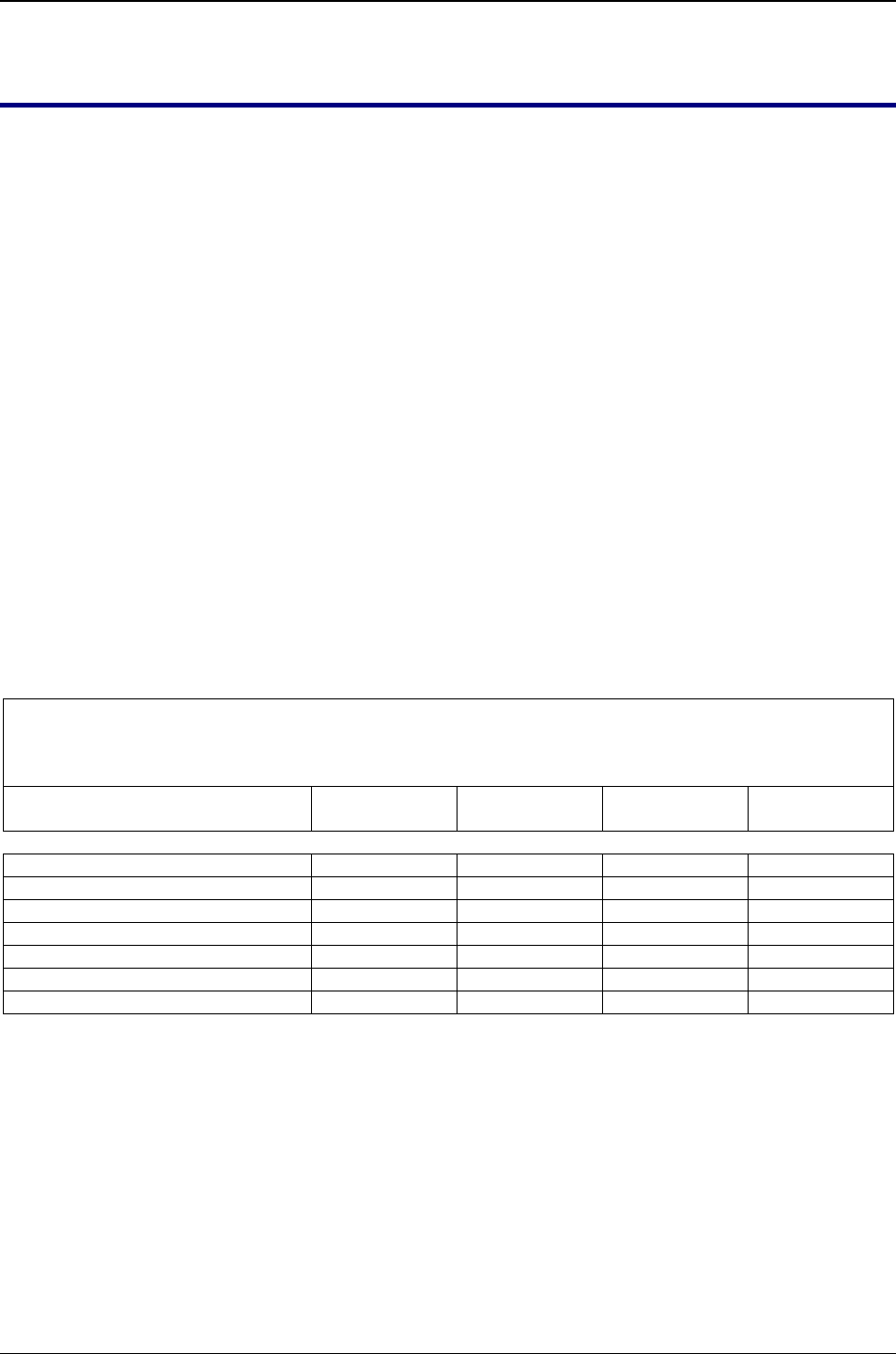
San Bernardino County Development Code
Special Use Permits 85.14
Page 5-57 June 19, 2014
CHAPTER 85.14 SPECIAL USE PERMITS
Sections:
85.14.010 Purpose
85.14.020 Types of Special Use Permits and Review Authorities
85.14.030 Procedures
85.14.040 General Provisions
85.14.050 Special Uses
85.14.060 Findings for Specific Special Uses
85.14.010 Purpose
Special Use Permits are required to regularly monitor the operation of certain land uses to ensure
their continued compatibility with the surrounding property.
Adopted Ordinance 4011 (2007); Amended Ordinance 4067 (2009)
85.14.020 Types of Special Use Permits and Review Authorities
Table 85-3 (Special Use Permits) identifies the various types of Special Use Permits with the
appropriate review authorities:
Table 85-3
Special Use Permits
Type of Entitlement or Decision
Applicable
Citation
Director
(1) (2)
Commission
(3)
Board
(4)
Bed and Breakfast Permit
Ch. 84.05
Issue (6)
Appeal
Appeal
Dependent Housing
Ch. 84.08
Issue (5)
Appeal
Appeal
Exotic Animals
Ch. 84.04
Issue (6)
Appeal
Appeal
Home Occupations
Ch. 84.12
Issue (6)
Appeal
----
Private Kennels
Ch. 84.04
Issue (6)
Appeal
Appeal
Recycling Facilities
Ch. 84.19
Issue (6)
Appeal
Appeal
Short-Term Private Home Rental
Ch. 84.28
Issue (6)
Appeal
----
Notes:
(1) The Director may defer action and refer any permit or approval application to the Commission for final
determination.
(2) All decisions of the Director are appealable to Commission, and then to the Board, in compliance with
Chapter 86.08 (Appeals), except for those decisions addressed in Note (3).
(3) The Commission may refer consideration of an appeal to the Board, except for those decisions involving
only a Variance, determination as to the completeness of an application, the determination to approve or
deny a Home Occupation Permit, an Accessory Wind Energy Permit, a Short-Term Private Home Rental, a
Subdivision Sign Location Plan, or the requirement for preparation of an Environmental Impact Report
(EIR). In these instances the Commission’s decision shall be the final and conclusive decision. The Board
will not accept nor consider an appeal of these Commission decisions.
(4) All decisions of the Board are final.
(5) Issued by the Building Official.

San Bernardino County Development Code
Special Use Permits 85.14
Page 5-58 June 19, 2014
(6) Issued by Code Enforcement.
Adopted Ordinance 4011 (2007); Amended Ordinance 4067 (2009)
85.14.030 Procedures
(a) Requests for Special Use Permits. The Director shall review and act upon requests
for Special Use Permits subject to the findings and conditions for each type of use as
identified within the applicable sections of this Development Code that provides for
the use.
(b) Procedure. Staff review with notice.
(c) Review authority. Director.
(d) An advertised meeting may be held. When necessary, the review authority may
conduct an advertised meeting to consider evidence and take testimony before acting
upon an application for a Special Use Permit.
Adopted Ordinance 4011 (2007); Amended Ordinance 4067 (2009)
85.14.040 General Provisions
(a) Shall be allowed in the land use zoning district. The uses described in this Chapter
shall be an allowed use in the subject land use zoning district, subject to the issuance
of a Special Use Permit.
(b) Disapproval due to violation(s). Special Use Permit applications shall be
disapproved if there is any violation(s) of this Development Code on the property for
which the application is filed and appropriate legal action will be taken to abate the
violation(s).
(c) Additional conditions may be added. The Director may add additional conditions or
requirements as deemed reasonable and necessary to any Special Use Permit.
(d) Annual renewal and inspections required. Special Use Permits shall be renewed
annually, unless otherwise specified by this Chapter and inspections will be conducted
by the Director before each annual renewal.
Adopted Ordinance 4011 (2007); Amended Ordinance 4067 (2009)
85.14.050 Special Uses
(a) Conditional Use Permits. Any use that is the subject of an approved Conditional Use
Permit and if required by the conditions of approval shall also be made subject to the
issuance of a Special Use Permit.
(b) Limited time periods may be applied. Special Use Permits may be issued for limited
time periods. A new application shall be required for renewal of a Special Use Permit.

San Bernardino County Development Code
Special Use Permits 85.14
Page 5-59 June 19, 2014
Adopted Ordinance 4011 (2007); Amended Ordinance 4067 (2009)
85.14.060 Findings for Specific Special Uses
(a) Findings for bed and breakfast uses. Before acting upon an application for a Special
Use Permit for a bed and breakfast use, the review authority shall first find all of the
following to be true:
(1) The site upon which the bed and breakfast use is to be established, shall conform
to all standards of the land use zoning district in which it is located, and the site
for the proposed use is adequate in terms of shape and size to accommodate the
use and parking areas, setbacks, structure coverage, yards, and other applicable
requirements of this Development Code; and
(2) The residential character of the neighborhood in which the use is located shall be
maintained and preserved and the issuance of the Special Use Permit shall not be
significantly detrimental to the public health, safety, and welfare or injurious to
the vicinity and land use zoning district in which the use is located.
(b) Findings for dependent housing units. Before acting upon an application for a
Special Use Permit for a dependent housing unit, the review authority shall first find
all of the following to be true:
(1) The site for the proposed dependent housing unit is adequate in terms of shape
and size to accommodate the use and all parking areas, setbacks, structure
coverage, yards, and other applicable requirements of this Development Code;
(2) The proposed dependent housing unit is clearly subordinate in appearance,
location, and size to the principal unit;
(3) Issuance of the Special Use Permit shall not be detrimental to the public health,
safety, or welfare or injurious to the property or improvements in the vicinity and
land use zoning district in which the use is located;
(4) The dependent housing unit shall be constructed, erected, or installed to allow for
its removal or conversion to guest housing; and
(5) The appearance of the dependent housing unit and the method of siting are
compatible with the surrounding built environment.
Adopted Ordinance 4011 (2007); Amended Ordinance 4067 (2009)

San Bernardino County Development Code
Special Use Permits 85.14
Page 5-60 June 19, 2014
THIS SPACE INTENTIONALLY LEFT BLANK.

San Bernardino County Development Code
Temporary Use Permits 85.15
Page 5-61 February 5, 2009
CHAPTER 85.15 TEMPORARY USE PERMITS
Sections:
85.15.010 Purpose
85.15.020 Types of Temporary Use Permits and Review Authorities
85.15.030 Minor Short-Term Activities
85.15.040 Temporary Use Permit Required
85.15.050 Procedures
85.15.060 Review Authority
85.15.070 Exempt Short-Term Activities
85.15.080 Allowed Short-Term Activities
85.15.090 Development Standards
85.15.100 Application Requirements
85.15.110 Findings and Decision
85.15.120 Post Decision Procedures
85.15.010 Purpose
This Chapter establishes procedures and standards for the granting of Temporary Use Permits for
allowed short-term activities. Compliance with applicable standards ensures that the
establishment, maintenance, and operation of the short-term activity would not be detrimental to
the public health, safety, and welfare of persons residing or working in the neighborhood of the
proposed activity.
Adopted Ordinance 4011 (2007); Amended Ordinance 4067 (2009)
85.15.020 Types of Temporary Use Permits and Review Authorities
Table 85-4 (Temporary Use Permits) identifies the various types of Temporary Use Permits with
the appropriate review authorities:
Table 85-4
Temporary Use Permits
Type of Permit
Applicable
Citation
Director
(1) (2)
Commission
(3)
Board
(4)
Temporary Use Permit - General
Ch. 84.25
Issue
Appeal
Appeal
Temporary Construction Office
Ch. 84.25
Issue (5)
Appeal
Appeal
Temporary Model Home
Ch. 84.25
Issue (6)
Appeal
Appeal
Temporary Occupancy - Residential
Ch. 84.25
Issue (5)
Appeal
Appeal
Temporary Real Estate Office
Ch. 84.25
Issue (6)
Appeal
Appeal
Temporary Seasonal Sales Lot
Ch. 84.25
Issue (5)
Appeal
Appeal
Temporary Signs
Ch. 84.25
Issue (6)
Appeal
Appeal
Temporary Special Event
Ch. 84.25
Issue (7)
Appeal
Appeal

San Bernardino County Development Code
Temporary Use Permits 85.15
Page 5-62 February 5, 2009
Notes:
(1) The Director may defer action and refer any permit or approval application to the Commission for final
determination.
(2) All decisions of the Director are appealable to Commission, and then to the Board, in compliance with
Chapter 86.08 (Appeals), except for those decisions addressed in Note (3).
(3) The Commission may refer consideration of an appeal to the Board, except for those decisions involving
only a Variance, determination as to the completeness of an application, the determination to approve or
deny a Home Occupation Permit, an Accessory Wind Energy Permit, a Subdivision Sign Location Plan, or
the requirement for preparation of an Environmental Impact Report (EIR). In these instances the
Commission’s decision shall be the final and conclusive decision. The Board will not accept nor consider
an appeal of these Commission decisions.
(4) All decisions of the Board are final.
(5) Issued by the Building Official.
(6) Issued by Code Enforcement.
(7) Issued by Current Planning.
Adopted Ordinance 4011 (2007); Amended Ordinance 4067 (2009)
85.15.030 Minor Short-Term Activities
A Temporary Use Permit (TUP) allows short-term activities that might not meet the normal
development or use standards of the applicable land use zoning district, but may otherwise be
acceptable because of their temporary nature.
Adopted Ordinance 4011 (2007); Amended Ordinance 4067 (2009)
85.15.040 Temporary Use Permit Required
Short-term activities shall not be conducted, established, or operated in any manner without the
approval and maintenance of a valid Temporary Use Permit.
Adopted Ordinance 4011 (2007); Amended Ordinance 4067 (2009)
85.15.050 Procedures
(a) Director's review. Each application shall be reviewed by the Director to ensure that
the proposal complies with all applicable requirements of this Development Code.
(b) Procedure: Staff review without notice.
Adopted Ordinance 4011 (2007); Amended Ordinance 4067 (2009)
85.15.060 Review Authority
(a) Director’s authority. Temporary Use Permits may be reviewed and approved or
disapproved by the Director, in compliance with this Chapter.
(b) Referral to the Commission. The Director may refer any Temporary Use Permit
application to the Commission for final action.
Adopted Ordinance 4011 (2007); Amended Ordinance 4067 (2009)

San Bernardino County Development Code
Temporary Use Permits 85.15
Page 5-63 February 5, 2009
85.15.070 Exempt Short-Term Activities
The following short-term activities are allowed without the requirement of obtaining a
Temporary Use Permit. Short-term activities that do not fall within the following categories shall
comply with Section 85.15.080 (Allowed Short-Term Activities), below.
(a) Construction yards - On-site. On-site contractors' construction yards, for an
approved construction project. The construction yard shall be removed immediately
upon completion of the construction project, or the expiration of the Building Permit
authorizing the construction project, whichever first occurs.
(b) Emergency facilities. Emergency public health and safety needs/land use activities, as
determined by the Board.
(c) Events on sites approved for public assembly. An event on the site of, or within, a
golf course, meeting hall, religious facility, school, theater, or other similar facility
designed, and approved by the County for public assembly.
(d) Fund-raising car washes.
(1) Car washes on property within a commercial, industrial, or institutional zone,
limited to a maximum of two days per month for each sponsoring organization.
(2) Sponsorship shall be limited to educational, fraternal, religious, or service
organizations directly engaged in civic or charitable efforts, or to tax exempt
organizations in compliance with 501(c) of the Federal Revenue and Taxation
Code.
(3) Even though fundraising car washes are exempt from obtaining a Temporary Use
Permit, they shall still be conducted in compliance with applicable stormwater
regulations to minimize potential water quality impacts.
(e) Garage sales. Garage sales, not to exceed four per year, each of which may not
exceed three consecutive days.
(f) Location filming. The temporary use of a specific site for the location filming of
commercials, movies, videos, etc., for the time specified by the Director. Even though
this use is exempt from a Temporary Use Permit, it does require a permit through the
Inland Empire Film Commission.
(g) Public property or public right-of-way. Construction and maintenance activities
conducted on public properties that are authorized by an Encroachment Permit.
Adopted Ordinance 4011 (2007); Amended Ordinance 4067 (2009)

San Bernardino County Development Code
Temporary Use Permits 85.15
Page 5-64 February 5, 2009
85.15.080 Allowed Short-Term Activities
A Temporary Use Permit may authorize the following short-term activities within the specified
time limits, but in no event for more than 12 months. Other short-term activities that do not fall
within the categories defined below, or within Section 85.15.070 (Exempt Short-Term
Activities), above, shall instead comply with the planning permit requirements and development
standards that otherwise apply to the property.
(a) Batch Plants. Batch plants necessary for the construction of major public
infrastructure improvements provided proper review in compliance with the California
Environmental Quality Act (CEQA) is completed.
(b) Construction yards - Off-site. Off-site contractors' construction yards, for an
approved construction project. The construction yard shall be removed immediately
upon completion of the construction project, or the expiration of the Building Permit
authorizing the construction project, whichever first occurs.
(c) Events. Art and craft exhibits, carnivals, circuses, concerts, fairs, farmer’s markets,
festivals, flea markets, food events, open-air theaters, outdoor entertainment/sporting
events, religious revivals, rummage sales, second hand sales, swap meets, and other
special events for up to five consecutive days, or four two-day weekends, within a 12-
month period, allowed only on nonresidential properties. Refer to Chapter 85.16
(Temporary Special Event Permits) for specific requirements for a Temporary Special
Event Permit.
(d) Model homes. A model home or model home complex may be authorized before the
completion of subdivision improvements in compliance with the following standards.
(1) The sales office and any off-street parking shall be converted back to residential
use and/or removed before the issuance of the Final Occupancy Permit or within
14 days from the sale of the last parcel in the subdivision, whichever first occurs.
(2) The model home complex shall be used to sell only units within the subdivision
within which the complex is located.
(3) Model home permits will be finaled and the model homes will be allowed to be
open to the public only after all subdivision improvements are completed and
accepted by the County.
(4) Model home sign permits will be issued only after all subdivision improvements
are completed and accepted by the County.
(5) The review authority may require other conditions of approval deemed necessary
to protect the public health, safety, and general welfare of persons residing or
working in the neighborhood.

San Bernardino County Development Code
Temporary Use Permits 85.15
Page 5-65 February 5, 2009
(e) Seasonal sales lots. Seasonal sales activities (e.g., Christmas, Halloween,
Thanksgiving, etc.) including temporary residence/security trailers, on nonresidential
properties, for up to 45 days.
(f) Temporary occupancy during construction.
(1) Major development projects. Temporary structures and property may be used
during the construction phase of an approved major development project (e.g.,
residential projects with five or more dwelling units or any commercial or
industrial project). The structures or property may be used as offices or for the
storage of equipment and/or tools.
(2) Minor development projects. An existing dwelling unit or a temporary structure
and property may be used during the construction phase of an approved minor
development project (e.g., residential projects with four or fewer dwelling units).
The structure or property may be used as a temporary residence, an office, or for
the storage of equipment and/or tools.
(3) Appropriate conditions. The permit shall contain reasonable and necessary
conditions regarding the following matters:
(A) Provisions for adequate ingress and egress.
(B) Provisions for the work to be performed on-site.
(C) Provisions for the storage of asphalt, concrete, and dirt at designated sites
within the subject property; provided, the applicant furnishes a schedule,
acceptable to the Director, for the periodic disposal or recycling of these
materials.
(D) Provisions designed to minimize potential conflicts between the work to be
performed on-site and the ordinary business and uses conducted within the
County.
(4) Length of permit. The permit may be approved for up to 12 months following
the issuance of the companion Building Permit, or upon completion of the
subject development project, whichever first occurs.
(5) Extension of permit. The permit may be extended by the Director if a written
request for extension is submitted at least 14 days before expiration of the permit
and reasonable reasons are provided by the applicant to justify the requested
extension (e.g., the delay was caused by reasons beyond the control of the
applicant). The permit may be extended for up to an additional 12 months.
Multiple extensions may be approved, but in no case shall these extensions
exceed a total of five years.

San Bernardino County Development Code
Temporary Use Permits 85.15
Page 5-66 February 5, 2009
(6) Condition of site following completion. All temporary structures and related
improvements shall be completely removed from the subject site following
expiration of the Temporary Use Permit or within 30 days of completion of the
development project, whichever first occurs.
(g) Temporary real estate sales offices. A temporary real estate sales office may be
established within the area of an approved subdivision, solely for the first sale of
homes. An application for a temporary real estate office may be approved for a
maximum of 12 months from the date of approval.
(h) Temporary structures. A temporary classroom, office, or similar structure, including
a manufactured or mobile unit, may be approved for a maximum of 12 months from
the date of approval, as an accessory use or as the first phase of a development project.
(i) Temporary work trailers. A trailer or mobile home used as a temporary work site for
employees of a business; provided, that:
(1) The use is authorized by a Building Permit for the trailer or mobile home, and the
Building Permit for the permanent structure;
(2) The use is appropriate because:
(A) The trailer or mobile home will be in place during construction or
remodeling of a permanent commercial or industrial structure for a
maximum of 12 months, or upon expiration of the Building Permit for the
permanent structure, whichever first occurs; or
(B) The applicant has demonstrated that the temporary work site is a short-term
necessity for a maximum of 12 months, while a permanent work site is
being obtained; and
(3) The trailer or mobile home is removed before final building inspection or the
issuance of a Certificate of Occupancy for the permanent structure.
(j) Similar temporary activities. A temporary activity that the Director determines is
similar to the other activities listed in this Section and compatible with the applicable
land use zoning district and surrounding land uses.
Adopted Ordinance 4011 (2007); Amended Ordinance 4067 (2009)
85.15.090 Development Standards
The Director shall establish the following standards based on the type of short-term activity,
using the requirements of the applicable land use zoning district, and Divisions 3 (Countywide
Development Standards) and 4 (Standards for Specific Land Uses and Activities) for guidance:

San Bernardino County Development Code
Temporary Use Permits 85.15
Page 5-67 February 5, 2009
(a) Structure and property development improvements. Access, floor areas, heights,
landscaping, off-street parking, setbacks, signs, utilities, and other structure and
property development improvements and features;
(b) Removal of the activity and site restoration. Measures for removal of the activity
and site restoration, to ensure that no changes to the site would limit the range of
possible future land uses otherwise allowed by this Development Code; and
(c) Time limitation. Limitation on the duration of an approved "temporary structure," to
a maximum of 12 months, so that it shall not become a permanent or long-term
structure.
Adopted Ordinance 4011 (2007); Amended Ordinance 4067 (2009)
85.15.100 Application Requirements
An application for a Temporary Use Permit shall be filed and processed in compliance with
85.03 (Application Procedures). The application shall include the information and materials
specified in the Department handout for Temporary Use Permits. It is the responsibility of the
applicant to provide evidence in support of the findings required by Section 85.15.110 (Findings
and Decision), below.
Adopted Ordinance 4011 (2007); Amended Ordinance 4067 (2009)
85.15.110 Findings and Decision
A Temporary Use Permit shall be approved by the Director only after the Director first finds that
the requested short-term activity complies with applicable standards in this Chapter.
Adopted Ordinance 4011 (2007); Amended Ordinance 4067 (2009)
85.15.120 Post Decision Procedures
The procedures and requirements in Chapter 86.06 (Time Limitations), and those related to
appeals and revocation in Division 6 (Development Code Administration), shall apply following
a decision on an application for a Temporary Use Permit.
(a) Condition of the site following short-term activity. Each site occupied by a short-
term activity shall be cleaned of debris, litter, or other evidence of the temporary
activity on completion or removal of the activity, and shall thereafter be used in
compliance with the provisions of this Development Code. Performance security may
be required before initiation of the activity to ensure cleanup after the activity is
finished in compliance with Section 86.06.050 (Performance Guarantees).
(b) Performance security for temporary structures. Before issuance of a Temporary
Use Permit the applicant shall provide performance security in a form and amount
acceptable to the Director to guarantee removal of all temporary structures within 30
days following the expiration of the Temporary Use Permit.

San Bernardino County Development Code
Temporary Use Permits 85.15
Page 5-68 February 5, 2009
Adopted Ordinance 4011 (2007); Amended Ordinance 4067 (2009)

San Bernardino County Development Code
Temporary Special Event Permits 85.16
Page 5-69 February 5, 2009
CHAPTER 85.16 TEMPORARY SPECIAL EVENT PERMITS
Sections:
85.16.010 Purpose
85.16.020 Review Authority and Procedure
85.16.030 Procedures
85.16.040 Post Decision Procedures
85.16.010 Purpose
The purpose of this Chapter is to establish regulations that will protect the general public health,
safety, and welfare under the authority granted to governments by the Constitution of the State of
California.
Adopted Ordinance 4011 (2007); Amended Ordinance 4067 (2009)
85.16.020 Review Authority and Procedure
(a) Director’s authority. Temporary Special Event Permits may be reviewed and
approved or disapproved by the Director, in compliance with this Chapter.
(b) Procedure: Staff review without notice.
Adopted Ordinance 4011 (2007); Amended Ordinance 4067 (2009)
85.16.030 Procedures
(a) General provisions.
(1) Intent. The intent of this Chapter is to provide regulations for the establishment,
operation, removal, and cleanup of temporary special events that do not
constitute a “land use” of sufficient magnitude or longevity to require permanent
land use approval.
(2) Permit required. Except as otherwise provided by the County Code or State
law, no person or entity shall advertise, conduct, maintain, operate, or provide
admission for any temporary special event within the unincorporated areas of the
County without possessing an unexpired, unsuspended, and unrevoked
Temporary Special Events Permit from the Department for each temporary
special event.
(3) Exemptions. The following temporary events are exempt from the requirements
of obtaining a Temporary Special Events Permit in compliance with this Chapter:

San Bernardino County Development Code
Temporary Special Event Permits 85.16
Page 5-70 February 5, 2009
(A) Any sites that have received land use approval (e.g., Conditional Use
Permit) to allow temporary special events.
(B) Any temporary special events held in County Regional Parks.
(C) Any Class I minor event as defined in Division 10 (Definitions) with an
anticipated attendance of less than 500 persons per day. This exemption
shall not apply to a staging event as defined in Section 82.0401 of Title 2 of
this Code involving ten or more persons operating off-highway motor
vehicles. Section 28.0404 of Title 2 requires a Temporary Special Event
Permit for such staging events.
(D) Any Class II minor event with an anticipated attendance of less than 200
persons per day.
(4) Relevant agencies. The Department shall notify and consult with all relevant
County, State, and Federal agencies including the following:
(A) The County Departments of Airports, Fire, Public Health, Public Works,
Sheriff, and the County Code Enforcement Division;
(B) The State of California Departments of Alcoholic Beverage Control, Fish
and Game, Highway Patrol, and Transportation; and
(C) The U.S. Forest Service, Bureau of Land Management, Bureau of
Reclamation, and the U.S. Park Service.
(b) Required information and timing of application. Before organizing any temporary
special event, the applicant shall supply the information the Department may
reasonably require based upon the location, intensity, and level of services required for
each proposed temporary special event. Application for events shall be submitted in a
complete form in advance of the anticipated commencement of the activity in the
following manner:
(1) Minor events.
(A) Events proposed to operate for the first time: At least 30 days in advance for
a community celebration, and at least 90 days in advance for any other
event.
(B) Recurring events: At least 30 days in advance if the event had been
previously reviewed and approved.
(2) Major events. At least 180 days in advance.
(c) Fees.

San Bernardino County Development Code
Temporary Special Event Permits 85.16
Page 5-71 February 5, 2009
(1) For major events only, within 60 days of notification by the Department, any
County department substantially affected by an event, other than the Sheriff's
Department which is covered under Subsection (i), below, shall submit a billing
to the event applicant (with a copy to the Department) of the estimated total fees
and charges of that department pertaining to the special event.
(2) All estimated total fees and charges shall be deposited by the event applicant
with the affected department(s) at least 60 days before the scheduled opening of
the special event.
(3) Within 30 days of the end of the special event, the affected County department
shall give a final accounting/billing to the event operator (with a copy to the
Department).
(4) Within 60 days of the end of the special event, the event operator shall deposit all
unpaid County departments' fees and charges and the affected department(s) shall
refund any surpluses, as applicable.
(d) Bonding and insurance.
(1) Each applicant may be required to provide sufficient liability insurance naming
the County as an additional named insured.
(2) The insurance shall be sufficient to protect, defend, and indemnify the County, its
agents, employees, officers, servants, and volunteers from and against any claim,
damage, injury, liability, and loss of any nature arising out of, or in any way
connected to, the temporary special event.
(3) The amount, quality, and type of the insurance shall be determined in compliance
with the policy established by the Risk Management Division.
(4) The County may require a bond be posted before the special event to ensure that
all conditions are met, including the cleanup and restoration of landscape.
(e) Review procedures.
(1) Upon receipt of a completed application and all related fees, the Department shall
consult with all applicable agencies and departments.
(2) The special event shall comply with the California Environmental Quality Act
(CEQA) in compliance with Sections 15301 and 15304 of the CEQA Guidelines.
(3) If the special event has the potential to cause adverse environmental impacts, an
environmental review of the proposed event shall be conducted in compliance
with the County Code and CEQA.
(4) An additional environmental review fee will be required.

San Bernardino County Development Code
Temporary Special Event Permits 85.16
Page 5-72 February 5, 2009
(5) After an environmental determination has been made, or if one is not required,
the Director:
(A) May refer any Temporary Special Event Permit application directly to the
Board for consideration;
(B) May require a Conditional Use Permit or other appropriate land use permit
and approval where the magnitude or longevity of the use requires the
permit and/or approval; and
(C) Shall notify the applicant of the Sheriff's determination, if the Sheriff has
determined in compliance with Subsection (i), below, that no permit should
be issued.
(f) Permits nontransferable. Any permit issued in compliance with this Chapter shall
not be transferable to any other date, organization, person, place, or time.
(g) Posting. Every permit required by this Chapter shall be conspicuously posted upon the
premises of the temporary special event in a manner specified by the Department.
(h) Permit conditions. The Director, the Sheriff, and the Board shall take into
consideration all relevant information when determining the approval or disapproval
and any necessary conditions for a requested temporary special event permit,
including the following:
(1) Adequate office space(s) and communication equipment for all regulatory
personnel on site by the permit holder;
(2) Bonding and insurance requirements;
(3) Cleanup trash disposal;
(4) Communication, including temporary or additional telephones and an adequate
public address system;
(5) Consideration of the impositions upon adjacent properties and the local
communities;
(6) Electrical illumination requirements;
(7) Fire protection, including location of fire hydrants and supplemental water
sources;
(8) Food concessions;
(9) Inclement weather contingencies;
(10) Medical/first aid facilities;

San Bernardino County Development Code
Temporary Special Event Permits 85.16
Page 5-73 February 5, 2009
(11) News releases required;
(12) Noise impact(s) (An applicant's request to play or broadcast music, especially
between the hours of 11:00 p.m. and 7:00 a.m., shall be evaluated and
determined based on all relevant information including the following: the
proximity to the nearest residence, business, or other occupied land use; the
topography of the site and relevant surrounding area; and the time limits the
music is proposed to be played);
(13) Overnight camping problems;
(14) Restoration of landscape;
(15) Sanitation facilities;
(16) Site(s) upon which the temporary special event is to occur, and the provisions for
adequate ingress/egress and adequate parking including provisions for special
traffic guards or signals;
(17) Topographical and ecological considerations and consideration of alternative
sites;
(18) Water facilities; and
(19) Final accounting procedures, billings, and/or reimbursements.
(i) Police protection - Sheriff's determination.
(1) Upon receipt of the special event application from the Department, the Sheriff’s
Department shall take into consideration all relevant information when
determining their recommendation for the approval or disapproval and any
necessary conditions for a requested temporary special event permit, including
those items identified in Subsection (h), above, and the following:
(A) Applicants' previous relevant experience and background;
(B) Control of alcoholic beverages and dangerous substances;
(C) Crowd control measures;
(D) Emergency evacuation procedures;
(E) News releases;
(F) Police protection; and
(G) Provisions for special accessway(s) for emergency vehicles.

San Bernardino County Development Code
Temporary Special Event Permits 85.16
Page 5-74 February 5, 2009
(2) If the Sheriff determines, for any of the following reasons, that the event will
endanger the public health, peace, safety, or welfare, no permit shall be issued.
The grounds for disapproval by the Sheriff are any one of the following:
(A) Information contained in the application, or supplemental information
requested from the applicant, is found to be false in any material detail;
(B) Another Special Event Permit application has been received prior in time,
or has already been approved, to hold another event at the same time and
place requested by the applicant, or so close in time and place as to cause
undue traffic congestion, or the Sheriff is unable to meet the needs for law
enforcement services for both events;
(C) The route, size, or time of the special event will substantially interrupt the
safe and orderly movement of traffic contiguous to the event route or site,
or disrupt the use of a street at a time when it is usually subject to great
traffic congestion;
(D) The concentration of animals, persons, and vehicles at the site of the special
event, or the assembly and disbanding areas around an event, will prevent
proper ambulance, fire, law enforcement, or paramedic services to areas
contiguous to the event;
(E) The size of the special event will require diversion of so great a number of
Sheriff’s deputies to ensure that participants stay within the boundaries or
route of the event, or to protect participants in the event, as to prevent
normal protection to the rest of the County. Nothing within this Section
authorizes disapproval of a permit because of the need to protect
participants from the conduct of others if reasonable permit conditions can
be imposed to allow for adequate protection of event participants with the
number of law enforcement officers available to police the event;
(F) The location of the special event will substantially interfere with any
construction or maintenance work scheduled to take place upon or along the
County streets, or a previously-granted Encroachment Permit; or
(G) The special event would occur at a time when a school is in session at a
location or route adjacent to the school or one of its classes, and the noise
created by the activities of the event would substantially disrupt the
educational activities of the school or one of its classes.
(3) When the grounds for disapproval of a permit specified in Subsections (B)
through (G), above, can be corrected by altering the date, duration, location,
route, or time of the special event, the Sheriff shall, instead of disapproving the
application, conditionally recommend approval of the application upon the
applicant's acceptance of conditions for permit issuance. The conditions imposed
shall provide for only the modification of the applicant's proposed event as may
be necessary to achieve compliance with Subsections (B) through (G), above.

San Bernardino County Development Code
Temporary Special Event Permits 85.16
Page 5-75 February 5, 2009
(4) If the Sheriff determines that the special event will not endanger the public
health, peace, safety, or welfare, the Director shall be advised of the Sheriff’s
determinations and recommendations.
(5) If the Sheriff determines that the special event will endanger the public health,
peace, safety, or welfare, unless the applicant obtains extra police protection, the
Director shall be advised of the Sheriff’s requirements for extra police protection
as a mandatory condition for the issuance of a permit.
(6) Where the Sheriff specifies the employment of off-duty peace officers, and/or
reserve peace officers, to meet the requirements of this Chapter, the peace
officers shall be under the complete direction of the Sheriff. The Sheriff shall
require that the requisite number of peace officers be provided at all times of
operation, plus any specified time before and following the special event, before
the Sheriff recommends approval of the permit.
(7) The employment of the specified number of law enforcement officers shall be at
the expense of the applicant, the expense to be calculated in compliance with the
County’s fee provisions pertaining to public gatherings, and shall be paid in full
30 days in advance of the special event.
(8) The Sheriff shall determine whether regular or reserve officers are to be utilized
based on availability, the nature of the assignment, and the number of officers
needed to ensure the safety and welfare of the public during the special event.
(j) Requests for law enforcement services at temporary special events.
(1) Any person or entity not required to obtain a permit in compliance with the
provisions of this Chapter may request law enforcement services to preserve the
peace at temporary special events.
(2) The application shall be made to the Sheriff and shall be in writing, stating the
name and address of the applicant, the place where the temporary special event is
to be held, the estimated number of persons to be present, and the purpose of the
temporary special event.
(3) Upon receipt of the application, the Sheriff shall determine whether law
enforcement services are necessary to preserve the peace, and if the Sheriff so
determines, and if the services will not reduce the normal and regular on-going
service that the County would otherwise provide, the Sheriff shall contract with
the applicant to provide the services at an amount to cover all related costs to the
County.
(4) The costs shall be calculated in compliance with the County’s fee provisions
pertaining to public gatherings.
(k) Permit expiration. A Temporary Special Event Permit shall expire in compliance
with the terms of the permit.

San Bernardino County Development Code
Temporary Special Event Permits 85.16
Page 5-76 February 5, 2009
(l) Complaints. Any interested person may file a complaint with the Department, the
Sheriff, or the Board, or petition for a suspension or revocation of any Temporary
Special Event Permit issued in compliance with this Chapter.
(m) Grounds for suspension or revocation. The Director or the Sheriff may suspend, and
the Director may revoke, any Temporary Special Event Permit issued in compliance
with this Chapter based upon reasonable causes, which may include any one of the
following:
(1) Nonpayment of required fees to the County or its agents;
(2) Violation of any permit condition;
(3) Violation of any law involving the operation of the temporary special event;
(4) Any disorderly conduct or use of dangerous substances caused by the operation
of the temporary special event; or
(5) Information contained in the application, or supplemental information requested
from the applicant, is found to be false in any material detail.
(n) Suspension.
(1) The Director or the Sheriff may summarily suspend any Temporary Special
Event Permit if the Director or Sheriff finds or reasonably suspects that operation
of the event may constitute an immediate public health or safety hazard.
(2) At the time of suspension, the Director or Sheriff shall issue a written notice to
the permit holder stating the grounds for the suspension and notifying the permit
holder of the right to a hearing on the suspension.
(3) If a written request for hearing is filed with the Director within 15 calendar days
after the receipt of the notice, the Director shall provide a hearing within five
days of receipt of the written request for a hearing.
(4) If the suspension notice is given on or within 25 days of the start date of the
special event, the Director shall take reasonable steps to expedite the hearing
process.
(5) The hearing may be continued from time to time.
(6) At the conclusion of the hearing, the Director shall render a decision.
(7) The Director may continue the suspension in effect until the Director determines
the grounds for suspension no longer exist.

San Bernardino County Development Code
Temporary Special Event Permits 85.16
Page 5-77 February 5, 2009
(8) If an urgent situation exists relative to the public health, safety, or welfare for a
specific special event, an emergency suspension may be executed by the Director
to be effective immediately.
(o) Revocation.
(1) The Director may commence revocation proceedings by mailing a notice not less
than 10 days before the date set for hearing, informing the permit holder of the
causes for revocation and the time and place at which the revocation matter will
be heard.
(2) If the revocation notice is given on or within 25 days of the start date of the
event, the Director shall take reasonable steps to expedite the hearing process.
(3) The hearing may be continued from time to time.
(4) A revocation hearing may be held concurrently with a suspension hearing.
(5) At the conclusion of the hearing, the Director shall render a decision.
(6) If an urgent situation exists relative to the public health, safety, or welfare for a
specific special event, an emergency revocation may be executed by the Director
to be effective immediately.
(p) Violations/remedies. It shall be unlawful for any person to do any of the following:
(1) Advertise, conduct, or operate a temporary special event without first possessing
an unexpired, unsuspended, unrevoked Temporary Special Event Permit for each
event.
(2) Distribute, give, or sell admission passes or tickets to any temporary special
event without first possessing an unexpired, unsuspended, unrevoked Temporary
Special Event Permit for each event.
(3) Operate any temporary special event in a manner that would create a public or
private nuisance.
(4) Conduct, exhibit, or show within the place of the temporary special event any
activity that violates California State law or any County ordinance.
(5) Knowingly allow any person on the site of the temporary special event to cause
or create a disturbance in, around, or near any place of the temporary special
event by offensive or disorderly conduct.

San Bernardino County Development Code
Temporary Special Event Permits 85.16
Page 5-78 February 5, 2009
(6) Knowingly allow any person to consume, distribute, possess, or sell any
alcoholic beverage on the site of the temporary special event, except as expressly
allowed as a condition of the permit and in compliance with the laws and
regulations enforced by the State Department of Alcoholic Beverage Control.
(7) Knowingly allow any person to consume, distribute, possess, or sell any
controlled drug or dangerous substance in, around, or near any place of the
temporary special event.
(8) Knowingly broadcast or play any live, recorded, or synthesized music after 11:00
p.m. or before 7:00 a.m. at the site of a temporary special event, except as
expressly authorized as a condition of a Temporary Special Event Permit.
(q) Events conducted without required permit(s). Any temporary special event
conducted without the required permit(s) is subject to closure at anytime during the
event. The promoter, business owner, and/or landowner may be subject to cost
recovery by the agencies participating in the closure.
(r) Temporary special events on Federal or State land. When temporary special events
have received a complete land use approval by a Federal or State agency, including the
Bureau of Land Management and the U.S. Forest Service and is properly certified to
the Department, the Director may, upon consultation with and approval of the Sheriff,
limit or waive any or all the provisions of this Chapter as they are determined to be
adequately controlled by the Federal or State agency.
(s) Off-road vehicle race criteria. The Director shall use the following criteria to review
off-road vehicle races.
(1) Any portion of the race course traversing private land shall be on an improved
public easement or traveled way that has been primarily maintained by the use of
hand or power machinery or tools in order to allow relatively regular and
continuous use; or maintained by the passage of vehicles so as to constitute a
well defined and adequate route of travel for the types of vehicles intended for
use in the special event. Any applicable permit(s) shall first be obtained for the
use of County-maintained flood control easements, roads, or other routes.
(2) No spectators shall be allowed, or activities conducted other than the passage of
vehicles on any portion of the private property, road, or route.
(3) No passing shall be allowed on the road or route unless it has adequate width to
permit safe passage of two race vehicles abreast without necessitating travel off
the designated course.
(4) The race route on private lands shall pose no undue or extraordinary hazards to
the participants or the general public.

San Bernardino County Development Code
Temporary Special Event Permits 85.16
Page 5-79 February 5, 2009
(5) The race shall not adversely affect any sensitive environmental resources on
private lands in compliance with the determination made during the
environmental review.
(6) The owner(s) of the private property to be crossed by the temporary special event
has/have issued written permission to the individual(s) conducting the race to
authorize use of the private property.
Adopted Ordinance 4011 (2007); Amended Ordinance 4067 (2009)
85.16.040 Post Decision Procedures
In addition to the provisions specified in this Chapter, the procedures and requirements in
Chapter 86.06 (Time Limitations), and those related to appeals and revocation in Division 6
(Development Code Administration), shall apply following a decision on an application for a
Temporary Special Event Permit. In the case of a conflict, the provisions of this Chapter shall
prevail.
(a) Condition of the site following short-term activity. Each site occupied by a short-
term activity shall be cleaned of debris, litter, or other evidence of the temporary
activity on completion or removal of the activity, and shall thereafter be used in
compliance with the provisions of this Development Code. Performance security may
be required before initiation of the activity to ensure cleanup after the activity is
finished in compliance with Section 86.06.050 (Performance Guarantees).
(b) Performance security for temporary structures. Before issuance of a Temporary
Special Event Permit the applicant shall provide performance security in a form and
amount acceptable to the Director to guarantee removal of all temporary structures
within 30 days following the expiration of the Temporary Special Event Permit.
Adopted Ordinance 4011 (2007); Amended Ordinance 4067 (2009)

San Bernardino County Development Code
Temporary Special Event Permits 85.16
Page 5-80 February 5, 2009
THIS SPACE INTENTIONALLY LEFT BLANK.

San Bernardino County Development Code
Variances 85.17
Page 5-81 February 5, 2009
CHAPTER 85.17 VARIANCES
Sections:
85.17.010 Purpose
85.17.020 Applicability
85.17.030 Procedures
85.17.040 Minor Variances
85.17.050 Application Requirements
85.17.060 Findings and Decision
85.17.070 Conditions of Approval
85.17.080 Post Decision Procedures
85.17.010 Purpose
A Variance (either Major or Minor) provides a process for County consideration of requests to
modify certain standards of this Development Code when, because of special circumstances
applicable to the property, including location, shape, size, surroundings, topography, or other
physical features, the strict application of the development standards otherwise applicable to the
property denies the property owner privileges enjoyed by other property owners in the vicinity
and in the same land use zoning district.
Adopted Ordinance 4011 (2007); Amended Ordinance 4067 (2009)
85.17.020 Applicability
A Variance may be granted to modify any requirement of this Development Code except:
allowed land uses; residential density; specific prohibitions (for example, prohibited signs), or
procedural requirements.
Adopted Ordinance 4011 (2007); Amended Ordinance 4067 (2009)
85.17.030 Procedures
Each application shall be reviewed by the Director to ensure that the proposal complies with this
Chapter, and all other applicable requirements of this Development Code.
(a) Procedure. Staff review with notice
(b) Review Authority. Director
(c) Notice. Before a decision on a Variance, the County shall provide notice in
compliance with Section 85.03.080 (Notice of Pending Land Use Decisions).
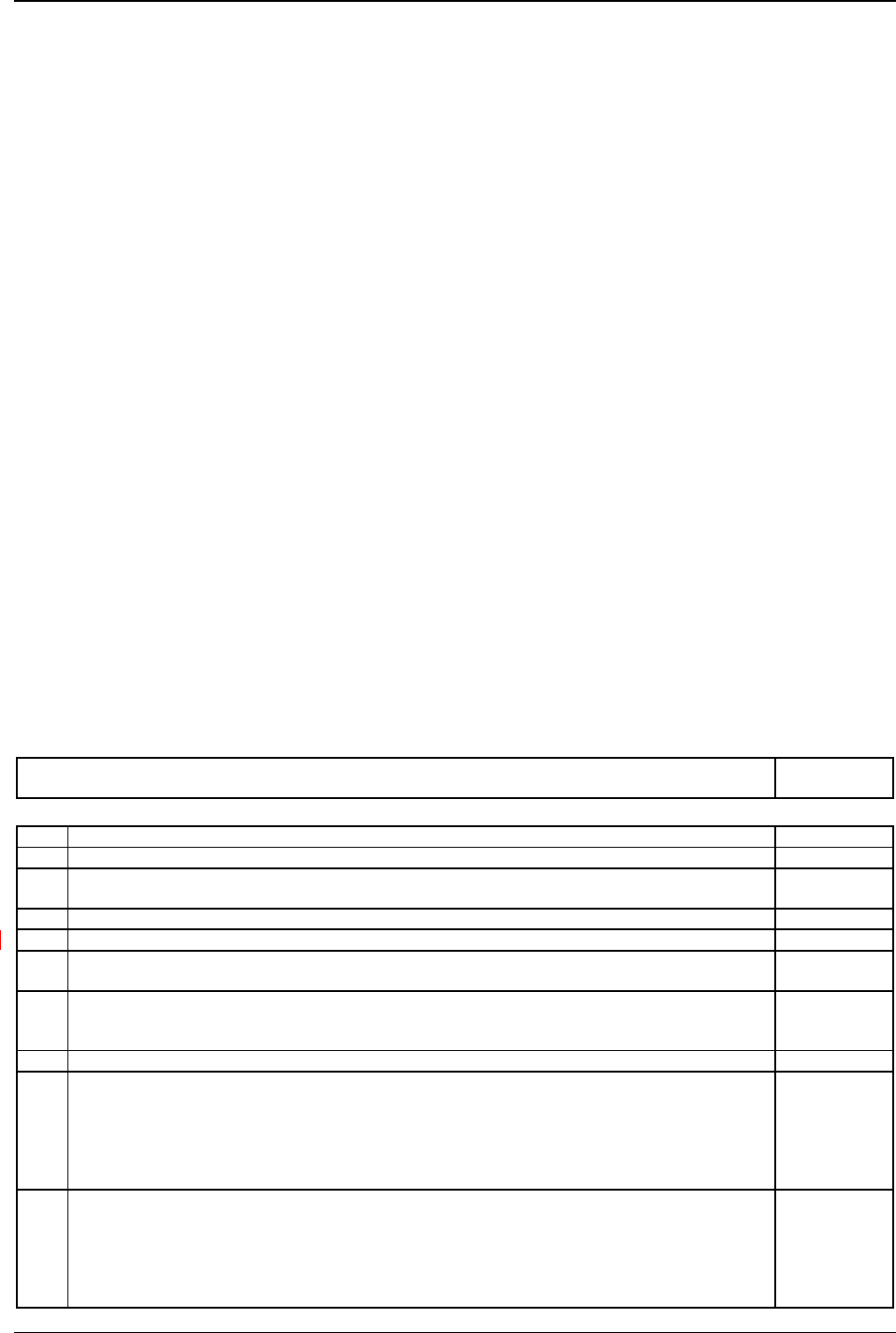
San Bernardino County Development Code
Variances 85.17
Page 5-82 August 20, 2009
(1) Notice. The notice shall state that the Director will decide whether to approve or
disapprove the Variance application on a date specified in the notice, and that a
public hearing will be held only if requested in writing by any interested person
before the specified date for the decision. The request for a hearing shall be based
on issues of significance directly related to the application (e.g., provision of
evidence that the request cannot meet one or more of the findings identified in
Section 85.17.060 [Findings and Decision], below).
(2) If hearing is requested. If a public hearing is requested, the Director shall
schedule the hearing, which shall be noticed and conducted in compliance with
Chapter 86.07 (Public Hearings).
(3) If no hearing is requested. If no public hearing is requested, the Director shall
render a decision on the date specified in the notice referred to in Subsection (c).
(1) above.
Adopted Ordinance 4011 (2007); Amended Ordinance 4067 (2009)
85.17.040 Minor Variances
(a) Types of Minor Variances allowed. The Director may grant a Minor Variance to
reduce any of the following requirements of this Development Code up to the
maximum specified in the Table 85-5 (Types of Minor Variances Allowed), below.
Table 85-5
Types of Minor Variances Allowed
Types of Minor Variances Allowed*
Maximum
Variance
1
Area requirements. Excluding parcel area requirements.
30%
2
Distance between structures. Up to 40 percent, but no closer than 6 feet.
40%
3
Fence or wall heights. Up to 30 percent, but no higher than 6 feet in the front or street side
yard setback.
30%
4
Floor width requirements. Of the single-family residential design standards.
20%
5
Gross floor area requirements.
10%
6
Height requirements. Except that any height adjustment not exceeding two feet in total height shall
also be considered a Minor Variance.
30%
7
Off-street parking requirements.
Parking and loading space requirements, not to exceed two spaces.
Parking area/lot improvements.
30%
8
Overlay District requirements. Of the standards identified in the overlay districts.
30%
9
Setback requirements.
a. Front setbacks. But no closer to the nearest property line than 15 feet in the valley and desert areas
and 10 feet in the mountain region.
b. Side setbacks. But no closer than three feet from the nearest property line, except in a Fire Safety
Overlay District in which case no closer than five feet.
c. Rear setbacks. But no closer than 10 feet from the nearest property line.
40%
40%
30%
10
Sign requirements.
a. Sign area limitations.
b. Sign height and setback limitations..
c. Sign number limitations: Not to exceed four signs.
10%
30%
100%

San Bernardino County Development Code
Variances 85.17
Page 5-83 February 5, 2009
Notes.
(*) Administrative criteria for Minor Variances for these structures shall be established by the Building Official. Those proposals
that do not meet the criteria shall be submitted to the Department of Public Works, with the appropriate fee, for road safety
evaluation. Architectural design and construction materials shall be compatible with the visual setting of the surrounding area.
Variances to the requirements of Section 83.02.030 regarding “clear sight triangles” shall not be evaluated with a Minor
Variances.
(b) Major Variances. Any request for a Variance, other than a Minor Variance, shall be
termed a Major Variance.
(c) Referral to the Commission. The Director may choose to refer any Variance
application to the Commission for hearing and final action.
Adopted Ordinance 4011 (2007); Amended Ordinance 4043 (2008); Amended Ordinance
4067 (2009); Amended Ordinance 4085 (2009)
85.17.050 Application Requirements
An application for a Variance (Major or Minor) shall be prepared, filed, and processed in
compliance with Chapter 85.03 (Application Procedures). The application shall include the
information and materials specified in the Department handout for Variances. It is the
responsibility of the applicant to provide evidence in support of the findings required by Section
85.17.060 (Findings and Decision), below.
Adopted Ordinance 4011 (2007); Amended Ordinance 4067 (2009)
85.17.060 Findings and Decision
(a) General findings. The review authority may approve a Variance (Major or Minor)
only after first finding all of the following:
(1) The granting of the Variance will not be materially detrimental to other
properties or land uses in the area and will not substantially interfere with the
present or future ability to use solar energy systems;
(2) There are exceptional or extraordinary circumstances or conditions applicable to
the subject property or to the intended use that do not apply to other properties in
the same vicinity and land use zoning district;
(3) The strict application of the land use zoning district deprives the subject property
of privileges enjoyed by other properties in the vicinity or in the same land use
zoning district; and
(4) The granting of the Variance is compatible with the maps, objectives, policies,
programs, and general land uses specified in the General Plan and any applicable
specific plan.

San Bernardino County Development Code
Variances 85.17
Page 5-84 February 5, 2009
(b) Findings for off-site parking Variance. The approval of a Variance to allow some or
all of the parking spaces required for a nonresidential project to be located off-site, or
to allow in-lieu fees or facilities instead of the required on-site parking spaces, shall
require that the review authority first make both of the following findings in
compliance with Government Code Section 65906.5, instead of those required by
Subsection (a), above.
(1) The Variance will be an incentive to, and a benefit for, the nonresidential
development; and
(2) The Variance will facilitate access to the nonresidential development by patrons
of public transit facilities.
Adopted Ordinance 4011 (2007); Amended Ordinance 4067 (2009)
85.17.070 Conditions of Approval
In approving a Variance (Major or Minor), the review authority may impose any conditions
deemed reasonable and necessary to ensure that the approval will comply with the findings
required by Section 85.17.060 (Findings and Decision), above. The violation of any required
condition shall constitute a violation of this Chapter and may constitute grounds for revocation or
modification of the Variance in compliance with Section 86.09.070 (Revocation or
Modification).
Adopted Ordinance 4011 (2007); Amended Ordinance 4067 (2009)
85.17.080 Post Decision Procedures
The procedures and requirements in Chapter 6 (Time Limitations), and those related to appeals
and revocation in Division 11 (Development Code Administration), shall apply following a
decision on an application for a Variance.
Adopted Ordinance 4011 (2007); Amended Ordinance 4067 (2009)

San Bernardino County Development Code
Accessory Wind Energy System Permit 85.18
Page 5-85 December 27, 2012
CHAPTER 85.18 ACCESSORY WIND ENERGY SYSTEM PERMIT
Sections:
85.18.010 Purpose
85.18.020 Applicability
85.18.030 Procedures
85.18.040 Abandonment
85.18.010 Purpose
As allowed by Government Code Section 65892.13, the purpose of this Chapter is to provide a
uniform and comprehensive set of standards, conditions, and procedures for the placement of
accessory wind energy systems on parcels in unincorporated areas of the County in order to
encourage the generation of electricity for on-site use, thereby reducing the consumption of
electrical power supplied by utility companies. These regulations are intended to ensure that
accessory wind energy systems are designed and located in a manner that minimizes visual and
safety impacts on the surrounding community.
Adopted Ordinance 4011 (2007); Amended Ordinance 4067 (2009)
85.18.020 Applicability
(a) Accessory Wind Energy System Permit. An Accessory Wind Energy System, as
defined by Section 810.10.250 (Definitions, “W”) and where allowed by Division 2
(Land Use Zoning Districts and Allowed Land Uses) of this Development Code, shall
require an Accessory Wind Energy System Permit and shall be subject to the
requirements and standards set forth in this Chapter and Chapter 84.26 of Division 4 of
this Development Code.
(b) Exemptions. A single Accessory Wind Energy System that is 35 feet or less in height
shall be exempt from the requirement to obtain an Accessory Energy System Permit.
Multiple systems on the same parcel, even if they are 35 feet or less in height, shall be
required to obtain an Accessory Wind Energy System Permit. All Accessory Wind
Energy Systems, including those systems exempted from the Accessory Wind Energy
System Permit Process pursuant to this subsection, shall comply with the standards set
forth in Chapter 84.26 of Division 4 of this Development Code.
Adopted Ordinance 4011 (2007); Amended Ordinance 4067 (2009); Amended Ordinance
4098 (2010); Amended Ordinance 4188 (2012)
85.18.030 Procedures
(a) Action. The Director shall review and act upon an application for approval of an
Accessory Wind Energy System Permit.

San Bernardino County Development Code
Accessory Wind Energy System Permit 85.18
Page 5-86 December 27, 2012
(b) Procedure. Staff Review With Notice in compliance with Section 85.02.030 (Staff
Review with Notice).
(c) Notification.
(1) Surrounding property owners. Notice shall be given by first class mail or
delivery to all surrounding property owners within 300 feet of the boundaries of
the parcel of the subject site when an application is accepted as complete.
(2) Electric utility service provider. If the applicant plans to connect the system to
the electricity grid, the applicant shall submit documentation from the electric
utility service provider that serves the proposed site confirming they have been
informed of the applicant's intent to install an interconnected customer-owned
electricity generator. If the applicant does not plan to connect the system to the
electricity grid, notice to the electric utility service provider shall not be required.
(3) Pest control service providers. In the event an Accessory Wind Energy System
is proposed to be sited as an accessory to an agricultural use that may involve
aircraft operating at low altitudes, the applicant shall take reasonable steps to
notify pest control aircraft pilots registered to operate in the County.
(4) Military airspace authority. An accessory wind energy system shall not be
sited on land within a restricted military airspace without first giving adequate
notice to the governing authority of that airspace.
(d) Application Submittal Requirement. The noise ratings as published by the
manufacturer of a system proposed for installation shall be submitted to the County for
review at the time of the submittal of an application for an Accessory Wind Energy
System Permit. If multiple systems are being proposed, the noise ratings shall be
modified to address the number of systems being installed.
(e) Review Authority. Director.
(f) Findings required. Before approving an application for an Accessory Wind Energy
Permit, the Director shall find and justify that all of the following are true:
(1) The site for the proposed use is adequate in size and shape to accommodate the
proposed use and all yards, open spaces, setbacks, walls and fences, parking
areas, loading areas, landscaping and other features pertaining to the proposed
use.
(2) The site for the proposed use has adequate access (i.e., the site design
incorporates street and highway limitations).
(3) The proposed use will not have a substantial adverse effect on adjacent property
or the use of the adjacent property (e.g., excessive noise, vibration, traffic, other
disturbance, etc.) and will not have a substantial visual impact on adjacent
property.

San Bernardino County Development Code
Accessory Wind Energy System Permit 85.18
Page 5-87 December 27, 2012
(4) The proposed use is consistent with the goals, policies, standards and maps of the
General Plan and any applicable Community Plan or Specific Plan.
(5) The lawful conditions stated in the approval are deemed necessary to protect the
public health, safety, and general welfare.
Adopted Ordinance 4011 (2007); Amended Ordinance 4067 (2009); Amended Ordinance
4188 (2012)
85.18.040 Abandonment
Under normal occupancy, an accessory wind energy system that is not operated for a continuous
period of 12 months shall be considered abandoned. The owners of the system shall remove all
structures within 90 days of receipt of notice from the County advising the owner of the
abandonment. If the system is not removed within 90 days, the County may remove all structures
at the owner’s expense.
Adopted Ordinance 4011 (2007); Amended Ordinance 4067 (2009)

San Bernardino County Development Code
Accessory Wind Energy System Permit 85.18
Page 5-88 December 27, 2012
THIS SPACE INTENTIONALLY LEFT BLANK.

San Bernardino County Development Code
Food Truck Event Permits 85.19
Page 5-89 August 27, 2015
CHAPTER 85.19 FOOD TRUCK EVENT PERMITS
Sections:
85.19.010 Purpose
85.19.020 Permit Required for Food Truck Events
85.18.010 Purpose
The purpose of this Chapter is to provide regulations for the establishment, operation, removal,
and cleanup of Food Truck Events in the unincorporated areas of the County and which do not
constitute a “land use” of sufficient magnitude or longevity to require permanent land use
approval.
Adopted Ordinance 4170 (2012); Amended Ordinance 4280 (2015)
85.19.020 Permit Required for Food Truck Events
(a) Health Permit required. Except as otherwise provided by the County Code or state
or federal law, operation of a food truck within the County shall be subject to the
permit requirements and applicable standards of Section 33.0408 of the County Code,
as well as applicable provisions of the California Health and Safety Code.
(b) Temporary Special Events. Events involving food trucks in the unincorporated areas
of the County that meet the definition of a Temporary Special Event set forth in
Section 810.01.210 shall require a Temporary Special Event Permit pursuant to
Chapter 85.16 unless otherwise exempt under Chapter 85.16.
(c) Exemptions.
(1) Any Food Truck Event that has received another land use approval (e.g.,
conditional use permit or approved community event) to allow food trucks shall
be exempt from the requirements of this Chapter.
(2) Operation of a food truck serving fewer than 100 people, where the operation of
the food truck is not in the public right-of-way, and written authorization of the
property owner was obtained prior to the event, shall be exempt from the
requirements of this chapter.
(3) Operation of a food truck hired by a private party or business for private use on
private property shall be exempt from the requirements of this chapter, regardless
of the numbers of attendees.
(d) Food Truck Events. A Food Truck Event shall be classified as a Food Truck Event -
Major or a Food Truck Event - Minor, as defined in County Code Section 810.01.080.

San Bernardino County Development Code
Food Truck Event Permits 85.19
Page 5-90 August 27, 2015
Adopted Ordinance 4170 (2012); Amended Ordinance 4258 (2014), Amended Ordinance
4280 (2015)

San Bernardino County Development Code
Food Truck Event Permits 85.19
Page 5-91 August 27, 2015
THIS SPACE INTENTIONALLY LEFT BLANK.

San Bernardino County Development Code
Food Truck Event Permits 85.19
Page 5-92 August 27, 2015
THIS SPACE INTENTIONALLY LEFT BLANK.

San Bernardino County Development Code
Food Truck Event Permits 85.19
Page 5-93 August 27, 2015
THIS SPACE INTENTIONALLY LEFT BLANK.

San Bernardino County Development Code
Food Truck Event Permits 85.19
Page 5-94 August 27, 2015
THIS SPACE INTENTIONALLY LEFT BLANK

San Bernardino County Development Code
Unlicensed Residential Care Facilities Permit 85.20
Page 5-95 March 27, 2014
CHAPTER 85.20 UNLICENSED RESIDENTIAL CARE FACILITIES PERMIT
Sections:
85.20.010 Purpose.
85.20.020 Applicability.
85.20.030 Procedures.
85.20.010 Purpose.
It is the purpose of this Chapter to provide an expedited process for the County review and
authorization of small Unlicensed Residential Care Facilities in compliance with all applicable
requirements of this Development Code.
Adopted Ordinance 4230 (2014)
85.20.020 Applicability.
(a) When required. An Unlicensed Residential Care Facilities Permit shall be required to
authorize:
(1) Compliance with Division 2 (Land Use Zoning District and Allowed Land
Uses). The establishment of a small Unlicensed Residential Care Facility serving
six or fewer persons that is allowed by a Land Use Zoning District subject to a
Residential Care Facilities Permit in compliance with Division 2 (Land Use
Zoning Districts and Allowed Land Uses); provided, the use complies with all
applicable performance standards identified in this Development Code as
provided in Chapter 84.32 (Small Unlicensed Residential Care Facilities);
(2) An Existing Unlicensed Residential Care Facility Use. The operator of an
existing Unlicensed Residential Care Facility that does not have a permit issued
in compliance with this Chapter must seek the issuance of an Unlicensed
Residential Care Facility Permit to continue the use. If the facility is not a small
unlicensed residential care facility but is serving seven or more persons in a RM
(Multiple Residential) Land Use Zoning District, the operator must seek and
obtain an approved Conditional Use Permit. The operator may also seek a
reasonable accommodation for this use.
(3) Change of Operator. Any time that there is a change of operators of an existing
facility a new permit must be obtained in that, contrary to other permits required
by this Code, the Unlicensed Residential Care Facility Permit is issued to the
operator as opposed to the use to ensure any and all new operators commit to
complying with the standards set forth in Chapter 84.32.

San Bernardino County Development Code
Unlicensed Residential Care Facilities Permit 85.20
Page 5-96 March 27, 2014
(b) Exempt from CEQA. An Unlicensed Residential Care Facilities Permit application
shall be determined exempt from the California Environmental Quality Act (CEQA) in
compliance with state law and the County’s Environmental Review Guidelines or it
shall be processed as a Conditional Use Permit or Minor Use Permit.
Adopted Ordinance 4230 (2014)
85.20.030 Procedures.
(a) Compliance with Division 5 (Permit Application and Review Procedures). The
Unlicensed Residential Care Facilities Permit procedure is intended to provide a less
complex and more streamlined review than the review required for a Conditional Use
Permit or Minor Use Permit. The project planner shall review the application in
compliance with Division 5 (Permit Application and Review Procedures).
(b) Procedure. Staff review without notice.
(c) Review authority. Director.
(d) New construction. In issuing an Unlicensed Residential Care Facilities Permit for
new construction the Director shall first confirm that the request satisfies all of the
following criteria:
(1) The unlicensed Residential Care Facility is in compliance with the applicable
provisions of Chapter 84.32 (Unlicensed Residential Care Facilities) of this
Development Code; and
(2) The proposed site and any unlicensed Residential Care Facility existing on the
site shall not be in violation of any applicable provision of this Development
Code, except for nonconforming uses and structures in compliance with Chapter
84.17 (Nonconforming Uses and Structures).
(e) Reuse of existing structure(s). In issuing an Unlicensed Residential Care Facilities
Permit that proposes to establish an unlicensed Residential Care Facility in an existing
structure, the Director shall first confirm that the request satisfies all of the following
criteria in addition to those identified in Subsection (d), above:
(1) The required number of parking spaces and driveway and parking lot
improvements shall be provided and maintained in compliance with Chapter
83.11 (Parking and Loading Standards);
(2) The proposed facility and all existing structures are in compliance with all
requirements of previously approved entitlements (e.g., Minor Use Permits,
Conditional Use Permits, or Variances, etc.) including conditions of approvals.
(f) On-site inspection. An application for an Unlicensed Residential Care Facilities
Permit may require that the Director perform an on-site inspection of the subject

San Bernardino County Development Code
Unlicensed Residential Care Facilities Permit 85.20
Page 5-97 March 27, 2014
parcel before confirming that the request complies with all of the applicable criteria
and provisions identified in this Section.
(g) Contact person. The contact information for the owner/operator of the project will be
extracted from the application of all approved permits and posted on the Land Use
Services website to include the following information: name, mailing address, email
address and phone number.
(h) Findings. Before granting an application for an Unlicensed Residential Care Facilities
Permit, the review authority shall make the following findings:
(1) The project complies with all applicable performance standards identified in this
Development Code.
(2) There is supporting infrastructure, existing or available, consistent with the
intensity of development, to accommodate the proposed development without
significantly lowering service levels.
(3) The proposed use and manner of development are in compliance with the goals,
maps, policies, and standards of the General Plan, and any applicable community
plan or specific plan.
(4) The proposed unlicensed Residential Care Facility and manner of development
are exempt from the California Environmental Quality Act (CEQA).
(i) Rejection or alternative processing required. If the review authority cannot make
the required findings listed in Subsection (h), above, the project will be either rejected
or elevated to a Minor Use Permit, as determined appropriate by the Director.
(j) Appeal. Appeal of an Unlicensed Residential Care Facilities Permit shall be limited to
the determination that the land use being requested qualifies for the Unlicensed
Residential Care Facilities Permit application.
(k) Revocation of Permit. If, after the approval of an Unlicensed Residential Care
Facilities Permit, the provisions of Chapter 84.32 are violated, the Code Enforcement
Division of the Land use Services Department will issue a Notice of Violation
detailing the discrepancies with this Development Code. If such violations are not
corrected within 30 days of the receipt of the Notice of Violation, the Unlicensed
Residential Care Facilities Permit shall be revoked using the procedures set forth in
Section 86.09.170.
Adopted Ordinance 4230 (2014)

San Bernardino County Development Code
Unlicensed Residential Care Facilities Permit 85.20
Page 5-98 March 27, 2014
THIS SPACE INTENTIONALLY LEFT BLANK.

San Bernardino County Development Code
Adult Business Regulatory Permit 85.21
Page 5-99 April 24, 2014
CHAPTER 85.21 ADULT BUSINESS REGULATORY PERMIT
Sections:
85.21.010 Purpose.
85.21.020 Permit Required/Applicability.
85.21.030 Issuance of Permit/Procedures.
85.21.040 Inspection.
85.21.050 Suspension or Revocation of an Adult Business Regulatory Permit.
85.21.060 Appeal Procedures.
85.21.070 Transfer of Adult Business Regulatory Permit.
85.21.080 Violations.
85.21.090 Applicability of Chapter to Existing Adult Businesses.
85.21.100 Regulations Non-exclusive.
85.21.010 Purpose.
It is the purpose of this Chapter to provide a process for the County Land Use Services
Department to review all applications submitted to the County for an Adult Business Regulatory
Permit that are in compliance with Division 2 (Land Use Zoning Districts and Allowable Land
Uses) and the other applicable requirements of this Development Code. This process will ensure
that all adult businesses are in compliance with all applicable regulations and will promote the
health, safety, and general welfare of the citizens of the County, and prevent the deleterious
secondary effects of adult businesses within the County. The provisions of this Chapter have
neither the purpose nor effect of imposing a limitation or restriction on the content or reasonable
access to any communicative materials, including adult-oriented materials. Similarly, it is
neither the intent nor effect of this Chapter to restrict or deny access by adults to adult-oriented
materials protected by the First Amendment, or to deny access by the distributors and exhibitors
of adult-oriented entertainment to their intended market.
Adopted Ordinance 4239 (2014)
85.21.020 Permit Required/Applicability.
(a) All adult businesses are subject to the Adult Business Regulatory Permit requirements
of Chapter 84.02, this Chapter as well as all other applicable ordinances of the County
and laws of the State of California. It shall be unlawful for any person to establish,
operate, engage in, conduct, or carry on any adult business within San Bernardino
County unless the person first obtains, and continues to maintain in full force and
effect, an Adult Business Regulatory Permit as herein required. Any occurrence of the
“establishment” of an adult business as defined in Chapter 810.01 of this Title, shall
require a new application for an Adult Business Regulatory Permit. The Adult
Business Regulatory Permit shall be subject to the development and operational
standards of Chapter 84.02 of this Title and the requirements of the zoning or other
land use provisions applicable to where the facility is located.

San Bernardino County Development Code
Adult Business Regulatory Permit 85.21
Page 5-100 April 24, 2014
(b) The Planning Commission shall grant, deny and/or renew an Adult Business
Regulatory Permit in accordance with these regulations.
(c) Permit applicants shall file a written, signed and verified application at the office of
the County Land Use Services Department on a form provided by the Department.
Such application shall contain the following information and be accompanied by the
following documents:
(1) If the permit applicant is an individual, the individual shall state his or her legal
name, including any aliases, and address, and shall submit satisfactory written
proof that he or she is at least 18 years of age.
(2) If the permit applicant is a partnership, the partners shall state the partnership’s
complete name, address, the names of all partners, and whether the partnership is
general or limited; and shall attach a copy of the partnership agreement, if any.
(3) If the permit applicant is a corporation, the corporation shall provide its complete
name, the date of its incorporation, evidence that the corporation is in good
standing under the laws of the State of California, the names and capacities of all
officers and Directors, the name of the registered corporate agent, and the
address of the registered office for service of process.
(4) A signed and verified statement that the permit applicant has not pled guilty or
nolo contendere to nor has the permit applicant been convicted of an offense
classified by this or any other state as a sex or sex-related offense, including
crimes involving moral turpitude, prostitution, or obscenity, subject to the
following time periods:
(A) if a misdemeanor, more than two (2) years have elapsed from the date of the
plea or conviction or from the date of release from confinement for the
conviction, whichever is the later date, to the date of the application; or
(B) if a felony, more than five (5) years have elapsed from the date of the plea
or conviction or from the date of release from confinement for the
conviction, whichever is the later date, to the date of the application; or
(C) if two or more misdemeanors, the pleas or convictions occurred within any
24-month period and more than five (5) years have elapsed from the date of
the last plea or conviction or from the most recent date of release from
confinement for the conviction or plea, whichever is the later date, to the
date of application.
If the applicant is a partnership or corporation, such verified statement must be
submitted by each and every partner, officer and/or director.

San Bernardino County Development Code
Adult Business Regulatory Permit 85.21
Page 5-101 April 24, 2014
(5) The permit applicant shall provide a list of all performers and non-performers,
which includes the performer’s/non-performer’s legal name, and mailing address,
and satisfactory written proof that each performer/non-performer is at least 18
years of age. If the Adult Business Regulatory Permit is granted, the owner/
operator shall maintain this list with current and updated information and shall
make this list available for inspection upon reasonable notice.
(6) Each performer and non-performer working for a permit applicant shall provide
the permit applicant with a signed and verified statement that the performer or
non-performer has not pled guilty or pled nolo contendere or been convicted of
an offense classified by this or any other state as a sex or sex-related offense,
including crimes involving moral turpitude, prostitution, or obscenity, within the
time periods established in Subsections 85.21.020(c)(4)(A), (B), and (C).
(7) If the permit applicant intends to operate the adult business under a name other
than that of the permit applicant, the permit applicant shall file the fictitious
name of the adult business and show proof of registration of the fictitious name.
(8) A description of the type of adult business for which the permit is requested and
the proposed address where the adult business will operate, plus the names and
addresses of the owners and lessors of the adult business site.
(9) The address to which notice of action on the application is to be mailed if
different from the applicant’s address.
(10) A diagram showing the interior premises including a statement of the total floor
area occupied by the adult business. The diagram may not be hand drawn. It must
show orientation to the north or some other designated street or object. It must be
generated by a defined scale and show marked dimensions of the premise to an
accuracy of plus or minus six inches.
(11) A diagram of the off-street parking areas and entries to the premises of the adult
business, also showing the location of the lighting system required by this
Chapter.
(d) The completed application shall be accompanied by a non-refundable application fee.
The amount of such fees shall be set by ordinance adopted by the Board of
Supervisors.
(e) The completeness of an application for an Adult Business Regulatory Permit shall be
determined by the Land Use Services Department Director (“the Director”) within five
(5) business days of its submittal. If the Director determines that the permit
application is incomplete, the Director shall immediately notify in writing the permit
applicant of such fact and the reasons therefor, including identifying any additional
information necessary to render the application complete. Such writing shall be
deposited in the U.S. mail, postage prepaid, immediately upon determination that the
application is incomplete. Within five business days following the receipt of an
amended application or supplemental information, the Director shall again determine

San Bernardino County Development Code
Adult Business Regulatory Permit 85.21
Page 5-102 April 24, 2014
whether the application is complete in accordance with the provisions set forth above.
Evaluation and notification shall occur as provided herein until such time as the
application is found to be complete.
(f) The fact that a permit applicant possesses other types of state or city licenses or
permits does not exempt the permit applicant from the requirement of obtaining an
Adult Business Regulatory Permit under this Chapter.
Adopted Ordinance 4239 (2014)
85.21.030 Issuance of Permit /Procedures.
(a) Upon the filing of a completed application for an Adult Business Regulatory Permit,
the Director shall immediately write or stamp the application “Received” and, in
conjunction with County staff, shall promptly investigate the information contained in
the application to determine whether an Adult Business Regulatory Permit shall be
granted. Investigation shall not be grounds for the County to unilaterally delay in
reviewing a completed application, nor is it grounds to extend the time period to
conduct a hearing pursuant to this section.
(b) Within twenty-one (21) days after the filing of a completed Adult Business Regulatory
Permit application, the investigation shall be completed. The Director shall promptly
notice a public hearing before the Planning Commission with notice of such hearing to
be made pursuant to California Government Code sections 65091 and 65905. Said
public hearing shall be conducted within thirty (30) days of the expiration of the
completed investigation period.
(c) In reaching a decision on the application, the Planning Commission shall not be bound
by the formal rules of evidence in the California Evidence Code.
(d) A written decision on the application for an Adult Business Regulatory Permit shall be
issued by the Planning Commission within four (4) business days after the public
hearing required by this section. The failure of the Planning Commission to render
any decision within the time frames established in any part of this section shall be
deemed to constitute an approval subject to the compliance with all operating
standards of Chapter 84.02. The decision of the Planning Commission shall be hand
delivered or mailed to the applicant at the address provided in the application, and
shall be provided in accordance with the requirements of this Code.
(e) Notwithstanding any provisions in this section regarding the occurrence of any action
within a specified period of time, the applicant may request additional time beyond
that provided for in this section or may request a continuance regarding any decision
or consideration by the County of the pending application. Extensions of time sought
by applicants shall not be considered delay on the part of the County or constitute
failure by the County to provide for prompt decisions on applications.
(f) The Planning Commission shall grant or deny the application in accordance with the
provisions of this section, and so notify the applicant as follows:

San Bernardino County Development Code
Adult Business Regulatory Permit 85.21
Page 5-103 April 24, 2014
(1) The Director shall write or stamp “Granted” or “Denied” on the application and
date and sign such notation.
(2) If the application is denied, the Director shall attach to the application a
statement of the reasons for the denial.
(3) If the application is granted, the Director shall attach to the application an Adult
Business Regulatory Permit.
(g) The Planning Commission shall grant the application and issue the Adult Business
Regulatory Permit upon findings that the proposed business meets, or will meet, all of
the development, operational and environmental performance standards of the San
Bernardino County Code, unless the application is denied based upon the
noncompliance with one or more of the criteria set forth in this Chapter.
(h) If the Planning Commission grants the application, the applicant may begin operating
the adult business for which the permit was sought, subject to compliance with the
development and operating standards of Chapter 84.02; compliance with the
environmental performance standards and requirements of this Chapter. The permitee
shall post the permit conspicuously in the premises of the adult business.
(i) Findings: The Planning Commission shall deny the application if the applicant fails to
establish any of the following:
(1) The adult business complies with the County’s zoning requirements as to its
underlying zoning designation and other locational requirements.
(2) The adult business complies with the development, operating or environmental
performance standards found in Chapter 84.02 of this Title.
(3) The permit applicant is at least 18 years of age.
(4) The required application fees have been paid.
(5) The application complies with 85.21.020(c).
(j) A permittee, applicant or substantially related entity wherein the new application is
made by an individual or previous entity exercising management or oversight or
control of the adult business, cannot re-apply for an Adult Business Regulatory Permit
for a particular location within one year from the date of prior denial.
(k) Any affected person may appeal the decision of the Planning Commission in writing
within ten days in accordance with the provisions of Chapter 86.08 of this Title.
Adopted Ordinance 4239 (2014)

San Bernardino County Development Code
Adult Business Regulatory Permit 85.21
Page 5-104 April 24, 2014
85.21.040 Inspection.
Each owner, operator, manager, employee or independent contractor of an adult business or other
person in charge of an adult business shall permit representatives of the County Sheriff,
Department of Public Health, Fire Department, Land Use Services Department, business license
division and other County departments, to inspect the adult business for the purpose of ensuring
compliance with the laws and operating standards applicable to adult businesses at any time it is
occupied or open for business. Such inspections shall be conducted in a reasonable manner.
Adopted Ordinance 4239 (2014)
85.21.050 Suspension or Revocation of an Adult Business Regulatory Permit.
(a) On determining that grounds for permit suspension or revocation exist, the Director
shall furnish written notice of the proposed suspension or revocation to the permittee.
Such notice shall set forth the time and place of a hearing and the ground or grounds
upon which the hearing is based, the pertinent Code sections, and a brief statement of
the factual matters in support thereof. The notice shall be mailed, postage prepaid,
addressed to the last known address of the permittee, or shall be delivered to the
permittee personally, at least ten (10) days prior to the hearing date. Hearings
pursuant to this section shall be noticed in accordance with California Government
Code §§ 65091 and 65905 and conducted by the Planning Commission. Hearings
pursuant to this section shall be conducted in accordance with procedures established
by the Planning Commission but, at a minimum, shall include the following:
(1) All parties involved shall have the right to offer testimonial, documentary, and
tangible evidence bearing upon the issues and may be represented by counsel.
(2) The Planning Commission shall not be bound by the formal rules of evidence.
(3) Any hearing under this section may be continued for a reasonable time for the
convenience of a party or a witness at the request of the permittee. Extensions of
time or continuances sought by a permittee shall not be considered delay on the
part of the County or constitute failure by the County to provide for prompt
decisions on permit suspensions or revocations.
(4) The Planning Commission’s decision may be appealed in accordance with
Chapter 86.08 of this Title.
(b) A permit may be suspended or revoked based on the following causes arising from the
acts or omissions of the permittee, or an employee, independent contractor, partner,
operator or manager of the permittee:
(1) The building, structure, equipment, or location used by the adult business fails to
comply with all provisions of these regulations and this section relating to adult
businesses, including the adult business operating standards contained in Chapter
84.02 and the zoning requirements of Chapter 82.05 of this Title, and all other

San Bernardino County Development Code
Adult Business Regulatory Permit 85.21
Page 5-105 April 24, 2014
applicable building, fire, electrical, plumbing, health, environmental performance
standards and zoning requirements of the San Bernardino Code.
(2) The permittee has failed to obtain or maintain all required County licenses or
permits with respect to the business or the premises.
(3) The permittee has made any false, misleading, or fraudulent statement of material
fact in the application for an Adult Business Regulatory Permit.
(4) The permit is being used to conduct an activity different from that for which it
was issued.
(5) That an individual employed by, or performing in, the adult business (whether
classified as an employee or independent contractor) has been convicted of two
(2) or more sex-related offenses that occurred in or on the permitted premises
within a twelve (12) month period and was employed by, or performing in, the
adult business at the time the offenses were committed.
(6) That the use for which the approval was granted has ceased to exist, has been
suspended or has not been active for six months or more.
(7) That the transferee/new owner of an adult business or Adult Business Regulatory
Permit failed to comply with the requirements of this Chapter.
(8) The permittee, partner, director, operator, or manager has knowingly allowed or
permitted, or has failed to make a reasonable effort to prevent the occurrence of
any of the following on the premises of the adult business; or a permittee has
been convicted of violating any of the following state laws on the premises of the
adult business:
(A) Any act of unlawful sexual intercourse, sodomy, oral copulation, or
masturbation.
(B) Use of the establishment as a place where unlawful solicitations for sexual
intercourse, sodomy, oral copulation, or masturbation openly occur.
(C) Any conduct constituting a criminal offense which requires registration
under section 290 of the California Penal Code.
(D) The occurrence of acts of lewdness, assignation, or prostitution, including
any conduct constituting violations of sections 315, 316, 318 or subdivision
(b) of the section 647b of the California Penal Code.
(E) Any act constituting a violation of provisions in the California Penal Code
relating to obscene matter or distribution of harmful matter to minors
including, but not limited to sections 311 through 313.4.

San Bernardino County Development Code
Adult Business Regulatory Permit 85.21
Page 5-106 April 24, 2014
(F) Any act constituting a felony involving the sale, use, possession, or
possession for sale of any controlled substance specified in sections 11054,
11055, 11056, 11057, or 11058 of the California Health & Safety Code.
(G) An act or omission in violation of any of the requirements of this chapter if
such act or omission is with the knowledge, authorization, or approval of
the permit holder or is as a result of the permit holder’s negligent
supervision of the employees or independent contractors of the adult
facility. This includes the allowance of activities that are or become a
public nuisance which includes the disruptive conduct of business patrons
whether on or immediately off the premises where such patrons disturb the
peace, obstruct traffic, damage property, engage in criminal conduct, violate
the law and otherwise impair the free enjoyment of life and property.
(c) After holding the hearing in accordance with the provisions of this section, if the
Planning Commission finds and determines that there are grounds for suspension or
revocation, the Planning Commission shall impose one of the following:
(1) Suspension of the permit for a specified period not to exceed six months; or
(2) Revocation of the permit. The written decision shall be hand delivered or
overnight mailed to the permittee within five days of the public hearing.
(d) In the event a permit is revoked pursuant to this section, another Adult Business
Regulatory Permit to operate an adult business shall not be granted to the permittee or
an entity related to the permittee within 12 months after the date of such revocation.
Adopted Ordinance 4239 (2014)
85.21.060 Appeal Procedures.
(a) After approval, denial, suspension or revocation of a permit, any affected person may
appeal the decision to the Board of Supervisors in writing within ten (10) days after
the written decision.
(b) Consideration of an appeal of the decision shall be conducted pursuant to Chapter
86.08 of this Title, and which hearing shall occur within forty-five (45) days of the
filing or initiation of the appeal.
(c) Upon the conclusion of the de novo public hearing, the Board of Supervisors shall
grant or deny the appeal. The Board of Supervisors’ decision shall be final and
conclusive and shall be rendered in writing within four (4) County business days of
the hearing, such written decision to be mailed to the party appealing the decision.
(d) In reaching its decision, the Board of Supervisors shall not be bound by the formal
rules of evidence.

San Bernardino County Development Code
Adult Business Regulatory Permit 85.21
Page 5-107 April 24, 2014
(e) Notwithstanding any provisions in this section regarding the occurrence of any action
within a specified period of time, the applicant may request additional time beyond
that provided for in this section or may request a continuance regarding any decision
or consideration by the County of the pending appeal. Extensions of time sought by
applicants shall not be considered delay on the part of the County or constitute failure
by the County to provide for prompt decisions on applications.
(f) Failure of the Board of Supervisors to render a decision to grant or deny an appeal of a
permit denial within the time frames established by this section shall be deemed to
constitute an approval of the Adult Business Regulatory Permit.
(g) The time for a court challenge to a decision of the hearing officer is governed by
California Code of Civil Procedure section 1094.8.
(h) Notice of the Board of Supervisors’ decision and its findings shall include citation to
California Code of Civil Procedure section 1094.8.
(i) Any applicant or permittee whose permit has been denied pursuant to this section shall
be afforded prompt judicial review of that decision as provided by California Code of
Civil Procedure section 1094.8.
Adopted Ordinance 4239 (2014)
85.21.070 Transfer of Adult Business Regulatory Permit.
(a) A permit holder shall not operate an adult business under the authority of an Adult
Business Regulatory Permit at any place other than the address of the adult business
stated in the application for the permit.
(b) In the event of a transfer of ownership of the adult business, the new owner shall be
fully informed of the requirements of this Chapter and of Chapter 84.02, including the
operational and development standards herein.
(c) In the event of a transfer of the adult business or the adult business permit, the
transferee must provide the Director with the following information within seven (7)
days of the transfer:
(1) If the transferee is an individual, the individual shall state his or her legal name,
including any aliases, and address, and shall submit satisfactory written proof
that he or she is at least eighteen (18) years of age.
(2) If the transferee is a partnership, the partners shall state the partnership’s
complete name, address, the names of all partners, and whether the partnership is
general or limited; and shall attach a copy of the partnership agreement, if any.
(3) If the transferee is a corporation or L.L.C., the entity shall provide its complete
name, the date of its incorporation or organization, evidence that it is in good
standing under the laws of the State of California, the names and capacities of all

San Bernardino County Development Code
Adult Business Regulatory Permit 85.21
Page 5-108 April 24, 2014
officers and directors, managers or members having supervisory or managerial
control over the facility, the name of the registered agent, and the address of the
registered office for service of process.
Adopted Ordinance 4239 (2014)
85.21.080 Violations.
(a) Any owner, operator, manager or employee of an adult business violating or
permitting, counseling, or assisting the violation of any of the provisions regulating
adult businesses shall be subject to any and all civil remedies, including permit
revocation. All remedies provided herein shall be cumulative and not exclusive. Any
violation of these provisions shall constitute a separate violation for each and every
day during which such violation is committed or continued.
(b) In addition to the remedies set forth in Subsection (a) of this section, any adult
business that is operating in violation of the provisions regulating adult businesses is
hereby declared to constitute a public nuisance and, as such, may be abated or
enjoined from further operation.
(c) The restrictions imposed pursuant to this section constitute a licensing or permitting
process, and do not constitute a criminal offense. Notwithstanding any other provision
of the San Bernardino County Code, the County does not impose a criminal penalty
for violations of the provisions of this ordinance related to sexual conduct or activities.
Adopted Ordinance 4239 (2014)
85.21.090 Applicability of Chapter to Existing Adult Businesses.
(a) Permitting Requirements. Any adult business operating in the County prior to the
effective date of this Chapter must apply for a permit under this Chapter unless one
has been previously approved.
(b) Interior Configuration Requirements. Any legal pre-existing adult business that is
required to, but does not, have interior configurations or stages that meet at least the
minimum requirements of Chapter 84.02 shall have 90 days from the effective date of
this Chapter to conform its premises to said requirements.
(c) Other Requirements. Except as provided for in Subsections (a) and (b) of this
section, an adult business shall comply with this Chapter and Chapter 84.02 on the
date that it takes effect.
Adopted Ordinance 4239 (2014)

San Bernardino County Development Code
Adult Business Regulatory Permit 85.21
Page 5-109 April 24, 2014
85.21.100 Regulations Non-exclusive.
The provisions of this Chapter and Chapter 84.02 regulating adult businesses are not intended to
be exclusive, and compliance therewith shall not excuse non-compliance with any other
provisions of the County Code and/or any other regulations pertaining to the operation of
businesses as adopted by the County.
Adopted Ordinance 4239 (2014)

San Bernardino County Development Code
Adult Business Regulatory Permit 85.21
Page 5-110 April 24, 2014
THIS SPACE INTENTIONALLY LEFT BLANK.

San Bernardino County Development Code
Development Code Administration Division 6
Page 6-1 April 26, 2012
DIVISION 6 DEVELOPMENT CODE
ADMINISTRATION
Chapter 86.01 Planning Agency ........................................................................................ 6-5
86.01.010 Establishment of Planning Agency .................................................................. 6-5
86.01.020 Functions of Planning Agency ......................................................................... 6-6
86.01.030 Procedures ........................................................................................................ 6-8
Chapter 86.02 Development Review Committee ............................................................. 6-9
86.02.010 Establishment ................................................................................................... 6-9
86.02.020 Membership ..................................................................................................... 6-9
86.02.030 Duties of the DRC .......................................................................................... 6-10
86.02.040 Findings.......................................................................................................... 6-10
86.02.050 Meeting Dates and Procedures....................................................................... 6-11
Chapter 86.03 Environmental Review Committee........................................................ 6-13
86.03.010 Establishment ................................................................................................. 6-13
86.03.020 Membership ................................................................................................... 6-13
86.03.030 Stipend and Expenses .................................................................................... 6-13
86.03.040 Duties of the ERC .......................................................................................... 6-14
86.03.050 Meeting Dates and Procedures....................................................................... 6-14
Chapter 86.04 Floodplain Administrator ........................................................................ 6-15
86.04.010 Responsibilities of Floodplain Administrator ................................................ 6-15
Chapter 86.05 Decisions by the Review Authority ........................................................ 6-17
86.05.010 Referral to Next Succeeding Review Authority ............................................ 6-17
Chapter 86.06 Time Limitations ..................................................................................... 6-19
86.06.010 Purpose ........................................................................................................... 6-19
86.06.020 Effective Date of Permits ............................................................................... 6-19
86.06.030 Applications Deemed Approved .................................................................... 6-19
86.06.040 Permits to Run with the Land ........................................................................ 6-20
86.06.050 Performance Guarantees ................................................................................ 6-20
86.06.060 Time Limits and Extensions .......................................................................... 6-21
86.06.070 Changes to an Approved Project.................................................................... 6-24
86.06.080 Resubmittals ................................................................................................... 6-24
86.06.090 Covenants of Easements ................................................................................ 6-25
Chapter 86.07 Public Hearings ....................................................................................... 6-27
86.07.010 Purpose ........................................................................................................... 6-27
86.07.020 Notice of Hearing ........................................................................................... 6-27
86.07.030 Scheduling of Hearing ................................................................................... 6-28
86.07.040 Hearing Procedure ......................................................................................... 6-29
86.07.050 Recommendation by Commission ................................................................. 6-29
86.07.060 Post-Decision Notice ..................................................................................... 6-29
86.07.070 Effective Date of Decision ............................................................................. 6-29
Chapter 86.08 Appeals ..................................................................................................... 6-31
86.08.010 Appeal of a Land Use Decision ..................................................................... 6-31
86.08.020 Application for the Appeal of a Land Use Decision ...................................... 6-32
86.08.030 Time for Filing an Appeal.............................................................................. 6-33
86.08.040 Notice of Appeal ............................................................................................ 6-33

San Bernardino County Development Code
Development Code Administration Division 6
Page 6-2 April 26, 2012
86.08.050 Authority of Appeal Body ............................................................................. 6-33
86.08.060 Withdrawal of Appeal .................................................................................... 6-33
86.08.070 Judicial Review .............................................................................................. 6-34
Chapter 86.09 Enforcement ............................................................................................ 6-35
86.09.010 Purpose ........................................................................................................... 6-35
86.09.020 Permits and Licenses...................................................................................... 6-35
86.09.030 Authority for Enforcement ............................................................................. 6-36
86.09.040 Unlawful to Violate Development Code Provisions ...................................... 6-37
86.09.050 Violations of Development Code Declared Public Nuisance ........................ 6-37
86.09.060 Unlawful to Refuse or Fail to Comply With a Condition of Land Use
Approval ..........................................................................................................638
86.09.070 Property Not in Compliance With a Condition of Land Use Approval Declared
Public Nuisance ............................................................................................. 6-38
86.09.080 Enforcement ................................................................................................... 6-39
86.09.090 Criminal Actions ............................................................................................ 6-39
86.09.100 Civil Actions .................................................................................................. 6-40
86.09.110 Administrative Actions .................................................................................. 6-41
86.09.120 Filing of a Notice of Pendency ...................................................................... 6-41
86.09.130 Filing Notice of Action .................................................................................. 6-42
86.09.140 Initial Investigation Procedures ..................................................................... 6-42
86.09.150 Inspections ..................................................................................................... 6-43
86.09.160 Stop Work Orders .......................................................................................... 6-44
86.09.170 Revocation or Modification of Permits or Approvals.................................... 6-44
86.09.180 Recovery of Costs .......................................................................................... 6-46
86.09.190 Additional Permit Processing Fees ............................................................. 6-46.2
86.09.200 Reinspection Fees ....................................................................................... 6-46.2
86.09.210 Documentation ............................................................................................ 6-46.3
Chapter 86.10 Agricultural Preserves/Land Conservation Contract Actions ............ 6-47
86.10.010 Purpose ........................................................................................................... 6-47
86.10.020 Procedures ...................................................................................................... 6-47
Chapter 86.11 Airport Comprehensive Land Use Plans .............................................. 6-49
86.11.010 Purpose ........................................................................................................... 6-49
86.11.020 Procedures ...................................................................................................... 6-49
86.11.030 Findings.......................................................................................................... 6-50
86.11.040 Consistency with the Plan .............................................................................. 6-50
Chapter 86.12 Amendments ............................................................................................ 6-51
86.12.010 Purpose ........................................................................................................... 6-51
86.12.020 Initiation of Amendment ................................................................................ 6-51
86.12.030 Processing, Notice, and Hearings .................................................................. 6-51
86.12.040 Commission Action on Amendment .............................................................. 6-52
86.12.050 Board Action on Amendment ........................................................................ 6-53
86.12.060 Findings and Decision.................................................................................... 6-53
86.12.070 Effective Dates ............................................................................................... 6-54
Chapter 86.13 Development Agreement Adoption and Amendment .......................... 6-55
86.13.010 Purpose ........................................................................................................... 6-55
86.13.020 Applications ................................................................................................... 6-55
86.13.030 Procedures ...................................................................................................... 6-57

San Bernardino County Development Code
Development Code Administration Division 6
Page 6-3 April 26, 2012
86.13.040 Action by the Commission and Board ........................................................... 6-57
86.13.050 Amendment or Cancellation .......................................................................... 6-58
86.13.060 Recordation .................................................................................................... 6-59
86.13.070 Agreement Review......................................................................................... 6-59
86.13.080 Modification or Termination.......................................................................... 6-59
Chapter 86.14 Specific Plan Adoption and Amendment .............................................. 6-61
86.14.010 Purpose ........................................................................................................... 6-61
86.14.020 Intent .............................................................................................................. 6-61
86.14.030 Applicability .................................................................................................. 6-61
86.14.040 Initiation and Presubmittal Requirements ...................................................... 6-62
86.14.050 Preparation and Content ................................................................................. 6-62
86.14.060 Application Filing, Processing, and Review .................................................. 6-62
86.14.070 Adoption of Specific Plan .............................................................................. 6-63
86.14.080 Implementation and Amendments ................................................................. 6-64
86.14.090 Adopted Specific Plans .................................................................................. 6-65
Chapter 86.15 Post- Disaster Rebuilding ....................................................................... 6-67
86.15.010 Purpose ........................................................................................................... 6-67
86.15.020 Applicability of Provisions ............................................................................ 6-67
86.15.030 Definitions...................................................................................................... 6-67
86.15.040 General Provisions ......................................................................................... 6-68
86.15.050 Modifications of the Provisions of this Development Code .......................... 6-68
86.15.060 Permits and Procedures .................................................................................. 6-70
86.15.070 CEQA Exemption .......................................................................................... 6-71
86.15.080 Appeals .......................................................................................................... 6-71

San Bernardino County Development Code
Development Code Administration Division 6
Page 6-4 February 5, 2009
THIS SPACE INTENTIONALLY LEFT BLANK.

San Bernardino County Development Code
Planning Agency 86.01
Page 6-5 February 5, 2009
CHAPTER 86.01 PLANNING AGENCY
Sections:
86.01.010 Establishment of Planning Agency
86.01.020 Functions of Planning Agency
86.01.030 Procedures
86.01.010 Establishment of Planning Agency
In compliance with the authority granted to local jurisdictions by the State’s Government Code, a
Planning Agency is hereby established.
(a) Board. The Board shall act as the Planning Agency for land use applications that
require a public hearing and legislative action, and for those that are referred or
appealed to the Board in compliance with Table 85-1 (Review Authority), Table 85-3
(Special Use Permits) and Table 85.4 (Temporary Use Permits).
(b) Commission. The Commission shall act as the Planning Agency for land use
applications that require a public hearing and for those that are referred or appealed to
the Commission in compliance with Table 85-1 (Review Authority), Table 85-3
(Special Use Permits) and Table 85.4 (Temporary Use Permits).
(c) Director. The Director shall act as the Planning Agency for land use applications
including those requiring a public hearing, staff review with notice, and staff review
without notice in compliance with Table 85-1 (Review Authority), Table 85-3 (Special
Use Permits) and Table 85.4 (Temporary Use Permits).
(d) Zoning Administrator. The Zoning Administrator may act in the place of the
Director for land use applications within the Director’s authority to approve
(e) Compliance with Division 5. As applicable and in compliance with Division 5
(Permit Application and Review Procedures), other County Department Heads when
needed, as determined by the Director, shall act as the Planning Agency for those land
use applications requiring oversight by that department. In these instances, the other
County Department Heads, where applicable, shall coordinate with the Director
regarding the functions detailed by this Chapter for the Director.
(f) Implementation of State Planning and Land Use Law. The Director shall act as the
Planning Agency when preparing required documents to implement State Planning
and Land Use Law (Government Code Title 7, §§ 65000 et seq.), and other land use
planning related State laws.
Adopted Ordinance 4011 (2007); Amended Ordinance 4067 (2009)

San Bernardino County Development Code
Planning Agency 86.01
Page 6-6 February 5, 2009
86.01.020 Functions of Planning Agency
(a) Functions of Planning Agency. The Planning Agency shall be responsible for
performing all of the following functions:
(1) Prepare, periodically review, and revise as necessary the General Plan.
(2) Implement the General Plan through actions including the administration of
community plans, land use zoning districts, specific plans, and subdivision
ordinances.
(3) Annually review the capital improvement program of the County and the public
works projects of other local agencies for their consistency with the General
Plan.
(4) Promote public interest in, comment on, and understanding of the General Plan,
and regulations relating to it.
(5) Consult and advise with public officials and agencies, public utility companies,
civic, educational, professional, and other organizations, and citizens generally
concerned with implementation of the General Plan.
(6) Promote the coordination of local plans and programs with the plans and
programs of other public agencies.
(7) Perform other functions as required by the Board, including conducting studies
and preparing plans other than those required or authorized by Government Code
Title 7, §§ 65000 et seq.
(b) Compliance with the CEQA. The Planning Agency shall be responsible for
determining the adequacy of Environmental Impact Reports and other special reports
in compliance with the California Environmental Quality Act (CEQA) and the
County’s Environmental Review Procedures.
(c) Certification of environmental documents. The Planning Agency shall be
responsible for certification of Environmental Impact Reports and the filing of either a
Notice of Determination or Notice of Exemption on each approved project.
(d) Review of land use applications. The Planning Agency shall have the authority to
approve, conditionally approve, or disapprove all land use applications and make
related environmental review determinations, including the authority to impose
mitigation measures as conditions of approval. The land use applications include all
designs, maps, plans, and other forms of application for development, subdivision, or
use of property.

San Bernardino County Development Code
Planning Agency 86.01
Page 6-7 February 5, 2009
(e) Commission’s review of need for EIR preparation. The Planning Agency shall only
consider environmental review decisions in conjunction with the consideration of a
related project. However, the Commission may, when necessary, consider separately
the decision by the Director to require the preparation of an Environmental Impact
Report before the preparation.
(f) Director’s duties. In addition to the above listed functions, the Director, as part of the
Planning Agency, shall have the following duties.
(1) Making investigations and reports on the design and improvements of proposed
subdivisions and other land use applications affecting the development of real
property and to make or recommend imposition of requirements or conditions on
the applications;
(2) The preliminary screening of projects to determine which projects are exempt
from, and which projects are subject to, the requirements of the California
Environmental Quality Act (CEQA), and the preparation, filing, and distribution
of environmental documents as appropriate;
(3) Conducting Initial Studies and making determinations or recommendations as to
whether a Negative Declaration or Notice of Exemption will be issued or
whether an Environmental Impact Report will be required;
(4) Determining or recommending whether an Environmental Impact Report on a
multi-phased project that requires subsequent discretionary actions by the County
adequately describes the impacts of the phase of the project under consideration;
(5) Reviewing reports to determine or recommend whether a proposed project may
have a significant adverse effect on the environment;
(6) Preparing documents for the implementation of State Planning and Land Use
Law (Government Code Title 7, §§ 65000 et seq.) and other miscellaneous
planning related laws. These documents shall include administrative policies,
procedures, ordinances, resolutions, and land use application filing forms,
information, and requirements, and other public information documents; and
(7) Acting as or appointing the Zoning Administrator for purposes of complying
with Government Code Section 65900 et seq.
(g) Zoning Administrator’s duties. The duties of the Zoning Administrator shall be in
compliance with Government Code Section 65900 et seq. and Subsection 86.01.010
(d) (Zoning Administrator), above.
(h) Appeal. Actions of the Director and the Zoning Administrator shall be appealable to
the Commission and then to the Board in compliance with Chapter 86.08 (Appeals).
The appeal of some actions taken by the Director or Zoning Administrator may only
by the Planning Commission in compliance with Chapter 86.08 (Appeals).

San Bernardino County Development Code
Planning Agency 86.01
Page 6-8 February 5, 2009
Adopted Ordinance 4011 (2007); Amended Ordinance 4067 (2009)
86.01.030 Procedures
The procedures followed by the Planning Agency shall be specified by this Development Code,
including the associated administrative policies and procedures for all application reviews.
Adopted Ordinance 4011 (2007); Amended Ordinance 4067 (2009)

San Bernardino County Development Code
Development Review Committee 86.02
Page 6-9 February 5, 2009
CHAPTER 86.02 DEVELOPMENT REVIEW COMMITTEE
Sections:
86.02.010 Establishment
86.02.020 Membership
86.02.030 Duties of the DRC
86.02.040 Findings
86.02.050 Meeting Dates and Procedures
86.02.010 Establishment
A Development Review Committee is hereby established to act in a technical capacity for the
Planning Agency. The Development Review Committee is referred to in this Development Code
as the DRC.
Adopted Ordinance 4011 (2007); Amended Ordinance 4067 (2009)
86.02.020 Membership
(a) Designated members. The DRC shall consist of the following members or their duly
authorized designees:
(1) The Director, who shall serve as the DRC chairperson;
(2) The Building Official;
(3) The Chief Engineer of the San Bernardino County Flood Control District;
(4) The Chief of the Environmental Health Services Division;
(5) The County Fire Marshall;
(6) The County Surveyor;
(7) The Director of the Department of Airports;
(8) The Director of Public Works;
(9) The Director of Special Districts; and
(10) The Local Agency Formation Commission.

San Bernardino County Development Code
Development Review Committee 86.02
Page 6-10 February 5, 2009
(b) Additional responsibilities of the County Fire Marshall. On projects which affect
other fire agencies, departments, or organizations which are independent of the
authority, responsibilities, or jurisdiction of the County Fire Marshall, the Fire
Marshall shall coordinate and receive the comments of the agencies, departments, or
organizations and shall ensure that their comments are considered in the examinations
and recommendations of the DRC.
(c) Oversight by Commission representative. In addition, the Commission Chairperson,
or other Commission member designated by the Chairperson, shall attend and observe
each meeting of the DRC. The Commission representative may require that a project
be referred to the Commission for action at a public hearing.
Adopted Ordinance 4011 (2007); Amended Ordinance 4067 (2009)
86.02.030 Duties of the DRC
It shall be the duty of the DRC to review and make recommendations to the Planning Agency
regarding any of the following matters:
(a) Tentative Maps. All Tentative Maps involving five or more parcels, including those
specifically exempted from the requirement for a Final Map.
(b) Planned Development Permits. All Planned Development Permits.
(c) Associated land use applications. Any associated land use application that is related
to a project already being reviewed by the DRC, including requests for a General Plan
amendment or Variance.
(d) As directed by the Planning Agency. Any other project or action deemed by the
Planning Agency to require the review and recommendation of the DRC.
(e) Review by the DRC. The DRC shall review and identify the technical design features
which are necessary to protect the public health, safety, and welfare, including
adequate traffic and pedestrian circulation, proper grading, and proper erosion control,
including the prevention of sedimentation, or flood damage to off-site property. In
addition, the DRC shall consider the adequacy of existing public facilities and services
and any fire-hazard problems that may pose a threat to life, property, or the
environment.
Adopted Ordinance 4011 (2007); Amended Ordinance 4067 (2009)
86.02.040 Findings
The DRC recommendation for approval, disapproval, or modifications to the development
project shall be based upon the applicable findings required and provisions imposed by this
Development Code and State law.
Adopted Ordinance 4011 (2007); Amended Ordinance 4067 (2009)

San Bernardino County Development Code
Development Review Committee 86.02
Page 6-11 February 5, 2009
86.02.050 Meeting Dates and Procedures
The Director shall establish regular meeting dates and rules of procedure for the DRC. The dates
and procedures shall be available to the public in appropriate formats and locations to properly
inform interested persons or groups.
(a) Meetings open to the public. All DRC meetings shall be open to the public and any
applicant, developer, property owner, subdivider, official of any agency, department
organization, or other person interested in a development project may attend any
meeting and present appropriate testimony.
(b) Notification required. The applicant, developer, engineer, subdivider, or other
applicant-designated representative shall be notified of the date, time, and place of the
meeting by written notification placed in the U.S. mail at least 10 days before the first
DRC meeting at which the development project is to be considered. The notification
may be waived by the applicant, developer, engineer, subdivider, or applicant-
designated representative where necessary to expedite review of a development
project. Notice shall also be given to any individual association, group, or organization
that has requested in writing notification of meetings and hearings regarding the
specific project or that have caused themselves to be properly placed on a mailing list
for all DRC agendas.
(c) Recommendation by written report. All agencies, departments, offices, and officers
shall submit to the DRC their recommendations relative to the development projects or
subdivisions being discussed at each meeting. Wherever possible, these reports should
be in writing and in sufficient detail that all interested parties will be properly
informed in detail as to the recommended requirements, map revisions, and proposed
conditions of approval.
Adopted Ordinance 4011 (2007); Amended Ordinance 4067 (2009)

San Bernardino County Development Code
Development Review Committee 86.02
Page 6-12 February 5, 2009
THIS SPACE INTENTIONALLY LEFT BLANK.

San Bernardino County Development Code
Environmental Review Committee 86.03
Page 6-13 February 5, 2009
CHAPTER 86.03 ENVIRONMENTAL REVIEW COMMITTEE
Sections:
86.03.010 Establishment
86.03.020 Membership
86.03.030 Stipend and Expenses
86.03.040 Duties of the ERC
86.03.050 Meeting Dates and Procedures
86.03.010 Establishment
An Environmental Review Committee is hereby established to act in a technical advisory
capacity for the Planning Agency. The Environmental Review Committee is referred to in this
Development Code as the ERC.
Adopted Ordinance 4011 (2007); Amended Ordinance 4067 (2009)
86.03.020 Membership
(a) Designated members.
(1) The ERC shall consist of membership as determined by the Director, who shall
serve as the ERC chairperson unless otherwise designated by the Director.
(2) When the Director deems it applicable, members of the DRC, representatives of
affected agencies, departments, or expert technical advisors may also serve as
members of the ERC.
(b) Oversight by Commission representative. In addition, the Commission Chairperson,
or other Commission member designated by the Chairperson, shall attend and observe
each meeting of the ERC. The Commissioner may require that a project be referred to
the Commission for action at a public hearing.
Adopted Ordinance 4011 (2007); Amended Ordinance 4067 (2009)
86.03.030 Stipend and Expenses
Any individual who is assigned by the Director to serve as a member of the ERC and who is not
an agent, designee, or representative of an agency, department, or office of the County, or other
governmental agency or local jurisdiction, shall receive the same stipend and expenses allowed
for the Commission.
Adopted Ordinance 4011 (2007); Amended Ordinance 4067 (2009)

San Bernardino County Development Code
Environmental Review Committee 86.03
Page 6-14 February 5, 2009
86.03.040 Duties of the ERC
(a) Act on all referred projects. The ERC shall act on all projects referred to it by the
Planning Agency.
(b) Make recommendations regarding environmental concerns. The ERC shall review
and make recommendations to the Planning Agency regarding environmental concerns
in compliance with the provisions of this Development Code.
(c) Consider adequacy of EIR. The ERC shall also consider the adequacy of any
Environmental Impact Report, which is being reviewed by the ERC, including the
identification of any significant adverse effects, possible mitigation measures, and
alternatives to the proposed project.
Adopted Ordinance 4011 (2007); Amended Ordinance 4067 (2009)
86.03.050 Meeting Dates and Procedures
The ERC shall meet when needed, as determined by the Director, and comply with the following
procedures.
(a) Meetings open to public. All ERC meetings shall be open to the public and any
applicant, developer, property owner, subdivider, official of any agency, department,
organization, or other person interested in a development project may attend any
meeting and present appropriate testimony.
(b) Notification required. The applicant, developer, engineer, subdivider, or other
applicant-designated representative shall be notified of the date, time, and place of the
meeting by written notification placed in the U.S. mail at least 10 days before the first
ERC meeting at which the development project is to be considered. Notice shall also
be given to any individual association, group, or organization that has requested in
writing notification of meetings and hearings regarding the specific project or that
have caused themselves to be properly placed on a mailing list for all ERC agendas.
(c) Recommendation by written report. All agencies, departments, offices, and officers
shall submit to the ERC their recommendations relative to the development projects or
subdivisions being discussed at each meeting. Wherever possible, these reports should
be in writing and in sufficient detail that all interested parties will be properly
informed in detail as to the recommended requirements, map revisions, proposed
conditions of approval, and any proposed environmental action or determination.
Adopted Ordinance 4011 (2007); Amended Ordinance 4067 (2009)

San Bernardino County Development Code
Floodplain Administrator 86.04
Page 6-15 April 26, 2012
CHAPTER 86.04 FLOODPLAIN ADMINISTRATOR
Sections:
86.04.010 Responsibilities of Floodplain Administrator
86.04.010 Responsibilities of Floodplain Administrator
(a) Appointment of Floodplain Administrator. The Director of Public Works is hereby
appointed as the Floodplain Administrator to administer and implement the Flood
Management provisions of this Development Code by making recommendations for
granting or disapproving development permits in compliance with its provisions.
(b) Coordination in performance of duties. The Floodplain Administrator, or an
appropriate designee, shall work in close coordination with the Director in the
performance of the Administrator's designated duties.
(c) Duties and responsibilities. The duties and responsibilities of the Floodplain
Administrator, or an appropriate designee, shall include all of the following:
(1) Permit review.
(A) Review all development permits to determine that the permit requirements
of this Development Code have been satisfied, including determination of
substantial improvement and substantial damage of existing structures.
(B) Require that all other required Federal and State approvals and permits be
obtained.
(C) Determine if the site is reasonably safe from flooding.
(D) Ensure that the proposed development does not adversely affect the
carrying capacity of areas where base flood elevations have been
determined but a floodway has not been designated. This means that the
cumulative effect of the proposed development when combined with all
other existing and anticipated development will not increase the water
surface elevation of the base flood more than 1 foot at any point within the
County.
(E) Ensure that all Letters of Map Revision (LOMR’s) for flood control projects
are approved prior to the issuance of building permits. Building Permits
must not be issued based on Conditional Letters of Map Revision
(CLOMR’s). Approved CLOMR’s allow construction of the proposed
flood control project and land preparation as specified in the “start of
construction” definition.

San Bernardino County Development Code
Floodplain Administrator 86.04
Page 6-16 April 26, 2012
(2) Use of other base flood data. When base flood elevation data has not been
provided, the Floodplain Administrator shall obtain, review, and reasonably
utilize any base flood elevation and floodway data available from a Federal,
State, or other sources, in order to administer the development standards and
provisions established by the Floodplain Safety Overlay.
(3) Alteration or relocation of watercourses. Whenever a watercourse is to be
altered or relocated and is within a Floodplain Safety Overlay, or within an area
identified as subject to flooding in any County approved Flood Hazard Study, the
Floodplain Administrator, or an appropriate designee, shall:
(A) Provide proper notification. Notify adjacent communities and the
California Department of Water Resources before the alteration or
relocation of a watercourse, and submit evidence of the notification to the
Federal Insurance Administration. The responsibility of providing the
notification shall rest with the Department for development projects and the
Flood Control District for their respective projects; and
(B) Require that flood carrying capacity is maintained. Require that the
flood carrying capacity of the altered or relocated portion of the watercourse
is maintained.
(4) Base Flood Elevation changes due to physical alterations: Whenever a base
flood elevation is changed due to physical alterations, the Floodplain
Administrator shall:
(A) Submit or assure that the permit applicant submits technical or scientific
data to FEMA for a Letter of Map Revision (LOMR) within six months of
information becoming available or project completion, whichever comes
first; and
(B) Ensure that all LOMRs for flood control projects are approved prior to the
issuance of building permits. Building Permits must not be issued based on
Conditional Letters of Map Revision (CLOMR’s). Approved CLOMR’s
allow construction of the proposed flood control project and land
preparation as specified in the “start of construction” definition.
(5) Changes in corporate boundaries: Notify FEMA in writing whenever the
corporate boundaries have been modified by annexation or other means and
include a copy of a map of the community clearly delineating the new corporate
limits.
(6) Maintain certifications. Obtain and maintain for public inspection and make
available the certifications required for developments within the Floodplain
Overlay to include certifications for lowest floor elevations. This may be
delegated to the Building Official.

San Bernardino County Development Code
Floodplain Administrator 86.04
Page 6-16.1 April 26, 2012
(7) Interpret exact location of boundaries. Make interpretations where needed, as
to the exact location of the boundaries of the areas of special flood hazards (e.g.,
where there appears to be a conflict between a mapped boundary and actual field
conditions). Any person contesting the location of the boundary may appeal the
interpretation in compliance with Chapter 86.07 (Appeals).
(8) Biennial Report. Complete and submit a Biennial Report to FEMA.
(9) Planning. Assure that the County’s General Plan is consistent with floodplain
management objectives.
(10) Non-conversion of Enclosed Areas below the Lowest Floor. Ensure that the
areas below the base flood elevation are used solely for parking vehicles, limited
storage, or access to the building and not be finished for use as human habitation
without first becoming fully compliant with the floodplain development
standards in effect at the time of conversion by:
(A) Determining which applicants for new construction and/or substantial
improvements have fully enclosed areas below the lowest floor that are five
feet or higher;
(B) Entering into a “Non-Conversion Agreement for Construction within Flood
Hazard Area” or equivalent with the property owner who has such a
structure. The agreement shall be recorded with the County Recorder as a
deed restriction. The non-conversion agreement shall be in a form
acceptable to the Floodplain Administrator and County Counsel; and
(C) Inspecting any area of a structure below the base flood elevation to ensure
compliance upon prior notice of at least 72 hours.
(11) Record of Exceptions. Maintain a record of all exceptions granted, including
justification for their issuance, and report such exceptions issued in its biennial
report submitted to the FEMA.
(12) Prosecute violations. Take action to prosecute violations of the flood safety
provisions of this Development Code as specified in Chapter 82.14 (Floodplain
Safety Overlay)
Adopted Ordinance 4011 (2007); Amended Ordinance 4067 (2009); Amended Ordinance
4163 (2012)

San Bernardino County Development Code
Floodplain Administrator 86.04
Page 6-16.2 April 26, 2012
THIS SPACE INTENTIONALLY LEFT BLANK.

San Bernardino County Development Code
Decisions by the Review Authority 86.05
Page 6-17 February 5, 2009
CHAPTER 86.05 DECISIONS BY THE REVIEW AUTHORITY
Sections:
86.05.010 Referral to Next Succeeding Review Authority
86.05.010 Referral to Next Succeeding Review Authority
(a) Referral by review authority. A review authority may refer a request for a land use
decision to the review authority designated as the appeal body for that type of land use
application in compliance with Section 85.01.030 (Authority for Land Use and Zoning
Decisions).
(b) Recommendation by Commission. Notwithstanding the provisions of Subsection A.
above, the Commission shall make its recommendation to the Board or shall state the
reasons why it cannot do so.
(c) Request for action by appeal body. An applicant for a land use decision may waive
their option for a decision by any review authority other than the Commission and
request that the application be reviewed by the appeal body for that type of land use
application in compliance with Section 85.01.030 (Authority for Land Use and Zoning
Decisions).
(d) Commission’s action on referrals. Any land use decision made by the Commission
as a result of a referral in compliance with the provisions of this Chapter shall be made
at a public hearing.
(e) Board’s action on legislative acts. All land use decisions that require a legislative act
before their approval or disapproval shall be referred to the Board for final action.
Adopted Ordinance 4011 (2007); Amended Ordinance 4067 (2009)

San Bernardino County Development Code
Decisions by the Review Authority 86.05
Page 6-18 February 5, 2009
THIS SPACE INTENTIONALLY LEFT BLANK.

San Bernardino County Development Code
Time Limitations 86.06
Page 6-19 August 20, 2009
CHAPTER 86.06 TIME LIMITATIONS
Sections:
86.06.010 Purpose
86.06.020 Effective Date of Permits
86.06.030 Applications Deemed Approved
86.06.040 Permits to Run with the Land
86.06.050 Performance Guarantees
86.06.060 Time Limits and Extensions
86.06.070 Changes to an Approved Project
86.06.080 Resubmittals
86.06.090 Covenants of Easements
86.06.010 Purpose
This Chapter provides requirements for the implementation or "exercising" of the permits and
authorizations required by this Development Code, including time limits and procedures for
granting extensions of time.
Adopted Ordinance 4011 (2007); Amended Ordinance 4067 (2009)
86.06.020 Effective Date of Permits
(a) Effective date for planning permits and other approvals. Except in the case of an
amendment (Chapter 86.12) or development agreement (Chapter 86.13), final action
on any planning approval (e.g., appeal, permit, Variance, or other entitlement) shall
become effective on the 11th day following the date of application approval, where no
appeal of the approval has been filed in compliance with Chapter 86.08 (Appeals).
(b) When the 10th day is not a County business day. When the 10th day is not a County
business day, the decision shall instead become effective on the second consecutive
County business day following the 10th day.
Adopted Ordinance 4011 (2007); Amended Ordinance 4067 (2009); Amended Ordinance
4085 (2009)
86.06.030 Applications Deemed Approved
A planning permit application for a parcel that is deemed approved by operation of law in
compliance with Government Code Section 65956 shall be subject to all applicable provisions of
this Development Code, which shall be satisfied by the applicant before a Building Permit is
issued or a land use not requiring a Building Permit is established.
Adopted Ordinance 4011 (2007); Amended Ordinance 4067 (2009)

San Bernardino County Development Code
Time Limitations 86.06
Page 6-20 August 20, 2009
86.06.040 Permits to Run with the Land
A Conditional Use Permit, Minor Use Permit, Site Plan Permit, Major or Minor Variance,
Planned Development Permit, or Special Use Permit approval that is granted in compliance with
Division 5 (Permit Application and Review Procedures) shall be deemed to run with the land
through any change of ownership of the subject site, from the effective date of the permit, except
in any case where a permit expires and becomes void in compliance with this Chapter. All
applicable conditions of approval shall continue to apply after a change in property ownership.
Adopted Ordinance 4011 (2007); Amended Ordinance 4067 (2009); Amended Ordinance
4085(2009)
86.06.050 Performance Guarantees
(a) Deposit of security.
(1) As a condition of approval of a Conditional Use Permit, Minor Use Permit,
Major or Minor Variance, Planned Development Permit, Special Use Permit,
Temporary Special Event Permit, Temporary Use Permit, or upon a finding that
the County's health, safety, and welfare warrant, the review authority may require
the execution of a covenant to deposit security, and the deposit of security in a
reasonable amount to ensure the faithful performance of one or more of the
conditions of approval of the Conditional Use Permit, Minor Use Permit, Major
or Minor Variance, Planned Development Permit, Special Use Permit,
Temporary Special Event Permit, or Temporary Use Permit in the event that the
obligor fails to perform.
(2) The applicant/owner may elect to provide adequate security for the faithful
performance of a condition(s) of approval imposed as part of the approval
process if the Director determines that the condition(s) may be implemented at a
later specified date (e.g., inability to install required landscaping due to poor
weather conditions).
(3) The security shall, as required by law or otherwise at the option of the County, be
in the form of cash, a certified or cashier's check, letter of credit, a performance
bond or other form of surety executed by the applicant and a corporate surety
authorized to do business in California and approved by the County.
(4) The security shall remain in effect until all of the secured conditions have been
performed to the satisfaction of the Director.
(5) Any security required in compliance with this Section shall be payable to the
County.
(b) Release of security. Upon satisfactory compliance with all applicable provisions of
this Section, the security deposit shall be released.
(c) Failure to comply.

San Bernardino County Development Code
Time Limitations 86.06
Page 6-21 February 5, 2009
(1) Upon failure to perform any secured condition, the County may perform the
condition, or cause it to be done, and may collect from the obligor, and surety in
case of a bond, all costs incurred, including administrative, engineering, legal,
and inspection costs.
(2) Any unused portion of the security shall be refunded to the obligor after
deduction of the cost of the work.
(3) To the extent that the Director can demonstrate that the obligor willfully
breached an obligation in a manner that the obligor knew, or should have known,
would create irreparable harm to the County, the entire amount of the bond or
deposit may be withheld.
(4) The Director's determination may be appealed to the Board by the obligor by
filing an appeal with the Clerk of the Board within 10 days after the decision to
withhold the bond, in compliance with Chapter 86.08 (Appeals).
Adopted Ordinance 4011 (2007); Amended Ordinance 4067 (2009)
86.06.060 Time Limits and Extensions
(a) Time limits.
(1) Specified item shall be exercised within 36 months. Unless a condition of
approval or other provision of this Development Code establishes a different time
limit, a Conditional Use Permit, Minor Use Permit, Major or Minor Variance,
Planned Development Permit, Tentative Parcel Map or Tentative Tract Map not
exercised within 36 months of the actual date of the decision granting the permit
or authorization shall expire and become void, except where an extension of time
is approved in compliance with Subsection (b). (Extensions of time), below.
(2) Specified item shall be exercised within 12 months. Unless another provision
of this Development Code establishes a different time limit, a Site Plan Permit,
Special Use Permit, or Temporary Use Permit not exercised within 12 months of
the actual date of the decision granting the permit or authorization shall expire
and become void, except where an extension of time is approved in compliance
with Subsection (b). (Extensions of time), below.
(3) Definition of "exercised." The permit or authorization shall not be deemed
"exercised" until the permittee has commenced actual construction or alteration
under a valid Building Permit, or has substantially commenced the approved
activity or allowed use on the site in compliance with the conditions of approval,
in cases where a Building Permit is not required.

San Bernardino County Development Code
Time Limitations 86.06
Page 6-22 February 5, 2009
(4) Run with the land. After it has been exercised, a planning permit or
authorization shall remain valid and run with the land in compliance with Section
86.06.040 (Permits to Run with the Land), as long as a Building Permit is active
for the project, and after a final building inspection or Certificate of Occupancy
has been granted.
(5) Phased projects.
(A) Projects other than Planned Development Permits. If a project (other
than a Planned Development Permit) is to be developed in approved phases,
each subsequent phase shall be exercised within 36 months from the date
that the previous phase was exercised, unless otherwise specified in the
permit or authorization, or the permit or authorization shall expire and
become void, except where an extension of time is approved in compliance
with Subsection (b). (Extensions of time), below. If the project also
involves the approval of a Tentative Map, the phasing shall be consistent
with the Tentative Map and the permit or authorization shall be exercised
before the expiration of the Tentative Map, or the permit or authorization
shall expire and become void
(B) Planned Development Permits. Notwithstanding the above provisions of
this Section, a conditionally approved Planned Development Permit for a
phased project shall be subject to a time limitation not to exceed that
specified by the condition of approval for the Development Plan approval.
The applicant, however, shall either record a tract map or obtain Building
Permits for at least one phase of the project within five years of the
Development Plan conditional approval and, as applicable, within each
succeeding five-year period. Each five-year period shall begin with the last
County approved action that was accomplished (e.g., recordation of a tract
map, obtain a Building Permit).
(6) First Amendment protected businesses.
(A) Time limits for First Amendment protected businesses. The Director
shall accept as complete, or disapprove as incomplete, the application for a
Conditional Use Permit for a business protected by the First Amendment
within 30 days from the date on which an application is submitted to the
Director. The Director shall approve or disapprove the completed
Conditional Use Permit application within 90 days of its acceptance as
complete by the Director. The time limit established by this Section may be
extended once for a period not to exceed 90 days upon consent of the
Director and the applicant.
(B) Compliance with Permit Streamlining Act. If the permit requested is for
a development project for construction or reconstruction subject to the
Permit Streamlining Act (Government Code Section 65920 et seq.), the
time limits provided in the Permit Streamlining Act shall apply to the
Conditional Use Permit approval or disapproval.

San Bernardino County Development Code
Time Limitations 86.06
Page 6-23 February 5, 2009
(C) Time limits for appeals. Upon the filing of an appeal in compliance with
Chapter 86.08 (Appeals), the Commission or the Board shall render its
decision on the appeal within 60 days.
(b) Extensions of time. Upon written request by the applicant, the County may extend the
time for a planning permit or authorization to be exercised.
(1) Time for filing of request. The applicant shall file a written request for an
extension of time with the Director at least 30 days before the expiration of the
permit or authorization, together with the filing fee required in compliance with
the County Fee Ordinance.
(2) Action on extension request. A permit or authorization may be extended as
follows for no more than a total of 36 months for those applications listed in
Subsection 86.06.060(a)(1) and (2) above, except as noted below, beyond the
expiration of the original approval.
(A) Evidence to be provided. The Director shall determine whether the
applicant has made a good faith effort to exercise the permit or
authorization. The burden of proof is on the applicant to establish, with
substantial evidence, that circumstances beyond the control of the applicant
(e.g., demonstrated problems with completing the acquisition of the parcel,
poor weather during periods of planned construction, etc.) have prevented
exercising the permit or authorization.
(B) Recommendations for Denial and Revocations. Recomendations for
denial of a request for extension, and revocations of permits, shall be
referred to the Zoning Administrator or the Planning Commission for public
hearing and determination.
(C) Exceptional or Extraordinary Circumstances. Under exceptional or
extraordinary circumstances, one or more extensions may be granted in
addition to that provided in Section 86.06.060(b)(2). In addition to the
existence of exceptional or extraordinary circumstances, the applicant must
show that unreasonable delay to the project, if any, was not caused by the
applicant.
(D) Findings. Requests for extensions shall only be granted if findings can be
made that the project is consistent with the provisions of the General Plan
and the San Bernardino County Code in effect at the time the extension
request is considered.
(E) Phased Projects. This subsection shall not be applied to extend the time
limits provided in Subsection 86.06.060(a)(5)(B), above.
(3) Action on extension of a project subject to the Subdivision Map Act. The
expiration date of a Tentative Map may only be extended in compliance with the
Map Act Section 66452.6.

San Bernardino County Development Code
Time Limitations 86.06
Page 6-24 February 5, 2009
(c) Effect of expiration. After the expiration of a planning permit or authorization in
compliance with Subsection 86.06.060(a)(1), above, no further work shall be done on
the site until a new planning permit or authorization and any required Building Permit
or other County permits are first obtained.
Adopted Ordinance 4011 (2007); Amended Ordinance 4043 (2008); Amended Ordinance
4067 (2009)
86.06.070 Changes to an Approved Project
Development of a new land use authorized through a planning permit or authorization granted in
compliance with this Development Code shall be established only as approved by the review
authority, and in compliance with any conditions of approval, except where a change to the
project is approved in compliance with Chapter 85.12 (Revisions to an Approved Action).
Adopted Ordinance 4011 (2007); Amended Ordinance 4067 (2009)
86.06.080 Resubmittals
(a) Resubmittal after disapproval with prejudice.
(1) The review authority may disapprove an application for a discretionary planning
permit or amendment, on the grounds that two or more similar applications for
the same parcel have been disapproved in the past two years (e.g., disapproval
with prejudice), or that another cause exists for limiting the refiling of the
application.
(2) For a period of 12 months following the date of the disapproval with prejudice of
a discretionary planning permit or amendment, no application for the same or
substantially similar planning permit or amendment shall be filed for the same
site, or any portion of the site, except where the Director determines that
substantial new evidence or proof of changed circumstances warrants further
consideration.
(b) Resubmittal after disapproval without prejudice. There shall be no limitation on
subsequent applications for a site where a project was disapproved without prejudice.
(c) Director’s determination, appeal. The Director shall determine whether a new
application is for a planning permit or amendment that is the same or substantially
similar to a previously approved or disapproved permit or amendment, and shall either
process or reject the application in compliance with this Section. The Director's
determination may be appealed to the Commission in compliance with Chapter 86.08
(Appeals).
Adopted Ordinance 4011 (2007); Amended Ordinance 4067 (2009)

San Bernardino County Development Code
Time Limitations 86.06
Page 6-25 February 5, 2009
86.06.090 Covenants of Easements
(a) Applicability. When necessary to achieve the land use goals of the County, the
County may require a property owner holding property in common ownership to
execute and record a Covenant of Easement in favor of the County, in compliance
with Government Code Section 65870 et seq. A Covenant of Easement may be:
(1) Required to provide for emergency access, ingress and egress, landscaping, light
and air access, open space, parking, or for solar access; and
(2) Imposed as a condition of approval by the review authority.
(b) Form of covenant. The form of the Covenant shall be approved by the County
Counsel, and the Covenant of Easement shall:
(1) Describe the real property subject to the easement and the real property to be
benefited by the easement;
(2) Identify the County approval or planning permit granted that relied on or
required the Covenant; and
(3) Identify the purposes of the easement.
(c) Recordation. A Covenant of Easement shall be recorded in the County Recorder’s
Office.
(d) Effect of covenant.
(1) From and after the time of its recordation, a Covenant of Easement shall:
(A) Act as an easement in compliance with Civil Code Section 801 et seq.,
except that it shall not merge into any other interest in the real property.
Civil Code Section 1104 shall be applicable to the conveyance of the
affected real property; and
(B) Impart notice to all persons to the extent afforded by the recording laws of
the State.
(2) Upon recordation, the burdens of the Covenant shall be binding on, and the
Covenant shall benefit all successors-in-interest to the real property.
(e) Enforceability. A Covenant of Easement shall be enforceable by the successors-in-
interest to the real property benefited by the Covenant and the County. Nothing in this
Section creates standing in any person, other than the County, and any owner of the
real property burdened or benefited by the Covenant, to enforce or to challenge the
Covenant or any requested amendment or release.

San Bernardino County Development Code
Time Limitations 86.06
Page 6-26 February 5, 2009
(f) Release of covenant. A Covenant of Easement may be released by the Director, or by
another appropriate review authority in the event of an appeal, at the request of any
person, including the County, or an affected property owner.
(1) Process for release. The release of a Covenant of Easement shall require that the
review authority first:
(A) Conduct a noticed public hearing in compliance with Chapter 86.07 (Public
Hearings); and
(B) Find that the Covenant on the site is no longer necessary to achieve the land
use goals of the County.
(2) Recordation. A notice of the release of the Covenant of Easement shall be
recorded by the Director in the County Recorder’s Office.
(3) Fees. The applicant for a release of a Covenant of Easement shall pay the fee for
the processing of the release in compliance with the Planning Fee Schedule.
Adopted Ordinance 4011 (2007); Amended Ordinance 4067 (2009)

San Bernardino County Development Code
Public Hearings 86.07
Page 6-27 February 5, 2009
CHAPTER 86.07 PUBLIC HEARINGS
Sections:
86.07.010 Purpose
86.07.020 Notice of Hearing
86.07.030 Scheduling of Hearing
86.07.040 Hearing Procedure
86.07.050 Recommendation by Commission
86.07.060 Post-Decision Notice
86.07.070 Effective Date of Decision
86.07.010 Purpose
This Chapter provides procedures for public hearings required by this Development Code and
State law. When a public hearing is required, advance notice of the hearing shall be given, and
the hearing shall be conducted, in compliance with this Chapter.
Adopted Ordinance 4011 (2007); Amended Ordinance 4067 (2009)
86.07.020 Notice of Hearing
When this Development Code requires a public hearing before a decision on a permit, or for
another matter, the public shall be provided notice of the hearing in compliance with
Government Code Sections 65090, 65091, 65092, 65093, and 65094, and Public Resources Code
21000 et seq., and as required by this Chapter.
(a) Content of notice. Notice of a public hearing shall include all of the following
information, as applicable.
(1) Hearing information. The date, time, and place of the hearing and the name of
the review authority; a brief description of the County's general procedure
concerning the conduct of hearings and decisions (e.g., the public’s right to
appear and be heard); and the phone number and street address of the
Department, where an interested person could call or visit to obtain additional
information.
(2) Project information. The date of filing of the application and the name of the
applicant; the County's file number assigned to the application; a general
explanation of the matter to be considered; and a general description, in text
and/or by diagram, of the location of the property that is the subject of the
hearing.
(3) Statement on environmental document. If a proposed Negative Declaration or
final Environmental Impact Report has been prepared for the project in
compliance with the California Environmental Quality Act (CEQA) and the

San Bernardino County Development Code
Public Hearings 86.07
Page 6-28 February 5, 2009
County’s Environmental Review Procedures, the hearing notice shall include a
statement that the review authority will also consider approval of the proposed
Negative Declaration or certification of the final Environmental Impact Report.
(b) Method of notice distribution. Notice of a public hearing required by this Chapter
for a planning permit, amendment, or appeal shall be given as follows, as required by
Government Code Sections 65090 and 65091.
(1) Mailing. Notice shall be mailed or delivered at least 10 days before the
scheduled hearing to the following:
(A) Project site owners. The owners of the property being considered in the
application, or the owners' agent, and the applicant;
(B) Local agencies. Each local agency expected to provide roads, schools,
sewage, streets, water, or other essential facilities or services to the property
which is the subject of the application, whose ability to provide those
facilities and services may be significantly affected;
(C) Affected owners. All owners of real property as shown on the latest
equalized assessment roll, within a specified radius of the exterior
boundaries of the parcel that is the subject of the hearing; and any other
person whose property might, in the judgment of the Director, be affected
by the proposed project; and
(D) Persons requesting notice. Any person who has filed a written request for
notice with the Director and has paid the required fee for the notice in
compliance with the Planning Fee Schedule.
(2) Alternative to mailing. If the number of property owners to whom notice would
be mailed in compliance with Subsection 86.07.020(b)(1), above is more than
1,000, the Director may choose to provide the alternative notice allowed by
Government Code Section 65091(a)(3).
(3) Publication. Notice shall be published at least once in a newspaper of general
circulation within the local agency at least 10 days before the scheduled hearing.
(4) Additional notice. In addition to the types of notice required above, the Director
may provide any additional notice with content or using a distribution method
(e.g., posting on the County’s web site) as the Director determines is necessary or
desirable.
Adopted Ordinance 4011 (2007); Amended Ordinance 4067 (2009)
86.07.030 Scheduling of Hearing
After the completion of any environmental document required by the California Environmental
Quality Act (CEQA) and the County’s Environmental Review Procedures, and a Department

San Bernardino County Development Code
Public Hearings 86.07
Page 6-29 February 5, 2009
staff report, a matter requiring a public hearing shall be scheduled by the Director (when acting
as the Zoning Administrator), Commission, or Board agenda (as applicable) for a date reserved
for public hearings as soon as possible.
Adopted Ordinance 4011 (2007); Amended Ordinance 4067 (2009)
86.07.040 Hearing Procedure
(a) Time and place of hearing. A hearing shall be held at the date, time, and place for
which notice was given.
(b) Continued hearing. Any hearing may be continued from time to time without further
notice; provided, the chairperson of the hearing body announces the date, time, and
place to which the hearing will be continued before the adjournment or recess of the
hearing.
(c) Deferral of final decision. The review authority may announce a tentative decision,
and defer their action on a final decision until appropriate findings and/or conditions
of approval have been prepared.
Adopted Ordinance 4011 (2007); Amended Ordinance 4067 (2009)
86.07.050 Recommendation by Commission
After a public hearing on a proposed legislative act (e.g., amendment to the General Plan, this
Development Code, a development agreement, a specific plan, a Planned Development, or an
action referred to the Board by the Commission) the recommendation and findings of the
Commission shall be forwarded to the Board. A copy of the recommendation shall be mailed to
the applicant at the address shown on the application.
Adopted Ordinance 4011 (2007); Amended Ordinance 4067 (2009)
86.07.060 Post-Decision Notice
Post-decision notice shall be accomplished in compliance with Section 85.03.110 (Post-Decision
Notice).
Adopted Ordinance 4011 (2007); Amended Ordinance 4067 (2009)
86.07.070 Effective Date of Decision
The decision of the Director or Commission is final and effective in compliance with Section
86.06.20 (Effective Date of Permits), unless an appeal is filed in compliance with Chapter 86.08
(Appeals). The decision of the Board is final and effective on the day of action, unless otherwise
required by State law.
Adopted Ordinance 4011 (2007); Amended Ordinance 4067 (2009)

San Bernardino County Development Code
Public Hearings 86.07
Page 6-30 February 5, 2009
THIS SPACE INTENTIONALLY LEFT BLANK.

San Bernardino County Development Code
Appeals 86.08
Page 6-31 February 5, 2009
CHAPTER 86.08 APPEALS
Sections:
86.08.010 Appeal of a Land Use Decision
86.08.020 Application for the Appeal of a Land Use Decision
86.08.030 Time for Filing an Appeal
86.08.040 Notice of Appeal
86.08.050 Authority of Appeal Body
86.08.060 Withdrawal of Appeal
86.08.070 Judicial Review
86.08.010 Appeal of a Land Use Decision
Before its effective date, in compliance with Section 86.06.020 (Effective Date of Permits), any
land use decision made in compliance with the provisions of this Development Code by a review
authority other than the Board may be appealed by the applicant or other affected party in the
following manner.
(a) Director's decision to require an EIR. The Director's decision to require preparation
of an Environmental Impact Report is subject to appeal to the Commission for final
decision.
(b) Commission’s decisions.
(1) Land use decisions. The Commission shall consider appeals regarding land use
decisions made by any County agency, department, office, officer, or official.
(2) Decisions exempt from appeal to the Board following a Commission
decision. The Commission may refer consideration of an appeal to the Board,
except for the following:
(A) The following matters may not be referred or appealed to the Board:
(I) The determination as to the completeness of an application, in
compliance with Government Code Section 65643;
(II) The determination to approve or disapprove an Accessory Wind
Energy Permit;
(III) The determination to approve or disapprove a Home Occupation
Permit;
(IV) The determination to approve or disapprove a Short-Term Private
Home Rental Permit;

San Bernardino County Development Code
Appeals 86.08
Page 6-32 July 5, 2012
(V) The requirement for preparation of an Environmental Impact Report;
(VI) Variances; or
(VII) The determination to approve or disapprove a reasonable accom-
modation request.
(B) In these instances the Commission’s decision shall be the final and
conclusive decision.
(C) The Board will not accept nor consider an appeal of these Commission
decisions.
(c) Board’s considerations.
(1) The Board shall consider appeals regarding land use decisions made by the
Commission, except as specified in Subsection 86.08.010(b)(2)., above.
(2) The Board shall only conduct hearings regarding an EIR or other environmental
action in conjunction with consideration of the subject land use application and
project for which the EIR was prepared or other environmental action proposed.
Adopted Ordinance 4011 (2007); Amended Ordinance 4067 (2009); Amended Ordinance 4169 (2012)
86.08.020 Application for the Appeal of a Land Use Decision
(a) Appropriate forms. Applications for an appeal of a land use decision shall be made
on forms supplied by the review authority to which the appeal is being made.
(b) Appeal submittals. Applications for appeals addressed to the Commission shall be
submitted to the Land Use Services Department. Applications for appeals addressed to
the Board shall be submitted to the Clerk of the Board.
(c) Grounds for appeal. Applications for appeals shall include a written statement of the
grounds upon which the appeal is based.
(d) Appeal fees. A uniform fee, as established by the Board, shall be paid to the County
upon the filing of each appeal in compliance with the Planning Fee Schedule.
(e) Contents of appeal application. The appeal application shall identify:
(1) The subject land use application;
(2) The specific decision, condition of approval, or other matter being appealed;
(3) The date of the action;
(4) The justification for the appeal; and

San Bernardino County Development Code
Appeals 86.08
Page 6-33 February 5, 2009
(5) Any remedy or solution for which the appellant petitions.
(f) Appeal shall stay all proceedings. A properly filed application for appeal shall stay
the proceedings in the matter appealed until a decision is rendered on the appeal.
Adopted Ordinance 4011 (2007); Amended Ordinance 4067 (2009)
86.08.030 Time for Filing an Appeal
The Director or, in the case of an appeal to the Board, the Clerk of the Board, shall be notified by
the appellant of an appeal of a land use application decision before the date on which the land
use application decision becomes effective. The appellant shall submit at the time of the
notification, or on the next County business day following the notification, an application for the
appeal.
Adopted Ordinance 4011 (2007); Amended Ordinance 4067 (2009)
86.08.040 Notice of Appeal
(a) Notice of appeal required. Within 30 days of the acceptance of an application for an
appeal of a land use decision, the Director or the Clerk of the Board shall set the
matter for hearing and shall give notice of the date, time, and place of the hearing to
the appellant, the applicant, and to any other party who has requested in writing to be
so notified.
(b) Same notice as originally required. In addition, notice shall also be given in the
same manner as notice was given for the land use decision being appealed.
Adopted Ordinance 4011 (2007); Amended Ordinance 4067 (2009)
86.08.050 Authority of Appeal Body
(a) Action on appeal. Upon hearing the appeal, the appeal body shall consider the record
and any additional evidence that may be offered, and may affirm, reverse, or modify,
in whole or in part, the decision appealed.
(b) Applicable criteria, findings, and requirements. The appeal body is subjected to all
of the criteria, findings, and requirements imposed by this Development Code upon
the original decision maker (e.g., review authority).
Adopted Ordinance 4011 (2007); Amended Ordinance 4067 (2009)
86.08.060 Withdrawal of Appeal
An appeal may be withdrawn before the time that the review authority issues a decision. The
applicant or the applicant’s representative shall notify the Department in writing that they wish to
withdraw the appeal.

San Bernardino County Development Code
Appeals 86.08
Page 6-34 February 5, 2009
Adopted Ordinance 4011 (2007); Amended Ordinance 4067 (2009)
86.08.070 Judicial Review
No person shall seek judicial review of a County decision on a planning permit or other matter in
compliance with this Development Code until all appeals to the Commission and Board have
been first exhausted in compliance with this Chapter.
Adopted Ordinance 4011 (2007); Amended Ordinance 4067 (2009)

San Bernardino County Development Code
Enforcement 86.09
Page 6-35 February 5, 2009
CHAPTER 86.09 ENFORCEMENT
Sections:
86.09.010 Purpose
86.09.020 Permits and Licenses
86.09.030 Authority for Enforcement
86.09.040 Unlawful to Violate Development Code Provisions
86.09.050 Violations of the Development Code Declared Public Nuisance
86.09.060 Unlawful to Refuse or Fail to Comply with Conditions of Land Use Approval
86.09.070 Property Not in Compliance with Conditions of Land Use Approval Declared a
Public Nusance
86.09.080 Enforcement
86.09.090 Criminal Actions
86.09.100 Civil Actions
86.09.110 Administrative Action
86.09.120 Filing a Notice of Pendency
86.09.130 Filing a Notice of Action
86.09.140 Initial Investigation Procedures
86.09.150 Inspections
86.09.160 Stop Work Orders
86.09.170 Revocation or Modification of Permits or Approvals
86.09.180 Recovery of Costs
86.09.190 Additional Permit Processing Fees
86.09.200 Reinspection Fees
86.09.210 Documentation
86.09.010 Purpose
This Chapter establishes provisions that are intended to ensure compliance with the requirements
of this Development Code and any conditions of planning permit approval, to promote the
County's planning efforts, and for the protection of the public health, safety, and welfare of the
County.
Adopted Ordinance 4011 (2007); Amended Ordinance 4067 (2009)
86.09.020 Permits and Licenses
All departments, officials, and public employees of the County who are assigned the authority or
duty to issue authorizations, certificates, licenses, or permits shall comply with the provisions of
this Development Code.
(a) Permits in conflict with Development Code. Authorizations, certificates, licenses, or
permits for uses or structures that would be in conflict with the provisions of this
Development Code shall not be issued.

San Bernardino County Development Code
Enforcement 86.09
Page 6-36 April 26, 2012
(b) Permits deemed void. Any authorization, certificate, license, or permit issued in
conflict with the provisions of this Development Code shall be void and of no effect.
Adopted Ordinance 4011 (2007); Amended Ordinance 4067 (2009)
86.09.030 Authority for Enforcement
(a) Responsibility of Director. The Director, the Deputy Director of the Code
Enforcement Division, and their designated employees and representatives shall have
the authority to enforce the provisions of this Development Code.
(b) Responsibility of additional, authorized County representatives. The Director shall
be aided in this enforcement responsibility by the officers and authorized
representatives of the County agencies, departments, and offices charged with the
responsibility of administering, implementing, and ensuring compliance with the
provisions of this Development Code. Among these are the following designated
enforcement officers:
(1) Assistant Administrative Officer for Public and Support Services Group.
(2) Chief, County Fire Department.
(3) Chief Engineer of the San Bernardino County Flood Control District.
(4) Chief of Environmental Health Services Division.
(5) County Agricultural Commissioner.
(6) County Surveyor.
(7) Director of Airports Department.
(8) Director of County Museums.
(9) Director of Public Works.
(10) Director of Special Districts Department.
(11) Floodplain Administrator.
(c) Responsibility of Other Authorities. The authorities responsible for the enforcement
shall be the same as the review authorities responsible for permit approvals as
specified in this Development Code.

San Bernardino County Development Code
Enforcement 86.09
Page 6-37 June 19, 2014
(d) Authority to Inspect. All persons authorized to enforce the provisions of this
Development Code are authorized to enter upon any property or premises within the
unincorporated areas of the County of San Bernardino to ascertain whether the
property or premises is in compliance with this Development Code, and to make any
inspection as may be necessary in the performance of their enforcement duties. These
inspections may include the taking of photographs, samples, or other physical
evidence, and the making of video and/or audio recordings. All such entries and
inspections shall be done in a reasonable manner. If an owner, lawful occupant, or the
respective agent, employee, or representative thereof refuses permission to enter
and/or inspect, the County, acting by and through such persons authorized to enforce
this Development Code, may seek an administrative inspection warrant pursuant to the
procedures provided by California Code of Civil Procedure §§ 1822.50 through
1822.59, as may be amended from time to time, or the successor provisions thereto.
Adopted Ordinance 4011 (2007); Amended Ordinance 4043 (2008); Amended Ordinance
4057 (2008); Amended Ordinance 4067 (2009)
86.09.040 Unlawful to Violate Development Code Provisions
(a) It is unlawful for any person to violate or to cause or to allow a violation of any
provision of this Development Code. Any act or omission constituting a violation of
the Development Code includes the aiding, abetting, allowing, or causing that act or
omission.
(b) Each and every day, and during any portion of which, any violation of this
Development Code, or of the provisions of any code adopted and incorporated by
reference by this Development Code, is committed, continued, or allowed, is a new
and separate offense.
Adopted Ordinance 4011 (2007); Amended Ordinance 4043 (2008); Amended Ordinance
4067 (2009)
86.09.050 Violations of Development Code Declared Public Nuisance
(a) Use of land. Any use of land that is not allowed by this Development Code (either as
a matter of right or through the application of the appropriate land use approval or
permit) and/or which is conducted without first obtaining all permits and/or licenses
otherwise required pursuant to all applicable state and/or federal laws and/or other
provisions of the San Bernardino County Code (and thereafter maintaining each such
permit and/or license so as to remain legally valid at all times) is hereby declared
unlawful and a public nuisance.
(b) Structure. Any structure which is designed, altered, constructed, converted,
demolished, enlarged, established, erected, maintained, moved, operated or
rehabilitated in any manner contrary to any provision of this Development Code
and/or without first obtaining all permits and/or licenses otherwise required pursuant
to all applicable state and/or federal laws and/or other provisions of the San
Bernardino County Code (and thereafter maintaining each such permit and/or license

San Bernardino County Development Code
Enforcement 86.09
Page 6-38 June 19, 2014
so as to remain legally valid at all times) is hereby declared unlawful and a public
nuisance. This Development Code specifies regulations and additional land uses which
apply to all unincorporated areas of the County of San Bernardino. If other provisions
of this Development Code conflict with provisions regulating an applicable land use
zoning district, then the more restrictive provision shall prevail unless the less
restrictive provision expressly pre-empts the application of other provisions of this
Development Code.
(c) Use or occupancy of structure. Any structure used or occupied in a manner not
allowed by this Development Code (either as a matter of right or through the
application of the appropriate land use approval or permit) and/or which is used or
occupied without first obtaining all permits and/or licenses otherwise required
pursuant to all applicable state and/or federal laws and/or other provisions of the San
Bernardino County Code (and thereafter maintaining each such permit and/or license
so as to remain legally valid at all times) is hereby declared unlawful and a public
nuisance.
Adopted Ordinance 4011 (2007); Amended Ordinance 4043 (2008); Amended Ordinance 4067 (2009);
Amended Ordinance 4085 (2009); Amended Ordinance 4098 (2010); Amended Ordinance 4245 (2014)
86.09.060 Unlawful to Refuse or Fail to Comply With a Condition of Land Use
Approval
(a) It is unlawful for the owner, the owner’s agent or representative, or other person in
whose favor or for whose benefit, a land use approval of any kind has been granted for
the parcel of real property at issue, to refuse or to fail to comply with the condition of
approval or the conditions of approval, either individually or collectively in any
number.
(b) Each and every day, and during any portion of which, any failure or refusal to comply
with the condition or conditions of approval imposed on any land use approval,
authorization, permit, or variance, is committed, continued, or allowed, is a new and
separate offense
Adopted Ordinance 4011 (2007); Amended Ordinance 4043 (2008); Amended Ordinance
4067 (2009)
86.09.070 Property Not in Compliance With a Condition of Land Use Approval
Declared Public Nuisance
Any property not in compliance with an applicable condition of approval imposed upon any land
use approval, authorization, permit, or variance is hereby declared to be unlawful and a public
nuisance.
Adopted Ordinance 4011 (2007); Amended Ordinance 4043 (2008); Amended Ordinance 4067 (2009)

San Bernardino County Development Code
Enforcement 86.09
Page 6-39 August 20, 2009
86.09.080 Enforcement
(a) Notices, orders, and citations. This Development Code may be enforced through the
issuance of various notices and orders pertaining to any land use; or to any addition,
alteration, construction, conversion, enlargement, installation, moving, reconstruction,
rehabilitation of any structure; or to any use of any structure; that is contrary to any
provision of this Development Code as provided herein, or as otherwise provided
under various provisions of the other Titles of the San Bernardino County Code. Such
notices may include, without limitation, notice of violation, notice to correct, notice to
vacate, and stop work orders. This Development Code may also be enforced through
the use of administrative citations issued pursuant to Government Code Section
53069.4 and the provisions of the San Bernardino County Code adopted pursuant to
the authority conferred by Government Code Section 53069.4; or through the use of
criminal citations issued pursuant to Penal Code Section 836.5 and in the manner
specified by the San Bernardino County Code, Title 1, Division 1, Chapter 2, Section
11.024.
(b) Enforcement remedies are cumulative and discretionary, not exclusive. All
remedies contained in this Development Code for the handling of violations or
enforcement of the provisions of this Development Code shall be discretionary and
cumulative, and not exclusive of any other applicable provisions of the San
Bernardino County Code or other applicable State law. The County, at its sole
discretion and acting through the officials designated in this Chapter and in
consultation with the Office of County Counsel, may enforce this Development Code
through the application of criminal, civil, and administrative remedies as set forth in
this Chapter. In the exercise of such discretion in selecting an appropriate code
enforcement remedy, the County shall not be required to institute available code
enforcement remedies in any particular order, or to prefer the application of one
remedy to another.
Adopted Ordinance 4011 (2007); Amended Ordinance 4043 (2007); Amended Ordinance
4067 (2009)
86.09.090 Criminal Actions
(a) Notwithstanding any other provision of the San Bernardino County Code, each person
violating, causing, or allowing a violation of any provision of this Development Code
or any permit or condition of approval granted pursuant thereto, shall be guilty of an
infraction, unless the violation is specifically declared to be a misdemeanor.
(b) Every violation of any provision of this Development Code, or of any permit issued
pursuant to this Development Code (including any of the conditions of approval for
such permit) that is prosecuted as an infraction shall be punished, upon conviction or
upon a plea of nolo contendere (commonly called no contest), by: (1) a base fine not
exceeding $100.00 for a first violation; (2) a base fine not exceeding $200.00 for a
second violation of the same Code Section or permit (or any of the conditions of
approval) occurring on the same property and committed by the same person within
one year; and (3) a base fine not exceeding $500.00 for each additional violation of the

San Bernardino County Development Code
Enforcement 86.09
Page 6-40 August 20, 2009
same Code Section or permit (or any of the conditions of approval) occurring on the
same property and committed by the same person within one year. Any court costs
that the court may otherwise be required to impose pursuant to applicable state law or
local ordinance shall be imposed in addition to the base fine. Notwithstanding the
above, a first or subsequent violation of this Development Code may be charged and
prosecuted as a misdemeanor.
(c) A misdemeanor shall be punished, upon conviction or upon a plea of nolo contendere
(commonly called no contest), by a base fine of not less than $500.00 and not more
than $1,000.00, or by imprisonment in the County jail for a period of not more than
six months, or by both such base fine and imprisonment. Any court costs that the court
may otherwise be required to impose pursuant to applicable state law or local
ordinance shall be imposed in addition to the base fine.
(d) The conviction and punishment of any person of an offense as described in this
Section or the payment of a criminal fine by or on behalf of the person convicted, shall
not relieve that person from the responsibility for correcting, removing, or abating the
violation that resulted in the conviction; nor prevent the enforced correction, removal
or abatement thereof by the County. The correction, removal, or abatement of a
violation begun after the issuance of a criminal citation or the filing of a criminal
complaint shall not be a defense to the infraction or misdemeanor so charged and,
following a conviction or plea of nolo contendere, shall not be grounds for the
dismissal of the action or the waiver, stay, or reduction of any fine established in this
Section.
Adopted Ordinance 4011 (2007); Amended Ordinance 4043 (2008); Amended Ordinance
4057 (2008); Amended Ordinance 4067 (2009); Amended Ordinance 4085 (2009)
86.09.100 Civil Actions
(a) Injunctive relief and abatement. At the request of any person authorized to enforce
this Development Code, the County Counsel or District Attorney may commence
proceedings for the abatement, removal, correction and enjoinment of any act or
omission that constitutes or will constitute a violation of this Development Code or
any permit or land use approval granted pursuant thereto, and an order requiring the
violator(s) to pay civil penalties and/or abatement costs. Where multiple violators are
involved, they shall be jointly and severally liable for the civil penalties and/or
abatement costs.

San Bernardino County Development Code
Enforcement 86.09
Page 6-41 July 26, 2012
(b) Civil Remedies and Penalties. Any person, whether acting as principal, agent,
employee, owner, lessor, lessee, tenant, occupant, operator, contractor, or otherwise,
who violates any provision of this Development Code or any permit or any condition
of land use approval granted pursuant thereto, shall be liable for a civil penalty not to
exceed one thousand dollars ($1,000.00) per violation for each day or any portion
thereof, that the violation continues to exist. In determining the amount of civil penalty
to be imposed, both as to the daily rate and the subsequent total amount for any given
violation, the court shall consider all relevant circumstances, including, but not limited
to, the extent of the harm caused by the conduct constituting the violation, the nature
and persistence of such conduct, the length of time over which the conduct occurred or
as repeated, the assets, liabilities, and net worth of the violator, whether a corporate
entity or an individual, and any corrective action taken by the violator.
(c) Attorney’s Fees. In any civil action, administrative proceeding (excluding
administrative citations issued pursuant to § 86.09.110 Administrative Actions), or
special proceeding to abate a public nuisance, whether by seeking injunctive relief
and/or an abatement order, or other order; attorney’s fees may be recovered by the
prevailing party and shall not exceed the amount of reasonable attorney’s fees incurred
by the County in that action or proceeding (Government Code § 25845).
Adopted Ordinance 4011 (2007); Amended Ordinance 4043 (2008); Amended Ordinance
4067 (2009); Amended Ordinance 4085 (2009)
86.09.110 Administrative Actions
As an alternative to the criminal or civil enforcement of this Development Code, i.e., Title 8 of
the San Bernardino County Code, and, further, as an alternative to all other administrative
enforcement procedures provided by this Development Code, all violations of this Development
Code may be subject to enforcement through the use of Administrative Citations in accordance
with Government Code § 53069.4 and this Section, and in the same manner and under the same
authority as provided at § 11.0208 of the San Bernardino Code.
Adopted Ordinance 4011 (2007); Amended Ordinance 4043 (2008); Amended Ordinance
4057 (2008); Amended Ordinance 4067 (2009); Amended Ordinance 4175 (2012)
86.09.120 Filing of a Notice of Pendency
Whenever the County institutes a judicial action or proceeding to enforce the Development
Code, a Notice of Pendency of the action or proceeding may be filed with the County Recorder’s
Office. The notice shall be filed at the time of the commencement of the action or proceeding,
and upon recordation of the notice as provided in this Section, shall have the same effect as a
notice recorded in compliance with Section 409 of the State Code of Civil Procedure.
(a) The County Recorder shall record and index the Notice of Pendency of action or
proceeding in the Grantor/Grantee Index.

San Bernardino County Development Code
Enforcement 86.09
Page 6-42 February 5, 2009
(b) Any Notice of Pendency of action or proceeding filed in compliance with this Section
may, upon motion of a party to the action or proceeding, be vacated upon an
appropriate showing of need therefore by an order of a judge of the court in which the
action or proceeding is pending.
(1) A certified copy of the “Order to Vacate Notice of Pendency” may be recorded
with the County Recorder’s Office, and upon the recordation, the Notice of
Pendency of the action or proceeding shall not constitute constructive notice of
any of the matters contained therein nor create any duty of inquiry in any person
thereafter dealing with the property described therein.
(2) An “Order to Vacate Notice of Pendency” shall not be appealable, but the party
aggrieved by the order may, within 20 days after service of written notice of the
order, or within additional time not exceeding 20 days as the court may, within
the original 20 days allow, but in no event later than 60 days after entry of the
order, petition the proper reviewing court to review the order by Writ of
Mandate.
(3) No “Order to Vacate Notice of Pendency” shall be effective, nor shall it be
recorded with the County Recorder’s Office, until the time within which a
petition for the filing of a Writ of Mandate has expired in compliance with this
Section.
Adopted Ordinance 4011 (2007); Amended Ordinance 4043 (2008); Amended Ordinance
4067 (2009)
86.09.130 Filing Notice of Action
Whenever an enforcement action is initiated and prior to filing a Notice of Pendency, the Code
Enforcement Division or other County department initiating the action, may pursuant to
Government Code Section 27280, file with the County Recorder’s Office a notice of action
identifying the enforcement action taken for violation of the Development Code or other
applicable law.
Adopted Ordinance 4011 (2007); Amended Ordinance 4043 (2007); Amended Ordinance
4067 (2009)
86.09.140 Initial Investigation Procedures
This Section describes the procedures for initiating enforcement action in cases where the
Director has determined that real property within the unincorporated area of the County is being
used, maintained, or allowed to exist in violation of the provisions of this Development Code. It
is the objective of these provisions to encourage the voluntary cooperation of responsible parties
in the prompt correction of violations, so that the other enforcement measures provided by this
Chapter may be avoided.
(a) Notice. Subject to Subsection (c) of this Section upon investigation and a
determination that a violation of any of the provisions of this Development Code or

San Bernardino County Development Code
Enforcement 86.09
Page 6-43 February 5, 2009
any condition(s) imposed on any approval, authorization, permit, or variance is found
to exist, the Director shall notify the record owner or any person having possession or
control of the property by mail, of the existence of the violation(s), the Department's
intent to charge the property owner for all administrative costs associated with
enforcement, and of the owner's right to a hearing on any objections they may have.
The notice shall be in a form approved by the County Counsel.
(b) Notice of Violation. The Director shall provide the record owner of the subject site
and/or any person in possession or control of the site with a written Notice of
Violation, which shall include the following information:
(1) A description of each violation, and citations of applicable Development Code
provisions being violated;
(2) A time limit for correcting the violation(s) in compliance with Subsection (c).,
below;
(3) A statement that the County intends to charge the property owner for all
administrative costs associated with the abatement of the violation(s) in
compliance with Section 86.09.180 (Recovery of Costs), and/or initiate legal
action as described in Section 86.09.080 (Enforcement).
(c) Time limit for correction.
(1) The Notice of Violation shall state that the violation(s) shall be corrected within
30 days from the date of the notice to avoid further enforcement action by the
County, unless the responsible party contacts the Code Enforcement Division
within that time to arrange for a longer period for correction.
(2) The 30-day time limit may be extended by the Director upon a showing of good
cause.
(3) The Director may also require through the Notice of Violation that the correction
occur within less than 30 days if the Director determines that the violation(s)
constitutes a hazard to public health or safety.
(d) Use of other enforcement procedures. The enforcement procedures of Section
86.09.080 (Enforcement), may be employed by the Director after or instead of the
provisions of this Section where the Director determines that this Section would be
ineffective in securing the correction of the violation(s) within a reasonable time.
Adopted Ordinance 4011 (2007); Amended Ordinance 4043 (2008); Amended Ordinance
4067 (2009)
86.09.150 Inspections
(a) Pre-approval inspections. Every applicant seeking an authorization, permit, or any
other action in compliance with this Development Code shall allow the County

San Bernardino County Development Code
Enforcement 86.09
Page 6-44 February 5, 2009
officials handling the application access to any premises or property which is the
subject of the application.
(b) Post approval inspections. If the authorization, permit, or other action in compliance
with this Development Code is approved, the owner or applicant shall allow
appropriate County officials access to the premises in order to determine continued
compliance with the approved authorization or permit and/or any conditions of
approval imposed on the approval, authorization, permit, or Variance.
Adopted Ordinance 4011 (2007); Amended Ordinance 4043 (2008); Amended Ordinance
4067 (2009)
86.09.160 Stop Work Orders
(a) Any construction in violation of this Development Code or any conditions imposed on
any approval, authorization, permit, or Variance shall be subject to the issuance of a
"Stop Work Order."
(b) Any violation of a Stop Work Order shall constitute a misdemeanor and a public
nuisance, and shall be subject to the remedies and penalties established by the County
Code and this Chapter.
Adopted Ordinance 4011 (2007); Amended Ordinance 4043 (2008); Amended Ordinance
4067 (2009)
86.09.170 Revocation or Modification of Permits or Approvals
(a) Purpose. Discretionary permits or approvals issued in compliance with this
Development Code may be revoked or modified in compliance with this Section.
(b) Procedures. This Section provides procedures for securing revocation or punitive
modification of previously approved permits or approvals.
(c) Revocations. The County’s action to revoke a permit or approval shall have the effect
of terminating the permit and denying the privileges granted by the original approval.
(d) Modifications. County modification of a permit or approval instead of revocation may
include any operational aspect of the project, including buffers, duration of the permit
or entitlement, hours of operation, landscaping and maintenance, lighting, parking,
performance guarantees, property maintenance, signs, surfacing, traffic circulation, or
any other aspect/condition determined to be reasonable and necessary to ensure that
the permit is operated in a manner consistent with the original findings for approval.
(e) Hearings and notice.
(1) The appropriate review authority shall hold a public hearing to revoke or modify
a permit or approval granted in compliance with the provisions of this
Development Code.

San Bernardino County Development Code
Enforcement 86.09
Page 6-45 February 5, 2009
(2) At least ten days before the public hearing, notice shall be “delivered” in writing
to the applicant for the permit or approval being considered for revocation,
and/or owner of the property for which the permit was granted. The only
exception to the 10-day notice provision shall be for Temporary Use Permits
which, because of their short term nature, shall only require a 24-hour notice.
(3) Notice shall be deemed “delivered” two days after being mailed, certified and
first class, through the United States Postal Service, postage paid, to the owner as
shown on the County's current equalized assessment roll and to the project
applicant, if not the owner of the subject property.
(f) Action by Reviewing Authority.
(1) Permits. A Conditional Use Permit, Minor Use Permit, or other County planning
permit or approval (except a Variance, see Subsection (f)(2), below) may be
revoked or modified by the reviewing authority (e.g., Director, Commission,
orBoard) that originally approved the permit, if the reviewing authority first
makes any one of the following findings:
(A) Circumstances under which the permit or approval was granted have been
changed by the applicant to an extent that one or more of the findings that
justified the original approval can no longer be made, and the public health,
safety, and welfare require the revocation or modification;
(B) The permit or other approval was granted, in whole or in part, on the basis
of a misrepresentation or omission of a material statement in the
application, or in the applicant’s testimony presented during the public
hearing, for the permit or approval;
(C) One or more of the conditions of the original permit or approval have not
been substantially fulfilled or have been violated;
(D) The approved use or structure has ceased to exist or has been suspended for
at least 12 months;
(E) An improvement authorized in compliance with the permit is in violation of
any applicable code, law, ordinance, regulation, or statute; or
(F) The improvement/use allowed by the permit has become detrimental to the
public health, safety, or welfare or the manner of operation constitutes or is
creating a nuisance.
(2) Variances. A Major or Minor Variance may be revoked or modified by the
review authority which originally approved the Major or Minor Variance, if the
review authority first makes any one of the following findings, in addition to any
one of the findings in Subsection (f)(1), above:

San Bernardino County Development Code
Enforcement 86.09
Page 6-46 February 5, 2009
(A) Circumstances under which the original approval was granted have been
changed by the applicant to a degree that one or more of the findings
contained in the original approval can no longer be made in a positive
manner, and the grantee has not substantially exercised the rights granted by
the Major or Minor Variance; or
(B) One or more of the conditions of the Major or Minor Variance have not
been met, or have been violated, and the grantee has not substantially
exercised the rights granted by the Major of Minor Variance.
(g) Amortization. If a revocation is ordered, the Commission may provide for a
reasonable period of time to amortize any lawful existing uses on the site. Extensions
of this time period may be granted for good cause shown on an application to the
applicable review authority by any affected person.
(h) Action is appealable. The revocation or modification of a permit or Variance is
appealable in compliance with Chapter 86.08 (Appeals)
(i) Enforcement. The County department or agency that issues the permit shall have the
primary responsibility for enforcing compliance with the permit.
Adopted Ordinance 4011 (2007); Amended Ordinance 4043 (2008); Amended Ordinance
4067 (2009)
86.09.180 Recovery of Costs
This Section establishes procedures for the recovery of administrative costs, including staff and
County Counsel time expended on the enforcement of the provisions of this Development Code,
other than administrative citation cases, to correct a violation. The intent of this Section is to
recover County administrative costs reasonably related to enforcement.
(a) Record of costs.
(1) The Department shall maintain records of all administrative costs incurred by
responsible County departments, associated with the processing of violations and
enforcement of this Development Code, and shall recover the costs from the
property owner in compliance with this Section.
(2) Staff time shall be calculated at an hourly rate as established and revised from
time to time by the Board.
(b) Summary of costs and notice.
(1) At the conclusion of the case, the Director shall send a summary of costs
associated with enforcement to the owner and/or person having possession or
control of the property by certified and first class mail.

San Bernardino County Development Code
Enforcement 86.09
Page 6-46.1 February 5, 2009
(2) The summary shall include a notice in a form approved by the County Counsel,
advising the responsible party of their right to request a hearing on the charges
for County cost recovery within 10 days of the date of the notice, and that if no
request for hearing is filed, the responsible party will be liable for the charges.
(3) In the event that no request for hearing is timely filed or, after a hearing the
Director affirms the validity of the costs, the property owner or person in control
shall be liable to the County in the amount stated in the summary or any lesser
amount as determined by the Director.
(4) The costs shall be recoverable in a civil action in the name of the County, in any
court of competent jurisdiction, or by tax assessment, or by a lien on the
property, at the County’s election.
(c) Attorney’s fees. In any action or administrative proceeding to abate a nuisance, the
prevailing party in the action or proceeding shall be entitled to recover reasonable
attorney’s fees; however, the amount of attorney’s fees awarded to a prevailing party
shall not exceed the amount of attorney’s fees incurred by the County in the action or
proceeding. Further, an award of attorney’s fees in compliance with this Section shall
only be allowed where the County elects, at the initiation of the action or proceeding,
to seek recovery of its own attorney’s fees.
(d) Request for hearing on costs. Any property owner, or other person having possession
and control of the subject property, who receives a summary of costs shall have the
right to a hearing before the Director on their objections to the proposed costs.
(1) A written request for hearing shall be filed with the Department within 10 days
of the service by mail of the Department's summary of costs, on a form provided
by the Department.
(2) Within 30 days of the filing of the request, and on 10 days written notice to the
owner, the Director shall hold a hearing on the owner's objections, and determine
their validity.
(3) In determining the validity of the costs, the Director shall consider whether total
costs are reasonable in the circumstances of the case. Factors to be considered
include:
(A) Whether the present owner created the violation(s);
(B) Whether there is a present ability to correct the violation(s);
(C) Whether the owner promptly corrected the violation(s);
(D) The degree of cooperation provided by the owner; and
(E) Whether reasonable minds can differ as to whether a violation(s) exists.

San Bernardino County Development Code
Enforcement 86.09
Page 6-46.2 February 5, 2009
(4) The Director's decision shall be appealable as provided by Chapter 86.08
(Appeals).
Adopted Ordinance 4011 (2007); Amended Ordinance 4043 (2008); Amended Ordinance
4067 (2009)
86.09.190 Additional Permit Processing Fees
Any person who establishes a land use, or alters, constructs, demolishes, enlarges, erects,
maintains, or moves any structure without first obtaining any authorization or permit required by
this Development Code, shall pay the additional permit processing fees in compliance with the
County Fee Ordinance for the correction of the violations, before being granted an authorization
or permit for a use or structure on the site.
Adopted Ordinance 4011 (2007); Amended Ordinance 4043 (2008); Amended Ordinance
4067 (2009)
86.09.200 Reinspection Fees
(a) Amount and applicability of reinspection fee.
(1) A reinspection fee shall be imposed on each person who receives a Notice of
Violation, notice and order, or letter of correction of any provision of this
Development Code or the County Code, adopted Building Code, or State law.
(A) The fee amount shall be established in compliance with the current Fee
Ordinance.
(B) The fee may be assessed for each inspection conducted when the particular
violation, for which a Notice of Violation, notice and order, or letter of
correction was issued, was not fully abated or corrected as directed by, and
within the time and manner specified in, the notice or letter.
(2) The fee shall not apply to the original verification inspection to document the
violations and shall apply to the first compliance inspection made after the
issuance of a notice or letter, unless the correction has been made.
(b) Continuation of the original case.
(1) If a notice or letter has been previously issued for the same violation and the
property has been in compliance with the provisions of this Development Code
or the County Code for less than 90 days, the violation shall be deemed a
continuation of the original case, and all inspections or reinspections, including
the first inspection for the repeated offense, shall be charged a reinspection fee.
(2) This fee is intended to compensate for administrative costs for unnecessary
County inspections, and is not a penalty for violating this Development Code or
the County Code.

San Bernardino County Development Code
Enforcement 86.09
Page 6-46.3 February 5, 2009
(3) Any reinspection fees imposed shall be separate and apart from any fines or
penalties imposed for violation of this Development Code or the County Code, or
costs incurred by the County for the abatement of a public nuisance.
Adopted Ordinance 4011 (2007); Amended Ordinance 4043 (2008); Amended Ordinance
4067 (2009)
86.09.210 Documentation
It is highly recommended that the property owner initiate a Certificate of Land Use Compliance
application to document any existing use where an application was not processed but determined
to be a legal use and where the zoning or land use designation has changed and where a court
decision determined a use to be legally established. This process records a document with the
County Recorder’s Office and is readily available to future property owners, the public and
agencies. It is also recommended that the property owner initiate a General Plan and
Development Code Interpretation application whenever it is unclear to the owner, or may be to a
future owner, what a specific use is determined to be considered under the Development Code.
Adopted Ordinance 4011 (2007); Amended Ordinance 4043 (2008); Amended Ordinance
4067 (2009)

San Bernardino County Development Code
Enforcement 86.09
Page 6-46.4 February 5, 2009
THIS SPACE INTENTIONALLY LEFT BLANK.

San Bernardino County Development Code
Agricultural Preserves/Land Conservation Contract Actions 86.10
Page 6-47 February 5, 2009
CHAPTER 86.10 AGRICULTURAL PRESERVES/LAND CONSERVATION CONTRACT
ACTIONS
Sections:
86.10.010 Purpose
86.10.020 Procedures
86.10.010 Purpose
This Chapter provides procedures to disestablish, establish, expand, or reduce an Agricultural
Preserve boundary and/or cancel or establish a Land Conservation Contract in compliance with
the California Land Conservation Act of 1965 for the management and preservation of
agricultural lands within the County.
Adopted Ordinance 4011 (2007); Amended Ordinance 4067 (2009)
86.10.020 Procedures
(a) When a public hearing is required. All of the activities identified in Section
86.10.010 (Purpose), above require a public hearing by both the Commission and the
Board except for a County-initiated Land Conservation Contract, which shall be heard
by the Board without a hearing by the Commission.
(b) Procedure. Public hearing
(c) Review authority. Board, with Commission recommendation
(d) Request for approval of a contract. Before action on a request for an approval of a
Land Conservation Contract, the review authority shall make the finding that the
operation on site and the contract are consistent with the General Plan, any applicable
community plan or specific plan, and this Development Code.
(e) Request for non-renewal of a contract.
(1) No findings are required when a request is made for a non-renewal of a Land
Conservation Contract.
(2) The request shall be processed in compliance with Government Code Section
51245
(3) Non-renewal of a contract shall be accomplished through “Staff action without
notice” procedures with the Director as the review authority.
(f) Request for cancellation of a contract. Before action on a request for cancellation of
a Land Conservation Contract:

San Bernardino County Development Code
Agricultural Preserves/Land Conservation Contract Actions 86.10
Page 6-48 February 5, 2009
(1) The land owner shall pay a cancellation fee equal to 12 and one-half percent of
the cancellation value of the land plus any deferred tax amount; and
(2) The review authority shall make the findings identified in Government Code
Section 51282.
Adopted Ordinance 4011 (2007); Amended Ordinance 4067 (2009)

San Bernardino County Development Code
Airport Comprehensive Land Use Plans 86.11
Page 6-49 February 5, 2009
CHAPTER 86.11 AIRPORT COMPREHENSIVE LAND USE PLANS
Sections:
86.11.010 Purpose
86.11.020 Procedures
86.11.030 Findings
86.11.040 Consistency with the Plan
86.11.010 Purpose
This Chapter provides procedures to prepare, review, adopt, or amend an Airport Comprehensive
Land Use Plan.
Adopted Ordinance 4011 (2007); Amended Ordinance 4067 (2009)
86.11.020 Procedures
(a) Airports within County jurisdiction.
(1) Review by Commission and Board required. Airport Comprehensive Land
Use Plans and amendments to the plans shall be reviewed by the Commission
and acted upon by the Board.
(2) Process same as for General Plan. An Airport Comprehensive Land Use Plan
shall be prepared, adopted, and amended in the same manner as a general plan,
except that an Airport Comprehensive Land Use Plan may be amended as often
as deemed necessary by the Board.
(3) Process for repeal. An Airport Comprehensive Land Use Plan shall be repealed
in the same manner as is required for amendment of the plan.
(4) Procedure. Public hearing
(5) Review authority. Board, with Commission recommendation
(b) Airports within incorporated cities but impact unincorporated areas.
(1) Review by Commission and Board required. Airport Comprehensive Land
Use Plans and any amendments to the plan that are prepared and adopted by
other jurisdictions but impact unincorporated areas of the County shall be
reviewed by the Commission and approved by resolution of the Board.
(2) Procedure. Public hearing

San Bernardino County Development Code
Airport Comprehensive Land Use Plans 86.11
Page 6-50 February 5, 2009
(3) Review authority. Board, with Commission recommendation
Adopted Ordinance 4011 (2007); Amended Ordinance 4067 (2009)
86.11.030 Findings
(a) Findings for adoption or amendment. Before taking an action to adopt or amend an
Airport Comprehensive Land Use Plan, the Planning Agency shall first make all of the
following findings.
(b) The proposed plan or amendment:
(1) Is consistent with the General Plan;
(2) Specifies through text and/or diagrams, the distribution, location, and extent of
the uses of land within the area covered by the plan; and
(3) Specifies through text and/or diagrams, the criteria and standards by which
development will proceed.
Adopted Ordinance 4011 (2007); Amended Ordinance 4067 (2009)
86.11.040 Consistency with the Plan
No local public works project may be approved, no land use application may be approved, and
no land use designation may be amended within an area covered by an Airport Comprehensive
Land Use Plan unless it is in compliance with the adopted Airport Comprehensive Land Use
Plan.
Adopted Ordinance 4011 (2007); Amended Ordinance 4067 (2009)

San Bernardino County Development Code
Amendments 86.12
Page 6-51 February 5, 2009
CHAPTER 86.12 AMENDMENTS
Sections:
86.12.010 Purpose
86.12.020 Initiation of Amendment
86.12.030 Processing, Notice, and Hearings
86.12.040 Commission Action on Amendment
86.12.050 Board Action on Amendment
86.12.060 Findings and Decision
86.12.070 Effective Dates
86.12.080 Adopted Community Plans
86.12.090 Adopted Area Plans
86.12.010 Purpose
This Chapter provides procedures for the amendment of the General Plan, this Development
Code, Community Plans, and Area Plans, whenever the Board determines public necessity and
general welfare require an amendment.
Adopted Ordinance 4011 (2007); Amended Ordinance 4067 (2009)
86.12.020 Initiation of Amendment
An amendment may be initiated by the Director, the Commission, or the Board in the following
manner:
(a) General Plan, Community Plan, and Area Plan amendments. In the case of the
General Plan, Community Plan, or Area Plan, an amendment may also be initiated by
the filing of an amendment application with the Department by the owner or
authorized agent of property for which the amendment is sought. If the property is
under more than one ownership, all owners or their authorized agents shall join in
filing the application.
(b) Development Code amendments. In the case of this Development Code, an
amendment may also be initiated by the filing of an amendment application with the
Department by any interested party. The Board may also adopt an urgency measure as
an interim ordinance in compliance with Government Code Section 65858.
Adopted Ordinance 4011 (2007)
86.12.030 Processing, Notice, and Hearings
(a) Application filing and processing. If initiated by the filing of an amendment
application, the application shall be processed in compliance with Chapters 85.02
(Basic Review Procedures) and 85.03 (Application Procedures). The application shall
be accompanied by the information identified in the Department handout for

San Bernardino County Development Code
Amendments 86.12
Page 6-52 February 5, 2009
amendment applications, and any applicable fees. It is the responsibility of the
applicant to provide evidence in support of the findings required by Section 86.12.060
(Findings and Decision), below.
(b) Timing of General Plan, Community Plan, or Area Plan amendments. Each
element of the General Plan or a Community Plan or an Area Plan may be amended up
to four times in a single calendar year.
(c) Adoption of General Plan, Community Plan, or Area Plan amendments.
Amendments to land use zoning districts constitute an amendment of the General Plan
and shall be adopted by resolution and ordinance. Amendments to the General Plan, a
Community Plan, or an Area Plan text or maps, other than the Land Use Zoning Maps,
shall be adopted by resolution only.
(d) Public hearings required. The Commission and Board shall each conduct one or
more public hearings regarding the amendment.
(e) Notice and hearing. Notice of the public hearing shall be provided, and the hearing
shall be conducted in compliance with Chapter 86.07 (Public Hearings).
Adopted Ordinance 4011 (2007); Amended Ordinance 4067 (2009)
86.12.040 Commission Action on Amendment
The Commission may take any one of the following actions on a proposed amendment.
(a) Private party initiated. In the case of a private party initiated amendment, the
Commission shall either disapprove the application or recommend to the Board that
the proposed or a modified amendment be made. In the case of disapproval, the
decision of the Commission shall become final unless appealed to the Board in
compliance with Chapter 86.08 (Appeals).
(b) Director initiated. In the case of a Director initiated amendment, the Commission
shall either recommend to the Board that no amendment, a modified amendment, or
the proposed amendment be made.
(c) Commission initiated. In the case of a Commission initiated amendment, the
Commission shall either table the matter or recommend to the Board that the
amendment be made.
(d) Board directed or initiated. In the case of a Board directed or initiated amendment,
the Commission shall either recommend to the Board that no amendment, a modified
amendment, or the proposed amendment be made.
Adopted Ordinance 4011 (2007); Amended Ordinance 4067 (2009)

San Bernardino County Development Code
Amendments 86.12
Page 6-53 February 5, 2009
86.12.050 Board Action on Amendment
(a) Approval or disapproval. Upon receipt of the Commission's recommendation, the
Board shall conduct a public hearing and either approve, approve in modified form, or
disapprove the proposed amendment based on the findings identified in Section
86.12.060 (Findings and Decision), below.
(b) Referral to Commission. If the Board proposes to adopt a modification to the
amendment not previously considered by the Commission, the proposed modification
shall be first referred to the Commission for its recommendation, in compliance with
Government Code Sections 65356 and 65857.
Adopted Ordinance 4011 (2007); Amended Ordinance 4067 (2009)
86.12.060 Findings and Decision
An amendment to the General Plan, this Development Code, a Community Plan, or an Area Plan
may be approved only if all of the following findings are made, as applicable to the type of
amendment.
(a) Findings for General Plan, Community Plan, or Area Plan amendments.
(1) If the amendment pertains only to changing a portion of the text of the plan, the
Board shall first make both of the following findings:
(A) The proposed amendment is internally consistent with all other provisions
of the respective plan, the General Plan or an applicable specific plan; and
(B) The proposed amendment would not be detrimental to the public interest,
health, safety, convenience, or welfare of the County.
(2) If the General Plan amendment proposes to change a land use zoning designation
from one zone to another, the Board shall first make the two findings above plus
all of the following additional findings:
(A) The proposed land use zoning district change is in the public interest, there
will be a community benefit, and other existing and allowed uses will not be
compromised;
(B) The proposed land use zoning district change will provide a reasonable and
logical extension of the existing land use pattern in the surrounding area;
(C) The proposed land use zoning district change does not conflict with
provisions of this Development Code;
(D) The proposed land use zoning district change will not have a substantial
adverse effect on surrounding property; and

San Bernardino County Development Code
Amendments 86.12
Page 6-54 February 5, 2009
(E) The affected site is physically suitable in terms of design, location, shape,
size, operating characteristics, and the provision of public and emergency
vehicle (e.g., fire and medical) access and public services and utilities (e.g.,
fire protection, police protection, potable water, schools, solid waste
collection and disposal, storm drainage, wastewater collection, treatment,
and disposal, etc.), to ensure that the proposed or anticipated uses and/or
development would not endanger, jeopardize, or otherwise constitute a
hazard to the property or improvements in the vicinity in which the property
is located.
(b) Findings for Development Code amendments. The Board shall first make all of the
following findings:
(1) The proposed amendment is consistent with the General Plan and any applicable
community plan or specific plan;
(2) The proposed amendment would not be detrimental to the public interest, health,
safety, convenience, or welfare of the County; and
(3) The proposed amendment is internally consistent with other applicable
provisions of this Development Code.
Adopted Ordinance 4011 (2007); Amended Ordinance 4067 (2009)
86.12.070 Effective Dates
(a) General Plan, Community Plan, or Area Plan. A General Plan, Community Plan, or
Area Plan amendment shall become effective on the 30th day following the adoption of
a resolution, and an ordinance (in the case of a General Plan amendment only) by the
Board.
(b) Development Code. A Development Code amendment shall become effective on the
30th day following the adoption of an ordinance by the Board.
Adopted Ordinance 4011 (2007); Amended Ordinance 4067 (2009)

San Bernardino County Development Code
Development Agreement Adoption and Amendment 86.13
Page 6-55 February 5, 2009
CHAPTER 86.13 DEVELOPMENT AGREEMENT ADOPTION AND AMENDMENT
Sections:
86.13.010 Purpose
86.13.020 Applications
86.13.030 Procedures
86.13.040 Action by the Commission and Board
86.13.050 Amendment or Cancellation
86.13.060 Recordation
86.13.070 Agreement Review
86.13.080 Modification or Termination
86.13.010 Purpose
(a) Compliance with Government Code Section 65864. This Chapter establishes
procedures and requirements for the adoption and amendment of development
agreements in compliance with Government Code Section 65864 et seq.
(b) Development agreement defined. A development agreement is a contract between
the County and an applicant for a development project.
(c) Assurances to the applicant. A development agreement is intended to provide
assurance to the applicant that an approved project may proceed subject to the
policies, regulations, rules, and conditions of approval applicable to the project at the
time of approval, regardless of any changes to County policies, regulations, and rules
after project approval.
(d) Assurances to the County. In return, the County is provided assurance that the
project would further important County-wide goals and policies which have been
officially recognized by the Board, and provide the County with significant, tangible
benefits beyond those that may be required by the County through normal project
conditions of approval.
Adopted Ordinance 4011 (2007); Amended Ordinance 4067 (2009)
86.13.020 Applications
(a) Contents of application. An application for a development agreement shall be filed
and processed in compliance with Chapters 85.02 (Basic Review Procedures) and
85.03 (Application Procedures). The application shall be accompanied by the detailed
data/ materials identified in the Department handout for development agreements. It is
the responsibility of the applicant to establish evidence in support of the findings
required by Subsection 86.13.040(a)(1). (Findings required), below.

San Bernardino County Development Code
Development Agreement Adoption and Amendment 86.13
Page 6-56 February 5, 2009
(b) Fees. The applicant shall pay the fees and charges imposed for the filing and
processing of each application and document provided for or required under these
regulations in compliance with the Planning Fee Schedule. Fees and charges shall be
paid before a determination by the County that the application is complete.
(c) Qualified as an applicant. Only a qualified applicant may file an application to enter
into a development agreement.
(1) A qualified applicant is a person who has legal or equitable interest in the real
property which is the subject of the development agreement, as determined at the
sole discretion of the County.
(2) The term applicant shall also include an authorized agent of the property owner.
(3) The Director may require an applicant to submit proof of interest in the real
property and of the authority of the agent to act for the applicant.
(4) Before processing the application, the Director shall obtain the opinion of the
County Counsel as to the sufficiency of the applicant's interest in the real
property to enter into the development agreement.
(d) Proposed form of agreement.
(1) Each application shall be accompanied by the form of development agreement
proposed by the applicant.
(2) This requirement may be met by designating the County's standard form of
development agreement, if the County has developed a standard form
development agreement, and including specific proposals for changes in or
additions to the language of the standard form.
(e) Review of application.
(1) The Director shall endorse on the application the date it is received. When
application fees have been paid in compliance with the Planning Fee Schedule,
the Director shall review the application and may reject it if it is incomplete or
inaccurate for processing. If the Director finds that the application is complete,
the Director shall accept it for filing. The Director shall review the application
and determine the additional requirements necessary to complete the
development agreement.
(2) After receiving the required information, the Director shall prepare a staff report
and recommendations and shall state whether or not the development agreement
proposed, or in an amended form, will be consistent with the General Plan and
any applicable community plan or specific plan.
Adopted Ordinance 4011 (2007); Amended Ordinance 4067 (2009)

San Bernardino County Development Code
Development Agreement Adoption and Amendment 86.13
Page 6-57 February 5, 2009
86.13.030 Procedures
(a) Director to give notice. The Director shall give notice of the County’s intention to
consider adoption of the development agreement and of any other public hearing
required by law or these regulations.
(b) Notice requirements. Notice for the public hearings to consider adoption of a
development agreement shall be given in compliance with Chapter 86.07 (Public
Hearings).
(c) Failure to receive notice. Failure of any person to receive notice, who is otherwise
entitled to notice in compliance with State law or these regulations, does not affect the
authority of the County to enter into a development agreement.
(d) Rules governing conduct of hearing. The public hearing shall be conducted in
compliance with the procedural standards adopted in compliance with Chapter 86.07
(Public Hearings).
(1) Each person interested in the matter shall be given an opportunity to be heard.
(2) The applicant has the burden of proof at the public hearing on the proposed
development agreement.
(e) Irregularity in proceedings.
(1) No action, inaction, or recommendation regarding the proposed development
agreement shall be held void or invalid or be set aside by a court by reason of any
error, informality, irregularity, neglect, or omission ("error") as to any matter
pertaining to application, finding, hearing, notice, petition, recommendation,
record, report, or any matters of procedure.
(2) The only allowable exception to this rule will be if, after an examination of the
entire case, including the evidence, the court is of the opinion that the error
complained of was prejudicial and that by reason of the error the complaining
party sustained and suffered substantial injury, and that a different result would
have been probable if the error had not occurred or existed.
(3) There is no presumption that error is prejudicial or that injury was done if error is
shown.
Adopted Ordinance 4011 (2007); Amended Ordinance 4067 (2009)
86.13.040 Action by the Commission and Board
(a) Determination by the Commission. After the hearing by the Commission, the
Commission shall make its recommendation in writing to the Board.

San Bernardino County Development Code
Development Agreement Adoption and Amendment 86.13
Page 6-58 February 5, 2009
(1) Findings required. The proposed development agreement may be recommended
for approval only if all of the following findings are first made. The
recommendation shall include the Commission's findings and determination that
the proposed development agreement and the associated development project:
(A) Are in compliance with the general land uses, objectives, policies, and
programs specified in the General Plan, any applicable community plan or
specific plan, and this Development Code;
(B) Are compatible with the uses authorized in, and the regulations prescribed
for, the land use and land use zoning district in which the real property is
located;
(C) Are in conformity with public convenience, general welfare, and good land
use practice;
(D) Will not be detrimental to the health, safety, and general welfare; and
(E) Will not adversely affect the orderly development of property or the
preservation of property values.
(2) Include reasons. The recommendation shall include the reasons for the
Commission's recommendation.
(b) Decision by the Board.
(1) After the Board completes the public hearing, it may accept, modify, or
disapprove the Commission's recommendation. It may, but need not, refer
matters not previously considered by the Commission during its hearing back to
the Commission for report and recommendation. The Commission shall hold a
public hearing on matters referred back to it by the Board.
(2) The Board shall not approve the development agreement unless it first makes all
of the findings required by Subsection 86.13.040(a)(1). (Findings required),
above.
(c) Approval of development agreement. If the Board approves the development
agreement, it shall do so by the adoption of an ordinance. After the ordinance
approving the development agreement takes effect, the County may enter into the
development agreement.
Adopted Ordinance 4011 (2007); Amended Ordinance 4067 (2009)
86.13.050 Amendment or Cancellation
(a) Initiation of amendment or cancellation. Either party may propose an amendment to
or cancellation of, in whole or in part, the development agreement previously entered
into.

San Bernardino County Development Code
Development Agreement Adoption and Amendment 86.13
Page 6-59 February 5, 2009
(b) Procedure.
(1) The procedure for proposing and adoption of an amendment to or cancellation of
a development agreement is the same as the procedure for entering into a
development agreement in the first instance.
(2) Where the County initiates the proposed amendment to or cancellation of a
development agreement, it shall first give notice to the property owner of its
intention to initiate the proceedings at least 10 calendar days in advance of the
giving of notice of intention to consider the amendment or cancellation required
by Subsection 86.13.030(b). (Notice requirements), above.
Adopted Ordinance 4011 (2007); Amended Ordinance 4067 (2009)
86.13.060 Recordation
(a) Recordation of agreement within 10 days. Within 10 calendar days after the County
enters into the development agreement, the Clerk of the Board shall have the
development agreement recorded with the County Recorder's Office.
(b) Recordation of notice to amend or cancel agreement. If the parties to the agreement
or their successors-in-interest amend or cancel the development agreement as provided
in Government Code Section 65868 or if the County terminates or modifies the
development agreement as provided in Government Code Section 65865.1 for failure
of the applicant to comply in good faith with the terms or conditions of the agreement,
the Clerk of the Board shall have notice of the action recorded with the County
Recorder's Office.
Adopted Ordinance 4011 (2007); Amended Ordinance 4067 (2009)
86.13.070 Agreement Review
The County shall review each development agreement in compliance with Government Code
Section 65865.1.
Adopted Ordinance 4011 (2007); Amended Ordinance 4067 (2009)
86.13.080 Modification or Termination
(a) Proceedings upon modification or termination. If, upon a finding under Section
86.13.070 (Agreement Review), above, the Board determines to proceed with
modification or termination of the development agreement, the County shall give
notice to the property owner of its intention to do so. The notice shall contain the
following information:
(1) The date, time, and place of the hearing;

San Bernardino County Development Code
Development Agreement Adoption and Amendment 86.13
Page 6-60 February 5, 2009
(2) A statement as to whether or not the County proposes to modify or terminate the
development agreement; and
(3) Other information which the County considers necessary to inform the property
owner of the nature of the proceeding.
(b) Hearing on modification or termination.
(1) At the date, time, and place set for the hearing on modification or termination,
the property owner shall be given an opportunity to be heard.
(2) The Board may refer the matter back to the Commission for report and
recommendation.
(3) The Board may impose those conditions to the action it takes as it considers
reasonable and necessary to protect the interests of the County.
(4) The decision of the Board shall be final.
Adopted Ordinance 4011 (2007); Amended Ordinance 4067 (2009)

San Bernardino County Development Code
Specific Plan Adoption and Amendment 86.14
Page 6-61 February 5, 2009
CHAPTER 86.14 SPECIFIC PLAN ADOPTION AND AMENDMENT
Sections:
86.14.010 Purpose
86.14.020 Intent
86.14.030 Applicability
86.14.040 Initiation and Presubmittal Requirements
86.14.050 Preparation and Content
86.14.060 Application Filing, Processing, and Review
86.14.070 Adoption of Specific Plan
86.14.080 Implementation and Amendments
86.14.090 Adopted Specific Plans
86.14.010 Purpose
(a) Process. This Chapter provides a process for preparing, processing, reviewing,
adopting, and amending a specific plan.
(b) Compliance. When required by Section 86.14.030 (Applicability), below, the General
Plan, or this Development Code to systematically implement the General Plan for any
part of the County, a specific plan shall be prepared, processed, approved and
implemented, or disapproved in compliance with this Chapter.
Adopted Ordinance 4011 (2007); Amended Ordinance 4067 (2009)
86.14.020 Intent
An adopted specific plan shall replace the base land use zoning district for the subject property,
and the development standards/guidelines identified in the specific plan shall take precedence
over the general standards/guidelines contained in this Development Code.
Adopted Ordinance 4011 (2007); Amended Ordinance 4067 (2009)
86.14.030 Applicability
(a) Authority to adopt and amend. An application for a specific plan shall be considered
by the Commission and the Board.
(b) Specific plan required. A specific plan, which is designed to provide for flexibility
and encourage innovate use of land resources and development of a variety of housing
and other development types shall be required whenever it would assist in the
comprehensive master planning of a specific site(s).
Adopted Ordinance 4011 (2007); Amended Ordinance 4067 (2009)

San Bernardino County Development Code
Specific Plan Adoption and Amendment 86.14
Page 6-62 February 5, 2009
86.14.040 Initiation and Presubmittal Requirements
A specific plan may be initiated in the following manner:
(a) Board. By a resolution adopted by the Board, with or without a recommendation from
the Commission; and
(b) Property owner. By an application being filed by the owner(s) of property that would
be the subject of the specific plan.
Adopted Ordinance 4011 (2007); Amended Ordinance 4067 (2009)
86.14.050 Preparation and Content
If property-owner initiated, the application shall be accompanied by the information identified in
the Department handout for specific plan applications. It is the responsibility of the applicant to
provide evidence in support of the findings required by Subsection 86.14.070(a). (Board’s
action), below.
Adopted Ordinance 4011 (2007); Amended Ordinance 4067 (2009)
86.14.060 Application Filing, Processing, and Review
If property-owner initiated, the draft specific plan shall be filed with the Department, and shall
be accompanied by the fee in compliance with the Planning Fee Schedule. The draft plan shall be
processed in the same manner as required for general plans by State law, and as follows:
(a) Director’s evaluation.
(1) After the filing of a draft specific plan, the Director shall review the draft plan to
determine whether it is in compliance with the provisions of this Chapter.
(2) If the draft plan is not in compliance, it shall be returned to the applicant with
written specification(s) as to why it does not comply, and with suggested
revisions to ensure compliance.
(3) When a draft plan is returned by the applicant to the Department and the Director
determines it is complete and in compliance with this Chapter, the plan shall be
deemed to be accepted for processing.
(b) Staff report. A written staff report shall be prepared for the draft specific plan which
shall include detailed recommendations for changes to the text and/or diagrams of the
specific plan, as necessary to make it acceptable for adoption; and
(c) Public hearings. A proposed specific plan shall be subject to public hearings before
both the Commission and Board before its adoption, as follows:
(1) Commission.

San Bernardino County Development Code
Specific Plan Adoption and Amendment 86.14
Page 6-63 February 5, 2009
(A) The Director shall schedule a public hearing on the proposed specific plan.
(B) The hearing shall receive public notice and be conducted in compliance
with Chapter 86.07 (Public Hearings).
(C) After the hearing, the Commission shall forward a written recommendation,
with appropriate findings to the Board in compliance with Subsection
86.14.070(a). (Board’s action), below.
(2) Board.
(A) After receipt of the Commission’s recommendation, the Board shall
conduct a public hearing on the specific plan. The hearing shall receive
public notice and be conducted in compliance with Chapter 7 (Public
Hearings).
(B) After the hearing, the Board may adopt the specific plan, disapprove the
plan, or adopt the plan with changes, with appropriate findings in
compliance with Subsection 86.14.070(a) (Board’s action, below);
provided, changes to the plan that were not considered by the Commission
shall be referred to the Commission for its recommendation, in compliance
with State law.
(C) Failure of the Commission to report within 45 days after the referral, or a
longer period set by the Board, shall be deemed a recommendation for the
approval of the changes.
Adopted Ordinance 4011 (2007); Amended Ordinance 4067 (2009)
86.14.070 Adoption of Specific Plan
(a) Board’s action. The Board may adopt a specific plan only if all of the following
findings can first be made:
(1) The proposed development is generally in compliance with the actions, goals,
objectives, and policies of the General Plan;
(2) The design, location, shape, size, operating characteristics, and the provision of
public and emergency vehicle access and public services and utilities (e.g.,
drainage, fire protection, sewers, water, etc.), would ensure that the proposed
development would not endanger, jeopardize, or otherwise constitute a hazard to
the public convenience, health, interest, safety, or welfare, or injurious to the
property or improvements in the vicinity and land use zoning district in which the
property is located;
(3) The proposed development would:

San Bernardino County Development Code
Specific Plan Adoption and Amendment 86.14
Page 6-64 February 5, 2009
(A) Ensure quality development by encouraging greater flexibility with more
creative and aesthetically pleasing designs for major developments;
(B) Ensure the timely provision of essential public services and facilities
consistent with the demand for the services and facilities; and
(C) Promote a harmonious variety of housing choices and commercial and
industrial activities; attain a desirable balance of residential and
employment opportunities; and result in a high level of amenities and the
preservation of the natural and scenic qualities of open space.
(4) The subject property is physically suitable for the proposed land use zoning
district designation(s);
(5) The proposed project has been reviewed in compliance with the provisions of the
California Environmental Quality Act (CEQA) and the County’s Environmental
Review Procedures; and
(6) There would be no potential significant negative effects upon environmental
quality and natural resources that would not be properly mitigated and
monitored, unless a Statement of Overriding Considerations is adopted by the
Board.
(b) Adoption. The specific plan shall be adopted by ordinance in compliance with State
law.
Adopted Ordinance 4011 (2007); Amended Ordinance 4067 (2009)
86.14.080 Implementation and Amendments
(a) Development within specific plan area. After the adoption of a specific plan, a
public works project, a tentative map or parcel map, for which a tentative map was not
required, and an amendment to this Development Code may be approved/adopted
within an area covered by a specific plan only if it is first found to be in compliance
with the specific plan.
(b) Specific plan fee surcharge. The Board may impose a specific plan fee surcharge on
development entitlements within the specific plan area in compliance with State law.
(c) Amendments.
(1) An adopted specific plan may be amended through the same procedure specified
by this Chapter for the adoption of a specific plan.
(2) The specific plan may be amended as often as deemed necessary by the Board, in
compliance with State law.

San Bernardino County Development Code
Specific Plan Adoption and Amendment 86.14
Page 6-65 March 27, 2014
(d) Modifications.
(1) A development standard(s) identified in an adopted specific plan may be
modified only by action of the Board.
(2) The Board may grant one or more modifications only if both of the following
findings can first be made:
(A) The modification(s) is necessary to properly implement a physically and
economically viable project; and
(B) The modification(s) would ensure compliance with the general purpose and
intent of the adopted specific plan.
Adopted Ordinance 4011 (2007); Amended Ordinance 4067 (2009)
86.14.090 Adopted Specific Plans
(a) Available for review. All adopted specific plans are available for review at the
Department.
(b) Adopted plans. The following specific plans have been adopted by the Board.
(1) Agua Mansa Specific Plan.
(2) Glen Helen Specific Plan.
(3) Kaiser Commerce Center Specific Plan.
(4) Hacienda at Fairview Valley.
Adopted Ordinance 4011 (2007); Amended Ordinance 4067 (2009); Amended Ordinance
4229 (2014)

San Bernardino County Development Code
Specific Plan Adoption and Amendment 86.14
Page 6-66 February 5, 2009
THIS SPACE INTENTIONALLY LEFT BLANK.

San Bernardino County Development Code
Post-Disaster Rebuilding 86.15
Page 6-67 February 5, 2009
CHAPTER 86.15 POST- DISASTER REBUILDING
Sections:
86.15.010 Purpose
86.15.020 Applicability of Provisions
86.15.030 Definitions
86.15.040 General Provisions
86.15.050 Modifications of the Provisions of this Development Code
86.15.060 Permits and Procedures
86.15.070 CEQA Exemption
86.15.080 Appeals
86.15.010 Purpose
(a) Expeditious repair and reconstruction. This Chapter establishes the land use
regulations for the expeditious repair and reconstruction of structures damaged as a
result of a disaster for which a local emergency has been declared by the Board.
(b) No exemptions from health and safety requirements. The Chapter allows
modifications to some sections of this Development Code but does not allow
exemption from the health and safety requirements of this Development Code.
(c) Extreme Hazard Areas are not included. In addition, structures located in an
Extreme Hazard Area are not included.
Adopted Ordinance 4011 (2007); Amended Ordinance 4067 (2009)
86.15.020 Applicability of Provisions
The provisions of this Chapter are applicable for a period of 180 days following each disaster for
which a local emergency has been declared by the Board. The Board may extend the provisions
as necessary.
Adopted Ordinance 4011 (2007); Amended Ordinance 4067 (2009)
86.15.030 Definitions
For the purposes of this Chapter the following definitions shall apply:
(a) Extreme Hazard Area. A mapped area established by separate action of the Board, or
other authorized official, as a moratorium area which contains hazards to health and
safety, caused by the disaster, requiring in-depth study before allowing rebuilding of
any kind.

San Bernardino County Development Code
Post-Disaster Rebuilding 86.15
Page 6-68 February 5, 2009
(b) In-kind. The same as the prior structure in terms of height, number of units, shape,
size, in the same general location, and to be occupied by the same general use.
(c) New construction. The demolition and replacement of a damaged structure with a
new structure which is not in-kind.
(d) Reconstruction. The demolition and replacement in-kind of a damaged structure by a
new structure, with no alteration or expansion.
(e) Repair. The fixing in-kind of a damaged structure, with no alteration or expansion.
Adopted Ordinance 4011 (2007); Amended Ordinance 4067 (2009)
86.15.040 General Provisions
(a) No exemptions for illegal structures. Structures illegally constructed or occupancies
illegally established before the disaster shall not be reconstructed or reestablished.
(b) Compliance with Development Code required. The provisions of this Development
Code shall be met unless specifically modified or exempted.
(c) If conflicts occur. Where the provisions of this Chapter conflict with other provisions
of this Development Code, the provisions of this Chapter shall prevail.
Adopted Ordinance 4011 (2007); Amended Ordinance 4067 (2009)
86.15.050 Modifications of the Provisions of this Development Code
(a) General.
(1) Criteria to receive modifications. In order to be eligible for modifications of the
provisions of this Development Code and expedited application processing, an
application shall meet all of the following criteria:
(A) The application shall be for the reconstruction or repair of damage caused
by the disaster;
(B) The application shall have been filed after the occurrence of the disaster;
(C) The application site is not within an Extreme Hazard Area;
(D) The application does not violate applicable County, State, or Federal law;
and
(E) Various kinds of information or proof of the previous use and structure may
be required. This information may include: aerial photos, copies of Building

San Bernardino County Development Code
Post-Disaster Rebuilding 86.15
Page 6-69 February 5, 2009
Permits, County Assessor's records, original construction plans,
photographs, property deeds, reports/studies, and surveys. Adequate proof
that the damage to the structure was the result of the disaster may also be
required.
(2) Conforming structures and uses.
(A) Conforming single-family residential, duplex, triplex, and agricultural
structures may be reconstructed in-kind after the issuance of applicable
permits. Conforming single-family structures may be altered and expanded
so long as they meet all applicable Development Code requirements.
(B) Conforming structures and uses subject to a Conditional Use Permit, Minor
Use Permit, or Site Plan Permit.
(l) Conforming structures, occupied by conforming uses which are
subject to a Conditional Use Permit, Minor Use Permit, or Site Plan
Permit, and for which approved plot plans are available for review,
may be reconstructed or repaired in-kind after the issuance of
applicable permits.
(ll) Conforming structures, occupied by conforming uses which are
subject to a Conditional Use Permit, Minor Use Permit, Site Plan
Permit, and where no approved plot plans are available for review,
may be reconstructed or repaired in-kind after the issuance of a Site
Plan Permit and all other applicable permits.
(3) Nonconforming uses and structures.
(A) Single-family residential, duplex, and triplex structures located in
residential land use zoning districts not in compliance with the provisions of
this Development Code may be reconstructed or repaired in-kind after the
issuance of applicable permits.
(B) Nonconforming multi-family residential structures located in residential
land use zoning districts may be reconstructed or repaired in-kind after the
issuance of a Site Plan Permit (as modified by the provisions of Subsection
86.15.060(a), below) and all other applicable permits.
(C) Nonconforming commercial, industrial, and institutional structures located
in nonresidential land use zoning districts may be reconstructed or repaired
in-kind after the issuance of a Site Plan Permit (as modified by the
provisions of Subsection 86.15.060(a), below) and all other applicable
permits.
(D) Except as listed above, all other provisions of this Development Code shall
apply.

San Bernardino County Development Code
Post-Disaster Rebuilding 86.15
Page 6-70 February 5, 2009
(b) New construction. All new construction shall be in compliance with the provisions of
this Development Code.
(c) Temporary uses.
(1) Residential.
(A) On-site. Temporary residential quarters are allowed on the site of
residential unit(s) made uninhabitable by the disaster. The unit(s) may only
substitute for the unit(s) previously on the property and may be placed after
issuance of a Temporary Use Permit in compliance with Chapter 85.15.
Under these circumstances, the Temporary Use Permit may be issued before
the issuance of a permit to reconstruct the permanent unit(s), but a Building
Permit shall be applied for within 180 days after issuance of the Temporary
Use Permit. Individual mobile units require individual approved Setdown
Permits.
(B) Other sites. Temporary mobile housing may be allowed on sites in any
zoning/land use district with a Temporary Use Permit approved by the
Building Official and subject to the special findings for a Temporary Use
Permit identified in Subsection 86.15.060(b), below). Individual mobile
units require individual approved Setdown Permits.
(2) Commercial, commercial agricultural, industrial, institutional uses.
Temporary nonresidential structures for commercial, commercial agricultural,
industrial, or institutional uses, either singly or in groups, shall be allowed in any
land use zoning district except residential, on the same site or on a different site
than the original structure, with a Temporary Use Permit approved by the
Building Official and subject to the special findings for a Temporary Use Permit
identified in Subsection 86.15.060(b), below). Individual mobile units require
individual approved Setdown Permits.
Adopted Ordinance 4011 (2007); Amended Ordinance 4043 (2008); Amended Ordinance
4057 (2008); Amended Ordinance 4067 (2009)
86.15.060 Permits and Procedures
(a) Site Plan Permits Post-Disaster.
(1) Site Plan Permit process may be modified. Processing of a Site Plan Permit may
be modified under the provisions of this Chapter to allow the proposed
reconstruction or repair to comply as nearly as possible with the applicable
development standards of this Development Code.
(2) Finding. Issuance of a Site Plan Permit under post-disaster circumstances shall
include the finding that the site plan has been designed to meet the current
requirements of this Development Code as closely as feasible, including access,
landscaping, loading, open space, parking, setbacks, and walls.

San Bernardino County Development Code
Post-Disaster Rebuilding 86.15
Page 6-71 February 5, 2009
(b) Temporary Use Permit Post-Disaster.
(1) Issuance of Temporary Use Permit before Building Permit. A Temporary Use
Permit processed under the provisions of this Chapter may be issued before the
issuance of a Building Permit to reconstruct the permanent unit(s), but a Building
Permit shall be applied for within 180 days after issuance of the Temporary Use
Permit.
(2) Findings. Approval of temporary mobile housing or temporary nonresidential
structures shall first require that all of the following findings can be made:
(A) The site for the proposed use is adequate in terms of shape and size to
accommodate the proposed use and all required landscaping, loading, open
spaces, parking, setbacks, walls and fences, yards, and other required
features;
(B) The site for the proposed use has adequate access;
(C) The proposed use will not have a substantial adverse effect on abutting
property or the allowed use of the abutting property;
(D) The proposed use is in compliance with the goals and policies of the
General Plan and any applicable community plan or specific plan; and
(E) The lawful conditions stated in the approval are deemed reasonable and
necessary to protect the public health, safety, and general welfare.
Adopted Ordinance 4011 (2007); Amended Ordinance 4067 (2009)
86.15.070 CEQA Exemption
All applications and permits approved under the provisions of this Chapter are exempt from the
requirements of the California Environmental Quality Act (CEQA) in compliance with Public
Resources Code Section 21080 (b)(2) and (3) and Section 21172 and Section 15269 of the
CEQA Guidelines.
Adopted Ordinance 4011 (2007); Amended Ordinance 4067 (2009)
86.15.080 Appeals
All land use decisions provided for by this Chapter shall be appealable in compliance with
Chapter 86.08 (Appeals).
Adopted Ordinance 4011 (2007); Amended Ordinance 4067 (2009)

San Bernardino County Development Code
Post-Disaster Rebuilding 86.15
Page 6-72 February 5, 2009
THIS SPACE INTENTIONALLY LEFT BLANK.

San Bernardino County Development Code
Subdivisions Division 7
Page 7-1 February 5, 2009
DIVISION 7
SUBDIVISIONS
Chapter 87.01 Subdivision Ordinance Applicability and Administration ................... 7-3
87.01.010 Purpose .............................................................................................................. 7-3
87.01.020 Authority ........................................................................................................... 7-3
87.01.030 Applicability ..................................................................................................... 7-3
87.01.040 Definitions......................................................................................................... 7-4
87.01.050 Responsibility for Administration..................................................................... 7-4
87.01.060 Advisory Agency .............................................................................................. 7-4
87.01.070 Authority for Subdivision Decisions ................................................................ 7-5
87.01.080 Type of Subdivision Approval Required .......................................................... 7-6
87.01.090 Applications Deemed Approved ....................................................................... 7-7
87.01.100 Exceptions to Subdivision Standards ................................................................ 7-7
87.01.110 Appeals ............................................................................................................. 7-8
87.01.120 Enforcement of Subdivision Regulations ......................................................... 7-8
Chapter 87.02 Tentative Map Filing and Processing .................................................... 7-11
87.02.010 Purpose ............................................................................................................ 7-11
87.02.020 Tentative Map Preparation, Application Contents.......................................... 7-11
87.02.030 Tentative Map Filing, Initial Processing ......................................................... 7-12
87.02.040 Evaluation of Application ............................................................................... 7-13
87.02.050 Review and Decision ...................................................................................... 7-14
87.02.060 Tentative Map Approval or Disapproval ........................................................ 7-15
87.02.070 Conditions of Approval................................................................................... 7-19
87.02.080 Effective Date of Tentative Map Approval .................................................... 7-21
87.02.090 Changes to Approved Tentative Map or Conditions ...................................... 7-21
87.02.100 Effect of Tentative Map Approval, Completion of Subdivision Process ....... 7-22
87.02.110 Vesting Tentative Maps .................................................................................. 7-23
87.02.120 Tentative Map Time Limits and Expiration.................................................... 7-27
87.02.130 Extensions of Time for Tentative Maps.......................................................... 7-27
Chapter 87.03 Parcel Maps and Final Maps ................................................................. 7-29
87.03.010 Purpose ............................................................................................................ 7-29
87.03.020 Parcel Maps ..................................................................................................... 7-29
87.03.030 Waiver of Parcel Map ..................................................................................... 7-29
87.03.040 Parcel Map Form and Content ........................................................................ 7-30
87.03.050 Filing and Processing of Parcel Maps ............................................................. 7-30
87.03.060 Parcel Map Approval ...................................................................................... 7-31
87.03.070 Final Maps ...................................................................................................... 7-31
87.03.080 Final Map Form and Content .......................................................................... 7-32
87.03.090 Filing and Processing of Final Maps .............................................................. 7-32
87.03.100 Final Map Approval ........................................................................................ 7-34

San Bernardino County Development Code
Subdivisions Division 7
Page 7-2 September 25, 2010
87.03.110 Composite Development Plans ....................................................................... 7-35
87.03.120 Amendments to Recorded Parcel or Final Maps ............................................ 7-36
Chapter 87.04 -Additional Subdivision Procedures ......................................................... 7-39
87.04.010 Purpose ............................................................................................................ 7-39
87.04.020 Certificates of Compliance ............................................................................. 7-39
87.04.030 Condominiums and Condominium Conversions ............................................ 7-40
87.04.040 Lot Line Adjustment ....................................................................................... 7-43
87.04.050 Official Maps .................................................................................................. 7-43
87.04.060 Parcel Merger .................................................................................................. 7-44
87.04.070 Reversion to Acreage ...................................................................................... 7-46
87.04.080 Resident Initiated Mobile Home Park Conversion ......................................... 7-47
Chapter 87.05 Dedications and Exactions ..................................................................... 7-53
87.05.010 Purpose ............................................................................................................ 7-53
87.05.020 Applicability ................................................................................................... 7-53
87.05.030 Dedications .......................................................................................................753
87.05.040 Acceptance of Dedications ............................................................................. 7-54
Chapter 87.06 Subdivision Design and Improvement Requirements ......................... 7-55
87.06.010 Purpose ............................................................................................................ 7-55
87.06.020 Applicability of Design and Improvement Standards ..................................... 7-55
87.06.030 Subdivision Design Standards ........................................................................ 7-56
87.06.040 Site Preparation and Grading for Subdivision Construction........................... 7-60
87.06.050 Subdivision Improvement Requirements ........................................................ 7-62
Chapter 87.07 Improvement Plans, Installation, and Security .................................... 7-67
87.07.010 Purpose ............................................................................................................ 7-67
87.07.020 Improvement Plans ......................................................................................... 7-67
87.07.030 Installation of Improvements .......................................................................... 7-68
87.07.040 Improvement Agreements, Lien Agreements and Securities ......................... 7-70
Chapter 87.08 Soils Reports ............................................................................................ 7-76
87.08.010 Purpose ............................................................................................................ 7-76
87.08.020 Preliminary Soils Report ................................................................................. 7-76
87.08.030 Final Soils Report ........................................................................................... 7-76
87.08.040 Geologic Investigation and Report ................................................................. 7-76

San Bernardino County Development Code
Subdivision Ordinance Applicability and Administration 87.01
Page 7-3 February 5, 2009
CHAPTER 87.01 SUBDIVISION ORDINANCE APPLICABILITY AND
ADMINISTRATION
Sections:
87.01.010 Purpose
87.01.020 Authority
87.01.030 Applicability
87.01.040 Definitions
87.01.050 Responsibility for Administration
87.01.060 Advisory Agency
87.01.070 Authority for Subdivision Decisions
87.01.080 Type of Subdivision Approval Required
87.01.090 Applications Deemed Approved
87.01.100 Exceptions to Subdivision Standards
87.01.110 Appeals
87.01.120 Enforcement of Subdivision Regulations
87.01.010 Purpose
This Division constitutes the San Bernardino County Subdivision Ordinance. These provisions
are intended to supplement, implement, and work with the Subdivision Map Act, California
Government Code Section 66410 et seq. (hereafter referred to as the "Map Act"). This Division
is not intended to replace the Map Act, and must be used in conjunction with the Map Act in the
preparation of subdivision applications, and the review, approval, and improvement of proposed
subdivisions.
Adopted Ordinance 4011 (2007); Amended Ordinance 4067 (2009)
87.01.020 Authority
This Division is adopted in compliance with the Map Act as a "local ordinance," as the term is
used in the Map Act. All provisions of the Map Act and future amendments to the Map Act not
incorporated into this Division shall, nevertheless, apply to all subdivision maps and proceedings
under this Division.
Adopted Ordinance 4011 (2007); Amended Ordinance 4067 (2009)
87.01.030 Applicability
(a) Subdivision approval required. Each subdivision of land within the County shall be
authorized through the approval of a map or other entitlement in compliance with this
Division.

San Bernardino County Development Code
Subdivision Ordinance Applicability and Administration 87.01
Page 7-4 February 5, 2009
(b) Conflicts with Map Act. In the event of any conflicts between the provisions of this
Division and the Map Act, the Map Act shall control.
(c) Compliance with other regulations required. The approval or conditional approval
of a subdivision map shall not authorize an exception or deviation from any zoning
regulation in this Development Code, or as an approval to proceed with any
development in violation of other applicable provisions of the County Code or other
applicable ordinances or regulations of the County.
Adopted Ordinance 4011 (2007); Amended Ordinance 4067 (2009)
87.01.040 Definitions
Definitions of the technical terms and phrases used in this Division are located in Division 10
(Glossary).
Adopted Ordinance 4011 (2007); Amended Ordinance 4067 (2009)
87.01.050 Responsibility for Administration
The Director and County Surveyor are authorized and directed to administer and enforce the
provisions of this Division and applicable provisions of the Map Act for subdivisions within the
County, except as otherwise provided by this Division.
Adopted Ordinance 4011 (2007); Amended Ordinance 4067 (2009)
87.01.060 Advisory Agency
(a) Advisory agency established. The advisory agency for subdivision review as used in
the Map Act shall be the Department.
(b) Authority and duties. The advisory agency shall perform the following duties, and as
further detailed in Section 87.01.070 (Authority for Subdivision Decisions):
(1) Approve, conditionally approve, or disapprove Tentative Maps;
(2) Recommend to the Commission for review and action on those projects being
referred to the Commission.
(3) Recommend to the Board the approval, conditional approval, or disapproval of
requests for exceptions to the County's design and improvement standards, in
compliance with Section 87.01.100 (Exceptions to Subdivision Standards);
(4) Recommend modifications of the requirements of this Division;
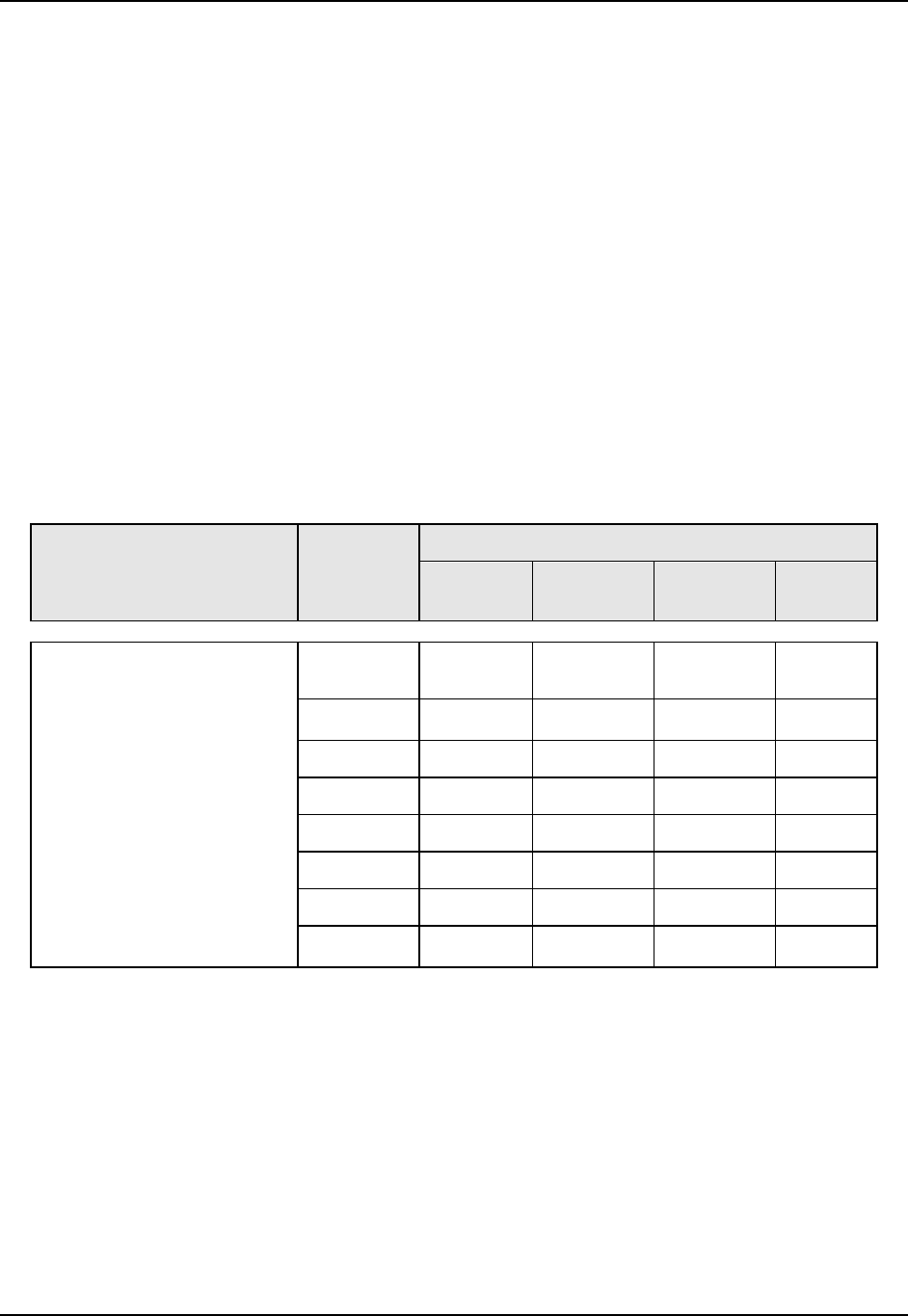
San Bernardino County Development Code
Subdivision Ordinance Applicability and Administration 87.01
Page 7-5 February 5, 2009
(5) Review and make recommendations concerning proposed subdivisions within
incorporated cities in compliance with the Map Act when the advisory agency
has elected to do so; and
(6) Perform additional duties and exercise additional authorities as specified by law
and by this Division.
Adopted Ordinance 4011 (2007); Amended Ordinance 4067 (2009)
87.01.070 Authority for Subdivision Decisions
Table 87-1 (Subdivision Review Authority) identifies the County official or authority
responsible for reviewing and making decisions on each type of subdivision application and
other decision required by this Division.
Table 87-1
Subdivision Review Authority
Type of Decision
Applicable
Development
Code
Section
Role of Review Authority (1)
Director
County
Surveyor
Commission
Board
Tentative Map, Vesting Tentative
Map
87.04
Decision (2)
Decision/
Appeal (3)
Decision/
Appeal
Parcel Map
87.06
Decision
Appeal
Appeal
Final Map
87.06
Recommend
Decision
Certificate of Compliance
87.04.020
Decision
Appeal
Appeal
Official Map
87.04.050
Recommend
Recommend
Recommend
Decision
Lot Line Adjustment
87.04.040
Decision
Appeal
Appeal
Parcel Merger
87.04.050
Decision
Appeal
Appeal
Reversion to Acreage
87.04.060
Decision
Appeal
Appeal
Notes:
(1) "Recommend" means that the review authority makes a recommendation to a higher decision-making
body; "Decision" means that the review authority makes the final decision on the matter; "Appeal" means
that the review authority may consider and decide upon appeals to the decision of an earlier decision-
making body, in compliance with Chapter 86.08 (Appeals).
(2) The Director may choose to not make a decision on a Tentative Map and may instead refer the matter to
the Commission for hearing and a decision. See Section 87.02.040.A (Evaluation of application).
(3) The Commission may choose to not make a decision on a Tentative Map and may instead refer the matter
to the Board for hearing and a decision.
Adopted Ordinance 4011 (2007); Amended Ordinance 4067 (2009)

San Bernardino County Development Code
Subdivision Ordinance Applicability and Administration 87.01
Page 7-6 February 5, 2009
87.01.080 Type of Subdivision Approval Required
Any subdivision of an existing parcel into two or more parcels shall require approval by the
County in compliance with this Division. In general, the procedure for subdivision first requires
the approval of a Tentative Map, and then the approval of a Parcel Map (for a subdivision that
results in four or fewer parcels) or a Final Map (for a subdivision that results in five or more
parcels) to complete the subdivision process. The County's review of a Tentative Map evaluates
the compliance of the proposed subdivision with County standards, and the appropriateness of
the proposed subdivision design. Parcel and Final Maps are precise surveying documents that
detail the location and dimensions of all parcel boundaries in an approved subdivision and, after
approval, are recorded in the office of the County Recorder.
(a) Tentative Map requirements. The filing and approval of a Tentative Map is required
for:
(1) A subdivision or resubdivision of four or fewer parcels, as authorized by Map
Act Section 66428; and
(2) A subdivision or resubdivision or of five or more parcels, and all other types of
subdivisions required to have Tentative Map approval by Map Act Section
66426.
(b) Parcel and Final Map requirements. A Parcel or Final Map (see Chapter 87.03)
shall be required as follows:
(1) Parcel Map. The filing and approval of a Parcel Map (Chapter 87.06) shall be
required for a subdivision creating four or fewer parcels, with or without a
designated remainder in compliance with Map Act Article 2, Chapter 1, except
for the following subdivisions:
(A) Public agency or utility conveyances. Any conveyance of land, including
a fee interest, an easement, or a license, to a governmental agency, public
entity, public utility or a subsidiary of a public utility for rights-of-way,
unless the Director determines based on substantial evidence that public
policy necessitates a Parcel Map, in an individual case, in compliance with
Map Act Section 66428;
(B) Rail right-of-way leases. Subdivisions of a portion of the operating right-
of-way of a railroad corporation as defined by Section 230 of the California
Public Utilities Code, which are created by short-term leases (terminable by
either party on not more than 30 days' notice in writing); or
(C) Waived Parcel Map. A subdivision that has been granted a waiver of
Parcel Map requirements in compliance with Section 87.03.030 (Waiver of
Parcel Map).

San Bernardino County Development Code
Subdivision Ordinance Applicability and Administration 87.01
Page 7-7 February 5, 2009
(2) Final Map. The filing and approval of a Final Map (Chapter 87.03) shall be
required for a subdivision of five or more parcels, except a subdivision that is
otherwise required to have a Parcel Map by Map Act Section 66426.
(c) Exemptions from subdivision approval requirements. The types of subdivisions
identified by Map Act Sections 66411, 66412, 66412.1, 66412.2, and 66426.5, or
other applicable Map Act provision as not being subject to the requirements of the
Map Act, and/or not being considered to be divisions of land for the purposes of the
Map Act, shall be exempt from the subdivision approval requirements of this Division.
Adopted Ordinance 4011 (2007); Amended Ordinance 4067 (2009)
87.01.090 Applications Deemed Approved
A subdivision application deemed approved in compliance with Government Code Sections
65956 or 66452.1, 66452.2 or 66452.4, shall be subject to all applicable provisions of this
Development Code, and any conditions imposed by the review authority, which shall be satisfied
by the subdivider before a Building Permit is issued. A Parcel or Final Map filed for record after
its Tentative Map is deemed approved shall remain subject to all the mandatory requirements of
this Division and the Map Act, including Map Act Sections 66473, 66473.5, and 66474.
Adopted Ordinance 4011 (2007); Amended Ordinance 4067 (2009)
87.01.100 Exceptions to Subdivision Standards
An exception to a provision of Chapter 87.06 (Subdivision Design and Improvement
Requirements) may be requested by a subdivider in compliance with this Section. An exception
shall not be used to waive or modify a provision of the Map Act, or a provision of this Division
that is duplicated or paraphrased from the Map Act.
(a) Application. An application for an exception shall be submitted on forms provided by
the Department together with the required filing fee. The application shall include a
description of each standard and requirement for which an exception is requested,
together with the reasons why the subdivider believes the exception is justified.
(b) Filing and processing. A request for an exception shall be filed and processed as
follows.
(1) An exception shall be processed and acted upon in the same manner as the
Tentative Map, concurrently with the Tentative Map if the exception request was
filed at the same time.
(2) The approval of an exception shall not constitute approval of the Tentative Map
and the approval or disapproval of an exception shall not extend the time limits
for the expiration of the map established by Section 87.02.120 (Tentative Map
Time Limits and Expiration).

San Bernardino County Development Code
Subdivision Ordinance Applicability and Administration 87.01
Page 7-8 February 5, 2009
(3) An exception request may be filed after the approval of a Tentative Map, but
shall be considered by the Tentative Map review authority using the same
procedures as the original Tentative Map.
(c) Approval of exception requests. The Board shall have the authority to approve or
disapprove exception requests in compliance with this Section. The Board shall not
grant relief from a specified requirement or standard unless all of the following
findings are first made:
(1) Due to special circumstances or conditions affecting this property, the strict
application of Chapter 87.06 would create an unnecessary hardship;
(2) The exception is consistent with the intent of the requirements of Chapter 87.06
and does not constitute a grant of special privilege;
(3) The exception would not result in significant increased adverse environmental
impacts compared to the strict application of the requirements of Chapter 87.06;
and
(4) The granting of the exception will not be detrimental to the public health, safety,
convenience, and general welfare or injurious to other property in the territory in
which the property is situated.
(5) The exception will not affect the consistency of the proposed subdivision with
the General Plan, any applicable community plan, or any applicable specific
plan.
(d) Conditions of approval. In granting an exception, the Board shall secure substantially
the same objectives of the regulations for which the exception is requested and shall
impose whatever conditions it deems necessary to protect the public health, safety,
convenience, and general welfare, and to mitigate any environmental impacts in
compliance with California Environmental Quality Act (CEQA).
Adopted Ordinance 4011 (2007); Amended Ordinance 4067 (2009)
87.01.110 Appeals
A decision of the Director or Commission made in compliance with this Division may be
appealed in compliance with Chapter 86.08 (Appeals) and Map Act Section 66452.5.
Adopted Ordinance 4011 (2007); Amended Ordinance 4067 (2009)
87.01.120 Enforcement of Subdivision Regulations
(a) Violations. A person who violates any provision of this Division shall be subject to
the penalties specified by Map Act Division 2, Chapter 7, Article 1 and/or, where

San Bernardino County Development Code
Subdivision Ordinance Applicability and Administration 87.01
Page 7-9 February 5, 2009
applicable, shall be guilty of a misdemeanor or infraction as specified in Chapter 86.09
of this Development Code (Enforcement).
(b) Prohibitions.
(1) Prohibition on transfers.
(A) No person shall sell, lease, or finance any parcel or portion of a parcel of
real property, or commence construction of any building for sale, lease, or
financing on a parcel, except for model homes, or allow occupancy, for
which a Parcel or Final Map is required by this Division and the Map Act,
until a map in full compliance with this Division has been filed for record
by the County Recorder.
(B) Conveyance of any part of a division of real property for which a Final or
Parcel Map is required by this Division shall not be made by parcel or block
number, initial or other designation, until the map has been filed for record
by the County Recorder.
(2) Prohibition on issuance of permits.
(A) No officer, board, commission, agency, department, or special district of the
County shall issue any permit or grant any approval necessary to develop
any real property that has been divided, or that has resulted from a division,
in violation of the provisions of this Division if it finds or is informed by the
Director that development of the real property is contrary to the public
health and safety. Before making a finding that the development of the real
property is contrary to the public health and safety, the Director shall
conduct a review.
(B) At the review, the Director shall consider all information and evidence
submitted. The decision of the Director may be appealed in compliance
with Map Act Section 66452.5 to the Commission by any aggrieved person,
or by a County officer, board, department, or agency. The authority to
disapprove the permit or requested approval shall apply whether the
applicant was the owner of the real property at the time of the violation, or
whether the applicant, if the current owner of the real property, was with or
without actual or constructive knowledge of the violation at the time of the
violation, at the time of the acquisition of their interest in the real property.
If any County officer, board, commission, agency, department, or special
district issues any permit or grants approval for the development of real
property, it may request a report from the Director and impose any
additional conditions as would have been applicable to the division of the
property at the time the current owner of record acquired the property.
(C) For parcels created before March 4, 1972, notice of the review shall be
given by registered mail to the owner of the real property as shown on the

San Bernardino County Development Code
Subdivision Ordinance Applicability and Administration 87.01
Page 7-10 February 5, 2009
latest equalized assessment roll book. The review shall be held not less than
14 days nor more than 30 days after receipt by the owner of the notice of
review.
(3) Statement of limitations. This Section does not apply to any parcel of a
subdivision offered for sale or lease, contract for sale or lease, or sold or leased in
compliance with or exempt from any law regulating the design and improvement
of subdivisions in effect at the time the subdivision was established.
(c) Remedies. If construction activity on property subject to a Parcel or Final Map is
occurring contrary to the Map Act, a requirement of the Map, or any other Federal,
State, or local law, rule, or ordinance, the Director may order the activity stopped by
written notice served on any person responsible for the activity, in addition to the
remedies outlined in Map Act Division 2, Chapter 7, Article 2. The responsible person
shall immediately stop the activity until authorized by the Director to proceed. For the
purposes of this Section, construction activities include, but are not limited to, grading,
earth moving, and/or tree removal.
Adopted Ordinance 4011 (2007); Amended Ordinance 4067 (2009)

San Bernardino County Development Code
Tentative Map Filing and Processing 87.02
Page 7-11 February 5, 2009
CHAPTER 87.02 TENTATIVE MAP FILING AND PROCESSING
Sections:
87.02.010 Purpose
87.02.020 Tentative Map Preparation, Application Contents
87.02.030 Tentative Map Filing, Initial Processing
87.02.040 Evaluation of Application
87.02.050 Review and Decision
87.02.060 Tentative Map Approval or Disapproval
87.02.070 Conditions of Approval
87.02.080 Effective Date of Tentative Map Approval
87.02.090 Changes to Approved Tentative Map or Conditions
87.02.100 Effect of Tentative Map Approval, Completion of Subdivision Process
87.02.110 Vesting Tentative Maps
87.02.120 Tentative Map Time Limits and Expiration
87.02.130 Extensions of Time for Tentative Maps
87.02.010 Purpose
This Chapter establishes requirements for the preparation, filing, approval or disapproval of
Tentative Maps, consistent with the requirements of the Map Act.
Adopted Ordinance 4011 (2007); Amended Ordinance 4067 (2009)
87.02.020 Tentative Map Preparation, Application Contents
(a) Submittal requirements. When a Tentative Map is required by Section 87.01.080
(Type of Subdivision Approval Required), Tentative Map submittal shall include the
application forms, all information and other materials prepared as required by the
Department and the County Surveyor, and a Tentative Map prepared in the format
required by the Department and the County Surveyor.
(b) Filing of phased projects. If the subdivider wishes to file multiple Parcel or Final
Maps for a development project that will be phased, then one of the following shall
first be completed:
(1) The subdivider, at the time the Tentative Map is filed, shall inform the
Department of the subdivider's intention to file multiple Parcel or Final Maps on
the Tentative Map; or
(2) After the filing of the Tentative Map, the Department and the subdivider concur in
the filing of multiple Final Maps.

San Bernardino County Development Code
Tentative Map Filing and Processing 87.02
Page 7-12 February 5, 2009
(3) A subdivider filing multiple Parcel or Final Maps shall show the boundary limits
of each phase and designate the sequence of filing for recordation of each phase to
the satisfaction of the Development Review Committee.
Adopted Ordinance 4011 (2007); Amended Ordinance 4067 (2009)
87.02.030 Tentative Map Filing, Initial Processing
(a) General filing and processing requirements. A Tentative Map application shall be
submitted to the Department for processing, and shall be:
(1) Reviewed for completeness and accuracy (refer to Section 85.03.020
[Applications for Land Use Decisions]);
(2) Referred to affected agencies;
(3) Reviewed in compliance with the California Environmental Quality Act (CEQA)
where applicable; and
(4) Evaluated in compliance with Section 87.02.040 (Evaluation of Application)
below.
(b) Referral to affected agencies. The procedure provided by this Subsection is in
addition to the procedures in Chapter 85.01 (Permit Application Filing and
Processing).
(1) Required referrals. The Director shall refer a Tentative Map application for
review and comment to agencies that will be expected to provide service to the
proposed subdivision, including, as appropriate, County agencies and
departments, cities, special districts, and local agencies, public utilities, and State
agencies.
(2) Anticipated type of response. The agencies that receive a Tentative Map
application are expected to respond to the Department with an evaluation of the
proposal, a list of items (e.g., hydrology study, title report, traffic study, etc.) that
may need to be filed and considered during the evaluation phase, and a list of
proposed conditions of Tentative Map approval.
(3) Time limits for referral and response. As required by Map Act Sections 66453
through 66455.7, referral shall occur within five days of the Tentative Map
application being determined to be complete. An agency wishing to respond to a
referral shall provide the Department with its recommendations within 15 days
after receiving the Tentative Map application.
Adopted Ordinance 4011 (2007); Amended Ordinance 4067 (2009)

San Bernardino County Development Code
Tentative Map Filing and Processing 87.02
Page 7-13 February 5, 2009
87.02.040 Evaluation of Application
The following shall occur after completion of the initial processing and the application being
deemed complete.
(a) Evaluation of application. The Director:
(1) Shall review and evaluate each Tentative Map as to its compliance and
consistency with applicable provisions of this Development Code, the General
Plan, any applicable community plan, any applicable specific plan, and the Map
Act, in compliance with Map Act Section 66474.2;
(2) Shall determine the extent to which the proposed subdivision complies with the
findings in Section 87.02.060 (Tentative Map Approval or Disapproval);
(3) Shall determine that the project is "noncontroversial." For the purpose of this
Section, "noncontroversial" shall mean:
(A) That no member of the Development Review Committee objects to the
project or any portion of the project;
(B) No specific written request has been received requesting public hearing
review of the project from a person notified; and
(C) In the opinion of the Director, there has been no substantial objection to the
proposed project from members of the public.
(4) May refer the project to the Commission for action if the Director determines the
project to be controversial.
(b) Preparation of an evaluation. The Director shall prepare an evaluation in compliance
with Map Act Section 66452.3 describing the conclusions of the map application
review. Copies of the evaluation shall be mailed to the subdivider (and each tenant of
the subject property, in the case of a condominium conversion [Section 87.04.030]) at
least three days before any hearing or action on the Tentative Map by the review
authority in compliance with Section 87.02.050 or 87.02.060.
(1) County department evaluations and recommendations. Wherever possible,
the evaluations and recommendations of the County departments shall be
presented to the Planning Agency by the Chair of the Development Review
Committee or designee.

San Bernardino County Development Code
Tentative Map Filing and Processing 87.02
Page 7-14 February 5, 2009
(2) Required action in the case of waste discharge violations. The Development
Review Committee shall advise the Planning Agency as to whether the discharge
of waste from the proposed subdivision into an existing community sewer system
will result in the violation of existing requirements prescribed by the California
Regional Water Quality Control Board in compliance with Water Code Section
13000 et seq. In the event that the Planning Agency finds that the proposed waste
discharge would result in or add to violation of the requirements of the Water
Quality Control Board, it may disapprove the Tentative Map(s), or take other
action as may be allowed by the policies of the Board of Supervisors.
Adopted Ordinance 4011 (2007); Amended Ordinance 4067 (2009)
87.02.050 Review and Decision
(a) Review authority. The Director shall be the review authority for all Tentative Maps,
except as follows, and shall use the following procedures for reviewing and making
decisions on Tentative Maps.
(1) Tentative Tract Maps and Vesting Tentative Maps. The Director shall review
each Tentative Map proposing five or more parcels, each Vesting Tentative Map,
and any other Tentative Tract Map that requires the recordation of a Final Map in
compliance with the Staff Review with Notice Procedures in Section 85.02.030
(Staff Review with Notice). The applications for these maps shall also be
reviewed by the Development Review Committee (DRC) for its
recommendations. The Director may refer a Tentative Map to the Commission
for action where the Director first determines that:
(A) There have been substantial public objections to the proposal;
(B) The proposal is filed concurrently with an application subject to public
hearing review procedures; or
(C) Any member of the Development Review Committee objects to the
proposal.
(2) Tentative Parcel Map. A Tentative Map proposing four or fewer parcels shall
be reviewed in compliance with the procedures for Staff Review with Notice in
Section 85.02.030 (Staff Review with Notice).The applications for these maps
shall also be reviewed by the DRC for its recommendations when the subdivision
is of a type described in Map Act Section 66426(a), (b), (c), or (d). The Director
may refer a Tentative Parcel Map to the Commission when the Director
determines that the proposal is controversial, or when the proposal is filed
concurrently with an application that is otherwise required by this Development
Code to have a public hearing.

San Bernardino County Development Code
Tentative Map Filing and Processing 87.02
Page 7-15 February 5, 2009
(3) Tentative Map referred to the Commission. When a Tentative Map is referred
to the Commission for action, a public hearing shall be required in compliance
with Chapter 86.07 (Public Hearings).
(b) Review of Tentative Map.
(1) Actions of review authority. After completion of the evaluation required by
Section 87.02.040 (Evaluation of Application), the review authority shall:
(A) Review and evaluate each Tentative Map as to its compliance and
consistency with applicable provisions of this Development Code, the
General Plan, any applicable community plan, any applicable specific plan,
and the Map Act. The evaluation shall be based on the information provided
by an initial study or environmental impact report (EIR), where applicable,
and any public testimony received; and
(B) Approve, conditionally approve, or disapprove the Tentative Map in
compliance with Map Act Section 66452.1 and Public Resources Code
Section 21151.5 within 50 days after certification of the EIR, adoption of a
negative declaration, or a determination by the local agency that the project
is exempt from the requirements of Public Resources Code Division 13
(commencing with Section 21000).
(2) Findings required. Tentative Map approval shall require that the review
authority first make all of the findings required by Section 87.02.060 (Tentative
Map Approval or Disapproval). The review authority may require conditions of
approval in compliance with Section 87.02.070 (Conditions of Approval).
(3) Appeal of decision. A decision by the review authority to approve, conditionally
approve, or disapprove a Tentative Map may be appealed to the Board, in
compliance with Chapter 86.08 (Appeals) and Map Act Section 66452.5.
Adopted Ordinance 4011 (2007); Amended Ordinance 4067 (2009)
87.02.060 Tentative Map Approval or Disapproval
In order to approve or recommend the approval of a Tentative Map and conditions of approval,
or to disapprove a Tentative Map, the review authority shall first make the findings required by
this Section. In determining whether to approve a Tentative Map, the County shall apply only the
ordinances, policies, and standards in effect at the date the Department determined that the
application was complete in compliance with Section 87.02.030 (Tentative Map Filing, Initial
Processing), except where the County has initiated General Plan, community plan, specific plan,
area plan or Development Code changes, and provided public notice as required by Map Act
Section 66474.2.
(a) Required findings for approval.

San Bernardino County Development Code
Tentative Map Filing and Processing 87.02
Page 7-16 February 5, 2009
(1) Mandatory findings. The review authority shall approve a Tentative Map only
after first making all of the following findings, as required by Map Act Sections
66474 and 66474.6. The findings shall apply to each proposed parcel as well as
the entire subdivision, including any parcel identified as a designated remainder
in compliance with Map Act Section 66424.6.
(A) The proposed map, subdivision design, and improvements are consistent
with the General Plan, any applicable community plan, and any applicable
specific plan;
(B) The site is physically suitable for the type and proposed density of
development;
(C) The design of the subdivision and the proposed improvements are not likely
to cause substantial environmental damage or substantially and avoidably
injure fish or wildlife or their habitat;
(D) The design of the subdivision or type of improvements is not likely to cause
serious public health or safety problems;
(E) The design of the subdivision or the type of improvements will not conflict
with easements acquired by the public at large for access through or use of,
property within the proposed subdivision. This finding may also be made if
the review authority finds that alternate easements for access or use will be
provided, and that they will be substantially equivalent to ones previously
acquired by the public. This finding shall apply only to easements of record,
or to easements established by judgment of a court of competent
jurisdiction, and no authority is hereby granted to the review authority to
determine that the public at large has acquired easements of access through
or use of property within the proposed subdivision;
(F) The discharge of sewage from the proposed subdivision into the community
sewer system will not result in violation of existing requirements prescribed
by the California Regional Water Quality Control Board;
(G) The design of the subdivision provides, to the extent feasible, passive or
natural heating and cooling opportunities; and
(H) The proposed subdivision, its design, density, and type of development and
improvements conforms to the regulations of this Development Code and
the regulations of any public agency having jurisdiction by law.
(2) Additional specific findings. The following additional specific findings shall be
made by the review authority before approval or conditional approval of a
Tentative Map, as applicable to the application.

San Bernardino County Development Code
Tentative Map Filing and Processing 87.02
Page 7-17 February 5, 2009
(A) If the proposed subdivision is a conversion of residential real property into a
condominium, a community apartment project, or a stock cooperative, the
review authority shall first make the additional finding that the proposed
subdivision complies with the requirements of Map Act Sections 66427.1(a)
and 66452 before approving the proposed subdivision. Those requirements
include the following:
(I) Each of the tenants of the proposed condominium, community
apartment project, or stock cooperative project has received written
notification of intention to convert at least 60 days before the filing of
a Tentative Map in compliance with Section 66452.
(II) Each of the tenants, and each person applying for the rental of a unit in
the residential real property, has, or will have, received all applicable
notices and rights required in compliance with Sections 66451 and
66452.
(III) Each of the tenants received 10-days' written notification that an
application for a public report will be, or has been, submitted to the
State Department of Real Estate, and that the report will be available
on request.
(B) If the proposed subdivision is within an Agricultural Preserve, it shall
comply with Map Act Section 66474.4 and the findings in that Section,
whether or not the land is currently under contract.
(3) Findings under an EIR. Notwithstanding the finding required by Subsection
(a)(1)(C), above, the review authority may approve a Tentative Map, or a Parcel
Map for which a Tentative Map was not required, if an Environmental Impact
Report (EIR) was prepared for the project and a finding is made in compliance
with Paragraph (3) of Subdivision (a) of Section 21081 of the Public Resources
Code, that specific economic, social, or other considerations make the mitigation
measures or project alternatives identified in the EIR infeasible.
(b) Supplemental findings. In addition to the findings identified in Subsection A. above,
the review authority shall not approve a Tentative Map unless it can also make the
following findings, when they are applicable to the specific subdivision proposal.
(1) Construction of improvements. In the case of a Tentative Map for a subdivision
that will require a subsequent Parcel Map, the construction of improvements for
the subdivision within a specified time after the recordation of the Parcel Map is
in the interest of the public health and safety, and it is necessary as a prerequisite
to the orderly development of the surrounding area.
(2) Waiver of Parcel Map. The findings required by Section 87.03.030 (Waiver of
Parcel Map), if waiver of a Parcel Map has been requested with the Tentative
Map application.

San Bernardino County Development Code
Tentative Map Filing and Processing 87.02
Page 7-18 February 5, 2009
(c) Situations requiring disapproval unless prerequisites satisfied. A Tentative Map
shall not be approved in the following cases.
(1) Residential conversion without required advance tenant notice. In the case of
a conversion of residential real property to a condominium project, community
apartment project, or stock cooperative, the review authority shall not approve
the Tentative Map unless evidence is provided by the subdivider, as required by
Map Act Sections 66452.8 and 66452.9, that proper notification has been given
to each of the tenants of the proposed conversion notifying of the subdivider's
intent to convert.
(2) Residential conversion without required favorable votes. In the case of a
conversion of a stock cooperative or a community apartment project to a
condominium, the review authority shall not approve a Tentative Map unless
evidence is provided by the subdivider, as required by Map Act Section
66452.10, that the required number of owners in the cooperative or project, as
specified in the bylaws or other organizational documents, have voted in favor of
the conversion.
(3) Agricultural preserve parcels too small for agriculture. In the case of land
that is subject to a contract in compliance with the California Land Conservation
Act of 1965 (Government Code Section 51296) or if the land is located within an
agricultural preserve without being subject to a contract, the review authority
shall not approve a Tentative Map, or a Parcel Map for which a Tentative Map
was not required, if it finds that a parcel(s) proposed within the subdivision
would be too small to sustain its agricultural use.
(A) For the purposes of this Section, land shall be presumed to be in parcels too
small to sustain their agricultural use if the land is:
(I) Less than 10 acres in the case of prime agricultural land, except as
allowed in Subsection 3.c below; or
(II) Less than 40 acres in size in the case of land that is not prime
agriculture land unless otherwise provided by this Development Code.
(B) The review authority may approve a subdivision with parcels smaller than
those listed above if the findings in Map Act Subsections 66474.4(c)(1) or
66474.4(c)(2), along with the other applicable findings in this Section are
first made, or the land within the subdivision is subject to a contract when
one of the following has occurred in compliance with Map Act Subsection
66474.4(e):
(I) The Local Agency Formation Commission has approved the
annexation of the land to a city and the city will not succeed to the
contract as provided in Government Code Sections 51243 and
51243.5.

San Bernardino County Development Code
Tentative Map Filing and Processing 87.02
Page 7-19 February 5, 2009
(II) Written notice of nonrenewal of the contract has been served on or
after March 7, 1985, as provided in Government Code Section 51245,
and, as a result of that notice, there are no more than three years
remaining in the term of the contract.
(III). The Board has granted tentative approval for cancellation of the
contract in compliance with Government Code Section 51282.
(C) In compliance with Government Code Section 66474.4(c), the Board has
made the finding that parcels smaller than 10 acres in size within
Agricultural Preserves and designated RL (Rural Living) in the Crafton area
east of Redlands can sustain agricultural uses allowed under Land
Conservation Contracts; provided, the Planning Agency makes all of the
following additional findings before the approval of any proposed
subdivision:
(I) The subdivision is compatible with and would not adversely effect the
existing agricultural uses or support services within the preserve;
(II) The subdivision will not serve to encourage land uses which will
conflict with commercial agricultural uses; and
(III) The proposed subdivision has no parcels less than five acres in area
unless the parcels are within a planned development or are for "well
lot" purposes only. The average parcel size of all parcels within a
planned development subdivision is not less than five acres.
Adopted Ordinance 4011 (2007); Amended Ordinance 4067 (2009)
87.02.070 Conditions of Approval
Along with the approval of a Tentative Map, the review authority may adopt any conditions of
approval deemed necessary to carry out the purposes of this Development Code, including
conditions regarding the matters described in Subsection (a), below; provided, that all conditions
shall be consistent with the requirements of the Map Act.
(a) Dedications and improvements.
(1) As a condition of approval of a map of five or more parcels, the Director may
require dedications and improvements as necessary to ensure that the parcels to
be created:
(A) Are provided with adequate public services and utilities, including any
appropriate cable television services, to meet the needs of future residents or
users;

San Bernardino County Development Code
Tentative Map Filing and Processing 87.02
Page 7-20 February 5, 2009
(B) Are of adequate design in all respects in compliance with this Development
Code;
(C) Act to mitigate any potential environmental impacts identified in the
Environmental Impact Report (EIR) or by other means; and
(D) Provide for proper grading and erosion control, including the prevention of
sedimentation or damage to off-site property.
(2) All improvements shall comply with adopted County standards.
(b) Access.
(1) Except as provided below, parcels created by a subdivision of land shall abut
upon a recorded dedicated public right-of-way of a width as established by the
County Master Plan of Highways or County Highway Right-of-Way Standards,
or shall be ensured of access to the County road system by an approved access
which connects a parcel(s) to a maintained public street or State highway.
(2) The review authority may waive the requirements for approved access to
subdivisions having parcel sizes of 40 gross acres or more when all of the
following findings are first made:
(A) The applicant is or will be subject to severe hardship unless the waiver is
approved;
(B) There is an existing traveled roadway which has been in existence for at
least five years which roadway is at least 20 feet in width at all points; and
(C) The roadway has the capability for normal motor vehicle use to each parcel
in the proposed subdivision.
(3) Private road easements may be approved for access to each parcel if it is
determined that public street access cannot be provided due to certain title
limitations or topographical conditions.
(4) Road easements of record established before the effective date of this Division
shall be recognized as legal access to each parcel of the proposed subdivision.
(5) Existing traveled roads for which a court has determined that a prescriptive right
by users exists for public use shall be recognized as legal access to each parcel of
the proposed subdivision.
(c) Applicable ordinances, policies, and standards. In determining whether to approve
or disapprove an application for a Final Map, the County shall apply only those
ordinances, policies, and standards in effect on the date the proposal for the
subdivision was accepted as complete, in compliance with Map Act Section 66474.2.

San Bernardino County Development Code
Tentative Map Filing and Processing 87.02
Page 7-21 February 5, 2009
(d) Conditions modifying subdivision design – Time for compliance. When
modifications in design require a change in the conditions of approval of a Tentative
Map, the subdivider shall, at least 30 days before the submission of a Final Map,
submit the appropriate number of copies of the Tentative Map as modified to the
Department for distribution to, and review for confirmation by, the Development
Review Committee representatives.
Adopted Ordinance 4011 (2007); Amended Ordinance 4067 (2009)
87.02.080 Effective Date of Tentative Map Approval
The approval of a Tentative Map shall become effective for the purposes of filing a Parcel or
Final Map, including compliance with conditions of approval, in compliance with Section
86.06.020 (Effective Date of Permits).
Adopted Ordinance 4011 (2007); Amended Ordinance 4067 (2009)
87.02.090 Changes to Approved Tentative Map or Conditions
A subdivider may request changes to an approved Tentative Map or its conditions of approval
before recordation of a Parcel or Final Map in compliance with this Section. Changes to a Parcel
or Final Map after recordation are subject to Section 87.03.120 (Amendments to Recorded Parcel
or Final Maps).
(a) Limitation on allowed changes. Changes or amendments to a Tentative Map that
may be requested by a subdivider in compliance with this Section include major
adjustments to the location of proposed lot lines and improvements, and reductions in
the number of approved parcels (but no increase in the number of approved parcels),
and any changes to the conditions of approval, consistent with the findings required by
Subsection (d) (Findings for approval), below. All proposed changes not covered by
this Section shall require the filing and processing of a new Tentative Map.
(b) Application for changes. The subdivider shall file an application and filing fee with
the Department, using the forms furnished by the Department, together with the
following additional information:
(1) A statement identifying the Tentative Map number, the features of the map or
particular conditions to be changed and the changes requested, the reasons why
the changes are requested, and any facts that justify the changes; and
(2) Any additional information deemed appropriate by the Department.
(c) Processing. Proposed changes to a Tentative Map or conditions of approval shall be
processed using the same procedures as the original Tentative Map, except as
otherwise provided by this Section.

San Bernardino County Development Code
Tentative Map Filing and Processing 87.02
Page 7-22 February 5, 2009
(d) Findings for approval. The review authority shall not modify the approved Tentative
Map or conditions of approval unless it first finds that the change is necessary because
of one or more of the following circumstances, and that all of the applicable findings
for approval required by Sections 87.02.070(a) and (b), above, can still be made:
(1) There was a material mistake of fact in the deliberations leading to the original
approval;
(2) There has been a change of circumstances related to the original approval; or
(3) A serious and unforeseen hardship has occurred, not due to any action of the
applicant subsequent to the enactment of this Development Code.
(e) Effect of changes on time limits. Approved changes to a Tentative Map or conditions
of approval shall not be considered as approval of a new Tentative Map, and shall not
extend the time limits provided by Section 87.02.120 (Tentative Map Time Limits and
Expiration).
Adopted Ordinance 4011 (2007); Amended Ordinance 4067 (2009)
87.02.100 Effect of Tentative Map Approval, Completion of Subdivision Process
(a) Effect of approval on prior approvals. The approval or conditional approval by the
review authority of any revised or new Tentative Map shall annul all previous
subdivision designs and approvals thereof.
(b) Compliance with conditions, improvement plans. After approval of a Tentative
Map in compliance with this Chapter, the subdivider shall proceed to fulfill the
conditions of approval within any time limits specified by the conditions and the
expiration of the map and, where applicable, shall prepare, file, and receive approval
of improvement plans in compliance with Chapter 87.06 (Subdivision Design and
Improvement Requirements), before constructing any required improvements.
(c) Parcel or Final Map preparation, filing, and recordation.
(1) A Parcel Map for a subdivision of four or fewer parcels shall be prepared, filed,
processed, and recorded in compliance with Chapter 87.03 (Parcel Maps and
Final Maps), to complete the subdivision, unless a Parcel Map has been waived
in compliance with Section 87.03.030 (Waiver of Parcel Map).
(2) A Final Map for a subdivision of five or more parcels shall be prepared, filed,
processed, and recorded in compliance with Chapter 87.03 (Parcel Maps and
Final Maps), to complete the subdivision.
(3) Project phasing and the filing of multiple Parcel or Final Maps shall be in
compliance with Section 87.02.020 (Tentative Map Preparation, Application
Contents).

San Bernardino County Development Code
Tentative Map Filing and Processing 87.02
Page 7-23 February 5, 2009
(4) Upon the filing and recordation of any map, including amended maps and
certificates of corrections or any record of survey pursuant to the Business and
Professions Code, the County Recorder shall transmit an electronic copy of the
map to the County Surveyor. The County Surveyor shall maintain a geographic
index for all recorded documents transmitted pursuant to this section.
Adopted Ordinance 4011 (2007); Amended Ordinance 4067 (2009)
87.02.110 Vesting Tentative Maps
The preparation, filing, processing, and approval or disapproval of a Vesting Tentative Map shall
comply with Map Act Sections 66452 and 66498.1 et seq. and the provisions of this Section.
(a) Filing criteria for Vesting Tentative Maps.
(1) Whenever a provision of the Map Act, as implemented and supplemented by this
Division, requires the filing of a Tentative or Parcel Map for a residential
development, a Vesting Tentative Map may be filed instead in compliance with
this Section.
(2) If a subdivider does not seek the rights conferred by the Vesting Tentative Map
statute, the filing of a Vesting Tentative Map shall not be a prerequisite to any
approval for any proposed permit for construction, or work preparatory to
construction.
(b) Content of application. The content and form of Vesting Tentative Maps shall be
governed by the provisions of this Subsection.
(1) At the time a Vesting Tentative Map is filed, it shall have printed conspicuously
on its face the words "Vesting Tentative Map."
(2) A Vesting Tentative Map shall be filed in the same form and have the same
contents, accompanying data, and reports as identified in Section 87.02.020
(Tentative Map Preparation, Application Contents), except as specified in this
Section.
(c) Procedures. The following provisions shall govern the filing, processing, and review
of Vesting Tentative Maps.
(1) A Vesting Tentative Map shall be processed and reviewed using the same
procedures as identified in this Division for a Tentative Map in compliance with
Sections 87.02.030 (Tentative Map Filing, Initial Processing) and 87.02.050
(Review and Decision), except as specified in this Section.
(A) Before filing a Vesting Tentative Map, the subdivider shall have a pre-
application conference with the Development Review Committee (DRC) to
determine if any additional information should be filed with the Vesting

San Bernardino County Development Code
Tentative Map Filing and Processing 87.02
Page 7-24 February 5, 2009
Tentative Map application. The applicant shall submit to the DRC before
the pre-application conference all information that is required of a Tentative
Map application. This information will be reviewed by the DRC and
additional information may be required by the Committee to be submitted
with the Vesting Tentative Map application. Preliminary environmental
review of the proposed project shall be completed before the pre-application
conference.
(B) The minutes of the pre-application conference shall dictate the filing
requirements for the Vesting Tentative Map, and shall accompany the filing
of the map. The information required by the DRC for formal submittal of
the proposed project may include the following:
(I) Drainage plan for control of on- and off-site storm runoff, channels,
water courses, existing culverts, and drainpipes including existing and
proposed facilities for the control of storm waters, data as to the
amount of runoff and the approximate grade, and dimensions of
proposed facilities for the control of storm waters.
(II) Building envelopes.
(III) Proposed land use and types of all structures.
(IV) Detailed circulation information (existing and proposed). This
information may include area wide traffic data sufficient for the
County to determine future circulation needs.
(V) Detailed grading plans.
(VI) Geological studies.
(VII) Any information required by the DRC shall be clearly detailed and
listed with an anticipated review period so that it can be acted upon
within a reasonable time. The agency or department which requires
any additional information shall approve the acceptability of this
information from the applicant before the filing of the Vesting
Tentative Map.
(VIII) The DRC may require the filing and concurrent review of other
related development applications where it is necessary for the review
and implementation of the Vesting Tentative Map.
(C) An approving action on a Vesting Tentative Map shall not occur before the
effective date of approval of the associated discretionary permit(s) or
action(s).

San Bernardino County Development Code
Tentative Map Filing and Processing 87.02
Page 7-25 February 5, 2009
(D) Upon filing a Vesting Tentative Map, the subdivider shall pay the fees
required in compliance with the County Fee Ordinance for the filing and
processing of a Vesting Tentative Map.
(E) The approval or conditional approval of a Vesting Tentative Map shall
expire at the end of the same time period, and shall be subject to the same
extensions, established by this Division for the expiration of the approval or
conditional approval of a Tentative Map in compliance with Section
87.02.120 (Tentative Map Time Limits and Expiration).
(F) At any time before the expiration of a Vesting Tentative Map, the
subdivider may apply for an amendment to the Vesting Tentative Map in
compliance with Section 87.02.090 (Changes to Approved Tentative Map
or Conditions). No application for amendment shall be required when the
review authority first finds that the amendment is a minor modification that
is in substantial compliance with the original approval and no new
conditions of approval are required.
(G) For a subdivision whose intended development is inconsistent with the land
use zoning district or any applicable community or specific plan in
existence at that time, that inconsistency shall be noted on the map. The
review authority may disapprove a Vesting Tentative Map or approve it
conditioned on the subdivider first obtaining the necessary change in the
land use zoning district or applicable community or specific plan to
eliminate the inconsistency. If the change in the pertinent ordinance is
obtained, the approved or conditionally approved Vesting Tentative Map
shall confer the right to proceed with the development as approved or
conditionally approved.
(H) Fees for development permits (e.g., Building and Grading Permits) filed in
compliance with an approved Vesting Tentative Map or a recorded Vesting
Final/Parcel Map shall be the fees in effect at the time of issuance of the
permit.
(d) Development rights of Vesting Tentative Maps.
(1) When the review authority approves or conditionally approves a Vesting
Tentative Map, that approval shall confer a vested right to proceed with the
development in substantial compliance with the ordinances, policies, and
standards in effect on the date the application for the subdivision has been
determined to be complete in compliance with Map Act Section 66474.2. If
Section 66474.2 is repealed, that approval shall confer a vested right to proceed
with development in substantial compliance with the ordinances, policies, and
standards in effect at the time the Vesting Tentative Map is approved or
conditionally approved.

San Bernardino County Development Code
Tentative Map Filing and Processing 87.02
Page 7-26 February 5, 2009
(2) Notwithstanding Subsection 1., above, the review authority may condition or
disapprove a permit, approval, extension, entitlement, or require an amendment
to the map if it first determines any of the following:
(A) A failure to do so would place the residents of the subdivision or the
immediate community, or both, in a condition dangerous to their health or
safety, or both.
(B) The condition or disapproval is required in order to comply with State or
Federal law.
(3) The review authority may alter any condition of a Vesting Tentative Map
through an amendment in compliance with Section 87.02.090 (Changes to
Approved Tentative Map or Conditions) in order to protect against conditions
dangerous to public health and safety or to comply with State or Federal law.
(4) The rights conferred by this Section shall expire if a Final or Parcel Map is not
recorded before the expiration of the Vesting Tentative Map in compliance with
Section 87.02.120 (Tentative Map Time Limits and Expiration). If the Final or
Parcel Map is recorded, these rights shall last for the following periods of time:
(A) An initial time period of 12 months. Where several Final Maps are recorded
on various phases of a project covered by a single Vesting Tentative Map,
this initial time period shall begin for each phase when the Final Map for
that phase is recorded.
(B) The initial time period identified in Subsection (A), above shall be
automatically extended by any time used for processing a complete
application for a Grading Permit or for design or architectural review, if
processing exceeds 30 days from the date a complete application is filed.
(C) A subdivider may apply for one 12-month extension at any time before the
initial time period identified in Subsection (A), above, expires. If the
extension is disapproved, the subdivider may appeal that disapproval to the
Board in compliance with Chapter 86.08 (Appeals) and Map Act Section
66452.5 within 15 days.
(D) If the subdivider submits a complete application for a Building Permit
during the periods of time specified in this Subsection, the rights referred to
in this Subsection shall continue until the expiration of that permit, or any
extension of that permit.
Adopted Ordinance 4011 (2007); Amended Ordinance 4067 (2009)

San Bernardino County Development Code
Tentative Map Filing and Processing 87.02
Page 7-27 February 5, 2009
87.02.120 Tentative Map Time Limits and Expiration
(a) Valid for 36 months. An approved Tentative Map is valid for 36 months after its
effective date, except as otherwise provided by Map Act Section 66452.6. At the end
of 36 months, the approval shall expire and become void unless:
(1) A Parcel or Final Map, and related security and improvement agreements, have
been timely filed with the County Surveyor in compliance with Chapter 87.03
(Parcel Maps and Final Maps); or
(2) An extension of time has been granted in compliance with Section 87.02.130,
below.
(b) Expiration of an approved map. Expiration of an approved Tentative Map or
Vesting Tentative Map shall terminate all proceedings. The application shall not be
reactivated unless a new Tentative Map application is filed.
Adopted Ordinance 4011 (2007); Amended Ordinance 4067 (2009)
87.02.130 Extensions of Time for Tentative Maps
When a subdivider has not completed all Tentative Map or Vesting Tentative Map conditions of
approval and timely filed a Parcel or Final Map with the County within the time limits
established by Section 87.02.120, time extensions may be granted in compliance with this
Section, Section 86.06.060 (Time Limits and Extensions), and Map Act Sections 66452.6 and
66463.5.
(a) Filing of extension request. An extension request shall be in writing and shall be filed
with the Department on or before the date of expiration of the approval or previous
extension, together with the required filing fee.
(b) Findings for approval of extension. Extensions to the initial time limit may be
granted only after first finding all of the following:
(1) There have been no changes to the provisions of the General Plan, any applicable
community plan, any applicable specific plan, or this Development Code
applicable to the project since the approval of the Tentative Map;
(2) There have been no changes in the character of the site or its surroundings that
affect how the policies of the General Plan, any applicable community plan, any
applicable specific plan, or other standards of this Development Code apply to
the project; and
(3) There have been no changes to the capacities of community resources, including
but not limited to water supply, sewage treatment or disposal facilities, roads, or
schools so that there is no longer sufficient remaining capacity to serve the
project.

San Bernardino County Development Code
Tentative Map Filing and Processing 87.02
Page 7-28 February 5, 2009
Adopted Ordinance 4011 (2007); Amended Ordinance 4067 (2009)

San Bernardino County Development Code
Parcel Maps and Final Maps 87.03
Page 7-29 February 5, 2009
CHAPTER 87.03 PARCEL MAPS AND FINAL MAPS
Sections:
87.03.010 Purpose
87.03.020 Parcel Maps
87.03.030 Waiver of Parcel Map
87.03.040 Parcel Map Form and Content
87.03.050 Filing and Processing of Parcel Maps
87.03.060 Parcel Map Approval
87.03.070 Final Maps
87.03.080 Final Map Form and Content
87.03.090 Filing and Processing of Final Maps
87.03.100 Final Map Approval
87.03.110 Composite Development Plans
87.03.120 Amendments to Recorded Parcel or Final Maps
87.03.010 Purpose
This Chapter establishes requirements for the preparation, filing, processing, approval,
conditional approval, or disapproval, and recordation of Parcel and Final Maps, consistent with
the requirements of the Map Act.
Adopted Ordinance 4011 (2007); Amended Ordinance 4067 (2009)
87.03.020 Parcel Maps
As required by Sections 87.01.080 (Type of Subdivision Approval Required), and 87.02.100
(Effect of Tentative Map Approval, Completion of Subdivision Process), a Parcel Map shall be
filed and approved to complete the subdivision process for a subdivision of four or fewer parcels,
except when the requirement for a Parcel Map is waived as identified in Section 87.03.030. A
Parcel Map shall be prepared, filed, and processed as identified in Section 87.03.040, et seq.
Adopted Ordinance 4011 (2007); Amended Ordinance 4067 (2009)
87.03.030 Waiver of Parcel Map
A subdivider may request the waiver of the requirement for a Parcel Map, and the waiver may be
granted, in compliance with the Map Act Section 66428, provided that the review authority shall
first find that the proposed subdivision complies with all applicable requirements of this
Development Code and the Map Act as to area, improvement and design, floodwater drainage
control, appropriate improved public roads, sanitary disposal facilities, water supply availability,
environmental protection, and all other applicable requirements of this Development Code and
the Map Act. A Composite Development Plan, prepared in compliance with Section 87.03.110
(Composite Development Plans), may still be required by the Director.

San Bernardino County Development Code
Parcel Maps and Final Maps 87.03
Page 7-30 February 5, 2009
Adopted Ordinance 4011 (2007); Amended Ordinance 4067 (2009)
87.03.040 Parcel Map Form and Content
A Parcel Map shall be prepared by or under the direction of a licensed land surveyor or civil
engineer authorized to practice land surveying by the State of California. Parcel Map submittal
shall include all information and other materials prepared as required by the County Surveyor
policies, adopted standards, and the Map Act. The Parcel Map shall be based upon a field survey.
Adopted Ordinance 4011 (2007); Amended Ordinance 4067 (2009)
87.03.050 Filing and Processing of Parcel Maps
(a) Filing with the County Surveyor. The Parcel Map, together with all data,
information, and materials required by Section 87.03.040 shall be submitted to the
County Surveyor in compliance with the time limitations specified in Section
87.02.120 (Tentative Map Time Limits and Expiration). The Parcel Map shall be
considered submitted when it is complete and complies with all applicable provisions
of the Map Act and this Development Code.
(b) Filing and review of advance copy of Parcel Map.
(1) Filing with County Surveyor. Where the filing of a Parcel Map is required in
compliance with this Division after the approval or conditional approval of the
Tentative Parcel Map application, the subdivider may cause the real property
included within the map to be surveyed and a Parcel Map prepared in compliance
with the approved Tentative Parcel Map application. An advance copy of the
Parcel Map shall be filed with the County Surveyor.
(2) Contents of advance copy. The advance copy of the Parcel Map shall be
accompanied by all documents required by the County Surveyor. The mapping
standards issued by the County Surveyor list the submittal requirements for a
Parcel Map.
(3) Review of advance copy for condition compliance. The County Surveyor shall
be the primary coordinator in seeing that the conditions of approval of the
Tentative Map have been fulfilled. The County Surveyor shall transmit maps to
and request written reports from the County departments and public utilities,
including any cable television systems, which have submitted recommendations
on the Tentative Map. Within 20 days after receipt of an advance copy of the
Parcel Map, the County department or utility shall issue a preliminary written
report regarding the compliance or noncompliance of the advance copy of the
Parcel Map to the matters under its jurisdiction.
(c) Filing of official copy of Parcel Map. If the advance copy of the Parcel Map has been
found satisfactory by the County Surveyor, the subdivider shall cause the Parcel Map
to be officially filed with the County Surveyor at least 20 days before the expiration of

San Bernardino County Development Code
Parcel Maps and Final Maps 87.03
Page 7-31 February 5, 2009
the approved or conditionally approved Tentative Map or any approved extension of
time granted in compliance with Section 87.02.130 (Extensions of Time for Tentative
Maps). The Parcel Map shall not be officially filed until the engineer or surveyor has
received notification from the County Surveyor that all provisions of the Tentative
Map approval, the Map Act, this Development Code, the County Code, and applicable
County standards have been complied with. The filing of the official copy of the
Parcel Map with the County Surveyor shall constitute the timely filing of the Parcel
Map.
(d) Review of Parcel Map.
(1) After the issuance of a receipt for the Parcel Map, the County Surveyor shall
examine it as to sufficiency of affidavits and acknowledgements, correctness of
surveying data, mathematical data and computations, and other matters which
may require checking to ensure compliance with the provisions of the Map Act,
this Division, and County Surveyor standards.
(2) If the Parcel Map does not conform as required above, the subdivider shall be
notified, and given the opportunity to make necessary changes and resubmit the
Parcel Map, together with all required data, if the Tentative Map has not expired.
(e) Improvement agreements and security requirements. The filing and recording of a
Parcel Map shall be subject to the requirements of Section 87.07.040 (Improvement
Agreements and Security).
Adopted Ordinance 4011 (2007); Amended Ordinance 4067 (2009)
87.03.060 Parcel Map Approval
After determining that the Parcel Map is technically correct and in full compliance with this
Section, the County Surveyor may approve the Parcel Map in compliance with Map Act Section
66463(b) or, if deemed appropriate, forward it to the Board for approval or disapproval. After
approval, the Parcel Map shall be transmitted by the County Surveyor to the office of the County
Recorder for recordation in compliance with Map Act Section 66450.
Adopted Ordinance 4011 (2007); Amended Ordinance 4067 (2009)
87.03.070 Final Maps
As required by Section 87.01.080 (Type of Subdivision Approval Required), a Final Map shall
be filed and approved to complete the subdivision process for a subdivision of five or more
parcels. A Final Map shall be prepared, filed, and processed in compliance with Section
87.03.080 et seq.
Adopted Ordinance 4011 (2007); Amended Ordinance 4067 (2009)

San Bernardino County Development Code
Parcel Maps and Final Maps 87.03
Page 7-32 February 5, 2009
87.03.080 Final Map Form and Content
A Final Map shall be prepared by or under the direction of a licensed land surveyor or civil
engineer authorized to practice land surveying by the State of California. Final Map submittal
shall include all information and other materials prepared as required by the County Surveyor
policies, adopted standards, and the Map Act.
Adopted Ordinance 4011 (2007); Amended Ordinance 4067 (2009)
87.03.090 Filing and Processing of Final Maps
(a) Filing with County Surveyor. The Final Map, together with all data, information,
and materials required by Section 87.03.080 shall be submitted to the County
Surveyor in compliance with the time limitations specified in Section 87.02.120
(Tentative Map Time Limits and Expiration) and Subsection (e) (Time Limit for
Filing Final Map), below. The Final Map shall be considered submitted when it is
complete and fully complies with all applicable provisions of the Map Act and this
Development Code.
(b) Filing and review of advance copy of Final Map.
(1) Filing with County Surveyor. After receipt of the action of the review authority
approving or conditionally approving the Tentative Map, the subdivider may
cause the real property included within the map, or any part thereof, to be
surveyed and a Final Map prepared in compliance with the approved or
conditionally approved Tentative Map application. An advance copy of the Final
Map shall be filed with the County Surveyor.
(2) Contents of advance copy. The advance copy of the Final Map shall be
accompanied by all documents required by the County Surveyor. The mapping
standards issued by the County Surveyor list the submittal requirements for a
Final Map.
(3) Review of advance copy for condition compliance. The County Surveyor shall
be the primary coordinator in seeing that the conditions of approval of the
Tentative Map have been fulfilled. The County Surveyor shall transmit maps to
and request written reports from the County departments and public utilities,
including any cable television systems, which have submitted recommendations
on the Tentative Map. Within 20 days after receipt of an advance copy of the
Final Map, the County department or utility shall issue a preliminary written
report regarding the compliance or noncompliance of the advance copy of the
Final Map to the matters under its jurisdiction.
(c) Filing of official copy of Final Map. If the advance copy of the Final Map has been
found satisfactory by the County Surveyor, the subdivider shall cause the Final Map to
be officially filed with the County Surveyor at least 20 days before the expiration of
the approved or conditionally approved Tentative Map or any approved extension of

San Bernardino County Development Code
Parcel Maps and Final Maps 87.03
Page 7-33 February 5, 2009
time granted in compliance with Section 87.02.130 (Extensions of Time for Tentative
Maps). The Final Map shall not be officially filed until the engineer or surveyor has
received notification from the County Surveyor that all provisions of the Tentative
Map approval, the Map Act, this Development Code, the County Code, and applicable
County standards have been complied with. The filing of the official copy of the Final
Map with the County Surveyor shall constitute the timely filing of the Final Map.
(d) Review of Final Map.
(1) After the issuance of a receipt for the Final Map, the County Surveyor shall
examine it as to sufficiency of affidavits and acknowledgements, correctness of
surveying data, mathematical data and computations, and other matters which
may require checking to ensure compliance with the provisions of the Map Act,
this Division, and County Surveyor standards.
(2) If the Final Map is found to be in substantial compliance with the Tentative Map
and is in correct form, the matters shown on the map are sufficient, and the
County Surveyor is satisfied that all of the conditions of approval have been met,
the County Surveyor shall endorse approval of the Final Map. The County
Surveyor shall combine with the Final Map the agreements, easements, and
securities as required by this Division. The material shall be transmitted to the
Board for its consideration of the Final Map.
(e) Time Limit for filing Final Map. If the subdivider fails to file the Final Map with the
County Surveyor and the required accompanying data with the appropriate County
departments within 36 months after the date of first approval by the review authority
or within any authorized extension of time, the Tentative Map approval or conditional
approval shall become void. In this case, a new filing fee shall be paid, and an
application for a new Tentative Map approval shall be filed.
(1) If 120 days before the submittal of a Final Map, the subdivider has failed to
comply with the Tentative Map conditions which require the subdivider to
construct or install off-site improvements on land in which neither the subdivider
nor the County has sufficient title or interest, including an easement or license,
then at the time the Final Map is filed with the local agency, to permit the
improvements to be made, the subdivider shall enter into an agreement with the
County through its Department of Public Works to pay all costs of the County in
acquiring the property.
(2) The County shall have 120 days from the filing of the Final Map, in compliance
with Map Act Section 66457, to obtain interest in the land to allow the
improvement(s) to be made by negotiation or proceedings in compliance with
Title 7 (commencing with Section 1230.010) of Part 3 of the Code of Civil
Procedure, including proceedings for immediate possession of the property under
Article 3 (commencing with Section 1255.410) of Article 6 of that Title.

San Bernardino County Development Code
Parcel Maps and Final Maps 87.03
Page 7-34 February 5, 2009
(3) In the event the County fails to meet the 120-day time limitation, the condition
for construction of off-site improvements shall be conclusively deemed to be
waived.
(4) Before approval of the Final Map, the County may require the subdivider to enter
into an agreement to complete the improvements, in compliance with Subsection
(f) (Improvement agreements and security requirements), below, at the time as
the County acquires an interest in the land which will allow the improvements to
be made.
(5) "Off-site improvements," as used in this Subsection, do not include
improvements which are necessary to ensure replacement or construction of
housing for persons and families of low or moderate income, as defined in Health
and Safety Code Section 50093.
(f) Improvement agreements and security requirements. If at the time of approval of
the Final Map by the Board, any improvements required by local ordinance or as a
condition of the approval of the Tentative Map have not been completed in
compliance with County standards applicable at the time of the approval or
conditional approval of the Tentative Map, the Board, as a condition precedent to
approval of the Final Map, shall require the subdivider to enter into an agreement with
the Board in compliance with Section 87.07.040 (Improvement Agreements and
Security).
(g) Multiple Final Maps.
(1) Multiple Final Maps may only be filed if the subdivider included a statement of
intention with the Tentative Map that the subdivider would submit multiple
phased Final Maps.
(2) Project phasing and the filing of multiple Final Maps shall be in compliance with
Section 87.02.020 (Tentative Map Preparation, Application Contents).
Adopted Ordinance 4011 (2007); Amended Ordinance 4067 (2009)
87.03.100 Final Map Approval
After determining that the Final Map is in compliance with Section 87.03.080, and is technically
correct, the County Surveyor shall execute the County Surveyor's certificate on the map in
compliance with Map Act Section 66442, and forward the Final Map to the County Clerk for
Board action, as follows.
(a) Review and approval by Board. The Board shall approve or disapprove the Final
Map at the meeting at which it receives the map from the County Surveyor or at its
regular meeting after the meeting at which it receives the map, unless that time limit is
extended with the mutual consent of the County Surveyor and the subdivider.

San Bernardino County Development Code
Parcel Maps and Final Maps 87.03
Page 7-35 February 5, 2009
(1) Criteria for approval. The Board shall approve the Final Map if it conforms to
all of the requirements of the Map Act, all provisions of this Development Code
that were applicable at the time that the Tentative Map was approved, and is in
substantial compliance with the approved Tentative Map.
(2) Approval by inaction. If the Board does not approve or disapprove the Final
Map within the prescribed time or any authorized extension, and the map
conforms to all applicable requirements, it shall be deemed approved, and the
County Clerk shall certify its approval on the map.
(b) Map with dedications. If a dedication or offer of dedication is required on the Final
Map, the Board shall accept, accept subject to improvement, or reject any or all offers
of dedication, at the same time as it takes action to approve the Final Map. If the
Board rejects the offer of dedication, the offer shall remain open and may be accepted
by the Board at a later date in compliance with Map Act Section 66477.2. Any
termination of an offer of dedication shall be processed in compliance with Map Act
Section 66477.2 using the same procedures as specified by Part 3 of Division 9 of the
Streets and Highway Code.
(c) Map with incomplete improvements. If improvements required by this Development
Code, conditions of approval, or other applicable laws have not been completed at the
time of approval of the Final Map, the Board shall require the subdivider to enter into
an agreement with the County as specified in Map Act Section 66462, and Section
87.07.040 (Improvement Agreements and Security), as a condition precedent to the
approval of the Final Map.
(d) Recording of Final Map.
(1) After action by the Board and after the required signatures and seals have been
affixed, the Clerk of the Board shall transmit the Final Map back to the County
Surveyor.
(2) The County Surveyor shall establish an appointment with the County Recorder
for filing.
(3) The County Recorder shall oversee the recording of the Final Map.
Adopted Ordinance 4011 (2007); Amended Ordinance 4067 (2009)
87.03.110 Composite Development Plans
In addition to the information required to be included in a Parcel or Final Map (Sections
87.03.040 and 87.03.080, respectively), a Composite Development Plan may be required to be
submitted and recorded as follows, as provided by Map Act Section 66434.2 to provide
additional and more detailed information.

San Bernardino County Development Code
Parcel Maps and Final Maps 87.03
Page 7-36 February 5, 2009
(a) Applicability. The Director may require the filing of a Composite Development Plan
at the time a Parcel or Final Map is accepted for recordation. The Composite
Development Plan shall be filed with the Building and Safety Division concurrent
with the recordation of the Final or Parcel Map.
(b) Content. A Composite Development Plan shall be prepared and shall include the
information required by the Department handout on Composite Development Plans, as
required by the Composite Development Plan Standards established by the County
Surveyor and adopted by the Board, and as required by the conditions of approval.
(c) Filing and review. A Composite Development Plan shall be filed as follows.
(1) Filing advance copy. At least three weeks before the recordation of the Parcel or
Final Map, the Composite Development Plan shall be submitted for coordination
of review to the County Surveyor.
(2) Filing official copy of Composite Development Plan. Concurrent with the
filing for recordation of the Parcel or Final Map the Composite Development
Plan, as approved by the Director and County Surveyor in compliance with this
Section, shall be filed with the Building and Safety Division.
(d) Amendments to plan.
(1) Should an error be made on the Parcel or Final Map which affects the Composite
Development Plan approved in compliance with this Section, the Parcel or Final
Map and the Composite Development Plan may be amended as approved by the
County Surveyor and the Director. A Revision to an Approved Action
application is required for all other changes to a Composite Development Plan in
compliance with Chapter 85.12.
(2) The Director is authorized to approve amended Composite Development Plans
when they do not adversely impact the conditions of other departments and the
amendment is in substantial compliance with the conditions of approval of the
Tentative or Parcel Map.
(3) Any request to modify or deviate from the standards that are shown on a
Composite Development Plan shall be made in compliance with the provisions
for Variances, except as otherwise provided by this Section.
Adopted Ordinance 4011 (2007); Amended Ordinance 4067 (2009)
87.03.120 Amendments to Recorded Parcel or Final Maps
A recorded Parcel or Final Map may be amended to correct errors in the recorded map or to
change characteristics of the approved subdivision in compliance with Map Act Chapter 3,
Article 7.

San Bernardino County Development Code
Parcel Maps and Final Maps 87.03
Page 7-37 February 5, 2009
(a) Type of corrections allowed in compliance with Map Act Section 66469. In the
event that errors in a Parcel or Final Map are discovered after recordation, or that other
corrections are necessary, the corrections may be accomplished by either the filing of
a certificate of correction or an amending map, in compliance with Map Act Chapter
3, Article 7. For the purposes of this Section, "errors" include errors in course or
distance (but not changes in courses or distances from which an error is not
ascertainable from the Parcel or Final Map), omission of any course or distance, errors
in legal descriptions, or any other map error or omission as approved by the County
Surveyor that does not affect any property right, including but not limited to parcel
numbers, acreage, street names, and identification of adjacent record maps. Other
corrections may include indicating monuments set by engineers or surveyors other
than the one that was responsible for setting monuments, or showing the proper
character or location of any monument that was incorrectly shown, or that has been
changed.
(1) Application and review process. An application to amend a recorded Parcel or
Final Map in compliance with Map Act Section 66469 shall be filed with the
County Surveyor. The County Surveyor shall determine if the changes requested
may be approved with a certificate of correction or an amending map. The
County Surveyor may request additional information based upon that
determination and shall approve the certificate of correction or the amending map
if the required findings can be made.
(2) Findings. A Parcel of Final Map may be amended, if the County Surveyor first
finds all of the following to be true:
(A) The changes requested only involve minor map annotation corrections;
(B) The amendment(s) does not impose any additional burden on the fee owners
of the real property;
(C) The amendment(s) does not alter any right, title, or interest in the real
property reflected on the map; and
(D) The map, as amended, is still in compliance with Map Act Section 66474.
(b) Type of corrections allowed in compliance with Map Act Section 66472.1. In the
event that there are changes in circumstances which make any or all of the conditions
of a recorded Parcel or Final Map no longer appropriate or necessary, the following
procedures shall be followed to amend the map:
(1) Application and review process. An application to amend a recorded Parcel or
Final Map in compliance with Map Act Section 66472.1 shall be filed with the
Director. The Director shall refer the application to the County Surveyor for
comment. Once approved by both the Director and the County Surveyor, the
application shall be sent to the Board for approval of either a certificate of

San Bernardino County Development Code
Parcel Maps and Final Maps 87.03
Page 7-38 February 5, 2009
correction or an amending map. The Board shall approve the application if the
required findings can be made.
(2) Findings. A Parcel of Final Map may be amended, if the Board first finds all of
the following to be true:
(A) There are changes in circumstances that make any or all of the conditions of
the map no longer appropriate or necessary;
(B) The amendment(s) does not impose any additional burden on the fee owners
of the real property;
(C) The amendment(s) does not alter any right, title, or interest in the real
property reflected on the map; and
(D) The map, as amended, is still in compliance with Map Act Section 66474.
(c) Recordation. After approval, the certificate of correction or amending map shall be
submitted to the County Recorder for recordation.
(d) Amendment of an approved subdivision. In the event that a subdivider wishes to
amend (e.g., change or modify) the characteristics of an approved subdivision (e.g., a
recorded Parcel or Final Map), including but not limited to the number or
configuration of parcels, location of streets or easements, or the nature of required
improvements, the construction of which has been deferred through the approval of an
agreement in compliance with Section 87.07.040 (Improvement Agreements and
Security), the subdivider shall file a new Tentative, Parcel, or Final Map in
compliance with this Division or comply with the requirements of Map Act Section
66499.20-1/2.
Adopted Ordinance 4011 (2007); Amended Ordinance 4067 (2009)

San Bernardino County Development Code
Additional Subdivision Procedures 87.04
Page 7-39 February 5, 2009
CHAPTER 87.04 ADDITIONAL SUBDIVISION PROCEDURES
Sections:
87.04.010 Purpose
87.04.020 Certificates of Compliance
87.04.030 Condominiums and Condominium Conversions
87.04.040 Lot Line Adjustment
87.04.050 Official Maps
87.04.060 Parcel Merger
87.04.070 Reversion to Acreage
87.04.080 Resident Initiated Mobile Home Park Conversion
87.04.010 Purpose
This Chapter establishes requirements consistent with the Map Act for Certificates of
Compliance, Condominiums and Condominium Conversions, Lot Line Adjustments, Official
Maps, Parcel Mergers, and Reversion to Acreage.
Adopted Ordinance 4011 (2007); Amended Ordinance 4067 (2009)
87.04.020 Certificates of Compliance
(a) General provisions.
(1) The County shall process and approve or disapprove applications for Certificates
of Compliance as provided by Map Act Sections 66499.34 and 66499.35, and as
outlined by this Section.
(2) Filing criteria.
(A) A recorded Certificate of Compliance may be requested by any person
owning real property to have the Director determine whether the property
complies with the provisions of this Development Code.
(B) A Certificate of Compliance may be required by the Department with the
recordation of a Notice of Merger.
(C) A recorded Certificate of Compliance shall be required of all Lot Line
Adjustments.
(D) When contiguous deeds or surveys have ambiguities in which the property
boundary can not be ascertained as determined by the County Surveyor and
an agreement is reached to establish the line by all parties, a Boundary Line
Agreement and a Certificate of Compliance shall be recorded.

San Bernardino County Development Code
Additional Subdivision Procedures 87.04
Page 7-40 February 5, 2009
(E) When determined by the County Surveyor, a Certificate of Compliance may
be required for the remainder parcels on Parcel or Final Maps.
(b) Application. An application for the approval of a Certificate of Compliance or
Conditional Certificate of Compliance shall be filed with the Director and include the
information required by the Director, together with the processing fee specified by the
County Fee Ordinance.
(c) Review by Director. The Director shall review the completed application using the
Staff Review without Notice procedures in the light of public records and applicable
law. If the Director is able to determine from this review that the parcel is clearly in
compliance with the provisions of this Division and the Map Act, a Certificate of
Compliance shall be issued for the parcel and delivered to the County Recorder for
recordation. If the Director is unable to determine from this review that the parcel is
clearly in compliance, the procedures identified in Map Act Section 66499.35 shall
apply.
Adopted Ordinance 4011 (2007); Amended Ordinance 4067 (2009)
87.04.030 Condominiums and Condominium Conversions
Condominiums and condominium conversions shall comply with the following requirements in
addition to the standards identified in Chapter 84.16 (Multi-Family Residential Design
Standards).
(a) Condominiums. When a residential structure is proposed at the time of construction
as a condominium, community apartment project, or stock cooperative, a Tentative
Map for the project shall be filed in the same form, have the same contents and
accompanying data and reports and shall be processed, approved or disapproved in the
same manner in compliance with Chapter 87.02 (Tentative Map Filing and
Processing). Chapter 87.03 (Parcel Maps and Final Maps) determines whether a Parcel
or Final Map shall also be filed.
(b) Condominium Conversions. A condominium conversion is the conversion of real
property to a common interest development as defined by California Civil Code
Section 1351.
(1) Approvals required. A conversion shall require the approval of a Tentative
Map, and Parcel or Final Map, except where a Parcel Map, or Tentative and Final
Map are waived in compliance with Map Act Section 66428(b) or Section
66428.1 for the conversion of a mobile home park (See Section 87.04.080
[Resident Initiated Mobile Home Park Conversion], below). If a Parcel or Final
Map is waived, a Tentative Map shall still be required. A Record of Survey shall
be filed for a field survey required in Map Act Section 66428.1 in compliance
with Business and Professions Code Section 8765(c).

San Bernardino County Development Code
Additional Subdivision Procedures 87.04
Page 7-41 February 5, 2009
(2) Application filing and processing. A Tentative Map for a condominium
conversion shall be filed in the same form, have the same contents and
accompanying data and reports, and shall be processed, approved or disapproved
in the same manner as identified in Chapter 87.02 (Tentative Map Filing and
Processing), except as otherwise provided by the following provisions of this
Section.
(3) Application contents. Condominium conversion applications shall include the
same information and materials as Tentative Map applications, except for
conversions of residential projects, which shall also include the following
information and materials.
(A) Tentative Map. The Tentative Map for a condominium, community
apartment project, or the conversion of five or more existing dwelling units
to a stock cooperative need not show the buildings or the manner in which
the airspace above the property shown on the map are to be divided.
However, the applicant shall provide an illustration of how subdivision will
occur to enable verification of the accuracy of the legal descriptions on
deeds for the transfer of ownership of the units by the County Surveyor.
(B) Verification of stock cooperative vote. If the development being
converted to a condominium is a stock cooperative, the application shall
also include verification of the vote required by Map Act Section 66452.10.
(C) Relocation assistance program. A program proposed by the applicant that
will assist tenants displaced through the conversion in relocating to
equivalent or better housing.
(D) Vacancy rate assessment. An assessment of the vacancy rate in multi-
family housing within the County.
(4) Evaluation. The evaluation on the Tentative Map for the condominium
conversion (Section 87.04.030) shall be provided to the subdivider and each
tenant of the subject property at least three days before any action by the Director
or any hearing on the Tentative Map by the Commission or Board.
(5) Public notice. The following notice shall be provided in addition to that required
by Chapter 86.07 (Public Hearings) if the project is to be heard by the
Commission or Board:
(A) Tenant notice. The subdivider shall give notice to all existing or
prospective tenants as identified in Map Act Sections 66452.8 and 66452.9,
and shall provide the Department satisfactory proof that the notice was
given; and

San Bernardino County Development Code
Additional Subdivision Procedures 87.04
Page 7-42 February 5, 2009
(B) Public hearing notice. Notice of the public hearing(s) on the Tentative
Map shall be provided to all tenants of the subject property, as required by
Map Act Section 66451.3.
(6) Approval of conversion, required findings.
(A) Time limit, stock cooperatives. The approval or disapproval of the
conversion of an existing building to a stock cooperative shall occur within
120 days of the application being found complete in compliance with
Section 87.02.030 (Tentative Map Filing, Initial Processing). The 120-day
time limit may be extended by mutual consent of the subdivider and the
County.
(B) Conversion findings, residential projects. Approval of a Tentative or
Final Map for a subdivision to be created from the conversion of residential
real property into a condominium project, community apartment project, or
stock cooperative shall not be granted unless the review authority first finds
all of the following to be true:
(I) All of the findings identified in Map Act Section 66427.1 and
Subsection 87.02.060 (a)(2) (Tentative Map Approval or Disapproval -
- Additional specific findings), above;
(II) The conversion will not result in a major displacement of existing
tenants unable to find comparable housing, and the location of the
conversion and the conditions under which it would be operated or
maintained will not be detrimental to the public health, safety, or
welfare; and
(III) The proposed conversion complies with all of the applicable standards
identified in Chapters 84.16 (Multi-Family Residential Design
Standards).
(7) Completion of subdivision process. The filing, approval, and recordation of a
Parcel or Final Map in compliance with Chapter 87.03 (Parcel Maps and Final
Maps) shall be required to complete the subdivision process, except where a
Parcel Map, or Tentative and Final Map are waived for the conversion of a
mobile home park in compliance with Map Act Section 66428.1 (See Section
87.04.080 [Resident Initiated Mobile Home Park Conversion], below). Where the
maps have been waived, a Certificate of Compliance shall be recorded to
complete the conversion action.
Adopted Ordinance 4011 (2007); Amended Ordinance 4067 (2009)

San Bernardino County Development Code
Additional Subdivision Procedures 87.04
Page 7-43 February 5, 2009
87.04.040 Lot Line Adjustment
A Lot Line Adjustment is permissible in compliance with Map Act Section 66412(d), and the
following.
(a) Application.
(1) A Lot Line Adjustment is between four or fewer existing adjoining parcels,
where the land taken from one parcel is added to an adjoining parcel, and where
a greater number of parcels than originally existed are not created.
(2) An application for a Lot Line Adjustment shall be filed with the Director and
shall include the information required by the Department, together with the
processing fee specified by the County Fee Ordinance. No Tentative, Parcel, or
Final Map shall be required for a Lot Line Adjustment. Survey monuments and a
field survey may be required to facilitate the preparation of the legal description
to ensure the accuracy of the description or the elimination of the encroachments.
(b) Lot Line Adjustment procedures.
(1) Approval. After consultation with the County Surveyor, the Director shall
approve a Lot Line Adjustment; provided that all criteria identified in Map Act
Section 66412(d) are met to the Director's satisfaction.
(2) Findings. The Director shall make all of the following findings before approval
of a Lot Line Adjustment:
(A) The proposed Lot Line Adjustment is consistent with the General Plan, this
Development Code, and any applicable community or specific plan; and
(B) The proposed Lot Line Adjustment will not adversely affect public health
and safety.
(3) Post-approval actions. The Director shall submit a Certificate of Compliance or
a conditional Certificate of Compliance, along with new Grant Deeds and
appropriate Trust Deeds which describe the new boundaries of the parcels to the
County Recorder for recordation.
Adopted Ordinance 4011 (2007); Amended Ordinance 4067 (2009)
87.04.050 Official Maps
(a) Purpose. The purpose of this Section is to provide procedures for Official Maps.
(b) Applicability. Official Maps shall be required as described in Government Code
Section 66499.52

San Bernardino County Development Code
Additional Subdivision Procedures 87.04
Page 7-44 February 5, 2009
(c) Procedures. Official Maps shall be reviewed and processed using the procedures
outlined in Chapter 87.02 (Tentative Map Filing and Processing) of this Division, the
procedures pertaining to the processing and approval of Parcel Maps or Final Maps in
Chapter 87.03 (Parcel Maps and Final Maps), and the provisions of Map Act Division
3.
Adopted Ordinance 4011 (2007); Amended Ordinance 4067 (2009)
87.04.060 Parcel Merger
Parcel Mergers may be mandatory mergers initiated by the County or voluntary mergers initiated
by the property owner.
(a) Procedures for mandatory merger of contiguous parcels. Two or more parcels may
be merged as follows.
(1) Process. When the County initiates a merger of substandard lots, noticing shall
be done in compliance with the procedures outlined in Map Act Chapter 3,
Article 1.5.
(2) Requirements. A mandatory merger of substandard lots may be initiated by the
County. A lot may be merged with a contiguous lot held by the same owner. If
any one of the contiguous lots or units held by the same owner does not conform
to the standards for minimum lot size or dimension specified by the applicable
land use district the following requirements shall be satisfied:
(A) At least one of the affected lots is not developed with any structure for which a
building permit was issued or for which a building permit was not required at
the time of construction, or is developed only with an accessory structure or
accessory structures, or is developed with a single structure, other than an
accessory structure, that is also partially sited on a contiguous lot involved in
the proposed merger; and
(B) At least one of the affected lots must have one or more of the following
conditions:
(I) The lot comprises less than five thousand (5,000) square feet in area at
the time of the determination of merger;
(II) The lot was not created in compliance with applicable laws and
ordinances in effect at the time of its creation;
(III) The lot does not meet current standards for sewage disposal and/or
domestic water supply;
(IV) The lot does not meet slope stability and/or density standards, as specified
by this Code, Specific Plan or the General Plan;

San Bernardino County Development Code
Additional Subdivision Procedures 87.04
Page 7-45 February 5, 2009
(V) The lot has no legal access which is adequate for vehicular and emergency
equipment access and maneuverability;
(VI) The development of the lot would create health or safety hazards;
(VII) The lot is inconsistent with the General Plan and any applicable specific
plan, other than minimum lot size or density standards.
(2) Findings. The Director shall find that all of the following are true before
recording a Notice of Merger.
(A) The parcels to be merged at the time of merger are under common ownership;
(B) The parcels as merged will be consistent with or be more closely compatible
with the applicable land use zoning district regulations and any other planning
policies relating to the subject property and parcel configuration;
(C)The parcels as merged will not be deprived of legal access as a result of the
merger and access to the adjoining parcels will not be restricted by the
merger; and
(D) All current and any delinquent taxes have been paid on all affected parcels.
(E) One or more of the conditions described in section 66451.11(b) have been
met.
(b) Procedures for voluntary merger of contiguous parcels.
(1) Description and purpose. It is the purpose of this Section to allow property
owners to request a voluntary merger of contiguous parcels that are under the
same ownership, pursuant to Map Act Sections 66499.20 1/2 or 66499.20 3/4
pertaining to the reversion to acreage.
(2) Process. The property owner shall file an application for a parcel merger. The
review authority shall be the Director and review of the application shall be
subject to the provisions for Staff Review without Notice procedures. The merger
of the subject parcels become effective when the Director causes a Notice of
Merger specifying the names of the record owners and a description of the real
property to be filed for record with the County Recorder.
(3) Findings. The Director shall find that all of the following are true before
recording a Notice of Merger.
(A) The parcels to be merged at the time of merger are under common ownership;

San Bernardino County Development Code
Additional Subdivision Procedures 87.04
Page 7-46 February 5, 2009
(B) The parcels as merged will not be deprived of legal access as a result of the
merger and access to the adjoining parcels will not be restricted by the
merger; and
(C) All current and any delinquent taxes have been paid on all affected parcels.
(c) Post-approval actions.
(1) If the merger is processed in compliance with Map Act Chapter 3, Article 1.5, the
Director shall submit a Notice of Merger to the County Recorder for recordation
in compliance with Map Act Section 66451.19.
(2) If the merger is processed in compliance with Map Act Section 66499-3/4 or
66499-1/2, the County Surveyor shall follow the procedures for the approval and
recordation of a Parcel Map in compliance with Section 87.03.060 (Parcel Map
Approval) or for the approval and recordation of a Final Map in compliance with
Section 87.03.100 (Final Map Approval).
(d) Requirements for unmerger of parcels. The unmerger of parcels within the County
shall comply with Map Act Chapter 3, Article 1.7.
Adopted Ordinance 4011 (2007); Amended Ordinance 4067 (2009)
87.04.070 Reversion to Acreage
(a) General provisions.
(1) A Reversion to Acreage shall be initiated, processed, reviewed, and approved or
disapproved in compliance with Map Act Chapter 6, Article 1.
(2) An application for reversion submitted by a property owner shall include all
information required by the Department, and shall include the fee required by the
County Fee Ordinance.
(3) A Parcel Map may be filed to revert to acreage land previously subdivided that
consists of four or less contiguous parcels, in compliance with Map Act Section
66499.20-1/4.
(b) Procedures.
(1) The Commission shall hold a public hearing on all petitions for, and Board
initiations of, Reversions to Acreage.
(2) In the case of a Reversion to Acreage by Parcel Map, the Commission may
approve the Reversion to Acreage only if it first makes all of the findings
required by Subsection (c), below.

San Bernardino County Development Code
Additional Subdivision Procedures 87.04
Page 7-47 February 5, 2009
(3) For a Reversion to Acreage by Final Map, the Commission shall render its
decision in the form of a written recommendation to the Board. The
recommendation shall include the reasons for the recommendation and shall be
transmitted to the Board. Upon receipt of the recommendation of the
Commission, the Board shall hold a public hearing. The Board may approve a
Reversion to Acreage only if it first makes all of the findings required by
Subsection (c) below.
(c) Findings. Before approval, the review authority shall first find that all of the findings
required by Map Act Section 66499.16 are true.
(d) Post-approval actions. After the hearing before the Commission and/or the Board
and approval of the Reversion to Acreage, the Parcel or Final Map shall be delivered
to the County Surveyor. The Reversion to Acreage shall be effective upon the Parcel
or Final Map being filed for record by the County Recorder.
Adopted Ordinance 4011 (2007); Amended Ordinance 4067 (2009)
87.04.080 Resident Initiated Mobile Home Park Conversion
(a) Purpose. The purpose of this Section is to facilitate resident purchase of mobile home
parks. This Section allows the waiver of certain subdivision requirements and
expedites local government processing for mobile home park conversions to
condominiums or stock cooperatives. These conversions will preserve an important
source of affordable housing.
(b) Applicability. For the purposes of this Section, an application for subdivision shall be
considered "resident initiated" when signed by a resident organization formed by the
tenants of the subject mobile home park for the purpose of purchasing the mobile
home park. The proposed conversion shall be supported by a minimum of two-thirds
of the current residents of the park. The resident organization shall have a legally
binding contract, which, if the conditions of the contract are met, would result in the
acquisition of an interest in the mobile home park. A pre-application conference may
be requested by the applicant(s) before formation of the resident organization or
before entering into a legally binding contract; provided the Director determines in
writing that it is reasonable to believe that the contract may be entered into within a
12-month period.
(c) Exclusions. The provisions of this Section shall not apply to:
(1) The purchase of a mobile home park by a non-profit corporation which is subject
to the provisions of Business and Professions Code Section 11010.8; or
(2) Special Occupancy Parks (e.g. Recreation Vehicle Parks) as defined in Mobile
Home Parks Act Section 2008, of the California Code of Regulations Title 25.

San Bernardino County Development Code
Additional Subdivision Procedures 87.04
Page 7-48 February 5, 2009
(d) Waiver of Tentative and Final Map requirements. Notwithstanding other
provisions of this Division, the requirement for the filing of a Tentative Map and the
preparation, filing, and recordation of a Final Map for a mobile home park conversion
to a condominium or stock cooperative on a single parcel, may be waived by the
Director in compliance with Map Act Section 66428.1; provided the following
procedures are followed by a resident organization desiring to convert their park and
the necessary findings are made by the Director.
(1) Pre-application conference. Before filing an application for mobile home park
conversion, the resident association shall have a pre-application conference with
the Development Review Committee. The conference shall be scheduled in
compliance with the policy established by the Board for the Housing Incentive
Program. The purpose of this conference is to determine that the proposal
qualifies under the provisions of this Section. The following information shall be
submitted with the application for the conference.
(A) Previously approved plot plan for the mobile home park. If none exists, a
plot plan shall be filed in compliance with the requirements established by
and available at the Department.
(B) A supplemental report to include the following information:
(I) Name of consultants, if any.
(II) Disclosure of all known fees and costs for the conversion process.
(III) Documentation demonstrating that a minimum of two-thirds of the
residents of the mobile home park support the proposed conversion.
(IV) Declarations from those residents supporting the conversion that their
principal place of residence is within the subject mobile home park.
(V) The location of the park and results of a field inspection done by the
applicant(s) or consultant regarding the status of the compliance of the
park with the County health and safety standards in effect at the time
the park was created. Any on-site dedications or public improvements
to be required shall be identified by the committee.
(VI) Proposed tentative schedules to expedite meeting and coordinating any
requirements of the Planning Agency and the Department of Real
Estate, including but not limited to the public report. The schedule
shall include an outline of the permits and noticing required to allow
this conversion and the estimated time at which the permits are
obtained.

San Bernardino County Development Code
Additional Subdivision Procedures 87.04
Page 7-49 February 5, 2009
(VII) Evidence showing that the 60-day Notice of Intent to file the
conversion application [as required by Map Act Section 66427.1(a)]
has been met.
(VIII) Initial report on the impact of the conversion on the residents of the
mobile home park. This report is needed to determine whether an
impact report as required in Map Act Section 66427.4 is needed. The
report shall specify whether any residents of the park are to be
involuntarily displaced and any proposed measures to mitigate the
displacement. A resident, who is offered an opportunity to remain in
the park after the conversion through continuation of the tenancy at
generally the same terms as existed before proposed conversion, shall
not be considered involuntarily displaced. At the pre-application
conference the Development Review Committee shall indicate
whether an impact report needs to be filed with the formal application
for the conversion. If it is required, the Development Review
Committee shall identify in detail any additional items to be required
as mitigation measures to assist any displaced residents. No current
resident shall be involuntarily displaced without proper notice,
assistance, or compensation, to be worked out on a case-by-case basis.
The noticing, assistance, or compensation may include the following:
(i) The project shall comply with the Mobile Home Residency Law,
Civil Code Section 798 et seq.
(ii) The project applicants may be required to provide relocation
assistance in compliance with Federal, State, or local laws.
(C) The Planning representative of the Development Review Committee shall
field check the park before the scheduled meeting. The Development
Review Committee shall establish if the proposed mobile home park
conversion meets the intent and is capable of meeting the provisions of this
Section. The Director shall attempt to inform the applicant(s) at the earliest
opportunity if a public hearing is to be required. If the proposed mobile
home park conversion is acceptable, the Development Review Committee
shall identify the information the applicant needs to file to proceed with the
proposal. The information shall include the following:
(I) Development Review Committee pre-application conference minutes.
These minutes shall include the proposed tentative schedules required
by Subsection (d) (1) (B) (VI), above.
(II) If the parcel upon which the park lies was created before January 1,
1960, a Parcel Map application shall be required. The application shall
be processed concurrently with any other information filed in
compliance with the pre-application conference.

San Bernardino County Development Code
Additional Subdivision Procedures 87.04
Page 7-50 February 5, 2009
(III) Mobile Home Park Conversion Impact Report, if required at the pre-
application conference to meet the requirements of Map Act Section
66427.4. The report shall be given to each resident within the mobile
home park.
(IV) Mobile home park plot plan if no plot plan was previously approved.
(V) Any special information which was identified by the Development
Review Committee. Among the information may be information to
assist in the environmental review of the proposal.
(VI) Certificate of Compliance application.
(D) The review and processing of any application in compliance with this
Section shall be subject to the same review and time requirements and
appeal procedures as are provided in this Division for Tentative Maps. In
any case where waiver of the Tentative and Final Map is granted, the
Director shall cause to be filed for record with the County Recorder a
Certificate of Compliance in compliance with this Division. The Director
may require a public hearing in compliance with Chapter 86.07 (Public
Hearings). Should a public hearing be required the noticing provisions of
Map Act Section 66451.3 shall be met.
(2) Findings for approval. A mobile home park conversion shall be approved or
conditionally approved only if all of the following are first found to be true:
(A) The mobile home park complies with the requirements established by State
law and County ordinance for these uses at the time the mobile home park
was constructed. The regulations shall include those regarding area,
improvement and design, flood water drainage control, public roads,
sanitary disposal facilities, water supply and distribution systems,
environmental protection, and other requirements of the Map Act and this
Division;
(B) Any measures necessary to mitigate the impact of the conversion on current
residents of the park have been required as conditions of approval; and
(C) Applicable noticing requirements of the Map Act have been, or will be met.
(3) Conditions of approval. The following conditions may be required by the
Director as conditions of approval for the proposed conversion:
(A) Subdivisions allowed by this Section may include conditions requiring a
Compliance Survey inspection to the satisfaction of the Director. However,
the survey shall be limited to require improvements relating only to items of
a health and safety nature.

San Bernardino County Development Code
Additional Subdivision Procedures 87.04
Page 7-51 February 5, 2009
(B) The mobile home condominiums or stock cooperatives shall be subject to
California Code of Regulations Title 25.
(C) Only additional on-site improvements or development standards which
were applicable at the time the mobile home park was originally developed
may be required.
(D) Off-site public improvements for qualifying mobile home parks shall be
waived, except as follows:
(I) Any off-site improvements shall be financed with appropriate
assessment bonds.
(II) The Certificate of Compliance shall not be delayed or contingent upon
completion of the off-site improvements.
(E) Any requirements and/or documents required by the State Common Interest
Development Act, Title 6 (commencing with Section 1350), Part 4,
Division 2 of the California Civil Code.
(F) Conditions of approval necessary to ensure any noticing requirements that
are required by Map Act Section 66427.1 are met.
(G) Any plan or document required to be submitted to the Department of Real
Estate shall be reviewed for consistency with the approved project and plot
plan. The plan shall reference the "waiver" notice requirement in Subsection
(H), below, to the satisfaction of the Director.
(H) Notice shall be placed on the Certificate of Subdivision Compliance that
standard subdivision requirements for the creation of condominiums/stock
cooperatives have been waived by the County and only conditions
applicable to the original development of the mobile home park have been
required.
(I) The applicants shall comply with the indemnification requirements of
Section 81.01.070 (Legal Defense Fee Responsibility) of this Development
Code.
(J) The Director may impose any conditions of approval to ensure any
appropriate measures for relocation assistance are implemented.
(K) No mobile home shall be required to be placed on a permanent foundation
as a result of the conditional approval.
(L) Any condition of approval required in compliance with this Section shall be
drafted to expedite the conversion process.

San Bernardino County Development Code
Additional Subdivision Procedures 87.04
Page 7-52 February 5, 2009
Adopted Ordinance 4011 (2007); Amended Ordinance 4067 (2009)

San Bernardino County Development Code
Dedications and Exactions 87.05
Page 7-53 February 5, 2009
CHAPTER 87.05 DEDICATIONS AND EXACTIONS
Sections:
87.05.010 Purpose
87.05.020 Applicability
87.05.030 Dedications
87.05.040 Acceptance of Dedications
87.05.010 Purpose
This Chapter establishes standards for subdivider dedications of land or payment of fees, in
conjunction with subdivision approval.
Adopted Ordinance 4011 (2007); Amended Ordinance 4067 (2009)
87.05.020 Applicability
Each proposed subdivision shall comply with the requirements of this Chapter for dedications,
reservations, or the payment of fees.
Adopted Ordinance 4011 (2007); Amended Ordinance 4067 (2009)
87.05.030 Dedications
(a) Streets, highways, and flood control rights-of-way.
(1) As a condition of approval of a map, the subdivider shall dedicate or make an
irrevocable offer of dedication of all parcels of land within the subdivision that are
needed for:
(A) Access rights and abutters' rights;
(B) Alleys;
(C) Drainage easements;
(D) Public utility easements;
(E) Streets; and
(F) Other public easements.
(2) In addition, the subdivider shall improve or agree to improve all streets, alleys,
including access rights and abutters' rights, drainage, public utility easements and
other public easements. The subdivider may also be required to dedicate the additional

San Bernardino County Development Code
Dedications and Exactions 87.05
Page 7-54 February 5, 2009
land as may be necessary and feasible to provide bicycle paths for the use and safety
of residents of the subdivision.
(b) Drainage rights-of-way. When the Director of Public Works determines that drainage
rights-of-way are necessary, the subdivider shall offer to dedicate upon the Final Map
of the subdivision the necessary rights-of-way for drainage facilities.
(c) Flood control dedication. Where dedication is offered for Flood Control District
rights-of-way, the rights-of-way shall be shown as parcels lettered alphabetically on
the Final Map. The offer of dedication shall be made by an appropriate certificate on
the title sheet of the Final Map, and, in addition, an executed deed conveying fee title
to the right-of-way to the Flood Control District shall be delivered to the District.
Adopted Ordinance 4011 (2007); Amended Ordinance 4067 (2009)
87.05.040 Acceptance of Dedications
(a) Certification of Board action. At the time the Board approves a Final Map, it shall
also accept, subject to improvement, or reject any offer of dedication. The Clerk of the
Board shall certify on the map the action of the Board.
(b) Resolution of acceptance. The Clerk of the Board shall cause a resolution of
acceptance of dedications by the Board to be filed with the County Recorder.
(c) Deferred acceptance. If at the time the Final Map is approved, any streets, alleys,
paths, public utility easements, rights-of-way for local transit facilities including bus
turnouts, benches, shelters, landing pads, and similar items that directly benefit the
residents of a subdivision, or storm drainage easements are rejected subject to Code of
Civil Procedure Section 771.010, the offer of dedication shall remain open and the
Board may by resolution at any later date, and without further action by the
subdivider, rescind its action and accept and open the streets, alleys, paths,
rights-of-way for local transit facilities including bus turnouts, benches, shelters,
landing pads, and similar items that directly benefit the residents of a subdivision, or
storm drainage easements for public use. The acceptance shall be recorded in the
office of the County Recorder.
Adopted Ordinance 4011 (2007); Amended Ordinance 4067 (2009)

San Bernardino County Development Code
Subdivision Design and Improvement Requirements 87.06
Page 7-55 February 5, 2009
CHAPTER 87.06 SUBDIVISION DESIGN AND IMPROVEMENT REQUIREMENTS
Sections:
87.06.010 Purpose
87.06.020 Applicability of Design and Improvement Standards
87.06.030 Subdivision Design Standards
87.06.040 Site Preparation and Grading for Subdivision Construction
87.06.050 Subdivision Improvement Requirements
87.06.010 Purpose
This Chapter establishes standards for the design and layout of subdivisions, and the design,
construction, or installation of public improvements within subdivisions. The purpose of these
standards is to ensure, through careful site evaluation and design, the creation of new usable
parcels that are consistent with the General Plan, any applicable community plan, and any
applicable specific plan.
Adopted Ordinance 4011 (2007); Amended Ordinance 4067 (2009)
87.06.020 Applicability of Design and Improvement Standards
The requirements of this Chapter apply as follows:
(a) Extent of required improvements. Each subdivision of four or fewer parcels, and
each subdivision of five or more parcels, shall provide the improvements required by
this Chapter, and any additional improvements required by conditions of approval.
(b) Applicable design standards, timing of installation. The subdivider shall construct
all on- and off-site improvements according to standards approved by the County
Surveyor. No Parcel or Final Map shall be presented to the Board for approval and no
Parcel Map shall be presented to the County Surveyor for approval until the subdivider
either completes the required improvements, or enters into a subdivision improvement
agreement with the County for the work in compliance with Section 87.06.050
(Subdivision Improvement Requirements).
(c) Subdivision improvement standards Conditions of approval. The applicable
subdivision improvement and dedication requirements of this Chapter and any other
improvements and dedications required by the review authority in compliance with
Section 87.02.060 (Tentative Map Approval or Disapproval), shall be described in
conditions of approval adopted for each approved Tentative Map (Section 87.02.070).
The design, construction, or installation of all subdivision improvements shall comply
with the requirements of the Director of Public Works.

San Bernardino County Development Code
Subdivision Design and Improvement Requirements 87.06
Page 7-56 February 5, 2009
(d) Oversizing of improvements.
(1) At the discretion of the review authority, improvements required to be installed
by the subdivider for the benefit of the subdivision may also be required to
provide supplemental size, capacity, number, or length for the benefit of property
not within the subdivision, and may be required to be dedicated to the County, in
compliance with Map Act Chapter 4, Article 6.
(2) In the event that oversizing is required, the County shall comply with all
applicable provisions of Map Act Sections 66485 et seq., including the
reimbursement provisions of Map Act Section 66486.
(3) If a parcel proposed for subdivision is subject to an existing reimbursement
agreement, the subdivider shall pay the required reimbursement before the
recordation of the Parcel or Final Map, or the issuance of a Building Permit for
construction on the parcel, whichever occurs first.
(e) Exceptions. Exceptions to the requirements of this Chapter may be requested and
considered in compliance with Section 87.01.100 (Exceptions to Subdivision
Standards).
Adopted Ordinance 4011 (2007); Amended Ordinance 4067 (2009)
87.06.030 Subdivision Design Standards
(a) Purpose. This Section establishes standards for the design and layout of subdivisions,
and the design, construction, or installation of public improvements within
subdivisions. The purpose of these standards is to ensure, through careful site
evaluation and design, the creation of new usable parcels that are consistent with the
General Plan, any applicable community plan, and any applicable specific plan.
(b) Applicability. Each subdivision shall be designed in compliance with the standards of
this Section, except where an exception is granted in compliance with Section
87.01.100 (Exceptions to Subdivision Standards).
(c) Roads and streets. The layout, design, and construction of proposed roads and streets
shall comply with the General Plan, and adopted County street standards.
(1) Highway alignment plan. If the General Plan (or any applicable community or
specific plan) designates a general location of a proposed highway and any
portion thereof may be wholly or partially within a proposed subdivision or may
be affected by a proposed subdivision before the approval of the subdivision, a
specific alignment plan shall be prepared and adopted. Each roadway shall
conform in width and alignment with that shown or indicated on the General Plan
or any standards adopted consistent with the General Plan. As a condition of
approval of the subdivision, the subdivider shall be required to make dedications
and construct reasonable improvements as required by the specific alignment

San Bernardino County Development Code
Subdivision Design and Improvement Requirements 87.06
Page 7-57 February 5, 2009
plan. These requirements may be waived by the Director upon recommendation
of the Department of Public Works, if the proposed highway is located upon a
section line or its precise alignment can be otherwise determined.
(2) Circulation standards.
(A) General Plan consistency. The circulation design of all subdivisions shall
be compatible and coordinate with the General Plan (and any applicable
community or specific plan) and the existing street and land use pattern in
the surrounding area.
(B) Part-width highways and alignments. Any part-width highway lying
along and adjacent to any boundary of a subdivision shall have a part-width
and alignment as will conform to the route lines shown on the Master Plan
of Highways covering the same portion of the subdivision.
(C) Cul-de-sacs. Cul-de-sac streets shall not exceed 600 feet in length, except
as provided below, and shall terminate with a turn-around as specified in the
adopted County Road Standards. The Director may approve a cul-de-sac
that exceeds 600 feet if the Director first finds that the cul-de-sac will not be
injurious to the public health, safety, and general welfare.
(D) Road grades. Road grades shall not exceed 12 percent unless it can be
demonstrated that a road grade in excess of 12 percent is necessary to
accomplish the objectives of the General Plan (and any applicable
community or specific plan). In these circumstances, the Director may
approve a road grade not to exceed 14 percent grade for a distance not to
exceed 500 feet if a finding is first made, based upon the recommendations
of the County Director of Public Works and the County Fire Marshall, that
the roadway will not create an unacceptable hazardous risk to the public
health, safety, or general welfare.
(E) Subdivision access. The subdivision and each of its phases shall have two
points of vehicular ingress and egress from existing and surrounding streets,
one of which may be for emergency use only. Where providing this access
is physically impossible or a cul-de-sac is proposed, this requirement may
be waived or modified.
(d) Public access to public resources. Each proposed subdivision shall be designed and
constructed to provide public access to waterways, lakes, and reservoirs in compliance
with Map Act Chapter 4, Article 3.5 (Public Access to Public Resources).
(e) Parcel design. The size, shape, and arrangement of proposed parcels shall comply
with this Section and with any General Plan (and any applicable community or
specific plan) policy, requirement, or other County Code provision that applies to
proposed subdivisions.

San Bernardino County Development Code
Subdivision Design and Improvement Requirements 87.06
Page 7-58 February 5, 2009
(1) General parcel design standards.
(A) Each proposed parcel shall be determined by the review authority to be
"buildable" because it contains at least one building site that can
accommodate a structure in compliance with all applicable provisions of
this Development Code.
(B) No subdivision shall be designed to leave unsubdivided islands, strips or
parcels, or property unsuitable for subdividing, which is not either accepted
by the County or other appropriate entity for public use, or maintained, as
common area within the development.
(2) Parcel area. Each proposed parcel shall comply with the minimum area
requirements of the applicable land use zoning district established by Division 2
(Land Use Zoning Districts and Allowable Land Uses), except as otherwise
provided by this Section.
(A) Calculation of area. When calculating the area of a parcel to determine
compliance with this Section, this Division or the General Plan (and any
applicable community or specific plan), the following shall be deducted
from the gross area of any parcel:
(I) A vehicular access easement through the parcel, unless there is
alternative legal and physical access to the parcel for which the
easement is granted;
(II) Any easement completely restricting or prohibiting any use of the
property, for ingress, egress, landscaping, recreation, storage, etc.; or;
(III) The "flag pole" (access strip) of a flag lot.
(B) Minimum parcel area requirements for common interest projects. The
minimum parcel area requirements of this Development Code or the
minimum "buildable" parcel size shall not apply to condominiums,
condominium conversions, and townhouses, but shall apply to the creation
of the original parcel(s) that are the location of the condominium or
townhouse.
(3) Dimensions and configuration. The dimensions of each new parcel shall
comply with the requirements of the applicable land use zoning district
established by Division 2 (Land Use Zoning Districts and Allowable Land Uses),
or as otherwise required by the review authority.
(A) Side parcel lines shall be approximately normal to street lines.
(B) Each parcel on a dead-end street where the side lines converge from front to
the rear of the parcel shall have an average width of not less than 60 feet, or

San Bernardino County Development Code
Subdivision Design and Improvement Requirements 87.06
Page 7-59 February 5, 2009
the width required by this Development Code, whichever is greater,
measured along the front building setback line.
(C) Each parcel on a curved street where the side lines converge from the front
to the rear of the parcel shall have an average width of not less than 60 feet,
or the width required by this Development Code, whichever is greater.
(D) Double frontage parcels shall be discouraged except where essential to
separate residential developments from major or secondary highways or due
to topographical conditions. When double frontage parcels are allowed,
vehicular access rights shall be dedicated to the County along the street
designated by the Director.
(E) The Director may require parcels larger than the above minimum sizes
specified in multi-family residential, commercial, and industrial
subdivisions. When parcels twice or more the required area or width are
shown as part of a subdivision, the Director may require the parcel(s) to be
so established as to make practical a further division into allowable building
sites, without injury to adjoining property.
(F) In desert, hilly, or mountainous areas, the Director may require parcels
larger than required minimums. Larger parcels shall be required when it is
deemed to be necessary in order to conform to the General Plan or any
applicable community or specific plan.
(G) Flag lots shall be discouraged.
(H) Modification of these parcel design standards may be allowed in
compliance with:
(I) The Parcel Area Regulations of Division 2 of this Development Code.
(II) The Planned Development standards and regulations of Division 4 of
this Development Code.
(I) This Subsection does not apply to any parcel which the subdivider offers to
dedicate to the County or any public agency or district.
(J) When a land use zoning district classification line divides a parcel(s), the
area and frontage requirements for the parcel(s) shall be those of the land
use zoning district that requires the greater or most restrictive standards
between the two districts involved.
Example: If the line between a Neighborhood Commercial (CN) District and a Single
Residential (RS) district divides a parcel, the applicable area and frontage requirements
would be those for the CN as they are greater than those for the RS district.

San Bernardino County Development Code
Subdivision Design and Improvement Requirements 87.06
Page 7-60 February 5, 2009
(f) Energy conservation. Each proposed subdivision shall be designed to provide
maximum opportunities for energy conservation, including opportunities for passive
or natural heating or cooling opportunities, in compliance with Map Act Section
66473.1, as follows.
(1) Street layout. The streets proposed in a subdivision shall be planned in a
primarily east-west orientation where feasible.
(2) Parcel and building site design. Proposed parcels shall be designed, where
feasible, to provide building sites that allow the orientation of structures in east-
west alignment for southern exposure, and to take advantage of existing shade or
prevailing breezes.
(g) Environmental health. Lands to be subdivided for residential, park, playground, or
land recreation purposes may be subject to environmental quality standards as
established by ordinances and regulations of the different departments and agencies
within the County.
(h) Fire protection.
(1) Subdivision design shall provide for safe and ready access for fire and other
emergency equipment and for routes of escape to safely handle evacuations.
(2) The subdivision shall be served by water supplies for community fire protection
in compliance with the standards established by the appropriate fire authority.
(3) In hazardous fire areas, all flammable or combustible vegetation shall be
removed from around all structures, in compliance with the requirements of the
County Uniform Fire Code and the Fire Safety Overlay District. Where erosion is
probable, the slopes shall be planted with fire resistive ground cover.
Adopted Ordinance 4011 (2007); Amended Ordinance 4067 (2009)
87.06.040 Site Preparation and Grading for Subdivision Construction
(a) Grading. Before the issuance of a Building Permit, a grading plan prepared and
signed by a registered civil engineer shall be submitted to and approved by the
Building and Safety Division. Grading plans shall show the elevations of the natural
ground at all lot corners, the finished grade at corners, the finished pad elevation,
finished floor elevations, rates and directions of all drainage swales, elevation height
of all retaining or perimeter walls and finished sidewalk elevations at all front lot lines,
and existing topographic elevations and drainage direction 100 feet outside the
boundary of proposed project area and/or map.
(1) Minimum slopes. The minimum grade of all drainage swales on parcels shall be
two percent unless approved differently by the Building Official.

San Bernardino County Development Code
Subdivision Design and Improvement Requirements 87.06
Page 7-61 February 5, 2009
(2) Pad elevation, residential. The building pad elevation of residential parcels
shall be established at a minimum of 10 inches above the design sidewalk
elevation at the lowest point of the parcel. The finished floor elevation of slab
floor houses shall be a minimum of 16 inches above the sidewalk elevation. The
pad elevation of all residential parcels shall be established at least one foot above
the maximum water surface in an adjacent storm drain channel or the ponded
surface in an adjacent sump for collection of storm drain waters. An exception
may be allowed in the case of a proposed subdivision served by a storm drain
pump station. The standards of this Subsection shall apply to any building pad
elevation, except where the requirements of the California Building Code (CBC)
exceed these standards, in which case the requirements of the CBC shall apply.
(3) Drainage plan. No inter-parcel or "cross drainage" shall be allowed. Each parcel
shall drain its own water to a public street, approved public or private drainage
facility, or natural drainage course without passing through or across an adjacent
parcel, except where a legal right exists (e.g., a drainage easement), and is
authorized by the Building Official. No parcel shall drain water over the bank of
a flood control channel.
(4) Grading practices. All grading within the County shall employ the best
available management practices, as determined by the Building Official, to
minimize erosion, sedimentation, and unnecessary grading.
(5) Grading exceptions. Specific exceptions to the above requirements may be
authorized at the discretion of the Building Official.
(6) Bonding. The County may require as a condition of approval that a bond be
secured before any grading when the grading is proposed before recordation of
the Parcel or Final Map. This bond would be used to install landscaping and
appropriate erosion control measures as needed if the subdivider abandons the
project after grading occurs. All bonding shall be in compliance with Section
87.07.040 (Improvement Agreements and Security).
(7) Hillside grading. If the subject property is within an area having a natural slope
gradient of 15 percent or greater, refer to Chapter 83.08 (Hillside Grading
Standards) for applicable procedures and standards.
(b) Erosion and sediment control. A proposed subdivision shall be designed so that all
grading incorporates appropriate erosion and sediment control measures.
Adopted Ordinance 4011 (2007); Amended Ordinance 4067 (2009)

San Bernardino County Development Code
Subdivision Design and Improvement Requirements 87.06
Page 7-62 February 5, 2009
87.06.050 Subdivision Improvement Requirements
(a) Bicycle/walking paths and hiking/equestrian trails. Depending on the
circumstances surrounding a specific project, the County may require, as a condition
of approval, the subdivider to construct bicycle/walking paths and/or hiking/equestrian
trails within an approved subdivision as determined by the review authority. In the
event the review authority determines that path or trail construction within a
subdivision would be infeasible or constitute unsound engineering, the review
authority may grant the subdivider the option to pay into a fund, dedicated for these
uses, the amount per foot, as determined by the review authority.
(b) Bridges and major thoroughfares. The County may assess and collect fees as a
condition of issuing a Building Permit for the purpose of defraying the actual or
estimated costs of constructing bridges or major thoroughfares in compliance with
Map Act Section 66484, after the County has established a master plan for bridge
crossings and major thoroughfares by ordinance.
(c) Fire hydrants. The subdivider shall install fire hydrants, with their associated
underground water pipes, of sizes and locations as required and approved by the Fire
Department.
(d) Monuments. The subdivider shall install monuments in compliance with the
requirements of the County Surveyor, and Map Act Chapter 4, Article 9.
(e) Private facilities Maintenance. A subdivision with common area or private streets
shall have conditions, covenants, and restrictions (CC&Rs) approved by the County to
provide for the maintenance of the common areas and/or private streets, and establish
standards for maintenance.
(f) Public utilities. Each approved parcel shall be provided connections to public utilities,
including electricity, gas, water, sewer, and telecommunications services, which shall
be installed as part of the subdivision improvements as provided by this Section.
(1) Underground utilities required. Utility lines, including electric, telephone,
communications, and street lighting, within or directly serving each subdivision,
shall be placed underground. The subdivider is responsible for complying with
the requirements of this Subsection without expense to the County, and shall
make necessary arrangements with the utility company for the installation of the
facilities. Appurtenances and associated equipment (e.g., boxes and meter
cabinets) and concealed ducts in an underground system may be placed above
ground. Waiver of the requirements for underground utilities shall be made
through the Public Utilities Commission. This Subsection shall not apply to
existing utility or common carrier routes in use at the time the subdivision is
completed which do not provide service to the area subdivided. Aerial routes still
in existence at the time the subdivision is completed may be reinforced from time
to time as conditions dictate; however, all provisions of this Subsection shall be
subject to the requirements of any underground district created in compliance

San Bernardino County Development Code
Subdivision Design and Improvement Requirements 87.06
Page 7-63 February 5, 2009
with County Code Section 67.011 in existence before the subdivision of the land
or created after subdivision.
(2) Location of allowed overhead lines. Where allowed, overhead utility lines shall
be located at the rear of parcels where practical, and along the sides of parcels
where necessary.
(3) Cable television systems. If a local cable television system is available to serve
the project, any subdivision for which a Tentative Map is required, or a Parcel
Map for which a Tentative Map was not required, shall be designed to provide
the appropriate cable television system an opportunity to construct, install, and
maintain on land as reserved for cable television service or by separate
instrument, any equipment necessary to extend cable television services to each
residential parcel in the subdivision.
(A) "Appropriate cable television system," as used in this Subsection, means
those franchised or licensed to serve the geographical area in which the
subdivision is located.
(B) This Subsection shall not apply to the conversion of existing dwelling units
to condominiums, community apartments, or stock cooperatives.
(4) Reimbursement for relocation or replacement. Whenever the County imposes
as a condition of its approval of a Tentative Map or a Parcel Map a requirement
that necessitates replacing, undergrounding, or permanently or temporarily
relocating existing facilities of a telephone corporation or cable television
system, common carrier, or other public utility, the developer or subdivider shall
reimburse the appropriate facility provider for all costs for the replacement,
undergrounding, or relocation. All of these costs shall be billed after they are
incurred, and shall include a credit for any required advance payments and for
the salvage value of any facilities replaced. Under no circumstances shall the
telephone corporation or cable television system be reimbursed for costs incurred
in excess of the cost to replace the facilities with substantially similar facilities.
(5) Public services and facilities fees. The fee requirements of Division 5 of this
Development Code shall be imposed as conditions of all map approvals,
including Parcel Maps.
(g) Railroad crossings. A proposed subdivision shall be designed to provide for railroad
crossings necessary to provide access to or circulation within the proposed
subdivision, including the preparation of all documents necessary for application to
the California Public Utilities Commission for the establishment and improvement of
the crossings.
(1) The subdivider shall deposit with the County Clerk, in cash, the estimated costs
to be incurred by the County in pursuing, or assisting in the applicant's pursuit of
an application for railroad crossings before the Public Utilities Commission.

San Bernardino County Development Code
Subdivision Design and Improvement Requirements 87.06
Page 7-64 February 5, 2009
(2) Upon termination of the proceedings before the Public Utilities Commission, an
accounting of the deposit will be made and an additional charge or refund will be
made to the subdivider.
(h) Sewage disposal. Each parcel within an approved subdivision shall be provided an
approved on-site sewage disposal system before final building inspection, or
connection to an approved community sewage collection, treatment, and disposal
system, in compliance with the County's infrastructure standards and specifications.
The subdivider shall also pay any required connection fee(s).
(1) Subsurface sewage disposal systems shall be located as far as practical from a
perennial or intermittent stream in compliance with County Code Division 3,
Article 5, Sections 33.055 and 33.056, and the requirements of the Division of
Environmental Health Services and the Regional Water Quality Control Board.
(2) When a soils or a geologic hazards report for a subdivision is prepared (either at
the developer's volition or as a requirement of any governmental agency), it shall
include findings and recommendations concerning probable adverse effects of
the hazards to the integrity of water supply and sewage disposal facilities and
structures.
(i) Street lighting. Each proposed subdivision shall provide street lighting facilities
designed and constructed in compliance with the County's infrastructure standards and
specifications.
(j). Street signs and street names.
(1) Street names. All public and private streets within a proposed subdivision shall
be named by the Board or the Director of Public Works. The duplication of an
existing street name within the same area shall not be allowed in a new
subdivision unless the street is an obvious extension of an existing street.
(2) Street signs. The subdivider shall provide a minimum of two street name signs at
each street intersection; with the signs located on the diagonally opposite sides of
the intersection. The subdivider shall provide one street name sign at each "T"
intersection. All street signs shall be made in compliance with the San
Bernardino County Public Works Standards and Specification Manual per
specifications 303, 303a, and 303b.
(k) Storm drainage. Storm water runoff from the subdivision shall be collected and
conveyed by an approved storm drain system.
(1) A subdivision that lies in the path of existing watercourses or overflows from
existing watercourses, or natural drainage from upstream properties, shall not be
approved unless adequate dedicated rights-of-way or improvements are provided
as deemed satisfactory by the Director of Public Works.

San Bernardino County Development Code
Subdivision Design and Improvement Requirements 87.06
Page 7-65 February 5, 2009
(2) When the Director of Public Works determines that a subdivision may cause an
unnatural increase or concentration of surface waters onto downstream property,
the subdivision shall not be approved unless drainage outlets are provided that
will be adequate to render the County and the County Flood Control District
harmless from any damages caused by the increase or concentration of water.
(3) The location, type, and size of watercourses or drainage works, and all drainage
of streets and other drainage works between streets, shall comply with the San
Bernardino County Public Works Standards and Specifications Manual or as
required by the Director of Public Works.
(4) When the Director of Public Works determines that drainage rights-of-way are
necessary, the subdivider shall offer to dedicate upon the Tentative, Parcel, or
Final Map of the subdivision the necessary rights-of-way for the drainage
facilities.
(5) Where dedication is offered or granted for Flood Control District rights-of-way,
the rights-of-way shall be shown as parcels lettered alphabetically on the
Tentative, Parcel, or Final Map. The offer of dedication or grant shall be made by
an appropriate statement on the title sheet of the Final Map.
(l) Water supply. Each approved parcel shall be served by an approved well or
community water system, and shall be designed and constructed to accommodate both
domestic and fire flows, together with necessary fire hydrants to serve each parcel
proposed to be created.
Adopted Ordinance 4011 (2007); Amended Ordinance 4067 (2009)

San Bernardino County Development Code
Subdivision Design and Improvement Requirements 87.06
Page 7-66 February 5, 2009
THIS SPACE INTENTIONALLY LEFT BLANK.

San Bernardino County Development Code
Improvement Plans, Installation, and Security 87.07
Page 7-67 September 25, 2010
CHAPTER 87.07 IMPROVEMENT PLANS, INSTALLATION, AND SECURITY
Sections:
87.07.010 Purpose
87.07.020 Improvement Plans
87.07.030 Installation of Improvements
87.07.040 Improvement Agreements, Lien Agreements and Securitites
87.07.010 Purpose
This Chapter provides standards for the preparation and review of improvement plans, the
installation of improvements, and for security to guarantee improvement installation.
Adopted Ordinance 4011 (2007); Amended Ordinance 4067 (2009); Amended Ordinance 4116 (2010)
87.07.020 Improvement Plans
After the approval of a Tentative Map and before the construction of any improvements, the
subdivider shall submit plans to the County as follows:
(a) Preparation and content. Improvement plans shall be prepared by a California
registered professional engineer. Improvement plan submittals shall include all of the
following information:
(1) Any drawings, specifications, calculations, design reports, and other information
required by the Director of Public Works;
(2) Grading, drainage, Water Quality Management Plan, erosion and sediment
control, and a storm water pollution prevention plan (SWPPP) for the entire
subdivision; and
(3) The improvement plan/specification checking and construction inspection fees
required by the County Fee Ordinance.
(b) Submittal of plans. Improvement plans shall be submitted to the Director of Public
Works and other appropriate reviewing agencies for review and approval. Upon the
approval of improvement plans in compliance with Subsection (c) (Review and
approval), below, the subdivider shall also submit to the Director of Public Works a
detailed cost estimate of all improvements, based on guidelines provided by the
County.
(1) Street and drainage plans and profiles. Plans, profiles, and specifications of
proposed street and drainage improvements shall be submitted to the County
Department of Public Works, checked and approved before presentation of the

San Bernardino County Development Code
Improvement Plans, Installation, and Security 87.07
Page 7-68 February 5, 2009
Final Map to the Board for acceptance. These plans and profiles shall show full
details of the proposed improvements in compliance with County standards.
(2) Water systems plans. Plans, specifications, and all necessary details of the
proposed water system shall be submitted to the Chief of the Division of
Environmental Health Services for review; provided that the supplier has
certified that it is willing and able to supply water upon request.
(3) Sanitary sewer plans. Plans, profiles, specifications, and all necessary details of
the sanitary sewers to be installed shall be submitted to the Chief of the Division
of Environmental Health Services for review; provided that before submitting the
plans, they shall have been approved by the governmental entity that will serve
the subdivision, or if a private sewage disposal company is to provide service, the
plans shall have been approved by the Chief of the Division of Environmental
Health Services.
(c) Review and approval. Improvement plans shall be reviewed and approved by the
applicable agency within the time limits provided by Map Act Section 66456.2.
(d) Effect of approval. The final approval of improvement plans shall generally be
required before approval of a Parcel or Final Map. The approval of improvement plans
shall not bind the County to accept the improvements nor waive any defects in the
improvements as installed.
Adopted Ordinance 4011 (2007); Amended Ordinance 4116 (2010)
87.07.030 Installation of Improvements
Subdivision improvements required as conditions of approval of a Tentative Map in compliance
with this Chapter (see Section 87.06.050) shall be installed as provided by this Section.
(a) Timing of improvements. Required improvements shall be constructed or otherwise
installed only after the approval of improvement plans in compliance with Section
87.07.020, and before the approval of a Parcel or Final Map in compliance with
Sections 87.03.060 (Parcel Map Approval) or 87.03.100 (Final Map Approval), except
where:
(1) Improvements are deferred in compliance with Section 87.07.040 (Improvement
Agreements and Security); or
(2) Improvements are required as conditions on the approval of a subdivision of four
or fewer parcels, in which case construction of the improvements shall be
required:
(A) When a Building Permit is issued for development of an affected parcel; or

San Bernardino County Development Code
Improvement Plans, Installation, and Security 87.07
Page 7-69 February 5, 2009
(B) At the time the construction of the improvements is required in compliance
with an agreement between the subdivider and the County, as identified in
Section 87.07.040 (Improvement Agreements and Security); or
(C) At the time identified in a condition of approval, when the review authority
finds that fulfillment of the construction requirements by that time is
necessary for public health and safety, or because the required construction
is a necessary prerequisite to the orderly development of the surrounding
area.
(3) To avoid breaking up street paving, underground utility or service lines required
to be installed as part of a subdivision and which are planned to run across or
underneath a street or alley right-of-way shall be installed before the preparation
of subgrade and before the surfacing of any streets or alleys. In the event that the
development of the subdivision requires the utility company to perform utility
construction work, the developer shall pay a deposit satisfactory to the utility
company within sufficient time to allow construction work to be performed
before subgrade preparation. In no event shall subgrade preparation commence
before installation of all necessary utilities and laterals.
(b) Inspection of improvements. The inspection of the construction and installation of
required subdivision improvements shall occur as follows.
(1) Supervision. Before starting any work, the contractor engaged by the subdivider
shall designate in writing an authorized representative who shall have the
authority to represent and act for the contractor in contacts with the County. The
designated representative shall be present at the work site at all times while work
is in progress. At times when work is suspended, arrangements acceptable to the
Director of Public Works shall be made for any emergency work that may be
required.
(2) Inspection procedures.
(A) Inspections required. The agency that has required a specific action shall
make any inspections as it deems necessary to ensure that all construction
complies with the approved improvement plans. Where required by the
agency, the developer shall enter into an agreement with the County to pay
the full cost of any contract inspection services determined to be necessary
by that agency.
(B) Access to site and materials. The agency that has required a specific action
shall have access to the work site at all times during construction, and shall
be furnished with every reasonable facility for verifying that the materials
and workmanship are in compliance with the approved improvement plans.

San Bernardino County Development Code
Improvement Plans, Installation, and Security 87.07
Page 7-70 May 22, 2014
(C) Authority for approval. The work done and all materials furnished shall
be subject to the inspection and approval of the agency that has required a
specific action. The inspection of the work or materials shall not relieve the
contractor of any obligations to fulfill the work as prescribed.
(D) Improper work or materials. Work or materials not meeting the
requirements of the approved plans and specifications may be rejected,
regardless of whether the work or materials were previously inspected by
the agency that has required a specific action. In the event that the agency
determines that subdivision improvements are not being constructed as
required by the approved plans and specifications, it shall order the work
stopped and shall inform the contractor of the reasons for stopping work
and the corrective measures necessary to resume the work. Any work done
after issuance of a stop work order shall be a violation of this Chapter.
(3) Notification. The subdivider shall notify the Director of Public Works as part of
condition compliance upon the completion of each stage of construction before
recordation as outlined in this Chapter. Further construction may only be
completed if all required actions included in the conditions of approval have been
accomplished and signed off by the agency that has required the action(s).
Adopted Ordinance 4011 (2007); Amended Ordinance 4067 (2009)
87.07.040 Improvement Agreements, Lien Agreements and Securities
(a) Improvement Agreements. If all required improvements and inspections are not
satisfactorily completed before a Parcel or Final Map is approved, the owner(s) of the
subdivision shall, before the approval of the Parcel or Final Map, enter as contractor
into an Improvement Agreement with the Board whereby in consideration of the
approval of the Parcel or Final Map and/or acceptance by the Board of any street,
easement, and any other land offered for dedication, the contractor agrees to furnish
the equipment, labor, and material necessary to complete the work within the time
specified in the agreement. Improvement Agreements and securities shall be initially
approved and accepted by the Board. Improvement Agreements shall be valid for a
period specified in the Improvement Agreement, but the original term shall not exceed
two years from the effective date of the Improvement Agreement. Except as provided
below, extensions of time may be granted at any time by the Board or the Chief
Executive Officer, but only on forms and terms approved by the Board and determined
acceptable as to legal form by County Counsel. If an extension of time requires the
owner of the subdivision to provide substitute or additional security, such extension of
time may only be approved by the Board. Each extension shall be for a period not to
exceed one year. A decision made by the Chief Executive Officer on a request to
extend time may be appealed to the Board of Supervisors if an appeal is filed with the
Clerk of the Board within 10 days of the date that the Chief Executive Officer’s
decision was mailed.

San Bernardino County Development Code
Improvement Plans, Installation, and Security 87.07
Page 7-71 May 22, 2014
(b) Amount of Security Required. To ensure that the work will be completed,
improvement security shall be furnished to guarantee the performance of any act or
Improvement Agreement in the following amounts and for the following purposes:
(1) An amount equal to 100 percent of the total estimated cost of the improvement or
of the act to be performed, as determined by the Board, conditioned upon the
faithful performance of the required act or Improvement Agreement.
(2) An additional amount equal to 50 percent of the total estimated cost of the
improvement or the performance of the required act, as determined by the Board,
securing payment to the contractor, to the subcontractors, and to persons
furnishing labor, materials, or equipment to them for the improvement or the
performance of the required act.
(3) Whenever an entity required to furnish security in compliance with this Section
is a California nonprofit corporation, funded by the United States of America or
one of its agencies, or funded by this State or one of its agencies, the entity shall
not be required to comply with Subsections (b)(1) and (b)(2), above, if the
conditions described in the California Subdivision Map Act, currently in
Government Code section 66499.3(c), are met.
(4) An amount equal to no more than 25 percent and no less than 10 percent of the
total estimated cost of improvements or performance of the required act, as
determined by the Board, necessary for the guarantee and warranty of the
improvement for 12 months following the completion and acceptance, against
any defective work or labor done, or defective materials furnished.
(5) As part of the obligation guaranteed by the security and in addition to the face
amount of the security, there shall be included costs and reasonable expenses and
fees, including reasonable attorney’s fees incurred by the County in successfully
enforcing the obligation secured.
(c) Type of Security Required.
(1) The furnishing of security in connection with the performance of any act or
Improvement Agreement shall be one of the following, at the option of and
subject to the approval of the Board:
(A) Bond or bonds by one or more duly authorized corporate sureties as
prescribed in Government Code section 66499(a)(1);
(B) A deposit, either with the County or a responsible escrow agent or trust
company, at the option of the County, of money or negotiable bonds of the
kind approved for securing deposits of public monies as prescribed in
Government Code section 66499(a)(2);

San Bernardino County Development Code
Improvement Plans, Installation, and Security 87.07
Page 7-72 May 22, 2014
(C) A letter or other instrument of credit from one or more financial institutions
subject to regulation by the State or Federal government, and pledging that
the funds necessary to carry out the act or Improvement Agreement are on
deposit and guaranteed for payment as prescribed in Government Code
section 66499(a)(3); or
(D) Lien Agreement as described in Subsection 87.07.040 (d) below.
(2) Bonds to secure faithful performance and for the benefit of laborers and material
of any agreement, shall be in substantially the forms as shown in the California
Subdivision Map Act (Government Code sections 66499.1 and 66499.2). The
money, negotiable bond, or instrument of credit shall be a trust fund to guarantee
performance and shall not be subject to enforcement of a money judgment by any
creditors of the depositor until the obligation secured thereby is performed to the
satisfaction of the County.
(d) Lien Agreement as Security.
(1) As authorized herein, the owner of a “subdivision” (defined for purposes of this
Subsection (d) as a residential subdivision with more than five lots up to a
maximum lot size of two acres or a commercial or industrial subdivision) may, in
lieu of posting the security described in Subsection (c) of this Section, enter into
an agreement with the County to construct the required improvements in the
future, securing such performance by granting the County a lien on the property
to be subdivided. Such an agreement shall be known as a “Lien Agreement.”
(2) Where the Director of the Department of Public Works finds that it would not be
in the public interest to require the installation of the required improvements
sooner than two years after recordation of the map, the owner of the subdivision
may execute a Lien Agreement with the County at the time the owner of the
subdivision enters into an Improvement Agreement with the County to construct
required improvements pursuant to this Section. A Lien Agreement may also be
used to substitute existing security which was furnished under Subsection (c) of
this Section; provided, however, that use of a Lien Agreement as substitution for
existing security shall be at the County’s sole option. Notwithstanding any
provisions of the foregoing to the contrary, however, the County will not accept a
Lien Agreement from any owner of a subdivision, either at the time of execution
of the Improvement Agreement, or as a substitute for existing security, if any lots
have been sold, if construction permits (including but not limited to building or
grading permits), have been issued on any of the property, or if construction of
any of the required improvements has begun.
(3) Notwithstanding the above, the County may accept a Lien Agreement from any
owner of a subdivision as a substitute for existing security if grading has
commenced on the land to be divided so long as the grading is in strict
accordance with a valid grading permit and all the following are met:

San Bernardino County Development Code
Improvement Plans, Installation, and Security 87.07
Page 7-73 May 22, 2014
(A) There is no need for the County to construct the required improvements if
the subdivision is abandoned or delayed for any period of time or for any
other reason;
(B) The grading has no effect on the use, operation and maintenance of existing
streets or highways, public or private;
(C) The grading has not caused the modification or closure of any public access
points, existing streets or highways, public or private;
(D) Additional drainage improvement and/or erosion controls are not necessary
and/or installed in the road right-of-way due to the grading;
(E) Delay of the construction of the required improvements for the subdivision
does not affect or delay the improvements of an adjacent subdivision project
upon which work on its required improvements has already commenced.
(4) Lien Agreements shall:
(A) Be used only when in the absence of this Subsection, the owner of the
subdivision would be required to construct or agree to construct the
improvements required by the Director of the Department of Public Works.
(B) Be used to secure future improvements in easements, rights-of-way,
rejected offers of dedication or irrevocable offers of dedication.
(C) Be in an approved form acceptable to County Counsel.
(D) Contain an itemization of the required improvements and an estimate of
costs approved by the Director of the Department of Public Works, and
shall specify that the obligation of the owner of the subdivision or any
subsequent owner extends to the actual cost of construction if such costs
exceed the estimate.
(E) Be recorded with the County Recorder and have the priority of a judgment
lien as prescribed by Government Code Section 66499(b) or its successor.
The recorded Lien Agreement shall be indexed in the Grantor Index to the
names of all record owners of the real property as specified on the map and
in the Grantee Index to the County. From the time of the recordation of the
Lien Agreement, a lien shall attach to the property in an amount necessary
to complete the required improvements. Under no circumstance shall the
County agree to subordinate the lien.
(F) Be approved concurrently with the approval of the map with a note of the
Lien Agreement’s existence placed on the map, except where the Lien
Agreement is being substituted after map approval for other security already

San Bernardino County Development Code
Improvement Plans, Installation, and Security 87.07
Page 7-74 May 22, 2014
deposited, in which case the Lien Agreement shall be signed and
acknowledged by all parties having any record title interest in the real
property, as prescribed by Government Code Section 66436 or its
successor, consenting to the subordination of their interests to the Lien
Agreement.
(G) Be allowed only where the owner of the subdivision provides a title
insurance policy and current title report from a title company approved by
the County that documents that the owner of the subdivision is the record
owner of the real property to be divided, and the real property to be divided
is not subject to any mortgages, deeds of trust, or judgment liens. The title
insurance policy and title report shall be submitted to the Department of
Public Works within 90 days prior to the execution of the Lien Agreement.
In addition, an updated title insurance policy and title report shall be
submitted to the Department of Public Works on the day of the recordation
of the Lien Agreement.
(5) The Lien Agreement shall provide that the owner of the subdivision shall
substitute acceptable security for the Lien Agreement and commence to construct
the required improvements within two years following recordation of the map,
or, in the case of a Lien Agreement which has been substituted for existing
security, within two years following recordation of the Lien Agreement.
(6) For Lien Agreements executed at the time of recordation of the map, the time for
substitution of acceptable security and commencement of construction of the
required improvements may be extended up to two times, each extension for a
period not to exceed one year, by the Director of the Department of Public
Works. The Director of the Department of Public Works may not grant such
extensions if the owner of the subdivision has substituted a Lien Agreement for
security originally furnished. The Board of Supervisors, however, on its own
motion or at the request of the owner of the subdivision, may grant additional
time extensions, on a case-by-case basis, as it deems appropriate, for substitution
of acceptable security and commencement of construction of the required
improvements pursuant to agreements secured either by Lien Agreements
executed at the time of recordation of the map, or Lien Agreements substituted
for existing security.

San Bernardino County Development Code
Improvement Plans, Installation, and Security 87.07
Page 7-74.1 May 22, 2014
(7) During the term of the Lien Agreement, legal ownership of the property to be
subdivided shall be transferred to a title company approved by the Director of the
Department of Public Works. No individual lots may be sold while the Lien
Agreement is in force. Fee title to the entire property encumbered by the Lien
Agreement, however, or to all lots designated on any individual final map which
is encumbered by the Lien Agreement, may be sold in the aggregate to a single
purchaser, provided that the proposed purchaser of the property must, prior to
assuming title to the property, either execute a new Lien Agreement in a form
acceptable to the County which will encumber the property to be conveyed,
specifying the respective obligations of the owners of property subject to the
original and such new Lien Agreement, or provide acceptable alternative security
for the improvements the County requires be constructed as a condition to
development of the property conveyed. Any new Lien Agreement must require
that acceptable security be substituted therefore, and the improvements secured
thereby commenced by the same date provided in the Lien Agreement with the
original owner, unless such date shall be extended as provided above.
(8) At the time of the approval of a Lien Agreement by the Board of Supervisors, the
owner of the subdivision shall provide a cash deposit in the amount of
$15,000.00 to the Department of Public Works for the purpose of reverting the
property to acreage if the owner of the subdivision breaches the terms of the Lien
Agreement. In addition, at such time as title to any property subject to a Lien
Agreement shall be conveyed, the transferee thereof, if such transferee executes a
new Lien Agreement to secure construction of the improvements imposed upon
such property as described above, shall also provide a cash deposit in the amount
of $15,000.00 to the Department of Public Works for the purpose of reverting the
property to acreage if the owner of the subdivision breaches the terms of the Lien
Agreement. The effect of these requirements shall be that each owner of
property which is encumbered by a Lien Agreement shall at all times have
$15,000.00 per Lien Agreement encumbering such owner’s property on deposit
with the County for the purpose described herein. Any unused portion of any
such deposit shall be refunded to the owner of the subdivision following
completion of such reversion. If the costs of reverting the property to acreage
exceed $15,000.00, the owner of the subdivision shall pay such additional costs
to County prior to recordation of the reversion to acreage map.
(9) When a Lien Agreement is utilized as security upon approval of the map, offers
of dedication for street purposes will not be accepted until the Lien Agreement is
released following substitution of acceptable alternative security and the required
improvements are completed to the satisfaction of the Director of the Department
of Public Works.
(10) The Lien Agreement shall be released upon substitution by the owner of the
subdivision of acceptable security for the Lien Agreement in order to begin
construction of the required improvements, or recordation of a reversion to
acreage map.

San Bernardino County Development Code
Improvement Plans, Installation, and Security 87.07
Page 7-74.2 May 22, 2014
(11) The property to be subdivided must have sufficient equity to cover the estimated
delayed infrastructure cost at the time the Lien Agreement is processed. The
total estimate of delayed infrastructure costs shall not exceed 50 percent of the
appraised value. The County shall obtain a state certified general real estate
appraiser, at the developer's expense, to determine the property’s value, equity,
and conditions of title.
(12) Prior to the approval of any time extension of the Lien Agreement, the Director
of the Department Public Works, in his or her sole discretion, may require re-
evaluation of the property’s value at the developer’s expense. If the lien amount
exceeds 50 percent of the appraised value, the County may elect to revert the
property to acreage utilizing the cash deposit.
(13) In no instance shall the Lien Agreement compel the County to construct the
required improvements.
(14) No Lien Agreement or extension of any Lien Agreement will be valid under this
Chapter unless entered into on or before December 31, 2015.
(e) Forfeiture on Failure to Complete. Upon the failure of the owner of the subdivision
to complete any improvements and work within two years from the date the
Improvement Agreement is executed, the Board may, upon notice in writing served by
registered mail addressed to the last known address of the person, firm, or corporation
signing the contract, determine that the improvement work or any part of the work is
incomplete and may cause to be forfeited to the County or Flood Control District, the
sum of money or bonds given for the faithful performance of the work as may be
necessary to complete the work.
(f) Exoneration of Improvement Security. With the exception of flood control or
drainage works inspected by the Flood Control Engineer, it shall be the duty of the
Director of the Department of Public Works to inspect or receive certificates of
completion of all improvements installed as to their compliance with this Chapter and
County standards. The security furnished by the owner of the subdivision may be
released by the Board or by the Chief Executive Officer as follows:
(1) Security given for faithful performance of any act or Improvement Agreement
shall be released upon the performance of the act or final completion and
acceptance of the required work. The Board delegates to the Chief Executive
Officer the authority to accept the completed work.
(2) Security guaranteeing the payment to the contractor, subcontractors, and to
persons furnishing labor, materials, or equipment shall, after passage of the time
within which claims of lien are required to be recorded in compliance with
California Civil Code Article 3 (commencing with Section 8410) of Chapter 4 of
Title 2 of Part 6 of Division 4 and other acceptance of the work, be reduced to an

San Bernardino County Development Code
Improvement Plans, Installation, and Security 87.07
Page 7-74.3 May 22, 2014
amount equal to the total claimed by all claimants for whom claims of lien have
been recorded and notice thereof given in writing to the Board, and if no claims
have been recorded, the security shall be released in full. Requests for a release
shall be made to the Land Use Services Department, Land Development
Division, which may, prior to the release of any security under this subsection,
require the owner of the subdivision to provide a title report or other form of
evidence sufficient to show what claims of lien, if any, are of record on the
subdivision.
(3) The release shall not apply to any cost and reasonable expenses and fees,
including reasonable attorney’s fees, nor to any required guarantee and warranty
period, nor to the amount of the security deemed necessary by the County for the
guarantee and warranty period.
(4) Maintenance security necessary for guarantee and warranty of the work for a
period of 12 months following completion and acceptance thereof against any
defective work or labor completed, or defective materials furnished shall be
released if no claims of defective work have been filed with the Board in that
time period. In the event of the defective work, the security shall be held until all
work is considered satisfactory and acceptable by the County.
(g) Partial Release of Performance Security. A partial release of performance security
may be requested by filing an application, on a form created by the Land Use Services
Department, with the Land Use Services Department in accordance with the California
Subdivision Map Act, Government Code section 66499.7. A portion of the
performance security may be released upon the approval of the Board. The following
conditions shall be applied to applications submitted requesting partial release of the
performance security.
(1) The cost estimate of the remaining work shall not exceed 20 percent of the total
original performance security.
(2) The substitute security (or the remaining security) shall be 100 percent of the
revised total cost estimate of the remaining work, as determined by the Board.
(h) Review. The Board shall review the delegation of authority provided to the Chief
Executive Officer under this Section at least once by June 30, 2016, and at least once
every two years thereafter.
Adopted Ordinance 4011 (2007); Amended Ordinance 4067 (2009); Amended Ordinance
4116 (2010); Amended Ordinance 4243 (2014)

San Bernardino County Development Code
Improvement Plans, Installation, and Security 87.07
Page 7-74.4 May 22, 2014
THIS SPACE INTENTIONALLY LEFT BLANK.

San Bernardino County Development Code
Soils Reports 87.08
Page 7-75 February 5, 2009
CHAPTER 87.08 SOILS REPORTS
Sections:
87.08.010 Purpose
87.08.020 Preliminary Soils Report
87.08.030 Final Soils Report
87.08.040 Geologic Investigation and Report
87.08.010 Purpose
This Chapter provides standards for the preparation and review of soils reports, in compliance
with the Map Act Chapter 4, Article 7.
Adopted Ordinance 4011 (2007); Amended Ordinance 4067 (2009)
87.08.020 Preliminary Soils Report
A preliminary soils report based upon adequate test borings and prepared by a registered civil
engineer shall be required for every subdivision for which a Final Map is required or when
required as a condition of development when soils conditions warrant the investigation and
report. The preliminary soils report shall be submitted with the Tentative Map application.
(a) Form of report. A preliminary soils report may be divided into two parts:
(1) Soils reconnaissance. The soil reconnaissance shall include a complete
description of the site based on a field investigation of soils matters. The soils
matters reviewed shall include stability, erosion, settlement, feasibility of
construction of the proposed improvements, description of soils related hazards
and problems, and proposed methods of eliminating or reducing these hazards
and problems; and
(2) Soils investigation and report. This investigation and report shall include field
investigation and laboratory tests with detailed information and
recommendations relative to all aspects of grading, filling, and other earthwork,
foundation design, pavement design and subsurface drainage.
(A) The report shall also recommend any required corrective action for the
purpose of preventing structural damage to subdivision improvements and
the structures to be constructed on the parcels. The report shall also
recommend any special precautions required for erosion control, and the
prevention of sedimentation or damage to off-site property.

San Bernardino County Development Code
Soils Reports 87.08
Page 7-76 February 5, 2009
(B) If the preliminary soils report indicates the presence of critically expansive
soils or other soils problems which, if not corrected, would lead to structural
defects or environmental impacts, a subsequent soils investigation of each
parcel in the subdivision may be required and shall be submitted to and
approved by the Building Official before approval of a Parcel or Final Map.
(b) Preliminary soils report waiver. The preliminary soils report may be waived if the
Building Official determines that existing available information on the qualities of the
soils of the subdivision makes no preliminary analysis necessary.
Adopted Ordinance 4011 (2007); Amended Ordinance 4067 (2009)
87.08.030 Final Soils Report
A final soils report prepared by a registered civil engineer shall be required where a preliminary
soils report was required, unless the final report is waived by the Building Official.
(a) Filing of report. The final soils investigation and report shall be filed with the
improvement plans.
(b) Content of report.
(1) The report shall contain sufficient information to ensure compliance with all
recommendations of the preliminary soils report and the specifications for the
project.
(2) The report shall also contain information relative to soils conditions encountered
which differed from that described in the preliminary soils reports, along with
any corrections, additions, or modifications not shown on the approved plans.
Adopted Ordinance 4011 (2007); Amended Ordinance 4067 (2009)
87.08.040 Geologic Investigation and Report
If the Building Official determines that conditions warrant, a geologic investigation and report
may also be required.
Adopted Ordinance 4011 (2007); Amended Ordinance 4067 (2009)

San Bernardino County Development Code
Resource Management and Conservation Division 8
Page 8-1 February 5, 2009
DIVISION 8 RESOURCE MANAGEMENT AND
CONSERVATION
Chapter 88.01 Plant Protection and Management.......................................................... 8-3
88.01.010 Purpose ........................................................................................................... 8-3
88.01.020 Applicability ................................................................................................... 8-4
88.01.030 Exempt Activities ........................................................................................... 8-4
88.01.040 Regulated Trees and Plants and General Permit ............................................ 8-6
88.01.050 Tree or Plant Removal Permits ....................................................................... 8-7
88.01.060 Desert Native Plant Protection ..................................................................... 8-14
88.01.070 Mountain Forest and Valley Tree Conservation........................................... 8-16
88.01.080 Riparian Plant Conservation ......................................................................... 8-17
88.01.090 Tree Protection from Insects and Disease .................................................... 8-18
Chapter 88.02 Soil and Water Conservation ................................................................. 8-21
88.02.010 Purpose ......................................................................................................... 8-21
88.02.020 Applicability ................................................................................................. 8-21
88.02.030 Exempt Activities ......................................................................................... 8-21
88.02.040 Dust Control - Desert Region ....................................................................... 8-23
88.02.050 Wind-Borne Soil Erosion ............................................................................. 8-23
Chapter 88.03 Surface Mining and Land Reclamation ................................................ 8-33
88.03.010 Purpose ......................................................................................................... 8-33
88.03.020 Incorporation of SMARA and State Regulations ......................................... 8-34
88.03.030 Applicability ................................................................................................. 8-34
88.03.040 Permit, Plan, And Financial Assurance Requirements ................................. 8-34
88.03.050 Vested Rights ................................................................................................ 8-37
88.03.060 Application Filing, Processing, and Review ................................................ 8-37
88.03.070 Additional Conditions of Approval .............................................................. 8-41
88.03.080 Financial Assurances .................................................................................... 8-42
88.03.090 Reclamation Standards ................................................................................. 8-45
88.03.100 Interim Management Plans ........................................................................... 8-46
88.03.110 Annual Report............................................................................................... 8-47
88.03.120 Inspections .................................................................................................... 8-47
88.03.130 Violations and Penalties ............................................................................... 8-48
88.03.140 Post-Approval Procedures ............................................................................ 8-48

San Bernardino County Development Code
Resource Management and Conservation Division 8
Page 8-2 February 5, 2009
THIS SPACE INTENTIONALLY LEFT BLANK.

San Bernardino County Development Code
Plant Protection and Management 88.01
Page 8-3 February 5, 2009
CHAPTER 88.01 PLANT PROTECTION AND MANAGEMENT
Sections:
88.01.010 Purpose
88.01.020 Applicability
88.01.030 Exempt Activities
88.01.040 General Permit Application and Review Requirements
88.01.050 Native Tree or Plant Removal Permits
88.01.060 Desert Native Plant Protection
88.01.070 Mountain Forest and Valley Tree Conservation
88.01.080 Riparian Plant Conservation
88.01.090 Tree Protection from Insects and Disease
88.01.010 Purpose
This Chapter provides regulations and guidelines for the management of plant resources in the
unincorporated areas of the County on property or combinations of property under private or
public ownership. The intent is to:
(a) Promote and sustain the health, vigor and productivity of plant life and aesthetic
values within the County through appropriate management techniques.
(b) Conserve the native plant life heritage for the benefit of all, including future
generations.
(c) Protect native trees and plants from indiscriminate removal and to regulate removal
activity.
(d) Provide a uniform standard for appropriate removal of native trees and plants in public
and private places and streets to promote conservation of these valuable natural
resources.
(e) Protect and maintain water productivity and quality in local watersheds.
(f) Preserve habitats for rare, endangered, or threatened plants and to protect animals with
limited or specialized habitats.
Adopted Ordinance 4011 (2007); Amended Ordinance 4067 (2009)

San Bernardino County Development Code
Plant Protection and Management 88.01
Page 8-4 February 5, 2009
88.01.020 Applicability
The provisions in this Chapter apply to the removal or relocation of regulated trees or plants and
to any encroachment (for example, grading) within the protected zone of a regulated tree or plant
on all private land within the unincorporated areas of the County and on public lands owned by
the County, unless otherwise specified. Nothing in this Chapter shall relieve nor be interpreted
to exempt a development from complying with applicable State or Federal laws and regulations.
Adopted Ordinance 4011 (2007); Amended Ordinance 4067 (2009)
88.01.030 Exempt Activities
The provisions in this Chapter, except those of Section 88.01.090 (Tree Protection From Insects
and Disease), shall not apply to the removal of regulated trees or plants that may occur in the
following situations. Removal actions shall not authorize the removal of perch trees within an
identified American Bald Eagle habitat.
(a) Timber operations. Removal as part of a timber operation conducted in compliance
with the Z’berg-Nejedly Forest Practice Act of 1973 (Public Resources Code Section
4526 et seq.).
(b) Government owned lands. Removal from lands owned by the United States, State of
California, or local governmental entity, excluding Special Districts (i.e., Special
Districts shall be subject to the provisions of this Division.).
(c) Public utilities. Removal by a public utility subject to jurisdiction of the Public
Utilities Commission or any other constituted public agency, including franchised
cable TV, where to establish or maintain safe operation of facilities under their
jurisdiction, trees are pruned, topped, or braced.
(d) State agencies. Removal by, or under the authority of, the State of California:
(1) Department of Forestry and Fire Protection.
(2) Forest Improvement Program.
(3) Agricultural Conservation Program.
(e) Government laws. Removal required by other codes, ordinances, or laws of the
County, State, or United States.
(f) Emergency. Removal of native trees and plants that are an immediate threat to the
public health, safety, or welfare and that require emergency removal to prevent
probable damage to a structure or injury to people or fenced animals.

San Bernardino County Development Code
Plant Protection and Management 88.01
Page 8-5 February 5, 2009
(g) Forest stocking control program. Removal as part of a stocking control program
prepared by a California Registered Professional Forester.
(h) Fire hazard reduction program. Removal as part of a fire hazard reduction program
approved by the Fire Chief.
(i) Bona fide agricultural activity. Removal as part of a bona fide agricultural activity,
as determined by the Director, which is one of the following:
(1) Conducted under a land conservation contract.
(2) An existing agricultural activity, including expansions of the activity onto
undisturbed contiguous land.
(3) A proposed bona fide agricultural activity (i.e., an agricultural activity that is
served by a water distribution system adequate for the proper operation of the
activity).
(A) The Director shall be given 30 days’ written notice of the removal
describing the:
(I) Location of the land.
(II) Nature of the proposed activity.
(III) Proposed sources of water for the activity.
(B) The Director shall notify the landowner in writing before the elapse of the
30-day period if, in the opinion of the Director, the activity is not a bona
fide agricultural activity, or else the activity shall be deemed bona fide.
(j) Parcel less than 20,000 square feet developed with primary structure. Removal
on parcels that have a net area of 20,000 square feet or less and that are developed
with a primary structure, other than a sign structure.
(k) Located within 20 feet of permitted structure. Removal from a parcel of a
regulated native plant or tree that is within 20 feet of a structure that was constructed
or set down on the parcel under a County development permit.
(l) Private fuel wood. Removal of two or fewer regulated native trees in the Mountain
Region or Valley Region per year per acre for private fuel wood purposes. The year
shall be measured as the last 12 consecutive months.

San Bernardino County Development Code
Plant Protection and Management 88.01
Page 8-6 February 5, 2009
(m) Oak woodlands. The following projects shall be exempt from the conditions for
mitigating the conversion of oak woodlands required in Subsection 88.01.050(e)
(Native Tree or Plant Removal Permits Conditions of approval), below, in
compliance with Public Resources Code 21083.4:
(1) Projects undertaken in compliance with a Natural Community Conservation Plan
or subarea plan within a Natural Community Conservation Plan, as approved in
compliance with Fish and Game Code Section 2800 et seq., that includes oaks as
a covered species or that conserves oak habitat through natural community
conservation preserve designation and implementation and mitigation measures
that are consistent with this Chapter.
(2) Affordable housing projects for lower income households, as defined in Health
and Safety Code Section 50079.5, that are located within a city’s sphere of
influence.
(3) Projects on agricultural land within an Agricultural Land Use Zoning District that
includes land used to produce or process plant and animal products for
commercial purposes.
(4) Projects undertaken in compliance with a State agency’s regulatory program
certified in compliance with Public Resources Code Section 21080.5.
Adopted Ordinance 4011 (2007); Amended Ordinance 4067 (2009)
88.01.040 Regulated Trees and Plants and General Permit
(a) Regulated trees and plants. A regulated tree or plant shall be any of the those trees
or plants identified in:
(1) Section 88.01.060(c) (Regulated desert native plants);
(2) Section 88.01.070(b) (Regulated trees); or
(3) Section 88.01.080(b) (Regulated riparian plants).
(b) Permit for removal required. A Tree or Plant Removal Permit issued in compliance
with Section 88.01.050 (Tree or Plant Removal Requirements) shall be required for
the removal of regulated tress and plants.
(c) Conditions of approval. The permits required by this Chapter may be subject to
conditions imposed by the applicable review authority as identified in Subsection
88.01.050(e) (Tree or Plant Removal Permits - Condition of approval).
Adopted Ordinance 4011 (2007); Amended Ordinance 4067 (2009)

San Bernardino County Development Code
Plant Protection and Management 88.01
Page 8-7 February 5, 2009
88.01.050 Tree or Plant Removal Permits
(a) When Tree or Plant Removal Permit required. A Tree or Plant Removal Permit
shall be required for the removal of a regulated tree or plant as identified in this
Chapter.
(1) Removals in conjunction with land use application or development permit
Director approval. The Director may approve the removal of regulated trees
or plants when requested in conjunction with a land use application, a Building
Permit, and all other development permits (e.g., Grading Permits, Mobile Home
Setdown Permits, etc.). An approved land use application and/or development
permit shall be considered to include a Tree or Plant Removal Permit, if the land
use application or development permit specifically reviews and approves the
removals. The review of a land use application or development permit shall
consider and require compliance with this Chapter.
(2) Removals not in conjunction with land use application or development
permit Director approval. The Director may approve a Tree or Plant
Removal Permit for the removal of regulated trees or plants requested not in
conjunction with a land use application or development permit.
(3) Removals to mitigate fire hazards Fire Chief approval. The Fire Chief may
approve a Tree or Plant Removal Permit for the removal of regulated trees or
plants when requested for the purposes of mitigating fire hazards and
independent of a land use application or development permit.
(b) Expert certification. The applicable review authority may require certification from
an appropriate arborist, registered professional forester or a Desert Native Plant Expert
that the proposed tree removal, replacement, or revegetation activities are appropriate,
supportive of a healthy environment, and in compliance with this Chapter. The
certification shall include the information in compliance with Department procedures.
(c) Preconstruction inspections. A preconstruction inspection before approval of
development permits shall be required in areas with regulated trees or plants to
determine the presence of regulated trees and plants. The preconstruction inspection
may be combined with any other required inspection.
(d) Duration of Tree or Plant Removal Permits.
(1) Removals in conjunction with land use application or development permit.
The duration of a Tree or Plant Removal Permit, when issued in conjunction with
a land use application and/or a development permit, shall have the same duration
of the associated application or permit, unless otherwise specified.

San Bernardino County Development Code
Plant Protection and Management 88.01
Page 8-8 February 5, 2009
(2) Removals not in conjunction with land use application or development
permit. The applicable review authority shall specify the expiration date for all
other Tree or Plant Removal Permits.
(e) Conditions of approval. A Tree or Plant Removal Permit may be subject to the
following conditions imposed by the applicable review authority:
(1) Types of conditions. The conditions may specify criteria, methods, and persons
authorized to conduct the proposed activities in addition to the requirements in
this Chapter.
(2) Transplanting or stockpiling. Where indicated in this Chapter, regulated trees
and plants may be required to be transplanted and/or stockpiled for future
transplanting.
(3) Performance bonds. The review authority may require the posting and
maintenance of a monetary security deposit where necessary to ensure the
completion of the required mitigation measures in compliance with Section
86.06.050 (Performance Guarantees).
(4) Conversion of oak woodlands. If a project will result in a conversion of oak
woodlands that will have a significant effect on the environment and is not
exempt under Subsection 88.01.030(m) (Exempt Activities Oak woodlands),
one or more of the conditions in this Subsection may be imposed in compliance
with Public Resources Code Section 21083.4. For the purposes of this
Subsection, "oak" shall mean a native tree species that is in the genus Quercus,
which is not designated as Group A or Group B commercial species under
regulations adopted by the State Board of Forestry and Fire Protection in
compliance with Public Resources Code Section 4526, and which is five inches
or more in diameter as measured at a point 4.5 feet (breast height) above natural
grade level. The applicable review authority may require certification from a
Tree Expert that the proposed mitigation measures are appropriate, supportive of
a healthy oak woodland environment, and in compliance with this Subsection.
The certification shall include the information in compliance with Department
procedures. The conditions that may be imposed include one or more of the
following:
(A) Preservation. Preserve existing oak woodlands by recording conservation
easements in favor of the County or an approved organization or agency.
(B) Replacement or restoration. Replace or restore former oak woodlands.
The review authority may require the planting and maintenance of
replacement trees, including replacing dead or diseased trees. The
replacement ratio and tree sizes shall be based on the recommendation of an

San Bernardino County Development Code
Plant Protection and Management 88.01
Page 8-9 February 5, 2009
Oak Reforestation Plan prepared by a registered professional forester. The
requirement to maintain trees in compliance with this paragraph shall
terminate seven years after the trees are planted.
(C) In-lieu mitigation fee. Contribute in-lieu mitigation fee to the Oak
Woodlands Conservation Fund, established under Fish and Game Code
Section 1363 for the purpose of purchasing oak woodlands conservation
easements. A project applicant who contributes funds in compliance with
this Subsection shall not receive or use a grant from the Oak Woodlands
Conservation Fund as part of the mitigation for the project. The in-lieu fee
for replacement trees shall be calculated based upon their equivalent value
as established by the International Society of Arboriculture’s (ISA) current
edition of Guide to Establishing Values for Trees and Shrubs, etc.)
(D) Other mitigation measures. Perform other mitigation measures as may be
required by the review authority (e.g., inch-for-inch off-site replacement
planting; transfer of development rights, enrollment of project with offset
provider for carbon credits in greenhouse gas emission registry, carbon
reduction, and carbon trading system; etc.).
(f) Findings for Tree or Plant Removal Permits. The applicable review authority may
authorize the removal of a regulated tree or plant only if the following findings are
made:
(1) Findings for removals in the Valley Region, Mountain Region, and Desert
Region. The removal of the regulated tree or plant is justified for one of the
following reasons:
(A) The location of the regulated tree or plant and/or its dripline interferes with
an allowed structure, sewage disposal area, paved area, or other approved
improvement or ground disturbing activity and there is no other alternative
feasible location for the improvement.
(B) The location of the regulated tree or plant and/or its dripline interferes with
the planned improvement of a street or development of an approved access
to the subject or adjoining private property and there is no other alternative
feasible location for the improvement.
(C) The location of the regulated tree or plant is hazardous to pedestrian or
vehicular travel or safety.
(D) The regulated tree or plant or its presence interferes with or is causing
extensive damage to utility services or facilities, roadways, sidewalks,

San Bernardino County Development Code
Plant Protection and Management 88.01
Page 8-10 February 5, 2009
curbs, gutters, pavement, sewer line(s), drainage or flood control
improvements, foundations, existing structures, or municipal improvements.
(E) The condition or location of the regulated tree or plant is adjacent to and in
such close proximity to an existing or proposed structure that the regulated
tree or plant has or will sustain significant damage.
(2) Additional findings for removals in the Mountain Region. In the Mountain
Region only, the applicable review authority shall also make all of the following
findings:
(A) Where improvements are proposed, the design of the improvements ensures
that at least the following minimum percentage of the subject parcel will be
maintained or established in a natural undeveloped vegetated or revegetated
condition sufficient to ensure vegetative coverage for a forest environment,
as determined by the applicable Review Authority.
(I) Twenty percent of commercial, industrial, and administrative/
professional uses.
(II) Thirty-five percent of multi-family residential uses.
(B) At least one half of natural areas for all uses, except single family
residential uses, will be located in the front setback area or located so that
significant portions are visible from the public right-of-way on which the
improvements are to be located.
(C) A perch tree within a federally identified American Bald Eagle habitat will
not be removed unless an adequate substitution is provided.
(D) A Registered Professional Forester has certified in writing that the condition
or location of a regulated tree is contributing to overstocked tree stand
conditions and that its removal will improve the overall health, safety, and
vigor of the stand of trees containing the subject tree.
(3) In the Desert Region only, the applicable Review Authority shall also make the
following findings:
(A) Joshua trees that are proposed to be removed will be transplanted or
stockpiled for future transplanting wherever possible.
(B) In the instance of stockpiling, the permittee has complied with Department
policy to ensure that Joshua trees are transplanted appropriately.
Transplanting shall comply with the provisions of the Desert Native Plants

San Bernardino County Development Code
Plant Protection and Management 88.01
Page 8-11 February 5, 2009
Act (Food and Agricultural Code Section 80001 et seq.), as required by
Subsection 88.01.060(d) (Compliance with Desert Native Plants Act).
(C) No other reasonable alternative exists for the development of the land when
the removal of specimen size Joshua Trees is requested. Specimen size trees
are defined as meeting one or more of the following criteria:
(I) A circumference measurement equal to or greater than 50 inches
measured at 4.5 feet above natural grade level.
(II) Total tree height of 15 feet or greater.
(III) Trees possessing a bark-like trunk.
(IV) A cluster of 10 or more individual trees, of any size, growing in close
proximity to each other.
(g) Plot plan requirements. Before the issuance of a Tree or Plant Removal Permit, a
plot plan shall be approved by the applicable Review Authority for each site indicating
exactly which trees or plants are authorized to be removed. The required information
shall be added to any other required plot plan.
(h) Construction standards. During construction and before final inspection under a
development permit, the following construction standards shall apply, unless
otherwise approved in writing by an arborist, registered professional forester, or a
Desert Native Plant Expert:
(1) Enclosures. The trunks of regulated trees and regulated plants shall not be
enclosed within rooflines or decking.
(2) Attachments. Utilities, construction signs, or other hardware shall not be
attached so as to penetrate or abrase any live regulated tree or plant.
(3) Grade alterations. No grade alterations shall bury any portion of a regulated
tree or plant or significantly undercut the root system within the dripline.
(i) Enforcement.
(1) Other applicable Code provisions. The provisions of Chapter 86.09
(Enforcement) shall apply to this Chapter.
(2) Enforcement authorities. The authorities responsible for the enforcement of the
provisions of this Chapter shall be the same as the review authorities responsible
for permit approvals asspecified in this Section. In addition, the provisions of

San Bernardino County Development Code
Plant Protection and Management 88.01
Page 8-12 February 5, 2009
this Chapter may be enforced by the California Department of Forestry, where
applicable.
(3) Extension of time. If property is subject to snow, flooding, or other conditions
that render compliance with the provisions of this Chapter within the specified
time periods impractical because of inaccessibility, an enforcement officer may
extend the period of time for compliance.
(4) Powers of enforcement officers.
(A) A peace officer or any authorized enforcement officer may in the
enforcement of this Section:
(I) Make arrests without warrant for a violation of this Chapter that the
officer may witness.
(II) Confiscate regulated native trees or plants, or parts of them, that are
unlawfully harvested, possessed, sold, or otherwise obtained in
violation of this Chapter.
(B) In addition, a designated enforcement officer shall be authorized and
directed to enter in or upon any premises or other place, train, vehicle, or
other means of transportation within or entering the State, which is
suspected of containing or having present regulated plants in violation of
this Chapter in order to examine permits and wood receipts and observe
tags and seals and to otherwise enforce the provisions of this Chapter.
(5) When enforcement officer vested with power of peace officer. When power
or authority is given by this Chapter to a person, it may be exercised by any
deputy, inspector, or agent duly authorized by that person. A person in whom the
enforcement of a provision of this Chapter is vested shall have the power of a
peace officer as to that enforcement, which shall include State or Federal
agencies with which cooperative agreements have been made by the County to
enforce the provisions of this Chapter.
(6) Written permission of landowner required for removal. No person shall
remove or damage all or part of any regulated tree or plant on the property of
another person without first obtaining notarized written permission from the
landowner and required permits, wood receipts, or tags and seals. In addition, it
shall be unlawful for a person to falsify a document offered as evidence of
permission to enter upon the property of another to harvest all or parts of a
regulated tree or plant, whether alive or dead.

San Bernardino County Development Code
Plant Protection and Management 88.01
Page 8-13 February 5, 2009
(7) Permit available for display and inspection. No person, except as provided in
this Chapter, shall harvest, offer for sale, destroy, dig up or mutilate, or have in
his or her possession a regulated plant or tree, or the living or dead parts of them,
unless the plant or tree was harvested under a valid permit and, where applicable,
a valid wood receipt on his or her person. A person shall exhibit the permit,
wood receipt, tags and/or seals upon request for inspection by an authorized
County enforcement officer or any peace officer. No wood receipt or tag and
seal shall be valid unless it is issued with a valid permit and the permit bears the
wood receipt number or tag number on its face. Required tags and seals shall be
attached securely to a regulated desert native plant.
(8) Land Disturbance. No person, except as provided in this Chapter, shall
commence with a disturbance of land (e.g., grading or land clearing) without first
obtaining approval to assure that said disturbance will not result in the removal of
any regulated native trees or plants. Said approval may be in the form of a
development permit or a Tree or Plant Removal Permit issued by the appropriate
authority.
(j) Penalties. Penalties shall be those specified in Chapter 86.09 (Enforcement) and shall
include the following and any other penalties specified by individual Sections of this
Chapter.
(1) Fine for illegal removal.
(A) In addition to other penalties and fees imposed by this Development Code
or other law, a person, firm, or corporation convicted of a violation of the
provisions of this Chapter shall be guilty of a misdemeanor upon
conviction.
(B) When one or more plants or trees are removed in violation of the provisions
of this Chapter, the removal of each separate plant or tree shall be a new and
separate offense.
(C) The penalty for the offense shall be a fine of not less than $500 nor more
than $1,000, or six months in jail, or both.
(D) Payment of a penalty shall not relieve a person, firm, or corporation from
the responsibility of correcting the condition resulting from the violation.

San Bernardino County Development Code
Plant Protection and Management 88.01
Page 8-14 February 5, 2009
(2) Replacement program for illegal removal.
(A) In addition to other penalties imposed by this Development Code or other
law, a person, firm, or corporation convicted of violating the provisions of
this Chapter regarding improper removal of regulated native trees or plants
shall be required to retain, as appropriate, a Tree Expert or Desert Native
Plant Expert to develop and implement a replacement program.
(B) The expert shall determine the appropriate number, size, species, location,
and planting conditions for replacement plants or trees in sufficient
quantities to revegetate the illegally disturbed area.
(C) If it is inappropriate to revegetate the illegally disturbed area, another
appropriate location (e.g., public parks) may be substituted at the direction
of the court.
(D) The violator shall post a bond in an amount sufficient to remove and
reinstall plant/tree materials that were planted as a part of a replacement
program and failed within two years.
(3) Revocation of permits.
(A) Upon conviction of a violation of this Chapter, all Tree or Plant Removal
Permits issued to the convicted person, firm, or corporation shall be
revoked.
(B) No new or additional Tree or Plant Removal Permits shall be issued to the
permittee for a period of one year from the date of conviction.
(C) Additionally, in the Desert Region the permittee shall be required to
surrender unused wood receipts or tags and seals to the Director.
Adopted Ordinance 4011 (2007); Amended Ordinance 4043 (2008); Amended Ordinance
4067 (2009)
88.01.060 Desert Native Plant Protection
This Section provides regulations for the removal or harvesting of specified desert native plants
in order to preserve and protect the plants and to provide for the conservation and wise use of
desert resources. The provisions are intended to augment and coordinate with the Desert Native
Plants Act (Food and Agricultural Code Section 80001 et seq.) and the efforts of the State
Department of Food and Agriculture to implement and enforce the Act.

San Bernardino County Development Code
Plant Protection and Management 88.01
Page 8-15 February 5, 2009
(a) Definitions. Terms and phrases used within this Section shall be defined in Division
10 (Definitions) and/or defined by the California Food and Agricultural Code. The
California Food and Agricultural Code definition, if one exists, shall prevail over a
conflicting definition in this Development Code.
(b) Applicability. The provisions of this Section shall apply to desert native plants
specified in Subsection (c) (Regulated desert native plants) that are growing on any of
the following lands, unless exempt in compliance with Section 88.01.030 (Exempt
Activities):
(1) Privately owned or publicly owned land in the Desert Region.
(2) Privately owned or publicly owned land in any parts of the Mountain Region in
which desert native plants naturally grow in a transitional habitat.
(c) Regulated desert native plants. The following desert native plants or any part of
them, except the fruit, shall not be removed except under a Tree or Plant Removal
Permitin compliance with Section 88.01.050 (Tree or Plant Removal Permits). In all
cases the botanical names shall govern the interpretation of this Section.
(1) The following desert native plants with stems two inches or greater in diameter
or six feet or greater in height:
(A) Dalea spinosa (smoketree).
(B) All species of the genus Prosopis (mesquites).
(2) All species of the family Agavaceae (century plants, nolinas, yuccas).
(3) Creosote Rings, 10 feet or greater in diameter.
(4) All Joshua trees.
(5) Any part of any of the following species, whether living or dead:
(A) Olneya tesota (desert ironwood).
(B) All species of the genus Prosopis (mesquites).
(C) All species of the genus Cercidium (palos verdes).

San Bernardino County Development Code
Plant Protection and Management 88.01
Page 8-16 February 5, 2009
(d) Compliance with Desert Native Plants Act. Removal actions of all plants protected
or regulated by the Desert Native Plants Act (Food and Agricultural Code Section
80001 et seq.) shall comply with the provisions of the Act before the issuance of a
development permit or approval of a land use application.
Adopted Ordinance 4011 (2007); Amended Ordinance 4067 (2009)
88.01.070 Mountain Forest and Valley Tree Conservation
This Section provides regulations to promote conservation and wise use of forest resources in the
Mountain Region and native tree resources in the Valley Region. The provisions are intended to
augment and coordinate with the Z’berg-Nejedly Forest Practice Act of 1973 (Public Resources
Code Section 4526 et seq.) and the efforts of the State Department of Forestry and Fire
Protection to implement and enforce the Act.
(a) Applicability.
(1) Private harvesting. The provisions of this Section apply to the private
harvesting of all trees growing on private land and on public land in the
unincorporated Mountain Region and Valley Region.
(2) Commercial harvesting. The commercial harvesting of trees shall be
prohibited, except as allowed by and authorized by the State Department of
Forestry and Fire Protection in compliance with the Z’berg-Nejedly Forest
Practice Act of 1973 (Public Resources Code Section 4526 et seq.).
(b) Regulated trees. The following trees shall only be removed with an approved Tree or
Plant Removal Permit issued in compliance with Section 88.01.050 (Tree or Plant
Removal Permits):
(1) Native trees. A living, native tree with a six inch or greater stem diameter or 19
inches in circumference measured 4.5 feet above natural grade level.
(2) Palm trees.Three or more palm trees in linear plantings, which are 50 feet or
greater in length within established windrows or parkway plantings, shall be
considered to be heritage trees and shall be subject to the provisions of this
Chapter regarding native trees.
(c) Tree protection from insects and disease. For regulations on the treatment and
disposition of felled trees, see Section 88.01.090 (Tree Protection from Insects and
Disease).
Adopted Ordinance 4011 (2007); Amended Ordinance 4067 (2009)

San Bernardino County Development Code
Plant Protection and Management 88.01
Page 8-17 February 5, 2009
88.01.080 Riparian Plant Conservation
This Section provides regulations to promote healthy and abundant riparian habitats that protect
watersheds; control transmission and storage of natural water supplies; provide unique wildlife
habitats for rare, endangered and threatened plants and animals; provide attractive environments;
control natural soil erosion and sedimentation to protect stream banks subject to erosion and
undercutting; and provide sufficient shade to reduce temperature and evaporation and the growth
of algae in streams. The provisions of this Section are intended to augment and coordinate with
the responsibilities of the California Department of Fish and Game.
(a) Applicability.
(1) Applicable areas. The provisions of this Section shall apply to all riparian areas
located on private land in all zones within the unincorporated areas of the County
and to riparian areas on public land owned by the County, unless exempt as
specified by Section 88.01.030 (Exempt Activities) and by Subsection (2)
(Exemptions), below.
(2) Exemptions. The provisions of this Section shall not apply to:
(A) Emergency Flood Control District operations or water conservation
measures established and authorized by an appropriate independent Special
District.
(B) An area that has an existing man-made impervious structure, which is
greater than 120 square feet in roof area, between the area proposed to be
disturbed by a development permit and the bank of a subject stream, as
measured in a straight line perpendicular to the centerline of the stream.
(b) Regulated riparian plants.
(1) Vegetation described. The removal of vegetation within 200 feet of the bank of
a stream, or in an area indicated as a protected riparian area on an overlay map or
Specific Plan, shall require approval of a Tree or Plant Removal Permit in
compliance with Section 88.01.050 (Tree or Plant Removal Permits)shall be
subject to environmental review.
(2) Streams. For the purposes of this Section, streams include those shown on
United States Geological Survey Quadrangle topographic maps as perennial or
intermittent, blue or brown lines (solid or dashed), and river wash areas.
(c) Preconstruction inspections. Preconstruction inspections shall include the
verification of the presence of riparian vegetation.
(d) Conditions of approval. Conditions of approval for removal of riparian vegetation
may be imposed in addition to, and in combination with, any condition imposed in
compliance with Section 88.01.050 (Tree or Plant Removal Permits).

San Bernardino County Development Code
Plant Protection and Management 88.01
Page 8-18 February 5, 2009
Adopted Ordinance 4011 (2007); Amended Ordinance 4067 (2009)
88.01.090 Tree Protection from Insects and Disease
This Section provides regulations for the treatment and disposition of felled trees in the
Mountain Region to protect against damaging insects (e.g. bark beetles) and diseases. The intent
is to mitigate the serious danger posed to forests from coniferous trees that are cut in land
clearing operations and are then allowed to remain exposed and untreated against noxious
insects, which then multiply in the felled trees to later attack and damage healthy coniferous
trees.
(a) Applicability. The provisions in this Section apply to coniferous trees located on land
in the Mountain Region. Every person, firm, or corporation, whether as principal,
agent, or employee, that has control of, right of entry on, or access to land in the
Mountain Region shall comply with this Section.
(b) Treatment of felled trees. Except as otherwise provided by this Section, felled
coniferous trees, portions of trees, and stumps shall be treated in compliance with at
least one, or a combination, of the following methods and the method in Subsection
(c) (Stump treatment), below, within 15 days after a coniferous tree has been cut.
(1) Remove to a solid waste disposal site specifically designated by the County for
this type of use.
(2) Burn sufficiently to consume the bark, when allowed by the Fire Department and
the Air Pollution Control District.
(3) Lop and scatter material less than four inches in diameter so that it is piled no
higher than 24 inches above the ground, when allowed by the Fire Department.
(4) Remove the bark
(5) Chip or grind.
(6) Split and scatter with bark toward the sun for a minimum of 45 consecutive days
or until final inspection is completed, whichever is less.
(7) Stack in the sun and cover with six mil clear plastic, which has a continuous seal
from the outside and for at least 180 days.
(8) Spray with a commercial insecticide, as approved by the Agricultural
Commissioner for these insects and purposes.

San Bernardino County Development Code
Plant Protection and Management 88.01
Page 8-19 February 5, 2009
(9) Treat under any other method approved by the enforcement officer in writing.
(c) Stump treatment. Fresh cut stumps of live coniferous trees shall be protected from
infection by Annosus Root Rot (Fomes annosus) with borax powder (granular tech, 10
mole) as soon as possible after felling, covering the entire newly exposed cut and/or
broken surface completely with a thin uniform layer of white borax within two hours.
(d) Inspections. In the case of construction activity, the Building Official shall not
approve development permit inspections until felled coniferous trees, portions of trees,
and stumps are treated in compliance with this Section.
(e) Certificate of compliance. Where trees have been treated by an approved method
and the evidence of treatment is not readily observable to the inspector on the
construction site, the Building Official shall require a permittee to obtain a certificate
that the treatment has been completed in an acceptable manner. The certificate may be
from one of the following authorities:
(1) Fire Chief.
(2) Agricultural Commissioner.
(3) Appropriately certified Pest Control Adviser as defined in Food and Agriculture
Code Section 11401 et seq.
(4) Qualified Applicator as defined in Food and Agriculture Code Section 11401 et
seq.
(f) Extension of time of enforcement. If compliance with Subsection (b) (Treatment of
felled trees) and Subsection (c) (Stump treatment) within the specified time periods is
impractical because of inaccessibility to the cut timber due to snow or flooding, an
enforcement officer may extend the period of time for compliance.
Adopted Ordinance 4011 (2007); Amended Ordinance 4067 (2009)

San Bernardino County Development Code
Plant Protection and Management 88.01
Page 8-20 February 5, 2009
THIS SPACE INTENTIONALLY LEFT BLANK.

San Bernardino County Development Code
Soil and Water Conservation 88.02
Page 8-21 February 5, 2009
CHAPTER 88.02 SOIL AND WATER CONSERVATION
Sections:
88.02.010 Purpose
88.02.020 Applicability
88.02.030 Exempt Activities
88.02.040 Dust Control - Desert Region
88.02.050 Wind-Borne Soil Erosion
88.02.010 Purpose
The Chapter establishes uniform standards and processes for regulating development that
disturbs the surface of lands. The intent of these provisions is to:
(a) Ensure conservation of soil, water, and other valuable natural resources.
(b) Reduce erosion and maintain soil productivity.
(c) Maintain healthy environments and air quality.
(d) Guide the planning and evaluation of proposed development.
Adopted Ordinance 4011 (2007); Amended Ordinance 4067 (2009)
88.02.020 Applicability
Each Section in this Chapter describes activities that disturb land surfaces and the applicable
regions; identifies required permits and plans for the activities; and provides regulations to
mitigate the adverse impact of the activities.
Adopted Ordinance 4011 (2007); Amended Ordinance 4067 (2009)
88.02.030 Exempt Activities
The intent of this Section is not to invalidate existing discretionary permits, but rather to prevent
or mitigate accelerated erosion. The following activities shall be exempt from the provisions of
this Chapter, except Section 82.13.080(c) (General erosion control requirements) and conditions
of accelerated erosion existing before adoption of this Development Code.

San Bernardino County Development Code
Soil and Water Conservation 88.02
Page 8-22 February 5, 2009
(a) Activities not resulting in land disturbance. Activities where the Building Official
recognizes that no land disturbance will take place, including:
(1) Change of use permits where there would be no expansion of land disturbing
activities.
(2) Construction within an existing structure.
(b) Agricultural activities. Agricultural grading and routine agricultural activities (e.g.,
plowing, harrowing, discing, ridging, listing, land planning, and similar operations to
prepare a field for a crop, including routine clearing to maintain existing rangeland,
etc.)
(c) Land clearing activities for fire prevention. Land clearing and vegetation clearance
around structures as required by State and local fire codes and fire prevention
guidelines. Land clearing shall be limited to that required to comply with applicable
fire codes and regulations.
(d) Resource management activities. Clearing, fuel management, reforestation, erosion
control, or other resource management programs that are carried out under the
auspices of a government agency and that include appropriate erosion control
measures. Agencies should notify the Building Official of these types of projects.
(e) Road/utility construction and maintenance activities. Road construction and
maintenance as well as installation of utilities in compliance with plans and
procedures approved by the Director of Public Works; provided that adequate
measures, consistent with the intent of this Chapter, have been taken to control erosion
and the flow of sediment into lakes, streams, and drainage courses.
(f) Septic system and well installation and repair activities. Activities in compliance
with a valid permit for septic system installation and repair or well drilling; however
Subsection 82.13.080(e)(4) (Land Clearing Measures - Installation and maintenance of
protection) and Subsection 82.13.080(f)(1) (Winter operation measures - Winter
operation erosion control measures) shall apply and sediment from the septic system
installation and repair or well drilling activities shall not be allowed to enter a stream
or body of water.
(g) Soil testing activities. Routine testing of soil type and characteristics to determine
soil suitability, water percolation, or similar soil tests; provided, however, that
sediment from these activities shall not be allowed to enter a stream, drainage course,
or body of water.
(h) Timber harvesting activities. Timber harvesting activities subject to and in
compliance with a valid Timber Harvest Plan approved in compliance with the

San Bernardino County Development Code
Soil and Water Conservation 88.02
Page 8-23 February 5, 2009
Z’berg-Nejedly Forest Practice Act of 1973 (Public Resources Code Section 4526 et
seq.).
Adopted Ordinance 4011 (2007); Amended Ordinance 4067 (2009)
88.02.040 Dust Control - Desert Region
This Section provides regulations for disturbances to fragile desert soils in order to reduce the
amount of fugitive dust that may (for long periods of time) adversely affect those who own;
possess, control; or use residential parcels of land; and those who are located downwind of a
residential parcel of land whose surface is being disturbed.
(a) Applicability. The provisions in this Section apply to parcels in the Desert Region
that are one acre or greater in size and are utilized for residential purposes.
(b) Permit requirements. A land use permit shall not be required for grading, land
clearing, or vegetation removal activities that comply with Subsection (c) (Dust
control standards Desert Region), below. If more extensive grading, land clearing,
or vegetation removal activities are proposed than allowed in Subsection (c), the
activities shall be require approval of a Site Plan Permit in compliance with Chapter
85.08 (Site Plan Permit).
(c) Dust control standards Desert Region. Land shall be cleared or natural vegetation
shall be removed only in order to provide for the installation of building pads,
driveways, landscaping, agriculture, or some other structure or allowed use normally
related or accessory to residential uses. No person, except as provided in this Chapter,
shall commence with a disturbance of land (e.g., grading or land clearing) without first
obtaining approval to assure that said disturbance will not result in a significant
increase of fugitive dust. Said approval may be in the form of a development permit.
Adopted Ordinance 4011 (2007); Amended Ordinance 4043 (2008); Amended Ordinance 4067 (2009)
88.02.050 Wind-Borne Soil Erosion
This Section provides regulations to conserve soil resources and to minimize the injurious effects
of dust storms.
(a) Statement of hazardous wind erosion conditions. The Board finds and determines
that:
(1) Existence of hazardous wind erosion conditions. Serious and hazardous wind
erosion problems exist within portions of the County creating conditions that
adversely affect the health, safety, welfare, and property of residents of the
County.

San Bernardino County Development Code
Soil and Water Conservation 88.02
Page 8-24 February 5, 2009
(2) Reasons for hazardous wind erosion conditions. These conditions exist
because of:
(A) Improper and untimely disturbance of the surface or subsurface of land, the
soil of which is coarse textured and of a sandy nature; and
(B) The character and the presence of strong prevailing winds, seasonal and
otherwise, that progressively erode land and blow soil in substantial
quantity onto public and private property.
(3) Public nuisance. The hazardous wind erosion conditions constitute a public
nuisance.
(4) Areas of hazardous wind erosion conditions. Hazardous wind erosion
conditions are prevalent and in need of immediate correction within the
boundaries of property described in Subsection (b) (Applicability), below.
(b) Applicability. The following areas of the County shall be subject to the provisions of
this Section:
(1) Unincorporated area near Rancho Cucamonga in the Valley Region.
Beginning at the north quarter corner of Section 26, Township 1 north, Range 7
west, San Bernardino Meridian, said corner being also the centerline intersection
of Hermosa and Wilson Avenues;
Thence north along said centerline of Hermosa Avenue and its prolongation to
the southerly boundary of the San Bernardino National Forest;
Thence easterly along said southerly boundary, following all of its various
courses to the centerline of Interstate 15;
Thence southwesterly along said centerline to the centerline of East End Avenue;
Thence south along said centerline of East End Avenue and its prolongation to
the boundary of San Bernardino County;
Thence west along said County boundary and continuing along said County
boundary, following all of its various courses to the centerline of State Highway
71;
Thence northerly along said centerline of State Highway 71 to the centerline of
Euclid Ave.;
Thence northerly along said centerline of Euclid Ave. to the north quarter corner
of Section 30, Township 1 north, Range 7 west, said corner being also the
centerline intersection of Euclid Ave. and 24th Street;
Thence easterly along said centerline of 24th street to the point of beginning.

San Bernardino County Development Code
Soil and Water Conservation 88.02
Page 8-25 February 5, 2009
(2) Unincorporated area In Wonder Valley Fire and Road District in the Desert
Region. That territory commonly known as Wonder Valley and more
particularly described as follows:
T2N, R9E, Sections 25 and 36;
T2N, R9E, Sections 1, 12, 13 and 24;
T1N, R10E, Sections 1 through 25;
T1N, R11E, Sections 1 through 30; and
T1N, R12E, Sections 1 through 30.
(3) Other unincorporated territory. On recommendation of the Agricultural
Commissioner and with the approval of the Board, additional unincorporated
areas of the County may be made subject to this Section when conditions exist as
stated in Subsection (a) (Statement of hazardous wind erosion conditions), above.
(4) Territory within city limits. The Agricultural Commissioner may enforce the
provisions of this Section within the city limits of any city located in the County
upon the occurrence of all of the following:
(A) Adoption by the governing body of the city of all provisions of this Section
(excluding those in this Subsection (b) (Applicability).
(B) Designation of the city’s geographical area to which the provisions of this
Chapter shall apply.
(C) Entrance by the city into a contract with the County for enforcement of this
Chapter by the Agricultural Commissioner. The Board’s Fee Resolution
shall set the fee for enforcement.
(c) Dust prevention required. To conserve the soil resources within the areas described
in Subsection (b) (Applicability), above, and to minimize the injurious effects of dust
storms, the owner and all persons in possession of real property within the identified
areas shall take reasonable measures and means to prevent dust blowing from the
property.
(d) Soil Erosion Permit - When required. A Soil Erosion Permit issued by the
Agricultural Commissioner shall be required before undertaking activities that will
result in:
(1) Disturbing the surface or subsurface of land by excavating, leveling, cultivating,
discing, plowing, blading, removing residues, natural or planted tree, vine or root
crops; or by distributing or spreading a substantial quantity of similar soil on the
land; or

San Bernardino County Development Code
Soil and Water Conservation 88.02
Page 8-26 February 5, 2009
(2) Aggravating erosion, whether by any of the activities described in Subparagraph
(1), above, or by the recreational use of off-road vehicles at any time;
(e) Exempt activities. A Soil Erosion Permit shall not be required to disturb the surface
or subsurface of the land under the following circumstances; however, prevention of
blowing dust as required by Subsection (c) (Dust prevention required) shall still apply:
(1) When activities are required by another ordinance, statute, rule or regulation.
(2) When necessary to grade, trench, or otherwise install, repair or replace utility
services within the boundaries of utility or public rights-of-way when the
activities are completed within 72 hours.
(3) When the disturbance or proposed activity is confined to an area of one acre or
less.
(4) When a viticulturist properly utilizes a Noble blade to control weed growth
within a vineyard.
(5) When the soil disturbance occurs as an agricultural practice within an
Agricultural Preserve established in compliance with Chapter 86.10 (Agricultural
Preserves/Land Conservation Contract Actions).
(f) Permit application filing, processing, and review procedures.
(1) Permit application. An application for the Soil Erosion Permit shall be made in
writing to the Agricultural Commissioner on forms provided by the County.
(2) Contents of application. The application shall include the following
information:
(A) Applicant's name, address, and phone number.
(B) Location and Assessor's Parcel Number of the property.
(C) A description of the cause and purpose of the soil disruption.
(D) A description of the protective measures to be used by the applicant.
(E) Approximate starting and completion dates of the soil disruption and
building construction/landscaping.
(F) Name and telephone number of the responsible person during windy
periods.

San Bernardino County Development Code
Soil and Water Conservation 88.02
Page 8-27 February 5, 2009
(G) Other information as is required to enable the Agricultural Commissioner to
fix and prescribe appropriate conditions that will prevent or minimize wind
erosion of the permittee's soil.
(3) Permit fees. The fee for a Soil Erosion Permit shall be identified in the Planning
Fee Schedule.
(4) Conditions. The Soil Erosion Permit shall be subject to conditions that the
Agricultural Commissioner may impose to ensure that surface protection is
provided before, during, and/or after the time of the disturbance of the surface or
subsurface of the land. Protective measures required by the Agricultural
Commissioner shall be provided by means of agricultural measures or any other
effective method, or combination of methods, of holding the soil in place.
(5) Notification of decision. The Agricultural Commissioner shall inform the
applicant in writing of the Agricultural Commissioner's decision. The notification
shall include a description of the right to an appeal and the 10-day deadline for
filing an appeal as required in Section 88.02.050(j) (Appeals), below.
(6) Annual permit renewals and fee payments. Annual renewal and payment of
appropriate fees shall be required until the Agricultural Commissioner releases
the permittee from the permittee's obligations under the permit in compliance
with Subsection (7), (Continuing obligation to prevent erosion until release),
below.
(7) Continuing obligation to prevent erosion until release. In order to prevent the
soil on the land from being eroded by wind and blown onto public roads or other
public or private property, the permittee's obligations under the Soil Erosion
Permit shall continue in force and effect, regardless of whether the permit has
been renewed as required by Subsection (6) (Annual permit renewals and fee
payments), until the Agricultural Commissioner has notified the permittee in
writing that the permittee's obligations under the Soil Erosion Permit are
released.
(g) Agricultural Commissioner authority.
(1) Authorized actions. Subject to the restrictions in this Section regarding
constitutional freedoms and laws respecting rights of privacy, the Agricultural
Commissioner shall have authority, at all reasonable times, to enforce this
Section and to:
(A) Enter upon any property to investigate for violations of this Section.
(B) Detain any person for purposes of investigation.

San Bernardino County Development Code
Soil and Water Conservation 88.02
Page 8-28 February 5, 2009
(C) Issue Temporary Stop Work Orders in compliance with Subsection (i)
(Temporary Stop Work Orders), below.
(D) Issue a citation to a person committing a misdemeanor or an infraction
offense under this Section within the presence of the Agricultural
Commissioner.
(2) Inspection or abatement.
(A) The inspection or abatement of a structure or private property shall be
made:
(I) With the consent of the owner or occupant of the property; or
(II) If consent is refused, with a warrant issued in compliance with
California Code of Civil Procedure Section 1822.50 (Title 13
[Inspection Warrants] of Part 3 [Special Proceedings of a Civil
Nature]).
(B) However, in the event of an emergency affecting the public health or safety,
an inspection or abatement may be made without consent or the issuance of
a warrant.
(h) Abatement of hazardous conditions.
(1) Notice of hazardous conditions. When land presents a hazardous condition that
may affect the health, safety, and welfare of neighboring residents (because of
the condition of the land with regard to loose soil and windy conditions), the
landowners of record shall be notified by the Agricultural Commissioner in
writing by first class mail of the conditions.
(2) Deadline for abatement. If these conditions are not corrected within 30 days of
the mailing of the notice, the Agricultural Commissioner may order the
conditions to be corrected as reasonably and economically as possible in
compliance with the discretion of the Agricultural Commissioner. However,
when time is of the essence and emergency action is necessary to put into effect
these protective provisions, the Agricultural Commissioner may take immediate
steps to abate the hazardous soil erosion condition.
(3) Assessment of abatement costs.
(A) The County Auditor shall pay the cost of the abatements that may be
conducted by the County from the funds of the Agricultural Commissioner.

San Bernardino County Development Code
Soil and Water Conservation 88.02
Page 8-29 February 5, 2009
(B) The total cost of each abatement shall be computed and an administrative
fee of 20 percent of the cost shall be added to the bill.
(C) A bill for the entire sum of the costs and administrative fee shall be mailed
to the owner of record of the subject land, as determined by and at the
address in the County Assessor's records. A copy of the bill shall be sent to
the County Auditor. The bill shall include an itemized statement covering
the work necessary for the abatement of the hazardous condition.
(D) If the record owner of the land or his agent does not pay the bill within 30
days after the mailing, the Agricultural Commissioner shall certify to the
Auditor the demands remaining unpaid on the bill, together with any other
information required by law. The County Auditor shall enter the amount of
the bill on the tax roll as a special assessment and tax lien on the property
from which abatement of the hazardous condition was accomplished. The
special assessment shall be included on the next succeeding tax statement.
From that time forward, the amounts of the assessment shall be
(I) Collected at the same time and in the same manner as County taxes are
collected, and
(II) Subject to the same penalties and the same procedure and sale in cases
of delinquencies as provided for ordinary taxes.
(4) Cancellation or refund of abatement assessments. All or any portion of the
assessment entered, shall, on order of the Board of Supervisors, be cancelled by
the County Auditor if uncollected, or refunded by the County Treasurer under the
order of the Board of Supervisors, if the assessment was entered, charged, or
paid:
(A) More than once.
(B) Through clerical error.
(C) Through the error of the Board of Supervisors or of the Agricultural
Commissioner in respect to any material fact, including the case where the
expense records indicate the County abated a hazardous condition on the
property, but in fact no hazardous condition existed on the property or the
County did not abate the hazardous condition existing on the property.
(D) Illegally.

San Bernardino County Development Code
Soil and Water Conservation 88.02
Page 8-30 February 5, 2009
(E) On property acquired after the lien by the State or any city, county, school
district or other public entity, and because of public ownership the property
is not subject to sale for delinquent taxes.
(5) Eligibility requirements for refund claims. No order for refund shall be made
except on a claim that is:
(A) Verified by the person who paid the special assessment or the representative
of that person or that person’s estate; and
(B) Filed within three years after making the payment to be refunded.
(i) Temporary Stop Work Orders.
(1) Issuance. The Agricultural Commissioner may issue a Temporary Stop Work
Order and the subject soil disturbing operation shall immediately be stopped,
whether a permit has been issued or not, when:
(A) A permit has been issued, but not all of the permit requirements have been
complied with. The Temporary Stop Work Order may require that all work
cease until all the permit requirements have been met.
(B) Operations are in progress, with a permit or not, and weather conditions are
causing substantial dust to be carried into the air. The Temporary Stop
Work Order may require the cessation of all work until the current dust air
pollution is abated.
(C) Operations are in progress, regardless of weather conditions, and a soil
disturbance permit has not been issued.
(2) Appeal not allowed. A Temporary Stop Work Order shall not be subject to an
appeal.
(j) Appeals.
(1) Eligible appellant. Upon receipt to the Agricultural Commissioner’s written
decision to deny a Soil Erosion Permit or to impose conditions on the issuance of
a Soil Erosion Permit, an applicant may appeal the decision to the Soil Erosion
and Dust Prevention Appeals Board.
(2) Filing deadline. The appeal shall be filed in writing within 10 working days of
the Agricultural Commissioner's action.

San Bernardino County Development Code
Soil and Water Conservation 88.02
Page 8-31 February 5, 2009
(3) Soil Erosion and Dust Prevention Appeals Board. The Soil Erosion and Dust
Prevention Appeals Board shall consist of the following members:
(I) An employee of the Office of the Agricultural Commissioner, but not any
employee who acted on the subject permit request of the appellant;
(II) An employee of the General Services Group; and
(III) A designee of the Inland Empire West Resource Conservation District.
(4) Notice and date of hearing. The Soil Erosion and Dust Prevention Appeals
Board shall, upon receipt of an appeal set the matter for hearing and shall notify
the appellant of the hearing date at least 15 days before the date. If the appellant
resides outside the County, the period of notice shall be at least 25 days.
(5) Action by Soil Erosion and Dust Prevention Appeals Board. The Soil
Erosion and Dust Prevention Appeals Board shall act on the appeal and its
determination shall be conclusive.
(6) Notification of Board’s decision. Notification of the Soil Erosion and Dust
Prevention Board's decision shall be mailed to the appellant.
(k) Violation. Failure to comply with the terms of a Soil Erosion Permit shall be
unlawful. A violation of this Section or the terms of the permit may be found without
present evidence of blowing sand or soil erosion.
(l) Penalties for violation. Unless otherwise provided, a person, firm, company, or
corporation violating the provisions of this Section shall be guilty of an infraction or
misdemeanor as specified below. Each day or portion of a day in which the violation
exists shall be a new and separate offense.
(1) First and second violations. Any person convicted shall be:
(A) Guilty of an infraction offense and punished by fine not exceeding $100.00
and not less than $50.00 for a first violation.
(B) Guilty of an infraction offense and punished by a fine not exceeding
$200.00, but not less than $100.00 for a second violation.
(C) Notwithstanding the above, a first or second offense may be charged and
prosecuted as a misdemeanor.

San Bernardino County Development Code
Soil and Water Conservation 88.02
Page 8-32 February 5, 2009
(2) Third and additional violations. The third and any additional violations shall
constitute a misdemeanor offense and shall be punishable by a fine not exceeding
$1,000.00 and not less than $500.00 or six months in jail, or both.
(3) Correction required even if penalty paid. Payment of a penalty shall not
relieve a person, firm, corporation, or other entity from responsibility for
correcting the condition resulting from the violation.
Adopted Ordinance 4011 (2007); Amended Ordinance 4067 (2009)

San Bernardino County Development Code
Surface Mining and Land Reclamation 88.03
Page 8-33 February 5, 2009
CHAPTER 88.03 SURFACE MINING AND LAND RECLAMATION
Sections:
88.03.010 Purpose
88.03.020 Incorporation of SMARA and State Regulations
88.03.030 Applicability
88.03.040 Permit, Plan, And Financial Assurance Requirements
88.03.050 Vested Rights
88.03.060 Application Filing, Processing, and Review
88.03.070 Additional Conditions Of Approval
88.03.080 Financial Assurances
88.03.090 Reclamation Standards
88.03.100 Interim Management Plans
88.03.110 Annual Report
88.03.120 Inspections
88.03.130 Violations and Penalties
88.03.140 Post-Approval Procedures
88.03.010 Purpose
(a) Extraction of minerals essential to County economic well-being. The County
recognizes that the extraction of minerals is essential to the continued economic well-
being of the County and its residents and to societal needs and that the reclamation of
mined lands is necessary to prevent or minimize adverse effects on the environment
and to protect the public health and safety.
(b) Surface mining in diverse areas. The County also recognizes that surface mining
takes place in diverse areas where the geologic, topographic, climatic, biological, and
social conditions are significantly different and that reclamation operations and their
related specifications may vary accordingly.
(c) Purpose and intent. The purpose and intent of this Chapter is to ensure the continued
availability of important mineral resources, while regulating surface mining operations
as required by:
(1) California's Surface Mining and Reclamation Act of 1975 (Public Resources
Code Sections 2710 et seq.) (SMARA).
(2) Public Resources Code Section 2207 (relating to annual reporting requirements).

San Bernardino County Development Code
Surface Mining and Land Reclamation 88.03
Page 8-34 February 5, 2009
(3) State Mining and Geology Board regulations ("State regulations") for surface
mining and reclamation practice (California Code of Regulations Sections 3500
et seq.) to ensure that:
(A) Adverse environmental effects are prevented or minimized and that mined
lands are reclaimed to a usable condition that is readily adaptable for
alternative land uses.
(B) The production and conservation of minerals are encouraged, while giving
consideration to values relating to recreation, watershed, wildlife, range and
forage, and aesthetic enjoyment.
(C) Residual hazards to the public health and safety are eliminated.
Adopted Ordinance 4011 (2007); Amended Ordinance 4067 (2009)
88.03.020 Incorporation of SMARA and State Regulations
(a) Incorporation of SMARA and State Regulations. The provisions of the California
Surface Mining and Reclamation Act of 1975 (Public Resources Code Section 2710 et
seq.), Public Resources Code Section 2207, and the regulations implementing the act
(California Code of Regulations Section 3500 et seq.) (“State Regulations”) are made
a part of this Chapter by reference with the same force and effect as if the provisions
were specifically and fully contained in this Chapter; except that when the provisions
of this Chapter are more restrictive than correlative State provisions, this Chapter shall
prevail.
(b) Amendments to SMARA. In the event that the State amends SMARA to the extent
that it adds to or conflicts with this Chapter, State law shall prevail.
Adopted Ordinance 4011 (2007); Amended Ordinance 4067 (2009)
88.03.030 Applicability
The provisions of this Chapter shall apply to all public and private property in the unincorporated
areas of the County.
Adopted Ordinance 4011 (2007); Amended Ordinance 4067 (2009)
88.03.040 Permit, Plan, And Financial Assurance Requirements
(a) Approval of Conditional Use Permit, Reclamation Plan, and financial assurance
required. Unless exempted by SMARA, State Regulations, or Subsection (b)
(Exemptions), below, any person who proposes to engage in surface mining operations

San Bernardino County Development Code
Surface Mining and Land Reclamation 88.03
Page 8-35 February 5, 2009
shall, before the commencement of the operation, obtain County approval of a
Conditional Use Permit, Reclamation Plan, and financial assurances for reclamation in
compliance with this Chapter. An exemption from these approval requirements shall
not automatically exempt a project or activity from the application of other County
regulations, ordinances, or policies (e.g., the application of CEQA; the requirements of
Conditional Use Permits or other permits; the payment of development impact fees;
the imposition of other dedications and exactions as may be allowed under the law;
etc.).
(b) Exemptions. This Chapter shall not apply to the following activities, subject to the
exceptions noted in Subsection (a), above:
(1) Excavations or grading conducted for farming or for the purpose of restoring
land following a flood or natural disaster.
(2) Onsite excavation and onsite earthmoving activities that are an integral and
necessary part of a construction project and that are undertaken to prepare a site
for construction of structures, landscaping, or other land improvements,
including the related excavation, grading, compaction, or the creation of fills,
road cuts, and embankments, whether or not surplus materials are exported from
the site, subject to all of the following conditions:
(A) All required permits for the construction, landscaping, or related land
improvements have been approved by a public agency in compliance with
applicable provisions of State law and locally adopted plans and ordinances,
including the California Environmental Quality Act (CEQA).
(B) The County's approval of the construction project:
(I) Is consistent with the General Plan.
(II) Included consideration of the onsite excavation and onsite
earthmoving activities in compliance with CEQA.
(C) Surplus materials shall not be exported from the site unless and until the site
accepting the surplus materials has also been approved for development
according to the appropriate procedures of the agency having land use
jurisdiction.
(D) Surplus materials shall not be exported from the site unless and until actual
construction work has commenced and shall cease if it is determined that
construction activities have terminated, have been indefinitely suspended,
or are no longer being actively pursued.
(3) Operation of a plant site used for mineral processing, including associated onsite
structures, equipment, machines, tools, or other materials, including the onsite

San Bernardino County Development Code
Surface Mining and Land Reclamation 88.03
Page 8-36 February 5, 2009
stockpiling and onsite recovery of mined materials, subject to all of the following
conditions:
(A) The plant site is located on lands with an appropriate land use zoning
district designation commensurate with the activity according to the General
Plan (e.g., Regional Industrial (IR), Special Development (SD), etc.).
(B) None of the minerals being processed are being extracted onsite.
(C) Reclamation work has been completed in compliance with the approved
Reclamation Plan for mineral extraction activities that occurred onsite after
January 1, 1976.
(4) Prospecting for, or the extraction of, minerals for commercial purposes and the
removal of overburden in total amounts of less than 1,000 cubic yards in any one
location of one acre or less.
(5) Limited surface mining operations that are required by Federal law in order to
protect a mining claim, if those operations are conducted solely for that purpose
(otherwise known as “assessment work.”)
(6) Other surface mining operations that the State Mining and Geology Board
determines to be of an infrequent nature and that involve only minor surface
disturbances.
(7) Emergency excavations or grading conducted by the Department of Water
Resources or the Reclamation Board for the purpose of averting, alleviating,
repairing, or restoring damage to property due to imminent or recent floods,
disasters, or other emergencies.
(8) Road construction and maintenance for timber or forest operations, if the land is
owned by the same person or entity and if the excavation is conducted adjacent
to timber or forest operation roads. This exemption shall only be available if
slope stability and erosion are controlled in compliance with State Mining and
Geology Board Reclamation Regulations and, upon closure of the site, the person
closing the site implements, where necessary, revegetation measures and post-
closure uses in consultation with the Department of Forestry and Fire Protection.
This exemption shall not apply to onsite excavation or grading that occurs within
100 feet of a Class One watercourse or 75 feet of a Class Two watercourse, or to
excavations for materials that are, or have been, sold for commercial purposes.
Adopted Ordinance 4011 (2007); Amended Ordinance 4067 (2009)

San Bernardino County Development Code
Surface Mining and Land Reclamation 88.03
Page 8-37 February 5, 2009
88.03.050 Vested Rights
(a) Pre-SMARA and post-SMARA right to conduct surface mining operations. A
Conditional Use Permit shall not be required for any person who has obtained a vested
right to conduct surface mining operations before January 1, 1976, as long as the
vested right continues and as long as no substantial changes have been made in the
operation except in compliance with SMARA, State regulations, and this Chapter.
Where a person with vested rights has continued surface mining in the same area
subsequent to January 1, 1976, the person shall obtain County approval of a
Reclamation Plan covering the mined lands disturbed by the subsequent surface
mining. In those cases where an overlap exists (in the horizontal and/or vertical sense)
between pre-SMARA and post-SMARA mining, the Reclamation Plan shall require
reclamation proportional to that disturbance caused by the mining after January 1,
1976 (i.e., the effective date of SMARA).
(b) Other requirements applicable to vested mining operations. All other
requirements of State law and this Chapter shall apply to vested mining operations.
Adopted Ordinance 4011 (2007); Amended Ordinance 4067 (2009)
88.03.060 Application Filing, Processing, and Review
(a) Application filing.
(1) Applications for a Conditional Use Permit and/or Reclamation Plan for surface
mining or land reclamation projects shall be made on forms provided by the
Department and filed in compliance with Chapter 85.03 (Application
Procedures).
(2) The forms for Reclamation Plan applications shall require, at a minimum, each of
the elements required by SMARA (Public Resources Code Sections 2772-2773)
and other State regulations, and any other requirements deemed necessary to
facilitate an expeditious and fair evaluation of the proposed Reclamation Plan, to
be established at the discretion of the Director. For surface mining operations
that are exempt from a Conditional Use Permit in compliance with this Chapter,
the Reclamation Plan application shall include information concerning the
mining operation that is required for processing the Reclamation Plan. All
documentation for the Reclamation Plan shall be submitted to the County at one
time.
(3) As many copies of the Conditional Use Permit application and the Reclamation
Plan application as may be required by the Director shall be submitted to the
Department.

San Bernardino County Development Code
Surface Mining and Land Reclamation 88.03
Page 8-38 April 26, 2012
(4) Applications shall include all required environmental review forms and
information prescribed by the Director.
(b) Fees.
(1) Establishment of fees. The County shall establish processing fees that it deems
necessary to cover the reasonable costs incurred in implementing this Chapter
and the State regulations, (e.g., costs of processing of applications, annual
reports, inspections, monitoring, enforcement, compliance etc.). The fees shall
be included in the Planning Fee Schedule.
(2) Payment of fees. The fees shall be paid by the operator, as required by the
County, at the time of filing of the Conditional Use Permit application,
Reclamation Plan application, and at other times that are determined by the
County to be appropriate in order to ensure that reasonable costs of implementing
this Chapter are borne by the mining operator.
(c) Processing.
(1) Within 30 days of acceptance of an application for a Conditional Use Permit for
surface mining operations and/or a Reclamation Plan as complete, the
Department shall notify the State Department of Conservation of the filing of the
application(s).
(2) Whenever mining operations are proposed in the 100-year floodplain of any
stream, as shown in Zone A of the Flood Insurance Rate Maps issued by the
Federal Emergency Management Agency, and within one mile, upstream or
downstream, of any State highway bridge, the Department shall also notify the
State Department of Transportation that the application has been received.
(3) The Department shall process the application(s) through environmental review in
compliance with the California Environmental Quality Act (Public Resources
Code Sections 21000 et seq.) and the County's Environmental Review
Guidelines.
(4) Subsequent to the appropriate environmental review, the Department shall
prepare a staff report with recommendations for consideration by the
Commission.
(5) Before final approval of a Reclamation Plan and financial assurances (as required
in this Chapter), or any amendments to the Reclamation Plan or existing financial
assurances, the Director shall:

San Bernardino County Development Code
Surface Mining and Land Reclamation 88.03
Page 8-39 February 5, 2009
(A) Certify to the State Department of Conservation that the Reclamation Plan
and/or financial assurance complies with the applicable requirements of
State law, and
(B) Submit the Reclamation Plan, financial assurances, or amendments to the
State Department of Conservation for review.
(d) Review by Commission and State.
(1) In compliance with Public Resources Code Section 2774(d), the State
Department of Conservation (DOC) shall be given:
(I) Thirty days to review and comment on the Reclamation Plan; and
(II) Forty-five days to review and comment on the financial assurance.
(2) The Commission shall evaluate written comments received, if any, from the
DOC during the comment periods.
(3) Staff shall prepare a written response describing the disposition of the major
issues raised by the State for the Commission's approval. In particular, when the
Commission's position is at variance with the recommendations and objections
raised in the State's comments, the written response shall address, in detail, why
specific comments and suggestions were not accepted. The Commission staff
report including the staff prepared responses to the DOC, along with the minutes
of the hearing, shall constitute the written response to the State.
(e) Public hearing. Upon completion of the environmental review procedure and filing
of documents required by the Director, a public hearing before the Commission shall
be held to consider approval of the Conditional Use Permit or Reclamation Plan for
the proposed or existing surface mine in compliance with Public Resources Code
Section 2774.
(f) Action by Commission. The Commission shall then take action to approve,
conditionally approve, or deny the Conditional Use Permit and/or Reclamation Plan,
and to approve the financial assurances in compliance with Public Resources Code
Section 2770(d).
(g) Conditional approval. If a Conditional Use Permit is being processed concurrently
with the Reclamation Plan and it becomes necessary to comply with permit processing
deadlines, the Commission may conditionally approve the Conditional Use Permit
with the condition that the Department shall not issue the Conditional Use Permit for
the mining operations until cost estimates for financial assurances have been reviewed

San Bernardino County Development Code
Surface Mining and Land Reclamation 88.03
Page 8-40 February 5, 2009
by the State Department of Conservation and final action has been taken on the
Reclamation Plan and financial assurances.
(h) Approved Conditional Use Permit and Reclamation Plan copies provided to
State. The Department shall forward a copy of each approved Conditional Use Permit
for mining operations and/or approved Reclamation Plan, and a copy of the approved
financial assurances to the State Department of Conservation within 30 days of
approval.
(i) Statement of Responsibility. Before commencing mining operations, the property
owner and/or mining operator shall sign a Statement of Responsibility accepting
responsibility for reclaiming mined lands in compliance with the Reclamation Plan.
The Department shall retain the Statement of Responsibility in the mining operation's
permanent record. Upon sale or transfer of the operation, the new operator shall
submit a new Statement of Responsibility in compliance with Subsection (j) (Transfer
of ownership), below.
(j) Transfer of Ownership. Upon sale or transfer of a mining operation and for the
purpose of documenting a transfer of ownership of an approved Conditional Use
Permit or Reclamation Plan, a new property owner and/or mining operator of a mining
operation shall submit the following documents before taking over a mining operation:
(1) The new operator of a mining operation shall file a Transfer of Ownership
application with the Department. The Director shall approve the application and
the Transfer of Ownership form shall be placed in the Department’s permanent
record.
(2) The new property owner and/or mining operator of a mining operation shall file a
new Statement of Responsibility with the Department. The Director shall
approve the Statement of Responsibility and the new Statement of Responsibility
shall be placed in the Department’s permanent record.
(k) Findings for approval of permits and plans.
(1) Conditional Use Permits. In addition to the findings required by Chapter 85.06
(Conditional Use Permits/Minor Use Permits), Conditional Use Permits for
surface mining operations shall include a finding that the project complies with
the provisions of SMARA and State regulations.
(2) Reclamation Plans. In order to approve Reclamation Plans, all of the following
findings shall be made in the affirmative:
(A) The Reclamation Plan complies with SMARA (Public Resources Code
Sections 2772-2773 and any other applicable provisions).

San Bernardino County Development Code
Surface Mining and Land Reclamation 88.03
Page 8-41 February 5, 2009
(B) The Reclamation Plan complies with applicable requirements of State
regulations (California Code of Regulations Sections 3500-3505 and 3700-
3713).
(C) The Reclamation Plan and potential use of land reclaimed in compliance
with the Plan are consistent with this Chapter and the General Plan and any
applicable resource plan or element.
(D) The Reclamation Plan has been reviewed in compliance with CEQA and the
County's environmental review guidelines, and all significant adverse
impacts from reclamation of the surface mining operations are mitigated
below a level of significance or to the maximum extent feasible.
(E) The land and/or resources, such as water, will be reclaimed to a condition
that is compatible with, and blends in with, the surrounding natural
environment, topography, and other resources, or suitable off-site
development will compensate for related disturbance to resource values.
(F) The Reclamation Plan will reclaim the mined lands to a usable condition
which is readily adaptable for alternative land uses consistent with the
General Plan and applicable resource plan.
(G) A written response to the State Department of Conservation has been
prepared, describing the disposition of major issues raised by that
Department. Where the County's position is at variance with the
recommendations and objections raised by the State Department of
Conservation, the response shall address, in detail, why specific comments
and suggestions were not accepted.
Adopted Ordinance 4011 (2007); Amended Ordinance 4067 (2009); Amended Ordinance
4163 (2012)
88.03.070 Additional Conditions of Approval
(a) Protection of mines from incompatible uses. Mine development is encouraged in
compatible areas before encroachment of conflicting uses. Mineral resource areas that
have been classified by the State Department of Conservation's Division of Mines and
Geology or designated by the State Mining and Geology Board as Mineral Resource
Zones (MRZ), as well as existing surface mining operations that remain in compliance
with the provisions of this Chapter, shall be protected from intrusion by incompatible
land uses that may impede or preclude mineral extraction or processing, to the extent
possible for consistency with the General Plan. Before approving a use that would
otherwise be incompatible with mineral resource protection, conditions of approval
may be applied to encroaching development projects to minimize potential conflicts.

San Bernardino County Development Code
Surface Mining and Land Reclamation 88.03
Page 8-42 February 5, 2009
(b) Mapping of identified resource areas. In compliance with Public Resources Code
Section 2762, the General Plan and resource maps shall be updated to reflect mineral
information (classification and/or designation reports) within 12 months of receipt
from the State Mining and Geology Board of the information. Land use decisions
within the County shall be guided by information provided on the location of
identified mineral resources of regional significance. Conservation and potential
development of identified mineral resource areas shall be considered and encouraged.
Recordation on property titles of the presence of important mineral resources within
the identified mineral resource areas may be encouraged as a condition of approval of
any development project in the impacted area.
Adopted Ordinance 4011 (2007); Amended Ordinance 4067 (2009)
88.03.080 Financial Assurances
(a) Security required as condition of approval. To ensure that reclamation will proceed
in compliance with the approved Reclamation Plan, the County shall require as a
condition of approval security that will be released upon satisfactory performance.
(1) Acceptable types of security. The applicant may post security in the form of a
surety bond, trust fund, irrevocable letter of credit from an accredited financial
institution, or other method acceptable to the County and the State Mining and
Geology Board as specified in State regulations, and that the County reasonably
determines are adequate to perform reclamation in compliance with the surface
mining operation's approved Reclamation Plan.
(2) Required payees. Financial assurances shall be made payable to the County and
the State Department of Conservation. In the case where the approved
Reclamation Plan involves unpatented land under the control of the Bureau of
Land Management (BLM), National Park Service, or U. S. Forest Service, the
appropriate agency shall also be added as a third payee.
(b) Purpose of security. Financial assurances shall be required to ensure compliance
with elements of the Reclamation Plan, including the following:
(1) Revegetation and landscaping requirements.
(2) Reclamation of aquatic or wildlife habitat.
(3) Reclamation of water bodies and water quality.
(4) Slope stability and erosion and drainage control.

San Bernardino County Development Code
Surface Mining and Land Reclamation 88.03
Page 8-43 February 5, 2009
(5) Disposal of hazardous materials.
(6) Removal of equipment and buildings that are not part of an approved end use.
(7) Other measures, if necessary.
(c) Cost estimates for security.
(1) Cost estimates for the financial assurance shall be submitted to the Department
for review and approval before the operator actually obtains financial assurances.
(2) The Director shall forward a copy of the cost estimates, together with supporting
documentation, to the State Department of Conservation for review.
(3) If the State Department of Conservation does not comment within 45 days of
receipt of these estimates, it shall be assumed that the cost estimates are
adequate, unless the County has reason to determine that additional costs may be
incurred.
(4) The Director shall have the discretion to approve the financial assurance if it
meets the requirements of this Chapter, SMARA, and State regulations.
(d) Cost estimates to determine amount of security required.
(1) The amount of the financial assurance shall be based upon the estimated costs of
reclamation stipulated in the approved Reclamation Plan, including any
maintenance of reclaimed areas as may be required, subject to adjustment for the
actual amount required to reclaim lands disturbed by surface mining activities
since January 1, 1976, and new lands to be disturbed by surface mining activities
in the upcoming year.
(2) Cost estimates shall be prepared by the mine operator, a licensed engineer, or
other professional experienced in the reclamation of mined lands.
(3) The estimated amount of the financial assurance shall be based on the following:
(A) An analysis of physical activities necessary to implement the approved
Reclamation Plan.
(B) The unit costs for each of the physical activities.
(C) The number of units of each of the physical activities.
(D) The actual administrative costs.

San Bernardino County Development Code
Surface Mining and Land Reclamation 88.03
Page 8-44 February 5, 2009
(4) Financial assurances to ensure compliance with revegetation, reclamation of
water bodies, reclamation of aquatic or wildlife habitat, and other elements of the
approved Reclamation Plan shall be based upon cost estimates that include:
(A) Labor.
(B) Equipment.
(C) Materials.
(D) Mobilization of equipment.
(E) Administration.
(F) Reasonable profit by a commercial operator other than the permitee.
(5) A contingency factor of 10 percent shall be added to the cost of financial
assurances to cover the County’s reasonable expenses for the administrative and
legal fees required to foreclose on the financial assurance instrument.
(6) In projecting the costs of financial assurances, it shall be assumed without
prejudice or insinuation that the surface mining operation could be abandoned by
the operator and, consequently, the County or State Department of Conservation
may need to contract with a third party commercial company for reclamation of
the site.
(e) Time period that security required to remain in effect. The financial assurances
shall remain in effect for the duration of the surface mining operation and any
additional period specified in the Reclamation Plan for the purpose of monitoring until
reclamation is completed (including any maintenance required).
(f) Annual adjustment in amount of security. The amount of financial assurances
required of a surface mining operation for any one year shall be adjusted annually to
account for new lands disturbed by surface mining operations, inflation, and giving
credit for reclamation of lands accomplished in compliance with the approved
Reclamation Plan. The financial assurances shall include estimates to cover
reclamation for existing conditions and anticipated activities during the upcoming
year, excepting that the permittee may not claim credit for reclamation scheduled for
completion during the coming year. The annual SMARA inspection by the County
shall, in most cases, be used to validate the submitted estimate.
(g) Submittal of revised security figures. Revisions to financial assurances shall be
submitted to the Director each year before the anniversary date for approval of the
financial assurances. The financial assurance shall cover the cost of existing

San Bernardino County Development Code
Surface Mining and Land Reclamation 88.03
Page 8-45 February 5, 2009
disturbance and anticipated activities for the next calendar year, including any
required interim reclamation. If revisions to the financial assurances are not required,
the operator shall explain, in writing, why revisions are not required.
Adopted Ordinance 4011 (2007); Amended Ordinance 4067 (2009)
88.03.090 Reclamation Standards
(a) Applicable State law.
(1) Reclamation Plans shall comply with the provisions of SMARA (Public
Resources Code Sections 2772-2773) and State reclamation regulations
(California Code of Regulations Sections 3500-3505).
(2) Reclamation Plans approved after January 15, 1993, Reclamation Plans for
proposed new mining operations and any substantial amendments to previously
approved Reclamation Plans shall also comply with the reclamation standards in
California Code of Regulations Sections 3700-3713.
(b) Additional performance standards. The performance standards in Division 3
(Countywide Development Standards) shall apply to Reclamation Plans. In addition,
the applicable Review Authority may impose additional performance standards as
developed in review of individual projects, as warranted.
(c) Phasing of reclamation.
(1) Reclamation activities shall be initiated at the earliest possible time on those
portions of the mined lands that will not be subject to further disturbance.
Interim reclamation may also be required for mined lands that have been
disturbed and that may be disturbed again in future operations. Reclamation may
be done on an annual basis, in stages compatible with continuing operations, or
on completion of all excavation, removal, or fill, as approved by the County.
(2) Each phase of reclamation shall be specifically described in the Reclamation Plan
and shall include all of the following information:
(A) The beginning and expected ending dates for each phase.
(B) All reclamation activities required.
(C) Criteria for measuring completion of specific reclamation activities.
(D) Estimated costs for completion of each phase of reclamation.

San Bernardino County Development Code
Surface Mining and Land Reclamation 88.03
Page 8-46 February 5, 2009
Adopted Ordinance 4011 (2007); Amended Ordinance 4067 (2009)
88.03.100 Interim Management Plans
(a) Deadline for submittal of Interim Management Plan (IMP). Within 90 days of a
surface mining operation becoming idle, the operator shall submit to the Department a
proposed Interim Management Plan (IMP).
(b) IMP submittal requirements.
(1) The proposed IMP shall fully comply with the requirements of SMARA and all
Conditional Use Permit conditions and shall provide measures the operator will
implement to maintain the site in a stable condition, taking into consideration
public health and safety.
(2) The proposed IMP shall be submitted on forms provided by the Department and
shall be processed as an amendment to the Reclamation Plan.
(3) An IMP shall not be considered a project for the purposes of environmental
review.
(c) Continuation of security required. Financial assurances for idle operations shall be
maintained as though the operation were active, or as otherwise approved through the
idle mine's IMP.
(d) State Department of Conservation review. Upon receipt of a complete proposed
IMP, the Department shall forward the IMP to the State Department of Conservation
for review. The IMP shall be submitted to the State Department of Conservation at
least 30 days before approval by the Director.
(e) Director’s action on IMP. Within 60 days of receipt of the proposed IMP, or a
longer period mutually agreed upon by the Director and the operator, the Director
shall review and approve or deny the IMP in compliance with this Chapter. The
operator shall have 30 days, or a longer period mutually agreed upon by the operator
and the Director, to submit a revised IMP. The Director shall approve or deny the
revised IMP within 60 days of receipt. If the Director denys the revised IMP, the
operator may appeal that action in compliance with Chapter 86.08 (Appeals).
(f) Duration of approved IMP. The IMP may remain in effect for a period not to
exceed five years, at which time the Director may renew the IMP for another period
not to exceed five years, or require the surface mining operator to commence
reclamation in compliance with its approved Reclamation Plan.
Adopted Ordinance 4011 (2007); Amended Ordinance 4067 (2009)

San Bernardino County Development Code
Surface Mining and Land Reclamation 88.03
Page 8-47 February 5, 2009
88.03.110 Annual Report
Surface mining operators shall forward an annual surface mining report to the State Department
of Conservation and to the Department on a date established by the State Department of
Conservation, upon forms furnished by the State Mining and Geology Board. New mining
operations shall file an initial surface mining report and any applicable filing fees with the State
Department of Conservation within 30 days of initial permit approval, or before commencement
of operations, whichever is sooner. Applicable fees, together with a copy of the annual
inspection report, shall be forwarded to the State Department of Conservation at the time of
filing the annual surface mining report.
Adopted Ordinance 4011 (2007); Amended Ordinance 4067 (2009)
88.03.120 Inspections
(a) Inspection within 6 months of Annual Report. The Department shall arrange for
inspection of a surface mining operation within six months of receipt of the Annual
Report required in Section 88.13.110 (Annual Report), to determine whether the
surface mining operation is in compliance with the approved Conditional Use Permit
and/or Reclamation Plan, approved financial assurances, and State regulations.
(b) Minimum 1 inspection per calendar year. In no event shall less than one inspection
be conducted in any calendar year.
(c) Eligible inspectors. The inspections may be made by a State registered geologist,
State registered civil engineer, State licensed landscape architect, or State registered
forester, who is experienced in land reclamation and who has not been employed by
the mining operation in any capacity during the previous 12 months, or other qualified
specialists, as selected by the Director.
(d) Inspection forms. Inspections shall be conducted using a form approved and
provided by the State Mining and Geology Board.
(e) Notification of inspection to State. The Department shall notify the State
Department of Conservation within 30 days of completion of the inspection that the
inspection has been conducted, and shall forward a copy of the inspection notice and
any supporting documentation to the mining operator.
(f) Payment for inspection. The operator shall be solely responsible for the reasonable
cost of the inspection.
Adopted Ordinance 4011 (2007); Amended Ordinance 4067 (2009)

San Bernardino County Development Code
Surface Mining and Land Reclamation 88.03
Page 8-48 February 5, 2009
88.03.130 Violations and Penalties
If the Director, based upon an annual inspection or otherwise confirmed by an inspection of the
mining operation, determines that a surface mining operation is not in compliance with this
Chapter, the applicable Conditional Use Permit, and/or the Reclamation Plan, the County shall
follow the procedures outlined in Public Resources Code, Sections 2774.1 and 2774.2
concerning violations and penalties, as well as the provisions of Chapter 86.09 (Enforcement) for
initiating enforcement action, which could include the revocation of a Conditional Use Permit.
Adopted Ordinance 4011 (2007); Amended Ordinance 4067 (2009)
88.03.140 Post-Approval Procedures
(a) Transfer of Ownership and Statement of Responsibility. See Subsection
88.03.060(i) (Statement of Responsibility) and Subsection 88.03.060(j) (Transfer of
Ownership), above, for provisions governing ongoing post-approval responsibilities
and evidence of transfer of property ownership.
(b) Other post-approval procedures. The procedures and requirements in Division 6
(Development Code Administration), related to permit implementation, time limits,
extensions, appeals, and revocations, shall apply following the decisions on
Conditional Use Permits and Reclamation Plans.
Adopted Ordinance 4011 (2007); Amended Ordinance 4067 (2009)

San Bernardino County Development Code
Public Facilities Financing Division 9
Page 9-1 February 5, 2009
DIVISION 9 PUBLIC FACILITIES
FINANCING
Chapter 89.01 Drainage Facilities Financing .................................................................. 9-3
89.01.010 Purpose .............................................................................................................. 9-3
89.01.020 Establishment of Area Drainage Plans ............................................................. 9-3
89.01.030 Fee Collection and Accounting ......................................................................... 9-4
89.01.040 Drainage Fee Calculation .................................................................................. 9-5
89.01.050 Credit and Exceptions ....................................................................................... 9-6
89.01.060 Surplus and Refunds ......................................................................................... 9-7
89.01.070 Subject Areas .................................................................................................... 9-8
Chapter 89.02 Recreational Facilities Financing ............................................................ 9-9
89.02.010 Purpose and General Provisions ....................................................................... 9-9
89.02.020 Jurisdiction Limitations .................................................................................... 9-9
89.02.030 Requirements .................................................................................................... 9-9
89.02.040 Procedure ........................................................................................................ 9-11
89.02.050 Exemptions ..................................................................................................... 9-13
Chapter 89.03 Transportation Facilities Financing ...................................................... 9-15
89.03.010 Purpose ............................................................................................................ 9-15
89.03.020 Establishment of Local Area Transportation Facilities Plans ......................... 9-15
89.03.030 Fee Payment .................................................................................................... 9-17
89.03.040 Local Transportation Facilities ....................................................................... 9-17
89.03.050 Fee Calculation ............................................................................................... 9-18
89.03.060 Agreements between the County and a Developer ......................................... 9-18
89.03.070 Exclusions ....................................................................................................... 9-19
89.03.080 Refunds ........................................................................................................... 9-21
89.03.090 Subject Areas .................................................................................................. 9-21

San Bernardino County Development Code
Public Facilities Financing Division 9
Page 9-2 February 5, 2009
THIS SPACE INTENTIONALLY LEFT BLANK.

San Bernardino County Development Code
Drainage Facilities Financing 89.01
Page 9-3 February 5, 2009
CHAPTER 89.01 DRAINAGE FACILITIES FINANCING
Sections:
89.01.010 Purpose
89.01.020 Establishment of Area Drainage Plans
89.01.030 Fee Collection and Accounting
89.01.040 Drainage Fee Calculation
89.01.050 Credit and Exceptions
89.01.060 Surplus and Refunds
89.01.070 Subject Areas
89.01.010 Purpose
(a) Purpose of Chapter. The purpose of this Chapter is to require the payment of
drainage fees for most new construction that is within an adopted Local Area Drainage
Plan.
(b) Purpose of fees. The fees shall be paid prior to the issuance of Building Permits for
the purposes of defraying the actual or estimated costs of constructing planned
drainage facilities.
(c) Authority for Chapter. The authority for this Chapter is derived from the power
granted to local governments by the Constitution of the State of California to preserve
the public health, safety, and general welfare.
Adopted Ordinance 4011 (2007); Amended Ordinance 4067 (2009)
89.01.020 Establishment of Area Drainage Plans
(a) Applicable within adopted Local Area Drainage Plans. The provisions of this
Chapter shall only affect those unincorporated portions of the County that are within
the boundaries of an adopted Local Area Drainage Plan.
(b) Area will require construction of drainage facilities. The Board in adopting a
Local Area Drainage Plan shall find and determine that development or redevelopment
of the property in the Plan Area will require the construction of the facilities described
in the Plan Area and that the drainage fees are fairly apportioned within the drainage
area.
(c) The drainage fees shall be fairly apportioned based on one of the following:
(1) On the basis of benefits conferred on property proposed to be developed or
redeveloped;

San Bernardino County Development Code
Drainage Facilities Financing 89.01
Page 9-4 February 5, 2009
(2) On the need for drainage facilities created by the development and the
development of other property in the drainage area; or
(3) On the basis of the proportionate storm water run-off from each parcel.
(d) Fees shall not exceed pro rata share. Fees to be paid shall not exceed the pro rata
share of the amount of the total actual or estimated costs of all facilities within an area
which would be assessable on the property if the costs were apportioned uniformly on
a per acre basis.
(e) Adoption of Area Drainage Plan. The Board, in adopting or amending the Local
Area Drainage Plan, shall do all of the following:
(1) Identify the purpose of the fee.
(2) Identify the use to which the fee is to be put. If the use is financing public
facilities, then the facilities should be identified. The facilities may be identified
by reference to any public document which identifies the facilities for which the
fee is charged.
(3) Confirm that there is a reasonable relationship between:
(A) The fee's use and the type of development project on which the fee is
imposed;
(B) The need for the public facility and the type of development project on
which the fee is imposed; and
(C) The amount of the fees and the cost of the flood control facilities, or portion
thereof, attributable to the development on which the fee is imposed.
(f) Compliance with Government Code Section 66004 required. Local Area Drainage
Plans and/or the drainage fee may be adopted by the Board, and thereafter amended at
any time, only after first holding a public hearing. The requirements of Government
Code Section 66004 shall be followed prior to holding a public hearing establishing or
modifying a fee for a Local Area Drainage Plan.
Adopted Ordinance 4011 (2007); Amended Ordinance 4067 (2009)
89.01.030 Fee Collection and Accounting
(a) Deposit of drainage fees. Except as otherwise provided in Subsection 89.01.030(c),
below, whenever a Building Permit, Grading Permit, or other County approval in
connection with new construction is requested within the boundaries of a Local Area
Drainage Plan, the specified drainage fee shall be deposited to the appropriate Planned
Drainage Facilities Fund. Any interest income earned by the money in the fund shall
also be deposited in the fund. The amount of the drainage fee shall be specified within
the schedule of fees for each Local Area Drainage Plan. The established fee shall be

San Bernardino County Development Code
Drainage Facilities Financing 89.01
Page 9-5 February 5, 2009
paid to the County prior to the issuance of Building Permits, Grading Permits, or other
County approvals in connection with new construction.
(b) Deposited into a Drainage Facilities Fund. Drainage fees required by this Chapter
shall be paid to the County and deposited into a Drainage Facilities Fund. A separate
fund shall be established for each Drainage Area. Monies in the funds shall be
expended solely for the construction and reimbursement for the construction of
drainage facilities, including related administration expenses, within the area from
which the fees comprising the fund were collected, and/or to reimburse the local
agency for the cost of engineering, right-of-way acquisition, and administrative
services required to design and construct facilities within the Local Area Drainage
Plan.
(c) Money may be advanced by local agency. Money may be advanced by a local
agency to design and construct drainage facilities, related administrative services, or to
acquire necessary right-of-way within the area of an adopted Local Area Drainage
Plan. Money so advanced shall be reimbursed to the local agency from the
appropriate Planned Drainage Facilities Fund.
Adopted Ordinance 4011 (2007); Amended Ordinance 4067 (2009)
89.01.040 Drainage Fee Calculation
(a) Parcels with less than one acre. Fees assessed at the time of the issuance of a
Building Permit, Grading Permit, or other County approval related to new construction
shall be based upon the total area of the parcel; provided, the parcel has a net area of
less than one acre.
(b) Parcels with one acre or more. Fees assessed at the time a Building Permit, Grading
Permit, or other County approval related to new construction is issued on a parcel
which has a net area of one acre or more shall be based on:
The area of the developed portion of the parcel or one acre, whichever is greater. As
used in this Chapter, the phrase "area of developed portion of the parcel" shall mean
the area of that portion of the parcel lying within a single rectangle which encloses all
improvements, landscaped areas, parking areas, and storage areas; plus the area of all
improvements related to the required access that are outside the area of the described
rectangle.
(c) Fee to be determined by Building Official. The amount of fees assessed and the
area on which the fee is based shall be determined by the Building Official. The
Building Official may require an applicant to submit all information necessary to
calculate the fee(s).
Adopted Ordinance 4011 (2007); Amended Ordinance 4067 (2009)

San Bernardino County Development Code
Drainage Facilities Financing 89.01
Page 9-6 February 5, 2009
89.01.050 Credit and Exceptions
(a) Developer agreement.
(1) When required for the implementation of an adopted Local Area Drainage Plan,
an agreement may be entered into between a developer and the County whereby
the developer may advance money for the construction of facilities, or design of
the facilities within a Local Area Drainage Plan. Subject to the restrictions in
Subparagraph (a)(2), below, the sole security to the developer for repayment of
money or other consideration advanced shall be money subsequently accruing in
the appropriate Planned Drainage Facilities Fund. Reimbursement shall be for
the amount agreed upon in advance only and shall not include interest or other
charges. The agreement shall expire 15 years after the date it was entered into,
and any subsequent money paid into the fund shall accrue to the fund without
obligation to a developer whose agreement has expired.
(2) The County may designate that up to 25 percent of the funds collected in a Planned
Drainage Facilities Fund be utilized for reimbursement for any agreement entered
into in compliance with Subparagraph (a)(1),above. Other than the amount so
designated by the County, Planned Drainage Facilities Funds shall not be used as
reimbursement for any agreements authorized by Subparagraph (a)(1), above.
(b) Consideration in lieu of payment of drainage fees. An agreement may be entered
into between a developer and the County whereby considerations (e.g., actual
construction, dedication of right-of-way, or design work by a civil engineer) may be
accepted in lieu of part or all of the payment of drainage fees, and the Board shall first
find that the alternative is acceptable and is equal to or greater in value than the
required fee, prior to approving an agreement.
(c) Exemptions from drainage fees. Drainage fees shall not be required as a condition
of Building Permits on existing developed parcels for:
(1) Maintenance and repair of existing improvements.
(2) Reconstruction, when permits are issued within two years of the destruction of a
structure due to earthquakes, fire, vandalism, wind, or other natural or man-made
disasters.
(3) Construction of carports, garages, patio covers, storage buildings, swimming
pools, and similar structures, accessory to a single-family residence.
(4) Other construction or reconstruction which does not involve grading causing an
increased rate of runoff when the construction or reconstruction falls within the
boundaries of the rectangle described in Section 89.01.040 (Drainage Fee
Calculation), above, as the "area of the developed portion of the parcel," as it
existed prior to the effective date of an applicable area drainage plan. The
applicant shall be responsible for providing sufficient information to establish
that the proposed grading would not increase the rate of runoff. Assessment of

San Bernardino County Development Code
Drainage Facilities Financing 89.01
Page 9-7 February 5, 2009
fees due to grading shall apply only to that portion of the parcel on which grading
would contribute to an increased rate of runoff.
(d) Credit for prior payment. If a drainage fee for a parcel, or portion thereof, has been
previously paid, credit shall be given for prior payment toward any fee payment
required by this Chapter.
(e) Chapter not applicable to other assessments for same facilities. The provisions of
this Chapter shall not be applicable to property subject to other assessments for the
same drainage facilities.
Adopted Ordinance 4011 (2007); Amended Ordinance 4067 (2009)
89.01.060 Surplus and Refunds
(a) Use of surplus funds. After completion of facilities and the payment of all claims
from any Planned Drainage Facilities Fund, the Board shall determine by resolution or
other legislative action the amount of the surplus, if any, remaining in any of these
funds. Any surplus funds shall be used, in those amounts as the Board may determine,
for one or more of the following purposes:
(1) For transfer to the County General Fund; provided, the amount of the transfer
shall not exceed five percent of the total amount expended from the particular
fund and the funds transferred are used to support the operation and maintenance
of those facilities for which the fees were collected;
(2) For the construction of additional or modified facilities within the same Local
Area Drainage Plan; or
(3) As a refund in the manner provided in Subsection B., below.
(b) Refunds. Any surplus remaining shall be refunded in the following manner:
(1) There shall be refunded to the current owner(s) of property for which a fee was
previously collected, the balance of the monies in the same proportion which
each individual fee collected bears to the total of all individual fees collected
from the particular drainage area.
(2) Where property for which a fee was previously collected has subsequently been
subdivided into more than one parcel, each current owner of a parcel shall share
in the refund payable to the owner(s) of the property for which a fee was
previously collected in the same proportion which the area of each individual
parcel bears to the total area of the property for which a fee was previously
collected.
(3) There shall be transferred to the County General Fund any remaining portion of
the surplus which has not been paid to or claimed by the persons entitled thereto
within two years from the date either of the completion of the improvements, or

San Bernardino County Development Code
Drainage Facilities Financing 89.01
Page 9-8 February 5, 2009
the adoption by the Board of a resolution declaring a surplus, whichever is last to
occur.
(c) Refunds made in compliance with Government Code Section 66001. Subject to
the provisions of Subsections (a) and (b), above, commencing on the fifth year after
imposition of a fee for an Local Area Drainage Plan and annually thereafter, the Board
shall hold a hearing with respect to any portion of the fee remaining unexpended or
uncommitted five or more years, and shall refund to the then owner(s) of parcels or
units in development projects within the Local Area Drainage Plan on a pro rata basis
any unexpended or uncommitted fees plus interest accrued thereon, for which the
Board is unable to demonstrate a reasonable relationship between the need for the fee
and the purpose for which it was charged. When applicable, refunds shall be made in
compliance with Government Code Section 66001.
Adopted Ordinance 4011 (2007); Amended Ordinance 4067 (2009)
89.01.070 Subject Areas
The provisions of this Chapter shall be applied only to areas within the boundaries of Local Area
Drainage Plans that have been adopted by the Board, and shall have no force or effect in any other
portion of the County. The fees, plan areas, regulations, and rules are contained in the associated
texts of each Local Area Drainage Plan.
Adopted Ordinance 4011 (2007); Amended Ordinance 4067 (2009)

San Bernardino County Development Code
Recreational Facilities Financing 89.02
Page 9-9 February 5, 2009
CHAPTER 89.02 RECREATIONAL FACILITIES FINANCING
Sections:
89.02.010 Purpose and General Provisions
89.02.020 Jurisdiction Limitations
89.02.030 Requirements
89.02.040 Procedure
89.02.050 Exemptions
89.02.010 Purpose and General Provisions
(a) Purpose of Chapter. The purpose of this Chapter is to provide for the development
of park and recreational facilities, through subdivision regulations, in an area where
the need for parks has been expressed by the community, and a public agency exists to
administer these facilities.
(b) General Provisions.
(1) Each subdivider of land for residential use shall, as a condition to the approval of
a parcel map or final map, dedicate lands or pay fees in lieu thereof, or a
combination of both, for park or recreational purposes.
(2) Dedication and fee requirements shall be conveyed to the designated public
agency or into a special County fund established for this purpose, prior to
approval of the parcel map or final map.
Adopted Ordinance 4011 (2007); Amended Ordinance 4067 (2009)
89.02.020 Jurisdiction Limitations
The requirement for dedication of land or payment of fees shall be contingent upon a Board
resolution adopted at a public hearing specifying the requirements and procedures for a
community area. The area shall be served by a public agency legally empowered to improve,
maintain, and operate the dedicated land in compliance with the General Plan.
Adopted Ordinance 4011 (2007); Amended Ordinance 4067 (2009)
89.02.030 Requirements
Land or fees required under this Chapter shall be conveyed or paid directly to the County or the
public agency. The County, or public agency, after accepting the land or funds, shall develop the
land or use the funds in compliance with this Section.

San Bernardino County Development Code
Recreational Facilities Financing 89.02
Page 9-10 February 5, 2009
(a) Use of fees and land. The fees, land, or combination thereof are to be used only for
the purpose of providing park or recreational facilities within the agency which will
serve or benefit future residents of the subdivision.
(b) Establishment and development time.
(1) The Board, in agreement with the public agency having park responsibility, shall
specify by resolution at the time approval is given to the final map when the
development of a park or recreation facility to serve the subject subdivision will
begin.
(2) The starting date shall be reasonable with respect to the following criteria:
(A) The need for the park or facility;
(B) Weather constraints;
(C) Minimized disruption of the neighborhood; and
(D) The accumulation of the necessary funds and land.
(c) Land disposition. In the event that opportunities for better recreation facilities than
those provided by the dedication materialize, the dedicated land may be sold with the
proceeds from the sale being used for suitable park and recreation facilities which
better serve the neighborhood in which that subdivision is located.
(d) Payment of fees. Only the payment of fees shall be required in subdivisions of less
than 50 parcels unless agreed otherwise by the Board and the subdivider.
(e) Standards for dedication.
(1) The amount of land to be dedicated or the fees to be paid shall bear a reasonable
relationship to the use or benefits of the park and recreation facilities by the
future residents of the subdivision.
(2) The Board, upon the recommendation of the designated public agency having
park responsibility, shall set by resolution the ratio of park acres for each 1,000
of population anticipated from the future subdivision.
(3) The ratio may be set to maintain the existing level of park acres per 1,000
population served by the public agency.
(f) Amount of park fees required. When the requirements of this Chapter are complied
with solely on the basis of providing park fees, the minimum amount of fees to be paid
shall be computed by using the following formula:

San Bernardino County Development Code
Recreational Facilities Financing 89.02
Page 9-11 February 5, 2009
NSP (L + D)
= minimum fee
1,000
WHERE: N = number of proposed dwelling units
S = planned park acreage per 1,000 population
P = population per dwelling unit on a scale and density set by the
responsible public agency
L = fair market value per acre of land being subdivided
D = average cost per acre to develop a park as determined by the public
agency
(g) Amount of land required. Whenever the requirements of this Chapter are complied
with solely on the basis of providing park land, the minimum amount of land required
shall be the amount which could be purchased with the fees computed in Subsection
(f), above.
(h) Determination of fair market value. The fair market value shall be determined as of
the date of filing of the parcel map or final map in compliance with the following:
(1) The fair market value as determined by the Board based upon the market value of
the land as a part of the subdivision, not as raw acreage, in compliance with the
current practice of the County Assessor;
(2) If the subdivider objects to the evaluation, the subdivider may, at the subdivider’s
own expense, obtain an appraisal of the property by a qualified real estate
appraiser from the general area, approved by the County, which appraisal may be
accepted by the Board if found reasonable; or
(3) The County and subdivider may agree to the fair market value.
(i) Combination of park land and fees required. When only a portion of the required
park land is dedicated as required in Subsection (g), above, a fee computed in
compliance with Subsection (f), above shall be paid for any additional land that would
have been required to be dedicated.
Adopted Ordinance 4011 (2007); Amended Ordinance 4067 (2009)
89.02.040 Procedure
The requirements of this Chapter shall be complied with prior to the approval of the parcel map or
final map, the provision of park land in whole or in part, the payment of a park fee, or by a
combination of both as required by the Advisory Agency.
(a) Subdivider. At the time of filing a tentative map, parcel map, or minor subdivision
plot plan for approval, the subdivider shall, as part of the filing, state in writing
whether it is desired to dedicate property for park and recreational purposes or to pay a

San Bernardino County Development Code
Recreational Facilities Financing 89.02
Page 9-12 February 5, 2009
fee in lieu of dedication. If the subdivider desires to dedicate land for this purpose, the
area shall be designated on the tentative tract or parcel map as submitted.
(b) Action of the Advisory Agency. At the time of the tentative tract map approval, the
Advisory Agency shall determine as part of the approval, whether to require a
dedication of the land within the subdivision, payment of a fee in lieu of dedication, or
a combination of both.
(c) Prerequisites for approval of parcel and final maps. Where dedication is offered
and accepted, it shall be accomplished in compliance with the provisions of the
Subdivision Map Act. Where fees are required, the same shall be deposited with the
County or Local agency prior to the approval of the parcel map or final map.
(d) Determination of dedication or fees. The Advisory Agency shall determine whether
to require land dedication, payment of a fee in lieu of dedication, or a combination of
both, by consideration of the following criteria:
(1) The Open Space Element of the General Plan;
(2) The access, geology, location, and topography of land in the subdivision
available for dedication;
(3) The shape and size of the subdivision and the land available for dedication; and
(4) The desires and plans of the public agency which will provide the services.
(e) Compliance with applicable plans. Park and recreational areas where required shall
be developed in conjunction with any bikeway, equestrian, and pedestrian linkage
ways and in compliance with the County’s Conservation and Open Space policies and
any applicable community or specific plans.
(f) Credit for private open space. Where private open space for park and recreational
purposes is provided in a proposed subdivision and the space is to be privately owned
and maintained by the future residents of the subdivision, the areas shall be credited up
to 75 percent against the requirement of a dedication for park and recreation purposes,
as identified in Subsection 89.02.030(g), above, or the payment of fees in lieu of
dedication, as identified in Subsection 89.02.030(f), above; provided, the Advisory
Agency finds it is in the public interest to do so, and that the following standards are
met:
(1) The court areas, yards, setbacks, and other open areas required to be maintained
by the building, land use district, and zoning regulations shall not be included in
the computation of private open space;
(2) The private ownership and maintenance of the open space is adequately provided
for by written agreement;

San Bernardino County Development Code
Recreational Facilities Financing 89.02
Page 9-13 February 5, 2009
(3) The use of the private open space is restricted for park and recreational purposes
by recorded covenants which run with the land in favor of the future owners of
the property within the tract;
(4) The proposed private open space is reasonably adaptable for use for park and
recreational purposes, taking into consideration factors which include access,
geology, location, shape, size, and topography of the private open space land;
and
(5) The facilities proposed for the open space are in substantial compliance with the
provisions of the General Plan, and are approved by the Commission.
Adopted Ordinance 4011 (2007); Amended Ordinance 4067 (2009)
89.02.050 Exemptions
The provisions of this Chapter do not apply to the following types of development:
(a) Condominium projects. Condominium projects which consist of the subdivision of
airspace in an existing apartment building which is more than five years old, when no
new dwelling units are added;
(b) Industrial subdivisions. Industrial subdivisions;
(c) Parcel maps for shopping centers. Parcel maps for a subdivision containing less than
five parcels for a shopping center containing more than 300,000 square feet of gross
leasable area and no residential development or uses; and
(d) Parcel maps for nonresidential developments. Subdivisions containing less than five
parcels and not used for residential purposes; provided, that a condition shall be placed
on the approval of the parcel map that if a Building Permit is requested for
construction of a residential structure(s) on one or more of the parcels within four
years of approval, a fee in compliance with this Chapter shall be paid by the owner of
each parcel as a condition of the issuance of the Building Permit.
Adopted Ordinance 4011 (2007); Amended Ordinance 4067 (2009)

San Bernardino County Development Code
Recreational Facilities Financing 89.02
Page 9-14 February 5, 2009
THIS SPACE INTENTIONALLY LEFT BLANK.

San Bernardino County Development Code
Transportation Facilities Financing 89.03
Page 9-15 February 5, 2009
CHAPTER 89.03 TRANSPORTATION FACILITIES FINANCING
Sections:
89.03.010 Purpose
89.03.020 Establishment of Local Area Transportation Facilities Plans
89.03.030 Fee Payment
89.03.040 Local Transportation Facilities
89.03.050 Fee Calculation
89.03.060 Agreements between the County and a Developer
89.03.070 Exclusions
89.03.080 Refunds
89.03.090 Subject Areas
89.03.010 Purpose
(a) Purpose of Chapter. The purpose of this Chapter is to require the payment of
transportation facilities fees for new development that is within the boundaries of an
adopted Local Area Transportation Facilities Plan.
(b) Purpose of fees. The fees shall be for the purposes of defraying the actual or
estimated costs of constructing transportation facilities that are necessary to
accommodate vehicular traffic generated by new development within the Local Area
Transportation Facilities Plan from which the fees are collected.
(c) Authority for Chapter. The authority for this Chapter is derived from the power
granted to local governments by the Constitution of the State of California to preserve
the public health, safety, and general welfare.
Adopted Ordinance 4011 (2007); Amended Ordinance 4067 (2009)
89.03.020 Establishment of Local Area Transportation Facilities Plans
(a) Applicable within Local Area Transportation Facilities Plan. The provisions of
this Chapter shall only affect those unincorporated portions of the County that are
located within the boundaries of an adopted Local Area Transportation Facilities Plan.
(b) Duties of the Board. The Board, in adopting or amending a Local Area
Transportation Facilities Plan, shall do all of the following:
(1) Identify the purpose of the fee.
(2) Identify the uses which are supportive of the fee and the transportation facilities
which will be provided with the fees.
(3) Confirm that a reasonable relationship exists between:

San Bernardino County Development Code
Transportation Facilities Financing 89.03
Page 9-16 February 5, 2009
(A) The fee's use and the type of development project on which the fee is
imposed;
(B) The need for the transportation facilities and the type of development
project on which the fee is imposed; and
(C) The amount of the fee and the cost of the transportation facility, or portion
thereof, attributable to the development on which the fee is imposed.
(c) Major thoroughfares and bridges. The transportation facilities which constitute
major thoroughfares as identified in Government Code Section 66484 and the
canyons, freeways, railways, or streams for which bridges are required, shall be
identified in the circulation, transportation, or flood control element of the General
Plan in the area of the Local Area Transportation Facilities Plan at least 30 days prior
to implementation of a fee for the facilities. Major thoroughfares shall be in addition
to, or a reconstruction of, existing major thoroughfares, and bridges shall be original
bridges or additions to existing bridges.
(d) Compliance with Government Code Section 66004 and 66484 required. Local
Area Transportation Facilities Plans and/or the transportation facilities fee may be
adopted by the Board, and thereafter amended at any time, only after holding a public
hearing. The requirements of Government Code Section 66004 shall be followed prior
to holding a public hearing establishing or increasing a fee for transportation facilities,
and, if major thoroughfares or bridges are included, the provisions of Government
Code Section 66484 shall also be followed.
(e) Filing of written protests by property owners. A public hearing concerning fees to
construct major thoroughfares or bridges is subject to protest by the owners of
property within the plan area. If, prior to the conclusion of a public hearing, there is a
written protest, filed with the Clerk of the Board, by the owners of more than one-half
of the area of the property to be benefited by the improvement, and sufficient protests
are not withdrawn so as to reduce the area represented to less than one-half of that to
be benefited, then the proposed proceedings shall be abandoned, and the Board shall
not, for the 12 months following the filing of that written protest, commence or carry
on any proceedings for the same improvement or acquisition in compliance with
Government Code Section 66484.
(f) Recordation of fee ordinance. Adopted Local Area Transportation Facilities Plans
and any subsequent amendment of the plans shall be filed with the Clerk of the Board
and any ordinance which implements a fee for major thoroughfares or bridges within a
Local Area Transportation Facilities Plan shall be recorded with the San Bernardino
County Recorder’s Office.
Adopted Ordinance 4011 (2007); Amended Ordinance 4067 (2009)

San Bernardino County Development Code
Transportation Facilities Financing 89.03
Page 9-17 February 5, 2009
89.03.030 Fee Payment
(a) Transportation facilities fees required. Except as otherwise provided in Section
89.03.070 (Exclusions), below, whenever a structure or mobilehome Setdown Permit
is issued within the boundaries of an adopted Local Area Transportation Facilities
Plan, transportation facilities fees shall be required in the amount specified in the
Schedule of Fees for the plan, and shall be paid within the time periods specified in
Subsections (b), (c), and (d), below.
(b) Fees required by a Building Permit. Fees required in compliance with this Chapter
as a result of a Building Permit shall be paid no earlier than the date of issuance of the
Building Permit by the Office of Building and Safety, and no later than the date of
final building inspection.
(c) Fees required by a mobilehome not in a Mobilehome Park. Fees required in
compliance with this Chapter for those mobilehomes not located within a legally
established Mobilehome Park shall be paid no earlier than the date of issuance of the
mobilehome Setdown Permit and not later than the date of the issuance of the
Certificate of Occupancy.
(d) Fees required by a mobilehome in a Mobilehome Park. Fees required in
compliance with this Chapter for those mobilehomes to be located within a legally
established Mobilehome Park shall be paid no earlier than the date of issuance of the
Building Permit for the construction of each space or combination of spaces, and no
later than the date of final inspection for the spaces.
(e) Compliance with Schedule of Fees. The amount of the fee required shall be that
which is in effect in the Schedule of Fees for the applicable Local Area Transportation
Facilities Plan on the date of payment of the fees.
Adopted Ordinance 4011 (2007); Amended Ordinance 4067 (2009)
89.03.040 Local Transportation Facilities
(a) Local Transportation Facilities Fund.
(1) Transportation facilities fees required in compliance with this Chapter, within the
boundaries of a Local Area Transportation Facilities Plan, shall be deposited into
a Local Transportation Facilities Fund.
(2) A separate fund shall be established for each Local Area Transportation Facilities
Plan and fees collected within the boundaries of the plan shall be deposited into
the applicable fund.
(3) Any interest income earned by money in the fund shall also be deposited in the
fund.

San Bernardino County Development Code
Transportation Facilities Financing 89.03
Page 9-18 February 5, 2009
(4) The fees shall cease to be required within the boundaries of a Local Area
Transportation Facilities Plan when they have been collected in an amount
adequate to pay for all of the transportation facilities proposed in the plan.
(b) Use of funds. Monies in a Transportation Facilities Fund shall be expended solely for
the construction, financing, or purchase of transportation facilities within the
boundaries of the Local Area Transportation Facilities Plan from which the fees
comprising the fund were collected, and/or to reimburse the County for the cost of
engineering, property acquisition, and administrative services required to construct,
design, finance, or purchase facilities in the Local Area Transportation Facilities Plan.
(c) Monies advanced by the County. Monies may be advanced by the County to
construct, design, finance, or purchase transportation facilities, or related
administrative services, and to acquire necessary property or rights-of-way within the
boundaries of an adopted Local Area Transportation Facilities Plan. Money so
advanced shall be reimbursed to the County from the applicable Local Transportation
Facilities Fund.
Adopted Ordinance 4011 (2007); Amended Ordinance 4067 (2009)
89.03.050 Fee Calculation
(a) Fees shall not exceed estimated cost of providing the facilities. Fees assessed on
new residential and nonresidential development within the boundaries of an adopted
Local Area Transportation Facilities Plan shall not exceed the estimated cost of
providing the transportation facilities identified in the applicable Local Area
Transportation Facilities Plan. For the purposes of this Chapter, the types of structures
and/or uses defined as nonresidential shall be as specified in each separate Local Area
Transportation Facilities Plan.
(b) Calculation in compliance with plan. Specific fees required for new development
shall be calculated as prescribed by the applicable Local Area Transportation Facilities
Plan.
Adopted Ordinance 4011 (2007); Amended Ordinance 4067 (2009)
89.03.060 Agreements between the County and a Developer
(a) Advances.
(1) An agreement may be entered into between a developer and the County whereby
the developer may advance money for the construction, financing, or purchase of
facilities, or design of the facilities, within the boundaries of a Local
Transportation Facilities Plan; provided, the sole security to the developer for
repayment of money or other consideration advanced shall be money
subsequently accruing in the applicable Local Transportation Facilities Fund.

San Bernardino County Development Code
Transportation Facilities Financing 89.03
Page 9-19 February 5, 2009
(2) Reimbursement shall only be for the amount agreed upon in advance, and shall
not include interest or other charges.
(3) The total amount of money reimbursed within a Local Area Transportation
Facilities Plan for one fiscal year shall not exceed approximately 25 percent of
the fees collected within the plan area during the same fiscal year, except as may
otherwise be provided in the applicable Local Area Transportation Facilities
Plan.
(4) The agreement shall expire 20 years after the date it was entered into, and any
subsequent money paid into the fund shall accrue to the fund without obligation
to the developer whose agreement has expired.
(b) Agreements for consideration in-lieu of fees. An agreement may be entered into
between a developer and the County whereby considerations (e.g., dedication of land,
right-of-way, actual construction, equipment, facilities, or design work by a civil
engineer) may be accepted in-lieu of part or all of the payment of transportation
facilities fees. Prior to approving an agreement, the Board shall find that the in-lieu
consideration is equal to or greater in value than the required fee.
Adopted Ordinance 4011 (2007); Amended Ordinance 4067 (2009)
89.03.070 Exclusions
(a) Intent of exclusions. The intent of this Section is to exclude from the payment of
transportation facilities fees the replacement of structures or uses with new structures
or uses, that generate the same or a lesser amount of vehicular traffic than those being
replaced on the same parcel, including:
(1) Legally established existing structures, or uses in operation (including
mobilehome parks), on the effective date of the applicable Local Area
Transportation Facilities Plan. Expansion of the structures or uses shall be
subject to the fees.
(2) Replacements of structures or uses for which fees have been paid in compliance
with this Chapter where the replaced structure or use generates the same or less
traffic as the structure or use for which the fees were originally paid.
(b) Residential exclusions. No transportation facilities fees shall be required for
residential Building Permits or residential mobilehome Setdown Permits for the
following activities:
(1) Alterations, construction, and repairs of accessory storage buildings, carports,
garages, patio covers, spas, swimming pools, amateur radio devices or earth
stations, boundary or decorative fences, or any other residential accessory
structures.

San Bernardino County Development Code
Transportation Facilities Financing 89.03
Page 9-20 February 5, 2009
(2) Replacement of a legally established residential dwelling unit, including a unit
involuntarily destroyed or damaged by fire, flood, or other accidents or
catastrophe; provided, that:
(A) The replacement will not result in an increase in the number of residential
dwelling units; and
(B) The proposed type of residential dwelling unit (e.g., single-family, multi-
family, mobilehome, etc.) is within a fee category, as identified in the
applicable Local Area Transportation Facilities Plan, for which the per
dwelling unit fee amount is less than or equal to the per dwelling unit
amount of the fee category for the dwelling unit to be replaced. If the
proposed type of residential dwelling unit is within a fee category for which
the fee amount is greater than the amount of the fee category for the
dwelling unit being replaced, the amount of the fee required shall be the
difference between the two fee categories.
(c) Nonresidential exclusions. No transportation facilities fees shall be required for
nonresidential uses or structures for the following activities:
(1) Alterations and repairs.
(2) Replacement of nonresidential structures or uses if:
(A) New or replacement construction will not increase the area or square
footage upon which fees are assessed as prescribed in the applicable Local
Area Transportation Facilities Plan; and
(B) The proposed type of structure or use is within a fee category (as identified
in the applicable Local Area Transportation Facilities Plan) that has a fee
amount that is less than or equal to the amount of the fee category for the
structure or use to be replaced. If the proposed type of structure or use is
within a fee category that has a fee amount that is greater than the amount
of the fee category for the structure or use being replaced, the amount of the
fee required shall be the difference between the two fee categories.
(d) Relationship to other transportation facilities assessments.
(1) The provisions of this Chapter shall not be applicable to property subject to other
assessments which wholly provide for the same transportation facilities as the
applicable Local Transportation Facilities Plan.
(2) Where the assessments partially provide for the facilities, the fees or in lieu
considerations required through the Local Area Transportation Facilities Plan
shall be imposed at a level that only reflects the additional costs of providing the
facilities.
Adopted Ordinance 4011 (2007); Amended Ordinance 4067 (2009)

San Bernardino County Development Code
Transportation Facilities Financing 89.03
Page 9-21 February 5, 2009
89.03.080 Refunds
(a) Refund of unexpended or uncommitted fees. Commencing on the seventh year
after impositions of a fee for a Local Area Transportation Facilities Plan and annually
thereafter, the Board shall hold a hearing with respect to any portion of the fee
remaining unexpended or uncommitted five or more years, and shall refund to the then
owners of parcels or units in development projects within the plan areas on a prorata
basis any unexpended or uncommitted fees plus interest accrued thereon, for which the
Board is unable to demonstrate a reasonable relationship between the need for the fee
and the purpose for which it was charged. Refunds shall be made in compliance with
Government Code Section 66001.
(b) Refund of surplus monies. After completion of facilities and the payment of all
claims from any Local Transportation Facilities Fund, the Board shall determine by
resolution or other legislative action the amount of the surplus monies, if any,
remaining in any of these funds. Any surplus shall be refunded in compliance with
Government Code Section 66001.
Adopted Ordinance 4011 (2007); Amended Ordinance 4067 (2009)
89.03.090 Subject Areas
The provisions of this Chapter shall be applied only to unincorporated areas within the
boundaries of Local Area Transportation Facilities Plans that have been established by the
Board, and shall have no force or effect in any other portion of the County. The fees, plan areas,
regulations, and rules are contained in the associated texts of each Local Area Transportation
Plan.
Adopted Ordinance 4011 (2007); Amended Ordinance 4067 (2009)

San Bernardino County Development Code
Transportation Facilities Financing 89.03
Page 9-22 February 5, 2009
THIS SPACE INTENTIONALLY LEFT BLANK.

San Bernardino County Development Code
Definitions Division 10
Page 10-1 February 5, 2009
DIVISION 10
DEFINITIONS
Chapter 810.01 Definitions .............................................................................................. 10-3
810.01.010 Purpose ......................................................................................................... 10-3
810.01.020 Definitions of Specialized Terms and Phrases ............................................. 10-4
810.01.030 Definitions, “A” ............................................................................................ 10-4
810.01.040 Definitions, “B” .......................................................................................... 10-16
810.01.050 Definitions, “C.” ......................................................................................... 10-19
810.01.060 Definitions, “D.” ......................................................................................... 10-28
810.01.070 Definitions, “E.” ......................................................................................... 10-34
810.01.080 Definitions, “F.” ......................................................................................... 10-38
810.01.090 Definitions, “G.” ......................................................................................... 10-47
810.01.100 Definitions, “H.” ......................................................................................... 10-50
810.01.110 Definitions, “I.” .......................................................................................... 10-55
810.01.120 Definitions, “J.” .......................................................................................... 10-57
810.01.130 Definitions, “K.” ......................................................................................... 10-58
810.01.140 Definitions, “L.” ......................................................................................... 10-59
810.01.150 Definitions, “M.” ........................................................................................ 10-67
810.01.160 Definitions, “N.” ........................................................................................... 10-1
810.01.170 Definitions, “O.” ......................................................................................... 10-77
810.01.180 Definitions, “P.” ......................................................................................... 10-80
810.01.190 Definitions, “Q.” ......................................................................................... 10-87
810.01.200 Definitions, “R.” ......................................................................................... 10-88
810.01.210 Definitions, “S.” ......................................................................................... 10-97
810.01.220 Definitions, “T.” ................................................................................. 10-111112
810.01.230 Definitions, “U.” ................................................................................. 10-115116
810.01.240 Definitions, “V.” ................................................................................. 10-116117
810.01.250 Definitions, “W.” ................................................................................ 10-118119
810.01.260 Definitions, “X.” ................................................................................. 10-122123
810.01.270 Definitions, “Y.” ................................................................................. 10-123124
810.01.280 Definitions, “Z.” ................................................................................. 10-124125

San Bernardino County Development Code
Definitions 810.01
Page 10-2 February 5, 2009
THIS SPACE INTENTIONALLY LEFT BLANK.

San Bernardino County Development Code
Definitions 810.01
Page 10-3 February 5, 2009
CHAPTER 810.01 DEFINITIONS
Sections:
810.01.010 Purpose
810.01.020 Definitions of Specialized Terms and Phrases
810.01.030 Definitions, “A”
810.01.040 Definitions, “B”
810.01.050 Definitions, “C.”
810.01.060 Definitions, “D.”
810.01.070 Definitions, “E.”
810.01.080 Definitions, “F.”
810.01.090 Definitions, “G.”
810.01.100 Definitions, “H.”
810.01.110 Definitions, “I.”
810.01.120 Definitions, “J.”
810.01.130 Definitions, “K.”
810.01.140 Definitions, “L.”
810.01.150 Definitions, “M.”
810.01.160 Definitions, “N.”
810.01.170 Definitions, “O.”
810.01.180 Definitions, “P.”
810.01.190 Definitions, “Q.”
810.01.200 Definitions, “R.”
810.01.210 Definitions, “S.”
810.01.220 Definitions, “T.”
810.01.230 Definitions, “U.”
810.01.240 Definitions, “V.”
810.01.250 Definitions, “W.”
810.01.260 Definitions, “X.”
810.01.270 Definitions, “Y.”
810.01.280 Definitions, “Z.”
810.01.010 Purpose
This Chapter provides definitions of terms and phrases used in this Development Code, many of
which are technical or specialized, or that may not reflect common usage. If any of the
definitions in this Chapter conflict with definitions in other provisions of the County Code, these
definitions shall control for the purposes of this Development Code. If a word is not defined in
this Chapter, within the text of this Development Code or in other provisions of the San
Bernardino County Code, the Director shall determine the correct definition.
Adopted Ordinance 4011 (2007); Amended Ordinance 4067 (2009)

San Bernardino County Development Code
Definitions 810.01
Page 10-4 August 20, 2009
810.01.020 Definitions of Specialized Terms and Phrases
As used in this Development Code, the following terms and phrases shall have the meaning
ascribed to them in this Section, unless the context in which they are used clearly requires
otherwise. Whenever the word or phrase being defined is followed by “(see Land Use Tables),”
the word or phrase is used in the land use tables in Division 2 (Land Use Zoning Districts and
Allowed Land Uses).
Adopted Ordinance 4011 (2007); Amended Ordinance 4067 (2009)
810.01.030 Definitions, “A.”
(a) Access. The physical arrangement for ingress to and egress from a parcel or structure
(e.g., driveway, walkway, stairs, etc.)
(1) Access Envelope. An area delineated on the site plan to which all clearing and
land disturbance for construction of access must be defined.
(2) Access Rights. The right, claim, title or privilege of access, by pedestrians or
vehicles, or a public road or way.
(3) Approved Access. See “Approved Access.”
(4) Legal Access. For divisions of land resulting in parcels of less than 20 acres,
legal access is defined as:
(A) A dedicated right-of-way;
(B) A dedication to the County of San Bernardino and to the public in general,
an easement for public road, County highway and public utility purposes of
a width as established by the Circulation Element of the General Plan. The
easement or road constructed on the dedicated land shall not become a
County highway until and unless the Board of Supervisors by appropriate
resolution, has caused the road to be accepted into the County Maintained
Road System;
(C) An existing traveled way that is substantially in compliance with County
road standards, where a prescriptive right by the user has been established
for public use by court decree.
(D) Private road easement.
(5) Non-access. Access rights that have been relinquished by appropriate dedication
certificate and labeled on a recorded final map and/or parcel map.
(6) Nonvehicular Access. Vehicular access rights to abutting lots or right-of-way
have been relinquished by appropriate dedication certificate and labeled on a
recorded Final Map and/or Parcel Map or by separate instrument.

San Bernardino County Development Code
Definitions 810.01
Page 10-5 February 5, 2009
(7) Vehicular Access Rights. The right of access of owners or occupants of abutting
lands to a public road or way, other than as pedestrians.
(b) Accessibility for the Disabled. Accessible services, structure or facilities are those
that may be entered and used by individuals despite handicapping conditions.
Accessibility also includes responding to the needs of people with sight or hearing
disabilities, in addition to those with developmental, activity, manual or mobility
impairments, so that they may enjoy the full and free use of those services, structures
or facilities.
(c) Accessory Building Sign. See “Sign.”
(d) Accessory Crop Production (see Land Use Tables). One or more of the activities
included in the definition of “Crop Production, Horticulture, Orchard, Vineyard”
occurring incidental to a primary residential use on the same site. This does not
include wholesale or retail nurseries.
(e) Accessory Dwelling (see Land Use Tables). A dwelling unit that is accessory and
incidental to a primary agricultural, residential, commercial, industrial or institutional
land use on the same site, and is for the purpose of providing a residence for one or
more people needed to maintain, operate and/or secure the primary non-residential
land use on the property. Accessory dwellings include:
(1) Caretaker Housing. The residential occupancy of a dwelling unit by the owners,
operators or caretaker employed to guard or operate part or all of the site where
the caretaker dwelling is located as an accessory use. The caretaker unit may be
located either above the first floor or behind a primary commercial use.
(2) Labor Quarters. Residential occupancy of single or multiple dwelling units with
individual, shared or no kitchen facilities to provide housing for the employees
and their families of agricultural, mining, logging, major construction, scientific
exploration or other remote land uses.
(f) Accessory Office. See “Office.”

San Bernardino County Development Code
Definitions 810.01
Page 10-6 February 5, 2009
(g) Accessory Structure. A subordinate structure, the use of which is incidental to that of
the main structure on, or main use of, the land. The use of an accessory structure may
be for either a primary or an accessory use allowed by the appropriate land use zoning
district.
(1) Agricultural Accessory Structure (see Land Use Tables). A structure for
sheltering animals, or agricultural equipment (e.g., tools, supplies, hay, feed,
etc.). Examples of these structures include barns, non-commercial greenhouses,
coops, corrals, and pens. Does not include pasture fencing, which requires no
County approval when in compliance with Chapter 83.06 (Fences, Hedges, and
Walls).
(2) Residential Accessory Use or Structure (see Land Use Tables). Any use
and/or structure that is customarily a part of, and clearly incidental and secondary
to a residence, and does not change the character of the residential use. This
definition includes the following detached accessory structures, and other similar
structures normally associated with a residential use of property. See also
“Agricultural Accessory Structure.”
garages studios
gazebos swimming pools
greenhouses (non-commercial) tennis and other on-site sports courts
spas and hot tubs workshops
storage sheds
Also includes the indoor storage of automobiles, personal recreational vehicles
and other personal property, accessory to a residential use.
(h) Accessory Use (see Land Use Tables). A subordinate use, which may be permanent
or temporary. The use is incidental and supported by the primary use. Example: A
carport or garage for a single-family dwelling.
(i) Accessory Wind Energy System. See “Wind Energy System.”
(j) Action. The decision made by the Director on a land use application coupled together
with the appropriate findings, environmental determination and conditions of
approval.
(k) Active Thermal System. See “Thermal System, Active.”

San Bernardino County Development Code
Definitions 810.01
Page 10-7 April 24, 2014
(l) Adult Business (see Land Use Tables).
In addition to any other definitions contained in the Development Code, the following
words and phrases shall, for the purpose of this Title, be defined as follows, unless it is
clearly apparent from the context that another meaning is intended. Should any of the
definitions be in conflict with any current provisions of the Development Code, these
definitions shall prevail.
(1) “Adult arcade” shall mean a business establishment to which the public is
permitted or invited and where coin, card or slug operated or electronically,
electrically or mechanically controlled devices, still or motion picture machines,
projectors, videos, holograms, virtual reality devices or other image producing
devices are maintained to show images on a regular or substantial basis, where the
images so displayed are distinguished or characterized by an emphasis on matter
depicting or describing “specified sexual activities” or “specified anatomical
areas.” Such devices shall be referred to as “adult arcade devices.”
(2) “Adult retail store” shall mean a business establishment having as a regular and
substantial portion of its stock in trade, “adult oriented material.”
(3) “Adult booth/individual viewing area” shall mean a partitioned or partially
enclosed portion of an adult business used for any of the following purposes:
(A) Where a live or taped performance is presented or viewed, where the
performances and/or images displayed or presented are distinguished or
characterized by their emphasis on matter depicting, describing, or relating
to “specified sexual activities” or “specified anatomical areas;” or
(B) Where “adult arcade devices” are located.
(4) “Adult business” shall mean:
(A) A business establishment or concern that as a regular and substantial course
of conduct operates as an adult retail store, adult motion picture theater,
adult arcade, adult cabaret, adult motel or hotel, adult modeling studio; or
(B) A business establishment or concern which as a regular and substantial
course of conduct offers, sells or distributes “adult oriented material” or
“sexually oriented merchandise,” or which offers to its patrons materials,
products, merchandise, services or entertainment characterized by an
emphasis on matters depicting, describing, or relating to “specified sexual
activities” or “specified anatomical areas” but not including those uses or
activities which are preempted by state law.
(5) “Adult cabaret” shall mean a business establishment (whether or not serving
alcoholic beverages) that features “adult live entertainment.”
(6) “Adult cabaret dancer” shall mean any person who is an employee or
independent contractor of an “adult cabaret” or “adult business” and who, with or

San Bernardino County Development Code
Definitions 810.01
Page 10-8 April 24, 2014
without any compensation or other form of consideration, performs as a sexually
oriented dancer, exotic dancer, stripper, go go dancer or similar dancer whose
performance on a regular and substantial basis focuses on or emphasizes the
adult cabaret dancer’s breasts, genitals, and/or buttocks, but does not involve
exposure of “specified anatomical areas” or depicting or engaging in “specified
sexual activities.” “Adult cabaret dancer” does not include a patron.
(7) “Adult hotel/motel” shall mean a “hotel” or “motel” (as defined in the County
Code) that is used for presenting on a regular and substantial basis images
through closed circuit television, cable television, still or motion picture
machines, projectors, videos, holograms, virtual reality devices or other image
producing devices that are distinguished or characterized by the emphasis on
matter depicting or describing or relating to “specified sexual activities” or
“specified anatomical areas.”
(8) “Adult live entertainment” shall mean any physical human body activity,
whether performed or engaged in, alone or with other persons including, but not
limited to, singing, walking, speaking, dancing, acting, posing, simulating,
wrestling or pantomiming, in which: (A) the performer (including, but not
limited to, topless and/or bottomless dancers, go go dancers, exotic dancers,
strippers, or similar performers) exposes to public view, without opaque
covering, “specified anatomical areas;” and/or (B) the performance or physical
human body activity depicts, describes, or relates to “specified sexual activities”
whether or not the specified anatomical areas are covered.
(9) “Adult modeling studio” shall mean a business establishment which provides
for any form of consideration, the services of a live human model, who, for the
purposes of sexual stimulation of patrons, displays “specified anatomical areas”
to be observed, sketched, photographed, filmed, painted, sculpted, or otherwise
depicted by persons paying for such services. “Adult modeling studio” does not
include schools maintained pursuant to standards set by the Board of Education
of the State of California.
(10) “Adult motion picture theater” shall mean a business establishment, with or
without a stage or proscenium, where, on a regular and substantial basis and for
any form of consideration, material is presented through films, motion pictures,
video cassettes, slides, laser disks, digital video disks, holograms, virtual reality
devices, or similar electronically generated reproductions that is characterized by
the depiction or description of “specified sexual activities” or “specified
anatomical areas.”
(11) “Adult oriented material” shall mean accessories, paraphernalia, books,
magazines, laser disks, compact discs, digital video disks, photographs, prints,
drawings, paintings, motion pictures, pamphlets, videos, slides, tapes, holograms
or electronically generated images or devices including computer software, or
any combination thereof that is distinguished or characterized by its emphasis on
matter depicting, describing or relating to “specified sexual activities” or
“specified anatomical areas.” “Adult oriented material” shall include “sexually
oriented merchandise.”

San Bernardino County Development Code
Definitions 810.01
Page 10-9 April 24, 2014
(12) “Establishment of an adult business” shall mean any of the following:
(A) The opening or commencement of any “adult business” (as defined above)
as a new business;
(B) The conversion of an existing business, whether or not an “adult business,”
to any “adult business;”
(C) The addition of any “adult business” to any other existing “adult business;”
(D) The relocation of any “adult business;” or
(E) Physical changes that expand the square footage of an existing “adult
business” by more than ten percent (10%).
(13) “Owner/license holder” shall mean any of the following: (A) the sole
proprietor of an adult business; (B) any general partner of a partnership that owns
and operates an adult business; (C) the owner of a controlling interest in a
corporation or L.L.C. that owns and operates an adult business; or (D) the person
designated by the officers of a corporation or the members of an L.L.C. to be the
license holder for an adult business owned and operated by the corporation.
(14) "Non-performer" shall mean a person who is an employee or independent
contractor of an adult business who works in that adult business during regular
business hours. This shall not include after-hours workers providing janitorial,
trash or similar after hours services.
(15) “Performer” shall mean a person who is an employee or independent contractor
of an adult business or any other person who, with or without any compensation
or other form of consideration, provides “adult live entertainment” for patrons of
an “adult business.”
(16) “Sexually oriented merchandise” shall mean sexually oriented implements,
paraphernalia, or novelty items such as, but not limited to: dildos, auto sucks,
sexually oriented vibrators, benwa balls, inflatable orifices, anatomical balloons
with orifices, simulated and battery operated vaginas, and similar sexually
oriented devices which are designed or marketed primarily for the stimulation of
human genital organs or sado masochistic activity or distinguished or
characterized by their emphasis on matter depicting, describing or relating to
“specified sexual activities” or “specified anatomical areas.”
(17) “Specified anatomical areas” shall mean and include any of the following:
(A) Less than completely and opaquely covered, and/or simulated to be
reasonably anatomically correct, even if completely and opaquely covered
human:
(I) genitals, pubic region;

San Bernardino County Development Code
Definitions 810.01
Page 10-10 April 24, 2014
(II) buttocks, anus; or
(III) female breasts below a point immediately above the top of the areola;
or
(B) Human male genitals in a discernibly turgid state, even if completely or
opaquely covered.
(18) “Specified sexual activities” shall mean and include any of the following,
irrespective of whether performed directly or indirectly through clothing or other
covering:
(A) Human genitals in a state of sexual stimulation or arousal; and/or
(B) Acts of human masturbation, sexual stimulation or arousal; and/or
(C) Use of human or animal ejaculation, sodomy, oral copulation, coitus or
masturbation; and/or
(D) Masochism, erotic or sexually oriented torture, beating, or the infliction of
pain, or bondage and/or restraints; and/or
(E) Human excretion, urination, menstruation, vaginal or anal irrigation; and/or
(F) Fondling or other erotic touching of human genitals, pubic region, buttock,
or female breast.
(m) Advertising, Outdoor. See “Outdoor Advertising.”
(n) Advertising Structure. Any structure of any kind or character erected or maintained
for advertising purposes, upon which any advertising sign may be placed, including
advertising statuary.
(o) Affordable Housing. Housing with the contract rent or price, including all housing
costs, which is affordable by low and very low (lower and low or moderate) income
households as defined by the Department of Housing and Urban Development (HUD)
pursuant to the United States Housing Act of 1937 for the Riverside-San Bernardino
Primary Metropolitan Statistical Area (PMSA)

San Bernardino County Development Code
Definitions 810.01
Page 10-10.1 April 24, 2014
(p) Affordable housing cost. The cost defined in the Health and Safety Code Health and
Safety Code Section 50052.5 for owner-occupied and tenant-occupied units. The
housing manager, on or about July 1 of each calendar year shall publish the maximum
affordable housing costs for sales prices and rents as calculated in compliance with the
applicable provisions of the Health and Safety Code.
(q) Affordable Rent. An amount based on the Section B existing program fair market
rates established in compliance with 24 Code of Federal Regulations (CFR) Part 882
effective at the time of occupancy less the utility allowance then in effect.
(r) Affordable Rent - Lower Income. A monthly rent that does not exceed an amount
determined by calculating 30 percent of 50 percent of the San Bernardino median
income (as published annually by the State Department of Housing and Community
Development) adjusted in the case of a studio unit for one person household, in the
case of a one bedroom unit for a two person household, in the case of a two bedroom
unit for a three person household and in the case of a three bedroom unit for a four
person household. For the current published median income, go to
http://housing.hcd.ca.gov/hpd/hrc/rep/state/incNote.html.
(s) Affordable unit. An ownership or rental-housing unit, including senior housing,
occupied by and available to households of low and very low incomes at an affordable
housing cost, adjusted for household size as defined in Chapter 83.03 (Affordable
Housing Incentives Density Bonus), with deed restrictions as identified in Chapter
83.03 in favor of the County.
(t) Agriculture. The tilling of soil, the raising of crops, horticulture, small livestock
farming, dairying or animal husbandry. This includes all uses customarily incidental
thereto, except the following: slaughterhouses, feed yards, hog farms, fertilizer works,
bone yards, plants for the reduction of animal matter, or any other industrial or
agricultural use that is determined by the Planning Commission to be similarly
objectionable because of noise, odor, smoke, dust or fumes.
(u) Agricultural Accessory Structure (see Land Use Tables). See “Accessory
Structure.”
(v) Agricultural Commissioner. The Agricultural Commissioner of San Bernardino
County or authorized designee.
(w) Agricultural Grading. Grading on land designated for exclusive agricultural use. See
also “Grading.”
(x) Agricultural Preserve. Designated areas of existing, viable and productive
agricultural land within which land conservation contracts can be enforced under the
provisions of the California Land Conservation Act of 1965 (Williamson Act), to stay
in agricultural use for a designated period of time. Under the contracts, the property
owner is granted certain tax advantages for the continuation of agricultural use of the
land.
(y) Agricultural Produce Sales Stand (see Land Use Tables). See “Produce Stand.”

San Bernardino County Development Code
Definitions 810.01
Page 10-10.2 April 24, 2014
(z) Agricultural Support Service (see Land Use Tables). A use that directly supports or
that is accessory or incidental to an established agricultural use within the general
vicinity. These services do not adversely affect surrounding properties, groundwater or
infrastructure, are supportive of the farm community, and are fully compatible with
agricultural uses. These uses include:
(1) Agricultural chemicals, fuel and fuel oil, nonflammable bottled gas.
(2) Animal husbandry services, veterinary services for large and small animals,
horseshoeing, agricultural processing.
(3) Animal waste processing, stockyards, organic fertilizer, feed lots.
(4) Farm machinery equipment and supplies, display, sale and repair.
(5) Farm produce sales and supply (feed, hay, grain and grain products, fertilizer).
(6) Farm products packaging and processing.
(7) Feed storage, farm products warehousing and storage (except stockyards).
(aa) Agriculture Land, Prime. Includes any of the following:
(1) All land that qualifies for a rating as Class I or Class II in the Resource
Conservation District land use capability classifications.
(2) Land that qualifies for a rating 80 through 100 in the State Storie Index Rating.
(3) Land that supports livestock used for the production of food and fiber and that
has an annual carrying capacity equivalent to at least one animal unit per acre as
defined by the United States Department of Agriculture.
(4) Land planted with fruit or nut bearing trees, vines, bushes or crops that have a
nonbearing period of less than five years and that will normally return during the
commercial bearing period on an annual basis from the production of
unprocessed agricultural plant production not less than $200 per acre.
(5) Land from which the production of unprocessed agricultural plant products has
returned an annual gross value of not less than $200 per acre for three of the
previous five years.
(bb) Agricultural Use. The use of land for the cultivation of food or fiber or the grazing or
pasturing of livestock, usually for commercial purposes.

San Bernardino County Development Code
Definitions 810.01
Page 10-11 March 25, 2010
(cc) Agritourism. The act of visiting a working farm, ranch, agricultural, or horticultural
operation for the purpose of active involvement in the educational, entertainment, or
recreational activities offered by the farm or operation.
(dd) Agritourism enterprise (see Land Use Tables). An enterprise conducted by an
owner of a working farm, ranch, agricultural, or horticultural operation in order to
generate income for the farm or operation that is in addition to income derived from
the primary farming, ranching, or agricultural activities. Activities and events are
designed to educate the public about farming and ranching activities; promote the
heritage and culture of farming, ranching, and a rural lifestyle, and promote the
products of a farm or ranch. Activities and events may take place indoors or outdoors.
Indoor facilities may include classrooms, meeting rooms, overnight accommodations,
party facilities, renovated barns, etc. Outdoor facilities may include picnicking areas,
trails, riding rings, paddocks, and similar areas for education, entertainment, and
recreation. Examples of activities and events include:
Agricultural food and craft
shows
Agricultural heritage
museums and tours
Barn dances (including
square dancing)
Cattle drives
Cider pressing/tasting
Craft skills demonstrations
(weaving, candle dipping,
clothes making, etc.)
Crop mazes
Educational and interpretive
seminars, clinics, walks,
workshops
Farm equipment displays
Farm visits
Food festivals
Food service
Gardens (harvesting flowers,
greenery, herbs, dried
flowers, berries, vegetables)
Gift shops
Guided crop tours
Harvest festivals
Hayrides
Historical reenactments (e.g.,
Revolutionary War or Civil
War battle reenactments)
Living history events where
families can experience the
lives of 18th or 19th century
farmers, pioneers, ranchers,
etc.
Horse and pony rides
Living History displays
Music festivals
Pet farms
Picnicking
Ranch skills demonstrations
(horseshoeing, leatherwork,
camp cooking, horse training,
etc.)
Retreats
School tours
Storytelling
Wagon rides
Wine tasting
U-pick farm or orchard

San Bernardino County Development Code
Definitions 810.01
Page 10-12 February 5, 2009
(ee) Airport or Heliport (see Land Use Tables). Any area of land or water designed and
set aside for the landing and taking off of any aircraft. An airport or heliport must be
utilized in the interest of the public for these purposes, have a valid airport permit
from the State of California Aeronautics Division, have airspace clearance as required
by the Federal Aviation Agency, and have approval under the County Adopted
General Plan of Airports. Military airports are not required to obtain the listed Federal,
State, or County approvals.
(ff) Airport Hazard. Any structure or tree or use of land that obstructs the airspace
required for the flight of aircraft in landing or taking off at an airport, or is otherwise
hazardous to the landing or taking off of aircraft.
(gg) Aliquot Part. A notation used by the Public Land Survey System to represent the
exact subdivision of a section of land. Aliquot parts are described as a half or quarter
of the largest subdivision of the section, except fractional lots which cannot be
described by aliquot parts. The divisions shall not be less than five acres.
(hh) Alley. A public thoroughfare, not exceeding 30 feet in width for the use of pedestrians
or vehicles, that affords only a secondary means of access to the abutting property.
(ii) Alluvial Fan. See “Flood Hazard.”
(jj) Alquist-Priolo Earthquake Fault Zoning Act. Also, formerly known as the Alquist-
Priolo Special Studies Zones Act of 1972 (Public Resources Code Section 2621 et
seq.). The purpose of this Act is to provide for public safety in hazardous fault zones.
The Act requires the delineation of potential damage areas along known active faults
throughout California. It requires local governments to withhold approval of
construction permits in those zones until geologic investigation has determined that
the site is not threatened by surface displacement from future faulting.
(kk) Alterations. See “Structural Alterations.”
(ll) Ambulance, Taxi, or Limousine Dispatch Facility (see Land Use Tables). A base
facility where ambulances, taxis, limousines, armored cars, tow trucks, and similar
vehicles for specialized transportation are stored, and from which they are dispatched,
and/or where ambulance vehicles and crews not based at a hospital or fire department
stand by for emergency calls. Does not include storage facilities for towed vehicles,
which is classified under “Storage - Vehicle.”
(mm) Animal Keeping (see Land Use Tables). See Chapter 84.04 (Animal Keeping) and
Chapter 82.07 (Additional Agricultural Overlay District).
(nn) Animals, Beneficial or Endangered.
(1) Beneficial. Those species that do not contribute to a strain on an ecosystem.
They may also serve to eradicate pest species for agricultural or health purposes.

San Bernardino County Development Code
Definitions 810.01
Page 10-13 March 17, 2011
(2) Endangered. An animal species that has been diminished in quantities
sufficiently large enough to raise questions regarding the future propagation of
the species.
(oo) Animal Hospital. See “Veterinary Clinic, Animal Hospital (see Land Use Tables).”
(pp) Animal-Proofed. Resistant to animals (such as dogs, coyotes, raccoons) opening,
tipping over or otherwise gaining access to trash thereby causing trash to be scattered.
(qq) Antenna. See “Wireless Telecommunication Facility.”
(rr) Anti-drain Valve. A valve that has been designed to be located under a sprinkler head
to help keep water within the irrigation system and to prevent the drainage of the
sprinkler head when the system is non-operational.
(ss) Apparel and Other Finished Products. See “Manufacturing Operation I and II.”
(tt) Application Rate. The depth of water that has been applied to a given area, measured
in inches per minute, or inches per hour, or gallons per hour.
(uu) Applied Water. The portion of water that is supplied by an irrigation system for
landscaped areas.
(vv) Apex. See “Flood Hazard.”
(ww) Apartment. A room, or suite of rooms that when combined constitute a single
dwelling unit in a multiple dwelling structure and that are designed for, intended for,
suitable as a residence for, and/or occupied by one family.
(xx) Applicant. The property owner(s), or authorized agent of the owner(s) who is legally
authorized to act for the owner(s) of record.
(yy) Approved Access.
(1) A dedicated right of way to the County of San Bernardino, an easement for
public road, County Highway and public utility purposes, of a width as
established by the Circulation Element of the County General Plan. The road
constructed thereon shall not be brought into the County maintained road system
until and unless the Board of Supervisors of the County of San Bernardino, by
appropriate resolution, has caused the road to be accepted into the County Road
System.
(2) An existing traveled way where a prescriptive right by user has been established
for public use by a Court decree.
(3) A traveled way that was in existence before 1967, as determined by the County
Surveyor. The traveled way must connect to a publicly maintained roadway and
must meet each of the following criteria:

San Bernardino County Development Code
Definitions 810.01
Page 10-14 March 17, 2011
(A) Have all-weather capability for normal passenger car use.
(B) Be of adequate width to provide two-way vehicular access.
(C) Be improved and maintained by the use of hand or power machinery or
tools in order to allow relatively regular and continuous use. A traveled way
maintained solely by the passage of vehicles does not constitute “Approved
Access.”
(4) Approved Access shall not be approved by the County Surveyor unless the
access:
(A) Substantially conforms to the alignment shown in the Circulation Element
of the County General Plan or Community Plan where applicable; and
(B) May practically and feasibly be applied to road use. The approved access
provisions apply to divisions of land resulting in lots of 20 acres or more.
(zz) Approved Structure. See “Structure, Approved.”
(aaa) Architectural Lighting. See “Lighting, Outdoor.”
(bbb) Area of Regional Significance. See “Surface Mining Operations.”
(ccc) Area of Shallow Flooding. See “Flood Hazard.”
(ddd) Area of Special Flood Hazard. See “Flood Hazard.”
(eee) Area of Statewide Significance. See “Surface Mining Operations.”
(fff) Art Gallery. See “Library.”
(ggg) Attached Lighting. See “Lighting, Outdoor.”
(hhh) Auction Yard. See “Swap Meet, Outdoor Market, Auction Yard.”
(iii) Auto and Vehicle Sales and Rental (see Land Use Tables). A retail or
wholesale establishment selling and/or renting automobiles, trucks and vans,
trailers, motorcycles, and bicycles (bicycle sales are also included under “General
Retail”). Vehicles for sale may be displayed outdoors or indoors, as authorized by
the required Conditional Use Permit.
May also include repair shops and the sales of parts and accessories, incidental to
vehicle dealerships. Does not include: the sale of auto parts/accessories separate
from a vehicle dealership; mobile home, recreational vehicle, or watercraft sales
(see “Mobile Home, RV and Boat Sales”); tire recapping establishments;
businesses dealing exclusively in used parts, (see “Recycling - Scrap and
Dismantling Yards”); or “Service Stations,” which are separately defined.

San Bernardino County Development Code
Definitions 810.01
Page 10-15 March 17, 2011
(jjj) Automobile Parking Space. See “Parking Space, Automobile.”
Adopted Ordinance 4011 (2007); Amended Ordinance 4043 (2008); Amended Ordinance
4067 (2009); Amended Ordinance 4085 (2009); Amended Ordinance 4098(2010),
Amended Ordinance 4136 (2011); Amended Ordinance 4239 (2014)

San Bernardino County Development Code
Definitions 810.01
Page 10-16 March 17, 2011
810.01.040 Definitions, “B”
(a) Backflow Prevention Device. A safety device used to prevent pollution or
contamination of the water supply due to the reverse flow of water from the irrigation
system.
(b) Backfilling. As it pertains to landscape construction, is the refill of an excavation
area, usually with native soil material that has been excavated from the project site.
(c) Bail Bond Service (see Land Use Tables). A business that provides bail bonds for
incarcerated persons.
(d) Bar/Tavern (see Land Use Tables). A business in which alcoholic beverages are sold
for on-site consumption and that is not part of a larger restaurant. Includes bars,
taverns, pubs, and similar establishments where any food service is subordinate to the
sale of alcoholic beverages. May also include beer brewing as part of a microbrewery
(“brew-pub”), and other beverage tasting facilities. Does not include adult oriented
businesses (see “Adult-Oriented Business.”).
(e) Base Flood. See “Flood Hazard.”
(f) Basement or Cellar. A room of a structure partly or wholly underground and having
more than one half of its height below the average level of the adjoining ground. A
basement, having more than one half of its height above the average level of the
adjoining ground, shall be considered a story.
(g) Bed and Breakfast Inn (B&B) (see Land Use Tables). An accessory use to a single
dwelling where a limited or specified number of guest rooms are made available to
transient guests for rent to provide overnight sleeping accommodations on a less than
weekly basis. Bed and Breakfast Uses are subdivided into three basic categories as
follows:
(1) Host Home. A single dwelling containing one to two guest rooms that are
available for rent to transient guests to provide sleeping accommodations on a
less than weekly basis where the dwelling is occupied by the owner of the
property.
(2) Bed and Breakfast Home. A single dwelling containing three to five guest
rooms that are available for rent to transient guests to provide sleeping
accommodations on a less than weekly basis where the dwelling is occupied by
the owner of the property.
(3) Bed and Breakfast Inn/Lodge. An existing single dwelling that has been
designated a Historical Structure containing a at least of six but no more than 10
guest rooms that are available for rent to transient guests to provide sleeping
accommodations on a less than weekly basis where the dwelling is occupied by
the owner of the property.
(h) Beneficial Animals. See “Animals.”

San Bernardino County Development Code
Definitions 810.01
Page 10-17 March 27, 2014
(i) Block. The properties abutting on both sides of a street between two nearest intersection
streets, railroad right of way or other natural barrier, provided however, that where a street
curves so that any two chords thereof form an angle of 120 degrees or less measured on a
lot side, each curve shall be construed as an intersection street.
(j) Board, or Board of Supervisors. The Board of Supervisors of the County of San
Bernardino, State of California.
(k) Boarding House. A residence or dwelling unit, or part thereof, wherein a room or
rooms are rented under two or more separate written or oral rental agreements, leases
or subleases or combination thereof, whether or not the owner, agent or rental manager
resides within the residence on a monthly or greater basis. A boarding house cannot
have any more than five guest rooms, with not more than one person per room. See
“Group Residential.”
(l) Boat Sales. See “Mobile Home, Boat or RV Sales.”
(m) Borrow Pit. See “Surface Mining Operations.”
(n) Broadcasting Antennae and Towers (see Land Use Tables). Any structure or
device (e.g., antennas, towers, etc.) used for radio and television broadcasting and
receiving.
(o) Broadcasting Studio (see Land Use Tables). Commercial and public
communications use including radio and television broadcasting and receiving stations
and studios, with facilities entirely within buildings. Does not include transmission
and receiving apparatus, including antennas and towers, which are instead defined
under “Broadcasting Antennae and Towers”.
(p) Buffer. A strip of land established to separate incompatible or different land uses.
Normally a buffer area is landscaped and retained as open space. The term may be
used more broadly to describe any area or use that separates two unlike land uses, such
as the use of multi-family housing between single-family housing and commercial
uses.
(q) Building. Any structure built for the support, shelter or enclosure of persons, animals,
fowl, chattels or property of any kind.
(r) Building and Landscape Materials Sales (see Land Use Tables). A retail
establishment selling hardware, lumber and other large building materials, plant
materials, and other landscaping materials. Includes paint, wallpaper, glass, fixtures.
Includes all these stores selling to the general public, even if contractor sales account
for a major proportion of total sales. An establishment that primarily sells electrical,
plumbing, heating, and air conditioning equipment and supplies is classified in
“Wholesaling and Distribution.”

San Bernardino County Development Code
Definitions 810.01
Page 10-18 March 17, 2011
(s) Building Coverage. The alterations of a lot by the creation of surface area upon which
a building rests. It is the building footprint. The percentage surface coverage does not
include roadways, swimming pools, tennis courts, solar collection devices or related
apparatus. See also “Lot Coverage.”
(t) Building Envelope. The area delineated on development plans in which all clearing
and land disturbance for building construction must be confined unless otherwise
authorized by this Development Code. If not delineated, it is the area of a lot not
included within a required front yard, rear yard, side yard or side street yard setback
area, or any recorded easement, or offer of dedication.
(u) Building Height. See Section 83.02.040 (Height Measurement and Height Limit
Exceptions).
(v) Building Official. The Deputy Director of Land Use Services for Building and Safety,
charged with the administration and enforcement of this Development Code, or an
authorized designee.
(w) Building Site. The ground area occupied or to be occupied by a building or group of
buildings, together with all open spaces as required by this Development Code.
(x) Business Structure. See “Structure, Business or Industrial.”
Adopted Ordinance 4011 (2007); Amended Ordinance 4067 (2009), Amended Ordinance
4136 (2011); Amended Ordinance 4230 (2014)

San Bernardino County Development Code
Definitions 810.01
Page 10-19 February 5, 2009
810.01.050 Definitions, “C.”
(a) Café. See “Restaurant, Café, Coffee Shop (see Land Use Tables).”
(b) Calf Growing Ranch. Any premises used for the raising or keeping of 10 or more
weaned calves.
(c) California Building Code. The currently adopted edition of the California Building
Code with California Amendments as published by the International Conference of
Building Officials.
(d) Camouflage Facility. See “Wireless Telecommunication Facility).”
(e) Camp, or Campground (see Land Use Tables). A site used or intended for use for
temporary occupancy by campers traveling by automobiles or otherwise, which may
include individual campsites, but where utility hookups for recreational vehicles are
typically not provided. See also “Recreational Vehicle Park.” Other types of camping
facilities regulated by this Development Code include the following.
(1) Camp, Organized. A site with program and facilities established for the primary
purpose of providing an outdoor group living experience with social, spiritual,
educational, or recreational objectives normally for five days or more during one
or more seasons of the year.
(A) These camps are located on a permanent site and have a well-defined
program of organized supervised activities in which campers are required to
participate. There is present at the camp a qualified program director and a
staff adequate to carry out the daily program activities, which are mainly
out of doors.
(B) An establishment that rents or leases facilities on an individual family or
group basis for the principal purpose of sporting or other unorganized
recreational activities are not considered an organized camp.
(2) Camp, Public. A site used or intended to be used, let or rented for camping
purposes by two or more camping parties in trailers, tents or other movable or
temporary dwellings.
(f) Capital Facilities. Physical facilities or equipment, such as roads, libraries, schools,
government buildings, water and sewer systems.
(g) Caretaker Housing. See “Accessory Dwelling.”
(h) Carnival. The exhibiting or conducting of a traveling show or of entertainment open
to the public, including any caravan, museum, menagerie, animal collection, circus,
sideshow, burlesque show, rodeo, carnival, animal exhibition, feats of horsemanship,
acrobatic performance, “wild west” show, or any other show or entertainment similar
in character.

San Bernardino County Development Code
Definitions 810.01
Page 10-20 March 17, 2011
(i) Carport. A permanent roofed structure with no more than two enclosed sides, used or
intended to be used for shelter and storage.
(j) Casita. See “Guest House.”
(k) Cattery (see Land Use Tables). See “Kennels and Catteries.”
(l) Cellular Radiotelephone Service (CRS). See “Wireless Telecommunication
Facility.”
(m) Cemetery (see Land Use Tables). Land used, or intended to be used, for the
permanent internment of dead human bodies or the cremated remains of dead human
bodies, or land dedicated for cemetery purposes
“Pet Cemetery” shall be a cemetery for domesticated animals and shall be in
compliance with applicable State and County regulation, including mapping and
applicable Conditional Use Permit requirements.
(n) Centerline. The centerline of a street shall mean the right of way centerline as
established by the County Surveyor, the City Engineer of any city within the County,
or the State Division of Highways of the State of California. If no centerline has been
established and in any case in which the foregoing definition is not applicable, the
reviewing authority shall designate the centerline.
(o) Certified Landscape Irrigation Auditor. An individual who is certified to perform
landscape irrigation audits, by an accredited educational institution or a professional
trade organization, such as the Irrigation Association.
(p) Certify. To authenticate or vouch for in writing, and signed by the certifying party,
that the submitted data is true, as represented, or that the requirements of the
regulations have been satisfied.
(q) Channel Acquisition. The buying or leasing of drainage courses for the purpose of
routing or controlling water runoff or floods.
(r) Chemicals and Related Products Manufacturing. See “Manufacturing Operations
II.”
(s) Child Care. See “Day Care.”
(t) Church. See “Places of Worship.”
(u) Circulation Element. Any street, highway, boulevard, freeway, parkway, road, lane,
alley, public easement or public right of way designed or designated for the use of
pedestrians or vehicles by the General Plan and any applicable specific plan.
(v) Clay Products Manufacturing. See “Manufacturing Operations I and II.”

San Bernardino County Development Code
Definitions 810.01
Page 10-21 March 17, 2011
(w) Club. An association of persons, whether incorporated or unincorporated and
organized for some common nonprofit purpose, but not including a group organized
solely or primarily to render a service customarily carried on as a business.
(x) Coffee Shop. See “ Restaurant, Café, Coffee Shop (see Land Use Tables.”
(y) Collection Facility. See “Recycling Facility.”
(z) Collector. See “Road System.”
(aa) Co-location Wireless Telecommunication Facility. See “Wireless
Telecommunications Facility”
(bb) Commercial Coach. A vehicle with or without motive power, designed and equipped
for human occupancy for industrial, professional or commercial purposes, and shall
include vehicles containing mobile offices.
(cc) Commercial Entertainment - Indoor (see Land Use Tables). Establishments
providing indoor amusement and entertainment services for a fee or admission charge,
including:
bowling alleys
coin-operated amusement arcades
dance halls, clubs and ballrooms
electronic game arcades (video games, pinball, etc.)
ice skating and roller skating
pool and billiard rooms as primary uses
This use does not include adult oriented businesses, which are separately defined. Four
or more electronic games or coin operated amusements in any establishment, or a
premises where 50 percent or more of the floor area is occupied by amusement
devices, are considered an electronic game arcade as described above; three or fewer
machines are not considered a land use separate from the primary use of the site.
(dd) Commercial Entertainment - Outdoor (see Land Use Tables). A facility for
various outdoor recreational activities, where a fee is charged for use. Examples
include:
amusement and theme parks
go-cart tracks
golf driving ranges
miniature golf courses
skating parks
water slides
May also include commercial facilities customarily associated with the above outdoor
commercial recreational uses, including bars and restaurants, video game arcades, etc.

San Bernardino County Development Code
Definitions 810.01
Page 10-22 March 27, 2014
(ee) Commercial Kennels and Catteries (see Land Use Tables). See “Kennels.”
(ff) Commercial Mobile Radio Service. See “Wireless Telecommunications Facility”
(gg) Commercial Solar Energy Generation Facility. The components and subsystems that,
in combination, convert solar energy into electric or thermal energy primarily for the
purpose of off-site consumption, and may include other appurtenant structures and
facilities. The definition includes, but is not limited to, photovoltaic power systems and
solar thermal systems.
(hh) Commercial Use. One or more of the land use types listed in the tables of “Allowed
Land Uses and Permit Requirements) in Division 2 (Land Use Zoning Districts and
Allowed Land Uses) under the headings of “Recreation, Education & Public
Assembly Uses,” “Retail,” “Services, Business and Professional,” and/or “Services,
General.” “Agricultural Support Services” are also considered as a commercial uses.
(ii) Commission. The Planning Commission of the County of San Bernardino.
(jj) Common Carrier. Any corporation or business that performs a service for, or
delivers a commodity to the public or any portion thereof via a pipeline or other
transmission line or device for which any compensation or payment whatsoever is
received and is subject to the Federal Mineral Leasing Act of 1920, as amended by
Public Law 93-153.
(kk) Common Interest Development. A real property development that consists of, or will
consist of, separately owned lots, parcels, areas, or spaces with either or both of the
following features:
(1) One or more additional contiguous or noncontiguous lots, parcels, areas, or
spaces owned in common by the owners of the separately owned lots, parcels,
areas, or spaces.
(2) Mutual, common, or reciprocal interests in, or restrictions upon, all or a portion
of these separately owned lots, parcels, areas, or spaces, or both and, in which the
owners of the separately owned lots, parcels, areas, or spaces have rights, directly
or indirectly, to the beneficial use and enjoyment of all or a portion of the lots,
parcels, areas, or spaces.
The estate in a separately or commonly owned lot, parcel, area, or space may be
an estate of inheritance or perpetual estate, an estate for life, an estate for years,
or any combination of the foregoing.
Either common ownership of the additional contiguous or noncontiguous lots,
parcels, or areas or the enjoyment of the mutual, common, or reciprocal interests
in, or restrictions upon, the separately owned lots, parcels, areas or spaces or
both, may be through ownership of shares of stock or membership in an
association or otherwise. Shares of stock, if any exist, shall be deemed to be
interests in a common interest development and real estate development for
purposes of Corporations Code Section 25100(f).

San Bernardino County Development Code
Definitions 810.01
Page 10-23 March 27, 2014
(ll) Common Open Space. See “Open Space, Common”
(mm) Community Apartment Project. A common interest development in which an
undivided interest in land is coupled with the right of exclusive occupancy of any
apartment located thereon. This use includes apartment complexes that were converted to
allow for individual ownership of units that were not constructed to condominium
building standards.
(nn) Community Celebration. Those public affairs sponsored by chambers of commerce or
community service groups in unincorporated communities for the promotion of
community spirit by public parades, carnivals, and other outdoor activities.
(oo) Community Gardens (see Land Use Tables). A private or public facility for the non-
commercial cultivation of fruits, flowers, vegetables, or ornamental plants by more than
one person or family.
(pp) Community Noise Equivalency Level (CNEL). The CNEL is a measure of the
cumulative noise exposure level in the community. It results from a summation of average
noise levels based on the average energy level of the sound over a 24-hour period, with an
increased weighing factor applied to the evening and night time period.
(qq) Community room. A small facility (up to 1,500 sq. ft.), in a multiple-family project
furnished more as a large living room, and may not have a kitchen or may only have a
sink and counter for small meetings and other get-togethers.
(rr) Compatible. When used in relation to a structure, indicates that the structure is built so
that its appearance is similar to that of the principal unit to which the structure is
accessory or to the general character of the neighborhood with regards to color, materials,
construction, lighting, signs, or the emission of sounds, noises and vibrations.
(ss) Compatible Land Uses. See “Surface Mining Operations.”
(tt) Compliance Investigation. Any building permit inspection, mobile home setdown
inspection, Code compliance investigation, or any review by any County Agency,
Department or office, or their designee to determine compliance with rules, regulations,
standards and conditions of approval established either by or to implement the provisions
of the San Bernardino County Code.
(uu) Composite Development Plan. A map or plan on file with the Building and Safety
Division that reflects additional information related to the development of lots created by
a Final or Parcel Map recorded after March 1, 1986. Notes on this plan or map are for
informational purposes and indicate conditions and criteria that exist on the property that
were known and identified as of the date of the recordation of the Final or Parcel Map.
Authority for this plan is derived from California Government Code Section 66434.2.
(vv) Complex Sign. See “Sign.”
(ww) Complex Occupant Sign. See “Sign.”

San Bernardino County Development Code
Definitions 810.01
Page 10-24 March 27, 2014
(xx) Composting. Processing waste in a controlled environment to produce a stable product by
microbiologically degrading organic matter under aerobic conditions.
(yy) Composting operations. A facility where organic matter that is derived primarily from
off-site is to be processed by composting and/or is processed for commercial purposes.
Activities of a composting facility may include management, collection, transportation,
staging, composting, curing, storage, marketing, or use of compost.
(zz) Compressed Gas. Any mixture or material having in the container either an absolute
pressure exceeding 40 pounds per square inch at 70°F, or an absolute pressure exceeding
104 pounds per square inch at 130°F, or both; or any liquid flammable material having a
vapor pressure as defined in Section 5415 in Title 8 (Industrial Relations) of the California
Code of Regulations.
(aaa) Condominium. A condominium consists of an undivided interest in common in a
portion of real property coupled with a separate interest in space called a unit, the
boundaries of which are described on a recorded condominium plan in sufficient detail to
locate all boundaries thereof. The area within these boundaries may be filled with air,
earth, or water, or any combination thereof, and need not be physically attached to land
except by easements for access and, if necessary, support.
(1) The description of the unit may refer to:
(A) Boundaries described in the recorded condominium plan;
(B) Physical boundaries, either in existence, or to be constructed, such as walls,
floors, and ceilings of a structure or any portion thereof;
(C) An entire structure containing one or more units; or
(D) Any combination thereof.
(2) An individual condominium within a condominium project may also include a
separate interest in other portions of the real property. A condominium is an estate in
real property. The estate may, with respect to the duration of its enjoyment, be either:
(A) An estate of inheritance or perpetual estate;
(B) An estate for life;
(C) An estate for years (i.e., leasehold or subleasehold); or
(D) Any combination of the foregoing.
(bbb) Condominium Plan. A plan consisting of:
(1) A description or survey map of a condominium project, which shall refer to or
show monumentation on the ground;

San Bernardino County Development Code
Definitions 810.01
Page 10-25 March 27, 2014
(2) A three dimensional description of a condominium project, one or more dimensions
of which may extend for an indefinite distance upwards or downwards, in sufficient
detail to identify the common areas and each separate interest; and
(3) A certificate consenting to the recordation of the condominium plan in compliance
with this Development Code and signed and acknowledged by the following:
(A) Record owner of fee title to the property included in the condominium project;
(B) All lessors and lessees of the estate for years in the case of a condominium
project that will terminate upon the termination of an estate for years;
(C) All life tenants and remainder interests in the case of a condominium project
subject to a life estate;
(D) Either the trustee or the beneficiary of each recorded deed of trust;
(E) Mortgagee of each recorded mortgage encumbering the property.
Owners of mineral rights, easements, rights of way, and other nonpossessory
interests do not need to sign the condominium plan. A condominium plan may
be amended or revoked by a subsequently acknowledged recorded instrument
executed by all the persons whose signatures would be required to record a
condominium plan in compliance with Subsection 3, above.
(ccc) Condominium Project. A common interest development consisting of condominiums.
(ddd) Conference/Convention Facility (see Land Use Tables). One or more structures
accommodating multiple assembly, meeting, and/or exhibit rooms, and related support
facilities (e.g., kitchens, offices, etc.).
(eee) Conservation. The planned management, protection and use of natural resources in
order to prevent the wasteful exploitation, destruction or neglect of these resources.
Implicit in conservation is the concept of wise use as distinguished from nonuse or
preservation.
(fff) Consistency. A review to ensure that all plans and actions conform to guidelines set
forth in the General Plan and any applicable or Specific Plans.
(ggg) Construction and Heavy Equipment Sales and Rental (see Land Use Tables).
Retail establishments selling or renting construction, farm, or other heavy equipment.
Examples include cranes, earth moving equipment, tractors, combines, heavy trucks,
etc.
(hhh) Construction Contractor (see Land Use Tables). Office, and indoor and/or outdoor
storage facilities operated by, or on behalf of a contractor licensed by the State of
California for storage of large equipment, vehicles, and/or other materials commonly
used in the individual contractor's type of business; storage of scrap materials used for
repair and maintenance of contractor's own equipment; and buildings or structures for
uses such as repair facilities.

San Bernardino County Development Code
Definitions 810.01
Page 10-26 March 27, 2014
(iii) Construction Projects. A construction activity that is subject to approval of either a
County ministered permit, or approval of a discretionary decision on a land use
application.
(jjj) Contiguous or Contiguous Property. In actual close contact; touching; bounded or
traversed by. “Contiguous property” shall be those properties that touch property lines
of any parcel including those properties that touch the property lines of a subject parcel
when the lines are projected across public or private rights of way, easements, roads,
streets, or railroad rights of way.
(kkk) Convenience and Support Services (see Land Use Tables). Establishments that
provide convenience or support services to people in employment locations or to the
traveling public in locations away from developed commercial centers. These limited
services include food, beverage, gasoline, retail services and minor automobile service.
(lll) Convenience Store (see Land Use Tables). A retail store of 3,500 square feet or less
in gross floor area that carries a range of merchandise oriented to convenience and/or
travelers' shopping needs.
(mmm) Conventional Spray Irrigation. Is the use of aerial/overhead sprinklers to distribute
irrigation water to landscaped areas (e.g. pop-up and fixed spray heads, impact rotors,
rotary nozzles, rotors, etc.).
(nnn) Conversion Factor (0.62). 0.62 is the conversion factor for the Maximum Applied
Water Allowance (MAWA) and the Estimated Annual Water Use (EAWU)
calculations. This number converts the acre-inches per acre, per year to gallons per
square foot, per year.
(ooo) Cooling Opportunities, Passive or Natural. The ability to orient or site a structure,
including a dwelling on its lot in order to take optimum advantage of prevailing breezes
for cooling purposes.
(ppp) Corner Lot. See “Lot.”
(qqq) Correctional Institution (see Land Use Tables). An incarceration facility owned and
operated by a Federal, State, local government or private entity.
(rrr) Corrosive Soils. See “Soil.”
(sss) County. The County of San Bernardino, State of California.
(ttt) County Code. County of San Bernardino Code.
(uuu) County Fire Department. See “Fire Department.”
(vvv) County Procedures. Any policies or procedures that have been adopted by the Board
of Supervisors, and are described, delineated and on file for use and examination by the
public in the Office of Clerk of the Board of Supervisors.
(www) County Standards. Any current improvement standards or design standards that have
been adopted by the Board of Supervisors, and are described, delineated and on file for

San Bernardino County Development Code
Definitions 810.01
Page 10-27 March 27, 2014
use and examination by the public in the Office of the Clerk of the Board of
Supervisors.
(xxx) County Surveyor. The County Surveyor of San Bernardino County, or authorized
designee.
(yyy) County Veterinarian. Any veterinarian of the County designated by the Department of
Public Health
(zzz) Court. An open, unoccupied space, other than a yard, that is bounded on two or more
sides by a building or buildings and is created by the required separation of the
buildings.
(aaaa) Crematorium (see Land Use Tables). A location containing properly installed,
certified apparatus intended for use in the act of cremation
(bbbb) Crop Production, Horticulture, Orchard, Vineyard (see Land Use Tables).
Commercial agricultural production field and orchard uses, including the production of
the following, primarily in the soil on the site and not in containers, other than for
initial propagation before planting in the soil on the site, and/or in containers occupying
one acre or less:
▪ field crops ▪ ornamental crops
▪ flowers and seeds ▪ tree nuts
▪ fruits ▪ trees and sod
▪ grains ▪ vegetables
▪ melons ▪ wine grapes and table grapes
Also includes associated crop preparation services and harvesting activities, such as
mechanical soil preparation, irrigation system construction, spraying, crop processing
and retail sales in the field, not including sales sheds.
(cccc) Cultural Resource Damage. Any destruction or harm done to or inflicted upon any
paleontological, archaeological or historical remains that could contribute to the study
and interpretation of biological and cultural development.
(dddd) Curb Cut. The lowering of a curb to permit access by vehicles, wheelchairs, carts and
pedestrians.
Adopted Ordinance 4011 (2007); Amended Ordinance 4043 (2008); Amended Ordinance
4067 (2009); Amended Ordinance 4136 (2011); Amended Ordinance 4162 (2012); Amended
Ordinance 4189 (2012); Amended Ordinance 4213 (2013); Amended Ordinance 4230 (2014)

San Bernardino County Development Code
Definitions 810.01
Page 10-28 February 5, 2009
810.01.060 Definitions, “D.”
(a) Dairy. Any premises where milk is produced for sale or distribution and where 10 or
more cows or goats are in lactation.
(b) Days. Any reference to day or days shall mean calendar days, unless otherwise
specified.
(c) Days, Business. Any day a specified Office, Department or other agency is open to
the public for normal business. This term shall normally exclude all Saturdays,
Sundays and any holiday that is recognized and observed by the specified Office,
Department or other agency.
(d) Day Care, Adult (see Land Use Tables). A state-licensed facility that provides
nonmedical care and supervision for adult clients for periods of less than 24 hours for
any client.
(e) Day Care, Child (see Land Use Tables). Facilities that provide non-medical care and
supervision of minor children for periods of less than 24 hours. These facilities include
the following, all of which are required to be licensed by the California State
Department of Social Services.
(1) Day Care Center. Commercial or non-profit child day care facilities designed
and approved to accommodate 15 or more children. Includes infant centers,
preschools, sick-child centers, and school-age day care facilities. These may be
operated in conjunction with a school or church facility, or as an independent
land use.
(2) Family Day Care Home. As defined by Health and Safety Code Section
1596.78, a home that regularly provides care, protection, and supervision for 14
or fewer children, in the provider's own home, for periods of less than 24 hours
per day, while the parents or guardians are away, and is either a large family day
care home or a small family day care home.
(3) Large Family Day Care Home. As defined by Health and Safety Code Section
1596.78, a day care facility in a single-family dwelling where an occupant of the
residence provides family day care for seven to 14 children, inclusive, including
children under the age of 10 years who reside in the home.
(4) Small Family Day Care Home. As defined by Health and Safety Code Section
1596.78, a day care facility in a single-family residence where an occupant of the
residence provides family day care for eight or fewer children, including children
under the age of 10 years who reside in the home.
(f) Debris Flow (mudflow). The downhill movement of saturated debris often a mixture
of mud, rock and vegetation.

San Bernardino County Development Code
Definitions 810.01
Page 10-29 December 27, 2012
(g) Decibel (dBA). A measure of sound pressure on a logarithmic scale, with respect to a
standard reference value.
(h) Decision. Any decision to approve, disapprove, or modify a request to develop, divide,
or otherwise utilize land or to alter or establish land use regulations.
(i) Density Bonus. .A density increase over the otherwise maximum allowable residential
density under the applicable land use plan designation and land use zoning district.
Also, see Government Code Section 65915.
(j) Department. The Department of Land Use Services of the County of San Bernardino.
(k) Dependent Housing (see Land Use Tables). Residential occupancy of an accessory
dwelling unit located on the same parcel as the principal dwelling unit that is occupied
by:
(1) One or two adults, who have reached the age of 60, and are dependents of the
residents of the primary unit;
(2) Court appointed conservatees of a resident of the principal unit; or
(3) Members of a very low income household as specified as Section 50105 of the
Health and Safety Code and are related to the residents of the principal unit by
birth, marriage, or adoption.
(4) One or two adults of any age who are dependent upon the residents of the
primary unit for health care.
For the purposes of this section, “Dependent” means a related individual who is
dependent upon the resident of the principal unit for financial support or health care.
An individual will be determined to be a financial dependent if claimed by the resident
of the primary unit as a dependent on his or her Federal or State income tax return. An
individual will be determined to be a dependent for health care reasons if he or she is
considered blind or disabled as defined in Section 1614(a) of Part A of Title XVI of
the Social Security Act.
(l) Dependent Mobile Home. See “Mobile Home, Dependent.”
(m) Desert Botanical Gardens (see Land Use Tables). A public or private facility for the
demonstration and observation of the cultivation of desert flowers, fruits, vegetables, or
ornamental desert plants.
(n) Desert Native Plant. See “Plant, Desert Native.”
(o) Desert Native Plant Expert. See “Plant Expert, Desert Native.”
(p) Desert Region. Desert Region shall mean and include all of the unincorporated area
of San Bernardino County lying north and east of the Mountain Region as defined in
this Division.

San Bernardino County Development Code
Definitions 810.01
Page 10-30 December 27, 2012
(q) Design. Includes the planning and engineering of the following:
(1) Street alignments, grades and widths;
(2) Drainage and sanitary facilities and utilities, including alignment and grades
thereof;
(3) Location and size of all required easements and rights of way;
(4) Fire roads and firebreaks;
(5) Lot size and configuration;
(6) Traffic access;
(7) Grading;
(8) Land to be dedicated for park or recreational purposes;
(9) Location of proposed and existing structures and improvements; and
(10) Other specific physical requirements in the plan and/or configuration of a
subdivision as may be necessary to ensure consistency with, and implementation
of this Development Code, the General Plan, and any applicable specific plan.
(r) Detailed Site Plan. See “Site Plan, Detailed.”
(s) Design Flood. See “Flood Hazard.”
(t) Developer. Any person, association, firm, corporation, partnership and other business
entity or public agency installing or constructing a development. This includes any
person, business entity or public agency seeking to perform earthwork grading on any
project or development for which the conditions of approval require any specific or
general features to be incorporated in the earthwork or which restrict or limit the
earthwork grading in any way, other than in compliance with the grading provisions as
prescribed in the California Building Code.
(u) Development. The use to which land shall be put, the buildings to be constructed on
it, and all alteration of the land and construction incident thereto. This shall include
but not limited to buildings or other structures, mining, dredging, filling, grading,
paving, excavation or drilling operations or storage of equipment or materials.
(v) Development Application. Any application, review and/or process acted upon by the
Department. See “Land Use Application.”
(w) Development Code. A set of land use regulations adopted by San Bernardino County
in conformance with the General Plan. All actions and undertakings necessary for
project planning, land acquisition, demolition or construction of a project must

San Bernardino County Development Code
Definitions 810.01
Page 10-31 December 27, 2012
conform with the County Code before approval. The Development Code is Title 8 of
the San Bernardino County Code.
(x) Development Moratorium. A development moratorium shall include a water or
sewer moratorium, as well as other actions of public agencies that regulate land use,
development, or the provision of services to the land, other than the authority of the
County to approve or conditionally approve the Tentative Map, which prevents,
prohibits, or delays the approval of a Final or Parcel Map. A development moratorium
is also deemed to exist for any period of time during which a condition imposed by the
County could not be satisfied because the condition was one which, by its nature,
necessitated action by the County, and the County either did not take the necessary
action or by its own action or inaction was prevented or delayed in taking the
necessary action before expiration of the Tentative Map.
(y) Development Perimeter. A line that indicates the outer perimeter of structural
development or proposed structural development of one structure or a group of
structures within a development project. For the purposes of this Section, structures
within one hundred feet of another structure shall be considered as part of the same
group of structures. The development perimeter may be derived from one of the
following methods:
(1) A line formed by interlinking the exterior walls or exterior building envelope
boundaries of a series of proposed or existing structures that form the perimeter
of a development project;
(2) Where a development project indicates the location of buildings or building
envelopes on a site plan, a composite development plan or a final development
plan, the development perimeter may be delineated by the outer limit of the
location of each building. The development perimeter between the planned
location of each building shall be delineated by the shortest line between the
outer faces of adjacent buildings or building envelopes or;
(3) The development perimeter may be derived through alternate means provided
they meet or exceed the limitations described in Subsections 1 and 2 above.
(z) Development Permit. A permit issued by the Building Official, Fire Marshall, or
Chief of the Environmental Health Services Division for construction or land
disturbance, including, but not limited to, Building Permits, Mobile Home Setdown
Permits and Grading Permits.
(aa) Development Plan. A detailed, comprehensive plan of development for a Special
Development. The development plan applies limits and parameters for development
derived from a development suitability analysis to a specific development scheme.
Development Plans shall include a detailed description of the proposed development
and its effects including, but not limited to, a written text, diagrams or maps describing
the program for development and the functional arrangement of structures and uses,
the effect of such arrangement upon the physical characteristics of the site, available
public services, the capacity of the existing circulation system and the existing and
planned land use of adjacent properties. It includes a dimensioned site plan showing

San Bernardino County Development Code
Definitions 810.01
Page 10-32 December 27, 2012
the location of all structures and lots in sufficient detail to permit recordation and the
preparation of construction drawings.
(bb) Development Project. Any one or a series of related development applications that
constitute a single development proposal.
(cc) Development Restrictions. Include, but are not limited to, any of the following
restrictions on property:
(1) Open space easements.
(2) Transfer of development rights.
(3) Conveyance of development rights to the County.
(4) Land Use Zoning District restrictions on development.
(dd) Development Review Committee. A committee consisting of representatives from
various public agencies whose functions are to review and make recommendations on
development proposals.
(ee) Development Suitability Analysis. A comprehensive examination of the
opportunities and constraints affecting development of a given site.
(ff) Deviations. Authorized variances from required distances, setbacks, areas or physical
improvements.
(gg) Directional Sign. See “Sign.”
(hh) Director. The Director of Land Use Services or authorized designee.
(ii) Director of Airports. The Director of the County Airports Department or an
authorized designee.
(jj) Director of Department of Public Words. The Director of the County Department of
Public Works or an authorized designee.
(kk) Director of Special Districts. The Director of the Special Districts Department or an
authorized designee.
(ll) Disabled or Handicapped Person. An individual who has a physical or mental
impairment as defined by Titles II and III of the Americans with Disabilities Act and
applicable state law.
(mm) Dismantlers. See “Motor Vehicle Dismantling Facility.”
(nn) Display Sign. See “Sign.”
(oo) Distribution. See “Wholesaling and Distribution.”

San Bernardino County Development Code
Definitions 810.01
Page 10-33 December 27, 2012
(pp) Drainage Course. A natural or man-made water course that could convey runoff
either year around or intermittently.
(qq) Drainage Plan, Local Area. A drainage plan adopted for a particular drainage area.
These plans shall include a map of the area showing its boundaries, the location of
existing and future drainage facilities and an accompanying text that contains an
estimate of the total costs of constructing the local drainage facilities.
(rr) Dripline. A line that may be drawn on the ground around a tree directly under its
outermost branch tips which is projected vertically down to the ground and which
identifies that area where rainwater tends to drop from the tree.
(ss) Dwelling, Multiple Family (see Land Use Tables). A building or portion thereof
used and/or designed as two or more independent dwelling units.
(tt) Dwelling, Single Family (see Land Use Tables). A detached building designed
and/or used as one dwelling unit.
(uu) Dwelling, Single Family Attached (see Land Use Tables). A single family dwelling
that is attached to not more than one other single family dwelling.
(vv) Dwelling Unit. Any building or portion thereof, including a manufactured home or
portion thereof, that contains living facilities, including provisions for sleeping, eating,
cooking and sanitation as required by the California Building Code, for not more than
one family, including domestic employees of the family.
(ww) Dwelling Unit, Second. A second dwelling unit is an additional dwelling unit either
attached or detached.
(xx) Dwelling Use in Conjunction with Commercial Use. One or more dwelling units
developed along with one or commercial uses in a mixed-use project.
Adopted Ordinance 4011 (2007); Amended Ordinance 4057 (2008); Amended Ordinance
4067 (2009); Amended Ordinance 4163 (2012); Amended Ordinance 4169 (2012); Amended
Ordinance 4189 (2012)

San Bernardino County Development Code
Definitions 810.01
Page 10-34 March 27, 2014
810.01.070 Definitions, “E.”
(a) Earth Material. Rock, natural soil or combination thereof.
(b) Easement. A grant of one or more property rights by the property owner to and/or for
the use by the public, a corporation, or another entity, including:
(1) Road Easement. Any property that is reserved for or in general use for road
purposes to provide access for the public to otherwise inaccessible parcels of
land, provided that the easements are not included in the definition herein of
“street”.
(2) Road Easement, Private. Any property that is reserved for road purposes to
provide access for property owners to their private property, provided that the
easements are not included in the definition of “street” herein.
(c) Educational Animal Project. An animal husbandry project under the supervision of
an educationally oriented youth program or organization connected to a school or non-
profit organization (e.g., 4-H, Future Farmers of America, etc.)
(d) Educational Institutions. See “Schools.”
(e) Electrical Power Generation (see Land Use Tables). A facility that generates and
distributes electrical energy for sale. The electricity may be generated from oil, gas,
coal or fuels or from “alternate” sources including water, wind, the sun, bio gas,
municipal or agricultural wastes. This includes “cogeneration,” which means the
sequential use of energy for the production of electrical and useful thermal energy.
The sequence can be thermal use followed by electric power production or the reverse.
See also “Wind Energy System.”
(f) Emergency Access Route. See “Road System.”
(g) Emergency shelter (see Land Use Tables). Housing with minimal supportive
services for homeless persons that is limited to occupancy of six months or less by a
homeless person. No individual or household may be denied emergency shelter
because of an inability to pay.
(h) Endangered Animals. See “Animals.”
(i) Endangered Species. See “Rare or Endangered Species.”
(j) Enforcement. For the purposes of this code, certain words relative to enforcement are
defined as follows:
(1) “Abatement costs” means any and all costs or expenses reasonably related to the
abatement or removal of conditions which violate any provision of this code or
any permit or any condition of land use approval granted pursuant thereto or the
correction of such violation, and shall include, but not be limited to, enforcement,
investigation, collection, and administrative costs; and attorney’s fees.

San Bernardino County Development Code
Definitions 810.01
Page 10-35 March 27, 2014
(2) “Administrative costs” means all costs incurred by or on behalf of the County
from the first discovery of the violation of the this Development Code or any
permit or condition of land use approval granted pursuant thereto through the
appeal process and until compliance is achieved, including but not limited to,
staff time in investigating the violation, inspecting the property where the
violation occurred, preparing investigation reports, sending notices, preparing for
and attending any appeal hearing, telephone contacts, and correspondence.
(3) “Codified Ordinances of the County of San Bernardino,” and “San Bernardino
County Code,” and “this code” shall mean the San Bernardino County
Development Code (Title 8 of the San Bernardino County Code), including all
pertinent provisions of state codes as adopted therein, enacted by the Board of
Supervisors of the County of San Bernardino acting pursuant to authority granted
under the County Charter, California Government Code Sections 25126, 25127,
and 25128; or other applicable law.
(4) “Enforcement Officer” shall mean any County employee or agent of the County
with the authority to enforce any provision of the Development Code,
specifically:
(A) The Deputy Director, each Code Enforcement Supervisor, and each Code
Enforcement Officer or other designated employee of the Code Enforcement
Division of the Land Use Services Department;
(B) The Fire Chief/Fire Warden, each Deputy Chief, each Assistant Chief, each
Division Chief, the Fire Marshal, Assistant Fire Marshal, each Fire
Prevention Supervisor, and each Fire Prevention Officer or other designated
employees of the County Fire Department;
(C) The Director and each Inspector or other designated employees of the
Environmental Health Services Division of the Department of Public
Health;
(D) The Program Manager and each Animal Control Officer or other designated
employees of the Animal Care and Control Program of the Environmental
Health Division of the Department of Public Health;
(E) The Sheriff-Coroner and each Deputy Sheriff (all ranks) or other designated
employee of the Department of the Sheriff-Coroner;
(F) Any other Director and other designated employee of a county department
as designated by the County Administrative Officer.
(5) “Person” shall mean any natural person, firm, association, club, organization,
corporation, partnership, business trust, company or other entity, which is
recognized by law as the subject of rights or duties.

San Bernardino County Development Code
Definitions 810.01
Page 10-36 March 27, 2014
(6) “Responsible party,” for the purpose of this Chapter shall mean each person
committing or allowing the violation or causing a condition on a parcel of real
property located within the unincorporated area of the County of San Bernardino
to violate any provision of this Development Code or any permit or any
condition of land use approval granted pursuant thereto; each person who has an
ownership interest in that property; and each person who, although not an owner,
nevertheless has a legal right or legal obligation to exercise possession and
control over that property. In the event the person who commits the violation or
causes the violating condition is a minor, then the minor’s parents or legal
guardian shall be deemed the responsible party for that violation. In the event the
violation or violating condition is most reasonably attributable to a business and
not to an employee, then that business, to the extent it is a legal entity such that it
can sue and be sued in its own name, and each person who is an owner of that
business shall be deemed responsible parties.
(k) Enhanced Specialized Mobile Radio Service. See “Wireless Telecommunication
Facility.”
(l) Entertainment Assembly. See “Sports or Entertainment Assembly.”
(m) Entertainment Services. See “Recreation and Entertainment Services.”
(n) Environmental Constraints. Environmental factors that limit or inhibit the potential
for land development, including, but not limited to, flood hazards, seismic hazards, air
quality and water supply.
(o) Environmental Impact. Projected long-term or short-term effects (adverse or
beneficial) that a development project or plan may have on the natural and built
environment if the project is carried out.
(p) Environmental Impact Report (EIR). An environmental impact report (EIR) is the
public document used by a governmental agency to analyze the significant
environmental effects of a proposed project, to identify alternatives, and to disclose
possible ways to reduce or avoid possible environmental damage.
(q) Environmental Review Guidelines. Written procedures adopted by the Board of
Supervisors for the purpose of implementing the requirements of the California
Environmental Quality Act (CEQA).
(r) Equestrian Facility (see Land Use Tables). A commercial facility for horses,
donkeys, and/or mules. Examples include horse ranches, boarding stables, riding
schools and academies, horse exhibition facilities (for shows or other competitive
events), and barns, stables, corrals and paddocks accessory and incidental to these
uses. Does not include the simple pasturing of horses, donkeys, and/or mules, which is
instead included in “Animal Keeping.” Does not include rodeo arenas, which are
under “Rural Sports and Recreation.”

San Bernardino County Development Code
Definitions 810.01
Page 10-37 March 27, 2014
(s) Equipment Rental. A service establishment that may offer a wide variety of
household and business equipment, furniture, and materials for rental. Does not
include construction equipment rental, which is separately defined.
(t) Erosion. The wearing away of the ground surface as a result of the movement of wind
or water or machine.
(u) Erosion, Accelerated. Erosion caused by a human induced alteration of the
vegetation, land surface, topography or runoff pattern. Evidence of accelerated erosion
is often indicated by exposed soils, gullies, rills, sediment deposits or slope failures
caused by human activities.
(v) Erosion Hazard. The susceptibility of a site to erode based on condition of slope,
rock type, soil and other site factors. Hazard may be determined based on a site-
specific investigation and the soil disturbance may be caused by wind, water or
machine.
(w) Established Landscape. The point at which plant material within the landscaped
areas have established a significant root growth. A typical timeframe for plant
material establishment ranges between one to two years of growth.
(x) Estimated Annual Water Use (EAWU). The estimated total water use per year for a
landscape, as calculated with the formula found in County Code Subsection 83.10.060
(A)(3)(b).
(y) Exotic Animal. Any warm-blooded or cold-blooded animal of the biological kingdom
Animalia generally considered as wild, exotic, dangerous, venomous or not normally
domesticated and as determined by County veterinarian. Includes genetically
engineered animals.
(z) Expansive Soils. See “Soil.”
(aa) Exploration or Prospecting. The search for minerals by geological, geophysical,
geochemical, or other techniques. These include but are not limited to, sampling,
assaying, drilling, or any surface or underground works needed to determine the type,
extent, or quantity of mineral present.
Adopted Ordinance 4011 (2007); Amended Ordinance 4043 (2008); Amended Ordinance
4067 (2009); Amended Ordinance 4136 (2011); Amended Ordinance 4230 (2014)

San Bernardino County Development Code
Definitions 810.01
Page 10-38 July 5, 2012
810.01.080 Definitions, “F.”
(a) Fabricated Metal Products Manufacturing. See “Manufacturing Operations I and
II.”
(b) Factory-built housing (modular unit). A residential building, dwelling unit, or an
individual dwelling room or combination of rooms thereof, or building component,
assembly, or system manufactured in such a manner that all concealed parts or
processes of manufacture cannot be inspected before installation at the building site
without disassembly, damage, or destruction of the part, including units designed for
use as a part of an institution for resident or patient care, that is either wholly
manufactured or is in substantial part manufactured at an offsite location to be wholly
or partially assembled onsite in accordance with building standards published in the
California Building Standards Code and other regulations adopted by the commission
pursuant to section 19990. Factory-built housing does not include a mobile home, as
defined in Section 18008, a recreational vehicle, as defined in Section 18010.5, or a
commercial modular, as defined in Section 18012.5 of the California Health and
Safety Code (CHSC).
(c) Fair Housing Laws. The "Fair Housing Amendments Act of 1988" (42 U.S.C. §
3601, et seq.), including reasonable accommodation required by 42 U.S.C. § 3604
(f)(3)(B), and the "California Fair Employment and Housing Act" (California
Government Code Section 12900, et seq.), including reasonable accommodation
required specifically by California Government Code Sections 12927 (c)(1) and 12955
(l), as any of these statutory provisions now exist or may be amended from time to
time.
(d) Family. A person or persons living together as a single housekeeping unit in a
dwelling unit.
(e) Family Day Care Home. See “Day Care, Child.”
(f) Farm. See “Ranch/Farm.”
(g) Farm Visit. The activity of visiting a farm for short periods of time for the purpose of
participating in or enjoying farm activities and/or other attractions offered.
(h) Fee Schedule. A schedule of fees established by the Board of Supervisors in
compliance with Division 6 (County Fees) or Title 1 (Government and
Administration) of the San Bernardino County Code.
(i) FEMA. The Federal Emergency Management Agency.
(j) Festival, Outdoor. See “Outdoor Festival.”
(k) Final Map. See the California Government Code, Title 7, Division 2 definition.
(l) Findings. A set of conclusions that are required before specified permits, land use
applications, deviations, ordinance changes or other entitlements may be granted.

San Bernardino County Development Code
Definitions 810.01
Page 10-39 July 5, 2012
(m) Fire Authority. The San Bernardino County Fire Marshall, State Forest Ranger in
charge of the California Department of Forestry, U.S. Forest Supervisor, or if within
the jurisdiction of a Fire Protection District, the Board of Directors of the district.
(n) Fire Authority, Local. The fire department or agency serving a subject area as
specified by County Code Subsection 23.015(h).
(o) Fire Department. The San Bernardino County Fire Department.
(p) Fire Flow. The required rate of flow times duration for fire protection varies
according to density and type of development.
(q) Fire Resistive or Fire Resistive Construction. Construction to resist the spread of
fire, details of which may be specified in the Building Code of the jurisdiction.
(r) Fire Resistive Rating. The time that the material or construction will withstand the
standard fire exposure as determined by a fire test made in conformity with the
standard methods of fire tests of buildings, construction and materials in the U.B.C.
Standards.
(s) Fire Safety Areas. See Chapter 82.15 (Fire Safety Overlay District).
(t) Firewood Contractor (see Land Use Tables). A business that cuts, sells, stores
and/or delivers firewood.
(u) First Floor. See “Flood Hazard.”
(v) Fitness/health facility. A fitness center, gymnasium, health and athletic club, which
may include any of the following: swimming pool, sauna, spa or hot tub facilities;
indoor tennis, handball, racquetball, archery and shooting ranges and other indoor
sports activities. Does not include adult entertainment businesses.
(w) Fixture. See “Lighting, Outdoor.”
(x) Fixed Wireless. See “Wireless Telecommunication Facility.”
(y) Flag Lot. See “Lot.”
(z) Flammable Liquid. Any liquid having a flashpoint below 100°F and having a vapor
pressure not exceeding 40 pounds per square inch (absolute) at 100°F. Class I liquids
shall include those having flash points below 100°F and may be subdivided as
follows:
(1) Shall include those having flash points below 73°F and having a boiling point
below 100°F.
(2) Shall include those having flash points below 73°F and having a boiling point at
or above 100°F.

San Bernardino County Development Code
Definitions 810.01
Page 10-40 July 5, 2012
(3) Shall include those having flashpoints at or above 73°F and below 100°F.
(aa) Flammable Solid. A solid substance, other than one classified as an explosive, that is
liable to cause fires through friction, through absorption of moisture, through
spontaneous chemical changes or as a result of retained heat from manufacturing or
processing.
(bb) Flood. See “Flood Hazard.”
(cc) Flood Boundary and Flooding Map. See “Flood Hazard.”
(dd) Flood Control District. The San Bernardino County Flood Control District.
(ee) Flood Control Engineer. The Engineer of the San Bernardino County Flood Control
District appointed by the Board of Supervisors, or an authorized designee.
(ff) Flood Control Infrastructure. Facilities constructed for the purpose of preventing or
controlling flood waters, including dams, lined channels, and similar structures.
(gg) Flood Hazard. A substantial possibility of damage to life or property by overflow
water, ponded water, or other water on the surface of the land, or by debris, or silt
carried in the water. The following flood related terms are defined as follows:
(1) Accessory structure. For floodplain management purposes, an accessory
structure is one that is either solely for the parking of no more than two cars or a
small, low cost shed for limited storage.
(2) Addition. For floodplain management purposes, an addition is an improvement
that increases the square footage of a structure, Commonly, this includes the
structural attachment of a bedroom, den, recreational room, garage or other type
of addition to an existing structure.
(3) Alluvial Fan. A geomorphologic feature characterized by a cone or fan-shaped
deposit of boulders, gravel, and fine sediments that have been eroded from
mountain slopes, transported by flood flows, and then deposited on the valley
floors, and which is subject to flash flooding, high velocity flows, debris flows,
erosion sediment movement and deposition, and channel migration.
(4) Apex. The point on an alluvial fan or similar landform below which the flow
path of the major stream that formed the fan becomes unpredictable and alluvial
fan flooding can occur. It is the point of highest elevation on an alluvial fan,
which on undisturbed fans is generally the point where the major stream that
formed the fan emerges from the mountain front.

San Bernardino County Development Code
Definitions 810.01
Page 10-41 April 26, 2012
(5) Area of shallow flooding. An area designated AO or AH Zone on the Flood
Insurance Rate Map (FIRM). The base flood depths range from one to three feet;
a clearly defined channel does not exist; the path of flooding is unpredictable and
indeterminate; and velocity flow may be evident. The flooding is characterized
by ponding or sheet flow.
(6) Area of special flood hazard. See “Special flood hazard area.”
(7) Base Flood. A flood that has a one percent chance of being equaled or exceeded
in any given year (also called the “100 year flood”).
(8) Base flood elevation (BFE). The elevation shown on the Flood Insurance Rate
Map for Zones AE, AH, and A1-30, that indicates the water surface elevation
resulting from a flood that has a one percent or greater chance of being equaled
or exceeded in any given year.
(9) Certify. To authenticate or vouch for in writing, and signed by the certifying
party, that the submitted data is true, as represented, or that the requirements of
the regulations have been satisfied.
(10) Encroachment. The advance or infringement of uses, plant growth, fill,
excavation, buildings, permanent structures or development into a floodplain
which may impede or alter the flow capacity of a floodplain.
(11) Existing manufactured home park or subdivision. A manufactured home park
or subdivision for which the construction of facilities for servicing the lots on
which the manufactured homes are to be affixed (including, at a minimum, the
installation of utilities, the construction of streets, and either final site grading or
the pouring of concrete pads) is completed before October 17, 1978.
(12) Expansion to an existing manufactured home park or subdivision. The
preparation of additional sites by the construction of facilities for servicing the
lots on which the manufactured homes are to be affixed (including the
installation of utilities, the construction of streets, and either final site grading or
the pouring of concrete pads).
(13) First Floor. The lowest floor in a structure usable for living purposes, including
the basement, which may include working, sleeping, eating cooking, recreation
or a combination thereof.
(14) Flood. A general and temporary condition of partial or complete inundation of
normally dry land areas from the overflow of inland waters; the unusual and
rapid accumulation or runoff of surface waters from any source; and/or
mudslides (i.e., mudflows); any temporary rise in stream flow or water surface
level that results in significant adverse effects in the floodplain. Adverse effects
of floods may include damages from overflow of land areas, effects of temporary
backwater or sewers and local drainage channels, bank erosion or channel shifts,
unsanitary conditions or other unfavorable conditions resulting from deposition
of materials in stream channels during flood recessions, rise of ground water

San Bernardino County Development Code
Definitions 810.01
Page 10-42 April 26, 2012
coincident with increased stream flow and interruption of traffic at bridge
crossings.
(15) Flood Insurance Rate Map (FIRM). The official map on which the Federal
Emergency Management Agency or Federal Insurance Administration has
delineated both the areas of special flood hazards and the risk premium zones
applicable to the community. The following flood hazard zones are shown on the
FIRM:
(A) Zone A. Areas that are subject to inundation by the 1-percent-annual-chance
flood event (100-year flood). Because detailed hydraulic analyses have not
been performed, no base flood elevation or depths are shown. Mandatory
flood insurance purchase requirements apply.
(B) Zone AE. Areas that are subject to inundation by the 1-percent-annual-
chance flood event (100-year flood) determined by detailed methods. Base
flood elevations are shown within these zones. Mandatory flood insurance
purchase requirements apply.
(C) Zone AH. Areas that are subject to inundation by 1-percent-annual-chance
shallow flooding (100-year flood) (usually areas of ponding) where average
depths are between one and three feet. Base flood elevations derived from
detailed hydraulic analyses are shown in this zone. Mandatory flood
insurance purchase requirements apply.
(D) Zone AO. Areas that are subject to inundation by 1-percent-annual-chance
shallow flooding (100-year flood) (usually sheet flow on sloping terrain)
nowhere average depths are between one and three feet. Average flood
depths derived from detailed hydraulic analyses are shown within this zone.
Mandatory flood insurance purchase requirements apply.
(E) Zone A1-30. Areas that are subject to inundation by the 1-percent-annual-
chance flood event (100-year flood), but which will ultimately be protected
upon completion of an under-construction federal flood protection system.
These are areas of special flood hazard where enough progress has been
made on the construction of a protection system, such as dikes, dams, and
levees, to consider it complete for insurance rating purposes. Zone A99 may
only be used when the flood protection system has reached specified
statutory progress toward completion. No base flood elevations or depths are
shown. Mandatory flood insurance purchase requirements apply.
(F) Zone A99. Areas that are subject to inundation by the 1-percent-annual-
chance flood event (100-year flood), but which will ultimately be protected
upon completion of an under-construction federal flood protection system.
These are areas of special flood hazard where enough progress has been
made on the construction of a protection system, such as dikes, dams, and
levees, to consider it complete for insurance rating purposes. Zone A99 may
only be used when the flood protection system has reached specified

San Bernardino County Development Code
Definitions 810.01
Page 10-43 April 26, 2012
statutory progress toward completion. No base flood elevations or depths are
shown. Mandatory flood insurance purchase requirements apply.
(G) Zone D. Unstudied areas where flood hazards are undertermined, but
flooding is possible. No mandatory flood insurance purchase requirements
apply, but coverage is available in participating communities.
(H) Zone X. Areas that are identified in the community FIS as areas of moderate
or minimal hazard from the principal source of flood in the area. However,
buildings in these zones could be flooded by severe, concentrated rainfall
coupled with inadequate local drainage systems. Local storm water drainage
systems are not normally considered in the community’s FIS. The failure of
a local drainage system creates areas of high flood risk within these rate
zones. Flood insurance is available in participating communities but is not
required by regulation in these zones.
(16) Flood Insurance Study. The official report provided by the Federal Insurance
Administration that includes flood profiles, the Flood Insurance Rate Map and
the water surface elevation of the base flood.
(17) Floodplain or Flood-Prone Area. The relatively flat area or lowlands adjoining
the channel of a stream or watercourse and subject to overflow by flood waters.
(18) Floodplain management. The operation of an overall program of corrective and
preventive measures for reducing flood damage and preserving and enhancing,
where possible, natural resources in the floodplain, including but not limited to
emergency preparedness plans, flood control works, floodplain management
regulations, and open space plans.
(19) Floodplain Administrator. The Director of Public Works or his/her authorized
designee.
(20) Floodplain management regulations. This ordinance and other zoning
ordinances, subdivision regulations, building codes, health regulations, special
purpose ordinances (such as grading and erosion control) and other application of
police power which control development in flood-prone areas. This term
describes federal, state or local regulations in any combination thereof which
provide standards for preventing and reducing flood loss and damage.
(21) Floodplain Review Areas. See Chapter 82.14 (Flood Plain Safety Overlay
District).
(22) Floodproofing. Any combination of structural and nonstructural additions,
changes, or adjustments to structures which reduce or eliminate flood damage to
real estate or improved real property, water and sanitary facilities, structures, and
their contents. For guidelines on dry and wet floodproofing, see FEMA
Technical Bulletins TB 1-93, TB 3-93, and TB 7-93.

San Bernardino County Development Code
Definitions 810.01
Page 10-44 April 26, 2012
(23) Floodway. The channel of a river or other water course and the adjacent land
areas that must be reserved in order to discharge the base flood without
cumulatively increasing the water surface elevation more than one foot. Also
referred to as “Regulatory Floodway.”
(24) Floodway fringe. That area of the floodplain on either side of the "Regulatory
Floodway" where encroachment may be permitted.
(25) Fraud and victimization. The exception granted must not cause fraud on or
victimization of the public. In examining this requirement, the County will
consider the fact that every newly constructed building adds to government
responsibilities and remains a part of the community for fifty to one-hundred
years. Buildings that are permitted to be constructed below the base flood
elevation are subject during all those years to increased risk of damage from
floods, while future owners of the property and the community as a whole are
subject to all the costs, inconvenience, danger, and suffering that those increased
flood damages bring. In addition, future owners may purchase the property,
unaware that it is subject to potential flood damage, and can be insured only at
very high flood insurance rates.
(26) Functionally Dependent Use. A use that cannot perform its intended purpose
unless it is located or carried out in close proximity to water. The term includes
only docking facilities, port facilities that are necessary for the loading and
unloading of cargo or passengers, and ship building and ship repair facilities, but
does not include long-term storage or related manufacturing facilities.
(27) Hardship. The exceptional hardship that would result from a failure to grant the
requested variance. The County requires that the variance be exceptional,
unusual, and peculiar to the property involved. Mere economic or financial
hardship alone is not exceptional. Inconvenience, aesthetic considerations,
physical handicaps, personal preferences, or the disapproval of one's neighbors
likewise cannot, as a rule, qualify as an exceptional hardship. All of these
problems can be resolved through other means without granting a variance, even
if the alternative is more expensive, or requires the property owner to build
elsewhere or put the parcel to a different use than originally intended.
(28) Highest Adjacent Grade. The highest natural elevation of the ground surface
before construction next to the proposed walls of a structure.
(29) Historic Structure. Any structure that is:
(A) Listed individually in the National Register of Historic Places (a listing
maintained by the Department of Interior) or preliminarily determined by the
Secretary of the Interior as meeting the requirements for individual listing on
the National Register;
(B) Certified or preliminarily determined by the Secretary of the Interior as
contributing to the historical significance of a registered historic district or a

San Bernardino County Development Code
Definitions 810.01
Page 10-45 April 26, 2012
district preliminarily determined by the Secretary to qualify as a registered
historic district;
(C) Individually listed on a state inventory of historic places in states with
historic preservation programs that have been approved by the Secretary of
the Interior; or
(D) Individually listed on a local inventory of historic places in communities
with historic preservation programs that have been certified either:
(I) By an approved state program as determined by the Secretary of the
Interior or
(II) Directly by the Secretary of the Interior in states without approved
programs.
(30) Levee. A man-made structure, usually an earthen embankment, designed and
constructed in accordance with sound engineering practices to contain, control or
divert the flow of water so as to provide protection from temporary flooding.
(31) Levee system. A flood protection system which consists of a levee, or levees,
and associated structures, such as closure and drainage devices, which are
constructed and operated in accord with sound engineering practices.
(32) Lowest Floor. For floodplain management purposes the lowest floor of the
lowest enclosed area (including basement). An unfinished or flood resistant
enclosure below the lowest floor, usable solely for parking of vehicles, building
access or storage in an area other than a basement area is not considered a
building's lowest floor; provided, that the enclosure is not built so as to render the
structure in violation of the applicable non-elevation design requirements of this
ordinance.
(33) Manufactured Home. For floodplain management purposes, a structure,
transportable in one or more sections, which is built on a permanent chassis and
is designed for use with or without a permanent foundation when connected to
the required utilities. For floodplain management purposes, the term
“manufactured home” also includes park trailers, travel trailers and other similar
vehicles placed on a site for greater than 180 consecutive days.
(34) Manufactured Home Park or Subdivision. For floodplain management
purposes, means a parcel (or contiguous parcels) of land divided into two or
more manufactured home lots for sale or rent.
(35) Mean sea level. For purposes of the National Flood Insurance Program, the
National Geodetic Vertical Datum (NGVD) of 1929, North American Vertical
Datum (NAVD) of 1988, or other datum, to which base flood elevations shown
on a community's Flood Insurance Rate Map are referenced.

San Bernardino County Development Code
Definitions 810.01
Page 10-46 April 26, 2012
(36) New Construction. For floodplain management purposes, structures for which
“the start of construction” commenced on or after October 17, 1978, including
any subsequent improvements to the structures.
(37) New manufactured home park or subdivision. A manufactured home park or
subdivision for which the construction of facilities for servicing the lots on which
the manufactured homes are to be affixed (including at a minimum, the
installation of utilities, the construction of streets, and either final site grading or
the pouring of concrete pads) is completed on or after October 17, 1978.
(38) Obstruction. Includes, but is not limited to, any dam, wall, wharf, embankment,
levee, dike, pile, abutment, protection, excavation, channelization, bridge,
conduit, culvert, building, wire, fence, rock, gravel, refuse, fill, structure,
vegetation or other material in, along, across or projecting into any watercourse
which may alter, impede, retard or change the direction and/or velocity of the
flow of water, or due to its location, its propensity to snare or collect debris
carried by the flow of water, or its likelihood of being carried downstream.
(39) One-hundred-year flood. See "Base flood."
(40) Program deficiency. A defect in a community’s floodplain management
regulations or administrative procedures that impairs effective implementation of
those floodplain management regulations.
(41) Public safety and nuisance. That the granting of a exception must not result in
anything which is injurious to safety or health of an entire community or
neighborhood, or any considerable number of persons, or unlawfully obstructs
the free passage or use, in the customary manner, of any navigable lake, or river,
bay, stream, canal, or basin.
(42) Regulatory Floodway. The channel of a river or other watercourse and the
adjacent land areas that must be reserved in order to discharge the base flood
without cumulatively increasing the water surface elevation more than one foot.
(43) Remedy a violation. To bring the structure or other development into
compliance with State or local floodplain management regulations, or if this is
not possible, to reduce the impacts of its noncompliance. Ways that impacts may
be reduced include protecting the structure or other affected development from
flood damages, implementing the enforcement provisions of the ordinance or
otherwise deterring future similar violations, or reducing State or Federal
financial exposure with regard to the structure or other development.
(44) Rehabilitation. An improvement made to an existing structure which does not
affect the external dimensions of the structure.

San Bernardino County Development Code
Definitions 810.01
Page 10-46.1 April 26, 2012
(45) Riverine. Relating to, formed by, or resembling a river (including tributaries),
stream, brook, etc.
(46) San Bernardino County Flood Control District. A district established by act of
the State Legislature, empowered to protect the watercourses of the District and
governed by the Board of Supervisors of the County of San Bernardino acting as
ex officio Governing Board of the District.
(47) Selected Flood. A flood of a recurrence interval determined by the Planning
Commission or Board of Supervisors after a recommendation of the Engineer of
the San Bernardino County Flood Control District.
(48) Sheet flow area. See "Area of shallow flooding."
(49) Special Flood Hazard Area (SFHA). An area in the floodplain subject to a one
percent or greater chance of flooding in any given year. It is shown on a FIRM as
Zone A, AO, A1-30, AE, AH or A99.
(50) Start of Construction. Includes substantial improvement, and means the date
the building permit was issued, provided the actual start of construction, repair,
reconstruction, placement, or other improvement was within 180 days of the
permit date. The actual start means either the first placement of permanent
construction of a structure on a site, such as the pouring of slab or footings, the
installation of piles, the construction of columns, or any work beyond the state of
excavation; or the placement of a manufactured home on a foundation.
Permanent construction does not include land preparation, such as clearing,
grading and filling; nor does it include the installation of streets and/or
walkways; nor does it include excavation for a basement, footings, piers, or
foundations or the erection of temporary forms; nor does it include the
installation on the property of accessory buildings, such as garages or sheds not
occupied as dwelling units or not part of the main structure. For a substantial
improvement, the actual start of construction means the first alteration of any
wall, ceiling, floor, or other structural part of a building, whether or not that
alteration affects the external dimensions of the building.
(51) Standard Project Flood. A flood that would result from a storm that is
considered reasonably characteristic of the region in which the drainage area is
located, giving consideration to the runoff characteristics of the drainage area and
excluding rare combinations of meteorologic and hydrologic conditions. Such a
flood provides a reasonable upper limit to be considered in designing flood
control improvements and floodplain limits.
(52) Structure. For floodplain management purposes, a walled and roofed building
that is principally above ground; this includes a gas or liquid storage tank or a
manufactured home.

San Bernardino County Development Code
Definitions 810.01
Page 10-46.2 August 27, 2015
(53) Substantial Damage. Damage of any origin sustained by a structure whereby the
cost of restoring the structure to its before damaged condition would equal or
exceed 50 percent of the market value of the structure before the damage
occurred.
(54) Substantial Improvement. Any reconstruction, rehabilitation, addition, or other
improvement of a structure, the cost of which equals or exceeds 50 percent of the
market value of the structure before the “start of construction” of the
improvement. This term includes structures that have incurred “substantial
damage,” regardless of the actual repair work performed. The term does not,
however, include either (1) any project for improvement of a structure to correct
existing violation of state or local health, sanitary, or safety code specification
that have been identified by the local code enforcement official and that are the
minimum necessary to assure safe living conditions or (2) any alteration of a
“historic structure,” provided that the alteration will not preclude the structure's
continued designation a “historic structure.”
(55) Violation. The failure of a structure or other development to be fully compliant
with this ordinance. A structure or other development without the elevation
certificate, other certifications, or other evidence of compliance required in this
ordinance is presumed to be in violation until such time as that documentation is
provided.
(56) Water surface elevation. The height, in relation to the National Geodetic
Vertical Datum (NGVD) of 1929, North American Vertical Datum (NAVD) of
1988, or other datum, of floods of various magnitudes and frequencies in the
floodplains of coastal or riverine areas.
(hh) Flood Insurance Rate Map (FIRM). See “Flood Hazard.”
(ii) Floodplain. See “ Flood Hazard.”
(jj) Floodplain Review Areas. See “ Flood Hazard.”
(kk) Floodway. See “ Flood Hazard.”
(ll) Flow Rate. The rate in which the water flows through the pipes, valves, and emission
devices of an irrigation system measured in gallons per minute, gallons per hour, or
cubic feet per second.
(mm) Flow Sensor. A device within the irrigation system that detects irregular flows
indicating leaks, breaks, or another problem.
(nn) Food and Related Products Manufacturing. See “Manufacturing Operations I and
II.”
(oo) Freestanding Lighting. See “Lighting, Outdoor.”
(pp) Freestanding Sign. See “Sign.”

San Bernardino County Development Code
Definitions 810.01
Page 10-46.3 August 27, 2015
(qq) Freeway. Any dedicated or deeded public right of way to which the owners of
abutting lands have no right or easement of access to or from their abutting lands. In
addition, freeway shall include those rights of way designated by official action as
freeways by the California State Highway Commission or the County Board of
Supervisors. See “Road System.”
(rr) Freight Container. Container primarily used to transport goods on trucks, railroad
cars, ships, aircraft or other forms of transportation.
(ss) Front Lot Line. See “Lot.”
(tt) Front Wall. The nearest wall of a building or other structure to the street upon which
the building faces, but excluding cornices, canopies, eaves or any other architectural
embellishments that may extend beyond the front wall, not to exceed a distance of four
feet.
(uu) Front Yard. See “Yard.”
(vv) Frontage, Lot. See “Lot.”
(ww) Frontage Road. A minor street that is parallel to, and adjacent to, an arterial street or
freeway, and that provides access to abutting properties and protection from through
and fast traffic.
(xx) Fuel Break. Areas also known as greenbelts that separate communities or clusters of
structures from native vegetation. Within the fuel break boundaries the vegetation is
thinned out, pruned, modified or landscaped to effectively reduce the volume and
flammability of fuel, thereby substantially reducing or preventing the rate of spread
and intensity of wildland fires.

San Bernardino County Development Code
Definitions 810.01
Page 10-46.4 August 27, 2015
(yy)Fuel Dealer. A retail trade establishment that sells fuel oil, butane, propane and
liquefied petroleum gas (LPG), bottled or in bulk, to consumers.
(zz) Fuel Modified Area. An area where living and dead vegetation is managed regularly,
usually by trimming, removal or substitution of natural vegetation, in order to reduce
fire hazard, by use of mechanical, chemical and biological means and/or prescribed
burning.
(aaa) Fully-Shielded Fixture. See “Lighting, Outdoor.”
(bbb) Functionally Dependent Use. See “Flood Hazard.”
(ccc) Furniture and Fixture Manufacturing. See “Manufacturing Operations I.”
(ddd) Future Right-of-Way. Future right-of-way of streets shown in the Circulation
Element of the General Plan shall be based upon the adopted County Road Standards
assuming an equal dedication of right-of-way on both sides of the existing centerline,
or shall otherwise be determined as shown on any adopted specific plan.
Adopted Ordinance 4011 (2007); Amended Ordinance 4067 (2009), Amended Ordinance
4136 (2011); Amended Ordinance 4163 (2012); Amended Ordinance 4169 (2012); Amended
Ordinance 4258 (2014); Amended Ordinance 4280 (2015)

San Bernardino County Development Code
Definitions 810.01
Page 10-47 February 5, 2009
810.01.090 Definitions, “G.”
(a) Garage, Private. An accessory building or an accessory portion of the main building
designed and/or used for the shelter or storage of motor vehicles belonging to the
occupants of the main building.
(b) Garage, Public. Any building, other than a private or storage garage, used for the
storage, care or repair of motor vehicles and where any vehicles are equipped for
operation or kept for hire or sale.
(c) Garage, Storage. Any building, other than a public or private garage, used
exclusively for the storage of motor vehicles.
(d) General Plan. The San Bernardino County General Plan, including all elements,
adopted in compliance with California Government Code, Title 7, Division 1, Chapter
3.
(e) General Retail (see Land Use Tables). Stores and shops selling many lines of
merchandise. Examples of these stores and lines of merchandise include:
antique stores
art galleries, retail
art supplies, including framing
services
auto parts sales with no
installation services
bicycles
books, magazines, and
newspapers
cameras and photographic
supplies
clothing, shoes, and accessories
collectibles (cards, coins, comics,
stamps, etc.)
consumer electronics
department stores
drug stores and pharmacies
dry goods
fabrics and sewing supplies
farm supply and feed stores
florists and houseplant stores
(indoor sales only (outdoor sales
are “Building and Landscape
Materials Sales”)
furniture, furnishings, appliances
hobby materials
jewelry
luggage and leather goods
musical instruments (small),
parts and accessories (large
instruments are under “Furniture,
Furnishings, and Appliance
Store”)
orthopedic supplies
small wares
specialty shops
sporting goods and equipment
stationery
toys and games
variety stores
videos, DVDs, records, CDs,
including rental stores
Does not include adult-oriented businesses or second hand stores, which are separately
defined.
(f) Glare. See “Lighting, Outdoor.”

San Bernardino County Development Code
Definitions 810.01
Page 10-48 March 27, 2014
(g) Glass Products Manufacturing. See “Manufacturing Operations I and II.”
(h) Goals. General statements that describe a desired end state toward which effort should
be directed.
(i) Golf Course. Golf courses, and accessory facilities and uses including: clubhouses
with bar and restaurant, locker and shower facilities; driving ranges; “pro shops” for
on-site sales of golfing equipment; and golf cart storage and sales facilities.
(j) Government Code. The State of California Government Code.
(k) Government Office. See “Office.”
(l) Grading. Excavating, filling, leveling or smoothing, or combination thereof, for
which a grading permit is required by the California Building Code. “Major grading”
is grading in excess of one hundred (100) cubic yards, whereas “minor grading” is one
hundred (100) cubic yards or less.
(m) Grading Provisions. One or more standards in the San Bernardino County Grading
Ordinance.
(n) Groceries, Specialty Foods (see Land Use Tables). A retail business where the
majority of the floor area open to the public is occupied by food products packaged for
preparation and consumption away from the store. Includes retail bakeries, where any
on-site baking is only for on-site sales.
(o) Ground Shaking Levels. The physical movement of the land surface due to
earthquakes, the extent of which is dependent upon the magnitude of the tremor, the
subsurface material of the area, and the proximity to the epicenter of the quake.
Ground shaking levels may be measured on the Modified Mercali Intensity Scale.
(p) Group Residential (see Land Use Tables). Shared living quarters, occupied by two
or more persons not living together as a single housekeeping unit (see “Single
housekeeping unit”). Includes, without limitation, boarding or rooming houses (see
“Boarding House”), dormitories, fraternities, sororities and private residential clubs.
Excludes residential care facilities (see “Residential Care Facility”).
(q) Growth Monitoring. A process that follows the amount and rate of population growth
within a city or other specified area. It normally involves some estimation of
population growth for small areas through the analysis of development applications
(zone changes, subdivisions, etc.) from submittal, through review, to final approval
and issuance of building permits.

San Bernardino County Development Code
Definitions 810.01
Page 10-49 February 5, 2009
(r) Guest House (see Land Use Tables). Residential occupancy of a living unit, with
bathroom plumbing only, separated from the primary dwelling by at least 10 feet, and
located on the same parcel as the primary dwelling on a contiguous parcel in the same
ownership. This unit is for use by the occupants or temporary guests of the occupants
of the premises and is not rented or otherwise used as a separate dwelling, except
when approved as a Dependent Unit.
(s) Guest Room. A room that is designed for or used by one or more guests for sleeping
purposes, but in which no provision is made for cooking.
Adopted Ordinance 4011 (2007); Amended Ordinance 4067 (2009); Amended Ordinance
4098 (2010); Amended Ordinance 4230 (2014)

San Bernardino County Development Code
Definitions 810.01
Page 10-50 February 5, 2009
810.01.100 Definitions, “H.”
(a) Habitable Space (Room). Space in a structure for living, sleeping, eating or cooking.
Bathrooms, toilet compartments, closets, halls, storage or utility space, and similar
areas, are not considered habitable space.
(b) Half Story. See “Story, Half.”
(c) Hardscape. Landscaping elements, other than plant materials, consisting of
components such as decorative rock, boulders, masonry work, woodwork, stone walls,
decorative concrete or brick patios, tile paths, wooden decks and wooden arbors.
Hardscape does not include paving for driveways or parking of vehicles.
(d) Haul Road. See “Surface Mining Operations.”
(e) Hazardous Area. An area subject to or containing elements that pose a potential
threat to life or property. Flood plains, earthquake fault zones, nuclear or chemical
waste disposal sites, or areas of inherently unsafe soil conditions are examples.
(f) Hazardous Excavation, Mining. An unattended pit, shaft, portal or other surface
opening that, if not secured by covering, fencing, or have access restricted by gates,
doors, or other reasonable means, presents a threat to the physical safety of the public.
(g) Hazardous Fire Area. Any land that is covered with grass, grain, brush, or forest,
whether privately or publicly owned, that is so situated or is in such an inaccessible
location that a fire originating upon the land would present an abnormally difficult job
of suppression or would result in great and unusual damage through fire or resulting
erosion.
(h) Hazardous Material. A material or waste or combination of materials and wastes,
that because of its quantity, concentration, or physical, chemical, or infectious
characteristics may either:
(1) Cause, or significantly contribute to, an increase in mortality, serious irreversible
illness or incapacitating reversible illness; or
(2) Pose a substantial present or potential hazard to human health or environment
when improperly treated, stored, transported, disposed of, or otherwise managed.
(i) Hazardous Waste. Means either of the following:
(1) A waste, or combination of wastes, that because of its quantity, concentration, or
physical, chemical, or infectious characteristics may either:
(A) Cause, or significantly contribute to an increase in mortality or an increase
in serious irreversible or incapacitating reversible, illness.

San Bernardino County Development Code
Definitions 810.01
Page 10-51 February 5, 2009
(B) Pose a substantial present or potential hazard to human health or
environment when improperly treated, stored, transported, or disposed of, or
otherwise managed.
(2) A waste that meets any of the criteria for the identification of a hazardous waste
adopted by the State Department of Health Services in compliance with Health
and Safety Code Section 25141.
(3) Includes, but is not limited to, RCRA (Resource Conservation and Recovery Act)
hazardous waste.
(4) Unless expressly provided otherwise, the term “hazardous waste” shall be
understood to also include extremely hazardous waste and acutely hazardous
waste.
(j) Hazardous Waste Operation or Facility (see Land Use Tables). A hazardous waste
operation or facility includes the following.
(1) Specified Hazardous Waste Facilities. Off-site facilities that accept wastes
from more than one generator. A facility must have carefully engineered and
designed means for acceptance, storage, and treatment of the wastes as well as
trained personnel operating the site.
(2) Transfer and Storage Facilities. Facilities that collect small quantities of
hazardous waste and store them until it is economical to transfer the wastes to a
treatment or disposal site.
(3) Treatment Facilities. Facilities that alter the chemical form, toxicity, or volume
of a waste. They do this generally through the use of one of the following
processes:
(A) Destruction or detoxification to transform a hazardous waste into a material
safe for disposal;
(B) Concentration or volume reduction to facilitate the safe handling and
disposal of hazardous components; and
(C) Immobilization to isolate the hazardous components from the environment.
(4) Transportable Treatment Units (TTUs). Temporary mobile facilities that treat
hazardous waste at the site of generation.
(5) Incineration Facilities. Facilities that burn some wastes such as organic liquids
and solids that cannot be reclaimed economically or are technically difficult to
treat. Incinerators destroy the waste, leaving a small hazardous waste residue.
They can be developed as on-site or off-site facilities and are often used in
hospitals to burn infectious wastes.

San Bernardino County Development Code
Definitions 810.01
Page 10-52 February 5, 2009
(6) Solidification and Stabilization. The two most common methods of
immobilizing hazardous wastes, and involve changing a liquid to a solid or
altering the characteristics of a solid to immobilize the contaminants. A variety of
materials are used including cement, lime, and polymeric materials. This method
is used for wastes that cannot be recycled, treated or destroyed. Often, wastes
undergo several treatment methods; solidification or stabilization is usually the
last method applied in a treatment train.
(7) Recycling Facilities. Facilities that process hazardous wastes so that they may be
reclaimed, used or reused. See “Recycling Facility.”
(8) Residuals Repository. A hazardous waste facility or part of a facility that is
permitted to accept for land disposal only non-liquid, treated hazardous waste (as
defined in Section 25179.3(l), State Health and Safety Code). Non-liquid means
non-liquid and containing less than 50 fifty moisture by weight as determined in
compliance with Section 67425 of Title 22, California Code of Regulations.
(9) Land Disposal.
(A) Disposal of hazardous wastes on or into the land, including, but not limited
to, landfill, surface impoundment, waste piles, deep-well injection, land
spreading, and co-burial with municipal garbage.
(B) Treatment of hazardous wastes on or in the land, such as neutralization and
evaporation ponds and land farming, where the treatment residues are
hazardous wastes and are not removed for subsequent processing or
disposal within one year.
(C) Storage of hazardous wastes on or in the land, such as waste piles and
surface impoundments, other than neutralization and evaporation ponds, for
longer than one year.
(k) Hazardous Waste Management Plan (HWMP). The primary planning document for
the management of hazardous waste in San Bernardino County prepared in
compliance with Health and Safety Code Section 25135 et seq. The HWMP was
adopted by the Board of Supervisors and approved by the California Department of
Health Services in February 1990.
(l) Heating Opportunities, Passive or Natural. The ability to orient or site any
structure, including a dwelling on its lot in order to take optimum advantage of natural
solar heating capabilities. Structures should wherever possible orient their
longest/largest axis from east to west and include special treatment of the south facing
wall.
(m) Heavy Processing Facility. See “Recycling Facility.”
(n) Height. See Section 83.02.040 (Height Measurement and Height Limit Exceptions)

San Bernardino County Development Code
Definitions 810.01
Page 10-53 March 27, 2014
(o) Hierarchy of Space. Defined areas for public space (e.g., streets), community space
(e.g., common open space, play areas, communal laundry, community center, etc.),
and private space (e.g., individual units and private open space).
(p) Highest Adjacent Grade. See “Flood Hazard.”
(q) Historic Structure. See “Flood Hazard.”
(r) Historical Landmark and Structure (see Land Use Tables). An individual structure
or group of structures on a single lot, a site, an area, a district, or combination thereof,
having a special historical, architectural, cultural, or aesthetic value.
(s) Holiday Lighting. See “Lighting, Outdoor.”
(t) Hog Ranch. Any premises used for the raising or keeping of 10 or more weaned
animals.
(u) Home Occupation (see Land Use Tables). Any occupation customarily conducted
entirely within a dwelling by its inhabitants, the purpose being incidental to the use of
the dwelling for dwelling purposes. These uses are regulated in Chapter 84.12 (Home
Occupations).
(v) Reserved.
(w) Host Home. See “Bed and Breakfast Inn.”
(x) Hospital. See “Medical Services, Hospital.”
(y) Hotel (see Land Use Tables). An establishment that provides guest rooms or suites
for a fee. Access to units is primarily from interior lobbies, courts, or halls. Related
accessory uses may include conference and meeting rooms, restaurants, bars, and
recreational facilities. Guest rooms may or may not contain kitchen facilities for food
preparation (i.e., refrigerators, sinks, stoves, and ovens). Hotels with kitchen facilities
are commonly known as extended stay hotels. A hotel operates subject to taxation
under Revenue and Taxation Code Section 7280. Note: A Residential Care Facility is
not a hotel, or vice versa.
(z) Reserved.
(aa) Housing, Caretaker. See “Caretaker Housing.”
(bb) Housing, Dependent (see Land Use Tables). See “Dependent Housing.”
(cc) Housing, Group (see Land Use Tables). See “Group Housing.”
(dd) Hydrocollapsible Soils. See “Soil.”

San Bernardino County Development Code
Definitions 810.01
Page 10-54 December 27, 2012
(ee) Hydrozone. A portion of the landscaped area that contains plant material with similar
water needs/requirements. A hydrozone may be an irrigated or non-irrigated area.
(ff) Hydrozone Plan. A plan that outlines all the separate hydrozone areas created by
planting material within the landscaped areas, both irrigated and non-irrigated.
Adopted Ordinance 4011 (2007); Amended Ordinance 4067 (2009), Amended Ordinance
4136 (2011); Amended Ordinance 4189 (2012); Amended Ordinance 4230 (2014)

San Bernardino County Development Code
Definitions 810.01
Page 10-55 March 17, 2011
810.01.110 Definitions, “I.”
(a) Impound Facilities. See “Motor Vehicle Storage/Impound Facilities.”
(b) Incineration Facilities. See “Hazardous Waste.”
(c) Incompatible Land Uses. See “Surface Mining Operations.”
(d) Individual Sign. See “Sign.”
(e) Idle. See “Surface Mining Operations.”
(f) Indoor Storage. See “Storage, Warehouse.”
(g) Interior Lot. See “Lot.”
(h) Interior Lot Line. See “Lot.”
(i) Interior Side Yard. See “Yard.”
(j) Industrial Structure. See “Structure, Business or Industrial.”
(k) Industrial Use. One or more of the land use types listed in the tables of “Allowed
Land Uses and Permit Requirements) in Division 2 (Land Use Zoning Districts and
Allowed Land Uses) under the heading of “Industry, Manufacturing & Processing,
Wholesaling.”
(l) Industrial Use Requiring Extensive Buffering. A general manufacturing operation
(see “Manufacturing, General) determined by the review authority to require a remote
location to operate without creating nuisance, health or safety problems for nearby
residents or communities.
(m) Infiltration Rate. The rate in which water enters the soil. This rate is expressed as the
depth of water per unit of time (i.e., inches per hour).
(n) Intensity. The density of development versus open space of an area or property. For
example, a Multiple Dwelling land use is a higher land use intensity than Single
Dwelling land use.
(o) Invasive Plant Species. Plant material, which is non-indigenous species to an area
that adversely affects the habitats they invade, either economically, environmentally,
and/or ecologically. Invasive plant species may be regulated by the County’s
agricultural agency as a noxious species. “Noxious weed” is any weed designated by
the Weed Control Regulations in the Weed Control Act and identified on a Regional
District noxious weed control list. A complete list of invasive plant material can be
found in the California Invasive Plant Inventory and the USDA invasive and noxious
weed database.

San Bernardino County Development Code
Definitions 810.01
Page 10-56 March 17, 2011
(p) Irrigation Audit. An in-depth evaluation of the performance of an irrigation system,
which is conducted by a Certified Landscape Irrigation Auditor. An irrigation audit
includes, but is not limited to, an inspection, a systems tune-up, a systems test with
distribution uniformity, the reporting of overspray and/or runoff that causes overland
flow, and preparation of an irrigation schedule.
(q) Irrigation Efficiency (IE). The measurement of the amount of water beneficially used
divided by the amount of water applied. Irrigation efficiency is derived from
measurements and estimates from irrigation system characteristics and management
practices. The minimum irrigation efficiency rate shall be 0.71.
(r) Irrigation Head. The device that delivers water to landscaped areas by means of a
nozzle or emission device (e.g. pop-up and fixed spray heads, impact rotors, rotary
nozzles, rotors, etc.)
(s) Irrigation Lateral Line. The secondary pressurized pipeline that delivers water to
the emitters, spray/irrigation heads, rotors, etc. from the valve.
(t) Irrigation Mainline. The main pressurized pipeline that delivers water from the
point-of-connection/water source to the valves or outlets within an irrigation system.
(u) Irrigation Schedule. A list of irrigation run times per valve station, based on water
use, plant material, and irrigation efficiency, throughout a given year.
(v) Irrigation System. The designed networking of piping, valves, irrigation heads,
sensors, and a controller.
Adopted Ordinance 4011 (2007); Amended Ordinance 4067 (2009), Amended Ordinance
4136 (2011)

San Bernardino County Development Code
Definitions 810.01
Page 10-57 February 5, 2009
810.01.120 Definitions, “J.”
(a) Junk and Salvage Facility. Primary or accessory use of a parcel of land for open
storage, dismantling and/or selling of old cast off, unused, scrap or salvage material of
any sort. Materials shall include but to be limited to:
(1) Copper, aluminum, brass, ferrous or nonferrous metals, whether fabricated or
not.
(2) Rope, rags, paper, glass, rubber, plastic or other polymer material.
(3) Scrap lumber or other construction material.
(4) Appliances, batteries or junk, dismantled or wrecked motor vehicles or parts
thereof.
(5) Trash, debris (organic and inorganic) or other waste material.
(b) Joint Location. See “Wireless Telecommunication Facility.”
Adopted Ordinance 4011 (2007); Amended Ordinance 4067 (2009)

San Bernardino County Development Code
Definitions 810.01
Page 10-58 February 5, 2009
810.01.130 Definitions, “K.”
(a) Kennels and catteries (see Land Use Tables). Facilities for the care of dogs and cats.
(1) Commercial Kennel or Cattery. The boarding, breeding, raising or training of
five or more dogs or cats of any age not owned by the owner or occupant of the
premises, and/or for commercial gain. For the purposes of this section and of
Section 84.04.050, a commercial kennel or cattery also includes the breeding of 5
or more dogs or cats of any age owned by the owner or occupant of the premises
for commercial gain.
(2) Private Kennels or Cattery. The keeping, raising, showing, or training of five
to 15 dogs or cats over six months of age for personal enjoyment of the owner or
occupants of the property, and for which commercial gain is not the objective.
All such animals shall be spayed or neutered.
(b) Key Lot. See “Lot.”
(c) Kitchen. Any room, all or any part of which is designed or used for cooking and the
preparation of food.
Adopted Ordinance 4011 (2007); Amended Ordinance 4067 (2009)

San Bernardino County Development Code
Definitions 810.01
Page 10-59 February 5, 2009
810.01.140 Definitions, “L.”
(a) Labor Camp (see Land Use Tables). Premises used for residential purposes for
temporary or seasonal periods by five or more persons employed to perform
agricultural or industrial labor.
(b) Labor Quarters (see Land Use Tables). See “Accessory Dwelling.”
(c) Local Agency Formation Commission (LAFCO). A commission created in
compliance with the Cortese-Knox-Hertzberg Local Government Reorganization Act
of 2000 (Government Code Section 56000 et seq.) to oversee proposals for
organization and boundary changes, including the incorporation and disincorporation
of cities, the formation and dissolution of special districts, and the consolidation,
merger, annexation, and reorganization of cities and special districts.
(d) Lake. A naturally occurring or artificially created body of water (impounded above or
below surface level) with a designated holding capacity of at least one acre-foot of
water. Does not include “Pond.” See also “Reservoir.”
(e) Lamp. See “Lighting, Outdoor.”
(f) Land Clearing. Removal of vegetation down to duff or bare soil, by any method.
(g) Land Disposal. See “Hazardous Waste.”
(h) Land Disturbance. Clearing, excavating, grading or other manipulation of the terrain.
(i) Land Use. The manner in which land is developed and used. The general categories of
land use include: residential, commercial, industrial, institutional, agricultural,
recreational, and planned development.
(j) Land Use Application. An applicant-initiated request for County approval of a
discretionary permit that is subject to one of the review processes specified by the
County Code in Division 5 (Permit Application and Review Procedures) Ministerial
permit actions (e.g., Building Permits, Mobile Home Setdown Permits, etc.) are not
land use applications.
(k) Land Use Types. Land use activities that are grouped together by their common
performance characteristics in the tables in Division 2 (Land Use Zoning Districts and
Allowed Land Uses) (e.g., agricultural, resource, and open spaces; industry,
manufacturing & processing, wholesaling uses, etc.).
(l) Land Use Zoning District. A land use regulatory district adopted in compliance with
the provisions of Division 2 (Land Use Zoning Districts and Allowed Land Uses) and
the General Plan, establishing all necessary rules and regulations necessary to guide
development within the area affected by the district.

San Bernardino County Development Code
Definitions 810.01
Page 10-60 March 17, 2011
(m) Landscape Architect. An individual who holds a license to practice landscape
architecture within the State of California per California Business and Professions
Code, Section 5615.
(n) Landscape Area. All planting areas, turf areas, and water features within a landscape
design plan that are subject to the Maximum Applied Water Allowance (MAWA, see
“Maximum Applied Water Allowance”) calculation. The landscape area does not
include footprints of buildings or structures, walkways, driveways, parking lots, decks,
patios, decomposed granite or stone walks, areas with pavers, other pervious or non-
pervious hardscapes, and other non-irrigated areas that have been designated for non-
development purposes (e.g., opens spaces and existing native vegetation areas).
(o) Landscape Contractor. An individual who holds a license to construct, maintain,
repair, install, and/or subcontract the development of landscape systems within the
State of California.
(p) Landscape Documentation Package. A set of plans that includes a title page,
planting plan, irrigation plan, hydrozone plan, rough and or precise grading plan, soil
management report, and that complies with Chapter 83.10, Landscape Standards.
(q) Landslide. The perceptible downward sliding of a mass of earth and/or rock.
(r) Large Collection Facility. See “Recycling Facility.”
(s) Large Family Day Care Home. See “Day Care, Child.”
(t) Leaching. The washing or draining of dissolved minerals or pollutants from the soil
surface to the subsurface.
(u) Lead Agency, Mining and Reclamation. For the purposes of mining and
reclamation, a city or county that has the principal responsibility for approving a
surface mining operation, in compliance with the California Public Resources Code.
(v) Legal Access. See “Access.”
(w) Library, Museum, Art Gallery, Outdoor Exhibit (see Land Use Tables). Public or
quasi-public facilities, examples of which include: aquariums, arboretums, art galleries
and exhibitions, botanical gardens, historic sites and exhibits, libraries, museums,
planetariums, and zoos. May also include accessory retail uses (e.g., gift/book shop,
restaurant, etc.) Does not include commercial art galleries, which are included under
“General Retail.”
(x) Lighting, Outdoor. The following outdoor lighting related terms are defined as
follows:
(1) Architectural Lighting. Lighting that is either directed towards a residence with
the intent of highlighting an architectural feature or a light fixture that is
architecturally ornamental in nature or purpose.

San Bernardino County Development Code
Definitions 810.01
Page 10-61 March 17, 2011
(2) Attached Lighting. A light fixture that is attached to a structure.
(3) Fixture. The assembly that holds the lamp and may include an assembly
housing, a mounting bracket or polo socket, lamp holder, ballast, a reflector or
mirror and a refractor or lens.
(4) Freestanding Lighting. A light fixture that is not attached to a structure.
(5) Fully-Shielded Fixture. Outdoor lighting fixture shielded or constructed so that
no light is emitted above the horizontal plane, and light rays are only emitted by
the installed fixtures in a manner that does not direct light or light trespass onto
adjacent property, on any other property within the line of sight (direct or
reflected) of the light source, or to any member of the public who may be
traveling on adjacent roadways or rights-of-way.
(6) Glare. Direct and unshielded light striking the eye to result in annoyance,
discomfort or reduced visual performance to a reasonable person under the
circumstances.
(7) Holiday Lighting. Seasonal displays of 60 days or less within one calendar year,
using multiple low wattage bulbs (approximately 15 lumens or less) provided
they do not constitute a fire hazard, create a nuisance, and are maintained in a
safe condition.
(8) Lamp. The generic term for an artificial light source installed in the socket
portion of the fixture, to be distinguished from the whole assembly. Commonly
referred to as a “bulb”.
(9) Light Pollution. Artificial light generated and emitted into the night sky.
(10) Light Trespass. Light from any outdoor lighting onto neighboring property or
property that is within a direct line from the light source that interferes with
viewing of night sky, eliminates the ability to have darkness on the property or
shines on any area on these properties or structures. A determination of light
trespass shall be made in compliance with Chapter 83.07 (Glare and Outdoor
Lighting).
(11) Night Sky. A clear sky, between dusk and dawn, with visible stars, despite
necessary or desired illumination of private and public property.
(12) Partially-Shielded Fixture. A fixture employing a top shield to reduce upward
light, but otherwise does not shield the lamp from view.
(13) Pedestrian Lighting. Freestanding lighting fixtures not exceeding a height of 36
inches from ground grade level.
(y) Light Pollution. See “Lighting, Outdoor.”
(z) Light Processing Facility. See “Recycling Facility.”

San Bernardino County Development Code
Definitions 810.01
Page 10-62 March 17, 2011
(aa) Light Trespass. See “Lighting, Outdoor.”
(bb) Liquefaction. A temporary fluid condition in water saturated, loose, sandy soil caused
by shock, such as an earthquake, which can cause serious soil settlement, slumping or
failure of structure foundations.
(cc) Live/Work Unit (see Land Use Tables). An integrated housing unit and working
space, occupied and utilized by a single household in a structure, either single-family
or multi-family, that has been designed or structurally modified to accommodate joint
residential occupancy and work activity, and that includes:
(1) Complete kitchen space and sanitary facilities in compliance with the Building
Code; and
(2) Working space reserved for and regularly used by one or more occupants of the
unit.
(dd) Livestock Operations (see Land Use Tables). Intensive commercial hoofed animal
keeping operations including dairies, feedlots, hog ranches, etc.
(ee) Load. See “Occupant Load.”
(ff) Loading Space. An off street space or berth on the same lot with a building or
contiguous to a group of buildings for the temporary parking of a commercial vehicle
while loading or unloading merchandise or materials, which abuts upon a street, alley
or other appropriate means of access.
(gg) Local Agency. The County of San Bernardino.
(hh) Local Area Transportation Facilities Plan. See “Transportation Facilities Plan,
Local Area.”
(ii) Local Ordinance. A local ordinance that implements State Planning, Zoning, and
Development Laws, enacted by the Board of Supervisors of the County of San
Bernardino.
(jj) Local Street. See “Road System.”
(kk) Local Water Purveyor. An entity, including the local agency, a public agency, or
private water company that provides retail water services to customers within the
unincorporated areas of the County of San Bernardino.
(ll) Locational Standards. Criteria utilized to establish the circumstances under which a
particular base land use zoning district would be appropriate or desirable for a given
area or site.
(mm) Lodging Services. Establishments engaged in the provision of lodging services,
normally on a daily or weekly basis with incidental food, alcoholic beverages, sales
and service intended for the convenience of the guests at a hotel, motel and tourist

San Bernardino County Development Code
Definitions 810.01
Page 10-63 March 17, 2011
court or recreational vehicle park. Recreational vehicle parks shall not exceed twelve
(12) spaces per acre.
(nn) Lot. An area shown on and created by a final map, official map or parcel map
recorded with the County Recorder. Types of lots include the following (See Figure
10-1 Lot Types):
(1) Corner Lot. A lot situated at the intersection of two or more streets, or bounded
on two or more adjacent sides by street lines, provided that the angle of
intersection does not exceed 135 degrees.
(2) Flag lot. A lot having access from the building site to a public street by means of
private right-of-way strip that is owned in fee.
(3) Interior Lot. A lot other than a corner lot.
(4) Key Lot. The first interior lot to the rear of a reversed corner lot, the front line of
which is a continuation of the side line of the reversed corner lot, exclusive of the
width of an alley, and fronting on the street that intersects or intercepts the street
upon which the corner lot fronts.
(5) Reversed Corner Lot. A corner lot that rears upon the side of another lot,
whether or not across an alley. See Diagram Section 812.27005
(6) Through Lot. A lot having frontage on two parallel or approximately parallel
streets.
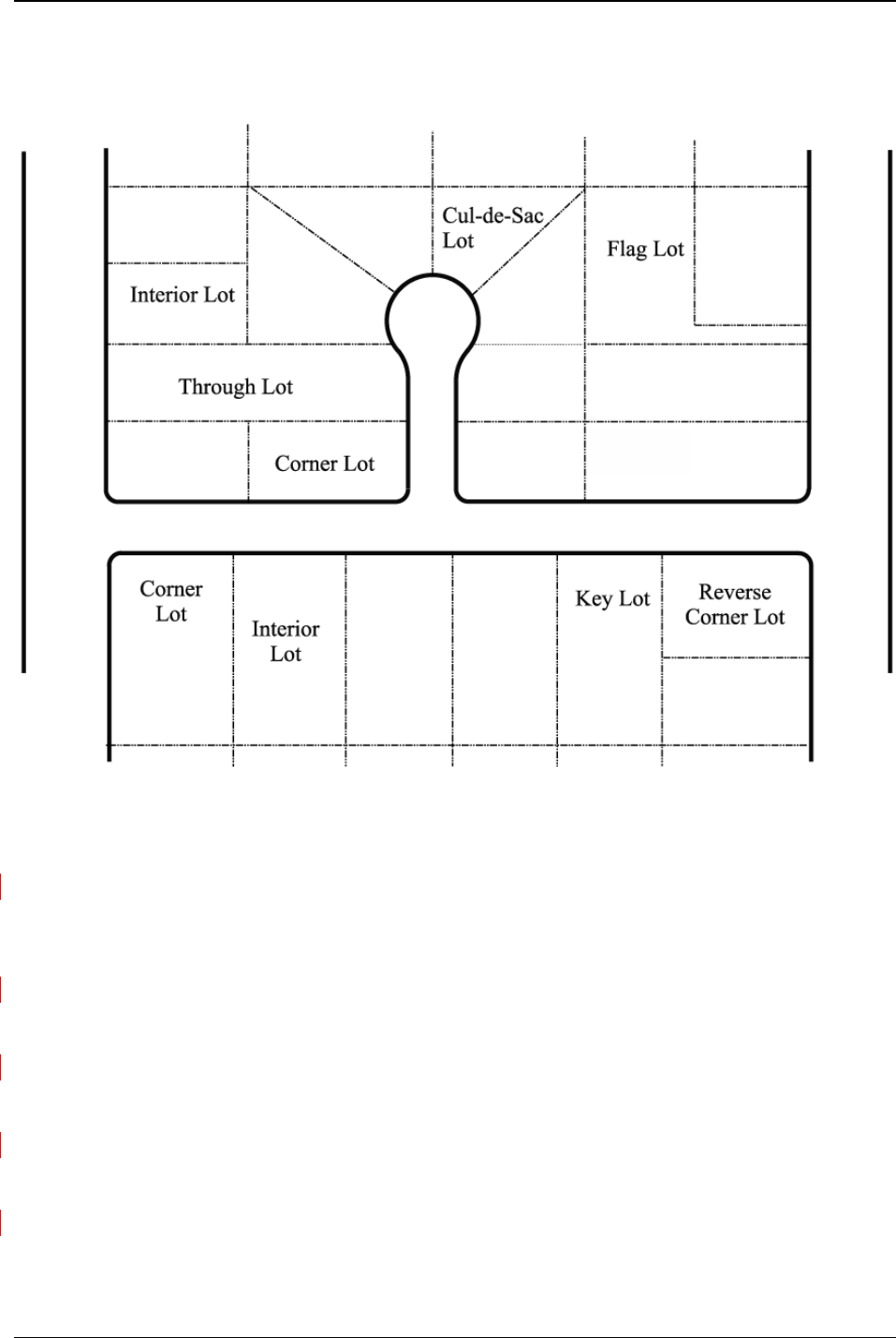
San Bernardino County Development Code
Definitions 810.01
Page 10-64 March 17, 2011
Figure 810-1
Lot Types
(oo) Lot Coverage. The percentage of a lot that has been altered to create a surface area
that is either impervious (i.e., does not absorb water) or is covered by primary and
accessory structures footprints. See “Building Coverage.”
(pp) Lot Depth. The horizontal distance between the front and rear lot lines measured in
the mean direction of the side lot lines.
(qq) Lot Dimension Ratio. A land area ratio of width to depth that determines the shape of
a lot.
(rr) Lot, Frontage. The dimension of a lot or portion of a lot that abuts a street or an
approved road easement, except the side of a corner lot.
(ss) Lot Line or Property Line. Any recorded boundary of a lot. Types of lot lines are as
follows:

San Bernardino County Development Code
Definitions 810.01
Page 10-65 March 17, 2011
(1) Front Lot Line. In the case of an interior lot, a line separating the lot from the
street; and in the case of a corner lot, a line separating the narrowest street
frontage of the lot from the street, except in those cases where the latest tract
deed restrictions or the recorded map specify another line as the front lot line. In
the case of a corner lot where precise dimensions are not readily available and
the lot appears to be substantially equal in street frontage or if the known
dimensions of the lot lines are within 10 percent of one another, the reviewing
authority shall have the discretion to determine the front lot line.
(2) Interior Lot Line. Any lot line not abutting a street.
(3) Rear Lot Line. A line that is opposite and most distant from the front lot line,
and in the case of a triangular or other irregularly shaped lot, a line within the lot
10 feet in length, parallel to and at the maximum distance from the front lot line.
(4) Side Lot Line. Any lot line other than the front or rear lot lines.
(tt) Lot Line Adjustment. The adjustment of a lot line between two or more adjacent
parcels, where the land taken from one parcel is added to an adjacent parcel, and
where no additional parcels are thereby created or the number of parcels reduced.
(uu) Lot Merger. A process by which contiguous lots are merged into one land holding. In
order to be merged, the lots must be held by the same owner and the lots must have a
common lot line. This process is subject to all of the requirements of the County Code
and may be initiated by either the owners of the lots or the County.
(vv) Lot, Mobile Home Park. See “Mobile Home Park Lot.”
(ww) Lot Size, Minimum. The smallest unit of land permitted through subdivision within a
specific land use zoning district, specified as minimum lot size in each land use zoning
district in Division 2 (Land Use Zoning Districts and Allowed Land Uses).
(xx) Lot, Substandard. See “Substandard Lot.”
(yy) Lot Width The following method that yields the smallest dimension shall be chosen
to measure lot width:
(1) The distance measured at the building setback line (BSL) along a line or arc that
is parallel or concentric to the right of way; or
(2) The average horizontal distance between the side lot lines measured at right
angles to the lot depth.
(zz) Lowest Floor. See “Flood Hazard.”
(aaa) Low Head Drainage. Drainage from an irrigation head, which is caused by the flow
of water down a systems lateral lines from a high point of elevation within the system.
Such drainage causes water waste and unnecessary runoff.

San Bernardino County Development Code
Definitions 810.01
Page 10-66 March 17, 2011
(bbb)Low Volume Irrigation. The application of irrigation water at low pressure through
a system of tubing or lateral lines; and the use of low volume emitters, such as a drip,
drip line, bubblers and micro-sprays, which apply small volumes of water slowly at or
near the root zone of plant material.
(ccc) Low Water Use Landscaping. Landscaping that has a plant factor of 0.3 or less.
(ddd)Lumber and Wood Products Manufacturing. See “Manufacturing Operations I and
II.”
Adopted Ordinance 4011 (2007); Amended Ordinance 4057 (2008); Amended Ordinance
4067 (2009), Amended Ordinance 4136 (2011)

San Bernardino County Development Code
Definitions 810.01
Page 10-67 June 19, 2014
810.01.150 Definitions, “M.”
(a) Maintained Public Street. Any roadway maintained by a public agency for public
use.
(b) Major Arterial Highway. See “Road System.”
(c) Major Divided Highway. See “Road System.”
(d) Major Event. See “Special Event, Temporary.”
(e) Major Grading. See “Grading.”
(f) Major Highway. See “Road System.”
(g) Major Repair/Body Work. See “Vehicle Services.”
(h) Managing Agency or Agent. A person, firm or agency representing the owner(s) of a
private home rental unit(s), or a person, firm or agency owning one or more private
home rental units.
(i) Manufactured Home. A structure manufactured on or after June 15, 1976 that meets
the requirements of the National Manufactured Housing and Safety Act of 1974,
transportable in one or more sections, which in the traveling mode, is eight body feet
or more in width, or 40 feet or more in length, or, when erected on site, is 320 or more
square feet, and designed to be used as a dwelling unit with or without a permanent
foundation when connected to utilities, and includes the plumbing, heating, air
conditioning and electrical systems contained therein; except that such term will
include any structure which meets all the requirements of this subsection except the
size requirements and with the respect to which manufacturer voluntarily files a
certification and complies with the standards established under this part. See also
“Flood Hazard.”
(j) Manufactured Home Park or Subdivision. See “Flood Hazard” and “Mobile Home
Park.”
(k) Manufacturing Operations. The on-site production of goods by methods other than
agricultural or extractive in nature.
(l) Manufacturing Operations I - Limited Manufacturing (see Land Use Tables).
Manufacturing operations that are totally enclosed within a structure and employ
fewer than 20 employees on the largest shift. This land use generally involves the
assembly of specific products rather than the manufacturing of the various components
of the products. Limited exterior storage is permitted but is fully screened from public
view.
(1) Apparel and Other Finished Products. The manufacture of clothing and
accessories by cutting and sewing purchased woven or knit textile fabrics and
related materials. Typical uses include: garments, leather goods.

San Bernardino County Development Code
Definitions 810.01
Page 10-68 June 19, 2014
(2) Food and Related Products. The processing or production of a natural or man-
made solid or liquid food substances used for human or animal internal
consumption. Typical uses include: food packaging, egg processing, butter or
cheese processing.
(3) Fabricated metal products. The fabrication or further processing and assembly
of metal parts into equipment or machinery. Typical uses include: coating,
engraving and allied services.
(4) Furniture and Fixtures. The assembly of furniture and related fixtures. Typical
uses include: assembly of household, office or other furniture.
(5) Lumber and Wood Products. The assembly and finishing of wood articles,
except furniture and related fixtures and miscellaneous household or office
products made wholly or partially of wood. Typical uses include: cabinet shops.
(6) Miscellaneous Manufacturing. The manufacture or repair of products not
included in any other category and mainly consisting of small household or
office luxuries, recreational goods or supplies and large scale printing operations.
Typical uses include: jewelry, silverware and plated ware, and musical
instruments.
(7) Paper and Related Products. The manufacture of paper goods generally from
purchased paper materials. Typical uses include: envelopes, bags, stationery,
tablets and related products.
(8) Professional and Scientific Goods. The manufacture of instruments for
measuring, testing, sensing, analyzing and controlling natural or man-made
objects, physical conditions or states. Typical uses include: engineering,
laboratory, scientific, measuring and controlling instruments, optical, surgical,
medical and dental instruments, photographic equipment and supplies, watches,
clocks and clock-operated devices.
(9) Rubber and Miscellaneous Plastic Products. The manufacture from natural,
synthetic or reclaimed rubber, and from chemicals or rubber or plastic products.
Typical uses include: fabricated rubber products.
(10) Stone, Clay, and Glass Products. The manufacture of products from stone, clay,
sand and other nonmetallic minerals, excluding fuels. Typical uses include: glass
products made of purchased glass, pottery and related products.
(11) Textile Mill Products. The preparation of fiber and subsequent manufacturing,
drying, finishing or coating of fiber, thread, yarn, woven, knit, or nonwoven
fabrics or miscellaneous textiles. Typical uses include: knitting mills, lace goods.
(m) Manufacturing Operations II - General manufacturing (see Land Use Tables).
Manufacturing operations that involve exterior storage, large equipment, large number
of employees, or that have historically been controversial.

San Bernardino County Development Code
Definitions 810.01
Page 10-69 June 19, 2014
(1) Apparel and Other Finished Products. The manufacture of clothing and
accessories by cutting and sewing purchased furs and related materials. Typical
uses include: fur dressing and dying.
(2) Chemicals and Related Products. The manufacture or processing of basic,
organic, or inorganic chemicals. This includes chemicals to be used in making
other products and finished chemical products used for direct consumption or as
industrial supplies. Typical uses include: industrial chemicals, plastics materials,
synthetic resins or rubber, paints, varnishes, lacquers, agricultural chemicals.
(3) Food and Related Products. The processing or production of a natural or man-
made solid or liquid food substances used for human or animal internal
consumption. Typical uses include: slaughter houses, poultry dressing plants and
flour mills.
(4) Fabricated metal products. The fabrication or further processing and assembly
of metal parts into equipment or machinery. Typical uses include: automobile
assembly plants, fabricated structural metal, metal forging and stampings.
(5) Furniture and Fixtures. The manufacture of furniture and related fixtures.
Typical uses include: manufacture of household, office or other furniture.
(6) Lumber and Wood Products. The cutting, planing, compression and finishing
of wood articles, except furniture and related fixtures and miscellaneous
household or office products made wholly or partially of wood. Typical uses
include: logging camps, saw mills.
(7) Paper and Related Products. The manufacturing of pulp, paper (both recycles
and paper products from wood), other cellulose fibers, used paper, and rag cloth.
Typical uses include: paper mills, paper coating and glazing.
(8) Petroleum Refining and Related Industries. The modification, refining, and
mixing or storage of fossil fuels that are composed of petroleum or coal. Typical
uses include: petroleum refining, asphalt batch plants, lubricating oils and
greases.
(9) Primary Metal Industries. The smelting, refining, rolling, drawing and alloying
of metals, manufacture of metal castings and production of coke. Typical uses
include: blast furnaces, steel works and rolling and finishing mills, foundries,
smelting and refining of nonferrous metals.
(10) Rubber and Miscellaneous Plastic Products. The manufacture from natural,
synthetic or reclaimed rubber, and from chemicals or rubber or plastic products.

San Bernardino County Development Code
Definitions 810.01
Page 10-70 June 19, 2014
Typical uses include: tires, inner tubes, rubber and plastic footwear, rubber and
plastic hoses and belts.
(11) Stone, Clay, and Glass Products. The manufacture of products from stone,
clay, sand and other nonmetallic minerals, excluding fuels. Typical uses include:
brick, tile, dish, glass and insulation manufacturing and concrete plants.
(12) Textile Mill Products. The preparation of fiber and subsequent manufacturing,
drying, finishing or coating of fiber, thread, yarn, woven, knit, or nonwoven
fabrics or miscellaneous textiles. Typical uses include: broad woven fabric mills,
dyeing and finishing textiles, floor covering mills.
(n) Masonry Construction. As defined in the California Building Code, 2013 Edition
with amendments.
(o) Map Act. California Subdivision Map Act, Government Code Section 66410 et seq.
(p) May. A permissive or optional provision, regulation or specification.
(q) Maximum Applied Water Allowance (MAWA). The upper limit of the annual
amount of applied water allowed for an established landscape.
(r) Medical Marijuana Dispensary.
(1) A medical marijuana dispensary is any facility or location, whether fixed or
mobile, where marijuana is cultivated, made available, and/or distributed by or
to three or more persons within the following categories: a primary caregiver, a
qualified patient, or a patient with an identification card, as those terms are
defined in Health and Safety Code Sections 11362.5 and 11362.7 et seq. as such
sections may be amended from time to time.
(2) A medical marijuana dispensary shall not include the following uses, provided
that such uses may otherwise be lawfully established and operated and comply
with this code and all other applicable laws, including, but not limited to, Health
and Safety Code Sections 11362.5 and 11362.7 et seq.:
(A) An in-patient “health facility” as defined by and licensed pursuant to
Chapter 2 of Division 2 of the Health and Safety Code (commencing with
Section 1250);
(B) A “residential care facility for persons with chronic life threatening illness”
as defined by and licensed pursuant to Chapter 3.01 of Division 2 of the
Health and Safety Code (commencing with Section 1568.01);
(C) A “residential care facility for the elderly” as defined by and licensed
pursuant to Chapter 3.2 of Division 2 of the Health and Safety Code
(commencing with Section 1569);

San Bernardino County Development Code
Definitions 810.01
Page 10-71 June 19, 2014
(D) A “home health agency” as defined by and licensed pursuant to Chapter 8 of
Division 2 of the Health and Safety Code (commencing with Section 1725);
and,
(E) A nonexempt “hospice” as defined by and licensed pursuant to Chapter 8.5
of Division 2 of the Health and Safety Code (commencing with Section
1745).
(3) The word “marijuana” shall have the same meaning as that set forth in Health &
Safety Code Section 11018. The term “medical marijuana” is marijuana used for
medicinal purposes in strict accordance with Health and Safety Code Sections
11362.5 and 11362.7 et seq.
(s) Medical Services, Hospital (see Land Use Tables). Hospitals and similar facilities
engaged primarily in providing diagnostic services, and extensive medical treatment,
including surgical and other hospital service. These establishments have an organized
medical staff, inpatient beds, and equipment and facilities to provide complete health
care. May include on-site accessory clinics and laboratories, accessory retail uses, and
on-site ambulance dispatch facilities.
(t) Medical Services - Rehabilitation Center (see Land Use Tables). A facility
providing skilled nursing and/or in-patient medical care to persons recovering from
injuries or dependencies.
(u) Meeting Facility, Public or Private (see Land Use Tables). A facility for public or
private meetings, including community centers, civic and private auditoriums, grange
halls, mortuaries, union halls, meeting halls for clubs and other membership
organizations, etc. Also includes functionally related internal facilities such as
kitchens, multi-purpose rooms, and storage. Does not include conference and meeting
rooms accessory and incidental to another primary use that are typically used only by
on-site employees and clients, and occupy less floor area on the site than the offices
they support (see “Offices”). Does not include: sports or other commercial
entertainment facilities (see “Theater,” and “Sports and Entertainment Assembly”); or
convention centers (see “Conference/Convention Facility”). Related on-site facilities
including day care centers and schools are separately defined. Also see “Places of
Worship.”
(v) Menagerie. A private collection of three or more wild, exotic or dangerous animals
that are raised, bred, trained and/or maintained without any public display or
exhibition on the site.
(w) Microclimate. The climate of a small, specific landscaped area that may contrast with
the climate of the overall landscaped areas due to varying factors such as wind,
sun/shade exposure, the density of planting material, and/or the proximity to adjacent
reflective surfaces.
(x) Mined Lands. Includes the surface, subsurface, and groundwater of an area where
surface mining operations will be, are being, or have been conducted. This includes

San Bernardino County Development Code
Definitions 810.01
Page 10-72 June 19, 2014
private ways and roads appurtenant to any land excavations, workings, mining waste, and areas
where structures, facilities, equipment, machines, tools or other materials or property that result
from, or are used in, surface mining operations are located. See also “Surface Mining
Operations.”
(y) Mineral Resources. A collective term for all mineral deposits of a particular kind, or
for mineral deposits in general.
(z) Minerals. See “Surface Mining Operations.”
(aa) Minimum Lot Size. See “Lot Size, Minimum.”
(bb) Mining and Reclamation Lead Agency. See “Lead Agency.”
(cc) Mining and Reclamation Operator. See “Surface Mining Operations.”
(dd) Mining and Reclamation Plan. A plan required by the County for all surface mining
operations. The plan requires measures to be taken that provide for reclamation of
mined lands to a usable condition that is readily adaptable for alternative land use and
creates no danger to public health or safety.
(ee) Mining Hazardous, Excavation. See “Hazardous Excavation.”
(ff) Mining Reclamation. See “Surface Mining Operations.”
(gg) Mining Waste. Includes the residual of soil, rock, mineral, liquid, vegetation,
equipment, machines, tools, or other materials or property directly resulting from, or
displaced by, surface mining operations.
(hh) Mini-Storage. See “Storage, Personal.”
(ii) Minor Grading. See “Grading.”
(jj) Minor Event. See “Special Event, Temporary.”
(kk) Minor Maintenance/Repair. See “Vehicle Services.”
(ll) Minor Subdivision Plot Plan. Any application plot plan requesting the subdivision of
any parcel or parcels of land shown as a unit or contiguous units under one or a
common ownership, and that is proposed for subdivision for the purpose of sale, lease,
financing, or other conveyance, including gift, either immediate or in the future, into
two, three or four lots, parts or parcels and a remainder parcel. For the purposes of this
definition, a Minor Subdivision Plot Plan shall also mean a Tentative Parcel Map.
(mm) Mitigation Measures. Necessary steps taken to lessen potential impacts of
development or actions on the environment.
(nn) Mixed Land Use. The unspecified mixture of compatible land uses within one
building or within a section or sections of a community.

San Bernardino County Development Code
Definitions 810.01
Page 10-73 June 19, 2014
(oo) Mobile Home, Boat, or RV Sales (see Land Use Tables). Retail establishments
selling both mobile home dwelling units, and/or various vehicles and watercraft for
recreational uses. Includes the sales of boats, campers and camper shells, jet skis,
mobile homes, motor homes, and travel trailers.
(pp) Mobile Home, Dependent. A mobile home or travel trailer coach not equipped with a
toilet for sewage disposal.
(qq) Mobile Home. A structure that was constructed prior to June 15, 1976, is
transportable in one or more sections, which in the traveling mode, is eight body feet
or more in width, or 40 feet or more in length, or, when erected on site, is 320 or more
square feet, and designed to be used as a dwelling unit with or without a permanent
foundation when connected to utilities, and includes the plumbing, heating, air
conditioning and electrical systems contained therein; except that such term will
include any structure which meets all the requirements of this subsection and complies
with the state standards in effect at the time of construction. “Mobile home does not
include commercial modulars, as defined in Section 18001.8, factory-built housing, as
defined in Section 19971, a manufactured home, as defined in Section 18007, or a
recreational vehicle, as defined in Section 18010 of the California Health and Safety
Code (CHSC).
(rr) Mobile Home Park/manufactured home land-lease community (see Land Use
Tables). An area or tract of land designed as a single unit where spaces for two or
more mobile homes used for human habitation are rented or leased on a monthly or
greater basis, or owned separately.
(ss) Mobile Home Park Lot. A portion of a mobile home park designated or used for the
occupancy of one trailer coach or camping party.
(tt) Mobile Home, Self-Contained. A mobile home or trailer equipped with a toilet, water
storage tank for potable water and a sewage holding tank.
(uu) Mobile Recycling Unit. See “Recycling Facility.”
(vv) Modular unit (Factory-built housing). A residential building, dwelling unit, or an
individual dwelling room or combination of rooms thereof, or building component,
assembly, or system manufactured in such a manner that all concealed parts or
processes of manufacture cannot be inspected before installation at the building site
without disassembly, damage, or destruction of the part, including units designed for
use as a part of an institution for resident or patient care, that is either wholly
manufactured or is in substantial part manufactured at an offsite location to be wholly
or partially assembled onsite in accordance with building standards published in the
California Building Standards Code and other regulations adopted by the commission
pursuant to section 19990. Factory-built housing does not include a mobile home, as
defined in Section 18008, a recreational vehicle, as defined in Section 18010.5, or a
commercial modular, as defined in Section 18012.5 of the California Health and Safety
Code (CHSC).

San Bernardino County Development Code
Definitions 810.01
Page 10-74 June 19, 2014
(ww) Monopole. See “Wireless Telecommunication Facility.”
(xx) Monument Sign. See “Sign.”
(yy) Moratorium. See “Development Moratorium.”
(zz) Mortuary Services (see Land Use Tables). An establishment providing services for
preparing the human dead for burial or cremation and arranging and managing funerals.
This excludes cemeteries, crematoriums and columbariums.
(aaa) Motel. A building or group of two or more detached, semi-detached or attached
buildings containing guest rooms designed, used and intended, wholly or in part, for
the accommodation of transients for compensation on a daily or weekly basis. These
establishments provide lodging and parking for automobile travelers and the rooms are
usually accessible from outdoor parking area. These establishments may include guest
rooms with food preparation areas (kitchenettes) and are designed, intended or used
primarily for the accommodation of automobile travelers. Included are lodging
establishments designated as cabins, motor courts, and similar designations; not
including those facilities defined in residential care facilities or any jail, hospital,
asylum, sanitarium, orphanage, prison or other building in which human beings are
housed and detained under legal restraint.
(bbb) Motor Vehicle. A self-propelled device by which persons or property may be moved
upon a highway, excepting a device moved by human power or used exclusively upon
stationary rails or tracks.
(ccc) Motor Vehicle Dismantling Facility (see Land Use Tables). Any premises used for
the dismantling of wrecking of vehicles required to be registered under the Vehicle
Code of the State of California. Activities may include the buying, selling or dealing
in vehicles, their integral parts, or component materials thereof, and the storage, sale
or dumping of dismantled, partially dismantled, wrecked or inoperative vehicles. See
also “Recycling Facilities – Scrap and Dismantling Yard.”
(ddd) Motor Vehicle Storage/Impound Facility (see Land Use Tables). Any lot, lot area,
or parcel of land used, designed, or maintained for the specific purpose of storing,
impounding, or keeping motor vehicles, but not including dismantling or wrecking
activities.
(eee) Mountain Major Highway. See “Road System.”
(fff) Mountain Region. Areas within the following described boundary: Beginning at the
intersection of the boundary line between San Bernardino and Los Angeles Counties
and the north line of Section 31 Township 4 North, Range 7 West, SBB&M, thence
generally easterly and southerly along the National Forest boundary to its intersection
with the boundary line between San Bernardino and Riverside Counties; thence
westerly along the County line to the southwest corner of Township 1 South, Range 1
East; thence generally northerly and westerly following the National Forest boundary
to the intersection of north boundary of Section 24, Township 1 North, Range 8 West,

San Bernardino County Development Code
Definitions 810.01
Page 10-75 June 19, 2014
SBB&M and the boundary line between San Bernardino and Los Angeles Counties;
thence northerly along the County line to the point of beginning.
(ggg) Mountain Secondary Highway. See “Road System.”
(hhh) Mudslide. The flow of mud and debris in a downslope direction due to slope failure,
caused by poor structural and water retention properties of the soil. They are generally
experienced after heavy precipitation, fast snowpack melt, an earthquake or any
combination thereof.
(iii) Mulch. Organic material such as leaves, bark, or inorganic material such as pebbles,
stones, gravel, decorative sand, and decomposed granite that is left loose and applied
to the soil surface for the beneficial purposes of reducing evaporation, suppressing
weeds, moderating soil temperatures, and preventing soil erosion.
(jjj) Multi-Family Residential Projects. Development project in which two or more
attached or detached units are located, including apartments or condominiums.
(kkk) Multiple Dwelling Unit (see Land Use Tables). A multiple dwelling unit is a series
or combination of dwelling units, either attached or detached, designed to house more
than one family with individual, shared or no kitchen privileges (e.g. apartments,
condominiums, boarding houses, residential hotels). See also “Dwelling, Multiple
Family.”
(lll) “Multi-unit manufactured housing.”
(1) Pursuant to California Health and Safety Code (CHSC) Section 18008.7, multi-
unit manufactured housing means either of the following:
(A) A structure transportable under permit in one or more sections designed
and equipped to contain not more than two dwelling units, a dormitory, or
an efficiency unit as defined in Section 17958.1, to be used with a support
system pursuant to Section 18613 or a foundation system pursuant to
Section 18551.
(B) A structure transportable under permit in one or more sections, designed to
be used with a foundation system for either of the following purposes:
(I) Three or more dwelling units, as defined in Section 18003.3.
(II) A residential hotel, as defined by Subsection 50519(b)(1).
(2) “Multi-dwelling unit manufactured housing” shall be constructed in compliance
with all applicable department regulations. The egress and fire separation
requirements of Title 24 of the California Code of Regulations (CCR) applicable
to dormitories, hotels, apartment houses, and structures that contain two dwelling
units shall also be applicable to all multi-dwelling manufactured housing
constructed for those purposes. The accessibility and adaptability requirements
of Title 24 of the CCR applicable to dormitories, hotels and apartment homes

San Bernardino County Development Code
Definitions 810.01
Page 10-76 June 19, 2014
shall also be applicable to multi-dwelling unit manufactured housing containing
three or more dwelling units.
(3) Notwithstanding any other provision of law, all provisions of law that apply to
manufactured homes shall apply to equally to multi-dwelling unit manufactured
housing. For purposes of this section:
(A) “Dormitory” means a room or rooms inhabited for the purposes of
temporary residence by two or more persons
(B) “Efficiency unit” has the same meaning as defined in Section 17958.1.
(mmm) Multi-use Center. An area of service, retail or publicly oriented facilities that are
centrally located along collector streets or major arterials and serve the local residents.
(nnn) Museum. See “Library, Museum, Art Gallery, Outdoor Exhibit.”
Adopted Ordinance 4011 (2007); Amended Ordinance 4043 (2008); Amended Ordinance
4067 (2009), Amended Ordinance 4136 (2011); Amended Ordinance 4140 (2011); Amended
Ordinance 4189 (2012); Amended Ordinance 4245 (2014)

San Bernardino County Development Code
Definitions 810.01
Page 10-76.1 February 5, 2009
810.01.160 Definitions, “N.”
(a) National Forest Lands. Lands under the jurisdiction of U.S. Forest Service and
within the boundaries of the San Bernardino and Angeles National Forests.
(b) Native Tree. See “Tree, Native.”
(c) Native Vegetative Species. All plant species indigenous to the State of California and
compatible to the climate and elevation of the area to be landscaped.
(d) Natural Resources Development (see Land Use Tables). The development and
extraction of mineral deposits, natural vegetation and energy sources, together with the
necessary incidental buildings, apparatus or appurtenances.
(e) Natural Hazards. Any one or combination of naturally occurring phenomena (e.g.,
earthquakes, forest and brush fires, landslides, mudslides, etc.) that pose a potential
threat to the manmade environment.
(f) Nature Preserve. An area of land maintained in its natural state for the preservation
of habitat or other natural resources
(g) New Construction. See “Flood Hazard.”
(h) Night Club (see Land Use Tables). A facility with the primary function of providing
entertainment, examples of which include live music and/or dancing, comedy, etc.,
which may serve alcoholic beverages for on-site consumption. Does not include adult
entertainment businesses, which are separately defined.
(i) Night Sky. See “Lighting, Outdoor.”
(j) Noise Contour. A mapped line connecting points where the same sound pressure level
prevails. Contours form bands of width emanating from a noise source, and
approximate true ambient noise levels.
(k) Non-access. See “Access.”
(l) Nonconforming or Nonconforming Use. Any building, structure or portion thereof,
or use of building or land that does not conform to the regulations of the San
Bernardino County Code or applicable specific plan and that lawfully existed at the
time the regulations, or an amendment thereto, with which it does not conform became
effective.
(m) Nonvehicular Access. See “Access.”
(n) Notice. A method of conveying information pertaining to a pending land use decision
that may affect members of the public.

San Bernardino County Development Code
Definitions 810.01
Page 10-76.2 December 27, 2012
(o) Nurseries (Retail) (see Land Use Tables). The retail handling of any article,
substance, or commodity related to the planting, maintenance, or harvesting of
garden plants, shrubs, trees, packaged fertilizers, soils, chemicals, or other nursery
goods and related products in small quantities to the consumer.
(p) Nurseries (Wholesale) (see Land Use Tables). The growing, storage, and sale of
garden plants, shrubs, trees, or vines for resale, including incidental retail sales
conducted from within a building not exceeding 20 percent of the combined
wholesale and retail sales volume during any year.
Adopted Ordinance 4011 (2007); Amended Ordinance 4067 (2009); Amended Ordinance
4189 (2012)

San Bernardino County Development Code
Definitions 810.01
Page 10-77 March 25, 2010
810.01.170 Definitions, “O.”
(a) Occupancy Group. The California Building Code classification of the intended use or
character of all areas of the structure/building.
(b) Occupant Load. The number of persons for which the California Building Code
required exiting system must be designed.
(c) Office. This Development Code distinguishes between the following types of offices.
See also “Professional Services.”
(1) Accessory (see Land Use Tables). Office facilities for administration, and/or
on-site business and operations management, that are incidental and accessory to
another business, sales, and/or service activity that is the primary use.
(2) Government (see Land Use Tables). Administration, clerical, or public contact
and/or service offices of a local, state, or federal government agency or service
facilities. Includes post offices, but not bulk mailing distribution centers, which
are under “Truck Terminal.”
(d) Official Map. An Official Map is a map prepared in compliance with this
Development Code and shall be substituted for a final map when it is certified, filed
and bound, but not before.
(e) Off-Highway or Off-Road Vehicle Race. Any organized sporting event or rally
where motorized vehicles are utilized in a contest of speed, or in a competitive trial of
speed or skill or recreational event, all or a portion of which is conducted outside
dedicated public rights-of-way maintained by a public agency.
(f) On-Site Detention. Temporary storage of stormwater runoff on the site.
(g) On-Site Retention. Permanent holding of stormwater runoff on the site through
percolation to the ground.
(h) Open Lot Services. Commercial establishments that are primarily involved in the
delivery of their service from an open lot with relatively few support structures.
(i) Open Space. Land where basic natural values have been retained. Open space can
include wilderness areas, a small park in the middle of a city, pastures, forested areas,
agricultural groves, vineyards, golf courses, floodwashes, etc. The function of open
space may differ, depending upon the location. It may have a protective function, as in
the case of open space in flood plain areas, where it serves to protect health and safety.
It can have a structural or buffer function to space and separate conflicting land uses.
It may serve a recreational function, or a scenic function to provide aesthetic views of
forests or mountains.

San Bernardino County Development Code
Definitions 810.01
Page 10-78 March 17, 2011
(j) Operating Pressure. Is the pressure, based on the recommendations of the irrigation
equipment manufacture for optimal performance, at which an irrigation system with
sprinkler/irrigation heads is designed. Operating pressure is usually indicated at the
base of the sprinkler/irrigation head.
(k) Off-site Sign. See “Sign.”
(l) On-Site Sign. See “Sign.”
(m) Open Space, Common. Open space within a single unified development owned,
designed and set aside for all occupants of the development or by occupants of a
designated portion of the development. Common open space is not dedicated to the
public and is owned and maintained by a private organization made up of the open
space users.
(n) Open Space, Private. Open space directly adjoining the living areas of dwelling units,
which is intended for all private enjoyment of the residents of the dwelling unit.
Private open space shall in some manner be defined so that its boundaries are evident.
(o) Operator, Mining and Reclamation. See “Surface Mining Operations.”
(p) Outdoor Advertising. A structure, of any kind or character, erected or maintained for
outdoor advertising purposes, upon which any poster, bill, printing, painting or other
advertisement of any kind whatsoever may be placed, including statuary, for
advertising purposes.
(q) Outdoor Exhibit. See “Library, Museum, Art Gallery, Outdoor Exhibit.”
(r) Outdoor Festival (see Land Use Tables). Any music festival, dance festival, “rock”
festival, or similar musical activity or gathering where live or prerecorded
entertainment is presented to the public at facilities without permanent land use
approval for the activity.
(s) Outdoor Lighting. See “Lighting, Outdoor.”
(t) Outdoor Market. See “Swap Meet, Outdoor Market, Auction Yard.”
(u) Overburden. Soil, rock, or other materials that lie above a natural mineral deposit or
in between deposits, before or after their removal by surface mining operations.
(v) Overlay Districts. An area within which a set of standards and requirements are
employed to deal with special physical characteristics such as flood plains or
geologically hazardous areas. Overlay Districts are described in Division 2 (Allowed
Land Uses and Permit Requirements) and are mapped and imposed in conjunction
with, and in addition to, the underlying land use zoning district.
(w) Overspray. The water that is applied beyond the landscaped areas onto pavement,
walkways, structures, and other non-landscaped areas by the irrigation system.

San Bernardino County Development Code
Definitions 810.01
Page 10-79 March 17, 2011
(x) Owner. A person or persons shown by the most current legally prepared document
that has been recorded by the County Recorder's Office that transfers, grants or
imports total or partial ownership of a parcel.
(y) Original Parcel. See “Parcel, Original.”
(z) Operative Vehicles. See “Vehicles, Operative.”
Adopted Ordinance 4011 (2007); Amended Ordinance 4067 (2009); Amended Ordinance
4098 (2010), Amended Ordinance 4136 (2011)

San Bernardino County Development Code
Definitions 810.01
Page 10-80 March 27, 2014
810.01.180 Definitions, “P.”
(a) Paper and Related Products Manufacturing. See “Manufacturing Operations I and
II.”
(b) Parcel. Any real property described or created by map or deed. “Parcel” shall also
refer to a legally defined lot, or contiguous group of lots in single ownership or under
single control, and considered a unit for purposes of development. See also “Lot.”
(c) Parcel Map. Means parcel map as defined in California Government Code, Title 7,
Division 2, Chapter 2, Article 3.
(d) Parcel, Original. Any improved or unimproved land shown on the latest County
equalized assessment roll as a unit or contiguous units.
(e) Parcel, Remainder. That portion of an original lot or parcel that is not a part of the
subdivision but, after recordation of the final or parcel map may be sold subject to the
recordation of a certificate of compliance or a conditional certificate of compliance.
The designated remainder shall not be counted as a parcel for the purposes of
determining whether a parcel map or final map is required.
(f) Parcel, Reserve. A strip of land not less than one foot wide reserved for the purpose
of regulating access to part width and dead-end streets until the time that the streets
may be completed or extended.
(g) Park. An outdoor recreation facility that may provide a variety of recreational
opportunities including playground equipment, open space areas for passive recreation
and picnicking, and sport and active recreation facilities.
(h) Park and Ride. A voluntary system where participants drive to a centrally located
public parking area or transportation facility in order to carpool or gain access to
public transportation to another location.
(i) Parking Lots and Structures, Accessory (see Land Use Tables). Off street parking
spaces within parking lots and/or parking structures on the site of a primary land use
that are intended for use by patrons, employees, and/or residents of the primary land
use.
(j) Parking Area, Public (see Land Use Tables). An open area, other than a street, used
for the temporary parking of automobiles and available for public use, whether free,
for compensation or as an accommodation for clients, customers or employees.
(k) Parking Space, Automobile. Space within a public or private parking area or a
building for the temporary parking or storage of one automobile.

San Bernardino County Development Code
Definitions 810.01
Page 10-81 March 27, 2014
(l) Parolee. An individual who has been convicted of a federal or state crime, sentenced
to a federal or state prison or to a term in the California Youth Authority and has
received conditional and revocable release in the community and is under the
supervision of a federal, state, youth authority or County probation or parole officer.
(m) Parolee and/or Probationer Home. Any residential structure or dwelling unit,
whether owned and/or operated by an individual or a for-profit or nonprofit entity,
which houses more than two parolees and/or probationers unrelated by blood,
marriage, or legal adoption, in exchange for monetary or nonmonetary consideration
given and/or paid by the parolee and/or probationer and/or any public or private entity
or person on behalf of the parolee and/or probationer.Partially-Shielded Fixture. See
“Lighting, Outdoor.”
(n) Partially-Shielded Fixture. See “Lighting, Outdoor.”
(o) Passive Thermal System. See “Thermal System, Passive.”
(p) Pawnshops. See “Second-Hand Stores.”
(q) Pedestrian Lighting. See “Lighting, Outdoor.”
(r) Pedestrian Walkway Sign. See “Sign.”
(s) Perch Tree. A dominant conifer, having open areas (dead limbs) in the upper portion
of the tree located:
(1) Within one-quarter mile of the shoreline of Lake Arrowhead, Erwin Lake,
Baldwin Lake or Big Bear Lake; or
(2) In an identified area [i.e. Known Day Use Area or Potential Day Use Area] as
shown on the U.S. Forest Service Bald Eagle Habitat Map.
(t) Permittee. Any person undertaking development activities upon a site in compliance
with a permit granted by the County.
(u) Person. Any individual, firm, co partnership, joint venture, association, social club,
fraternal organization, company, joint stock association, corporation, estate, trust,
organization, business, business trust, public agency, school district, the State of
California and its political subdivisions or instrumentalities, receiver, syndicate or any
group or combination thereof, acting as a unit, including any trustee, receiver or
assignee.
(v) Personal Communication Services (PCS). See “Wireless Telecommunication
Facilities.”

San Bernardino County Development Code
Definitions 810.01
Page 10-82 March 27, 2014
(w) Personal Services (see Land Use Tables). Establishments providing nonmedical
services to individuals as a primary use. Examples of these uses include:
barber and beauty shops
clothing rental
dry cleaning pick up stores
with limited equipment
home electronics and small
appliance repair
laundromats (self service
laundries)
locksmiths
massage (licensed, therapeutic,
non-sexual)
pet grooming with no boarding
psychics, palm readers
shoe repair
tailors
tanning salons
tattoo and body piercing
services
These uses may also include accessory retail sales of products related to the services
provided.
(x) Personal Storage. See “Storage Personal Storage, Mini-Storage.”
(y) Pervious Surface. A surface or material that allows water to pass through the material
into the underlying surface.
(z) Pet Cemetery. See “Cemetery.”
(aa) Pet Farm. A facility in which livestock, farm animals, and other animals are kept for
public exhibition, viewing and contact, regardless of compensation, and which may
include related accessory uses and activities (e.g., picnic areas, recreational activities,
etc.). A pet farm shall not include retail pet stores and kennels, horse races, and
activities such as State and County fairs, livestock shows, rodeos, field trials, and
horsing events.
(bb) Petroleum Refining and Related Industries. See “Manufacturing Operations II.”
(cc) Phase. Any contiguous part or portion of a single unified development project that is
developed as a unit in the same time period.
(dd) Pipelines, Transmission Lines (see Land Use Tables). Facilities primarily engaged
in the pipeline transportation of crude petroleum; refined products of petroleum
including gasoline and fuel oils; natural gas; mixed, manufactured or liquified
petroleum gas; or the pipeline transmission of other commodities. Also includes
pipeline surface and terminal facilities, including pump stations, bulk stations, surge
and storage tanks. Power transmission includes facilities for the transmission of
electrical energy for sale, including transmission lines for a public utility company.
Also includes telephone, telegraph, cable television and other communications
transmission facilities utilizing direct physical conduits. Does not include offices or
service centers (classified in “Offices”), equipment and material storage yards
(classified under “Storage Yards and Sales Lots”), distribution substations (classified
under “Public Utility Facilities”), or power plants (classified under “Electrical Power
Generation”). See also “Utility Facility.”

San Bernardino County Development Code
Definitions 810.01
Page 10-83 March 27, 2014
(ee) Places of Worship. (see Land Use Tables). Facilities operated by religious
organizations for worship, or the promotion of religious activities and instruction;
together with accessory buildings and uses on the same site. Includes churches,
synagogues, mosques, temples, etc. Related on-site facilities including day care
centers and schools are separately defined.
(ff) Planned Development. A large, integrated development consisting of residential,
commercial or industrial uses, or a mixture of these uses and associated ancillary uses
and structures; that is situated on one or more contiguous parcels or noncontiguous
parcels separated solely by a road or other right of way or easement; and that is
planned and developed as a unified project within a single development operation or
series of development operations in compliance with a detailed comprehensive
development plan.
(gg) Planning Agency. The Planning Agency is a reviewing authority with the powers and
charged with the duty of making investigations and reports on land use application and
to approve, conditionally approve or disapprove land use applications. The Planning
Agency of San Bernardino County is described in Chapter 86.01 (Planning Agency).
(hh) Planning Fee Schedule. See “Fee Schedule.”
(ii) Planning Permit. Issued as a result of an approval of a land use application.
(jj) Plant Factor. The factor, when multiplied by the reference evapotranspiration rate
ETo, estimates the amount of water that is needed by plant material. The plant factor
range for low water use plant material shall be 0 to 0.3, the plant factor for medium
water use plant material shall be 0.4 to 0.6, and the plant factor for high water use
plant material shall be 0.7 to 1.0. These plant factors have been derived from the
Department of Water Resources publication, Water Use Classification of Landscape
Species, third edition (WUCOLS III).
(kk) Plant, Desert Native. Any tree, shrub, bulb or plant or part thereof, except its fruit,
named in the California Desert Native Plants Act, as amended, (Food and Agricultural
Code Section 8000a et seq.), which is growing wild. Also “Desert Native Plant”
includes any of the species listed in Subsection 88.01.060(c) (Desert Native Plant
Protection-Regulated desert native plants).
These plants do not include commercial nursery stock or planted landscaping,
including those trees planted and/or growing outside their normal habitat, except
where the plants have been transplanted in compliance with Chapter 88.01 (Plant
Protection and Management).
(ll) Plant Expert, Desert Native. A County Agricultural Commissioner Biologist, an
arborist certified by the Western Chapter of the International Society of Arborists, or a
person certified by the County Agricultural Commissioner for the desert area.

San Bernardino County Development Code
Definitions 810.01
Page 10-84 March 27, 2014
(mm) Plant Material. A living organism such as a tree, shrub, groundcover, succulent,
grass (native and turf variety), annual, perennial, vines, herbs, ferns, and/or conifer
used within a landscaped area, and needs permanent and/or supplemental irrigation.
(nn) Plastic Manufacturing. See “Manufacturing Operations I and II.”
(oo) Playground. An area occupied by children’s play equipment, including climbing
equipment, sandboxes, slides, swings, and/or similar equipment.
(pp) Policies. Statements, more specific than goals, that are guides for decision-making,
imply commitments to goals and define directions for action toward fulfillment of
these goals.
(qq) Pond. A naturally occurring or artificially created body or water (impounded above or
below surface level) with a designated holding capacity of less than one acre-foot of
water. Does not include “Lake or Reservoir.”
(rr) Potable Water. Water that is meant for human consumption and has been treated to
legal standards.
(ss) Precipitation Rate. The application rate of water measured in inches per hour.
(tt) Preserve. See “Nature Preserve.”
(uu) Prezone. The process by which a city or County determines the actual future land use
zoning districts for specified parcels of land before these parcels are annexed to the
city.
(vv) Premature Development. The building or construction of new projects in areas
usually outside city limit boundaries or in areas where necessary public facilities
cannot economically be provided by city or county jurisdictions.
(ww) Pressure Regulator. A device used within an irrigation system to regulate pressure
and maintain irrigation head radius control.
(xx) Primary Metal Industries. See “Manufacturing Operations II.”
(yy) Primary Use. A primary, principal or main use of a subject property that is allowed
by the applicable land use zoning district independent of any other use of the property.
A property may have more than one primary use of the property (e.g., a warehouse
and an off-site sign could be both primary uses of a property. See also “Use.”
(zz) Private Garage. See “Garage, Private.”
(aaa) Private Home Rental, Short-Term. A dwelling unit, including either a single-family
detached or multi-family attached unit, owned, leased or rented on a less than 30-day
basis to individuals acting as a single housekeeping unit. This definition includes a
second dwelling unit on-site. This does not include the ongoing month-to-month
tenancy granted to the same renter for the same unit.

San Bernardino County Development Code
Definitions 810.01
Page 10-85 March 27, 2014
.
(bbb) Private Meeting Facility. See “Meeting Facility.”
(ccc) Private Open Space. See “Open Space, Private.”
(ddd) Private Stable. See “Stable, Private.”
(eee) Probationer. A person who has been convicted of a crime and who has received a
suspension in the imposition or execution of their sentence and has received
conditional and revocable release in the community under the supervision of a
probation officer, as provided under California Penal Code Section 1203 or its
successor.
(fff) Processing Facility. See “Recycling Facility.”
(ggg) Produce Stand. A temporary business established and operated for a specific time,
selling raw, unprocessed fruits, vegetables, nuts, and other produce in its raw or
natural state, and that is accessory to an on-site or adjacent agricultural operation.
(hhh) Professional and Scientific Goods Manufacturing. See “Manufacturing Operations
I.”
(iii) Professional Services (see Land Use Tables). Establishments that provide advice,
designs, information, medical treatment, commercial education, consultation, travel,
job placement, advertising, finance, insurance and real estate services, generally from
an office with no on-site storage of goods. This category includes all types of business
offices and service-type businesses where service is basically on an individual-to-
individual or firm-to-firm basis as opposed to services that are performed on objects or
personal property.
(jjj) Projecting Sign. See “Sign.”
(kkk) Property Line. See “Lot.”
(lll) Property Owners Association. A private organization composed of property owners
of a single unified project that may own common property and shall be responsible for
the maintenance and management of commonly owned property.
(mmm) Public Building. A structure used for public assembly purposes in conjunction
with an institutional use.
(nnn) Public Directional Sign. See “Sign.”
(ooo) Public Facilities. Any civic or service oriented facility available to the general public
such as schools, fire protection, water and sewering, rapid or mass transit routes,
public golf courses, libraries, public health centers, etc.
(ppp)Public Garage. See “Garage, Public.”

San Bernardino County Development Code
Definitions 810.01
Page 10-86 March 27, 2014
(qqq)Public Improvements. Includes traffic controls, streets, roads, highways, freeways,
bridges, overcrossings, street interchanges, flood control or storm drain facilities,
sewer facilities, water facilities, lighting facilities, and any other service and/or
infrastructure improvement that is publicly maintained and operated by a public
agency and/or quasi public agency, excepting utilities and common carriers.
(rrr)Public Meeting Facility. See “Meeting Facility.”
(sss) Public Parking Area. See “Parking Area, Public.”
(ttt) Public Stable. See “Stable, Public.”
(uuu)Public Safety Facility (see Land Use Tables). A facility operated by a public agency
including fire stations, other fire prevention and fire fighting facilities, police and
sheriff substations and headquarters, including interim incarceration facilities. May
include ambulance dispatch facilities on the same site.
(vvv) Public Way. Includes street, highway, avenue, boulevard, parkway, road, lane, walk,
alley, channel, viaduct, subway, tunnel, bridge, public easement, public right of way,
and other ways in which a public agency has a proprietary right.
Adopted Ordinance 4011 (2007); Amended Ordinance 4067 (2009); Amended Ordinance
4085 (2009), Amended Ordinance 4136 (2011); Amended Ordinance 4230 (2014); Amended
Ordinance 4230 (2014)

San Bernardino County Development Code
Definitions 810.01
Page 10-87 February 5, 2009
810.01.190 Definitions, “Q.”
(a) Quality Control Engineer. A registered civil engineer working under a contract with
the County who is responsible to the County to assure compliance by the developer
with the conditions of approval adopted by the County. This definition does not
include the civil engineer responsible for professional inspection as required by the
California Building Code.
Adopted Ordinance 4011 (2007)

San Bernardino County Development Code
Definitions 810.01
Page 10-88 March 27, 2014
810.01.200 Definitions, “R.”
(a) Raised Sleeping Beds. A piece of furniture on, or in, which to lie and sleep and which
is elevated off of the floor at least two feet. For the purposes of this definition, a single
(or twin) bed will accommodate one person, while a double, queen or king bed will
each accommodate two persons.
(b) Ranch/Farm. An establishment primarily engaged in growing crops and raising
animals. A ranch/farm may consist of a single tract of land or a number of separate
tracts that may be held under different tenures (i.e., the ranch/farm operator may own
one tract and rent another). A ranch/farm may be operated by the owner alone or with
the assistance of members of the household or hired employees. See also
“Agriculture,” “Agricultural Use,” and “Agritourism.” Does not include “Agricultural
Support Service.”
(c) Rare or Endangered Species. As used in the Development Code or the San
Bernardino County Environmental Review Guidelines, shall be as defined in Section
15380 of the California Environmental Quality Act (CEQA) Guidelines.
(d) Rear Lot Line. See “Lot.”
(e) Rear Yard. See “Yard.”
(f) The following reasonable accommodation terms are defined as follows:
(1) Minor Reasonable Accommodation. Any deviation requested and/or granted
from the strict application of the laws, rules, policies, practices and/or procedures
of the County, including land use and zoning regulations of this Code, resulting in
a physical modification to the property which can be removed or terminated in 90
days or less after the need for the reasonable accommodation ends.
(2) Major Reasonable Accommodation.
(A) Physical Modification: Any deviation requested and/or granted from the
strict application of the laws, rules, policies, practices and/or procedures of
the County, including land use and zoning regulations of this Code, resulting
in a physical modification to the property which cannot be restored or
terminated within 90 days or less after the reasonable accommodation is
terminated.
(B) Land Use Modification (Residential Care Facility): Any land use
deviation requested and/or granted from the strict application of the land use
and zoning regulations of this Code for the establishment and operation of a
residential care facility.

San Bernardino County Development Code
Definitions 810.01
Page 10-89 March 27, 2014
(g) Reclamation. See “Surface Mining Operations.”
(h) Recreational and Entertainment Services. Establishments that provide leisure time
activities and services that involve many people in a public assembly use where people
either participate individually or are entertained by an activity. See also “Rural Sports
and Recreation.”
(i) Recreational Use. Public use of land for walking, hiking, skiing, riding, driving,
picnicking, camping, swimming, boating, fishing, hunting or other outdoor games or
sports for which land or facilities are provided for public participation.
(j) Recreational Vehicle (RV). A motor home, travel trailer, truck camper or camping
trailer, with or without self-propelled motive power, designed for human habitation for
recreational or emergency occupation, and that may be moved upon a public highway
without a special permit or chauffeur's license or both without violating any provision
of the California Vehicle Code. A “Self Contained Recreational Vehicle” shall be a
recreational vehicle with a kitchen sink, cooking appliance, refrigeration facilities, and
a separate bathroom containing a water closet with a flush toilet, lavatory and bathtub
or shower. A self-contained recreational vehicle shall have adequate provisions for the
sleeping, bathing, sanitation, food preparation and eating by the number of people
occupying the self contained recreational vehicle.
(k) Recreation Hall. A relatively large room or hall (over 3,000 sq. ft.) within a multiple-
family project with a kitchen for hosting fairly large events and concerts (60-80+
people) and may have an area set up, more or less permanently, for indoor games (e.g.
ping pong tables, pool tables, foosball tables, etc.), for a library, for small gatherings,
or for use as a mini cinema.
(l) Recreational Vehicle Park (RVP) (see Land Use Tables). An area or tract of land,
within an area where the land use zoning district allows recreational uses and where
one or more lots are rented or leased or held out for rent, or lease to owners or users of
recreational vehicles for temporary occupancy. Incidental food, alcoholic beverages,
sales and service intended for the convenience of the guests at the recreational vehicle
park are allowed.
(m) Recyclable Material. Reusable material including but not limited to metals, glass,
plastic and paper, which are intended for reuse, remanufacture, or reconstitution for
the purpose of using the altered form. Recyclable material does not include refuse or
hazardous material. Recyclable material may include used motor oil collected and
transported in compliance with Health and Safety Code Sections 25250.11 and
25143.2(b)(4).
(n) Recycling Facility (see Land Use Tables). A center for the collection and/or
processing of recyclable materials. A “Certified Recycling Facility” or “Certified
Processor” is a recycling facility certified by the California Department of
Conservation as meeting the requirements of the California Beverage Container
recycling and Litter Reduction Act of 1986. A recycling facility does not include
storage containers or processing activity located on the premises of a residential,
commercial, or manufacturing use and used solely for the recycling of material

San Bernardino County Development Code
Definitions 810.01
Page 10-90 March 27, 2014
generated by that residential property, business or manufacturer. Recycling facilities
may include the following:
(1) Collection Facility. A center for the acceptance, by donation, redemption, or
purchase, of recyclable materials from the public. The facility does not use
power-driven processing equipment except as provided by this Title. Collection
facilities may include the following:
(A) Reverse Vending Machine(s). As defined below.
(B) Small Collection Facility. Occupies an area of not more than 500 square
feet and may include:
(I) A mobile unit;
(II) Bulk reverse vending machines or a grouping of reverse vending
machines occupying more then 50 square feet;
(III) Kiosk type units, which may include permanent structures;
(IV) Unattended containers placed for the donation of recyclable materials.
(C) Large Collection Facility. May occupy an area of more than 500 square
feet and may include permanent structures.
(2) Processing Facility. A building or enclosed space used for the collection and
processing of recyclable material. Processing means the preparation of material
for efficient shipment, or to an end-user's specifications, by means such as baling,
briquetting, compacting, flattening, grinding, crushing, mechanical sorting,
shredding, cleaning, and remanufacturing. Processing facilities include the
following:
(A) Light Processing Facility. Occupies an area of under 45,000 square feet of
gross collection, processing, and storage area and has up to an average of
two outbound truck shipments per day. Light Processing Facilities are
limited to baling, briquetting, crushing, compacting, grinding, shredding
and sorting of source-separated recyclable materials and repairing of
reusable materials sufficient to qualify as a Certified Processing Facility. A
Light Processing Facility shall not shred, compact, or bale ferrous metals
other than food and beverage containers.
(B) Heavy Processing Facility. Any processing facility other than a Light
Processing Facility.
(3) Reverse Vending Machine. An automated mechanical device that accepts at
least one or more types of empty beverage containers, including, but not limited
to aluminum cans, glass and plastic bottles, and cartons, and issues a cash refund
or a redeemable credit slip with a value not less than the container's redemption

San Bernardino County Development Code
Definitions 810.01
Page 10-91 March 27, 2014
value as determined by the State. A Reverse Vending Machine may sort and
process containers mechanically provided that the entire process is enclosed
within the machine. In order to accept and temporarily store all three container
types in a proportion commensurate with their relative redemption rates, and to
meet the requirements of certification as a recycling facility, multiple grouping of
Reverse Vending Machines may be necessary. A “Bulk Reverse Vending
Machine” is a reverse vending machine that is larger than 50 square feet; is
designed to accept more than one container at a time; and will pay by weight
instead of by container.
(4) Mobile Recycling Unit. An automobile, truck, trailer or van, licensed by the
Department of Motor Vehicles, which is used for the collection of recyclable
materials. A Mobile Recycling Center also means the bins, boxes or containers
transported by trucks, vans, or trailers, and used for the collection of recyclable
materials.
(5) Scrap and Dismantling Yard. Outdoor establishments primarily engaged in
assembling, breaking up, sorting, and the temporary storage and distribution of
recyclable or reusable scrap and waste materials, including auto wreckers
engaged in dismantling automobiles for scrap, and the incidental wholesale or
retail sales of parts from those vehicles. Includes light and heavy processing
facilities for recycling (see the definitions above). Does not include: pawn shops,
and other secondhand stores; the sale of operative used cars; or landfills or other
waste disposal sites. See also “Motor Vehicle Dismantling Facility” and “Salvage
Operations.”
(o) Recycling Facility, Accessory (see Land Use Tables). A recycling facility as defined
above, that is incidental to a primary industrial or commercial use.
(p) Recycled Water. See “Non-Potable Water”
(q) Reference Evapotranspiration Rate (ETo). The quantity of water, which evaporates
from adjacent soils and/or other surfaces, and which also is transpired by plant
material during a specified time. Specified times are normally collected as monthly
and daily readings. Monthly and daily ETo’s can be found on the California Irrigation
Management Information Systems (CIMIS) website.
(r) Regulatory Floodway. See “Flood Hazard.”
(s) Rehabilitation. The restoration of deteriorated structures, neighborhoods and public
facilities. It may involve repair, renovation, conversion, expansion, remodeling,
reconstruction or any combination thereof.
(t) Rehabilitation Center. See “Medical Services Rehabilitation Center.”
(u) Rehabilitated Landscape. A re-landscaping project that meets the applicability
requirements of Chapter 83.10, Landscaping Standards.

San Bernardino County Development Code
Definitions 810.01
Page 10-92 March 27, 2014
(v) Related Land Use. A land use that is supportive of the predominant land use of an
area. For example, a neighborhood commercial center is a supportive use in the
residential land use category.
(w) Religious Assembly Facility. See “Meeting Facility, Public or Private” and “Places of
Worship.”
(x) Remainder Parcel. See “Parcel, Remainder.”
(y) Remote Unit. See “Wireless Telecommunication Facilities.”
(z) Repair Services (Non-automotive) (see Land Use Tables). Establishments engaged in
the provision of repair services to individuals, households and firms.
(aa) Reserve Parcel. See “Parcel, Reserve.”
(bb) Reservoir. A naturally occurring or artificially created body of water (impounded
above or below surface level) with a designated holding capacity of at least one acre-
foot of water. Does not include “Pond.” See also “Lake.”
(cc) Residential Accessory Use or Structure (see Land Use Tables). See “Accessory
Structure.”
(dd) Residential Care Facility.
(1) Licensed (Seven or More Persons). A place, site or building, or groups of
places, sites or buildings, licensed by the state, in which seven or more
individuals with a disability reside who are not living together as a single
housekeeping unit (see “Single housekeeping unit”) and in which every person
residing in the facility (excluding the licensee, members of the licensee’s family,
or persons employed as facility staff) is an individual with a disability. Does not
include “Group residential.”
(2) Unlicensed (Seven or More Persons). A place, site or building, or groups of
places, sites or buildings, which is not licensed by the state, and is not required
by law to be licensed by the state, in which seven or more individuals with a
disability reside who are not living together as a single housekeeping unit (see
“Single housekeeping unit”) and in which every person residing in the facility
(excluding persons employed as facility staff) is an individual with a disability.
Does not include “Group residential.”
(3) Licensed (Six or Fewer Persons). State-licensed facilities that provide care,
services, or treatment in a community residential setting for six or fewer adults,
children, or adults and children and which are required by state law to be treated
as a single housekeeping unit for zoning purposes. Small licensed residential care
facilities shall be subject to all land use and property development regulations
applicable to single housekeeping units (see “Single housekeeping unit”). Does
not include “Group residential.”

San Bernardino County Development Code
Definitions 810.01
Page 10-93 March 27, 2014
(4) Unlicensed (Six or Fewer Persons). A place, site or building, or groups of
places, sites or buildings, which is not licensed by the state and is not required by
law to be licensed by the state, in which six or fewer individuals with a disability
reside who are not living together as a single housekeeping unit and in which
every person residing in the facility (excluding persons employed as facility
staff) is an individual with a disability. Does not include “Group residential.”
(ee) Residential Development. A project containing one or more residential dwelling
units, including mobile homes, or a subdivision of land for the purpose of constructing
one or more residential dwelling units.
(ff) Residential Hotel. See “Hotel, Residential.”
(gg) Residential Use. One or more of the dwelling unit types listed in the tables Division 2
(Land Use Zoning Districts and Allowed Land Uses) under the heading of
“Residential.”
(hh) Residuals Depository. See “Hazardous Waste.”
(ii) Responsible Person. Any person who creates a condition that may lead to accelerated
erosion. If a specific person cannot be identified, the owner of the land where the
condition exists shall be considered the responsible person.
(jj) Restaurant, Café, Coffee Shop (see Land Use Tables). A retail business selling
ready-to-eat food and/or beverages for on- or off-premise consumption. These include
eating establishments where customers are served from a walk-up ordering counter for
either on- or off-premise consumption (“counter service”); and establishments where
customers are served food at their tables for on-premise consumption (“table service”),
that may also provide food for take-out.
(kk) Retail, General. See “General Retail.”
(ll) Retail Sale. A sale of commodities or goods for personal household or farm
consumption directly to the ultimate consumer. Sales are normally in small quantities
and may include the rendering of services incidental to and supportive of the sale of
the merchandise.
(mm) Reversed Corner Lot. See “Lot.”

San Bernardino County Development Code
Definitions 810.01
Page 10-94 March 27, 2014
(nn) Reverse Vending Machine. See “Recycling Facility.”
(oo) Reversion to Acreage. The process by which subdivided real property may be
reverted to acreage.
(pp) Review Authority. Person, body or agency authorized to render land use decisions or
provide technical recommendations to the Planning Agency.
(qq) Right-of-way. Any strip or area of land, including surface, overhead, or underground,
granted by easement, for construction and maintenance according to a designated use,
such as drainage canals and ditches, electric power and telephone lines, gas, oil, water,
and other pipelines, highways and roads and/or flowage or impoundment of surface
waters.
(rr) Right-of-Way, Transportation. See “Transportation Right-of-Way.”
(ss) Riparian habitat. A natural plant community located along, and dependent upon, a
water body or water course (e.g., sides of canyon bottoms, creeks, streams, rivers, etc.)
(tt) Road or Roadway. An open way for vehicular traffic.
(uu) Road Easement. See “Easement.”
(vv) Road Easement, Private. See “Easement.”
(ww) Road System. The classification of streets and highways by their diverse functions
and design. The following is the commonly used hierarchy of streets and highways for
planning purposes:
(1) Local Street. A roadway allowing access to abutting land, serving local traffic
only.
(2) Collector. A street used by traffic to travel from local streets to secondary or
major highways; usually it allows direct access to abutting properties.
(3) Emergency Access Route. A two-lane street of high standards, designed,
constructed and specifically identified as an emergency access route to serve as a
collector or distributor of neighborhood traffic and as an alternative access route
in an emergency situation.
(4) Mountain Secondary Highway. A controlled access, moderate speed, two-lane
highway, designed and constructed to accommodate high volumes of
intercommunity traffic.
(5) Mountain Major Highway. A limited access, high speed, four-lane highway,
designed and constructed to accommodate large volumes of intercommunity
traffic. The mountain expressway connects intensely developed areas and points
of interest. It is a four-lane highway with intersections at grade. It is striped for

San Bernardino County Development Code
Definitions 810.01
Page 10-95 March 27, 2014
two lanes with shoulders in each direction. Turn lanes at intersections when
necessary will require additional rights-of-way and roadway widths.
(6) Secondary Highway. A street serving traffic from collector streets and major
highways that provides for traffic movement to and from traffic generators and
attractors; the street is subject to controlled access from the properties fronting on
the right of way; intersecting streets are subject to appropriate spacing. It is a
four-lane highway with intersections at grade. It is striped for two lanes with
shoulders in each direction. Turn lanes at intersections when necessary will
require additional rights-of-way and roadway widths.
(7) Major Highway. A street or thoroughfare that serves through traffic movement
across urban areas or to major traffic generators and attractors; it is subject to
controlled access from properties fronting on the right of way; intersecting streets
are subject to appropriate spacing. It is a four-lane highway with intersections at
grade. It is striped for two lanes with shoulders in each direction with turn lanes
at intersections. Additional rights-of-way and roadway widths may be necessary
for turn lanes.
(8) Major Divided Highway. A road or thoroughfare that that serves through traffic
movement across urban areas, subject to controlled access from properties
fronting on the right of way; intersecting streets are subject to appropriate
spacing. It is a divided four-lane road with intersection at grade. It is striped for
two lanes with shoulders in each direction with a raised median and turn lanes.
Additional rights-of-way and roadway widths may be necessary for turn lanes.
(9) Major Arterial Highway. A road or thoroughfare that serves through traffic
movement across urban areas, subject to controlled access from properties
fronting on the right of way; intersecting streets are subject to appropriate
spacing. It is a six-lane highway that may have grade separations at intersections.
It is striped for three lanes with shoulders in each direction with turn lanes at
intersections. Additional rights-of-way and roadway widths may be necessary for
turn lanes.
(10) Freeway. A multilane highway with full grade separation (i.e., intersections are
separated by under or overpasses), median strips and fencing or landscaping
strips along the sides. It basically services intercity and interstate traffic. See also
“Freeway.”
(xx) Rockfall. Failure and rapid downhill movement of rocks as a result of gravity,
which can be initiated by earthquake shaking.
(yy) Roof Sign. See “Sign.”
(zz) Root Barrier. A plastic wall-like structure that is installed underground and
designed to prevent the roots from trees from causing damage to streets, sidewalks,
walkways, foundations, and other hardscapes.
(aaa) Rubber Manufacturing. See “Manufacturing Operations I and II.”

San Bernardino County Development Code
Definitions 810.01
Page 10-96 March 27, 2014
(bbb) Rumpus Room. See “Recreation Room.”
(ccc) Runoff. Water that is not absorbed by the soil or the landscape in which it has been
applied and flows from the landscaped area onto adjacent surfaces, creating water
waste.
(ddd) Rural Sports and Recreation (see Land Use Tables). Facilities for sports and
recreational activities requiring large sites and/or remote locations, including
hunting and fishing clubs, off-road vehicle parks, and shooting (rifle, pistol, and
archery) ranges, ski resorts. See also “Recreational Use.”
(eee) RV Sales. See “Mobile Home, Boat or RV Sales.”
Adopted Ordinance 4011 (2007); Amended Ordinance 4043 (2008); Amended Ordinance
4057 (2008); Amended Ordinance 4067 (2009), Amended Ordinance 4136 (2011); Amended
Ordinance 4169 (2012); Amended Ordinance 4189 (2012); Amended Ordinance 4230 (2014)

San Bernardino County Development Code
Definitions 810.01
Page 10-97 June 19, 2014
810.01.210 Definitions, “S.”
(a) Salvage Operations (see Land Use Tables). Establishments involved in the storage,
sale, wholesale and processing of salvage materials. This land use classification does
not include any of the sub-classifications of recycling collection facilities (“Recycling
Collection Facilities) except “Scrap and Dismantling Yard.” See also “Junk and
Salvage Facility.”
(1) Contained. These uses are conducted entirely within enclosed structures and
provide environmentally sound practices in collecting and recycling oils and
other toxic materials. No outside storage of parts occurs, and establishments are
monitored annually to ensure they are maintained appropriately.
(2) General. These uses create major environmental disruption even when carefully
regulated. Dust, dirt, noise and unsightly conditions often prevail with these
operations.
(b) Scenic Corridor. The area outside a highway or an adopted trail right-of-way that is
generally visible to persons traveling on the highway or trail.
(c) School (see Land Use Tables). A public or private academic educational institution
that offers instruction in the several branches of learning and study required to be
taught in the public schools by the Education Code of the State of California. Schools
types include:
boarding school
community college, college,
or university
elementary, middle, and junior
high schools
high school
military academy
Also includes schools providing specialized education/training. Examples include the
following:
art school
ballet and other dance school
business, secretarial, and
vocational school
computers and electronics
school
drama school
driver education school
establishments providing courses
by mail
language school
martial arts
music school
professional school (law,
medicine, etc.)
seminaries/religious ministry
training facility
Also includes facilities, institutions and conference centers that offer specialized
programs in personal growth and development, such as fitness, environmental
awareness, arts, communications, and management. Does not include pre-school and
child day care facilities (see also “Day Care Facility”).
(d) Scientific Goods Manufacturing. See “Manufacturing Operations I.”

San Bernardino County Development Code
Definitions 810.01
Page 10-98 June 19, 2014
(e) Screening. The use of landscaping, earth, fences, walls, trees, shrubs, or other
materials for visual, background, noise or sun exposure control.
(f) Scrap Metal Processing Facility (see Land Use Tables). Any establishment or place
of business that is maintained, used, or operated solely for the processing and
preparing of scrap metals for remelting by steel mills and foundries.
(g) Seal. A metal, tamperproof clamp issued in compliance with the California Desert
Native Plants Act (Food and Agricultural Code Section 80001 et seq.) by the
Agricultural Commissioner used to permanently affix a tag to a native plant.
(h) Searchlight. See “Sign.”
(i) Second Hand Stores, Pawnshops (see Land Use Tables). Retail establishments that
buy and sell used products, including clothing, furniture and household goods,
jewelry, appliances, musical instruments, business machines and office equipment,
tools, motors, machines, instruments, firearms, or any similar secondhand articles or
objects; includes indoor flea markets. Does not include bookstores (“General Retail”);
secondhand farm and construction equipment (“Construction, Farm, and Heavy
Equipment Sales”); junk dealers, or scrap/dismantling yards (“Recycling Facilities -
Scrap and Dismantling Yards”); the sale of antiques and collectibles (“General
Retail”); the sale of cars and other used vehicles (“Auto and Vehicle Sales, Leasing,
and Rental, Used”).
(j) Secondary Highway. See “Road System.”
(k) Section. A section of the this Development Code, unless in reference to some other
specified statute, ordinance, chapter, division or title; or the survey term regarding the
subdivision of a Township into normally 36 equal parts, each of which is
approximately 640 acres.
(l) Security Quarters. Temporary residential occupancy of a dwelling unit, commercial
coach, or travel trailer utilized to provide temporary quarters to security personnel
hired to guard part or all of the property on which the security quarters are located as
an accessory use. Does not include caretaker housing (“Caretaker Housing”).
(m) Sediment. Eroded earth material that is carried by runoff and/or deposited in a stream,
drainage course, natural watercourse, lake or other area.
(n) Seiche. The high frequency fluctuation of an enclosed body of water, which can be
initiated by earthquake shaking.
(o) Seismic Safety Hazard Areas. Areas where a potential hazard exists due to ground
rupture from earthquakes. Seismic safety hazard areas encompass active or potentially
active faults within the County (includes Alquist-Priolo Special Studies Zones).
Hazard area boundaries extend approximately 660 feet on each side of known active
or potentially active faults.
(p) Selected Flood. See “Flood Hazard.”
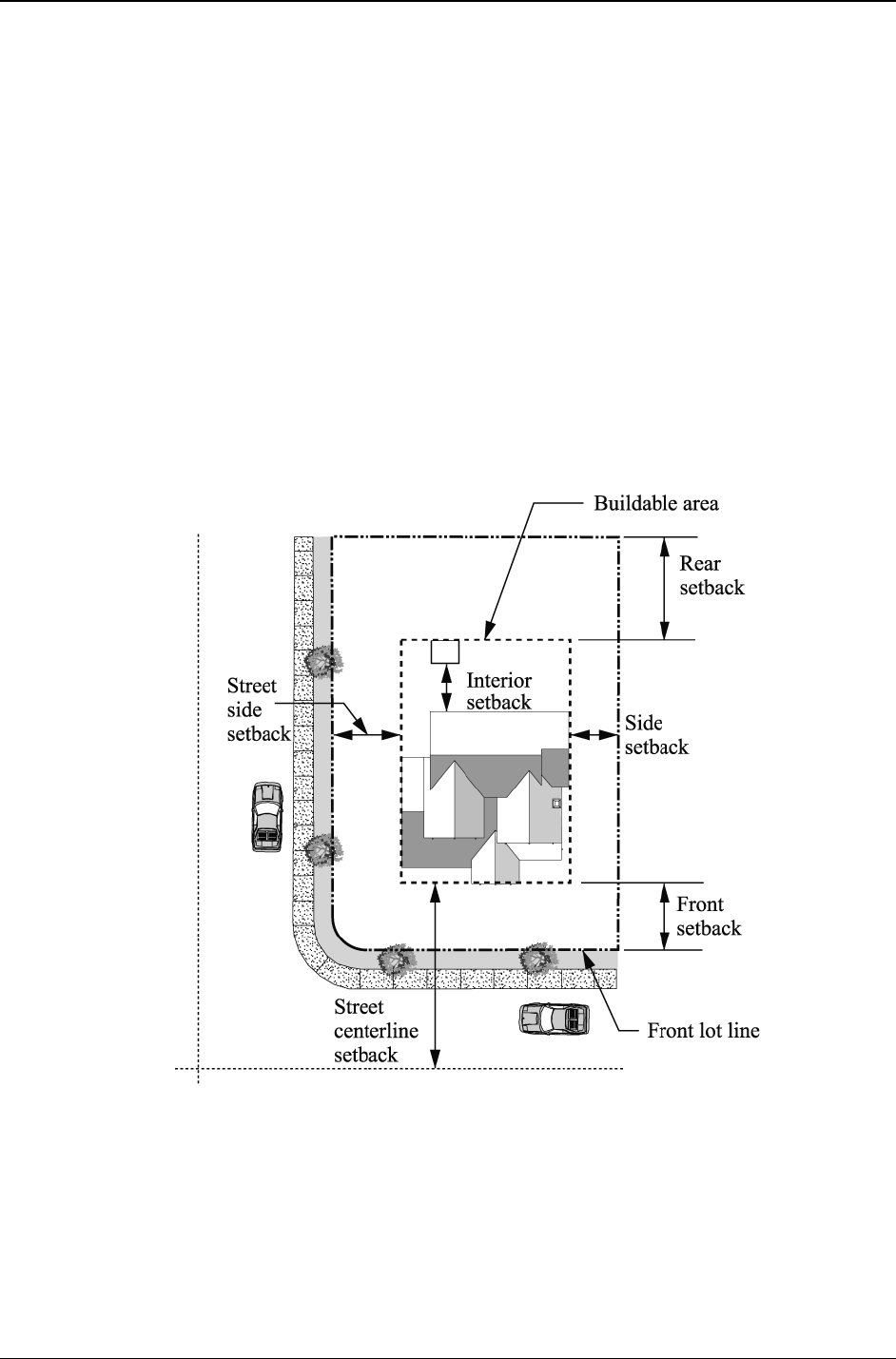
San Bernardino County Development Code
Definitions 810.01
Page 10-99 June 19, 2014
(q) Self-Contained Mobile Home. See “Mobile Home, Self-Contained.”
(r) Semipassive Thermal System. See “Thermal System, Semipassive.”
(s) Sensitive Viewshed. See “Wireless Telecommunication Facilities.”
(t) Service Station (see Land Use Tables). A site where the primary activity is the retail
sale and dispensing of motor fuels or oils, the retail sale of lubricants, tires, batteries
and other automobile accessories, and the installation and servicing of the lubricants,
tires, batteries and other automobile accessories.
(u) Setback. The distance by which a structure, parking area or other development feature
must be separated from a lot line, other structure or development feature, or street
centerline. See also “Yard,” and Section 83.02.070 (Setback Regulations and
Exceptions). See Figure 10-2 (Setbacks).
Figure 810-2
Setbacks
(v) Setback, Street. See “Yard, Front” and “Yard, Side Street”.
(w) Setback Line, Street. A line that defines the depth of the required street setback, front
yard, or side yard or side street where the yard or yards abut a street. The street
setback line shall be parallel or concentric with the street right of way line.

San Bernardino County Development Code
Definitions 810.01
Page 10-100 June 19, 2014
(x) Sewage Disposal Area. An area utilized for the holding, leaching and percolation of
sewage wastes including an area that would provide a 100 percent expansion of the
leaching and percolation field for future use.
(y) Sewage Treatment and Disposal Facility (see Land Use Tables). A site with
equipment and other facilities to treat sewage effluent transmitted to the site via
underground sewer lines to the water quality standard required by the California
Regional Water Quality Control Board.
(z) Shall. A mandatory provision, regulation or specification.
(aa) Shopping Center (see Land Use Tables). A shopping center is two or more business
establishments under a single ownership, unified control or designated as a unit
located on a single parcel or combination of contiguous parcels having a minimum
frontage of 150 feet.
(bb) Short-Term Private Home Rental. See “Private Home Rental, Short-Term.”
(cc) Shrub. Any woody, perennial plant having multiple stems and bearing foliage from
the ground up, commonly maintained at less than eight and more than two feet in
height when fully grown, adaptable to trimming, shaping and pruning without injury
to the plant itself.
(dd) Side Lot Line. See “Lot.”
(ee) Side Yard. See “Yard.”
(ff) Sign. Words, letters, numerals, emblems, designs, or other marks shown on any flag,
card, cloth, paper, metal, painted surface, glass, wood, plaster, stone or other device of
any kind or character by which anything is made known and used to attract attention,
including lighting devices the as searchlights. Signs include four basic categories, (i.e.,
off-site, on-site, directional and temporary) and may take many forms (e.g.
freestanding, monument, wall, roof, projecting walkway, display, etc.) Also signs are
located individually or in clusters (i.e., shopping center complex). The following
definitions clarify the differences between these categories and types:
(1) Off-Site Sign. A sign that is allowed only in certain specified land use zoning
districts as an independent use of the property not dependent upon the location of
another structure or use. The signs often advertise or identify a business,
function, establishment or product at a location other than the property on which
a business is located or a product is manufactured or sold. The signs may
advertise political viewpoints, political campaigns and other noncommercial
messages.
(2) On-Site Sign. A sign that is allowed only in conjunction with another use as an
accessory use. The signs often advertise or identify a commodity, service,
business or profession that is sold, produced, conducted or offered as one of the
major functions of the primary use on the same site. The signs may advertise

San Bernardino County Development Code
Definitions 810.01
Page 10-101 June 19, 2014
political viewpoints, political campaigns and other noncommercial messages.
The signs may also advertise any commercial message.
(3) Complex Sign. A sign that is allowed in conjunction with a shopping center,
business, or other complex that is under a single ownership or unified control
having two or more establishments located on a single parcel or combination of
contiguous parcels.
(4) Complex Occupant Sign. A sign that is allowed in conjunction with an
individual occupant within a shopping center, business, or other complex.
(5) Directional Sign. Signs that provide directional or traffic flow information.
(A) Public Directional Sign. Signs containing directional information about
public places owned or operated by Federal, State or local governments or
their agencies. Also included are historic, cultural, scientific and educational
signs, signs relating to publicly owned natural phenomena, publicly owned
or operated areas of natural scenic beauty, and areas naturally suited for
outdoor recreation, deemed to be in the interest of the traveling public.
(6) Display Sign. A single-faced sign that is affixed to any type of display window
or is adjacent to a display window.
(7) Freestanding Sign. A single or multi-faced sign that is not attached to any
building or structure.
(8) Individual Signs or Accessory Business Sign. Accessory signs that are allowed
in conjunction with a nonresidential use that is not located within a complex
(e.g., shopping center).
(9) Monument Sign. A single- or double-faced sign that is designed and constructed
as part of and placed on a monument base.
(10) Pedestrian Walkway Sign. An accessory sign hung from or on a canopy and
being oriented to pedestrian traffic.
(11) Projecting Sign. A single- or double-faced sign attached to a structure that
extends in a perpendicular plane from the wall to which it is attached.
(12) Roof Sign. A single-faced sign that is affixed to a roof of a building or structure.
(13) Searchlight. An apparatus containing a light source and a reflector for projecting
a strong, far-reaching beam greater than 200 feet in any direction.

San Bernardino County Development Code
Definitions 810.01
Page 10-102 August 27, 2015
(14) Temporary Sign. A sign that provides temporary information and/or directions.
The signs often are subject to the issuance of Temporary Use Permits and often
provide information regarding residential developments, political candidates or
issues, and real estate signs.
(15) Wall Sign. A single-faced sign that is in any manner affixed to any exterior wall
of a structure, the exposed face of which is in a plane parallel to the plane of the
wall.
(gg) Single-Family Dwelling (see Land Use Tables). See “Dwelling, Single Family.”
(hh) Single-Family Dwelling, Attached (see Land Use Tables). See “Dwelling, Single
Family Attached.”
(ii) Single Housekeeping Unit. The functional equivalent of a traditional family or one
household, whose members are an interactive group of persons jointly occupying a
single dwelling unit, including the joint use of and responsibility for common areas,
and sharing household activities and responsibilities (e.g., meals, chores, household
maintenance, expenses, etc.) and where, if the unit is rented, all adult residents have
chosen to jointly occupy the entire premises of the dwelling unit, under a single
written lease or rental agreement with joint use and responsibility for the premises,
and the makeup of the household occupying the unit is determined by the residents of
the unit rather than the landlord or property manager.
(jj) Singular Plural. Words used in the singular number include the plural and words
used in the plural number include the singular.
(kk) Site. A parcel of land or contiguous parcels where land alterations, including grading,
clearing or construction are performed or proposed.
(ll) Site Plan, Detailed. A drawing, to scale, on one sheet of paper of the entire land
parcel showing buildings, improvements, other physical features and all dimensions.
(mm) Site Planning. A process to develop a plan that shows how a parcel of land may be
developed, taking into consideration the natural and man-made characteristics of the
parcel.
(nn) Skilled Nursing Facility. A health facility that provides skilled nursing care and
supportive care to patients whose primary need is for availability of skilled nursing
care on an extended basis.
(oo) Small Family Day Care Home. See “Day Care, Child.”
(pp) Small Collection Facility. See “Recycling Facility.”
(qq) “Smart” Irrigation Controller. An irrigation controller that is weather and soil
moisture-based, and monitors and uses historical environmental conditions for the
specific location in which a landscape is located, by automatically adjusting irrigation
watering times based on the information collected.

San Bernardino County Development Code
Definitions 810.01
Page 10-103 August 27, 2015
(rr) Sober Living Facility. An unlicensed Residential Care Facility with more than two
residents who are not living together as a single housekeeping unit (see “Single
housekeeping unit”), which is not licensed by the state and is being used as a drug and
alcohol recovery facility for persons who are recovering from drug and/or alcohol
addiction and in which all residents, except for a house manager, are considered
disabled under state or federal law and are actively enrolled and participating in an
alcohol and/or drug recovery program.
(ss) Soil. The unconsolidated mineral and organic material on the immediate surface of the
earth.
(1) Corrosive Soils. Natural soils that, as a result of their chemical makeup, may
aggressively deteriorate concrete, metal or other susceptible building material.
(2) Expansive Soils. Natural clays that swell when saturated and shrink when dry.
(3) Hydrocollapsible Soils. Natural soils that collapse or compact after a wetting
event.
(tt) Soil Management Report. A report that shall be submitted with the Landscape
Documentation Package, as outlined by Chapter 83.10, Landscaping Standards, that
outlines the result of the soil tests along with recommendation for soil amendments.
(uu) Solar Energy System. Any solar collector solar device, or structural design feature of
a building whose primary purpose is to provide for the collection, storage, and
distribution of solar energy for space heating or cooling; for domestic, recreational,
therapeutic, or service water heating; for the generation of electricity; for the
production of process heat; and for the production of mechanical work. Solar energy
systems include passive thermal systems, semipassive thermal systems, active thermal
systems and photovoltaic systems. This category does not include parabolic mirror and
devices of a similar nature.
(vv) Solid Waste Disposal Site. A site used for the final disposal of solid waste, which
may also include facilities for separating and differentiating waste products, and/or
recycling the waste products. Includes landfills.
(ww) Solid Waste. Any variety of waste, including household garbage, metal, glass,
shattered concrete, bricks from demolished houses, radioactive wastes and mining
talus.
(xx) Solidification and Stabilization. See “Hazardous Waste.”
(yy) Special District. A governmental entity created in a given area to provide services
within that area. Special Districts can provide services such as water, sewers, fire
protection, and parks and recreation.
(zz) Special Events, Temporary (see Land Use Tables). All carnivals, community
celebrations, off-road vehicle races, outdoor festivals, music events, sporting events,
parades, fairs, animal races, religious festivals, revival meetings, food truck events and

San Bernardino County Development Code
Definitions 810.01
Page 10-104 August 27, 2015
similar public gatherings at locations and facilities without an approved Conditional
Use Permit, Minor Use Permit, or Site Plan Permit. Special events shall be categorized
based upon scope, longevity, magnitude and use, into one of the following event types.
(1) Minor Event.
(A) Class I. Class I. Anticipated attendance of 500 to 1,000 persons per day; or
a community celebration, religious festivals, revival meetings, food truck
events and similar public gatherings with anticipated attendance of 500 or
more. Staging events of off-highway motor vehicles, as defined and
regulated in Chapter 4 of Division 8 of Title 2, shall also be included as a
Class I Minor Event.
(B) Class II. Intensive sporting events, the as off-road vehicle races or rodeos,
etc., and music events with an anticipated attendance of 200 to 500 persons
per day. Included in this class are any events that are advertised by a means
of mass media (i.e., radio, television, newspaper, Internet, phone trees,
fliers, etc.) provided that a means of limiting attendees to 500 persons per
day is available and is strictly enforced.
(2) Major Event.
(A) Class I. Anticipated attendance of over 1,000 persons per day.
(B) Class II. Intensive sporting events, such as off-road vehicle races or
rodeos, etc., or music events with an anticipated attendance of over 500
persons per day. Included in this class are any events that are advertised by
a means of mass media (i.e., radio, television, newspaper, Internet, phone
trees, fliers, etc.) where a means of limiting attendees is not available.
(aaa) Special Flood. See “Flood Hazard.”
(bbb) Special Flood Hazard Area. See “Flood Hazard.”
(ccc) Special Landscape Area. Are those areas of landscape that are dedicated to
edible plant material, those areas that are irrigated with non-potable/recycled
water, and those areas that are dedicated to active play such as parks, sports fields,
golf courses, or where turf provides a playing surface.
(ddd) Specified Anatomical Areas. See “Adult-Oriented Business.”
(eee) Specified Hazardous Waste Facilities. See “Hazardous Waste.”
(fff) Specified Sexual Activities. See “Adult-Oriented Business.”
(ggg) Specimen Tree. See “Tree, Specimen.”
(hhh) Sphere of Influence. A sphere of influence is the probable ultimate physical
boundary of a city as established by the San Bernardino Local Agency Formation
Commission (LAFCO) in compliance with the Cortese-Knox-Hertzberg Local
Government Reorganization Act of 2000 (Government Code Section 56000 et

San Bernardino County Development Code
Definitions 810.01
Page 10-105 August 27, 2015
seq.). A sphere of influence contains unincorporated County land that is outside a
city’s boundaries and that relates to the city’s planning.
(iii) Sports or Entertainment Assembly (see Land Use Tables). A large-scale
indoor or outdoor facility accommodating spectator-oriented sports, concerts, and
other entertainment activities. Examples of this land use include amphitheaters,
race tracks, rodeo arenas, stadiums and coliseums. May also include commercial
facilities customarily associated with the above uses, including bars and
restaurants, gift shops, video game arcades, etc.
(jjj) Stable, Private. A detached accessory building for the keeping of horses, burros
or mules owned by the occupants of the premises and not for remuneration, hire
or sale.
(kkk) Stable, Public. A stable other than a private stable for keeping of horses, burros
or mules.
(lll) Standard Project Flood. See “Flood Hazard.”
(mmm) Start of Construction. See “Flood Hazard.”
(nnn) State. State of California.
(ooo) State Geologist. Individual holding office as provided in the California Public
Resources Code, Section 677, Article 3, Chapter 2, Division 1.
(ppp) Static Water Pressure. The pressure of the pipeline or municipal water supply
when the water is not flowing.
(qqq) Station. An area that is served by an automatic irrigation valve that has been
programmed into the “smart” irrigation controller as a specific number, which is
to be recognized and controlled.
(rrr) Stealth Facility. See “Wireless Telecommunication Facilities.”
(sss) Stock Cooperative. A common interest development in which a corporation is
formed or availed of primarily for the purpose of holding title to, either in fee
simple or for a term of years, improved real property, and all or substantially all
of the shareholders of the corporation receive a right of exclusive occupancy in a
portion of the real property, title to which is held by the corporation. The owner's
interest in the corporation, whether evidenced by a share of stock, a certificate of
membership, or otherwise, shall be deemed to be an interest in a common interest
development and a real estate development for purposes of the California
Corporations Code Subsection 25100(f). In a stock cooperative, both the separate
interest, as defined in California Civil Code Subsection 4190 and the correlative
interest in the stock cooperative corporation, however designated, are interests in
real property. Includes a limited equity housing cooperative, which is a stock
cooperative that meets the criteria of the California Health and Safety Code
Section 33007.5.

San Bernardino County Development Code
Definitions 810.01
Page 10-106 August 27, 2015
(ttt) Stone Products Manufacturing. See “Manufacturing Operations I and II.”
(uuu) Storage, Garage. See “Garage, Storage.”
(vvv) Storage/Impound Facility. See “Motor Vehicle Storage/Impound Facility.”
(www) Storage - Personal Storage, Mini-Storage (see Land Use Tables). Structures
containing generally small, individual compartmentalized or lockers rented as
individual storage spaces and characterized by low parking demand.
(xxx) Storage - Vehicles Storage (see Land Use Tables). A facility for the storage of
operative cars and other fleet vehicles, trucks, buses, recreational vehicles, and
other motor vehicles. Includes facilities for the storage and/or servicing of fleet
vehicles. Also includes the parking of a vehicle on private property for more than
72 hours without operation. Does not include commercial parking lots, or
dismantling yards (classified in “Recycling - Scrap and Dismantling Yards”).
(yyy) Storage - Warehouse, Indoor Storage (see Land Use Tables). Facilities for the
storage of furniture, household goods, or other commercial goods of any nature.
Includes cold storage. Does not include: warehouse, storage or mini storage
facilities offered for rent or lease to the general public (“Storage - Personal
Storage, Mini-Storage”); warehouse facilities primarily used for wholesaling and
distribution (see “Wholesaling and Distribution”); or terminal facilities for
handling freight (see “Truck Terminal”).
(zzz) Storm, Ten Year. See “Ten Year Storm.”
(aaaa) Story. That portion of a building included between the surface of any floor and
the surface of the floor immediately above it, or, if there is no floor above it, then
the space between the floor and ceiling immediately above it.
(bbbb) Story, Half. A story with at least two of its opposite sides meeting a sloping roof,
nor more than two feet above the floor of the story.
(cccc) Stream. Any watercourse designated by a solid line or dash and three dots
symbol on the largest scale of the United States Geological Survey map most
recently published, or as indicated in the development permit when it has been
field determined that a watercourse either:
(1) Supports fish at any time of the year;
(2) Has a significant water flow after any rainstorm; or
(3) Has a well-defined channel.
(dddd) Stream Bed Skimming. See “Surface Mining Operations.”

San Bernardino County Development Code
Definitions 810.01
Page 10-107 August 27, 2015
(eeee) Street. Any public or private thoroughfare, with a width of 20 feet or more, that
affords a primary means of access to abutting property. See “Road System.”
(ffff) Street Line. The boundary line between a street and abutting property.
(gggg) Structural Alterations. Any change in the supporting members of a structure,
such as the bearing walls or partitions, columns, beams or girders.
(hhhh) Structure. Anything constructed, built, or installed by man, an edifice or building
of any kind, or any piece of work artificially built up or composed of parts joined
together in some definite manner, including, but without limitation; buildings,
towers, smokestack, and overhead lines.
(iiii) Structure, Approved. A structure, paved area of impervious substance or sewage
disposal area that has been approved by the Building Official or the Chief of the
Environmental Health Services Division as an improvement of the site, and that
complies with all codes, ordinances and regulations of San Bernardino County.
(jjjj) Structure, Business or Industrial. An occupied, permanent building, attached to
a permanent foundation, approved for the use under the California Building Code,
where one or more persons are employed on an eight hour shift, at least five days
per week.
(kkkk) Structure Envelope. The interior of a parcel outside of the building setback lines.
(llll) Structure Footprint. The area of a parcel included within the surrounding
exterior walls of a structure. In the absence of surrounding exterior walls, the
structure footprint shall be the area under the horizontal projection of the roof.
(mmmm) Structure Height. See Section 83.02.040 (Height Measurement and Height
Limit Exceptions). For buildings see “Building Height”.
(nnnn) Subdivider. A person, firm, corporation, partnership or association who proposes
to divide, divides or causes to be divided real property into a subdivision for
himself or for others except that employees and consultants of these persons or
entities, acting in such capacity, are not “subdividers.”
(oooo) Subdivision. The division, by any subdivider, of any unit or units of improved or
unimproved land, or any portion of land thereof, shown on the latest equalized
County assessment roll as a unit or as contiguous units, for the purpose of sale,
lease or financing, whether immediate or future, except for leases of agricultural
land for agricultural purposes (i.e., the cultivation of food or fiber or the grazing
or pasturing of livestock). Property shall be considered as contiguous units even if
it separated by roads, streets, utility easement or railroad rights of way.
“Subdivision” includes a condominium project, as defined in Section 1350 of the
Civil Code, or a community apartment project, as defined in Section 11004 of the
California Business and Professions Code or the conversion of five or more
existing dwelling units to a stock cooperative, as defined in Section 11003.2 of
the California Business and Professions Code. A conveyance of land to or from a

San Bernardino County Development Code
Definitions 810.01
Page 10-108 August 27, 2015
governmental agency, public entity, public utility, common carrier or subsidiary
of a public utility for conveyance to the public utility for rights of way shall not be
considered a division of land for the purpose of computing the number of parcels.
See also “Minor Subdivision Plot Plan.”
(pppp) Subsidence. The sinking of the earth's surface, usually due to mining,
groundwater extraction, oil and gas withdrawal, earthquakes or other physical
forces.
(qqqq) Substandard Lot. A unit of land, the area, width or other characteristic that fails
to meet the requirements of the land use zoning district in which it is located.
(rrrr) Substandard Housing Unit. A dwelling unit that is either dilapidated or unsafe,
thus endangering the health or safety of the occupant, or does not have adequate
plumbing or heating facilities.
(ssss) Substantial Damage. See “Flood Hazard.”
(tttt) Substantial Improvement. See “Flood Hazard.”
(uuuu) Supplemental Irrigation. See “Temporary Irrigation.”
(vvvv) Supportive Housing. Housing with no limit on length of stay, that is occupied by
the target population, as defined by Section 50675.14 of the California Health and
Safety Code, and that is linked to on-site or off-site services that assist the
resident to retain the housing, improve his or her health status, maximize their
ability to live and, when possible, to work in the community. Supportive housing
that is provided in single-, two-, or multi-family dwelling units, group residential,
parolee-probationer home, residential care facilities, or boarding house uses shall
be permitted, conditionally permitted or prohibited in the same manner as the
other single-, two- or multi-family dwelling units, group residential, parolee-
probationer home, residential care facilities, or boarding house uses under this
Code.
(wwww) Surface Mining Operations (see Land Use Tables). All, or any part of, the
process involved in the mining of minerals on mined lands by removing
overburden and mining directly from the mineral deposits, open pit mining of
minerals naturally exposed, mining by the auger method, dredging and quarrying,
or surface work incident to an underground mine. Surface mining operations
include, but are not limited to, in place distillation or retorting or leaching, the
production and disposal of mining waste, prospecting and exploratory activities,
borrow pitting, streambed skimming, and segregation and stockpiling of mined
materials (and recovery of same). The following definitions shall further clarify
mining issues:
(1) Area of Regional Significance. An area designated by the State Mining and
Geology Board that is known to contain a deposit of minerals, the extraction of
which is judged to be of prime importance in meeting future needs for minerals
in a particular region of the State within which the minerals are located, and

San Bernardino County Development Code
Definitions 810.01
Page 10-109 August 27, 2015
which, if prematurely developed for alternate incompatible land uses, could
result in the permanent loss of minerals that are of more than local significance.
(2) Area of Statewide Significance. An area designated by the Board that is known
to contain a deposit of minerals, the extraction of which is judged to be of prime
importance in meeting future needs for minerals in the State and which, if
prematurely developed for alternate incompatible land uses, could result in the
permanent loss of minerals that are of more than local or regional significance.
(3) Borrow Pits. Excavations created by the surface mining of rock, unconsolidated
geologic deposits or soil to provide material (borrow) for fill elsewhere.
(4) Compatible Land Uses. Land uses inherently compatible with mining and/or
that require a minimum public or private investment in structures, land
improvements, and that may allow mining because of the relative economic
value of the land and its improvements. Examples of these uses may include, but
shall not be limited to, very low density residential, geographically extensive but
low impact industrial, recreational, agricultural, silvicultural, grazing, and open
space.
(5) Haul Road. A road along which material is transported from the area of
excavation to the processing plant or stockpile area of the surface mining
operation.
(6) Idle. Surface mining operations curtailed for a period of one year or more, by
more than 90 percent of the operation's previous maximum annual mineral
production, with the intent to resume those surface mining operations at a future
date.
(7) Incompatible Land Uses. Land uses inherently incompatible with mining and/or
that require public or private investment in structures, land improvements, and
landscaping and that may prevent mining because of the greater economic value
of the land and its improvements. Examples of these uses may include, but shall
not be limited to, high density residential, low density residential with high unit
value, public facilities, geographically limited but impact intensive industrial,
and commercial.
(8) Mined Lands. The surface, subsurface, and ground water of an area in which
surface mining operations will be, are being, or have been conducted, including
private ways and roads appurtenant to any area, land excavations, workings,
mining waste, and areas in which structures, facilities, equipment, machines,
tools, or other materials or property that result from, or are used in, surface
mining operations are located.
(9) Minerals. Any naturally occurring chemical element or compound, or groups of
elements and compounds, formed from inorganic processes and organic
substances, including, but not limited to, coal, peat, and bituminous rock, but
excluding geothermal resources, natural gas, and petroleum.

San Bernardino County Development Code
Definitions 810.01
Page 10-110 August 27, 2015
(10) Operator. Any person who is engaged in surface mining operations, or who
contracts with others to conduct operations on his/her behalf, except a person
who is engaged in surface mining operations as an employee with wages as
his/her sole compensation.
(11) Reclamation. The combined process of land treatment that minimizes water
degradation, air pollution, damage to aquatic or wildlife habitat, flooding,
erosion, and other adverse effects from surface mining operations, including
adverse surface effects incidental to underground mines, so that mined lands are
reclaimed to a usable condition that is readily adaptable for alternate land uses
and create no danger to public health or safety. The process may extend to
affected lands surrounding mined lands, and may require backfilling, grading,
resoiling, revegetation, soil compaction, stabilization, or other measures.
(12) Stream Bed Skimming. Excavation of sand and gravel from stream bed deposits
above the mean summer water level or stream bottom, whichever is higher.
(13) Vested Right. For the purpose of mining and reclamation, a person shall be
deemed to have vested rights, if, before January 1, 1976, the person has, in good
faith and in reliance upon a permit, (if the permit or other authorization was
required, and was in compliance with County regulations), diligently commenced
surface mining operations and incurred substantial liabilities for work and
necessary materials. Expenses incurred in obtaining the enactment of an
ordinance in relation to a particular operation or the issuance of a permit shall not
be deemed liabilities for work or materials.
(xxxx) Swap meet, Outdoor Market, Auction Yard (see Land Use Tables). The sale
of used and/or new merchandise by individual vendors in a temporary or
permanent facility operated and managed by a different proprietor or business
entity, provided that the operator may also be engaged in sales. An indoor swap
meet or flea market occupies a building typically designed for retail sales with
tables, booths, or other spaces for the individual vendors.
(yyyy) Swing Joint. An irrigation component that provides a flexible, maneuverable,
leak-free connection between the irrigation head body and irrigation lateral
pipeline, allowing for movement in any direction helping to prevent equipment
damage.
(zzzz) System Height. See “Wind Energy System.”
Adopted Ordinance 4011 (2007); Amended Ordinance 4043 (2008); Amended Ordinance
4067 (2009), Amended Ordinance 4136 (2011); Amended Ordinance 4230 (2014); Amended
Ordinance 4230 (2014); Amended Ordinance 4245 (2014); Amended Ordinance 4280 (2015)

San Bernardino County Development Code
Definitions 810.01
Page 10-111 March 17, 2011
810.01.220 Definitions, “T.”
(a) Tag. A paper or cloth label issued in compliance with the California Desert Native
Plants Act (Food and Agricultural Code Section 80001 et seq.) by the Agricultural
Commissioner that can be attached to a native plant or a commercial load by means of
a string and a Seal. A Tag specifies a serial number, type of plant, fee required,
location of origin, date of removal, witnessing authority, applicant, destination, and
proposed use (e.g., commercial processing, commercial landscaping, etc.).
(b) Telecommunication Facility, Wireless. See “Wireless Telecommunication Facility.”
(c) Temporary Irrigation. Irrigation solely for the purposes of establishing plant
material, or irrigation that will not continue after plant material establishment.
Temporary/Supplemental irrigation is intended for a period of six months or less.
(d) Temporary Sign. See “Sign.”
(e) Temporary Special Events. See “Special Events, Temporary.”
(f) Tentative Map. A map made for the purpose of showing the design and
improvements of the proposed subdivision, to include the street pattern, lot layout,
easements that are to remain, and existing and proposed subdivision. The Tentative
Map need not be based upon an accurate or detailed final survey of the property. See
also “Vesting Tentative Map.”
(g) Ten Year Storm. A storm of an intensity that would be exceeded on the average only
once every 10 years. The intensity for the storm shall be determined according to San
Bernardino County Hydrology Manual. The duration of the storm used in runoff
calculation shall be equivalent to the concentration time for the area that drains
through the project.
(h) Terminals, Truck. See “Truck Terminals.”
(i) Textile Mill Products. See “Manufacturing Operations I and II.”
(j) Theater. An indoor facility for public assembly and group entertainment, other than
sporting events. Examples include:
civic theaters, and facilities for “live” theater and concerts
movie theaters
similar public assembly facilities
See also “Meeting Facility, Public or Private,” and “Sports and Entertainment
Assembly.”
(k) Thermal System, Active. A system that utilizes solar devices thermally isolated from
the living space to provide for collection, storage, and distribution of solar energy for
heating or cooling.

San Bernardino County Development Code
Definitions 810.01
Page 10-112 March 27, 2014
(l) Thermal System, Passive. A system that utilizes the structural elements of the
building, and is not augmented by mechanical components, to provide for collection,
storage, and distribution of solar energy for heating or cooling.
(m) Thermal System, Semipassive. A system that utilizes the structure of a building and
is augmented by mechanical components to provide for collection, storage, and
distribution of solar energy for heating or cooling.
(n) Through Lot. See “Lot.”
(o) Trailer Camp or Park (see Land Use Tables). A site where space for house trailers
is rented for compensation on a daily basis, or where free occupancy or camping is
permitted to house trailer owners or users, but not including automobile or trailer sales
lots on which unoccupied house trailers are parked for inspection and sales.
(p) Tower Height. See “Wind Energy Systems.”
(q) Trailer Coach. A mobile home, trailer, recreation trailer, travel trailer, camp car or
other vehicle with or without motive power, designed and constructed to travel on the
public thoroughfare in compliance with the provisions of the California Motor Vehicle
Code and designed or used for human habitation.
(r) Trailer, Travel. A vehicle, other than a motor vehicle, that is designed or used for
human habitation and for travel or recreational purposes, that does not exceed eight
feet in width and 40 feet in length, and that may be moved upon a public highway
without a special permit and/or chauffeur's license without violating any provisions of
the California Vehicle Code.
(s) Transfer and Storage Facilities. See “Hazardous Waste.”
(t) Transitional Housing. Rental housing operating under program requirements that
call for the termination of assistance and recirculation of the assisted unit to another
eligible program recipient at some predetermined future point in time, which shall be
no less than six months. Transitional housing that is provided in single-, two- or
multi-family dwelling units, group residential, parolee-probationer home, residential
care facilities, or boarding house uses shall be permitted, conditionally permitted or
prohibited in the same manner as the other single-, two-, or multi-family dwelling
units, group residential, parolee-probationer home, residential care facilities, or
boarding house uses under this code.
(u) Transmission Lines. See “Pipelines, Transmission Lines.”
(v) Transportable Treatment Unit (TTU). Hazardous waste or groundwater
contamination treatment works that are designed to be moved either intact or in
modules and that are intended to be operated at a given location for a limited period of
time.
(w) Transportation Facilities (see Land Use Tables). Roads or bridges, and the
appurtenant improvements necessary for the safe and efficient movement of vehicular

San Bernardino County Development Code
Definitions 810.01
Page 10-113 March 27, 2014
traffic including but not limited to the following: signalization and other traffic
controls; sidewalks; bikeways when they are within the ultimate right-of-way of a road
or bridge. It also includes park and rides, airports, bus terminals, bus stops, and train
stations.
(x) Transportation Facilities Plan, Local Area. A transportation plan adopted by the
Board of Supervisors for a particular transportation facilities area. A plan shall include
a map of the area showing its boundaries, the location of the proposed Transportation
Facilities, and an accompanying text that contains a description of all proposed
Transportation Facilities that will be needed to serve new development within the
boundaries of the Plan and the cost of constructing each proposed transportation
facility within the boundaries of the plan. Costs may include, but are not limited to,
engineering studies, acquisition of rights-of-way, construction of bridges, tunnels,
roadways, traffic signals and any other appurtenant Transportation Facilities. The plan
shall also include a schedule of fees, a detailed description of the methods that will be
utilized to finance the proposed Transportation Facilities, including any fee
calculations needed, and a construction priority listing of the proposed Transportation
Facilities.
(y) Transportation Right of Way. The acquired right that an agency possesses to pass
across and improve the lands of another for access purposes.
(x) Treatment Facilities. See “Hazardous Waste.”
(aa) Travel Trailer. See “Trailer, Travel.”
(bb) Tree. Any woody perennial plant, normally having a single, elongated main stem or
trunk bearing the foliage or crown, a formed crown, and generally with few or no
branches on its lower part. For tree removal purposes, it shall mean a tree attaining
somewhere in its natural or planted range a height of at least six feet and a diameter of
not less than two inches, measured at average ground level.
(cc) Tree, Damaged. Any tree certified by a tree expert, as defined in this Code, that is
damaged by insects, smog, fire, disease or other natural or man made causes
(including, but not limited to, any artificial attachments such as wires or signs).
(dd) Tree Expert. A California Registered Professional Forester, a County Agricultural
Commissioner Biologist, an arborist certified by the Western chapter of the
International Society of Arborists or a person certified by the County Agricultural
Commissioner for practice in one or more regions of the County.
(ee) Tree, Native. Trees that grow or live naturally in San Bernardino County, including
smog resistant trees introduced as part of a reforestation program. This shall not be
construed to mean orchards, commercial nursery stock or planted landscaping. Trees
planted and/or growing outside their normal habitat, except where the trees have been
transplanted in compliance with Chapter 88.01 (Plant Protection and Management)
shall not be considered to be native trees.

San Bernardino County Development Code
Definitions 810.01
Page 10-114 March 27, 2014
(ff) Tree Removal. Any intentional act that will cause a tree to die, including, but not
limited to acts that inflict damage upon root systems, bark, or other parts of the tree by
fire, application of toxic substances, operation of equipment or machinery, changing
the natural grade of land by excavation or filling the drip line area around the trunk, or
to cut down, fell, push over, dig up, poison, burn, or severely prune, trim or top, so
that death of the tree results, or such that the tree is severely damaged and/or is
destroyed in any manner, by any cause.
(gg) Tree, Specimen. Any tree with a root ball greater than a 20-gallon container.
(hh) Truck Stop (see Land Use Tables). A facility that provides convenience services
primarily for the trucking community. These services include but are not limited to
food, beverage, gasoline and retail services.
(ii) Truck Terminal (see Land Use Tables). A lot, lot area or parcel of land used,
designed or maintained for the purpose of storing, parking, refueling, repairing,
dispatching, servicing or keeping motor trucks and associated equipment, together
with those facilities necessary to service, dispatch, store or maintain aforementioned
vehicles, and their cargos and crews.
Adopted Ordinance 4011 (2007); Amended Ordinance 4067 (2009), Amended Ordinance
4136 (2011); Amended Ordinance 4230 (2014)

San Bernardino County Development Code
Definitions 810.01
Page 10-115 February 5, 2009
810.01.230 Definitions, “U.”
(a) U-Pick Farm and/or Orchard (see Land Use Tables). A farm and/or orchard where
customers personally harvest fruit, vegetables, flowers, or herbs. A variety of activities
in addition to fruit/vegetable picking may be offered (e.g., pet farms, hayrides, puppet
shows, etc.). Restroom facilities may or may not be offered. U-pick farms may also
operate a produce stand selling the produce grown on the farm, along with other value-
added products (e.g., home-made pies, preserves, cider, candies, etc.).
(b) Unincorporated Communities. A definable urban area that is not legally a city, but
has the physical characteristics of one. An unincorporated community does not have
independent jurisdiction for land use planning within its boundaries.
(c) Urban Services. The provision of water, gas, electricity, schools, recreational
facilities, fire and police protection, waste disposal, circulation and other services that
are necessary for high intensity uses.
(d) Use. The purpose for which the land or a building is arranged, designed or intended, or
for which either land or a building is or may be occupied or maintained. A primary,
principal or main use is the use that occupies the majority of the subject land, a
building, business production or activity as opposed to an accessory use. See
Accessory use.
(e) Utility Facility (see Land Use Tables). A fixed base structure or facility serving as a
junction point for transferring electric utility services from one transmission voltage to
another or to local distribution and service voltages, and similar facilities for water
supply and natural gas distribution. These uses include any of the following facilities
that are not exempted from County permit requirements by Government Code Section
53091:
electrical substations and switching stations
natural gas regulating and distribution facilities
public water system wells, treatment plants and storage, water tanks
pumping plants
reservoirs
telephone switching facilities
utility corporation and maintenance yards.
These uses do not include office or customer service centers (classified in “Offices”).
See also “Pipelines, Transmission Lines.”
Adopted Ordinance 4011 (2007); Amended Ordinance 4067 (2009)

San Bernardino County Development Code
Definitions 810.01
Page 10-116 February 5, 2009
810.01.240 Definitions, “V.”
(a) Valley Region. The unincorporated area of the southwest portion of San Bernardino
County lying south and west of the Mountain Region as herein defined.
(b) Variance. A process for County consideration of requests to modify certain standards
of this Development Code when, because of special circumstances applicable to the
property, including location, shape, size, surroundings, topography, or other physical
features, the strict application of the development standards otherwise applicable to
the property denies the property owner privileges enjoyed by other property owners in
the vicinity and in the same land use zoning district.
(c) Vehicle, Motor. See “Motor Vehicle.”
(d) Vehicle Services (see Land Use Tables). The repair, servicing, alteration, restoration,
towing, painting, cleaning, or finishing of automobiles, trucks, recreational vehicles,
boats and other vehicles as a primary use, including the incidental wholesale and retail
sale of vehicle parts as an accessory use. This use includes the following categories.
(1) Major Repair/Body Work. These establishments include towing, collision
repair, other body work, and painting services; tire recapping; truck maintenance.
(2) Minor Maintenance/Repair. Minor facilities providing limited repair and
maintenance services. Examples include: minor auto repair with no exterior
overnight storage of vehicles; muffler and radiator shops; quick-lube services;
tire and battery sales and installation (not including recapping).
Does not include automobile parking (see “Parking Facilities”), repair shops that are
part of a vehicle dealership on the same site (see “Auto and Vehicle Sales and Rental,”
and “Mobile Home, RV, and Boat Sales and Rental”); gas stations, which are
separately defined; or dismantling yards, which are included under “Recycling - Scrap
and Dismantling Yards.”
(e) Vehicular Access Rights. See “Access.”
(f) Vehicles, Operative. A new or used vehicle that is self propelled or capable of being
self-propelled with the installation of minor parts (e.g. batteries, tires, plugs).
(g) Vested Right (Mining and Reclamation). See “Surface Mining Operations.”
(h) Vesting Tentative Map. A “tentative map” for a residential subdivision, as defined in
the County Code, that shall have printed conspicuously on its face the words “Vesting
Tentative Map.”
(i) Veterinarian, County. See “County Veterinarian.”

San Bernardino County Development Code
Definitions 810.01
Page 10-117 February 5, 2009
(j) Veterinary Clinic, Animal Hospital (see Land Use Tables). Office and indoor
medical treatment facilities used by veterinarians, including large and small animal
veterinary clinics, and animal hospitals. See also “Kennel.”
Adopted Ordinance 4011 (2007); Amended Ordinance 4043 (200); Amended Ordinance
4067 (2009)

San Bernardino County Development Code
Definitions 810.01
Page 10-118 April 26, 2012
810.01.250 Definitions, “W.”
(a) Wall Sign. See “Sign.”
(b) Warehouse. See “Storage Warehouse.”
(c) Warehouse Retail (see Land Use Tables). A retail store that emphasizes the
packaging and sale of products in large quantities or volumes, some at discounted
prices, where products are typically displayed in their original shipping containers.
Sites and buildings are usually large and industrial in character. Patrons may be
required to pay membership fees.
(d) Watercourse. Any natural or man-made channel where water is concentrated or
collected from a tributary drainage area. A lake, river, creek, stream, wash, arroyo,
channel or other topographic feature on or over which waters flow at least
periodically. Watercourse includes specifically designated areas in which substantial
flood damage may occur.
(e) Water-Intensive Landscaping. Landscaping that has a plant factor of 0.7 or greater.
(f) Watering Window. The time within a 24 hour period in which an irrigation system is
allowed to operated.
(g) Water Use Classification of Landscape Species (WUCOLS). The third edition of
the publication from the University of California Cooperative Extension, the
Department of Water Resources, and the Bureau of Reclamation regarding plant
material and their water use needs.
(h) Weather Sensing Devices. Irrigation components that detect adverse weather
conditions (e.g. rain, wind, frost, etc.) and will automatically override the pre-
programmed irrigation schedule during adverse weather events.
(i) Wholesale. A sale of commodities or goods to others for resale and not normally to
the ultimate consumer. Sales can normally employ warehouses, open enclosures and
office space for the assembly, storage, distribution and display of merchandise for
large quantity sales to community or regional retailers, manufacturers, and
agricultural, commercial, industrial, institutional and professional uses. Sales may
include the rendering of services incidental to and supportive of the sale of
merchandise.
(j) Wholesaling and Distribution (see Land Use Tables). Establishments engaged in
selling merchandise to retailers; to contractors, industrial, commercial, institutional,
farm, or professional business users; to other wholesalers; or acting as agents or
brokers in buying merchandise for or selling merchandise to persons or companies.
Examples of these establishments include:
agents, merchandise or commodity brokers, and commission merchants

San Bernardino County Development Code
Definitions 810.01
Page 10-119 December 27, 2012
assemblers, buyers and associations engaged in the cooperative marketing of farm
products
merchant wholesalers
stores primarily selling electrical, plumbing, heating and air conditioning supplies
and equipment.
Also includes storage, processing, packaging, and shipping facilities for mail order and e-
commerce retail establishments.
(k) Wine Tasting. A facility or area within a winery where wine and related products are
offered for retail sale, where wine may be tasted for a fee, or without charge.
(l) Wildland. Timber, range, watershed and brush lands not under cultivation and in which
development is essentially nonexistent; usually rugged open space terrain.
(m) Wind Energy System (see Land Use Tables). A system that utilizes wind energy to
pump a fluid or gas, or to drive a mechanical device to generate electricity. Related wind
energy terms are defined as follows:
(1) Accessory Wind Energy System. An Accessory Wind Energy System consists of
one or more wind turbines that generate electricity of which more than 50% shall
be used on site. An Accessory Wind Energy System includes all the wind
turbines on a single lot or on multiple parcels in common ownership with a
single, common land use. An Accessory Wind Energy System typically has a
rated capacity of not more than 50 kilowatts. This capacity may be increased to a
maximum of the actual demonstrated energy use for a specific site in question.
(2) System Height. The combined height of the tower, the turbine and any blade when
at the 12 o’clock position.
(3) Tower Height. The height above grade of the fixed portion of the tower, excluding
the wind turbine.
(4) Wind Turbine. A device which converts the kinetic energy of wind into a usable
form of electric energy. A wind turbine may consist of a tower, turbine, support
structures, electrical wires, guy wires and other related equipment.
(n) Wireless Telecommunication Facility (Telecommunication Facility) (see Land Use
Tables). A land use that sends and/or receives radio frequency signals, including, but not
limited to, cell towers, antennas, microwave dishes or horns, structures or towers to
support receiving and/or transmitting devices, accessory development and structures, and
the land on which they all are situated. For the purposes of this Title, wireless
telecommunication facilities shall refer to the non-broadcast services identified in the rules
and regulations promulgated in compliance with the Federal Telecommunication Act of
1996 as amended. Non-broadcast services require special equipment for transmissions
and/or reception and serve specific users. Services include commercial wireless CRS
(Cellular Radiotelephone Services), ESMR (Enhanced Specialized Mobile Radio Service),
and PCS (Personal Communication Services). Amateur users are specifically excluded in
this definition as they are governed by FCC PRB-1. Commercial radio and television
systems are considered “broadcast services” and shall not be included in this definition.

San Bernardino County Development Code
Definitions 810.01
Page 10-120 March 17, 2011
The following terms related to non-broadcast wireless telecommunication facilities are
defined as follows:
(1) Antenna. Any structure or device used to radiate or collect electromagnetic fields
or waves. Specifically, a device of one or more electrical parts that converts radio
frequency electrical energy into radiated electromagnetic energy and/or vice versa.
(2) Co-located Wireless Telecommunication Facility. A telecommunication
facility used by more than one public or private entity.
(3) Commercial Mobile Radio Service. A wireless communications service that is
provided for profit (i.e., with the intent of receiving compensation or monetary
gain), is an interconnected service, and is available to the public, or to classes of
eligible users so as to be effectively available to a substantial portion of the
public.
(4) Camouflage Facility. A wireless telecommunications facility that is designed or
located so that it blends to the maximum extent possible with the predominant
viewing background.
(5) CRS (Cellular Radiotelephone Service). Commercial Mobile Radio Services
(Cellular) normally operating in the frequency range between 824 to 849 MHz,
and between 869 to 894 MHz and other frequency bands as may be authorized by
the FCC.
(6) Enhanced Specialized Mobile Radio Service. One of the wireless
communication services regulated by the Wireless Telecommunications Bureau
(WTB) of the FCC operating at 800 MHz or 900 MHz and other frequency bands
as may be authorized by the FCC. In general, a wide geographic area
Commercial Mobile Radio Service that offers real-time, two-way switched voice
service that is interconnected with the public switched network, either on a stand-
alone basis or packaged with other telecommunications services, including
dispatch and paging services to specialized customers in a non-cellular system
configuration not interconnected to the public switched network.
(7) Fixed Wireless. A local operation providing services such as local and long
distance telephone and high-speed Internet to residential and business customers
by means of a small equipment installation (the “Camouflage Remote Unit”) on
the exterior of each home or business that elects to use this service.
(8) Joint Location. The location of a telecommunication facility on a parcel where
two or more towers or structures supporting one or more antennas have already
been sited. A joint location site is also referred to as an “antenna farm.”
(9) Monopole. A wireless communication facility that consists of a vertical
unguyed structure, erected to support wireless communication antennas and
connecting appurtenances. As defined here, a monopole may, without limitation,
be designed to look like a pole, tree, light standard, flag pole or other similar
structure.

San Bernardino County Development Code
Definitions 810.01
Page 10-121 March 17, 2011
(10) Personal Communications Services (PCS). One of the Commercial Mobile
Radio Services regulated by the Wireless Telecommunication Bureau (WTB) of
the FCC under 47 CFR Part 24; also identified as one of the Personal Wireless
Services regulated by the Telecommunications Act of 1996. The PCS provide a
wide array of mobile and ancillary fixed communications services to individuals
and businesses including unlicensed wireless services and common carrier
wireless exchange access services as defined in 47 USC 332(c)(7)(C)(i).
(11) Remote Unit. A small equipment box that is attached to the exterior of a
residence or business that elects to use “fixed wireless” technology for their local
and long distance telephone and high-speed Internet service.
(12) Sensitive Viewshed. A feature or vista that provides scenic value as discussed in
the Scenic Resources section of the General Plan, specifically in Policy OR-50.
(13) Stealth Facility. A wireless telecommunications facility that is designed or
located so that the equipment installed at the facility is not readily recognizable
as telecommunications equipment.
(o) Wood Receipt. A receipt that is to accompany one or more cords of harvested wood
and that is issued in compliance with the California Desert Native Plants Act (Food
and Agricultural Code Section 80001 et seq.) by the Agricultural Commissioner. A
Wood Receipt specifies a serial number, species of wood, fee required, location of
origin, date of removal, witnessing authority, applicant, destination, and proposed use
of the wood (e.g., commercial processing, commercial landscaping, etc.).
Adopted Ordinance 4011 (2007); Amended Ordinance 4067 (2009), Amended Ordinance
4136 (2011); Amended Ordinance 4163 (2012); Amended Ordinance 4188 (2012)

San Bernardino County Development Code
Definitions 810.01
Page 10-122 March 17, 2011
810.01.260 Definitions, “X.”
Xeriscape. A landscaping method that has been developed especially for those climates that are
susceptible to drought conditions and that utilize water-conserving techniques, such as drought
tolerant plant material, mulches, and efficient irrigation practices.
Adopted Ordinance 4011 (2007); Amended Ordinance 4067 (2009), Amended Ordinance
4136 (2011)

San Bernardino County Development Code
Definitions 810.01
Page 10-123 February 5, 2009
810.01.270 Definitions, “Y.”
(a) Yard. An open space on a lot or parcel extending between a lot line and a setback,
other than a court, unobstructed and unoccupied from the ground upward except for
projections allowed by this Development Code. See “Setback” and Section 83.02.070
(Setback Regulations and Exceptions).
(1) Front Yard. An area extending across the full width of the lot between the front
lot line or the existing or future street right of way and a street setback line
parallel thereto.
(2) Interior Side Yard. An area extending from the required front yard or, where
there is no required front yard, from the front lot line to the required rear yard or,
where there is no required rear yard, to the rear lot line and from the interior side
lot line to a setback line parallel thereto.
(3) Rear Yard. An area extending across the full width of the lot between the rear
lot line and a setback line parallel thereto.
(4) Side Street Yard. An area extending from the required front yard or, where there
is no required front yard, from the front lot line to the rear lot line, and from the
side street lot line, or the existing or future side street right of way (whichever is
greater) to a street setback line parallel thereto.
Adopted Ordinance 4011 (2007); Amended Ordinance 4067 (2009)

San Bernardino County Development Code
Definitions 810.01
Page 10-124 December 27, 2012
810.01.280 Definitions, “Z.”
(a) Zone, Zone District, or Zoning District. See “Land Use Zoning District.”
(b) Zones A, AE, AH. AO, A99, AR, D, and X. See “Flood Hazard.”
(c) Zoo (see Land Use Tables). A zoological garden or other collection of wild, exotic or
dangerous animals that are raised, bred, trained and/or maintained for regular public
display and exhibition on the site. See also “Library, Museum, Art Gallery, Outdoor
Exhibit.”
Adopted Ordinance 4011 (2007); Amended Ordinance 4067 (2009); Amended Ordinance
4189 (2012)

San Bernardino County Development Code
Definitions 810.01
Page 10-125 December 27, 2012
This page intentionally left blank